Apache Solr Reference Guide: For 7.7 Ref Guide
User Manual:
Open the PDF directly: View PDF ![]() .
.
Page Count: 1431 [warning: Documents this large are best viewed by clicking the View PDF Link!]
- Apache Solr Reference Guide: For Solr 7.7
- Table of Contents
- Apache Solr Reference Guide
- About This Guide
- Getting Started
- Deployment and Operations
- Using the Solr Administration User Interface
- Documents, Fields, and Schema Design
- Understanding Analyzers, Tokenizers, and Filters
- Indexing and Basic Data Operations
- Indexing Using Client APIs
- Introduction to Solr Indexing
- Post Tool
- Uploading Data with Index Handlers
- Uploading Data with Solr Cell using Apache Tika
- Uploading Structured Data Store Data with the Data Import Handler
- Updating Parts of Documents
- Detecting Languages During Indexing
- De-Duplication
- Content Streams
- Searching
- Overview of Searching in Solr
- Velocity Search UI
- Relevance
- Query Syntax and Parsing
- JSON Request API
- JSON Facet API
- Faceting
- Highlighting
- Spell Checking
- Query Re-Ranking
- Transforming Result Documents
- Suggester
- MoreLikeThis
- Pagination of Results
- Collapse and Expand Results
- Result Grouping
- Result Clustering
- Spatial Search
- The Terms Component
- The Term Vector Component
- The Stats Component
- The Query Elevation Component
- The Tagger Handler
- Response Writers
- Near Real Time Searching
- RealTime Get
- Exporting Result Sets
- Parallel SQL Interface
- Analytics Component
- Streaming Expressions
- SolrCloud
- Legacy Scaling and Distribution
- The Well-Configured Solr Instance
- Monitoring Solr
- Securing Solr
- Client APIs
- Further Assistance
- Solr Glossary
- Errata
- How to Contribute to Solr Documentation

Apache Solr Reference Guide
For Solr 7.7
Written by the Apache Lucene/Solr Project
Published 2019-03-04
Table of Contents
Apache Solr Reference Guide . . . . . . . . . . . . . . . . . . . . . . . . . . . . . . . . . . . . . . . . . . . . . . . . . . . . . . . . . . . . . . . . . . . . . Ê2
About This Guide . . . . . . . . . . . . . . . . . . . . . . . . . . . . . . . . . . . . . . . . . . . . . . . . . . . . . . . . . . . . . . . . . . . . . . . . . . . . . . . . Ê4
Hosts and Port Examples. . . . . . . . . . . . . . . . . . . . . . . . . . . . . . . . . . . . . . . . . . . . . . . . . . . . . . . . . . . . . . . . . . . . . . . Ê5
Directory Paths . . . . . . . . . . . . . . . . . . . . . . . . . . . . . . . . . . . . . . . . . . . . . . . . . . . . . . . . . . . . . . . . . . . . . . . . . . . . . . . Ê6
API Examples . . . . . . . . . . . . . . . . . . . . . . . . . . . . . . . . . . . . . . . . . . . . . . . . . . . . . . . . . . . . . . . . . . . . . . . . . . . . . . . . . Ê7
Special Inline Notes . . . . . . . . . . . . . . . . . . . . . . . . . . . . . . . . . . . . . . . . . . . . . . . . . . . . . . . . . . . . . . . . . . . . . . . . . . . Ê8
Getting Started . . . . . . . . . . . . . . . . . . . . . . . . . . . . . . . . . . . . . . . . . . . . . . . . . . . . . . . . . . . . . . . . . . . . . . . . . . . . . . . . . Ê9
Solr Tutorial . . . . . . . . . . . . . . . . . . . . . . . . . . . . . . . . . . . . . . . . . . . . . . . . . . . . . . . . . . . . . . . . . . . . . . . . . . . . . . . . . Ê10
A Quick Overview . . . . . . . . . . . . . . . . . . . . . . . . . . . . . . . . . . . . . . . . . . . . . . . . . . . . . . . . . . . . . . . . . . . . . . . . . . . . Ê38
Solr System Requirements. . . . . . . . . . . . . . . . . . . . . . . . . . . . . . . . . . . . . . . . . . . . . . . . . . . . . . . . . . . . . . . . . . . . . Ê40
Installing Solr. . . . . . . . . . . . . . . . . . . . . . . . . . . . . . . . . . . . . . . . . . . . . . . . . . . . . . . . . . . . . . . . . . . . . . . . . . . . . . . . Ê41
Deployment and Operations. . . . . . . . . . . . . . . . . . . . . . . . . . . . . . . . . . . . . . . . . . . . . . . . . . . . . . . . . . . . . . . . . . . . . Ê46
Solr Control Script Reference . . . . . . . . . . . . . . . . . . . . . . . . . . . . . . . . . . . . . . . . . . . . . . . . . . . . . . . . . . . . . . . . . . Ê47
Solr Configuration Files . . . . . . . . . . . . . . . . . . . . . . . . . . . . . . . . . . . . . . . . . . . . . . . . . . . . . . . . . . . . . . . . . . . . . . . Ê67
Taking Solr to Production . . . . . . . . . . . . . . . . . . . . . . . . . . . . . . . . . . . . . . . . . . . . . . . . . . . . . . . . . . . . . . . . . . . . . Ê69
Making and Restoring Backups . . . . . . . . . . . . . . . . . . . . . . . . . . . . . . . . . . . . . . . . . . . . . . . . . . . . . . . . . . . . . . . . Ê77
Running Solr on HDFS . . . . . . . . . . . . . . . . . . . . . . . . . . . . . . . . . . . . . . . . . . . . . . . . . . . . . . . . . . . . . . . . . . . . . . . . Ê82
SolrCloud on AWS EC2 . . . . . . . . . . . . . . . . . . . . . . . . . . . . . . . . . . . . . . . . . . . . . . . . . . . . . . . . . . . . . . . . . . . . . . . . Ê87
Upgrading a Solr Cluster . . . . . . . . . . . . . . . . . . . . . . . . . . . . . . . . . . . . . . . . . . . . . . . . . . . . . . . . . . . . . . . . . . . . . . Ê95
Solr Upgrade Notes . . . . . . . . . . . . . . . . . . . . . . . . . . . . . . . . . . . . . . . . . . . . . . . . . . . . . . . . . . . . . . . . . . . . . . . . . . Ê98
Using the Solr Administration User Interface. . . . . . . . . . . . . . . . . . . . . . . . . . . . . . . . . . . . . . . . . . . . . . . . . . . . . . Ê114
Overview of the Solr Admin UI . . . . . . . . . . . . . . . . . . . . . . . . . . . . . . . . . . . . . . . . . . . . . . . . . . . . . . . . . . . . . . . . Ê115
Logging. . . . . . . . . . . . . . . . . . . . . . . . . . . . . . . . . . . . . . . . . . . . . . . . . . . . . . . . . . . . . . . . . . . . . . . . . . . . . . . . . . . . Ê118
Cloud Screens . . . . . . . . . . . . . . . . . . . . . . . . . . . . . . . . . . . . . . . . . . . . . . . . . . . . . . . . . . . . . . . . . . . . . . . . . . . . . . Ê119
Collections / Core Admin . . . . . . . . . . . . . . . . . . . . . . . . . . . . . . . . . . . . . . . . . . . . . . . . . . . . . . . . . . . . . . . . . . . . . Ê124
Java Properties. . . . . . . . . . . . . . . . . . . . . . . . . . . . . . . . . . . . . . . . . . . . . . . . . . . . . . . . . . . . . . . . . . . . . . . . . . . . . . Ê126
Thread Dump. . . . . . . . . . . . . . . . . . . . . . . . . . . . . . . . . . . . . . . . . . . . . . . . . . . . . . . . . . . . . . . . . . . . . . . . . . . . . . . Ê127
Suggestions Screen . . . . . . . . . . . . . . . . . . . . . . . . . . . . . . . . . . . . . . . . . . . . . . . . . . . . . . . . . . . . . . . . . . . . . . . . . Ê129
Collection-Specific Tools. . . . . . . . . . . . . . . . . . . . . . . . . . . . . . . . . . . . . . . . . . . . . . . . . . . . . . . . . . . . . . . . . . . . . . Ê132
Core-Specific Tools . . . . . . . . . . . . . . . . . . . . . . . . . . . . . . . . . . . . . . . . . . . . . . . . . . . . . . . . . . . . . . . . . . . . . . . . . . Ê143
Documents, Fields, and Schema Design . . . . . . . . . . . . . . . . . . . . . . . . . . . . . . . . . . . . . . . . . . . . . . . . . . . . . . . . . . Ê148
Overview of Documents, Fields, and Schema Design . . . . . . . . . . . . . . . . . . . . . . . . . . . . . . . . . . . . . . . . . . . . . Ê149
Solr Field Types . . . . . . . . . . . . . . . . . . . . . . . . . . . . . . . . . . . . . . . . . . . . . . . . . . . . . . . . . . . . . . . . . . . . . . . . . . . . . Ê151
Defining Fields. . . . . . . . . . . . . . . . . . . . . . . . . . . . . . . . . . . . . . . . . . . . . . . . . . . . . . . . . . . . . . . . . . . . . . . . . . . . . . Ê174
Copying Fields . . . . . . . . . . . . . . . . . . . . . . . . . . . . . . . . . . . . . . . . . . . . . . . . . . . . . . . . . . . . . . . . . . . . . . . . . . . . . . Ê177
Dynamic Fields. . . . . . . . . . . . . . . . . . . . . . . . . . . . . . . . . . . . . . . . . . . . . . . . . . . . . . . . . . . . . . . . . . . . . . . . . . . . . . Ê179
Other Schema Elements . . . . . . . . . . . . . . . . . . . . . . . . . . . . . . . . . . . . . . . . . . . . . . . . . . . . . . . . . . . . . . . . . . . . . Ê180
Schema API . . . . . . . . . . . . . . . . . . . . . . . . . . . . . . . . . . . . . . . . . . . . . . . . . . . . . . . . . . . . . . . . . . . . . . . . . . . . . . . . Ê182
Putting the Pieces Together . . . . . . . . . . . . . . . . . . . . . . . . . . . . . . . . . . . . . . . . . . . . . . . . . . . . . . . . . . . . . . . . . . Ê209
DocValues. . . . . . . . . . . . . . . . . . . . . . . . . . . . . . . . . . . . . . . . . . . . . . . . . . . . . . . . . . . . . . . . . . . . . . . . . . . . . . . . . . Ê211
Schemaless Mode . . . . . . . . . . . . . . . . . . . . . . . . . . . . . . . . . . . . . . . . . . . . . . . . . . . . . . . . . . . . . . . . . . . . . . . . . . . Ê214
Understanding Analyzers, Tokenizers, and Filters. . . . . . . . . . . . . . . . . . . . . . . . . . . . . . . . . . . . . . . . . . . . . . . . . . Ê222
Using Analyzers, Tokenizers, and Filters . . . . . . . . . . . . . . . . . . . . . . . . . . . . . . . . . . . . . . . . . . . . . . . . . . . . . . . . Ê223
Analyzers . . . . . . . . . . . . . . . . . . . . . . . . . . . . . . . . . . . . . . . . . . . . . . . . . . . . . . . . . . . . . . . . . . . . . . . . . . . . . . . . . . Ê224
About Tokenizers . . . . . . . . . . . . . . . . . . . . . . . . . . . . . . . . . . . . . . . . . . . . . . . . . . . . . . . . . . . . . . . . . . . . . . . . . . . Ê227
About Filters. . . . . . . . . . . . . . . . . . . . . . . . . . . . . . . . . . . . . . . . . . . . . . . . . . . . . . . . . . . . . . . . . . . . . . . . . . . . . . . . Ê228
Tokenizers . . . . . . . . . . . . . . . . . . . . . . . . . . . . . . . . . . . . . . . . . . . . . . . . . . . . . . . . . . . . . . . . . . . . . . . . . . . . . . . . . Ê229
Filter Descriptions . . . . . . . . . . . . . . . . . . . . . . . . . . . . . . . . . . . . . . . . . . . . . . . . . . . . . . . . . . . . . . . . . . . . . . . . . . . Ê239
CharFilterFactories . . . . . . . . . . . . . . . . . . . . . . . . . . . . . . . . . . . . . . . . . . . . . . . . . . . . . . . . . . . . . . . . . . . . . . . . . . Ê279
Language Analysis . . . . . . . . . . . . . . . . . . . . . . . . . . . . . . . . . . . . . . . . . . . . . . . . . . . . . . . . . . . . . . . . . . . . . . . . . . Ê283
Phonetic Matching . . . . . . . . . . . . . . . . . . . . . . . . . . . . . . . . . . . . . . . . . . . . . . . . . . . . . . . . . . . . . . . . . . . . . . . . . . Ê321
Running Your Analyzer. . . . . . . . . . . . . . . . . . . . . . . . . . . . . . . . . . . . . . . . . . . . . . . . . . . . . . . . . . . . . . . . . . . . . . . Ê324
Indexing and Basic Data Operations . . . . . . . . . . . . . . . . . . . . . . . . . . . . . . . . . . . . . . . . . . . . . . . . . . . . . . . . . . . . . Ê327
Indexing Using Client APIs . . . . . . . . . . . . . . . . . . . . . . . . . . . . . . . . . . . . . . . . . . . . . . . . . . . . . . . . . . . . . . . . . . . Ê328
Introduction to Solr Indexing . . . . . . . . . . . . . . . . . . . . . . . . . . . . . . . . . . . . . . . . . . . . . . . . . . . . . . . . . . . . . . . . . Ê329
Post Tool. . . . . . . . . . . . . . . . . . . . . . . . . . . . . . . . . . . . . . . . . . . . . . . . . . . . . . . . . . . . . . . . . . . . . . . . . . . . . . . . . . . Ê331
Uploading Data with Index Handlers. . . . . . . . . . . . . . . . . . . . . . . . . . . . . . . . . . . . . . . . . . . . . . . . . . . . . . . . . . . Ê335
Uploading Data with Solr Cell using Apache Tika . . . . . . . . . . . . . . . . . . . . . . . . . . . . . . . . . . . . . . . . . . . . . . . . Ê370
Uploading Structured Data Store Data with the Data Import Handler . . . . . . . . . . . . . . . . . . . . . . . . . . . . . . Ê382
Updating Parts of Documents. . . . . . . . . . . . . . . . . . . . . . . . . . . . . . . . . . . . . . . . . . . . . . . . . . . . . . . . . . . . . . . . . Ê409
Detecting Languages During Indexing . . . . . . . . . . . . . . . . . . . . . . . . . . . . . . . . . . . . . . . . . . . . . . . . . . . . . . . . . Ê416
De-Duplication. . . . . . . . . . . . . . . . . . . . . . . . . . . . . . . . . . . . . . . . . . . . . . . . . . . . . . . . . . . . . . . . . . . . . . . . . . . . . . Ê420
Content Streams . . . . . . . . . . . . . . . . . . . . . . . . . . . . . . . . . . . . . . . . . . . . . . . . . . . . . . . . . . . . . . . . . . . . . . . . . . . . Ê422
Searching . . . . . . . . . . . . . . . . . . . . . . . . . . . . . . . . . . . . . . . . . . . . . . . . . . . . . . . . . . . . . . . . . . . . . . . . . . . . . . . . . . . . Ê424
Overview of Searching in Solr . . . . . . . . . . . . . . . . . . . . . . . . . . . . . . . . . . . . . . . . . . . . . . . . . . . . . . . . . . . . . . . . . Ê426
Velocity Search UI . . . . . . . . . . . . . . . . . . . . . . . . . . . . . . . . . . . . . . . . . . . . . . . . . . . . . . . . . . . . . . . . . . . . . . . . . . . Ê429
Relevance . . . . . . . . . . . . . . . . . . . . . . . . . . . . . . . . . . . . . . . . . . . . . . . . . . . . . . . . . . . . . . . . . . . . . . . . . . . . . . . . . . Ê430
Query Syntax and Parsing . . . . . . . . . . . . . . . . . . . . . . . . . . . . . . . . . . . . . . . . . . . . . . . . . . . . . . . . . . . . . . . . . . . . Ê432
JSON Request API . . . . . . . . . . . . . . . . . . . . . . . . . . . . . . . . . . . . . . . . . . . . . . . . . . . . . . . . . . . . . . . . . . . . . . . . . . . Ê496
JSON Facet API. . . . . . . . . . . . . . . . . . . . . . . . . . . . . . . . . . . . . . . . . . . . . . . . . . . . . . . . . . . . . . . . . . . . . . . . . . . . . . Ê505
Faceting . . . . . . . . . . . . . . . . . . . . . . . . . . . . . . . . . . . . . . . . . . . . . . . . . . . . . . . . . . . . . . . . . . . . . . . . . . . . . . . . . . . Ê528
Highlighting . . . . . . . . . . . . . . . . . . . . . . . . . . . . . . . . . . . . . . . . . . . . . . . . . . . . . . . . . . . . . . . . . . . . . . . . . . . . . . . . Ê546
Spell Checking . . . . . . . . . . . . . . . . . . . . . . . . . . . . . . . . . . . . . . . . . . . . . . . . . . . . . . . . . . . . . . . . . . . . . . . . . . . . . . Ê556
Query Re-Ranking . . . . . . . . . . . . . . . . . . . . . . . . . . . . . . . . . . . . . . . . . . . . . . . . . . . . . . . . . . . . . . . . . . . . . . . . . . . Ê565
Transforming Result Documents . . . . . . . . . . . . . . . . . . . . . . . . . . . . . . . . . . . . . . . . . . . . . . . . . . . . . . . . . . . . . . Ê584
Suggester . . . . . . . . . . . . . . . . . . . . . . . . . . . . . . . . . . . . . . . . . . . . . . . . . . . . . . . . . . . . . . . . . . . . . . . . . . . . . . . . . . Ê591
MoreLikeThis . . . . . . . . . . . . . . . . . . . . . . . . . . . . . . . . . . . . . . . . . . . . . . . . . . . . . . . . . . . . . . . . . . . . . . . . . . . . . . . Ê604
Pagination of Results . . . . . . . . . . . . . . . . . . . . . . . . . . . . . . . . . . . . . . . . . . . . . . . . . . . . . . . . . . . . . . . . . . . . . . . . Ê607
Collapse and Expand Results . . . . . . . . . . . . . . . . . . . . . . . . . . . . . . . . . . . . . . . . . . . . . . . . . . . . . . . . . . . . . . . . . Ê614
Result Grouping . . . . . . . . . . . . . . . . . . . . . . . . . . . . . . . . . . . . . . . . . . . . . . . . . . . . . . . . . . . . . . . . . . . . . . . . . . . . Ê617
Result Clustering. . . . . . . . . . . . . . . . . . . . . . . . . . . . . . . . . . . . . . . . . . . . . . . . . . . . . . . . . . . . . . . . . . . . . . . . . . . . Ê623
Spatial Search . . . . . . . . . . . . . . . . . . . . . . . . . . . . . . . . . . . . . . . . . . . . . . . . . . . . . . . . . . . . . . . . . . . . . . . . . . . . . . Ê633
The Terms Component . . . . . . . . . . . . . . . . . . . . . . . . . . . . . . . . . . . . . . . . . . . . . . . . . . . . . . . . . . . . . . . . . . . . . . Ê645
The Term Vector Component . . . . . . . . . . . . . . . . . . . . . . . . . . . . . . . . . . . . . . . . . . . . . . . . . . . . . . . . . . . . . . . . . Ê652
The Stats Component. . . . . . . . . . . . . . . . . . . . . . . . . . . . . . . . . . . . . . . . . . . . . . . . . . . . . . . . . . . . . . . . . . . . . . . . Ê657
The Query Elevation Component . . . . . . . . . . . . . . . . . . . . . . . . . . . . . . . . . . . . . . . . . . . . . . . . . . . . . . . . . . . . . . Ê662
The Tagger Handler . . . . . . . . . . . . . . . . . . . . . . . . . . . . . . . . . . . . . . . . . . . . . . . . . . . . . . . . . . . . . . . . . . . . . . . . . Ê666
Response Writers . . . . . . . . . . . . . . . . . . . . . . . . . . . . . . . . . . . . . . . . . . . . . . . . . . . . . . . . . . . . . . . . . . . . . . . . . . . Ê672
Near Real Time Searching . . . . . . . . . . . . . . . . . . . . . . . . . . . . . . . . . . . . . . . . . . . . . . . . . . . . . . . . . . . . . . . . . . . . Ê683
RealTime Get . . . . . . . . . . . . . . . . . . . . . . . . . . . . . . . . . . . . . . . . . . . . . . . . . . . . . . . . . . . . . . . . . . . . . . . . . . . . . . . Ê686
Exporting Result Sets . . . . . . . . . . . . . . . . . . . . . . . . . . . . . . . . . . . . . . . . . . . . . . . . . . . . . . . . . . . . . . . . . . . . . . . . Ê690
Parallel SQL Interface. . . . . . . . . . . . . . . . . . . . . . . . . . . . . . . . . . . . . . . . . . . . . . . . . . . . . . . . . . . . . . . . . . . . . . . . Ê692
Analytics Component . . . . . . . . . . . . . . . . . . . . . . . . . . . . . . . . . . . . . . . . . . . . . . . . . . . . . . . . . . . . . . . . . . . . . . . . Ê728
Streaming Expressions. . . . . . . . . . . . . . . . . . . . . . . . . . . . . . . . . . . . . . . . . . . . . . . . . . . . . . . . . . . . . . . . . . . . . . . . . Ê759
Stream Language Basics . . . . . . . . . . . . . . . . . . . . . . . . . . . . . . . . . . . . . . . . . . . . . . . . . . . . . . . . . . . . . . . . . . . . . Ê760
Types of Streaming Expressions. . . . . . . . . . . . . . . . . . . . . . . . . . . . . . . . . . . . . . . . . . . . . . . . . . . . . . . . . . . . . . . Ê762
Stream Source Reference . . . . . . . . . . . . . . . . . . . . . . . . . . . . . . . . . . . . . . . . . . . . . . . . . . . . . . . . . . . . . . . . . . . . Ê763
Stream Decorator Reference. . . . . . . . . . . . . . . . . . . . . . . . . . . . . . . . . . . . . . . . . . . . . . . . . . . . . . . . . . . . . . . . . . Ê777
Stream Evaluator Reference . . . . . . . . . . . . . . . . . . . . . . . . . . . . . . . . . . . . . . . . . . . . . . . . . . . . . . . . . . . . . . . . . . Ê808
Math Expressions . . . . . . . . . . . . . . . . . . . . . . . . . . . . . . . . . . . . . . . . . . . . . . . . . . . . . . . . . . . . . . . . . . . . . . . . . . . Ê859
Graph Traversal. . . . . . . . . . . . . . . . . . . . . . . . . . . . . . . . . . . . . . . . . . . . . . . . . . . . . . . . . . . . . . . . . . . . . . . . . . . . . Ê995
SolrCloud . . . . . . . . . . . . . . . . . . . . . . . . . . . . . . . . . . . . . . . . . . . . . . . . . . . . . . . . . . . . . . . . . . . . . . . . . . . . . . . . . . . Ê1008
Getting Started with SolrCloud . . . . . . . . . . . . . . . . . . . . . . . . . . . . . . . . . . . . . . . . . . . . . . . . . . . . . . . . . . . . . . . Ê1009
How SolrCloud Works. . . . . . . . . . . . . . . . . . . . . . . . . . . . . . . . . . . . . . . . . . . . . . . . . . . . . . . . . . . . . . . . . . . . . . . Ê1013
SolrCloud Resilience . . . . . . . . . . . . . . . . . . . . . . . . . . . . . . . . . . . . . . . . . . . . . . . . . . . . . . . . . . . . . . . . . . . . . . . . Ê1025
SolrCloud Configuration and Parameters. . . . . . . . . . . . . . . . . . . . . . . . . . . . . . . . . . . . . . . . . . . . . . . . . . . . . . Ê1030
Rule-based Replica Placement . . . . . . . . . . . . . . . . . . . . . . . . . . . . . . . . . . . . . . . . . . . . . . . . . . . . . . . . . . . . . . . Ê1106
Cross Data Center Replication (CDCR). . . . . . . . . . . . . . . . . . . . . . . . . . . . . . . . . . . . . . . . . . . . . . . . . . . . . . . . . Ê1110
SolrCloud Autoscaling . . . . . . . . . . . . . . . . . . . . . . . . . . . . . . . . . . . . . . . . . . . . . . . . . . . . . . . . . . . . . . . . . . . . . . Ê1133
Colocating Collections . . . . . . . . . . . . . . . . . . . . . . . . . . . . . . . . . . . . . . . . . . . . . . . . . . . . . . . . . . . . . . . . . . . . . . Ê1183
Legacy Scaling and Distribution . . . . . . . . . . . . . . . . . . . . . . . . . . . . . . . . . . . . . . . . . . . . . . . . . . . . . . . . . . . . . . . . Ê1185
Introduction to Scaling and Distribution. . . . . . . . . . . . . . . . . . . . . . . . . . . . . . . . . . . . . . . . . . . . . . . . . . . . . . . Ê1186
Distributed Search with Index Sharding . . . . . . . . . . . . . . . . . . . . . . . . . . . . . . . . . . . . . . . . . . . . . . . . . . . . . . . Ê1187
Index Replication . . . . . . . . . . . . . . . . . . . . . . . . . . . . . . . . . . . . . . . . . . . . . . . . . . . . . . . . . . . . . . . . . . . . . . . . . . Ê1191
Combining Distribution and Replication . . . . . . . . . . . . . . . . . . . . . . . . . . . . . . . . . . . . . . . . . . . . . . . . . . . . . . . Ê1201
Merging Indexes. . . . . . . . . . . . . . . . . . . . . . . . . . . . . . . . . . . . . . . . . . . . . . . . . . . . . . . . . . . . . . . . . . . . . . . . . . . Ê1203
The Well-Configured Solr Instance. . . . . . . . . . . . . . . . . . . . . . . . . . . . . . . . . . . . . . . . . . . . . . . . . . . . . . . . . . . . . . Ê1204
Configuring solrconfig.xml . . . . . . . . . . . . . . . . . . . . . . . . . . . . . . . . . . . . . . . . . . . . . . . . . . . . . . . . . . . . . . . . . . Ê1205
Solr Cores and solr.xml . . . . . . . . . . . . . . . . . . . . . . . . . . . . . . . . . . . . . . . . . . . . . . . . . . . . . . . . . . . . . . . . . . . . . Ê1248
Configuration APIs . . . . . . . . . . . . . . . . . . . . . . . . . . . . . . . . . . . . . . . . . . . . . . . . . . . . . . . . . . . . . . . . . . . . . . . . . Ê1264
Implicit RequestHandlers . . . . . . . . . . . . . . . . . . . . . . . . . . . . . . . . . . . . . . . . . . . . . . . . . . . . . . . . . . . . . . . . . . . Ê1296
Solr Plugins . . . . . . . . . . . . . . . . . . . . . . . . . . . . . . . . . . . . . . . . . . . . . . . . . . . . . . . . . . . . . . . . . . . . . . . . . . . . . . . Ê1303
JVM Settings. . . . . . . . . . . . . . . . . . . . . . . . . . . . . . . . . . . . . . . . . . . . . . . . . . . . . . . . . . . . . . . . . . . . . . . . . . . . . . . Ê1308
v2 API . . . . . . . . . . . . . . . . . . . . . . . . . . . . . . . . . . . . . . . . . . . . . . . . . . . . . . . . . . . . . . . . . . . . . . . . . . . . . . . . . . . . Ê1310
Monitoring Solr . . . . . . . . . . . . . . . . . . . . . . . . . . . . . . . . . . . . . . . . . . . . . . . . . . . . . . . . . . . . . . . . . . . . . . . . . . . . . . Ê1314
Metrics Reporting . . . . . . . . . . . . . . . . . . . . . . . . . . . . . . . . . . . . . . . . . . . . . . . . . . . . . . . . . . . . . . . . . . . . . . . . . . Ê1315
Metrics History . . . . . . . . . . . . . . . . . . . . . . . . . . . . . . . . . . . . . . . . . . . . . . . . . . . . . . . . . . . . . . . . . . . . . . . . . . . . Ê1331
MBean Request Handler . . . . . . . . . . . . . . . . . . . . . . . . . . . . . . . . . . . . . . . . . . . . . . . . . . . . . . . . . . . . . . . . . . . . Ê1344
Configuring Logging . . . . . . . . . . . . . . . . . . . . . . . . . . . . . . . . . . . . . . . . . . . . . . . . . . . . . . . . . . . . . . . . . . . . . . . Ê1345
Using JMX with Solr. . . . . . . . . . . . . . . . . . . . . . . . . . . . . . . . . . . . . . . . . . . . . . . . . . . . . . . . . . . . . . . . . . . . . . . . . Ê1349
Monitoring Solr with Prometheus and Grafana. . . . . . . . . . . . . . . . . . . . . . . . . . . . . . . . . . . . . . . . . . . . . . . . . Ê1351
Performance Statistics Reference . . . . . . . . . . . . . . . . . . . . . . . . . . . . . . . . . . . . . . . . . . . . . . . . . . . . . . . . . . . . Ê1360
Securing Solr . . . . . . . . . . . . . . . . . . . . . . . . . . . . . . . . . . . . . . . . . . . . . . . . . . . . . . . . . . . . . . . . . . . . . . . . . . . . . . . . Ê1366
Authentication and Authorization Plugins . . . . . . . . . . . . . . . . . . . . . . . . . . . . . . . . . . . . . . . . . . . . . . . . . . . . . Ê1367
Enabling SSL. . . . . . . . . . . . . . . . . . . . . . . . . . . . . . . . . . . . . . . . . . . . . . . . . . . . . . . . . . . . . . . . . . . . . . . . . . . . . . . Ê1394
Client APIs . . . . . . . . . . . . . . . . . . . . . . . . . . . . . . . . . . . . . . . . . . . . . . . . . . . . . . . . . . . . . . . . . . . . . . . . . . . . . . . . . . Ê1403
Introduction to Client APIs . . . . . . . . . . . . . . . . . . . . . . . . . . . . . . . . . . . . . . . . . . . . . . . . . . . . . . . . . . . . . . . . . . Ê1404
Choosing an Output Format . . . . . . . . . . . . . . . . . . . . . . . . . . . . . . . . . . . . . . . . . . . . . . . . . . . . . . . . . . . . . . . . . Ê1405
Client API Lineup. . . . . . . . . . . . . . . . . . . . . . . . . . . . . . . . . . . . . . . . . . . . . . . . . . . . . . . . . . . . . . . . . . . . . . . . . . . Ê1406
Using JavaScript. . . . . . . . . . . . . . . . . . . . . . . . . . . . . . . . . . . . . . . . . . . . . . . . . . . . . . . . . . . . . . . . . . . . . . . . . . . . Ê1407
Using Python . . . . . . . . . . . . . . . . . . . . . . . . . . . . . . . . . . . . . . . . . . . . . . . . . . . . . . . . . . . . . . . . . . . . . . . . . . . . . . Ê1408
Using SolrJ . . . . . . . . . . . . . . . . . . . . . . . . . . . . . . . . . . . . . . . . . . . . . . . . . . . . . . . . . . . . . . . . . . . . . . . . . . . . . . . . Ê1409
Using Solr From Ruby. . . . . . . . . . . . . . . . . . . . . . . . . . . . . . . . . . . . . . . . . . . . . . . . . . . . . . . . . . . . . . . . . . . . . . . Ê1415
Further Assistance . . . . . . . . . . . . . . . . . . . . . . . . . . . . . . . . . . . . . . . . . . . . . . . . . . . . . . . . . . . . . . . . . . . . . . . . . . . Ê1417
Solr Glossary . . . . . . . . . . . . . . . . . . . . . . . . . . . . . . . . . . . . . . . . . . . . . . . . . . . . . . . . . . . . . . . . . . . . . . . . . . . . . . . . Ê1418
Solr Terms . . . . . . . . . . . . . . . . . . . . . . . . . . . . . . . . . . . . . . . . . . . . . . . . . . . . . . . . . . . . . . . . . . . . . . . . . . . . . . . . Ê1419
Errata . . . . . . . . . . . . . . . . . . . . . . . . . . . . . . . . . . . . . . . . . . . . . . . . . . . . . . . . . . . . . . . . . . . . . . . . . . . . . . . . . . . . . . Ê1424
Errata For This Documentation. . . . . . . . . . . . . . . . . . . . . . . . . . . . . . . . . . . . . . . . . . . . . . . . . . . . . . . . . . . . . . . Ê1425
How to Contribute to Solr Documentation . . . . . . . . . . . . . . . . . . . . . . . . . . . . . . . . . . . . . . . . . . . . . . . . . . . . . . . Ê1426

Licenses
Licensed to the Apache Software Foundation (ASF) under one or more contributor
license agreements. See the NOTICE file distributed with this work for additional
information regarding copyright ownership. The ASF licenses this file to you under
the Apache License, Version 2.0 (the "License"); you may not use this file except in
compliance with the License. You may obtain a copy of the License at
http://www.apache.org/licenses/LICENSE-2.0.
Unless required by applicable law or agreed to in writing, software distributed under the License is
distributed on an "AS IS" BASIS, WITHOUT WARRANTIES OR CONDITIONS OF ANY KIND, either express or
implied. See the License for the specific language governing permissions and limitations under the License.
Apache and the Apache feather logo are trademarks of The Apache Software Foundation. Apache Lucene,
Apache Solr and their respective logos are trademarks of the Apache Software Foundation. Please see the
Apache Trademark Policy for more information.
Apache Solr Reference Guide 7.7 Page 1 of 1426
© 2019, Apache Software Foundation Guide Version 7.7 - Published: 2019-03-04

Apache Solr Reference Guide
Welcome to Apache Solr™, the open source solution for search and analytics.
Solr is the fast open source search platform built on Apache Lucene™ that provides scalable indexing and
search, as well as faceting, hit highlighting and advanced analysis/tokenization capabilities. Solr and Lucene
are managed by the Apache Software Foundation.
This Reference Guide is the official Solr documentation, written and published by Lucene/Solr committers.
The Guide includes the following sections:
Getting Started with Solr
The Getting Started section guides you through the installation and setup of Solr. A detailed tutorial
for first-time users shows many of Solr’s features.
Using the Solr Administration User Interface: This section introduces the Web-based interface for
administering Solr. From your browser you can view configuration files, submit queries, view logfile
settings and Java environment settings, and monitor and control distributed configurations.
Deploying Solr
Deployment and Operations: Once you have Solr configured, you want to deploy it to production and
keep it up to date. This section includes information about how to take Solr to production, run it in
HDFS or AWS, and information about upgrades and managing Solr from the command line.
Monitoring Solr: Solr includes options for keeping an eye on the performance of your Solr cluster with
the web-based administration console, through the command line interface, or using REST APIs.
Indexing Documents
Indexing and Basic Data Operations: This section describes the indexing process and basic index
operations, such as commit, optimize, and rollback.
Documents, Fields, and Schema Design: This section describes how Solr organizes data in the index.
It explains how a Solr schema defines the fields and field types which Solr uses to organize data within
the document files it indexes.
Understanding Analyzers, Tokenizers, and Filters: This section explains how Solr prepares text for
indexing and searching. Analyzers parse text and produce a stream of tokens, lexical units used for
indexing and searching. Tokenizers break field data down into tokens. Filters perform other
transformational or selective work on token streams.
Page 2 of 1426 Apache Solr Reference Guide 7.7
Guide Version 7.7 - Published: 2019-03-04 © 2019, Apache Software Foundation

Searching Documents
Searching: This section presents an overview of the search process in Solr. It describes the main
components used in searches, including request handlers, query parsers, and response writers. It lists
the query parameters that can be passed to Solr, and it describes features such as boosting and
faceting, which can be used to fine-tune search results.
Streaming Expressions: A stream processing language for Solr, with a suite of functions to perform
many types of queries and parallel execution tasks.
Client APIs: This section tells you how to access Solr through various client APIs, including JavaScript,
JSON, and Ruby.
Scaling Solr
SolrCloud: This section describes SolrCloud, which provides comprehensive distributed capabilities.
Legacy Scaling and Distribution: This section tells you how to grow a Solr distribution by dividing a
large index into sections called shards, which are then distributed across multiple servers, or by
replicating a single index across multiple services.
Advanced Configuration
Securing Solr: When planning how to secure Solr, you should consider which of the available features
or approaches are right for you.
The Well-Configured Solr Instance: This section discusses performance tuning for Solr. It begins with
an overview of the solrconfig.xml file, then tells you how to configure cores with solr.xml, how to
configure the Lucene index writer, and more.
Apache Solr Reference Guide 7.7 Page 3 of 1426
© 2019, Apache Software Foundation Guide Version 7.7 - Published: 2019-03-04

About This Guide
This guide describes all of the important features and functions of Apache Solr.
Solr is free to download from http://lucene.apache.org/solr/.
Designed to provide high-level documentation, this guide is intended to be more encyclopedic and less of a
cookbook. It is structured to address a broad spectrum of needs, ranging from new developers getting
started to well-experienced developers extending their application or troubleshooting. It will be of use at
any point in the application life cycle, for whenever you need authoritative information about Solr.
The material as presented assumes that you are familiar with some basic search concepts and that you can
read XML. It does not assume that you are a Java programmer, although knowledge of Java is helpful when
working directly with Lucene or when developing custom extensions to a Lucene/Solr installation.
Page 4 of 1426 Apache Solr Reference Guide 7.7
Guide Version 7.7 - Published: 2019-03-04 © 2019, Apache Software Foundation

Hosts and Port Examples
The default port when running Solr is 8983. The samples, URLs and screenshots in this guide may show
different ports, because the port number that Solr uses is configurable.
If you have not customized your installation of Solr, please make sure that you use port 8983 when following
the examples, or configure your own installation to use the port numbers shown in the examples. For
information about configuring port numbers, see the section Monitoring Solr.
Similarly, URL examples use localhost throughout; if you are accessing Solr from a location remote to the
server hosting Solr, replace localhost with the proper domain or IP where Solr is running.
For example, we might provide a sample query like:
http://localhost:8983/solr/gettingstarted/select?q=brown+cow
There are several items in this URL you might need to change locally. First, if your server is running at
"www.example.com", you’ll replace "localhost" with the proper domain. If you aren’t using port 8983, you’ll
replace that also. Finally, you’ll want to replace "gettingstarted" (the collection or core name) with the
proper one in use in your implementation. The URL would then become:
http://www.example.com/solr/mycollection/select?q=brown+cow
Apache Solr Reference Guide 7.7 Page 5 of 1426
© 2019, Apache Software Foundation Guide Version 7.7 - Published: 2019-03-04

Directory Paths
Path information is given relative to solr.home, which is the location under the main Solr installation where
Solr’s collections and their conf and data directories are stored.
In many cases, this is is in the server/solr directory of your installation. However, there can be exceptions,
particularly if your installation has customized this.
In several cases of this Guide, our examples are built from the the "techproducts" example (i.e., you have
started Solr with the command bin/solr -e techproducts). In this case, solr.home will be a sub-directory
of the example/ directory created for you automatically.
See also the section Solr Home for further details on what is contained in this directory.
Page 6 of 1426 Apache Solr Reference Guide 7.7
Guide Version 7.7 - Published: 2019-03-04 © 2019, Apache Software Foundation

API Examples
Solr has two styles of APIs that currently co-exist. The first has grown somewhat organically as Solr has
developed over time, but the second, referred to as the "V2 API", redesigns many of the original APIs with a
modernized and self-documenting API interface.
In many cases, but not all, the parameters and outputs of API calls are the same between the two styles. In
all cases the paths and endpoints used are different.
Throughout this Guide, we have added examples of both styles with sections labeled "V1 API" and "V2 API".
As of the 7.2 version of this Guide, these examples are not yet complete - more coverage will be added as
future versions of the Guide are released.
The section V2 API provides more information about how to work with the new API structure, including how
to disable it if you choose to do so.
All APIs return a response header that includes the status of the request and the time to process it. Some
APIs will also include the parameters used for the request. Many of the examples in this Guide omit this
header information, which you can do locally by adding the parameter omitHeader=true to any request.
Apache Solr Reference Guide 7.7 Page 7 of 1426
© 2019, Apache Software Foundation Guide Version 7.7 - Published: 2019-03-04

Special Inline Notes
Special notes are included throughout these pages. There are several types of notes:
Information blocks provide additional information that’s useful for you to know.
Important blocks provide information that we want to make sure you are aware of.
Tip blocks provide helpful tips.
Caution blocks provide details on scenarios or configurations you should be careful with.
Warning blocks are used to warn you from a possibly dangerous change or action.
Page 8 of 1426 Apache Solr Reference Guide 7.7
Guide Version 7.7 - Published: 2019-03-04 © 2019, Apache Software Foundation

Getting Started
Solr makes it easy for programmers to develop sophisticated, high-performance
search applications with advanced features.
This section introduces you to the basic Solr architecture and features to help you get up and running
quickly. It covers the following topics:
Solr Tutorial: This tutorial covers getting Solr up and running
A Quick Overview: A high-level overview of how Solr works.
Solr System Requirements: Solr System Requirement
Installing Solr: A walkthrough of the Solr installation process.
Apache Solr Reference Guide 7.7 Page 9 of 1426
© 2019, Apache Software Foundation Guide Version 7.7 - Published: 2019-03-04

Solr Tutorial
This tutorial covers getting Solr up and running, ingesting a variety of data sources into Solr collections, and
getting a feel for the Solr administrative and search interfaces.
The tutorial is organized into three sections that each build on the one before it. The first exercise will ask
you to start Solr, create a collection, index some basic documents, and then perform some searches.
The second exercise works with a different set of data, and explores requesting facets with the dataset.
The third exercise encourages you to begin to work with your own data and start a plan for your
implementation.
Finally, we’ll introduce spatial search and show you how to get your Solr instance back into a clean state.
Before You Begin
To follow along with this tutorial, you will need…
1. To meet the system requirements
2. An Apache Solr release download. This tutorial is designed for Apache Solr 7.7.
For best results, please run the browser showing this tutorial and the Solr server on the same machine so
tutorial links will correctly point to your Solr server.
Unpack Solr
Begin by unzipping the Solr release and changing your working directory to the subdirectory where Solr was
installed. For example, with a shell in UNIX, Cygwin, or MacOS:
~$ ls solr*
solr-7.7.0.zip
~$ unzip -q solr-7.7.0.zip
~$ cd solr-7.7.0/
If you’d like to know more about Solr’s directory layout before moving to the first exercise, see the section
Directory Layout for details.
Exercise 1: Index Techproducts Example Data
This exercise will walk you through how to start Solr as a two-node cluster (both nodes on the same
machine) and create a collection during startup. Then you will index some sample data that ships with Solr
and do some basic searches.
Page 10 of 1426 Apache Solr Reference Guide 7.7
Guide Version 7.7 - Published: 2019-03-04 © 2019, Apache Software Foundation

Launch Solr in SolrCloud Mode
To launch Solr, run: bin/solr start -e cloud on Unix or MacOS; bin\solr.cmd start -e cloud on
Windows.
This will start an interactive session that will start two Solr "servers" on your machine. This command has an
option to run without prompting you for input (-noprompt), but we want to modify two of the defaults so we
won’t use that option now.
solr-7.7.0:$ ./bin/solr start -e cloud
Welcome to the SolrCloud example!
This interactive session will help you launch a SolrCloud cluster on your local workstation.
To begin, how many Solr nodes would you like to run in your local cluster? (specify 1-4 nodes)
[2]:
The first prompt asks how many nodes we want to run. Note the [2] at the end of the last line; that is the
default number of nodes. Two is what we want for this example, so you can simply press enter.
Ok, let's start up 2 Solr nodes for your example SolrCloud cluster.
Please enter the port for node1 [8983]:
This will be the port that the first node runs on. Unless you know you have something else running on port
8983 on your machine, accept this default option also by pressing enter. If something is already using that
port, you will be asked to choose another port.
Please enter the port for node2 [7574]:
This is the port the second node will run on. Again, unless you know you have something else running on
port 8983 on your machine, accept this default option also by pressing enter. If something is already using
that port, you will be asked to choose another port.
Solr will now initialize itself and start running on those two nodes. The script will print the commands it uses
for your reference.
Apache Solr Reference Guide 7.7 Page 11 of 1426
© 2019, Apache Software Foundation Guide Version 7.7 - Published: 2019-03-04

Starting up 2 Solr nodes for your example SolrCloud cluster.
Creating Solr home directory /solr-7.7.0/example/cloud/node1/solr
Cloning /solr-7.7.0/example/cloud/node1 into
Ê /solr-7.7.0/example/cloud/node2
Starting up Solr on port 8983 using command:
"bin/solr" start -cloud -p 8983 -s "example/cloud/node1/solr"
Waiting up to 180 seconds to see Solr running on port 8983 [\]
Started Solr server on port 8983 (pid=34942). Happy searching!
Starting up Solr on port 7574 using command:
"bin/solr" start -cloud -p 7574 -s "example/cloud/node2/solr" -z localhost:9983
Waiting up to 180 seconds to see Solr running on port 7574 [\]
Started Solr server on port 7574 (pid=35036). Happy searching!
INFO - 2017-07-27 12:28:02.835; org.apache.solr.client.solrj.impl.ZkClientClusterStateProvider;
Cluster at localhost:9983 ready
Notice that two instances of Solr have started on two nodes. Because we are starting in SolrCloud mode, and
did not define any details about an external ZooKeeper cluster, Solr launches its own ZooKeeper and
connects both nodes to it.
After startup is complete, you’ll be prompted to create a collection to use for indexing data.
Now let's create a new collection for indexing documents in your 2-node cluster.
Please provide a name for your new collection: [gettingstarted]
Here’s the first place where we’ll deviate from the default options. This tutorial will ask you to index some
sample data included with Solr, called the "techproducts" data. Let’s name our collection "techproducts" so
it’s easy to differentiate from other collections we’ll create later. Enter techproducts at the prompt and hit
enter.
How many shards would you like to split techproducts into? [2]
This is asking how many shards you want to split your index into across the two nodes. Choosing "2" (the
default) means we will split the index relatively evenly across both nodes, which is a good way to start.
Accept the default by hitting enter.
How many replicas per shard would you like to create? [2]
A replica is a copy of the index that’s used for failover (see also the Solr Glossary definition). Again, the
default of "2" is fine to start with here also, so accept the default by hitting enter.
Page 12 of 1426 Apache Solr Reference Guide 7.7
Guide Version 7.7 - Published: 2019-03-04 © 2019, Apache Software Foundation

Please choose a configuration for the techproducts collection, available options are:
_default or sample_techproducts_configs [_default]
We’ve reached another point where we will deviate from the default option. Solr has two sample sets of
configuration files (called a configSet) available out-of-the-box.
A collection must have a configSet, which at a minimum includes the two main configuration files for Solr:
the schema file (named either managed-schema or schema.xml), and solrconfig.xml. The question here is
which configSet you would like to start with. The _default is a bare-bones option, but note there’s one
whose name includes "techproducts", the same as we named our collection. This configSet is specifically
designed to support the sample data we want to use, so enter sample_techproducts_configs at the prompt
and hit enter.
At this point, Solr will create the collection and again output to the screen the commands it issues.
Apache Solr Reference Guide 7.7 Page 13 of 1426
© 2019, Apache Software Foundation Guide Version 7.7 - Published: 2019-03-04

Uploading /solr-7.7.0/server/solr/configsets/_default/conf for config techproducts to ZooKeeper
at localhost:9983
Connecting to ZooKeeper at localhost:9983 ...
INFO - 2017-07-27 12:48:59.289; org.apache.solr.client.solrj.impl.ZkClientClusterStateProvider;
Cluster at localhost:9983 ready
Uploading /solr-7.7.0/server/solr/configsets/sample_techproducts_configs/conf for config
techproducts to ZooKeeper at localhost:9983
Creating new collection 'techproducts' using command:
http://localhost:8983/solr/admin/collections?action=CREATE&name=techproducts&numShards=2&replicat
ionFactor=2&maxShardsPerNode=2&collection.configName=techproducts
{
Ê "responseHeader":{
Ê "status":0,
Ê "QTime":5460},
Ê "success":{
Ê "192.168.0.110:7574_solr":{
Ê "responseHeader":{
Ê "status":0,
Ê "QTime":4056},
Ê "core":"techproducts_shard1_replica_n1"},
Ê "192.168.0.110:8983_solr":{
Ê "responseHeader":{
Ê "status":0,
Ê "QTime":4056},
Ê "core":"techproducts_shard2_replica_n2"}}}
Enabling auto soft-commits with maxTime 3 secs using the Config API
POSTing request to Config API: http://localhost:8983/solr/techproducts/config
{"set-property":{"updateHandler.autoSoftCommit.maxTime":"3000"}}
Successfully set-property updateHandler.autoSoftCommit.maxTime to 3000
SolrCloud example running, please visit: http://localhost:8983/solr
Congratulations! Solr is ready for data!
You can see that Solr is running by launching the Solr Admin UI in your web browser: http://localhost:8983/
solr/. This is the main starting point for administering Solr.
Solr will now be running two "nodes", one on port 7574 and one on port 8983. There is one collection
created automatically, techproducts, a two shard collection, each with two replicas.
The Cloud tab in the Admin UI diagrams the collection nicely:
Page 14 of 1426 Apache Solr Reference Guide 7.7
Guide Version 7.7 - Published: 2019-03-04 © 2019, Apache Software Foundation

SolrCloud Diagram
Index the Techproducts Data
Your Solr server is up and running, but it doesn’t contain any data yet, so we can’t do any queries.
Solr includes the bin/post tool in order to facilitate indexing various types of documents easily. We’ll use
this tool for the indexing examples below.
You’ll need a command shell to run some of the following examples, rooted in the Solr install directory; the
shell from where you launched Solr works just fine.
Currently the bin/post tool does not have a comparable Windows script, but the
underlying Java program invoked is available. We’ll show examples below for Windows, but
you can also see the Windows section of the Post Tool documentation for more details.
The data we will index is in the example/exampledocs directory. The documents are in a mix of document
formats (JSON, CSV, etc.), and fortunately we can index them all at once:
Linux/Mac
solr-7.7.0:$ bin/post -c techproducts example/exampledocs/*
Windows
C:\solr-7.7.0> java -jar -Dc=techproducts -Dauto example\exampledocs\post.jar
example\exampledocs\*
You should see output similar to the following:
Apache Solr Reference Guide 7.7 Page 15 of 1426
© 2019, Apache Software Foundation Guide Version 7.7 - Published: 2019-03-04

SimplePostTool version 5.0.0
Posting files to [base] url http://localhost:8983/solr/techproducts/update...
Entering auto mode. File endings considered are
xml,json,jsonl,csv,pdf,doc,docx,ppt,pptx,xls,xlsx,odt,odp,ods,ott,otp,ots,rtf,htm,html,txt,log
POSTing file books.csv (text/csv) to [base]
POSTing file books.json (application/json) to [base]/json/docs
POSTing file gb18030-example.xml (application/xml) to [base]
POSTing file hd.xml (application/xml) to [base]
POSTing file ipod_other.xml (application/xml) to [base]
POSTing file ipod_video.xml (application/xml) to [base]
POSTing file manufacturers.xml (application/xml) to [base]
POSTing file mem.xml (application/xml) to [base]
POSTing file money.xml (application/xml) to [base]
POSTing file monitor.xml (application/xml) to [base]
POSTing file monitor2.xml (application/xml) to [base]
POSTing file more_books.jsonl (application/json) to [base]/json/docs
POSTing file mp500.xml (application/xml) to [base]
POSTing file post.jar (application/octet-stream) to [base]/extract
POSTing file sample.html (text/html) to [base]/extract
POSTing file sd500.xml (application/xml) to [base]
POSTing file solr-word.pdf (application/pdf) to [base]/extract
POSTing file solr.xml (application/xml) to [base]
POSTing file test_utf8.sh (application/octet-stream) to [base]/extract
POSTing file utf8-example.xml (application/xml) to [base]
POSTing file vidcard.xml (application/xml) to [base]
21 files indexed.
COMMITting Solr index changes to http://localhost:8983/solr/techproducts/update...
Time spent: 0:00:00.822
Congratulations again! You have data in your Solr!
Now we’re ready to start searching.
Basic Searching
Solr can be queried via REST clients, curl, wget, Chrome POSTMAN, etc., as well as via native clients available
for many programming languages.
The Solr Admin UI includes a query builder interface via the Query tab for the techproducts collection (at
http://localhost:8983/solr/#/techproducts/query). If you click the [ Execute Query ] button without
changing anything in the form, you’ll get 10 documents in JSON format:
Page 16 of 1426 Apache Solr Reference Guide 7.7
Guide Version 7.7 - Published: 2019-03-04 © 2019, Apache Software Foundation

Query Screen
The URL sent by the Admin UI to Solr is shown in light grey near the top right of the above screenshot. If you
click on it, your browser will show you the raw response.
To use curl, give the same URL shown in your browser in quotes on the command line:
curl "http://localhost:8983/solr/techproducts/select?indent=on&q=*:*"
What’s happening here is that we are using Solr’s query parameter (q) with a special syntax that requests all
documents in the index (*:*). All of the documents are not returned to us, however, because of the default
for a parameter called rows, which you can see in the form is 10. You can change the parameter in the UI or
in the defaults if you wish.
Solr has very powerful search options, and this tutorial won’t be able to cover all of them. But we can cover
some of the most common types of queries.
Search for a Single Term
To search for a term, enter it as the q parameter value in the Solr Admin UI Query screen, replacing *:* with
the term you want to find.
Enter "foundation" and hit [ Execute Query ] again.
Apache Solr Reference Guide 7.7 Page 17 of 1426
© 2019, Apache Software Foundation Guide Version 7.7 - Published: 2019-03-04

If you prefer curl, enter something like this:
curl "http://localhost:8983/solr/techproducts/select?q=foundation"
You’ll see something like this:
{
Ê "responseHeader":{
Ê "zkConnected":true,
Ê "status":0,
Ê "QTime":8,
Ê "params":{
Ê "q":"foundation"}},
Ê "response":{"numFound":4,"start":0,"maxScore":2.7879646,"docs":[
Ê {
Ê "id":"0553293354",
Ê "cat":["book"],
Ê "name":"Foundation",
Ê "price":7.99,
Ê "price_c":"7.99,USD",
Ê "inStock":true,
Ê "author":"Isaac Asimov",
Ê "author_s":"Isaac Asimov",
Ê "series_t":"Foundation Novels",
Ê "sequence_i":1,
Ê "genre_s":"scifi",
Ê "_version_":1574100232473411586,
Ê "price_c____l_ns":799}]
}}
The response indicates that there are 4 hits ("numFound":4). We’ve only included one document the above
sample output, but since 4 hits is lower than the rows parameter default of 10 to be returned, you should see
all 4 of them.
Note the responseHeader before the documents. This header will include the parameters you have set for
the search. By default it shows only the parameters you have set for this query, which in this case is only
your query term.
The documents we got back include all the fields for each document that were indexed. This is, again,
default behavior. If you want to restrict the fields in the response, you can use the fl parameter, which takes
a comma-separated list of field names. This is one of the available fields on the query form in the Admin UI.
Put "id" (without quotes) in the "fl" box and hit [ Execute Query ] again. Or, to specify it with curl:
curl "http://localhost:8983/solr/techproducts/select?q=foundation&fl=id"
You should only see the IDs of the matching records returned.
Field Searches
All Solr queries look for documents using some field. Often you want to query across multiple fields at the
same time, and this is what we’ve done so far with the "foundation" query. This is possible with the use of
Page 18 of 1426 Apache Solr Reference Guide 7.7
Guide Version 7.7 - Published: 2019-03-04 © 2019, Apache Software Foundation

copy fields, which are set up already with this set of configurations. We’ll cover copy fields a little bit more in
Exercise 2.
Sometimes, though, you want to limit your query to a single field. This can make your queries more efficient
and the results more relevant for users.
Much of the data in our small sample data set is related to products. Let’s say we want to find all the
"electronics" products in the index. In the Query screen, enter "electronics" (without quotes) in the q box
and hit [ Execute Query ]. You should get 14 results, such as:
{
Ê "responseHeader":{
Ê "zkConnected":true,
Ê "status":0,
Ê "QTime":6,
Ê "params":{
Ê "q":"electronics"}},
Ê "response":{"numFound":14,"start":0,"maxScore":1.5579545,"docs":[
Ê {
Ê "id":"IW-02",
Ê "name":"iPod & iPod Mini USB 2.0 Cable",
Ê "manu":"Belkin",
Ê "manu_id_s":"belkin",
Ê "cat":["electronics",
Ê "connector"],
Ê "features":["car power adapter for iPod, white"],
Ê "weight":2.0,
Ê "price":11.5,
Ê "price_c":"11.50,USD",
Ê "popularity":1,
Ê "inStock":false,
Ê "store":"37.7752,-122.4232",
Ê "manufacturedate_dt":"2006-02-14T23:55:59Z",
Ê "_version_":1574100232554151936,
Ê "price_c____l_ns":1150}]
}}
This search finds all documents that contain the term "electronics" anywhere in the indexed fields. However,
we can see from the above there is a cat field (for "category"). If we limit our search for only documents
with the category "electronics", the results will be more precise for our users.
Update your query in the q field of the Admin UI so it’s cat:electronics. Now you get 12 results:
Apache Solr Reference Guide 7.7 Page 19 of 1426
© 2019, Apache Software Foundation Guide Version 7.7 - Published: 2019-03-04

{
Ê "responseHeader":{
Ê "zkConnected":true,
Ê "status":0,
Ê "QTime":6,
Ê "params":{
Ê "q":"cat:electronics"}},
Ê "response":{"numFound":12,"start":0,"maxScore":0.9614112,"docs":[
Ê {
Ê "id":"SP2514N",
Ê "name":"Samsung SpinPoint P120 SP2514N - hard drive - 250 GB - ATA-133",
Ê "manu":"Samsung Electronics Co. Ltd.",
Ê "manu_id_s":"samsung",
Ê "cat":["electronics",
Ê "hard drive"],
Ê "features":["7200RPM, 8MB cache, IDE Ultra ATA-133",
Ê "NoiseGuard, SilentSeek technology, Fluid Dynamic Bearing (FDB) motor"],
Ê "price":92.0,
Ê "price_c":"92.0,USD",
Ê "popularity":6,
Ê "inStock":true,
Ê "manufacturedate_dt":"2006-02-13T15:26:37Z",
Ê "store":"35.0752,-97.032",
Ê "_version_":1574100232511160320,
Ê "price_c____l_ns":9200}]
Ê }}
Using curl, this query would look like this:
curl "http://localhost:8983/solr/techproducts/select?q=cat:electronics"
Phrase Search
To search for a multi-term phrase, enclose it in double quotes: q="multiple terms here". For example,
search for "CAS latency" by entering that phrase in quotes to the q box in the Admin UI.
If you’re following along with curl, note that the space between terms must be converted to "+" in a URL, as
so:
curl "http://localhost:8983/solr/techproducts/select?q=\"CAS+latency\""
We get 2 results:
Page 20 of 1426 Apache Solr Reference Guide 7.7
Guide Version 7.7 - Published: 2019-03-04 © 2019, Apache Software Foundation

{
Ê "responseHeader":{
Ê "zkConnected":true,
Ê "status":0,
Ê "QTime":7,
Ê "params":{
Ê "q":"\"CAS latency\""}},
Ê "response":{"numFound":2,"start":0,"maxScore":5.937691,"docs":[
Ê {
Ê "id":"VDBDB1A16",
Ê "name":"A-DATA V-Series 1GB 184-Pin DDR SDRAM Unbuffered DDR 400 (PC 3200) System Memory
- OEM",
Ê "manu":"A-DATA Technology Inc.",
Ê "manu_id_s":"corsair",
Ê "cat":["electronics",
Ê "memory"],
Ê "features":["CAS latency 3, 2.7v"],
Ê "popularity":0,
Ê "inStock":true,
Ê "store":"45.18414,-93.88141",
Ê "manufacturedate_dt":"2006-02-13T15:26:37Z",
Ê "payloads":"electronics|0.9 memory|0.1",
Ê "_version_":1574100232590852096},
Ê {
Ê "id":"TWINX2048-3200PRO",
Ê "name":"CORSAIR XMS 2GB (2 x 1GB) 184-Pin DDR SDRAM Unbuffered DDR 400 (PC 3200) Dual
Channel Kit System Memory - Retail",
Ê "manu":"Corsair Microsystems Inc.",
Ê "manu_id_s":"corsair",
Ê "cat":["electronics",
Ê "memory"],
Ê "features":["CAS latency 2, 2-3-3-6 timing, 2.75v, unbuffered, heat-spreader"],
Ê "price":185.0,
Ê "price_c":"185.00,USD",
Ê "popularity":5,
Ê "inStock":true,
Ê "store":"37.7752,-122.4232",
Ê "manufacturedate_dt":"2006-02-13T15:26:37Z",
Ê "payloads":"electronics|6.0 memory|3.0",
Ê "_version_":1574100232584560640,
Ê "price_c____l_ns":18500}]
Ê }}
Combining Searches
By default, when you search for multiple terms and/or phrases in a single query, Solr will only require that
one of them is present in order for a document to match. Documents containing more terms will be sorted
higher in the results list.
You can require that a term or phrase is present by prefixing it with a +; conversely, to disallow the presence
of a term or phrase, prefix it with a -.
Apache Solr Reference Guide 7.7 Page 21 of 1426
© 2019, Apache Software Foundation Guide Version 7.7 - Published: 2019-03-04

To find documents that contain both terms "electronics" and "music", enter +electronics +music in the q
box in the Admin UI Query tab.
If you’re using curl, you must encode the + character because it has a reserved purpose in URLs (encoding
the space character). The encoding for + is %2B as in:
curl "http://localhost:8983/solr/techproducts/select?q=%2Belectronics%20%2Bmusic"
You should only get a single result.
To search for documents that contain the term "electronics" but don’t contain the term "music", enter
+electronics -music in the q box in the Admin UI. For curl, again, URL encode + as %2B as in:
curl "http://localhost:8983/solr/techproducts/select?q=%2Belectronics+-music"
This time you get 13 results.
More Information on Searching
We have only scratched the surface of the search options available in Solr. For more Solr search options, see
the section on Searching.
Exercise 1 Wrap Up
At this point, you’ve seen how Solr can index data and have done some basic queries. You can choose now
to continue to the next example which will introduce more Solr concepts, such as faceting results and
managing your schema, or you can strike out on your own.
If you decide not to continue with this tutorial, the data we’ve indexed so far is likely of little value to you.
You can delete your installation and start over, or you can use the bin/solr script we started out with to
delete this collection:
bin/solr delete -c techproducts
And then create a new collection:
bin/solr create -c <yourCollection> -s 2 -rf 2
To stop both of the Solr nodes we started, issue the command:
bin/solr stop -all
For more information on start/stop and collection options with bin/solr, see Solr Control Script Reference.
Exercise 2: Modify the Schema and Index Films Data
This exercise will build on the last one and introduce you to the index schema and Solr’s powerful faceting
features.
Restart Solr
Did you stop Solr after the last exercise? No? Then go ahead to the next section.
If you did, though, and need to restart Solr, issue these commands:
Page 22 of 1426 Apache Solr Reference Guide 7.7
Guide Version 7.7 - Published: 2019-03-04 © 2019, Apache Software Foundation

./bin/solr start -c -p 8983 -s example/cloud/node1/solr
This starts the first node. When it’s done start the second node, and tell it how to connect to to ZooKeeper:
./bin/solr start -c -p 7574 -s example/cloud/node2/solr -z localhost:9983
If you have defined ZK_HOST in solr.in.sh/solr.in.cmd (see instructions) you can omit -z
<zk host string> from the above command.
Create a New Collection
We’re going to use a whole new data set in this exercise, so it would be better to have a new collection
instead of trying to reuse the one we had before.
One reason for this is we’re going to use a feature in Solr called "field guessing", where Solr attempts to
guess what type of data is in a field while it’s indexing it. It also automatically creates new fields in the
schema for new fields that appear in incoming documents. This mode is called "Schemaless". We’ll see the
benefits and limitations of this approach to help you decide how and where to use it in your real application.
What is a "schema" and why do I need one?
Solr’s schema is a single file (in XML) that stores the details about the fields and field types Solr is
expected to understand. The schema defines not only the field or field type names, but also any
modifications that should happen to a field before it is indexed. For example, if you want to ensure that
a user who enters "abc" and a user who enters "ABC" can both find a document containing the term
"ABC", you will want to normalize (lower-case it, in this case) "ABC" when it is indexed, and normalize
the user query to be sure of a match. These rules are defined in your schema.
Earlier in the tutorial we mentioned copy fields, which are fields made up of data that originated from
other fields. You can also define dynamic fields, which use wildcards (such as *_t or *_s) to dynamically
create fields of a specific field type. These types of rules are also defined in the schema.
When you initially started Solr in the first exercise, we had a choice of a configSet to use. The one we chose
had a schema that was pre-defined for the data we later indexed. This time, we’re going to use a configSet
that has a very minimal schema and let Solr figure out from the data what fields to add.
The data you’re going to index is related to movies, so start by creating a collection named "films" that uses
the _default configSet:
bin/solr create -c films -s 2 -rf 2
Whoa, wait. We didn’t specify a configSet! That’s fine, the _default is appropriately named, since it’s the
default and is used if you don’t specify one at all.
We did, however, set two parameters -s and -rf. Those are the number of shards to split the collection
across (2) and how many replicas to create (2). This is equivalent to the options we had during the
interactive example from the first exercise.
You should see output like:
Apache Solr Reference Guide 7.7 Page 23 of 1426
© 2019, Apache Software Foundation Guide Version 7.7 - Published: 2019-03-04

WARNING: Using _default configset. Data driven schema functionality is enabled by default, which
is
Ê NOT RECOMMENDED for production use.
Ê To turn it off:
Ê bin/solr config -c films -p 7574 -action set-user-property -property
update.autoCreateFields -value false
Connecting to ZooKeeper at localhost:9983 ...
INFO - 2017-07-27 15:07:46.191; org.apache.solr.client.solrj.impl.ZkClientClusterStateProvider;
Cluster at localhost:9983 ready
Uploading /7.7.0/server/solr/configsets/_default/conf for config films to ZooKeeper at
localhost:9983
Creating new collection 'films' using command:
http://localhost:7574/solr/admin/collections?action=CREATE&name=films&numShards=2&replicationFact
or=2&maxShardsPerNode=2&collection.configName=films
{
Ê "responseHeader":{
Ê "status":0,
Ê "QTime":3830},
Ê "success":{
Ê "192.168.0.110:8983_solr":{
Ê "responseHeader":{
Ê "status":0,
Ê "QTime":2076},
Ê "core":"films_shard2_replica_n1"},
Ê "192.168.0.110:7574_solr":{
Ê "responseHeader":{
Ê "status":0,
Ê "QTime":2494},
Ê "core":"films_shard1_replica_n2"}}}
The first thing the command printed was a warning about not using this configSet in production. That’s due
to some of the limitations we’ll cover shortly.
Otherwise, though, the collection should be created. If we go to the Admin UI at http://localhost:8983/solr/#
/films/collection-overview we should see the overview screen.
Preparing Schemaless for the Films Data
There are two parallel things happening with the schema that comes with the _default configSet.
First, we are using a "managed schema", which is configured to only be modified by Solr’s Schema API. That
means we should not hand-edit it so there isn’t confusion about which edits come from which source. Solr’s
Schema API allows us to make changes to fields, field types, and other types of schema rules.
Second, we are using "field guessing", which is configured in the solrconfig.xml file (and includes most of
Solr’s various configuration settings). Field guessing is designed to allow us to start using Solr without
having to define all the fields we think will be in our documents before trying to index them. This is why we
Page 24 of 1426 Apache Solr Reference Guide 7.7
Guide Version 7.7 - Published: 2019-03-04 © 2019, Apache Software Foundation

call it "schemaless", because you can start quickly and let Solr create fields for you as it encounters them in
documents.
Sounds great! Well, not really, there are limitations. It’s a bit brute force, and if it guesses wrong, you can’t
change much about a field after data has been indexed without having to re-index. If we only have a few
thousand documents that might not be bad, but if you have millions and millions of documents, or, worse,
don’t have access to the original data anymore, this can be a real problem.
For these reasons, the Solr community does not recommend going to production without a schema that you
have defined yourself. By this we mean that the schemaless features are fine to start with, but you should
still always make sure your schema matches your expectations for how you want your data indexed and how
users are going to query it.
It is possible to mix schemaless features with a defined schema. Using the Schema API, you can define a few
fields that you know you want to control, and let Solr guess others that are less important or which you are
confident (through testing) will be guessed to your satisfaction. That’s what we’re going to do here.
Create the "names" Field
The films data we are going to index has a small number of fields for each movie: an ID, director name(s),
film name, release date, and genre(s).
If you look at one of the files in example/films, you’ll see the first film is named .45, released in 2006. As the
first document in the dataset, Solr is going to guess the field type based on the data in the record. If we go
ahead and index this data, that first film name is going to indicate to Solr that that field type is a "float"
numeric field, and will create a "name" field with a type FloatPointField. All data after this record will be
expected to be a float.
Well, that’s not going to work. We have titles like A Mighty Wind and Chicken Run, which are strings -
decidedly not numeric and not floats. If we let Solr guess the "name" field is a float, what will happen is later
titles will cause an error and indexing will fail. That’s not going to get us very far.
What we can do is set up the "name" field in Solr before we index the data to be sure Solr always interprets
it as a string. At the command line, enter this curl command:
curl -X POST -H 'Content-type:application/json' --data-binary '{"add-field": {"name":"name",
"type":"text_general", "multiValued":false, "stored":true}}'
http://localhost:8983/solr/films/schema
This command uses the Schema API to explicitly define a field named "name" that has the field type
"text_general" (a text field). It will not be permitted to have multiple values, but it will be stored (meaning it
can be retrieved by queries).
You can also use the Admin UI to create fields, but it offers a bit less control over the properties of your field.
It will work for our case, though:
Apache Solr Reference Guide 7.7 Page 25 of 1426
© 2019, Apache Software Foundation Guide Version 7.7 - Published: 2019-03-04

Creating a field
Create a "catchall" Copy Field
There’s one more change to make before we start indexing.
In the first exercise when we queried the documents we had indexed, we didn’t have to specify a field to
search because the configuration we used was set up to copy fields into a text field, and that field was the
default when no other field was defined in the query.
The configuration we’re using now doesn’t have that rule. We would need to define a field to search for
every query. We can, however, set up a "catchall field" by defining a copy field that will take all data from all
fields and index it into a field named _text_. Let’s do that now.
You can use either the Admin UI or the Schema API for this.
At the command line, use the Schema API again to define a copy field:
curl -X POST -H 'Content-type:application/json' --data-binary '{"add-copy-field" :
{"source":"*","dest":"_text_"}}' http://localhost:8983/solr/films/schema
In the Admin UI, choose [ Add Copy Field ], then fill out the source and destination for your field, as in this
screenshot.
Page 26 of 1426 Apache Solr Reference Guide 7.7
Guide Version 7.7 - Published: 2019-03-04 © 2019, Apache Software Foundation

Creating a copy field
What this does is make a copy of all fields and put the data into the "_text_" field.
It can be very expensive to do this with your production data because it tells Solr to
effectively index everything twice. It will make indexing slower, and make your index larger.
With your production data, you will want to be sure you only copy fields that really warrant
it for your application.
OK, now we’re ready to index the data and start playing around with it.
Index Sample Film Data
The films data we will index is located in the example/films directory of your installation. It comes in three
formats: JSON, XML and CSV. Pick one of the formats and index it into the "films" collection (in each
example, one command is for Unix/MacOS and the other is for Windows):
To Index JSON Format
bin/post -c films example/films/films.json
C:\solr-7.7.0> java -jar -Dc=films -Dauto example\exampledocs\post.jar example\films\*.json
To Index XML Format
bin/post -c films example/films/films.xml
C:\solr-7.7.0> java -jar -Dc=films -Dauto example\exampledocs\post.jar example\films\*.xml
Apache Solr Reference Guide 7.7 Page 27 of 1426
© 2019, Apache Software Foundation Guide Version 7.7 - Published: 2019-03-04

To Index CSV Format
bin/post -c films example/films/films.csv -params
"f.genre.split=true&f.directed_by.split=true&f.genre.separator=|&f.directed_by.separator=|"
C:\solr-7.7.0> java -jar -Dc=films
-Dparams=f.genre.split=true&f.directed_by.split=true&f.genre.separator=|&f.directed_by.separator=
| -Dauto example\exampledocs\post.jar example\films\*.csv
Each command includes these main parameters:
•-c films: this is the Solr collection to index data to.
•example/films/films.json (or films.xml or films.csv): this is the path to the data file to index. You
could simply supply the directory where this file resides, but since you know the format you want to
index, specifying the exact file for that format is more efficient.
Note the CSV command includes extra parameters. This is to ensure multi-valued entries in the "genre" and
"directed_by" columns are split by the pipe (|) character, used in this file as a separator. Telling Solr to split
these columns this way will ensure proper indexing of the data.
Each command will produce output similar to the below seen while indexing JSON:
$ ./bin/post -c films example/films/films.json
/bin/java -classpath /solr-7.7.0/dist/solr-core-7.7.0.jar -Dauto=yes -Dc=films -Ddata=files
org.apache.solr.util.SimplePostTool example/films/films.json
SimplePostTool version 5.0.0
Posting files to [base] url http://localhost:8983/solr/films/update...
Entering auto mode. File endings considered are
xml,json,jsonl,csv,pdf,doc,docx,ppt,pptx,xls,xlsx,odt,odp,ods,ott,otp,ots,rtf,htm,html,txt,log
POSTing file films.json (application/json) to [base]/json/docs
1 files indexed.
COMMITting Solr index changes to http://localhost:8983/solr/films/update...
Time spent: 0:00:00.878
Hooray!
If you go to the Query screen in the Admin UI for films (http://localhost:8983/solr/#/films/query) and hit
[ Execute Query ] you should see 1100 results, with the first 10 returned to the screen.
Let’s do a query to see if the "catchall" field worked properly. Enter "comedy" in the q box and hit [ Execute
Query ] again. You should see get 417 results. Feel free to play around with other searches before we move
on to faceting.
Faceting
One of Solr’s most popular features is faceting. Faceting allows the search results to be arranged into
subsets (or buckets, or categories), providing a count for each subset. There are several types of faceting:
field values, numeric and date ranges, pivots (decision tree), and arbitrary query faceting.
Page 28 of 1426 Apache Solr Reference Guide 7.7
Guide Version 7.7 - Published: 2019-03-04 © 2019, Apache Software Foundation

Field Facets
In addition to providing search results, a Solr query can return the number of documents that contain each
unique value in the whole result set.
On the Admin UI Query tab, if you check the facet checkbox, you’ll see a few facet-related options appear:
Facet options in the Query screen
To see facet counts from all documents (q=*:*): turn on faceting (facet=true), and specify the field to facet
on via the facet.field parameter. If you only want facets, and no document contents, specify rows=0. The
curl command below will return facet counts for the genre_str field:
curl "http://localhost:8983/solr/films/select?q=*:*&rows=0&facet=true&facet.field=genre_str"
In your terminal, you’ll see something like:
Apache Solr Reference Guide 7.7 Page 29 of 1426
© 2019, Apache Software Foundation Guide Version 7.7 - Published: 2019-03-04

{
Ê "responseHeader":{
Ê "zkConnected":true,
Ê "status":0,
Ê "QTime":11,
Ê "params":{
Ê "q":"*:*",
Ê "facet.field":"genre_str",
Ê "rows":"0",
Ê "facet":"true"}},
Ê "response":{"numFound":1100,"start":0,"maxScore":1.0,"docs":[]
Ê },
Ê "facet_counts":{
Ê "facet_queries":{},
Ê "facet_fields":{
Ê "genre_str":[
Ê "Drama",552,
Ê "Comedy",389,
Ê "Romance Film",270,
Ê "Thriller",259,
Ê "Action Film",196,
Ê "Crime Fiction",170,
Ê "World cinema",167]},
Ê "facet_ranges":{},
Ê "facet_intervals":{},
Ê "facet_heatmaps":{}}}
We’ve truncated the output here a little bit, but in the facet_counts section, you see by default you get a
count of the number of documents using each genre for every genre in the index. Solr has a parameter
facet.mincount that you could use to limit the facets to only those that contain a certain number of
documents (this parameter is not shown in the UI). Or, perhaps you do want all the facets, and you’ll let your
application’s front-end control how it’s displayed to users.
If you wanted to control the number of items in a bucket, you could do something like this:
curl
"http://localhost:8983/solr/films/select?=&q=*:*&facet.field=genre_str&facet.mincount=200&fa
cet=on&rows=0"
You should only see 4 facets returned.
There are a great deal of other parameters available to help you control how Solr constructs the facets and
facet lists. We’ll cover some of them in this exercise, but you can also see the section Faceting for more
detail.
Range Facets
For numerics or dates, it’s often desirable to partition the facet counts into ranges rather than discrete
values. A prime example of numeric range faceting, using the example techproducts data from our previous
exercise, is price. In the /browse UI, it looks like this:
Page 30 of 1426 Apache Solr Reference Guide 7.7
Guide Version 7.7 - Published: 2019-03-04 © 2019, Apache Software Foundation

Range facets
The films data includes the release date for films, and we could use that to create date range facets, which
are another common use for range facets.
The Solr Admin UI doesn’t yet support range facet options, so you will need to use curl or similar command
line tool for the following examples.
If we construct a query that looks like this:
curl 'http://localhost:8983/solr/films/select?q=*:*&rows=0'\
Ê '&facet=true'\
Ê '&facet.range=initial_release_date'\
Ê '&facet.range.start=NOW-20YEAR'\
Ê '&facet.range.end=NOW'\
Ê '&facet.range.gap=%2B1YEAR'
This will request all films and ask for them to be grouped by year starting with 20 years ago (our earliest
release date is in 2000) and ending today. Note that this query again URL encodes a + as %2B.
In the terminal you will see:
Apache Solr Reference Guide 7.7 Page 31 of 1426
© 2019, Apache Software Foundation Guide Version 7.7 - Published: 2019-03-04

{
Ê "responseHeader":{
Ê "zkConnected":true,
Ê "status":0,
Ê "QTime":8,
Ê "params":{
Ê "facet.range":"initial_release_date",
Ê "facet.limit":"300",
Ê "q":"*:*",
Ê "facet.range.gap":"+1YEAR",
Ê "rows":"0",
Ê "facet":"on",
Ê "facet.range.start":"NOW-20YEAR",
Ê "facet.range.end":"NOW"}},
Ê "response":{"numFound":1100,"start":0,"maxScore":1.0,"docs":[]
Ê },
Ê "facet_counts":{
Ê "facet_queries":{},
Ê "facet_fields":{},
Ê "facet_ranges":{
Ê "initial_release_date":{
Ê "counts":[
Ê "1997-07-28T17:12:06.919Z",0,
Ê "1998-07-28T17:12:06.919Z",0,
Ê "1999-07-28T17:12:06.919Z",48,
Ê "2000-07-28T17:12:06.919Z",82,
Ê "2001-07-28T17:12:06.919Z",103,
Ê "2002-07-28T17:12:06.919Z",131,
Ê "2003-07-28T17:12:06.919Z",137,
Ê "2004-07-28T17:12:06.919Z",163,
Ê "2005-07-28T17:12:06.919Z",189,
Ê "2006-07-28T17:12:06.919Z",92,
Ê "2007-07-28T17:12:06.919Z",26,
Ê "2008-07-28T17:12:06.919Z",7,
Ê "2009-07-28T17:12:06.919Z",3,
Ê "2010-07-28T17:12:06.919Z",0,
Ê "2011-07-28T17:12:06.919Z",0,
Ê "2012-07-28T17:12:06.919Z",1,
Ê "2013-07-28T17:12:06.919Z",1,
Ê "2014-07-28T17:12:06.919Z",1,
Ê "2015-07-28T17:12:06.919Z",0,
Ê "2016-07-28T17:12:06.919Z",0],
Ê "gap":"+1YEAR",
Ê "start":"1997-07-28T17:12:06.919Z",
Ê "end":"2017-07-28T17:12:06.919Z"}},
Ê "facet_intervals":{},
Ê "facet_heatmaps":{}}}
Pivot Facets
Another faceting type is pivot facets, also known as "decision trees", allowing two or more fields to be
Page 32 of 1426 Apache Solr Reference Guide 7.7
Guide Version 7.7 - Published: 2019-03-04 © 2019, Apache Software Foundation

nested for all the various possible combinations. Using the films data, pivot facets can be used to see how
many of the films in the "Drama" category (the genre_str field) are directed by a director. Here’s how to get
at the raw data for this scenario:
curl
"http://localhost:8983/solr/films/select?q=*:*&rows=0&facet=on&facet.pivot=genre_str,directe
d_by_str"
This results in the following response, which shows a facet for each category and director combination:
{"responseHeader":{
Ê "zkConnected":true,
Ê "status":0,
Ê "QTime":1147,
Ê "params":{
Ê "q":"*:*",
Ê "facet.pivot":"genre_str,directed_by_str",
Ê "rows":"0",
Ê "facet":"on"}},
Ê "response":{"numFound":1100,"start":0,"maxScore":1.0,"docs":[]
Ê },
Ê "facet_counts":{
Ê "facet_queries":{},
Ê "facet_fields":{},
Ê "facet_ranges":{},
Ê "facet_intervals":{},
Ê "facet_heatmaps":{},
Ê "facet_pivot":{
Ê "genre_str,directed_by_str":[{
Ê "field":"genre_str",
Ê "value":"Drama",
Ê "count":552,
Ê "pivot":[{
Ê "field":"directed_by_str",
Ê "value":"Ridley Scott",
Ê "count":5},
Ê {
Ê "field":"directed_by_str",
Ê "value":"Steven Soderbergh",
Ê "count":5},
Ê {
Ê "field":"directed_by_str",
Ê "value":"Michael Winterbottom",
Ê "count":4}}]}]}}}
We’ve truncated this output as well - you will see a lot of genres and directors in your screen.
Exercise 2 Wrap Up
In this exercise, we learned a little bit more about how Solr organizes data in the indexes, and how to work
with the Schema API to manipulate the schema file. We also learned a bit about facets in Solr, including
Apache Solr Reference Guide 7.7 Page 33 of 1426
© 2019, Apache Software Foundation Guide Version 7.7 - Published: 2019-03-04

range facets and pivot facets. In both of these things, we’ve only scratched the surface of the available
options. If you can dream it, it might be possible!
Like our previous exercise, this data may not be relevant to your needs. We can clean up our work by
deleting the collection. To do that, issue this command at the command line:
bin/solr delete -c films
Exercise 3: Index Your Own Data
For this last exercise, work with a dataset of your choice. This can be files on your local hard drive, a set of
data you have worked with before, or maybe a sample of the data you intend to index to Solr for your
production application.
This exercise is intended to get you thinking about what you will need to do for your application:
•What sorts of data do you need to index?
•What will you need to do to prepare Solr for your data (such as, create specific fields, set up copy fields,
determine analysis rules, etc.)
•What kinds of search options do you want to provide to users?
•How much testing will you need to do to ensure everything works the way you expect?
Create Your Own Collection
Before you get started, create a new collection, named whatever you’d like. In this example, the collection
will be named "localDocs"; replace that name with whatever name you choose if you want to.
./bin/solr create -c localDocs -s 2 -rf 2
Again, as we saw from Exercise 2 above, this will use the _default configSet and all the schemaless features
it provides. As we noted previously, this may cause problems when we index our data. You may need to
iterate on indexing a few times before you get the schema right.
Indexing Ideas
Solr has lots of ways to index data. Choose one of the approaches below and try it out with your system:
Local Files with bin/post
If you have a local directory of files, the Post Tool (bin/post) can index a directory of files. We saw this in
action in our first exercise.
We used only JSON, XML and CSV in our exercises, but the Post Tool can also handle HTML, PDF, Microsoft
Office formats (such as MS Word), plain text, and more.
In this example, assume there is a directory named "Documents" locally. To index it, we would issue a
command like this (correcting the collection name after the -c parameter as needed):
./bin/post -c localDocs ~/Documents
You may get errors as it works through your documents. These might be caused by the field guessing, or
the file type may not be supported. Indexing content such as this demonstrates the need to plan Solr for
Page 34 of 1426 Apache Solr Reference Guide 7.7
Guide Version 7.7 - Published: 2019-03-04 © 2019, Apache Software Foundation

your data, which requires understanding it and perhaps also some trial and error.
DataImportHandler
Solr includes a tool called the Data Import Handler (DIH) which can connect to databases (if you have a
jdbc driver), mail servers, or other structured data sources. There are several examples included for
feeds, GMail, and a small HSQL database.
The README.txt file in example/example-DIH will give you details on how to start working with this tool.
SolrJ
SolrJ is a Java-based client for interacting with Solr. Use SolrJ for JVM-based languages or other Solr clients
to programmatically create documents to send to Solr.
Documents Screen
Use the Admin UI Documents tab (at http://localhost:8983/solr/#/localDocs/documents) to paste in a
document to be indexed, or select Document Builder from the Document Type dropdown to build a
document one field at a time. Click on the [ Submit Document ] button below the form to index your
document.
Updating Data
You may notice that even if you index content in this tutorial more than once, it does not duplicate the
results found. This is because the example Solr schema (a file named either managed-schema or schema.xml)
specifies a uniqueKey field called id. Whenever you POST commands to Solr to add a document with the
same value for the uniqueKey as an existing document, it automatically replaces it for you.
You can see that that has happened by looking at the values for numDocs and maxDoc in the core-specific
Overview section of the Solr Admin UI.
numDocs represents the number of searchable documents in the index (and will be larger than the number
of XML, JSON, or CSV files since some files contained more than one document). The maxDoc value may be
larger as the maxDoc count includes logically deleted documents that have not yet been physically removed
from the index. You can re-post the sample files over and over again as much as you want and numDocs will
never increase, because the new documents will constantly be replacing the old.
Go ahead and edit any of the existing example data files, change some of the data, and re-run the PostTool
(bin/post). You’ll see your changes reflected in subsequent searches.
Deleting Data
If you need to iterate a few times to get your schema right, you may want to delete documents to clear out
the collection and try again. Note, however, that merely removing documents doesn’t change the
underlying field definitions. Essentially, this will allow you to re-index your data after making changes to
fields for your needs.
You can delete data by POSTing a delete command to the update URL and specifying the value of the
document’s unique key field, or a query that matches multiple documents (be careful with that one!). We
can use bin/post to delete documents also if we structure the request properly.
Execute the following command to delete a specific document:
Apache Solr Reference Guide 7.7 Page 35 of 1426
© 2019, Apache Software Foundation Guide Version 7.7 - Published: 2019-03-04

bin/post -c localDocs -d "<delete><id>SP2514N</id></delete>"
To delete all documents, you can use "delete-by-query" command like:
bin/post -c localDocs -d "<delete><query>*:*</query></delete>"
You can also modify the above to only delete documents that match a specific query.
Exercise 3 Wrap Up
At this point, you’re ready to start working on your own.
Jump ahead to the overall wrap up when you’re ready to stop Solr and remove all the examples you worked
with and start fresh.
Spatial Queries
Solr has sophisticated geospatial support, including searching within a specified distance range of a given
location (or within a bounding box), sorting by distance, or even boosting results by the distance.
Some of the example techproducts documents we indexed in Exercise 1 have locations associated with them
to illustrate the spatial capabilities. To re-index this data, see Exercise 1.
Spatial queries can be combined with any other types of queries, such as in this example of querying for
"ipod" within 10 kilometers from San Francisco:
Spatial queries and results
This is from Solr’s example search UI (called /browse), which has a nice feature to show a map for each item
and allow easy selection of the location to search near. You can see this yourself by going to
http://localhost:8983/solr/techproducts/browse?q=ipod&pt=37.7752%2C-122.4232&d=10&sfield=store&
fq=%7B%21bbox%7D&queryOpts=spatial&queryOpts=spatial in a browser.
To learn more about Solr’s spatial capabilities, see the section Spatial Search.
Page 36 of 1426 Apache Solr Reference Guide 7.7
Guide Version 7.7 - Published: 2019-03-04 © 2019, Apache Software Foundation

Wrapping Up
If you’ve run the full set of commands in this quick start guide you have done the following:
•Launched Solr into SolrCloud mode, two nodes, two collections including shards and replicas
•Indexed several types of files
•Used the Schema API to modify your schema
•Opened the admin console, used its query interface to get results
•Opened the /browse interface to explore Solr’s features in a more friendly and familiar interface
Nice work!
Cleanup
As you work through this tutorial, you may want to stop Solr and reset the environment back to the starting
point. The following command line will stop Solr and remove the directories for each of the two nodes that
were created all the way back in Exercise 1:
bin/solr stop -all ; rm -Rf example/cloud/
Where to next?
This Guide will be your best resource for learning more about Solr.
Solr also has a robust community made up of people happy to help you get started. For more information,
check out the Solr website’s Resources page.
Apache Solr Reference Guide 7.7 Page 37 of 1426
© 2019, Apache Software Foundation Guide Version 7.7 - Published: 2019-03-04

A Quick Overview
Solr is a search server built on top of Apache Lucene, an open source, Java-based, information retrieval
library. It is designed to drive powerful document retrieval applications - wherever you need to serve data to
users based on their queries, Solr can work for you.
Here is a example of how Solr could integrate with an application:
Solr integration with applications
In the scenario above, Solr runs alongside other server applications. For example, an online store application
would provide a user interface, a shopping cart, and a way to make purchases for end users; while an
inventory management application would allow store employees to edit product information. The product
metadata would be kept in some kind of database, as well as in Solr.
Solr makes it easy to add the capability to search through the online store through the following steps:
1. Define a schema. The schema tells Solr about the contents of documents it will be indexing. In the online
store example, the schema would define fields for the product name, description, price, manufacturer,
and so on. Solr’s schema is powerful and flexible and allows you to tailor Solr’s behavior to your
application. See Documents, Fields, and Schema Design for all the details.
2. Feed Solr documents for which your users will search.
3. Expose search functionality in your application.
Because Solr is based on open standards, it is highly extensible. Solr queries are simple HTTP request URLs
and the response is a structured document: mainly JSON, but it could also be XML, CSV, or other formats.
This means that a wide variety of clients will be able to use Solr, from other web applications to browser
clients, rich client applications, and mobile devices. Any platform capable of HTTP can talk to Solr. See Client
APIs for details on client APIs.
Page 38 of 1426 Apache Solr Reference Guide 7.7
Guide Version 7.7 - Published: 2019-03-04 © 2019, Apache Software Foundation

Solr offers support for the simplest keyword searching through to complex queries on multiple fields and
faceted search results. Searching has more information about searching and queries.
If Solr’s capabilities are not impressive enough, its ability to handle very high-volume applications should do
the trick.
A relatively common scenario is that you have so much data, or so many queries, that a single Solr server is
unable to handle your entire workload. In this case, you can scale up the capabilities of your application
using SolrCloud to better distribute the data, and the processing of requests, across many servers. Multiple
options can be mixed and matched depending on the scalability you need.
For example: "Sharding" is a scaling technique in which a collection is split into multiple logical pieces called
"shards" in order to scale up the number of documents in a collection beyond what could physically fit on a
single server. Incoming queries are distributed to every shard in the collection, which respond with merged
results. Another technique available is to increase the "Replication Factor" of your collection, which allows
you to add servers with additional copies of your collection to handle higher concurrent query load by
spreading the requests around to multiple machines. Sharding and replication are not mutually exclusive,
and together make Solr an extremely powerful and scalable platform.
Best of all, this talk about high-volume applications is not just hypothetical: some of the famous Internet
sites that use Solr today are Macy’s, EBay, and Zappo’s. For more examples, take a look at
https://wiki.apache.org/solr/PublicServers.
Apache Solr Reference Guide 7.7 Page 39 of 1426
© 2019, Apache Software Foundation Guide Version 7.7 - Published: 2019-03-04

Solr System Requirements
You can install Solr in any system where a suitable Java Runtime Environment (JRE) is available, as detailed
below.
Currently this includes Linux, MacOS/OS X, and Microsoft Windows.
Installation Requirements
Java Requirements
You will need the Java Runtime Environment (JRE) version 1.8 or higher. At a command line, check your Java
version like this:
$ java -version
java version "1.8.0_60"
Java(TM) SE Runtime Environment (build 1.8.0_60-b27)
Java HotSpot(TM) 64-Bit Server VM (build 25.60-b23, mixed mode)
The exact output will vary, but you need to make sure you meet the minimum version requirement. We also
recommend choosing a version that is not end-of-life from its vendor. Oracle or OpenJDK are the most
tested JREs and are recommended. It’s also recommended to use the latest available official release when
possible.
Some versions of Java VM have bugs that may impact your implementation. To be sure, check the page
Lucene JavaBugs.
If you don’t have the required version, or if the java command is not found, download and install the latest
version from Oracle at http://www.oracle.com/technetwork/java/javase/downloads/index.html.
Supported Operating Systems
Solr is tested on several versions of Linux, MacOS, and Windows.
Page 40 of 1426 Apache Solr Reference Guide 7.7
Guide Version 7.7 - Published: 2019-03-04 © 2019, Apache Software Foundation

Installing Solr
Installation of Solr on Unix-compatible or Windows servers generally requires simply extracting (or,
unzipping) the download package.
Please be sure to review the Solr System Requirements before starting Solr.
Available Solr Packages
Solr is available from the Solr website. Download the latest release https://lucene.apache.org/solr/mirrors-
solr-latest-redir.html.
There are three separate packages:
•solr-7.7.0.tgz for Linux/Unix/OSX systems
•solr-7.7.0.zip for Microsoft Windows systems
•solr-7.7.0-src.tgz the package Solr source code. This is useful if you want to develop on Solr without
using the official Git repository.
Preparing for Installation
When getting started with Solr, all you need to do is extract the Solr distribution archive to a directory of
your choosing. This will suffice as an initial development environment, but take care not to overtax this "toy"
installation before setting up your true development and production environments.
When you’ve progressed past initial evaluation of Solr, you’ll want to take care to plan your implementation.
You may need to reinstall Solr on another server or make a clustered SolrCloud environment.
When you’re ready to setup Solr for a production environment, please refer to the instructions provided on
the Taking Solr to Production page.
What Size Server Do I Need?
How to size your Solr installation is a complex question that relies on a number of factors,
including the number and structure of documents, how many fields you intend to store, the
number of users, etc.
It’s highly recommended that you spend a bit of time thinking about the factors that will
impact hardware sizing for your Solr implementation. A very good blog post that discusses
the issues to consider is Sizing Hardware in the Abstract: Why We Don’t have a Definitive
Answer.
One thing to note when planning your installation is that a hard limit exists in Lucene for the number of
documents in a single index: approximately 2.14 billion documents (2,147,483,647 to be exact). In practice, it
is highly unlikely that such a large number of documents would fit and perform well in a single index, and
you will likely need to distribute your index across a cluster before you ever approach this number. If you
know you will exceed this number of documents in total before you’ve even started indexing, it’s best to
plan your installation with SolrCloud as part of your design from the start.
Apache Solr Reference Guide 7.7 Page 41 of 1426
© 2019, Apache Software Foundation Guide Version 7.7 - Published: 2019-03-04

Package Installation
To keep things simple for now, extract the Solr distribution archive to your local home directory, for instance
on Linux, do:
cd ~/
tar zxf solr-7.7.0.tgz
Once extracted, you are now ready to run Solr using the instructions provided in the Starting Solr section
below.
Directory Layout
After installing Solr, you’ll see the following directories and files within them:
bin/
This directory includes several important scripts that will make using Solr easier.
solr and solr.cmd
This is Solr’s Control Script, also known as bin/solr (*nix) / bin/solr.cmd (Windows). This script is the
preferred tool to start and stop Solr. You can also create collections or cores, configure authentication,
and work with configuration files when running in SolrCloud mode.
post
The PostTool, which provides a simple command line interface for POSTing content to Solr.
solr.in.sh and solr.in.cmd
These are property files for *nix and Windows systems, respectively. System-level properties for Java,
Jetty, and Solr are configured here. Many of these settings can be overridden when using bin/solr /
bin/solr.cmd, but this allows you to set all the properties in one place.
install_solr_services.sh
This script is used on *nix systems to install Solr as a service. It is described in more detail in the
section Taking Solr to Production.
contrib/
Solr’s contrib directory includes add-on plugins for specialized features of Solr.
dist/
The dist directory contains the main Solr .jar files.
docs/
The docs directory includes a link to online Javadocs for Solr.
example/
The example directory includes several types of examples that demonstrate various Solr capabilities. See
the section Solr Examples below for more details on what is in this directory.
Page 42 of 1426 Apache Solr Reference Guide 7.7
Guide Version 7.7 - Published: 2019-03-04 © 2019, Apache Software Foundation

licenses/
The licenses directory includes all of the licenses for 3rd party libraries used by Solr.
server/
This directory is where the heart of the Solr application resides. A README in this directory provides a
detailed overview, but here are some highlights:
•Solr’s Admin UI (server/solr-webapp)
•Jetty libraries (server/lib)
•Log files (server/logs) and log configurations (server/resources). See the section Configuring
Logging for more details on how to customize Solr’s default logging.
•Sample configsets (server/solr/configsets)
Solr Examples
Solr includes a number of example documents and configurations to use when getting started. If you ran
through the Solr Tutorial, you have already interacted with some of these files.
Here are the examples included with Solr:
exampledocs
This is a small set of simple CSV, XML, and JSON files that can be used with bin/post when first getting
started with Solr. For more information about using bin/post with these files, see Post Tool.
example-DIH
This directory includes a few example DataImport Handler (DIH) configurations to help you get started
with importing structured content in a database, an email server, or even an Atom feed. Each example
will index a different set of data; see the README there for more details about these examples.
files
The files directory provides a basic search UI for documents such as Word or PDF that you may have
stored locally. See the README there for details on how to use this example.
films
The films directory includes a robust set of data about movies in three formats: CSV, XML, and JSON. See
the README there for details on how to use this dataset.
Starting Solr
Solr includes a command line interface tool called bin/solr (Linux/MacOS) or bin\solr.cmd (Windows). This
tool allows you to start and stop Solr, create cores and collections, configure authentication, and check the
status of your system.
To use it to start Solr you can simply enter:
bin/solr start
Apache Solr Reference Guide 7.7 Page 43 of 1426
© 2019, Apache Software Foundation Guide Version 7.7 - Published: 2019-03-04

If you are running Windows, you can start Solr by running bin\solr.cmd instead.
bin\solr.cmd start
This will start Solr in the background, listening on port 8983.
When you start Solr in the background, the script will wait to make sure Solr starts correctly before returning
to the command line prompt.
All of the options for the Solr CLI are described in the section Solr Control Script Reference.
Start Solr with a Specific Bundled Example
Solr also provides a number of useful examples to help you learn about key features. You can launch the
examples using the -e flag. For instance, to launch the "techproducts" example, you would do:
bin/solr -e techproducts
Currently, the available examples you can run are: techproducts, dih, schemaless, and cloud. See the section
Running with Example Configurations for details on each example.
Getting Started with SolrCloud
Running the cloud example starts Solr in SolrCloud mode. For more information on
starting Solr in SolrCloud mode, see the section Getting Started with SolrCloud.
Check if Solr is Running
If you’re not sure if Solr is running locally, you can use the status command:
bin/solr status
This will search for running Solr instances on your computer and then gather basic information about them,
such as the version and memory usage.
That’s it! Solr is running. If you need convincing, use a Web browser to see the Admin Console.
http://localhost:8983/solr/
Page 44 of 1426 Apache Solr Reference Guide 7.7
Guide Version 7.7 - Published: 2019-03-04 © 2019, Apache Software Foundation

The Solr Admin interface.
If Solr is not running, your browser will complain that it cannot connect to the server. Check your port
number and try again.
Create a Core
If you did not start Solr with an example configuration, you would need to create a core in order to be able
to index and search. You can do so by running:
bin/solr create -c <name>
This will create a core that uses a data-driven schema which tries to guess the correct field type when you
add documents to the index.
To see all available options for creating a new core, execute:
bin/solr create -help
Apache Solr Reference Guide 7.7 Page 45 of 1426
© 2019, Apache Software Foundation Guide Version 7.7 - Published: 2019-03-04

Deployment and Operations
An important aspect of Solr is that all operations and deployment can be done online, with minimal or no
impact to running applications. This includes minor upgrades and provisioning and removing nodes,
backing up and restoring indexes and editing configurations
Common administrative tasks include:
Solr Control Script Reference: This section provides information about all of the options available to the
bin/solr / bin\solr.cmd scripts, which can start and stop Solr, configure authentication, and create or
remove collections and cores.
Solr Configuration Files: Overview of the installation layout and major configuration files.
Taking Solr to Production: Detailed steps to help you install Solr as a service and take your application to
production.
Making and Restoring Backups: Describes backup strategies for your Solr indexes.
Running Solr on HDFS: How to use HDFS to store your Solr indexes and transaction logs.
SolrCloud on AWS EC2: A tutorial on deploying Solr in Amazon Web Services (AWS) using EC2 instances.
Upgrading a Solr Cluster: Information for upgrading a production SolrCloud cluster.
Solr Upgrade Notes: Information about changes made in Solr releases.
Page 46 of 1426 Apache Solr Reference Guide 7.7
Guide Version 7.7 - Published: 2019-03-04 © 2019, Apache Software Foundation

Solr Control Script Reference
Solr includes a script known as “bin/solr” that allows you to perform many common operations on your Solr
installation or cluster.
You can start and stop Solr, create and delete collections or cores, perform operations on ZooKeeper and
check the status of Solr and configured shards.
You can find the script in the bin/ directory of your Solr installation. The bin/solr script makes Solr easier
to work with by providing simple commands and options to quickly accomplish common goals.
More examples of bin/solr in use are available throughout the Solr Reference Guide, but particularly in the
sections Starting Solr and Getting Started with SolrCloud.
Starting and Stopping
Start and Restart
The start command starts Solr. The restart command allows you to restart Solr while it is already running
or if it has been stopped already.
The start and restart commands have several options to allow you to run in SolrCloud mode, use an
example configuration set, start with a hostname or port that is not the default and point to a local
ZooKeeper ensemble.
bin/solr start [options]
bin/solr start -help
bin/solr restart [options]
bin/solr restart -help
When using the restart command, you must pass all of the parameters you initially passed when you
started Solr. Behind the scenes, a stop request is initiated, so Solr will be stopped before being started again.
If no nodes are already running, restart will skip the step to stop and proceed to starting Solr.
Start Parameters
The bin/solr script provides many options to allow you to customize the server in common ways, such as
changing the listening port. However, most of the defaults are adequate for most Solr installations,
especially when just getting started.
-a "<string>"
Start Solr with additional JVM parameters, such as those starting with -X. If you are passing JVM
parameters that begin with "-D", you can omit the -a option.
Example:
bin/solr start -a "-Xdebug -Xrunjdwp:transport=dt_socket, server=y,suspend=n,address=1044"
Apache Solr Reference Guide 7.7 Page 47 of 1426
© 2019, Apache Software Foundation Guide Version 7.7 - Published: 2019-03-04

-cloud
Start Solr in SolrCloud mode, which will also launch the embedded ZooKeeper instance included with Solr.
This option can be shortened to simply -c.
If you are already running a ZooKeeper ensemble that you want to use instead of the embedded (single-
node) ZooKeeper, you should also either specify ZK_HOST in solr.in.sh/solr.in.cmd (see instructions)
or pass the -z parameter.
For more details, see the section SolrCloud Mode below.
Example: bin/solr start -c
-d <dir>
Define a server directory, defaults to server (as in, $SOLR_HOME/server). It is uncommon to override this
option. When running multiple instances of Solr on the same host, it is more common to use the same
server directory for each instance and use a unique Solr home directory using the -s option.
Example: bin/solr start -d newServerDir
-e <name>
Start Solr with an example configuration. These examples are provided to help you get started faster with
Solr generally, or just try a specific feature.
The available options are:
•cloud
•techproducts
•dih
•schemaless
See the section Running with Example Configurations below for more details on the example
configurations.
Example: bin/solr start -e schemaless
-f
Start Solr in the foreground; you cannot use this option when running examples with the -e option.
Example: bin/solr start -f
-h <hostname>
Start Solr with the defined hostname. If this is not specified, 'localhost' will be assumed.
Example: bin/solr start -h search.mysolr.com
-m <memory>
Start Solr with the defined value as the min (-Xms) and max (-Xmx) heap size for the JVM.
Example: bin/solr start -m 1g
Page 48 of 1426 Apache Solr Reference Guide 7.7
Guide Version 7.7 - Published: 2019-03-04 © 2019, Apache Software Foundation

-noprompt
Start Solr and suppress any prompts that may be seen with another option. This would have the side
effect of accepting all defaults implicitly.
For example, when using the "cloud" example, an interactive session guides you through several options
for your SolrCloud cluster. If you want to accept all of the defaults, you can simply add the -noprompt
option to your request.
Example: bin/solr start -e cloud -noprompt
-p <port>
Start Solr on the defined port. If this is not specified, '8983' will be used.
Example: bin/solr start -p 8655
-s <dir>
Sets the solr.solr.home system property; Solr will create core directories under this directory. This
allows you to run multiple Solr instances on the same host while reusing the same server directory set
using the -d parameter.
If set, the specified directory should contain a solr.xml file, unless solr.xml exists in ZooKeeper. The
default value is server/solr.
This parameter is ignored when running examples (-e), as the solr.solr.home depends on which
example is run.
Example: bin/solr start -s newHome
-v
Be more verbose. This changes the logging level of log4j from INFO to DEBUG, having the same effect as if
you edited log4j2.xml accordingly.
Example: bin/solr start -f -v
-q
Be more quiet. This changes the logging level of log4j from INFO to WARN, having the same effect as if you
edited log4j2.xml accordingly. This can be useful in a production setting where you want to limit logging
to warnings and errors.
Example: bin/solr start -f -q
-V
Start Solr with verbose messages from the start script.
Example: bin/solr start -V
-z <zkHost>
Start Solr with the defined ZooKeeper connection string. This option is only used with the -c option, to
start Solr in SolrCloud mode. If ZK_HOST is not specified in solr.in.sh/solr.in.cmd and this option is not
provided, Solr will start the embedded ZooKeeper instance and use that instance for SolrCloud
operations.
Apache Solr Reference Guide 7.7 Page 49 of 1426
© 2019, Apache Software Foundation Guide Version 7.7 - Published: 2019-03-04

Example: bin/solr start -c -z server1:2181,server2:2181
-force
If attempting to start Solr as the root user, the script will exit with a warning that running Solr as "root"
can cause problems. It is possible to override this warning with the -force parameter.
Example: sudo bin/solr start -force
To emphasize how the default settings work take a moment to understand that the following commands are
equivalent:
bin/solr start
bin/solr start -h localhost -p 8983 -d server -s solr -m 512m
It is not necessary to define all of the options when starting if the defaults are fine for your needs.
Setting Java System Properties
The bin/solr script will pass any additional parameters that begin with -D to the JVM, which allows you to
set arbitrary Java system properties.
For example, to set the auto soft-commit frequency to 3 seconds, you can do:
bin/solr start -Dsolr.autoSoftCommit.maxTime=3000
SolrCloud Mode
The -c and -cloud options are equivalent:
bin/solr start -c
bin/solr start -cloud
If you specify a ZooKeeper connection string, such as -z 192.168.1.4:2181, then Solr will connect to
ZooKeeper and join the cluster.
If you have defined ZK_HOST in solr.in.sh/solr.in.cmd (see instructions) you can omit -z
<zk host string> from all bin/solr commands.
When starting Solr in SolrCloud mode, if you do not define `ZK_HOST` in
`solr.in.sh`/`solr.in.cmd` nor specify the `-z` option, then Solr will launch an embedded
ZooKeeper server listening on the Solr port + 1000, i.e., if Solr is running on port 8983, then
the embedded ZooKeeper will be listening on port 9983.
If your ZooKeeper connection string uses a chroot, such as localhost:2181/solr, then you
need to create the /solr znode before launching SolrCloud using the bin/solr script.
+ To do this use the mkroot command outlined below, for example: bin/solr zk mkroot
/solr -z 192.168.1.4:2181
When starting in SolrCloud mode, the interactive script session will prompt you to choose a configset to use.
Page 50 of 1426 Apache Solr Reference Guide 7.7
Guide Version 7.7 - Published: 2019-03-04 © 2019, Apache Software Foundation

For more information about starting Solr in SolrCloud mode, see also the section Getting Started with
SolrCloud.
Running with Example Configurations
bin/solr start -e <name>
The example configurations allow you to get started quickly with a configuration that mirrors what you hope
to accomplish with Solr.
Each example launches Solr with a managed schema, which allows use of the Schema API to make schema
edits, but does not allow manual editing of a Schema file.
If you would prefer to manually modify a schema.xml file directly, you can change this default as described
in the section Schema Factory Definition in SolrConfig.
Unless otherwise noted in the descriptions below, the examples do not enable SolrCloud nor schemaless
mode.
The following examples are provided:
•cloud: This example starts a 1-4 node SolrCloud cluster on a single machine. When chosen, an interactive
session will start to guide you through options to select the initial configset to use, the number of nodes
for your example cluster, the ports to use, and name of the collection to be created.
When using this example, you can choose from any of the available configsets found in
$SOLR_HOME/server/solr/configsets.
•techproducts: This example starts Solr in standalone mode with a schema designed for the sample
documents included in the $SOLR_HOME/example/exampledocs directory.
The configset used can be found in
$SOLR_HOME/server/solr/configsets/sample_techproducts_configs.
•dih: This example starts Solr in standalone mode with the DataImportHandler (DIH) enabled and several
example dataconfig.xml files pre-configured for different types of data supported with DIH (such as,
database contents, email, RSS feeds, etc.).
The configset used is customized for DIH, and is found in $SOLR_HOME/example/example-DIH/solr/conf.
For more information about DIH, see the section Uploading Structured Data Store Data with the Data
Import Handler.
•schemaless: This example starts Solr in standalone mode using a managed schema, as described in the
section Schema Factory Definition in SolrConfig, and provides a very minimal pre-defined schema. Solr
will run in Schemaless Mode with this configuration, where Solr will create fields in the schema on the fly
and will guess field types used in incoming documents.
The configset used can be found in $SOLR_HOME/server/solr/configsets/_default.
The run in-foreground option (-f) is not compatible with the -e option since the script
needs to perform additional tasks after starting the Solr server.
Apache Solr Reference Guide 7.7 Page 51 of 1426
© 2019, Apache Software Foundation Guide Version 7.7 - Published: 2019-03-04

Stop
The stop command sends a STOP request to a running Solr node, which allows it to shutdown gracefully.
The command will wait up to 180 seconds for Solr to stop gracefully and then will forcefully kill the process
(kill -9).
bin/solr stop [options]
bin/solr stop -help
Stop Parameters
-p <port>
Stop Solr running on the given port. If you are running more than one instance, or are running in
SolrCloud mode, you either need to specify the ports in separate requests or use the -all option.
Example: bin/solr stop -p 8983
-all
Stop all running Solr instances that have a valid PID.
Example: bin/solr stop -all
-k <key>
Stop key used to protect from stopping Solr inadvertently; default is "solrrocks".
Example: bin/solr stop -k solrrocks
System Information
Version
The version command simply returns the version of Solr currently installed and immediately exists.
$ bin/solr version
X.Y.0
Status
The status command displays basic JSON-formatted information for any Solr nodes found running on the
local system.
The status command uses the SOLR_PID_DIR environment variable to locate Solr process ID files to find
running Solr instances, which defaults to the bin directory.
bin/solr status
The output will include a status of each node of the cluster, as in this example:
Page 52 of 1426 Apache Solr Reference Guide 7.7
Guide Version 7.7 - Published: 2019-03-04 © 2019, Apache Software Foundation

Found 2 Solr nodes:
Solr process 39920 running on port 7574
{
Ê "solr_home":"/Applications/Solr/example/cloud/node2/solr/",
Ê "version":"X.Y.0",
Ê "startTime":"2015-02-10T17:19:54.739Z",
Ê "uptime":"1 days, 23 hours, 55 minutes, 48 seconds",
Ê "memory":"77.2 MB (%15.7) of 490.7 MB",
Ê "cloud":{
Ê "ZooKeeper":"localhost:9865",
Ê "liveNodes":"2",
Ê "collections":"2"}}
Solr process 39827 running on port 8865
{
Ê "solr_home":"/Applications/Solr/example/cloud/node1/solr/",
Ê "version":"X.Y.0",
Ê "startTime":"2015-02-10T17:19:49.057Z",
Ê "uptime":"1 days, 23 hours, 55 minutes, 54 seconds",
Ê "memory":"94.2 MB (%19.2) of 490.7 MB",
Ê "cloud":{
Ê "ZooKeeper":"localhost:9865",
Ê "liveNodes":"2",
Ê "collections":"2"}}
Assert
The assert command sanity checks common issues with Solr installations. These include checking the
ownership/existence of particular directories, and ensuring Solr is available on the expected URL. The
command can either output a specified error message, or change its exit code to indicate errors.
As an example:
bin/solr assert --exists /opt/bin/solr
Results in the output below:
ERROR: Directory /opt/bin/solr does not exist.
Use bin/solr assert -help for a full list of options.
Healthcheck
The healthcheck command generates a JSON-formatted health report for a collection when running in
SolrCloud mode. The health report provides information about the state of every replica for all shards in a
collection, including the number of committed documents and its current state.
Apache Solr Reference Guide 7.7 Page 53 of 1426
© 2019, Apache Software Foundation Guide Version 7.7 - Published: 2019-03-04

bin/solr healthcheck [options]
bin/solr healthcheck -help
Healthcheck Parameters
-c <collection>
Name of the collection to run a healthcheck against (required).
Example: bin/solr healthcheck -c gettingstarted
-z <zkhost>
ZooKeeper connection string, defaults to localhost:9983. If you are running Solr on a port other than
8983, you will have to specify the ZooKeeper connection string. By default, this will be the Solr port + 1000.
Unnecessary if ZK_HOST is defined in solr.in.sh or solr.in.cmd.
Example: bin/solr healthcheck -z localhost:2181
Below is an example healthcheck request and response using a non-standard ZooKeeper connect string,
with 2 nodes running:
$ bin/solr healthcheck -c gettingstarted -z localhost:9865
Page 54 of 1426 Apache Solr Reference Guide 7.7
Guide Version 7.7 - Published: 2019-03-04 © 2019, Apache Software Foundation

{
Ê "collection":"gettingstarted",
Ê "status":"healthy",
Ê "numDocs":0,
Ê "numShards":2,
Ê "shards":[
Ê {
Ê "shard":"shard1",
Ê "status":"healthy",
Ê "replicas":[
Ê {
Ê "name":"core_node1",
Ê "url":"http://10.0.1.10:8865/solr/gettingstarted_shard1_replica2/",
Ê "numDocs":0,
Ê "status":"active",
Ê "uptime":"2 days, 1 hours, 18 minutes, 48 seconds",
Ê "memory":"25.6 MB (%5.2) of 490.7 MB",
Ê "leader":true},
Ê {
Ê "name":"core_node4",
Ê "url":"http://10.0.1.10:7574/solr/gettingstarted_shard1_replica1/",
Ê "numDocs":0,
Ê "status":"active",
Ê "uptime":"2 days, 1 hours, 18 minutes, 42 seconds",
Ê "memory":"95.3 MB (%19.4) of 490.7 MB"}]},
Ê {
Ê "shard":"shard2",
Ê "status":"healthy",
Ê "replicas":[
Ê {
Ê "name":"core_node2",
Ê "url":"http://10.0.1.10:8865/solr/gettingstarted_shard2_replica2/",
Ê "numDocs":0,
Ê "status":"active",
Ê "uptime":"2 days, 1 hours, 18 minutes, 48 seconds",
Ê "memory":"25.8 MB (%5.3) of 490.7 MB"},
Ê {
Ê "name":"core_node3",
Ê "url":"http://10.0.1.10:7574/solr/gettingstarted_shard2_replica1/",
Ê "numDocs":0,
Ê "status":"active",
Ê "uptime":"2 days, 1 hours, 18 minutes, 42 seconds",
Ê "memory":"95.4 MB (%19.4) of 490.7 MB",
Ê "leader":true}]}]}
Collections and Cores
The bin/solr script can also help you create new collections (in SolrCloud mode) or cores (in standalone
mode), or delete collections.
Apache Solr Reference Guide 7.7 Page 55 of 1426
© 2019, Apache Software Foundation Guide Version 7.7 - Published: 2019-03-04

Create a Core or Collection
The create command detects the mode that Solr is running in (standalone or SolrCloud) and then creates a
core or collection depending on the mode.
bin/solr create [options]
bin/solr create -help
Create Core or Collection Parameters
-c <name>
Name of the core or collection to create (required).
Example: bin/solr create -c mycollection
-d <confdir>
The configuration directory. This defaults to _default.
See the section Configuration Directories and SolrCloud below for more details about this option when
running in SolrCloud mode.
Example: bin/solr create -d _default
-n <configName>
The configuration name. This defaults to the same name as the core or collection.
Example: bin/solr create -n basic
-p <port>
Port of a local Solr instance to send the create command to; by default the script tries to detect the port
by looking for running Solr instances.
This option is useful if you are running multiple standalone Solr instances on the same host, thus
requiring you to be specific about which instance to create the core in.
Example: bin/solr create -p 8983
-s <shards> or -shards
Number of shards to split a collection into, default is 1; only applies when Solr is running in SolrCloud
mode.
Example: bin/solr create -s 2
-rf <replicas> or -replicationFactor
Number of copies of each document in the collection. The default is 1 (no replication).
Example: bin/solr create -rf 2
-force
If attempting to run create as "root" user, the script will exit with a warning that running Solr or actions
against Solr as "root" can cause problems. It is possible to override this warning with the -force
parameter.
Page 56 of 1426 Apache Solr Reference Guide 7.7
Guide Version 7.7 - Published: 2019-03-04 © 2019, Apache Software Foundation

Example: bin/solr create -c foo -force
Configuration Directories and SolrCloud
Before creating a collection in SolrCloud, the configuration directory used by the collection must be
uploaded to ZooKeeper. The create command supports several use cases for how collections and
configuration directories work. The main decision you need to make is whether a configuration directory in
ZooKeeper should be shared across multiple collections.
Let’s work through a few examples to illustrate how configuration directories work in SolrCloud.
First, if you don’t provide the -d or -n options, then the default configuration
($SOLR_HOME/server/solr/configsets/_default/conf) is uploaded to ZooKeeper using the same name as
the collection.
For example, the following command will result in the _default configuration being uploaded to
/configs/contacts in ZooKeeper: bin/solr create -c contacts.
If you create another collection with bin/solr create -c contacts2, then another copy of the _default
directory will be uploaded to ZooKeeper under /configs/contacts2.
Any changes you make to the configuration for the contacts collection will not affect the contacts2
collection. Put simply, the default behavior creates a unique copy of the configuration directory for each
collection you create.
You can override the name given to the configuration directory in ZooKeeper by using the -n option. For
instance, the command bin/solr create -c logs -d _default -n basic will upload the
server/solr/configsets/_default/conf directory to ZooKeeper as /configs/basic.
Notice that we used the -d option to specify a different configuration than the default. Solr provides several
built-in configurations under server/solr/configsets. However you can also provide the path to your own
configuration directory using the -d option. For instance, the command bin/solr create -c mycoll -d
/tmp/myconfigs, will upload /tmp/myconfigs into ZooKeeper under /configs/mycoll.
To reiterate, the configuration directory is named after the collection unless you override it using the -n
option.
Other collections can share the same configuration by specifying the name of the shared configuration
using the -n option. For instance, the following command will create a new collection that shares the basic
configuration created previously: bin/solr create -c logs2 -n basic.
Data-driven Schema and Shared Configurations
The _default schema can mutate as data is indexed, since it has schemaless functionality (i.e., data-driven
changes to the schema). Consequently, we recommend that you do not share data-driven configurations
between collections unless you are certain that all collections should inherit the changes made when
indexing data into one of the collections. You can turn off schemaless functionality (i.e., data-driven changes
to the schema) for a collection by the following, assuming the collection name is mycollection - see Set or
Unset Configuration Properties:
Apache Solr Reference Guide 7.7 Page 57 of 1426
© 2019, Apache Software Foundation Guide Version 7.7 - Published: 2019-03-04

bin/solr config -c mycollection -p 8983 -action set-user-property -property
update.autoCreateFields -value false
Delete Core or Collection
The delete command detects the mode that Solr is running in (standalone or SolrCloud) and then deletes
the specified core (standalone) or collection (SolrCloud) as appropriate.
bin/solr delete [options]
bin/solr delete -help
If running in SolrCloud mode, the delete command checks if the configuration directory used by the
collection you are deleting is being used by other collections. If not, then the configuration directory is also
deleted from ZooKeeper.
For example, if you created a collection with bin/solr create -c contacts, then the delete command
bin/solr delete -c contacts will check to see if the /configs/contacts configuration directory is being
used by any other collections. If not, then the /configs/contacts directory is removed from ZooKeeper.
Delete Core or Collection Parameters
-c <name>
Name of the core / collection to delete (required).
Example: bin/solr delete -c mycoll
-deleteConfig
Whether or not the configuration directory should also be deleted from ZooKeeper. The default is true.
If the configuration directory is being used by another collection, then it will not be deleted even if you
pass -deleteConfig as true.
Example: bin/solr delete -deleteConfig false
-p <port>
The port of a local Solr instance to send the delete command to. By default the script tries to detect the
port by looking for running Solr instances.
This option is useful if you are running multiple standalone Solr instances on the same host, thus
requiring you to be specific about which instance to delete the core from.
Example: bin/solr delete -p 8983
Authentication
The bin/solr script allows enabling or disabling Basic Authentication, allowing you to configure
authentication from the command line.
Currently, this script only enables Basic Authentication, and is only available when using SolrCloud mode.
Page 58 of 1426 Apache Solr Reference Guide 7.7
Guide Version 7.7 - Published: 2019-03-04 © 2019, Apache Software Foundation

Enabling Basic Authentication
The command bin/solr auth enable configures Solr to use Basic Authentication when accessing the User
Interface, using bin/solr and any API requests.
For more information about Solr’s authentication plugins, see the section Securing Solr. For
more information on Basic Authentication support specifically, see the section Basic
Authentication Plugin.
The bin/solr auth enable command makes several changes to enable Basic Authentication:
•Creates a security.json file and uploads it to ZooKeeper. The security.json file will look similar to:
{
Ê "authentication":{
Ê "blockUnknown": false,
Ê "class":"solr.BasicAuthPlugin",
Ê "credentials":{"user":"vgGVo69YJeUg/O6AcFiowWsdyOUdqfQvOLsrpIPMCzk=
7iTnaKOWe+Uj5ZfGoKKK2G6hrcF10h6xezMQK+LBvpI="}
Ê },
Ê "authorization":{
Ê "class":"solr.RuleBasedAuthorizationPlugin",
Ê "permissions":[
Ê{"name":"security-edit", "role":"admin"},
Ê{"name":"collection-admin-edit", "role":"admin"},
Ê{"name":"core-admin-edit", "role":"admin"}
Ê ],
Ê "user-role":{"user":"admin"}
Ê }
}
•Adds two lines to bin/solr.in.sh or bin\solr.in.cmd to set the authentication type, and the path to
basicAuth.conf:
# The following lines added by ./solr for enabling BasicAuth
SOLR_AUTH_TYPE="basic"
SOLR_AUTHENTICATION_OPTS="-Dsolr.httpclient.config=/path/to/solr-
7.7.0/server/solr/basicAuth.conf"
•Creates the file server/solr/basicAuth.conf to store the credential information that is used with
bin/solr commands.
The command takes the following parameters:
-credentials
The username and password in the format of username:password of the initial user.
If you prefer not to pass the username and password as an argument to the script, you can choose the
-prompt option. Either -credentials or -prompt must be specified.
Apache Solr Reference Guide 7.7 Page 59 of 1426
© 2019, Apache Software Foundation Guide Version 7.7 - Published: 2019-03-04

-prompt
If prompt is preferred, pass true as a parameter to request the script to prompt the user to enter a
username and password.
Either -credentials or -prompt must be specified.
-blockUnknown
When true, blocks all unauthenticated users from accessing Solr. This defaults to false, which means
unauthenticated users will still be able to access Solr.
-updateIncludeFileOnly
When true, only the settings in bin/solr.in.sh or bin\solr.in.cmd will be updated, and security.json
will not be created.
-z
Defines the ZooKeeper connect string. This is useful if you want to enable authentication before all your
Solr nodes have come up. Unnecessary if ZK_HOST is defined in solr.in.sh or solr.in.cmd.
-d
Defines the Solr server directory, by default $SOLR_HOME/server. It is not common to need to override the
default, and is only needed if you have customized the $SOLR_HOME directory path.
-s
Defines the location of solr.solr.home, which by default is server/solr. If you have multiple instances
of Solr on the same host, or if you have customized the $SOLR_HOME directory path, you likely need to
define this.
Disabling Basic Authentication
You can disable Basic Authentication with bin/solr auth disable.
If the -updateIncludeFileOnly option is set to true, then only the settings in bin/solr.in.sh or
bin\solr.in.cmd will be updated, and security.json will not be removed.
If the -updateIncludeFileOnly option is set to false, then the settings in bin/solr.in.sh or
bin\solr.in.cmd will be updated, and security.json will be removed. However, the basicAuth.conf file is
not removed with either option.
Set or Unset Configuration Properties
The bin/solr script enables a subset of the Config API: (un)setting common properties and (un)setting
user-defined properties.
bin/solr config [options]
bin/solr config -help
Set or Unset Common Properties
To set the common property updateHandler.autoCommit.maxDocs to 100 on collection mycollection:
bin/solr config -c mycollection -p 8983 -action set-property -property
Page 60 of 1426 Apache Solr Reference Guide 7.7
Guide Version 7.7 - Published: 2019-03-04 © 2019, Apache Software Foundation

updateHandler.autoCommit.maxDocs -value 100
The default -action is set-property, so the above can be shortened by not mentioning it:
bin/solr config -c mycollection -p 8983 -property updateHandler.autoCommit.maxDocs -value
100
To unset a previously set common property, specify -action unset-property with no -value:
bin/solr config -c mycollection -p 8983 -action unset-property -property
updateHandler.autoCommit.maxDocs
Set or Unset User-defined Properties
To set the user-defined property update.autoCreateFields to false (to disable Schemaless Mode):
bin/solr config -c mycollection -p 8983 -action set-user-property -property
update.autoCreateFields -value false
To unset a previously set user-defined property, specify -action unset-user-property with no -value:
bin/solr config -c mycollection -p 8983 -action unset-user-property -property
update.autoCreateFields
Config Parameters
-c <name>
Name of the core or collection on which to change configuration (required).
-action <name>
Config API action, one of: set-property, unset-property, set-user-property, unset-user-property;
defaults to set-property.
-property <name>
Name of the property to change (required).
-value <new-value>
Set the property to this value.
-z <zkHost>
The ZooKeeper connection string, usable in SolrCloud mode. Unnecessary if ZK_HOST is defined in
solr.in.sh or solr.in.cmd.
-p <port>
localhost port of the Solr node to use when applying the configuration change.
-solrUrl <url>
Base Solr URL, which can be used in SolrCloud mode to determine the ZooKeeper connection string if
that’s not known.
ZooKeeper Operations
The bin/solr script allows certain operations affecting ZooKeeper. These operations are for SolrCloud mode
Apache Solr Reference Guide 7.7 Page 61 of 1426
© 2019, Apache Software Foundation Guide Version 7.7 - Published: 2019-03-04

only. The operations are available as sub-commands, which each have their own set of options.
bin/solr zk [sub-command] [options]
bin/solr zk -help
Solr should have been started at least once before issuing these commands to initialize
ZooKeeper with the znodes Solr expects. Once ZooKeeper is initialized, Solr doesn’t need to
be running on any node to use these commands.
Upload a Configuration Set
Use the zk upconfig command to upload one of the pre-configured configuration set or a customized
configuration set to ZooKeeper.
ZK Upload Parameters
All parameters below are required.
-n <name>
Name of the configuration set in ZooKeeper. This command will upload the configuration set to the
"configs" ZooKeeper node giving it the name specified.
You can see all uploaded configuration sets in the Admin UI via the Cloud screens. Choose Cloud -> Tree
-> configs to see them.
If a pre-existing configuration set is specified, it will be overwritten in ZooKeeper.
Example: -n myconfig
-d <configset dir>
The path of the configuration set to upload. It should have a conf directory immediately below it that in
turn contains solrconfig.xml etc.
If just a name is supplied, $SOLR_HOME/server/solr/configsets will be checked for this name. An
absolute path may be supplied instead.
Examples:
•-d directory_under_configsets
•-d /path/to/configset/source
-z <zkHost>
The ZooKeeper connection string. Unnecessary if ZK_HOST is defined in solr.in.sh or solr.in.cmd.
Example: -z 123.321.23.43:2181
An example of this command with all of the parameters is:
bin/solr zk upconfig -z 111.222.333.444:2181 -n mynewconfig -d /path/to/configset
Page 62 of 1426 Apache Solr Reference Guide 7.7
Guide Version 7.7 - Published: 2019-03-04 © 2019, Apache Software Foundation

Reload Collections When Changing Configurations
This command does not automatically make changes effective! It simply uploads the
configuration sets to ZooKeeper. You can use the Collection API’s RELOAD command to
reload any collections that uses this configuration set.
Download a Configuration Set
Use the zk downconfig command to download a configuration set from ZooKeeper to the local filesystem.
ZK Download Parameters
All parameters listed below are required.
-n <name>
Name of the configset in ZooKeeper to download. The Admin UI Cloud -> Tree -> configs node lists all
available configuration sets.
Example: -n myconfig
-d <configset dir>
The path to write the downloaded configuration set into. If just a name is supplied,
$SOLR_HOME/server/solr/configsets will be the parent. An absolute path may be supplied as well.
In either case, pre-existing configurations at the destination will be overwritten!
Examples:
•-d directory_under_configsets
•-d /path/to/configset/destination
-z <zkHost>
The ZooKeeper connection string. Unnecessary if ZK_HOST is defined in solr.in.sh or solr.in.cmd.
Example: -z 123.321.23.43:2181
An example of this command with all parameters is:
bin/solr zk downconfig -z 111.222.333.444:2181 -n mynewconfig -d /path/to/configset
A "best practice" is to keep your configuration sets in some form of version control as the system-of-record.
In that scenario, downconfig should rarely be used.
Copy between Local Files and ZooKeeper znodes
Use the zk cp command for transferring files and directories between ZooKeeper znodes and your local
drive. This command will copy from the local drive to ZooKeeper, from ZooKeeper to the local drive or from
ZooKeeper to ZooKeeper.
ZK Copy Parameters
Apache Solr Reference Guide 7.7 Page 63 of 1426
© 2019, Apache Software Foundation Guide Version 7.7 - Published: 2019-03-04

-r
Optional. Do a recursive copy. The command will fail if the <src> has children unless '-r' is specified.
Example: -r
<src>
The file or path to copy from. If prefixed with zk: then the source is presumed to be ZooKeeper. If no
prefix or the prefix is 'file:' this is the local drive. At least one of <src> or <dest> must be prefixed by 'zk:'
or the command will fail.
Examples:
•zk:/configs/myconfigs/solrconfig.xml
•file:/Users/apache/configs/src
<dest>
The file or path to copy to. If prefixed with zk: then the source is presumed to be ZooKeeper. If no prefix
or the prefix is file: this is the local drive.
At least one of <src> or <dest> must be prefixed by zk: or the command will fail. If <dest> ends in a slash
character it names a directory.
Examples:
•zk:/configs/myconfigs/solrconfig.xml
•file:/Users/apache/configs/src
-z <zkHost>
The ZooKeeper connection string. Unnecessary if ZK_HOST is defined in solr.in.sh or solr.in.cmd.
Example: -z 123.321.23.43:2181
An example of this command with the parameters is:
Recursively copy a directory from local to ZooKeeper.
bin/solr zk cp -r file:/apache/confgs/whatever/conf zk:/configs/myconf -z
111.222.333.444:2181
Copy a single file from ZooKeeper to local.
bin/solr zk cp zk:/configs/myconf/managed_schema /configs/myconf/managed_schema -z
111.222.333.444:2181
Remove a znode from ZooKeeper
Use the zk rm command to remove a znode (and optionally all child nodes) from ZooKeeper.
ZK Remove Parameters
-r
Optional. Do a recursive removal. The command will fail if the <path> has children unless '-r' is specified.
Example: -r
Page 64 of 1426 Apache Solr Reference Guide 7.7
Guide Version 7.7 - Published: 2019-03-04 © 2019, Apache Software Foundation

<path>
The path to remove from ZooKeeper, either a parent or leaf node.
There are limited safety checks, you cannot remove '/' or '/zookeeper' nodes.
The path is assumed to be a ZooKeeper node, no zk: prefix is necessary.
Examples:
•/configs
•/configs/myconfigset
•/configs/myconfigset/solrconfig.xml
-z <zkHost>
The ZooKeeper connection string. Unnecessary if ZK_HOST is defined in solr.in.sh or solr.in.cmd.
Example: -z 123.321.23.43:2181
Examples of this command with the parameters are:
bin/solr zk rm -r /configs
bin/solr zk rm /configs/myconfigset/schema.xml
Move One ZooKeeper znode to Another (Rename)
Use the zk mv command to move (rename) a ZooKeeper znode.
ZK Move Parameters
<src>
The znode to rename. The zk: prefix is assumed.
Example: /configs/oldconfigset
<dest>
The new name of the znode. The zk: prefix is assumed.
Example: /configs/newconfigset
-z <zkHost>
The ZooKeeper connection string. Unnecessary if ZK_HOST is defined in solr.in.sh or solr.in.cmd.
Example: -z 123.321.23.43:2181
An example of this command is:
bin/solr zk mv /configs/oldconfigset /configs/newconfigset
List a ZooKeeper znode’s Children
Use the zk ls command to see the children of a znode.
Apache Solr Reference Guide 7.7 Page 65 of 1426
© 2019, Apache Software Foundation Guide Version 7.7 - Published: 2019-03-04

ZK List Parameters
-r Optional. Recursively list all descendants of a znode.
+ Example: -r
<path>
The path on ZooKeeper to list.
Example: /collections/mycollection
-z <zkHost>
The ZooKeeper connection string. Unnecessary if ZK_HOST is defined in solr.in.sh or solr.in.cmd.
Example: -z 123.321.23.43:2181
An example of this command with the parameters is:
bin/solr zk ls -r /collections/mycollection
bin/solr zk ls /collections
Create a znode (supports chroot)
Use the zk mkroot command to create a znode. The primary use-case for this command to support
ZooKeeper’s "chroot" concept. However, it can also be used to create arbitrary paths.
Create znode Parameters
<path>
The path on ZooKeeper to create. Intermediate znodes will be created if necessary. A leading slash is
assumed even if not specified.
Example: /solr
-z <zkHost>
The ZooKeeper connection string. Unnecessary if ZK_HOST is defined in solr.in.sh or solr.in.cmd.
Example: -z 123.321.23.43:2181
Examples of this command:
bin/solr zk mkroot /solr -z 123.321.23.43:2181
bin/solr zk mkroot /solr/production
Page 66 of 1426 Apache Solr Reference Guide 7.7
Guide Version 7.7 - Published: 2019-03-04 © 2019, Apache Software Foundation

Solr Configuration Files
Solr has several configuration files that you will interact with during your implementation.
Many of these files are in XML format, although APIs that interact with configuration settings tend to accept
JSON for programmatic access as needed.
Solr Home
When Solr runs, it needs access to a home directory.
When you first install Solr, your home directory is server/solr. However, some examples may change this
location (such as, if you run bin/solr start -e cloud, your home directory will be example/cloud).
The home directory contains important configuration information and is the place where Solr will store its
index. The layout of the home directory will look a little different when you are running Solr in standalone
mode vs. when you are running in SolrCloud mode.
The crucial parts of the Solr home directory are shown in these examples:
Standalone Mode
<solr-home-directory>/
Ê solr.xml
Ê core_name1/
Ê core.properties
Ê conf/
Ê solrconfig.xml
Ê managed-schema
Ê data/
Ê core_name2/
Ê core.properties
Ê conf/
Ê solrconfig.xml
Ê managed-schema
Ê data/
SolrCloud Mode
<solr-home-directory>/
Ê solr.xml
Ê core_name1/
Ê core.properties
Ê data/
Ê core_name2/
Ê core.properties
Ê data/
You may see other files, but the main ones you need to know are discussed in the next section.
Apache Solr Reference Guide 7.7 Page 67 of 1426
© 2019, Apache Software Foundation Guide Version 7.7 - Published: 2019-03-04

Configuration Files
Inside Solr’s Home, you’ll find these files:
•solr.xml specifies configuration options for your Solr server instance. For more information on
solr.xml see Solr Cores and solr.xml.
•Per Solr Core:
◦core.properties defines specific properties for each core such as its name, the collection the core
belongs to, the location of the schema, and other parameters. For more details on core.properties,
see the section Defining core.properties.
◦solrconfig.xml controls high-level behavior. You can, for example, specify an alternate location for
the data directory. For more information on solrconfig.xml, see Configuring solrconfig.xml.
◦managed-schema (or schema.xml instead) describes the documents you will ask Solr to index. The
Schema define a document as a collection of fields. You get to define both the field types and the
fields themselves. Field type definitions are powerful and include information about how Solr
processes incoming field values and query values. For more information on Solr Schemas, see
Documents, Fields, and Schema Design and the Schema API.
◦data/ The directory containing the low level index files.
Note that the SolrCloud example does not include a conf directory for each Solr Core (so there is no
solrconfig.xml or Schema file). This is because the configuration files usually found in the conf directory
are stored in ZooKeeper so they can be propagated across the cluster.
If you are using SolrCloud with the embedded ZooKeeper instance, you may also see zoo.cfg and zoo.data
which are ZooKeeper configuration and data files. However, if you are running your own ZooKeeper
ensemble, you would supply your own ZooKeeper configuration file when you start it and the copies in Solr
would be unused. For more information about SolrCloud, see the section SolrCloud.
Page 68 of 1426 Apache Solr Reference Guide 7.7
Guide Version 7.7 - Published: 2019-03-04 © 2019, Apache Software Foundation

Taking Solr to Production
This section provides guidance on how to setup Solr to run in production on *nix platforms, such as Ubuntu.
Specifically, we’ll walk through the process of setting up to run a single Solr instance on a Linux host and
then provide tips on how to support multiple Solr nodes running on the same host.
Service Installation Script
Solr includes a service installation script (bin/install_solr_service.sh) to help you install Solr as a service
on Linux. Currently, the script only supports CentOS, Debian, Red Hat, SUSE and Ubuntu Linux distributions.
Before running the script, you need to determine a few parameters about your setup. Specifically, you need
to decide where to install Solr and which system user should be the owner of the Solr files and process.
Planning Your Directory Structure
We recommend separating your live Solr files, such as logs and index files, from the files included in the Solr
distribution bundle, as that makes it easier to upgrade Solr and is considered a good practice to follow as a
system administrator.
Solr Installation Directory
By default, the service installation script will extract the distribution archive into /opt. You can change this
location using the -i option when running the installation script. The script will also create a symbolic link to
the versioned directory of Solr. For instance, if you run the installation script for Solr 7.7.0, then the following
directory structure will be used:
/opt/solr-7.7.0
/opt/solr -> /opt/solr-7.7.0
Using a symbolic link insulates any scripts from being dependent on the specific Solr version. If, down the
road, you need to upgrade to a later version of Solr, you can just update the symbolic link to point to the
upgraded version of Solr. We’ll use /opt/solr to refer to the Solr installation directory in the remaining
sections of this page.
Separate Directory for Writable Files
You should also separate writable Solr files into a different directory; by default, the installation script uses
/var/solr, but you can override this location using the -d option. With this approach, the files in /opt/solr
will remain untouched and all files that change while Solr is running will live under /var/solr.
Create the Solr User
Running Solr as root is not recommended for security reasons, and the controlÊscript start command will
refuse to do so. Consequently, you should determine the username of a system user that will own all of the
Solr files and the running Solr process. By default, the installation script will create the solr user, but you can
override this setting using the -u option. If your organization has specific requirements for creating new
user accounts, then you should create the user before running the script. The installation script will make
the Solr user the owner of the /opt/solr and /var/solr directories.
Apache Solr Reference Guide 7.7 Page 69 of 1426
© 2019, Apache Software Foundation Guide Version 7.7 - Published: 2019-03-04

You are now ready to run the installation script.
Run the Solr Installation Script
To run the script, you’ll need to download the latest Solr distribution archive and then do the following:
tar xzf solr-7.7.0.tgz solr-7.7.0/bin/install_solr_service.sh --strip-components=2
The previous command extracts the install_solr_service.sh script from the archive into the current
directory. If installing on Red Hat, please make sure lsof is installed before running the Solr installation
script (sudo yum install lsof). The installation script must be run as root:
sudo bash ./install_solr_service.sh solr-7.7.0.tgz
By default, the script extracts the distribution archive into /opt, configures Solr to write files into /var/solr,
and runs Solr as the solr user. Consequently, the following command produces the same result as the
previous command:
sudo bash ./install_solr_service.sh solr-7.7.0.tgz -i /opt -d /var/solr -u solr -s solr -p 8983
You can customize the service name, installation directories, port, and owner using options passed to the
installation script. To see available options, simply do:
sudo bash ./install_solr_service.sh -help
Once the script completes, Solr will be installed as a service and running in the background on your server
(on port 8983). To verify, you can do:
sudo service solr status
If you do not want to start the service immediately, pass the -n option. You can then start the service
manually later, e.g., after completing the configuration setup.
We’ll cover some additional configuration settings you can make to fine-tune your Solr setup in a moment.
Before moving on, let’s take a closer look at the steps performed by the installation script. This gives you a
better overview and will help you understand important details about your Solr installation when reading
other pages in this guide; such as when a page refers to Solr home, you’ll know exactly where that is on your
system.
Solr Home Directory
The Solr home directory (not to be confused with the Solr installation directory) is where Solr manages core
directories with index files. By default, the installation script uses /var/solr/data. If the -d option is used on
the install script, then this will change to the data subdirectory in the location given to the -d option. Take a
moment to inspect the contents of the Solr home directory on your system. If you do not store solr.xml in
ZooKeeper, the home directory must contain a solr.xml file. When Solr starts up, the Solr Control Script
Page 70 of 1426 Apache Solr Reference Guide 7.7
Guide Version 7.7 - Published: 2019-03-04 © 2019, Apache Software Foundation

passes the location of the home directory using the -Dsolr.solr.home=… system property.
Environment Overrides Include File
The service installation script creates an environment specific include file that overrides defaults used by the
bin/solr script. The main advantage of using an include file is that it provides a single location where all of
your environment-specific overrides are defined. Take a moment to inspect the contents of the
/etc/default/solr.in.sh file, which is the default path setup by the installation script. If you used the -s
option on the install script to change the name of the service, then the first part of the filename will be
different. For a service named solr-demo, the file will be named /etc/default/solr-demo.in.sh. There are
many settings that you can override using this file. However, at a minimum, this script needs to define the
SOLR_PID_DIR and SOLR_HOME variables, such as:
SOLR_PID_DIR=/var/solr
SOLR_HOME=/var/solr/data
The SOLR_PID_DIR variable sets the directory where the control script will write out a file containing the Solr
server’s process ID.
Log Settings
Solr uses Apache Log4J for logging. The installation script copies /opt/solr/server/resources/log4j2.xml
to /var/solr/log4j2.xml. Take a moment to verify that the Solr include file is configured to send logs to the
correct location by checking the following settings in /etc/default/solr.in.sh:
LOG4J_PROPS=/var/solr/log4j2.xml
SOLR_LOGS_DIR=/var/solr/logs
For more information about Log4J configuration, please see: Configuring Logging
init.d Script
When running a service like Solr on Linux, it’s common to setup an init.d script so that system administrators
can control Solr using the service tool, such as: service solr start. The installation script creates a very
basic init.d script to help you get started. Take a moment to inspect the /etc/init.d/solr file, which is the
default script name setup by the installation script. If you used the -s option on the install script to change
the name of the service, then the filename will be different. Notice that the following variables are setup for
your environment based on the parameters passed to the installation script:
SOLR_INSTALL_DIR=/opt/solr
SOLR_ENV=/etc/default/solr.in.sh
RUNAS=solr
The SOLR_INSTALL_DIR and SOLR_ENV variables should be self-explanatory. The RUNAS variable sets the
owner of the Solr process, such as solr; if you don’t set this value, the script will run Solr as root, which is
not recommended for production. You can use the /etc/init.d/solr script to start Solr by doing the
following as root:
Apache Solr Reference Guide 7.7 Page 71 of 1426
© 2019, Apache Software Foundation Guide Version 7.7 - Published: 2019-03-04

service solr start
The /etc/init.d/solr script also supports the stop, restart, and status commands. Please keep in mind
that the init script that ships with Solr is very basic and is intended to show you how to setup Solr as a
service. However, it’s also common to use more advanced tools like supervisord or upstart to control Solr
as a service on Linux. While showing how to integrate Solr with tools like supervisord is beyond the scope of
this guide, the init.d/solr script should provide enough guidance to help you get started. Also, the
installation script sets the Solr service to start automatically when the host machine initializes.
Progress Check
In the next section, we cover some additional environment settings to help you fine-tune your production
setup. However, before we move on, let’s review what we’ve achieved thus far. Specifically, you should be
able to control Solr using /etc/init.d/solr. Please verify the following commands work with your setup:
sudo service solr restart
sudo service solr status
The status command should give some basic information about the running Solr node that looks similar to:
Solr process PID running on port 8983
{
Ê "version":"5.0.0 - ubuntu - 2014-12-17 19:36:58",
Ê "startTime":"2014-12-19T19:25:46.853Z",
Ê "uptime":"0 days, 0 hours, 0 minutes, 8 seconds",
Ê "memory":"85.4 MB (%17.4) of 490.7 MB"}
If the status command is not successful, look for error messages in /var/solr/logs/solr.log.
Fine-Tune Your Production Setup
Dynamic Defaults for ConcurrentMergeScheduler
The Merge Scheduler is configured in solrconfig.xml and defaults to ConcurrentMergeScheduler. This
scheduler uses multiple threads to merge Lucene segments in the background.
By default, the ConcurrentMergeScheduler auto-detects whether the underlying disk drive is rotational or a
SSD and sets defaults for maxThreadCount and maxMergeCount accordingly. If the disk drive is determined to
be rotational then the maxThreadCount is set to 1 and maxMergeCount is set to 6. Otherwise, maxThreadCount
is set to 4 or half the number of processors available to the JVM whichever is greater and maxMergeCount is
set to maxThreadCount+5.
This auto-detection works only on Linux and even then it is not guaranteed to be correct. On all other
platforms, the disk is assumed to be rotational. Therefore, if the auto-detection fails or is incorrect then
indexing performance can suffer badly due to the wrong defaults.
The auto-detected value is exposed by the Metrics API with the key
Page 72 of 1426 Apache Solr Reference Guide 7.7
Guide Version 7.7 - Published: 2019-03-04 © 2019, Apache Software Foundation

solr.node:CONTAINER.fs.coreRoot.spins. A value of true denotes that the disk is detected to be a
rotational or spinning disk.
It is safer to explicitly set values for maxThreadCount and maxMergeCount in the IndexConfig section of
SolrConfig.xml so that values appropriate to your hardware are used.
Alternatively, the boolean system property lucene.cms.override_spins can be set in the SOLR_OPTS
variable in the include file to override the auto-detected value. Similarily, the system property
lucene.cms.override_core_count can be set to the number of CPU cores to override the auto-detected
processor count.
Memory and GC Settings
By default, the bin/solr script sets the maximum Java heap size to 512M (-Xmx512m), which is fine for
getting started with Solr. For production, you’ll want to increase the maximum heap size based on the
memory requirements of your search application; values between 10 and 20 gigabytes are not uncommon
for production servers. When you need to change the memory settings for your Solr server, use the
SOLR_JAVA_MEM variable in the include file, such as:
SOLR_JAVA_MEM="-Xms10g -Xmx10g"
Also, the Solr Control Script comes with a set of pre-configured Java Garbage Collection settings that have
shown to work well with Solr for a number of different workloads. However, these settings may not work
well for your specific use of Solr. Consequently, you may need to change the GC settings, which should also
be done with the GC_TUNE variable in the /etc/default/solr.in.sh include file. For more information about
tuning your memory and garbage collection settings, see: JVM Settings.
Out-of-Memory Shutdown Hook
The bin/solr script registers the bin/oom_solr.sh script to be called by the JVM if an OutOfMemoryError
occurs. The oom_solr.sh script will issue a kill -9 to the Solr process that experiences the
OutOfMemoryError. This behavior is recommended when running in SolrCloud mode so that ZooKeeper is
immediately notified that a node has experienced a non-recoverable error. Take a moment to inspect the
contents of the /opt/solr/bin/oom_solr.sh script so that you are familiar with the actions the script will
perform if it is invoked by the JVM.
Going to Production with SolrCloud
To run Solr in SolrCloud mode, you need to set the ZK_HOST variable in the include file to point to your
ZooKeeper ensemble. Running the embedded ZooKeeper is not supported in production environments. For
instance, if you have a ZooKeeper ensemble hosted on the following three hosts on the default client port
2181 (zk1, zk2, and zk3), then you would set:
ZK_HOST=zk1,zk2,zk3
When the ZK_HOST variable is set, Solr will launch in "cloud" mode.
Apache Solr Reference Guide 7.7 Page 73 of 1426
© 2019, Apache Software Foundation Guide Version 7.7 - Published: 2019-03-04

ZooKeeper chroot
If you’re using a ZooKeeper instance that is shared by other systems, it’s recommended to isolate the
SolrCloud znode tree using ZooKeeper’s chroot support. For instance, to ensure all znodes created by
SolrCloud are stored under /solr, you can put /solr on the end of your ZK_HOST connection string, such as:
ZK_HOST=zk1,zk2,zk3/solr
Before using a chroot for the first time, you need to create the root path (znode) in ZooKeeper by using the
Solr Control Script. We can use the mkroot command for that:
bin/solr zk mkroot /solr -z <ZK_node>:<ZK_PORT>
If you also want to bootstrap ZooKeeper with existing solr_home, you can instead use the
zkcli.sh / zkcli.bat bootstrap command, which will also create the chroot path if it does
not exist. See Command Line Utilities for more info.
Solr Hostname
Use the SOLR_HOST variable in the include file to set the hostname of the Solr server.
SOLR_HOST=solr1.example.com
Setting the hostname of the Solr server is recommended, especially when running in SolrCloud mode, as this
determines the address of the node when it registers with ZooKeeper.
Override Settings in solrconfig.xml
Solr allows configuration properties to be overridden using Java system properties passed at startup using
the -Dproperty=value syntax. For instance, in solrconfig.xml, the default auto soft commit settings are set
to:
<autoSoftCommit>
Ê <maxTime>${solr.autoSoftCommit.maxTime:-1}</maxTime>
</autoSoftCommit>
In general, whenever you see a property in a Solr configuration file that uses the
${solr.PROPERTY:DEFAULT_VALUE} syntax, then you know it can be overridden using a Java system property.
For instance, to set the maxTime for soft-commits to be 10 seconds, then you can start Solr with
-Dsolr.autoSoftCommit.maxTime=10000, such as:
bin/solr start -Dsolr.autoSoftCommit.maxTime=10000
The bin/solr script simply passes options starting with -D on to the JVM during startup. For running in
production, we recommend setting these properties in the SOLR_OPTS variable defined in the include file.
Page 74 of 1426 Apache Solr Reference Guide 7.7
Guide Version 7.7 - Published: 2019-03-04 © 2019, Apache Software Foundation

Keeping with our soft-commit example, in /etc/default/solr.in.sh, you would do:
SOLR_OPTS="$SOLR_OPTS -Dsolr.autoSoftCommit.maxTime=10000"
File Handles and Processes (ulimit settings)
Two common settings that result in errors on *nix systems are file handles and user processes.
It is common for the default limits for number of processes and file handles to default to values that are too
low for a large Solr installation. The required number of each of these will increase based on a combination
of the number of replicas hosted per node and the number of segments in the index for each replica.
The usual recommendation is to make processes and file handles at least 65,000 each, unlimited if possible.
On most *nix systems, this command will show the currently-defined limits:
ulimit -a
It is strongly recommended that file handle and process limits be permanently raised as above. The exact
form of the command will vary per operating system, and some systems require editing configuration files
and restarting your server. Consult your system administrators for guidance in your particular environment.
If these limits are exceeded, the problems reported by Solr vary depending on the specific
operation responsible for exceeding the limit. Errors such as "too many open files",
"connection error", and "max processes exceeded" have been reported, as well as
SolrCloud recovery failures.
Since exceeding these limits can result in such varied symptoms it is strongly recommended
that these limits be permanently raised as recommended above.
Running Multiple Solr Nodes per Host
The bin/solr script is capable of running multiple instances on one machine, but for a typical installation,
this is not a recommended setup. Extra CPU and memory resources are required for each additional
instance. A single instance is easily capable of handling multiple indexes.
Apache Solr Reference Guide 7.7 Page 75 of 1426
© 2019, Apache Software Foundation Guide Version 7.7 - Published: 2019-03-04

When to ignore the recommendation
For every recommendation, there are exceptions. For the recommendation above, that
exception is mostly applicable when discussing extreme scalability. The best reason for
running multiple Solr nodes on one host is decreasing the need for extremely large heaps.
When the Java heap gets very large, it can result in extremely long garbage collection
pauses, even with the GC tuning that the startup script provides by default. The exact point
at which the heap is considered "very large" will vary depending on how Solr is used. This
means that there is no hard number that can be given as a threshold, but if your heap is
reaching the neighborhood of 16 to 32 gigabytes, it might be time to consider splitting
nodes. Ideally this would mean more machines, but budget constraints might make that
impossible.
There is another issue once the heap reaches 32GB. Below 32GB, Java is able to use
compressed pointers, but above that point, larger pointers are required, which uses more
memory and slows down the JVM.
Because of the potential garbage collection issues and the particular issues that happen at
32GB, if a single instance would require a 64GB heap, performance is likely to improve
greatly if the machine is set up with two nodes that each have a 31GB heap.
If your use case requires multiple instances, at a minimum you will need unique Solr home directories for
each node you want to run; ideally, each home should be on a different physical disk so that multiple Solr
nodes don’t have to compete with each other when accessing files on disk. Having different Solr home
directories implies that you’ll need a different include file for each node. Moreover, if using the
/etc/init.d/solr script to control Solr as a service, then you’ll need a separate script for each node. The
easiest approach is to use the service installation script to add multiple services on the same host, such as:
sudo bash ./install_solr_service.sh solr-7.7.0.tgz -s solr2 -p 8984
The command shown above will add a service named solr2 running on port 8984 using /var/solr2 for
writable (aka "live") files; the second server will still be owned and run by the solr user and will use the Solr
distribution files in /opt. After installing the solr2 service, verify it works correctly by doing:
sudo service solr2 restart
sudo service solr2 status
Page 76 of 1426 Apache Solr Reference Guide 7.7
Guide Version 7.7 - Published: 2019-03-04 © 2019, Apache Software Foundation

Making and Restoring Backups
If you are worried about data loss, and of course you should be, you need a way to back up your Solr indexes
so that you can recover quickly in case of catastrophic failure.
Solr provides two approaches to backing up and restoring Solr cores or collections, depending on how you
are running Solr. If you run in SolrCloud mode, you will use the Collections API. If you run Solr in standalone
mode, you will use the replication handler.
SolrCloud Backups
Support for backups when running SolrCloud is provided with the Collections API. This allows the backups to
be generated across multiple shards, and restored to the same number of shards and replicas as the
original collection.
SolrCloud Backup/Restore requires a shared file system mounted at the same path on all
nodes, or HDFS.
Two commands are available:
•action=BACKUP: This command backs up Solr indexes and configurations. More information is available
in the section Backup Collection.
•action=RESTORE: This command restores Solr indexes and configurations. More information is available
in the section Restore Collection.
Standalone Mode Backups
Backups and restoration uses Solr’s replication handler. Out of the box, Solr includes implicit support for
replication so this API can be used. Configuration of the replication handler can, however, be customized by
defining your own replication handler in solrconfig.xml. For details on configuring the replication handler,
see the section Configuring the ReplicationHandler.
Backup API
The backup API requires sending a command to the /replication handler to back up the system.
You can trigger a back-up with an HTTP command like this (replace "gettingstarted" with the name of the
core you are working with):
Backup API Example
http://localhost:8983/solr/gettingstarted/replication?command=backup
The backup command is an asynchronous call, and it will represent data from the latest index commit point.
All indexing and search operations will continue to be executed against the index as usual.
Only one backup call can be made against a core at any point in time. While an ongoing backup operation is
happening subsequent calls for restoring will throw an exception.
Apache Solr Reference Guide 7.7 Page 77 of 1426
© 2019, Apache Software Foundation Guide Version 7.7 - Published: 2019-03-04

The backup request can also take the following additional parameters:
location
The path where the backup will be created. If the path is not absolute then the backup path will be
relative to Solr’s instance directory. |name |The snapshot will be created in a directory called
snapshot.<name>. If a name is not specified then the directory name would have the following format:
snapshot.<yyyyMMddHHmmssSSS>.
numberToKeep
The number of backups to keep. If maxNumberOfBackups has been specified on the replication handler in
solrconfig.xml, maxNumberOfBackups is always used and attempts to use numberToKeep will cause an
error. Also, this parameter is not taken into consideration if the backup name is specified. More
information about maxNumberOfBackups can be found in the section Configuring the ReplicationHandler.
repository
The name of the repository to be used for the backup. If no repository is specified then the local
filesystem repository will be used automatically.
commitName
The name of the commit which was used while taking a snapshot using the CREATESNAPSHOT command.
Backup Status
The backup operation can be monitored to see if it has completed by sending the details command to the
/replication handler, as in this example:
Status API Example
http://localhost:8983/solr/gettingstarted/replication?command=details&wt=xml
Output Snippet
<lst name="backup">
Ê <str name="startTime">Sun Apr 12 16:22:50 DAVT 2015</str>
Ê <int name="fileCount">10</int>
Ê <str name="status">success</str>
Ê <str name="snapshotCompletedAt">Sun Apr 12 16:22:50 DAVT 2015</str>
Ê <str name="snapshotName">my_backup</str>
</lst>
If it failed then a snapShootException will be sent in the response.
Restore API
Restoring the backup requires sending the restore command to the /replication handler, followed by the
name of the backup to restore.
You can restore from a backup with a command like this:
Page 78 of 1426 Apache Solr Reference Guide 7.7
Guide Version 7.7 - Published: 2019-03-04 © 2019, Apache Software Foundation

Example Usage
http://localhost:8983/solr/gettingstarted/replication?command=restore&name=backup_name
This will restore the named index snapshot into the current core. Searches will start reflecting the snapshot
data once the restore is complete.
The restore request can take these additional parameters:
location
The location of the backup snapshot file. If not specified, it looks for backups in Solr’s data directory.
name
The name of the backed up index snapshot to be restored. If the name is not provided it looks for
backups with snapshot.<timestamp> format in the location directory. It picks the latest timestamp
backup in that case.
repository
The name of the repository to be used for the backup. If no repository is specified then the local
filesystem repository will be used automatically.
The restore command is an asynchronous call. Once the restore is complete the data reflected will be of the
backed up index which was restored.
Only one restore call can can be made against a core at one point in time. While an ongoing restore
operation is happening subsequent calls for restoring will throw an exception.
Restore Status API
You can also check the status of a restore operation by sending the restorestatus command to the
/replication handler, as in this example:
Status API Example
http://localhost:8983/solr/gettingstarted/replication?command=restorestatus&wt=xml
Status API Output
<response>
Ê <lst name="responseHeader">
Ê <int name="status">0</int>
Ê <int name="QTime">0</int>
Ê </lst>
Ê <lst name="restorestatus">
Ê <str name="snapshotName">snapshot.<name></str>
Ê <str name="status">success</str>
Ê </lst>
</response>
The status value can be "In Progress", "success" or "failed". If it failed then an "exception" will also be sent
Apache Solr Reference Guide 7.7 Page 79 of 1426
© 2019, Apache Software Foundation Guide Version 7.7 - Published: 2019-03-04

in the response.
Create Snapshot API
The snapshot functionality is different from the backup functionality as the index files aren’t copied
anywhere. The index files are snapshotted in the same index directory and can be referenced while taking
backups.
You can trigger a snapshot command with an HTTP command like this (replace "techproducts" with the
name of the core you are working with):
Create Snapshot API Example
http://localhost:8983/solr/admin/cores?action=CREATESNAPSHOT&core=techproducts&commitName=commit1
The CREATESNAPSHOT request parameters are:
commitName
The name to store the snapshot as.
core
The name of the core to perform the snapshot on.
async
Request ID to track this action which will be processed asynchronously.
List Snapshot API
The LISTSNAPSHOTS command lists all the taken snapshots for a particular core.
You can trigger a list snapshot command with an HTTP command like this (replace "techproducts" with the
name of the core you are working with):
List Snapshot API
http://localhost:8983/solr/admin/cores?action=LISTSNAPSHOTS&core=techproducts&commitName=commit1
The list snapshot request parameters are:
core
The name of the core to whose snapshots we want to list.
async
Request ID to track this action which will be processed asynchronously.
Delete Snapshot API
The DELETESNAPSHOT command deletes a snapshot for a particular core.
You can trigger a delete snapshot with an HTTP command like this (replace "techproducts" with the name of
the core you are working with):
Page 80 of 1426 Apache Solr Reference Guide 7.7
Guide Version 7.7 - Published: 2019-03-04 © 2019, Apache Software Foundation

Delete Snapshot API Example
http://localhost:8983/solr/admin/cores?action=DELETESNAPSHOT&core=techproducts&commitName=commit1
The delete snapshot request parameters are:
commitName
Specify the commit name to be deleted.
core
The name of the core whose snapshot we want to delete.
async
Request ID to track this action which will be processed asynchronously.
Backup/Restore Storage Repositories
Solr provides interfaces to plug different storage systems for backing up and restoring. For example, you
can have a Solr cluster running on a local filesystem like EXT3 but you can backup the indexes to a HDFS
filesystem or vice versa.
The repository interfaces needs to be configured in the solr.xml file. While running backup/restore
commands we can specify the repository to be used.
If no repository is configured then the local filesystem repository will be used automatically.
Example solr.xml section to configure a repository like HDFS:
<backup>
Ê <repository name="hdfs" class="org.apache.solr.core.backup.repository.HdfsBackupRepository"
default="false">
Ê <str name="location">${solr.hdfs.default.backup.path}</str>
Ê <str name="solr.hdfs.home">${solr.hdfs.home:}</str>
Ê <str name="solr.hdfs.confdir">${solr.hdfs.confdir:}</str>
Ê </repository>
</backup>
Better throughput might be achieved by increasing buffer size with <int
name="solr.hdfs.buffer.size">262144</int>. Buffer size is specified in bytes, by default it’s 4096 bytes
(4KB).
Apache Solr Reference Guide 7.7 Page 81 of 1426
© 2019, Apache Software Foundation Guide Version 7.7 - Published: 2019-03-04

Running Solr on HDFS
Solr has support for writing and reading its index and transaction log files to the HDFS distributed
filesystem.
This does not use Hadoop MapReduce to process Solr data, rather it only uses the HDFS filesystem for index
and transaction log file storage.
To use HDFS rather than a local filesystem, you must be using Hadoop 2.x and you will need to instruct Solr
to use the HdfsDirectoryFactory. There are also several additional parameters to define. These can be set
in one of three ways:
•Pass JVM arguments to the bin/solr script. These would need to be passed every time you start Solr
with bin/solr.
•Modify solr.in.sh (or solr.in.cmd on Windows) to pass the JVM arguments automatically when using
bin/solr without having to set them manually.
•Define the properties in solrconfig.xml. These configuration changes would need to be repeated for
every collection, so is a good option if you only want some of your collections stored in HDFS.
Starting Solr on HDFS
Standalone Solr Instances
For standalone Solr instances, there are a few parameters you should modify before starting Solr. These can
be set in solrconfig.xml (more on that below), or passed to the bin/solr script at startup.
•You need to use an HdfsDirectoryFactory and a data directory in the form hdfs://host:port/path
•You need to specify an updateLog location in the form hdfs://host:port/path
•You should specify a lock factory type of 'hdfs' or none.
If you do not modify solrconfig.xml, you can instead start Solr on HDFS with the following command:
bin/solr start -Dsolr.directoryFactory=HdfsDirectoryFactory
Ê -Dsolr.lock.type=hdfs
Ê -Dsolr.data.dir=hdfs://host:port/path
Ê -Dsolr.updatelog=hdfs://host:port/path
This example will start Solr in standalone mode, using the defined JVM properties (explained in more detail
below).
SolrCloud Instances
In SolrCloud mode, it’s best to leave the data and update log directories as the defaults Solr comes with and
simply specify the solr.hdfs.home. All dynamically created collections will create the appropriate directories
automatically under the solr.hdfs.home root directory.
•Set solr.hdfs.home in the form hdfs://host:port/path
Page 82 of 1426 Apache Solr Reference Guide 7.7
Guide Version 7.7 - Published: 2019-03-04 © 2019, Apache Software Foundation

•You should specify a lock factory type of 'hdfs' or none.
bin/solr start -c -Dsolr.directoryFactory=HdfsDirectoryFactory
Ê -Dsolr.lock.type=hdfs
Ê -Dsolr.hdfs.home=hdfs://host:port/path
This command starts Solr in SolrCloud mode, using the defined JVM properties.
Modifying solr.in.sh (*nix) or solr.in.cmd (Windows)
The examples above assume you will pass JVM arguments as part of the start command every time you use
bin/solr to start Solr. However, bin/solr looks for an include file named solr.in.sh (solr.in.cmd on
Windows) to set environment variables. By default, this file is found in the bin directory, and you can modify
it to permanently add the HdfsDirectoryFactory settings and ensure they are used every time Solr is
started.
For example, to set JVM arguments to always use HDFS when running in SolrCloud mode (as shown above),
you would add a section such as this:
# Set HDFS DirectoryFactory & Settings
-Dsolr.directoryFactory=HdfsDirectoryFactory \
-Dsolr.lock.type=hdfs \
-Dsolr.hdfs.home=hdfs://host:port/path \
The Block Cache
For performance, the HdfsDirectoryFactory uses a Directory that will cache HDFS blocks. This caching
mechanism replaces the standard file system cache that Solr utilizes. By default, this cache is allocated off-
heap. This cache will often need to be quite large and you may need to raise the off-heap memory limit for
the specific JVM you are running Solr in. For the Oracle/OpenJDK JVMs, the following is an example
command-line parameter that you can use to raise the limit when starting Solr:
-XX:MaxDirectMemorySize=20g
HdfsDirectoryFactory Parameters
The HdfsDirectoryFactory has a number of settings defined as part of the directoryFactory
configuration.
Solr HDFS Settings
solr.hdfs.home
A root location in HDFS for Solr to write collection data to. Rather than specifying an HDFS location for the
data directory or update log directory, use this to specify one root location and have everything
automatically created within this HDFS location. The structure of this parameter is
hdfs://host:port/path/solr.
Apache Solr Reference Guide 7.7 Page 83 of 1426
© 2019, Apache Software Foundation Guide Version 7.7 - Published: 2019-03-04

Block Cache Settings
solr.hdfs.blockcache.enabled
Enable the blockcache. The default is true.
solr.hdfs.blockcache.read.enabled
Enable the read cache. The default is true.
solr.hdfs.blockcache.direct.memory.allocation
Enable direct memory allocation. If this is false, heap is used. The default is true.
solr.hdfs.blockcache.slab.count
Number of memory slabs to allocate. Each slab is 128 MB in size. The default is 1.
solr.hdfs.blockcache.global
Enable/Disable using one global cache for all SolrCores. The settings used will be from the first
HdfsDirectoryFactory created. The default is true.
NRTCachingDirectory Settings
solr.hdfs.nrtcachingdirectory.enable
true | Enable the use of NRTCachingDirectory. The default is true.
solr.hdfs.nrtcachingdirectory.maxmergesizemb
NRTCachingDirectory max segment size for merges. The default is 16.
solr.hdfs.nrtcachingdirectory.maxcachedmb
NRTCachingDirectory max cache size. The default is 192.
HDFS Client Configuration Settings
solr.hdfs.confdir
Pass the location of HDFS client configuration files - needed for HDFS HA for example.
Kerberos Authentication Settings
Hadoop can be configured to use the Kerberos protocol to verify user identity when trying to access core
services like HDFS. If your HDFS directories are protected using Kerberos, then you need to configure Solr’s
HdfsDirectoryFactory to authenticate using Kerberos in order to read and write to HDFS. To enable Kerberos
authentication from Solr, you need to set the following parameters:
solr.hdfs.security.kerberos.enabled
Set to true to enable Kerberos authentication. The default is false.
solr.hdfs.security.kerberos.keytabfile
A keytab file contains pairs of Kerberos principals and encrypted keys which allows for password-less
authentication when Solr attempts to authenticate with secure Hadoop.
This file will need to be present on all Solr servers at the same path provided in this parameter.
solr.hdfs.security.kerberos.principal
Page 84 of 1426 Apache Solr Reference Guide 7.7
Guide Version 7.7 - Published: 2019-03-04 © 2019, Apache Software Foundation

The Kerberos principal that Solr should use to authenticate to secure Hadoop; the format of a typical
Kerberos V5 principal is: primary/instance@realm.
Example solrconfig.xml for HDFS
Here is a sample solrconfig.xml configuration for storing Solr indexes on HDFS:
<directoryFactory name="DirectoryFactory" class="solr.HdfsDirectoryFactory">
Ê <str name="solr.hdfs.home">hdfs://host:port/solr</str>
Ê <bool name="solr.hdfs.blockcache.enabled">true</bool>
Ê <int name="solr.hdfs.blockcache.slab.count">1</int>
Ê <bool name="solr.hdfs.blockcache.direct.memory.allocation">true</bool>
Ê <int name="solr.hdfs.blockcache.blocksperbank">16384</int>
Ê <bool name="solr.hdfs.blockcache.read.enabled">true</bool>
Ê <bool name="solr.hdfs.nrtcachingdirectory.enable">true</bool>
Ê <int name="solr.hdfs.nrtcachingdirectory.maxmergesizemb">16</int>
Ê <int name="solr.hdfs.nrtcachingdirectory.maxcachedmb">192</int>
</directoryFactory>
If using Kerberos, you will need to add the three Kerberos related properties to the <directoryFactory>
element in solrconfig.xml, such as:
<directoryFactory name="DirectoryFactory" class="solr.HdfsDirectoryFactory">
Ê ...
Ê <bool name="solr.hdfs.security.kerberos.enabled">true</bool>
Ê <str name="solr.hdfs.security.kerberos.keytabfile">/etc/krb5.keytab</str>
Ê <str name="solr.hdfs.security.kerberos.principal">solr/admin@KERBEROS.COM</str>
</directoryFactory>
Automatically Add Replicas in SolrCloud
The ability to automatically add new replicas when the Overseer notices that a shard has gone down was
previously only available to users running Solr in HDFS, but it is now available to all users via Solr’s
autoscaling framework. See the section SolrCloud Autoscaling Automatically Adding Replicas for details on
how to enable and disable this feature.
Apache Solr Reference Guide 7.7 Page 85 of 1426
© 2019, Apache Software Foundation Guide Version 7.7 - Published: 2019-03-04

The ability to enable or disable the autoAddReplicas feature with cluster properties has
been deprecated and will be removed in a future version. All users of this feature who have
previously used that approach are encouraged to change their configurations to use the
autoscaling framework to ensure continued operation of this feature in their Solr
installations.
For users using this feature with the deprecated configuration, you can temporarily disable
it cluster-wide by setting the cluster property autoAddReplicas to false, as in these
examples:
V1 API
http://localhost:8983/solr/admin/collections?action=CLUSTERPROP&name=autoAddRepli
cas&val=false
V2 API
curl -X POST -H 'Content-type: application/json' -d '{"set-property":
{"name":"autoAddReplicas", "val":false}}' http://localhost:8983/api/cluster
Re-enable the feature by unsetting the autoAddReplicas cluster property. When no val
parameter is provided, the cluster property is unset:
V1 API
http://localhost:8983/solr/admin/collections?action=CLUSTERPROP&name=autoAddRepli
cas
V2 API
curl -X POST -H 'Content-type: application/json' -d '{"set-property":
{"name":"autoAddReplicas"}}' http://localhost:8983/api/cluster
Page 86 of 1426 Apache Solr Reference Guide 7.7
Guide Version 7.7 - Published: 2019-03-04 © 2019, Apache Software Foundation

SolrCloud on AWS EC2
This guide is a tutorial on how to set up a multi-node SolrCloud cluster on Amazon Web Services (AWS) EC2
instances for early development and design.
This tutorial is not meant for production systems. For one, it uses Solr’s embedded ZooKeeper instance, and
for production you should have at least 3 ZooKeeper nodes in an ensemble. There are additional steps you
should take for a production installation; refer to Taking Solr to Production for how to deploy Solr in
production.
In this guide we are going to:
1. Launch multiple AWS EC2 instances
◦Create new Security Group
◦Configure instances and launch
2. Install, configure and start Solr on newly launched EC2 instances
◦Install system prerequisites: Java 1.8 and later
◦Download latest version of Solr
◦Start the Solr nodes in SolrCloud mode
3. Create a collection, index documents and query the system
◦Create collection with multiple shards and replicas
◦Index documents to the newly created collection
◦Verify documents presence by querying the collection
Before You Start
To use this guide, you must have the following:
•An AWS account.
•Familiarity with setting up a single-node SolrCloud on local machine. Refer to the Solr Tutorial if you have
never used Solr before.
Launch EC2 instances
Create new Security Group
1. Navigate to the AWS EC2 console and to the region of your choice.
2. Configure an AWS security group which will limit access to the installation and allow our launched EC2
instances to talk to each other without restrictions.
a. From the EC2 Dashboard, click [ Security Groups ] from the left-hand menu, under "Network &
Security".
b. Click [ Create Security Group ] under the Security Groups section. Give your security group a
descriptive name.
Apache Solr Reference Guide 7.7 Page 87 of 1426
© 2019, Apache Software Foundation Guide Version 7.7 - Published: 2019-03-04

c. You can select one of the existing VPCs or create a new one.
d. We need two ports open for our cloud here:
i. Solr port. In this example we will use Solr’s default port 8983.
ii. ZooKeeper Port: We’ll use Solr’s embedded ZooKeeper, so we’ll use the default port 9983 (see the
Deploying with External ZooKeeper to configure external ZooKeeper).
e. Click [ Inbound ] to set inbound network rules, then select [ Add Rule ]. Select "Custom TCP" as the
type. Enter 8983 for the "Port Range" and choose "My IP for the Source, then enter your public IP.
Create a second rule with the same type and source, but enter 9983 for the port.
This will limit access to your current machine. If you want wider access to the instance in order to
collaborate with others, you can specify that, but make sure you only allow as much access as
needed. A Solr instance should not be exposed to general Internet traffic.
f. Add another rule for SSH access. Choose "SSH" as the type, and again "My IP" for the source and
again enter your public IP. You need SSH access on all instances to install and configure Solr.
g. Review the details, your group configuration should look like this:
h. Click [ Create ] when finished.
i. We need to modify the rules so that instances that are part of the group can talk to all other instances
that are part of the same group. We could not do this while creating the group, so we need to edit the
group after creating it to add this.
i. Select the newly created group in the Security Group overview table. Under the "Inbound" tab,
click [ Edit ].
ii. Click [ Add rule ]. Choose All TCP from the pulldown list for the type, and enter 0-65535 for the
port range. Specify the name of the current Security Group as the solr-sample.
j. Review the details, your group configuration should now look like this:
Page 88 of 1426 Apache Solr Reference Guide 7.7
Guide Version 7.7 - Published: 2019-03-04 © 2019, Apache Software Foundation

k. Click [ Save ] when finished.
Configure Instances and Launch
Once the security group is in place, you can choose [ Instances ] from the left-hand navigation menu.
Under Instances, click [ Launch Instance ] button and follow the wizard steps:
1. Choose your Amazon Machine Image (AMI): Choose Amazon Linux AMI, SSD Volume Type as the AMI.
There are both commercial AMIs and Community based AMIs available, e.g., Amazon Linux AMI (HVM),
SSD Volume Type, but this is a nice AMI to use for our purposes. Click [ Select ] next to the image you
choose.
2. The next screen asks you to choose the instance type, t2.medium is sufficient. Choose it from the list,
then click [ Configure Instance Details ].
3. Configure the instance. Enter 2 in the "Number of instances" field. Make sure the setting for "Auto-
assign Public IP" is "Enabled".
4. When finished, click [ Add Storage ]. The default of 8 GB for size and General Purpose SSD for the
volume type is sufficient for running this quick start. Optionally select "Delete on termination" if you
know you won’t need the data stored in Solr indexes after you terminate the instances.
5. When finished, click [ Add Tags ]. You do not have to add any tags for this quick start, but you can add
them if you want.
6. Click [ Configure Security Group ]. Choose Select an existing security group and select the security
group you created earlier: solr-sample. You should see the expected inbound rules at the bottom of the
page.
7. Click [ Review ].
8. If everything looks correct, click [ Launch ].
9. Select an existing “private key file” or create a new one and download to your local machine so you will
be able to login into the instances via SSH.
Apache Solr Reference Guide 7.7 Page 89 of 1426
© 2019, Apache Software Foundation Guide Version 7.7 - Published: 2019-03-04

10. On the instances list, you can watch the states change. You cannot use the instances until they become
“running”.
Install, Configure and Start
1. Locate the Public DNS record for the instance by selecting the instance from the list of instances, and log
on to each machine one by one.
Using SSH, if your AWS identity key file is aws-key.pem and the AMI uses ec2-user as login user, on each
AWS instance, do the following:
$ ssh-add aws-key.pem
$ ssh -A ec2-user@<instance-public-dns>
2. While logged in to each of the AWS EC2 instances, configure Java 1.8 and download Solr:
# verify default java version packaged with AWS instances is 1.7
$ java -version
$ sudo yum install java-1.8.0
$ sudo /usr/sbin/alternatives --config java
# select jdk-1.8
# verify default java version to java-1.8
$ java -version
Page 90 of 1426 Apache Solr Reference Guide 7.7
Guide Version 7.7 - Published: 2019-03-04 © 2019, Apache Software Foundation

# download desired version of Solr
$ wget http://archive.apache.org/dist/lucene/solr/7.7.0/solr-7.7.0.tgz
# untar
$ tar -zxvf solr-7.7.0.tgz
# set SOLR_HOME
$ export SOLR_HOME=$PWD/solr-7.7.0
# put the env variable in .bashrc
# vim ~/.bashrc
export SOLR_HOME=/home/ec2-user/solr-7.7.0
3. Resolve the Public DNS to simpler hostnames.
Let’s assume AWS instances public DNS with IPv4 Public IP are as follows:
◦ec2-54-1-2-3.us-east-2.compute.amazonaws.com: 54.1.2.3
◦ec2-54-4-5-6.us-east-2.compute.amazonaws.com: 54.4.5.6
Edit /etc/hosts, and add entries for the above machines:
$ sudo vim /etc/hosts
54.1.2.3 solr-node-1
54.4.5.6 solr-node-2
4. Configure Solr in running EC2 instances.
In this case, one of the machines will host ZooKeeper embedded along with Solr node, say, ec2-101-1-2-
3.us-east-2.compute.amazonaws.com (aka, solr-node-1)
See Deploying with External ZooKeeper for configure external ZooKeeper.
Inside the ec2-101-1-2-3.us-east-2.compute.amazonaws.com (solr-node-1)
$ cd $SOLR_HOME
# start Solr node on 8983 and ZooKeeper will start on 8983+1000 9983
$ bin/solr start -c -p 8983 -h solr-node-1
On the other node, ec2-101-4-5-6.us-east-2.compute.amazonaws.com (solr-node-2)
$ cd $SOLR_HOME
# start Solr node on 8983 and connect to ZooKeeper running on first node
$ bin/solr start -c -p 8983 -h solr-node-2 -z solr-node-1:9983
5. Inspect and Verify. Inspect the Solr nodes state from browser on local machine:
Go to:
Apache Solr Reference Guide 7.7 Page 91 of 1426
© 2019, Apache Software Foundation Guide Version 7.7 - Published: 2019-03-04

http://ec2-101-1-2-3.us-east-2.compute.amazonaws.com:8983/solr (solr-node-1:8983/solr)
http://ec2-101-4-5-6.us-east-2.compute.amazonaws.com:8983/solr (solr-node-2:8983/solr)
You should able to see Solr UI dashboard for both nodes.
Create Collection, Index and Query
You can refer Solr Tutorial for an extensive walkthrough on creating collections with multiple shards and
replicas, indexing data via different methods and querying documents accordingly.
Deploying with External ZooKeeper
If you want to configure an external ZooKeeper ensemble to avoid using the embedded single-instance
ZooKeeper that runs in the same JVM as the Solr node, you need to make few tweaks in the above listed
steps as follows.
•When creating the security group, instead of opening port 9983 for ZooKeeper, you’ll open 2181 (or
whatever port you are using for ZooKeeper: it’s default is 2181).
•When configuring the number of instances to launch, choose to open 3 instances instead of 2.
•When modifying the /etc/hosts on each machine, add a third line for the 3rd instance and give it a
recognizable name:
$ sudo vim /etc/hosts
54.1.2.3 solr-node-1
54.4.5.6 solr-node-2
54.7.8.9 zookeeper-node
•You’ll need to install ZooKeeper manually, described in the next section.
Install ZooKeeper
These steps will help you install and configure a single instance of ZooKeeper on AWS. This is not sufficient
for a production, use, however, where a ZooKeeper ensemble of at least three nodes is recommended. See
the section Setting Up an External ZooKeeper Ensemble for information about how to change this single-
instance into an ensemble.
1. Download a stable version of ZooKeeper. In this example we’re using ZooKeeper v3.4.13. On the node
you’re using to host ZooKeeper (zookeeper-node), download the package and untar it:
# download stable version of ZooKeeper, here 3.4.13
$ wget https://archive.apache.org/dist/zookeeper/zookeeper-3.4.13/zookeeper-3.4.13.tar.gz
# untar
$ tar -zxvf zookeeper-3.4.13.tar.gz
Add an environment variable for ZooKeeper’s home directory (ZOO_HOME) to the .bashrc for the user
Page 92 of 1426 Apache Solr Reference Guide 7.7
Guide Version 7.7 - Published: 2019-03-04 © 2019, Apache Software Foundation

who will be running the process. The rest of the instructions assume you have set this variable. Correct
the path to the ZooKeeper installation as appropriate if where you put it does not match the below.
$ export ZOO_HOME=$PWD/zookeeper-3.4.13
# put the env variable in .bashrc
# vim ~/.bashrc
export ZOO_HOME=/home/ec2-user/zookeeper-3.4.13
2. Change directories to ZOO_HOME, and create the ZooKeeper configuration by using the template provided
by ZooKeeper.
$ cd $ZOO_HOME
# create ZooKeeper config by using zoo_sample.cfg
$ cp conf/zoo_sample.cfg conf/zoo.cfg
3. Create the ZooKeeper data directory in the filesystem, and edit the zoo.cfg file to uncomment the
autopurge parameters and define the location of the data directory.
# create data dir for ZooKeeper, edit zoo.cfg, uncomment autopurge parameters
$ mkdir data
$ vim conf/zoo.cfg
# -- uncomment --
autopurge.snapRetainCount=3
autopurge.purgeInterval=1
# -- edit --
dataDir=data
4. Start ZooKeeper.
$ cd $ZOO_HOME
# start ZooKeeper, default port: 2181
$ bin/zkServer.sh start
5. On the the first node being used for Solr (solr-node-1), start Solr and tell it where to find ZooKeeper.
$ cd $SOLR_HOME
# start Solr node on 8983 and connect to ZooKeeper running on ZooKeeper node
$ bin/solr start -c -p 8983 -h solr-node-1 -z zookeeper-node:2181
6. On the second Solr node (solr-node-2), again start Solr and tell it where to find ZooKeeper.
$ cd $SOLR_HOME
# start Solr node on 8983 and connect to ZooKeeper running on ZooKeeper node
$ bin/solr start -c -p 8983 -h solr-node-1 -z zookeeper-node:2181
Apache Solr Reference Guide 7.7 Page 93 of 1426
© 2019, Apache Software Foundation Guide Version 7.7 - Published: 2019-03-04

As noted earlier, a single ZooKeeper node is not sufficient for a production installation. See
these additional resources for more information about deploying Solr in production, which
can be used once you have the EC2 instances up and running:
•Taking Solr to Production
•Setting Up an External ZooKeeper Ensemble
Page 94 of 1426 Apache Solr Reference Guide 7.7
Guide Version 7.7 - Published: 2019-03-04 © 2019, Apache Software Foundation

Upgrading a Solr Cluster
This page covers how to upgrade an existing Solr cluster that was installed using the service installation
scripts.
The steps outlined on this page assume you use the default service name of solr. If you
use an alternate service name or Solr installation directory, some of the paths and
commands mentioned below will have to be modified accordingly.
Planning Your Upgrade
Here is a checklist of things you need to prepare before starting the upgrade process:
1. Examine the Solr Upgrade Notes to determine if any behavior changes in the new version of Solr will
affect your installation.
2. If not using replication (i.e., collections with replicationFactor less than 1), then you should make a
backup of each collection. If all of your collections use replication, then you don’t technically need to
make a backup since you will be upgrading and verifying each node individually.
3. Determine which Solr node is currently hosting the Overseer leader process in SolrCloud, as you should
upgrade this node last. To determine the Overseer, use the Overseer Status API, see: Collections API.
4. Plan to perform your upgrade during a system maintenance window if possible. You’ll be doing a rolling
restart of your cluster (each node, one-by-one), but we still recommend doing the upgrade when system
usage is minimal.
5. Verify the cluster is currently healthy and all replicas are active, as you should not perform an upgrade
on a degraded cluster.
6. Re-build and test all custom server-side components against the new Solr JAR files.
7. Determine the values of the following variables that are used by the Solr Control Scripts:
◦ZK_HOST: The ZooKeeper connection string your current SolrCloud nodes use to connect to
ZooKeeper; this value will be the same for all nodes in the cluster.
◦SOLR_HOST: The hostname each Solr node used to register with ZooKeeper when joining the
SolrCloud cluster; this value will be used to set the host Java system property when starting the new
Solr process.
◦SOLR_PORT: The port each Solr node is listening on, such as 8983.
◦SOLR_HOME: The absolute path to the Solr home directory for each Solr node; this directory must
contain a solr.xml file. This value will be passed to the new Solr process using the solr.solr.home
system property, see: Solr Cores and solr.xml.
If you are upgrading from an installation of Solr 5.x or later, these values can typically be found in
either /var/solr/solr.in.sh or /etc/default/solr.in.sh.
You should now be ready to upgrade your cluster. Please verify this process in a test or staging cluster
before doing it in production.
Apache Solr Reference Guide 7.7 Page 95 of 1426
© 2019, Apache Software Foundation Guide Version 7.7 - Published: 2019-03-04

Upgrade Process
The approach we recommend is to perform the upgrade of each Solr node, one-by-one. In other words, you
will need to stop a node, upgrade it to the new version of Solr, and restart it before moving on to the next
node. This means that for a short period of time, there will be a mix of "Old Solr" and "New Solr" nodes
running in your cluster. We also assume that you will point the new Solr node to your existing Solr home
directory where the Lucene index files are managed for each collection on the node. This means that you
won’t need to move any index files around to perform the upgrade.
Step 1: Stop Solr
Begin by stopping the Solr node you want to upgrade. After stopping the node, if using a replication (i.e.,
collections with replicationFactor less than 1), verify that all leaders hosted on the downed node have
successfully migrated to other replicas; you can do this by visiting the Cloud panel in the Solr Admin UI. If
not using replication, then any collections with shards hosted on the downed node will be temporarily off-
line.
Step 2: Install Solr as a Service
Please follow the instructions to install Solr as a Service on Linux documented at Taking Solr to Production.
Use the -n parameter to avoid automatic start of Solr by the installer script. You need to update the
/etc/default/solr.in.sh include file in the next step to complete the upgrade process.
If you have a /var/solr/solr.in.sh file for your existing Solr install, running the
install_solr_service.sh script will move this file to its new location:
/etc/default/solr.in.sh (see SOLR-8101 for more details)
Step 3: Set Environment Variable Overrides
Open /etc/default/solr.in.sh with a text editor and verify that the following variables are set correctly,
or add them bottom of the include file as needed:
ZK_HOST=
SOLR_HOST=
SOLR_PORT=
SOLR_HOME=
Make sure the user you plan to own the Solr process is the owner of the SOLR_HOME directory. For instance, if
you plan to run Solr as the "solr" user and SOLR_HOME is /var/solr/data, then you would do: sudo chown -R
solr: /var/solr/data
Step 4: Start Solr
You are now ready to start the upgraded Solr node by doing: sudo service solr start. The upgraded
instance will join the existing cluster because you’re using the same SOLR_HOME, SOLR_PORT, and SOLR_HOST
settings used by the old Solr node; thus, the new server will look like the old node to the running cluster. Be
sure to look in /var/solr/logs/solr.log for errors during startup.
Page 96 of 1426 Apache Solr Reference Guide 7.7
Guide Version 7.7 - Published: 2019-03-04 © 2019, Apache Software Foundation

Step 5: Run Healthcheck
You should run the Solr healthcheck command for all collections that are hosted on the upgraded node
before proceeding to upgrade the next node in your cluster. For instance, if the newly upgraded node hosts
a replica for the MyDocuments collection, then you can run the following command (replace ZK_HOST with
the ZooKeeper connection string):
/opt/solr/bin/solr healthcheck -c MyDocuments -z ZK_HOST
Look for any problems reported about any of the replicas for the collection.
Lastly, repeat Steps 1-5 for all nodes in your cluster.
IndexUpgrader Tool
The Lucene distribution includes a tool that upgrades an index from previous Lucene versions to the current
file format.
The tool can be used from command line, or it can be instantiated and executed in Java.
Indexes can only be upgraded from the previous major release version to the current
major release version.
This means that the IndexUpgrader Tool in any Solr 7.x release, for example, can only work
with indexes from 6.x releases, but cannot work with indexes from Solr 5.x or earlier.
If you are currently using an earlier release such as 5.x and want to move more than one
major version ahead, you need to first upgrade your indexes to the next major version
(6.x), then again to the major version after that (7.x), etc.
In a Solr distribution, the Lucene files are located in ./server/solr-webapp/webapp/WEB-INF/lib. You will
need to include the lucene-core-<version>.jar and lucene-backwards-codecs-<version>.jar on the
classpath when running the tool.
java -cp lucene-core-7.7.0.jar:lucene-backward-codecs-7.7.0.jar
org.apache.lucene.index.IndexUpgrader [-delete-prior-commits] [-verbose] /path/to/index
This tool keeps only the last commit in an index. For this reason, if the incoming index has more than one
commit, the tool refuses to run by default. Specify -delete-prior-commits to override this, allowing the tool
to delete all but the last commit.
Upgrading large indexes may take a long time. As a rule of thumb, the upgrade processes about 1 GB per
minute.
This tool may reorder documents if the index was partially upgraded before execution (e.g.,
documents were added). If your application relies on monotonicity of document IDs (i.e.,
the order in which the documents were added to the index is preserved), do a full optimize
instead.
Apache Solr Reference Guide 7.7 Page 97 of 1426
© 2019, Apache Software Foundation Guide Version 7.7 - Published: 2019-03-04

Solr Upgrade Notes
The following notes describe changes to Solr in recent releases that you should be aware of before
upgrading.
These notes highlight the biggest changes that may impact the largest number of implementations. It is not
a comprehensive list of all changes to Solr in any release.
When planning your Solr upgrade, consider the customizations you have made to your system and review
the CHANGES.txt file found in your Solr package. That file includes all the changes and updates that may
effect your existing implementation.
Detailed steps for upgrading a Solr cluster are in the section Upgrading a Solr Cluster.
Upgrading to 7.x Releases
Solr 7.7
See the 7.7 Release Notes for an overview of the main new features in Solr 7.7.
When upgrading to Solr 7.7.x, users should be aware of the following major changes from v7.6:
Admin UI
•The Admin UI now presents a login screen for any users with authentication enabled on their cluster.
Clusters with Basic Authentication will prompt users to enter a username and password. On clusters
configured to use Kerberos Authentication, users will be directed to configure their browser to provide
an appropriate Kerberos ticket.
The login screen’s purpose is cosmetic only - Admin UI-triggered Solr requests were subject to
authentication prior to 7.7 and still are today. The login screen changes only the user experience of
providing this authentication.
Distributed Requests
•The shards parameter, used to manually select the shards and replicas that receive distributed requests,
now checks nodes against a whitelist of acceptable values for security reasons.
In SolrCloud mode this whitelist is automatically configured to contain all live nodes. In standalone mode
the whitelist is empty by default. Upgrading users who use the shards parameter in standalone mode
can correct this value by setting the shardsWhitelist property in any shardHandler configurations in
their solrconfig.xml file.
For more information, see the Distributed Request documentation.
Solr 7.6
See the 7.6 Release Notes for an overview of the main new features in Solr 7.6.
When upgrading to Solr 7.6, users should be aware of the following major changes from v7.5:
Page 98 of 1426 Apache Solr Reference Guide 7.7
Guide Version 7.7 - Published: 2019-03-04 © 2019, Apache Software Foundation

Collections
•The JSON parameter to set cluster-wide default cluster properties with the CLUSTERPROP command has
changed.
The old syntax nested the defaults into a property named clusterDefaults. The new syntax uses only
defaults. The command to use is still set-obj-property.
An example of the new syntax is:
{
Ê "set-obj-property": {
Ê "defaults" : {
Ê "collection": {
Ê "numShards": 2,
Ê "nrtReplicas": 1,
Ê "tlogReplicas": 1,
Ê "pullReplicas": 1
Ê }
Ê }
Ê }
}
The old syntax will be supported until at least Solr 9, but users are advised to begin using the new syntax
as soon as possible.
•The parameter min_rf has been deprecated and no longer needs to be provided in order to see the
achieved replication factor. This information will now always be returned to the client with the response.
Autoscaling
•An autoscaling policy is now used as the default strategy for selecting nodes on which new replicas or
replicas of new collections are created.
A default policy is now in place for all users, which will sort nodes by the number of cores and available
freedisk, which means by default a node with the fewest number of cores already on it and the highest
available freedisk will be selected for new core creation.
•The change described above has two additional impacts on the maxShardsPerNode parameter:
1. It removes the restriction against using maxShardsPerNode when an autoscaling policy is in place.
This parameter can now always be set when creating a collection.
2. It removes the default setting of maxShardsPerNode=1 when an autoscaling policy is in place. It will be
set correctly (if required) regardless of whether an autoscaling policy is in place or not.
The default value of maxShardsPerNode is still 1. It can be set to -1 if the old behavior of unlimited
maxSharedsPerNode is desired.
DirectoryFactory
•Lucene has introduced the ByteBuffersDirectoryFactory as a replacement for the
Apache Solr Reference Guide 7.7 Page 99 of 1426
© 2019, Apache Software Foundation Guide Version 7.7 - Published: 2019-03-04

RAMDirectoryFactory, which will be removed in Solr 9.
While most users are still encouraged to use the NRTCachingDirectoryFactory, which allows Lucene to
select the best directory factory to use, if you have explicitly configured Solr to use the
RAMDirectoryFactory, you are encouraged to switch to the new implementation as soon as possible
before Solr 9 is released.
For more information about the new directory factory, see the Jira issue LUCENE-8438.
For more information about the directory factory configuration in Solr, see the section DataDir and
DirectoryFactory in SolrConfig.
Solr 7.5
See the 7.5 Release Notes for an overview of the main new features in Solr 7.5.
When upgrading to Solr 7.5, users should be aware of the following major changes from v7.4:
Schema Changes
•Since Solr 7.0, Solr’s schema field-guessing has created _str fields for all _txt fields, and returned those
by default with queries. As of 7.5, _str fields will no longer be returned by default. They will still be
available and can be requested with the fl parameter on queries. See also the section on field guessing
for more information about how schema field guessing works.
•The Standard Filter, which has been non-operational since at least Solr v4, has been removed.
Index Merge Policy
•When using the TieredMergePolicy, the default merge policy for Solr, optimize and expungeDeletes
now respect the maxMergedSegmentMB configuration parameter, which defaults to 5000 (5GB).
If it is absolutely necessary to control the number of segments present after optimize, specify
maxSegments as a positive integer. Setting maxSegments higher than 1 are honored on a "best effort"
basis.
The TieredMergePolicy will also reclaim resources from segments that exceed maxMergedSegmentMB
more aggressively than earlier.
UIMA Removed
•The UIMA contrib has been removed from Solr and is no longer available.
Logging
•Solr’s logging configuration file is now located in server/resources/log4j2.xml by default.
•A bug for Windows users has been corrected. When using Solr’s examples (bin/solr start -e) log files
will now be put in the correct location (example/ instead of server). See also Solr Examples and Solr
Control Script Reference for more information.
Page 100 of 1426 Apache Solr Reference Guide 7.7
Guide Version 7.7 - Published: 2019-03-04 © 2019, Apache Software Foundation

Solr 7.4
See the 7.4 Release Notes for an overview of the main new features in Solr 7.4.
When upgrading to Solr 7.4, users should be aware of the following major changes from v7.3:
Logging
•Solr now uses Log4j v2.11. The Log4j configuration is now in log4j2.xml rather than log4j.properties
files. This is a server side change only and clients using SolrJ won’t need any changes. Clients can still use
any logging implementation which is compatible with SLF4J. We now let Log4j handle rotation of Solr logs
at startup, and bin/solr start scripts will no longer attempt this nor move existing console or garbage
collection logs into logs/archived either. See Configuring Logging for more details about Solr logging.
•Configuring slowQueryThresholdMillis now logs slow requests to a separate file named
solr_slow_requests.log. Previously they would get logged in the solr.log file.
Legacy Scaling (non-SolrCloud)
•In the master-slave model of scaling Solr, a slave no longer commits an empty index when a completely
new index is detected on master during replication. To return to the previous behavior pass false to
skipCommitOnMasterVersionZero in the slave section of replication handler configuration, or pass it to
the fetchindex command.
If you are upgrading from a version earlier than Solr 7.3, please see previous version notes below.
Solr 7.3
See the 7.3 Release Notes for an overview of the main new features in Solr 7.3.
When upgrading to Solr 7.3, users should be aware of the following major changes from v7.2:
ConfigSets
•Collections created without specifying a configset name have used a copy of the _default configset
since Solr 7.0. Before 7.3, the copied configset was named the same as the collection name, but from 7.3
onwards it will be named with a new ".AUTOCREATED" suffix. This is to prevent overwriting custom
configset names.
Learning to Rank
•The rq parameter used with Learning to Rank rerank query parsing no longer considers the defType
parameter. See Running a Rerank Query for more information about this parameter.
Autoscaling & AutoAddReplicas
•The behaviour of the autoscaling system will now pause all triggers from execution between the start of
actions and the end of a cool down period. The triggers will resume after the cool down period expires.
Previously, the cool down period was a fixed period started after actions for a trigger event completed
and during this time all triggers continued to run but any events were rejected and tried later.
•The throttling mechanism used to limit the rate of autoscaling events processed has been removed. This
deprecates the actionThrottlePeriodSeconds setting in the set-properties Autoscaling API which is
Apache Solr Reference Guide 7.7 Page 101 of 1426
© 2019, Apache Software Foundation Guide Version 7.7 - Published: 2019-03-04

now non-operational. Use the triggerCooldownPeriodSeconds parameter instead to pause event
processing.
•The default value of autoReplicaFailoverWaitAfterExpiration, used with the AutoAddReplicas
feature, has increased to 120 seconds from the previous default of 30 seconds. This affects how soon Solr
adds new replicas to replace the replicas on nodes which have either crashed or shutdown.
Logging
•The default Solr log file size and number of backups have been raised to 32MB and 10 respectively. See
the section Configuring Logging for more information about how to configure logging.
SolrCloud
•The old Leader-In-Recovery implementation (implemented in Solr 4.9) is now deprecated and replaced.
Solr will support rolling upgrades from old 7.x versions of Solr to future 7.x releases until the last release
of the 7.x major version.
This means to upgrade to Solr 8 in the future, you will need to be on Solr 7.3 or higher.
•Replicas which are not up-to-date are no longer allowed to become leader. Use the FORCELEADER
command of the Collections API to allow these replicas become leader.
Spatial
•If you are using the spatial JTS library with Solr, you must upgrade to 1.15.0. This new version of JTS is
now dual-licensed to include a BSD style license. See the section on Spatial Search for more information.
Highlighting
•The top-level <highlighting> element in solrconfig.xml is now officially deprecated in favour of the
equivalent <searchComponent> syntax. This element has been out of use in default Solr installations for
several releases already.
If you are upgrading from a version earlier than Solr 7.2, please see previous version notes below.
Solr 7.2
See the 7.2 Release Notes for an overview of the main new features in Solr 7.2.
When upgrading to Solr 7.2, users should be aware of the following major changes from v7.1:
Local Parameters
•Starting a query string with local parameters {!myparser …} is used to switch from one query parser to
another, and is intended for use by Solr system developers, not end users doing searches. To reduce
negative side-effects of unintended hack-ability, Solr now limits the cases when local parameters will be
parsed to only contexts in which the default parser is "lucene" or "func".
So, if defType=edismax then q={!myparser …} won’t work. In that example, put the desired query parser
into the defType parameter.
Another example is if deftype=edismax then hl.q={!myparser …} won’t work for the same reason. In
this example, either put the desired query parser into the hl.qparser parameter or set
Page 102 of 1426 Apache Solr Reference Guide 7.7
Guide Version 7.7 - Published: 2019-03-04 © 2019, Apache Software Foundation

hl.qparser=lucene. Most users won’t run into these cases but some will need to change.
If you must have full backwards compatibility, use luceneMatchVersion=7.1.0 or an earlier version.
eDisMax Parser
•The eDisMax parser by default no longer allows subqueries that specify a Solr parser using either local
parameters, or the older _query_ magic field trick.
For example, {!prefix f=myfield v=enterp} or _query_:"{!prefix f=myfield v=enterp}" are not
supported by default any longer. If you want to allow power-users to do this, set uf=* query or some
other value that includes _query_.
If you need full backwards compatibility for the time being, use luceneMatchVersion=7.1.0 or
something earlier.
If you are upgrading from a version earlier than Solr 7.1, please see previous version notes below.
Solr 7.1
See the 7.1 Release Notes for an overview of the main new features of Solr 7.1.
When upgrading to Solr 7.1, users should be aware of the following major changes from v7.0:
AutoAddReplicas
•The feature to automatically add replicas if a replica goes down, previously available only when storing
indexes in HDFS, has been ported to the autoscaling framework. Due to this, autoAddReplicas is now
available to all users even if their indexes are on local disks.
Existing users of this feature should not have to change anything. However, they should note these
changes:
◦Behavior: Changing the autoAddReplicas property from disabled (false) to enabled (true) using
MODIFYCOLLECTION API no longer replaces down replicas for the collection immediately. Instead,
replicas are only added if a node containing them went down while autoAddReplicas was enabled.
The parameters autoReplicaFailoverBadNodeExpiration and autoReplicaFailoverWorkLoopDelay
are no longer used.
◦Deprecations: Enabling/disabling autoAddReplicas cluster-wide with the API will be deprecated; use
suspend/resume trigger APIs with name=".auto_add_replicas" instead.
More information about the changes to this feature can be found in the section SolrCloud
Automatically Adding Replicas.
Metrics Reporters
•Shard and cluster metric reporter configuration now require a class attribute.
◦If a reporter configures the group="shard" attribute then please also configure the
class="org.apache.solr.metrics.reporters.solr.SolrShardReporter" attribute.
◦If a reporter configures the group="cluster" attribute then please also configure the
Apache Solr Reference Guide 7.7 Page 103 of 1426
© 2019, Apache Software Foundation Guide Version 7.7 - Published: 2019-03-04

class="org.apache.solr.metrics.reporters.solr.SolrClusterReporter" attribute.
See the section Shard and Cluster Reporters for more information.
Streaming Expressions
•All Stream Evaluators in solrj.io.eval have been refactored to have a simpler and more robust
structure. This simplifies and condenses the code required to implement a new Evaluator and makes it
much easier for evaluators to handle differing data types (primitives, objects, arrays, lists, and so forth).
ReplicationHandler
•In the ReplicationHandler, the master.commitReserveDuration sub-element is deprecated. Instead
please configure a direct commitReserveDuration element for use in all modes (master, slave, cloud).
RunExecutableListener
•The RunExecutableListener was removed for security reasons. If you want to listen to events caused by
updates, commits, or optimize, write your own listener as native Java class as part of a Solr plugin.
XML Query Parser
•In the XML query parser (defType=xmlparser or {!xmlparser … }) the resolving of external entities is
now disallowed by default.
If you are upgrading from a version earlier than Solr 7.0, please see Major Changes in Solr 7 before starting
your upgrade.
Upgrading to 7.x from Any 6.x Release
The upgrade from Solr 6.x to Solr 7.0 introduces several major changes that you should be aware of before
upgrading. Please do a thorough review of the section Major Changes in Solr 7 before starting your
upgrade.
Upgrading to 7.x from pre-6.x Versions of Solr
Users upgrading from versions of Solr prior to 6.x are strongly encouraged to consult CHANGES.txt for the
details of all changes since the version they are upgrading from.
A summary of the significant changes between Solr 5.x and Solr 6.0 is in the section Major Changes from Solr
5 to Solr 6.
Major Changes in Solr 7
Solr 7 is a major new release of Solr which introduces new features and a number of other changes that may
impact your existing installation.
Upgrade Planning
There are major changes in Solr 7 to consider before starting to migrate your configurations and indexes.
This page is designed to highlight the biggest changes - new features you may want to be aware of, but also
Page 104 of 1426 Apache Solr Reference Guide 7.7
Guide Version 7.7 - Published: 2019-03-04 © 2019, Apache Software Foundation

changes in default behavior and deprecated features that have been removed.
There are many hundreds of changes in Solr 7, however, so a thorough review of the Solr Upgrade Notes as
well as the CHANGES.txt file in your Solr instance will help you plan your migration to Solr 7. This section
attempts to highlight some of the major changes you should be aware of.
You should also consider all changes that have been made to Solr in any version you have not upgraded to
already. For example, if you are currently using Solr 6.2, you should review changes made in all subsequent
6.x releases in addition to changes for 7.0.
Re-indexing your data is considered the best practice and you should try to do so if possible. However, if re-
indexing is not feasible, keep in mind you can only upgrade one major version at a time. Thus, Solr 6.x
indexes will be compatible with Solr 7 but Solr 5.x indexes will not be.
If you do not re-index now, keep in mind that you will need to either re-index your data or upgrade your
indexes before you will be able to move to Solr 8 when it is released in the future. See the section
IndexUpgrader Tool for more details on how to upgrade your indexes.
See also the section Upgrading a Solr Cluster for details on how to upgrade a SolrCloud cluster.
New Features & Enhancements
Replication Modes
Until Solr 7, the SolrCloud model for replicas has been to allow any replica to become a leader when a leader
is lost. This is highly effective for most users, providing reliable failover in case of issues in the cluster.
However, it comes at a cost in large clusters because all replicas must be in sync at all times.
To provide additional flexibility, two new types of replicas have been added, named TLOG & PULL. These new
types provide options to have replicas which only sync with the leader by copying index segments from the
leader. The TLOG type has an additional benefit of maintaining a transaction log (the "tlog" of its name),
which would allow it to recover and become a leader if necessary; the PULL type does not maintain a
transaction log, so cannot become a leader.
As part of this change, the traditional type of replica is now named NRT. If you do not explicitly define a
number of TLOG or PULL replicas, Solr defaults to creating NRT replicas. If this model is working for you, you
will not have to change anything.
See the section Types of Replicas for more details on the new replica modes, and how define the replica type
in your cluster.
Autoscaling
Solr autoscaling is a new suite of features in Solr to make managing a SolrCloud cluster easier and more
automated.
At its core, Solr autoscaling provides users with a rule syntax to define preferences and policies for how to
distribute nodes and shards in a cluster, with the goal of maintaining a balance in the cluster. As of Solr 7,
Solr will take any policy or preference rules into account when determining where to place new shards and
replicas created or moved with various Collections API commands.
See the section SolrCloud Autoscaling for details on the options available in 7.0. Expect more features to be
Apache Solr Reference Guide 7.7 Page 105 of 1426
© 2019, Apache Software Foundation Guide Version 7.7 - Published: 2019-03-04

released in subsequent 7.x releases in this area.
Other Features & Enhancements
•The Analytics Component has been refactored.
◦The documentation for this component is in progress; until it is available, please refer to SOLR-11144
for more details.
•There were several other new features released in earlier 6.x releases, which you may have missed:
◦Learning to Rank
◦Unified Highlighter
◦Metrics API. See also information about related deprecations in the section JMX Support and MBeans
below.
◦Payload queries
◦Streaming Evaluators
◦/v2 API
◦Graph streaming expressions
Configuration and Default Changes
New Default ConfigSet
Several changes have been made to configSets that ship with Solr; not only their content but how Solr
behaves in regard to them:
•The data_driven_configset and basic_configset have been removed, and replaced by the _default
configset. The sample_techproducts_configset also remains, and is designed for use with the example
documents shipped with Solr in the example/exampledocs directory.
•When creating a new collection, if you do not specify a configSet, the _default will be used.
◦If you use SolrCloud, the _default configSet will be automatically uploaded to ZooKeeper.
◦If you use standalone mode, the instanceDir will be created automatically, using the _default
configSet as it’s basis.
Schemaless Improvements
To improve the functionality of Schemaless Mode, Solr now behaves differently when it detects that data in
an incoming field should have a text-based field type.
•Incoming fields will be indexed as text_general by default (you can change this). The name of the field
will be the same as the field name defined in the document.
•A copy field rule will be inserted into your schema to copy the new text_general field to a new field with
the name <name>_str. This field’s type will be a strings field (to allow for multiple values). The first 256
characters of the text field will be inserted to the new strings field.
This behavior can be customized if you wish to remove the copy field rule, or to change the number of
characters inserted to the string field, or the field type used. See the section Schemaless Mode for details.
Page 106 of 1426 Apache Solr Reference Guide 7.7
Guide Version 7.7 - Published: 2019-03-04 © 2019, Apache Software Foundation

Because copy field rules can slow indexing and increase index size, it’s recommended you
only use copy fields when you need to. If you do not need to sort or facet on a field, you
should remove the automatically-generated copy field rule.
Automatic field creation can be disabled with the update.autoCreateFields property. To do this, you can
use the Config API with a command such as:
V1 API
curl http://host:8983/solr/mycollection/config -d '{"set-user-property":
{"update.autoCreateFields":"false"}}'
V2 API
curl http://host:8983/api/collections/mycollection/config -d '{"set-user-property":
{"update.autoCreateFields":"false"}}'
Changes to Default Behaviors
•JSON is now the default response format. If you rely on XML responses, you must now define wt=xml in
your request. In addition, line indentation is enabled by default (indent=on).
•The sow parameter (short for "Split on Whitespace") now defaults to false, which allows support for
multi-word synonyms out of the box. This parameter is used with the eDismax and standard/"lucene"
query parsers. If this parameter is not explicitly specified as true, query text will not be split on
whitespace before analysis.
•The legacyCloud parameter now defaults to false. If an entry for a replica does not exist in state.json,
that replica will not get registered.
This may affect users who bring up replicas and they are automatically registered as a part of a shard. It
is possible to fall back to the old behavior by setting the property legacyCloud=true, in the cluster
properties using the following command:
./server/scripts/cloud-scripts/zkcli.sh -zkhost 127.0.0.1:2181 -cmd clusterprop -name
legacyCloud -val true
•The eDismax query parser parameter lowercaseOperators now defaults to false if the
luceneMatchVersion in solrconfig.xml is 7.0.0 or above. Behavior for luceneMatchVersion lower than
7.0.0 is unchanged (so, true). This means that clients must sent boolean operators (such as AND, OR and
NOT) in upper case in order to be recognized, or you must explicitly set this parameter to true.
•The handleSelect parameter in solrconfig.xml now defaults to false if the luceneMatchVersion is
7.0.0 or above. This causes Solr to ignore the qt parameter if it is present in a request. If you have
request handlers without a leading '/', you can set handleSelect="true" or consider migrating your
configuration.
The qt parameter is still used as a SolrJ special parameter that specifies the request handler (tail URL
Apache Solr Reference Guide 7.7 Page 107 of 1426
© 2019, Apache Software Foundation Guide Version 7.7 - Published: 2019-03-04

path) to use.
•The lucenePlusSort query parser (aka the "Old Lucene Query Parser") has been deprecated and is no
longer implicitly defined. If you wish to continue using this parser until Solr 8 (when it will be removed),
you must register it in your solrconfig.xml, as in: <queryParser name="lucenePlusSort"
class="solr.OldLuceneQParserPlugin"/>.
•The name of TemplateUpdateRequestProcessorFactory is changed to template from Template and the
name of AtomicUpdateProcessorFactory is changed to atomic from Atomic
◦Also, TemplateUpdateRequestProcessorFactory now uses {} instead of ${} for template.
Deprecations and Removed Features
Point Fields Are Default Numeric Types
Solr has implemented *PointField types across the board, to replace Trie* based numeric fields. All Trie*
fields are now considered deprecated, and will be removed in Solr 8.
If you are using Trie* fields in your schema, you should consider moving to PointFields as soon as feasible.
Changing to the new PointField types will require you to re-index your data.
Spatial Fields
The following spatial-related fields have been deprecated:
•LatLonType
•GeoHashField
•SpatialVectorFieldType
•SpatialTermQueryPrefixTreeFieldType
Choose one of these field types instead:
•LatLonPointSpatialField
•SpatialRecursivePrefixTreeField
•RptWithGeometrySpatialField
See the section Spatial Search for more information.
JMX Support and MBeans
•The <jmx> element in solrconfig.xml has been removed in favor of <metrics><reporter> elements
defined in solr.xml.
Limited back-compatibility is offered by automatically adding a default instance of SolrJmxReporter if
it’s missing AND when a local MBean server is found. A local MBean server can be activated either via
ENABLE_REMOTE_JMX_OPTS in solr.in.sh or via system properties, e.g.,
-Dcom.sun.management.jmxremote. This default instance exports all Solr metrics from all registries as
hierarchical MBeans.
This behavior can be also disabled by specifying a SolrJmxReporter configuration with a boolean init
argument enabled set to false. For a more fine-grained control users should explicitly specify at least
Page 108 of 1426 Apache Solr Reference Guide 7.7
Guide Version 7.7 - Published: 2019-03-04 © 2019, Apache Software Foundation

one SolrJmxReporter configuration.
See also the section The <metrics><reporters> Element, which describes how to set up Metrics Reporters
in solr.xml. Note that back-compatibility support may be removed in Solr 8.
•MBean names and attributes now follow the hierarchical names used in metrics. This is reflected also in
/admin/mbeans and /admin/plugins output, and can be observed in the UI Plugins tab, because now all
these APIs get their data from the metrics API. The old (mostly flat) JMX view has been removed.
SolrJ
The following changes were made in SolrJ.
•HttpClientInterceptorPlugin is now HttpClientBuilderPlugin and must work with a
SolrHttpClientBuilder rather than an HttpClientConfigurer.
•HttpClientUtil now allows configuring HttpClient instances via SolrHttpClientBuilder rather than
an HttpClientConfigurer. Use of env variable SOLR_AUTHENTICATION_CLIENT_CONFIGURER no longer
works, please use SOLR_AUTHENTICATION_CLIENT_BUILDER
•SolrClient implementations now use their own internal configuration for socket timeouts, connect
timeouts, and allowing redirects rather than what is set as the default when building the HttpClient
instance. Use the appropriate setters on the SolrClient instance.
•HttpSolrClient#setAllowCompression has been removed and compression must be enabled as a
constructor parameter.
•HttpSolrClient#setDefaultMaxConnectionsPerHost and HttpSolrClient#setMaxTotalConnections
have been removed. These now default very high and can only be changed via parameter when creating
an HttpClient instance.
Other Deprecations and Removals
•The defaultOperator parameter in the schema is no longer supported. Use the q.op parameter instead.
This option had been deprecated for several releases. See the section Standard Query Parser Parameters
for more information.
•The defaultSearchField parameter in the schema is no longer supported. Use the df parameter
instead. This option had been deprecated for several releases. See the section Standard Query Parser
Parameters for more information.
•The mergePolicy, mergeFactor and maxMergeDocs parameters have been removed and are no longer
supported. You should define a mergePolicyFactory instead. See the section the mergePolicyFactory for
more information.
•The PostingsSolrHighlighter has been deprecated. It’s recommended that you move to using the
UnifiedHighlighter instead. See the section Unified Highlighter for more information about this
highlighter.
•Index-time boosts have been removed from Lucene, and are no longer available from Solr. If any boosts
are provided, they will be ignored by the indexing chain. As a replacement, index-time scoring factors
should be indexed in a separate field and combined with the query score using a function query. See the
section Function Queries for more information.
•The StandardRequestHandler is deprecated. Use SearchHandler instead.
Apache Solr Reference Guide 7.7 Page 109 of 1426
© 2019, Apache Software Foundation Guide Version 7.7 - Published: 2019-03-04

•To improve parameter consistency in the Collections API, the parameter names fromNode for the
MOVEREPLICA command and source, target for the REPLACENODE command have been deprecated
and replaced with sourceNode and targetNode instead. The old names will continue to work for back-
compatibility but they will be removed in Solr 8.
•The unused valType option has been removed from ExternalFileField, if you have this in your schema
you can safely remove it.
Major Changes in Earlier 6.x Versions
The following summary of changes in earlier 6.x releases highlights significant changes released between
Solr 6.0 and 6.6 that were listed in earlier versions of this Guide. Mentions of deprecations are likely
superseded by removal in Solr 7, as noted in the above sections.
Note again that this is not a complete list of all changes that may impact your installation, so a thorough
review of CHANGES.txt is highly recommended if upgrading from any version earlier than 6.6.
•The Solr contribs map-reduce, morphlines-core and morphlines-cell have been removed.
•JSON Facet API now uses hyper-log-log for numBuckets cardinality calculation and calculates cardinality
before filtering buckets by any mincount greater than 1.
•If you use historical dates, specifically on or before the year 1582, you should re-index for better date
handling.
•If you use the JSON Facet API (json.facet) with method=stream, you must now set sort='index asc' to
get the streaming behavior; otherwise it won’t stream. Reminder: method is a hint that doesn’t change
defaults of other parameters.
•If you use the JSON Facet API (json.facet) to facet on a numeric field and if you use mincount=0 or if you
set the prefix, you will now get an error as these options are incompatible with numeric faceting.
•Solr’s logging verbosity at the INFO level has been greatly reduced, and you may need to update the log
configs to use the DEBUG level to see all the logging messages you used to see at INFO level before.
•We are no longer backing up solr.log and solr_gc.log files in date-stamped copies forever. If you
relied on the solr_log_<date> or solr_gc_log_<date> being in the logs folder that will no longer be the
case. See the section Configuring Logging for details on how log rotation works as of Solr 6.3.
•The create/deleteCollection methods on MiniSolrCloudCluster have been deprecated. Clients should
instead use the CollectionAdminRequest API. In addition,
MiniSolrCloudCluster#uploadConfigDir(File, String) has been deprecated in favour of
#uploadConfigSet(Path, String).
•The bin/solr.in.sh (bin/solr.in.cmd on Windows) is now completely commented by default.
Previously, this wasn’t so, which had the effect of masking existing environment variables.
•The _version_ field is no longer indexed and is now defined with indexed=false by default, because the
field has DocValues enabled.
•The /export handler has been changed so it no longer returns zero (0) for numeric fields that are not in
the original document. One consequence of this change is that you must be aware that some tuples will
not have values if there were none in the original document.
•Metrics-related classes in org.apache.solr.util.stats have been removed in favor of the Dropwizard
metrics library. Any custom plugins using these classes should be changed to use the equivalent classes
Page 110 of 1426 Apache Solr Reference Guide 7.7
Guide Version 7.7 - Published: 2019-03-04 © 2019, Apache Software Foundation

from the metrics library. As part of this, the following changes were made to the output of Overseer
Status API:
◦The "totalTime" metric has been removed because it is no longer supported.
◦The metrics "75thPctlRequestTime", "95thPctlRequestTime", "99thPctlRequestTime" and
"999thPctlRequestTime" in Overseer Status API have been renamed to "75thPcRequestTime",
"95thPcRequestTime" and so on for consistency with stats output in other parts of Solr.
◦The metrics "avgRequestsPerMinute", "5minRateRequestsPerMinute" and
"15minRateRequestsPerMinute" have been replaced by corresponding per-second rates viz.
"avgRequestsPerSecond", "5minRateRequestsPerSecond" and "15minRateRequestsPerSecond" for
consistency with stats output in other parts of Solr.
•A new highlighter named UnifiedHighlighter has been added. You are encouraged to try out the
UnifiedHighlighter by setting hl.method=unified and report feedback. It’s more efficient/faster than the
other highlighters, especially compared to the original Highlighter. See HighlightParams.java for a
listing of highlight parameters annotated with which highlighters use them.
hl.useFastVectorHighlighter is now considered deprecated in lieu of hl.method=fastVector.
•The maxWarmingSearchers parameter now defaults to 1, and more importantly commits will now block if
this limit is exceeded instead of throwing an exception (a good thing). Consequently there is no longer a
risk in overlapping commits. Nonetheless users should continue to avoid excessive committing. Users
are advised to remove any pre-existing maxWarmingSearchers entries from their solrconfig.xml files.
•The Complex Phrase query parser now supports leading wildcards. Beware of its possible heaviness,
users are encouraged to use ReversedWildcardFilter in index time analysis.
•The JMX metric "avgTimePerRequest" (and the corresponding metric in the metrics API for each handler)
used to be a simple non-decaying average based on total cumulative time and the number of requests.
The Codahale Metrics implementation applies exponential decay to this value, which heavily biases the
average towards the last 5 minutes.
•Parallel SQL now uses Apache Calcite as its SQL framework. As part of this change the default
aggregation mode has been changed to facet rather than map_reduce. There have also been changes to
the SQL aggregate response and some SQL syntax changes. Consult the Parallel SQL Interface
documentation for full details.
Major Changes from Solr 5 to Solr 6
There are some major changes in Solr 6 to consider before starting to migrate your configurations and
indexes.
There are many hundreds of changes, so a thorough review of the Solr Upgrade Notes section as well as the
CHANGES.txt file in your Solr instance will help you plan your migration to Solr 6. This section attempts to
highlight some of the major changes you should be aware of.
Highlights of New Features in Solr 6
Some of the major improvements in Solr 6 include:
Streaming Expressions
Introduced in Solr 5, Streaming Expressions allow querying Solr and getting results as a stream of data,
Apache Solr Reference Guide 7.7 Page 111 of 1426
© 2019, Apache Software Foundation Guide Version 7.7 - Published: 2019-03-04

sorted and aggregated as requested.
Several new expression types have been added in Solr 6:
•Parallel expressions using a MapReduce-like shuffling for faster throughput of high-cardinality fields.
•Daemon expressions to support continuous push or pull streaming.
•Advanced parallel relational algebra like distributed joins, intersections, unions and complements.
•Publish/Subscribe messaging.
•JDBC connections to pull data from other systems and join with documents in the Solr index.
Parallel SQL Interface
Built on streaming expressions, new in Solr 6 is a Parallel SQL interface to be able to send SQL queries to
Solr. SQL statements are compiled to streaming expressions on the fly, providing the full range of
aggregations available to streaming expression requests. A JDBC driver is included, which allows using SQL
clients and database visualization tools to query your Solr index and import data to other systems.
Cross Data Center Replication
Replication across data centers is now possible with Cross Data Center Replication. Using an active-passive
model, a SolrCloud cluster can be replicated to another data center, and monitored with a new API.
Graph QueryParser
A new graph query parser makes it possible to to graph traversal queries of Directed (Cyclic) Graphs
modelled using Solr documents.
DocValues
Most non-text field types in the Solr sample configsets now default to using DocValues.
Java 8 Required
The minimum supported version of Java for Solr 6 (and the SolrJ client libraries) is now Java 8.
Index Format Changes
Solr 6 has no support for reading Lucene/Solr 4.x and earlier indexes. Be sure to run the Lucene
IndexUpgrader included with Solr 5.5 if you might still have old 4x formatted segments in your index.
Alternatively: fully optimize your index with Solr 5.5 to make sure it consists only of one up-to-date index
segment.
Managed Schema is now the Default
Solr’s default behavior when a solrconfig.xml does not explicitly define a <schemaFactory/> is now
dependent on the luceneMatchVersion specified in that solrconfig.xml. When luceneMatchVersion <
6.0, ClassicIndexSchemaFactory will continue to be used for back compatibility, otherwise an instance of
ManagedIndexSchemaFactory will be used.
The most notable impacts of this change are:
Page 112 of 1426 Apache Solr Reference Guide 7.7
Guide Version 7.7 - Published: 2019-03-04 © 2019, Apache Software Foundation

•Existing solrconfig.xml files that are modified to use luceneMatchVersion >= 6.0, but do not have an
explicitly configured ClassicIndexSchemaFactory, will have their schema.xml file automatically
upgraded to a managed-schema file.
•Schema modifications via the Schema API will now be enabled by default.
Please review the Schema Factory Definition in SolrConfig section for more details.
Default Similarity Changes
Solr’s default behavior when a Schema does not explicitly define a global <similarity/> is now dependent
on the luceneMatchVersion specified in the solrconfig.xml. When luceneMatchVersion < 6.0, an
instance of ClassicSimilarityFactory will be used, otherwise an instance of SchemaSimilarityFactory
will be used. Most notably this change means that users can take advantage of per Field Type similarity
declarations, without needing to also explicitly declare a global usage of SchemaSimilarityFactory.
Regardless of whether it is explicitly declared, or used as an implicit global default,
SchemaSimilarityFactory 's implicit behavior when a Field Types do not declare an explicit <similarity />
has also been changed to depend on the the luceneMatchVersion. When luceneMatchVersion < 6.0, an
instance of ClassicSimilarity will be used, otherwise an instance of BM25Similarity will be used. A
defaultSimFromFieldType init option may be specified on the SchemaSimilarityFactory declaration to
change this behavior. Please review the SchemaSimilarityFactory javadocs for more details.
Replica & Shard Delete Command Changes
DELETESHARD and DELETEREPLICA now default to deleting the instance directory, data directory, and index
directory for any replica they delete. Please review the Collection API documentation for details on new
request parameters to prevent this behavior if you wish to keep all data on disk when using these
commands.
facet.date.* Parameters Removed
The facet.date parameter (and associated facet.date.* parameters) that were deprecated in Solr 3.x have
been removed completely. If you have not yet switched to using the equivalent facet.range functionality
you must do so now before upgrading.
Apache Solr Reference Guide 7.7 Page 113 of 1426
© 2019, Apache Software Foundation Guide Version 7.7 - Published: 2019-03-04

Using the Solr Administration User Interface
This section discusses the Solr Administration User Interface ("Admin UI").
The Overview of the Solr Admin UI explains the basic features of the user interface, what’s on the initial
Admin UI page, and how to configure the interface. In addition, there are pages describing each screen of
the Admin UI:
•Logging shows recent messages logged by this Solr node and provides a way to change logging levels
for specific classes.
•Cloud Screens display information about nodes when running in SolrCloud mode.
•Collections / Core Admin explains how to get management information about each core.
•Java Properties shows the Java information about each core.
•Thread Dump lets you see detailed information about each thread, along with state information.
•Suggestions Screen displays the state of the system with regard to the autoscaling policies that are in
place.
•Collection-Specific Tools is a section explaining additional screens available for each collection.
◦Analysis - lets you analyze the data found in specific fields.
◦Dataimport - shows you information about the current status of the Data Import Handler.
◦Documents - provides a simple form allowing you to execute various Solr indexing commands
directly from the browser.
◦Files - shows the current core configuration files such as solrconfig.xml.
◦Query - lets you submit a structured query about various elements of a core.
◦Stream - allows you to submit streaming expressions and see results and parsing explanations.
◦Schema Browser - displays schema data in a browser window.
•Core-Specific Tools is a section explaining additional screens available for each named core.
◦Ping - lets you ping a named core and determine whether the core is active.
◦Plugins/Stats - shows statistics for plugins and other installed components.
◦Replication - shows you the current replication status for the core, and lets you enable/disable
replication.
◦Segments Info - Provides a visualization of the underlying Lucene index segments.
Page 114 of 1426 Apache Solr Reference Guide 7.7
Guide Version 7.7 - Published: 2019-03-04 © 2019, Apache Software Foundation

Overview of the Solr Admin UI
Solr features a Web interface that makes it easy for Solr administrators and programmers to view Solr
configuration details, run queries and analyze document fields in order to fine-tune a Solr configuration and
access online documentation and other help.
Dashboard
Accessing the URL http://hostname:8983/solr/ will show the main dashboard, which is divided into two
parts.
Solr Dashboard
The left-side of the screen is a menu under the Solr logo that provides the navigation through the screens of
the UI.
The first set of links are for system-level information and configuration and provide access to Logging,
Collection/Core Administration, and Java Properties, among other things.
At the end of this information is at least one pulldown listing Solr cores configured for this instance. On
SolrCloud nodes, an additional pulldown list shows all collections in this cluster. Clicking on a collection or
core name shows secondary menus of information for the specified collection or core, such as a Schema
Browser, Config Files, Plugins & Statistics, and an ability to perform Queries on indexed data.
The center of the screen shows the detail of the option selected. This may include a sub-navigation for the
option or text or graphical representation of the requested data. See the sections in this guide for each
screen for more details.
Under the covers, the Solr Admin UI re-uses the same HTTP APIs available to all clients to access Solr-related
Apache Solr Reference Guide 7.7 Page 115 of 1426
© 2019, Apache Software Foundation Guide Version 7.7 - Published: 2019-03-04

data to drive an external interface.
The path to the Solr Admin UI given above is http://hostname:port/solr, which redirects
to http://hostname:port/solr/#/ in the current version. A convenience redirect is also
supported, so simply accessing the Admin UI at http://hostname:port/ will also redirect
to http://hostname:port/solr/#/.
Login Screen
If authentication has been enabled, Solr will present a login screen to unauthenticated users before allowing
them further access to the Admin UI.
Login Screen
This login screen currently only works with Basic Authentication. See the section Basic Authentication Plugin
for details on how to configure Solr to use this method of authentication.
If Kerberos is enabled and the user has a valid ticket, the login screen will be skipped. However, if the user
does not have a valid ticket, they will see a message that they need to obtain a valid ticket before continuing.
Getting Assistance
At the bottom of each screen of the Admin UI is a set of links that can be used to get more assistance with
configuring and using Solr.
Assistance icons
Page 116 of 1426 Apache Solr Reference Guide 7.7
Guide Version 7.7 - Published: 2019-03-04 © 2019, Apache Software Foundation

These icons include the following links.
Link Description
Documentation Navigates to the Apache Solr documentation hosted on
https://lucene.apache.org/solr/.
Issue Tracker Navigates to the JIRA issue tracking server for the Apache Solr project. This
server resides at https://issues.apache.org/jira/browse/SOLR.
IRC Channel Navigates to Solr’s IRC live-chat room: http://webchat.freenode.net/?
channels=#solr.
Community forum Navigates to the Apache Wiki page which has further information about ways to
engage in the Solr User community mailing lists: https://wiki.apache.org/solr/
UsingMailingLists.
Solr Query Syntax Navigates to the section Query Syntax and Parsing in this Reference Guide.
These links cannot be modified without editing the index.html in the server/solr/solr-webapp directory
that contains the Admin UI files.
Apache Solr Reference Guide 7.7 Page 117 of 1426
© 2019, Apache Software Foundation Guide Version 7.7 - Published: 2019-03-04

Logging
The Logging page shows recent messages logged by this Solr node.
When you click the link for "Logging", a page similar to the one below will be displayed:
The Main Logging Screen, including an example of an error due to a bad document sent by a client
While this example shows logged messages for only one core, if you have multiple cores in a single instance,
they will each be listed, with the level for each.
Selecting a Logging Level
When you select the Level link on the left, you see the hierarchy of classpaths and classnames for your
instance. A row highlighted in yellow indicates that the class has logging capabilities. Click on a highlighted
row, and a menu will appear to allow you to change the log level for that class. Characters in boldface
indicate that the class will not be affected by level changes to root.
Log level selection
For an explanation of the various logging levels, see Configuring Logging.
Page 118 of 1426 Apache Solr Reference Guide 7.7
Guide Version 7.7 - Published: 2019-03-04 © 2019, Apache Software Foundation

Cloud Screens
When running in SolrCloud mode, a "Cloud" option will appear in the Admin UI between Logging and
Collections.
This screen provides status information about each collection & node in your cluster, as well as access to the
low level data being stored in ZooKeeper.
Only Visible When using SolrCloud
The "Cloud" menu option is only available on Solr instances running in SolrCloud mode.
Single node or master/slave replication instances of Solr will not display this option.
Click on the "Cloud" option in the left-hand navigation, and a small sub-menu appears with options called
"Nodes", "Tree", "Graph" and "Graph (Radial)". The sub-view selected by default is "Graph".
Nodes View
The "Nodes" view shows a list of the hosts and nodes in the cluster along with key information for each:
"CPU", "Heap", "Disk usage", "Requests", "Collections" and "Replicas".
The example below shows the default "cloud" example with some documents added to the "gettingstarted"
collection. Details are expanded for node on port 7574, showing more metadata and more metrics details.
The screen provides links to navigate to nodes, collections and replicas. The table supports paging and
filtering on host/node names and collection names.
Tree View
The "Tree" view shows a directory structure of the data in ZooKeeper, including cluster wide information
regarding the live_nodes and overseer status, as well as collection specific information such as the
state.json, current shard leaders, and configuration files in use. In this example, we see part of the
state.json definition for the "tlog" collection:
Apache Solr Reference Guide 7.7 Page 119 of 1426
© 2019, Apache Software Foundation Guide Version 7.7 - Published: 2019-03-04

As an aid to debugging, the data shown in the "Tree" view can be exported locally using the following
command bin/solr zk ls -r /
ZK Status View
The "ZK Status" view gives an overview over the ZooKeeper servers or ensemble used by Solr. It lists
whether running in standalone or ensemble mode, shows how many zookeepers are configured, and then
displays a table listing detailed monitoring status for each of the zookeepers, including who is the leader,
configuration parameters and more.
Page 120 of 1426 Apache Solr Reference Guide 7.7
Guide Version 7.7 - Published: 2019-03-04 © 2019, Apache Software Foundation

Graph Views
The "Graph" view shows a graph of each collection, the shards that make up those collections, and the
addresses and type ("NRT", "TLOG" or "PULL") of each replica for each shard.
This example shows a simple cluster. In addition to the 2 shard, 2 replica "gettingstarted" collection, there is
an additional "tlog" collection consisting of mixed TLOG and PULL replica types.
Apache Solr Reference Guide 7.7 Page 121 of 1426
© 2019, Apache Software Foundation Guide Version 7.7 - Published: 2019-03-04

Tooltips appear when hovering over each replica giving additional information.
The "Graph (Radial)" option provides a different visual view of each node. Using the same example cluster,
the radial graph view looks like:
Page 122 of 1426 Apache Solr Reference Guide 7.7
Guide Version 7.7 - Published: 2019-03-04 © 2019, Apache Software Foundation

Apache Solr Reference Guide 7.7 Page 123 of 1426
© 2019, Apache Software Foundation Guide Version 7.7 - Published: 2019-03-04

Collections / Core Admin
The Collections screen provides some basic functionality for managing your Collections, powered by the
Collections API.
If you are running a single node Solr instance, you will not see a Collections option in the
left nav menu of the Admin UI.
You will instead see a "Core Admin" screen that supports some comparable Core level
information & manipulation via the CoreAdmin API instead.
The main display of this page provides a list of collections that exist in your cluster. Clicking on a collection
name provides some basic metadata about how the collection is defined, and its current shards & replicas,
with options for adding and deleting individual replicas.
The buttons at the top of the screen let you make various collection level changes to your cluster, from add
new collections or aliases to reloading or deleting a single collection.
Replicas can be deleted by clicking the red "X" next to the replica name.
If the shard is inactive, for example after a SPLITSHARD action, an option to delete the shard will appear as a
red "X" next to the shard name.
Page 124 of 1426 Apache Solr Reference Guide 7.7
Guide Version 7.7 - Published: 2019-03-04 © 2019, Apache Software Foundation

Apache Solr Reference Guide 7.7 Page 125 of 1426
© 2019, Apache Software Foundation Guide Version 7.7 - Published: 2019-03-04

Java Properties
The Java Properties screen provides easy access to one of the most essential components of a top-
performing Solr systems. With the Java Properties screen, you can see all the properties of the JVM running
Solr, including the class paths, file encodings, JVM memory settings, operating system, and more.
Java Properties Screen
Page 126 of 1426 Apache Solr Reference Guide 7.7
Guide Version 7.7 - Published: 2019-03-04 © 2019, Apache Software Foundation

Thread Dump
The Thread Dump screen lets you inspect the currently active threads on your server.
Each thread is listed and access to the stacktraces is available where applicable. Icons to the left indicate the
state of the thread: for example, threads with a green check-mark in a green circle are in a "RUNNABLE"
state. On the right of the thread name, a down-arrow means you can expand to see the stacktrace for that
thread.
List of Threads
When you move your cursor over a thread name, a box floats over the name with the state for that thread.
Thread states can be:
State Meaning
NEW A thread that has not yet started.
RUNNABLE A thread executing in the Java virtual machine.
BLOCKED A thread that is blocked waiting for a monitor lock.
WAITING A thread that is waiting indefinitely for another thread to perform a particular
action.
TIMED_WAITING A thread that is waiting for another thread to perform an action for up to a
specified waiting time.
TERMINATED A thread that has exited.
When you click on one of the threads that can be expanded, you’ll see the stacktrace, as in the example
below:
Apache Solr Reference Guide 7.7 Page 127 of 1426
© 2019, Apache Software Foundation Guide Version 7.7 - Published: 2019-03-04

Inspecting a Thread
You can also check the Show all Stacktraces button to automatically enable expansion for all threads.
Page 128 of 1426 Apache Solr Reference Guide 7.7
Guide Version 7.7 - Published: 2019-03-04 © 2019, Apache Software Foundation

Suggestions Screen
The Suggestions screen shows violations to an autoscaling policy that exist in the
system, and allows you to take action to correct the violations.
This screen is a visual representation of the output of the Suggestions API.
When there are no violations or other suggestions, the screen will appear somewhat blank:
When the system is in violation of an aspect of a policy, each violation will be shown, as in this screenshot:
Apache Solr Reference Guide 7.7 Page 129 of 1426
© 2019, Apache Software Foundation Guide Version 7.7 - Published: 2019-03-04

A line is shown for each violation. In this case, we have defined a policy where no replica can exist on a node
that has less than 500Gb of available disk space. In this example, 4 replicas in our sample cluster violates this
rule.
In the "Action" column, the green button allows you to execute the recommended change to allow the
system to return to compliance with the policy. If you hover your mouse over this button, you will see the
recommended Collections API command:
Page 130 of 1426 Apache Solr Reference Guide 7.7
Guide Version 7.7 - Published: 2019-03-04 © 2019, Apache Software Foundation

In this case, the recommendation is to issue a MOVEREPLICA command to move this replica to a node with
more available disk space.
Since autoscaling features are only available in SolrCloud mode, this screen will only appear
when running Solr in SolrCloud mode.
Apache Solr Reference Guide 7.7 Page 131 of 1426
© 2019, Apache Software Foundation Guide Version 7.7 - Published: 2019-03-04

Collection-Specific Tools
In the left-hand navigation bar, you will see a pull-down menu titled "Collection Selector" that can be used to
access collection specific administration screens.
Only Visible When Using SolrCloud
The "Collection Selector" pull-down menu is only available on Solr instances running in
SolrCloud mode.
Single node or master/slave replication instances of Solr will not display this menu, instead
the Collection specific UI pages described in this section will be available in the Core
Selector pull-down menu.
Clicking on the Collection Selector pull-down menu will show a list of the collections in your Solr cluster, with
a search box that can be used to find a specific collection by name. When you select a collection from the
pull-down, the main display of the page will display some basic metadata about the collection, and a
secondary menu will appear in the left nav with links to additional collection specific administration screens.
The collection-specific UI screens are listed below, with a link to the section of this guide to find out more:
•Analysis - lets you analyze the data found in specific fields.
•Dataimport - shows you information about the current status of the Data Import Handler.
•Documents - provides a simple form allowing you to execute various Solr indexing commands directly
from the browser.
•Files - shows the current core configuration files such as solrconfig.xml.
•Query - lets you submit a structured query about various elements of a core.
•Stream - allows you to submit streaming expressions and see results and parsing explanations.
•Schema Browser - displays schema data in a browser window.
Analysis Screen
The Analysis screen lets you inspect how data will be handled according to the field, field type and dynamic
Page 132 of 1426 Apache Solr Reference Guide 7.7
Guide Version 7.7 - Published: 2019-03-04 © 2019, Apache Software Foundation

field configurations found in your Schema. You can analyze how content would be handled during indexing
or during query processing and view the results separately or at the same time. Ideally, you would want
content to be handled consistently, and this screen allows you to validate the settings in the field type or
field analysis chains.
Enter content in one or both boxes at the top of the screen, and then choose the field or field type
definitions to use for analysis.
If you click the Verbose Output check box, you see more information, including more details on the
transformations to the input (such as, convert to lower case, strip extra characters, etc.) including the raw
bytes, type and detailed position information at each stage. The information displayed will vary depending
on the settings of the field or field type. Each step of the process is displayed in a separate section, with an
abbreviation for the tokenizer or filter that is applied in that step. Hover or click on the abbreviation, and
you’ll see the name and path of the tokenizer or filter.
Apache Solr Reference Guide 7.7 Page 133 of 1426
© 2019, Apache Software Foundation Guide Version 7.7 - Published: 2019-03-04

In the example screenshot above, several transformations are applied to the input "Running is a sport." The
words "is" and "a" have been removed and the word "running" has been changed to its basic form, "run".
This is because we are using the field type text_en in this scenario, which is configured to remove stop
words (small words that usually do not provide a great deal of context) and "stem" terms when possible to
find more possible matches (this is particularly helpful with plural forms of words). If you click the question
mark next to the Analyze Fieldname/Field Type pull-down menu, the Schema Browser window will open,
showing you the settings for the field specified.
The section Understanding Analyzers, Tokenizers, and Filters describes in detail what each option is and how
it may transform your data and the section Running Your Analyzer has specific examples for using the
Analysis screen.
Dataimport Screen
The Dataimport screen shows the configuration of the DataImportHandler (DIH) and allows you start, and
monitor the status of, import commands as defined by the options selected on the screen and defined in the
configuration file.
Page 134 of 1426 Apache Solr Reference Guide 7.7
Guide Version 7.7 - Published: 2019-03-04 © 2019, Apache Software Foundation

The Dataimport Screen
This screen also lets you adjust various options to control how the data is imported to Solr, and view the
data import configuration file that controls the import.
For more information about data importing with DIH, see the section on Uploading Structured Data Store
Data with the Data Import Handler.
Documents Screen
The Documents screen provides a simple form allowing you to execute various Solr indexing commands in a
variety of formats directly from the browser.
The Documents Screen
The screen allows you to:
Apache Solr Reference Guide 7.7 Page 135 of 1426
© 2019, Apache Software Foundation Guide Version 7.7 - Published: 2019-03-04

•Submit JSON, CSV or XML documents in Solr-specific format for indexing
•Upload documents (in JSON, CSV or XML) for indexing
•Construct documents by selecting fields and field values
There are other ways to load data, see also these sections:
•Uploading Data with Index Handlers
•Uploading Data with Solr Cell using Apache Tika
Common Fields
•Request-Handler: The first step is to define the RequestHandler. By default /update will be defined.
Change the request handler to /update/extract to use Solr Cell.
•Document Type: Select the Document Type to define the format of document to load. The remaining
parameters may change depending on the document type selected.
•Document(s): Enter a properly-formatted Solr document corresponding to the Document Type selected.
XML and JSON documents must be formatted in a Solr-specific format, a small illustrative document will
be shown. CSV files should have headers corresponding to fields defined in the schema. More details can
be found at: Uploading Data with Index Handlers.
•Commit Within: Specify the number of milliseconds between the time the document is submitted and
when it is available for searching.
•Overwrite: If true the new document will replace an existing document with the same value in the id
field. If false multiple documents with the same id can be added.
Setting Overwrite to false is very rare in production situations, the default is true.
CSV, JSON and XML Documents
When using these document types the functionality is similar to submitting documents via curl or similar.
The document structure must be in a Solr-specific format appropriate for the document type. Examples are
illustrated in the Document(s) text box when you select the various types.
These options will only add or overwrite documents; for other update tasks, see the Solr Command option.
Document Builder
The Document Builder provides a wizard-like interface to enter fields of a document.
File Upload
The File Upload option allows choosing a prepared file and uploading it. If using /update for the Request-
Handler option, you will be limited to XML, CSV, and JSON.
Other document types (e.g Word, PDF, etc.) can be indexed using the ExtractingRequestHandler (aka, Solr
Cell). You must modify the RequestHandler to /update/extract, which must be defined in your
solrconfig.xml file with your desired defaults. You should also add &literal.id shown in the "Extracting
Request Handler Params" field so the file chosen is given a unique id. More information can be found at:
Page 136 of 1426 Apache Solr Reference Guide 7.7
Guide Version 7.7 - Published: 2019-03-04 © 2019, Apache Software Foundation

Uploading Data with Solr Cell using Apache Tika
Solr Command
The Solr Command option allows you use the /update request handler with XML or JSON formatted
commands to perform specific actions. A few examples are:
•Deleting documents
•Updating only certain fields of documents
•Issuing commit commands on the index
Files Screen
The Files screen lets you browse & view the various configuration files (such solrconfig.xml and the
schema file) for the collection you selected.
The Files Screen
If you are using SolrCloud, the files displayed are the configuration files for this collection stored in
ZooKeeper. In a standalone Solr installations, all files in the conf directory are displayed.
While solrconfig.xml defines the behavior of Solr as it indexes content and responds to queries, the
Schema allows you to define the types of data in your content (field types), the fields your documents will be
broken into, and any dynamic fields that should be generated based on patterns of field names in the
incoming documents. Any other configuration files are used depending on how they are referenced in either
solrconfig.xml or your schema.
Apache Solr Reference Guide 7.7 Page 137 of 1426
© 2019, Apache Software Foundation Guide Version 7.7 - Published: 2019-03-04

Configuration files cannot be edited with this screen, so a text editor of some kind must be used.
This screen is related to the Schema Browser Screen, in that they both can display information from the
schema, but the Schema Browser provides a way to drill into the analysis chain and displays linkages
between field types, fields, and dynamic field rules.
Many of the options defined in these configuration files are described throughout the rest of this Guide. In
particular, you will want to review these sections:
•Indexing and Basic Data Operations
•Searching
•The Well-Configured Solr Instance
•Documents, Fields, and Schema Design
Query Screen
You can use the Query screen to submit a search query to a Solr collection and analyze the results.
In the example in the screenshot, a query has been submitted, and the screen shows the query results sent
to the browser as JSON.
JSON Results of a Query
Page 138 of 1426 Apache Solr Reference Guide 7.7
Guide Version 7.7 - Published: 2019-03-04 © 2019, Apache Software Foundation

In this example, a query for genre:Fantasy was sent to a "films" collection. Defaults were used for all other
options in the form, which are explained briefly in the table below, and covered in detail in later parts of this
Guide.
The response is shown to the right of the form. Requests to Solr are simply HTTP requests, and the query
submitted is shown in light type above the results; if you click on this it will open a new browser window with
just this request and response (without the rest of the Solr Admin UI). The rest of the response is shown in
JSON, which is the default output format.
The response has at least two sections, but may have several more depending on the options chosen. The
two sections it always has are the responseHeader and the response. The responseHeader includes the
status of the search (status), the processing time (QTime), and the parameters (params) that were used to
process the query.
The response includes the documents that matched the query, in doc sub-sections. The fields return depend
on the parameters of the query (and the defaults of the request handler used). The number of results is also
included in this section.
This screen allows you to experiment with different query options, and inspect how your documents were
indexed. The query parameters available on the form are some basic options that most users want to have
available, but there are dozens more available which could be simply added to the basic request by hand (if
opened in a browser). The following parameters are available:
Request-handler (qt)
Specifies the query handler for the request. If a query handler is not specified, Solr processes the
response with the standard query handler.
q
The query event. See Searching for an explanation of this parameter.
fq
The filter queries. See Common Query Parameters for more information on this parameter.
sort
Sorts the response to a query in either ascending or descending order based on the response’s score or
another specified characteristic.
start, rows
start is the offset into the query result starting at which documents should be returned. The default
value is 0, meaning that the query should return results starting with the first document that matches.
This field accepts the same syntax as the start query parameter, which is described in Searching. rows is
the number of rows to return.
fl
Defines the fields to return for each document. You can explicitly list the stored fields, functions, and doc
transformers you want to have returned by separating them with either a comma or a space.
wt
Specifies the Response Writer to be used to format the query response. Defaults to JSON if not specified.
Apache Solr Reference Guide 7.7 Page 139 of 1426
© 2019, Apache Software Foundation Guide Version 7.7 - Published: 2019-03-04

indent
Click this button to request that the Response Writer use indentation to make the responses more
readable.
debugQuery
Click this button to augment the query response with debugging information, including "explain info" for
each document returned. This debugging information is intended to be intelligible to the administrator or
programmer.
dismax
Click this button to enable the Dismax query parser. See The DisMax Query Parser for further
information.
edismax
Click this button to enable the Extended query parser. See The Extended DisMax Query Parser for further
information.
hl
Click this button to enable highlighting in the query response. See Highlighting for more information.
facet
Enables faceting, the arrangement of search results into categories based on indexed terms. See Faceting
for more information.
spatial
Click to enable using location data for use in spatial or geospatial searches. See Spatial Search for more
information.
spellcheck
Click this button to enable the Spellchecker, which provides inline query suggestions based on other,
similar, terms. See Spell Checking for more information.
Stream Screen
The Stream screen allows you to enter a streaming expression and see the results. It is very similar to the
Query Screen, except the input box is at the top and all options must be declared in the expression.
The screen will insert everything up to the streaming expression itself, so you do not need to enter the full
URI with the hostname, port, collection, etc. Simply input the expression after the expr= part, and the URL
will be constructed dynamically as appropriate.
Under the input box, the Execute button will run the expression. An option "with explanation" will show the
parts of the streaming expression that were executed. Under this, the streamed results are shown. A URL to
be able to view the output in a browser is also available.
Page 140 of 1426 Apache Solr Reference Guide 7.7
Guide Version 7.7 - Published: 2019-03-04 © 2019, Apache Software Foundation

Stream Screen with query and results
Schema Browser Screen
The Schema Browser screen lets you review schema data in a browser window.
If you have accessed this window from the Analysis screen, it will be opened to a specific field, dynamic field
rule or field type. If there is nothing chosen, use the pull-down menu to choose the field or field type.
Apache Solr Reference Guide 7.7 Page 141 of 1426
© 2019, Apache Software Foundation Guide Version 7.7 - Published: 2019-03-04

Schema Browser Screen
The screen provides a great deal of useful information about each particular field and fieldtype in the
Schema, and provides a quick UI for adding fields or fieldtypes using the Schema API (if enabled). In the
example above, we have chosen the cat field. On the left side of the main view window, we see the field
name, that it is copied to the _text_ (because of a copyField rule) and that it use the strings fieldtype. Click
on one of those field or fieldtype names, and you can see the corresponding definitions.
In the right part of the main view, we see the specific properties of how the cat field is defined – either
explicitly or implicitly via its fieldtype, as well as how many documents have populated this field. Then we see
the analyzer used for indexing and query processing. Click the icon to the left of either of those, and you’ll
see the definitions for the tokenizers and/or filters that are used. The output of these processes is the
information you see when testing how content is handled for a particular field with the Analysis Screen.
Under the analyzer information is a button to Load Term Info. Clicking that button will show the top N
terms that are in a sample shard for that field, as well as a histogram showing the number of terms with
various frequencies. Click on a term, and you will be taken to the Query Screen to see the results of a query
of that term in that field. If you want to always see the term information for a field, choose Autoload and it
will always appear when there are terms for a field. A histogram shows the number of terms with a given
frequency in the field.
Term Information is loaded from single arbitrarily selected core from the collection, to
provide a representative sample for the collection. Full Field Facet query results are needed
to see precise term counts across the entire collection.
Page 142 of 1426 Apache Solr Reference Guide 7.7
Guide Version 7.7 - Published: 2019-03-04 © 2019, Apache Software Foundation

Core-Specific Tools
The Core-Specific tools are a group of UI screens that allow you to see core-level information.
In the left-hand navigation bar, you will see a pull-down menu titled "Core Selector". Clicking on the menu
will show a list of Solr cores hosted on this Solr node, with a search box that can be used to find a specific
core by name.
When you select a core from the pull-down, the main display of the page will show some basic metadata
about the core, and a secondary menu will appear in the left nav with links to additional core specific
administration screens.
Core overview screen
The core-specific UI screens are listed below, with a link to the section of this guide to find out more:
•Ping - lets you ping a named core and determine whether the core is active.
•Plugins/Stats - shows statistics for plugins and other installed components.
•Replication - shows you the current replication status for the core, and lets you enable/disable
replication.
•Segments Info - Provides a visualization of the underlying Lucene index segments.
If you are running a single node instance of Solr, additional UI screens normally displayed on a per-
collection bases will also be listed:
•Analysis - lets you analyze the data found in specific fields.
•Dataimport - shows you information about the current status of the Data Import Handler.
•Documents - provides a simple form allowing you to execute various Solr indexing commands directly
from the browser.
•Files - shows the current core configuration files such as solrconfig.xml.
•Query - lets you submit a structured query about various elements of a core.
•Stream - allows you to submit streaming expressions and see results and parsing explanations.
•Schema Browser - displays schema data in a browser window.
Apache Solr Reference Guide 7.7 Page 143 of 1426
© 2019, Apache Software Foundation Guide Version 7.7 - Published: 2019-03-04

Ping
Choosing Ping under a core name issues a ping request to check whether the core is up and responding to
requests.
Ping Option in Core Dropdown
The search executed by a Ping is configured with the Request Parameters API. See Implicit RequestHandlers
for the paramset to use for the /admin/ping endpoint.
The Ping option doesn’t open a page, but the status of the request can be seen on the core overview page
shown when clicking on a collection name. The length of time the request has taken is displayed next to the
Ping option, in milliseconds.
Ping API Examples
While the UI screen makes it easy to see the ping response time, the underlying ping command can be more
useful when executed by remote monitoring tools:
Input
http://localhost:8983/solr/<core-name>/admin/ping
This command will ping the core name for a response.
Input
http://localhost:8983/solr/<collection-name>/admin/ping?distrib=true&wt=xml
This command will ping all replicas of the given collection name for a response:
Sample Output
Page 144 of 1426 Apache Solr Reference Guide 7.7
Guide Version 7.7 - Published: 2019-03-04 © 2019, Apache Software Foundation

<response>
Ê <lst name="responseHeader">
Ê <int name="status">0</int>
Ê <int name="QTime">13</int>
Ê <lst name="params">
Ê <str name="q">{!lucene}*:*</str>
Ê <str name="distrib">false</str>
Ê <str name="df">_text_</str>
Ê <str name="rows">10</str>
Ê <str name="echoParams">all</str>
Ê </lst>
Ê </lst>
Ê <str name="status">OK</str>
</response>
Both API calls have the same output. A status=OK indicates that the nodes are responding.
SolrJ Example
SolrPing ping = new SolrPing();
ping.getParams().add("distrib", "true"); //To make it a distributed request against a collection
rsp = ping.process(solrClient, collectionName);
int status = rsp.getStatus();
Plugins & Stats Screen
The Plugins screen shows information and statistics about the status and performance of various plugins
running in each Solr core. You can find information about the performance of the Solr caches, the state of
Solr’s searchers, and the configuration of Request Handlers and Search Components.
Choose an area of interest on the right, and then drill down into more specifics by clicking on one of the
names that appear in the central part of the window. In this example, we’ve chosen to look at the Searcher
stats, from the Core area:
Searcher Statistics
Apache Solr Reference Guide 7.7 Page 145 of 1426
© 2019, Apache Software Foundation Guide Version 7.7 - Published: 2019-03-04

The display is a snapshot taken when the page is loaded. You can get updated status by choosing to either
Watch Changes or Refresh Values. Watching the changes will highlight those areas that have changed,
while refreshing the values will reload the page with updated information.
Replication Screen
The Replication screen shows you the current replication state for the core you have specified. SolrCloud has
supplanted much of this functionality, but if you are still using Master-Slave index replication, you can use
this screen to:
1. View the replicatable index state. (on a master node)
2. View the current replication status (on a slave node)
3. Disable replication. (on a master node)
Caution When Using SolrCloud
When using SolrCloud, do not attempt to disable replication via this screen.
More details on how to configure replication is available in the section called Index Replication.
Segments Info
The Segments Info screen lets you see a visualization of the various segments in the underlying Lucene
index for this core, with information about the size of each segment – both bytes and in number of
documents – as well as other basic metadata about those segments. Most visible is the the number of
deleted documents, but you can hover your mouse over the segments to see additional numeric details.
Page 146 of 1426 Apache Solr Reference Guide 7.7
Guide Version 7.7 - Published: 2019-03-04 © 2019, Apache Software Foundation

Documents, Fields, and Schema Design
This section discusses how Solr organizes its data into documents and fields, as well as how to work with a
schema in Solr.
This section includes the following topics:
Overview of Documents, Fields, and Schema Design: An introduction to the concepts covered in this section.
Solr Field Types: Detailed information about field types in Solr, including the field types in the default Solr
schema.
Defining Fields: Describes how to define fields in Solr.
Copying Fields: Describes how to populate fields with data copied from another field.
Dynamic Fields: Information about using dynamic fields in order to catch and index fields that do not exactly
conform to other field definitions in your schema.
Schema API: Use curl commands to read various parts of a schema or create new fields and copyField rules.
Other Schema Elements: Describes other important elements in the Solr schema.
Putting the Pieces Together: A higher-level view of the Solr schema and how its elements work together.
DocValues: Describes how to create a docValues index for faster lookups.
Schemaless Mode: Automatically add previously unknown schema fields using value-based field type
guessing.
Page 148 of 1426 Apache Solr Reference Guide 7.7
Guide Version 7.7 - Published: 2019-03-04 © 2019, Apache Software Foundation

Overview of Documents, Fields, and Schema Design
The fundamental premise of Solr is simple. You give it a lot of information, then later you can ask it
questions and find the piece of information you want. The part where you feed in all the information is
called indexing or updating. When you ask a question, it’s called a query.
One way to understand how Solr works is to think of a loose-leaf book of recipes. Every time you add a
recipe to the book, you update the index at the back. You list each ingredient and the page number of the
recipe you just added. Suppose you add one hundred recipes. Using the index, you can very quickly find all
the recipes that use garbanzo beans, or artichokes, or coffee, as an ingredient. Using the index is much
faster than looking through each recipe one by one. Imagine a book of one thousand recipes, or one million.
Solr allows you to build an index with many different fields, or types of entries. The example above shows
how to build an index with just one field, ingredients. You could have other fields in the index for the
recipe’s cooking style, like Asian, Cajun, or vegan, and you could have an index field for preparation times.
Solr can answer questions like "What Cajun-style recipes that have blood oranges as an ingredient can be
prepared in fewer than 30 minutes?"
The schema is the place where you tell Solr how it should build indexes from input documents.
How Solr Sees the World
Solr’s basic unit of information is a document, which is a set of data that describes something. A recipe
document would contain the ingredients, the instructions, the preparation time, the cooking time, the tools
needed, and so on. A document about a person, for example, might contain the person’s name, biography,
favorite color, and shoe size. A document about a book could contain the title, author, year of publication,
number of pages, and so on.
In the Solr universe, documents are composed of fields, which are more specific pieces of information. Shoe
size could be a field. First name and last name could be fields.
Fields can contain different kinds of data. A name field, for example, is text (character data). A shoe size field
might be a floating point number so that it could contain values like 6 and 9.5. Obviously, the definition of
fields is flexible (you could define a shoe size field as a text field rather than a floating point number, for
example), but if you define your fields correctly, Solr will be able to interpret them correctly and your users
will get better results when they perform a query.
You can tell Solr about the kind of data a field contains by specifying its field type. The field type tells Solr how
to interpret the field and how it can be queried.
When you add a document, Solr takes the information in the document’s fields and adds that information to
an index. When you perform a query, Solr can quickly consult the index and return the matching documents.
Field Analysis
Field analysis tells Solr what to do with incoming data when building an index. A more accurate name for this
process would be processing or even digestion, but the official name is analysis.
Consider, for example, a biography field in a person document. Every word of the biography must be
Apache Solr Reference Guide 7.7 Page 149 of 1426
© 2019, Apache Software Foundation Guide Version 7.7 - Published: 2019-03-04

indexed so that you can quickly find people whose lives have had anything to do with ketchup, or
dragonflies, or cryptography.
However, a biography will likely contains lots of words you don’t care about and don’t want clogging up
your index—words like "the", "a", "to", and so forth. Furthermore, suppose the biography contains the word
"Ketchup", capitalized at the beginning of a sentence. If a user makes a query for "ketchup", you want Solr
to tell you about the person even though the biography contains the capitalized word.
The solution to both these problems is field analysis. For the biography field, you can tell Solr how to break
apart the biography into words. You can tell Solr that you want to make all the words lower case, and you
can tell Solr to remove accents marks.
Field analysis is an important part of a field type. Understanding Analyzers, Tokenizers, and Filters is a
detailed description of field analysis.
Solr’s Schema File
Solr stores details about the field types and fields it is expected to understand in a schema file. The name
and location of this file may vary depending on how you initially configured Solr or if you modified it later.
•managed-schema is the name for the schema file Solr uses by default to support making Schema changes
at runtime via the Schema API, or Schemaless Mode features. You may explicitly configure the managed
schema features to use an alternative filename if you choose, but the contents of the files are still
updated automatically by Solr.
•schema.xml is the traditional name for a schema file which can be edited manually by users who use the
ClassicIndexSchemaFactory.
•If you are using SolrCloud you may not be able to find any file by these names on the local filesystem.
You will only be able to see the schema through the Schema API (if enabled) or through the Solr Admin
UI’s Cloud Screens.
Whichever name of the file in use in your installation, the structure of the file is not changed. However, the
way you interact with the file will change. If you are using the managed schema, it is expected that you only
interact with the file with the Schema API, and never make manual edits. If you do not use the managed
schema, you will only be able to make manual edits to the file, the Schema API will not support any
modifications.
Note that if you are not using the Schema API yet you do use SolrCloud, you will need to interact with
schema.xml through ZooKeeper using upconfig and downconfig commands to make a local copy and upload
your changes. The options for doing this are described in Solr Control Script Reference and Using ZooKeeper
to Manage Configuration Files.
Page 150 of 1426 Apache Solr Reference Guide 7.7
Guide Version 7.7 - Published: 2019-03-04 © 2019, Apache Software Foundation

Solr Field Types
The field type defines how Solr should interpret data in a field and how the field can be queried. There are
many field types included with Solr by default, and they can also be defined locally.
Topics covered in this section:
•Field Type Definitions and Properties
•Field Types Included with Solr
•Working with Currencies and Exchange Rates
•Working with Dates
•Working with Enum Fields
•Working with External Files and Processes
•Field Properties by Use Case
See also the FieldType Javadoc.
Field Type Definitions and Properties
A field type defines the analysis that will occur on a field when documents are indexed or queries are sent to
the index.
A field type definition can include four types of information:
•The name of the field type (mandatory).
•An implementation class name (mandatory).
•If the field type is TextField, a description of the field analysis for the field type.
•Field type properties - depending on the implementation class, some properties may be mandatory.
Field Type Definitions in schema.xml
Field types are defined in schema.xml. Each field type is defined between fieldType elements. They can
optionally be grouped within a types element. Here is an example of a field type definition for a type called
text_general:
Apache Solr Reference Guide 7.7 Page 151 of 1426
© 2019, Apache Software Foundation Guide Version 7.7 - Published: 2019-03-04

<fieldType name="text_general" class="solr.TextField" positionIncrementGap="100"> ①
Ê <analyzer type="index"> ②
Ê <tokenizer class="solr.StandardTokenizerFactory"/>
Ê <filter class="solr.StopFilterFactory" ignoreCase="true" words="stopwords.txt" />
Ê <!-- in this example, we will only use synonyms at query time
Ê <filter class="solr.SynonymFilterFactory" synonyms="index_synonyms.txt" ignoreCase="true"
expand="false"/>
Ê -->
Ê <filter class="solr.LowerCaseFilterFactory"/>
Ê </analyzer>
Ê <analyzer type="query">
Ê <tokenizer class="solr.StandardTokenizerFactory"/>
Ê <filter class="solr.StopFilterFactory" ignoreCase="true" words="stopwords.txt" />
Ê <filter class="solr.SynonymFilterFactory" synonyms="synonyms.txt" ignoreCase="true" expand=
"true"/>
Ê <filter class="solr.LowerCaseFilterFactory"/>
Ê </analyzer>
</fieldType>
①The first line in the example above contains the field type name, text_general, and the name of the
implementing class, solr.TextField.
②The rest of the definition is about field analysis, described in Understanding Analyzers, Tokenizers, and
Filters.
The implementing class is responsible for making sure the field is handled correctly. In the class names in
schema.xml, the string solr is shorthand for org.apache.solr.schema or org.apache.solr.analysis.
Therefore, solr.TextField is really org.apache.solr.schema.TextField.
Field Type Properties
The field type class determines most of the behavior of a field type, but optional properties can also be
defined. For example, the following definition of a date field type defines two properties, sortMissingLast
and omitNorms.
<fieldType name="date" class="solr.DatePointField"
Ê sortMissingLast="true" omitNorms="true"/>
The properties that can be specified for a given field type fall into three major categories:
•Properties specific to the field type’s class.
•General Properties Solr supports for any field type.
•Field Default Properties that can be specified on the field type that will be inherited by fields that use this
type instead of the default behavior.
General Properties
These are the general properties for fields:
Page 152 of 1426 Apache Solr Reference Guide 7.7
Guide Version 7.7 - Published: 2019-03-04 © 2019, Apache Software Foundation

name
The name of the fieldType. This value gets used in field definitions, in the "type" attribute. It is strongly
recommended that names consist of alphanumeric or underscore characters only and not start with a
digit. This is not currently strictly enforced.
class
The class name that gets used to store and index the data for this type. Note that you may prefix included
class names with "solr." and Solr will automatically figure out which packages to search for the class - so
solr.TextField will work.
If you are using a third-party class, you will probably need to have a fully qualified class name. The fully
qualified equivalent for solr.TextField is org.apache.solr.schema.TextField.
positionIncrementGap
For multivalued fields, specifies a distance between multiple values, which prevents spurious phrase
matches.
autoGeneratePhraseQueries
For text fields. If true, Solr automatically generates phrase queries for adjacent terms. If false, terms
must be enclosed in double-quotes to be treated as phrases.
synonymQueryStyle
Query used to combine scores of overlapping query terms (i.e., synonyms). Consider a search for "blue
tee" with query-time synonyms tshirt,tee.
Use as_same_term (default) to blend terms, i.e., SynonymQuery(tshirt,tee) where each term will be
treated as equally important. Use pick_best to select the most significant synonym when scoring
Dismax(tee,tshirt). Use as_distinct_terms to bias scoring towards the most significant synonym
(pants OR slacks).
as_same_term is appropriate when terms are true synonyms (television, tv). Use pick_best or
as_distinct_terms when synonyms are expanding to hyponyms (q=jeans w/ jeans=>jeans,pants)
and you want exact to come before parent and sibling concepts. See this blog article.
enableGraphQueries
For text fields, applicable when querying with sow=false (which is the default for the sow parameter). Use
true, the default, for field types with query analyzers including graph-aware filters, e.g., Synonym Graph
Filter and Word Delimiter Graph Filter.
Use false for field types with query analyzers including filters that can match docs when some tokens are
missing, e.g., Shingle Filter.
docValuesFormat
Defines a custom DocValuesFormat to use for fields of this type. This requires that a schema-aware codec,
such as the SchemaCodecFactory has been configured in solrconfig.xml.
postingsFormat
Defines a custom PostingsFormat to use for fields of this type. This requires that a schema-aware codec,
such as the SchemaCodecFactory has been configured in solrconfig.xml.
Apache Solr Reference Guide 7.7 Page 153 of 1426
© 2019, Apache Software Foundation Guide Version 7.7 - Published: 2019-03-04

Lucene index back-compatibility is only supported for the default codec. If you choose to
customize the postingsFormat or docValuesFormat in your schema.xml, upgrading to a
future version of Solr may require you to either switch back to the default codec and
optimize your index to rewrite it into the default codec before upgrading, or re-build your
entire index from scratch after upgrading.
Field Default Properties
These are properties that can be specified either on the field types, or on individual fields to override the
values provided by the field types.
The default values for each property depend on the underlying FieldType class, which in turn may depend
on the version attribute of the <schema/>. The table below includes the default value for most FieldType
implementations provided by Solr, assuming a schema.xml that declares version="1.6".
Property Description Values Implicit Default
indexed If true, the value of the field can be used
in queries to retrieve matching
documents.
true or false true
stored If true, the actual value of the field can be
retrieved by queries.
true or false true
docValues If true, the value of the field will be put in
a column-oriented DocValues structure.
true or false false
sortMissingFirst
sortMissingLast
Control the placement of documents
when a sort field is not present.
true or false false
multiValued If true, indicates that a single document
might contain multiple values for this field
type.
true or false false
uninvertible If true, indicates that an indexed="true"
docValues="false" field can be "un-
inverted" at query time to build up large
in memory data structure to serve in place
of DocValues. Defaults to true for
historical reasons, but users are
strongly encouraged to set this to
false for stability and use
docValues="true" as needed.
true or false true
omitNorms If true, omits the norms associated with
this field (this disables length
normalization for the field, and saves
some memory). Defaults to true for all
primitive (non-analyzed) field types,
such as int, float, data, bool, and string.
Only full-text fields or fields need norms.
true or false *
Page 154 of 1426 Apache Solr Reference Guide 7.7
Guide Version 7.7 - Published: 2019-03-04 © 2019, Apache Software Foundation

Property Description Values Implicit Default
omitTermFreqAndP
ositions
If true, omits term frequency, positions,
and payloads from postings for this field.
This can be a performance boost for fields
that don’t require that information. It also
reduces the storage space required for
the index. Queries that rely on position
that are issued on a field with this option
will silently fail to find documents. This
property defaults to true for all field
types that are not text fields.
true or false *
omitPositions Similar to omitTermFreqAndPositions but
preserves term frequency information.
true or false *
termVectors
termPositions
termOffsets
termPayloads
These options instruct Solr to maintain full
term vectors for each document,
optionally including position, offset and
payload information for each term
occurrence in those vectors. These can be
used to accelerate highlighting and other
ancillary functionality, but impose a
substantial cost in terms of index size.
They are not necessary for typical uses of
Solr.
true or false false
required Instructs Solr to reject any attempts to
add a document which does not have a
value for this field. This property defaults
to false.
true or false false
useDocValuesAsStor
ed
If the field has docValues enabled, setting
this to true would allow the field to be
returned as if it were a stored field (even
if it has stored=false) when matching
“*” in an fl parameter.
true or false true
large Large fields are always lazy loaded and
will only take up space in the document
cache if the actual value is < 512KB. This
option requires stored="true" and
multiValued="false". It’s intended for
fields that might have very large values so
that they don’t get cached in memory.
true or false false
Field Type Similarity
A field type may optionally specify a <similarity/> that will be used when scoring documents that refer to
fields with this type, as long as the "global" similarity for the collection allows it.
By default, any field type which does not define a similarity, uses BM25Similarity. For more details, and
examples of configuring both global & per-type Similarities, please see Other Schema Elements.
Apache Solr Reference Guide 7.7 Page 155 of 1426
© 2019, Apache Software Foundation Guide Version 7.7 - Published: 2019-03-04

Field Types Included with Solr
The following table lists the field types that are available in Solr. The org.apache.solr.schema package
includes all the classes listed in this table.
Class Description
BinaryField Binary data.
BoolField Contains either true or false. Values of 1, t, or T in the first character are
interpreted as true. Any other values in the first character are interpreted as
false.
CollationField Supports Unicode collation for sorting and range queries. The ICUCollationField
is a better choice if you can use ICU4J. See the section Unicode Collation for
more information.
CurrencyField Deprecated. Use CurrencyFieldType instead.
CurrencyFieldType Supports currencies and exchange rates. See the section Working with
Currencies and Exchange Rates for more information.
DateRangeField Supports indexing date ranges, to include point in time date instances as well
(single-millisecond durations). See the section Working with Dates for more
detail on using this field type. Consider using this field type even if it’s just for
date instances, particularly when the queries typically fall on UTC
year/month/day/hour, etc., boundaries.
DatePointField Date field. Represents a point in time with millisecond precision, encoded using
a "Dimensional Points" based data structure that allows for very efficient
searches for specific values, or ranges of values. See the section Working with
Dates for more details on the supported syntax. For single valued fields,
docValues="true" must be used to enable sorting.
DoublePointField Double field (64-bit IEEE floating point). This class encodes double values using
a "Dimensional Points" based data structure that allows for very efficient
searches for specific values, or ranges of values. For single valued fields,
docValues="true" must be used to enable sorting.
ExternalFileField Pulls values from a file on disk. See the section Working with External Files and
Processes for more information.
EnumField Deprecated. Use EnumFieldType instead.
EnumFieldType Allows defining an enumerated set of values which may not be easily sorted by
either alphabetic or numeric order (such as a list of severities, for example). This
field type takes a configuration file, which lists the proper order of the field
values. See the section Working with Enum Fields for more information.
FloatPointField Floating point field (32-bit IEEE floating point). This class encodes float values
using a "Dimensional Points" based data structure that allows for very efficient
searches for specific values, or ranges of values. For single valued fields,
docValues="true" must be used to enable sorting.
Page 156 of 1426 Apache Solr Reference Guide 7.7
Guide Version 7.7 - Published: 2019-03-04 © 2019, Apache Software Foundation

Class Description
ICUCollationField Supports Unicode collation for sorting and range queries. See the section
Unicode Collation for more information.
IntPointField Integer field (32-bit signed integer). This class encodes int values using a
"Dimensional Points" based data structure that allows for very efficient
searches for specific values, or ranges of values. For single valued fields,
docValues="true" must be used to enable sorting.
LatLonPointSpatialField A latitude/longitude coordinate pair; possibly multi-valued for multiple points.
Usually it’s specified as "lat,lon" order with a comma. See the section Spatial
Search for more information.
LatLonType Deprecated. Consider using the LatLonPointSpatialField instead. A single-
valued latitude/longitude coordinate pair. Usually it’s specified as "lat,lon" order
with a comma. See the section Spatial Search for more information.
LongPointField Long field (64-bit signed integer). This class encodes foo values using a
"Dimensional Points" based data structure that allows for very efficient
searches for specific values, or ranges of values. For single valued fields,
docValues="true" must be used to enable sorting.
PointType A single-valued n-dimensional point. It’s both for sorting spatial data that is not
lat-lon, and for some more rare use-cases. (NOTE: this is not related to the
"Point" based numeric fields). See Spatial Search for more information.
PreAnalyzedField Provides a way to send to Solr serialized token streams, optionally with
independent stored values of a field, and have this information stored and
indexed without any additional text processing.
Configuration and usage of PreAnalyzedField is documented in the section
Working with External Files and Processes.
RandomSortField Does not contain a value. Queries that sort on this field type will return results in
random order. Use a dynamic field to use this feature.
SpatialRecursivePrefixTre
eFieldType
(RPT for short) Accepts latitude comma longitude strings or other shapes in
WKT format. See Spatial Search for more information.
StrField String (UTF-8 encoded string or Unicode). Strings are intended for small fields
and are not tokenized or analyzed in any way. They have a hard limit of slightly
less than 32K.
SortableTextField A specialized version of TextField that allows (and defaults to)
docValues="true" for sorting on the first 1024 characters of the original string
prior to analysis. The number of characters used for sorting can be overridden
with the maxCharsForDocValues attribute.
TextField Text, usually multiple words or tokens.
TrieDateField Deprecated. Use DatePointField instead.
TrieDoubleField Deprecated. Use DoublePointField instead.
TrieFloatField Deprecated. Use FloatPointField instead.
Apache Solr Reference Guide 7.7 Page 157 of 1426
© 2019, Apache Software Foundation Guide Version 7.7 - Published: 2019-03-04

Class Description
TrieIntField Deprecated. Use IntPointField instead.
TrieLongField Deprecated. Use LongPointField instead.
TrieField Deprecated. This field takes a type parameter to define the specific class of
Trie* field to use; Use an appropriate Point Field type instead.
UUIDField Universally Unique Identifier (UUID). Pass in a value of NEW and Solr will create a
new UUID.
Note: configuring a UUIDField instance with a default value of NEW is not
advisable for most users when using SolrCloud (and not possible if the UUID
value is configured as the unique key field) since the result will be that each
replica of each document will get a unique UUID value. Using
UUIDUpdateProcessorFactory to generate UUID values when documents are
added is recommended instead.
All Trie* numeric and date field types have been deprecated in favor of *Point field types.
Point field types are better at range queries (speed, memory, disk), however simple
field:value queries underperform relative to Trie. Either accept this, or continue to use Trie
fields. This shortcoming may be addressed in a future release.
Working with Currencies and Exchange Rates
The currency FieldType provides support for monetary values to Solr/Lucene with query-time currency
conversion and exchange rates. The following features are supported:
•Point queries
•Range queries
•Function range queries
•Sorting
•Currency parsing by either currency code or symbol
•Symmetric & asymmetric exchange rates (asymmetric exchange rates are useful if there are fees
associated with exchanging the currency)
•Range faceting (using either facet.range or type:range in json.facet) as long as the start and end
values are specified in the same Currency.
Configuring Currencies
CurrencyField has been Deprecated
CurrencyField has been deprecated in favor of CurrencyFieldType; all configuration
examples below use CurrencyFieldType.
The currency field type is defined in schema.xml. This is the default configuration of this type.
Page 158 of 1426 Apache Solr Reference Guide 7.7
Guide Version 7.7 - Published: 2019-03-04 © 2019, Apache Software Foundation

<fieldType name="currency" class="solr.CurrencyFieldType"
Ê amountLongSuffix="_l_ns" codeStrSuffix="_s_ns"
Ê defaultCurrency="USD" currencyConfig="currency.xml" />
In this example, we have defined the name and class of the field type, and defined the defaultCurrency as
"USD", for U.S. Dollars. We have also defined a currencyConfig to use a file called "currency.xml". This is a
file of exchange rates between our default currency to other currencies. There is an alternate
implementation that would allow regular downloading of currency data. See Exchange Rates below for
more.
Many of the example schemas that ship with Solr include a dynamic field that uses this type, such as this
example:
Ê <dynamicField name="*_c" type="currency" indexed="true" stored="true"/>
This dynamic field would match any field that ends in _c and make it a currency typed field.
At indexing time, money fields can be indexed in a native currency. For example, if a product on an e-
commerce site is listed in Euros, indexing the price field as "1000,EUR" will index it appropriately. The price
should be separated from the currency by a comma, and the price must be encoded with a floating point
value (a decimal point).
During query processing, range and point queries are both supported.
Sub-field Suffixes
You must specify parameters amountLongSuffix and codeStrSuffix, corresponding to dynamic fields to be
used for the raw amount and the currency dynamic sub-fields, for example:
<fieldType name="currency" class="solr.CurrencyFieldType"
Ê amountLongSuffix="_l_ns" codeStrSuffix="_s_ns"
Ê defaultCurrency="USD" currencyConfig="currency.xml" />
In the above example, the raw amount field will use the "*_l_ns" dynamic field, which must exist in the
schema and use a long field type, i.e., one that extends LongValueFieldType. The currency code field will
use the "*_s_ns" dynamic field, which must exist in the schema and use a string field type, i.e., one that is or
extends StrField.
Atomic Updates won’t work if dynamic sub-fields are stored
As noted on Updating Parts of Documents, stored dynamic sub-fields will cause indexing to
fail when you use Atomic Updates. To avoid this problem, specify stored="false" on those
dynamic fields.
Exchange Rates
You configure exchange rates by specifying a provider. Natively, two provider types are supported:
FileExchangeRateProvider or OpenExchangeRatesOrgProvider.
Apache Solr Reference Guide 7.7 Page 159 of 1426
© 2019, Apache Software Foundation Guide Version 7.7 - Published: 2019-03-04

FileExchangeRateProvider
This provider requires you to provide a file of exchange rates. It is the default, meaning that to use this
provider you only need to specify the file path and name as a value for currencyConfig in the definition for
this type.
There is a sample currency.xml file included with Solr, found in the same directory as the schema.xml file.
Here is a small snippet from this file:
<currencyConfig version="1.0">
Ê <rates>
Ê <!-- Updated from http://www.exchangerate.com/ at 2011-09-27 -->
Ê <rate from="USD" to="ARS" rate="4.333871" comment="ARGENTINA Peso" />
Ê <rate from="USD" to="AUD" rate="1.025768" comment="AUSTRALIA Dollar" />
Ê <rate from="USD" to="EUR" rate="0.743676" comment="European Euro" />
Ê <rate from="USD" to="CAD" rate="1.030815" comment="CANADA Dollar" />
Ê <!-- Cross-rates for some common currencies -->
Ê <rate from="EUR" to="GBP" rate="0.869914" />
Ê <rate from="EUR" to="NOK" rate="7.800095" />
Ê <rate from="GBP" to="NOK" rate="8.966508" />
Ê <!-- Asymmetrical rates -->
Ê <rate from="EUR" to="USD" rate="0.5" />
Ê </rates>
</currencyConfig>
OpenExchangeRatesOrgProvider
You can configure Solr to download exchange rates from OpenExchangeRates.Org, with updates rates
between USD and 170 currencies hourly. These rates are symmetrical only.
In this case, you need to specify the providerClass in the definitions for the field type and sign up for an API
key. Here is an example:
<fieldType name="currency" class="solr.CurrencyFieldType"
Ê amountLongSuffix="_l_ns" codeStrSuffix="_s_ns"
Ê providerClass="solr.OpenExchangeRatesOrgProvider"
Ê refreshInterval="60"
Ê ratesFileLocation=
"http://www.openexchangerates.org/api/latest.json?app_id=yourPersonalAppIdKey"/>
The refreshInterval is minutes, so the above example will download the newest rates every 60 minutes.
The refresh interval may be increased, but not decreased.
Working with Dates
Page 160 of 1426 Apache Solr Reference Guide 7.7
Guide Version 7.7 - Published: 2019-03-04 © 2019, Apache Software Foundation

Date Formatting
Solr’s date fields (DatePointField, DateRangeField and the deprecated TrieDateField) represent "dates"
as a point in time with millisecond precision. The format used is a restricted form of the canonical
representation of dateTime in the XML Schema specification – a restricted subset of ISO-8601. For those
familiar with Java date handling, Solr uses DateTimeFormatter.ISO_INSTANT for formatting, and parsing too
with "leniency".
YYYY-MM-DDThh:mm:ssZ
•YYYY is the year.
•MM is the month.
•DD is the day of the month.
•hh is the hour of the day as on a 24-hour clock.
•mm is minutes.
•ss is seconds.
•Z is a literal 'Z' character indicating that this string representation of the date is in UTC
Note that no time zone can be specified; the String representations of dates is always expressed in
Coordinated Universal Time (UTC). Here is an example value:
1972-05-20T17:33:18Z
You can optionally include fractional seconds if you wish, although any precision beyond milliseconds will be
ignored. Here are example values with sub-seconds:
•1972-05-20T17:33:18.772Z
•1972-05-20T17:33:18.77Z
•1972-05-20T17:33:18.7Z
There must be a leading '-' for dates prior to year 0000, and Solr will format dates with a leading '+' for
years after 9999. Year 0000 is considered year 1 BC; there is no such thing as year 0 AD or BC.
Query escaping may be required
As you can see, the date format includes colon characters separating the hours, minutes,
and seconds. Because the colon is a special character to Solr’s most common query
parsers, escaping is sometimes required, depending on exactly what you are trying to do.
This is normally an invalid query: datefield:1972-05-20T17:33:18.772Z
These are valid queries:
datefield:1972-05-20T17\:33\:18.772Z
datefield:"1972-05-20T17:33:18.772Z"
datefield:[1972-05-20T17:33:18.772Z TO *]
Date Range Formatting
Solr’s DateRangeField supports the same point in time date syntax described above (with date math
described below) and more to express date ranges. One class of examples is truncated dates, which
Apache Solr Reference Guide 7.7 Page 161 of 1426
© 2019, Apache Software Foundation Guide Version 7.7 - Published: 2019-03-04

represent the entire date span to the precision indicated. The other class uses the range syntax ([ TO ]).
Here are some examples:
•2000-11 – The entire month of November, 2000.
•1605-11-05 – The Fifth of November.
•2000-11-05T13 – Likewise but for an hour of the day (1300 to before 1400, i.e., 1pm to 2pm).
•-0009 – The year 10 BC. A 0 in the year position is 0 AD, and is also considered 1 BC.
•[2000-11-01 TO 2014-12-01] – The specified date range at a day resolution.
•[2014 TO 2014-12-01] – From the start of 2014 till the end of the first day of December.
•[* TO 2014-12-01] – From the earliest representable time thru till the end of the day on 2014-12-01.
Limitations: The range syntax doesn’t support embedded date math. If you specify a date instance
supported by DatePointField with date math truncating it, like NOW/DAY, you still get the first millisecond of
that day, not the entire day’s range. Exclusive ranges (using { & }) work in queries but not for indexing
ranges.
Date Math
Solr’s date field types also supports date math expressions, which makes it easy to create times relative to
fixed moments in time, include the current time which can be represented using the special value of “NOW”.
Date Math Syntax
Date math expressions consist either adding some quantity of time in a specified unit, or rounding the
current time by a specified unit. expressions can be chained and are evaluated left to right.
For example: this represents a point in time two months from now:
NOW+2MONTHS
This is one day ago:
NOW-1DAY
A slash is used to indicate rounding. This represents the beginning of the current hour:
NOW/HOUR
The following example computes (with millisecond precision) the point in time six months and three days
into the future and then rounds that time to the beginning of that day:
NOW+6MONTHS+3DAYS/DAY
Note that while date math is most commonly used relative to NOW it can be applied to any fixed moment in
time as well:
1972-05-20T17:33:18.772Z+6MONTHS+3DAYS/DAY
Request Parameters That Affect Date Math
Page 162 of 1426 Apache Solr Reference Guide 7.7
Guide Version 7.7 - Published: 2019-03-04 © 2019, Apache Software Foundation

NOW
The NOW parameter is used internally by Solr to ensure consistent date math expression parsing across
multiple nodes in a distributed request. But it can be specified to instruct Solr to use an arbitrary moment in
time (past or future) to override for all situations where the the special value of “NOW” would impact date
math expressions.
It must be specified as a (long valued) milliseconds since epoch.
Example:
q=solr&fq=start_date:[* TO NOW]&NOW=1384387200000
TZ
By default, all date math expressions are evaluated relative to the UTC TimeZone, but the TZ parameter can
be specified to override this behaviour, by forcing all date based addition and rounding to be relative to the
specified time zone.
For example, the following request will use range faceting to facet over the current month, "per day"
relative UTC:
http://localhost:8983/solr/my_collection/select?q=*:*&facet.range=my_date_field&facet=true&facet.
range.start=NOW/MONTH&facet.range.end=NOW/MONTH%2B1MONTH&facet.range.gap=%2B1DAY&wt=xml
<int name="2013-11-01T00:00:00Z">0</int>
<int name="2013-11-02T00:00:00Z">0</int>
<int name="2013-11-03T00:00:00Z">0</int>
<int name="2013-11-04T00:00:00Z">0</int>
<int name="2013-11-05T00:00:00Z">0</int>
<int name="2013-11-06T00:00:00Z">0</int>
<int name="2013-11-07T00:00:00Z">0</int>
...
While in this example, the "days" will be computed relative to the specified time zone - including any
applicable Daylight Savings Time adjustments:
http://localhost:8983/solr/my_collection/select?q=*:*&facet.range=my_date_field&facet=true&facet.
range.start=NOW/MONTH&facet.range.end=NOW/MONTH%2B1MONTH&facet.range.gap=%2B1DAY&TZ=America/Los_A
ngeles&wt=xml
Apache Solr Reference Guide 7.7 Page 163 of 1426
© 2019, Apache Software Foundation Guide Version 7.7 - Published: 2019-03-04

<int name="2013-11-01T07:00:00Z">0</int>
<int name="2013-11-02T07:00:00Z">0</int>
<int name="2013-11-03T07:00:00Z">0</int>
<int name="2013-11-04T08:00:00Z">0</int>
<int name="2013-11-05T08:00:00Z">0</int>
<int name="2013-11-06T08:00:00Z">0</int>
<int name="2013-11-07T08:00:00Z">0</int>
...
More DateRangeField Details
DateRangeField is almost a drop-in replacement for places where DatePointField is used. The only
difference is that Solr’s XML or SolrJ response formats will expose the stored data as a String instead of a
Date. The underlying index data for this field will be a bit larger. Queries that align to units of time a second
on up should be faster than TrieDateField, especially if it’s in UTC.
The main point of DateRangeField, as its name suggests, is to allow indexing date ranges. To do that, simply
supply strings in the format shown above. It also supports specifying 3 different relational predicates
between the indexed data, and the query range:
•Intersects (default)
•Contains
•Within
You can specify the predicate by querying using the op local-params parameter like so:
fq={!field f=dateRange op=Contains}[2013 TO 2018]
Unlike most local parameters, op is actually not defined by any query parser (field), it is defined by the field
type, in this case DateRangeField. In the above example, it would find documents with indexed ranges that
contain (or equals) the range 2013 thru 2018. Multi-valued overlapping indexed ranges in a document are
effectively coalesced.
For a DateRangeField example use-case, see see Solr’s community wiki.
Working with Enum Fields
EnumFieldType allows defining a field whose values are a closed set, and the sort order is pre-determined
but is not alphabetic nor numeric. Examples of this are severity lists, or risk definitions.
EnumField has been Deprecated
EnumField has been deprecated in favor of EnumFieldType; all configuration examples
below use EnumFieldType.
Defining an EnumFieldType in schema.xml
The EnumFieldType type definition is quite simple, as in this example defining field types for "priorityLevel"
Page 164 of 1426 Apache Solr Reference Guide 7.7
Guide Version 7.7 - Published: 2019-03-04 © 2019, Apache Software Foundation

and "riskLevel" enumerations:
<fieldType name="priorityLevel" class="solr.EnumFieldType" docValues="true" enumsConfig=
"enumsConfig.xml" enumName="priority"/>
<fieldType name="riskLevel" class="solr.EnumFieldType" docValues="true" enumsConfig=
"enumsConfig.xml" enumName="risk" />
Besides the name and the class, which are common to all field types, this type also takes two additional
parameters:
enumsConfig
the name of a configuration file that contains the <enum/> list of field values and their order that you wish
to use with this field type. If a path to the file is not defined specified, the file should be in the conf
directory for the collection.
enumName
the name of the specific enumeration in the enumsConfig file to use for this type.
Note that docValues="true" must be specified either in the EnumFieldType fieldType or field specification.
Defining the EnumFieldType Configuration File
The file named with the enumsConfig parameter can contain multiple enumeration value lists with different
names if there are multiple uses for enumerations in your Solr schema.
In this example, there are two value lists defined. Each list is between enum opening and closing tags:
<?xml version="1.0" ?>
<enumsConfig>
Ê <enum name="priority">
Ê <value>Not Available</value>
Ê <value>Low</value>
Ê <value>Medium</value>
Ê <value>High</value>
Ê <value>Urgent</value>
Ê </enum>
Ê <enum name="risk">
Ê <value>Unknown</value>
Ê <value>Very Low</value>
Ê <value>Low</value>
Ê <value>Medium</value>
Ê <value>High</value>
Ê <value>Critical</value>
Ê </enum>
</enumsConfig>
Apache Solr Reference Guide 7.7 Page 165 of 1426
© 2019, Apache Software Foundation Guide Version 7.7 - Published: 2019-03-04

Changing Values
You cannot change the order, or remove, existing values in an <enum/> without reindexing.
You can however add new values to the end.
Working with External Files and Processes
The ExternalFileField Type
The ExternalFileField type makes it possible to specify the values for a field in a file outside the Solr index.
For such a field, the file contains mappings from a key field to the field value. Another way to think of this is
that, instead of specifying the field in documents as they are indexed, Solr finds values for this field in the
external file.
External fields are not searchable. They can be used only for function queries or display.
For more information on function queries, see the section on Function Queries.
The ExternalFileField type is handy for cases where you want to update a particular field in many
documents more often than you want to update the rest of the documents. For example, suppose you have
implemented a document rank based on the number of views. You might want to update the rank of all the
documents daily or hourly, while the rest of the contents of the documents might be updated much less
frequently. Without ExternalFileField, you would need to update each document just to change the rank.
Using ExternalFileField is much more efficient because all document values for a particular field are
stored in an external file that can be updated as frequently as you wish.
In schema.xml, the definition of this field type might look like this:
<fieldType name="entryRankFile" keyField="pkId" defVal="0" stored="false" indexed="false" class=
"solr.ExternalFileField"/>
The keyField attribute defines the key that will be defined in the external file. It is usually the unique key for
the index, but it doesn’t need to be as long as the keyField can be used to identify documents in the index.
A defVal defines a default value that will be used if there is no entry in the external file for a particular
document.
Format of the External File
The file itself is located in Solr’s index directory, which by default is $SOLR_HOME/data. The name of the file
should be external_fieldname_ or external_fieldname_.*. For the example above, then, the file could be
named external_entryRankFile or external_entryRankFile.txt.
If any files using the name pattern .* (such as .txt) appear, the last (after being sorted by
name) will be used and previous versions will be deleted. This behavior supports
implementations on systems where one may not be able to overwrite a file (for example,
on Windows, if the file is in use).
The file contains entries that map a key field, on the left of the equals sign, to a value, on the right. Here are
a few example entries:
Page 166 of 1426 Apache Solr Reference Guide 7.7
Guide Version 7.7 - Published: 2019-03-04 © 2019, Apache Software Foundation

doc33=1.414
doc34=3.14159
doc40=42
The keys listed in this file do not need to be unique. The file does not need to be sorted, but Solr will be able
to perform the lookup faster if it is.
Reloading an External File
It’s possible to define an event listener to reload an external file when either a searcher is reloaded or when
a new searcher is started. See the section Query-Related Listeners for more information, but a sample
definition in solrconfig.xml might look like this:
<listener event="newSearcher" class="org.apache.solr.schema.ExternalFileFieldReloader"/>
<listener event="firstSearcher" class="org.apache.solr.schema.ExternalFileFieldReloader"/>
The PreAnalyzedField Type
The PreAnalyzedField type provides a way to send to Solr serialized token streams, optionally with
independent stored values of a field, and have this information stored and indexed without any additional
text processing applied in Solr. This is useful if user wants to submit field content that was already processed
by some existing external text processing pipeline (e.g., it has been tokenized, annotated, stemmed,
synonyms inserted, etc.), while using all the rich attributes that Lucene’s TokenStream provides (per-token
attributes).
The serialization format is pluggable using implementations of PreAnalyzedParser interface. There are two
out-of-the-box implementations:
•JsonPreAnalyzedParser: as the name suggests, it parses content that uses JSON to represent field’s
content. This is the default parser to use if the field type is not configured otherwise.
•SimplePreAnalyzedParser: uses a simple strict plain text format, which in some situations may be easier
to create than JSON.
There is only one configuration parameter, parserImpl. The value of this parameter should be a fully
qualified class name of a class that implements PreAnalyzedParser interface. The default value of this
parameter is org.apache.solr.schema.JsonPreAnalyzedParser.
By default, the query-time analyzer for fields of this type will be the same as the index-time analyzer, which
expects serialized pre-analyzed text. You must add a query type analyzer to your fieldType in order to
perform analysis on non-pre-analyzed queries. In the example below, the index-time analyzer expects the
default JSON serialization format, and the query-time analyzer will employ
StandardTokenizer/LowerCaseFilter:
Apache Solr Reference Guide 7.7 Page 167 of 1426
© 2019, Apache Software Foundation Guide Version 7.7 - Published: 2019-03-04

<fieldType name="pre_with_query_analyzer" class="solr.PreAnalyzedField">
Ê <analyzer type="query">
Ê <tokenizer class="solr.StandardTokenizerFactory"/>
Ê <filter class="solr.LowerCaseFilterFactory"/>
Ê </analyzer>
</fieldType>
JsonPreAnalyzedParser
This is the default serialization format used by PreAnalyzedField type. It uses a top-level JSON map with the
following keys:
Key Description Required
vVersion key. Currently the supported version is 1. required
str Stored string value of a field. You can use at most one of str or
bin.
optional
bin Stored binary value of a field. The binary value has to be Base64
encoded.
optional
tokens serialized token stream. This is a JSON list. optional
Any other top-level key is silently ignored.
Token Stream Serialization
The token stream is expressed as a JSON list of JSON maps. The map for each token consists of the following
keys and values:
Key Description Lucene Attribute Value Required?
ttoken CharTermAttribute UTF-8 string representing the
current token
required
sstart offset OffsetAttribute Non-negative integer optional
eend offset OffsetAttribute Non-negative integer optional
iposition increment PositionIncrementAt
tribute
Non-negative integer - default
is 1
optional
ppayload PayloadAttribute Base64 encoded payload optional
ylexical type TypeAttribute UTF-8 string optional
fflags FlagsAttribute String representing an integer
value in hexadecimal format
optional
Any other key is silently ignored.
Page 168 of 1426 Apache Solr Reference Guide 7.7
Guide Version 7.7 - Published: 2019-03-04 © 2019, Apache Software Foundation

JsonPreAnalyzedParser Example
{
Ê "v":"1",
Ê "str":"test ąćęłńóśźż",
Ê "tokens": [
Ê {"t":"one","s":123,"e":128,"i":22,"p":"DQ4KDQsODg8=","y":"word"},
Ê {"t":"two","s":5,"e":8,"i":1,"y":"word"},
Ê {"t":"three","s":20,"e":22,"i":1,"y":"foobar"}
Ê ]
}
SimplePreAnalyzedParser
The fully qualified class name to use when specifying this format via the parserImpl configuration
parameter is org.apache.solr.schema.SimplePreAnalyzedParser.
SimplePreAnalyzedParser Syntax
The serialization format supported by this parser is as follows:
Serialization format
content ::= version (stored)? tokens
version ::= digit+ " "
; stored field value - any "=" inside must be escaped!
stored ::= "=" text "="
tokens ::= (token ((" ") + token)*)*
token ::= text ("," attrib)*
attrib ::= name '=' value
name ::= text
value ::= text
Special characters in "text" values can be escaped using the escape character \. The following escape
sequences are recognized:
EscapeSequence Description
\literal space character
\, literal , character
\= literal = character
\\ literal \ character
\n newline
\r carriage return
\t horizontal tab
Please note that Unicode sequences (e.g., \u0001) are not supported.
Apache Solr Reference Guide 7.7 Page 169 of 1426
© 2019, Apache Software Foundation Guide Version 7.7 - Published: 2019-03-04

Supported Attributes
The following token attributes are supported, and identified with short symbolic names:
Name Description Lucene attribute Value format
iposition increment PositionIncrementAttribute integer
sstart offset OffsetAttribute integer
eend offset OffsetAttribute integer
ylexical type TypeAttribute string
fflags FlagsAttribute hexadecimal integer
ppayload PayloadAttribute bytes in hexadecimal format;
whitespace is ignored
Token positions are tracked and implicitly added to the token stream - the start and end offsets consider
only the term text and whitespace, and exclude the space taken by token attributes.
Example Token Streams
1 one two three
•version: 1
•stored: null
•token: (term=one,startOffset=0,endOffset=3)
•token: (term=two,startOffset=4,endOffset=7)
•token: (term=three,startOffset=8,endOffset=13)
1 one two three
•version: 1
•stored: null
•token: (term=one,startOffset=0,endOffset=3)
•token: (term=two,startOffset=5,endOffset=8)
•token: (term=three,startOffset=11,endOffset=16)
1 one,s=123,e=128,i=22 two three,s=20,e=22
•version: 1
•stored: null
•token: (term=one,positionIncrement=22,startOffset=123,endOffset=128)
•token: (term=two,positionIncrement=1,startOffset=5,endOffset=8)
Page 170 of 1426 Apache Solr Reference Guide 7.7
Guide Version 7.7 - Published: 2019-03-04 © 2019, Apache Software Foundation

•token: (term=three,positionIncrement=1,startOffset=20,endOffset=22)
1 \ one\ \,,i=22,a=\, two\=
\n,\ =\ \
•version: 1
•stored: null
•token: (term=one ,,positionIncrement=22,startOffset=0,endOffset=6)
•token: (term=two= ,positionIncrement=1,startOffset=7,endOffset=15)
•token: (term=\,positionIncrement=1,startOffset=17,endOffset=18)
Note that unknown attributes and their values are ignored, so in this example, the “a” attribute on the first
token and the " " (escaped space) attribute on the second token are ignored, along with their values,
because they are not among the supported attribute names.
1 ,i=22 ,i=33,s=2,e=20 ,
•version: 1
•stored: null
•token: (term=,positionIncrement=22,startOffset=0,endOffset=0)
•token: (term=,positionIncrement=33,startOffset=2,endOffset=20)
•token: (term=,positionIncrement=1,startOffset=2,endOffset=2)
1 =This is the stored part with \=
\n \t escapes.=one two three
•version: 1
•stored: This is the stored part with = \t escapes.
•token: (term=one,startOffset=0,endOffset=3)
•token: (term=two,startOffset=4,endOffset=7)
•token: (term=three,startOffset=8,endOffset=13)
Note that the \t in the above stored value is not literal; it’s shown that way to visually indicate the actual tab
char that is in the stored value.
1 ==
•version: 1
•stored: ""
•(no tokens)
Apache Solr Reference Guide 7.7 Page 171 of 1426
© 2019, Apache Software Foundation Guide Version 7.7 - Published: 2019-03-04

1 =this is a test.=
•version: 1
•stored: this is a test.
•(no tokens)
Field Properties by Use Case
Here is a summary of common use cases, and the attributes the fields or field types should have to support
the case. An entry of true or false in the table indicates that the option must be set to the given value for the
use case to function correctly. If no entry is provided, the setting of that attribute has no impact on the case.
Use Case indexed stored multiValue
d
omitNorm
s
termVecto
rs
termPositi
ons
docValues
search within
field
true
retrieve
contents
true8true8
use as unique
key
true false
sort on field true7false9true 1true7
highlighting true4true true2true 3
faceting 5true7true7
add multiple
values,
maintaining
order
true
field length
affects doc
score
false
MoreLikeThis 5true 6
Notes:
1. Recommended but not necessary.
2. Will be used if present, but not necessary.
3. (if termVectors=true)
4. A tokenizer must be defined for the field, but it doesn’t need to be indexed.
5. Described in Understanding Analyzers, Tokenizers, and Filters.
6. Term vectors are not mandatory here. If not true, then a stored field is analyzed. So term vectors are
Page 172 of 1426 Apache Solr Reference Guide 7.7
Guide Version 7.7 - Published: 2019-03-04 © 2019, Apache Software Foundation

recommended, but only required if stored=false.
7. For most field types, either indexed or docValues must be true, but both are not required. DocValues can
be more efficient in many cases. For [Int/Long/Float/Double/Date]PointFields, docValues=true is
required.
8. Stored content will be used by default, but docValues can alternatively be used. See DocValues.
9. Multi-valued sorting may be performed on docValues-enabled fields using the two-argument field()
function, e.g., field(myfield,min); see the field() function in Function Queries.
Apache Solr Reference Guide 7.7 Page 173 of 1426
© 2019, Apache Software Foundation Guide Version 7.7 - Published: 2019-03-04

Defining Fields
Fields are defined in the fields element of schema.xml. Once you have the field types set up, defining the
fields themselves is simple.
Example Field Definition
The following example defines a field named price with a type named float and a default value of 0.0; the
indexed and stored properties are explicitly set to true, while any other properties specified on the float
field type are inherited.
<field name="price" type="float" default="0.0" indexed="true" stored="true"/>
Field Properties
Field definitions can have the following properties:
name
The name of the field. Field names should consist of alphanumeric or underscore characters only and not
start with a digit. This is not currently strictly enforced, but other field names will not have first class
support from all components and back compatibility is not guaranteed. Names with both leading and
trailing underscores (e.g., _version_) are reserved. Every field must have a name.
type
The name of the fieldType for this field. This will be found in the name attribute on the fieldType
definition. Every field must have a type.
default
A default value that will be added automatically to any document that does not have a value in this field
when it is indexed. If this property is not specified, there is no default.
Optional Field Type Override Properties
Fields can have many of the same properties as field types. Properties from the table below which are
specified on an individual field will override any explicit value for that property specified on the the
fieldType of the field, or any implicit default property value provided by the underlying fieldType
implementation. The table below is reproduced from Field Type Definitions and Properties, which has more
details:
Property Description Values Implicit Default
indexed If true, the value of the field can be used
in queries to retrieve matching
documents.
true or false true
stored If true, the actual value of the field can be
retrieved by queries.
true or false true
Page 174 of 1426 Apache Solr Reference Guide 7.7
Guide Version 7.7 - Published: 2019-03-04 © 2019, Apache Software Foundation

Property Description Values Implicit Default
docValues If true, the value of the field will be put in
a column-oriented DocValues structure.
true or false false
sortMissingFirst
sortMissingLast
Control the placement of documents
when a sort field is not present.
true or false false
multiValued If true, indicates that a single document
might contain multiple values for this field
type.
true or false false
uninvertible If true, indicates that an indexed="true"
docValues="false" field can be "un-
inverted" at query time to build up large
in memory data structure to serve in place
of DocValues. Defaults to true for
historical reasons, but users are
strongly encouraged to set this to
false for stability and use
docValues="true" as needed.
true or false true
omitNorms If true, omits the norms associated with
this field (this disables length
normalization for the field, and saves
some memory). Defaults to true for all
primitive (non-analyzed) field types,
such as int, float, data, bool, and string.
Only full-text fields or fields need norms.
true or false *
omitTermFreqAndP
ositions
If true, omits term frequency, positions,
and payloads from postings for this field.
This can be a performance boost for fields
that don’t require that information. It also
reduces the storage space required for
the index. Queries that rely on position
that are issued on a field with this option
will silently fail to find documents. This
property defaults to true for all field
types that are not text fields.
true or false *
omitPositions Similar to omitTermFreqAndPositions but
preserves term frequency information.
true or false *
Apache Solr Reference Guide 7.7 Page 175 of 1426
© 2019, Apache Software Foundation Guide Version 7.7 - Published: 2019-03-04

Property Description Values Implicit Default
termVectors
termPositions
termOffsets
termPayloads
These options instruct Solr to maintain full
term vectors for each document,
optionally including position, offset and
payload information for each term
occurrence in those vectors. These can be
used to accelerate highlighting and other
ancillary functionality, but impose a
substantial cost in terms of index size.
They are not necessary for typical uses of
Solr.
true or false false
required Instructs Solr to reject any attempts to
add a document which does not have a
value for this field. This property defaults
to false.
true or false false
useDocValuesAsStor
ed
If the field has docValues enabled, setting
this to true would allow the field to be
returned as if it were a stored field (even
if it has stored=false) when matching
“*” in an fl parameter.
true or false true
large Large fields are always lazy loaded and
will only take up space in the document
cache if the actual value is < 512KB. This
option requires stored="true" and
multiValued="false". It’s intended for
fields that might have very large values so
that they don’t get cached in memory.
true or false false
Page 176 of 1426 Apache Solr Reference Guide 7.7
Guide Version 7.7 - Published: 2019-03-04 © 2019, Apache Software Foundation

Copying Fields
You might want to interpret some document fields in more than one way. Solr has a mechanism for making
copies of fields so that you can apply several distinct field types to a single piece of incoming information.
The name of the field you want to copy is the source, and the name of the copy is the destination. In
schema.xml, it’s very simple to make copies of fields:
<copyField source="cat" dest="text" maxChars="30000" />
In this example, we want Solr to copy the cat field to a field named text. Fields are copied before analysis is
done, meaning you can have two fields with identical original content, but which use different analysis
chains and are stored in the index differently.
In the example above, if the text destination field has data of its own in the input documents, the contents
of the cat field will be added as additional values – just as if all of the values had originally been specified by
the client. Remember to configure your fields as multivalued="true" if they will ultimately get multiple
values (either from a multivalued source or from multiple copyField directives).
A common usage for this functionality is to create a single "search" field that will serve as the default query
field when users or clients do not specify a field to query. For example, title, author, keywords, and body
may all be fields that should be searched by default, with copy field rules for each field to copy to a catchall
field (for example, it could be named anything). Later you can set a rule in solrconfig.xml to search the
catchall field by default. One caveat to this is your index will grow when using copy fields. However,
whether this becomes problematic for you and the final size will depend on the number of fields being
copied, the number of destination fields being copied to, the analysis in use, and the available disk space.
The maxChars parameter, an int parameter, establishes an upper limit for the number of characters to be
copied from the source value when constructing the value added to the destination field. This limit is useful
for situations in which you want to copy some data from the source field, but also control the size of index
files.
Both the source and the destination of copyField can contain either leading or trailing asterisks, which will
match anything. For example, the following line will copy the contents of all incoming fields that match the
wildcard pattern *_t to the text field.:
<copyField source="*_t" dest="text" maxChars="25000" />
The copyField command can use a wildcard (*) character in the dest parameter only if the
source parameter contains one as well. copyField uses the matching glob from the source
field for the dest field name into which the source content is copied.
Copying is done at the stream source level and no copy feeds into another copy. This means that copy fields
cannot be chained i.e., you cannot copy from here to there and then from there to elsewhere. However, the
same source field can be copied to multiple destination fields:
Apache Solr Reference Guide 7.7 Page 177 of 1426
© 2019, Apache Software Foundation Guide Version 7.7 - Published: 2019-03-04

<copyField source="here" dest="there"/>
<copyField source="here" dest="elsewhere"/>
Page 178 of 1426 Apache Solr Reference Guide 7.7
Guide Version 7.7 - Published: 2019-03-04 © 2019, Apache Software Foundation

Dynamic Fields
Dynamic fields allow Solr to index fields that you did not explicitly define in your schema.
This is useful if you discover you have forgotten to define one or more fields. Dynamic fields can make your
application less brittle by providing some flexibility in the documents you can add to Solr.
A dynamic field is just like a regular field except it has a name with a wildcard in it. When you are indexing
documents, a field that does not match any explicitly defined fields can be matched with a dynamic field.
For example, suppose your schema includes a dynamic field with a name of *_i. If you attempt to index a
document with a cost_i field, but no explicit cost_i field is defined in the schema, then the cost_i field will
have the field type and analysis defined for *_i.
Like regular fields, dynamic fields have a name, a field type, and options.
<dynamicField name="*_i" type="int" indexed="true" stored="true"/>
It is recommended that you include basic dynamic field mappings (like that shown above) in your
schema.xml. The mappings can be very useful.
Apache Solr Reference Guide 7.7 Page 179 of 1426
© 2019, Apache Software Foundation Guide Version 7.7 - Published: 2019-03-04

Other Schema Elements
This section describes several other important elements of schema.xml not covered in earlier sections.
Unique Key
The uniqueKey element specifies which field is a unique identifier for documents. Although uniqueKey is not
required, it is nearly always warranted by your application design. For example, uniqueKey should be used if
you will ever update a document in the index.
You can define the unique key field by naming it:
<uniqueKey>id</uniqueKey>
Schema defaults and copyFields cannot be used to populate the uniqueKey field. The fieldType of
uniqueKey must not be analyzed and must not be any of the *PointField types. You can use
UUIDUpdateProcessorFactory to have uniqueKey values generated automatically.
Further, the operation will fail if the uniqueKey field is used, but is multivalued (or inherits the multivalue-
ness from the fieldtype). However, uniqueKey will continue to work, as long as the field is properly used.
Similarity
Similarity is a Lucene class used to score a document in searching.
Each collection has one "global" Similarity, and by default Solr uses an implicit SchemaSimilarityFactory
which allows individual field types to be configured with a "per-type" specific Similarity and implicitly uses
BM25Similarity for any field type which does not have an explicit Similarity.
This default behavior can be overridden by declaring a top level <similarity/> element in your schema.xml,
outside of any single field type. This similarity declaration can either refer directly to the name of a class with
a no-argument constructor, such as in this example showing BM25Similarity:
<similarity class="solr.BM25SimilarityFactory"/>
or by referencing a SimilarityFactory implementation, which may take optional initialization parameters:
<similarity class="solr.DFRSimilarityFactory">
Ê <str name="basicModel">P</str>
Ê <str name="afterEffect">L</str>
Ê <str name="normalization">H2</str>
Ê <float name="c">7</float>
</similarity>
In most cases, specifying global level similarity like this will cause an error if your schema.xml also includes
field type specific <similarity/> declarations. One key exception to this is that you may explicitly declare a
SchemaSimilarityFactory and specify what that default behavior will be for all field types that do not
Page 180 of 1426 Apache Solr Reference Guide 7.7
Guide Version 7.7 - Published: 2019-03-04 © 2019, Apache Software Foundation

declare an explicit Similarity using the name of field type (specified by defaultSimFromFieldType) that is
configured with a specific similarity:
<similarity class="solr.SchemaSimilarityFactory">
Ê <str name="defaultSimFromFieldType">text_dfr</str>
</similarity>
<fieldType name="text_dfr" class="solr.TextField">
Ê <analyzer ... />
Ê <similarity class="solr.DFRSimilarityFactory">
Ê <str name="basicModel">I(F)</str>
Ê <str name="afterEffect">B</str>
Ê <str name="normalization">H3</str>
Ê <float name="mu">900</float>
Ê </similarity>
</fieldType>
<fieldType name="text_ib" class="solr.TextField">
Ê <analyzer ... />
Ê <similarity class="solr.IBSimilarityFactory">
Ê <str name="distribution">SPL</str>
Ê <str name="lambda">DF</str>
Ê <str name="normalization">H2</str>
Ê </similarity>
</fieldType>
<fieldType name="text_other" class="solr.TextField">
Ê <analyzer ... />
</fieldType>
In the example above IBSimilarityFactory (using the Information-Based model) will be used for any fields
of type text_ib, while DFRSimilarityFactory (divergence from random) will be used for any fields of type
text_dfr, as well as any fields using a type that does not explicitly specify a <similarity/>.
If SchemaSimilarityFactory is explicitly declared without configuring a defaultSimFromFieldType, then
BM25Similarity is implicitly used as the default.
In addition to the various factories mentioned on this page, there are several other similarity
implementations that can be used such as the SweetSpotSimilarityFactory, ClassicSimilarityFactory,
etc. For details, see the Solr Javadocs for the similarity factories.
Apache Solr Reference Guide 7.7 Page 181 of 1426
© 2019, Apache Software Foundation Guide Version 7.7 - Published: 2019-03-04

Schema API
The Schema API allows you to use an HTTP API to manage many of the elements of your schema.
The Schema API utilizes the ManagedIndexSchemaFactory class, which is the default schema factory in
modern Solr versions. See the section Schema Factory Definition in SolrConfig for more information about
choosing a schema factory for your index.
This API provides read and write access to the Solr schema for each collection (or core, when using
standalone Solr). Read access to all schema elements is supported. Fields, dynamic fields, field types and
copyField rules may be added, removed or replaced. Future Solr releases will extend write access to allow
more schema elements to be modified.
Why is hand editing of the managed schema discouraged?
The file named "managed-schema" in the example configurations may include a note that
recommends never hand-editing the file. Before the Schema API existed, such edits were
the only way to make changes to the schema, and users may have a strong desire to
continue making changes this way.
The reason that this is discouraged is because hand-edits of the schema may be lost if the
Schema API described here is later used to make a change, unless the core or collection is
reloaded or Solr is restarted before using the Schema API. If care is taken to always reload
or restart after a manual edit, then there is no problem at all with doing those edits.
The API allows two output modes for all calls: JSON or XML. When requesting the complete schema, there is
another output mode which is XML modeled after the managed-schema file itself, which is in XML format.
When modifying the schema with the API, a core reload will automatically occur in order for the changes to
be available immediately for documents indexed thereafter. Previously indexed documents will not be
automatically updated - they must be re-indexed if existing index data uses schema elements that you
changed.
Re-index after schema modifications!
If you modify your schema, you will likely need to re-index all documents. If you do not, you
may lose access to documents, or not be able to interpret them properly, e.g., after
replacing a field type.
Modifying your schema will never modify any documents that are already indexed. You
must re-index documents in order to apply schema changes to them. Queries and updates
made after the change may encounter errors that were not present before the change.
Completely deleting the index and rebuilding it is usually the only option to fix such errors.
Modify the Schema
To add, remove or replace fields, dynamic field rules, copy field rules, or new field types, you can send a
POST request to the /collection/schema/ endpoint with a sequence of commands in JSON format to
perform the requested actions. The following commands are supported:
Page 182 of 1426 Apache Solr Reference Guide 7.7
Guide Version 7.7 - Published: 2019-03-04 © 2019, Apache Software Foundation

•add-field: add a new field with parameters you provide.
•delete-field: delete a field.
•replace-field: replace an existing field with one that is differently configured.
•add-dynamic-field: add a new dynamic field rule with parameters you provide.
•delete-dynamic-field: delete a dynamic field rule.
•replace-dynamic-field: replace an existing dynamic field rule with one that is differently configured.
•add-field-type: add a new field type with parameters you provide.
•delete-field-type: delete a field type.
•replace-field-type: replace an existing field type with one that is differently configured.
•add-copy-field: add a new copy field rule.
•delete-copy-field: delete a copy field rule.
These commands can be issued in separate POST requests or in the same POST request. Commands are
executed in the order in which they are specified.
In each case, the response will include the status and the time to process the request, but will not include
the entire schema.
When modifying the schema with the API, a core reload will automatically occur in order for the changes to
be available immediately for documents indexed thereafter. Previously indexed documents will not be
automatically handled - they must be re-indexed if they used schema elements that you changed.
Add a New Field
The add-field command adds a new field definition to your schema. If a field with the same name exists an
error is thrown.
All of the properties available when defining a field with manual schema.xml edits can be passed via the API.
These request attributes are described in detail in the section Defining Fields.
For example, to define a new stored field named "sell_by", of type "pdate", you would POST the following
request:
V1 API
curl -X POST -H 'Content-type:application/json' --data-binary '{
Ê "add-field":{
Ê "name":"sell_by",
Ê "type":"pdate",
Ê "stored":true }
}' http://localhost:8983/solr/gettingstarted/schema
Apache Solr Reference Guide 7.7 Page 183 of 1426
© 2019, Apache Software Foundation Guide Version 7.7 - Published: 2019-03-04

V2 API
curl -X POST -H 'Content-type:application/json' --data-binary '{
Ê "add-field":{
Ê "name":"sell_by",
Ê "type":"pdate",
Ê "stored":true }
}' http://localhost:8983/api/cores/gettingstarted/schema
Delete a Field
The delete-field command removes a field definition from your schema. If the field does not exist in the
schema, or if the field is the source or destination of a copy field rule, an error is thrown.
For example, to delete a field named "sell_by", you would POST the following request:
V1 API
curl -X POST -H 'Content-type:application/json' --data-binary '{
Ê "delete-field" : { "name":"sell_by" }
}' http://localhost:8983/solr/gettingstarted/schema
V2 API
curl -X POST -H 'Content-type:application/json' --data-binary '{
Ê "delete-field" : { "name":"sell_by" }
}' http://localhost:8983/api/cores/gettingstarted/schema
Replace a Field
The replace-field command replaces a field’s definition. Note that you must supply the full definition for a
field - this command will not partially modify a field’s definition. If the field does not exist in the schema an
error is thrown.
All of the properties available when defining a field with manual schema.xml edits can be passed via the API.
These request attributes are described in detail in the section Defining Fields.
For example, to replace the definition of an existing field "sell_by", to make it be of type "date" and to not be
stored, you would POST the following request:
Page 184 of 1426 Apache Solr Reference Guide 7.7
Guide Version 7.7 - Published: 2019-03-04 © 2019, Apache Software Foundation

V1 API
curl -X POST -H 'Content-type:application/json' --data-binary '{
Ê "replace-field":{
Ê "name":"sell_by",
Ê "type":"date",
Ê "stored":false }
}' http://localhost:8983/solr/gettingstarted/schema
V2 API
curl -X POST -H 'Content-type:application/json' --data-binary '{
Ê "replace-field":{
Ê "name":"sell_by",
Ê "type":"date",
Ê "stored":false }
}' http://localhost:8983/api/cores/gettingstarted/schema
Add a Dynamic Field Rule
The add-dynamic-field command adds a new dynamic field rule to your schema.
All of the properties available when editing schema.xml can be passed with the POST request. The section
Dynamic Fields has details on all of the attributes that can be defined for a dynamic field rule.
For example, to create a new dynamic field rule where all incoming fields ending with "_s" would be stored
and have field type "string", you can POST a request like this:
V1 API
curl -X POST -H 'Content-type:application/json' --data-binary '{
Ê "add-dynamic-field":{
Ê "name":"*_s",
Ê "type":"string",
Ê "stored":true }
}' http://localhost:8983/solr/gettingstarted/schema
Apache Solr Reference Guide 7.7 Page 185 of 1426
© 2019, Apache Software Foundation Guide Version 7.7 - Published: 2019-03-04

V2 API
curl -X POST -H 'Content-type:application/json' --data-binary '{
Ê "add-dynamic-field":{
Ê "name":"*_s",
Ê "type":"string",
Ê "stored":true }
}' http://localhost:8983/api/cores/gettingstarted/schema
Delete a Dynamic Field Rule
The delete-dynamic-field command deletes a dynamic field rule from your schema. If the dynamic field
rule does not exist in the schema, or if the schema contains a copy field rule with a target or destination that
matches only this dynamic field rule, an error is thrown.
For example, to delete a dynamic field rule matching "*_s", you can POST a request like this:
V1 API
curl -X POST -H 'Content-type:application/json' --data-binary '{
Ê "delete-dynamic-field":{ "name":"*_s" }
}' http://localhost:8983/solr/gettingstarted/schema
V2 API
curl -X POST -H 'Content-type:application/json' --data-binary '{
Ê "delete-dynamic-field":{ "name":"*_s" }
}' http://localhost:8983/api/cores/gettingstarted/schema
Replace a Dynamic Field Rule
The replace-dynamic-field command replaces a dynamic field rule in your schema. Note that you must
supply the full definition for a dynamic field rule - this command will not partially modify a dynamic field
rule’s definition. If the dynamic field rule does not exist in the schema an error is thrown.
All of the properties available when editing schema.xml can be passed with the POST request. The section
Dynamic Fields has details on all of the attributes that can be defined for a dynamic field rule.
For example, to replace the definition of the "*_s" dynamic field rule with one where the field type is
"text_general" and it’s not stored, you can POST a request like this:
Page 186 of 1426 Apache Solr Reference Guide 7.7
Guide Version 7.7 - Published: 2019-03-04 © 2019, Apache Software Foundation

V1 API
curl -X POST -H 'Content-type:application/json' --data-binary '{
Ê "replace-dynamic-field":{
Ê "name":"*_s",
Ê "type":"text_general",
Ê "stored":false }
}' http://localhost:8983/solr/gettingstarted/schema
V2 API
curl -X POST -H 'Content-type:application/json' --data-binary '{
Ê "replace-dynamic-field":{
Ê "name":"*_s",
Ê "type":"text_general",
Ê "stored":false }
}' http://localhost:8983/solr/gettingstarted/schema
Add a New Field Type
The add-field-type command adds a new field type to your schema.
All of the field type properties available when editing schema.xml by hand are available for use in a POST
request. The structure of the command is a JSON mapping of the standard field type definition, including the
name, class, index and query analyzer definitions, etc. Details of all of the available options are described in
the section Solr Field Types.
For example, to create a new field type named "myNewTxtField", you can POST a request as follows:
Apache Solr Reference Guide 7.7 Page 187 of 1426
© 2019, Apache Software Foundation Guide Version 7.7 - Published: 2019-03-04

V1 API with Single Analysis
curl -X POST -H 'Content-type:application/json' --data-binary '{
Ê "add-field-type" : {
Ê "name":"myNewTxtField",
Ê "class":"solr.TextField",
Ê "positionIncrementGap":"100",
Ê "analyzer" : {
Ê "charFilters":[{
Ê "class":"solr.PatternReplaceCharFilterFactory",
Ê "replacement":"$1$1",
Ê "pattern":"([a-zA-Z])\\\\1+" }],
Ê "tokenizer":{
Ê "class":"solr.WhitespaceTokenizerFactory" },
Ê "filters":[{
Ê "class":"solr.WordDelimiterFilterFactory",
Ê "preserveOriginal":"0" }]}}
}' http://localhost:8983/solr/gettingstarted/schema
Note in this example that we have only defined a single analyzer section that will apply to index analysis
and query analysis.
V1 API with Two Analyzers
If we wanted to define separate analysis, we would replace the analyzer section in the above example
with separate sections for indexAnalyzer and queryAnalyzer. As in this example:
curl -X POST -H 'Content-type:application/json' --data-binary '{
Ê "add-field-type":{
Ê "name":"myNewTextField",
Ê "class":"solr.TextField",
Ê "indexAnalyzer":{
Ê "tokenizer":{
Ê "class":"solr.PathHierarchyTokenizerFactory",
Ê "delimiter":"/" }},
Ê "queryAnalyzer":{
Ê "tokenizer":{
Ê "class":"solr.KeywordTokenizerFactory" }}}
}' http://localhost:8983/solr/gettingstarted/schema
Page 188 of 1426 Apache Solr Reference Guide 7.7
Guide Version 7.7 - Published: 2019-03-04 © 2019, Apache Software Foundation

V2 API with Two Analyzers
To define two analyzers with the V2 API, we just use a different endpoint:
curl -X POST -H 'Content-type:application/json' --data-binary '{
Ê "add-field-type":{
Ê "name":"myNewTextField",
Ê "class":"solr.TextField",
Ê "indexAnalyzer":{
Ê "tokenizer":{
Ê "class":"solr.PathHierarchyTokenizerFactory",
Ê "delimiter":"/" }},
Ê "queryAnalyzer":{
Ê "tokenizer":{
Ê "class":"solr.KeywordTokenizerFactory" }}}
}' http://localhost:8983/api/cores/gettingstarted/schema
Delete a Field Type
The delete-field-type command removes a field type from your schema. If the field type does not exist in
the schema, or if any field or dynamic field rule in the schema uses the field type, an error is thrown.
For example, to delete the field type named "myNewTxtField", you can make a POST request as follows:
V1 API
curl -X POST -H 'Content-type:application/json' --data-binary '{
Ê "delete-field-type":{ "name":"myNewTxtField" }
}' http://localhost:8983/solr/gettingstarted/schema
V2 API
curl -X POST -H 'Content-type:application/json' --data-binary '{
Ê "delete-field-type":{ "name":"myNewTxtField" }
}' http://localhost:8983/api/cores/gettingstarted/schema
Replace a Field Type
The replace-field-type command replaces a field type in your schema. Note that you must supply the full
definition for a field type - this command will not partially modify a field type’s definition. If the field type
does not exist in the schema an error is thrown.
All of the field type properties available when editing schema.xml by hand are available for use in a POST
request. The structure of the command is a JSON mapping of the standard field type definition, including the
Apache Solr Reference Guide 7.7 Page 189 of 1426
© 2019, Apache Software Foundation Guide Version 7.7 - Published: 2019-03-04

name, class, index and query analyzer definitions, etc. Details of all of the available options are described in
the section Solr Field Types.
For example, to replace the definition of a field type named "myNewTxtField", you can make a POST request
as follows:
V1 API
curl -X POST -H 'Content-type:application/json' --data-binary '{
Ê "replace-field-type":{
Ê "name":"myNewTxtField",
Ê "class":"solr.TextField",
Ê "positionIncrementGap":"100",
Ê "analyzer":{
Ê "tokenizer":{
Ê "class":"solr.StandardTokenizerFactory" }}}
}' http://localhost:8983/solr/gettingstarted/schema
V2 API
curl -X POST -H 'Content-type:application/json' --data-binary '{
Ê "replace-field-type":{
Ê "name":"myNewTxtField",
Ê "class":"solr.TextField",
Ê "positionIncrementGap":"100",
Ê "analyzer":{
Ê "tokenizer":{
Ê "class":"solr.StandardTokenizerFactory" }}}
}' http://localhost:8983/api/cores/gettingstarted/schema
Add a New Copy Field Rule
The add-copy-field command adds a new copy field rule to your schema.
The attributes supported by the command are the same as when creating copy field rules by manually
editing the schema.xml, as below:
source
The source field. This parameter is required.
dest
A field or an array of fields to which the source field will be copied. This parameter is required.
maxChars
The upper limit for the number of characters to be copied. The section Copying Fields has more details.
For example, to define a rule to copy the field "shelf" to the "location" and "catchall" fields, you would POST
Page 190 of 1426 Apache Solr Reference Guide 7.7
Guide Version 7.7 - Published: 2019-03-04 © 2019, Apache Software Foundation

the following request:
V1 API
curl -X POST -H 'Content-type:application/json' --data-binary '{
Ê "add-copy-field":{
Ê "source":"shelf",
Ê "dest":[ "location", "catchall" ]}
}' http://localhost:8983/solr/gettingstarted/schema
V2 API
curl -X POST -H 'Content-type:application/json' --data-binary '{
Ê "add-copy-field":{
Ê "source":"shelf",
Ê "dest":[ "location", "catchall" ]}
}' http://localhost:8983/api/cores/gettingstarted/schema
Delete a Copy Field Rule
The delete-copy-field command deletes a copy field rule from your schema. If the copy field rule does not
exist in the schema an error is thrown.
The source and dest attributes are required by this command.
For example, to delete a rule to copy the field "shelf" to the "location" field, you would POST the following
request:
V1 API
curl -X POST -H 'Content-type:application/json' --data-binary '{
Ê "delete-copy-field":{ "source":"shelf", "dest":"location" }
}' http://localhost:8983/solr/gettingstarted/schema
V1 API
curl -X POST -H 'Content-type:application/json' --data-binary '{
Ê "delete-copy-field":{ "source":"shelf", "dest":"location" }
}' http://localhost:8983/api/cores/gettingstarted/schema
Apache Solr Reference Guide 7.7 Page 191 of 1426
© 2019, Apache Software Foundation Guide Version 7.7 - Published: 2019-03-04

Multiple Commands in a Single POST
It is possible to perform one or more add requests in a single command. The API is transactional and all
commands in a single call either succeed or fail together.
The commands are executed in the order in which they are specified. This means that if you want to create a
new field type and in the same request use the field type on a new field, the section of the request that
creates the field type must come before the section that creates the new field. Similarly, since a field must
exist for it to be used in a copy field rule, a request to add a field must come before a request for the field to
be used as either the source or the destination for a copy field rule.
The syntax for making multiple requests supports several approaches. First, the commands can simply be
made serially, as in this request to create a new field type and then a field that uses that type:
curl -X POST -H 'Content-type:application/json' --data-binary '{
Ê "add-field-type":{
Ê "name":"myNewTxtField",
Ê "class":"solr.TextField",
Ê "positionIncrementGap":"100",
Ê "analyzer":{
Ê "charFilters":[{
Ê "class":"solr.PatternReplaceCharFilterFactory",
Ê "replacement":"$1$1",
Ê "pattern":"([a-zA-Z])\\\\1+" }],
Ê "tokenizer":{
Ê "class":"solr.WhitespaceTokenizerFactory" },
Ê "filters":[{
Ê "class":"solr.WordDelimiterFilterFactory",
Ê "preserveOriginal":"0" }]}},
Ê "add-field" : {
Ê "name":"sell_by",
Ê "type":"myNewTxtField",
Ê "stored":true }
}' http://localhost:8983/solr/gettingstarted/schema
Or, the same command can be repeated, as in this example:
Page 192 of 1426 Apache Solr Reference Guide 7.7
Guide Version 7.7 - Published: 2019-03-04 © 2019, Apache Software Foundation

curl -X POST -H 'Content-type:application/json' --data-binary '{
Ê "add-field":{
Ê "name":"shelf",
Ê "type":"myNewTxtField",
Ê "stored":true },
Ê "add-field":{
Ê "name":"location",
Ê "type":"myNewTxtField",
Ê "stored":true },
Ê "add-copy-field":{
Ê "source":"shelf",
Ê "dest":[ "location", "catchall" ]}
}' http://localhost:8983/solr/gettingstarted/schema
Finally, repeated commands can be sent as an array:
curl -X POST -H 'Content-type:application/json' --data-binary '{
Ê "add-field":[
Ê { "name":"shelf",
Ê "type":"myNewTxtField",
Ê "stored":true },
Ê { "name":"location",
Ê "type":"myNewTxtField",
Ê "stored":true }]
}' http://localhost:8983/solr/gettingstarted/schema
Schema Changes among Replicas
When running in SolrCloud mode, changes made to the schema on one node will propagate to all replicas in
the collection.
You can pass the updateTimeoutSecs parameter with your request to set the number of seconds to wait
until all replicas confirm they applied the schema updates. This helps your client application be more robust
in that you can be sure that all replicas have a given schema change within a defined amount of time.
If agreement is not reached by all replicas in the specified time, then the request fails and the error message
will include information about which replicas had trouble. In most cases, the only option is to re-try the
change after waiting a brief amount of time. If the problem persists, then you’ll likely need to investigate the
server logs on the replicas that had trouble applying the changes.
If you do not supply an updateTimeoutSecs parameter, the default behavior is for the receiving node to
return immediately after persisting the updates to ZooKeeper. All other replicas will apply the updates
asynchronously. Consequently, without supplying a timeout, your client application cannot be sure that all
replicas have applied the changes.
Retrieve Schema Information
The following endpoints allow you to read how your schema has been defined. You can GET the entire
schema, or only portions of it as needed.
Apache Solr Reference Guide 7.7 Page 193 of 1426
© 2019, Apache Software Foundation Guide Version 7.7 - Published: 2019-03-04

To modify the schema, see the previous section Modify the Schema.
Retrieve the Entire Schema
GET /collection/schema
Retrieve Schema Parameters
Path Parameters
collection
The collection (or core) name.
Query Parameters
The query parameters should be added to the API request after '?'.
wt
Defines the format of the response. The options are json, xml or schema.xml. If not specified, JSON will
be returned by default.
Retrieve Schema Response
Output Content
The output will include all fields, field types, dynamic rules and copy field rules, in the format requested
(JSON or XML). The schema name and version are also included.
Retrieve Schema Examples
Get the entire schema in JSON.
curl http://localhost:8983/solr/gettingstarted/schema
{
Ê "responseHeader":{
Ê "status":0,
Ê "QTime":5},
Ê "schema":{
Ê "name":"example",
Ê "version":1.5,
Ê "uniqueKey":"id",
Ê "fieldTypes":[{
Ê "name":"alphaOnlySort",
Ê "class":"solr.TextField",
Ê "sortMissingLast":true,
Ê "omitNorms":true,
Ê "analyzer":{
Ê "tokenizer":{
Ê "class":"solr.KeywordTokenizerFactory"},
Ê "filters":[{
Page 194 of 1426 Apache Solr Reference Guide 7.7
Guide Version 7.7 - Published: 2019-03-04 © 2019, Apache Software Foundation

Ê "class":"solr.LowerCaseFilterFactory"},
Ê {
Ê "class":"solr.TrimFilterFactory"},
Ê {
Ê "class":"solr.PatternReplaceFilterFactory",
Ê "replace":"all",
Ê "replacement":"",
Ê "pattern":"([^a-z])"}]}}],
Ê "fields":[{
Ê "name":"_version_",
Ê "type":"long",
Ê "indexed":true,
Ê "stored":true},
Ê {
Ê "name":"author",
Ê "type":"text_general",
Ê "indexed":true,
Ê "stored":true},
Ê {
Ê "name":"cat",
Ê "type":"string",
Ê "multiValued":true,
Ê "indexed":true,
Ê "stored":true}],
Ê "copyFields":[{
Ê "source":"author",
Ê "dest":"text"},
Ê {
Ê "source":"cat",
Ê "dest":"text"},
Ê {
Ê "source":"content",
Ê "dest":"text"},
Ê {
Ê "source":"author",
Ê "dest":"author_s"}]}}
Get the entire schema in XML.
curl http://localhost:8983/solr/gettingstarted/schema?wt=xml
Apache Solr Reference Guide 7.7 Page 195 of 1426
© 2019, Apache Software Foundation Guide Version 7.7 - Published: 2019-03-04

<response>
<lst name="responseHeader">
Ê <int name="status">0</int>
Ê <int name="QTime">5</int>
</lst>
<lst name="schema">
Ê <str name="name">example</str>
Ê <float name="version">1.5</float>
Ê <str name="uniqueKey">id</str>
Ê <arr name="fieldTypes">
Ê <lst>
Ê <str name="name">alphaOnlySort</str>
Ê <str name="class">solr.TextField</str>
Ê <bool name="sortMissingLast">true</bool>
Ê <bool name="omitNorms">true</bool>
Ê <lst name="analyzer">
Ê <lst name="tokenizer">
Ê <str name="class">solr.KeywordTokenizerFactory</str>
Ê </lst>
Ê <arr name="filters">
Ê <lst>
Ê <str name="class">solr.LowerCaseFilterFactory</str>
Ê </lst>
Ê <lst>
Ê <str name="class">solr.TrimFilterFactory</str>
Ê </lst>
Ê <lst>
Ê <str name="class">solr.PatternReplaceFilterFactory</str>
Ê <str name="replace">all</str>
Ê <str name="replacement"/>
Ê <str name="pattern">([^a-z])</str>
Ê </lst>
Ê </arr>
Ê </lst>
Ê </lst>
...
Ê <lst>
Ê <str name="source">author</str>
Ê <str name="dest">author_s</str>
Ê </lst>
Ê </arr>
</lst>
</response>
Get the entire schema in "schema.xml" format.
curl http://localhost:8983/solr/gettingstarted/schema?wt=schema.xml
Page 196 of 1426 Apache Solr Reference Guide 7.7
Guide Version 7.7 - Published: 2019-03-04 © 2019, Apache Software Foundation

<schema name="example" version="1.5">
Ê <uniqueKey>id</uniqueKey>
Ê <types>
Ê <fieldType name="alphaOnlySort" class="solr.TextField" sortMissingLast="true" omitNorms="
true">
Ê <analyzer>
Ê <tokenizer class="solr.KeywordTokenizerFactory"/>
Ê <filter class="solr.LowerCaseFilterFactory"/>
Ê <filter class="solr.TrimFilterFactory"/>
Ê <filter class="solr.PatternReplaceFilterFactory" replace="all" replacement="" pattern=
"([^a-z])"/>
Ê </analyzer>
Ê </fieldType>
...
Ê <copyField source="url" dest="text"/>
Ê <copyField source="price" dest="price_c"/>
Ê <copyField source="author" dest="author_s"/>
</schema>
List Fields
GET /collection/schema/fields
GET /collection/schema/fields/fieldname
List Fields Parameters
Path Parameters
collection
The collection (or core) name.
fieldname
The specific fieldname (if limiting the request to a single field).
Query Parameters
The query parameters can be added to the API request after a '?'.
wt
Defines the format of the response. The options are json or xml. If not specified, JSON will be returned by
default.
fl
Comma- or space-separated list of one or more fields to return. If not specified, all fields will be returned
by default.
includeDynamic
If true, and if the fl query parameter is specified or the fieldname path parameter is used, matching
dynamic fields are included in the response and identified with the dynamicBase property.
If neither the fl query parameter nor the fieldname path parameter is specified, the includeDynamic
Apache Solr Reference Guide 7.7 Page 197 of 1426
© 2019, Apache Software Foundation Guide Version 7.7 - Published: 2019-03-04

query parameter is ignored.
If false, the default, matching dynamic fields will not be returned.
showDefaults
If true, all default field properties from each field’s field type will be included in the response (e.g.,
tokenized for solr.TextField). If false, the default, only explicitly specified field properties will be
included.
List Fields Response
The output will include each field and any defined configuration for each field. The defined configuration can
vary for each field, but will minimally include the field name, the type, if it is indexed and if it is stored.
If multiValued is defined as either true or false (most likely true), that will also be shown. See the section
Defining Fields for more information about each parameter.
List Fields Examples
Get a list of all fields.
curl http://localhost:8983/solr/gettingstarted/schema/fields
The sample output below has been truncated to only show a few fields.
Page 198 of 1426 Apache Solr Reference Guide 7.7
Guide Version 7.7 - Published: 2019-03-04 © 2019, Apache Software Foundation

{
Ê "fields": [
Ê {
Ê "indexed": true,
Ê "name": "_version_",
Ê "stored": true,
Ê "type": "long"
Ê },
Ê {
Ê "indexed": true,
Ê "name": "author",
Ê "stored": true,
Ê "type": "text_general"
Ê },
Ê {
Ê "indexed": true,
Ê "multiValued": true,
Ê "name": "cat",
Ê "stored": true,
Ê "type": "string"
Ê },
"..."
Ê ],
Ê "responseHeader": {
Ê "QTime": 1,
Ê "status": 0
Ê }
}
List Dynamic Fields
GET /collection/schema/dynamicfields
GET /collection/schema/dynamicfields/name
List Dynamic Field Parameters
Path Parameters
collection
The collection (or core) name.
name
The name of the dynamic field rule (if limiting request to a single dynamic field rule).
Query Parameters
The query parameters can be added to the API request after a '?'.
wt
Defines the format of the response. The options are json or xml. If not specified, JSON will be returned by
Apache Solr Reference Guide 7.7 Page 199 of 1426
© 2019, Apache Software Foundation Guide Version 7.7 - Published: 2019-03-04

default.
showDefaults
If true, all default field properties from each dynamic field’s field type will be included in the response
(e.g., tokenized for solr.TextField). If false, the default, only explicitly specified field properties will be
included.
List Dynamic Field Response
The output will include each dynamic field rule and the defined configuration for each rule. The defined
configuration can vary for each rule, but will minimally include the dynamic field name, the type, if it is
indexed and if it is stored. See the section Dynamic Fields for more information about each parameter.
List Dynamic Field Examples
Get a list of all dynamic field declarations:
curl http://localhost:8983/solr/gettingstarted/schema/dynamicfields
The sample output below has been truncated.
Page 200 of 1426 Apache Solr Reference Guide 7.7
Guide Version 7.7 - Published: 2019-03-04 © 2019, Apache Software Foundation

{
Ê "dynamicFields": [
Ê {
Ê "indexed": true,
Ê "name": "*_coordinate",
Ê "stored": false,
Ê "type": "tdouble"
Ê },
Ê {
Ê "multiValued": true,
Ê "name": "ignored_*",
Ê "type": "ignored"
Ê },
Ê {
Ê "name": "random_*",
Ê "type": "random"
Ê },
Ê {
Ê "indexed": true,
Ê "multiValued": true,
Ê "name": "attr_*",
Ê "stored": true,
Ê "type": "text_general"
Ê },
Ê {
Ê "indexed": true,
Ê "multiValued": true,
Ê "name": "*_txt",
Ê "stored": true,
Ê "type": "text_general"
Ê }
"..."
Ê ],
Ê "responseHeader": {
Ê "QTime": 1,
Ê "status": 0
Ê }
}
List Field Types
GET /collection/schema/fieldtypes
GET /collection/schema/fieldtypes/name
List Field Type Parameters
Path Parameters
collection
The collection (or core) name.
Apache Solr Reference Guide 7.7 Page 201 of 1426
© 2019, Apache Software Foundation Guide Version 7.7 - Published: 2019-03-04

name
The name of the field type (if limiting request to a single field type).
Query Parameters
The query parameters can be added to the API request after a '?'.
wt
Defines the format of the response. The options are json or xml. If not specified, JSON will be returned by
default.
showDefaults
If true, all default field properties from each dynamic field’s field type will be included in the response
(e.g., tokenized for solr.TextField). If false, the default, only explicitly specified field properties will be
included.
List Field Type Response
The output will include each field type and any defined configuration for the type. The defined configuration
can vary for each type, but will minimally include the field type name and the class. If query or index
analyzers, tokenizers, or filters are defined, those will also be shown with other defined parameters. See the
section Solr Field Types for more information about how to configure various types of fields.
List Field Type Examples
Get a list of all field types.
curl http://localhost:8983/solr/gettingstarted/schema/fieldtypes
The sample output below has been truncated to show a few different field types from different parts of the
list.
Page 202 of 1426 Apache Solr Reference Guide 7.7
Guide Version 7.7 - Published: 2019-03-04 © 2019, Apache Software Foundation

{
Ê "fieldTypes": [
Ê {
Ê "analyzer": {
Ê "class": "solr.TokenizerChain",
Ê "filters": [
Ê {
Ê "class": "solr.LowerCaseFilterFactory"
Ê },
Ê {
Ê "class": "solr.TrimFilterFactory"
Ê },
Ê {
Ê "class": "solr.PatternReplaceFilterFactory",
Ê "pattern": "([^a-z])",
Ê "replace": "all",
Ê "replacement": ""
Ê }
Ê ],
Ê "tokenizer": {
Ê "class": "solr.KeywordTokenizerFactory"
Ê }
Ê },
Ê "class": "solr.TextField",
Ê "dynamicFields": [],
Ê "fields": [],
Ê "name": "alphaOnlySort",
Ê "omitNorms": true,
Ê "sortMissingLast": true
Ê },
Ê {
Ê "class": "solr.FloatPointField",
Ê "dynamicFields": [
Ê "*_fs",
Ê "*_f"
Ê ],
Ê "fields": [
Ê "price",
Ê "weight"
Ê ],
Ê "name": "float",
Ê "positionIncrementGap": "0",
Ê }]
}
List Copy Fields
GET /collection/schema/copyfields
Apache Solr Reference Guide 7.7 Page 203 of 1426
© 2019, Apache Software Foundation Guide Version 7.7 - Published: 2019-03-04

List Copy Field Parameters
Path Parameters
collection
The collection (or core) name.
Query Parameters
The query parameters can be added to the API request after a '?'.
wt
Defines the format of the response. The options are json or xml. If not specified, JSON will be returned by
default.
source.fl
Comma- or space-separated list of one or more copyField source fields to include in the response -
copyField directives with all other source fields will be excluded from the response. If not specified, all
copyField-s will be included in the response.
dest.fl
Comma- or space-separated list of one or more copyField destination fields to include in the response.
copyField directives with all other dest fields will be excluded. If not specified, all copyField-s will be
included in the response.
List Copy Field Response
The output will include the source and dest (destination) of each copy field rule defined in schema.xml. For
more information about copying fields, see the section Copying Fields.
List Copy Field Examples
Get a list of all copyFields.
curl http://localhost:8983/solr/gettingstarted/schema/copyfields
The sample output below has been truncated to the first few copy definitions.
Page 204 of 1426 Apache Solr Reference Guide 7.7
Guide Version 7.7 - Published: 2019-03-04 © 2019, Apache Software Foundation

{
Ê "copyFields": [
Ê {
Ê "dest": "text",
Ê "source": "author"
Ê },
Ê {
Ê "dest": "text",
Ê "source": "cat"
Ê },
Ê {
Ê "dest": "text",
Ê "source": "content"
Ê },
Ê {
Ê "dest": "text",
Ê "source": "content_type"
Ê },
Ê ],
Ê "responseHeader": {
Ê "QTime": 3,
Ê "status": 0
Ê }
}
Show Schema Name
GET /collection/schema/name
Show Schema Parameters
Path Parameters
collection
The collection (or core) name.
Query Parameters
The query parameters can be added to the API request after a '?'.
wt
Defines the format of the response. The options are json or xml. If not specified, JSON will be returned by
default.
Show Schema Response
The output will be simply the name given to the schema.
Show Schema Examples
Get the schema name.
Apache Solr Reference Guide 7.7 Page 205 of 1426
© 2019, Apache Software Foundation Guide Version 7.7 - Published: 2019-03-04

curl http://localhost:8983/solr/gettingstarted/schema/name
{
Ê "responseHeader":{
Ê "status":0,
Ê "QTime":1},
Ê "name":"example"}
Show the Schema Version
GET /collection/schema/version
Show Schema Version Parameters
Path Parameters
collection
The collection (or core) name.
Query Parameters
The query parameters can be added to the API request after a '?'.
wt
Defines the format of the response. The options are json or xml. If not specified, JSON will be returned by
default.
Show Schema Version Response
The output will simply be the schema version in use.
Show Schema Version Example
Get the schema version:
curl http://localhost:8983/solr/gettingstarted/schema/version
{
Ê "responseHeader":{
Ê "status":0,
Ê "QTime":2},
Ê "version":1.5}
List UniqueKey
GET /collection/schema/uniquekey
Page 206 of 1426 Apache Solr Reference Guide 7.7
Guide Version 7.7 - Published: 2019-03-04 © 2019, Apache Software Foundation

List UniqueKey Parameters
Path Parameters
|collection
The collection (or core) name.
Query Parameters
The query parameters can be added to the API request after a '?'.
|wt
Defines the format of the response. The options are json or xml. If not specified, JSON will be returned by
default.
List UniqueKey Response
The output will include simply the field name that is defined as the uniqueKey for the index.
List UniqueKey Example
List the uniqueKey.
curl http://localhost:8983/solr/gettingstarted/schema/uniquekey
{
Ê "responseHeader":{
Ê "status":0,
Ê "QTime":2},
Ê "uniqueKey":"id"}
Show Global Similarity
GET /collection/schema/similarity
Show Global Similarity Parameters
Path Parameters
collection
The collection (or core) name.
Query Parameters
The query parameters can be added to the API request after a '?'.
wt
Defines the format of the response. The options are json or xml. If not specified, JSON will be returned by
default.
Apache Solr Reference Guide 7.7 Page 207 of 1426
© 2019, Apache Software Foundation Guide Version 7.7 - Published: 2019-03-04

Show Global Similary Response
The output will include the class name of the global similarity defined (if any).
Show Global Similarity Example
Get the similarity implementation.
curl http://localhost:8983/solr/gettingstarted/schema/similarity
{
Ê "responseHeader":{
Ê "status":0,
Ê "QTime":1},
Ê "similarity":{
Ê "class":"org.apache.solr.search.similarities.DefaultSimilarityFactory"}}
Manage Resource Data
The Managed Resources REST API provides a mechanism for any Solr plugin to expose resources that should
support CRUD (Create, Read, Update, Delete) operations. Depending on what Field Types and Analyzers are
configured in your Schema, additional /schema/ REST API paths may exist. See the Managed Resources
section for more information and examples.
Page 208 of 1426 Apache Solr Reference Guide 7.7
Guide Version 7.7 - Published: 2019-03-04 © 2019, Apache Software Foundation

Putting the Pieces Together
At the highest level, schema.xml is structured as follows.
This example is not real XML, but it gives you an idea of the structure of the file.
<schema>
Ê <types>
Ê <fields>
Ê <uniqueKey>
Ê <copyField>
</schema>
Obviously, most of the excitement is in types and fields, where the field types and the actual field
definitions live.
These are supplemented by copyFields.
The uniqueKey must always be defined.
Types and fields are optional tags
Note that the types and fields sections are optional, meaning you are free to mix field,
dynamicField, copyField and fieldType definitions on the top level. This allows for a more
logical grouping of related tags in your schema.
Choosing Appropriate Numeric Types
For general numeric needs, consider using one of the IntPointField, LongPointField, FloatPointField, or
DoublePointField classes, depending on the specific values you expect. These "Dimensional Point" based
numeric classes use specially encoded data structures to support efficient range queries regardless of the
size of the ranges used. Enable DocValues on these fields as needed for sorting and/or faceting.
Some Solr features may not yet work with "Dimensional Points", in which case you may want to consider the
equivalent TrieIntField, TrieLongField, TrieFloatField, and TrieDoubleField classes. These field types
are deprecated and are likely to be removed in a future major Solr release, but they can still be used if
necessary. Configure a precisionStep="0" if you wish to minimize index size, but if you expect users to
make frequent range queries on numeric types, use the default precisionStep (by not specifying it) or
specify it as precisionStep="8" (which is the default). This offers faster speed for range queries at the
expense of increasing index size.
Working With Text
Handling text properly will make your users happy by providing them with the best possible results for text
searches.
One technique is using a text field as a catch-all for keyword searching. Most users are not sophisticated
about their searches and the most common search is likely to be a simple keyword search. You can use
copyField to take a variety of fields and funnel them all into a single text field for keyword searches.
Apache Solr Reference Guide 7.7 Page 209 of 1426
© 2019, Apache Software Foundation Guide Version 7.7 - Published: 2019-03-04

In the schema.xml file for the “techproducts” example included with Solr, copyField declarations are used
to dump the contents of cat, name, manu, features, and includes into a single field, text. In addition, it
could be a good idea to copy ID into text in case users wanted to search for a particular product by passing
its product number to a keyword search.
Another technique is using copyField to use the same field in different ways. Suppose you have a field that
is a list of authors, like this:
Schildt, Herbert; Wolpert, Lewis; Davies, P.
For searching by author, you could tokenize the field, convert to lower case, and strip out punctuation:
schildt / herbert / wolpert / lewis / davies / p
For sorting, just use an untokenized field, converted to lower case, with punctuation stripped:
schildt herbert wolpert lewis davies p
Finally, for faceting, use the primary author only via a StrField:
Schildt, Herbert
Page 210 of 1426 Apache Solr Reference Guide 7.7
Guide Version 7.7 - Published: 2019-03-04 © 2019, Apache Software Foundation

DocValues
DocValues are a way of recording field values internally that is more efficient for some purposes, such as
sorting and faceting, than traditional indexing.
Why DocValues?
The standard way that Solr builds the index is with an inverted index. This style builds a list of terms found in
all the documents in the index and next to each term is a list of documents that the term appears in (as well
as how many times the term appears in that document). This makes search very fast - since users search by
terms, having a ready list of term-to-document values makes the query process faster.
For other features that we now commonly associate with search, such as sorting, faceting, and highlighting,
this approach is not very efficient. The faceting engine, for example, must look up each term that appears in
each document that will make up the result set and pull the document IDs in order to build the facet list. In
Solr, this is maintained in memory, and can be slow to load (depending on the number of documents, terms,
etc.).
In Lucene 4.0, a new approach was introduced. DocValue fields are now column-oriented fields with a
document-to-value mapping built at index time. This approach promises to relieve some of the memory
requirements of the fieldCache and make lookups for faceting, sorting, and grouping much faster.
Enabling DocValues
To use docValues, you only need to enable it for a field that you will use it with. As with all schema design,
you need to define a field type and then define fields of that type with docValues enabled. All of these
actions are done in schema.xml.
Enabling a field for docValues only requires adding docValues="true" to the field (or field type) definition,
as in this example from the schema.xml of Solr’s sample_techproducts_configs configset:
<field name="manu_exact" type="string" indexed="false" stored="false" docValues="true" />
If you have already indexed data into your Solr index, you will need to completely re-index
your content after changing your field definitions in schema.xml in order to successfully use
docValues.
DocValues are only available for specific field types. The types chosen determine the underlying Lucene
docValue type that will be used. The available Solr field types are:
•StrField, and UUIDField:
◦If the field is single-valued (i.e., multi-valued is false), Lucene will use the SORTED type.
◦If the field is multi-valued, Lucene will use the SORTED_SET type. Entries are kept in sorted order and
duplicates are removed.
•BoolField:
◦If the field is single-valued (i.e., multi-valued is false), Lucene will use the SORTED type.
Apache Solr Reference Guide 7.7 Page 211 of 1426
© 2019, Apache Software Foundation Guide Version 7.7 - Published: 2019-03-04

◦If the field is multi-valued, Lucene will use the SORTED_SET type. Entries are kept in sorted order and
duplicates are removed.
•Any *PointField Numeric or Date fields, EnumFieldType, and CurrencyFieldType:
◦If the field is single-valued (i.e., multi-valued is false), Lucene will use the NUMERIC type.
◦If the field is multi-valued, Lucene will use the SORTED_NUMERIC type. Entries are kept in sorted order
and duplicates are kept.
•Any of the deprecated Trie* Numeric or Date fields, EnumField and CurrencyField:
◦If the field is single-valued (i.e., multi-valued is false), Lucene will use the NUMERIC type.
◦If the field is multi-valued, Lucene will use the SORTED_SET type. Entries are kept in sorted order and
duplicates are removed.
These Lucene types are related to how the values are sorted and stored.
There is an additional configuration option available, which is to modify the docValuesFormat used by the
field type. The default implementation employs a mixture of loading some things into memory and keeping
some on disk. In some cases, however, you may choose to specify an alternative DocValuesFormat
implementation. For example, you could choose to keep everything in memory by specifying
docValuesFormat="Direct" on a field type:
<fieldType name="string_in_mem_dv" class="solr.StrField" docValues="true" docValuesFormat="
Direct" />
Please note that the docValuesFormat option may change in future releases.
Lucene index back-compatibility is only supported for the default codec. If you choose to
customize the docValuesFormat in your schema.xml, upgrading to a future version of Solr
may require you to either switch back to the default codec and optimize your index to
rewrite it into the default codec before upgrading, or re-build your entire index from
scratch after upgrading.
Using DocValues
Sorting, Faceting & Functions
If docValues="true" for a field, then DocValues will automatically be used any time the field is used for
sorting, faceting or function queries.
Retrieving DocValues During Search
Field values retrieved during search queries are typically returned from stored values. However, non-stored
docValues fields will be also returned along with other stored fields when all fields (or pattern matching
globs) are specified to be returned (e.g., “fl=*”) for search queries depending on the effective value of the
useDocValuesAsStored parameter for each field. For schema versions >= 1.6, the implicit default is
useDocValuesAsStored="true". See Field Type Definitions and Properties & Defining Fields for more details.
When useDocValuesAsStored="false", non-stored DocValues fields can still be explicitly requested by name
Page 212 of 1426 Apache Solr Reference Guide 7.7
Guide Version 7.7 - Published: 2019-03-04 © 2019, Apache Software Foundation

in the fl param, but will not match glob patterns ("*"). Note that returning DocValues along with "regular"
stored fields at query time has performance implications that stored fields may not because DocValues are
column-oriented and may therefore incur additional cost to retrieve for each returned document. Also note
that while returning non-stored fields from DocValues, the values of a multi-valued field are returned in
sorted order rather than insertion order and may have duplicates removed, see above. If you require the
multi-valued fields to be returned in the original insertion order, then make your multi-valued field as stored
(such a change requires re-indexing).
In cases where the query is returning only docValues fields performance may improve since returning stored
fields requires disk reads and decompression whereas returning docValues fields in the fl list only requires
memory access.
When retrieving fields from their docValues form (such as when using the /export handler, streaming
expressions or if the field is requested in the fl parameter), two important differences between regular
stored fields and docValues fields must be understood:
1. Order is not preserved. When retrieving stored fields, the insertion order is the return order. For
docValues, it is the sorted order.
2. For field types using SORTED_SET (see above), multiple identical entries are collapsed into a single value.
Thus if values 4, 5, 2, 4, 1 are inserted, the values returned will be 1, 2, 4, 5.
Apache Solr Reference Guide 7.7 Page 213 of 1426
© 2019, Apache Software Foundation Guide Version 7.7 - Published: 2019-03-04

Schemaless Mode
Schemaless Mode is a set of Solr features that, when used together, allow users to rapidly construct an
effective schema by simply indexing sample data, without having to manually edit the schema.
These Solr features, all controlled via solrconfig.xml, are:
1. Managed schema: Schema modifications are made at runtime through Solr APIs, which requires the use
of a schemaFactory that supports these changes. See the section Schema Factory Definition in SolrConfig
for more details.
2. Field value class guessing: Previously unseen fields are run through a cascading set of value-based
parsers, which guess the Java class of field values - parsers for Boolean, Integer, Long, Float, Double, and
Date are currently available.
3. Automatic schema field addition, based on field value class(es): Previously unseen fields are added to the
schema, based on field value Java classes, which are mapped to schema field types - see Solr Field Types.
Using the Schemaless Example
The three features of schemaless mode are pre-configured in the _default configset in the Solr distribution.
To start an example instance of Solr using these configs, run the following command:
bin/solr start -e schemaless
This will launch a single Solr server, and automatically create a collection (named “gettingstarted”) that
contains only three fields in the initial schema: id, _version_, and _text_.
You can use the /schema/fields Schema API to confirm this: curl
http://localhost:8983/solr/gettingstarted/schema/fields will output:
Page 214 of 1426 Apache Solr Reference Guide 7.7
Guide Version 7.7 - Published: 2019-03-04 © 2019, Apache Software Foundation

{
Ê "responseHeader":{
Ê "status":0,
Ê "QTime":1},
Ê "fields":[{
Ê "name":"_text_",
Ê "type":"text_general",
Ê "multiValued":true,
Ê "indexed":true,
Ê "stored":false},
Ê {
Ê "name":"_version_",
Ê "type":"long",
Ê "indexed":true,
Ê "stored":true},
Ê {
Ê "name":"id",
Ê "type":"string",
Ê "multiValued":false,
Ê "indexed":true,
Ê "required":true,
Ê "stored":true,
Ê "uniqueKey":true}]}
Configuring Schemaless Mode
As described above, there are three configuration elements that need to be in place to use Solr in
schemaless mode. In the _default configset included with Solr these are already configured. If, however,
you would like to implement schemaless on your own, you should make the following changes.
Enable Managed Schema
As described in the section Schema Factory Definition in SolrConfig, Managed Schema support is enabled by
default, unless your configuration specifies that ClassicIndexSchemaFactory should be used.
You can configure the ManagedIndexSchemaFactory (and control the resource file used, or disable future
modifications) by adding an explicit <schemaFactory/> like the one below, please see Schema Factory
Definition in SolrConfig for more details on the options available.
<schemaFactory class="ManagedIndexSchemaFactory">
Ê <bool name="mutable">true</bool>
Ê <str name="managedSchemaResourceName">managed-schema</str>
</schemaFactory>
Enable Field Class Guessing
In Solr, an UpdateRequestProcessorChain defines a chain of plugins that are applied to documents before or
while they are indexed.
Apache Solr Reference Guide 7.7 Page 215 of 1426
© 2019, Apache Software Foundation Guide Version 7.7 - Published: 2019-03-04

The field guessing aspect of Solr’s schemaless mode uses a specially-defined UpdateRequestProcessorChain
that allows Solr to guess field types. You can also define the default field type classes to use.
To start, you should define it as follows (see the javadoc links below for update processor factory
documentation):
Ê <updateProcessor class="solr.UUIDUpdateProcessorFactory" name="uuid"/>
Ê <updateProcessor class="solr.RemoveBlankFieldUpdateProcessorFactory" name="remove-blank"/>
Ê <updateProcessor class="solr.FieldNameMutatingUpdateProcessorFactory" name="field-name-
mutating"> ①
Ê <str name="pattern">[^\w-\.]</str>
Ê <str name="replacement">_</str>
Ê </updateProcessor>
Ê <updateProcessor class="solr.ParseBooleanFieldUpdateProcessorFactory" name="parse-boolean"/> ②
Ê <updateProcessor class="solr.ParseLongFieldUpdateProcessorFactory" name="parse-long"/>
Ê <updateProcessor class="solr.ParseDoubleFieldUpdateProcessorFactory" name="parse-double"/>
Ê <updateProcessor class="solr.ParseDateFieldUpdateProcessorFactory" name="parse-date">
Ê <arr name="format">
Ê <str>yyyy-MM-dd'T'HH:mm:ss.SSSZ</str>
Ê <str>yyyy-MM-dd'T'HH:mm:ss,SSSZ</str>
Ê <str>yyyy-MM-dd'T'HH:mm:ss.SSS</str>
Ê <str>yyyy-MM-dd'T'HH:mm:ss,SSS</str>
Ê <str>yyyy-MM-dd'T'HH:mm:ssZ</str>
Ê <str>yyyy-MM-dd'T'HH:mm:ss</str>
Ê <str>yyyy-MM-dd'T'HH:mmZ</str>
Ê <str>yyyy-MM-dd'T'HH:mm</str>
Ê <str>yyyy-MM-dd HH:mm:ss.SSSZ</str>
Ê <str>yyyy-MM-dd HH:mm:ss,SSSZ</str>
Ê <str>yyyy-MM-dd HH:mm:ss.SSS</str>
Ê <str>yyyy-MM-dd HH:mm:ss,SSS</str>
Ê <str>yyyy-MM-dd HH:mm:ssZ</str>
Ê <str>yyyy-MM-dd HH:mm:ss</str>
Ê <str>yyyy-MM-dd HH:mmZ</str>
Ê <str>yyyy-MM-dd HH:mm</str>
Ê <str>yyyy-MM-dd</str>
Ê </arr>
Ê </updateProcessor>
Ê <updateProcessor class="solr.AddSchemaFieldsUpdateProcessorFactory" name="add-schema-fields">
③
Ê <lst name="typeMapping">
Ê <str name="valueClass">java.lang.String</str> ④
Ê <str name="fieldType">text_general</str>
Ê <lst name="copyField"> ⑤
Ê <str name="dest">*_str</str>
Ê <int name="maxChars">256</int>
Ê </lst>
Ê <!-- Use as default mapping instead of defaultFieldType -->
Ê <bool name="default">true</bool>
Ê </lst>
Ê <lst name="typeMapping">
Ê <str name="valueClass">java.lang.Boolean</str>
Ê <str name="fieldType">booleans</str>
Page 216 of 1426 Apache Solr Reference Guide 7.7
Guide Version 7.7 - Published: 2019-03-04 © 2019, Apache Software Foundation

Ê </lst>
Ê <lst name="typeMapping">
Ê <str name="valueClass">java.util.Date</str>
Ê <str name="fieldType">pdates</str>
Ê </lst>
Ê <lst name="typeMapping">
Ê <str name="valueClass">java.lang.Long</str> ⑥
Ê <str name="valueClass">java.lang.Integer</str>
Ê <str name="fieldType">plongs</str>
Ê </lst>
Ê <lst name="typeMapping">
Ê <str name="valueClass">java.lang.Number</str>
Ê <str name="fieldType">pdoubles</str>
Ê </lst>
Ê </updateProcessor>
Ê <!-- The update.autoCreateFields property can be turned to false to disable schemaless mode -->
Ê <updateRequestProcessorChain name="add-unknown-fields-to-the-schema" default=
"${update.autoCreateFields:true}"
Ê processor="uuid,remove-blank,field-name-mutating,parse-boolean,parse-long,parse-
double,parse-date,add-schema-fields"> ⑦
Ê <processor class="solr.LogUpdateProcessorFactory"/>
Ê <processor class="solr.DistributedUpdateProcessorFactory"/>
Ê <processor class="solr.RunUpdateProcessorFactory"/>
Ê </updateRequestProcessorChain>
There are many things defined in this chain. Let’s step through a few of them.
①First, we’re using the FieldNameMutatingUpdateProcessorFactory to lower-case all field names. Note
that this and every following <processor> element include a name. These names will be used in the final
chain definition at the end of this example.
②Next we add several update request processors to parse different field types. Note the
ParseDateFieldUpdateProcessorFactory includes a long list of possible date formations that would be
parsed into valid Solr dates. If you have a custom date, you could add it to this list (see the link to the
Javadocs below to get information on how).
③Once the fields have been parsed, we define the field types that will be assigned to those fields. You can
modify any of these that you would like to change.
④In this definition, if the parsing step decides the incoming data in a field is a string, we will put this into a
field in Solr with the field type text_general. This field type by default allows Solr to query on this field.
⑤After we’ve added the text_general field, we have also defined a copy field rule that will copy all data
from the new text_general field to a field with the same name suffixed with _str. This is done by Solr’s
dynamic fields feature. By defining the target of the copy field rule as a dynamic field in this way, you
can control the field type used in your schema. The default selection allows Solr to facet, highlight, and
sort on these fields.
⑥This is another example of a mapping rule. In this case we define that when either of the Long or
Integer field parsers identify a field, they should both map their fields to the plongs field type.
⑦Finally, we add a chain definition that calls the list of plugins. These plugins are each called by the names
we gave to them when we defined them. We can also add other processors to the chain, as shown here.
Apache Solr Reference Guide 7.7 Page 217 of 1426
© 2019, Apache Software Foundation Guide Version 7.7 - Published: 2019-03-04

Note we have also given the entire chain a name ("add-unknown-fields-to-the-schema"). We’ll use this
name in the next section to specify that our update request handler should use this chain definition.
This chain definition will make a number of copy field rules for string fields to be created
from corresponding text fields. If your data causes you to end up with a lot of copy field
rules, indexing may be slowed down noticeably, and your index size will be larger. To
control for these issues, it’s recommended that you review the copy field rules that are
created, and remove any which you do not need for faceting, sorting, highlighting, etc.
If you’re interested in more information about the classes used in this chain, here are links to the Javadocs
for update processor factories mentioned above:
•UUIDUpdateProcessorFactory
•RemoveBlankFieldUpdateProcessorFactory
•FieldNameMutatingUpdateProcessorFactory
•ParseBooleanFieldUpdateProcessorFactory
•ParseLongFieldUpdateProcessorFactory
•ParseDoubleFieldUpdateProcessorFactory
•ParseDateFieldUpdateProcessorFactory
•AddSchemaFieldsUpdateProcessorFactory
Set the Default UpdateRequestProcessorChain
Once the UpdateRequestProcessorChain has been defined, you must instruct your UpdateRequestHandlers
to use it when working with index updates (i.e., adding, removing, replacing documents).
There are two ways to do this. The update chain shown above has a default=true attribute which will use it
for any update handler.
An alternative, more explicit way is to use InitParams to set the defaults on all /update request handlers:
<initParams path="/update/**">
Ê <lst name="defaults">
Ê <str name="update.chain">add-unknown-fields-to-the-schema</str>
Ê </lst>
</initParams>
After all of these changes have been made, Solr should be restarted or the cores reloaded.
Disabling Automatic Field Guessing
Automatic field creation can be disabled with the update.autoCreateFields property. To do this, you can
use bin/solr config with a command such as:
Page 218 of 1426 Apache Solr Reference Guide 7.7
Guide Version 7.7 - Published: 2019-03-04 © 2019, Apache Software Foundation

bin/solr config -c mycollection -p 8983 -action set-user-property -property
update.autoCreateFields -value false
Examples of Indexed Documents
Once the schemaless mode has been enabled (whether you configured it manually or are using the
_default configset), documents that include fields that are not defined in your schema will be indexed,
using the guessed field types which are automatically added to the schema.
For example, adding a CSV document will cause unknown fields to be added, with fieldTypes based on
values:
curl "http://localhost:8983/solr/gettingstarted/update?commit=true&wt=xml" -H "Content-
type:application/csv" -d '
id,Artist,Album,Released,Rating,FromDistributor,Sold
44C,Old Shews,Mead for Walking,1988-08-13,0.01,14,0'
Output indicating success:
<response>
Ê <lst name="responseHeader"><int name="status">0</int><int name="QTime">106</int></lst>
</response>
The fields now in the schema (output from curl
http://localhost:8983/solr/gettingstarted/schema/fields ):
Apache Solr Reference Guide 7.7 Page 219 of 1426
© 2019, Apache Software Foundation Guide Version 7.7 - Published: 2019-03-04

{
Ê "responseHeader":{
Ê "status":0,
Ê "QTime":2},
Ê "fields":[{
Ê "name":"Album",
Ê "type":"text_general"},
Ê {
Ê "name":"Artist",
Ê "type":"text_general"},
Ê {
Ê "name":"FromDistributor",
Ê "type":"plongs"},
Ê {
Ê "name":"Rating",
Ê "type":"pdoubles"},
Ê {
Ê "name":"Released",
Ê "type":"pdates"},
Ê {
Ê "name":"Sold",
Ê "type":"plongs"},
Ê {
Ê "name":"_root_", ...},
Ê {
Ê "name":"_text_", ...},
Ê {
Ê "name":"_version_", ...},
Ê {
Ê "name":"id", ...}
]}
In addition string versions of the text fields are indexed, using copyFields to a *_str dynamic field: (output
from curl http://localhost:8983/solr/gettingstarted/schema/copyfields ):
{
Ê "responseHeader":{
Ê "status":0,
Ê "QTime":0},
Ê "copyFields":[{
Ê "source":"Artist",
Ê "dest":"Artist_str",
Ê "maxChars":256},
Ê {
Ê "source":"Album",
Ê "dest":"Album_str",
Ê "maxChars":256}]}
Page 220 of 1426 Apache Solr Reference Guide 7.7
Guide Version 7.7 - Published: 2019-03-04 © 2019, Apache Software Foundation

You Can Still Be Explicit
Even if you want to use schemaless mode for most fields, you can still use the Schema API
to pre-emptively create some fields, with explicit types, before you index documents that
use them.
Internally, the Schema API and the Schemaless Update Processors both use the same
Managed Schema functionality.
Also, if you do not need the *_str version of a text field, you can simply remove the
copyField definition from the auto-generated schema and it will not be re-added since the
original field is now defined.
Once a field has been added to the schema, its field type is fixed. As a consequence, adding documents with
field value(s) that conflict with the previously guessed field type will fail. For example, after adding the above
document, the “Sold” field has the fieldType plongs, but the document below has a non-integral decimal
value in this field:
curl "http://localhost:8983/solr/gettingstarted/update?commit=true&wt=xml" -H "Content-
type:application/csv" -d '
id,Description,Sold
19F,Cassettes by the pound,4.93'
This document will fail, as shown in this output:
<response>
Ê <lst name="responseHeader">
Ê <int name="status">400</int>
Ê <int name="QTime">7</int>
Ê </lst>
Ê <lst name="error">
Ê <str name="msg">ERROR: [doc=19F] Error adding field 'Sold'='4.93' msg=For input string:
"4.93"</str>
Ê <int name="code">400</int>
Ê </lst>
</response>
Apache Solr Reference Guide 7.7 Page 221 of 1426
© 2019, Apache Software Foundation Guide Version 7.7 - Published: 2019-03-04

Understanding Analyzers, Tokenizers, and
Filters
The following sections describe how Solr breaks down and works with textual data. There are three main
concepts to understand: analyzers, tokenizers, and filters.
•Field analyzers are used both during ingestion, when a document is indexed, and at query time. An
analyzer examines the text of fields and generates a token stream. Analyzers may be a single class or
they may be composed of a series of tokenizer and filter classes.
•Tokenizers break field data into lexical units, or tokens.
•Filters examine a stream of tokens and keep them, transform or discard them, or create new ones.
Tokenizers and filters may be combined to form pipelines, or chains, where the output of one is input to
the next. Such a sequence of tokenizers and filters is called an analyzer and the resulting output of an
analyzer is used to match query results or build indices.
Page 222 of 1426 Apache Solr Reference Guide 7.7
Guide Version 7.7 - Published: 2019-03-04 © 2019, Apache Software Foundation

Using Analyzers, Tokenizers, and Filters
Although the analysis process is used for both indexing and querying, the same analysis process need not
be used for both operations. For indexing, you often want to simplify, or normalize, words. For example,
setting all letters to lowercase, eliminating punctuation and accents, mapping words to their stems, and so
on. Doing so can increase recall because, for example, "ram", "Ram" and "RAM" would all match a query for
"ram". To increase query-time precision, a filter could be employed to narrow the matches by, for example,
ignoring all-cap acronyms if you’re interested in male sheep, but not Random Access Memory.
The tokens output by the analysis process define the values, or terms, of that field and are used either to
build an index of those terms when a new document is added, or to identify which documents contain the
terms you are querying for.
For More Information
These sections will show you how to configure field analyzers and also serves as a reference for the details
of configuring each of the available tokenizer and filter classes. It also serves as a guide so that you can
configure your own analysis classes if you have special needs that cannot be met with the included filters or
tokenizers.
For Analyzers, see:
•Analyzers: Detailed conceptual information about Solr analyzers.
•Running Your Analyzer: Detailed information about testing and running your Solr analyzer.
For Tokenizers, see:
•About Tokenizers: Detailed conceptual information about Solr tokenizers.
•Tokenizers: Information about configuring tokenizers, and about the tokenizer factory classes included
in this distribution of Solr.
For Filters, see:
•About Filters: Detailed conceptual information about Solr filters.
•Filter Descriptions: Information about configuring filters, and about the filter factory classes included in
this distribution of Solr.
•CharFilterFactories: Information about filters for pre-processing input characters.
To find out how to use Tokenizers and Filters with various languages, see:
•Language Analysis: Information about tokenizers and filters for character set conversion or for use with
specific languages.
Apache Solr Reference Guide 7.7 Page 223 of 1426
© 2019, Apache Software Foundation Guide Version 7.7 - Published: 2019-03-04

Analyzers
An analyzer examines the text of fields and generates a token stream.
Analyzers are specified as a child of the <fieldType> element in the schema.xml configuration file (in the
same conf/ directory as solrconfig.xml).
In normal usage, only fields of type solr.TextField or solr.SortableTextField will specify an analyzer.
The simplest way to configure an analyzer is with a single <analyzer> element whose class attribute is a fully
qualified Java class name. The named class must derive from org.apache.lucene.analysis.Analyzer. For
example:
<fieldType name="nametext" class="solr.TextField">
Ê <analyzer class="org.apache.lucene.analysis.core.WhitespaceAnalyzer"/>
</fieldType>
In this case a single class, WhitespaceAnalyzer, is responsible for analyzing the content of the named text
field and emitting the corresponding tokens. For simple cases, such as plain English prose, a single analyzer
class like this may be sufficient. But it’s often necessary to do more complex analysis of the field content.
Even the most complex analysis requirements can usually be decomposed into a series of discrete, relatively
simple processing steps. As you will soon discover, the Solr distribution comes with a large selection of
tokenizers and filters that covers most scenarios you are likely to encounter. Setting up an analyzer chain is
very straightforward; you specify a simple <analyzer> element (no class attribute) with child elements that
name factory classes for the tokenizer and filters to use, in the order you want them to run.
For example:
<fieldType name="nametext" class="solr.TextField">
Ê <analyzer>
Ê <tokenizer class="solr.StandardTokenizerFactory"/>
Ê <filter class="solr.LowerCaseFilterFactory"/>
Ê <filter class="solr.StopFilterFactory"/>
Ê <filter class="solr.EnglishPorterFilterFactory"/>
Ê </analyzer>
</fieldType>
Note that classes in the org.apache.solr.analysis package may be referred to here with the shorthand
solr. prefix.
In this case, no Analyzer class was specified on the <analyzer> element. Rather, a sequence of more
specialized classes are wired together and collectively act as the Analyzer for the field. The text of the field is
passed to the first item in the list (solr.StandardTokenizerFactory), and the tokens that emerge from the
last one (solr.EnglishPorterFilterFactory) are the terms that are used for indexing or querying any
fields that use the "nametext" fieldType.
Page 224 of 1426 Apache Solr Reference Guide 7.7
Guide Version 7.7 - Published: 2019-03-04 © 2019, Apache Software Foundation

Field Values versus Indexed Terms
The output of an Analyzer affects the terms indexed in a given field (and the terms used
when parsing queries against those fields) but it has no impact on the stored value for the
fields. For example: an analyzer might split "Brown Cow" into two indexed terms "brown"
and "cow", but the stored value will still be a single String: "Brown Cow"
Analysis Phases
Analysis takes place in two contexts. At index time, when a field is being created, the token stream that
results from analysis is added to an index and defines the set of terms (including positions, sizes, and so on)
for the field. At query time, the values being searched for are analyzed and the terms that result are
matched against those that are stored in the field’s index.
In many cases, the same analysis should be applied to both phases. This is desirable when you want to
query for exact string matches, possibly with case-insensitivity, for example. In other cases, you may want to
apply slightly different analysis steps during indexing than those used at query time.
If you provide a simple <analyzer> definition for a field type, as in the examples above, then it will be used
for both indexing and queries. If you want distinct analyzers for each phase, you may include two
<analyzer> definitions distinguished with a type attribute. For example:
<fieldType name="nametext" class="solr.TextField">
Ê <analyzer type="index">
Ê <tokenizer class="solr.StandardTokenizerFactory"/>
Ê <filter class="solr.LowerCaseFilterFactory"/>
Ê <filter class="solr.KeepWordFilterFactory" words="keepwords.txt"/>
Ê <filter class="solr.SynonymFilterFactory" synonyms="syns.txt"/>
Ê </analyzer>
Ê <analyzer type="query">
Ê <tokenizer class="solr.StandardTokenizerFactory"/>
Ê <filter class="solr.LowerCaseFilterFactory"/>
Ê </analyzer>
</fieldType>
In this theoretical example, at index time the text is tokenized, the tokens are set to lowercase, any that are
not listed in keepwords.txt are discarded and those that remain are mapped to alternate values as defined
by the synonym rules in the file syns.txt. This essentially builds an index from a restricted set of possible
values and then normalizes them to values that may not even occur in the original text.
At query time, the only normalization that happens is to convert the query terms to lowercase. The filtering
and mapping steps that occur at index time are not applied to the query terms. Queries must then, in this
example, be very precise, using only the normalized terms that were stored at index time.
Analysis for Multi-Term Expansion
In some types of queries (i.e., Prefix, Wildcard, Regex, etc.) the input provided by the user is not natural
language intended for Analysis. Things like Synonyms or Stop word filtering do not work in a logical way in
these types of Queries.
Apache Solr Reference Guide 7.7 Page 225 of 1426
© 2019, Apache Software Foundation Guide Version 7.7 - Published: 2019-03-04

The analysis factories that can work in these types of queries (such as Lowercasing, or Normalizing
Factories) are known as MultiTermAwareComponents. When Solr needs to perform analysis for a query that
results in Multi-Term expansion, only the MultiTermAwareComponents used in the query analyzer are used,
Factory that is not Multi-Term aware will be skipped.
For most use cases, this provides the best possible behavior, but if you wish for absolute control over the
analysis performed on these types of queries, you may explicitly define a multiterm analyzer to use, such as
in the following example:
<fieldType name="nametext" class="solr.TextField">
Ê <analyzer type="index">
Ê <tokenizer class="solr.StandardTokenizerFactory"/>
Ê <filter class="solr.LowerCaseFilterFactory"/>
Ê <filter class="solr.KeepWordFilterFactory" words="keepwords.txt"/>
Ê <filter class="solr.SynonymFilterFactory" synonyms="syns.txt"/>
Ê </analyzer>
Ê <analyzer type="query">
Ê <tokenizer class="solr.StandardTokenizerFactory"/>
Ê <filter class="solr.LowerCaseFilterFactory"/>
Ê </analyzer>
Ê <!-- No analysis at all when doing queries that involved Multi-Term expansion -->
Ê <analyzer type="multiterm">
Ê <tokenizer class="solr.KeywordTokenizerFactory" />
Ê </analyzer>
</fieldType>
Page 226 of 1426 Apache Solr Reference Guide 7.7
Guide Version 7.7 - Published: 2019-03-04 © 2019, Apache Software Foundation

About Tokenizers
The job of a tokenizer is to break up a stream of text into tokens, where each token is (usually) a sub-
sequence of the characters in the text. An analyzer is aware of the field it is configured for, but a tokenizer is
not. Tokenizers read from a character stream (a Reader) and produce a sequence of Token objects (a
TokenStream).
Characters in the input stream may be discarded, such as whitespace or other delimiters. They may also be
added to or replaced, such as mapping aliases or abbreviations to normalized forms. A token contains
various metadata in addition to its text value, such as the location at which the token occurs in the field.
Because a tokenizer may produce tokens that diverge from the input text, you should not assume that the
text of the token is the same text that occurs in the field, or that its length is the same as the original text.
It’s also possible for more than one token to have the same position or refer to the same offset in the
original text. Keep this in mind if you use token metadata for things like highlighting search results in the
field text.
<fieldType name="text" class="solr.TextField">
Ê <analyzer>
Ê <tokenizer class="solr.StandardTokenizerFactory"/>
Ê </analyzer>
</fieldType>
The class named in the tokenizer element is not the actual tokenizer, but rather a class that implements the
TokenizerFactory API. This factory class will be called upon to create new tokenizer instances as needed.
Objects created by the factory must derive from Tokenizer, which indicates that they produce sequences of
tokens. If the tokenizer produces tokens that are usable as is, it may be the only component of the analyzer.
Otherwise, the tokenizer’s output tokens will serve as input to the first filter stage in the pipeline.
A TypeTokenFilterFactory is available that creates a TypeTokenFilter that filters tokens based on their
TypeAttribute, which is set in factory.getStopTypes.
For a complete list of the available TokenFilters, see the section Tokenizers.
When to Use a CharFilter vs. a TokenFilter
There are several pairs of CharFilters and TokenFilters that have related (i.e., MappingCharFilter and
ASCIIFoldingFilter) or nearly identical (i.e., PatternReplaceCharFilterFactory and
PatternReplaceFilterFactory) functionality and it may not always be obvious which is the best choice.
The decision about which to use depends largely on which Tokenizer you are using, and whether you need
to preprocess the stream of characters.
For example, suppose you have a tokenizer such as StandardTokenizer and although you are pretty happy
with how it works overall, you want to customize how some specific characters behave. You could modify the
rules and re-build your own tokenizer with JFlex, but it might be easier to simply map some of the characters
before tokenization with a CharFilter.
Apache Solr Reference Guide 7.7 Page 227 of 1426
© 2019, Apache Software Foundation Guide Version 7.7 - Published: 2019-03-04

About Filters
Like tokenizers, filters consume input and produce a stream of tokens. Filters also derive from
org.apache.lucene.analysis.TokenStream. Unlike tokenizers, a filter’s input is another TokenStream. The
job of a filter is usually easier than that of a tokenizer since in most cases a filter looks at each token in the
stream sequentially and decides whether to pass it along, replace it or discard it.
A filter may also do more complex analysis by looking ahead to consider multiple tokens at once, although
this is less common. One hypothetical use for such a filter might be to normalize state names that would be
tokenized as two words. For example, the single token "california" would be replaced with "CA", while the
token pair "rhode" followed by "island" would become the single token "RI".
Because filters consume one TokenStream and produce a new TokenStream, they can be chained one after
another indefinitely. Each filter in the chain in turn processes the tokens produced by its predecessor. The
order in which you specify the filters is therefore significant. Typically, the most general filtering is done first,
and later filtering stages are more specialized.
<fieldType name="text" class="solr.TextField">
Ê <analyzer>
Ê <tokenizer class="solr.StandardTokenizerFactory"/>
Ê <filter class="solr.LowerCaseFilterFactory"/>
Ê <filter class="solr.EnglishPorterFilterFactory"/>
Ê </analyzer>
</fieldType>
This example starts with Solr’s standard tokenizer, which breaks the field’s text into tokens. All the tokens
are then set to lowercase, which will facilitate case-insensitive matching at query time.
The last filter in the above example is a stemmer filter that uses the Porter stemming algorithm. A stemmer
is basically a set of mapping rules that maps the various forms of a word back to the base, or stem, word
from which they derive. For example, in English the words "hugs", "hugging" and "hugged" are all forms of
the stem word "hug". The stemmer will replace all of these terms with "hug", which is what will be indexed.
This means that a query for "hug" will match the term "hugged", but not "huge".
Conversely, applying a stemmer to your query terms will allow queries containing non stem terms, like
"hugging", to match documents with different variations of the same stem word, such as "hugged". This
works because both the indexer and the query will map to the same stem ("hug").
Word stemming is, obviously, very language specific. Solr includes several language-specific stemmers
created by the Snowball generator that are based on the Porter stemming algorithm. The generic Snowball
Porter Stemmer Filter can be used to configure any of these language stemmers. Solr also includes a
convenience wrapper for the English Snowball stemmer. There are also several purpose-built stemmers for
non-English languages. These stemmers are described in Language Analysis.
Page 228 of 1426 Apache Solr Reference Guide 7.7
Guide Version 7.7 - Published: 2019-03-04 © 2019, Apache Software Foundation

Tokenizers
Tokenizers are responsible for breaking field data into lexical units, or tokens.
You configure the tokenizer for a text field type in schema.xml with a <tokenizer> element, as a child of
<analyzer>:
<fieldType name="text" class="solr.TextField">
Ê <analyzer type="index">
Ê <tokenizer class="solr.StandardTokenizerFactory"/>
Ê <filter class="solr.LowerCaseFilterFactory"/>
Ê </analyzer>
</fieldType>
The class attribute names a factory class that will instantiate a tokenizer object when needed. Tokenizer
factory classes implement the org.apache.solr.analysis.TokenizerFactory. A TokenizerFactory’s
create() method accepts a Reader and returns a TokenStream. When Solr creates the tokenizer it passes a
Reader object that provides the content of the text field.
Arguments may be passed to tokenizer factories by setting attributes on the <tokenizer> element.
<fieldType name="semicolonDelimited" class="solr.TextField">
Ê <analyzer type="query">
Ê <tokenizer class="solr.PatternTokenizerFactory" pattern="; "/>
Ê </analyzer>
</fieldType>
The following sections describe the tokenizer factory classes included in this release of Solr.
For user tips about Solr’s tokenizers, see http://wiki.apache.org/solr/AnalyzersTokenizersTokenFilters.
Standard Tokenizer
This tokenizer splits the text field into tokens, treating whitespace and punctuation as delimiters. Delimiter
characters are discarded, with the following exceptions:
•Periods (dots) that are not followed by whitespace are kept as part of the token, including Internet
domain names.
•The "@" character is among the set of token-splitting punctuation, so email addresses are not preserved
as single tokens.
Note that words are split at hyphens.
The Standard Tokenizer supports Unicode standard annex UAX#29 word boundaries with the following
token types: <ALPHANUM>, <NUM>, <SOUTHEAST_ASIAN>, <IDEOGRAPHIC>, and <HIRAGANA>.
Factory class: solr.StandardTokenizerFactory
Arguments:
Apache Solr Reference Guide 7.7 Page 229 of 1426
© 2019, Apache Software Foundation Guide Version 7.7 - Published: 2019-03-04

maxTokenLength: (integer, default 255) Solr ignores tokens that exceed the number of characters specified
by maxTokenLength.
Example:
<analyzer>
Ê <tokenizer class="solr.StandardTokenizerFactory"/>
</analyzer>
In: "Please, email john.doe@foo.com by 03-09, re: m37-xq."
Out: "Please", "email", "john.doe", "foo.com", "by", "03", "09", "re", "m37", "xq"
Classic Tokenizer
The Classic Tokenizer preserves the same behavior as the Standard Tokenizer of Solr versions 3.1 and
previous. It does not use the Unicode standard annex UAX#29 word boundary rules that the Standard
Tokenizer uses. This tokenizer splits the text field into tokens, treating whitespace and punctuation as
delimiters. Delimiter characters are discarded, with the following exceptions:
•Periods (dots) that are not followed by whitespace are kept as part of the token.
•Words are split at hyphens, unless there is a number in the word, in which case the token is not split and
the numbers and hyphen(s) are preserved.
•Recognizes Internet domain names and email addresses and preserves them as a single token.
Factory class: solr.ClassicTokenizerFactory
Arguments:
maxTokenLength: (integer, default 255) Solr ignores tokens that exceed the number of characters specified
by maxTokenLength.
Example:
<analyzer>
Ê <tokenizer class="solr.ClassicTokenizerFactory"/>
</analyzer>
In: "Please, email john.doe@foo.com by 03-09, re: m37-xq."
Out: "Please", "email", "john.doe@foo.com", "by", "03-09", "re", "m37-xq"
Keyword Tokenizer
This tokenizer treats the entire text field as a single token.
Factory class: solr.KeywordTokenizerFactory
Arguments: None
Page 230 of 1426 Apache Solr Reference Guide 7.7
Guide Version 7.7 - Published: 2019-03-04 © 2019, Apache Software Foundation

Example:
<analyzer>
Ê <tokenizer class="solr.KeywordTokenizerFactory"/>
</analyzer>
In: "Please, email john.doe@foo.com by 03-09, re: m37-xq."
Out: "Please, email john.doe@foo.com by 03-09, re: m37-xq."
Letter Tokenizer
This tokenizer creates tokens from strings of contiguous letters, discarding all non-letter characters.
Factory class: solr.LetterTokenizerFactory
Arguments: None
Example:
<analyzer>
Ê <tokenizer class="solr.LetterTokenizerFactory"/>
</analyzer>
In: "I can’t."
Out: "I", "can", "t"
Lower Case Tokenizer
Tokenizes the input stream by delimiting at non-letters and then converting all letters to lowercase.
Whitespace and non-letters are discarded.
Factory class: solr.LowerCaseTokenizerFactory
Arguments: None
Example:
<analyzer>
Ê <tokenizer class="solr.LowerCaseTokenizerFactory"/>
</analyzer>
In: "I just *LOVE* my iPhone!"
Out: "i", "just", "love", "my", "iphone"
Apache Solr Reference Guide 7.7 Page 231 of 1426
© 2019, Apache Software Foundation Guide Version 7.7 - Published: 2019-03-04

N-Gram Tokenizer
Reads the field text and generates n-gram tokens of sizes in the given range.
Factory class: solr.NGramTokenizerFactory
Arguments:
minGramSize: (integer, default 1) The minimum n-gram size, must be > 0.
maxGramSize: (integer, default 2) The maximum n-gram size, must be >= minGramSize.
Example:
Default behavior. Note that this tokenizer operates over the whole field. It does not break the field at
whitespace. As a result, the space character is included in the encoding.
<analyzer>
Ê <tokenizer class="solr.NGramTokenizerFactory"/>
</analyzer>
In: "hey man"
Out: "h", "e", "y", " ", "m", "a", "n", "he", "ey", "y ", " m", "ma", "an"
Example:
With an n-gram size range of 4 to 5:
<analyzer>
Ê <tokenizer class="solr.NGramTokenizerFactory" minGramSize="4" maxGramSize="5"/>
</analyzer>
In: "bicycle"
Out: "bicy", "bicyc", "icyc", "icycl", "cycl", "cycle", "ycle"
Edge N-Gram Tokenizer
Reads the field text and generates edge n-gram tokens of sizes in the given range.
Factory class: solr.EdgeNGramTokenizerFactory
Arguments:
minGramSize: (integer, default is 1) The minimum n-gram size, must be > 0.
maxGramSize: (integer, default is 1) The maximum n-gram size, must be >= minGramSize.
Example:
Page 232 of 1426 Apache Solr Reference Guide 7.7
Guide Version 7.7 - Published: 2019-03-04 © 2019, Apache Software Foundation

Default behavior (min and max default to 1):
<analyzer>
Ê <tokenizer class="solr.EdgeNGramTokenizerFactory"/>
</analyzer>
In: "babaloo"
Out: "b"
Example:
Edge n-gram range of 2 to 5
<analyzer>
Ê <tokenizer class="solr.EdgeNGramTokenizerFactory" minGramSize="2" maxGramSize="5"/>
</analyzer>
In: "babaloo"
Out:"ba", "bab", "baba", "babal"
ICU Tokenizer
This tokenizer processes multilingual text and tokenizes it appropriately based on its script attribute.
You can customize this tokenizer’s behavior by specifying per-script rule files. To add per-script rules, add a
rulefiles argument, which should contain a comma-separated list of code:rulefile pairs in the following
format: four-letter ISO 15924 script code, followed by a colon, then a resource path. For example, to specify
rules for Latin (script code "Latn") and Cyrillic (script code "Cyrl"), you would enter
Latn:my.Latin.rules.rbbi,Cyrl:my.Cyrillic.rules.rbbi.
The default configuration for solr.ICUTokenizerFactory provides UAX#29 word break rules tokenization
(like solr.StandardTokenizer), but also includes custom tailorings for Hebrew (specializing handling of
double and single quotation marks), for syllable tokenization for Khmer, Lao, and Myanmar, and dictionary-
based word segmentation for CJK characters.
Factory class: solr.ICUTokenizerFactory
Arguments:
rulefile: a comma-separated list of code:rulefile pairs in the following format: four-letter ISO 15924
script code, followed by a colon, then a resource path.
Example:
Apache Solr Reference Guide 7.7 Page 233 of 1426
© 2019, Apache Software Foundation Guide Version 7.7 - Published: 2019-03-04

<analyzer>
Ê <!-- no customization -->
Ê <tokenizer class="solr.ICUTokenizerFactory"/>
</analyzer>
<analyzer>
Ê <tokenizer class="solr.ICUTokenizerFactory"
Ê rulefiles="Latn:my.Latin.rules.rbbi,Cyrl:my.Cyrillic.rules.rbbi"/>
</analyzer>
To use this tokenizer, you must add additional .jars to Solr’s classpath (as described in the
section Resources and Plugins on the Filesystem). See the solr/contrib/analysis-
extras/README.txt for information on which jars you need to add.
Path Hierarchy Tokenizer
This tokenizer creates synonyms from file path hierarchies.
Factory class: solr.PathHierarchyTokenizerFactory
Arguments:
delimiter: (character, no default) You can specify the file path delimiter and replace it with a delimiter you
provide. This can be useful for working with backslash delimiters.
replace: (character, no default) Specifies the delimiter character Solr uses in the tokenized output.
Example:
<fieldType name="text_path" class="solr.TextField" positionIncrementGap="100">
Ê <analyzer>
Ê <tokenizer class="solr.PathHierarchyTokenizerFactory" delimiter="\" replace="/"/>
Ê </analyzer>
</fieldType>
In: "c:\usr\local\apache"
Out: "c:", "c:/usr", "c:/usr/local", "c:/usr/local/apache"
Regular Expression Pattern Tokenizer
This tokenizer uses a Java regular expression to break the input text stream into tokens. The expression
provided by the pattern argument can be interpreted either as a delimiter that separates tokens, or to
match patterns that should be extracted from the text as tokens.
See the Javadocs for java.util.regex.Pattern for more information on Java regular expression syntax.
Factory class: solr.PatternTokenizerFactory
Page 234 of 1426 Apache Solr Reference Guide 7.7
Guide Version 7.7 - Published: 2019-03-04 © 2019, Apache Software Foundation

Arguments:
pattern: (Required) The regular expression, as defined by in java.util.regex.Pattern.
group: (Optional, default -1) Specifies which regex group to extract as the token(s). The value -1 means the
regex should be treated as a delimiter that separates tokens. Non-negative group numbers (>= 0) indicate
that character sequences matching that regex group should be converted to tokens. Group zero refers to
the entire regex, groups greater than zero refer to parenthesized sub-expressions of the regex, counted
from left to right.
Example:
A comma separated list. Tokens are separated by a sequence of zero or more spaces, a comma, and zero or
more spaces.
<analyzer>
Ê <tokenizer class="solr.PatternTokenizerFactory" pattern="\s*,\s*"/>
</analyzer>
In: "fee,fie, foe , fum, foo"
Out: "fee", "fie", "foe", "fum", "foo"
Example:
Extract simple, capitalized words. A sequence of at least one capital letter followed by zero or more letters of
either case is extracted as a token.
<analyzer>
Ê <tokenizer class="solr.PatternTokenizerFactory" pattern="[A-Z][A-Za-z]*" group="0"/>
</analyzer>
In: "Hello. My name is Inigo Montoya. You killed my father. Prepare to die."
Out: "Hello", "My", "Inigo", "Montoya", "You", "Prepare"
Example:
Extract part numbers which are preceded by "SKU", "Part" or "Part Number", case sensitive, with an
optional semi-colon separator. Part numbers must be all numeric digits, with an optional hyphen. Regex
capture groups are numbered by counting left parenthesis from left to right. Group 3 is the subexpression
"[0-9-]+", which matches one or more digits or hyphens.
<analyzer>
Ê <tokenizer class="solr.PatternTokenizerFactory" pattern="(SKU|Part(\sNumber)?):?\s(\[0-9-\]+)"
group="3"/>
</analyzer>
In: "SKU: 1234, Part Number 5678, Part: 126-987"
Apache Solr Reference Guide 7.7 Page 235 of 1426
© 2019, Apache Software Foundation Guide Version 7.7 - Published: 2019-03-04

Out: "1234", "5678", "126-987"
Simplified Regular Expression Pattern Tokenizer
This tokenizer is similar to the PatternTokenizerFactory described above, but uses Lucene RegExp pattern
matching to construct distinct tokens for the input stream. The syntax is more limited than
PatternTokenizerFactory, but the tokenization is quite a bit faster.
Factory class: solr.SimplePatternTokenizerFactory
Arguments:
pattern: (Required) The regular expression, as defined by in the RegExp javadocs, identifying the characters
to include in tokens. The matching is greedy such that the longest token matching at a given point is
created. Empty tokens are never created.
maxDeterminizedStates: (Optional, default 10000) the limit on total state count for the determined
automaton computed from the regexp.
Example:
To match tokens delimited by simple whitespace characters:
<analyzer>
Ê <tokenizer class="solr.SimplePatternTokenizerFactory" pattern="[^ \t\r\n]+"/>
</analyzer>
Simplified Regular Expression Pattern Splitting Tokenizer
This tokenizer is similar to the SimplePatternTokenizerFactory described above, but uses Lucene RegExp
pattern matching to identify sequences of characters that should be used to split tokens. The syntax is more
limited than PatternTokenizerFactory, but the tokenization is quite a bit faster.
Factory class: solr.SimplePatternSplitTokenizerFactory
Arguments:
pattern: (Required) The regular expression, as defined by in the RegExp javadocs, identifying the characters
that should split tokens. The matching is greedy such that the longest token separator matching at a given
point is matched. Empty tokens are never created.
maxDeterminizedStates: (Optional, default 10000) the limit on total state count for the determined
automaton computed from the regexp.
Example:
To match tokens delimited by simple whitespace characters:
Page 236 of 1426 Apache Solr Reference Guide 7.7
Guide Version 7.7 - Published: 2019-03-04 © 2019, Apache Software Foundation

<analyzer>
Ê <tokenizer class="solr.SimplePatternSplitTokenizerFactory" pattern="[ \t\r\n]+"/>
</analyzer>
UAX29 URL Email Tokenizer
This tokenizer splits the text field into tokens, treating whitespace and punctuation as delimiters. Delimiter
characters are discarded, with the following exceptions:
•Periods (dots) that are not followed by whitespace are kept as part of the token.
•Words are split at hyphens, unless there is a number in the word, in which case the token is not split and
the numbers and hyphen(s) are preserved.
•Recognizes and preserves as single tokens the following:
◦Internet domain names containing top-level domains validated against the white list in the IANA Root
Zone Database when the tokenizer was generated
◦email addresses
◦file://, http(s)://, and ftp:// URLs
◦IPv4 and IPv6 addresses
The UAX29 URL Email Tokenizer supports Unicode standard annex UAX#29 word boundaries with the
following token types: <ALPHANUM>, <NUM>, <URL>, <EMAIL>, <SOUTHEAST_ASIAN>, <IDEOGRAPHIC>, and
<HIRAGANA>.
Factory class: solr.UAX29URLEmailTokenizerFactory
Arguments:
maxTokenLength: (integer, default 255) Solr ignores tokens that exceed the number of characters specified
by maxTokenLength.
Example:
<analyzer>
Ê <tokenizer class="solr.UAX29URLEmailTokenizerFactory"/>
</analyzer>
In: "Visit http://accarol.com/contact.htm?from=external&a=10 or e-mail bob.cratchet@accarol.com"
Out: "Visit", "http://accarol.com/contact.htm?from=external&a=10", "or", "e", "mail",
"bob.cratchet@accarol.com"
White Space Tokenizer
Simple tokenizer that splits the text stream on whitespace and returns sequences of non-whitespace
characters as tokens. Note that any punctuation will be included in the tokens.
Apache Solr Reference Guide 7.7 Page 237 of 1426
© 2019, Apache Software Foundation Guide Version 7.7 - Published: 2019-03-04

Factory class: solr.WhitespaceTokenizerFactory
Arguments:
rule
Specifies how to define whitespace for the purpose of tokenization. Valid values:
•java: (Default) Uses Character.isWhitespace(int)
•unicode: Uses Unicode’s WHITESPACE property
Example:
<analyzer>
Ê <tokenizer class="solr.WhitespaceTokenizerFactory" rule="java" />
</analyzer>
In: "To be, or what?"
Out: "To", "be,", "or", "what?"
OpenNLP Tokenizer and OpenNLP Filters
See OpenNLP Integration for information about using the OpenNLP Tokenizer, along with information about
available OpenNLP token filters.
Page 238 of 1426 Apache Solr Reference Guide 7.7
Guide Version 7.7 - Published: 2019-03-04 © 2019, Apache Software Foundation

Filter Descriptions
Filters examine a stream of tokens and keep them, transform them or discard them, depending on the filter
type being used.
You configure each filter with a <filter> element in schema.xml as a child of <analyzer>, following the
<tokenizer> element. Filter definitions should follow a tokenizer or another filter definition because they
take a TokenStream as input. For example:
<fieldType name="text" class="solr.TextField">
Ê <analyzer type="index">
Ê <tokenizer class="solr.StandardTokenizerFactory"/>
Ê <filter class="solr.LowerCaseFilterFactory"/>...
Ê </analyzer>
</fieldType>
The class attribute names a factory class that will instantiate a filter object as needed. Filter factory classes
must implement the org.apache.solr.analysis.TokenFilterFactory interface. Like tokenizers, filters are
also instances of TokenStream and thus are producers of tokens. Unlike tokenizers, filters also consume
tokens from a TokenStream. This allows you to mix and match filters, in any order you prefer, downstream
of a tokenizer.
Arguments may be passed to tokenizer factories to modify their behavior by setting attributes on the
<filter> element. For example:
<fieldType name="semicolonDelimited" class="solr.TextField">
Ê <analyzer type="query">
Ê <tokenizer class="solr.PatternTokenizerFactory" pattern="; " />
Ê <filter class="solr.LengthFilterFactory" min="2" max="7"/>
Ê </analyzer>
</fieldType>
The following sections describe the filter factories that are included in this release of Solr.
For user tips about Solr’s filters, see http://wiki.apache.org/solr/AnalyzersTokenizersTokenFilters.
ASCII Folding Filter
This filter converts alphabetic, numeric, and symbolic Unicode characters which are not in the Basic Latin
Unicode block (the first 127 ASCII characters) to their ASCII equivalents, if one exists. This filter converts
characters from the following Unicode blocks:
•C1 Controls and Latin-1 Supplement (PDF)
•Latin Extended-A (PDF)
•Latin Extended-B (PDF)
•Latin Extended Additional (PDF)
Apache Solr Reference Guide 7.7 Page 239 of 1426
© 2019, Apache Software Foundation Guide Version 7.7 - Published: 2019-03-04

•Latin Extended-C (PDF)
•Latin Extended-D (PDF)
•IPA Extensions (PDF)
•Phonetic Extensions (PDF)
•Phonetic Extensions Supplement (PDF)
•General Punctuation (PDF)
•Superscripts and Subscripts (PDF)
•Enclosed Alphanumerics (PDF)
•Dingbats (PDF)
•Supplemental Punctuation (PDF)
•Alphabetic Presentation Forms (PDF)
•Halfwidth and Fullwidth Forms (PDF)
Factory class: solr.ASCIIFoldingFilterFactory
Arguments:
preserveOriginal
(boolean, default false) If true, the original token is preserved: "thé" -> "the", "thé"
Example:
<analyzer>
Ê <tokenizer class="solr.WhitespaceTokenizer"/>
Ê <filter class="solr.ASCIIFoldingFilterFactory" preserveOriginal="false" />
</analyzer>
In: "á" (Unicode character 00E1)
Out: "a" (ASCII character 97)
Beider-Morse Filter
Implements the Beider-Morse Phonetic Matching (BMPM) algorithm, which allows identification of similar
names, even if they are spelled differently or in different languages. More information about how this works
is available in the section on Phonetic Matching.
BeiderMorseFilter changed its behavior in Solr 5.0 due to an update to version 3.04 of the
BMPM algorithm. Older version of Solr implemented BMPM version 3.00 (see
http://stevemorse.org/phoneticinfo.htm). Any index built using this filter with earlier
versions of Solr will need to be rebuilt.
Factory class: solr.BeiderMorseFilterFactory
Arguments:
Page 240 of 1426 Apache Solr Reference Guide 7.7
Guide Version 7.7 - Published: 2019-03-04 © 2019, Apache Software Foundation

nameType
Types of names. Valid values are GENERIC, ASHKENAZI, or SEPHARDIC. If not processing Ashkenazi or
Sephardic names, use GENERIC.
ruleType
Types of rules to apply. Valid values are APPROX or EXACT.
concat
Defines if multiple possible matches should be combined with a pipe ("|").
languageSet
The language set to use. The value "auto" will allow the Filter to identify the language, or a comma-
separated list can be supplied.
Example:
<analyzer>
Ê <tokenizer class="solr.StandardTokenizerFactory"/>
Ê <filter class="solr.BeiderMorseFilterFactory" nameType="GENERIC" ruleType="APPROX" concat="
true" languageSet="auto">
Ê </filter>
</analyzer>
Classic Filter
This filter takes the output of the Classic Tokenizer and strips periods from acronyms and "'s" from
possessives.
Factory class: solr.ClassicFilterFactory
Arguments: None
Example:
<analyzer>
Ê <tokenizer class="solr.ClassicTokenizerFactory"/>
Ê <filter class="solr.ClassicFilterFactory"/>
</analyzer>
In: "I.B.M. cat’s can’t"
Tokenizer to Filter: "I.B.M", "cat’s", "can’t"
Out: "IBM", "cat", "can’t"
Common Grams Filter
This filter creates word shingles by combining common tokens such as stop words with regular tokens. This
is useful for creating phrase queries containing common words, such as "the cat." Solr normally ignores
Apache Solr Reference Guide 7.7 Page 241 of 1426
© 2019, Apache Software Foundation Guide Version 7.7 - Published: 2019-03-04

stop words in queried phrases, so searching for "the cat" would return all matches for the word "cat."
Factory class: solr.CommonGramsFilterFactory
Arguments:
words
(a common word file in .txt format) Provide the name of a common word file, such as stopwords.txt.
format
(optional) If the stopwords list has been formatted for Snowball, you can specify format="snowball" so
Solr can read the stopwords file.
ignoreCase
(boolean) If true, the filter ignores the case of words when comparing them to the common word file. The
default is false.
Example:
<analyzer>
Ê <tokenizer class="solr.StandardTokenizerFactory"/>
Ê <filter class="solr.CommonGramsFilterFactory" words="stopwords.txt" ignoreCase="true"/>
</analyzer>
In: "the Cat"
Tokenizer to Filter: "the", "Cat"
Out: "the_cat"
Collation Key Filter
Collation allows sorting of text in a language-sensitive way. It is usually used for sorting, but can also be
used with advanced searches. We’ve covered this in much more detail in the section on Unicode Collation.
Daitch-Mokotoff Soundex Filter
Implements the Daitch-Mokotoff Soundex algorithm, which allows identification of similar names, even if
they are spelled differently. More information about how this works is available in the section on Phonetic
Matching.
Factory class: solr.DaitchMokotoffSoundexFilterFactory
Arguments:
inject
(true/false) If true (the default), then new phonetic tokens are added to the stream. Otherwise, tokens
are replaced with the phonetic equivalent. Setting this to false will enable phonetic matching, but the
exact spelling of the target word may not match.
Example:
Page 242 of 1426 Apache Solr Reference Guide 7.7
Guide Version 7.7 - Published: 2019-03-04 © 2019, Apache Software Foundation

<analyzer>
Ê <tokenizer class="solr.StandardTokenizerFactory"/>
Ê <filter class="solr.DaitchMokotoffSoundexFilterFactory" inject="true"/>
</analyzer>
Double Metaphone Filter
This filter creates tokens using the DoubleMetaphone encoding algorithm from commons-codec. For more
information, see the Phonetic Matching section.
Factory class: solr.DoubleMetaphoneFilterFactory
Arguments:
inject
(true/false) If true (the default), then new phonetic tokens are added to the stream. Otherwise, tokens
are replaced with the phonetic equivalent. Setting this to false will enable phonetic matching, but the
exact spelling of the target word may not match.
maxCodeLength
(integer) The maximum length of the code to be generated.
Example:
Default behavior for inject (true): keep the original token and add phonetic token(s) at the same position.
<analyzer>
Ê <tokenizer class="solr.StandardTokenizerFactory"/>
Ê <filter class="solr.DoubleMetaphoneFilterFactory"/>
</analyzer>
In: "four score and Kuczewski"
Tokenizer to Filter: "four"(1), "score"(2), "and"(3), "Kuczewski"(4)
Out: "four"(1), "FR"(1), "score"(2), "SKR"(2), "and"(3), "ANT"(3), "Kuczewski"(4), "KSSK"(4), "KXFS"(4)
The phonetic tokens have a position increment of 0, which indicates that they are at the same position as the
token they were derived from (immediately preceding). Note that "Kuczewski" has two encodings, which are
added at the same position.
Example:
Discard original token (inject="false").
<analyzer>
Ê <tokenizer class="solr.StandardTokenizerFactory"/>
Ê <filter class="solr.DoubleMetaphoneFilterFactory" inject="false"/>
</analyzer>
Apache Solr Reference Guide 7.7 Page 243 of 1426
© 2019, Apache Software Foundation Guide Version 7.7 - Published: 2019-03-04

In: "four score and Kuczewski"
Tokenizer to Filter: "four"(1), "score"(2), "and"(3), "Kuczewski"(4)
Out: "FR"(1), "SKR"(2), "ANT"(3), "KSSK"(4), "KXFS"(4)
Note that "Kuczewski" has two encodings, which are added at the same position.
Edge N-Gram Filter
This filter generates edge n-gram tokens of sizes within the given range.
Factory class: solr.EdgeNGramFilterFactory
Arguments:
minGramSize
(integer, default 1) The minimum gram size.
maxGramSize
(integer, default 1) The maximum gram size.
Example:
Default behavior.
<analyzer>
Ê <tokenizer class="solr.StandardTokenizerFactory"/>
Ê <filter class="solr.EdgeNGramFilterFactory"/>
</analyzer>
In: "four score and twenty"
Tokenizer to Filter: "four", "score", "and", "twenty"
Out: "f", "s", "a", "t"
Example:
A range of 1 to 4.
<analyzer>
Ê <tokenizer class="solr.StandardTokenizerFactory"/>
Ê <filter class="solr.EdgeNGramFilterFactory" minGramSize="1" maxGramSize="4"/>
</analyzer>
In: "four score"
Tokenizer to Filter: "four", "score"
Out: "f", "fo", "fou", "four", "s", "sc", "sco", "scor"
Page 244 of 1426 Apache Solr Reference Guide 7.7
Guide Version 7.7 - Published: 2019-03-04 © 2019, Apache Software Foundation

Example:
A range of 4 to 6.
<analyzer>
Ê <tokenizer class="solr.StandardTokenizerFactory"/>
Ê <filter class="solr.EdgeNGramFilterFactory" minGramSize="4" maxGramSize="6"/>
</analyzer>
In: "four score and twenty"
Tokenizer to Filter: "four", "score", "and", "twenty"
Out: "four", "scor", "score", "twen", "twent", "twenty"
English Minimal Stem Filter
This filter stems plural English words to their singular form.
Factory class: solr.EnglishMinimalStemFilterFactory
Arguments: None
Example:
<analyzer type="index">
Ê <tokenizer class="solr.StandardTokenizerFactory"/>
Ê <filter class="solr.EnglishMinimalStemFilterFactory"/>
</analyzer>
In: "dogs cats"
Tokenizer to Filter: "dogs", "cats"
Out: "dog", "cat"
English Possessive Filter
This filter removes singular possessives (trailing 's) from words. Note that plural possessives, e.g., the s' in
"divers' snorkels", are not removed by this filter.
Factory class: solr.EnglishPossessiveFilterFactory
Arguments: None
Example:
Apache Solr Reference Guide 7.7 Page 245 of 1426
© 2019, Apache Software Foundation Guide Version 7.7 - Published: 2019-03-04

<analyzer>
Ê <tokenizer class="solr.WhitespaceTokenizerFactory"/>
Ê <filter class="solr.EnglishPossessiveFilterFactory"/>
</analyzer>
In: "Man’s dog bites dogs' man"
Tokenizer to Filter: "Man’s", "dog", "bites", "dogs'", "man"
Out: "Man", "dog", "bites", "dogs'", "man"
Fingerprint Filter
This filter outputs a single token which is a concatenation of the sorted and de-duplicated set of input
tokens. This can be useful for clustering/linking use cases.
Factory class: solr.FingerprintFilterFactory
Arguments:
separator
The character used to separate tokens combined into the single output token. Defaults to " " (a space
character).
maxOutputTokenSize
The maximum length of the summarized output token. If exceeded, no output token is emitted. Defaults
to 1024.
Example:
<analyzer type="index">
Ê <tokenizer class="solr.WhitespaceTokenizerFactory"/>
Ê <filter class="solr.FingerprintFilterFactory" separator="_" />
</analyzer>
In: "the quick brown fox jumped over the lazy dog"
Tokenizer to Filter: "the", "quick", "brown", "fox", "jumped", "over", "the", "lazy", "dog"
Out: "brown_dog_fox_jumped_lazy_over_quick_the"
Flatten Graph Filter
This filter must be included on index-time analyzer specifications that include at least one graph-aware filter,
including Synonym Graph Filter and Word Delimiter Graph Filter.
Factory class: solr.FlattenGraphFilterFactory
Arguments: None
Page 246 of 1426 Apache Solr Reference Guide 7.7
Guide Version 7.7 - Published: 2019-03-04 © 2019, Apache Software Foundation

See the examples below for Synonym Graph Filter and Word Delimiter Graph Filter.
Hunspell Stem Filter
The Hunspell Stem Filter provides support for several languages. You must provide the dictionary (.dic)
and rules (.aff) files for each language you wish to use with the Hunspell Stem Filter. You can download
those language files here.
Be aware that your results will vary widely based on the quality of the provided dictionary and rules files. For
example, some languages have only a minimal word list with no morphological information. On the other
hand, for languages that have no stemmer but do have an extensive dictionary file, the Hunspell stemmer
may be a good choice.
Factory class: solr.HunspellStemFilterFactory
Arguments:
dictionary
(required) The path of a dictionary file.
affix
(required) The path of a rules file.
ignoreCase
(boolean) controls whether matching is case sensitive or not. The default is false.
strictAffixParsing
(boolean) controls whether the affix parsing is strict or not. If true, an error while reading an affix rule
causes a ParseException, otherwise is ignored. The default is true.
Example:
<analyzer type="index">
Ê <tokenizer class="solr.WhitespaceTokenizerFactory"/>
Ê <filter class="solr.HunspellStemFilterFactory"
Ê dictionary="en_GB.dic"
Ê affix="en_GB.aff"
Ê ignoreCase="true"
Ê strictAffixParsing="true" />
</analyzer>
In: "jump jumping jumped"
Tokenizer to Filter: "jump", "jumping", "jumped"
Out: "jump", "jump", "jump"
Hyphenated Words Filter
This filter reconstructs hyphenated words that have been tokenized as two tokens because of a line break or
Apache Solr Reference Guide 7.7 Page 247 of 1426
© 2019, Apache Software Foundation Guide Version 7.7 - Published: 2019-03-04

other intervening whitespace in the field test. If a token ends with a hyphen, it is joined with the following
token and the hyphen is discarded.
Note that for this filter to work properly, the upstream tokenizer must not remove trailing hyphen
characters. This filter is generally only useful at index time.
Factory class: solr.HyphenatedWordsFilterFactory
Arguments: None
Example:
<analyzer type="index">
Ê <tokenizer class="solr.WhitespaceTokenizerFactory"/>
Ê <filter class="solr.HyphenatedWordsFilterFactory"/>
</analyzer>
In: "A hyphen- ated word"
Tokenizer to Filter: "A", "hyphen-", "ated", "word"
Out: "A", "hyphenated", "word"
ICU Folding Filter
This filter is a custom Unicode normalization form that applies the foldings specified in Unicode TR #30:
Character Foldings in addition to the NFKC_Casefold normalization form as described in ICU Normalizer 2
Filter. This filter is a better substitute for the combined behavior of the ASCII Folding Filter, Lower Case Filter,
and ICU Normalizer 2 Filter.
To use this filter, you must add additional .jars to Solr’s classpath (as described in the section Resources and
Plugins on the Filesystem). See solr/contrib/analysis-extras/README.txt for instructions on which jars
you need to add.
Factory class: solr.ICUFoldingFilterFactory
Arguments:
filter
(string, optional) A Unicode set filter that can be used to e.g., exclude a set of characters from being
processed. See the UnicodeSet javadocs for more information.
Example without a filter:
<analyzer>
Ê <tokenizer class="solr.StandardTokenizerFactory"/>
Ê <filter class="solr.ICUFoldingFilterFactory"/>
</analyzer>
Example with a filter to exclude Swedish/Finnish characters:
Page 248 of 1426 Apache Solr Reference Guide 7.7
Guide Version 7.7 - Published: 2019-03-04 © 2019, Apache Software Foundation

<analyzer>
Ê <tokenizer class="solr.StandardTokenizerFactory"/>
Ê <filter class="solr.ICUFoldingFilterFactory" filter="[^åäöÅÄÖ]"/>
</analyzer>
For detailed information on this normalization form, see Unicode TR #30: Character Foldings.
ICU Normalizer 2 Filter
This filter factory normalizes text according to one of five Unicode Normalization Forms as described in
Unicode Standard Annex #15:
•NFC: (name="nfc" mode="compose") Normalization Form C, canonical decomposition
•NFD: (name="nfc" mode="decompose") Normalization Form D, canonical decomposition, followed by
canonical composition
•NFKC: (name="nfkc" mode="compose") Normalization Form KC, compatibility decomposition
•NFKD: (name="nfkc" mode="decompose") Normalization Form KD, compatibility decomposition, followed
by canonical composition
•NFKC_Casefold: (name="nfkc_cf" mode="compose") Normalization Form KC, with additional Unicode case
folding. Using the ICU Normalizer 2 Filter is a better-performing substitution for the Lower Case Filter
and NFKC normalization.
Factory class: solr.ICUNormalizer2FilterFactory
Arguments:
name
The name of the normalization form. Valid options are nfc, nfd, nfkc, nfkd, or nfkc_cf (the default).
Required.
mode
The mode of Unicode character composition and decomposition. Valid options are: compose (the default)
or decompose. Required.
filter
A Unicode set filter that can be used to e.g., exclude a set of characters from being processed. See the
UnicodeSet javadocs for more information. Optional.
Example with NFKC_Casefold:
<analyzer>
Ê <tokenizer class="solr.StandardTokenizerFactory"/>
Ê <filter class="solr.ICUNormalizer2FilterFactory" name="nfkc_cf" mode="compose"/>
</analyzer>
Example with a filter to exclude Swedish/Finnish characters:
Apache Solr Reference Guide 7.7 Page 249 of 1426
© 2019, Apache Software Foundation Guide Version 7.7 - Published: 2019-03-04

<analyzer>
Ê <tokenizer class="solr.StandardTokenizerFactory"/>
Ê <filter class="solr.ICUNormalizer2FilterFactory" name="nfkc_cf" mode="compose" filter=
"[^åäöÅÄÖ]"/>
</analyzer>
For detailed information about these normalization forms, see Unicode Normalization Forms.
To use this filter, you must add additional .jars to Solr’s classpath (as described in the section Resources and
Plugins on the Filesystem). See solr/contrib/analysis-extras/README.txt for instructions on which jars
you need to add.
ICU Transform Filter
This filter applies ICU Tranforms to text. This filter supports only ICU System Transforms. Custom rule sets
are not supported.
Factory class: solr.ICUTransformFilterFactory
Arguments:
id
(string) The identifier for the ICU System Transform you wish to apply with this filter. For a full list of ICU
System Transforms, see http://demo.icu-project.org/icu-bin/translit?TEMPLATE_FILE=data/
translit_rule_main.html.
Example:
<analyzer>
Ê <tokenizer class="solr.StandardTokenizerFactory"/>
Ê <filter class="solr.ICUTransformFilterFactory" id="Traditional-Simplified"/>
</analyzer>
For detailed information about ICU Transforms, see http://userguide.icu-project.org/transforms/general.
To use this filter, you must add additional .jars to Solr’s classpath (as described in the section Resources and
Plugins on the Filesystem). See solr/contrib/analysis-extras/README.txt for instructions on which jars
you need to add.
Keep Word Filter
This filter discards all tokens except those that are listed in the given word list. This is the inverse of the Stop
Words Filter. This filter can be useful for building specialized indices for a constrained set of terms.
Factory class: solr.KeepWordFilterFactory
Arguments:
words
Page 250 of 1426 Apache Solr Reference Guide 7.7
Guide Version 7.7 - Published: 2019-03-04 © 2019, Apache Software Foundation

(required) Path of a text file containing the list of keep words, one per line. Blank lines and lines that
begin with "#" are ignored. This may be an absolute path, or a simple filename in the Solr conf directory.
ignoreCase
(true/false) If true then comparisons are done case-insensitively. If this argument is true, then the words
file is assumed to contain only lowercase words. The default is false.
enablePositionIncrements
if luceneMatchVersion is 4.3 or earlier and enablePositionIncrements="false", no position holes will
be left by this filter when it removes tokens. This argument is invalid if luceneMatchVersion is 5.0 or
later.
Example:
Where keepwords.txt contains:
happy funny silly
<analyzer>
Ê <tokenizer class="solr.StandardTokenizerFactory"/>
Ê <filter class="solr.KeepWordFilterFactory" words="keepwords.txt"/>
</analyzer>
In: "Happy, sad or funny"
Tokenizer to Filter: "Happy", "sad", "or", "funny"
Out: "funny"
Example:
Same keepwords.txt, case insensitive:
<analyzer>
Ê <tokenizer class="solr.StandardTokenizerFactory"/>
Ê <filter class="solr.KeepWordFilterFactory" words="keepwords.txt" ignoreCase="true"/>
</analyzer>
In: "Happy, sad or funny"
Tokenizer to Filter: "Happy", "sad", "or", "funny"
Out: "Happy", "funny"
Example:
Using LowerCaseFilterFactory before filtering for keep words, no ignoreCase flag.
Apache Solr Reference Guide 7.7 Page 251 of 1426
© 2019, Apache Software Foundation Guide Version 7.7 - Published: 2019-03-04

<analyzer>
Ê <tokenizer class="solr.StandardTokenizerFactory"/>
Ê <filter class="solr.LowerCaseFilterFactory"/>
Ê <filter class="solr.KeepWordFilterFactory" words="keepwords.txt"/>
</analyzer>
In: "Happy, sad or funny"
Tokenizer to Filter: "Happy", "sad", "or", "funny"
Filter to Filter: "happy", "sad", "or", "funny"
Out: "happy", "funny"
KStem Filter
KStem is an alternative to the Porter Stem Filter for developers looking for a less aggressive stemmer. KStem
was written by Bob Krovetz, ported to Lucene by Sergio Guzman-Lara (UMASS Amherst). This stemmer is
only appropriate for English language text.
Factory class: solr.KStemFilterFactory
Arguments: None
Example:
<analyzer type="index">
Ê <tokenizer class="solr.StandardTokenizerFactory "/>
Ê <filter class="solr.KStemFilterFactory"/>
</analyzer>
In: "jump jumping jumped"
Tokenizer to Filter: "jump", "jumping", "jumped"
Out: "jump", "jump", "jump"
Length Filter
This filter passes tokens whose length falls within the min/max limit specified. All other tokens are
discarded.
Factory class: solr.LengthFilterFactory
Arguments:
min
(integer, required) Minimum token length. Tokens shorter than this are discarded.
max
Page 252 of 1426 Apache Solr Reference Guide 7.7
Guide Version 7.7 - Published: 2019-03-04 © 2019, Apache Software Foundation

(integer, required, must be >= min) Maximum token length. Tokens longer than this are discarded.
enablePositionIncrements
if luceneMatchVersion is 4.3 or earlier and enablePositionIncrements="false", no position holes will
be left by this filter when it removes tokens. This argument is invalid if luceneMatchVersion is 5.0 or
later.
Example:
<analyzer>
Ê <tokenizer class="solr.StandardTokenizerFactory"/>
Ê <filter class="solr.LengthFilterFactory" min="3" max="7"/>
</analyzer>
In: "turn right at Albuquerque"
Tokenizer to Filter: "turn", "right", "at", "Albuquerque"
Out: "turn", "right"
Limit Token Count Filter
This filter limits the number of accepted tokens, typically useful for index analysis.
By default, this filter ignores any tokens in the wrapped TokenStream once the limit has been reached, which
can result in reset() being called prior to incrementToken() returning false. For most TokenStream
implementations this should be acceptable, and faster then consuming the full stream. If you are wrapping
a TokenStream which requires that the full stream of tokens be exhausted in order to function properly, use
the consumeAllTokens="true" option.
Factory class: solr.LimitTokenCountFilterFactory
Arguments:
maxTokenCount
(integer, required) Maximum token count. After this limit has been reached, tokens are discarded.
consumeAllTokens
(boolean, defaults to false) Whether to consume (and discard) previous token filters' tokens after the
maximum token count has been reached. See description above.
Example:
<analyzer type="index">
Ê <tokenizer class="solr.WhitespaceTokenizerFactory"/>
Ê <filter class="solr.LimitTokenCountFilterFactory" maxTokenCount="10"
Ê consumeAllTokens="false" />
</analyzer>
In: "1 2 3 4 5 6 7 8 9 10 11 12"
Apache Solr Reference Guide 7.7 Page 253 of 1426
© 2019, Apache Software Foundation Guide Version 7.7 - Published: 2019-03-04

Tokenizer to Filter: "1", "2", "3", "4", "5", "6", "7", "8", "9", "10", "11", "12"
Out: "1", "2", "3", "4", "5", "6", "7", "8", "9", "10"
Limit Token Offset Filter
This filter limits tokens to those before a configured maximum start character offset. This can be useful to
limit highlighting, for example.
By default, this filter ignores any tokens in the wrapped TokenStream once the limit has been reached, which
can result in reset() being called prior to incrementToken() returning false. For most TokenStream
implementations this should be acceptable, and faster then consuming the full stream. If you are wrapping
a TokenStream which requires that the full stream of tokens be exhausted in order to function properly, use
the consumeAllTokens="true" option.
Factory class: solr.LimitTokenOffsetFilterFactory
Arguments:
maxStartOffset
(integer, required) Maximum token start character offset. After this limit has been reached, tokens are
discarded.
consumeAllTokens
(boolean, defaults to false) Whether to consume (and discard) previous token filters' tokens after the
maximum start offset has been reached. See description above.
Example:
<analyzer>
Ê <tokenizer class="solr.WhitespaceTokenizerFactory"/>
Ê <filter class="solr.LimitTokenOffsetFilterFactory" maxStartOffset="10"
Ê consumeAllTokens="false" />
</analyzer>
In: "0 2 4 6 8 A C E"
Tokenizer to Filter: "0", "2", "4", "6", "8", "A", "C", "E"
Out: "0", "2", "4", "6", "8", "A"
Limit Token Position Filter
This filter limits tokens to those before a configured maximum token position.
By default, this filter ignores any tokens in the wrapped TokenStream once the limit has been reached, which
can result in reset() being called prior to incrementToken() returning false. For most TokenStream
implementations this should be acceptable, and faster then consuming the full stream. If you are wrapping
a TokenStream which requires that the full stream of tokens be exhausted in order to function properly, use
the consumeAllTokens="true" option.
Page 254 of 1426 Apache Solr Reference Guide 7.7
Guide Version 7.7 - Published: 2019-03-04 © 2019, Apache Software Foundation

Factory class: solr.LimitTokenPositionFilterFactory
Arguments:
maxTokenPosition
(integer, required) Maximum token position. After this limit has been reached, tokens are discarded.
consumeAllTokens
(boolean, defaults to false) Whether to consume (and discard) previous token filters' tokens after the
maximum start offset has been reached. See description above.
Example:
<analyzer>
Ê <tokenizer class="solr.WhitespaceTokenizerFactory"/>
Ê <filter class="solr.LimitTokenPositionFilterFactory" maxTokenPosition="3"
Ê consumeAllTokens="false" />
</analyzer>
In: "1 2 3 4 5"
Tokenizer to Filter: "1", "2", "3", "4", "5"
Out: "1", "2", "3"
Lower Case Filter
Converts any uppercase letters in a token to the equivalent lowercase token. All other characters are left
unchanged.
Factory class: solr.LowerCaseFilterFactory
Arguments: None
Example:
<analyzer>
Ê <tokenizer class="solr.StandardTokenizerFactory"/>
Ê <filter class="solr.LowerCaseFilterFactory"/>
</analyzer>
In: "Down With CamelCase"
Tokenizer to Filter: "Down", "With", "CamelCase"
Out: "down", "with", "camelcase"
Managed Stop Filter
This is specialized version of the Stop Words Filter Factory that uses a set of stop words that are managed
Apache Solr Reference Guide 7.7 Page 255 of 1426
© 2019, Apache Software Foundation Guide Version 7.7 - Published: 2019-03-04

from a REST API.
Arguments:
managed
The name that should be used for this set of stop words in the managed REST API.
Example: With this configuration the set of words is named "english" and can be managed via
/solr/collection_name/schema/analysis/stopwords/english
<analyzer>
Ê <tokenizer class="solr.StandardTokenizerFactory"/>
Ê <filter class="solr.ManagedStopFilterFactory" managed="english"/>
</analyzer>
See Stop Filter for example input/output.
Managed Synonym Filter
This is specialized version of the Synonym Filter that uses a mapping on synonyms that is managed from a
REST API.
Managed Synonym Filter has been Deprecated
Managed Synonym Filter has been deprecated in favor of Managed Synonym Graph Filter,
which is required for multi-term synonym support.
Factory class: solr.ManagedSynonymFilterFactory
For arguments and examples, see the Synonym Graph Filter below.
Managed Synonym Graph Filter
This is specialized version of the Synonym Graph Filter that uses a mapping on synonyms that is managed
from a REST API.
This filter maps single- or multi-token synonyms, producing a fully correct graph output. This filter is a
replacement for the Managed Synonym Filter, which produces incorrect graphs for multi-token synonyms.
Although this filter produces correct token graphs, it cannot consume an input token graph
correctly.
Arguments:
managed
The name that should be used for this mapping on synonyms in the managed REST API.
Example: With this configuration the set of mappings is named "english" and can be managed via
/solr/collection_name/schema/analysis/synonyms/english
Page 256 of 1426 Apache Solr Reference Guide 7.7
Guide Version 7.7 - Published: 2019-03-04 © 2019, Apache Software Foundation

<analyzer type="index">
Ê <tokenizer class="solr.StandardTokenizerFactory"/>
Ê <filter class="solr.ManagedSynonymGraphFilterFactory" managed="english"/>
Ê <filter class="solr.FlattenGraphFilterFactory"/> <!-- required on index analyzers after graph
filters -->
</analyzer>
<analyzer type="query">
Ê <tokenizer class="solr.StandardTokenizerFactory"/>
Ê <filter class="solr.ManagedSynonymGraphFilterFactory" managed="english"/>
</analyzer>
See Synonym Graph Filter below for example input/output.
N-Gram Filter
Generates n-gram tokens of sizes in the given range. Note that tokens are ordered by position and then by
gram size.
Factory class: solr.NGramFilterFactory
Arguments:
minGramSize
(integer, default 1) The minimum gram size.
maxGramSize
(integer, default 2) The maximum gram size.
Example:
Default behavior.
<analyzer>
Ê <tokenizer class="solr.StandardTokenizerFactory"/>
Ê <filter class="solr.NGramFilterFactory"/>
</analyzer>
In: "four score"
Tokenizer to Filter: "four", "score"
Out: "f", "o", "u", "r", "fo", "ou", "ur", "s", "c", "o", "r", "e", "sc", "co", "or", "re"
Example:
A range of 1 to 4.
Apache Solr Reference Guide 7.7 Page 257 of 1426
© 2019, Apache Software Foundation Guide Version 7.7 - Published: 2019-03-04

<analyzer>
Ê <tokenizer class="solr.StandardTokenizerFactory"/>
Ê <filter class="solr.NGramFilterFactory" minGramSize="1" maxGramSize="4"/>
</analyzer>
In: "four score"
Tokenizer to Filter: "four", "score"
Out: "f", "fo", "fou", "four", "o", "ou", "our", "u", "ur", "r", "s", "sc", "sco", "scor", "c", "co", "cor", "core",
"o", "or", "ore", "r", "re", "e"
Example:
A range of 3 to 5.
<analyzer>
Ê <tokenizer class="solr.StandardTokenizerFactory"/>
Ê <filter class="solr.NGramFilterFactory" minGramSize="3" maxGramSize="5"/>
</analyzer>
In: "four score"
Tokenizer to Filter: "four", "score"
Out: "fou", "four", "our", "sco", "scor", "score", "cor", "core", "ore"
Numeric Payload Token Filter
This filter adds a numeric floating point payload value to tokens that match a given type. Refer to the
Javadoc for the org.apache.lucene.analysis.Token class for more information about token types and
payloads.
Factory class: solr.NumericPayloadTokenFilterFactory
Arguments:
payload
(required) A floating point value that will be added to all matching tokens.
typeMatch
(required) A token type name string. Tokens with a matching type name will have their payload set to the
above floating point value.
Example:
Page 258 of 1426 Apache Solr Reference Guide 7.7
Guide Version 7.7 - Published: 2019-03-04 © 2019, Apache Software Foundation

<analyzer>
Ê <tokenizer class="solr.WhitespaceTokenizerFactory"/>
Ê <filter class="solr.NumericPayloadTokenFilterFactory" payload="0.75" typeMatch="word"/>
</analyzer>
In: "bing bang boom"
Tokenizer to Filter: "bing", "bang", "boom"
Out: "bing"[0.75], "bang"[0.75], "boom"[0.75]
Pattern Replace Filter
This filter applies a regular expression to each token and, for those that match, substitutes the given
replacement string in place of the matched pattern. Tokens which do not match are passed though
unchanged.
Factory class: solr.PatternReplaceFilterFactory
Arguments:
pattern
(required) The regular expression to test against each token, as per java.util.regex.Pattern.
replacement
(required) A string to substitute in place of the matched pattern. This string may contain references to
capture groups in the regex pattern. See the Javadoc for java.util.regex.Matcher.
replace
("all" or "first", default "all") Indicates whether all occurrences of the pattern in the token should be
replaced, or only the first.
Example:
Simple string replace:
<analyzer>
Ê <tokenizer class="solr.StandardTokenizerFactory"/>
Ê <filter class="solr.PatternReplaceFilterFactory" pattern="cat" replacement="dog"/>
</analyzer>
In: "cat concatenate catycat"
Tokenizer to Filter: "cat", "concatenate", "catycat"
Out: "dog", "condogenate", "dogydog"
Example:
String replacement, first occurrence only:
Apache Solr Reference Guide 7.7 Page 259 of 1426
© 2019, Apache Software Foundation Guide Version 7.7 - Published: 2019-03-04

<analyzer>
Ê <tokenizer class="solr.StandardTokenizerFactory"/>
Ê <filter class="solr.PatternReplaceFilterFactory" pattern="cat" replacement="dog" replace="
first"/>
</analyzer>
In: "cat concatenate catycat"
Tokenizer to Filter: "cat", "concatenate", "catycat"
Out: "dog", "condogenate", "dogycat"
Example:
More complex pattern with capture group reference in the replacement. Tokens that start with non-numeric
characters and end with digits will have an underscore inserted before the numbers. Otherwise the token is
passed through.
<analyzer>
Ê <tokenizer class="solr.StandardTokenizerFactory"/>
Ê <filter class="solr.PatternReplaceFilterFactory" pattern="(\D+)(\d+)$" replacement="$1_$2"/>
</analyzer>
In: "cat foo1234 9987 blah1234foo"
Tokenizer to Filter: "cat", "foo1234", "9987", "blah1234foo"
Out: "cat", "foo_1234", "9987", "blah1234foo"
Phonetic Filter
This filter creates tokens using one of the phonetic encoding algorithms in the
org.apache.commons.codec.language package. For more information, see the section on Phonetic
Matching.
Factory class: solr.PhoneticFilterFactory
Arguments:
encoder
(required) The name of the encoder to use. The encoder name must be one of the following (case
insensitive): DoubleMetaphone, Metaphone, Soundex, RefinedSoundex, Caverphone (v2.0),
ColognePhonetic, or Nysiis.
inject
(true/false) If true (the default), then new phonetic tokens are added to the stream. Otherwise, tokens
are replaced with the phonetic equivalent. Setting this to false will enable phonetic matching, but the
exact spelling of the target word may not match.
Page 260 of 1426 Apache Solr Reference Guide 7.7
Guide Version 7.7 - Published: 2019-03-04 © 2019, Apache Software Foundation

maxCodeLength
(integer) The maximum length of the code to be generated by the Metaphone or Double Metaphone
encoders.
Example:
Default behavior for DoubleMetaphone encoding.
<analyzer>
Ê <tokenizer class="solr.StandardTokenizerFactory"/>
Ê <filter class="solr.PhoneticFilterFactory" encoder="DoubleMetaphone"/>
</analyzer>
In: "four score and twenty"
Tokenizer to Filter: "four"(1), "score"(2), "and"(3), "twenty"(4)
Out: "four"(1), "FR"(1), "score"(2), "SKR"(2), "and"(3), "ANT"(3), "twenty"(4), "TNT"(4)
The phonetic tokens have a position increment of 0, which indicates that they are at the same position as the
token they were derived from (immediately preceding).
Example:
Discard original token.
<analyzer>
Ê <tokenizer class="solr.StandardTokenizerFactory"/>
Ê <filter class="solr.PhoneticFilterFactory" encoder="DoubleMetaphone" inject="false"/>
</analyzer>
In: "four score and twenty"
Tokenizer to Filter: "four"(1), "score"(2), "and"(3), "twenty"(4)
Out: "FR"(1), "SKR"(2), "ANT"(3), "TWNT"(4)
Example:
Default Soundex encoder.
<analyzer>
Ê <tokenizer class="solr.StandardTokenizerFactory"/>
Ê <filter class="solr.PhoneticFilterFactory" encoder="Soundex"/>
</analyzer>
In: "four score and twenty"
Tokenizer to Filter: "four"(1), "score"(2), "and"(3), "twenty"(4)
Out: "four"(1), "F600"(1), "score"(2), "S600"(2), "and"(3), "A530"(3), "twenty"(4), "T530"(4)
Apache Solr Reference Guide 7.7 Page 261 of 1426
© 2019, Apache Software Foundation Guide Version 7.7 - Published: 2019-03-04

Porter Stem Filter
This filter applies the Porter Stemming Algorithm for English. The results are similar to using the Snowball
Porter Stemmer with the language="English" argument. But this stemmer is coded directly in Java and is
not based on Snowball. It does not accept a list of protected words and is only appropriate for English
language text. However, it has been benchmarked as four times faster than the English Snowball stemmer,
so can provide a performance enhancement.
Factory class: solr.PorterStemFilterFactory
Arguments: None
Example:
<analyzer type="index">
Ê <tokenizer class="solr.StandardTokenizerFactory "/>
Ê <filter class="solr.PorterStemFilterFactory"/>
</analyzer>
In: "jump jumping jumped"
Tokenizer to Filter: "jump", "jumping", "jumped"
Out: "jump", "jump", "jump"
Protected Term Filter
This filter enables a form of conditional filtering: it only applies its wrapped filters to terms that are not
contained in a protected set.
Factory class: solr.ProtectedTermFilterFactory
Arguments:
protected
(required) Comma-separated list of files containing protected terms, one per line.
wrappedFilters
(required) Case-insensitive comma-separated list of TokenFilterFactory SPI names (strip trailing
(Token)FilterFactory from the factory name - see the java.util.ServiceLoader interface). Each filter
name must be unique, so if you need to specify the same filter more than once, you must add case-
insensitive unique -id suffixes to each same-SPI-named filter (note that the -id suffix is stripped prior to
SPI lookup).
ignoreCase
(true/false, default false) Ignore case when testing for protected words. If true, the protected list should
contain lowercase words.
Example:
All terms except those in protectedTerms.txt are truncated at 4 characters and lowercased:
Page 262 of 1426 Apache Solr Reference Guide 7.7
Guide Version 7.7 - Published: 2019-03-04 © 2019, Apache Software Foundation

<analyzer>
Ê <tokenizer class="solr.WhitespaceTokenizerFactory"/>
Ê <filter class="solr.ProtectedTermFilterFactory"
Ê ignoreCase="true" protected="protectedTerms.txt"
Ê wrappedFilters="truncate,lowercase"
Ê truncate.prefixLength="4"/>
</analyzer>
Example:
This example includes multiple same-named wrapped filters with unique -id suffixes. Note that both the
filter SPI names and -id suffixes are treated case-insensitively.
For all terms except those in protectedTerms.txt, synonyms are added, terms are reversed, and then
synonyms are added for the reversed terms:
<analyzer type="query">
Ê <tokenizer class="solr.WhitespaceTokenizerFactory"/>
Ê <filter class="solr.ProtectedTermFilterFactory"
Ê ignoreCase="true" protected="protectedTerms.txt"
Ê wrappedFilters="SynonymGraph-fwd,ReverseString,SynonymGraph-rev"
Ê synonymgraph-FWD.synonyms="fwd-syns.txt"
Ê synonymgraph-FWD.synonyms="rev-syns.txt"/>
</analyzer>
Remove Duplicates Token Filter
The filter removes duplicate tokens in the stream. Tokens are considered to be duplicates ONLY if they have
the same text and position values.
Because positions must be the same, this filter might not do what a user expects it to do based on its name.
It is a very specialized filter that is only useful in very specific circumstances. It has been so named for
brevity, even though it is potentially misleading.
Factory class: solr.RemoveDuplicatesTokenFilterFactory
Arguments: None
Example:
One example of where RemoveDuplicatesTokenFilterFactory is useful in situations where a synonym file is
being used in conjunction with a stemmer. In these situations, both the stemmer and the synonym filter can
cause completely identical terms with the same positions to end up in the stream, increasing index size with
no benefit.
Consider the following entry from a synonyms.txt file:
ÊTelevision, Televisions, TV, TVs
Apache Solr Reference Guide 7.7 Page 263 of 1426
© 2019, Apache Software Foundation Guide Version 7.7 - Published: 2019-03-04

When used in the following configuration:
<analyzer type="query">
Ê <tokenizer class="solr.StandardTokenizerFactory"/>
Ê <filter class="solr.SynonymGraphFilterFactory" synonyms="synonyms.txt"/>
Ê <filter class="solr.EnglishMinimalStemFilterFactory"/>
Ê <filter class="solr.RemoveDuplicatesTokenFilterFactory"/>
</analyzer>
In: "Watch TV"
Tokenizer to Synonym Filter: "Watch"(1) "TV"(2)
Synonym Filter to Stem Filter: "Watch"(1) "Television"(2) "Televisions"(2) "TV"(2) "TVs"(2)
Stem Filter to Remove Dups Filter: "Watch"(1) "Television"(2) "Television"(2) "TV"(2) "TV"(2)
Out: "Watch"(1) "Television"(2) "TV"(2)
Reversed Wildcard Filter
This filter reverses tokens to provide faster leading wildcard and prefix queries. Tokens without wildcards
are not reversed.
Factory class: solr.ReversedWildcardFilterFactory
Arguments:
withOriginal
(boolean) If true, the filter produces both original and reversed tokens at the same positions. If false,
produces only reversed tokens.
maxPosAsterisk
(integer, default = 2) The maximum position of the asterisk wildcard ('*') that triggers the reversal of the
query term. Terms with asterisks at positions above this value are not reversed.
maxPosQuestion
(integer, default = 1) The maximum position of the question mark wildcard ('?') that triggers the reversal
of query term. To reverse only pure suffix queries (queries with a single leading asterisk), set this to 0 and
maxPosAsterisk to 1.
maxFractionAsterisk
(float, default = 0.0) An additional parameter that triggers the reversal if asterisk ('*') position is less than
this fraction of the query token length.
minTrailing
(integer, default = 2) The minimum number of trailing characters in a query token after the last wildcard
character. For good performance this should be set to a value larger than 1.
Example:
Page 264 of 1426 Apache Solr Reference Guide 7.7
Guide Version 7.7 - Published: 2019-03-04 © 2019, Apache Software Foundation

<analyzer type="index">
Ê <tokenizer class="solr.WhitespaceTokenizerFactory"/>
Ê <filter class="solr.ReversedWildcardFilterFactory" withOriginal="true"
Ê maxPosAsterisk="2" maxPosQuestion="1" minTrailing="2" maxFractionAsterisk="0"/>
</analyzer>
In: "*foo *bar"
Tokenizer to Filter: "*foo", "*bar"
Out: "oof*", "rab*"
Shingle Filter
This filter constructs shingles, which are token n-grams, from the token stream. It combines runs of tokens
into a single token.
Factory class: solr.ShingleFilterFactory
Arguments:
minShingleSize
(integer, must be >= 2, default 2) The minimum number of tokens per shingle.
maxShingleSize
(integer, must be >= minShingleSize, default 2) The maximum number of tokens per shingle.
outputUnigrams
(boolean, default true) If true, then each individual token is also included at its original position.
outputUnigramsIfNoShingles
(boolean, default false) If true, then individual tokens will be output if no shingles are possible.
tokenSeparator
(string, default is " ") The string to use when joining adjacent tokens to form a shingle.
Example:
Default behavior.
<analyzer>
Ê <tokenizer class="solr.StandardTokenizerFactory"/>
Ê <filter class="solr.ShingleFilterFactory"/>
</analyzer>
In: "To be, or what?"
Tokenizer to Filter: "To"(1), "be"(2), "or"(3), "what"(4)
Out: "To"(1), "To be"(1), "be"(2), "be or"(2), "or"(3), "or what"(3), "what"(4)
Apache Solr Reference Guide 7.7 Page 265 of 1426
© 2019, Apache Software Foundation Guide Version 7.7 - Published: 2019-03-04

Example:
A shingle size of four, do not include original token.
<analyzer>
Ê <tokenizer class="solr.StandardTokenizerFactory"/>
Ê <filter class="solr.ShingleFilterFactory" maxShingleSize="4" outputUnigrams="false"/>
</analyzer>
In: "To be, or not to be."
Tokenizer to Filter: "To"(1), "be"(2), "or"(3), "not"(4), "to"(5), "be"(6)
Out: "To be"(1), "To be or"(1), "To be or not"(1), "be or"(2), "be or not"(2), "be or not to"(2), "or not"(3), "or
not to"(3), "or not to be"(3), "not to"(4), "not to be"(4), "to be"(5)
Snowball Porter Stemmer Filter
This filter factory instantiates a language-specific stemmer generated by Snowball. Snowball is a software
package that generates pattern-based word stemmers. This type of stemmer is not as accurate as a table-
based stemmer, but is faster and less complex. Table-driven stemmers are labor intensive to create and
maintain and so are typically commercial products.
Solr contains Snowball stemmers for Armenian, Basque, Catalan, Danish, Dutch, English, Finnish, French,
German, Hungarian, Italian, Norwegian, Portuguese, Romanian, Russian, Spanish, Swedish and Turkish. For
more information on Snowball, visit http://snowball.tartarus.org/.
StopFilterFactory, CommonGramsFilterFactory, and CommonGramsQueryFilterFactory can optionally read
stopwords in Snowball format (specify format="snowball" in the configuration of those FilterFactories).
Factory class: solr.SnowballPorterFilterFactory
Arguments:
language
(default "English") The name of a language, used to select the appropriate Porter stemmer to use. Case is
significant. This string is used to select a package name in the org.tartarus.snowball.ext class
hierarchy.
protected
Path of a text file containing a list of protected words, one per line. Protected words will not be stemmed.
Blank lines and lines that begin with "#" are ignored. This may be an absolute path, or a simple file name
in the Solr conf directory.
Example:
Default behavior:
Page 266 of 1426 Apache Solr Reference Guide 7.7
Guide Version 7.7 - Published: 2019-03-04 © 2019, Apache Software Foundation

<analyzer>
Ê <tokenizer class="solr.StandardTokenizerFactory"/>
Ê <filter class="solr.SnowballPorterFilterFactory"/>
</analyzer>
In: "flip flipped flipping"
Tokenizer to Filter: "flip", "flipped", "flipping"
Out: "flip", "flip", "flip"
Example:
French stemmer, English words:
<analyzer>
Ê <tokenizer class="solr.StandardTokenizerFactory"/>
Ê <filter class="solr.SnowballPorterFilterFactory" language="French"/>
</analyzer>
In: "flip flipped flipping"
Tokenizer to Filter: "flip", "flipped", "flipping"
Out: "flip", "flipped", "flipping"
Example:
Spanish stemmer, Spanish words:
<analyzer>
Ê <tokenizer class="solr.StandardTokenizerFactory"/>
Ê <filter class="solr.SnowballPorterFilterFactory" language="Spanish"/>
</analyzer>
In: "cante canta"
Tokenizer to Filter: "cante", "canta"
Out: "cant", "cant"
Stop Filter
This filter discards, or stops analysis of, tokens that are on the given stop words list. A standard stop words
list is included in the Solr conf directory, named stopwords.txt, which is appropriate for typical English
language text.
Factory class: solr.StopFilterFactory
Arguments:
Apache Solr Reference Guide 7.7 Page 267 of 1426
© 2019, Apache Software Foundation Guide Version 7.7 - Published: 2019-03-04

words
(optional) The path to a file that contains a list of stop words, one per line. Blank lines and lines that begin
with "#" are ignored. This may be an absolute path, or path relative to the Solr conf directory.
format
(optional) If the stopwords list has been formatted for Snowball, you can specify format="snowball" so
Solr can read the stopwords file.
ignoreCase
(true/false, default false) Ignore case when testing for stop words. If true, the stop list should contain
lowercase words.
enablePositionIncrements
if luceneMatchVersion is 4.4 or earlier and enablePositionIncrements="false", no position holes will
be left by this filter when it removes tokens. This argument is invalid if luceneMatchVersion is 5.0 or
later.
Example:
Case-sensitive matching, capitalized words not stopped. Token positions skip stopped words.
<analyzer>
Ê <tokenizer class="solr.StandardTokenizerFactory"/>
Ê <filter class="solr.StopFilterFactory" words="stopwords.txt"/>
</analyzer>
In: "To be or what?"
Tokenizer to Filter: "To"(1), "be"(2), "or"(3), "what"(4)
Out: "To"(1), "what"(4)
Example:
<analyzer>
Ê <tokenizer class="solr.StandardTokenizerFactory"/>
Ê <filter class="solr.StopFilterFactory" words="stopwords.txt" ignoreCase="true"/>
</analyzer>
In: "To be or what?"
Tokenizer to Filter: "To"(1), "be"(2), "or"(3), "what"(4)
Out: "what"(4)
Suggest Stop Filter
Like Stop Filter, this filter discards, or stops analysis of, tokens that are on the given stop words list.
Suggest Stop Filter differs from Stop Filter in that it will not remove the last token unless it is followed by a
Page 268 of 1426 Apache Solr Reference Guide 7.7
Guide Version 7.7 - Published: 2019-03-04 © 2019, Apache Software Foundation

token separator. For example, a query "find the" would preserve the 'the' since it was not followed by a
space, punctuation, etc., and mark it as a KEYWORD so that following filters will not change or remove it.
By contrast, a query like “find the popsicle” would remove ‘the’ as a stopword, since it’s followed by a space.
When using one of the analyzing suggesters, you would normally use the ordinary StopFilterFactory in
your index analyzer and then SuggestStopFilter in your query analyzer.
Factory class: solr.SuggestStopFilterFactory
Arguments:
words
(optional; default: StopAnalyzer#ENGLISH_STOP_WORDS_SET ) The name of a stopwords file to parse.
format
(optional; default: wordset) Defines how the words file will be parsed. If words is not specified, then
format must not be specified. The valid values for the format option are:
wordset
This is the default format, which supports one word per line (including any intra-word whitespace) and
allows whole line comments beginning with the # character. Blank lines are ignored.
snowball
This format allows for multiple words specified on each line, and trailing comments may be specified
using the vertical line (|). Blank lines are ignored.
ignoreCase
(optional; default: false) If true, matching is case-insensitive.
Example:
<analyzer type="query">
Ê <tokenizer class="solr.WhitespaceTokenizerFactory"/>
Ê <filter class="solr.LowerCaseFilterFactory"/>
Ê <filter class="solr.SuggestStopFilterFactory" ignoreCase="true"
Ê words="stopwords.txt" format="wordset"/>
</analyzer>
In: "The The"
Tokenizer to Filter: "the"(1), "the"(2)
Out: "the"(2)
Synonym Filter
This filter does synonym mapping. Each token is looked up in the list of synonyms and if a match is found,
then the synonym is emitted in place of the token. The position value of the new tokens are set such they all
occur at the same position as the original token.
Apache Solr Reference Guide 7.7 Page 269 of 1426
© 2019, Apache Software Foundation Guide Version 7.7 - Published: 2019-03-04

Synonym Filter has been Deprecated
Synonym Filter has been deprecated in favor of Synonym Graph Filter, which is required for
multi-term synonym support.
Factory class: solr.SynonymFilterFactory
For arguments and examples, see the Synonym Graph Filter below.
Synonym Graph Filter
This filter maps single- or multi-token synonyms, producing a fully correct graph output. This filter is a
replacement for the Synonym Filter, which produces incorrect graphs for multi-token synonyms.
If you use this filter during indexing, you must follow it with a Flatten Graph Filter to squash tokens on top of
one another like the Synonym Filter, because the indexer can’t directly consume a graph. To get fully correct
positional queries when your synonym replacements are multiple tokens, you should instead apply
synonyms using this filter at query time.
Although this filter produces correct token graphs, it cannot consume an input token graph
correctly.
Factory class: solr.SynonymGraphFilterFactory
Arguments:
synonyms
(required) The path of a file that contains a list of synonyms, one per line. In the (default) solr format -
see the format argument below for alternatives - blank lines and lines that begin with “#” are ignored.
This may be a comma-separated list of paths. See Resource and Plugin Loading for more information.
There are two ways to specify synonym mappings:
•A comma-separated list of words. If the token matches any of the words, then all the words in the list
are substituted, which will include the original token.
•Two comma-separated lists of words with the symbol "=>" between them. If the token matches any
word on the left, then the list on the right is substituted. The original token will not be included unless
it is also in the list on the right.
ignoreCase
(optional; default: false) If true, synonyms will be matched case-insensitively.
expand
(optional; default: true) If true, a synonym will be expanded to all equivalent synonyms. If false, all
equivalent synonyms will be reduced to the first in the list.
format
(optional; default: solr) Controls how the synonyms will be parsed. The short names solr (for
SolrSynonymParser) and wordnet (for WordnetSynonymParser ) are supported, or you may alternatively
supply the name of your own SynonymMap.Builder subclass.
Page 270 of 1426 Apache Solr Reference Guide 7.7
Guide Version 7.7 - Published: 2019-03-04 © 2019, Apache Software Foundation

tokenizerFactory
(optional; default: WhitespaceTokenizerFactory) The name of the tokenizer factory to use when parsing
the synonyms file. Arguments with the name prefix tokenizerFactory.* will be supplied as init params
to the specified tokenizer factory.
Any arguments not consumed by the synonym filter factory, including those without the
tokenizerFactory.* prefix, will also be supplied as init params to the tokenizer factory.
If tokenizerFactory is specified, then analyzer may not be, and vice versa.
analyzer
(optional; default: WhitespaceTokenizerFactory) The name of the analyzer class to use when parsing the
synonyms file. If analyzer is specified, then tokenizerFactory may not be, and vice versa.
For the following examples, assume a synonyms file named mysynonyms.txt:
couch,sofa,divan
teh => the
huge,ginormous,humungous => large
small => tiny,teeny,weeny
Example:
<analyzer type="index">
Ê <tokenizer class="solr.StandardTokenizerFactory"/>
Ê <filter class="solr.SynonymGraphFilterFactory" synonyms="mysynonyms.txt"/>
Ê <filter class="solr.FlattenGraphFilterFactory"/> <!-- required on index analyzers after graph
filters -->
</analyzer>
<analyzer type="query">
Ê <tokenizer class="solr.StandardTokenizerFactory"/>
Ê <filter class="solr.SynonymGraphFilterFactory" synonyms="mysynonyms.txt"/>
</analyzer>
In: "teh small couch"
Tokenizer to Filter: "teh"(1), "small"(2), "couch"(3)
Out: "the"(1), "tiny"(2), "teeny"(2), "weeny"(2), "couch"(3), "sofa"(3), "divan"(3)
Example:
In: "teh ginormous, humungous sofa"
Tokenizer to Filter: "teh"(1), "ginormous"(2), "humungous"(3), "sofa"(4)
Out: "the"(1), "large"(2), "large"(3), "couch"(4), "sofa"(4), "divan"(4)
Apache Solr Reference Guide 7.7 Page 271 of 1426
© 2019, Apache Software Foundation Guide Version 7.7 - Published: 2019-03-04

Token Offset Payload Filter
This filter adds the numeric character offsets of the token as a payload value for that token.
Factory class: solr.TokenOffsetPayloadTokenFilterFactory
Arguments: None
Example:
<analyzer>
Ê <tokenizer class="solr.WhitespaceTokenizerFactory"/>
Ê <filter class="solr.TokenOffsetPayloadTokenFilterFactory"/>
</analyzer>
In: "bing bang boom"
Tokenizer to Filter: "bing", "bang", "boom"
Out: "bing"[0,4], "bang"[5,9], "boom"[10,14]
Trim Filter
This filter trims leading and/or trailing whitespace from tokens. Most tokenizers break tokens at whitespace,
so this filter is most often used for special situations.
Factory class: solr.TrimFilterFactory
Arguments:
updateOffsets
if luceneMatchVersion is 4.3 or earlier and updateOffsets="true", trimmed tokens' start and end
offsets will be updated to those of the first and last characters (plus one) remaining in the token. This
argument is invalid if luceneMatchVersion is 5.0 or later.
Example:
The PatternTokenizerFactory configuration used here splits the input on simple commas, it does not remove
whitespace.
<analyzer>
Ê <tokenizer class="solr.PatternTokenizerFactory" pattern=","/>
Ê <filter class="solr.TrimFilterFactory"/>
</analyzer>
In: "one, two , three ,four "
Tokenizer to Filter: "one", " two ", " three ", "four "
Out: "one", "two", "three", "four"
Page 272 of 1426 Apache Solr Reference Guide 7.7
Guide Version 7.7 - Published: 2019-03-04 © 2019, Apache Software Foundation

Type As Payload Filter
This filter adds the token’s type, as an encoded byte sequence, as its payload.
Factory class: solr.TypeAsPayloadTokenFilterFactory
Arguments: None
Example:
<analyzer>
Ê <tokenizer class="solr.WhitespaceTokenizerFactory"/>
Ê <filter class="solr.TypeAsPayloadTokenFilterFactory"/>
</analyzer>
In: "Pay Bob’s I.O.U."
Tokenizer to Filter: "Pay", "Bob’s", "I.O.U."
Out: "Pay"[<ALPHANUM>], "Bob’s"[<APOSTROPHE>], "I.O.U."[<ACRONYM>]
Type As Synonym Filter
This filter adds the token’s type, as a token at the same position as the token, optionally with a configurable
prefix prepended.
Factory class: solr.TypeAsSynonymFilterFactory
Arguments:
prefix
(optional) The prefix to prepend to the token’s type.
Examples:
With the example below, each token’s type will be emitted verbatim at the same position:
<analyzer>
Ê <tokenizer class="solr.StandardTokenizerFactory"/>
Ê <filter class="solr.TypeAsSynonymFilterFactory"/>
</analyzer>
With the example below, for a token "example.com" with type <URL>, the token emitted at the same position
will be "_type_<URL>":
<analyzer>
Ê <tokenizer class="solr.UAX29URLEmailTokenizerFactory"/>
Ê <filter class="solr.TypeAsSynonymFilterFactory" prefix="_type_"/>
</analyzer>
Apache Solr Reference Guide 7.7 Page 273 of 1426
© 2019, Apache Software Foundation Guide Version 7.7 - Published: 2019-03-04

Type Token Filter
This filter blacklists or whitelists a specified list of token types, assuming the tokens have type metadata
associated with them. For example, the UAX29 URL Email Tokenizer emits "<URL>" and "<EMAIL>" typed
tokens, as well as other types. This filter would allow you to pull out only e-mail addresses from text as
tokens, if you wish.
Factory class: solr.TypeTokenFilterFactory
Arguments:
types
Defines the location of a file of types to filter.
useWhitelist
If true, the file defined in types should be used as include list. If false, or undefined, the file defined in
types is used as a blacklist.
enablePositionIncrements
if luceneMatchVersion is 4.3 or earlier and enablePositionIncrements="false", no position holes will
be left by this filter when it removes tokens. This argument is invalid if luceneMatchVersion is 5.0 or
later.
Example:
<analyzer>
Ê <filter class="solr.TypeTokenFilterFactory" types="stoptypes.txt" useWhitelist="true"/>
</analyzer>
Word Delimiter Filter
This filter splits tokens at word delimiters.
Word Delimiter Filter has been Deprecated
Word Delimiter Filter has been deprecated in favor of Word Delimiter Graph Filter, which is
required to produce a correct token graph so that e.g., phrase queries can work correctly.
Factory class: solr.WordDelimiterFilterFactory
For a full description, including arguments and examples, see the Word Delimiter Graph Filter below.
Word Delimiter Graph Filter
This filter splits tokens at word delimiters.
If you use this filter during indexing, you must follow it with a Flatten Graph Filter to squash tokens on top of
one another like the Word Delimiter Filter, because the indexer can’t directly consume a graph. To get fully
correct positional queries when tokens are split, you should instead use this filter at query time.
Page 274 of 1426 Apache Solr Reference Guide 7.7
Guide Version 7.7 - Published: 2019-03-04 © 2019, Apache Software Foundation

Note: although this filter produces correct token graphs, it cannot consume an input token graph correctly.
The rules for determining delimiters are determined as follows:
•A change in case within a word: "CamelCase" -> "Camel", "Case". This can be disabled by setting
splitOnCaseChange="0".
•A transition from alpha to numeric characters or vice versa: "Gonzo5000" -> "Gonzo", "5000" "4500XL" ->
"4500", "XL". This can be disabled by setting splitOnNumerics="0".
•Non-alphanumeric characters (discarded): "hot-spot" -> "hot", "spot"
•A trailing "'s" is removed: "O’Reilly’s" -> "O", "Reilly"
•Any leading or trailing delimiters are discarded: "--hot-spot--" -> "hot", "spot"
Factory class: solr.WordDelimiterGraphFilterFactory
Arguments:
generateWordParts
(integer, default 1) If non-zero, splits words at delimiters. For example:"CamelCase", "hot-spot" ->
"Camel", "Case", "hot", "spot"
generateNumberParts
(integer, default 1) If non-zero, splits numeric strings at delimiters:"1947-32" ->*"1947", "32"
splitOnCaseChange
(integer, default 1) If 0, words are not split on camel-case changes:"BugBlaster-XL" -> "BugBlaster", "XL".
Example 1 below illustrates the default (non-zero) splitting behavior.
splitOnNumerics
(integer, default 1) If 0, don’t split words on transitions from alpha to numeric:"FemBot3000" -> "Fem",
"Bot3000"
catenateWords
(integer, default 0) If non-zero, maximal runs of word parts will be joined: "hot-spot-sensor’s" ->
"hotspotsensor"
catenateNumbers
(integer, default 0) If non-zero, maximal runs of number parts will be joined: 1947-32" -> "194732"
catenateAll
(0/1, default 0) If non-zero, runs of word and number parts will be joined: "Zap-Master-9000" ->
"ZapMaster9000"
preserveOriginal
(integer, default 0) If non-zero, the original token is preserved: "Zap-Master-9000" -> "Zap-Master-9000",
"Zap", "Master", "9000"
protected
(optional) The pathname of a file that contains a list of protected words that should be passed through
without splitting.
Apache Solr Reference Guide 7.7 Page 275 of 1426
© 2019, Apache Software Foundation Guide Version 7.7 - Published: 2019-03-04

stemEnglishPossessive
(integer, default 1) If 1, strips the possessive 's from each subword.
types
(optional) The pathname of a file that contains character => type mappings, which enable customization
of this filter’s splitting behavior. Recognized character types: LOWER, UPPER, ALPHA, DIGIT, ALPHANUM, and
SUBWORD_DELIM.
The default for any character without a customized mapping is computed from Unicode character
properties. Blank lines and comment lines starting with '#' are ignored. An example file:
# Don't split numbers at '$', '.' or ','
$ => DIGIT
. => DIGIT
\u002C => DIGIT
# Don't split on ZWJ: http://en.wikipedia.org/wiki/Zero-width_joiner
\u200D => ALPHANUM
Example:
Default behavior. The whitespace tokenizer is used here to preserve non-alphanumeric characters.
<analyzer type="index">
Ê <tokenizer class="solr.WhitespaceTokenizerFactory"/>
Ê <filter class="solr.WordDelimiterGraphFilterFactory"/>
Ê <filter class="solr.FlattenGraphFilterFactory"/> <!-- required on index analyzers after graph
filters -->
</analyzer>
<analyzer type="query">
Ê <tokenizer class="solr.WhitespaceTokenizerFactory"/>
Ê <filter class="solr.WordDelimiterGraphFilterFactory"/>
</analyzer>
In: "hot-spot RoboBlaster/9000 100XL"
Tokenizer to Filter: "hot-spot", "RoboBlaster/9000", "100XL"
Out: "hot", "spot", "Robo", "Blaster", "9000", "100", "XL"
Example:
Do not split on case changes, and do not generate number parts. Note that by not generating number parts,
tokens containing only numeric parts are ultimately discarded.
Page 276 of 1426 Apache Solr Reference Guide 7.7
Guide Version 7.7 - Published: 2019-03-04 © 2019, Apache Software Foundation

<analyzer type="query">
Ê <tokenizer class="solr.WhitespaceTokenizerFactory"/>
Ê <filter class="solr.WordDelimiterGraphFilterFactory" generateNumberParts="0" splitOnCaseChange
="0"/>
</analyzer>
In: "hot-spot RoboBlaster/9000 100-42"
Tokenizer to Filter: "hot-spot", "RoboBlaster/9000", "100-42"
Out: "hot", "spot", "RoboBlaster", "9000"
Example:
Concatenate word parts and number parts, but not word and number parts that occur in the same token.
<analyzer type="query">
Ê <tokenizer class="solr.WhitespaceTokenizerFactory"/>
Ê <filter class="solr.WordDelimiterGraphFilterFactory" catenateWords="1" catenateNumbers="1"/>
</analyzer>
In: "hot-spot 100+42 XL40"
Tokenizer to Filter: "hot-spot"(1), "100+42"(2), "XL40"(3)
Out: "hot"(1), "spot"(2), "hotspot"(2), "100"(3), "42"(4), "10042"(4), "XL"(5), "40"(6)
Example:
Concatenate all. Word and/or number parts are joined together.
<analyzer type="query">
Ê <tokenizer class="solr.WhitespaceTokenizerFactory"/>
Ê <filter class="solr.WordDelimiterGraphFilterFactory" catenateAll="1"/>
</analyzer>
In: "XL-4000/ES"
Tokenizer to Filter: "XL-4000/ES"(1)
Out: "XL"(1), "4000"(2), "ES"(3), "XL4000ES"(3)
Example:
Using a protected words list that contains "AstroBlaster" and "XL-5000" (among others).
Apache Solr Reference Guide 7.7 Page 277 of 1426
© 2019, Apache Software Foundation Guide Version 7.7 - Published: 2019-03-04

<analyzer type="query">
Ê <tokenizer class="solr.WhitespaceTokenizerFactory"/>
Ê <filter class="solr.WordDelimiterGraphFilterFactory" protected="protwords.txt"/>
</analyzer>
In: "FooBar AstroBlaster XL-5000 ==ES-34-"
Tokenizer to Filter: "FooBar", "AstroBlaster", "XL-5000", "==ES-34-"
Out: "FooBar", "FooBar", "AstroBlaster", "XL-5000", "ES", "34"
Page 278 of 1426 Apache Solr Reference Guide 7.7
Guide Version 7.7 - Published: 2019-03-04 © 2019, Apache Software Foundation

CharFilterFactories
CharFilter is a component that pre-processes input characters.
CharFilters can be chained like Token Filters and placed in front of a Tokenizer. CharFilters can add, change,
or remove characters while preserving the original character offsets to support features like highlighting.
solr.MappingCharFilterFactory
This filter creates org.apache.lucene.analysis.MappingCharFilter, which can be used for changing one
string to another (for example, for normalizing é to e.).
This filter requires specifying a mapping argument, which is the path and name of a file containing the
mappings to perform.
Example:
<analyzer>
Ê <charFilter class="solr.MappingCharFilterFactory" mapping="mapping-FoldToASCII.txt"/>
Ê <tokenizer ...>
Ê [...]
</analyzer>
Mapping file syntax:
•Comment lines beginning with a hash mark (#), as well as blank lines, are ignored.
•Each non-comment, non-blank line consists of a mapping of the form: "source" => "target"
◦Double-quoted source string, optional whitespace, an arrow (=>), optional whitespace, double-quoted
target string.
•Trailing comments on mapping lines are not allowed.
•The source string must contain at least one character, but the target string may be empty.
•The following character escape sequences are recognized within source and target strings:
Escape Sequence Resulting Character (ECMA-
48 alias)
Unicode Character Example Mapping Line
\\ \ U+005C "\\" => "/"
\" " U+0022 "\"and\"" => "'and'"
\b backspace (BS) U+0008 "\b" => " "
\t tab (HT) U+0009 "\t" => ","
\n newline (LF) U+000A "\n" => "<br>"
\f form feed (FF) U+000C "\f" => "\n"
\r carriage return (CR) U+000D "\r" => "/carriage-
return/"
Apache Solr Reference Guide 7.7 Page 279 of 1426
© 2019, Apache Software Foundation Guide Version 7.7 - Published: 2019-03-04

Escape Sequence Resulting Character (ECMA-
48 alias)
Unicode Character Example Mapping Line
\uXXXX Unicode char referenced by
the 4 hex digits
U+XXXX "\uFEFF" => ""
◦A backslash followed by any other character is interpreted as if the character were present without
the backslash.
solr.HTMLStripCharFilterFactory
This filter creates org.apache.solr.analysis.HTMLStripCharFilter. This CharFilter strips HTML from the
input stream and passes the result to another CharFilter or a Tokenizer.
This filter:
•Removes HTML/XML tags while preserving other content.
•Removes attributes within tags and supports optional attribute quoting.
•Removes XML processing instructions, such as: <?foo bar?>
•Removes XML comments.
•Removes XML elements starting with <!>.
•Removes contents of <script> and <style> elements.
•Handles XML comments inside these elements (normal comment processing will not always work).
•Replaces numeric character entities references like A or  with the corresponding character.
•The terminating ';' is optional if the entity reference at the end of the input; otherwise the terminating ';'
is mandatory, to avoid false matches on something like "Alpha&Omega Corp".
•Replaces all named character entity references with the corresponding character.
• is replaced with a space instead of the 0xa0 character.
•Newlines are substituted for block-level elements.
•<CDATA> sections are recognized.
•Inline tags, such as <b>, <i>, or <span> will be removed.
•Uppercase character entities like quot, gt, lt and amp are recognized and handled as lowercase.
The input need not be an HTML document. The filter removes only constructs that look like
HTML. If the input doesn’t include anything that looks like HTML, the filter won’t remove
any input.
The table below presents examples of HTML stripping.
Input Output
my <a href="www.foo.bar">link</a> my link
<br>hello<!--comment--> hello
Page 280 of 1426 Apache Solr Reference Guide 7.7
Guide Version 7.7 - Published: 2019-03-04 © 2019, Apache Software Foundation

Input Output
hello<script><!-- f('<!--internal--
></script>'); --></script> hello
if a<b then print a; if a<b then print a;
hello <td height=22 nowrap align="left"> hello
a<b A Alpha&Omega Ω a<b A Alpha&Omega Ω
Example:
<analyzer>
Ê <charFilter class="solr.HTMLStripCharFilterFactory"/>
Ê <tokenizer ...>
Ê [...]
</analyzer>
solr.ICUNormalizer2CharFilterFactory
This filter performs pre-tokenization Unicode normalization using ICU4J.
Arguments:
name
A Unicode Normalization Form, one of nfc, nfkc, nfkc_cf. Default is nfkc_cf.
mode
Either compose or decompose. Default is compose. Use decompose with name="nfc" or name="nfkc" to get
NFD or NFKD, respectively.
filter
A UnicodeSet pattern. Codepoints outside the set are always left unchanged. Default is [] (the null set, no
filtering - all codepoints are subject to normalization).
Example:
<analyzer>
Ê <charFilter class="solr.ICUNormalizer2CharFilterFactory"/>
Ê <tokenizer ...>
Ê [...]
</analyzer>
solr.PatternReplaceCharFilterFactory
This filter uses regular expressions to replace or change character patterns.
Arguments:
Apache Solr Reference Guide 7.7 Page 281 of 1426
© 2019, Apache Software Foundation Guide Version 7.7 - Published: 2019-03-04

pattern
the regular expression pattern to apply to the incoming text.
replacement
the text to use to replace matching patterns.
You can configure this filter in schema.xml like this:
<analyzer>
Ê <charFilter class="solr.PatternReplaceCharFilterFactory"
Ê pattern="([nN][oO]\.)\s*(\d+)" replacement="$1$2"/>
Ê <tokenizer ...>
Ê [...]
</analyzer>
The table below presents examples of regex-based pattern replacement:
Input Pattern Replace
ment
Output Description
see-ing looking (\w+)(ing) $1 see-ing look Removes "ing" from the end of
word.
see-ing looking (\w+)ing $1 see-ing look Same as above. 2nd
parentheses can be omitted.
No.1 NO. no. 543 [nN][oO]\.\s*(\d+
)
#$1 #1 NO. #543 Replace some string literals
abc=1234=5678 (\w+)=(\d+)=(\d+) $3=$1=$2 5678=abc=1234 Change the order of the
groups.
Page 282 of 1426 Apache Solr Reference Guide 7.7
Guide Version 7.7 - Published: 2019-03-04 © 2019, Apache Software Foundation

Language Analysis
This section contains information about tokenizers and filters related to character set conversion or for use
with specific languages.
For the European languages, tokenization is fairly straightforward. Tokens are delimited by white space
and/or a relatively small set of punctuation characters.
In other languages the tokenization rules are often not so simple. Some European languages may also
require special tokenization rules, such as rules for decompounding German words.
For information about language detection at index time, see Detecting Languages During Indexing.
KeywordMarkerFilterFactory
Protects words from being modified by stemmers. A customized protected word list may be specified with
the "protected" attribute in the schema. Any words in the protected word list will not be modified by any
stemmer in Solr.
A sample Solr protwords.txt with comments can be found in the sample_techproducts_configs configset
directory:
<fieldtype name="myfieldtype" class="solr.TextField">
Ê <analyzer>
Ê <tokenizer class="solr.WhitespaceTokenizerFactory"/>
Ê <filter class="solr.KeywordMarkerFilterFactory" protected="protwords.txt" />
Ê <filter class="solr.PorterStemFilterFactory" />
Ê </analyzer>
</fieldtype>
KeywordRepeatFilterFactory
Emits each token twice, one with the KEYWORD attribute and once without.
If placed before a stemmer, the result will be that you will get the unstemmed token preserved on the same
position as the stemmed one. Queries matching the original exact term will get a better score while still
maintaining the recall benefit of stemming. Another advantage of keeping the original token is that wildcard
truncation will work as expected.
To configure, add the KeywordRepeatFilterFactory early in the analysis chain. It is recommended to also
include RemoveDuplicatesTokenFilterFactory to avoid duplicates when tokens are not stemmed.
A sample fieldType configuration could look like this:
Apache Solr Reference Guide 7.7 Page 283 of 1426
© 2019, Apache Software Foundation Guide Version 7.7 - Published: 2019-03-04

<fieldtype name="english_stem_preserve_original" class="solr.TextField">
Ê <analyzer>
Ê <tokenizer class="solr.StandardTokenizerFactory"/>
Ê <filter class="solr.KeywordRepeatFilterFactory" />
Ê <filter class="solr.PorterStemFilterFactory" />
Ê <filter class="solr.RemoveDuplicatesTokenFilterFactory" />
Ê </analyzer>
</fieldtype>
When adding the same token twice, it will also score twice (double), so you may have to re-
tune your ranking rules.
StemmerOverrideFilterFactory
Overrides stemming algorithms by applying a custom mapping, then protecting these terms from being
modified by stemmers.
A customized mapping of words to stems, in a tab-separated file, can be specified to the dictionary
attribute in the schema. Words in this mapping will be stemmed to the stems from the file, and will not be
further changed by any stemmer.
<fieldtype name="myfieldtype" class="solr.TextField">
Ê <analyzer>
Ê <tokenizer class="solr.WhitespaceTokenizerFactory"/>
Ê <filter class="solr.StemmerOverrideFilterFactory" dictionary="stemdict.txt" />
Ê <filter class="solr.PorterStemFilterFactory" />
Ê </analyzer>
</fieldtype>
A sample stemdict.txt file is shown below:
# these must be tab-separated
monkeys monkey
otters otter
# some crazy ones that a stemmer would never do
dogs cat
If you have a checkout of Solr’s source code locally, you can also find this example in Solr’s test resources at
solr/core/src/test-files/solr/collection1/conf/stemdict.txt.
Dictionary Compound Word Token Filter
This filter splits, or decompounds, compound words into individual words using a dictionary of the
component words. Each input token is passed through unchanged. If it can also be decompounded into
subwords, each subword is also added to the stream at the same logical position.
Compound words are most commonly found in Germanic languages.
Page 284 of 1426 Apache Solr Reference Guide 7.7
Guide Version 7.7 - Published: 2019-03-04 © 2019, Apache Software Foundation

Factory class: solr.DictionaryCompoundWordTokenFilterFactory
Arguments:
dictionary
(required) The path of a file that contains a list of simple words, one per line. Blank lines and lines that
begin with "#" are ignored. See Resource and Plugin Loading for more information.
minWordSize
(integer, default 5) Any token shorter than this is not decompounded.
minSubwordSize
(integer, default 2) Subwords shorter than this are not emitted as tokens.
maxSubwordSize
(integer, default 15) Subwords longer than this are not emitted as tokens.
onlyLongestMatch
(true/false) If true (the default), only the longest matching subwords will generate new tokens.
Example:
Assume that germanwords.txt contains at least the following words: dumm kopf donau dampf schiff
<analyzer>
Ê <tokenizer class="solr.StandardTokenizerFactory"/>
Ê <filter class="solr.DictionaryCompoundWordTokenFilterFactory" dictionary="germanwords.txt"/>
</analyzer>
In: "Donaudampfschiff dummkopf"
Tokenizer to Filter: "Donaudampfschiff"(1), "dummkopf"(2),
Out: "Donaudampfschiff"(1), "Donau"(1), "dampf"(1), "schiff"(1), "dummkopf"(2), "dumm"(2), "kopf"(2)
Unicode Collation
Unicode Collation is a language-sensitive method of sorting text that can also be used for advanced search
purposes.
Unicode Collation in Solr is fast, because all the work is done at index time.
Rather than specifying an analyzer within <fieldtype … class="solr.TextField">, the
solr.CollationField and solr.ICUCollationField field type classes provide this functionality.
solr.ICUCollationField, which is backed by the ICU4J library, provides more flexible configuration, has
more locales, is significantly faster, and requires less memory and less index space, since its keys are smaller
than those produced by the JDK implementation that backs solr.CollationField.
To use solr.ICUCollationField, you must add additional .jars to Solr’s classpath (as described in the
section Resources and Plugins on the Filesystem). See solr/contrib/analysis-extras/README.txt for
instructions on which jars you need to add.
Apache Solr Reference Guide 7.7 Page 285 of 1426
© 2019, Apache Software Foundation Guide Version 7.7 - Published: 2019-03-04

solr.ICUCollationField and solr.CollationField fields can be created in two ways:
•Based upon a system collator associated with a Locale.
•Based upon a tailored RuleBasedCollator ruleset.
Arguments for solr.ICUCollationField, specified as attributes within the <fieldtype> element:
Using a System collator:
locale
(required) RFC 3066 locale ID. See the ICU locale explorer for a list of supported locales.
strength
Valid values are primary, secondary, tertiary, quaternary, or identical. See Comparison Levels in ICU
Collation Concepts for more information.
decomposition
Valid values are no or canonical. See Normalization in ICU Collation Concepts for more information.
Using a Tailored ruleset:
custom
(required) Path to a UTF-8 text file containing rules supported by the ICU RuleBasedCollator
strength
Valid values are primary, secondary, tertiary, quaternary, or identical. See Comparison Levels in ICU
Collation Concepts for more information.
decomposition
Valid values are no or canonical. See Normalization in ICU Collation Concepts for more information.
Expert options:
alternate
Valid values are shifted or non-ignorable. Can be used to ignore punctuation/whitespace.
caseLevel
(true/false) If true, in combination with strength="primary", accents are ignored but case is taken into
account. The default is false. See CaseLevel in ICU Collation Concepts for more information.
caseFirst
Valid values are lower or upper. Useful to control which is sorted first when case is not ignored.
numeric
(true/false) If true, digits are sorted according to numeric value, e.g., foobar-9 sorts before foobar-10. The
default is false.
variableTop
Single character or contraction. Controls what is variable for alternate.
Page 286 of 1426 Apache Solr Reference Guide 7.7
Guide Version 7.7 - Published: 2019-03-04 © 2019, Apache Software Foundation

Sorting Text for a Specific Language
In this example, text is sorted according to the default German rules provided by ICU4J.
Locales are typically defined as a combination of language and country, but you can specify just the
language if you want. For example, if you specify "de" as the language, you will get sorting that works well
for the German language. If you specify "de" as the language and "CH" as the country, you will get German
sorting specifically tailored for Switzerland.
<!-- Define a field type for German collation -->
<fieldType name="collatedGERMAN" class="solr.ICUCollationField"
Ê locale="de"
Ê strength="primary" />
...
<!-- Define a field to store the German collated manufacturer names. -->
<field name="manuGERMAN" type="collatedGERMAN" indexed="false" stored="false" docValues="true"/>
...
<!-- Copy the text to this field. We could create French, English, Spanish versions too,
Ê and sort differently for different users! -->
<copyField source="manu" dest="manuGERMAN"/>
In the example above, we defined the strength as "primary". The strength of the collation determines how
strict the sort order will be, but it also depends upon the language. For example, in English, "primary"
strength ignores differences in case and accents.
Another example:
<fieldType name="polishCaseInsensitive" class="solr.ICUCollationField"
Ê locale="pl_PL"
Ê strength="secondary" />
...
<field name="city" type="text_general" indexed="true" stored="true"/>
...
<field name="city_sort" type="polishCaseInsensitive" indexed="true" stored="false"/>
...
<copyField source="city" dest="city_sort"/>
The type will be used for the fields where the data contains Polish text. The "secondary" strength will ignore
case differences, but, unlike "primary" strength, a letter with diacritic(s) will be sorted differently from the
same base letter without diacritics.
An example using the "city_sort" field to sort:
q=*:*&fl=city&sort=city_sort+asc
Sorting Text for Multiple Languages
There are two approaches to supporting multiple languages: if there is a small list of languages you wish to
Apache Solr Reference Guide 7.7 Page 287 of 1426
© 2019, Apache Software Foundation Guide Version 7.7 - Published: 2019-03-04

support, consider defining collated fields for each language and using copyField. However, adding a large
number of sort fields can increase disk and indexing costs. An alternative approach is to use the Unicode
default collator.
The Unicode default or ROOT locale has rules that are designed to work well for most languages. To use the
default locale, simply define the locale as the empty string. This Unicode default sort is still significantly
more advanced than the standard Solr sort.
<fieldType name="collatedROOT" class="solr.ICUCollationField"
Ê locale=""
Ê strength="primary" />
Sorting Text with Custom Rules
You can define your own set of sorting rules. It’s easiest to take existing rules that are close to what you
want and customize them.
In the example below, we create a custom rule set for German called DIN 5007-2. This rule set treats umlauts
in German differently: it treats ö as equivalent to oe, ä as equivalent to ae, and ü as equivalent to ue. For
more information, see the ICU RuleBasedCollator javadocs.
This example shows how to create a custom rule set for solr.ICUCollationField and dump it to a file:
// get the default rules for Germany
// these are called DIN 5007-1 sorting
RuleBasedCollator baseCollator = (RuleBasedCollator) Collator.getInstance(new ULocale("de", "DE"
));
// define some tailorings, to make it DIN 5007-2 sorting.
// For example, this makes ö equivalent to oe
String DIN5007_2_tailorings =
Ê "& ae , a\u0308 & AE , A\u0308"+
Ê "& oe , o\u0308 & OE , O\u0308"+
Ê "& ue , u\u0308 & UE , u\u0308";
// concatenate the default rules to the tailorings, and dump it to a String
RuleBasedCollator tailoredCollator = new RuleBasedCollator(baseCollator.getRules() +
DIN5007_2_tailorings);
String tailoredRules = tailoredCollator.getRules();
// write these to a file, be sure to use UTF-8 encoding!!!
FileOutputStream os = new FileOutputStream(new File("/solr_home/conf/customRules.dat"));
IOUtils.write(tailoredRules, os, "UTF-8");
This rule set can now be used for custom collation in Solr:
Page 288 of 1426 Apache Solr Reference Guide 7.7
Guide Version 7.7 - Published: 2019-03-04 © 2019, Apache Software Foundation

<fieldType name="collatedCUSTOM" class="solr.ICUCollationField"
Ê custom="customRules.dat"
Ê strength="primary" />
JDK Collation
As mentioned above, ICU Unicode Collation is better in several ways than JDK Collation, but if you cannot use
ICU4J for some reason, you can use solr.CollationField.
The principles of JDK Collation are the same as those of ICU Collation; you just specify language, country
and variant arguments instead of the combined locale argument.
Arguments for solr.CollationField, specified as attributes within the <fieldtype> element:
Using a System collator (see Oracle’s list of locales supported in Java):
language
(required) ISO-639 language code
country
ISO-3166 country code
variant
Vendor or browser-specific code
strength
Valid values are primary, secondary, tertiary or identical. See Java Collator javadocs for more
information.
decomposition
Valid values are no, canonical, or full. See Java Collator javadocs for more information.
Using a Tailored ruleset:
custom
(required) Path to a UTF-8 text file containing rules supported by the JDK RuleBasedCollator
strength
Valid values are primary, secondary, tertiary or identical. See Java Collator javadocs for more
information.
decomposition
Valid values are no, canonical, or full. See Java Collator javadocs for more information.
Apache Solr Reference Guide 7.7 Page 289 of 1426
© 2019, Apache Software Foundation Guide Version 7.7 - Published: 2019-03-04

A solr.CollationField example:
<fieldType name="collatedGERMAN" class="solr.CollationField"
Ê language="de"
Ê country="DE"
Ê strength="primary" /> <!-- ignore Umlauts and letter case when sorting -->
...
<field name="manuGERMAN" type="collatedGERMAN" indexed="false" stored="false" docValues="true" />
...
<copyField source="manu" dest="manuGERMAN"/>
ASCII & Decimal Folding Filters
ASCII Folding
This filter converts alphabetic, numeric, and symbolic Unicode characters which are not in the first 127 ASCII
characters (the "Basic Latin" Unicode block) into their ASCII equivalents, if one exists. Only those characters
with reasonable ASCII alternatives are converted.
This can increase recall by causing more matches. On the other hand, it can reduce precision because
language-specific character differences may be lost.
Factory class: solr.ASCIIFoldingFilterFactory
Arguments: None
Example:
<analyzer>
Ê <tokenizer class="solr.StandardTokenizerFactory"/>
Ê <filter class="solr.ASCIIFoldingFilterFactory"/>
</analyzer>
In: "Björn Ångström"
Tokenizer to Filter: "Björn", "Ångström"
Out: "Bjorn", "Angstrom"
Decimal Digit Folding
This filter converts any character in the Unicode "Decimal Number" general category (Nd) into their
equivalent Basic Latin digits (0-9).
This can increase recall by causing more matches. On the other hand, it can reduce precision because
language-specific character differences may be lost.
Factory class: solr.DecimalDigitFilterFactory
Arguments: None
Page 290 of 1426 Apache Solr Reference Guide 7.7
Guide Version 7.7 - Published: 2019-03-04 © 2019, Apache Software Foundation

Example:
<analyzer>
Ê <tokenizer class="solr.StandardTokenizerFactory"/>
Ê <filter class="solr.DecimalDigitFilterFactory"/>
</analyzer>
OpenNLP Integration
The lucene/analysis/opennlp module provides OpenNLP integration via several analysis components: a
tokenizer, a part-of-speech tagging filter, a phrase chunking filter, and a lemmatization filter. In addition to
these analysis components, Solr also provides an update request processor to extract named entities - see
Update Processor Factories That Can Be Loaded as Plugins.
The OpenNLP Tokenizer must be used with all other OpenNLP analysis components, for
two reasons: first, the OpenNLP Tokenizer detects and marks the sentence boundaries
required by all the OpenNLP filters; and second, since the pre-trained OpenNLP models
used by these filters were trained using the corresponding language-specific sentence-
detection/tokenization models, the same tokenization, using the same models, must be
used at runtime for optimal performance.
To use the OpenNLP components, you must add additional .jars to Solr’s classpath (as described in the
section Resources and Plugins on the Filesystem). See solr/contrib/analysis-extras/README.txt for
instructions on which jars you need to add.
OpenNLP Tokenizer
The OpenNLP Tokenizer takes two language-specific binary model files as parameters: a sentence detector
model and a tokenizer model. The last token in each sentence is flagged, so that following OpenNLP-based
filters can use this information to apply operations to tokens one sentence at a time. See the OpenNLP
website for information on downloading pre-trained models.
Factory class: solr.OpenNLPTokenizerFactory
Arguments:
sentenceModel
(required) The path of a language-specific OpenNLP sentence detection model file. See Resource and
Plugin Loading for more information.
tokenizerModel
(required) The path of a language-specific OpenNLP tokenization model file. See Resource and Plugin
Loading for more information.
Example:
Apache Solr Reference Guide 7.7 Page 291 of 1426
© 2019, Apache Software Foundation Guide Version 7.7 - Published: 2019-03-04

<analyzer>
Ê <tokenizer class="solr.OpenNLPTokenizerFactory"
Ê sentenceModel="en-sent.bin"
Ê tokenizerModel="en-tokenizer.bin"/>
</analyzer>
OpenNLP Part-Of-Speech Filter
This filter sets each token’s type attribute to the part of speech (POS) assigned by the configured model. See
the OpenNLP website for information on downloading pre-trained models.
Lucene currently does not index token types, so if you want to keep this information, you
have to preserve it either in a payload or as a synonym; see the examples below.
Factory class: solr.OpenNLPPOSFilterFactory
Arguments:
posTaggerModel
(required) The path of a language-specific OpenNLP POS tagger model file. See Resource and Plugin
Loading for more information.
Examples:
The OpenNLP tokenizer will tokenize punctuation, which is useful for following token filters, but ordinarily
you don’t want to include punctuation in your index, so the TypeTokenFilter (described here) is included in
the examples below, with stop.pos.txt containing the following:
stop.pos.txt
#
$
''
``
,
-LRB-
-RRB-
:
.
Index the POS for each token as a payload:
Page 292 of 1426 Apache Solr Reference Guide 7.7
Guide Version 7.7 - Published: 2019-03-04 © 2019, Apache Software Foundation

<analyzer>
Ê <tokenizer class="solr.OpenNLPTokenizerFactory"
Ê sentenceModel="en-sent.bin"
Ê tokenizerModel="en-tokenizer.bin"/>
Ê <filter class="solr.OpenNLPPOSFilterFactory" posTaggerModel="en-pos-maxent.bin"/>
Ê <filter class="solr.TypeAsPayloadFilterFactory"/>
Ê <filter class="solr.TypeTokenFilterFactory" types="stop.pos.txt"/>
</analyzer>
Index the POS for each token as a synonym, after prefixing the POS with "@" (see the TypeAsSynonymFilter
description):
<analyzer>
Ê <tokenizer class="solr.OpenNLPTokenizerFactory"
Ê sentenceModel="en-sent.bin"
Ê tokenizerModel="en-tokenizer.bin"/>
Ê <filter class="solr.OpenNLPPOSFilterFactory" posTaggerModel="en-pos-maxent.bin"/>
Ê <filter class="solr.TypeAsSynonymFilterFactory" prefix="@"/>
Ê <filter class="solr.TypeTokenFilterFactory" types="stop.pos.txt"/>
</analyzer>
Only index nouns - the keep.pos.txt file contains lines NN, NNS, NNP and NNPS:
<analyzer>
Ê <tokenizer class="solr.OpenNLPTokenizerFactory"
Ê sentenceModel="en-sent.bin"
Ê tokenizerModel="en-tokenizer.bin"/>
Ê <filter class="solr.OpenNLPPOSFilterFactory" posTaggerModel="en-pos-maxent.bin"/>
Ê <filter class="solr.TypeTokenFilterFactory" types="keep.pos.txt" useWhitelist="true"/>
</analyzer>
OpenNLP Phrase Chunking Filter
This filter sets each token’s type attribute based on the output of an OpenNLP phrase chunking model. The
chunk labels replace the POS tags that previously were in each token’s type attribute. See the OpenNLP
website for information on downloading pre-trained models.
Prerequisite: the OpenNLP Tokenizer and the OpenNLP Part-Of-Speech Filter must precede this filter.
Lucene currently does not index token types, so if you want to keep this information, you
have to preserve it either in a payload or as a synonym; see the examples below.
Factory class: solr.OpenNLPChunkerFilter
Arguments:
chunkerModel
(required) The path of a language-specific OpenNLP phrase chunker model file. See Resource and Plugin
Apache Solr Reference Guide 7.7 Page 293 of 1426
© 2019, Apache Software Foundation Guide Version 7.7 - Published: 2019-03-04

Loading for more information.
Examples:
Index the phrase chunk label for each token as a payload:
<analyzer>
Ê <tokenizer class="solr.OpenNLPTokenizerFactory"
Ê sentenceModel="en-sent.bin"
Ê tokenizerModel="en-tokenizer.bin"/>
Ê <filter class="solr.OpenNLPPOSFilterFactory" posTaggerModel="en-pos-maxent.bin"/>
Ê <filter class="solr.OpenNLPChunkerFactory" chunkerModel="en-chunker.bin"/>
Ê <filter class="solr.TypeAsPayloadFilterFactory"/>
</analyzer>
Index the phrase chunk label for each token as a synonym, after prefixing it with "#" (see the
TypeAsSynonymFilter description):
<analyzer>
Ê <tokenizer class="solr.OpenNLPTokenizerFactory"
Ê sentenceModel="en-sent.bin"
Ê tokenizerModel="en-tokenizer.bin"/>
Ê <filter class="solr.OpenNLPPOSFilterFactory" posTaggerModel="en-pos-maxent.bin"/>
Ê <filter class="solr.OpenNLPChunkerFactory" chunkerModel="en-chunker.bin"/>
Ê <filter class="solr.TypeAsSynonymFilterFactory" prefix="#"/>
</analyzer>
OpenNLP Lemmatizer Filter
This filter replaces the text of each token with its lemma. Both a dictionary-based lemmatizer and a model-
based lemmatizer are supported. If both are configured, the dictionary-based lemmatizer is tried first, and
then the model-based lemmatizer is consulted for out-of-vocabulary tokens. See the OpenNLP website for
information on downloading pre-trained models.
Factory class: solr.OpenNLPLemmatizerFilter
Arguments:
Either dictionary or lemmatizerModel must be provided, and both may be provided - see the examples
below:
dictionary
(optional) The path of a lemmatization dictionary file. See Resource and Plugin Loading for more
information. The dictionary file must be encoded as UTF-8, with one entry per line, in the form
word[tab]lemma[tab]part-of-speech, e.g., wrote[tab]write[tab]VBD.
lemmatizerModel
(optional) The path of a language-specific OpenNLP lemmatizer model file. See Resource and Plugin
Loading for more information.
Page 294 of 1426 Apache Solr Reference Guide 7.7
Guide Version 7.7 - Published: 2019-03-04 © 2019, Apache Software Foundation

Examples:
Perform dictionary-based lemmatization, and fall back to model-based lemmatization for out-of-vocabulary
tokens (see the OpenNLP Part-Of-Speech Filter section above for information about using TypeTokenFilter
to avoid indexing punctuation):
<analyzer>
Ê <tokenizer class="solr.OpenNLPTokenizerFactory"
Ê sentenceModel="en-sent.bin"
Ê tokenizerModel="en-tokenizer.bin"/>
Ê <filter class="solr.OpenNLPPOSFilterFactory" posTaggerModel="en-pos-maxent.bin"/>
Ê <filter class="solr.OpenNLPLemmatizerFilterFactory"
Ê dictionary="lemmas.txt"
Ê lemmatizerModel="en-lemmatizer.bin"/>
Ê <filter class="solr.TypeTokenFilterFactory" types="stop.pos.txt"/>
</analyzer>
Perform dictionary-based lemmatization only:
<analyzer>
Ê <tokenizer class="solr.OpenNLPTokenizerFactory"
Ê sentenceModel="en-sent.bin"
Ê tokenizerModel="en-tokenizer.bin"/>
Ê <filter class="solr.OpenNLPPOSFilterFactory" posTaggerModel="en-pos-maxent.bin"/>
Ê <filter class="solr.OpenNLPLemmatizerFilterFactory" dictionary="lemmas.txt"/>
Ê <filter class="solr.TypeTokenFilterFactory" types="stop.pos.txt"/>
</analyzer>
Perform model-based lemmatization only, preserving the original token and emitting the lemma as a
synonym (see the KeywordRepeatFilterFactory description)):
<analyzer>
Ê <tokenizer class="solr.OpenNLPTokenizerFactory"
Ê sentenceModel="en-sent.bin"
Ê tokenizerModel="en-tokenizer.bin"/>
Ê <filter class="solr.OpenNLPPOSFilterFactory" posTaggerModel="en-pos-maxent.bin"/>
Ê <filter class="solr.KeywordRepeatFilterFactory"/>
Ê <filter class="solr.OpenNLPLemmatizerFilterFactory" lemmatizerModel="en-lemmatizer.bin"/>
Ê <filter class="solr.RemoveDuplicatesTokenFilterFactory"/>
Ê <filter class="solr.TypeTokenFilterFactory" types="stop.pos.txt"/>
</analyzer>
Language-Specific Factories
These factories are each designed to work with specific languages. The languages covered here are:
•Arabic
•Brazilian Portuguese
Apache Solr Reference Guide 7.7 Page 295 of 1426
© 2019, Apache Software Foundation Guide Version 7.7 - Published: 2019-03-04

•Bulgarian
•Catalan
•Traditional Chinese
•Simplified Chinese
•Czech
•Danish
•Dutch
•Finnish
•French
•Galician
•German
•Greek
•Hebrew, Lao, Myanmar, Khmer
•Hindi
•Indonesian
•Italian
•Irish
•Japanese
•Latvian
•Norwegian
•Persian
•Polish
•Portuguese
•Romanian
•Russian
•Scandinavian
•Serbian
•Spanish
•Swedish
•Thai
•Turkish
•Ukrainian
Arabic
Solr provides support for the Light-10 (PDF) stemming algorithm, and Lucene includes an example stopword
list.
Page 296 of 1426 Apache Solr Reference Guide 7.7
Guide Version 7.7 - Published: 2019-03-04 © 2019, Apache Software Foundation

This algorithm defines both character normalization and stemming, so these are split into two filters to
provide more flexibility.
Factory classes: solr.ArabicStemFilterFactory, solr.ArabicNormalizationFilterFactory
Arguments: None
Example:
<analyzer>
Ê <tokenizer class="solr.StandardTokenizerFactory"/>
Ê <filter class="solr.ArabicNormalizationFilterFactory"/>
Ê <filter class="solr.ArabicStemFilterFactory"/>
</analyzer>
Brazilian Portuguese
This is a Java filter written specifically for stemming the Brazilian dialect of the Portuguese language. It uses
the Lucene class org.apache.lucene.analysis.br.BrazilianStemmer. Although that stemmer can be
configured to use a list of protected words (which should not be stemmed), this factory does not accept any
arguments to specify such a list.
Factory class: solr.BrazilianStemFilterFactory
Arguments: None
Example:
<analyzer type="index">
Ê <tokenizer class="solr.StandardTokenizerFactory"/>
Ê <filter class="solr.BrazilianStemFilterFactory"/>
</analyzer>
In: "praia praias"
Tokenizer to Filter: "praia", "praias"
Out: "pra", "pra"
Bulgarian
Solr includes a light stemmer for Bulgarian, following this algorithm (PDF), and Lucene includes an example
stopword list.
Factory class: solr.BulgarianStemFilterFactory
Arguments: None
Example:
Apache Solr Reference Guide 7.7 Page 297 of 1426
© 2019, Apache Software Foundation Guide Version 7.7 - Published: 2019-03-04

<analyzer>
Ê <tokenizer class="solr.StandardTokenizerFactory"/>
Ê <filter class="solr.LowerCaseFilterFactory"/>
Ê <filter class="solr.BulgarianStemFilterFactory"/>
</analyzer>
Catalan
Solr can stem Catalan using the Snowball Porter Stemmer with an argument of language="Catalan". Solr
includes a set of contractions for Catalan, which can be stripped using solr.ElisionFilterFactory.
Factory class: solr.SnowballPorterFilterFactory
Arguments:
language
(required) stemmer language, "Catalan" in this case
Example:
<analyzer>
Ê <tokenizer class="solr.StandardTokenizerFactory"/>
Ê <filter class="solr.LowerCaseFilterFactory"/>
Ê <filter class="solr.ElisionFilterFactory"
Ê articles="lang/contractions_ca.txt"/>
Ê <filter class="solr.SnowballPorterFilterFactory" language="Catalan" />
</analyzer>
In: "llengües llengua"
Tokenizer to Filter: "llengües"(1) "llengua"(2),
Out: "llengu"(1), "llengu"(2)
Traditional Chinese
The default configuration of the ICU Tokenizer is suitable for Traditional Chinese text. It follows the Word
Break rules from the Unicode Text Segmentation algorithm for non-Chinese text, and uses a dictionary to
segment Chinese words. To use this tokenizer, you must add additional .jars to Solr’s classpath (as described
in the section Resources and Plugins on the Filesystem). See the solr/contrib/analysis-
extras/README.txt for information on which jars you need to add.
Standard Tokenizer can also be used to tokenize Traditional Chinese text. Following the Word Break rules
from the Unicode Text Segmentation algorithm, it produces one token per Chinese character. When
combined with CJK Bigram Filter, overlapping bigrams of Chinese characters are formed.
CJK Width Filter folds fullwidth ASCII variants into the equivalent Basic Latin forms.
Examples:
Page 298 of 1426 Apache Solr Reference Guide 7.7
Guide Version 7.7 - Published: 2019-03-04 © 2019, Apache Software Foundation

<analyzer>
Ê <tokenizer class="solr.ICUTokenizerFactory"/>
Ê <filter class="solr.CJKWidthFilterFactory"/>
Ê <filter class="solr.LowerCaseFilterFactory"/>
</analyzer>
<analyzer>
Ê <tokenizer class="solr.StandardTokenizerFactory"/>
Ê <filter class="solr.CJKBigramFilterFactory"/>
Ê <filter class="solr.CJKWidthFilterFactory"/>
Ê <filter class="solr.LowerCaseFilterFactory"/>
</analyzer>
CJK Bigram Filter
Forms bigrams (overlapping 2-character sequences) of CJK characters that are generated from Standard
Tokenizer or ICU Tokenizer.
By default, all CJK characters produce bigrams, but finer grained control is available by specifying
orthographic type arguments han, hiragana, katakana, and hangul. When set to false, characters of the
corresponding type will be passed through as unigrams, and will not be included in any bigrams.
When a CJK character has no adjacent characters to form a bigram, it is output in unigram form. If you want
to always output both unigrams and bigrams, set the outputUnigrams argument to true.
In all cases, all non-CJK input is passed through unmodified.
Arguments:
han
(true/false) If false, Han (Chinese) characters will not form bigrams. Default is true.
hiragana
(true/false) If false, Hiragana (Japanese) characters will not form bigrams. Default is true.
katakana
(true/false) If false, Katakana (Japanese) characters will not form bigrams. Default is true.
hangul
(true/false) If false, Hangul (Korean) characters will not form bigrams. Default is true.
outputUnigrams
(true/false) If true, in addition to forming bigrams, all characters are also passed through as unigrams.
Default is false.
See the example under Traditional Chinese.
Simplified Chinese
For Simplified Chinese, Solr provides support for Chinese sentence and word segmentation with the HMM
Apache Solr Reference Guide 7.7 Page 299 of 1426
© 2019, Apache Software Foundation Guide Version 7.7 - Published: 2019-03-04

Chinese Tokenizer. This component includes a large dictionary and segments Chinese text into words with
the Hidden Markov Model. To use this tokenizer, you must add additional .jars to Solr’s classpath (as
described in the section Resources and Plugins on the Filesystem). See the solr/contrib/analysis-
extras/README.txt for information on which jars you need to add.
The default configuration of the ICU Tokenizer is also suitable for Simplified Chinese text. It follows the Word
Break rules from the Unicode Text Segmentation algorithm for non-Chinese text, and uses a dictionary to
segment Chinese words. To use this tokenizer, you must add additional .jars to Solr’s classpath (as described
in the section Resources and Plugins on the Filesystem). See the solr/contrib/analysis-
extras/README.txt for information on which jars you need to add.
Also useful for Chinese analysis:
CJK Width Filter folds fullwidth ASCII variants into the equivalent Basic Latin forms, and folds halfwidth
Katakana variants into their equivalent fullwidth forms.
Examples:
<analyzer>
Ê <tokenizer class="solr.HMMChineseTokenizerFactory"/>
Ê <filter class="solr.CJKWidthFilterFactory"/>
Ê <filter class="solr.StopFilterFactory"
Ê words="org/apache/lucene/analysis/cn/smart/stopwords.txt"/>
Ê <filter class="solr.PorterStemFilterFactory"/>
Ê <filter class="solr.LowerCaseFilterFactory"/>
</analyzer>
<analyzer>
Ê <tokenizer class="solr.ICUTokenizerFactory"/>
Ê <filter class="solr.CJKWidthFilterFactory"/>
Ê <filter class="solr.StopFilterFactory"
Ê words="org/apache/lucene/analysis/cn/smart/stopwords.txt"/>
Ê <filter class="solr.LowerCaseFilterFactory"/>
</analyzer>
HMM Chinese Tokenizer
For Simplified Chinese, Solr provides support for Chinese sentence and word segmentation with the
solr.HMMChineseTokenizerFactory in the analysis-extras contrib module. This component includes a
large dictionary and segments Chinese text into words with the Hidden Markov Model. To use this tokenizer,
you must add additional .jars to Solr’s classpath (as described in the section Resources and Plugins on the
Filesystem). See solr/contrib/analysis-extras/README.txt for instructions on which jars you need to
add.
Factory class: solr.HMMChineseTokenizerFactory
Arguments: None
Examples:
Page 300 of 1426 Apache Solr Reference Guide 7.7
Guide Version 7.7 - Published: 2019-03-04 © 2019, Apache Software Foundation

To use the default setup with fallback to English Porter stemmer for English words, use:
<analyzer class="org.apache.lucene.analysis.cn.smart.SmartChineseAnalyzer"/>
Or to configure your own analysis setup, use the solr.HMMChineseTokenizerFactory along with your
custom filter setup. See an example of this in the Simplified Chinese section.
Czech
Solr includes a light stemmer for Czech, following this algorithm, and Lucene includes an example stopword
list.
Factory class: solr.CzechStemFilterFactory
Arguments: None
Example:
<analyzer>
Ê <tokenizer class="solr.StandardTokenizerFactory"/>
Ê <filter class="solr.LowerCaseFilterFactory"/>
Ê <filter class="solr.CzechStemFilterFactory"/>
<analyzer>
In: "prezidenští, prezidenta, prezidentského"
Tokenizer to Filter: "prezidenští", "prezidenta", "prezidentského"
Out: "preziden", "preziden", "preziden"
Danish
Solr can stem Danish using the Snowball Porter Stemmer with an argument of language="Danish".
Also relevant are the Scandinavian normalization filters.
Factory class: solr.SnowballPorterFilterFactory
Arguments:
language
(required) stemmer language, "Danish" in this case
Example:
<analyzer>
Ê <tokenizer class="solr.StandardTokenizerFactory"/>
Ê <filter class="solr.LowerCaseFilterFactory"/>
Ê <filter class="solr.SnowballPorterFilterFactory" language="Danish" />
</analyzer>
Apache Solr Reference Guide 7.7 Page 301 of 1426
© 2019, Apache Software Foundation Guide Version 7.7 - Published: 2019-03-04

In: "undersøg undersøgelse"
Tokenizer to Filter: "undersøg"(1) "undersøgelse"(2),
Out: "undersøg"(1), "undersøg"(2)
Dutch
Solr can stem Dutch using the Snowball Porter Stemmer with an argument of language="Dutch".
Factory class: solr.SnowballPorterFilterFactory
Arguments:
language
(required) stemmer language, "Dutch" in this case
Example:
<analyzer type="index">
Ê <tokenizer class="solr.StandardTokenizerFactory"/>
Ê <filter class="solr.LowerCaseFilterFactory"/>
Ê <filter class="solr.SnowballPorterFilterFactory" language="Dutch"/>
</analyzer>
In: "kanaal kanalen"
Tokenizer to Filter: "kanaal", "kanalen"
Out: "kanal", "kanal"
Finnish
Solr includes support for stemming Finnish, and Lucene includes an example stopword list.
Factory class: solr.FinnishLightStemFilterFactory
Arguments: None
Example:
<analyzer type="index">
Ê <tokenizer class="solr.StandardTokenizerFactory"/>
Ê <filter class="solr.FinnishLightStemFilterFactory"/>
</analyzer>
In: "kala kalat"
Tokenizer to Filter: "kala", "kalat"
Out: "kala", "kala"
Page 302 of 1426 Apache Solr Reference Guide 7.7
Guide Version 7.7 - Published: 2019-03-04 © 2019, Apache Software Foundation

French
Elision Filter
Removes article elisions from a token stream. This filter can be useful for languages such as French, Catalan,
Italian, and Irish.
Factory class: solr.ElisionFilterFactory
Arguments:
articles
The pathname of a file that contains a list of articles, one per line, to be stripped. Articles are words such
as "le", which are commonly abbreviated, such as in l’avion (the plane). This file should include the
abbreviated form, which precedes the apostrophe. In this case, simply "l". If no articles attribute is
specified, a default set of French articles is used.
ignoreCase
(boolean) If true, the filter ignores the case of words when comparing them to the common word file.
Defaults to false
Example:
<analyzer>
Ê <tokenizer class="solr.StandardTokenizerFactory"/>
Ê <filter class="solr.ElisionFilterFactory"
Ê ignoreCase="true"
Ê articles="lang/contractions_fr.txt"/>
</analyzer>
In: "L’histoire d’art"
Tokenizer to Filter: "L’histoire", "d’art"
Out: "histoire", "art"
French Light Stem Filter
Solr includes three stemmers for French: one in the solr.SnowballPorterFilterFactory, a lighter stemmer
called solr.FrenchLightStemFilterFactory, and an even less aggressive stemmer called
solr.FrenchMinimalStemFilterFactory. Lucene includes an example stopword list.
Factory classes: solr.FrenchLightStemFilterFactory, solr.FrenchMinimalStemFilterFactory
Arguments: None
Examples:
Apache Solr Reference Guide 7.7 Page 303 of 1426
© 2019, Apache Software Foundation Guide Version 7.7 - Published: 2019-03-04

<analyzer>
Ê <tokenizer class="solr.StandardTokenizerFactory"/>
Ê <filter class="solr.LowerCaseFilterFactory"/>
Ê <filter class="solr.ElisionFilterFactory"
Ê articles="lang/contractions_fr.txt"/>
Ê <filter class="solr.FrenchLightStemFilterFactory"/>
</analyzer>
<analyzer>
Ê <tokenizer class="solr.StandardTokenizerFactory"/>
Ê <filter class="solr.LowerCaseFilterFactory"/>
Ê <filter class="solr.ElisionFilterFactory"
Ê articles="lang/contractions_fr.txt"/>
Ê <filter class="solr.FrenchMinimalStemFilterFactory"/>
</analyzer>
In: "le chat, les chats"
Tokenizer to Filter: "le", "chat", "les", "chats"
Out: "le", "chat", "le", "chat"
Galician
Solr includes a stemmer for Galician following this algorithm, and Lucene includes an example stopword list.
Factory class: solr.GalicianStemFilterFactory
Arguments: None
Example:
<analyzer>
Ê <tokenizer class="solr.StandardTokenizerFactory"/>
Ê <filter class="solr.LowerCaseFilterFactory"/>
Ê <filter class="solr.GalicianStemFilterFactory"/>
</analyzer>
In: "felizmente Luzes"
Tokenizer to Filter: "felizmente", "luzes"
Out: "feliz", "luz"
German
Solr includes four stemmers for German: one in the solr.SnowballPorterFilterFactory
language="German", a stemmer called solr.GermanStemFilterFactory, a lighter stemmer called
solr.GermanLightStemFilterFactory, and an even less aggressive stemmer called
Page 304 of 1426 Apache Solr Reference Guide 7.7
Guide Version 7.7 - Published: 2019-03-04 © 2019, Apache Software Foundation

solr.GermanMinimalStemFilterFactory. Lucene includes an example stopword list.
Factory classes: solr.GermanStemFilterFactory, solr.LightGermanStemFilterFactory,
solr.MinimalGermanStemFilterFactory
Arguments: None
Examples:
<analyzer type="index">
Ê <tokenizer class="solr.StandardTokenizerFactory "/>
Ê <filter class="solr.GermanStemFilterFactory"/>
</analyzer>
<analyzer type="index">
Ê <tokenizer class="solr.StandardTokenizerFactory"/>
Ê <filter class="solr.GermanLightStemFilterFactory"/>
</analyzer>
<analyzer type="index">
Ê <tokenizer class="solr.StandardTokenizerFactory "/>
Ê <filter class="solr.GermanMinimalStemFilterFactory"/>
</analyzer>
In: "haus häuser"
Tokenizer to Filter: "haus", "häuser"
Out: "haus", "haus"
Greek
This filter converts uppercase letters in the Greek character set to the equivalent lowercase character.
Factory class: solr.GreekLowerCaseFilterFactory
Arguments: None
Use of custom charsets is no longer supported as of Solr 3.1. If you need to index text in
these encodings, please use Java’s character set conversion facilities (InputStreamReader,
etc.) during I/O, so that Lucene can analyze this text as Unicode instead.
Example:
<analyzer type="index">
Ê <tokenizer class="solr.StandardTokenizerFactory"/>
Ê <filter class="solr.GreekLowerCaseFilterFactory"/>
</analyzer>
Apache Solr Reference Guide 7.7 Page 305 of 1426
© 2019, Apache Software Foundation Guide Version 7.7 - Published: 2019-03-04

Hindi
Solr includes support for stemming Hindi following this algorithm (PDF), support for common spelling
differences through the solr.HindiNormalizationFilterFactory, support for encoding differences
through the solr.IndicNormalizationFilterFactory following this algorithm, and Lucene includes an
example stopword list.
Factory classes: solr.IndicNormalizationFilterFactory, solr.HindiNormalizationFilterFactory,
solr.HindiStemFilterFactory
Arguments: None
Example:
<analyzer type="index">
Ê <tokenizer class="solr.StandardTokenizerFactory"/>
Ê <filter class="solr.IndicNormalizationFilterFactory"/>
Ê <filter class="solr.HindiNormalizationFilterFactory"/>
Ê <filter class="solr.HindiStemFilterFactory"/>
</analyzer>
Indonesian
Solr includes support for stemming Indonesian (Bahasa Indonesia) following this algorithm (PDF), and
Lucene includes an example stopword list.
Factory class: solr.IndonesianStemFilterFactory
Arguments: None
Example:
<analyzer>
Ê <tokenizer class="solr.StandardTokenizerFactory"/>
Ê <filter class="solr.LowerCaseFilterFactory"/>
Ê <filter class="solr.IndonesianStemFilterFactory" stemDerivational="true" />
</analyzer>
In: "sebagai sebagainya"
Tokenizer to Filter: "sebagai", "sebagainya"
Out: "bagai", "bagai"
Italian
Solr includes two stemmers for Italian: one in the solr.SnowballPorterFilterFactory
language="Italian", and a lighter stemmer called solr.ItalianLightStemFilterFactory. Lucene includes
an example stopword list.
Page 306 of 1426 Apache Solr Reference Guide 7.7
Guide Version 7.7 - Published: 2019-03-04 © 2019, Apache Software Foundation

Factory class: solr.ItalianStemFilterFactory
Arguments: None
Example:
<analyzer>
Ê <tokenizer class="solr.StandardTokenizerFactory"/>
Ê <filter class="solr.LowerCaseFilterFactory"/>
Ê <filter class="solr.ElisionFilterFactory"
Ê articles="lang/contractions_it.txt"/>
Ê <filter class="solr.ItalianLightStemFilterFactory"/>
</analyzer>
In: "propaga propagare propagamento"
Tokenizer to Filter: "propaga", "propagare", "propagamento"
Out: "propag", "propag", "propag"
Irish
Solr can stem Irish using the Snowball Porter Stemmer with an argument of language="Irish". Solr
includes solr.IrishLowerCaseFilterFactory, which can handle Irish-specific constructs. Solr also includes
a set of contractions for Irish which can be stripped using solr.ElisionFilterFactory.
Factory class: solr.SnowballPorterFilterFactory
Arguments:
language
(required) stemmer language, "Irish" in this case
Example:
<analyzer>
Ê <tokenizer class="solr.StandardTokenizerFactory"/>
Ê <filter class="solr.ElisionFilterFactory"
Ê articles="lang/contractions_ga.txt"/>
Ê <filter class="solr.IrishLowerCaseFilterFactory"/>
Ê <filter class="solr.SnowballPorterFilterFactory" language="Irish" />
</analyzer>
In: "siopadóireacht síceapatacha b’fhearr m’athair"
Tokenizer to Filter: "siopadóireacht", "síceapatacha", "b’fhearr", "m’athair"
Out: "siopadóir", "síceapaite", "fearr", "athair"
Apache Solr Reference Guide 7.7 Page 307 of 1426
© 2019, Apache Software Foundation Guide Version 7.7 - Published: 2019-03-04

Japanese
Solr includes support for analyzing Japanese, via the Lucene Kuromoji morphological analyzer, which
includes several analysis components - more details on each below:
•JapaneseIterationMarkCharFilter normalizes Japanese horizontal iteration marks (odoriji) to their
expanded form.
•JapaneseTokenizer tokenizes Japanese using morphological analysis, and annotates each term with
part-of-speech, base form (a.k.a. lemma), reading and pronunciation.
•JapaneseBaseFormFilter replaces original terms with their base forms (a.k.a. lemmas).
•JapanesePartOfSpeechStopFilter removes terms that have one of the configured parts-of-speech.
•JapaneseKatakanaStemFilter normalizes common katakana spelling variations ending in a long sound
character (U+30FC) by removing the long sound character.
Also useful for Japanese analysis, from lucene-analyzers-common:
•CJKWidthFilter folds fullwidth ASCII variants into the equivalent Basic Latin forms, and folds halfwidth
Katakana variants into their equivalent fullwidth forms.
Japanese Iteration Mark CharFilter
Normalizes horizontal Japanese iteration marks (odoriji) to their expanded form. Vertical iteration marks are
not supported.
Factory class: JapaneseIterationMarkCharFilterFactory
Arguments:
normalizeKanji
set to false to not normalize kanji iteration marks (default is true)
normalizeKana
set to false to not normalize kana iteration marks (default is true)
Japanese Tokenizer
Tokenizer for Japanese that uses morphological analysis, and annotates each term with part-of-speech, base
form (a.k.a. lemma), reading and pronunciation.
JapaneseTokenizer has a search mode (the default) that does segmentation useful for search: a heuristic is
used to segment compound terms into their constituent parts while also keeping the original compound
terms as synonyms.
Factory class: solr.JapaneseTokenizerFactory
Arguments:
mode
Use search mode to get a noun-decompounding effect useful for search. search mode improves
segmentation for search at the expense of part-of-speech accuracy. Valid values for mode are:
Page 308 of 1426 Apache Solr Reference Guide 7.7
Guide Version 7.7 - Published: 2019-03-04 © 2019, Apache Software Foundation

•normal: default segmentation
•search: segmentation useful for search (extra compound splitting)
•extended: search mode plus unigramming of unknown words (experimental)
For some applications it might be good to use search mode for indexing and normal mode for
queries to increase precision and prevent parts of compounds from being matched and highlighted.
userDictionary
filename for a user dictionary, which allows overriding the statistical model with your own entries for
segmentation, part-of-speech tags and readings without a need to specify weights. See
lang/userdict_ja.txt for a sample user dictionary file.
userDictionaryEncoding
user dictionary encoding (default is UTF-8)
discardPunctuation
set to false to keep punctuation, true to discard (the default)
Japanese Base Form Filter
Replaces original terms' text with the corresponding base form (lemma). (JapaneseTokenizer annotates
each term with its base form.)
Factory class: JapaneseBaseFormFilterFactory
(no arguments)
Japanese Part Of Speech Stop Filter
Removes terms with one of the configured parts-of-speech. JapaneseTokenizer annotates terms with parts-
of-speech.
Factory class : JapanesePartOfSpeechStopFilterFactory
Arguments:
tags
filename for a list of parts-of-speech for which to remove terms; see conf/lang/stoptags_ja.txt in the
sample_techproducts_config configset for an example.
enablePositionIncrements
if luceneMatchVersion is 4.3 or earlier and enablePositionIncrements="false", no position holes will
be left by this filter when it removes tokens. This argument is invalid if luceneMatchVersion is 5.0 or
later.
Japanese Katakana Stem Filter
Normalizes common katakana spelling variations ending in a long sound character (U+30FC) by removing
the long sound character.
solr.CJKWidthFilterFactory should be specified prior to this filter to normalize half-width katakana to full-
width.
Apache Solr Reference Guide 7.7 Page 309 of 1426
© 2019, Apache Software Foundation Guide Version 7.7 - Published: 2019-03-04

Factory class: JapaneseKatakanaStemFilterFactory
Arguments:
minimumLength
terms below this length will not be stemmed. Default is 4, value must be 2 or more.
CJK Width Filter
Folds fullwidth ASCII variants into the equivalent Basic Latin forms, and folds halfwidth Katakana variants
into their equivalent fullwidth forms.
Factory class: CJKWidthFilterFactory
(no arguments)
Example:
<fieldType name="text_ja" positionIncrementGap="100" autoGeneratePhraseQueries="false">
Ê <analyzer>
Ê <!-- Uncomment if you need to handle iteration marks: -->
Ê <!-- <charFilter class="solr.JapaneseIterationMarkCharFilterFactory" /> -->
Ê <tokenizer class="solr.JapaneseTokenizerFactory" mode="search" userDictionary=
"lang/userdict_ja.txt"/>
Ê <filter class="solr.JapaneseBaseFormFilterFactory"/>
Ê <filter class="solr.JapanesePartOfSpeechStopFilterFactory" tags="lang/stoptags_ja.txt"/>
Ê <filter class="solr.CJKWidthFilterFactory"/>
Ê <filter class="solr.StopFilterFactory" ignoreCase="true" words="lang/stopwords_ja.txt"/>
Ê <filter class="solr.JapaneseKatakanaStemFilterFactory" minimumLength="4"/>
Ê <filter class="solr.LowerCaseFilterFactory"/>
Ê </analyzer>
</fieldType>
Hebrew, Lao, Myanmar, Khmer
Lucene provides support, in addition to UAX#29 word break rules, for Hebrew’s use of the double and single
quote characters, and for segmenting Lao, Myanmar, and Khmer into syllables with the
solr.ICUTokenizerFactory in the analysis-extras contrib module. To use this tokenizer, you must add
additional .jars to Solr’s classpath (as described in the section Resources and Plugins on the Filesystem). See
solr/contrib/analysis-extras/README.txt for instructions on which jars you need to add.
See the ICUTokenizer for more information.
Latvian
Solr includes support for stemming Latvian, and Lucene includes an example stopword list.
Factory class: solr.LatvianStemFilterFactory
Arguments: None
Example:
Page 310 of 1426 Apache Solr Reference Guide 7.7
Guide Version 7.7 - Published: 2019-03-04 © 2019, Apache Software Foundation

<fieldType name="text_lvstem" class="solr.TextField" positionIncrementGap="100">
Ê <analyzer>
Ê <tokenizer class="solr.StandardTokenizerFactory"/>
Ê <filter class="solr.LowerCaseFilterFactory"/>
Ê <filter class="solr.LatvianStemFilterFactory"/>
Ê </analyzer>
</fieldType>
In: "tirgiem tirgus"
Tokenizer to Filter: "tirgiem", "tirgus"
Out: "tirg", "tirg"
Norwegian
Solr includes two classes for stemming Norwegian, NorwegianLightStemFilterFactory and
NorwegianMinimalStemFilterFactory. Lucene includes an example stopword list.
Another option is to use the Snowball Porter Stemmer with an argument of language="Norwegian".
Also relevant are the Scandinavian normalization filters.
Norwegian Light Stemmer
The NorwegianLightStemFilterFactory requires a "two-pass" sort for the -dom and -het endings. This
means that in the first pass the word "kristendom" is stemmed to "kristen", and then all the general rules
apply so it will be further stemmed to "krist". The effect of this is that "kristen," "kristendom,"
"kristendommen," and "kristendommens" will all be stemmed to "krist."
The second pass is to pick up -dom and -het endings. Consider this example:
One pass Two passes
Before After Before After
forlegen forleg forlegen forleg
forlegenhet forlegen forlegenhet forleg
forlegenheten forlegen forlegenheten forleg
forlegenhetens forlegen forlegenhetens forleg
firkantet firkant firkantet firkant
firkantethet firkantet firkantethet firkant
firkantetheten firkantet firkantetheten firkant
Factory class: solr.NorwegianLightStemFilterFactory
Arguments:
Apache Solr Reference Guide 7.7 Page 311 of 1426
© 2019, Apache Software Foundation Guide Version 7.7 - Published: 2019-03-04

variant
Choose the Norwegian language variant to use. Valid values are:
•nb: Bokmål (default)
•nn: Nynorsk
•no: both
Example:
<fieldType name="text_no" class="solr.TextField" positionIncrementGap="100">
Ê <analyzer>
Ê <tokenizer class="solr.StandardTokenizerFactory"/>
Ê <filter class="solr.LowerCaseFilterFactory"/>
Ê <filter class="solr.StopFilterFactory" ignoreCase="true" words="lang/stopwords_no.txt"
format="snowball"/>
Ê <filter class="solr.NorwegianLightStemFilterFactory"/>
Ê </analyzer>
</fieldType>
In: "Forelskelsen"
Tokenizer to Filter: "forelskelsen"
Out: "forelske"
Norwegian Minimal Stemmer
The NorwegianMinimalStemFilterFactory stems plural forms of Norwegian nouns only.
Factory class: solr.NorwegianMinimalStemFilterFactory
Arguments:
variant
Choose the Norwegian language variant to use. Valid values are:
•nb: Bokmål (default)
•nn: Nynorsk
•no: both
Example:
Page 312 of 1426 Apache Solr Reference Guide 7.7
Guide Version 7.7 - Published: 2019-03-04 © 2019, Apache Software Foundation

<fieldType name="text_no" class="solr.TextField" positionIncrementGap="100">
Ê <analyzer>
Ê <tokenizer class="solr.StandardTokenizerFactory"/>
Ê <filter class="solr.LowerCaseFilterFactory"/>
Ê <filter class="solr.StopFilterFactory" ignoreCase="true" words="lang/stopwords_no.txt"
format="snowball"/>
Ê <filter class="solr.NorwegianMinimalStemFilterFactory"/>
Ê </analyzer>
</fieldType>
In: "Bilens"
Tokenizer to Filter: "bilens"
Out: "bil"
Persian
Persian Filter Factories
Solr includes support for normalizing Persian, and Lucene includes an example stopword list.
Factory class: solr.PersianNormalizationFilterFactory
Arguments: None
Example:
<analyzer>
Ê <tokenizer class="solr.StandardTokenizerFactory"/>
Ê <filter class="solr.ArabicNormalizationFilterFactory"/>
Ê <filter class="solr.PersianNormalizationFilterFactory">
</analyzer>
Polish
Solr provides support for Polish stemming with the solr.StempelPolishStemFilterFactory, and
solr.MorphologikFilterFactory for lemmatization, in the contrib/analysis-extras module. The
solr.StempelPolishStemFilterFactory component includes an algorithmic stemmer with tables for Polish.
To use either of these filters, you must add additional .jars to Solr’s classpath (as described in the section
Resources and Plugins on the Filesystem). See solr/contrib/analysis-extras/README.txt for instructions
on which jars you need to add.
Factory class: solr.StempelPolishStemFilterFactory and solr.MorfologikFilterFactory
Arguments: None
Example:
Apache Solr Reference Guide 7.7 Page 313 of 1426
© 2019, Apache Software Foundation Guide Version 7.7 - Published: 2019-03-04

<analyzer>
Ê <tokenizer class="solr.StandardTokenizerFactory"/>
Ê <filter class="solr.LowerCaseFilterFactory"/>
Ê <filter class="solr.StempelPolishStemFilterFactory"/>
</analyzer>
<analyzer>
Ê <tokenizer class="solr.StandardTokenizerFactory"/>
Ê <filter class="solr.MorfologikFilterFactory" dictionary="
morfologik/stemming/polish/polish.dict"/>
Ê <filter class="solr.LowerCaseFilterFactory"/>
</analyzer>
In: ""studenta studenci"
Tokenizer to Filter: "studenta", "studenci"
Out: "student", "student"
More information about the Stempel stemmer is available in the Lucene javadocs.
Note the lower case filter is applied after the Morfologik stemmer; this is because the Polish dictionary
contains proper names and then proper term case may be important to resolve disambiguities (or even
lookup the correct lemma at all).
The Morfologik dictionary parameter value is a constant specifying which dictionary to choose. The
dictionary resource must be named path/to/language.dict and have an associated .info metadata file.
See the Morfologik project for details. If the dictionary attribute is not provided, the Polish dictionary is
loaded and used by default.
Portuguese
Solr includes four stemmers for Portuguese: one in the solr.SnowballPorterFilterFactory, an alternative
stemmer called solr.PortugueseStemFilterFactory, a lighter stemmer called
solr.PortugueseLightStemFilterFactory, and an even less aggressive stemmer called
solr.PortugueseMinimalStemFilterFactory. Lucene includes an example stopword list.
Factory classes: solr.PortugueseStemFilterFactory, solr.PortugueseLightStemFilterFactory,
solr.PortugueseMinimalStemFilterFactory
Arguments: None
Example:
<analyzer>
Ê <tokenizer class="solr.StandardTokenizerFactory"/>
Ê <filter class="solr.LowerCaseFilterFactory"/>
Ê <filter class="solr.PortugueseStemFilterFactory"/>
</analyzer>
Page 314 of 1426 Apache Solr Reference Guide 7.7
Guide Version 7.7 - Published: 2019-03-04 © 2019, Apache Software Foundation

<analyzer>
Ê <tokenizer class="solr.StandardTokenizerFactory"/>
Ê <filter class="solr.LowerCaseFilterFactory"/>
Ê <filter class="solr.PortugueseLightStemFilterFactory"/>
</analyzer>
<analyzer>
Ê <tokenizer class="solr.StandardTokenizerFactory"/>
Ê <filter class="solr.LowerCaseFilterFactory"/>
Ê <filter class="solr.PortugueseMinimalStemFilterFactory"/>
</analyzer>
In: "praia praias"
Tokenizer to Filter: "praia", "praias"
Out: "pra", "pra"
Romanian
Solr can stem Romanian using the Snowball Porter Stemmer with an argument of language="Romanian".
Factory class: solr.SnowballPorterFilterFactory
Arguments:
language
(required) stemmer language, "Romanian" in this case
Example:
<analyzer>
Ê <tokenizer class="solr.StandardTokenizerFactory"/>
Ê <filter class="solr.LowerCaseFilterFactory"/>
Ê <filter class="solr.SnowballPorterFilterFactory" language="Romanian" />
</analyzer>
Russian
Russian Stem Filter
Solr includes two stemmers for Russian: one in the solr.SnowballPorterFilterFactory
language="Russian", and a lighter stemmer called solr.RussianLightStemFilterFactory. Lucene includes
an example stopword list.
Factory class: solr.RussianLightStemFilterFactory
Arguments: None
Apache Solr Reference Guide 7.7 Page 315 of 1426
© 2019, Apache Software Foundation Guide Version 7.7 - Published: 2019-03-04

Example:
<analyzer type="index">
Ê <tokenizer class="solr.StandardTokenizerFactory"/>
Ê <filter class="solr.LowerCaseFilterFactory"/>
Ê <filter class="solr.RussianLightStemFilterFactory"/>
</analyzer>
Scandinavian
Scandinavian is a language group spanning three languages Norwegian, Swedish and Danish which are very
similar.
Swedish å, ä, ö are in fact the same letters as Norwegian and Danish å, æ, ø and thus interchangeable when
used between these languages. They are however folded differently when people type them on a keyboard
lacking these characters.
In that situation almost all Swedish people use a, a, o instead of å, ä, ö. Norwegians and Danes on the other
hand usually type aa, ae and oe instead of å, æ and ø. Some do however use a, a, o, oo, ao and sometimes
permutations of everything above.
There are two filters for helping with normalization between Scandinavian languages: one is
solr.ScandinavianNormalizationFilterFactory trying to preserve the special characters (æäöå) and
another solr.ScandinavianFoldingFilterFactory which folds these to the more broad ø/ö->o, etc.
See also each language section for other relevant filters.
Scandinavian Normalization Filter
This filter normalize use of the interchangeable Scandinavian characters æÆäÄöÖøØ and folded variants
(aa, ao, ae, oe and oo) by transforming them to åÅæÆøØ.
It’s a semantically less destructive solution than ScandinavianFoldingFilter, most useful when a person
with a Norwegian or Danish keyboard queries a Swedish index and vice versa. This filter does not perform
the common Swedish folds of å and ä to a nor ö to o.
Factory class: solr.ScandinavianNormalizationFilterFactory
Arguments: None
Example:
<analyzer>
Ê <tokenizer class="solr.StandardTokenizerFactory"/>
Ê <filter class="solr.LowerCaseFilterFactory"/>
Ê <filter class="solr.ScandinavianNormalizationFilterFactory"/>
</analyzer>
In: "blåbærsyltetøj blåbärsyltetöj blaabaarsyltetoej blabarsyltetoj"
Page 316 of 1426 Apache Solr Reference Guide 7.7
Guide Version 7.7 - Published: 2019-03-04 © 2019, Apache Software Foundation

Tokenizer to Filter: "blåbærsyltetøj", "blåbärsyltetöj", "blaabaersyltetoej", "blabarsyltetoj"
Out: "blåbærsyltetøj", "blåbærsyltetøj", "blåbærsyltetøj", "blabarsyltetoj"
Scandinavian Folding Filter
This filter folds Scandinavian characters åÅäæÄÆ->a and öÖøØ->o. It also discriminate against use of double
vowels aa, ae, ao, oe and oo, leaving just the first one.
It’s a semantically more destructive solution than ScandinavianNormalizationFilter, but can in addition
help with matching raksmorgas as räksmörgås.
Factory class: solr.ScandinavianFoldingFilterFactory
Arguments: None
Example:
<analyzer>
Ê <tokenizer class="solr.StandardTokenizerFactory"/>
Ê <filter class="solr.LowerCaseFilterFactory"/>
Ê <filter class="solr.ScandinavianFoldingFilterFactory"/>
</analyzer>
In: "blåbærsyltetøj blåbärsyltetöj blaabaarsyltetoej blabarsyltetoj"
Tokenizer to Filter: "blåbærsyltetøj", "blåbärsyltetöj", "blaabaersyltetoej", "blabarsyltetoj"
Out: "blabarsyltetoj", "blabarsyltetoj", "blabarsyltetoj", "blabarsyltetoj"
Serbian
Serbian Normalization Filter
Solr includes a filter that normalizes Serbian Cyrillic and Latin characters. Note that this filter only works with
lowercased input.
See the Solr wiki for tips & advice on using this filter: https://wiki.apache.org/solr/SerbianLanguageSupport
Factory class: solr.SerbianNormalizationFilterFactory
Arguments:
haircut
Select the extend of normalization. Valid values are:
•bald: (Default behavior) Cyrillic characters are first converted to Latin; then, Latin characters have
their diacritics removed, with the exception of LATIN SMALL LETTER D WITH STROKE (U+0111) which is
converted to “dj”
•regular: Only Cyrillic to Latin normalization will be applied, preserving the Latin diatrics
Example:
Apache Solr Reference Guide 7.7 Page 317 of 1426
© 2019, Apache Software Foundation Guide Version 7.7 - Published: 2019-03-04

<analyzer>
Ê <tokenizer class="solr.StandardTokenizerFactory"/>
Ê <filter class="solr.LowerCaseFilterFactory"/>
Ê <filter class="solr.SerbianNormalizationFilterFactory" haircut="bald"/>
</analyzer>
Spanish
Solr includes two stemmers for Spanish: one in the solr.SnowballPorterFilterFactory
language="Spanish", and a lighter stemmer called solr.SpanishLightStemFilterFactory. Lucene includes
an example stopword list.
Factory class: solr.SpanishStemFilterFactory
Arguments: None
Example:
<analyzer>
Ê <tokenizer class="solr.StandardTokenizerFactory"/>
Ê <filter class="solr.LowerCaseFilterFactory"/>
Ê <filter class="solr.SpanishLightStemFilterFactory"/>
</analyzer>
In: "torear toreara torearlo"
Tokenizer to Filter: "torear", "toreara", "torearlo"
Out: "tor", "tor", "tor"
Swedish
Swedish Stem Filter
Solr includes two stemmers for Swedish: one in the solr.SnowballPorterFilterFactory
language="Swedish", and a lighter stemmer called solr.SwedishLightStemFilterFactory. Lucene includes
an example stopword list.
Also relevant are the Scandinavian normalization filters.
Factory class: solr.SwedishStemFilterFactory
Arguments: None
Example:
Page 318 of 1426 Apache Solr Reference Guide 7.7
Guide Version 7.7 - Published: 2019-03-04 © 2019, Apache Software Foundation

<analyzer>
Ê <tokenizer class="solr.StandardTokenizerFactory"/>
Ê <filter class="solr.LowerCaseFilterFactory"/>
Ê <filter class="solr.SwedishLightStemFilterFactory"/>
</analyzer>
In: "kloke klokhet klokheten"
Tokenizer to Filter: "kloke", "klokhet", "klokheten"
Out: "klok", "klok", "klok"
Thai
This filter converts sequences of Thai characters into individual Thai words. Unlike European languages, Thai
does not use whitespace to delimit words.
Factory class: solr.ThaiTokenizerFactory
Arguments: None
Example:
<analyzer type="index">
Ê <tokenizer class="solr.ThaiTokenizerFactory"/>
Ê <filter class="solr.LowerCaseFilterFactory"/>
</analyzer>
Turkish
Solr includes support for stemming Turkish with the solr.SnowballPorterFilterFactory; support for case-
insensitive search with the solr.TurkishLowerCaseFilterFactory; support for stripping apostrophes and
following suffixes with solr.ApostropheFilterFactory (see Role of Apostrophes in Turkish Information
Retrieval); support for a form of stemming that truncating tokens at a configurable maximum length
through the solr.TruncateTokenFilterFactory (see Information Retrieval on Turkish Texts); and Lucene
includes an example stopword list.
Factory class: solr.TurkishLowerCaseFilterFactory
Arguments: None
Example:
<analyzer>
Ê <tokenizer class="solr.StandardTokenizerFactory"/>
Ê <filter class="solr.ApostropheFilterFactory"/>
Ê <filter class="solr.TurkishLowerCaseFilterFactory"/>
Ê <filter class="solr.SnowballPorterFilterFactory" language="Turkish"/>
</analyzer>
Apache Solr Reference Guide 7.7 Page 319 of 1426
© 2019, Apache Software Foundation Guide Version 7.7 - Published: 2019-03-04

Another example, illustrating diacritics-insensitive search:
<analyzer>
Ê <tokenizer class="solr.StandardTokenizerFactory"/>
Ê <filter class="solr.ApostropheFilterFactory"/>
Ê <filter class="solr.TurkishLowerCaseFilterFactory"/>
Ê <filter class="solr.ASCIIFoldingFilterFactory" preserveOriginal="true"/>
Ê <filter class="solr.KeywordRepeatFilterFactory"/>
Ê <filter class="solr.TruncateTokenFilterFactory" prefixLength="5"/>
Ê <filter class="solr.RemoveDuplicatesTokenFilterFactory"/>
</analyzer>
Ukrainian
Solr provides support for Ukrainian lemmatization with the solr.MorphologikFilterFactory, in the
contrib/analysis-extras module. To use this filter, you must add additional .jars to Solr’s classpath (as
described in the section Resources and Plugins on the Filesystem). See solr/contrib/analysis-
extras/README.txt for instructions on which jars you need to add.
Lucene also includes an example Ukrainian stopword list, in the lucene-analyzers-morfologik jar.
Factory class: solr.MorfologikFilterFactory
Arguments:
dictionary
(required) lemmatizer dictionary - the lucene-analyzers-morfologik jar contains a Ukrainian dictionary
at org/apache/lucene/analysis/uk/ukrainian.dict.
Example:
<analyzer>
Ê <tokenizer class="solr.StandardTokenizerFactory"/>
Ê <filter class="solr.StopFilterFactory" words="org/apache/lucene/analysis/uk/stopwords.txt"/>
Ê <filter class="solr.LowerCaseFilterFactory"/>
Ê <filter class="solr.MorfologikFilterFactory" dictionary=
"org/apache/lucene/analysis/uk/ukrainian.dict"/>
</analyzer>
The Morfologik dictionary parameter value is a constant specifying which dictionary to choose. The
dictionary resource must be named path/to/language.dict and have an associated .info metadata file.
See the Morfologik project for details. If the dictionary attribute is not provided, the Polish dictionary is
loaded and used by default.
Page 320 of 1426 Apache Solr Reference Guide 7.7
Guide Version 7.7 - Published: 2019-03-04 © 2019, Apache Software Foundation

Phonetic Matching
Phonetic matching algorithms may be used to encode tokens so that two different spellings that are
pronounced similarly will match.
For overviews of and comparisons between algorithms, see http://en.wikipedia.org/wiki/Phonetic_algorithm
and http://ntz-develop.blogspot.com/2011/03/phonetic-algorithms.html
Beider-Morse Phonetic Matching (BMPM)
For examples of how to use this encoding in your analyzer, see Beider Morse Filter in the Filter Descriptions
section.
Beider-Morse Phonetic Matching (BMPM) is a "soundalike" tool that lets you search using a new phonetic
matching system. BMPM helps you search for personal names (or just surnames) in a Solr/Lucene index,
and is far superior to the existing phonetic codecs, such as regular soundex, metaphone, caverphone, etc.
In general, phonetic matching lets you search a name list for names that are phonetically equivalent to the
desired name. BMPM is similar to a soundex search in that an exact spelling is not required. Unlike soundex,
it does not generate a large quantity of false hits.
From the spelling of the name, BMPM attempts to determine the language. It then applies phonetic rules for
that particular language to transliterate the name into a phonetic alphabet. If it is not possible to determine
the language with a fair degree of certainty, it uses generic phonetic instead. Finally, it applies language-
independent rules regarding such things as voiced and unvoiced consonants and vowels to further insure
the reliability of the matches.
For example, assume that the matches found when searching for Stephen in a database are "Stefan",
"Steph", "Stephen", "Steve", "Steven", "Stove", and "Stuffin". "Stefan", "Stephen", and "Steven" are
probably relevant, and are names that you want to see. "Stuffin", however, is probably not relevant. Also
rejected were "Steph", "Steve", and "Stove". Of those, "Stove" is probably not one that we would have
wanted. But "Steph" and "Steve" are possibly ones that you might be interested in.
For Solr, BMPM searching is available for the following languages:
•English
•French
•German
•Greek
•Hebrew written in Hebrew letters
•Hungarian
•Italian
•Polish
•Romanian
•Russian written in Cyrillic letters
•Russian transliterated into English letters
Apache Solr Reference Guide 7.7 Page 321 of 1426
© 2019, Apache Software Foundation Guide Version 7.7 - Published: 2019-03-04

•Spanish
•Turkish
The name matching is also applicable to non-Jewish surnames from the countries in which those languages
are spoken.
For more information, see here: http://stevemorse.org/phoneticinfo.htm and
http://stevemorse.org/phonetics/bmpm.htm.
Daitch-Mokotoff Soundex
To use this encoding in your analyzer, see Daitch-Mokotoff Soundex Filter in the Filter Descriptions section.
The Daitch-Mokotoff Soundex algorithm is a refinement of the Russel and American Soundex algorithms,
yielding greater accuracy in matching especially Slavic and Yiddish surnames with similar pronunciation but
differences in spelling.
The main differences compared to the other soundex variants are:
•coded names are 6 digits long
•initial character of the name is coded
•rules to encoded multi-character n-grams
•multiple possible encodings for the same name (branching)
Note: the implementation used by Solr (commons-codec’s DaitchMokotoffSoundex ) has additional
branching rules compared to the original description of the algorithm.
For more information, see http://en.wikipedia.org/wiki/Daitch%E2%80%93Mokotoff_Soundex and
http://www.avotaynu.com/soundex.htm
Double Metaphone
To use this encoding in your analyzer, see Double Metaphone Filter in the Filter Descriptions section.
Alternatively, you may specify encoder="DoubleMetaphone" with the Phonetic Filter, but note that the
Phonetic Filter version will not provide the second ("alternate") encoding that is generated by the Double
Metaphone Filter for some tokens.
Encodes tokens using the double metaphone algorithm by Lawrence Philips. See the original article at
http://www.drdobbs.com/the-double-metaphone-search-algorithm/184401251?pgno=2
Metaphone
To use this encoding in your analyzer, specify encoder="Metaphone" with the Phonetic Filter.
Encodes tokens using the Metaphone algorithm by Lawrence Philips, described in "Hanging on the
Metaphone" in Computer Language, Dec. 1990.
Another reference for more information is Double Metaphone Search Algorithm, by Lawrence Philips.
Page 322 of 1426 Apache Solr Reference Guide 7.7
Guide Version 7.7 - Published: 2019-03-04 © 2019, Apache Software Foundation

Soundex
To use this encoding in your analyzer, specify encoder="Soundex" with the Phonetic Filter.
Encodes tokens using the Soundex algorithm, which is used to relate similar names, but can also be used as
a general purpose scheme to find words with similar phonemes.
See also http://en.wikipedia.org/wiki/Soundex.
Refined Soundex
To use this encoding in your analyzer, specify encoder="RefinedSoundex" with the Phonetic Filter.
Encodes tokens using an improved version of the Soundex algorithm.
See http://en.wikipedia.org/wiki/Soundex.
Caverphone
To use this encoding in your analyzer, specify encoder="Caverphone" with the Phonetic Filter.
Caverphone is an algorithm created by the Caversham Project at the University of Otago. The algorithm is
optimised for accents present in the southern part of the city of Dunedin, New Zealand.
See http://en.wikipedia.org/wiki/Caverphone and the Caverphone 2.0 specification at
http://caversham.otago.ac.nz/files/working/ctp150804.pdf
Kölner Phonetik a.k.a. Cologne Phonetic
To use this encoding in your analyzer, specify encoder="ColognePhonetic" with the Phonetic Filter.
The Kölner Phonetik, an algorithm published by Hans Joachim Postel in 1969, is optimized for the German
language.
See http://de.wikipedia.org/wiki/K%C3%B6lner_Phonetik
NYSIIS
To use this encoding in your analyzer, specify encoder="Nysiis" with the Phonetic Filter.
NYSIIS is an encoding used to relate similar names, but can also be used as a general purpose scheme to
find words with similar phonemes.
See http://en.wikipedia.org/wiki/NYSIIS and http://www.dropby.com/NYSIIS.html
Apache Solr Reference Guide 7.7 Page 323 of 1426
© 2019, Apache Software Foundation Guide Version 7.7 - Published: 2019-03-04

Running Your Analyzer
Once you’ve defined a field type in your Schema, and specified the analysis steps that you want applied to it,
you should test it out to make sure that it behaves the way you expect it to.
Luckily, there is a very handy page in the Solr admin interface that lets you do just that. You can invoke the
analyzer for any text field, provide sample input, and display the resulting token stream.
For example, let’s look at some of the "Text" field types available in the bin/solr -e techproducts
example configuration, and use the Analysis Screen
(http://localhost:8983/solr/#/techproducts/analysis) to compare how the tokens produced at index
time for the sentence "Running an Analyzer" match up with a slightly different query text of "run my
analyzer"
We can begin with “text_ws” - one of the most simplified Text field types available:
By looking at the start and end positions for each term, we can see that the only thing this field type does is
tokenize text on whitespace. Notice in this image that the term "Running" has a start position of 0 and an
end position of 7, while "an" has a start position of 8 and an end position of 10, and "Analyzer" starts at 11
and ends at 19. If the whitespace between the terms was also included, the count would be 21; since it is 19,
we know that whitespace has been removed from this query.
Note also that the indexed terms and the query terms are still very different. "Running" doesn’t match
"run", "Analyzer" doesn’t match "analyzer" (to a computer), and obviously "an" and "my" are totally
different words. If our objective is to allow queries like "run my analyzer" to match indexed text like
"Running an Analyzer" then we will evidently need to pick a different field type with index & query time text
analysis that does more processing of the inputs.
In particular we will want:
•Case insensitivity, so "Analyzer" and "analyzer" match.
•Stemming, so words like "Run" and "Running" are considered equivalent terms.
•Stop Word Pruning, so small words like "an" and "my" don’t affect the query.
For our next attempt, let’s try the “text_general” field type:
Page 324 of 1426 Apache Solr Reference Guide 7.7
Guide Version 7.7 - Published: 2019-03-04 © 2019, Apache Software Foundation

With the verbose output enabled, we can see how each stage of our new analyzers modify the tokens they
receive before passing them on to the next stage. As we scroll down to the final output, we can see that we
do start to get a match on "analyzer" from each input string, thanks to the "LCF" stage — which if you hover
over with your mouse, you’ll see is the “LowerCaseFilter”:
The “text_general” field type is designed to be generally useful for any language, and it has definitely
gotten us closer to our objective than “text_ws” from our first example by solving the problem of case
sensitivity. It’s still not quite what we are looking for because we don’t see stemming or stopword rules
being applied. So now let us try the “text_en” field type:
Apache Solr Reference Guide 7.7 Page 325 of 1426
© 2019, Apache Software Foundation Guide Version 7.7 - Published: 2019-03-04

Now we can see the "SF" (StopFilter) stage of the analyzers solving the problem of removing Stop Words
("an"), and as we scroll down, we also see the "PSF" (PorterStemFilter) stage apply stemming rules
suitable for our English language input, such that the terms produced by our "index analyzer" and the terms
produced by our "query analyzer" match the way we expect.
At this point, we can continue to experiment with additional inputs, verifying that our analyzers produce
matching tokens when we expect them to match, and disparate tokens when we do not expect them to
match, as we iterate and tweak our field type configuration.
Page 326 of 1426 Apache Solr Reference Guide 7.7
Guide Version 7.7 - Published: 2019-03-04 © 2019, Apache Software Foundation

Indexing and Basic Data Operations
This section describes how Solr adds data to its index. It covers the following topics:
•Introduction to Solr Indexing: An overview of Solr’s indexing process.
•Post Tool: Information about using post.jar to quickly upload some content to your system.
•Uploading Data with Index Handlers: Information about using Solr’s Index Handlers to upload
XML/XSLT, JSON and CSV data.
•Transforming and Indexing Custom JSON: Index any JSON of your choice
•Uploading Data with Solr Cell using Apache Tika: Information about using the Solr Cell framework to
upload data for indexing.
•Uploading Structured Data Store Data with the Data Import Handler: Information about uploading
and indexing data from a structured data store.
•Updating Parts of Documents: Information about how to use atomic updates and optimistic
concurrency with Solr.
•Detecting Languages During Indexing: Information about using language identification during the
indexing process.
•De-Duplication: Information about configuring Solr to mark duplicate documents as they are indexed.
•Content Streams: Information about streaming content to Solr Request Handlers.
Apache Solr Reference Guide 7.7 Page 327 of 1426
© 2019, Apache Software Foundation Guide Version 7.7 - Published: 2019-03-04

Indexing Using Client APIs
Using client APIs, such as SolrJ, from your applications is an important option for updating Solr indexes. See
the Client APIs section for more information.
Page 328 of 1426 Apache Solr Reference Guide 7.7
Guide Version 7.7 - Published: 2019-03-04 © 2019, Apache Software Foundation

Introduction to Solr Indexing
This section describes the process of indexing: adding content to a Solr index and, if necessary, modifying
that content or deleting it.
By adding content to an index, we make it searchable by Solr.
A Solr index can accept data from many different sources, including XML files, comma-separated value (CSV)
files, data extracted from tables in a database, and files in common file formats such as Microsoft Word or
PDF.
Here are the three most common ways of loading data into a Solr index:
•Using the Solr Cell framework built on Apache Tika for ingesting binary files or structured files such as
Office, Word, PDF, and other proprietary formats.
•Uploading XML files by sending HTTP requests to the Solr server from any environment where such
requests can be generated.
•Writing a custom Java application to ingest data through Solr’s Java Client API (which is described in
more detail in Client APIs). Using the Java API may be the best choice if you’re working with an
application, such as a Content Management System (CMS), that offers a Java API.
Regardless of the method used to ingest data, there is a common basic data structure for data being fed
into a Solr index: a document containing multiple fields, each with a name and containing content, which may
be empty. One of the fields is usually designated as a unique ID field (analogous to a primary key in a
database), although the use of a unique ID field is not strictly required by Solr.
If the field name is defined in the Schema that is associated with the index, then the analysis steps
associated with that field will be applied to its content when the content is tokenized. Fields that are not
explicitly defined in the Schema will either be ignored or mapped to a dynamic field definition (see
Documents, Fields, and Schema Design), if one matching the field name exists.
For more information on indexing in Solr, see the Solr Wiki.
The Solr Example Directory
When starting Solr with the "-e" option, the example/ directory will be used as base directory for the
example Solr instances that are created. This directory also includes an example/exampledocs/ subdirectory
containing sample documents in a variety of formats that you can use to experiment with indexing into the
various examples.
The curl Utility for Transferring Files
Many of the instructions and examples in this section make use of the curl utility for transferring content
through a URL. curl posts and retrieves data over HTTP, FTP, and many other protocols. Most Linux
distributions include a copy of curl. You’ll find curl downloads for Linux, Windows, and many other
operating systems at http://curl.haxx.se/download.html. Documentation for curl is available here:
http://curl.haxx.se/docs/manpage.html.
Apache Solr Reference Guide 7.7 Page 329 of 1426
© 2019, Apache Software Foundation Guide Version 7.7 - Published: 2019-03-04

Using curl or other command line tools for posting data is just fine for examples or tests,
but it’s not the recommended method for achieving the best performance for updates in
production environments. You will achieve better performance with Solr Cell or the other
methods described in this section.
Instead of curl, you can use utilities such as GNU wget (http://www.gnu.org/software/
wget/) or manage GETs and POSTS with Perl, although the command line options will
differ.
Page 330 of 1426 Apache Solr Reference Guide 7.7
Guide Version 7.7 - Published: 2019-03-04 © 2019, Apache Software Foundation

Post Tool
Solr includes a simple command line tool for POSTing various types of content to a Solr server.
The tool is bin/post. The bin/post tool is a Unix shell script; for Windows (non-Cygwin) usage, see the
section Post Tool Windows Support below.
To run it, open a window and enter:
bin/post -c gettingstarted example/films/films.json
This will contact the server at localhost:8983. Specifying the collection/core name is mandatory. The
-help (or simply -h) option will output information on its usage (i.e., bin/post -help).
Using the bin/post Tool
Specifying either the collection/core name or the full update url is mandatory when using bin/post.
The basic usage of bin/post is:
Apache Solr Reference Guide 7.7 Page 331 of 1426
© 2019, Apache Software Foundation Guide Version 7.7 - Published: 2019-03-04

$ bin/post -h
Usage: post -c <collection> [OPTIONS] <files|directories|urls|-d ["...",...]>
Ê or post -help
Ê collection name defaults to DEFAULT_SOLR_COLLECTION if not specified
OPTIONS
=======
Ê Solr options:
Ê -url <base Solr update URL> (overrides collection, host, and port)
Ê -host <host> (default: localhost)
Ê -p or -port <port> (default: 8983)
Ê -commit yes|no (default: yes)
Ê -u or -user <user:pass> (sets BasicAuth credentials)
Ê Web crawl options:
Ê -recursive <depth> (default: 1)
Ê -delay <seconds> (default: 10)
Ê Directory crawl options:
Ê -delay <seconds> (default: 0)
Ê stdin/args options:
Ê -type <content/type> (default: application/xml)
Ê Other options:
Ê -filetypes <type>[,<type>,...] (default:
xml,json,csv,pdf,doc,docx,ppt,pptx,xls,xlsx,odt,odp,ods,ott,otp,ots,rtf,htm,html,txt,log)
Ê -params "<key>=<value>[&<key>=<value>...]" (values must be URL-encoded; these pass through to
Solr update request)
Ê -out yes|no (default: no; yes outputs Solr response to console)
...
Examples Using bin/post
There are several ways to use bin/post. This section presents several examples.
Indexing XML
Add all documents with file extension .xml to collection or core named gettingstarted.
bin/post -c gettingstarted *.xml
Add all documents with file extension .xml to the gettingstarted collection/core on Solr running on port
8984.
Page 332 of 1426 Apache Solr Reference Guide 7.7
Guide Version 7.7 - Published: 2019-03-04 © 2019, Apache Software Foundation

bin/post -c gettingstarted -p 8984 *.xml
Send XML arguments to delete a document from gettingstarted.
bin/post -c gettingstarted -d '<delete><id>42</id></delete>'
Indexing CSV
Index all CSV files into gettingstarted:
bin/post -c gettingstarted *.csv
Index a tab-separated file into gettingstarted:
bin/post -c signals -params "separator=%09" -type text/csv data.tsv
The content type (-type) parameter is required to treat the file as the proper type, otherwise it will be
ignored and a WARNING logged as it does not know what type of content a .tsv file is. The CSV handler
supports the separator parameter, and is passed through using the -params setting.
Indexing JSON
Index all JSON files into gettingstarted.
bin/post -c gettingstarted *.json
Indexing Rich Documents (PDF, Word, HTML, etc.)
Index a PDF file into gettingstarted.
bin/post -c gettingstarted a.pdf
Automatically detect content types in a folder, and recursively scan it for documents for indexing into
gettingstarted.
bin/post -c gettingstarted afolder/
Automatically detect content types in a folder, but limit it to PPT and HTML files and index into
gettingstarted.
bin/post -c gettingstarted -filetypes ppt,html afolder/
Apache Solr Reference Guide 7.7 Page 333 of 1426
© 2019, Apache Software Foundation Guide Version 7.7 - Published: 2019-03-04

Indexing to a Password Protected Solr (Basic Auth)
Index a PDF as the user "solr" with password "SolrRocks":
bin/post -u solr:SolrRocks -c gettingstarted a.pdf
Post Tool Windows Support
bin/post exists currently only as a Unix shell script, however it delegates its work to a cross-platform
capable Java program. The SimplePostTool can be run directly in supported environments, including
Windows.
SimplePostTool
The bin/post script currently delegates to a standalone Java program called SimplePostTool.
This tool, bundled into a executable JAR, can be run directly using java -jar
example/exampledocs/post.jar. See the help output and take it from there to post files, recurse a website
or file system folder, or send direct commands to a Solr server.
$ java -jar example/exampledocs/post.jar -h
SimplePostTool version 5.0.0
Usage: java [SystemProperties] -jar post.jar [-h|-] [<file|folder|url|arg>
[<file|folder|url|arg>...]]
.
.
.
Page 334 of 1426 Apache Solr Reference Guide 7.7
Guide Version 7.7 - Published: 2019-03-04 © 2019, Apache Software Foundation

Uploading Data with Index Handlers
Index Handlers are Request Handlers designed to add, delete and update documents to the index. In
addition to having plugins for importing rich documents using Tika or from structured data sources using
the Data Import Handler, Solr natively supports indexing structured documents in XML, CSV and JSON.
The recommended way to configure and use request handlers is with path based names that map to paths
in the request url. However, request handlers can also be specified with the qt (query type) parameter if the
requestDispatcher is appropriately configured. It is possible to access the same handler using more than
one name, which can be useful if you wish to specify different sets of default options.
A single unified update request handler supports XML, CSV, JSON, and javabin update requests, delegating
to the appropriate ContentStreamLoader based on the Content-Type of the ContentStream.
UpdateRequestHandler Configuration
The default configuration file has the update request handler configured by default.
<requestHandler name="/update" class="solr.UpdateRequestHandler" />
XML Formatted Index Updates
Index update commands can be sent as XML message to the update handler using Content-type:
application/xml or Content-type: text/xml.
Adding Documents
The XML schema recognized by the update handler for adding documents is very straightforward:
•The <add> element introduces one more documents to be added.
•The <doc> element introduces the fields making up a document.
•The <field> element presents the content for a specific field.
For example:
Apache Solr Reference Guide 7.7 Page 335 of 1426
© 2019, Apache Software Foundation Guide Version 7.7 - Published: 2019-03-04

<add>
Ê <doc>
Ê <field name="authors">Patrick Eagar</field>
Ê <field name="subject">Sports</field>
Ê <field name="dd">796.35</field>
Ê <field name="numpages">128</field>
Ê <field name="desc"></field>
Ê <field name="price">12.40</field>
Ê <field name="title">Summer of the all-rounder: Test and championship cricket in England
1982</field>
Ê <field name="isbn">0002166313</field>
Ê <field name="yearpub">1982</field>
Ê <field name="publisher">Collins</field>
Ê </doc>
Ê <doc>
Ê ...
Ê </doc>
</add>
The add command supports some optional attributes which may be specified.
commitWithin
Add the document within the specified number of milliseconds.
overwrite
Default is true. Indicates if the unique key constraints should be checked to overwrite previous versions
of the same document (see below).
If the document schema defines a unique key, then by default an /update operation to add a document will
overwrite (i.e., replace) any document in the index with the same unique key. If no unique key has been
defined, indexing performance is somewhat faster, as no check has to be made for an existing documents to
replace.
If you have a unique key field, but you feel confident that you can safely bypass the uniqueness check (e.g.,
you build your indexes in batch, and your indexing code guarantees it never adds the same document more
than once) you can specify the overwrite="false" option when adding your documents.
XML Update Commands
Commit and Optimize During Updates
The <commit> operation writes all documents loaded since the last commit to one or more segment files on
the disk. Before a commit has been issued, newly indexed content is not visible to searches. The commit
operation opens a new searcher, and triggers any event listeners that have been configured.
Commits may be issued explicitly with a <commit/> message, and can also be triggered from <autocommit>
parameters in solrconfig.xml.
The <optimize> operation requests Solr to merge internal data structures. For a large index, optimization
will take some time to complete, but by merging many small segment files into larger segments, search
Page 336 of 1426 Apache Solr Reference Guide 7.7
Guide Version 7.7 - Published: 2019-03-04 © 2019, Apache Software Foundation

performance may improve. If you are using Solr’s replication mechanism to distribute searches across many
systems, be aware that after an optimize, a complete index will need to be transferred.
You should only consider using optimize on static indexes, i.e., indexes that can be
optimized as part of the regular update process (say once-a-day updates). Applications
requiring NRT functionality should not use optimize.
The <commit> and <optimize> elements accept these optional attributes:
waitSearcher
Default is true. Blocks until a new searcher is opened and registered as the main query searcher, making
the changes visible.
expungeDeletes
(commit only) Default is false. Merges segments that have more than 10% deleted docs, expunging the
deleted documents in the process. Resulting segments will respect maxMergedSegmentMB.
expungeDeletes is "less expensive" than optimize, but the same warnings apply.
maxSegments
(optimize only) Default is unlimited, resulting segments respect the maxMergedSegmentMB setting. Makes a
best effort attempt to merge the segments down to no more than this number of segments but does not
guarantee that the goal will be achieved. Unless there is tangible evidence that optimizing to a small
number of segments is beneficial, this parameter should be omitted and the default behavior accepted.
Here are examples of <commit> and <optimize> using optional attributes:
<commit waitSearcher="false"/>
<commit waitSearcher="false" expungeDeletes="true"/>
<optimize waitSearcher="false"/>
Delete Operations
Documents can be deleted from the index in two ways. "Delete by ID" deletes the document with the
specified ID, and can be used only if a UniqueID field has been defined in the schema. "Delete by Query"
deletes all documents matching a specified query, although commitWithin is ignored for a Delete by Query.
A single delete message can contain multiple delete operations.
<delete>
Ê <id>0002166313</id>
Ê <id>0031745983</id>
Ê <query>subject:sport</query>
Ê <query>publisher:penguin</query>
</delete>
When using the Join query parser in a Delete By Query, you should use the score
parameter with a value of "none" to avoid a ClassCastException. See the section on the
Join Query Parser for more details on the score parameter.
Apache Solr Reference Guide 7.7 Page 337 of 1426
© 2019, Apache Software Foundation Guide Version 7.7 - Published: 2019-03-04

Rollback Operations
The rollback command rolls back all add and deletes made to the index since the last commit. It neither calls
any event listeners nor creates a new searcher. Its syntax is simple: <rollback/>.
Grouping Operations
You can post several commands in a single XML file by grouping them with the surrounding <update>
element.
<update>
Ê <add>
Ê <doc><!-- doc 1 content --></doc>
Ê </add>
Ê <add>
Ê <doc><!-- doc 2 content --></doc>
Ê </add>
Ê <delete>
Ê <id>0002166313</id>
Ê </delete>
</update>
Using curl to Perform Updates
You can use the curl utility to perform any of the above commands, using its --data-binary option to
append the XML message to the curl command, and generating a HTTP POST request. For example:
curl http://localhost:8983/solr/my_collection/update -H "Content-Type: text/xml" --data-binary '
<add>
Ê <doc>
Ê <field name="authors">Patrick Eagar</field>
Ê <field name="subject">Sports</field>
Ê <field name="dd">796.35</field>
Ê <field name="isbn">0002166313</field>
Ê <field name="yearpub">1982</field>
Ê <field name="publisher">Collins</field>
Ê </doc>
</add>'
For posting XML messages contained in a file, you can use the alternative form:
curl http://localhost:8983/solr/my_collection/update -H "Content-Type: text/xml" --data-binary
@myfile.xml
The approach above works well, but using the --data-binary option causes curl to load the whole
myfile.xml into memory before posting it to server. This may be problematic when dealing with multi-
gigabyte files. This alternative curl command performs equivalent operations but with minimal curl
memory usage:
Page 338 of 1426 Apache Solr Reference Guide 7.7
Guide Version 7.7 - Published: 2019-03-04 © 2019, Apache Software Foundation

curl http://localhost:8983/solr/my_collection/update -H "Content-Type: text/xml" -T "myfile.xml"
-X POST
Short requests can also be sent using a HTTP GET command, if enabled in RequestDispatcher in SolrConfig
element, URL-encoding the request, as in the following. Note the escaping of "<" and ">":
curl http://localhost:8983/solr/my_collection/update?stream.body=%3Ccommit/%3E&wt=xml
Responses from Solr take the form shown here:
<response>
Ê <lst name="responseHeader">
Ê <int name="status">0</int>
Ê <int name="QTime">127</int>
Ê </lst>
</response>
The status field will be non-zero in case of failure.
Using XSLT to Transform XML Index Updates
The UpdateRequestHandler allows you to index any arbitrary XML using the <tr> parameter to apply an XSL
transformation. You must have an XSLT stylesheet in the conf/xslt directory of your configset that can
transform the incoming data to the expected <add><doc/></add> format, and use the tr parameter to
specify the name of that stylesheet.
Here is an example XSLT stylesheet:
Apache Solr Reference Guide 7.7 Page 339 of 1426
© 2019, Apache Software Foundation Guide Version 7.7 - Published: 2019-03-04

<xsl:stylesheet version='1.0' xmlns:xsl='http://www.w3.org/1999/XSL/Transform'>
Ê <xsl:output media-type="text/xml" method="xml" indent="yes"/>
Ê <xsl:template match='/'>
Ê <add>
Ê <xsl:apply-templates select="response/result/doc"/>
Ê </add>
Ê </xsl:template>
Ê <!-- Ignore score (makes no sense to index) -->
Ê <xsl:template match="doc/*[@name='score']" priority="100"></xsl:template>
Ê <xsl:template match="doc">
Ê <xsl:variable name="pos" select="position()"/>
Ê <doc>
Ê <xsl:apply-templates>
Ê <xsl:with-param name="pos"><xsl:value-of select="$pos"/></xsl:with-param>
Ê </xsl:apply-templates>
Ê </doc>
Ê </xsl:template>
Ê <!-- Flatten arrays to duplicate field lines -->
Ê <xsl:template match="doc/arr" priority="100">
Ê <xsl:variable name="fn" select="@name"/>
Ê <xsl:for-each select="*">
Ê <xsl:element name="field">
Ê <xsl:attribute name="name"><xsl:value-of select="$fn"/></xsl:attribute>
Ê <xsl:value-of select="."/>
Ê </xsl:element>
Ê </xsl:for-each>
Ê </xsl:template>
Ê <xsl:template match="doc/*">
Ê <xsl:variable name="fn" select="@name"/>
Ê <xsl:element name="field">
Ê <xsl:attribute name="name"><xsl:value-of select="$fn"/></xsl:attribute>
Ê <xsl:value-of select="."/>
Ê </xsl:element>
Ê </xsl:template>
Ê <xsl:template match="*"/>
</xsl:stylesheet>
This stylesheet transforms Solr’s XML search result format into Solr’s Update XML syntax. One example
usage would be to copy a Solr 1.3 index (which does not have CSV response writer) into a format which can
be indexed into another Solr file (provided that all fields are stored):
http://localhost:8983/solr/my_collection/select?q=*:*&wt=xslt&tr=updateXml.xsl&rows=1000
You can also use the stylesheet in XsltUpdateRequestHandler to transform an index when updating:
curl "http://localhost:8983/solr/my_collection/update?commit=true&tr=updateXml.xsl" -H "Content-
Type: text/xml" --data-binary @myexporteddata.xml
Page 340 of 1426 Apache Solr Reference Guide 7.7
Guide Version 7.7 - Published: 2019-03-04 © 2019, Apache Software Foundation

JSON Formatted Index Updates
Solr can accept JSON that conforms to a defined structure, or can accept arbitrary JSON-formatted
documents. If sending arbitrarily formatted JSON, there are some additional parameters that need to be
sent with the update request, described below in the section Transforming and Indexing Custom JSON.
Solr-Style JSON
JSON formatted update requests may be sent to Solr’s /update handler using Content-Type:
application/json or Content-Type: text/json.
JSON formatted updates can take 3 basic forms, described in depth below:
•A single document to add, expressed as a top level JSON Object. To differentiate this from a set of
commands, the json.command=false request parameter is required.
•A list of documents to add, expressed as a top level JSON Array containing a JSON Object per document.
•A sequence of update commands, expressed as a top level JSON Object (aka: Map).
Adding a Single JSON Document
The simplest way to add Documents via JSON is to send each document individually as a JSON Object, using
the /update/json/docs path:
curl -X POST -H 'Content-Type: application/json'
'http://localhost:8983/solr/my_collection/update/json/docs' --data-binary '
{
Ê "id": "1",
Ê "title": "Doc 1"
}'
Adding Multiple JSON Documents
Adding multiple documents at one time via JSON can be done via a JSON Array of JSON Objects, where each
object represents a document:
curl -X POST -H 'Content-Type: application/json'
'http://localhost:8983/solr/my_collection/update' --data-binary '
[
Ê {
Ê "id": "1",
Ê "title": "Doc 1"
Ê },
Ê {
Ê "id": "2",
Ê "title": "Doc 2"
Ê }
]'
Apache Solr Reference Guide 7.7 Page 341 of 1426
© 2019, Apache Software Foundation Guide Version 7.7 - Published: 2019-03-04

A sample JSON file is provided at example/exampledocs/books.json and contains an array of objects that
you can add to the Solr techproducts example:
curl 'http://localhost:8983/solr/techproducts/update?commit=true' --data-binary
@example/exampledocs/books.json -H 'Content-type:application/json'
Sending JSON Update Commands
In general, the JSON update syntax supports all of the update commands that the XML update handler
supports, through a straightforward mapping. Multiple commands, adding and deleting documents, may be
contained in one message:
curl -X POST -H 'Content-Type: application/json'
'http://localhost:8983/solr/my_collection/update' --data-binary '
{
Ê "add": {
Ê "doc": {
Ê "id": "DOC1",
Ê "my_field": 2.3,
Ê "my_multivalued_field": [ "aaa", "bbb" ] ①
Ê }
Ê },
Ê "add": {
Ê "commitWithin": 5000, ②
Ê "overwrite": false, ③
Ê "doc": {
Ê "f1": "v1", ④
Ê "f1": "v2"
Ê }
Ê },
Ê "commit": {},
Ê "optimize": { "waitSearcher":false },
Ê "delete": { "id":"ID" }, ⑤
Ê "delete": { "query":"QUERY" } ⑥
}'
①Can use an array for a multi-valued field
②Commit this document within 5 seconds
③Don’t check for existing documents with the same uniqueKey
④Can use repeated keys for a multi-valued field
⑤Delete by ID (uniqueKey field)
⑥Delete by Query
As with other update handlers, parameters such as commit, commitWithin, optimize, and overwrite may be
specified in the URL instead of in the body of the message.
Page 342 of 1426 Apache Solr Reference Guide 7.7
Guide Version 7.7 - Published: 2019-03-04 © 2019, Apache Software Foundation

The JSON update format allows for a simple delete-by-id. The value of a delete can be an array which
contains a list of zero or more specific document id’s (not a range) to be deleted. For example, a single
document:
{ "delete":"myid" }
Or a list of document IDs:
{ "delete":["id1","id2"] }
The value of a "delete" can be an array which contains a list of zero or more id’s to be deleted. It is not a
range (start and end).
You can also specify _version_ with each "delete":
{
Ê "delete":"id":50,
Ê "_version_":12345
}
You can specify the version of deletes in the body of the update request as well.
JSON Update Convenience Paths
In addition to the /update handler, there are a few additional JSON specific request handler paths available
by default in Solr, that implicitly override the behavior of some request parameters:
Path Default Parameters
/update/json stream.contentType=application/json
/update/json/docs stream.contentType=application/json
json.command=false
The /update/json path may be useful for clients sending in JSON formatted update commands from
applications where setting the Content-Type proves difficult, while the /update/json/docs path can be
particularly convenient for clients that always want to send in documents – either individually or as a list –
without needing to worry about the full JSON command syntax.
Custom JSON Documents
Solr can support custom JSON. This is covered in the section Transforming and Indexing Custom JSON.
CSV Formatted Index Updates
CSV formatted update requests may be sent to Solr’s /update handler using Content-Type:
application/csv or Content-Type: text/csv.
Apache Solr Reference Guide 7.7 Page 343 of 1426
© 2019, Apache Software Foundation Guide Version 7.7 - Published: 2019-03-04

A sample CSV file is provided at example/exampledocs/books.csv that you can use to add some documents
to the Solr techproducts example:
curl 'http://localhost:8983/solr/my_collection/update?commit=true' --data-binary
@example/exampledocs/books.csv -H 'Content-type:application/csv'
CSV Update Parameters
The CSV handler allows the specification of many parameters in the URL in the form: f.parameter
.optional_fieldname=value.
The table below describes the parameters for the update handler.
separator
Character used as field separator; default is ",". This parameter is global; for per-field usage, see the
split parameter.
Example: separator=%09
trim
If true, remove leading and trailing whitespace from values. The default is false. This parameter can be
either global or per-field.
Examples: f.isbn.trim=true or trim=false
header
Set to true if first line of input contains field names. These will be used if the fieldnames parameter is
absent. This parameter is global.
fieldnames
Comma-separated list of field names to use when adding documents. This parameter is global.
Example: fieldnames=isbn,price,title
literal.field_name
A literal value for a specified field name. This parameter is global.
Example: literal.color=red
skip
Comma separated list of field names to skip. This parameter is global.
Example: skip=uninteresting,shoesize
skipLines
Number of lines to discard in the input stream before the CSV data starts, including the header, if
present. Default=0. This parameter is global.
Example: skipLines=5
encapsulator
The character optionally used to surround values to preserve characters such as the CSV separator or
Page 344 of 1426 Apache Solr Reference Guide 7.7
Guide Version 7.7 - Published: 2019-03-04 © 2019, Apache Software Foundation

whitespace. This standard CSV format handles the encapsulator itself appearing in an encapsulated value
by doubling the encapsulator.
This parameter is global; for per-field usage, see split.
Example: encapsulator="
escape
The character used for escaping CSV separators or other reserved characters. If an escape is specified,
the encapsulator is not used unless also explicitly specified since most formats use either encapsulation
or escaping, not both. |g |
Example: escape=\
keepEmpty
Keep and index zero length (empty) fields. The default is false. This parameter can be global or per-field.
Example: f.price.keepEmpty=true
map
Map one value to another. Format is value:replacement (which can be empty). This parameter can be
global or per-field.
Example: map=left:right or f.subject.map=history:bunk
split
If true, split a field into multiple values by a separate parser. This parameter is used on a per-field basis.
overwrite
If true (the default), check for and overwrite duplicate documents, based on the uniqueKey field declared
in the Solr schema. If you know the documents you are indexing do not contain any duplicates then you
may see a considerable speed up setting this to false.
This parameter is global.
commit
Issues a commit after the data has been ingested. This parameter is global.
commitWithin
Add the document within the specified number of milliseconds. This parameter is global.
Example: commitWithin=10000
rowid
Map the rowid (line number) to a field specified by the value of the parameter, for instance if your CSV
doesn’t have a unique key and you want to use the row id as such. This parameter is global.
Example: rowid=id
rowidOffset
Add the given offset (as an integer) to the rowid before adding it to the document. Default is 0. This
parameter is global.
Apache Solr Reference Guide 7.7 Page 345 of 1426
© 2019, Apache Software Foundation Guide Version 7.7 - Published: 2019-03-04

Example: rowidOffset=10
Indexing Tab-Delimited files
The same feature used to index CSV documents can also be easily used to index tab-delimited files (TSV files)
and even handle backslash escaping rather than CSV encapsulation.
For example, one can dump a MySQL table to a tab delimited file with:
SELECT * INTO OUTFILE '/tmp/result.txt' FROM mytable;
This file could then be imported into Solr by setting the separator to tab (%09) and the escape to backslash
(%5c).
curl 'http://localhost:8983/solr/my_collection/update/csv?commit=true&separator=%09&escape=%5c'
--data-binary @/tmp/result.txt
CSV Update Convenience Paths
In addition to the /update handler, there is an additional CSV specific request handler path available by
default in Solr, that implicitly override the behavior of some request parameters:
Path Default Parameters
/update/csv stream.contentType=application/csv
The /update/csv path may be useful for clients sending in CSV formatted update commands from
applications where setting the Content-Type proves difficult.
Nested Child Documents
Solr supports indexing nested documents such as a blog post parent document and comments as child
documents — or products as parent documents and sizes, colors, or other variations as child documents.
The parent with all children is referred to as a "block" and it explains some of the nomenclature of related
features. At query time, the Block Join Query Parsers can search these relationships, and the [child]
Document Transformer can attach child documents to the result documents. In terms of performance,
indexing the relationships between documents usually yields much faster queries than an equivalent "query
time join", since the relationships are already stored in the index and do not need to be computed. However,
nested documents are less flexible than query time joins as it imposes rules that some applications may not
be able to accept.
Note
A big limitation is that the whole block of parent-children documents must be updated or
deleted together, not separately. In other words, even if a single child document or the
parent document is changed, the whole block of parent-child documents must be indexed
together. Solr does not enforce this rule; if it’s violated, you may get sporadic query failures
or incorrect results.
Page 346 of 1426 Apache Solr Reference Guide 7.7
Guide Version 7.7 - Published: 2019-03-04 © 2019, Apache Software Foundation

Nested documents may be indexed via either the XML or JSON data syntax, and is also supported by SolrJ
with javabin.
Schema Notes
•The schema must include an indexed, non-stored field _root_. The value of that field is populated
automatically and is the same for all documents in the block, regardless of the inheritance depth.
•Nested documents are very much documents in their own right even if certain nested documents hold
different information from the parent. Therefore:
◦the schema must be able to represent the fields of any document
◦it may be infeasible to use required
◦even child documents need a unique id
•You must include a field that identifies the parent document as a parent; it can be any field that suits this
purpose, and it will be used as input for the block join query parsers.
•If you associate a child document as a field (e.g., comment), that field need not be defined in the schema,
and probably shouldn’t be as it would be confusing. There is no child document field type.
XML Examples
For example, here are two documents and their child documents. It illustrates two styles of adding child
documents; the first is associated via a field "comment" (preferred), and the second is done in the classic
way now referred to as an "anonymous" or "unlabelled" child document. This field label relationship is
available to the URP chain in Solr but is ultimately discarded. Solr 8 will save the relationship.
<add>
Ê <doc>
Ê <field name="id">1</field>
Ê <field name="title">Solr adds block join support</field>
Ê <field name="content_type">parentDocument</field>
Ê <field name="content">
Ê <doc>
Ê <field name="id">2</field>
Ê <field name="comments">SolrCloud supports it too!</field>
Ê </doc>
Ê </field>
Ê </doc>
Ê <doc>
Ê <field name="id">3</field>
Ê <field name="title">New Lucene and Solr release is out</field>
Ê <field name="content_type">parentDocument</field>
Ê <doc>
Ê <field name="id">4</field>
Ê <field name="comments">Lots of new features</field>
Ê </doc>
Ê </doc>
</add>
Apache Solr Reference Guide 7.7 Page 347 of 1426
© 2019, Apache Software Foundation Guide Version 7.7 - Published: 2019-03-04

In this example, we have indexed the parent documents with the field content_type, which has the value
"parentDocument". We could have also used a boolean field, such as isParent, with a value of "true", or any
other similar approach.
JSON Examples
This example is equivalent to the XML example above. Again, the field labelled relationship is preferred. The
labelled relationship here is one child document but could have been wrapped in array brackets. For the
anonymous relationship, note the special _childDocuments_ key whose contents must be an array of child
documents.
[
Ê {
Ê "id": "1",
Ê "title": "Solr adds block join support",
Ê "content_type": "parentDocument",
Ê "comment": {
Ê "id": "2",
Ê "comments": "SolrCloud supports it too!"
Ê }
Ê },
Ê {
Ê "id": "3",
Ê "title": "New Lucene and Solr release is out",
Ê "content_type": "parentDocument",
Ê "_childDocuments_": [
Ê {
Ê "id": "4",
Ê "comments": "Lots of new features"
Ê }
Ê ]
Ê }
]
Transforming and Indexing Custom JSON
If you have JSON documents that you would like to index without transforming them into Solr’s structure,
you can add them to Solr by including some parameters with the update request.
These parameters provide information on how to split a single JSON file into multiple Solr documents and
how to map fields to Solr’s schema. One or more valid JSON documents can be sent to the
/update/json/docs path with the configuration params.
Mapping Parameters
These parameters allow you to define how a JSON file should be read for multiple Solr documents.
split
Defines the path at which to split the input JSON into multiple Solr documents and is required if you have
Page 348 of 1426 Apache Solr Reference Guide 7.7
Guide Version 7.7 - Published: 2019-03-04 © 2019, Apache Software Foundation

multiple documents in a single JSON file. If the entire JSON makes a single Solr document, the path must
be “/”.
It is possible to pass multiple split paths by separating them with a pipe (|), for example:
split=/|/foo|/foo/bar. If one path is a child of another, they automatically become a child document.
f
Provides multivalued mapping to map document field names to Solr field names. The format of the
parameter is target-field-name:json-path, as in f=first:/first. The json-path is required. The
target-field-name is the Solr document field name, and is optional. If not specified, it is automatically
derived from the input JSON. The default target field name is the fully qualified name of the field.
Wildcards can be used here, see Using Wildcards for Field Names below for more information.
mapUniqueKeyOnly
(boolean) This parameter is particularly convenient when the fields in the input JSON are not available in
the schema and schemaless mode is not enabled. This will index all the fields into the default search field
(using the df parameter, below) and only the uniqueKey field is mapped to the corresponding field in the
schema. If the input JSON does not have a value for the uniqueKey field then a UUID is generated for the
same.
df
If the mapUniqueKeyOnly flag is used, the update handler needs a field where the data should be indexed
to. This is the same field that other handlers use as a default search field.
srcField
This is the name of the field to which the JSON source will be stored into. This can only be used if split=/
(i.e., you want your JSON input file to be indexed as a single Solr document). Note that atomic updates
will cause the field to be out-of-sync with the document.
echo
This is for debugging purpose only. Set it to true if you want the docs to be returned as a response.
Nothing will be indexed.
For example, if we have a JSON file that includes two documents, we could define an update request like this:
Apache Solr Reference Guide 7.7 Page 349 of 1426
© 2019, Apache Software Foundation Guide Version 7.7 - Published: 2019-03-04

V1 API
curl 'http://localhost:8983/solr/techproducts/update/json/docs'\
'?split=/exams'\
'&f=first:/first'\
'&f=last:/last'\
'&f=grade:/grade'\
'&f=subject:/exams/subject'\
'&f=test:/exams/test'\
'&f=marks:/exams/marks'\
Ê-H 'Content-type:application/json' -d '
{
Ê "first": "John",
Ê "last": "Doe",
Ê "grade": 8,
Ê "exams": [
Ê {
Ê "subject": "Maths",
Ê "test" : "term1",
Ê "marks" : 90},
Ê {
Ê "subject": "Biology",
Ê "test" : "term1",
Ê "marks" : 86}
Ê ]
}'
Page 350 of 1426 Apache Solr Reference Guide 7.7
Guide Version 7.7 - Published: 2019-03-04 © 2019, Apache Software Foundation

V2 API Standalone Solr
curl 'http://localhost:8983/api/cores/techproducts/update/json/docs'\
'?split=/exams'\
'&f=first:/first'\
'&f=last:/last'\
'&f=grade:/grade'\
'&f=subject:/exams/subject'\
'&f=test:/exams/test'\
'&f=marks:/exams/marks'\
Ê-H 'Content-type:application/json' -d '
{
Ê "first": "John",
Ê "last": "Doe",
Ê "grade": 8,
Ê "exams": [
Ê {
Ê "subject": "Maths",
Ê "test" : "term1",
Ê "marks" : 90},
Ê {
Ê "subject": "Biology",
Ê "test" : "term1",
Ê "marks" : 86}
Ê ]
}'
Apache Solr Reference Guide 7.7 Page 351 of 1426
© 2019, Apache Software Foundation Guide Version 7.7 - Published: 2019-03-04

V2 API SolrCloud
curl 'http://localhost:8983/api/collections/techproducts/update/json/docs'\
'?split=/exams'\
'&f=first:/first'\
'&f=last:/last'\
'&f=grade:/grade'\
'&f=subject:/exams/subject'\
'&f=test:/exams/test'\
'&f=marks:/exams/marks'\
Ê-H 'Content-type:application/json' -d '
{
Ê "first": "John",
Ê "last": "Doe",
Ê "grade": 8,
Ê "exams": [
Ê {
Ê "subject": "Maths",
Ê "test" : "term1",
Ê "marks" : 90},
Ê {
Ê "subject": "Biology",
Ê "test" : "term1",
Ê "marks" : 86}
Ê ]
}'
With this request, we have defined that "exams" contains multiple documents. In addition, we have mapped
several fields from the input document to Solr fields.
When the update request is complete, the following two documents will be added to the index:
{
Ê "first":"John",
Ê "last":"Doe",
Ê "marks":90,
Ê "test":"term1",
Ê "subject":"Maths",
Ê "grade":8
}
{
Ê "first":"John",
Ê "last":"Doe",
Ê "marks":86,
Ê "test":"term1",
Ê "subject":"Biology",
Ê "grade":8
}
Page 352 of 1426 Apache Solr Reference Guide 7.7
Guide Version 7.7 - Published: 2019-03-04 © 2019, Apache Software Foundation

In the prior example, all of the fields we wanted to use in Solr had the same names as they did in the input
JSON. When that is the case, we can simplify the request by only specifying the json-path portion of the f
parameter, as in this example:
V1 API
curl 'http://localhost:8983/solr/techproducts/update/json/docs'\
'?split=/exams'\
'&f=/first'\
'&f=/last'\
'&f=/grade'\
'&f=/exams/subject'\
'&f=/exams/test'\
'&f=/exams/marks'\
Ê-H 'Content-type:application/json' -d '
{
Ê "first": "John",
Ê "last": "Doe",
Ê "grade": 8,
Ê "exams": [
Ê {
Ê "subject": "Maths",
Ê "test" : "term1",
Ê "marks" : 90},
Ê {
Ê "subject": "Biology",
Ê "test" : "term1",
Ê "marks" : 86}
Ê ]
}'
Apache Solr Reference Guide 7.7 Page 353 of 1426
© 2019, Apache Software Foundation Guide Version 7.7 - Published: 2019-03-04

V2 API Standalone Solr
curl 'http://localhost:8983/api/cores/techproducts/update/json/docs'\
'?split=/exams'\
'&f=/first'\
'&f=/last'\
'&f=/grade'\
'&f=/exams/subject'\
'&f=/exams/test'\
'&f=/exams/marks'\
Ê-H 'Content-type:application/json' -d '
{
Ê "first": "John",
Ê "last": "Doe",
Ê "grade": 8,
Ê "exams": [
Ê {
Ê "subject": "Maths",
Ê "test" : "term1",
Ê "marks" : 90},
Ê {
Ê "subject": "Biology",
Ê "test" : "term1",
Ê "marks" : 86}
Ê ]
}'
Page 354 of 1426 Apache Solr Reference Guide 7.7
Guide Version 7.7 - Published: 2019-03-04 © 2019, Apache Software Foundation

V2 API SolrCloud
curl 'http://localhost:8983/api/collections/techproducts/update/json/docs'\
'?split=/exams'\
'&f=/first'\
'&f=/last'\
'&f=/grade'\
'&f=/exams/subject'\
'&f=/exams/test'\
'&f=/exams/marks'\
Ê-H 'Content-type:application/json' -d '
{
Ê "first": "John",
Ê "last": "Doe",
Ê "grade": 8,
Ê "exams": [
Ê {
Ê "subject": "Maths",
Ê "test" : "term1",
Ê "marks" : 90},
Ê {
Ê "subject": "Biology",
Ê "test" : "term1",
Ê "marks" : 86}
Ê ]
}'
In this example, we simply named the field paths (such as /exams/test). Solr will automatically attempt to
add the content of the field from the JSON input to the index in a field with the same name.
Documents will be rejected during indexing if the fields do not exist in the schema before
indexing. So, if you are NOT using schemaless mode, you must pre-create all fields. If you
are working in Schemaless Mode, however, fields that don’t exist will be created on the fly
with Solr’s best guess for the field type.
Reusing Parameters in Multiple Requests
You can store and re-use parameters with Solr’s Request Parameters API.
Say we wanted to define parameters to split documents at the exams field, and map several other fields. We
could make an API request such as:
Apache Solr Reference Guide 7.7 Page 355 of 1426
© 2019, Apache Software Foundation Guide Version 7.7 - Published: 2019-03-04

V1 API
Êcurl http://localhost:8983/solr/techproducts/config/params -H 'Content-
type:application/json' -d '{
Ê"set": {
Ê "my_params": {
Ê "split": "/exams",
Ê "f":
["first:/first","last:/last","grade:/grade","subject:/exams/subject","test:/exams/test"]
Ê}}}'
V2 API Standalone Solr
curl http://localhost:8983/api/cores/techproducts/config/params -H 'Content-
type:application/json' -d '{
Ê"set": {
Ê "my_params": {
Ê "split": "/exams",
Ê "f":
["first:/first","last:/last","grade:/grade","subject:/exams/subject","test:/exams/test"]
Ê}}}'
V2 API SolrCloud
curl http://localhost:8983/api/collections/techproducts/config/params -H 'Content-
type:application/json' -d '{
Ê"set": {
Ê "my_params": {
Ê "split": "/exams",
Ê "f":
["first:/first","last:/last","grade:/grade","subject:/exams/subject","test:/exams/test"]
Ê}}}'
When we send the documents, we’d use the useParams parameter with the name of the parameter set we
defined:
Page 356 of 1426 Apache Solr Reference Guide 7.7
Guide Version 7.7 - Published: 2019-03-04 © 2019, Apache Software Foundation

V1 API
curl 'http://localhost:8983/solr/techproducts/update/json/docs?useParams=my_params' -H
'Content-type:application/json' -d '{
Ê "first": "John",
Ê "last": "Doe",
Ê "grade": 8,
Ê "exams": [{
Ê "subject": "Maths",
Ê "test": "term1",
Ê "marks": 90
Ê },
Ê {
Ê "subject": "Biology",
Ê "test": "term1",
Ê "marks": 86
Ê }
Ê ]
}'
V2 API Standalone Solr
curl 'http://localhost:8983/api/cores/techproducts/update/json?useParams=my_params' -H
'Content-type:application/json' -d '{
Ê "first": "John",
Ê "last": "Doe",
Ê "grade": 8,
Ê "exams": [{
Ê "subject": "Maths",
Ê "test": "term1",
Ê "marks": 90
Ê },
Ê {
Ê "subject": "Biology",
Ê "test": "term1",
Ê "marks": 86
Ê }
Ê ]
}'
Apache Solr Reference Guide 7.7 Page 357 of 1426
© 2019, Apache Software Foundation Guide Version 7.7 - Published: 2019-03-04

V2 API SolrCloud
curl 'http://localhost:8983/api/collections/techproducts/update/json?useParams=my_params' -H
'Content-type:application/json' -d '{
Ê "first": "John",
Ê "last": "Doe",
Ê "grade": 8,
Ê "exams": [{
Ê "subject": "Maths",
Ê "test": "term1",
Ê "marks": 90
Ê },
Ê {
Ê "subject": "Biology",
Ê "test": "term1",
Ê "marks": 86
Ê }
Ê ]
}'
Using Wildcards for Field Names
Instead of specifying all the field names explicitly, it is possible to specify wildcards to map fields
automatically.
There are two restrictions: wildcards can only be used at the end of the json-path, and the split path cannot
use wildcards.
A single asterisk * maps only to direct children, and a double asterisk ** maps recursively to all descendants.
The following are example wildcard path mappings:
•f=$FQN:/**: maps all fields to the fully qualified name ($FQN) of the JSON field. The fully qualified name is
obtained by concatenating all the keys in the hierarchy with a period (.) as a delimiter. This is the default
behavior if no f path mappings are specified.
•f=/docs/*: maps all the fields under docs and in the name as given in JSON
•f=/docs/**: maps all the fields under docs and its children in the name as given in JSON
•f=searchField:/docs/*: maps all fields under /docs to a single field called ‘searchField’
•f=searchField:/docs/**: maps all fields under /docs and its children to searchField
With wildcards we can further simplify our previous example as follows:
Page 358 of 1426 Apache Solr Reference Guide 7.7
Guide Version 7.7 - Published: 2019-03-04 © 2019, Apache Software Foundation

V1 API
curl 'http://localhost:8983/solr/techproducts/update/json/docs'\
'?split=/exams'\
'&f=/**'\
Ê-H 'Content-type:application/json' -d '
{
Ê "first": "John",
Ê "last": "Doe",
Ê "grade": 8,
Ê "exams": [
Ê {
Ê "subject": "Maths",
Ê "test" : "term1",
Ê "marks" : 90},
Ê {
Ê "subject": "Biology",
Ê "test" : "term1",
Ê "marks" : 86}
Ê ]
}'
V2 API Standalone Solr
curl 'http://localhost:8983/api/cores/techproducts/update/json'\
'?split=/exams'\
'&f=/**'\
Ê-H 'Content-type:application/json' -d '
{
Ê "first": "John",
Ê "last": "Doe",
Ê "grade": 8,
Ê "exams": [
Ê {
Ê "subject": "Maths",
Ê "test" : "term1",
Ê "marks" : 90},
Ê {
Ê "subject": "Biology",
Ê "test" : "term1",
Ê "marks" : 86}
Ê ]
}'
Apache Solr Reference Guide 7.7 Page 359 of 1426
© 2019, Apache Software Foundation Guide Version 7.7 - Published: 2019-03-04

V2 API SolrCloud
curl 'http://localhost:8983/api/collections/techproducts/update/json'\
'?split=/exams'\
'&f=/**'\
Ê-H 'Content-type:application/json' -d '
{
Ê "first": "John",
Ê "last": "Doe",
Ê "grade": 8,
Ê "exams": [
Ê {
Ê "subject": "Maths",
Ê "test" : "term1",
Ê "marks" : 90},
Ê {
Ê "subject": "Biology",
Ê "test" : "term1",
Ê "marks" : 86}
Ê ]
}'
Because we want the fields to be indexed with the field names as they are found in the JSON input, the
double wildcard in f=/** will map all fields and their descendants to the same fields in Solr.
It is also possible to send all the values to a single field and do a full text search on that. This is a good option
to blindly index and query JSON documents without worrying about fields and schema.
Page 360 of 1426 Apache Solr Reference Guide 7.7
Guide Version 7.7 - Published: 2019-03-04 © 2019, Apache Software Foundation

V1 API
curl 'http://localhost:8983/solr/techproducts/update/json/docs'\
'?split=/'\
'&f=txt:/**'\
Ê-H 'Content-type:application/json' -d '
{
Ê "first": "John",
Ê "last": "Doe",
Ê "grade": 8,
Ê "exams": [
Ê {
Ê "subject": "Maths",
Ê "test" : "term1",
Ê "marks" : 90},
Ê {
Ê "subject": "Biology",
Ê "test" : "term1",
Ê "marks" : 86}
Ê ]
}'
V2 API Standalone Solr
curl 'http://localhost:8983/api/cores/techproducts/update/json'\
'?split=/'\
'&f=txt:/**'\
Ê-H 'Content-type:application/json' -d '
{
Ê "first": "John",
Ê "last": "Doe",
Ê "grade": 8,
Ê "exams": [
Ê {
Ê "subject": "Maths",
Ê "test" : "term1",
Ê "marks" : 90},
Ê {
Ê "subject": "Biology",
Ê "test" : "term1",
Ê "marks" : 86}
Ê ]
}'
Apache Solr Reference Guide 7.7 Page 361 of 1426
© 2019, Apache Software Foundation Guide Version 7.7 - Published: 2019-03-04

V2 API SolrCloud
curl 'http://localhost:8983/api/collections/techproducts/update/json'\
'?split=/'\
'&f=txt:/**'\
Ê-H 'Content-type:application/json' -d '
{
Ê "first": "John",
Ê "last": "Doe",
Ê "grade": 8,
Ê "exams": [
Ê {
Ê "subject": "Maths",
Ê "test" : "term1",
Ê "marks" : 90},
Ê {
Ê "subject": "Biology",
Ê "test" : "term1",
Ê "marks" : 86}
Ê ]
}'
In the above example, we’ve said all of the fields should be added to a field in Solr named 'txt'. This will add
multiple fields to a single field, so whatever field you choose should be multi-valued.
The default behavior is to use the fully qualified name (FQN) of the node. So, if we don’t define any field
mappings, like this:
V1 API
curl 'http://localhost:8983/solr/techproducts/update/json/docs?split=/exams'\
Ê -H 'Content-type:application/json' -d '
{
Ê "first": "John",
Ê "last": "Doe",
Ê "grade": 8,
Ê "exams": [
Ê {
Ê "subject": "Maths",
Ê "test" : "term1",
Ê "marks" : 90},
Ê {
Ê "subject": "Biology",
Ê "test" : "term1",
Ê "marks" : 86}
Ê ]
}'
Page 362 of 1426 Apache Solr Reference Guide 7.7
Guide Version 7.7 - Published: 2019-03-04 © 2019, Apache Software Foundation

V2 API Standalone Solr
curl 'http://localhost:8983/api/cores/techproducts/update/json?split=/exams'\
Ê -H 'Content-type:application/json' -d '
{
Ê "first": "John",
Ê "last": "Doe",
Ê "grade": 8,
Ê "exams": [
Ê {
Ê "subject": "Maths",
Ê "test" : "term1",
Ê "marks" : 90},
Ê {
Ê "subject": "Biology",
Ê "test" : "term1",
Ê "marks" : 86}
Ê ]
}'
V2 API SolrCloud
curl 'http://localhost:8983/api/collections/techproducts/update/json?split=/exams'\
Ê -H 'Content-type:application/json' -d '
{
Ê "first": "John",
Ê "last": "Doe",
Ê "grade": 8,
Ê "exams": [
Ê {
Ê "subject": "Maths",
Ê "test" : "term1",
Ê "marks" : 90},
Ê {
Ê "subject": "Biology",
Ê "test" : "term1",
Ê "marks" : 86}
Ê ]
}'
The indexed documents would be added to the index with fields that look like this:
Apache Solr Reference Guide 7.7 Page 363 of 1426
© 2019, Apache Software Foundation Guide Version 7.7 - Published: 2019-03-04

{
Ê "first":"John",
Ê "last":"Doe",
Ê "grade":8,
Ê "exams.subject":"Maths",
Ê "exams.test":"term1",
Ê "exams.marks":90},
{
Ê "first":"John",
Ê "last":"Doe",
Ê "grade":8,
Ê "exams.subject":"Biology",
Ê "exams.test":"term1",
Ê "exams.marks":86}
Multiple Documents in a Single Payload
This functionality supports documents in the JSON Lines format (.jsonl), which specifies one document per
line.
For example:
V1 API
curl 'http://localhost:8983/solr/techproducts/update/json/docs' -H 'Content-
type:application/json' -d '
{ "first":"Steve", "last":"Jobs", "grade":1, "subject":"Social Science", "test":"term1",
"marks":90}
{ "first":"Steve", "last":"Woz", "grade":1, "subject":"Political Science", "test":"term1",
"marks":86}'
V2 API Standalone Solr
curl 'http://localhost:8983/api/collections/techproducts/update/json' -H 'Content-
type:application/json' -d '
{ "first":"Steve", "last":"Jobs", "grade":1, "subject":"Social Science", "test":"term1",
"marks":90}
{ "first":"Steve", "last":"Woz", "grade":1, "subject":"Political Science", "test":"term1",
"marks":86}'
Page 364 of 1426 Apache Solr Reference Guide 7.7
Guide Version 7.7 - Published: 2019-03-04 © 2019, Apache Software Foundation

V2 API SolrCloud
curl 'http://localhost:8983/api/collections/techproducts/update/json' -H 'Content-
type:application/json' -d '
{ "first":"Steve", "last":"Jobs", "grade":1, "subject":"Social Science", "test":"term1",
"marks":90}
{ "first":"Steve", "last":"Woz", "grade":1, "subject":"Political Science", "test":"term1",
"marks":86}'
Or even an array of documents, as in this example:
V1 API
curl 'http://localhost:8983/solr/techproducts/update/json/docs' -H 'Content-
type:application/json' -d '[
{"first":"Steve", "last":"Jobs", "grade":1, "subject":"Computer Science", "test":"term1",
"marks":90},
{"first":"Steve", "last":"Woz", "grade":1, "subject":"Calculus", "test":"term1",
"marks":86}]'
V2 API Standalone Solr
curl 'http://localhost:8983/api/cores/techproducts/update/json' -H 'Content-
type:application/json' -d '[
{"first":"Steve", "last":"Jobs", "grade":1, "subject":"Computer Science", "test":"term1",
"marks":90},
{"first":"Steve", "last":"Woz", "grade":1, "subject":"Calculus", "test":"term1",
"marks":86}]'
V2 API SolrCloud
curl 'http://localhost:8983/api/collections/techproducts/update/json' -H 'Content-
type:application/json' -d '[
{"first":"Steve", "last":"Jobs", "grade":1, "subject":"Computer Science", "test":"term1",
"marks":90},
{"first":"Steve", "last":"Woz", "grade":1, "subject":"Calculus", "test":"term1",
"marks":86}]'
Indexing Nested Documents
The following is an example of indexing nested documents:
Apache Solr Reference Guide 7.7 Page 365 of 1426
© 2019, Apache Software Foundation Guide Version 7.7 - Published: 2019-03-04

V1 API
curl 'http://localhost:8983/solr/techproducts/update/json/docs?split=/|/orgs'\
Ê -H 'Content-type:application/json' -d '{
Ê "name": "Joe Smith",
Ê "phone": 876876687,
Ê "orgs": [
Ê {
Ê "name": "Microsoft",
Ê "city": "Seattle",
Ê "zip": 98052
Ê },
Ê {
Ê "name": "Apple",
Ê "city": "Cupertino",
Ê "zip": 95014
Ê }
Ê ]
}'
V2 API Standalone Solr
curl 'http://localhost:8983/api/cores/techproducts/update/json?split=/|/orgs'\
Ê -H 'Content-type:application/json' -d '{
Ê "name": "Joe Smith",
Ê "phone": 876876687,
Ê "orgs": [
Ê {
Ê "name": "Microsoft",
Ê "city": "Seattle",
Ê "zip": 98052
Ê },
Ê {
Ê "name": "Apple",
Ê "city": "Cupertino",
Ê "zip": 95014
Ê }
Ê ]
}'
Page 366 of 1426 Apache Solr Reference Guide 7.7
Guide Version 7.7 - Published: 2019-03-04 © 2019, Apache Software Foundation

V2 API SolrCloud
curl 'http://localhost:8983/api/collections/techproducts/update/json?split=/|/orgs'\
Ê -H 'Content-type:application/json' -d '{
Ê "name": "Joe Smith",
Ê "phone": 876876687,
Ê "orgs": [
Ê {
Ê "name": "Microsoft",
Ê "city": "Seattle",
Ê "zip": 98052
Ê },
Ê {
Ê "name": "Apple",
Ê "city": "Cupertino",
Ê "zip": 95014
Ê }
Ê ]
}'
With this example, the documents indexed would be, as follows:
{
Ê "name":"Joe Smith",
Ê "phone":876876687,
Ê "_childDocuments_":[
Ê {
Ê "name":"Microsoft",
Ê "city":"Seattle",
Ê "zip":98052},
Ê {
Ê "name":"Apple",
Ê "city":"Cupertino",
Ê "zip":95014}]}
Tips for Custom JSON Indexing
1. Schemaless mode: This handles field creation automatically. The field guessing may not be exactly as you
expect, but it works. The best thing to do is to setup a local server in schemaless mode, index a few
sample docs and create those fields in your real setup with proper field types before indexing
2. Pre-created Schema: Post your docs to the /update/json/docs endpoint with echo=true. This gives you
the list of field names you need to create. Create the fields before you actually index
3. No schema, only full-text search: All you need to do is to do full-text search on your JSON. Set the
configuration as given in the Setting JSON Defaults section.
Apache Solr Reference Guide 7.7 Page 367 of 1426
© 2019, Apache Software Foundation Guide Version 7.7 - Published: 2019-03-04

Setting JSON Defaults
It is possible to send any JSON to the /update/json/docs endpoint and the default configuration of the
component is as follows:
<initParams path="/update/json/docs">
Ê <lst name="defaults">
Ê <!-- this ensures that the entire JSON doc will be stored verbatim into one field -->
Ê <str name="srcField">_src_</str>
Ê <!-- This means a the uniqueKeyField will be extracted from the fields and
Ê all fields go into the 'df' field. In this config df is already configured to be 'text'
Ê -->
Ê <str name="mapUniqueKeyOnly">true</str>
Ê <!-- The default search field where all the values are indexed to -->
Ê <str name="df">text</str>
Ê </lst>
</initParams>
So, if no parameters are passed, the entire JSON file would get indexed to the _src_ field and all the values
in the input JSON would go to a field named text. If there is a value for the uniqueKey it is stored and if no
value could be obtained from the input JSON, a UUID is created and used as the uniqueKey field value.
Alternately, use the Request Parameters feature to set these parameters, as shown earlier in the section
Reusing Parameters in Multiple Requests.
V1 API
Êcurl http://localhost:8983/solr/techproducts/config/params -H 'Content-
type:application/json' -d '{
"set": {
Ê "full_txt": {
Ê "srcField": "_src_",
Ê "mapUniqueKeyOnly" : true,
Ê "df": "text"
}}}'
Page 368 of 1426 Apache Solr Reference Guide 7.7
Guide Version 7.7 - Published: 2019-03-04 © 2019, Apache Software Foundation

V2 API Standalone Solr
Êcurl http://localhost:8983/api/cores/techproducts/config/params -H 'Content-
type:application/json' -d '{
"set": {
Ê "full_txt": {
Ê "srcField": "_src_",
Ê "mapUniqueKeyOnly" : true,
Ê "df": "text"
}}}'
V2 API SolrCloud
Êcurl http://localhost:8983/api/collections/techproducts/config/params -H 'Content-
type:application/json' -d '{
"set": {
Ê "full_txt": {
Ê "srcField": "_src_",
Ê "mapUniqueKeyOnly" : true,
Ê "df": "text"
}}}'
To use these parameters, send the parameter useParams=full_txt with each request.
Apache Solr Reference Guide 7.7 Page 369 of 1426
© 2019, Apache Software Foundation Guide Version 7.7 - Published: 2019-03-04

Uploading Data with Solr Cell using Apache Tika
If the documents you need to index are in a binary format, such as Word, Excel, PDFs, etc., Solr includes a
request handler which uses Apache Tika to extract text for indexing to Solr.
Solr uses code from the Tika project to provide a framework for incorporating many different file-format
parsers such as Apache PDFBox and Apache POI into Solr itself.
Working with this framework, Solr’s ExtractingRequestHandler uses Tika internally to support uploading
binary files for data extraction and indexing. Downloading Tika is not required to use Solr Cell.
When this framework was under development, it was called the Solr Content Extraction Library, or CEL; from
that abbreviation came this framework’s name: Solr Cell. The names Solr Cell and
ExtractingRequestHandler are used interchangeably for this feature.
Key Solr Cell Concepts
When using the Solr Cell framework, it is helpful to keep the following in mind:
•Tika will automatically attempt to determine the input document type (e.g., Word, PDF, HTML) and
extract the content appropriately. If you like, you can explicitly specify a MIME type for Tika with the
stream.type parameter. See http://tika.apache.org/1.19.1/formats.html for the file types supported.
•Briefly, Tika internally works by synthesizing an XHTML document from the core content of the parsed
document which is passed to a configured SAX ContentHandler provided by Solr Cell. Solr responds to
Tika’s SAX events to create one or more text fields from the content. Tika exposes document metadata as
well (apart from the XHTML).
•Tika produces metadata such as Title, Subject, and Author according to specifications such as the
DublinCore. The metadata available is highly dependent on the file types and what they in turn contain.
Some of the general metadata created is described in the section Metadata Created by Tika below. Solr
Cell supplies some metadata of its own too.
•Solr Cell concatenates text from the internal XHTML into a content field. You can configure which
elements should be included/ignored, and which should map to another field.
•Solr Cell maps each piece of metadata onto a field. By default it maps to the same name but several
parameters control how this is done.
•When Solr Cell finishes creating the internal SolrInputDocument, the rest of the Lucene/Solr indexing
stack takes over. The next step after any update handler is the Update Request Processor chain.
Solr Cell is a contrib, which means it’s not automatically included with Solr but must be configured. The
example configsets have Solr Cell configured, but if you are not using those, you will want to pay attention to
the section Configuring the ExtractingRequestHandler in solrconfig.xml below.
Solr Cell Performance Implications
Rich document formats are frequently not well documented, and even in cases where there is
documentation for the format, not everyone who creates documents will follow the specifications faithfully.
This creates a situation where Tika may encounter something that it is simply not able to handle gracefully,
Page 370 of 1426 Apache Solr Reference Guide 7.7
Guide Version 7.7 - Published: 2019-03-04 © 2019, Apache Software Foundation

despite taking great pains to support as many formats as possible. PDF files are particularly problematic,
mostly due to the PDF format itself.
In case of a failure processing any file, the ExtractingRequestHandler does not have a secondary
mechanism to try to extract some text from the file; it will throw an exception and fail.
If any exceptions cause the ExtractingRequestHandler and/or Tika to crash, Solr as a whole will also crash
because the request handler is running in the same JVM that Solr uses for other operations.
Indexing can also consume all available Solr resources, particularly with large PDFs, presentations, or other
files that have a lot of rich media embedded in them.
For these reasons, Solr Cell is not recommended for use in a production system.
It is a best practice to use Solr Cell as a proof-of-concept tool during development and then run Tika as an
external process that sends the extracted documents to Solr (via SolrJ) for indexing. This way, any extraction
failures that occur are isolated from Solr itself and can be handled gracefully.
For a few examples of how this could be done, see this blog post by Erick Erickson, Indexing with SolrJ.
Trying out Solr Cell
You can try out the Tika framework using the schemaless example included in Solr.
This command will simply start Solr and create a core/collection named "gettingstarted" with the _default
configset.
bin/solr -e techproducts
Once Solr is started, you can use curl to send a sample PDF included with Solr via HTTP POST:
curl 'http://localhost:8983/solr/techproducts/update/extract?literal.id=doc1&commit=true' -F
"myfile=@example/exampledocs/solr-word.pdf"
The URL above calls the ExtractingRequestHandler, uploads the file solr-word.pdf, and assigns it the
unique ID doc1. Here’s a closer look at the components of this command:
•The literal.id=doc1 parameter provides a unique ID for the document being indexed. Without this, the
ID would be set to the absolute path to the file.
There are alternatives to this, such as mapping a metadata field to the ID, generating a new UUID, or
generating an ID from a signature (hash) of the content.
•The commit=true parameter causes Solr to perform a commit after indexing the document, making it
immediately searchable. For optimum performance when loading many documents, don’t call the
commit command until you are done.
•The -F flag instructs curl to POST data using the Content-Type multipart/form-data and supports the
uploading of binary files. The @ symbol instructs curl to upload the attached file.
•The argument myfile=@example/exampledocs/solr-word.pdf uploads the sample file.Note this includes
Apache Solr Reference Guide 7.7 Page 371 of 1426
© 2019, Apache Software Foundation Guide Version 7.7 - Published: 2019-03-04

the path, so if you upload a different file, always be sure to include either the relative or absolute path to
the file.
You can also use bin/post to do the same thing:
bin/post -c techproducts example/exampledocs/solr-word.pdf -params "literal.id=a"
Now you can execute a query and find that document with a request like
http://localhost:8983/solr/gettingstarted/select?q=pdf. The document will look something like this:
You may notice there are many metadata fields associated with this document. Solr’s configuration is by
default in "schemaless" (data driven) mode, and thus all metadata fields extracted get their own field.
You might instead want to ignore them generally except for a few you specify. To do that, use the uprefix
parameter to map unknown (to the schema) metadata field names to a schema field name that is effectively
ignored. The dynamic field ignored_* is good for this purpose.
For the fields you do want to map, explicitly set them using fmap.IN=OUT and/or ensure the field is defined in
the schema. Here’s an example:
Page 372 of 1426 Apache Solr Reference Guide 7.7
Guide Version 7.7 - Published: 2019-03-04 © 2019, Apache Software Foundation

bin/post -c techproducts example/exampledocs/solr-word.pdf -params
"literal.id=doc1&uprefix=attr_"
The above example won’t work as expected if you run it after you’ve already indexed the
document one or more times.
Previously we added the document without these parameters so all fields were added to
the index at that time. The uprefix parameter only applies to fields that are undefined, so
these won’t be prefixed if the document is reindexed later. However, you would see the
new last_modified_dt field.
The easiest way to try this parameter is to start over with a fresh collection.
ExtractingRequestHandler Parameters and Configuration
Solr Cell Parameters
The following parameters are accepted by the ExtractingRequestHandler.
These parameters can be set for each indexing request (as request parameters), or they can be set for all
requests to the request handler generally by defining them in solrconfig.xml, as described in Configuring
the ExtractingRequestHandler in solrconfig.xml.
capture
Captures XHTML elements with the specified name for a supplementary addition to the Solr document.
This parameter can be useful for copying chunks of the XHTML into a separate field. For instance, it could
be used to grab paragraphs (<p>) and index them into a separate field. Note that content is still also
captured into the content field.
Example: capture=p (in a request) or <str name="capture">p</str> (in solrconfig.xml)
Output: "p": {"This is a paragraph from my document."}
This parameter can also be used with the fmap.source_field parameter to map content from attributes
to a new field.
captureAttr
Indexes attributes of the Tika XHTML elements into separate fields, named after the element. If set to
true, when extracting from HTML, Tika can return the href attributes in <a> tags as fields named “a”.
Example: captureAttr=true
Output: "div": {"classname1", "classname2"}
commitWithin
Add the document within the specified number of milliseconds.
Example: commitWithin=10000 (10 seconds)
date.formats
Apache Solr Reference Guide 7.7 Page 373 of 1426
© 2019, Apache Software Foundation Guide Version 7.7 - Published: 2019-03-04

Defines the date format patterns to identify in the documents.
defaultField
A default field to use if the uprefix parameter is not specified and a field cannot otherwise be
determined.
Example: defaultField=_text_
extractOnly
Default is false. If true, returns the extracted content from Tika without indexing the document. This
returns the extracted XHTML as a string in the response. When viewing on a screen, it may be useful to
set the extractFormat parameter for a response format other than XML to aid in viewing the embedded
XHTML tags.
Example: extractOnly=true
extractFormat
The default is xml, but the other option is text. Controls the serialization format of the extract content.
The xml format is actually XHTML, the same format that results from passing the -x command to the Tika
command line application, while the text format is like that produced by Tika’s -t command.
This parameter is valid only if extractOnly is set to true.
Example: extractFormat=text
Output: For an example output (in XML), see http://wiki.apache.org/solr/TikaExtractOnlyExampleOutput
fmap.source_field
Maps (moves) one field name to another. The source_field must be a field in incoming documents, and
the value is the Solr field to map to.
Example: fmap.content=text causes the data in the content field generated by Tika to be moved to the
Solr’s text field.
ignoreTikaException
If true, exceptions found during processing will be skipped. Any metadata available, however, will be
indexed.
Example: ignoreTikaException=true
literal.fieldname
Populates a field with the name supplied with the specified value for each document. The data can be
multivalued if the field is multivalued.
Example: literal.doc_status=published
Output: "doc_status": "published"
literalsOverride
If true (the default), literal field values will override other values with the same field name.
If false, literal values defined with literal.fieldname will be appended to data already in the fields
extracted from Tika. When setting literalsOverride to false, the field must be multivalued.
Page 374 of 1426 Apache Solr Reference Guide 7.7
Guide Version 7.7 - Published: 2019-03-04 © 2019, Apache Software Foundation

Example: literalsOverride=false
lowernames
If true, all field names will be mapped to lowercase with underscores, if needed.
Example: lowernames=true
Output: Assuming input of "Content-Type", the result in documents would be a field content_type
multipartUploadLimitInKB
Defines the size in kilobytes of documents to allow. The default is 2048 (2Mb). If you have very large
documents, you should increase this or they will be rejected.
Example: multipartUploadLimitInKB=2048000
parseContext.config
If a Tika parser being used allows parameters, you can pass them to Tika by creating a parser
configuration file and pointing Solr to it. See the section Parser-Specific Properties for more information
about how to use this parameter.
Example: parseContext.config=pdf-config.xml
passwordsFile
Defines a file path and name for a file of file name to password mappings. See the section Indexing
Encrypted Documents for more information about using a password file.
Example: passwordsFile=/path/to/passwords.txt
resource.name
Specifies the name of the file to index. This is optional, but Tika can use it as a hint for detecting a file’s
MIME type.
Example: resource.name=mydoc.doc
resource.password
Defines a password to use for a password-protected PDF or OOXML file. See the section Indexing
Encrypted Documents for more information about using this parameter.
Example: resource.password=secret
tika.config
Defines a file path and name to a custom Tika configuration file. This is only required if you have
customized your Tika implementation.
Example: tika.config=/path/to/tika.config
uprefix
Prefixes all fields that are undefined in the schema with the given prefix. This is very useful when combined
with dynamic field definitions.
Example: uprefix=ignored_ would add ignored_ as a prefix to all unknown fields. In this case, you could
additionally define a rule in the Schema to not index these fields:
Apache Solr Reference Guide 7.7 Page 375 of 1426
© 2019, Apache Software Foundation Guide Version 7.7 - Published: 2019-03-04

<dynamicField name="ignored_*" type="ignored" />
xpath
When extracting, only return Tika XHTML content that satisfies the given XPath expression. See
http://tika.apache.org/1.19.1/ for details on the format of Tika XHTML, it varies with the format being
parsed. Also see the section Defining XPath Expressions for an example.
Configuring the ExtractingRequestHandler in solrconfig.xml
If you have started Solr with one of the supplied example configsets, you already have the
ExtractingRequestHandler configured by default and you only need to customize it for your content.
If you are not working with an example configset, the jars required to use Solr Cell will not be loaded
automatically. You will need to configure your solrconfig.xml to find the ExtractingRequestHandler and
its dependencies:
Ê <lib dir="${solr.install.dir:../../..}/contrib/extraction/lib" regex=".*\.jar" />
Ê <lib dir="${solr.install.dir:../../..}/dist/" regex="solr-cell-\d.*\.jar" />
You can then configure the ExtractingRequestHandler in solrconfig.xml. The following is the default
configuration found in Solr’s _default configset, which you can modify as needed:
<requestHandler name="/update/extract"
Ê startup="lazy"
Ê class="solr.extraction.ExtractingRequestHandler" >
Ê <lst name="defaults">
Ê <str name="lowernames">true</str>
Ê <str name="fmap.content">_text_</str>
Ê </lst>
</requestHandler>
In this setup, all field names are lower-cased (with the lowernames parameter), and Tika’s content field is
mapped to Solr’s text field.
Page 376 of 1426 Apache Solr Reference Guide 7.7
Guide Version 7.7 - Published: 2019-03-04 © 2019, Apache Software Foundation

You may need to configure Update Request Processors (URPs) that parse numbers and
dates and do other manipulations on the metadata fields generated by Solr Cell.
In Solr’s default configsets, "schemaless" (aka data driven, or field guessing) mode is
enabled, which does a variety of such processing already.
If you instead explicitly define the fields for your schema, you can selectively specify the
desired URPs. An easy way to specify this is to configure the parameter processor (under
defaults) to uuid,remove-blank,field-name-mutating,parse-boolean,parse-
long,parse-double,parse-date. For example:
<requestHandler name="/update/extract"
Ê startup="lazy"
Ê class="solr.extraction.ExtractingRequestHandler" >
Ê <lst name="defaults">
Ê <str name="lowernames">true</str>
Ê <str name="fmap.content">_text_</str>
Ê <str name="processor">uuid,remove-blank,field-name-mutating,parse-
boolean,parse-long,parse-double,parse-date</processor>
Ê </lst>
</requestHandler>
The above suggested list was taken from the list of URPs that run as a part of schemaless
mode and provide much of its functionality. However, one major part of the schemaless
functionality is missing from the suggested list, add-unknown-fields-to-the-schema,
which is the part that adds fields to the schema. So you can use the other URPs without
worrying about unexpected field additions.
Parser-Specific Properties
Parsers used by Tika may have specific properties to govern how data is extracted. These can be passed
through Solr for special parsing situations.
For instance, when using the Tika library from a Java program, the PDFParserConfig class has a method
setSortByPosition(boolean) that can extract vertically oriented text. To access that method via
configuration with the ExtractingRequestHandler, one can add the parseContext.config property to
solrconfig.xml and then set properties in Tika’s PDFParserConfig as in the example below.
<entries>
Ê <entry class="org.apache.tika.parser.pdf.PDFParserConfig" impl=
"org.apache.tika.parser.pdf.PDFParserConfig">
Ê <property name="extractInlineImages" value="true"/>
Ê <property name="sortByPosition" value="true"/>
Ê </entry>
Ê <entry>...</entry>
</entries>
Consult the Tika Java API documentation for configuration parameters that can be set for any particular
parsers that require this level of control.
Apache Solr Reference Guide 7.7 Page 377 of 1426
© 2019, Apache Software Foundation Guide Version 7.7 - Published: 2019-03-04

Indexing Encrypted Documents
The ExtractingRequestHandler will decrypt encrypted files and index their content if you supply a password
in either resource.password on the request, or in a passwordsFile file.
In the case of passwordsFile, the file supplied must be formatted so there is one line per rule. Each rule
contains a file name regular expression, followed by "=", then the password in clear-text. Because the
passwords are in clear-text, the file should have strict access restrictions.
# This is a comment
myFileName = myPassword
.*\.docx$ = myWordPassword
.*\.pdf$ = myPdfPassword
Multi-Core Configuration
For a multi-core configuration, you can specify sharedLib='lib' in the <solr/> section of solr.xml and
place the necessary jar files there.
For more information about Solr cores, see The Well-Configured Solr Instance.
Extending the ExtractingRequestHandler
If you want to supply your own ContentHandler for Solr to use, you can extend the
ExtractingRequestHandler and override the createFactory() method. This factory is responsible for
constructing the SolrContentHandler that interacts with Tika, and allows literals to override Tika-parsed
values. Set the parameter literalsOverride, which normally defaults to true, to false to append Tika-
parsed values to literal values.
Solr Cell Internals
Metadata Created by Tika
As mentioned before, Tika produces metadata about the document. Metadata describes different aspects of
a document, such as the author’s name, the number of pages, the file size, and so on. The metadata
produced depends on the type of document submitted. For instance, PDFs have different metadata than
Word documents do.
Metadata Added by Solr
In addition to the metadata added by Tika’s parsers, Solr adds the following metadata:
stream_name
The name of the Content Stream as uploaded to Solr. Depending on how the file is uploaded, this may or
may not be set.
stream_source_info
Any source info about the stream.
Page 378 of 1426 Apache Solr Reference Guide 7.7
Guide Version 7.7 - Published: 2019-03-04 © 2019, Apache Software Foundation

stream_size
The size of the stream in bytes.
stream_content_type
The content type of the stream, if available.
It’s recommended to use the extractOnly option before indexing to discover the values
Solr will set for these metadata elements on your content.
Order of Input Processing
Here is the order in which the Solr Cell framework processes its input:
1. Tika generates fields or passes them in as literals specified by literal.<fieldname>=<value>. If
literalsOverride=false, literals will be appended as multi-value to the Tika-generated field.
2. If lowernames=true, Tika maps fields to lowercase.
3. Tika applies the mapping rules specified by fmap.source=target parameters.
4. If uprefix is specified, any unknown field names are prefixed with that value, else if defaultField is
specified, any unknown fields are copied to the default field.
Solr Cell Examples
Using capture and Mapping Fields
The command below captures <div> tags separately (capture=div), and then maps all the instances of that
field to a dynamic field named foo_t (fmap.div=foo_t).
bin/post -c techproducts example/exampledocs/sample.html -params
"literal.id=doc2&captureAttr=true&defaultField=_text_&fmap.div=foo_t&capture=div"
Using Literals to Define Custom Metadata
To add in your own metadata, pass in the literal parameter along with the file:
bin/post -c techproducts -params
"literal.id=doc4&captureAttr=true&defaultField=text&capture=div&fmap.div=foo_t&literal.blah_s=Bah
" example/exampledocs/sample.html
The parameter literal.blah_s=Bah will insert a field blah_s into every document. Every instance of the text
will be "Bah".
Defining XPath Expressions
The example below passes in an XPath expression to restrict the XHTML returned by Tika:
Apache Solr Reference Guide 7.7 Page 379 of 1426
© 2019, Apache Software Foundation Guide Version 7.7 - Published: 2019-03-04

bin/post -c techproducts -params
"literal.id=doc5&captureAttr=true&defaultField=text&capture=div&fmap.div=foo_t&xpath=/xhtml:html/
xhtml:body/xhtml:div//node()" example/exampledocs/sample.html
Extracting Data without Indexing
Solr allows you to extract data without indexing. You might want to do this if you’re using Solr solely as an
extraction server or if you’re interested in testing Solr extraction.
The example below sets the extractOnly=true parameter to extract data without indexing it.
curl "http://localhost:8983/solr/techproducts/update/extract?&extractOnly=true" --data-binary
@example/exampledocs/sample.html -H 'Content-type:text/html'
The output includes XML generated by Tika (and further escaped by Solr’s XML) using a different output
format to make it more readable (-out yes instructs the tool to echo Solr’s output to the console):
bin/post -c techproducts -params "extractOnly=true&wt=ruby&indent=true" -out yes
example/exampledocs/sample.html
Using Solr Cell with a POST Request
The example below streams the file as the body of the POST, which does not, then, provide information to
Solr about the name of the file.
curl
"http://localhost:8983/solr/techproducts/update/extract?literal.id=doc6&defaultField=text&commit=
true" --data-binary @example/exampledocs/sample.html -H 'Content-type:text/html'
Using Solr Cell with SolrJ
SolrJ is a Java client that you can use to add documents to the index, update the index, or query the index.
You’ll find more information on SolrJ in Using SolrJ.
Here’s an example of using Solr Cell and SolrJ to add documents to a Solr index.
First, let’s use SolrJ to create a new SolrClient, then we’ll construct a request containing a ContentStream
(essentially a wrapper around a file) and sent it to Solr:
Page 380 of 1426 Apache Solr Reference Guide 7.7
Guide Version 7.7 - Published: 2019-03-04 © 2019, Apache Software Foundation

public class SolrCellRequestDemo {
Ê public static void main (String[] args) throws IOException, SolrServerException {
Ê SolrClient client = new HttpSolrClient.Builder("http://localhost:8983/solr/my_collection")
.build();
Ê ContentStreamUpdateRequest req = new ContentStreamUpdateRequest("/update/extract");
Ê req.addFile(new File("my-file.pdf"));
Ê req.setParam(ExtractingParams.EXTRACT_ONLY, "true");
Ê NamedList<Object> result = client.request(req);
Ê System.out.println("Result: " + result);
}
This operation streams the file my-file.pdf into the Solr index for my_collection.
The sample code above calls the extract command, but you can easily substitute other commands that are
supported by Solr Cell. The key class to use is the ContentStreamUpdateRequest, which makes sure the
ContentStreams are set properly. SolrJ takes care of the rest.
Note that the ContentStreamUpdateRequest is not just specific to Solr Cell. You can send CSV to the CSV
Update handler and to any other Request Handler that works with Content Streams for updates.
Apache Solr Reference Guide 7.7 Page 381 of 1426
© 2019, Apache Software Foundation Guide Version 7.7 - Published: 2019-03-04

Uploading Structured Data Store Data with the Data
Import Handler
Many search applications store the content to be indexed in a structured data store, such as a relational
database. The Data Import Handler (DIH) provides a mechanism for importing content from a data store
and indexing it.
In addition to relational databases, DIH can index content from HTTP based data sources such as RSS and
ATOM feeds, e-mail repositories, and structured XML where an XPath processor is used to generate fields.
DIH Concepts and Terminology
Descriptions of the Data Import Handler use several familiar terms, such as entity and processor, in specific
ways, as explained in the table below.
Datasource
As its name suggests, a datasource defines the location of the data of interest. For a database, it’s a DSN.
For an HTTP datasource, it’s the base URL.
Entity
Conceptually, an entity is processed to generate a set of documents, containing multiple fields, which
(after optionally being transformed in various ways) are sent to Solr for indexing. For a RDBMS data
source, an entity is a view or table, which would be processed by one or more SQL statements to
generate a set of rows (documents) with one or more columns (fields).
Processor
An entity processor does the work of extracting content from a data source, transforming it, and adding it
to the index. Custom entity processors can be written to extend or replace the ones supplied.
Transformer
Each set of fields fetched by the entity may optionally be transformed. This process can modify the fields,
create new fields, or generate multiple rows/documents form a single row. There are several built-in
transformers in the DIH, which perform functions such as modifying dates and stripping HTML. It is
possible to write custom transformers using the publicly available interface.
Solr’s DIH Examples
The example/example-DIH directory contains several collections to demonstrate many of the features of the
data import handler. These are available with the dih example from the Solr Control Script:
bin/solr -e dih
This launches a standalone Solr instance with several collections that correspond to detailed examples. The
available examples are atom, db, mail, solr, and tika.
All examples in this section assume you are running the DIH example server.
Page 382 of 1426 Apache Solr Reference Guide 7.7
Guide Version 7.7 - Published: 2019-03-04 © 2019, Apache Software Foundation

Configuring DIH
Configuring solrconfig.xml for DIH
The Data Import Handler has to be registered in solrconfig.xml. For example:
<requestHandler name="/dataimport" class="org.apache.solr.handler.dataimport.DataImportHandler">
Ê <lst name="defaults">
Ê <str name="config">/path/to/my/DIHconfigfile.xml</str>
Ê </lst>
</requestHandler>
The only required parameter is the config parameter, which specifies the location of the DIH configuration
file that contains specifications for the data source, how to fetch data, what data to fetch, and how to
process it to generate the Solr documents to be posted to the index.
You can have multiple DIH configuration files. Each file would require a separate definition in the
solrconfig.xml file, specifying a path to the file.
Configuring the DIH Configuration File
An annotated configuration file, based on the db collection in the dih example server, is shown below (this
file is located in example/example-DIH/solr/db/conf/db-data-config.xml).
This example shows how to extract fields from four tables defining a simple product database. More
information about the parameters and options shown here will be described in the sections following.
Apache Solr Reference Guide 7.7 Page 383 of 1426
© 2019, Apache Software Foundation Guide Version 7.7 - Published: 2019-03-04

<dataConfig>
Ê <dataSource driver="org.hsqldb.jdbcDriver" url="jdbc:hsqldb:./example-DIH/hsqldb/ex" ①
Ê user="sa" password="secret"/> ②
Ê <document> ③
Ê <entity name="item" query="select * from item"
Ê deltaQuery="select id from item where last_modified >
'${dataimporter.last_index_time}'"> ④
Ê <field column="NAME" name="name" />
Ê <entity name="feature"
Ê query="select DESCRIPTION from FEATURE where ITEM_ID='${item.ID}'"
Ê deltaQuery="select ITEM_ID from FEATURE where last_modified >
'${dataimporter.last_index_time}'"
Ê parentDeltaQuery="select ID from item where ID=${feature.ITEM_ID}"> ⑤
Ê <field name="features" column="DESCRIPTION" />
Ê </entity>
Ê <entity name="item_category"
Ê query="select CATEGORY_ID from item_category where ITEM_ID='${item.ID}'"
Ê deltaQuery="select ITEM_ID, CATEGORY_ID from item_category where last_modified >
'${dataimporter.last_index_time}'"
Ê parentDeltaQuery="select ID from item where ID=${item_category.ITEM_ID}">
Ê <entity name="category"
Ê query="select DESCRIPTION from category where ID =
'${item_category.CATEGORY_ID}'"
Ê deltaQuery="select ID from category where last_modified >
'${dataimporter.last_index_time}'"
Ê parentDeltaQuery="select ITEM_ID, CATEGORY_ID from item_category where
CATEGORY_ID=${category.ID}">
Ê <field column="description" name="cat" />
Ê </entity>
Ê </entity>
Ê </entity>
Ê </document>
</dataConfig>
①The first element is the dataSource, in this case an HSQLDB database. The path to the JDBC driver and
the JDBC URL and login credentials are all specified here. Other permissible attributes include whether
or not to autocommit to Solr, the batchsize used in the JDBC connection, and a readOnly flag.
②The password attribute is optional if there is no password set for the DB. Alternately, the password can
be encrypted; the section Encrypting a Database Password below describes how to do this.
③A document element follows, containing multiple entity elements. Note that entity elements can be
nested, and this allows the entity relationships in the sample database to be mirrored here, so that we
can generate a denormalized Solr record which may include multiple features for one item, for instance.
④The possible attributes for the entity element are described in later sections. Entity elements may
contain one or more field elements, which map the data source field names to Solr fields, and
optionally specify per-field transformations. This entity is the root entity.
⑤This entity is nested and reflects the one-to-many relationship between an item and its multiple
Page 384 of 1426 Apache Solr Reference Guide 7.7
Guide Version 7.7 - Published: 2019-03-04 © 2019, Apache Software Foundation

features. Note the use of variables; ${item.ID} is the value of the column 'ID' for the current item (item
referring to the entity name).
Datasources can still be specified in solrconfig.xml. These must be specified in the defaults section of the
handler in solrconfig.xml. However, these are not parsed until the main configuration is loaded.
The entire configuration itself can be passed as a request parameter using the dataConfig parameter rather
than using a file. When configuration errors are encountered, the error message is returned in XML format.
A reload-config command is also supported, which is useful for validating a new configuration file, or if you
want to specify a file, load it, and not have it reloaded again on import. If there is an xml mistake in the
configuration a user-friendly message is returned in xml format. You can then fix the problem and do a
reload-config.
You can also view the DIH configuration in the Solr Admin UI from the Dataimport Screen.
It includes an interface to import content.
DIH Request Parameters
Request parameters can be substituted in configuration with placeholder
${dataimporter.request.paramname}, as in this example:
<dataSource driver="org.hsqldb.jdbcDriver"
Ê url="${dataimporter.request.jdbcurl}"
Ê user="${dataimporter.request.jdbcuser}"
Ê password="${dataimporter.request.jdbcpassword}" />
These parameters can then be passed to the full-import command or defined in the <defaults> section in
solrconfig.xml. This example shows the parameters with the full-import command:
http://localhost:8983/solr/dih/dataimport?command=full-import&jdbcurl=jdbc:hsqldb:./example-
DIH/hsqldb/ex&jdbcuser=sa&jdbcpassword=secret
Encrypting a Database Password
The database password can be encrypted if necessary to avoid plaintext passwords being exposed in
unsecured files. To do this, we will replace the password in data-config.xml with an encrypted password.
We will use the openssl tool for the encryption, and the encryption key will be stored in a file which is only
readable to the solr process. Please follow these steps:
1. Create a strong encryption password and store it in a file. Then make sure it is readable only for the solr
user. Example commands:
echo -n "a-secret" > /var/solr/data/dih-encryptionkey
chown solr:solr /var/solr/data/dih-encryptionkey
chmod 600 /var/solr/data/dih-encryptionkey
Apache Solr Reference Guide 7.7 Page 385 of 1426
© 2019, Apache Software Foundation Guide Version 7.7 - Published: 2019-03-04

Note that we use the -n argument to echo to avoid including a newline character at the
end of the password. If you use another method to generate the encrypted password,
make sure to avoid newlines as well.
2. Encrypt the JDBC database password using openssl as follows:
echo -n "my-jdbc-password" | openssl enc -aes-128-cbc -a -salt -md md5 -pass
file:/var/solr/data/dih-encryptionkey
The output of the command will be a long string such as
U2FsdGVkX18QMjY0yfCqlfBMvAB4d3XkwY96L7gfO2o=. You will use this as password in your data-
config.xml file.
3. In your data-config.xml, you’ll add the password and encryptKeyFile parameters to the <datasource>
configuration, as in this example:
<dataSource driver="org.hsqldb.jdbcDriver"
Ê url="jdbc:hsqldb:./example-DIH/hsqldb/ex"
Ê user="sa"
Ê password="U2FsdGVkX18QMjY0yfCqlfBMvAB4d3XkwY96L7gfO2o="
Ê encryptKeyFile="/var/solr/data/dih-encryptionkey" />
DataImportHandler Commands
DIH commands are sent to Solr via an HTTP request. The following operations are supported.
abort
Aborts an ongoing operation. For example:
http://localhost:8983/solr/dih/dataimport?command=abort.
delta-import
For incremental imports and change detection. Only the SqlEntityProcessor supports delta imports.
For example: http://localhost:8983/solr/dih/dataimport?command=delta-import.
This command supports the same clean, commit, optimize and debug parameters as full-import
command described below.
full-import
A Full Import operation can be started with a URL such as
http://localhost:8983/solr/dih/dataimport?command=full-import. The command returns
immediately.
The operation will be started in a new thread and the status attribute in the response should be shown as
busy. The operation may take some time depending on the size of dataset. Queries to Solr are not
blocked during full-imports.
When a full-import command is executed, it stores the start time of the operation in a file located at
Page 386 of 1426 Apache Solr Reference Guide 7.7
Guide Version 7.7 - Published: 2019-03-04 © 2019, Apache Software Foundation

conf/dataimport.properties. This stored timestamp is used when a delta-import operation is
executed.
Commands available to full-import are:
clean
Default is true. Tells whether to clean up the index before the indexing is started.
commit
Default is true. Tells whether to commit after the operation.
debug
Default is false. Runs the command in debug mode and is used by the interactive development mode.
Note that in debug mode, documents are never committed automatically. If you want to run debug
mode and commit the results too, add commit=true as a request parameter.
entity
The name of an entity directly under the <document> tag in the configuration file. Use this to execute
one or more entities selectively.
Multiple "entity" parameters can be passed on to run multiple entities at once. If nothing is passed, all
entities are executed.
optimize
Default is true. Tells Solr whether to optimize after the operation.
synchronous
Blocks request until import is completed. Default is false.
reload-config
If the configuration file has been changed and you wish to reload it without restarting Solr, run the
command http://localhost:8983/solr/dih/dataimport?command=reload-config
status
This command returns statistics on the number of documents created, deleted, queries run, rows
fetched, status, and so on. For example:
http://localhost:8983/solr/dih/dataimport?command=status.
show-config
This command responds with configuration:
http://localhost:8983/solr/dih/dataimport?command=show-config.
Property Writer
The propertyWriter element defines the date format and locale for use with delta queries. It is an optional
configuration. Add the element to the DIH configuration file, directly under the dataConfig element.
Apache Solr Reference Guide 7.7 Page 387 of 1426
© 2019, Apache Software Foundation Guide Version 7.7 - Published: 2019-03-04

<propertyWriter dateFormat="yyyy-MM-dd HH:mm:ss" type="SimplePropertiesWriter"
Ê directory="data" filename="my_dih.properties" locale="en-US" />
The parameters available are:
dateFormat
A java.text.SimpleDateFormat to use when converting the date to text. The default is yyyy-MM-dd
HH:mm:ss.
type
The implementation class. Use SimplePropertiesWriter for non-SolrCloud installations. If using
SolrCloud, use ZKPropertiesWriter.
If this is not specified, it will default to the appropriate class depending on if SolrCloud mode is enabled.
directory
Used with the SimplePropertiesWriter only. The directory for the properties file. If not specified, the
default is conf.
filename
Used with the SimplePropertiesWriter only. The name of the properties file.
If not specified, the default is the requestHandler name (as defined in solrconfig.xml, appended by
".properties" (such as, dataimport.properties).
locale
The locale. If not defined, the ROOT locale is used. It must be specified as language-country (BCP 47
language tag). For example, en-US.
Data Sources
A data source specifies the origin of data and its type. Somewhat confusingly, some data sources are
configured within the associated entity processor. Data sources can also be specified in solrconfig.xml,
which is useful when you have multiple environments (for example, development, QA, and production)
differing only in their data sources.
You can create a custom data source by writing a class that extends
org.apache.solr.handler.dataimport.DataSource.
The mandatory attributes for a data source definition are its name and type. The name identifies the data
source to an Entity element.
The types of data sources available are described below.
ContentStreamDataSource
This takes the POST data as the data source. This can be used with any EntityProcessor that uses a
DataSource<Reader>.
Page 388 of 1426 Apache Solr Reference Guide 7.7
Guide Version 7.7 - Published: 2019-03-04 © 2019, Apache Software Foundation

FieldReaderDataSource
This can be used where a database field contains XML which you wish to process using the
XPathEntityProcessor. You would set up a configuration with both JDBC and FieldReader data sources, and
two entities, as follows:
<dataSource name="a1" driver="org.hsqldb.jdbcDriver" ... />
<dataSource name="a2" type="FieldReaderDataSource" />
<document>
Ê <!-- processor for database -->
Ê <entity name ="e1" dataSource="a1" processor="SqlEntityProcessor" pk="docid"
Ê query="select * from t1 ...">
Ê <!-- nested XpathEntity; the field in the parent which is to be used for
Ê XPath is set in the "datafield" attribute in place of the "url" attribute -->
Ê <entity name="e2" dataSource="a2" processor="XPathEntityProcessor"
Ê dataField="e1.fieldToUseForXPath">
Ê <!-- XPath configuration follows -->
Ê ...
Ê </entity>
Ê </entity>
</document>
The FieldReaderDataSource can take an encoding parameter, which will default to "UTF-8" if not specified.
It must be specified as language-country. For example, en-US.
FileDataSource
This can be used like a URLDataSource, but is used to fetch content from files on disk. The only difference
from URLDataSource, when accessing disk files, is how a pathname is specified.
This data source accepts these optional attributes.
basePath
The base path relative to which the value is evaluated if it is not absolute.
encoding
Defines the character encoding to use. If not defined, UTF-8 is used.
JdbcDataSource
This is the default datasource. It’s used with the SqlEntityProcessor. See the example in the
FieldReaderDataSource section for details on configuration. JdbcDatasource supports at least the following
attributes:
driver, url, user, password, encryptKeyFile
Usual JDBC connection properties.
Apache Solr Reference Guide 7.7 Page 389 of 1426
© 2019, Apache Software Foundation Guide Version 7.7 - Published: 2019-03-04

batchSize
Passed to Statement#setFetchSize, default value 500.
For MySQL driver, which doesn’t honor fetchSize and pulls whole resultSet, which often lead to
OutOfMemoryError.
In this case, set batchSize=-1 that pass setFetchSize(Integer.MIN_VALUE), and switch result set to pull
row by row
All of them substitute properties via ${placeholders}.
URLDataSource
This data source is often used with XPathEntityProcessor to fetch content from an underlying file:// or
http:// location. Here’s an example:
<dataSource name="a"
Ê type="URLDataSource"
Ê baseUrl="http://host:port/"
Ê encoding="UTF-8"
Ê connectionTimeout="5000"
Ê readTimeout="10000"/>
The URLDataSource type accepts these optional parameters:
baseURL
Specifies a new baseURL for pathnames. You can use this to specify host/port changes between
Dev/QA/Prod environments. Using this attribute isolates the changes to be made to the solrconfig.xml
connectionTimeout
Specifies the length of time in milliseconds after which the connection should time out. The default value
is 5000ms.
encoding
By default the encoding in the response header is used. You can use this property to override the default
encoding.
readTimeout
Specifies the length of time in milliseconds after which a read operation should time out. The default
value is 10000ms.
Entity Processors
Entity processors extract data, transform it, and add it to a Solr index. Examples of entities include views or
tables in a data store.
Each processor has its own set of attributes, described in its own section below. In addition, there are
several attributes common to all entities which may be specified:
Page 390 of 1426 Apache Solr Reference Guide 7.7
Guide Version 7.7 - Published: 2019-03-04 © 2019, Apache Software Foundation

dataSource
The name of a data source. If there are multiple data sources defined, use this attribute with the name of
the data source for this entity.
name
Required. The unique name used to identify an entity.
pk
The primary key for the entity. It is optional, and required only when using delta-imports. It has no
relation to the uniqueKey defined in schema.xml but they can both be the same.
This attribute is mandatory if you do delta-imports and then refer to the column name in
${dataimporter.delta.<column-name>} which is used as the primary key.
processor
Default is SqlEntityProcessor. Required only if the datasource is not RDBMS.
onError
Defines what to do if an error is encountered.
Permissible values are:
abort
Stops the import.
skip
Skips the current document.
continue
Ignores the error and processing continues.
preImportDeleteQuery
Before a full-import command, use this query this to cleanup the index instead of using *:*. This is
honored only on an entity that is an immediate sub-child of <document>.
postImportDeleteQuery
Similar to preImportDeleteQuery, but it executes after the import has completed.
rootEntity
By default the entities immediately under <document> are root entities. If this attribute is set to false, the
entity directly falling under that entity will be treated as the root entity (and so on). For every row
returned by the root entity, a document is created in Solr.
transformer
Optional. One or more transformers to be applied on this entity.
cacheImpl
Optional. A class (which must implement DIHCache) to use for caching this entity when doing lookups
from an entity which wraps it. Provided implementation is SortedMapBackedCache.
Apache Solr Reference Guide 7.7 Page 391 of 1426
© 2019, Apache Software Foundation Guide Version 7.7 - Published: 2019-03-04

cacheKey
The name of a property of this entity to use as a cache key if cacheImpl is specified.
cacheLookup
An entity + property name that will be used to lookup cached instances of this entity if cacheImpl is
specified.
where
An alternative way to specify cacheKey and cacheLookup concatenated with '='.
For example, where="CODE=People.COUNTRY_CODE" is equivalent to cacheKey="CODE"
cacheLookup="People.COUNTRY_CODE"
child="true"
Enables indexing document blocks aka Nested Child Documents for searching with Block Join Query
Parsers. It can be only specified on the <entity> element under another root entity. It switches from
default behavior (merging field values) to nesting documents as children documents.
Note: parent <entity> should add a field which is used as a parent filter in query time.
join="zipper"
Enables merge join, aka "zipper" algorithm, for joining parent and child entities without cache. It should
be specified at child (nested) <entity>. It implies that parent and child queries return results ordered by
keys, otherwise it throws an exception. Keys should be specified either with where attribute or with
cacheKey and cacheLookup.
Entity Caching
Caching of entities in DIH is provided to avoid repeated lookups for same entities again and again. The
default SortedMapBackedCache is a HashMap where a key is a field in the row and the value is a bunch of rows
for that same key.
In the example below, each manufacturer entity is cached using the id property as a cache key. Cache
lookups will be performed for each product entity based on the product’s manu property. When the cache
has no data for a particular key, the query is run and the cache is populated
<entity name="product" query="select description,sku, manu from product" >
Ê <entity name="manufacturer" query="select id, name from manufacturer"
Ê cacheKey="id" cacheLookup="product.manu" cacheImpl="SortedMapBackedCache"/>
</entity>
The SQL Entity Processor
The SqlEntityProcessor is the default processor. The associated JdbcDataSource should be a JDBC URL.
The entity attributes specific to this processor are shown in the table below. These are in addition to the
attributes common to all entity processors described above.
query
Page 392 of 1426 Apache Solr Reference Guide 7.7
Guide Version 7.7 - Published: 2019-03-04 © 2019, Apache Software Foundation

Required. The SQL query used to select rows.
deltaQuery
SQL query used if the operation is delta-import. This query selects the primary keys of the rows which will
be parts of the delta-update. The pks will be available to the deltaImportQuery through the variable
${dataimporter.delta.<column-name>}.
parentDeltaQuery
SQL query used if the operation is delta-import.
deletedPkQuery
SQL query used if the operation is delta-import.
deltaImportQuery
SQL query used if the operation is delta-import. If this is not present, DIH tries to construct the import
query by (after identifying the delta) modifying the 'query' (this is error prone).
There is a namespace ${dataimporter.delta.<column-name>} which can be used in this query. For
example, select * from tbl where id=${dataimporter.delta.id}.
The XPathEntityProcessor
This processor is used when indexing XML formatted data. The data source is typically URLDataSource or
FileDataSource. XPath can also be used with the FileListEntityProcessor described below, to generate a
document from each file.
The entity attributes unique to this processor are shown below. These are in addition to the attributes
common to all entity processors described above.
Processor
Required. Must be set to XpathEntityProcessor.
url
Required. The HTTP URL or file location.
stream
Optional: Set to true for a large file or download.
forEach
Required unless you define useSolrAddSchema. The XPath expression which demarcates each record. This
will be used to set up the processing loop.
xsl
Optional: Its value (a URL or filesystem path) is the name of a resource used as a preprocessor for
applying the XSL transformation.
useSolrAddSchema
Set this to true if the content is in the form of the standard Solr update XML schema.
Each <field> element in the entity can have the following attributes as well as the default ones.
Apache Solr Reference Guide 7.7 Page 393 of 1426
© 2019, Apache Software Foundation Guide Version 7.7 - Published: 2019-03-04

xpath
Required. The XPath expression which will extract the content from the record for this field. Only a subset
of XPath syntax is supported.
commonField
Optional. If true, then when this field is encountered in a record it will be copied to future records when
creating a Solr document.
flatten
Optional. If set to true, then any children text nodes are collected to form the value of a field.
The default value is false, meaning that if there are any sub-elements of the node
pointed to by the XPath expression, they will be quietly omitted.
Here is an example from the atom collection in the dih example (data-config file found at example/example-
DIH/solr/atom/conf/atom-data-config.xml):
Page 394 of 1426 Apache Solr Reference Guide 7.7
Guide Version 7.7 - Published: 2019-03-04 © 2019, Apache Software Foundation

<dataConfig>
Ê <dataSource type="URLDataSource"/>
Ê <document>
Ê <entity name="stackoverflow"
Ê url="https://stackoverflow.com/feeds/tag/solr"
Ê processor="XPathEntityProcessor"
Ê forEach="/feed|/feed/entry"
Ê transformer="HTMLStripTransformer,RegexTransformer">
Ê <!-- Pick this value up from the feed level and apply to all documents -->
Ê <field column="lastchecked_dt" xpath="/feed/updated" commonField="true"/>
Ê <!-- Keep only the final numeric part of the URL -->
Ê <field column="id" xpath="/feed/entry/id" regex=".*/" replaceWith=""/>
Ê <field column="title" xpath="/feed/entry/title"/>
Ê <field column="author" xpath="/feed/entry/author/name"/>
Ê <field column="category" xpath="/feed/entry/category/@term"/>
Ê <field column="link" xpath="/feed/entry/link[@rel='alternate']/@href"/>
Ê <!-- Use transformers to convert HTML into plain text.
Ê There is also an UpdateRequestProcess to trim remaining spaces.
Ê -->
Ê <field column="summary" xpath="/feed/entry/summary" stripHTML="true" regex="( |\n)+"
replaceWith=" "/>
Ê <!-- Ignore namespaces when matching XPath -->
Ê <field column="rank" xpath="/feed/entry/rank"/>
Ê <field column="published_dt" xpath="/feed/entry/published"/>
Ê <field column="updated_dt" xpath="/feed/entry/updated"/>
Ê </entity>
Ê </document>
</dataConfig>
The MailEntityProcessor
The MailEntityProcessor uses the Java Mail API to index email messages using the IMAP protocol.
The MailEntityProcessor works by connecting to a specified mailbox using a username and password,
fetching the email headers for each message, and then fetching the full email contents to construct a
document (one document for each mail message).
The entity attributes unique to the MailEntityProcessor are shown below. These are in addition to the
attributes common to all entity processors described above.
processor
Required. Must be set to MailEntityProcessor.
Apache Solr Reference Guide 7.7 Page 395 of 1426
© 2019, Apache Software Foundation Guide Version 7.7 - Published: 2019-03-04

user
Required. Username for authenticating to the IMAP server; this is typically the email address of the
mailbox owner.
password
Required. Password for authenticating to the IMAP server.
host
Required. The IMAP server to connect to.
protocol
Required. The IMAP protocol to use, valid values are: imap, imaps, gimap, and gimaps.
fetchMailsSince
Optional. Date/time used to set a filter to import messages that occur after the specified date; expected
format is: yyyy-MM-dd HH:mm:ss.
folders
Required. Comma-delimited list of folder names to pull messages from, such as "inbox".
recurse
Optional. Default is true. Flag to indicate if the processor should recurse all child folders when looking for
messages to import.
include
Optional. Comma-delimited list of folder patterns to include when processing folders (can be a literal
value or regular expression).
exclude
Optional. Comma-delimited list of folder patterns to exclude when processing folders (can be a literal
value or regular expression). Excluded folder patterns take precedence over include folder patterns.
processAttachement or processAttachments
Optional. Default is true. Use Tika to process message attachments.
includeContent
Optional. Default is true. Include the message body when constructing Solr documents for indexing.
Here is an example from the mail collection of the dih example (data-config file found at example/example-
DIH/mail/conf/mail-data-config.xml):
Page 396 of 1426 Apache Solr Reference Guide 7.7
Guide Version 7.7 - Published: 2019-03-04 © 2019, Apache Software Foundation

<dataConfig>
Ê <document>
Ê <entity processor="MailEntityProcessor"
Ê user="email@gmail.com"
Ê password="password"
Ê host="imap.gmail.com"
Ê protocol="imaps"
Ê fetchMailsSince="2014-06-30 00:00:00"
Ê batchSize="20"
Ê folders="inbox"
Ê processAttachement="false"
Ê name="mail_entity"/>
Ê </document>
</dataConfig>
Importing New Emails Only
After running a full import, the MailEntityProcessor keeps track of the timestamp of the previous import so
that subsequent imports can use the fetchMailsSince filter to only pull new messages from the mail server.
This occurs automatically using the DataImportHandler dataimport.properties file (stored in conf).
For instance, if you set fetchMailsSince="2014-08-22 00:00:00" in your mail-data-config.xml, then all
mail messages that occur after this date will be imported on the first run of the importer. Subsequent
imports will use the date of the previous import as the fetchMailsSince filter, so that only new emails since
the last import are indexed each time.
GMail Extensions
When connecting to a GMail account, you can improve the efficiency of the MailEntityProcessor by setting
the protocol to gimap or gimaps.
This allows the processor to send the fetchMailsSince filter to the GMail server to have the date filter
applied on the server, which means the processor only receives new messages from the server. However,
GMail only supports date granularity, so the server-side filter may return previously seen messages if run
more than once a day.
The TikaEntityProcessor
The TikaEntityProcessor uses Apache Tika to process incoming documents. This is similar to Uploading Data
with Solr Cell using Apache Tika, but using DataImportHandler options instead.
The parameters for this processor are described in the table below. These are in addition to the attributes
common to all entity processors described above.
dataSource
This parameter defines the data source and an optional name which can be referred to in later parts of
the configuration if needed. This is the same dataSource explained in the description of general entity
processor attributes above.
The available data source types for this processor are:
Apache Solr Reference Guide 7.7 Page 397 of 1426
© 2019, Apache Software Foundation Guide Version 7.7 - Published: 2019-03-04

•BinURLDataSource: used for HTTP resources, but can also be used for files.
•BinContentStreamDataSource: used for uploading content as a stream.
•BinFileDataSource: used for content on the local filesystem.
url
Required. The path to the source file(s), as a file path or a traditional internet URL.
htmlMapper
Optional. Allows control of how Tika parses HTML. If this parameter is defined, it must be either default
or identity; if it is absent, "default" is assumed.
The "default" mapper strips much of the HTML from documents while the "identity" mapper passes all
HTML as-is with no modifications.
format
The output format. The options are text, xml, html or none. The default is "text" if not defined. The
format "none" can be used if metadata only should be indexed and not the body of the documents.
parser
Optional. The default parser is org.apache.tika.parser.AutoDetectParser. If a custom or other parser
should be used, it should be entered as a fully-qualified name of the class and path.
fields
The list of fields from the input documents and how they should be mapped to Solr fields. If the attribute
meta is defined as "true", the field will be obtained from the metadata of the document and not parsed
from the body of the main text.
extractEmbedded
Instructs the TikaEntityProcessor to extract embedded documents or attachments when true. If false,
embedded documents and attachments will be ignored.
onError
By default, the TikaEntityProcessor will stop processing documents if it finds one that generates an error.
If you define onError to "skip", the TikaEntityProcessor will instead skip documents that fail processing
and log a message that the document was skipped.
Here is an example from the tika collection of the dih example (data-config file found in example/example-
DIH/tika/conf/tika-data-config.xml):
Page 398 of 1426 Apache Solr Reference Guide 7.7
Guide Version 7.7 - Published: 2019-03-04 © 2019, Apache Software Foundation

<dataConfig>
Ê <dataSource type="BinFileDataSource"/>
Ê <document>
Ê <entity name="file" processor="FileListEntityProcessor" dataSource="null"
Ê baseDir="${solr.install.dir}/example/exampledocs" fileName=".*pdf"
Ê rootEntity="false">
Ê <field column="file" name="id"/>
Ê <entity name="pdf" processor="TikaEntityProcessor"
Ê url="${file.fileAbsolutePath}" format="text">
Ê <field column="Author" name="author" meta="true"/>
Ê <!-- in the original PDF, the Author meta-field name is upper-cased,
Ê but in Solr schema it is lower-cased
Ê -->
Ê <field column="title" name="title" meta="true"/>
Ê <field column="dc:format" name="format" meta="true"/>
Ê <field column="text" name="text"/>
Ê </entity>
Ê </entity>
Ê </document>
</dataConfig>
The FileListEntityProcessor
This processor is basically a wrapper, and is designed to generate a set of files satisfying conditions specified
in the attributes which can then be passed to another processor, such as the XPathEntityProcessor.
The entity information for this processor would be nested within the FileListEntity entry. It generates five
implicit fields: fileAbsolutePath, fileDir, fileSize, fileLastModified, and file, which can be used in the
nested processor. This processor does not use a data source.
The attributes specific to this processor are described in the table below:
fileName
Required. A regular expression pattern to identify files to be included.
basedir
Required. The base directory (absolute path).
recursive
Whether to search directories recursively. Default is 'false'.
excludes
A regular expression pattern to identify files which will be excluded.
Apache Solr Reference Guide 7.7 Page 399 of 1426
© 2019, Apache Software Foundation Guide Version 7.7 - Published: 2019-03-04

newerThan
A date in the format yyyy-MM-ddHH:mm:ss or a date math expression (NOW - 2YEARS).
olderThan
A date, using the same formats as newerThan.
rootEntity
This should be set to false. This ensures that each row (filepath) emitted by this processor is considered
to be a document.
dataSource
Must be set to null.
The example below shows the combination of the FileListEntityProcessor with another processor which will
generate a set of fields from each file found.
<dataConfig>
Ê <dataSource type="FileDataSource"/>
Ê <document>
Ê <!-- this outer processor generates a list of files satisfying the conditions
Ê specified in the attributes -->
Ê <entity name="f" processor="FileListEntityProcessor"
Ê fileName=".*xml"
Ê newerThan="'NOW-30DAYS'"
Ê recursive="true"
Ê rootEntity="false"
Ê dataSource="null"
Ê baseDir="/my/document/directory">
Ê <!-- this processor extracts content using XPath from each file found -->
Ê <entity name="nested" processor="XPathEntityProcessor"
Ê forEach="/rootelement" url="${f.fileAbsolutePath}" >
Ê <field column="name" xpath="/rootelement/name"/>
Ê <field column="number" xpath="/rootelement/number"/>
Ê </entity>
Ê </entity>
Ê </document>
</dataConfig>
LineEntityProcessor
This EntityProcessor reads all content from the data source on a line by line basis and returns a field called
rawLine for each line read. The content is not parsed in any way; however, you may add transformers to
manipulate the data within the rawLine field, or to create other additional fields.
The lines read can be filtered by two regular expressions specified with the acceptLineRegex and
omitLineRegex attributes.
The LineEntityProcessor has the following attributes:
Page 400 of 1426 Apache Solr Reference Guide 7.7
Guide Version 7.7 - Published: 2019-03-04 © 2019, Apache Software Foundation

url
A required attribute that specifies the location of the input file in a way that is compatible with the
configured data source. If this value is relative and you are using FileDataSource or URLDataSource, it
assumed to be relative to baseLoc.
acceptLineRegex
An optional attribute that if present discards any line which does not match the regular expression.
omitLineRegex
An optional attribute that is applied after any acceptLineRegex and that discards any line which matches
this regular expression.
For example:
<entity name="jc"
Ê processor="LineEntityProcessor"
Ê acceptLineRegex="^.*\.xml$"
Ê omitLineRegex="/obsolete"
Ê url="file:///Volumes/ts/files.lis"
Ê rootEntity="false"
Ê dataSource="myURIreader1"
Ê transformer="RegexTransformer,DateFormatTransformer">
</entity>
While there are use cases where you might need to create a Solr document for each line read from a file, it is
expected that in most cases that the lines read by this processor will consist of a pathname, which in turn
will be consumed by another entity processor, such as the XPathEntityProcessor.
PlainTextEntityProcessor
This EntityProcessor reads all content from the data source into an single implicit field called plainText. The
content is not parsed in any way, however you may add transformers to manipulate the data within the
plainText as needed, or to create other additional fields.
For example:
<entity processor="PlainTextEntityProcessor" name="x" url="http://abc.com/a.txt" dataSource=
"data-source-name">
Ê <!-- copies the text to a field called 'text' in Solr-->
Ê <field column="plainText" name="text"/>
</entity>
Ensure that the dataSource is of type DataSource<Reader> (FileDataSource, URLDataSource).
SolrEntityProcessor
This EntityProcessor imports data from different Solr instances and cores. The data is retrieved based on a
specified filter query. This EntityProcessor is useful in cases you want to copy your Solr index and want to
modify the data in the target index.
Apache Solr Reference Guide 7.7 Page 401 of 1426
© 2019, Apache Software Foundation Guide Version 7.7 - Published: 2019-03-04

The SolrEntityProcessor can only copy fields that are stored in the source index.
The SolrEntityProcessor supports the following parameters:
url
Required. The URL of the source Solr instance and/or core.
query
Required. The main query to execute on the source index.
fq
Any filter queries to execute on the source index. If more than one filter query is defined, they must be
separated by a comma.
rows
The number of rows to return for each iteration. The default is 50 rows.
fl
A comma-separated list of fields to fetch from the source index. Note, these fields must be stored in the
source Solr instance.
qt
The search handler to use, if not the default.
wt
The response format to use, either javabin or xml.
timeout
The query timeout in seconds. The default is 5 minutes (300 seconds).
cursorMark="true"
Use this to enable cursor for efficient result set scrolling.
sort="id asc"
This should be used to specify a sort parameter referencing the uniqueKey field of the source Solr
instance. See Pagination of Results for details.
Here is a simple example of a SolrEntityProcessor:
<dataConfig>
Ê <document>
Ê <entity name="sep" processor="SolrEntityProcessor"
Ê url="http://127.0.0.1:8983/solr/db "
Ê query="*:*"
Ê fl="*,orig_version_l:_version_,ignored_price_c:price_c"/>
Ê </document>
</dataConfig>
Page 402 of 1426 Apache Solr Reference Guide 7.7
Guide Version 7.7 - Published: 2019-03-04 © 2019, Apache Software Foundation

Transformers
Transformers manipulate the fields in a document returned by an entity. A transformer can create new fields
or modify existing ones. You must tell the entity which transformers your import operation will be using, by
adding an attribute containing a comma separated list to the <entity> element.
<entity name="abcde" transformer="org.apache.solr....,my.own.transformer,..." />
Specific transformation rules are then added to the attributes of a <field> element, as shown in the
examples below. The transformers are applied in the order in which they are specified in the transformer
attribute.
The DataImportHandler contains several built-in transformers. You can also write your own custom
transformers, as described in the DIHCustomTransformer section of the Solr Wiki. The ScriptTransformer
(described below) offers an alternative method for writing your own transformers.
ClobTransformer
You can use the ClobTransformer to create a string out of a CLOB in a database. A CLOB is a character large
object: a collection of character data typically stored in a separate location that is referenced in the
database.
The ClobTransformer accepts these attributes:
clob
Boolean value to signal if ClobTransformer should process this field or not. If this attribute is omitted,
then the corresponding field is not transformed.
sourceColName
The source column to be used as input. If this is absent source and target are same
Here’s an example of invoking the ClobTransformer.
<entity name="example" transformer="ClobTransformer" ...>
Ê <field column="hugeTextField" clob="true" />
Ê ...
</entity>
The DateFormatTransformer
This transformer converts dates from one format to another. This would be useful, for example, in a
situation where you wanted to convert a field with a fully specified date/time into a less precise date format,
for use in faceting.
DateFormatTransformer applies only on the fields with an attribute dateTimeFormat. Other fields are not
modified.
This transformer recognizes the following attributes:
Apache Solr Reference Guide 7.7 Page 403 of 1426
© 2019, Apache Software Foundation Guide Version 7.7 - Published: 2019-03-04

dateTimeFormat
The format used for parsing this field. This must comply with the syntax of the Java SimpleDateFormat
class.
sourceColName
The column on which the dateFormat is to be applied. If this is absent source and target are same.
locale
The locale to use for date transformations. If not defined, the ROOT locale is used. It must be specified as
language-country (BCP 47 language tag). For example, en-US.
Here is example code that returns the date rounded up to the month "2007-JUL":
<entity name="en" pk="id" transformer="DateFormatTransformer" ... >
Ê ...
Ê <field column="date" sourceColName="fulldate" dateTimeFormat="yyyy-MMM"/>
</entity>
The HTMLStripTransformer
You can use this transformer to strip HTML out of a field.
There is one attribute for this transformer, stripHTML, which is a boolean value (true or false) to signal if the
HTMLStripTransformer should process the field or not.
For example:
<entity name="e" transformer="HTMLStripTransformer" ... >
Ê <field column="htmlText" stripHTML="true" />
Ê ...
</entity>
The LogTransformer
You can use this transformer to log data to the console or log files. For example:
<entity ...
Ê transformer="LogTransformer"
Ê logTemplate="The name is ${e.name}" logLevel="debug">
Ê ....
</entity>
Unlike other transformers, the LogTransformer does not apply to any field, so the attributes are applied on
the entity itself.
The NumberFormatTransformer
Use this transformer to parse a number from a string, converting it into the specified format, and optionally
Page 404 of 1426 Apache Solr Reference Guide 7.7
Guide Version 7.7 - Published: 2019-03-04 © 2019, Apache Software Foundation

using a different locale.
NumberFormatTransformer will be applied only to fields with an attribute formatStyle.
This transformer recognizes the following attributes:
formatStyle
The format used for parsing this field. The value of the attribute must be one of number, percent,
integer, or currency. This uses the semantics of the Java NumberFormat class.
sourceColName
The column on which the NumberFormat is to be applied. This is attribute is absent. The source column
and the target column are the same.
locale
The locale to be used for parsing the strings. The locale. If not defined, the ROOT locale is used. It must
be specified as language-country (BCP 47 language tag). For example, en-US.
For example:
<entity name="en" pk="id" transformer="NumberFormatTransformer" ...>
Ê ...
Ê <!-- treat this field as UK pounds -->
Ê <field name="price_uk" column="price" formatStyle="currency" locale="en-UK"/>
</entity>
The RegexTransformer
The regex transformer helps in extracting or manipulating values from fields (from the source) using
Regular Expressions. The actual class name is org.apache.solr.handler.dataimport.RegexTransformer.
But as it belongs to the default package the package-name can be omitted.
The table below describes the attributes recognized by the regex transformer.
regex
The regular expression that is used to match against the column or sourceColName’s value(s). If
replaceWith is absent, each regex group is taken as a value and a list of values is returned.
sourceColName
The column on which the regex is to be applied. If not present, then the source and target are identical.
splitBy
Used to split a string. It returns a list of values. Note, this is a regular expression so it may need to be
escaped (e.g., via back-slashes).
groupNames
A comma separated list of field column names, used where the regex contains groups and each group is
to be saved to a different field. If some groups are not to be named leave a space between commas.
Apache Solr Reference Guide 7.7 Page 405 of 1426
© 2019, Apache Software Foundation Guide Version 7.7 - Published: 2019-03-04

replaceWith
Used along with regex. It is equivalent to the method new
String(<sourceColVal>).replaceAll(<regex>, <replaceWith>).
Here is an example of configuring the regex transformer:
<entity name="foo" transformer="RegexTransformer"
Ê query="select full_name, emailids from foo"> ①
Ê <field column="full_name"/> ②
Ê <field column="firstName" regex="Mr(\w*)\b.*" sourceColName="full_name"/>
Ê <field column="lastName" regex="Mr.*?\b(\w*)" sourceColName="full_name"/>
Ê <!-- another way of doing the same -->
Ê <field column="fullName" regex="Mr(\w*)\b(.*)" groupNames="firstName,lastName"/>
Ê <field column="mailId" splitBy="," sourceColName="emailids"/> ③
</entity>
①In this example, regex and sourceColName are custom attributes used by the transformer.
②The transformer reads the field full_name from the result set and transforms it to two new target fields,
firstName and lastName. Even though the query returned only one column, full_name, in the result set,
the Solr document gets two extra fields firstName and lastName which are "derived" fields. These new
fields are only created if the regexp matches.
③The emailids field in the table can be a comma-separated value. It ends up producing one or more
email IDs, and we expect the mailId to be a multivalued field in Solr.
Note that this transformer can be used to either split a string into tokens based on a splitBy pattern, or to
perform a string substitution as per replaceWith, or it can assign groups within a pattern to a list of
groupNames. It decides what it is to do based upon the above attributes splitBy, replaceWith and
groupNames which are looked for in order. This first one found is acted upon and other unrelated attributes
are ignored.
The ScriptTransformer
The script transformer allows arbitrary transformer functions to be written in any scripting language
supported by Java, such as Javascript, JRuby, Jython, Groovy, or BeanShell. Javascript is integrated into Java by
default; you’ll need to integrate other languages yourself.
Each function you write must accept a row variable (which corresponds to a Java Map<String,Object>, thus
permitting get,put,remove operations). Thus you can modify the value of an existing field or add new fields.
The return value of the function is the returned object.
The script is inserted into the DIH configuration file at the top level and is called once for each row.
Here is a simple example.
Page 406 of 1426 Apache Solr Reference Guide 7.7
Guide Version 7.7 - Published: 2019-03-04 © 2019, Apache Software Foundation

<dataconfig>
Ê <!-- simple script to generate a new row, converting a temperature from Fahrenheit to
Centigrade -->
Ê <script><![CDATA[
Ê function f2c(row) {
Ê var tempf, tempc;
Ê tempf = row.get('temp_f');
Ê if (tempf != null) {
Ê tempc = (tempf - 32.0)*5.0/9.0;
Ê row.put('temp_c', temp_c);
Ê }
Ê return row;
Ê }
Ê ]]>
Ê </script>
Ê <document>
Ê <!-- the function is specified as an entity attribute -->
Ê <entity name="e1" pk="id" transformer="script:f2c" query="select * from X">
Ê ....
Ê </entity>
Ê </document>
</dataConfig>
The TemplateTransformer
You can use the template transformer to construct or modify a field value, perhaps using the value of other
fields. You can insert extra text into the template.
<entity name="en" pk="id" transformer="TemplateTransformer" ...>
Ê ...
Ê <!-- generate a full address from fields containing the component parts -->
Ê <field column="full_address" template="${en.street},${en.city},${en.zip}" />
</entity>
Special Commands for DIH
You can pass special commands to the DIH by adding any of the variables listed below to any row returned
by any component:
$skipDoc
Skip the current document; that is, do not add it to Solr. The value can be the string true or false.
$skipRow
Skip the current row. The document will be added with rows from other entities. The value can be the
Apache Solr Reference Guide 7.7 Page 407 of 1426
© 2019, Apache Software Foundation Guide Version 7.7 - Published: 2019-03-04

string true or false.
$deleteDocById
Delete a document from Solr with this ID. The value has to be the uniqueKey value of the document.
$deleteDocByQuery
Delete documents from Solr using this query. The value must be a Solr Query.
Page 408 of 1426 Apache Solr Reference Guide 7.7
Guide Version 7.7 - Published: 2019-03-04 © 2019, Apache Software Foundation

Updating Parts of Documents
Once you have indexed the content you need in your Solr index, you will want to start thinking about your
strategy for dealing with changes to those documents. Solr supports three approaches to updating
documents that have only partially changed.
The first is atomic updates. This approach allows changing only one or more fields of a document without
having to re-index the entire document.
The second approach is known as in-place updates. This approach is similar to atomic updates (is a subset of
atomic updates in some sense), but can be used only for updating single valued non-indexed and non-
stored docValue-based numeric fields.
The third approach is known as optimistic concurrency or optimistic locking. It is a feature of many NoSQL
databases, and allows conditional updating a document based on its version. This approach includes
semantics and rules for how to deal with version matches or mis-matches.
Atomic Updates (and in-place updates) and Optimistic Concurrency may be used as independent strategies
for managing changes to documents, or they may be combined: you can use optimistic concurrency to
conditionally apply an atomic update.
Atomic Updates
Solr supports several modifiers that atomically update values of a document. This allows updating only
specific fields, which can help speed indexing processes in an environment where speed of index additions is
critical to the application.
To use atomic updates, add a modifier to the field that needs to be updated. The content can be updated,
added to, or incrementally increased if the field has a numeric type.
set
Set or replace the field value(s) with the specified value(s), or remove the values if 'null' or empty list is
specified as the new value.
May be specified as a single value, or as a list for multiValued fields.
add
Adds the specified values to a multiValued field. May be specified as a single value, or as a list.
add-distinct
Adds the specified values to a multiValued field, only if not already present. May be specified as a single
value, or as a list.
remove
Removes (all occurrences of) the specified values from a multiValued field. May be specified as a single
value, or as a list.
removeregex
Removes all occurrences of the specified regex from a multiValued field. May be specified as a single
value, or as a list.
Apache Solr Reference Guide 7.7 Page 409 of 1426
© 2019, Apache Software Foundation Guide Version 7.7 - Published: 2019-03-04

inc
Increments a numeric value by a specific amount. Must be specified as a single numeric value.
Field Storage
The core functionality of atomically updating a document requires that all fields in your schema must be
configured as stored (stored="true") or docValues (docValues="true") except for fields which are
<copyField/> destinations, which must be configured as stored="false". Atomic updates are applied to
the document represented by the existing stored field values. All data in copyField destinations fields must
originate from ONLY copyField sources.
If <copyField/> destinations are configured as stored, then Solr will attempt to index both the current value
of the field as well as an additional copy from any source fields. If such fields contain some information that
comes from the indexing program and some information that comes from copyField, then the information
which originally came from the indexing program will be lost when an atomic update is made.
There are other kinds of derived fields that must also be set so they aren’t stored. Some spatial field types,
such as BBoxField and LatLonType, use derived fields. CurrencyFieldType also uses derived fields. These
types create additional fields which are normally specified by a dynamic field definition. That dynamic field
definition must be not stored, or indexing will fail.
Example Updating Part of a Document
If the following document exists in our collection:
{"id":"mydoc",
Ê"price":10,
Ê"popularity":42,
Ê"categories":["kids"],
Ê"sub_categories":["under_5","under_10"],
Ê"promo_ids":["a123x"],
Ê"tags":["free_to_try","buy_now","clearance","on_sale"]
}
And we apply the following update command:
{"id":"mydoc",
Ê"price":{"set":99},
Ê"popularity":{"inc":20},
Ê"categories":{"add":["toys","games"]},
Ê"sub_categories":{"add-distinct":"under_10"},
Ê"promo_ids":{"remove":"a123x"},
Ê"tags":{"remove":["free_to_try","on_sale"]}
}
The resulting document in our collection will be:
Page 410 of 1426 Apache Solr Reference Guide 7.7
Guide Version 7.7 - Published: 2019-03-04 © 2019, Apache Software Foundation

{"id":"mydoc",
Ê"price":99,
Ê"popularity":62,
Ê"categories":["kids","toys","games"],
Ê"sub_categories":["under_5","under_10"],
Ê"tags":["buy_now","clearance"]
}
In-Place Updates
In-place updates are very similar to atomic updates; in some sense, this is a subset of atomic updates. In
regular atomic updates, the entire document is re-indexed internally during the application of the update.
However, in this approach, only the fields to be updated are affected and the rest of the documents are not
re-indexed internally. Hence, the efficiency of updating in-place is unaffected by the size of the documents
that are updated (i.e., number of fields, size of fields, etc.). Apart from these internal differences, there is no
functional difference between atomic updates and in-place updates.
An atomic update operation is performed using this approach only when the fields to be updated meet
these three conditions:
•are non-indexed (indexed="false"), non-stored (stored="false"), single valued (
multiValued="false") numeric docValues (docValues="true") fields;
•the _version_ field is also a non-indexed, non-stored single valued docValues field; and,
•copy targets of updated fields, if any, are also non-indexed, non-stored single valued numeric docValues
fields.
To use in-place updates, add a modifier to the field that needs to be updated. The content can be updated or
incrementally increased.
set
Set or replace the field value(s) with the specified value(s). May be specified as a single value.
inc
Increments a numeric value by a specific amount. Must be specified as a single numeric value.
In-Place Update Example
If the price and popularity fields are defined in the schema as:
<field name="price" type="float" indexed="false" stored="false" docValues="true"/>
<field name="popularity" type="float" indexed="false" stored="false" docValues="true"/>
If the following document exists in our collection:
Apache Solr Reference Guide 7.7 Page 411 of 1426
© 2019, Apache Software Foundation Guide Version 7.7 - Published: 2019-03-04

{
Ê"id":"mydoc",
Ê"price":10,
Ê"popularity":42,
Ê"categories":["kids"],
Ê"promo_ids":["a123x"],
Ê"tags":["free_to_try","buy_now","clearance","on_sale"]
}
And we apply the following update command:
{
Ê"id":"mydoc",
Ê"price":{"set":99},
Ê"popularity":{"inc":20}
}
The resulting document in our collection will be:
{
Ê"id":"mydoc",
Ê"price":99,
Ê"popularity":62,
Ê"categories":["kids"],
Ê"promo_ids":["a123x"],
Ê"tags":["free_to_try","buy_now","clearance","on_sale"]
}
Optimistic Concurrency
Optimistic Concurrency is a feature of Solr that can be used by client applications which update/replace
documents to ensure that the document they are replacing/updating has not been concurrently modified by
another client application. This feature works by requiring a _version_ field on all documents in the index,
and comparing that to a _version_ specified as part of the update command. By default, Solr’s Schema
includes a _version_ field, and this field is automatically added to each new document.
In general, using optimistic concurrency involves the following work flow:
1. A client reads a document. In Solr, one might retrieve the document with the /get handler to be sure to
have the latest version.
2. A client changes the document locally.
3. The client resubmits the changed document to Solr, for example, perhaps with the /update handler.
4. If there is a version conflict (HTTP error code 409), the client starts the process over.
When the client resubmits a changed document to Solr, the _version_ can be included with the update to
invoke optimistic concurrency control. Specific semantics are used to define when the document should be
Page 412 of 1426 Apache Solr Reference Guide 7.7
Guide Version 7.7 - Published: 2019-03-04 © 2019, Apache Software Foundation

updated or when to report a conflict.
•If the content in the _version_ field is greater than '1' (i.e., '12345'), then the _version_ in the document
must match the _version_ in the index.
•If the content in the _version_ field is equal to '1', then the document must simply exist. In this case, no
version matching occurs, but if the document does not exist, the updates will be rejected.
•If the content in the _version_ field is less than '0' (i.e., '-1'), then the document must not exist. In this
case, no version matching occurs, but if the document exists, the updates will be rejected.
•If the content in the _version_ field is equal to '0', then it doesn’t matter if the versions match or if the
document exists or not. If it exists, it will be overwritten; if it does not exist, it will be added.
If the document being updated does not include the _version_ field, and atomic updates are not being
used, the document will be treated by normal Solr rules, which is usually to discard the previous version.
When using Optimistic Concurrency, clients can include an optional versions=true request parameter to
indicate that the new versions of the documents being added should be included in the response. This allows
clients to immediately know what the _version_ is of every document added without needing to make a
redundant /get request.
Following are some examples using versions=true in queries:
$ curl -X POST -H 'Content-Type: application/json'
'http://localhost:8983/solr/techproducts/update?versions=true' --data-binary '
[ { "id" : "aaa" },
Ê { "id" : "bbb" } ]'
{"responseHeader":{"status":0,"QTime":6},
Ê"adds":["aaa",1498562471222312960,
Ê "bbb",1498562471225458688]}
In this example, we have added 2 documents "aaa" and "bbb". Because we added versions=true to the
request, the response shows the document version for each document.
$ curl -X POST -H 'Content-Type: application/json'
'http://localhost:8983/solr/techproducts/update?_version_=999999&versions=true' --data-binary '
[{ "id" : "aaa",
Ê "foo_s" : "update attempt with wrong existing version" }]'
{"responseHeader":{"status":409,"QTime":3},
Ê"error":{"msg":"version conflict for aaa expected=999999 actual=1498562471222312960",
Ê "code":409}}
In this example, we’ve attempted to update document "aaa" but specified the wrong version in the request:
version=999999 doesn’t match the document version we just got when we added the document. We get an
error in response.
Apache Solr Reference Guide 7.7 Page 413 of 1426
© 2019, Apache Software Foundation Guide Version 7.7 - Published: 2019-03-04

$ curl -X POST -H 'Content-Type: application/json'
'http://localhost:8983/solr/techproducts/update?_version_=1498562471222312960&versions=true&commi
t=true' --data-binary '
[{ "id" : "aaa",
Ê "foo_s" : "update attempt with correct existing version" }]'
{"responseHeader":{"status":0,"QTime":5},
Ê"adds":["aaa",1498562624496861184]}
Now we’ve sent an update with a value for _version_ that matches the value in the index, and it succeeds.
Because we included versions=true to the update request, the response includes a different value for the
_version_ field.
$ curl 'http://localhost:8983/solr/techproducts/query?q=*:*&fl=id,_version_'
{
Ê "responseHeader":{
Ê "status":0,
Ê "QTime":5,
Ê "params":{
Ê "fl":"id,_version_",
Ê "q":"*:*"}},
Ê "response":{"numFound":2,"start":0,"docs":[
Ê {
Ê "id":"bbb",
Ê "_version_":1498562471225458688},
Ê {
Ê "id":"aaa",
Ê "_version_":1498562624496861184}]
Ê }}
Finally, we can issue a query that requests the _version_ field be included in the response, and we can see
that for the two documents in our example index.
For more information, please also see Yonik Seeley’s presentation on NoSQL features in Solr 4 from Apache
Lucene EuroCon 2012.
Document Centric Versioning Constraints
Optimistic Concurrency is extremely powerful, and works very efficiently because it uses an internally
assigned, globally unique values for the _version_ field. However, in some situations users may want to
configure their own document specific version field, where the version values are assigned on a per-
document basis by an external system, and have Solr reject updates that attempt to replace a document
with an "older" version. In situations like this the DocBasedVersionConstraintsProcessorFactory can be
useful.
Page 414 of 1426 Apache Solr Reference Guide 7.7
Guide Version 7.7 - Published: 2019-03-04 © 2019, Apache Software Foundation

The basic usage of DocBasedVersionConstraintsProcessorFactory is to configure it in solrconfig.xml as
part of the UpdateRequestProcessorChain and specify the name of your custom versionField in your
schema that should be checked when validating updates:
<processor class="solr.DocBasedVersionConstraintsProcessorFactory">
Ê <str name="versionField">my_version_l</str>
</processor>
Note that versionField is a comma delimited list of fields to check for version numbers. Once configured,
this update processor will reject (HTTP error code 409) any attempt to update an existing document where
the value of the my_version_l field in the "new" document is not greater then the value of that field in the
existing document.
versionField vs _version_
The _version_ field used by Solr for its normal optimistic concurrency also has important
semantics in how updates are distributed to replicas in SolrCloud, and MUST be assigned
internally by Solr. Users can not re-purpose that field and specify it as the versionField for
use in the DocBasedVersionConstraintsProcessorFactory configuration.
DocBasedVersionConstraintsProcessorFactory supports the following additional configuration
parameters, which are all optional:
ignoreOldUpdates
A boolean option which defaults to false. If set to true, the update will be silently ignored (and return a
status 200 to the client) instead of rejecting updates where the versionField is too low.
deleteVersionParam
A String parameter that can be specified to indicate that this processor should also inspect Delete By Id
commands.
The value of this option should be the name of a request parameter that the processor will consider
mandatory for all attempts to Delete By Id, and must be be used by clients to specify a value for the
versionField which is greater then the existing value of the document to be deleted.
When using this request parameter, any Delete By Id command with a high enough document version
number to succeed will be internally converted into an Add Document command that replaces the
existing document with a new one which is empty except for the Unique Key and versionField to
keeping a record of the deleted version so future Add Document commands will fail if their "new" version
is not high enough.
If versionField is specified as a list, then this parameter too must be specified as a comma delimited list
of the same size so that the parameters correspond with the fields.
supportMissingVersionOnOldDocs
This boolean parameter defaults to false, but if set to true allows any documents written before this
feature is enabled, and which are missing the versionField, to be overwritten.
Please consult the DocBasedVersionConstraintsProcessorFactory javadocs and test solrconfig.xml file for
additional information and example usages.
Apache Solr Reference Guide 7.7 Page 415 of 1426
© 2019, Apache Software Foundation Guide Version 7.7 - Published: 2019-03-04

Detecting Languages During Indexing
Solr can identify languages and map text to language-specific fields during indexing using the langid
UpdateRequestProcessor.
Solr supports three implementations of this feature:
•Tika’s language detection feature: https://tika.apache.org/1.19.1/detection.html
•LangDetect language detection: https://github.com/shuyo/language-detection
•OpenNLP language detection: http://opennlp.apache.org/docs/1.9.0/manual/opennlp.html#
tools.langdetect
You can see a comparison between the Tika and LangDetect implementations here:
http://blog.mikemccandless.com/2011/10/accuracy-and-performance-of-googles.html. In general, the
LangDetect implementation supports more languages with higher performance.
For specific information on each of these language identification implementations, including a list of
supported languages for each, see the relevant project websites.
For more information about language analysis in Solr, see Language Analysis.
Configuring Language Detection
You can configure the langid UpdateRequestProcessor in solrconfig.xml. Both implementations take the
same parameters, which are described in the following section. At a minimum, you must specify the fields
for language identification and a field for the resulting language code.
Configuring Tika Language Detection
Here is an example of a minimal Tika langid configuration in solrconfig.xml:
<processor class="org.apache.solr.update.processor.TikaLanguageIdentifierUpdateProcessorFactory">
Ê <lst name="defaults">
Ê <str name="langid.fl">title,subject,text,keywords</str>
Ê <str name="langid.langField">language_s</str>
Ê </lst>
</processor>
Configuring LangDetect Language Detection
Here is an example of a minimal LangDetect langid configuration in solrconfig.xml:
Page 416 of 1426 Apache Solr Reference Guide 7.7
Guide Version 7.7 - Published: 2019-03-04 © 2019, Apache Software Foundation

<processor class=
"org.apache.solr.update.processor.LangDetectLanguageIdentifierUpdateProcessorFactory">
Ê <lst name="defaults">
Ê <str name="langid.fl">title,subject,text,keywords</str>
Ê <str name="langid.langField">language_s</str>
Ê </lst>
</processor>
Configuring OpenNLP Language Detection
Here is an example of a minimal OpenNLP langid configuration in solrconfig.xml:
<processor class="org.apache.solr.update.processor.OpenNLPLangDetectUpdateProcessorFactory">
Ê <lst name="defaults">
Ê <str name="langid.fl">title,subject,text,keywords</str>
Ê <str name="langid.langField">language_s</str>
Ê <str name="langid.model">langdetect-183.bin</str>
Ê </lst>
</processor>
OpenNLP-specific Parameters
langid.model
An OpenNLP language detection model. The OpenNLP project provides a pre-trained 103 language
model on the OpenNLP site’s model dowload page. Model training instructions are provided on the
OpenNLP website. This parameter is required. See Resource and Plugin Loading for information on
where to put the model.
OpenNLP Language Codes
OpenNLPLangDetectUpdateProcessor automatically converts the 3-letter ISO 639-3 codes detected by the
OpenNLP model into 2-letter ISO 639-1 codes.
langid Parameters
As previously mentioned, both implementations of the langid UpdateRequestProcessor take the same
parameters.
langid
When true, the default, enables language detection.
langid.fl
A comma- or space-delimited list of fields to be processed by langid. This parameter is required.
langid.langField
Specifies the field for the returned language code. This parameter is required.
langid.langsField
Specifies the field for a list of returned language codes. If you use langid.map.individual, each detected
Apache Solr Reference Guide 7.7 Page 417 of 1426
© 2019, Apache Software Foundation Guide Version 7.7 - Published: 2019-03-04

language will be added to this field.
langid.overwrite
Specifies whether the content of the langField and langsField fields will be overwritten if they already
contain values. The default is false.
langid.lcmap
A space-separated list specifying colon delimited language code mappings to apply to the detected
languages.
For example, you might use this to map Chinese, Japanese, and Korean to a common cjk code, and map
both American and British English to a single en code by using langid.lcmap=ja:cjk zh:cjk ko:cjk
en_GB:en en_US:en.
This affects both the values put into the langField and langsField fields, as well as the field suffixes
when using langid.map, unless overridden by langid.map.lcmap.
langid.threshold
Specifies a threshold value between 0 and 1 that the language identification score must reach before
langid accepts it.
With longer text fields, a high threshold such as 0.8 will give good results. For shorter text fields, you may
need to lower the threshold for language identification, though you will be risking somewhat lower
quality results. We recommend experimenting with your data to tune your results.
The default is 0.5.
langid.whitelist
Specifies a list of allowed language identification codes. Use this in combination with langid.map to
ensure that you only index documents into fields that are in your schema.
langid.map
Enables field name mapping. If true, Solr will map field names for all fields listed in langid.fl. The
default is false.
langid.map.fl
A comma-separated list of fields for langid.map that is different than the fields specified in langid.fl.
langid.map.keepOrig
If true, Solr will copy the field during the field name mapping process, leaving the original field in place.
The default is false.
langid.map.individual
If true, Solr will detect and map languages for each field individually. The default is false.
langid.map.individual.fl
A comma-separated list of fields for use with langid.map.individual that is different than the fields
specified in langid.fl.
langid.fallback
Specifies a language code to use if no language is detected or specified in langid.fallbackFields.
Page 418 of 1426 Apache Solr Reference Guide 7.7
Guide Version 7.7 - Published: 2019-03-04 © 2019, Apache Software Foundation

langid.fallbackFields
If no language is detected that meets the langid.threshold score, or if the detected language is not on
the langid.whitelist, this field specifies language codes to be used as fallback values.
If no appropriate fallback languages are found, Solr will use the language code specified in
langid.fallback.
langid.map.lcmap
A space-separated list specifying colon-delimited language code mappings to use when mapping field
names.
For example, you might use this to make Chinese, Japanese, and Korean language fields use a common
*_cjk suffix, and map both American and British English fields to a single *_en by using
langid.map.lcmap=ja:cjk zh:cjk ko:cjk en_GB:en en_US:en.
A list defined with this parameter will override any configuration set with langid.lcmap.
langid.map.pattern
By default, fields are mapped as <field>_<language>. To change this pattern, you can specify a Java
regular expression in this parameter.
langid.map.replace
By default, fields are mapped as <field>_<language>. To change this pattern, you can specify a Java
replace in this parameter.
langid.enforceSchema
If false, the langid processor does not validate field names against your schema. This may be useful if
you plan to rename or delete fields later in the UpdateChain.
The default is true.
Apache Solr Reference Guide 7.7 Page 419 of 1426
© 2019, Apache Software Foundation Guide Version 7.7 - Published: 2019-03-04

De-Duplication
If duplicate, or near-duplicate documents are a concern in your index, de-duplication may be worth
implementing.
Preventing duplicate or near duplicate documents from entering an index or tagging documents with a
signature/fingerprint for duplicate field collapsing can be efficiently achieved with a low collision or fuzzy
hash algorithm. Solr natively supports de-duplication techniques of this type via the Signature class and
allows for the easy addition of new hash/signature implementations. A Signature can be implemented in a
few ways:
•MD5Signature: 128-bit hash used for exact duplicate detection.
•Lookup3Signature: 64-bit hash used for exact duplicate detection. This is much faster than MD5 and
smaller to index.
•TextProfileSignature: Fuzzy hashing implementation from Apache Nutch for near duplicate detection. It’s
tunable but works best on longer text.
Other, more sophisticated algorithms for fuzzy/near hashing can be added later.
Adding in the de-duplication process will change the allowDups setting so that it applies to
an update term (with signatureField in this case) rather than the unique field Term.
Of course the signatureField could be the unique field, but generally you want the unique
field to be unique. When a document is added, a signature will automatically be generated
and attached to the document in the specified signatureField.
Configuration Options
There are two places in Solr to configure de-duplication: in solrconfig.xml and in schema.xml.
In solrconfig.xml
The SignatureUpdateProcessorFactory has to be registered in solrconfig.xml as part of an Update
Request Processor Chain, as in this example:
<updateRequestProcessorChain name="dedupe">
Ê <processor class="solr.processor.SignatureUpdateProcessorFactory">
Ê <bool name="enabled">true</bool>
Ê <str name="signatureField">id</str>
Ê <bool name="overwriteDupes">false</bool>
Ê <str name="fields">name,features,cat</str>
Ê <str name="signatureClass">solr.processor.Lookup3Signature</str>
Ê </processor>
Ê <processor class="solr.LogUpdateProcessorFactory" />
Ê <processor class="solr.RunUpdateProcessorFactory" />
</updateRequestProcessorChain>
The SignatureUpdateProcessorFactory takes several properties:
Page 420 of 1426 Apache Solr Reference Guide 7.7
Guide Version 7.7 - Published: 2019-03-04 © 2019, Apache Software Foundation

signatureClass
A Signature implementation for generating a signature hash. The default is
org.apache.solr.update.processor.Lookup3Signature.
The full classpath of the implementation must be specified. The available options are described above,
the associated classpaths to use are:
•org.apache.solr.update.processor.Lookup3Signature
•org.apache.solr.update.processor.MD5Signature
•org.apache.solr.update.process.TextProfileSignature
fields
The fields to use to generate the signature hash in a comma separated list. By default, all fields on the
document will be used.
signatureField
The name of the field used to hold the fingerprint/signature. The field should be defined in schema.xml.
The default is signatureField.
enabled
Set to false to disable de-duplication processing. The default is true.
overwriteDupes
If true, the default, when a document exists that already matches this signature, it will be overwritten.
In schema.xml
If you are using a separate field for storing the signature, you must have it indexed:
<field name="signatureField" type="string" stored="true" indexed="true" multiValued="false" />
Be sure to change your update handlers to use the defined chain, as below:
<requestHandler name="/update" class="solr.UpdateRequestHandler" >
Ê <lst name="defaults">
Ê <str name="update.chain">dedupe</str>
Ê </lst>
...
</requestHandler>
This example assumes you have other sections of your request handler defined.
The update processor can also be specified per request with a parameter of
update.chain=dedupe.
Apache Solr Reference Guide 7.7 Page 421 of 1426
© 2019, Apache Software Foundation Guide Version 7.7 - Published: 2019-03-04

Content Streams
Content streams are bulk data passed with a request to Solr.
When Solr RequestHandlers are accessed using path based URLs, the SolrQueryRequest object containing
the parameters of the request may also contain a list of ContentStreams containing bulk data for the
request. (The name SolrQueryRequest is a bit misleading: it is involved in all requests, regardless of whether
it is a query request or an update request.)
Content Stream Sources
Currently request handlers can get content streams in a variety of ways:
•For multipart file uploads, each file is passed as a stream.
•For POST requests where the content-type is not application/x-www-form-urlencoded, the raw POST
body is passed as a stream. The full POST body is parsed as parameters and included in the Solr
parameters.
•The contents of parameter stream.body is passed as a stream.
•If remote streaming is enabled and URL content is called for during request handling, the contents of
each stream.url and stream.file parameters are fetched and passed as a stream.
By default, curl sends a contentType="application/x-www-form-urlencoded" header. If you need to test a
SolrContentHeader content stream, you will need to set the content type with curl’s -H flag.
Remote Streaming
Remote streaming lets you send the contents of a URL as a stream to a given Solr RequestHandler. You
could use remote streaming to send a remote or local file to an update plugin.
Remote streaming is disabled by default. Enabling it is not recommended in a production situation without
additional security between you and untrusted remote clients.
In solrconfig.xml, you can enable it by changing the following enableRemoteStreaming parameter to true:
Ê *** WARNING ***
Ê Before enabling remote streaming, you should make sure your
Ê system has authentication enabled.
Ê <requestParsers enableRemoteStreaming="false" />
When enableRemoteStreaming is not specified in solrconfig.xml, the default behavior is to not allow
remote streaming (i.e., enableRemoteStreaming="false").
Remote streaming can also be enabled through the Config API as follows:
Page 422 of 1426 Apache Solr Reference Guide 7.7
Guide Version 7.7 - Published: 2019-03-04 © 2019, Apache Software Foundation

V1 API
curl -H 'Content-type:application/json' -d '{"set-property":
{"requestDispatcher.requestParsers.enableRemoteStreaming":true}}'
'http://localhost:8983/solr/techproducts/config'
V2 API
curl -X POST -H 'Content-type: application/json' -d '{"set-property":
{"requestDispatcher.requestParsers.enableRemoteStreaming":true}}'
'http://localhost:8983/api/collections/techproducts/config'
If enableRemoteStreaming="true" is used, be aware that this allows anyone to send a
request to any URL or local file. If the DumpRequestHandler is enabled, it will allow anyone
to view any file on your system.
The source of the data can be compressed using gzip, and Solr will generally detect this. The detection is
based on either the presence of a Content-Encoding: gzip HTTP header or the file ending with .gz or .gzip.
Gzip doesn’t apply to stream.body.
Debugging Requests
The implicit "dump" RequestHandler (see Implicit RequestHandlers) simply outputs the contents of the Solr
QueryRequest using the specified writer type wt. This is a useful tool to help understand what streams are
available to the RequestHandlers.
Apache Solr Reference Guide 7.7 Page 423 of 1426
© 2019, Apache Software Foundation Guide Version 7.7 - Published: 2019-03-04

Searching
This section describes how Solr works with search requests. It covers the following topics:
•Overview of Searching in Solr: An introduction to searching with Solr.
•Velocity Search UI: A simple search UI using the VelocityResponseWriter.
•Relevance: Conceptual information about understanding relevance in search results.
•Query Syntax and Parsing: A brief conceptual overview of query syntax and parsing. It also contains the
following sub-sections:
◦Common Query Parameters: No matter the query parser, there are several parameters that are
common to all of them.
◦The Standard Query Parser: Detailed information about the standard Lucene query parser.
◦The DisMax Query Parser: Detailed information about Solr’s DisMax query parser.
◦The Extended DisMax Query Parser: Detailed information about Solr’s Extended DisMax (eDisMax)
Query Parser.
◦Function Queries: Detailed information about parameters for generating relevancy scores using
values from one or more numeric fields.
◦Local Parameters in Queries: How to add local arguments to queries.
◦Other Parsers: More parsers designed for use in specific situations.
•JSON Request API: Overview of Solr’s JSON Request API.
◦JSON Query DSL: Detailed information about a simple yet powerful query language for JSON Request
API.
•JSON Facet API: Overview of Solr’s JSON Facet API.
•Faceting: Detailed information about categorizing search results based on indexed terms.
•Highlighting: Detailed information about Solr’s highlighting capabilities, including multiple underlying
highlighter implementations.
•Spell Checking: Detailed information about Solr’s spelling checker.
•Query Re-Ranking: Detailed information about re-ranking top scoring documents from simple queries
using more complex scores.
◦Learning To Rank: How to use LTR to run machine learned ranking models in Solr.
•Transforming Result Documents: Detailed information about using DocTransformers to add computed
information to individual documents
•Suggester: Detailed information about Solr’s powerful autosuggest component.
•MoreLikeThis: Detailed information about Solr’s similar results query component.
•Pagination of Results: Detailed information about fetching paginated results for display in a UI, or for
fetching all documents matching a query.
•Result Grouping: Detailed information about grouping results based on common field values.
•Result Clustering: Detailed information about grouping search results based on cluster analysis applied
to text fields. A bit like "unsupervised" faceting.
Page 424 of 1426 Apache Solr Reference Guide 7.7
Guide Version 7.7 - Published: 2019-03-04 © 2019, Apache Software Foundation

•Spatial Search: How to use Solr’s spatial search capabilities.
•The Terms Component: Detailed information about accessing indexed terms and the documents that
include them.
•The Term Vector Component: How to get term information about specific documents.
•The Stats Component: How to return information from numeric fields within a document set.
•The Query Elevation Component: How to force documents to the top of the results for certain queries.
•The Tagger Handler: The SolrTextTagger, for basic named entity tagging in text.
•Response Writers: Detailed information about configuring and using Solr’s response writers.
•Near Real Time Searching: How to include documents in search results nearly immediately after they are
indexed.
•RealTime Get: How to get the latest version of a document without opening a searcher.
•Exporting Result Sets: Functionality to export large result sets out of Solr.
•Parallel SQL Interface: An interface for sending SQL statements to Solr, and using advanced parallel
query processing and relational algebra for complex data analysis.
•The Analytics Component: A framework to compute complex analytics over a result set.
Apache Solr Reference Guide 7.7 Page 425 of 1426
© 2019, Apache Software Foundation Guide Version 7.7 - Published: 2019-03-04

Overview of Searching in Solr
Solr offers a rich, flexible set of features for search. To understand the extent of this flexibility, it’s helpful to
begin with an overview of the steps and components involved in a Solr search.
When a user runs a search in Solr, the search query is processed by a request handler. A request handler is
a Solr plug-in that defines the logic to be used when Solr processes a request. Solr supports a variety of
request handlers. Some are designed for processing search queries, while others manage tasks such as
index replication.
Search applications select a particular request handler by default. In addition, applications can be configured
to allow users to override the default selection in preference of a different request handler.
To process a search query, a request handler calls a query parser, which interprets the terms and
parameters of a query. Different query parsers support different syntax. Solr’s default query parser is known
as the Standard Query Parser,or more commonly just the "lucene" query parser. Solr also includes the
DisMaxquery parser, and the Extended DisMax (eDisMax) query parser. The standard query parser’s syntax
allows for greater precision in searches, but the DisMax query parser is much more tolerant of errors. The
DisMax query parser is designed to provide an experience similar to that of popular search engines such as
Google, which rarely display syntax errors to users. The Extended DisMax query parser is an improved
version of DisMax that handles the full Lucene query syntax while still tolerating syntax errors. It also
includes several additional features.
In addition, there are common query parameters that are accepted by all query parsers.
Input to a query parser can include:
•search strings---that is, terms to search for in the index
•parameters for fine-tuning the query by increasing the importance of particular strings or fields, by
applying Boolean logic among the search terms, or by excluding content from the search results
•parameters for controlling the presentation of the query response, such as specifying the order in which
results are to be presented or limiting the response to particular fields of the search application’s
schema.
Search parameters may also specify a filter query. As part of a search response, a filter query runs a query
against the entire index and caches the results. Because Solr allocates a separate cache for filter queries, the
strategic use of filter queries can improve search performance. (Despite their similar names, query filters are
not related to analysis filters. Filter queries perform queries at search time against data already in the index,
while analysis filters, such as Tokenizers, parse content for indexing, following specified rules).
A search query can request that certain terms be highlighted in the search response; that is, the selected
terms will be displayed in colored boxes so that they "jump out" on the screen of search results.
Highlighting can make it easier to find relevant passages in long documents returned in a search. Solr
supports multi-term highlighting. Solr includes a rich set of search parameters for controlling how terms are
highlighted.
Search responses can also be configured to include snippets (document excerpts) featuring highlighted
text. Popular search engines such as Google and Yahoo! return snippets in their search results: 3-4 lines of
text offering a description of a search result.
Page 426 of 1426 Apache Solr Reference Guide 7.7
Guide Version 7.7 - Published: 2019-03-04 © 2019, Apache Software Foundation

To help users zero in on the content they’re looking for, Solr supports two special ways of grouping search
results to aid further exploration: faceting and clustering.
Faceting is the arrangement of search results into categories (which are based on indexed terms). Within
each category, Solr reports on the number of hits for relevant term, which is called a facet constraint.
Faceting makes it easy for users to explore search results on sites such as movie sites and product review
sites, where there are many categories and many items within a category.
The screen shot below shows an example of faceting from the CNET Web site (CBS Interactive Inc.), which
was the first site to use Solr.
Faceting makes use of fields defined when the search applications were indexed. In the example above,
these fields include categories of information that are useful for describing digital cameras: manufacturer,
resolution, and zoom range.
Clustering groups search results by similarities discovered when a search is executed, rather than when
content is indexed. The results of clustering often lack the neat hierarchical organization found in faceted
search results, but clustering can be useful nonetheless. It can reveal unexpected commonalities among
search results, and it can help users rule out content that isn’t pertinent to what they’re really searching for.
Solr also supports a feature called MoreLikeThis, which enables users to submit new queries that focus on
particular terms returned in an earlier query. MoreLikeThis queries can make use of faceting or clustering to
provide additional aid to users.
A Solr component called a response writer manages the final presentation of the query response. Solr
includes a variety of response writers, including an XML Response Writer and a JSON Response Writer.
The diagram below summarizes some key elements of the search process.
Apache Solr Reference Guide 7.7 Page 427 of 1426
© 2019, Apache Software Foundation Guide Version 7.7 - Published: 2019-03-04

Page 428 of 1426 Apache Solr Reference Guide 7.7
Guide Version 7.7 - Published: 2019-03-04 © 2019, Apache Software Foundation

Velocity Search UI
Solr includes a sample search UI based on the VelocityResponseWriter (also known as Solritas) that
demonstrates several useful features, such as searching, faceting, highlighting, autocomplete, and
geospatial searching.
When using the sample_techproducts_configs configset, you can access the Velocity sample Search UI:
http://localhost:8983/solr/techproducts/browse
The Velocity Search UI
For more information about the Velocity Response Writer, see the Response Writer page.
Apache Solr Reference Guide 7.7 Page 429 of 1426
© 2019, Apache Software Foundation Guide Version 7.7 - Published: 2019-03-04

Relevance
Relevance is the degree to which a query response satisfies a user who is searching for information.
The relevance of a query response depends on the context in which the query was performed. A single
search application may be used in different contexts by users with different needs and expectations. For
example, a search engine of climate data might be used by a university researcher studying long-term
climate trends, a farmer interested in calculating the likely date of the last frost of spring, a civil engineer
interested in rainfall patterns and the frequency of floods, and a college student planning a vacation to a
region and wondering what to pack. Because the motivations of these users vary, the relevance of any
particular response to a query will vary as well.
How comprehensive should query responses be? Like relevance in general, the answer to this question
depends on the context of a search. The cost of not finding a particular document in response to a query is
high in some contexts, such as a legal e-discovery search in response to a subpoena, and quite low in others,
such as a search for a cake recipe on a Web site with dozens or hundreds of cake recipes. When configuring
Solr, you should weigh comprehensiveness against other factors such as timeliness and ease-of-use.
The e-discovery and recipe examples demonstrate the importance of two concepts related to relevance:
•Precision is the percentage of documents in the returned results that are relevant.
•Recall is the percentage of relevant results returned out of all relevant results in the system. Obtaining
perfect recall is trivial: simply return every document in the collection for every query.
Returning to the examples above, it’s important for an e-discovery search application to have 100% recall
returning all the documents that are relevant to a subpoena. It’s far less important that a recipe application
offer this degree of precision, however. In some cases, returning too many results in casual contexts could
overwhelm users. In some contexts, returning fewer results that have a higher likelihood of relevance may
be the best approach.
Using the concepts of precision and recall, it’s possible to quantify relevance across users and queries for a
collection of documents. A perfect system would have 100% precision and 100% recall for every user and
every query. In other words, it would retrieve all the relevant documents and nothing else. In practical
terms, when talking about precision and recall in real systems, it is common to focus on precision and recall
at a certain number of results, the most common (and useful) being ten results.
Through faceting, query filters, and other search components, a Solr application can be configured with the
flexibility to help users fine-tune their searches in order to return the most relevant results for users. That is,
Solr can be configured to balance precision and recall to meet the needs of a particular user community.
The configuration of a Solr application should take into account:
•the needs of the application’s various users (which can include ease of use and speed of response, in
addition to strictly informational needs)
•the categories that are meaningful to these users in their various contexts (e.g., dates, product
categories, or regions)
•any inherent relevance of documents (e.g., it might make sense to ensure that an official product
description or FAQ is always returned near the top of the search results)
•whether or not the age of documents matters significantly (in some contexts, the most recent
Page 430 of 1426 Apache Solr Reference Guide 7.7
Guide Version 7.7 - Published: 2019-03-04 © 2019, Apache Software Foundation

documents might always be the most important)
Keeping all these factors in mind, it’s often helpful in the planning stages of a Solr deployment to sketch out
the types of responses you think the search application should return for sample queries. Once the
application is up and running, you can employ a series of testing methodologies, such as focus groups, in-
house testing, TREC tests and A/B testing to fine tune the configuration of the application to best meet the
needs of its users.
For more information about relevance, see Grant Ingersoll’s tech article Debugging Search Application
Relevance Issues which is available on SearchHub.org.
Apache Solr Reference Guide 7.7 Page 431 of 1426
© 2019, Apache Software Foundation Guide Version 7.7 - Published: 2019-03-04

Query Syntax and Parsing
Solr supports several query parsers, offering search application designers great flexibility in controlling how
queries are parsed.
This section explains how to specify the query parser to be used. It also describes the syntax and features
supported by the main query parsers included with Solr and describes some other parsers that may be
useful for particular situations. There are some query parameters common to all Solr parsers; these are
discussed in the section Common Query Parameters.
The parsers discussed in this Guide are:
•The Standard Query Parser
•The DisMax Query Parser
•The Extended DisMax Query Parser
•Other Parsers
The query parser plugins are all subclasses of QParserPlugin. If you have custom parsing needs, you may
want to extend that class to create your own query parser.
Common Query Parameters
Several query parsers share supported query parameters.
The following sections describe Solr’s common query parameters, which are supported by the Search
RequestHandlers.
defType Parameter
The defType parameter selects the query parser that Solr should use to process the main query parameter
(q) in the request. For example:
defType=dismax
If no defType parameter is specified, then by default, the The Standard Query Parser is used. (e.g.,
defType=lucene)
sort Parameter
The sort parameter arranges search results in either ascending (asc) or descending (desc) order. The
parameter can be used with either numerical or alphabetical content. The directions can be entered in either
all lowercase or all uppercase letters (i.e., both asc and ASC are accepted).
Solr can sort query responses according to:
•Document scores
•Function results
•The value of any primitive field (numerics, string, boolean, dates, etc.) which has docValues="true" (or
multiValued="false" and indexed="true", in which case the indexed terms will used to build DocValue
Page 432 of 1426 Apache Solr Reference Guide 7.7
Guide Version 7.7 - Published: 2019-03-04 © 2019, Apache Software Foundation

like structures on the fly at runtime)
•A SortableTextField which implicitly uses docValues="true" by default to allow sorting on the original
input string regardless of the analyzers used for Searching.
•A single-valued TextField that uses an analyzer (such as the KeywordTokenizer) that produces only a
single term per document. TextField does not support docValues="true", but a DocValue-like structure
will be built on the fly at runtime.
◦NOTE: If you want to be able to sort on a field whose contents you want to tokenize to facilitate
searching, use a copyField directive in the the Schema to clone the field. Then search on the field
and sort on its clone.
In the case of primitive fields, or SortableTextFields, that are multiValued="true" the representative value
used for each doc when sorting depends on the sort direction: The minimum value in each document is
used for ascending (asc) sorting, while the maximal value in each document is used for descending (desc)
sorting. This default behavior is equivalent to explicitly sorting using the 2 argument field() function:
sort=field(name,min) asc and sort=field(name,max) desc
The table below explains how Solr responds to various settings of the sort parameter.
Example Result
If the sort parameter is omitted, sorting is performed as though the
parameter were set to score desc.
score desc Sorts in descending order from the highest score to the lowest score.
price asc Sorts in ascending order of the price field
div(popularity,price) desc Sorts in descending order of the result of the function popularity /
price
inStock desc, price asc Sorts by the contents of the inStock field in descending order, then when
multiple documents have the same value for the inStock field, those
results are sorted in ascending order by the contents of the price field.
categories asc, price asc Sorts by the lowest value of the (multivalued) categories field in
ascending order, then when multiple documents have the same lowest
categories value, those results are sorted in ascending order by the
contents of the price field.
Regarding the sort parameter’s arguments:
•A sort ordering must include a field name (or score as a pseudo field), followed by whitespace (escaped
as + or %20 in URL strings), followed by a sort direction (asc or desc).
•Multiple sort orderings can be separated by a comma, using this syntax: sort=<field
name><direction>,<field name><direction>],…
◦When more than one sort criteria is provided, the second entry will only be used if the first entry
results in a tie. If there is a third entry, it will only be used if the first AND second entries are tied. This
pattern continues with further entries.
Apache Solr Reference Guide 7.7 Page 433 of 1426
© 2019, Apache Software Foundation Guide Version 7.7 - Published: 2019-03-04

start Parameter
When specified, the start parameter specifies an offset into a query’s result set and instructs Solr to begin
displaying results from this offset.
The default value is 0. In other words, by default, Solr returns results without an offset, beginning where the
results themselves begin.
Setting the start parameter to some other number, such as 3, causes Solr to skip over the preceding
records and start at the document identified by the offset.
You can use the start parameter this way for paging. For example, if the rows parameter is set to 10, you
could display three successive pages of results by setting start to 0, then re-issuing the same query and
setting start to 10, then issuing the query again and setting start to 20.
rows Parameter
You can use the rows parameter to paginate results from a query. The parameter specifies the maximum
number of documents from the complete result set that Solr should return to the client at one time.
The default value is 10. That is, by default, Solr returns 10 documents at a time in response to a query.
fq (Filter Query) Parameter
The fq parameter defines a query that can be used to restrict the superset of documents that can be
returned, without influencing score. It can be very useful for speeding up complex queries, since the queries
specified with fq are cached independently of the main query. When a later query uses the same filter,
there’s a cache hit, and filter results are returned quickly from the cache.
When using the fq parameter, keep in mind the following:
•The fq parameter can be specified multiple times in a query. Documents will only be included in the
result if they are in the intersection of the document sets resulting from each instance of the parameter.
In the example below, only documents which have a popularity greater then 10 and have a section of 0
will match.
fq=popularity:[10 TO *]&fq=section:0
•Filter queries can involve complicated Boolean queries. The above example could also be written as a
single fq with two mandatory clauses like so:
fq=+popularity:[10 TO *] +section:0
•The document sets from each filter query are cached independently. Thus, concerning the previous
examples: use a single fq containing two mandatory clauses if those clauses appear together often, and
use two separate fq parameters if they are relatively independent. (To learn about tuning cache sizes
and making sure a filter cache actually exists, see The Well-Configured Solr Instance.)
•It is also possible to use filter(condition) syntax inside the fq to cache clauses individually and - among
Page 434 of 1426 Apache Solr Reference Guide 7.7
Guide Version 7.7 - Published: 2019-03-04 © 2019, Apache Software Foundation

other things - to achieve union of cached filter queries.
•As with all parameters: special characters in an URL need to be properly escaped and encoded as hex
values. Online tools are available to help you with URL-encoding. For example: http://meyerweb.com/
eric/tools/dencoder/.
fl (Field List) Parameter
The fl parameter limits the information included in a query response to a specified list of fields. The fields
must be either stored="true" or docValues="true"`.`
The field list can be specified as a space-separated or comma-separated list of field names. The string
"score" can be used to indicate that the score of each document for the particular query should be returned
as a field. The wildcard character * selects all the fields in the document which are either stored="true" or
docValues="true" and useDocValuesAsStored="true" (which is the default when docValues are enabled).
You can also add pseudo-fields, functions and transformers to the field list request.
This table shows some basic examples of how to use fl:
Field List Result
id name price Return only the id, name, and price fields.
id,name,price Return only the id, name, and price fields.
id name, price Return only the id, name, and price fields.
id score Return the id field and the score.
* Return all the stored fields in each document, as well as any docValues
fields that have useDocValuesAsStored="true". This is the default value of
the fl parameter.
* score Return all the fields in each document, along with each field’s score.
*,dv_field_name Return all the stored fields in each document, and any docValues fields
that have useDocValuesAsStored="true" and the docValues from
dv_field_name even if it has useDocValuesAsStored="false"
Functions with fl
Functions can be computed for each document in the result and returned as a pseudo-field:
fl=id,title,product(price,popularity)
Document Transformers with fl
Document Transformers can be used to modify the information returned about each documents in the
results of a query:
fl=id,title,[explain]
Apache Solr Reference Guide 7.7 Page 435 of 1426
© 2019, Apache Software Foundation Guide Version 7.7 - Published: 2019-03-04

Field Name Aliases
You can change the key used to in the response for a field, function, or transformer by prefixing it with a
`"displayName:`". For example:
fl=id,sales_price:price,secret_sauce:prod(price,popularity),why_score:[explain style=nl]
{
"response": {
Ê "numFound": 2,
Ê "start": 0,
Ê "docs": [{
Ê "id": "6H500F0",
Ê "secret_sauce": 2100.0,
Ê "sales_price": 350.0,
Ê "why_score": {
Ê "match": true,
Ê "value": 1.052226,
Ê "description": "weight(features:cache in 2) [DefaultSimilarity], result of:",
Ê "details": [{
Ê "..."
}]}}]}}
debug Parameter
The debug parameter can be specified multiple times and supports the following arguments:
•debug=query: return debug information about the query only.
•debug=timing: return debug information about how long the query took to process.
•debug=results: return debug information about the score results (also known as "explain").
◦By default, score explanations are returned as large string values, using newlines and tab indenting
for structure & readability, but an additional debug.explain.structured=true parameter may be
specified to return this information as nested data structures native to the response format
requested by wt.
•debug=all: return all available debug information about the request request. (alternatively usage:
debug=true)
For backwards compatibility with older versions of Solr, debugQuery=true may instead be specified as an
alternative way to indicate debug=all
The default behavior is not to include debugging information.
explainOther Parameter
The explainOther parameter specifies a Lucene query in order to identify a set of documents. If this
parameter is included and is set to a non-blank value, the query will return debugging information, along
with the "explain info" of each document that matches the Lucene query, relative to the main query (which
Page 436 of 1426 Apache Solr Reference Guide 7.7
Guide Version 7.7 - Published: 2019-03-04 © 2019, Apache Software Foundation

is specified by the q parameter). For example:
q=supervillians&debugQuery=on&explainOther=id:juggernaut
The query above allows you to examine the scoring explain info of the top matching documents, compare it
to the explain info for documents matching id:juggernaut, and determine why the rankings are not as you
expect.
The default value of this parameter is blank, which causes no extra "explain info" to be returned.
timeAllowed Parameter
This parameter specifies the amount of time, in milliseconds, allowed for a search to complete. If this time
expires before the search is complete, any partial results will be returned, but values such as numFound, facet
counts, and result stats may not be accurate for the entire result set.
This value is only checked at the time of:
1. Query Expansion, and
2. Document collection
As this check is periodically performed, the actual time for which a request can be processed before it is
aborted would be marginally greater than or equal to the value of timeAllowed. If the request consumes
more time in other stages, custom components, etc., this parameter is not expected to abort the request.
segmentTerminateEarly Parameter
This parameter may be set to either true or false.
If set to true, and if the mergePolicyFactory for this collection is a SortingMergePolicyFactory which uses a
sort option compatible with the sort parameter specified for this query, then Solr will attempt to use an
EarlyTerminatingSortingCollector.
If early termination is used, a segmentTerminatedEarly header will be included in the responseHeader.
Similar to using the timeAllowed Parameter, when early segment termination happens values such as
numFound, Facet counts, and result Stats may not be accurate for the entire result set.
The default value of this parameter is false.
omitHeader Parameter
This parameter may be set to either true or false.
If set to true, this parameter excludes the header from the returned results. The header contains
information about the request, such as the time it took to complete. The default value for this parameter is
false.
Apache Solr Reference Guide 7.7 Page 437 of 1426
© 2019, Apache Software Foundation Guide Version 7.7 - Published: 2019-03-04

wt Parameter
The wt parameter selects the Response Writer that Solr should use to format the query’s response. For
detailed descriptions of Response Writers, see Response Writers.
If you do not define the wt parameter in your queries, JSON will be returned as the format of the response.
cache Parameter
Solr caches the results of all queries and filter queries by default. To disable result caching, set the
cache=false parameter.
You can also use the cost option to control the order in which non-cached filter queries are evaluated. This
allows you to order less expensive non-cached filters before expensive non-cached filters.
For very high cost filters, if cache=false and cost>=100 and the query implements the PostFilter interface,
a Collector will be requested from that query and used to filter documents after they have matched the main
query and all other filter queries. There can be multiple post filters; they are also ordered by cost.
For most queries the default behavior is cost=0 — but some types of queries such as {!frange} default to
cost=100, because they are most efficient when used as a PostFilter.
For example:
This is an example of 3 regular filters, where all matching documents generated by each are computed up
front and cached independently:
q=some keywords
fq=quantity_in_stock:[5 TO *]
fq={!frange l=10 u=100}mul(popularity,price)
fq={!frange cost=200 l=0}pow(mul(sum(1, query('tag:smartphone')), div(1,avg_rating)), 2.3)
These are the same filters run w/o caching. The simple range query on the quantity_in_stock field will be
run in parallel with the main query like a traditional lucene filter, while the 2 frange filters will only be
checked against each document has already matched the main query and the quantity_in_stock range
query — first the simpler mul(popularity,price) will be checked (because of it’s implicit cost=100) and
only if it matches will the final very complex filter (with it’s higher cost=200) be checked.
q=some keywords
fq={!cache=false}quantity_in_stock:[5 TO *]
fq={!frange cache=false l=10 u=100}mul(popularity,price)
fq={!frange cache=false cost=200 l=0}pow(mul(sum(1, query('tag:smartphone')), div(1,avg_rating)),
2.3)
logParamsList Parameter
By default, Solr logs all parameters of requests. Set this parameter to restrict which parameters of a request
are logged. This may help control logging to only those parameters considered important to your
organization.
Page 438 of 1426 Apache Solr Reference Guide 7.7
Guide Version 7.7 - Published: 2019-03-04 © 2019, Apache Software Foundation

For example, you could define this like:
logParamsList=q,fq
And only the 'q' and 'fq' parameters will be logged.
If no parameters should be logged, you can send logParamsList as empty (i.e., logParamsList=).
This parameter not only applies to query requests, but to any kind of request to Solr.
echoParams Parameter
The echoParams parameter controls what information about request parameters is included in the response
header.
The echoParams parameter accepts the following values:
•explicit: This is the default value. Only parameters included in the actual request, plus the _ parameter
(which is a 64-bit numeric timestamp) will be added to the params section of the response header.
•all: Include all request parameters that contributed to the query. This will include everything defined in
the request handler definition found in solrconfig.xml as well as parameters included with the request,
plus the _ parameter. If a parameter is included in the request handler definition AND the request, it will
appear multiple times in the response header.
•none: Entirely removes the params section of the response header. No information about the request
parameters will be available in the response.
Here is an example of a JSON response where the echoParams parameter was not included, so the default of
explicit is active. The request URL that created this response included three parameters - q, wt, and
indent:
{
Ê "responseHeader": {
Ê "status": 0,
Ê "QTime": 0,
Ê "params": {
Ê "q": "solr",
Ê "indent": "true",
Ê "wt": "json",
Ê "_": "1458227751857"
Ê }
Ê },
Ê "response": {
Ê "numFound": 0,
Ê "start": 0,
Ê "docs": []
Ê }
}
This is what happens if a similar request is sent that adds echoParams=all to the three parameters used in
the previous example:
Apache Solr Reference Guide 7.7 Page 439 of 1426
© 2019, Apache Software Foundation Guide Version 7.7 - Published: 2019-03-04

{
Ê "responseHeader": {
Ê "status": 0,
Ê "QTime": 0,
Ê "params": {
Ê "q": "solr",
Ê "df": "text",
Ê "preferLocalShards": "false",
Ê "indent": "true",
Ê "echoParams": "all",
Ê "rows": "10",
Ê "wt": "json",
Ê "_": "1458228887287"
Ê }
Ê },
Ê "response": {
Ê "numFound": 0,
Ê "start": 0,
Ê "docs": []
Ê }
}
The Standard Query Parser
Solr’s default Query Parser is also known as the “lucene” parser.
The key advantage of the standard query parser is that it supports a robust and fairly intuitive syntax
allowing you to create a variety of structured queries. The largest disadvantage is that it’s very intolerant of
syntax errors, as compared with something like the DisMax query parser which is designed to throw as few
errors as possible.
Standard Query Parser Parameters
In addition to the Common Query Parameters, Faceting Parameters, Highlighting Parameters, and
MoreLikeThis Parameters, the standard query parser supports the parameters described in the table below.
q
Defines a query using standard query syntax. This parameter is mandatory.
q.op
Specifies the default operator for query expressions, overriding the default operator specified in the
Schema. Possible values are "AND" or "OR".
df
Specifies a default field, overriding the definition of a default field in the Schema.
sow
Split on whitespace. If set to true, text analysis is invoked separately for each individual whitespace-
separated term. The default is false; whitespace-separated term sequences will be provided to text
analysis in one shot, enabling proper function of analysis filters that operate over term sequences, e.g.,
Page 440 of 1426 Apache Solr Reference Guide 7.7
Guide Version 7.7 - Published: 2019-03-04 © 2019, Apache Software Foundation

multi-word synonyms and shingles.
Default parameter values are specified in solrconfig.xml, or overridden by query-time values in the
request.
Standard Query Parser Response
By default, the response from the standard query parser contains one <result> block, which is unnamed. If
the debug parameter is used, then an additional <lst> block will be returned, using the name "debug". This
will contain useful debugging info, including the original query string, the parsed query string, and explain
info for each document in the <result> block. If the explainOther parameter is also used, then additional
explain info will be provided for all the documents matching that query.
Sample Responses
This section presents examples of responses from the standard query parser.
The URL below submits a simple query and requests the XML Response Writer to use indentation to make
the XML response more readable.
http://localhost:8983/solr/techproducts/select?q=id:SP2514N&wt=xml
Results:
<response>
<responseHeader><status>0</status><QTime>1</QTime></responseHeader>
<result numFound="1" start="0">
Ê<doc>
Ê <arr name="cat"><str>electronics</str><str>hard drive</str></arr>
Ê <arr name="features"><str>7200RPM, 8MB cache, IDE Ultra ATA-133</str>
Ê <str>NoiseGuard, SilentSeek technology, Fluid Dynamic Bearing (FDB) motor</str></arr>
Ê <str name="id">SP2514N</str>
Ê <bool name="inStock">true</bool>
Ê <str name="manu">Samsung Electronics Co. Ltd.</str>
Ê <str name="name">Samsung SpinPoint P120 SP2514N - hard drive - 250 GB - ATA-133</str>
Ê <int name="popularity">6</int>
Ê <float name="price">92.0</float>
Ê <str name="sku">SP2514N</str>
Ê</doc>
</result>
</response>
Here’s an example of a query with a limited field list.
http://localhost:8983/solr/techproducts/select?q=id:SP2514N&fl=id+name&wt=xml
Results:
Apache Solr Reference Guide 7.7 Page 441 of 1426
© 2019, Apache Software Foundation Guide Version 7.7 - Published: 2019-03-04

<response>
<responseHeader><status>0</status><QTime>2</QTime></responseHeader>
<result numFound="1" start="0">
Ê<doc>
Ê <str name="id">SP2514N</str>
Ê <str name="name">Samsung SpinPoint P120 SP2514N - hard drive - 250 GB - ATA-133</str>
Ê</doc>
</result>
</response>
Specifying Terms for the Standard Query Parser
A query to the standard query parser is broken up into terms and operators. There are two types of terms:
single terms and phrases.
•A single term is a single word such as "test" or "hello"
•A phrase is a group of words surrounded by double quotes such as "hello dolly"
Multiple terms can be combined together with Boolean operators to form more complex queries (as
described below).
It is important that the analyzer used for queries parses terms and phrases in a way that is
consistent with the way the analyzer used for indexing parses terms and phrases;
otherwise, searches may produce unexpected results.
Term Modifiers
Solr supports a variety of term modifiers that add flexibility or precision, as needed, to searches. These
modifiers include wildcard characters, characters for making a search "fuzzy" or more general, and so on.
The sections below describe these modifiers in detail.
Wildcard Searches
Solr’s standard query parser supports single and multiple character wildcard searches within single terms.
Wildcard characters can be applied to single terms, but not to search phrases.
Wildcard Search Type Special Character Example
Single character (matches a
single character)
? The search string te?t would match both test and
text.
Multiple characters (matches
zero or more sequential
characters)
* The wildcard search: tes* would match test, testing,
and tester. You can also use wildcard characters in
the middle of a term. For example: te*t would
match test and text. *est would match pest and test.
Fuzzy Searches
Solr’s standard query parser supports fuzzy searches based on the Damerau-Levenshtein Distance or Edit
Distance algorithm. Fuzzy searches discover terms that are similar to a specified term without necessarily
Page 442 of 1426 Apache Solr Reference Guide 7.7
Guide Version 7.7 - Published: 2019-03-04 © 2019, Apache Software Foundation

being an exact match. To perform a fuzzy search, use the tilde ~ symbol at the end of a single-word term. For
example, to search for a term similar in spelling to "roam," use the fuzzy search:
roam~
This search will match terms like roams, foam, & foams. It will also match the word "roam" itself.
An optional distance parameter specifies the maximum number of edits allowed, between 0 and 2,
defaulting to 2. For example:
roam~1
This will match terms like roams & foam - but not foams since it has an edit distance of "2".
In many cases, stemming (reducing terms to a common stem) can produce similar effects
to fuzzy searches and wildcard searches.
Proximity Searches
A proximity search looks for terms that are within a specific distance from one another.
To perform a proximity search, add the tilde character ~ and a numeric value to the end of a search phrase.
For example, to search for a "apache" and "jakarta" within 10 words of each other in a document, use the
search:
"jakarta apache"~10
The distance referred to here is the number of term movements needed to match the specified phrase. In
the example above, if "apache" and "jakarta" were 10 spaces apart in a field, but "apache" appeared before
"jakarta", more than 10 term movements would be required to move the terms together and position
"apache" to the right of "jakarta" with a space in between.
Range Searches
A range search specifies a range of values for a field (a range with an upper bound and a lower bound). The
query matches documents whose values for the specified field or fields fall within the range. Range queries
can be inclusive or exclusive of the upper and lower bounds. Sorting is done lexicographically, except on
numeric fields. For example, the range query below matches all documents whose popularity field has a
value between 52 and 10,000, inclusive.
popularity:[52 TO 10000]
Range queries are not limited to date fields or even numerical fields. You could also use range queries with
non-date fields:
title:{Aida TO Carmen}
This will find all documents whose titles are between Aida and Carmen, but not including Aida and Carmen.
The brackets around a query determine its inclusiveness.
•Square brackets [ & ] denote an inclusive range query that matches values including the upper and
lower bound.
Apache Solr Reference Guide 7.7 Page 443 of 1426
© 2019, Apache Software Foundation Guide Version 7.7 - Published: 2019-03-04

•Curly brackets { & } denote an exclusive range query that matches values between the upper and lower
bounds, but excluding the upper and lower bounds themselves.
•You can mix these types so one end of the range is inclusive and the other is exclusive. Here’s an
example: count:{1 TO 10]
Boosting a Term with "^"
Lucene/Solr provides the relevance level of matching documents based on the terms found. To boost a term
use the caret symbol ^ with a boost factor (a number) at the end of the term you are searching. The higher
the boost factor, the more relevant the term will be.
Boosting allows you to control the relevance of a document by boosting its term. For example, if you are
searching for
"jakarta apache" and you want the term "jakarta" to be more relevant, you can boost it by adding the ^
symbol along with the boost factor immediately after the term. For example, you could type:
jakarta^4 apache
This will make documents with the term jakarta appear more relevant. You can also boost Phrase Terms as
in the example:
"jakarta apache"^4 "Apache Lucene"
By default, the boost factor is 1. Although the boost factor must be positive, it can be less than 1 (for
example, it could be 0.2).
Constant Score with "^="
Constant score queries are created with <query_clause>^=<score>, which sets the entire clause to the
specified score for any documents matching that clause. This is desirable when you only care about matches
for a particular clause and don’t want other relevancy factors such as term frequency (the number of times
the term appears in the field) or inverse document frequency (a measure across the whole index for how
rare a term is in a field).
Example:
(description:blue OR color:blue)^=1.0 text:shoes
Querying Specific Fields
Data indexed in Solr is organized in fields, which are defined in the Solr Schema. Searches can take
advantage of fields to add precision to queries. For example, you can search for a term only in a specific
field, such as a title field.
The Schema defines one field as a default field. If you do not specify a field in a query, Solr searches only the
default field. Alternatively, you can specify a different field or a combination of fields in a query.
To specify a field, type the field name followed by a colon ":" and then the term you are searching for within
the field.
Page 444 of 1426 Apache Solr Reference Guide 7.7
Guide Version 7.7 - Published: 2019-03-04 © 2019, Apache Software Foundation

For example, suppose an index contains two fields, title and text,and that text is the default field. If you want
to find a document called "The Right Way" which contains the text "don’t go this way," you could include
either of the following terms in your search query:
title:"The Right Way" AND text:go
title:"Do it right" AND go
Since text is the default field, the field indicator is not required; hence the second query above omits it.
The field is only valid for the term that it directly precedes, so the query title:Do it right will find only
"Do" in the title field. It will find "it" and "right" in the default field (in this case the text field).
Boolean Operators Supported by the Standard Query Parser
Boolean operators allow you to apply Boolean logic to queries, requiring the presence or absence of specific
terms or conditions in fields in order to match documents. The table below summarizes the Boolean
operators supported by the standard query parser.
Boolean Operator Alternative Symbol Description
AND && Requires both terms on either side of the
Boolean operator to be present for a
match.
NOT !Requires that the following term not be
present.
OR || Requires that either term (or both terms)
be present for a match.
+Requires that the following term be
present.
-Prohibits the following term (that is,
matches on fields or documents that do
not include that term). The - operator is
functionally similar to the Boolean
operator !. Because it’s used by popular
search engines such as Google, it may be
more familiar to some user communities.
Boolean operators allow terms to be combined through logic operators. Lucene supports AND, “+”, OR, NOT
and “-” as Boolean operators.
When specifying Boolean operators with keywords such as AND or NOT, the keywords
must appear in all uppercase.
The standard query parser supports all the Boolean operators listed in the table above. The
DisMax query parser supports only + and -.
The OR operator is the default conjunction operator. This means that if there is no Boolean operator
between two terms, the OR operator is used. The OR operator links two terms and finds a matching
Apache Solr Reference Guide 7.7 Page 445 of 1426
© 2019, Apache Software Foundation Guide Version 7.7 - Published: 2019-03-04

document if either of the terms exist in a document. This is equivalent to a union using sets. The symbol ||
can be used in place of the word OR.
To search for documents that contain either "jakarta apache" or just "jakarta," use the query:
"jakarta apache" jakarta
or
"jakarta apache" OR jakarta
The Boolean Operator "+"
The + symbol (also known as the "required" operator) requires that the term after the + symbol exist
somewhere in a field in at least one document in order for the query to return a match.
For example, to search for documents that must contain "jakarta" and that may or may not contain
"lucene," use the following query:
+jakarta lucene
This operator is supported by both the standard query parser and the DisMax query parser.
The Boolean Operator AND ("&&")
The AND operator matches documents where both terms exist anywhere in the text of a single document.
This is equivalent to an intersection using sets. The symbol && can be used in place of the word AND.
To search for documents that contain "jakarta apache" and "Apache Lucene," use either of the following
queries:
"jakarta apache" AND "Apache Lucene"
"jakarta apache" && "Apache Lucene"
The Boolean Operator NOT ("!")
The NOT operator excludes documents that contain the term after NOT. This is equivalent to a difference
using sets. The symbol ! can be used in place of the word NOT.
The following queries search for documents that contain the phrase "jakarta apache" but do not contain the
phrase "Apache Lucene":
"jakarta apache" NOT "Apache Lucene"
"jakarta apache" ! "Apache Lucene"
The Boolean Operator "-"
The - symbol or "prohibit" operator excludes documents that contain the term after the - symbol.
For example, to search for documents that contain "jakarta apache" but not "Apache Lucene," use the
following query:
"jakarta apache" -"Apache Lucene"
Page 446 of 1426 Apache Solr Reference Guide 7.7
Guide Version 7.7 - Published: 2019-03-04 © 2019, Apache Software Foundation

Escaping Special Characters
Solr gives the following characters special meaning when they appear in a query:
+ - && || ! ( ) { } [ ] ^ " ~ * ? : /
To make Solr interpret any of these characters literally, rather as a special character, precede the character
with a backslash character \. For example, to search for (1+1):2 without having Solr interpret the plus sign
and parentheses as special characters for formulating a sub-query with two terms, escape the characters by
preceding each one with a backslash:
\(1\+1\)\:2
Grouping Terms to Form Sub-Queries
Lucene/Solr supports using parentheses to group clauses to form sub-queries. This can be very useful if you
want to control the Boolean logic for a query.
The query below searches for either "jakarta" or "apache" and "website":
(jakarta OR apache) AND website
This adds precision to the query, requiring that the term "website" exist, along with either term "jakarta"
and "apache."
Grouping Clauses within a Field
To apply two or more Boolean operators to a single field in a search, group the Boolean clauses within
parentheses. For example, the query below searches for a title field that contains both the word "return"
and the phrase "pink panther":
title:(+return +"pink panther")
Comments in Queries
C-Style comments are supported in query strings.
Example:
"jakarta apache" /* this is a comment in the middle of a normal query string */ OR jakarta
Comments may be nested.
Differences between Lucene’s Classic Query Parser and Solr’s Standard Query
Parser
Solr’s standard query parser originated as a variation of Lucene’s "classic" QueryParser. It diverges in the
following ways:
•A * may be used for either or both endpoints to specify an open-ended range query
◦field:[* TO 100] finds all field values less than or equal to 100
Apache Solr Reference Guide 7.7 Page 447 of 1426
© 2019, Apache Software Foundation Guide Version 7.7 - Published: 2019-03-04

◦field:[100 TO *] finds all field values greater than or equal to 100
◦field:[* TO *] matches all documents with the field
•Pure negative queries (all clauses prohibited) are allowed (only as a top-level clause)
◦-inStock:false finds all field values where inStock is not false
◦-field:[* TO *] finds all documents without a value for field
•Support for embedded Solr queries (sub-queries) using any type of query parser as a nested clause
using the local-params syntax.
◦inStock:true OR {!dismax qf='name manu' v='ipod'}
Gotcha: Be careful not to start your query with {! at the very beginning, which changes the parsing of
the entire query string, which may not be what you want if there are additional clauses. So flipping
the example above so the sub-query comes first would fail to work as expected without a leading
space.
Sub-queries can also be done with the magic field _query_ and for function queries with the magic
field _val_ but it should be considered deprecated since it is less clear. Example:
_val_:"recip(rord(myfield),1,2,3)"
•Support for a special filter(…) syntax to indicate that some query clauses should be cached in the filter
cache (as a constant score boolean query). This allows sub-queries to be cached and re-used in other
queries. For example inStock:true will be cached and re-used in all three of the queries below:
◦q=features:songs OR filter(inStock:true)
◦q=+manu:Apple +filter(inStock:true)
◦q=+manu:Apple & fq=inStock:true
This can even be used to cache individual clauses of complex filter queries. In the first query below, 3
items will be added to the filter cache (the top level fq and both filter(…) clauses) and in the second
query, there will be 2 cache hits, and one new cache insertion (for the new top level fq):
◦q=features:songs & fq=+filter(inStock:true) +filter(price:[* TO 100])
◦q=manu:Apple & fq=-filter(inStock:true) -filter(price:[* TO 100])
•Range queries ("[a TO z]"), prefix queries ("a*"), and wildcard queries ("a*b") are constant-scoring (all
matching documents get an equal score). The scoring factors TF, IDF, index boost, and "coord" are not
used. There is no limitation on the number of terms that match (as there was in past versions of Lucene).
•Constant score queries are created with <query_clause>^=<score>, which sets the entire clause to the
specified score for any documents matching that clause:
◦q=(description:blue color:blue)^=1.0 title:blue^=5.0
Specifying Dates and Times
Queries against date based fields must use the appropriate date formating. Queries for exact date values
will require quoting or escaping since : is the parser syntax used to denote a field query:
•createdate:1976-03-06T23\:59\:59.999Z
•createdate:"1976-03-06T23:59:59.999Z"
•createdate:[1976-03-06T23:59:59.999Z TO *]
Page 448 of 1426 Apache Solr Reference Guide 7.7
Guide Version 7.7 - Published: 2019-03-04 © 2019, Apache Software Foundation

•createdate:[1995-12-31T23:59:59.999Z TO 2007-03-06T00:00:00Z]
•timestamp:[* TO NOW]
•pubdate:[NOW-1YEAR/DAY TO NOW/DAY+1DAY]
•createdate:[1976-03-06T23:59:59.999Z TO 1976-03-06T23:59:59.999Z+1YEAR]
•createdate:[1976-03-06T23:59:59.999Z/YEAR TO 1976-03-06T23:59:59.999Z]
The DisMax Query Parser
The DisMax query parser is designed to process simple phrases (without complex syntax) entered by users
and to search for individual terms across several fields using different weighting (boosts) based on the
significance of each field. Additional options enable users to influence the score based on rules specific to
each use case (independent of user input).
In general, the DisMax query parser’s interface is more like that of Google than the interface of the 'lucene'
Solr query parser. This similarity makes DisMax the appropriate query parser for many consumer
applications. It accepts a simple syntax, and it rarely produces error messages.
The DisMax query parser supports an extremely simplified subset of the Lucene QueryParser syntax. As in
Lucene, quotes can be used to group phrases, and +/- can be used to denote mandatory and optional
clauses. All other Lucene query parser special characters (except AND and OR) are escaped to simplify the
user experience. The DisMax query parser takes responsibility for building a good query from the user’s
input using Boolean clauses containing DisMax queries across fields and boosts specified by the user. It also
lets the Solr administrator provide additional boosting queries, boosting functions, and filtering queries to
artificially affect the outcome of all searches. These options can all be specified as default parameters for the
request handler in the solrconfig.xml file or overridden in the Solr query URL.
Interested in the technical concept behind the DisMax name? DisMax stands for Maximum Disjunction.
Here’s a definition of a Maximum Disjunction or "DisMax" query:
A query that generates the union of documents produced by its subqueries, and that scores each document
with the maximum score for that document as produced by any subquery, plus a tie breaking increment for
any additional matching subqueries.
Whether or not you remember this explanation, do remember that the DisMax Query Parser was primarily
designed to be easy to use and to accept almost any input without returning an error.
DisMax Query Parser Parameters
In addition to the common request parameters, highlighting parameters, and simple facet parameters, the
DisMax query parser supports the parameters described below. Like the standard query parser, the DisMax
query parser allows default parameter values to be specified in solrconfig.xml, or overridden by query-
time values in the request.
The sections below explain these parameters in detail.
q Parameter
The q parameter defines the main "query" constituting the essence of the search. The parameter supports
raw input strings provided by users with no special escaping. The + and - characters are treated as
Apache Solr Reference Guide 7.7 Page 449 of 1426
© 2019, Apache Software Foundation Guide Version 7.7 - Published: 2019-03-04

"mandatory" and "prohibited" modifiers for terms. Text wrapped in balanced quote characters (for
example, "San Jose") is treated as a phrase. Any query containing an odd number of quote characters is
evaluated as if there were no quote characters at all.
The q parameter does not support wildcard characters such as *.
q.alt Parameter
If specified, the q.alt parameter defines a query (which by default will be parsed using standard query
parsing syntax) when the main q parameter is not specified or is blank. The q.alt parameter comes in
handy when you need something like a query to match all documents (don’t forget &rows=0 for that one!) in
order to get collection-wide faceting counts.
qf (Query Fields) Parameter
The qf parameter introduces a list of fields, each of which is assigned a boost factor to increase or decrease
that particular field’s importance in the query. For example, the query below:
qf="fieldOne^2.3 fieldTwo fieldThree^0.4"
assigns fieldOne a boost of 2.3, leaves fieldTwo with the default boost (because no boost factor is
specified), and fieldThree a boost of 0.4. These boost factors make matches in fieldOne much more
significant than matches in fieldTwo, which in turn are much more significant than matches in fieldThree.
mm (Minimum Should Match) Parameter
When processing queries, Lucene/Solr recognizes three types of clauses: mandatory, prohibited, and
"optional" (also known as "should" clauses). By default, all words or phrases specified in the q parameter
are treated as "optional" clauses unless they are preceded by a "+" or a "-". When dealing with these
"optional" clauses, the mm parameter makes it possible to say that a certain minimum number of those
clauses must match. The DisMax query parser offers great flexibility in how the minimum number can be
specified.
The table below explains the various ways that mm values can be specified.
Syntax Example Description
Positive integer 3 Defines the minimum number of clauses that must match,
regardless of how many clauses there are in total.
Negative integer -2 Sets the minimum number of matching clauses to the total
number of optional clauses, minus this value.
Percentage 75% Sets the minimum number of matching clauses to this
percentage of the total number of optional clauses. The
number computed from the percentage is rounded down and
used as the minimum.
Negative percentage -25% Indicates that this percent of the total number of optional
clauses can be missing. The number computed from the
percentage is rounded down, before being subtracted from the
total to determine the minimum number.
Page 450 of 1426 Apache Solr Reference Guide 7.7
Guide Version 7.7 - Published: 2019-03-04 © 2019, Apache Software Foundation

Syntax Example Description
An expression beginning with a
positive integer followed by a >
or < sign and another value
3<90% Defines a conditional expression indicating that if the number
of optional clauses is equal to (or less than) the integer, they
are all required, but if it’s greater than the integer, the
specification applies. In this example: if there are 1 to 3 clauses
they are all required, but for 4 or more clauses only 90% are
required.
Multiple conditional
expressions involving > or <
signs
2<-25%
9<-3
Defines multiple conditions, each one being valid only for
numbers greater than the one before it. In the example at left,
if there are 1 or 2 clauses, then both are required. If there are 3-
9 clauses all but 25% are required. If there are more then 9
clauses, all but three are required.
When specifying mm values, keep in mind the following:
•When dealing with percentages, negative values can be used to get different behavior in edge cases. 75%
and -25% mean the same thing when dealing with 4 clauses, but when dealing with 5 clauses 75% means
3 are required, but -25% means 4 are required.
•If the calculations based on the parameter arguments determine that no optional clauses are needed,
the usual rules about Boolean queries still apply at search time. (That is, a Boolean query containing no
required clauses must still match at least one optional clause).
•No matter what number the calculation arrives at, Solr will never use a value greater than the number of
optional clauses, or a value less than 1. In other words, no matter how low or how high the calculated
result, the minimum number of required matches will never be less than 1 or greater than the number of
clauses.
•When searching across multiple fields that are configured with different query analyzers, the number of
optional clauses may differ between the fields. In such a case, the value specified by mm applies to the
maximum number of optional clauses. For example, if a query clause is treated as stopword for one of
the fields, the number of optional clauses for that field will be smaller than for the other fields. A query
with such a stopword clause would not return a match in that field if mm is set to 100% because the
removed clause does not count as matched.
The default value of mm is 0% (all clauses optional), unless q.op is specified as "AND", in which case mm
defaults to 100% (all clauses required).
pf (Phrase Fields) Parameter
Once the list of matching documents has been identified using the fq and qf parameters, the pf parameter
can be used to "boost" the score of documents in cases where all of the terms in the q parameter appear in
close proximity.
The format is the same as that used by the qf parameter: a list of fields and "boosts" to associate with each
of them when making phrase queries out of the entire q parameter.
ps (Phrase Slop) Parameter
The ps parameter specifies the amount of "phrase slop" to apply to queries specified with the pf parameter.
Phrase slop is the number of positions one token needs to be moved in relation to another token in order to
Apache Solr Reference Guide 7.7 Page 451 of 1426
© 2019, Apache Software Foundation Guide Version 7.7 - Published: 2019-03-04

match a phrase specified in a query.
qs (Query Phrase Slop) Parameter
The qs parameter specifies the amount of slop permitted on phrase queries explicitly included in the user’s
query string with the qf parameter. As explained above, slop refers to the number of positions one token
needs to be moved in relation to another token in order to match a phrase specified in a query.
The tie (Tie Breaker) Parameter
The tie parameter specifies a float value (which should be something much less than 1) to use as tiebreaker
in DisMax queries.
When a term from the user’s input is tested against multiple fields, more than one field may match. If so,
each field will generate a different score based on how common that word is in that field (for each
document relative to all other documents). The tie parameter lets you control how much the final score of
the query will be influenced by the scores of the lower scoring fields compared to the highest scoring field.
A value of "0.0" - the default - makes the query a pure "disjunction max query": that is, only the maximum
scoring subquery contributes to the final score. A value of "1.0" makes the query a pure "disjunction sum
query" where it doesn’t matter what the maximum scoring sub query is, because the final score will be the
sum of the subquery scores. Typically a low value, such as 0.1, is useful.
bq (Boost Query) Parameter
The bq parameter specifies an additional, optional, query clause that will be added to the user’s main query
to influence the score. For example, if you wanted to add a relevancy boost for recent documents:
q=cheese
bq=date:[NOW/DAY-1YEAR TO NOW/DAY]
You can specify multiple bq parameters. If you want your query to be parsed as separate clauses with
separate boosts, use multiple bq parameters.
bf (Boost Functions) Parameter
The bf parameter specifies functions (with optional boosts) that will be used to construct FunctionQueries
which will be added to the user’s main query as optional clauses that will influence the score. Any function
supported natively by Solr can be used, along with a boost value. For example:
recip(rord(myfield),1,2,3)^1.5
Specifying functions with the bf parameter is essentially just shorthand for using the bq parameter
combined with the {!func} parser.
For example, if you want to show the most recent documents first, you could use either of the following:
Page 452 of 1426 Apache Solr Reference Guide 7.7
Guide Version 7.7 - Published: 2019-03-04 © 2019, Apache Software Foundation

bf=recip(rord(creationDate),1,1000,1000)
Ê ...or...
bq={!func}recip(rord(creationDate),1,1000,1000)
Examples of Queries Submitted to the DisMax Query Parser
All of the sample URLs in this section assume you are running Solr’s "techproducts" example:
bin/solr -e techproducts
Results for the word "video" using the standard query parser, and we assume "df" is pointing to a field to
search:
http://localhost:8983/solr/techproducts/select?q=video&fl=name+score
The "dismax" parser is configured to search across the text, features, name, sku, id, manu, and cat fields all
with varying boosts designed to ensure that "better" matches appear first, specifically: documents which
match on the name and cat fields get higher scores.
http://localhost:8983/solr/techproducts/select?defType=dismax&q=video
Note that this instance is also configured with a default field list, which can be overridden in the URL.
http://localhost:8983/solr/techproducts/select?defType=dismax&q=video&fl=*,score
You can also override which fields are searched on and how much boost each field gets.
http://localhost:8983/solr/techproducts/select?defType=dismax&q=video&qf=features^20.0+text^
0.3
You can boost results that have a field that matches a specific value.
http://localhost:8983/solr/techproducts/select?defType=dismax&q=video&bq=cat:electronics^5.0
Another request handler is registered at "/instock" and has slightly different configuration options, notably:
a filter for (you guessed it) inStock:true).
http://localhost:8983/solr/techproducts/select?defType=dismax&q=video&fl=name,score,inStock
http://localhost:8983/solr/techproducts/instock?defType=dismax&q=video&fl=name,score,inStock
One of the other really cool features in this parser is robust support for specifying the
"BooleanQuery.minimumNumberShouldMatch" you want to be used based on how many terms are in your
user’s query. These allows flexibility for typos and partial matches. For the dismax parser, one and two word
queries require that all of the optional clauses match, but for three to five word queries one missing word is
allowed.
http://localhost:8983/solr/techproducts/select?defType=dismax&q=belkin+ipod
http://localhost:8983/solr/techproducts/select?defType=dismax&q=belkin+ipod+gibberish
http://localhost:8983/solr/techproducts/select?defType=dismax&q=belkin+ipod+apple
Apache Solr Reference Guide 7.7 Page 453 of 1426
© 2019, Apache Software Foundation Guide Version 7.7 - Published: 2019-03-04

Use the debugQuery option to see the parsed query, and the score explanations for each document.
http://localhost:8983/solr/techproducts/select?defType=dismax&q=belkin+ipod+gibberish&debugQ
uery=true
http://localhost:8983/solr/techproducts/select?defType=dismax&q=video+card&debugQuery=true
The Extended DisMax (eDismax) Query Parser
The Extended DisMax (eDisMax) query parser is an improved version of the DisMax query parser.
In addition to supporting all the DisMax query parser parameters, Extended Dismax:
•supports Solr’s standard query parser syntax such as (non-exhaustive list):
◦boolean operators such as AND (+, &&), OR (||), NOT (-).
◦optionally treats lowercase "and" and "or" as "AND" and "OR" in Lucene syntax mode
◦optionally allows embedded queries using other query parsers or functions
•includes improved smart partial escaping in the case of syntax errors; fielded queries, +/-, and phrase
queries are still supported in this mode.
•improves proximity boosting by using word shingles; you do not need the query to match all words in
the document before proximity boosting is applied.
•includes advanced stopword handling: stopwords are not required in the mandatory part of the query
but are still used in the proximity boosting part. If a query consists of all stopwords, such as "to be or not
to be", then all words are required.
•includes improved boost function: in Extended DisMax, the boost function is a multiplier rather than an
addend, improving your boost results; the additive boost functions of DisMax (bf and bq) are also
supported.
•supports pure negative nested queries: queries such as +foo (-foo) will match all documents.
•lets you specify which fields the end user is allowed to query, and to disallow direct fielded searches.
Extended DisMax Parameters
In addition to all the DisMax parameters, Extended DisMax includes these query parameters:
sow
Split on whitespace. If set to true, text analysis is invoked separately for each individual whitespace-
separated term. The default is false; whitespace-separated term sequences will be provided to text
analysis in one shot, enabling proper function of analysis filters that operate over term sequences, e.g.,
multi-word synonyms and shingles.
mm
Minimum should match. See the DisMax mm parameter for a description of mm. The default eDisMax mm
value differs from that of DisMax:
•The default mm value is 0%:
◦if the query contains an explicit operator other than "AND" ("-", "+", "OR", "NOT"); or
◦if q.op is "OR" or is not specified.
Page 454 of 1426 Apache Solr Reference Guide 7.7
Guide Version 7.7 - Published: 2019-03-04 © 2019, Apache Software Foundation

•The default mm value is 100% if q.op is "AND" and the query does not contain any explicit operators
other than "AND".
mm.autoRelax
If true, the number of clauses required (minimum should match) will automatically be relaxed if a clause
is removed (by e.g., stopwords filter) from some but not all qf fields. Use this parameter as a workaround
if you experience that queries return zero hits due to uneven stopword removal between the qf fields.
Note that relaxing mm may cause undesired side effects, such as hurting the precision of the search,
depending on the nature of your index content.
boost
A multivalued list of strings parsed as queries with scores multiplied by the score from the main query for
all matching documents. This parameter is shorthand for wrapping the query produced by eDisMax using
the BoostQParserPlugin.
lowercaseOperators
A Boolean parameter indicating if lowercase "and" and "or" should be treated the same as operators
"AND" and "OR". Defaults to false.
ps
Phrase Slop. The default amount of slop - distance between terms - on phrase queries built with pf, pf2
and/or pf3 fields (affects boosting). See also the section Using 'Slop' below.
pf2
A multivalued list of fields with optional weights. Similar to pf, but based on word pair shingles.
ps2
This is similar to ps but overrides the slop factor used for pf2. If not specified, ps is used.
pf3
A multivalued list of fields with optional weights, based on triplets of word shingles. Similar to pf, except
that instead of building a phrase per field out of all the words in the input, it builds a set of phrases for
each field out of word triplet shingles.
ps3
This is similar to ps but overrides the slop factor used for pf3. If not specified, ps is used.
stopwords
A Boolean parameter indicating if the StopFilterFactory configured in the query analyzer should be
respected when parsing the query. If this is set to false, then the StopFilterFactory in the query
analyzer is ignored.
uf
Specifies which schema fields the end user is allowed to explicitly query and to toggle whether embedded
Solr queries are supported. This parameter supports wildcards. Multiple fields must be separated by a
space.
The default is to allow all fields and no embedded Solr queries, equivalent to uf=* -_query_.
•To allow only title field, use uf=title.
Apache Solr Reference Guide 7.7 Page 455 of 1426
© 2019, Apache Software Foundation Guide Version 7.7 - Published: 2019-03-04

•To allow title and all fields ending with '_s', use uf=title *_s.
•To allow all fields except title, use uf=* -title.
•To disallow all fielded searches, use uf=-*.
•To allow embedded Solr queries (e.g., _query_:"…" or _val_:"…" or {!lucene …}), you must expressly
enable this by referring to the magic field _query_ in uf.
Field Aliasing using Per-Field qf Overrides
Per-field overrides of the qf parameter may be specified to provide 1-to-many aliasing from field names
specified in the query string, to field names used in the underlying query. By default, no aliasing is used and
field names specified in the query string are treated as literal field names in the index.
Examples of eDismax Queries
All of the sample URLs in this section assume you are running Solr’s “techproducts” example:
bin/solr -e techproducts
Boost the result of the query term "hello" based on the document’s popularity:
http://localhost:8983/solr/techproducts/select?defType=edismax&q=hello&pf=text&qf=text&boost=popu
larity
Search for iPods OR video:
http://localhost:8983/solr/techproducts/select?defType=edismax&q=ipod+OR+video
Search across multiple fields, specifying (via boosts) how important each field is relative each other:
http://localhost:8983/solr/techproducts/select?q=video&defType=edismax&qf=features^20.0+text^0.3
You can boost results that have a field that matches a specific value:
http://localhost:8983/solr/techproducts/select?q=video&defType=edismax&qf=features^20.0+text^0.3&
bq=cat:electronics^5.0
Using the mm parameter, 1 and 2 word queries require that all of the optional clauses match, but for queries
with three or more clauses one missing clause is allowed:
http://localhost:8983/solr/techproducts/select?q=belkin+ipod&defType=edismax&mm=2
http://localhost:8983/solr/techproducts/select?q=belkin+ipod+gibberish&defType=edismax&mm=2
http://localhost:8983/solr/techproducts/select?q=belkin+ipod+apple&defType=edismax&mm=2
In the example below, we see a per-field override of the qf parameter being used to alias "name" in the
Page 456 of 1426 Apache Solr Reference Guide 7.7
Guide Version 7.7 - Published: 2019-03-04 © 2019, Apache Software Foundation

query string to either the “last_name” and “first_name” fields:
defType=edismax
q=sysadmin name:Mike
qf=title text last_name first_name
f.name.qf=last_name first_name
Using Negative Boost
Negative query boosts have been supported at the "Query" object level for a long time (resulting in negative
scores for matching documents). Now the QueryParsers have been updated to handle this too.
Using 'Slop'
Dismax and Edismax can run queries against all query fields, and also run a query in the form of a phrase
against the phrase fields. (This will work only for boosting documents, not actually for matching.) However,
that phrase query can have a 'slop,' which is the distance between the terms of the query while still
considering it a phrase match. For example:
q=foo bar
qf=field1^5 field2^10
pf=field1^50 field2^20
defType=dismax
With these parameters, the Dismax Query Parser generates a query that looks something like this:
Ê(+(field1:foo^5 OR field2:foo^10) AND (field1:bar^5 OR field2:bar^10))
But it also generates another query that will only be used for boosting results:
field1:"foo bar"^50 OR field2:"foo bar"^20
Thus, any document that has the terms "foo" and "bar" will match; however if some of those documents
have both of the terms as a phrase, it will score much higher because it’s more relevant.
If you add the parameter ps (phrase slop), the second query will instead be:
ps=10 field1:"foo bar"~10^50 OR field2:"foo bar"~10^20
This means that if the terms "foo" and "bar" appear in the document with less than 10 terms between each
other, the phrase will match. For example the doc that says:
*Foo* term1 term2 term3 *bar*
will match the phrase query.
Apache Solr Reference Guide 7.7 Page 457 of 1426
© 2019, Apache Software Foundation Guide Version 7.7 - Published: 2019-03-04

How does one use phrase slop? Usually it is configured in the request handler (in solrconfig).
With query slop (qs) the concept is similar, but it applies to explicit phrase queries from the user. For
example, if you want to search for a name, you could enter:
q="Hans Anderson"
A document that contains "Hans Anderson" will match, but a document that contains the middle name
"Christian" or where the name is written with the last name first ("Anderson, Hans") won’t. For those cases
one could configure the query field qs, so that even if the user searches for an explicit phrase query, a slop is
applied.
Finally, in addition to the phrase fields (pf) parameter, edismax also supports the pf2 and pf3 parameters,
for fields over which to create bigram and trigram phrase queries. The phrase slop for these parameters'
queries can be specified using the ps2 and ps3 parameters, respectively. If you use pf2/pf3 but not ps2/ps3,
then the phrase slop for these parameters' queries will be taken from the ps parameter, if any.
Synonyms Expansion in Phrase Queries with Slop
When a phrase query with slop (e.g., pf with ps) triggers synonym expansions, a separate clause will be
generated for each combination of synonyms. For example, with configured synonyms dog,canine and
cat,feline, the query "dog chased cat" will generate the following phrase query clauses:
•"dog chased cat"
•"canine chased cat"
•"dog chased feline"
•"canine chased feline"
Function Queries
Function queries enable you to generate a relevancy score using the actual value of one or more numeric
fields.
Function queries are supported by the DisMax, Extended DisMax, and standard query parsers.
Function queries use functions. The functions can be a constant (numeric or string literal), a field, another
function or a parameter substitution argument. You can use these functions to modify the ranking of results
for users. These could be used to change the ranking of results based on a user’s location, or some other
calculation.
Using Function Query
Functions must be expressed as function calls (for example, sum(a,b) instead of simply a+b).
There are several ways of using function queries in a Solr query:
•Via an explicit query parser that expects function arguments, such func or frange. For example:
Page 458 of 1426 Apache Solr Reference Guide 7.7
Guide Version 7.7 - Published: 2019-03-04 © 2019, Apache Software Foundation

q={!func}div(popularity,price)&fq={!frange l=1000}customer_ratings
•In a Sort expression. For example:
sort=div(popularity,price) desc, score desc
•Add the results of functions as pseudo-fields to documents in query results. For instance, for:
&fl=sum(x, y),id,a,b,c,score&wt=xml
the output would be:
...
<str name="id">foo</str>
<float name="sum(x,y)">40</float>
<float name="score">0.343</float>
...
•Use in a parameter that is explicitly for specifying functions, such as the eDisMax query parser’s boost
parameter, or the DisMax query parser’s bf (boost function) parameter. (Note that the bf parameter
actually takes a list of function queries separated by white space and each with an optional boost. Make
sure you eliminate any internal white space in single function queries when using bf). For example:
q=dismax&bf="ord(popularity)^0.5 recip(rord(price),1,1000,1000)^0.3"
•Introduce a function query inline in the Lucene query parser with the _val_ keyword. For example:
q=_val_:mynumericfield _val_:"recip(rord(myfield),1,2,3)"
Only functions with fast random access are recommended.
Available Functions
The table below summarizes the functions available for function queries.
abs Function
Returns the absolute value of the specified value or function.
Syntax Examples
•abs(x)
•abs(-5)
Apache Solr Reference Guide 7.7 Page 459 of 1426
© 2019, Apache Software Foundation Guide Version 7.7 - Published: 2019-03-04

childfield(field) Function
Returns the value of the given field for one of the matched child docs when searching by {!parent}. It can be
used only in sort parameter.
Syntax Examples
•sort=childfield(name) asc implies $q as a second argument and therefore it assumes q={!parent
..}..;
•sort=childfield(field,$bjq) asc refers to a separate parameter bjq={!parent ..}..;
•sort=childfield(field,{!parent of=…}…) desc allows to inline block join parent query
concat Function
Concatenates the given string fields, literals and other functions.
Syntax Example
•concat(name," ",$param,def(opt,"-"))
"constant" Function
Specifies a floating point constant.
Syntax Example
•1.5
def Function
def is short for default. Returns the value of field "field", or if the field does not exist, returns the default
value specified. Yields the first value where exists()==true.
Syntax Examples
•def(rating,5): This def() function returns the rating, or if no rating specified in the doc, returns 5
•def(myfield, 1.0): equivalent to if(exists(myfield),myfield,1.0)
div Function
Divides one value or function by another. div(x,y) divides x by y.
Syntax Examples
•div(1,y)
•div(sum(x,100),max(y,1))
dist Function
Returns the distance between two vectors (points) in an n-dimensional space. Takes in the power, plus two
or more ValueSource instances and calculates the distances between the two vectors. Each ValueSource
must be a number.
Page 460 of 1426 Apache Solr Reference Guide 7.7
Guide Version 7.7 - Published: 2019-03-04 © 2019, Apache Software Foundation

There must be an even number of ValueSource instances passed in and the method assumes that the first
half represent the first vector and the second half represent the second vector.
Syntax Examples
•dist(2, x, y, 0, 0): calculates the Euclidean distance between (0,0) and (x,y) for each document.
•dist(1, x, y, 0, 0): calculates the Manhattan (taxicab) distance between (0,0) and (x,y) for each
document.
•dist(2, x,y,z,0,0,0): Euclidean distance between (0,0,0) and (x,y,z) for each document.
•dist(1,x,y,z,e,f,g): Manhattan distance between (x,y,z) and (e,f,g) where each letter is a field name.
docfreq(field,val) Function
Returns the number of documents that contain the term in the field. This is a constant (the same value for all
documents in the index).
You can quote the term if it’s more complex, or do parameter substitution for the term value.
Syntax Examples
•docfreq(text,'solr')
•…&defType=func &q=docfreq(text,$myterm)&myterm=solr
field Function
Returns the numeric docValues or indexed value of the field with the specified name. In its simplest (single
argument) form, this function can only be used on single valued fields, and can be called using the name of
the field as a string, or for most conventional field names simply use the field name by itself without using
the field(…) syntax.
When using docValues, an optional 2nd argument can be specified to select the min or max value of
multivalued fields.
0 is returned for documents without a value in the field.
Syntax Examples These 3 examples are all equivalent:
•myFloatFieldName
•field(myFloatFieldName)
•field("myFloatFieldName")
The last form is convenient when your field name is atypical:
•field("my complex float fieldName")
For multivalued docValues fields:
•field(myMultiValuedFloatField,min)
•field(myMultiValuedFloatField,max)
Apache Solr Reference Guide 7.7 Page 461 of 1426
© 2019, Apache Software Foundation Guide Version 7.7 - Published: 2019-03-04

hsin Function
The Haversine distance calculates the distance between two points on a sphere when traveling along the
sphere. The values must be in radians. hsin also take a Boolean argument to specify whether the function
should convert its output to radians.
Syntax Example
•hsin(2, true, x, y, 0, 0)
idf Function
Inverse document frequency; a measure of whether the term is common or rare across all documents.
Obtained by dividing the total number of documents by the number of documents containing the term, and
then taking the logarithm of that quotient. See also tf.
Syntax Example
•idf(fieldName,'solr'): measures the inverse of the frequency of the occurrence of the term 'solr' in
fieldName.
if Function
Enables conditional function queries. In if(test,value1,value2):
•test is or refers to a logical value or expression that returns a logical value (TRUE or FALSE).
•value1 is the value that is returned by the function if test yields TRUE.
•value2 is the value that is returned by the function if test yields FALSE.
An expression can be any function which outputs boolean values, or even functions returning numeric
values, in which case value 0 will be interpreted as false, or strings, in which case empty string is interpreted
as false.
Syntax Example
•if(termfreq (cat,'electronics'),popularity,42): This function checks each document for to see if it
contains the term "electronics" in the cat field. If it does, then the value of the popularity field is
returned, otherwise the value of 42 is returned.
linear Function
Implements m*x+c where m and c are constants and x is an arbitrary function. This is equivalent to
sum(product(m,x),c), but slightly more efficient as it is implemented as a single function.
Syntax Examples
•linear(x,m,c)
•linear(x,2,4): returns 2*x+4
log Function
Returns the log base 10 of the specified function.
Page 462 of 1426 Apache Solr Reference Guide 7.7
Guide Version 7.7 - Published: 2019-03-04 © 2019, Apache Software Foundation

Syntax Examples
•log(x)
•log(sum(x,100))
map Function
Maps any values of an input function x that fall within min and max inclusive to the specified target. The
arguments min and max must be constants. The arguments target and default can be constants or
functions.
If the value of x does not fall between min and max, then either the value of x is returned, or a default value is
returned if specified as a 5th argument.
Syntax Examples
•map(x,min,max,target)
◦map(x,0,0,1): Changes any values of 0 to 1. This can be useful in handling default 0 values.
•map(x,min,max,target,default)
◦map(x,0,100,1,-1): Changes any values between 0 and 100 to 1, and all other values to` -1`.
◦map(x,0,100,sum(x,599),docfreq(text,solr)): Changes any values between 0 and 100 to x+599,
and all other values to frequency of the term 'solr' in the field text.
max Function
Returns the maximum numeric value of multiple nested functions or constants, which are specified as
arguments: max(x,y,…). The max function can also be useful for "bottoming out" another function or field at
some specified constant.
Use the field(myfield,max) syntax for selecting the maximum value of a single multivalued field.
Syntax Example
•max(myfield,myotherfield,0)
maxdoc Function
Returns the number of documents in the index, including those that are marked as deleted but have not yet
been purged. This is a constant (the same value for all documents in the index).
Syntax Example
•maxdoc()
min Function
Returns the minimum numeric value of multiple nested functions of constants, which are specified as
arguments: min(x,y,…). The min function can also be useful for providing an "upper bound" on a function
using a constant.
Use the field(myfield,min) syntax for selecting the minimum value of a single multivalued field.
Apache Solr Reference Guide 7.7 Page 463 of 1426
© 2019, Apache Software Foundation Guide Version 7.7 - Published: 2019-03-04

Syntax Example
•min(myfield,myotherfield,0)
ms Function
Returns milliseconds of difference between its arguments. Dates are relative to the Unix or POSIX time
epoch, midnight, January 1, 1970 UTC.
Arguments may be the name of a DatePointField, TrieDateField, or date math based on a constant date
or NOW.
•ms(): Equivalent to ms(NOW), number of milliseconds since the epoch.
•ms(a): Returns the number of milliseconds since the epoch that the argument represents.
•ms(a,b): Returns the number of milliseconds that b occurs before a (that is, a - b)
Syntax Examples
•ms(NOW/DAY)
•ms(2000-01-01T00:00:00Z)
•ms(mydatefield)
•ms(NOW,mydatefield)
•ms(mydatefield, 2000-01-01T00:00:00Z)
•ms(datefield1, datefield2)
norm(field) Function
Returns the "norm" stored in the index for the specified field. This is the product of the index time boost and
the length normalization factor, according to the Similarity for the field.
Syntax Example
•norm(fieldName)
numdocs Function
Returns the number of documents in the index, not including those that are marked as deleted but have not
yet been purged. This is a constant (the same value for all documents in the index).
Syntax Example
•numdocs()
ord Function
Returns the ordinal of the indexed field value within the indexed list of terms for that field in Lucene index
order (lexicographically ordered by unicode value), starting at 1.
In other words, for a given field, all values are ordered lexicographically; this function then returns the offset
of a particular value in that ordering. The field must have a maximum of one value per document (not multi-
valued). 0 is returned for documents without a value in the field.
Page 464 of 1426 Apache Solr Reference Guide 7.7
Guide Version 7.7 - Published: 2019-03-04 © 2019, Apache Software Foundation

ord() depends on the position in an index and can change when other documents are
inserted or deleted.
See also rord below.
Syntax Example
•ord(myIndexedField)
•If there were only three values ("apple","banana","pear") for a particular field X, then ord(X) would be 1
for documents containing "apple", 2 for documents containing "banana", etc.
payload Function
Returns the float value computed from the decoded payloads of the term specified.
The return value is computed using the min, max, or average of the decoded payloads. A special first
function can be used instead of the others, to short-circuit term enumeration and return only the decoded
payload of the first term.
The field specified must have float or integer payload encoding capability (via
DelimitedPayloadTokenFilter or NumericPayloadTokenFilter). If no payload is found for the term, the
default value is returned.
•payload(field_name,term): default value is 0.0, average function is used.
•payload(field_name,term,default_value): default value can be a constant, field name, or another
float returning function. average function used.
•payload(field_name,term,default_value,function): function values can be min, max, average, or
first.
Syntax Example
•payload(payloaded_field_dpf,term,0.0,first)
pow Function
Raises the specified base to the specified power. pow(x,y) raises x to the power of y.
Syntax Examples
•pow(x,y)
•pow(x,log(y))
•pow(x,0.5): the same as sqrt
product Function
Returns the product of multiple values or functions, which are specified in a comma-separated list. mul(…)
may also be used as an alias for this function.
Syntax Examples
•product(x,y,…)
Apache Solr Reference Guide 7.7 Page 465 of 1426
© 2019, Apache Software Foundation Guide Version 7.7 - Published: 2019-03-04

•product(x,2)
•mul(x,y)
query Function
Returns the score for the given subquery, or the default value for documents not matching the query. Any
type of subquery is supported through either parameter de-referencing $otherparam or direct specification
of the query string in the Local Parameters through the v key.
Syntax Examples
•query(subquery, default)
•q=product (popularity,query({!dismax v='solr rocks'}): returns the product of the popularity and
the score of the DisMax query.
•q=product (popularity,query($qq))&qq={!dismax}solr rocks: equivalent to the previous query,
using parameter de-referencing.
•q=product (popularity,query($qq,0.1))&qq={!dismax}solr rocks: specifies a default score of 0.1 for
documents that don’t match the DisMax query.
recip Function
Performs a reciprocal function with recip(x,m,a,b) implementing a/(m*x+b) where m,a,b are constants,
and x is any arbitrarily complex function.
When a and b are equal, and x>=0, this function has a maximum value of 1 that drops as x increases.
Increasing the value of a and b together results in a movement of the entire function to a flatter part of the
curve. These properties can make this an ideal function for boosting more recent documents when x is
rord(datefield).
Syntax Examples
•recip(myfield,m,a,b)
•recip(rord (creationDate), 1,1000,1000)
rord Function
Returns the reverse ordering of that returned by ord.
Syntax Example
•rord(myDateField)
scale Function
Scales values of the function x such that they fall between the specified minTarget and maxTarget inclusive.
The current implementation traverses all of the function values to obtain the min and max, so it can pick the
correct scale.
The current implementation cannot distinguish when documents have been deleted or documents that have
no value. It uses 0.0 values for these cases. This means that if values are normally all greater than 0.0, one
can still end up with 0.0 as the min value to map from. In these cases, an appropriate map() function could
Page 466 of 1426 Apache Solr Reference Guide 7.7
Guide Version 7.7 - Published: 2019-03-04 © 2019, Apache Software Foundation

be used as a workaround to change 0.0 to a value in the real range, as shown here:
scale(map(x,0,0,5),1,2)
Syntax Examples
•scale(x, minTarget, maxTarget)
•scale(x,1,2): scales the values of x such that all values will be between 1 and 2 inclusive.
sqedist Function
The Square Euclidean distance calculates the 2-norm (Euclidean distance) but does not take the square root,
thus saving a fairly expensive operation. It is often the case that applications that care about Euclidean
distance do not need the actual distance, but instead can use the square of the distance. There must be an
even number of ValueSource instances passed in and the method assumes that the first half represent the
first vector and the second half represent the second vector.
Syntax Example
•sqedist(x_td, y_td, 0, 0)
sqrt Function
Returns the square root of the specified value or function.
Syntax Examples
•sqrt(x)
•sqrt(100)
•sqrt(sum(x,100))
strdist Function
Calculate the distance between two strings. Uses the Lucene spell checker StringDistance interface and
supports all of the implementations available in that package, plus allows applications to plug in their own
via Solr’s resource loading capabilities. strdist takes (string1, string2, distance measure).
Possible values for distance measure are:
•jw: Jaro-Winkler
•edit: Levenstein or Edit distance
•ngram: The NGramDistance, if specified, can optionally pass in the ngram size too. Default is 2.
•FQN: Fully Qualified class Name for an implementation of the StringDistance interface. Must have a no-
arg constructor.
Syntax Example
•strdist("SOLR",id,edit)
sub Function
Returns x-y from sub(x,y).
Apache Solr Reference Guide 7.7 Page 467 of 1426
© 2019, Apache Software Foundation Guide Version 7.7 - Published: 2019-03-04

Syntax Examples
•sub(myfield,myfield2)
•sub(100, sqrt(myfield))
sum Function
Returns the sum of multiple values or functions, which are specified in a comma-separated list. add(…) may
be used as an alias for this function.
Syntax Examples
•sum(x,y,…)
•sum(x,1)
•sum(sqrt(x),log(y),z,0.5)
•add(x,y)
sumtotaltermfreq Function
Returns the sum of totaltermfreq values for all terms in the field in the entire index (i.e., the number of
indexed tokens for that field). (Aliases sumtotaltermfreq to sttf.)
Syntax Example If doc1:(fieldX:A B C) and doc2:(fieldX:A A A A):
•docFreq(fieldX:A) = 2 (A appears in 2 docs)
•freq(doc1, fieldX:A) = 4 (A appears 4 times in doc 2)
•totalTermFreq(fieldX:A) = 5 (A appears 5 times across all docs)
•sumTotalTermFreq(fieldX) = 7 in fieldX, there are 5 As, 1 B, 1 C
termfreq Function
Returns the number of times the term appears in the field for that document.
Syntax Example
•termfreq(text,'memory')
tf Function
Term frequency; returns the term frequency factor for the given term, using the Similarity for the field. The
tf-idf value increases proportionally to the number of times a word appears in the document, but is offset
by the frequency of the word in the document, which helps to control for the fact that some words are
generally more common than others. See also idf.
Syntax Examples
•tf(text,'solr')
top Function
Causes the function query argument to derive its values from the top-level IndexReader containing all parts
of an index. For example, the ordinal of a value in a single segment will be different from the ordinal of that
Page 468 of 1426 Apache Solr Reference Guide 7.7
Guide Version 7.7 - Published: 2019-03-04 © 2019, Apache Software Foundation

same value in the complete index.
The ord() and rord() functions implicitly use top(), and hence ord(foo) is equivalent to top(ord(foo)).
totaltermfreq Function
Returns the number of times the term appears in the field in the entire index. (Aliases totaltermfreq to
ttf.)
Syntax Example
•ttf(text,'memory')
Boolean Functions
The following functions are boolean – they return true or false. They are mostly useful as the first argument
of the if function, and some of these can be combined. If used somewhere else, it will yield a '1' or '0'.
and Function
Returns a value of true if and only if all of its operands evaluate to true.
Syntax Example
•and(not(exists(popularity)),exists(price)): returns true for any document which has a value in
the price field, but does not have a value in the popularity field.
or Function
A logical disjunction.
Syntax Example
•or(value1,value2): true if either value1 or value2 is true.
xor Function
Logical exclusive disjunction, or one or the other but not both.
Syntax Example
•xor(field1,field2) returns true if either field1 or field2 is true; FALSE if both are true.
not Function
The logically negated value of the wrapped function.
Syntax Example
•not(exists(author)): true only when exists(author) is false.
exists Function
Returns true if any member of the field exists.
Apache Solr Reference Guide 7.7 Page 469 of 1426
© 2019, Apache Software Foundation Guide Version 7.7 - Published: 2019-03-04

Syntax Example
•exists(author): returns true for any document has a value in the "author" field.
•exists(query(price:5.00)): returns true if "price" matches "5.00".
Comparison Functions
gt, gte, lt, lte, eq
5 comparison functions: Greater Than, Greater Than or Equal, Less Than, Less Than or Equal, Equal. eq works
on not just numbers but essentially any value like a string field.
Syntax Example
•if(lt(ms(mydatefield),315569259747),0.8,1) translates to this pseudocode: if mydatefield <
315569259747 then 0.8 else 1
Example Function Queries
To give you a better understanding of how function queries can be used in Solr, suppose an index stores the
dimensions in meters x,y,z of some hypothetical boxes with arbitrary names stored in field boxname.
Suppose we want to search for box matching name findbox but ranked according to volumes of boxes. The
query parameters would be:
q=boxname:findbox _val_:"product(x,y,z)"
This query will rank the results based on volumes. In order to get the computed volume, you will need to
request the score, which will contain the resultant volume:
&fl=*, score
Suppose that you also have a field storing the weight of the box as weight. To sort by the density of the box
and return the value of the density in score, you would submit the following query:
http://localhost:8983/solr/collection_name/select?q=boxname:findbox
_val_:"div(weight,product(x,y,z))"&fl=boxname x y z weight score
Sort By Function
You can sort your query results by the output of a function. For example, to sort results by distance, you
could enter:
http://localhost:8983/solr/collection_name/select?q=*:*&sort=dist(2, point1, point2) desc
Sort by function also supports pseudo-fields: fields can be generated dynamically and return results as
though it was normal field in the index. For example,
&fl=id,sum(x, y),score&wt=xml
Page 470 of 1426 Apache Solr Reference Guide 7.7
Guide Version 7.7 - Published: 2019-03-04 © 2019, Apache Software Foundation

would return:
<str name="id">foo</str>
<float name="sum(x,y)">40</float>
<float name="score">0.343</float>
Local Parameters in Queries
Local parameters are arguments in a Solr request that are specific to a query parameter.
Local parameters provide a way to add meta-data to certain argument types such as query strings. (In Solr
documentation, local parameters are sometimes referred to as LocalParams.)
Local parameters are specified as prefixes to arguments. Take the following query argument, for example:
q=solr rocks
We can prefix this query string with local parameters to provide more information to the Standard Query
Parser. For example, we can change the default operator type to "AND" and the default field to "title":
q={!q.op=AND df=title}solr rocks
These local parameters would change the query to require a match on both "solr" and "rocks" while
searching the "title" field by default.
Basic Syntax of Local Parameters
To specify a local parameter, insert the following before the argument to be modified:
•Begin with {!
•Insert any number of key=value pairs separated by white space
•End with } and immediately follow with the query argument
You may specify only one local parameters prefix per argument. Values in the key-value pairs may be quoted
via single or double quotes, and backslash escaping works within quoted strings.
Query Type Short Form
If a local parameter value appears without a name, it is given the implicit name of "type". This allows short-
form representation for the type of query parser to use when parsing a query string. Thus
q={!dismax qf=myfield}solr rocks
is equivalent to:
q={!type=dismax qf=myfield}solr rocks
If no "type" is specified (either explicitly or implicitly) then the lucene parser is used by default. Thus
fq={!df=summary}solr rocks
is equivalent to:
Apache Solr Reference Guide 7.7 Page 471 of 1426
© 2019, Apache Software Foundation Guide Version 7.7 - Published: 2019-03-04

fq={!type=lucene df=summary}solr rocks
Specifying the Parameter Value with the v Key
A special key of v within local parameters is an alternate way to specify the value of that parameter.
q={!dismax qf=myfield}solr rocks
is equivalent to
q={!type=dismax qf=myfield v='solr rocks'}
Parameter Dereferencing
Parameter dereferencing, or indirection, lets you use the value of another argument rather than specifying it
directly. This can be used to simplify queries, decouple user input from query parameters, or decouple front-
end GUI parameters from defaults set in solrconfig.xml.
q={!dismax qf=myfield}solr rocks
is equivalent to:
q={!type=dismax qf=myfield v=$qq}&qq=solr rocks
Other Parsers
In addition to the main query parsers discussed earlier, there are several other query parsers that can be
used instead of or in conjunction with the main parsers for specific purposes.
This section details the other parsers, and gives examples for how they might be used.
Many of these parsers are expressed the same way as Local Parameters in Queries.
Block Join Query Parsers
There are two query parsers that support block joins. These parsers allow indexing and searching for
relational content that has been indexed as nested documents.
The example usage of the query parsers below assumes these two documents and each of their child
documents have been indexed:
Page 472 of 1426 Apache Solr Reference Guide 7.7
Guide Version 7.7 - Published: 2019-03-04 © 2019, Apache Software Foundation

<add>
Ê <doc>
Ê <field name="id">1</field>
Ê <field name="title">Solr has block join support</field>
Ê <field name="content_type">parentDocument</field>
Ê <doc>
Ê <field name="id">2</field>
Ê <field name="comments">SolrCloud supports it too!</field>
Ê </doc>
Ê </doc>
Ê <doc>
Ê <field name="id">3</field>
Ê <field name="title">New Lucene and Solr release</field>
Ê <field name="content_type">parentDocument</field>
Ê <doc>
Ê <field name="id">4</field>
Ê <field name="comments">Lots of new features</field>
Ê </doc>
Ê </doc>
</add>
Block Join Children Query Parser
This parser takes a query that matches some parent documents and returns their children.
The syntax for this parser is: q={!child of=<allParents>}<someParents>.
The parameter allParents is a filter that matches only parent documents; here you would define the field
and value that you used to identify all parent documents.
The parameter someParents identifies a query that will match some of the parent documents. The output is
the children.
Using the example documents above, we can construct a query such as q={!child
of="content_type:parentDocument"}title:lucene&wt=xml. We only get one document in response:
<result name="response" numFound="1" start="0">
Ê <doc>
Ê <str name="id">4</str>
Ê <str name="comments">Lots of new features</str>
Ê </doc>
</result>
Apache Solr Reference Guide 7.7 Page 473 of 1426
© 2019, Apache Software Foundation Guide Version 7.7 - Published: 2019-03-04

The query for someParents should match only parent documents passed by allParents or
you may get an exception:
Parent query must not match any docs besides parent filter. Combine them as must
(+) and must-not (-) clauses to find a problem doc.
You can search for q=+(someParents) -(allParents) to find a cause if you encounter this
error.
Filtering and Tagging
{!child} also supports filters and excludeTags local parameters like the following:
{!child of=<allParents> filters=$parentfq
excludeTags=certain}<someParents>&parentfq=BRAND:Foo&parentfq=NAME:Bar&parentfq={!tag=certain}CAT
EGORY:Baz
This is equivalent to:
{!child of=<allParents>}+<someParents> +BRAND:Foo +NAME:Bar
Notice "$" syntax in filters for referencing queries; comma-separated tags excludeTags allows to exclude
certain queries by tagging. Overall the idea is similar to excluding fq in facets. Note, that filtering is applied
to the subordinate clause (<someParents>), and the intersection result is joined to the children.
All Children Syntax
When subordinate clause (<someParents>) is omitted, it’s parsed as a segmented and cached filter for
children documents. More precisely, q={!child of=<allParents>} is equivalent to q=*:* -<allParents>.
Block Join Parent Query Parser
This parser takes a query that matches child documents and returns their parents.
The syntax for this parser is similar: q={!parent which=<allParents>}<someChildren>.
The parameter allParents is a filter that matches only parent documents; here you would define the field
and value that you used to identify all parent documents.
The parameter someChildren is a query that matches some or all of the child documents.
The query for someChildren should match only child documents or you may get an
exception:
Child query must not match same docs with parent filter. Combine them as must
clauses (+) to find a problem doc.
You can search for q=+(parentFilter) +(someChildren) to find a cause.
Page 474 of 1426 Apache Solr Reference Guide 7.7
Guide Version 7.7 - Published: 2019-03-04 © 2019, Apache Software Foundation

Again using the example documents above, we can construct a query such as q={!parent
which="content_type:parentDocument"}comments:SolrCloud&wt=xml. We get this document in response:
<result name="response" numFound="1" start="0">
Ê <doc>
Ê <str name="id">1</str>
Ê <arr name="title"><str>Solr has block join support</str></arr>
Ê <arr name="content_type"><str>parentDocument</str></arr>
Ê </doc>
</result>
Using which
A common mistake is to try to filter parents with a which filter, as in this bad example:
q={!parent which="title:join"}comments:SolrCloud
Instead, you should use a sibling mandatory clause as a filter:
q= +title:join +{!parent which="
content_type:parentDocument"}comments:SolrCloud
Filtering and Tagging
The {!parent} query supports filters and excludeTags local parameters like the following:
{!parent which=<allParents> filters=$childfq excludeTags=certain}<someChildren>&
childfq=COLOR:Red&
childfq=SIZE:XL&
childfq={!tag=certain}PRINT:Hatched
This is equivalent to:
{!parent which=<allParents>}+<someChildren> +COLOR:Red +SIZE:XL
Notice the "$" syntax in filters for referencing queries. Comma-separated tags in excludeTags allow
excluding certain queries by tagging. Overall the idea is similar to excluding fq in facets. Note that filtering is
applied to the subordinate clause (<someChildren>) first, and the intersection result is joined to the parents.
Scoring with the Block Join Parent Query Parser
You can optionally use the score local parameter to return scores of the subordinate query. The values to
use for this parameter define the type of aggregation, which are avg (average), max (maximum), min
(minimum), total (sum). Implicit default is none which returns 0.0.
All Parents Syntax
When subordinate clause (<someChildren>) is omitted, it’s parsed as a segmented and cached filter for all
parent documents, or more precisely q={!parent which=<allParents>} is equivalent to q=<allParents>.
Apache Solr Reference Guide 7.7 Page 475 of 1426
© 2019, Apache Software Foundation Guide Version 7.7 - Published: 2019-03-04

Boolean Query Parser
The BoolQParser creates a Lucene BooleanQuery which is a boolean combination of other queries. Sub-
queries along with their typed occurrences indicate how documents will be matched and scored.
Parameters
must
A list of queries that must appear in matching documents and contribute to the score.
must_not
A list of queries that must not appear in matching documents.
should
A list of queries should appear in matching documents. For a BooleanQuery with no must queries, one or
more should queries must match a document for the BooleanQuery to match.
filter
A list of queries that must appear in matching documents. However, unlike must, the score of filter
queries is ignored.
Examples
{!bool must=foo must=bar}
{!bool filter=foo should=bar}
Boost Query Parser
BoostQParser extends the QParserPlugin and creates a boosted query from the input value. The main value
is the query to be boosted. Parameter b is the function query to use as the boost. The query to be boosted
may be of any type.
Boost Query Parser Examples
Creates a query "foo" which is boosted (scores are multiplied) by the function query log(popularity):
{!boost b=log(popularity)}foo
Creates a query "foo" which is boosted by the date boosting function referenced in
ReciprocalFloatFunction:
{!boost b=recip(ms(NOW,mydatefield),3.16e-11,1,1)}foo
Collapsing Query Parser
The CollapsingQParser is really a post filter that provides more performant field collapsing than Solr’s
Page 476 of 1426 Apache Solr Reference Guide 7.7
Guide Version 7.7 - Published: 2019-03-04 © 2019, Apache Software Foundation

standard approach when the number of distinct groups in the result set is high.
This parser collapses the result set to a single document per group before it forwards the result set to the
rest of the search components. So all downstream components (faceting, highlighting, etc.) will work with
the collapsed result set.
Details about using the CollapsingQParser can be found in the section Collapse and Expand Results.
Complex Phrase Query Parser
The ComplexPhraseQParser provides support for wildcards, ORs, etc., inside phrase queries using Lucene’s
ComplexPhraseQueryParser.
Under the covers, this query parser makes use of the Span group of queries, e.g., spanNear, spanOr, etc.,
and is subject to the same limitations as that family or parsers.
Parameters
inOrder
Set to true to force phrase queries to match terms in the order specified. The default is true.
df
The default search field.
Examples
{!complexphrase inOrder=true}name:"Jo* Smith"
{!complexphrase inOrder=false}name:"(john jon jonathan~) peters*"
A mix of ordered and unordered complex phrase queries:
+_query_:"{!complexphrase inOrder=true}manu:\"a* c*\"" +_query_:"{!complexphrase inOrder=false
df=name}\"bla* pla*\""
Complex Phrase Parser Limitations
Performance is sensitive to the number of unique terms that are associated with a pattern. For instance,
searching for "a*" will form a large OR clause (technically a SpanOr with many terms) for all of the terms in
your index for the indicated field that start with the single letter 'a'. It may be prudent to restrict wildcards
to at least two or preferably three letters as a prefix. Allowing very short prefixes may result in to many low-
quality documents being returned.
Notice that it also supports leading wildcards "*a" as well with consequent performance implications.
Applying ReversedWildcardFilterFactory in index-time analysis is usually a good idea.
MaxBooleanClauses with Complex Phrase Parser
You may need to increase MaxBooleanClauses in solrconfig.xml as a result of the term expansion above:
Apache Solr Reference Guide 7.7 Page 477 of 1426
© 2019, Apache Software Foundation Guide Version 7.7 - Published: 2019-03-04

<maxBooleanClauses>4096</maxBooleanClauses>
This property is described in more detail in the section Query Sizing and Warming.
Stopwords with Complex Phrase Parser
It is recommended not to use stopword elimination with this query parser.
Lets say we add the terms the, up, and to to stopwords.txt for your collection, and index a document
containing the text "Stores up to 15,000 songs, 25,00 photos, or 150 yours of video" in a field named "features".
While the query below does not use this parser:
Êq=features:"Stores up to 15,000"
the document is returned. The next query that does use the Complex Phrase Query Parser, as in this query:
Êq=features:"sto* up to 15*"&defType=complexphrase
does not return that document because SpanNearQuery has no good way to handle stopwords in a way
analogous to PhraseQuery. If you must remove stopwords for your use case, use a custom filter factory or
perhaps a customized synonyms filter that reduces given stopwords to some impossible token.
Escaping with Complex Phrase Parser
Special care has to be given when escaping: clauses between double quotes (usually whole query) is parsed
twice, these parts have to be escaped as twice, e.g., "foo\\: bar\\^".
Field Query Parser
The FieldQParser extends the QParserPlugin and creates a field query from the input value, applying text
analysis and constructing a phrase query if appropriate. The parameter f is the field to be queried.
Example:
{!field f=myfield}Foo Bar
This example creates a phrase query with "foo" followed by "bar" (assuming the analyzer for myfield is a
text field with an analyzer that splits on whitespace and lowercase terms). This is generally equivalent to the
Lucene query parser expression myfield:"Foo Bar".
Filters Query Parser
The syntax is:
Page 478 of 1426 Apache Solr Reference Guide 7.7
Guide Version 7.7 - Published: 2019-03-04 © 2019, Apache Software Foundation

q={!filters param=$fqs excludeTags=sample}field:text&
fqs=COLOR:Red&
fqs=SIZE:XL&
fqs={!tag=sample}BRAND:Foo
which is equivalent to:
q=+field:text +COLOR:Red +SIZE:XL
param local parameter uses "$" syntax to refer to a few queries, where excludeTags may omit some of
them.
Function Query Parser
The FunctionQParser extends the QParserPlugin and creates a function query from the input value. This is
only one way to use function queries in Solr; for another, more integrated, approach, see the section on
Function Queries.
Example:
{!func}log(foo)
Function Range Query Parser
The FunctionRangeQParser extends the QParserPlugin and creates a range query over a function. This is
also referred to as frange, as seen in the examples below.
Parameters
l
The lower bound. This parameter is optional.
u
The upper bound. This parameter is optional.
incl
Include the lower bound. This parameter is optional. The default is true.
incu
Include the upper bound. This parameter is optional. The default is true.
Examples
{!frange l=1000 u=50000}myfield
Êfq={!frange l=0 u=2.2} sum(user_ranking,editor_ranking)
Apache Solr Reference Guide 7.7 Page 479 of 1426
© 2019, Apache Software Foundation Guide Version 7.7 - Published: 2019-03-04

Both of these examples restrict the results by a range of values found in a declared field or a function query.
In the second example, we’re doing a sum calculation, and then defining only values between 0 and 2.2
should be returned to the user.
For more information about range queries over functions, see Yonik Seeley’s introductory blog post Ranges
over Functions in Solr 1.4.
Graph Query Parser
The graph query parser does a breadth first, cyclic aware, graph traversal of all documents that are
"reachable" from a starting set of root documents identified by a wrapped query.
The graph is built according to linkages between documents based on the terms found in from and to fields
that you specify as part of the query.
Supported field types are point fields with docValues enabled, or string fields with indexed=true or
docValues=true.
For string fields which are indexed=false and docValues=true, please refer to the
javadocs for DocValuesTermsQuery for it’s performance characteristics so indexed=true
will perform better for most use-cases.
Graph Query Parameters
to
The field name of matching documents to inspect to identify outgoing edges for graph traversal. Defaults
to edge_ids.
from
The field name to of candidate documents to inspect to identify incoming graph edges. Defaults to
node_id.
traversalFilter
An optional query that can be supplied to limit the scope of documents that are traversed.
maxDepth
Integer specifying how deep the breadth first search of the graph should go beginning with the initial
query. Defaults to -1 (unlimited).
returnRoot
Boolean to indicate if the documents that matched the original query (to define the starting points for
graph) should be included in the final results. Defaults to true.
returnOnlyLeaf
Boolean that indicates if the results of the query should be filtered so that only documents with no
outgoing edges are returned. Defaults to false.
useAutn
Boolean that indicates if an Automatons should be compiled for each iteration of the breadth first search,
which may be faster for some graphs. Defaults to false.
Page 480 of 1426 Apache Solr Reference Guide 7.7
Guide Version 7.7 - Published: 2019-03-04 © 2019, Apache Software Foundation

Graph Query Limitations
The graph parser only works in single node Solr installations, or with SolrCloud collections that use exactly 1
shard.
Graph Query Examples
To understand how the graph parser works, consider the following Directed Cyclic Graph, containing 8
nodes (A to H) and 9 edges (1 to 9):
One way to model this graph as Solr documents, would be to create one document per node, with
mutivalued fields identifying the incoming and outgoing edges for each node:
Apache Solr Reference Guide 7.7 Page 481 of 1426
© 2019, Apache Software Foundation Guide Version 7.7 - Published: 2019-03-04

curl -H 'Content-Type: application/json' 'http://localhost:8983/solr/my_graph/update?commit=true'
--data-binary '[
Ê {"id":"A","foo": 7, "out_edge":["1","9"], "in_edge":["4","2"] },
Ê {"id":"B","foo": 12, "out_edge":["3","6"], "in_edge":["1"] },
Ê {"id":"C","foo": 10, "out_edge":["5","2"], "in_edge":["9"] },
Ê {"id":"D","foo": 20, "out_edge":["4","7"], "in_edge":["3","5"] },
Ê {"id":"E","foo": 17, "out_edge":[], "in_edge":["6"] },
Ê {"id":"F","foo": 11, "out_edge":[], "in_edge":["7"] },
Ê {"id":"G","foo": 7, "out_edge":["8"], "in_edge":[] },
Ê {"id":"H","foo": 10, "out_edge":[], "in_edge":["8"] }
]'
With the model shown above, the following query demonstrates a simple traversal of all nodes reachable
from node A:
http://localhost:8983/solr/my_graph/query?fl=id&q={!graph+from=in_edge+to=out_edge}id:A
"response":{"numFound":6,"start":0,"docs":[
Ê { "id":"A" },
Ê { "id":"B" },
Ê { "id":"C" },
Ê { "id":"D" },
Ê { "id":"E" },
Ê { "id":"F" } ]
}
We can also use the traversalFilter to limit the graph traversal to only nodes with maximum value of 15
in the foo field. In this case that means D, E, and F are excluded – F has a value of foo=11, but it is
unreachable because the traversal skipped D:
http://localhost:8983/solr/my_graph/query?fl=id&q={!graph+from=in_edge+to=out_edge+traversalFilte
r='foo:[*+TO+15]'}id:A
...
"response":{"numFound":3,"start":0,"docs":[
Ê { "id":"A" },
Ê { "id":"B" },
Ê { "id":"C" } ]
}
The examples shown so far have all used a query for a single document ("id:A") as the root node for the
graph traversal, but any query can be used to identify multiple documents to use as root nodes. The next
example demonstrates using the maxDepth parameter to find all nodes that are at most one edge away from
an root node with a value in the foo field less then or equal to 10:
Page 482 of 1426 Apache Solr Reference Guide 7.7
Guide Version 7.7 - Published: 2019-03-04 © 2019, Apache Software Foundation

http://localhost:8983/solr/my_graph/query?fl=id&q={!graph+from=in_edge+to=out_edge+maxDepth=1}foo
:[*+TO+10]
...
"response":{"numFound":6,"start":0,"docs":[
Ê { "id":"A" },
Ê { "id":"B" },
Ê { "id":"C" },
Ê { "id":"D" },
Ê { "id":"G" },
Ê { "id":"H" } ]
}
Simplified Models
The Document & Field modeling used in the above examples enumerated all of the outgoing and income
edges for each node explicitly, to help demonstrate exactly how the "from" and "to" parameters work, and
to give you an idea of what is possible. With multiple sets of fields like these for identifying incoming and
outgoing edges, it’s possible to model many independent Directed Graphs that contain some or all of the
documents in your collection.
But in many cases it can also be possible to drastically simplify the model used.
For example, the same graph shown in the diagram above can be modeled by Solr Documents that
represent each node and know only the ids of the nodes they link to, without knowing anything about the
incoming links:
curl -H 'Content-Type: application/json'
'http://localhost:8983/solr/alt_graph/update?commit=true' --data-binary '[
Ê {"id":"A","foo": 7, "out_edge":["B","C"] },
Ê {"id":"B","foo": 12, "out_edge":["E","D"] },
Ê {"id":"C","foo": 10, "out_edge":["A","D"] },
Ê {"id":"D","foo": 20, "out_edge":["A","F"] },
Ê {"id":"E","foo": 17, "out_edge":[] },
Ê {"id":"F","foo": 11, "out_edge":[] },
Ê {"id":"G","foo": 7, "out_edge":["H"] },
Ê {"id":"H","foo": 10, "out_edge":[] }
Ê ]'
With this alternative document model, all of the same queries demonstrated above can still be executed,
simply by changing the “from” parameter to replace the “in_edge” field with the “id” field:
http://localhost:8983/solr/alt_graph/query?fl=id&q={!graph+from=id+to=out_edge+maxDepth=1}foo:[*+
TO+10]
Apache Solr Reference Guide 7.7 Page 483 of 1426
© 2019, Apache Software Foundation Guide Version 7.7 - Published: 2019-03-04

...
"response":{"numFound":6,"start":0,"docs":[
Ê { "id":"A" },
Ê { "id":"B" },
Ê { "id":"C" },
Ê { "id":"D" },
Ê { "id":"G" },
Ê { "id":"H" } ]
}
Join Query Parser
JoinQParser extends the QParserPlugin. It allows normalizing relationships between documents with a join
operation. This is different from the concept of a join in a relational database because no information is
being truly joined. An appropriate SQL analogy would be an "inner query".
Examples:
Find all products containing the word "ipod", join them against manufacturer docs and return the list of
manufacturers:
{!join from=manu_id_s to=id}ipod
Find all manufacturer docs named "belkin", join them against product docs, and filter the list to only
products with a price less than $12:
q = {!join from=id to=manu_id_s}compName_s:Belkin
fq = price:[* TO 12]
The join operation is done on a term basis, so the "from" and "to" fields must use compatible field types. For
example: joining between a StrField and a IntPointField will not work, likewise joining between a
StrField and a TextField that uses LowerCaseFilterFactory will only work for values that are already
lower cased in the string field.
Join Parser Scoring
You can optionally use the score parameter to return scores of the subordinate query. The values to use for
this parameter define the type of aggregation, which are avg (average), max (maximum), min (minimum)
total, or none.
Score parameter and single value numerics
Specifying score local parameter switches the join algorithm. This might have performance
implication on large indices, but it’s more important that this algorithm won’t work for
single value numeric field starting from 7.0. Users are encouraged to change field types to
string and rebuild indexes during migration.
Page 484 of 1426 Apache Solr Reference Guide 7.7
Guide Version 7.7 - Published: 2019-03-04 © 2019, Apache Software Foundation

Joining Across Collections
You can also specify a fromIndex parameter to join with a field from another core or collection. If running in
SolrCloud mode, then the collection specified in the fromIndex parameter must have a single shard and a
replica on all Solr nodes where the collection you’re joining to has a replica.
Let’s consider an example where you want to use a Solr join query to filter movies by directors that have
won an Oscar. Specifically, imagine we have two collections with the following fields:
movies: id, title, director_id, …
movie_directors: id, name, has_oscar, …
To filter movies by directors that have won an Oscar using a Solr join on the movie_directors collection, you
can send the following filter query to the movies collection:
fq={!join from=id fromIndex=movie_directors to=director_id}has_oscar:true
Notice that the query criteria of the filter (has_oscar:true) is based on a field in the collection specified
using fromIndex. Keep in mind that you cannot return fields from the fromIndex collection using join
queries, you can only use the fields for filtering results in the "to" collection (movies).
Next, let’s understand how these collections need to be deployed in your cluster. Imagine the movies
collection is deployed to a four node SolrCloud cluster and has two shards with a replication factor of two.
Specifically, the movies collection has replicas on the following four nodes:
node 1: movies_shard1_replica1
node 2: movies_shard1_replica2
node 3: movies_shard2_replica1
node 4: movies_shard2_replica2
To use the movie_directors collection in Solr join queries with the movies collection, it needs to have a
replica on each of the four nodes. In other words, movie_directors must have one shard and replication
factor of four:
node 1: movie_directors_shard1_replica1
node 2: movie_directors_shard1_replica2
node 3: movie_directors_shard1_replica3
node 4: movie_directors_shard1_replica4
At query time, the JoinQParser will access the local replica of the movie_directors collection to perform the
join. If a local replica is not available or active, then the query will fail. At this point, it should be clear that
since you’re limited to a single shard and the data must be replicated across all nodes where it is needed,
this approach works better with smaller data sets where there is a one-to-many relationship between the
from collection and the to collection. Moreover, if you add a replica to the to collection, then you also need to
add a replica for the from collection.
Apache Solr Reference Guide 7.7 Page 485 of 1426
© 2019, Apache Software Foundation Guide Version 7.7 - Published: 2019-03-04

For more information about join queries, see the Solr Wiki page on Joins. Erick Erickson has also written a
blog post about join performance titled Solr and Joins.
Lucene Query Parser
The LuceneQParser extends the QParserPlugin by parsing Solr’s variant on the Lucene QueryParser syntax.
This is effectively the same query parser that is used in Lucene. It uses the operators q.op, the default
operator ("OR" or "AND") and df, the default field name.
Example:
{!lucene q.op=AND df=text}myfield:foo +bar -baz
For more information about the syntax for the Lucene Query Parser, see the Classic QueryParser javadocs.
Learning To Rank Query Parser
The LTRQParserPlugin is a special purpose parser for reranking the top results of a simple query using a
more complex ranking query which is based on a machine learnt model.
Example:
{!ltr model=myModel reRankDocs=100}
Details about using the LTRQParserPlugin can be found in the Learning To Rank section.
Max Score Query Parser
The MaxScoreQParser extends the LuceneQParser but returns the Max score from the clauses. It does this
by wrapping all SHOULD clauses in a DisjunctionMaxQuery with tie=1.0. Any MUST or PROHIBITED clauses are
passed through as-is. Non-boolean queries, e.g., NumericRange falls-through to the LuceneQParser parser
behavior.
Example:
{!maxscore tie=0.01}C OR (D AND E)
More Like This Query Parser
MLTQParser enables retrieving documents that are similar to a given document. It uses Lucene’s existing
MoreLikeThis logic and also works in SolrCloud mode. The document identifier used here is the unique id
value and not the Lucene internal document id. The list of returned documents excludes the queried
document.
This query parser takes the following parameters:
qf
Specifies the fields to use for similarity.
Page 486 of 1426 Apache Solr Reference Guide 7.7
Guide Version 7.7 - Published: 2019-03-04 © 2019, Apache Software Foundation

mintf
Specifies the Minimum Term Frequency, the frequency below which terms will be ignored in the source
document.
mindf
Specifies the Minimum Document Frequency, the frequency at which words will be ignored when they do
not occur in at least this many documents.
maxdf
Specifies the Maximum Document Frequency, the frequency at which words will be ignored when they
occur in more than this many documents.
minwl
Sets the minimum word length below which words will be ignored.
maxwl
Sets the maximum word length above which words will be ignored.
maxqt
Sets the maximum number of query terms that will be included in any generated query.
maxntp
Sets the maximum number of tokens to parse in each example document field that is not stored with
TermVector support.
boost
Specifies if the query will be boosted by the interesting term relevance. It can be either "true" or "false".
Examples
Find documents like the document with id=1 and using the name field for similarity.
{!mlt qf=name}1
Adding more constraints to what qualifies as similar using mintf and mindf.
{!mlt qf=name mintf=2 mindf=3}1
Nested Query Parser
The NestedParser extends the QParserPlugin and creates a nested query, with the ability for that query to
redefine its type via local parameters. This is useful in specifying defaults in configuration and letting clients
indirectly reference them.
Example:
{!query defType=func v=$q1}
If the q1 parameter is price, then the query would be a function query on the price field. If the q1 parameter
Apache Solr Reference Guide 7.7 Page 487 of 1426
© 2019, Apache Software Foundation Guide Version 7.7 - Published: 2019-03-04

is \{!lucene}inStock:true}} then a term query is created from the Lucene syntax string that matches
documents with inStock=true. These parameters would be defined in solrconfig.xml, in the defaults
section:
<lst name="defaults">
Ê <str name="q1">{!lucene}inStock:true</str>
</lst>
For more information about the possibilities of nested queries, see Yonik Seeley’s blog post Nested Queries
in Solr.
Payload Query Parsers
These query parsers utilize payloads encoded on terms during indexing.
The main query, for both of these parsers, is parsed straightforwardly from the field type’s query analysis
into a SpanQuery. The generated SpanQuery will be either a SpanTermQuery or an ordered, zero slop
SpanNearQuery, depending on how many tokens are emitted. Payloads can be encoded on terms using
either the DelimitedPayloadTokenFilter or the NumericPayloadTokenFilter. The payload using parsers
are:
•PayloadScoreQParser
•PayloadCheckQParser
Payload Score Parser
PayloadScoreQParser incorporates each matching term’s numeric (integer or float) payloads into the
scores.
This parser accepts the following parameters:
f
The field to use. This parameter is required.
func
The payload function. The options are: min, max, average, or sum. This parameter is required.
operator
A search operator. The options are or and phrase, which is the default. This defines if the search query
should be an OR query or a phrase query.
includeSpanScore
If true, multiples the computed payload factor by the score of the original query. If false, the default, the
computed payload factor is the score.
Examples
{!payload_score f=my_field_dpf v=some_term func=max}
Page 488 of 1426 Apache Solr Reference Guide 7.7
Guide Version 7.7 - Published: 2019-03-04 © 2019, Apache Software Foundation

{!payload_score f=payload_field func=sum operator=or}A B C
Payload Check Parser
PayloadCheckQParser only matches when the matching terms also have the specified payloads.
This parser accepts the following parameters:
f
The field to use (required).
payloads
A space-separated list of payloads that must match the query terms (required)
Each specified payload will be encoded using the encoder determined from the field type and encoded
accordingly for matching.
DelimitedPayloadTokenFilter 'identity' encoded payloads also work here, as well as float and integer
encoded ones.
Example
{!payload_check f=words_dps payloads="VERB NOUN"}searching stuff
Prefix Query Parser
PrefixQParser extends the QParserPlugin by creating a prefix query from the input value. Currently no
analysis or value transformation is done to create this prefix query.
The parameter is f, the field. The string after the prefix declaration is treated as a wildcard query.
Example:
{!prefix f=myfield}foo
This would be generally equivalent to the Lucene query parser expression myfield:foo*.
Raw Query Parser
RawQParser extends the QParserPlugin by creating a term query from the input value without any text
analysis or transformation. This is useful in debugging, or when raw terms are returned from the terms
component (this is not the default).
The only parameter is f, which defines the field to search.
Example:
{!raw f=myfield}Foo Bar
Apache Solr Reference Guide 7.7 Page 489 of 1426
© 2019, Apache Software Foundation Guide Version 7.7 - Published: 2019-03-04

This example constructs the query: TermQuery(Term("myfield","Foo Bar")).
For easy filter construction to drill down in faceting, the TermQParserPlugin is recommended.
For full analysis on all fields, including text fields, you may want to use the FieldQParserPlugin.
Re-Ranking Query Parser
The ReRankQParserPlugin is a special purpose parser for Re-Ranking the top results of a simple query using
a more complex ranking query.
Details about using the ReRankQParserPlugin can be found in the Query Re-Ranking section.
Simple Query Parser
The Simple query parser in Solr is based on Lucene’s SimpleQueryParser. This query parser is designed to
allow users to enter queries however they want, and it will do its best to interpret the query and return
results.
This parser takes the following parameters:
q.operators
Comma-separated list of names of parsing operators to enable. By default, all operations are enabled,
and this parameter can be used to effectively disable specific operators as needed, by excluding them
from the list. Passing an empty string with this parameter disables all operators.
Name Operator Description Example
query
AND + Specifies AND token1+token
2
OR | Specifies OR token1|token
2
NOT - Specifies NOT -token3
PREFIX * Specifies a prefix query term*
PHRASE " Creates a phrase "term1
term2"
PRECEDENCE ( ) Specifies precedence; tokens inside the parenthesis
will be analyzed first. Otherwise, normal order is
left to right.
token1 +
(token2 |
token3)
ESCAPE \ Put it in front of operators to match them literally C\\
Page 490 of 1426 Apache Solr Reference Guide 7.7
Guide Version 7.7 - Published: 2019-03-04 © 2019, Apache Software Foundation

Name Operator Description Example
query
WHITESPACE space or [\r\t\n] Delimits tokens on whitespace. If not enabled,
whitespace splitting will not be performed prior to
analysis – usually most desirable.
Not splitting whitespace is a unique feature of this
parser that enables multi-word synonyms to work.
However, it probably actually won’t unless
synonyms are configured to normalize instead of
expand to all that match a given synonym. Such a
configuration requires normalizing synonyms at
both index time and query time. Solr’s analysis
screen can help here.
term1 term2
FUZZY ~
~N
At the end of terms, specifies a fuzzy query.
"N" is optional and may be either "1" or "2" (the
default)
term~1
NEAR ~N At the end of phrases, specifies a NEAR query "term1
term2"~5
q.op
Defines the default operator to use if none is defined by the user. Allowed values are AND and OR. OR is
used if none is specified.
qf
A list of query fields and boosts to use when building the query.
df
Defines the default field if none is defined in the Schema, or overrides the default field if it is already
defined.
Any errors in syntax are ignored and the query parser will interpret queries as best it can. However, this can
lead to odd results in some cases.
Spatial Query Parsers
There are two spatial QParsers in Solr: geofilt and bbox. But there are other ways to query spatially: using
the frange parser with a distance function, using the standard (lucene) query parser with the range syntax
to pick the corners of a rectangle, or with RPT and BBoxField you can use the standard query parser but use
a special syntax within quotes that allows you to pick the spatial predicate.
All these options are documented further in the section Spatial Search.
Surround Query Parser
The SurroundQParser enables the Surround query syntax, which provides proximity search functionality.
Apache Solr Reference Guide 7.7 Page 491 of 1426
© 2019, Apache Software Foundation Guide Version 7.7 - Published: 2019-03-04

There are two positional operators: w creates an ordered span query and n creates an unordered one. Both
operators take a numeric value to indicate distance between two terms. The default is 1, and the maximum
is 99.
Note that the query string is not analyzed in any way.
Example:
{!surround} 3w(foo, bar)
This example finds documents where the terms "foo" and "bar" are no more than 3 terms away from each
other (i.e., no more than 2 terms between them).
This query parser will also accept boolean operators (AND, OR, and NOT, in either upper- or lowercase),
wildcards, quoting for phrase searches, and boosting. The w and n operators can also be expressed in upper-
or lowercase.
The non-unary operators (everything but NOT) support both infix (a AND b AND c) and prefix AND(a, b, c)
notation.
Switch Query Parser
SwitchQParser is a QParserPlugin that acts like a "switch" or "case" statement.
The primary input string is trimmed and then prefixed with case. for use as a key to lookup a "switch case"
in the parser’s local params. If a matching local param is found the resulting param value will then be
parsed as a subquery, and returned as the parse result.
The case local param can be optionally be specified as a switch case to match missing (or blank) input
strings. The default local param can optionally be specified as a default case to use if the input string does
not match any other switch case local params. If default is not specified, then any input which does not
match a switch case local param will result in a syntax error.
In the examples below, the result of each query is "XXX":
{!switch case.foo=XXX case.bar=zzz case.yak=qqq}foo
The extra whitespace between } and bar is trimmed automatically.
{!switch case.foo=qqq case.bar=XXX case.yak=zzz} bar
The result will fallback to the default.
{!switch case.foo=qqq case.bar=zzz default=XXX}asdf
No input uses the value for case instead.
{!switch case=XXX case.bar=zzz case.yak=qqq}
Page 492 of 1426 Apache Solr Reference Guide 7.7
Guide Version 7.7 - Published: 2019-03-04 © 2019, Apache Software Foundation

A practical usage of this parser, is in specifying appends filter query (fq) parameters in the configuration of a
SearchHandler, to provide a fixed set of filter options for clients using custom parameter names.
Using the example configuration below, clients can optionally specify the custom parameters in_stock and
shipping to override the default filtering behavior, but are limited to the specific set of legal values
(shipping=any|free, in_stock=yes|no|all).
<requestHandler name="/select" class="solr.SearchHandler">
Ê <lst name="defaults">
Ê <str name="in_stock">yes</str>
Ê <str name="shipping">any</str>
Ê </lst>
Ê <lst name="appends">
Ê <str name="fq">{!switch case.all='*:*'
Ê case.yes='inStock:true'
Ê case.no='inStock:false'
Ê v=$in_stock}</str>
Ê <str name="fq">{!switch case.any='*:*'
Ê case.free='shipping_cost:0.0'
Ê v=$shipping}</str>
Ê </lst>
</requestHandler>
Term Query Parser
TermQParser extends the QParserPlugin by creating a single term query from the input value equivalent to
readableToIndexed(). This is useful for generating filter queries from the external human readable terms
returned by the faceting or terms components. The only parameter is f, for the field.
Example:
{!term f=weight}1.5
For text fields, no analysis is done since raw terms are already returned from the faceting and terms
components. To apply analysis to text fields as well, see the Field Query Parser, above.
If no analysis or transformation is desired for any type of field, see the Raw Query Parser, above.
Terms Query Parser
TermsQParser functions similarly to the Term Query Parser but takes in multiple values separated by
commas and returns documents matching any of the specified values.
This can be useful for generating filter queries from the external human readable terms returned by the
faceting or terms components, and may be more efficient in some cases than using the Standard Query
Parser to generate a boolean query since the default implementation method avoids scoring.
This query parser takes the following parameters:
Apache Solr Reference Guide 7.7 Page 493 of 1426
© 2019, Apache Software Foundation Guide Version 7.7 - Published: 2019-03-04

f
The field on which to search. This parameter is required.
separator
Separator to use when parsing the input. If set to " " (a single blank space), will trim additional white
space from the input terms. Defaults to a comma (,).
method
The internal query-building implementation: termsFilter, booleanQuery, automaton, or
docValuesTermsFilter. Defaults to termsFilter.
Examples
{!terms f=tags}software,apache,solr,lucene
{!terms f=categoryId method=booleanQuery separator=" "}8 6 7 5309
XML Query Parser
The XmlQParserPlugin extends the QParserPlugin and supports the creation of queries from XML. Example:
Parameter Value
defType xmlparser
q<BooleanQuery fieldName="description">
Ê <Clause occurs="must">
Ê <TermQuery>shirt</TermQuery>
Ê </Clause>
Ê <Clause occurs="mustnot">
Ê <TermQuery>plain</TermQuery>
Ê </Clause>
Ê <Clause occurs="should">
Ê <TermQuery>cotton</TermQuery>
Ê </Clause>
Ê <Clause occurs="must">
Ê <BooleanQuery fieldName="size">
Ê <Clause occurs="should">
Ê <TermsQuery>S M L</TermsQuery>
Ê </Clause>
Ê </BooleanQuery>
Ê </Clause>
</BooleanQuery>
The XmlQParser implementation uses the SolrCoreParser class which extends Lucene’s CoreParser class.
XML elements are mapped to QueryBuilder classes as follows:
Page 494 of 1426 Apache Solr Reference Guide 7.7
Guide Version 7.7 - Published: 2019-03-04 © 2019, Apache Software Foundation

XML element QueryBuilder class
<BooleanQuery> BooleanQueryBuilder
<BoostingTermQuery> BoostingTermBuilder
<ConstantScoreQuery> ConstantScoreQueryBuilder
<DisjunctionMaxQuery> DisjunctionMaxQueryBuilder
<MatchAllDocsQuery> MatchAllDocsQueryBuilder
<RangeQuery> RangeQueryBuilder
<SpanFirst> SpanFirstBuilder
<SpanNear> SpanNearBuilder
<SpanNot> SpanNotBuilder
<SpanOr> SpanOrBuilder
<SpanOrTerms> SpanOrTermsBuilder
<SpanTerm> SpanTermBuilder
<TermQuery> TermQueryBuilder
<TermsQuery> TermsQueryBuilder
<UserQuery> UserInputQueryBuilder
<LegacyNumericRangeQuery> LegacyNumericRangeQuery(Builder) is deprecated
Customizing XML Query Parser
You can configure your own custom query builders for additional XML elements. The custom builders need
to extend the SolrQueryBuilder or the SolrSpanQueryBuilder class. Example solrconfig.xml snippet:
<queryParser name="xmlparser" class="XmlQParserPlugin">
Ê <str name="MyCustomQuery">com.mycompany.solr.search.MyCustomQueryBuilder</str>
</queryParser>
Apache Solr Reference Guide 7.7 Page 495 of 1426
© 2019, Apache Software Foundation Guide Version 7.7 - Published: 2019-03-04

JSON Request API
The JSON Request API allows a JSON body to be passed for the entire search request.
The JSON Facet API is part of the JSON Request API, and allows specification of faceted analytics in JSON.
Here’s an example of a search request using query parameters only:
curl "http://localhost:8983/solr/techproducts/query?q=memory&fq=inStock:true"
The same request when passed as JSON in the body:
curl
curl http://localhost:8983/solr/techproducts/query -d '
{
Ê "query" : "memory",
Ê "filter" : "inStock:true"
}'
SolrJ
final JsonQueryRequest simpleQuery = new JsonQueryRequest()
Ê .setQuery("memory")
Ê .withFilter("inStock:true");
QueryResponse queryResponse = simpleQuery.process(solrClient, COLLECTION_NAME);
Passing JSON via Request Parameter
It may sometimes be more convenient to pass the JSON body as a request parameter rather than in the
actual body of the HTTP request. Solr treats a json parameter the same as a JSON body.
curl http://localhost:8983/solr/techproducts/query -d 'json={"query":"memory"}'
Smart Merging of Multiple JSON Parameters
Multiple json parameters in a single request are merged before being interpreted.
•Single-valued elements are overwritten by the last value.
•Multi-valued elements like fields and filter are appended.
•Parameters of the form json.<path>=<json_value> are merged in the appropriate place in the
hierarchy. For example a json.facet parameter is the same as facet within the JSON body.
Page 496 of 1426 Apache Solr Reference Guide 7.7
Guide Version 7.7 - Published: 2019-03-04 © 2019, Apache Software Foundation

•A JSON body, or straight json parameters are always parsed first, meaning that other request
parameters come after, and overwrite single valued elements.
Smart merging gives the best of both worlds…the structure of JSON with the ability to selectively separate
out / decompose parts of the request!
Simple Example
curl 'http://localhost:8983/solr/techproducts/query?json.limit=5&json.filter="cat:electronics"'
-d '
{
Ê query: "memory",
Ê limit: 10,
Ê filter: "inStock:true"
}'
Is equivalent to:
curl http://localhost:8983/solr/techproducts/query -d '
{
Ê query: "memory",
Ê limit: 5, // this single-valued parameter was overwritten.
Ê filter: ["inStock:true","cat:electronics"] // this multi-valued parameter was appended to.
}'
Facet Example
In fact, you don’t even need to start with a JSON body for smart merging to be very useful. Consider the
following request composed entirely of request params:
curl http://localhost:8983/solr/techproducts/query -d 'q=*:*&rows=1&
Ê json.facet.avg_price="avg(price)"&
Ê json.facet.top_cats={type:terms,field:"cat",limit:5}'
That is equivalent to having the following JSON body or json parameter:
{
Ê "facet": {
Ê "avg_price": "avg(price)",
Ê "top_cats": {
Ê "type": "terms",
Ê "field": "cat",
Ê "limit": 5
Ê }
Ê }
}
Apache Solr Reference Guide 7.7 Page 497 of 1426
© 2019, Apache Software Foundation Guide Version 7.7 - Published: 2019-03-04

See the JSON Facet API for more on faceting and analytics commands in specified in JSON.
Debugging
If you want to see what your merged/parsed JSON looks like, you can turn on debugging (debug=timing),
and it will come back under the "json" key along with the other debugging information. Note: debug=true as
well as debugQuery=true might have too much performance implication and debug=query makes no effect
on JSON facet in SolrCloud.
Passing Parameters via JSON
We can also pass normal query request parameters in the JSON body within the params block:
curl
curl "http://localhost:8983/solr/techproducts/query?fl=name,price"-d '
{
Ê params: {
Ê q: "memory",
Ê rows: 1
Ê }
}'
SolrJ
final ModifiableSolrParams params = new ModifiableSolrParams();
params.set("fl", "name", "price");
final JsonQueryRequest simpleQuery = new JsonQueryRequest(params)
Ê .withParam("q", "memory")
Ê .withParam("rows", 1);
QueryResponse queryResponse = simpleQuery.process(solrClient, COLLECTION_NAME);
Which is equivalent to:
curl "http://localhost:8983/solr/techproducts/query?fl=name,price&q=memory&rows=1"
Parameters Mapping
Right now only some standard query parameters have JSON equivalents. Unmapped parameters can be
passed through request parameters or params block as shown above.
Table 1. Standard query parameters to JSON field
Page 498 of 1426 Apache Solr Reference Guide 7.7
Guide Version 7.7 - Published: 2019-03-04 © 2019, Apache Software Foundation

Query parameters JSON field equivalent
q query
fq filter
start offset
rows limit
fl fields
sort sort
json.facet facet
json.<param_name> <param_name>
Error Detection
Because we didn’t pollute the root body of the JSON request with the normal Solr request parameters (they
are all contained in the params block), we now have the ability to validate requests and return an error for
unknown JSON keys.
curl http://localhost:8983/solr/techproducts/query -d '
{
Ê query : "memory",
Ê fulter : "inStock:true" // oops, we misspelled "filter"
}'
And we get an error back containing the error string:
"Unknown top-level key in JSON request : fulter"
Parameter Substitution / Macro Expansion
Of course request templating via parameter substitution works fully with JSON request bodies or
parameters as well. For example:
curl
curl "http://localhost:8983/solr/techproducts/query?FIELD=text&TERM=memory" -d '
{
Ê query:"${FIELD}:${TERM}",
}'
Apache Solr Reference Guide 7.7 Page 499 of 1426
© 2019, Apache Software Foundation Guide Version 7.7 - Published: 2019-03-04

SolrJ
final ModifiableSolrParams params = new ModifiableSolrParams();
params.set("FIELD", "text");
params.set("TERM", "memory");
final JsonQueryRequest simpleQuery = new JsonQueryRequest(params)
Ê .setQuery("${FIELD}:${TERM}");
QueryResponse queryResponse = simpleQuery.process(solrClient, COLLECTION_NAME);
JSON Query DSL
The JSON Query DSL provides a simple yet powerful query language for the JSON Request API.
Structure of JSON Query DSL
A JSON query can be:
•A valid query string for default deftype (the standard query parser in most cases), as in, title:solr.
•A valid local parameters query string, as in, {!dismax qf=myfield}solr rocks.
•A JSON object with query parser name and arguments. The special key v in local parameters is replaced
by key query in JSON object query, as in this example:
{
Ê "query-parser-name" : {
Ê "param1": "value1",
Ê "param2": "value2",
Ê "query": "a-json-query",
Ê "another-param": "another-json-query"
Ê }
}
Basic Examples
The four requests below are equivalent for searching for solr lucene in a field named content:
1. Passing all parameters on URI, with "lucene" as the default query parser.
curl -XGET "http://localhost:8983/solr/books/query?q=content:(solr lucene)"
2. Using the JSON Query DSL with valid query string for default deftype, with "lucene" as default query
parser.
curl -XGET http://localhost:8983/solr/books/query -d '
{"query": "content:(solr lucene)"}'
Page 500 of 1426 Apache Solr Reference Guide 7.7
Guide Version 7.7 - Published: 2019-03-04 © 2019, Apache Software Foundation

3. Using JSON Query DSL with valid local parameters query defining the "lucene" query parser.
curl -XGET http://localhost:8983/solr/books/query -d '
{"query": "{!lucene df=content v='solr lucene'}"}'
4. Using JSON Query DSL in verbose way, as a valid JSON object with parser name and arguments.
curl -XGET http://localhost:8983/solr/books/query -d '
{"query": {"lucene": {
Ê "df": "content",
Ê "query": "solr lucene"
Ê }
Ê }}'
Note that the JSON query in the examples above is provided under the key query of JSON Request API.
Nested Queries
Some query parsers accept a query as an argument. JSON Query DSL makes it easier to write and read such
complex query.
The three requests below are equivalent for wrapping the above example query (searching for solr lucene
in field content) with a boost query:
1. Passing all parameters on URI.
http://localhost:8983/solr/books/query?q={!boost b=log(popularity) v='{!lucene
df=content}(lucene solr)'}
2. Converted into JSON Query DSL with use of local parameters. As you can see, the special key v is replaced
by key query.
curl -XGET http://localhost:8983/solr/books/query -d '
{
Ê "query" : {
Ê "boost": {
Ê "query": {!lucene df=content}(lucene solr),
Ê "b": "log(popularity)"
Ê }
Ê }
}'
3. Using a verbose JSON Query DSL without local parameters.
Apache Solr Reference Guide 7.7 Page 501 of 1426
© 2019, Apache Software Foundation Guide Version 7.7 - Published: 2019-03-04

curl -XGET http://localhost:8983/solr/books/query -d '
{
Ê "query": {
Ê "boost": {
Ê "query": {
Ê "lucene": {
Ê "df": "content",
Ê "query": "solr lucene"
Ê }
Ê },
Ê "b": "log(popularity)"
Ê }
Ê }
}'
Compound Queries
With the support of the BoolQParser, the JSON Query DSL can create a very powerful nested query.
This query searches for books where content contains lucene or solr, title contains solr and their
ranking must larger than 3.0:
curl -XGET http://localhost:8983/solr/books/query -d '
{
Ê "query": {
Ê "bool": {
Ê "must": [
Ê "title:solr",
Ê {"lucene": {"df: "content", query: "lucene solr"}}
Ê ],
Ê "must_not": [
Ê {"frange": {"u": "3.0", query: "ranking"}}
Ê ]
Ê }
Ê }
}'
If lucene is the default query parser query, the above can be rewritten in much less verbose way as in:
Page 502 of 1426 Apache Solr Reference Guide 7.7
Guide Version 7.7 - Published: 2019-03-04 © 2019, Apache Software Foundation

curl -XGET http://localhost:8983/solr/books/query -d '
{
Ê "query": {
Ê "bool": {
Ê "must": [
Ê "title:solr",
Ê "content:(lucene solr)"
Ê ],
Ê "must_not": "{!frange u:3.0}ranking"
Ê }
Ê }
}'
Use JSON Query DSL in JSON Request API
JSON Query DSL is not only supported with the key query but also with the key filter of the JSON Request
API.
For example, the above query can be rewritten using filter clause like this:
curl -XGET http://localhost:8983/solr/books/query -d '
{
Ê "query": {
Ê "bool": {
Ê "must_not": "{!frange u:3.0}ranking"
Ê }
Ê },
Ê "filter: [
Ê "title:solr",
Ê { "lucene" : {"df: "content", query : "lucene solr" }}
Ê ]
}'
Tagging in JSON Query DSL
Queries and filters might be tagged by inserting JSON object with the single property with name starting
with a hash (#). Tags can be applied to the single string syntax and to a full JSON object query as well:
curl -XGET http://localhost:8983/solr/books/query -d '
{
Ê "filter: [ // this applies `titletag`
Ê {"#titletag": "title:solr"},
Ê { // this applies `tagcontent`
Ê "#tagcontent":
Ê {"lucene": {"df:"content", query :"lucene solr"}}
Ê }
Ê ]
}'
Apache Solr Reference Guide 7.7 Page 503 of 1426
© 2019, Apache Software Foundation Guide Version 7.7 - Published: 2019-03-04

There might be many comma separated tags like {"#title,tag2,tag3":"title:solr"}. Tags can be used
in old facets and in JSON Facets' excludeTags as well. Notice that the leading hash requires to use double
quotes as in regular JSON.
Page 504 of 1426 Apache Solr Reference Guide 7.7
Guide Version 7.7 - Published: 2019-03-04 © 2019, Apache Software Foundation

JSON Facet API
Facet & Analytics Module
The new Facet & Analytics Module exposed via the JSON Facet API is a rewrite of Solr’s previous faceting
capabilities, with the following goals:
•First class native JSON API to control faceting and analytics
◦The structured nature of nested sub-facets are more naturally expressed in JSON rather than the flat
namespace provided by normal query parameters.
•First class integrated analytics support
•Nest any facet type under any other facet type (such as range facet, field facet, query facet)
•Ability to sort facet buckets by any calculated metric
•Easier programmatic construction of complex nested facet commands
•Support a more canonical response format that is easier for clients to parse
•Support a cleaner way to implement distributed faceting
•Support better integration with other search features
•Full integration with the JSON Request API
Faceted Search
Faceted search is about aggregating data and calculating metrics about that data.
There are two main types of facets:
•Facets that partition or categorize data (the domain) into multiple buckets
•Facets that calculate data for a given bucket (normally a metric, statistic or analytic function)
Metrics Example
By default, the domain for facets starts with all documents that match the base query and any filters. Here’s
an example that requests various metrics about the root domain:
curl http://localhost:8983/solr/techproducts/query -d '
q=memory&
fq=inStock:true&
json.facet={
Ê "avg_price" : "avg(price)",
Ê "num_suppliers" : "unique(manu_exact)",
Ê "median_weight" : "percentile(weight,50)"
}'
The response to the facet request above will start with documents matching the root domain (docs
containing "memory" with inStock:true) then calculate and return the requested metrics:
Apache Solr Reference Guide 7.7 Page 505 of 1426
© 2019, Apache Software Foundation Guide Version 7.7 - Published: 2019-03-04

Ê"facets" : {
Ê "count" : 4,
Ê "avg_price" : 109.9950008392334,
Ê "num_suppliers" : 3,
Ê "median_weight" : 352.0
Ê }
Bucketing Facet Example
Here’s an example of a bucketing facet, that partitions documents into bucket based on the cat field (short
for category), and returns the top 3 buckets:
curl
curl http://localhost:8983/solr/techproducts/query -d 'q=*:*&
json.facet={
Ê categories : {
Ê type : terms,
Ê field : cat, // bucket documents based on the "cat" field
Ê limit : 3 // retrieve the top 3 buckets ranked by the number of docs in each bucket
Ê }
}'
SolrJ
final TermsFacetMap categoryFacet = new TermsFacetMap("cat").setLimit(3);
final JsonQueryRequest request = new JsonQueryRequest()
Ê .setQuery("*:*")
Ê .withFacet("categories", categoryFacet);
QueryResponse queryResponse = request.process(solrClient, COLLECTION_NAME);
The response below shows us that 32 documents match the default root domain. and 12 documents have
cat:electronics, 4 documents have cat:currency, etc.
Page 506 of 1426 Apache Solr Reference Guide 7.7
Guide Version 7.7 - Published: 2019-03-04 © 2019, Apache Software Foundation

[...]
Ê "facets":{
Ê "count":32,
Ê "categories":{
Ê "buckets":[{
Ê "val":"electronics",
Ê "count":12},
Ê {
Ê "val":"currency",
Ê "count":4},
Ê {
Ê "val":"memory",
Ê "count":3},
Ê ]
Ê }
Ê }
Making a Facet Request
In this guide, we will often just present the facet command block:
{
Ê x: "average(mul(price,popularity))"
}
To execute a facet command block such as this, you’ll need to use the json.facet parameter, and provide at
least a base query such as q=*:*
curl http://localhost:8983/solr/techproducts/query -d 'q=*:*&json.facet=
{
Ê x: "avg(mul(price,popularity))"
}
'
Another option is to use the JSON Request API to provide the entire request in JSON:
Apache Solr Reference Guide 7.7 Page 507 of 1426
© 2019, Apache Software Foundation Guide Version 7.7 - Published: 2019-03-04

curl
curl http://localhost:8983/solr/techproducts/query -d '
{
Ê query: "*:*", // this is the base query
Ê filter: [ "inStock:true" ], // a list of filters
Ê facet: {
Ê x: "avg(mul(price,popularity))" // and our funky metric of average of price *
popularity
Ê}
}
'
SolrJ
final TermsFacetMap categoryFacet = new TermsFacetMap("cat").setLimit(5);
final JsonQueryRequest request = new JsonQueryRequest()
Ê .setQuery("*:*")
Ê .withFacet("categories", categoryFacet);
QueryResponse queryResponse = request.process(solrClient, COLLECTION_NAME);
JSON Extensions
The Noggit JSON parser that is used by Solr accepts a number of JSON extensions such as,
•bare words can be left unquoted
•single line comments using either // or #
•Multi-line comments using C style /* comments in here */
•Single quoted strings
•Allow backslash escaping of any character
•Allow trailing commas and extra commas. Example: [9,4,3,]
•Handle nbsp (non-break space, \u00a0) as whitespace.
Terms Facet
The terms facet (or field facet) buckets the domain based on the unique terms / values of a field.
Page 508 of 1426 Apache Solr Reference Guide 7.7
Guide Version 7.7 - Published: 2019-03-04 © 2019, Apache Software Foundation

curl http://localhost:8983/solr/techproducts/query -d 'q=*:*&
json.facet={
Ê categories:{
Ê terms: {
Ê field : cat, // bucket documents based on the "cat" field
Ê limit : 5 // retrieve the top 5 buckets ranked by the number of docs in each bucket
Ê }
Ê }
}'
Parameter Description
field The field name to facet over.
offset Used for paging, this skips the first N buckets. Defaults to 0.
limit Limits the number of buckets returned. Defaults to 10.
sort Specifies how to sort the buckets produced.
“count” specifies document count, “index” sorts by the index (natural) order of the
bucket value. One can also sort by any facet function / statistic that occurs in the
bucket. The default is “count desc”. This parameter may also be specified in JSON like
sort:{count:desc}. The sort order may either be “asc” or “desc”
overrequest Number of buckets beyond the limit to internally request from shards during a
distributed search.
Larger values can increase the accuracy of the final "Top Terms" returned when the
individual shards have very diff top terms.
The default of -1 causes a hueristic to be applied based on the other options specified.
refine If true, turns on distributed facet refining. This uses a second phase to retrieve any
buckets needed for the final result from shards that did not include those buckets in
their initial internal results, so that every shard contributes to every returned bucket in
this facet and any sub-facets. This makes counts & stats for returned buckets exact.
overrefine Number of buckets beyond the limit to consider internally during a distributed search
when determining which buckets to refine.
Larger values can increase the accuracy of the final "Top Terms" returned when the
individual shards have very diff top terms, and the current sort option can result in
refinement pushing terms lower down the sorted list (ex: sort:"count asc")
The default of -1 causes a hueristic to be applied based on other options specified.
mincount Only return buckets with a count of at least this number. Defaults to 1.
missing A boolean that specifies if a special “missing” bucket should be returned that is defined
by documents without a value in the field. Defaults to false.
Apache Solr Reference Guide 7.7 Page 509 of 1426
© 2019, Apache Software Foundation Guide Version 7.7 - Published: 2019-03-04

Parameter Description
numBuckets A boolean. If true, adds “numBuckets” to the response, an integer representing the
number of buckets for the facet (as opposed to the number of buckets returned).
Defaults to false.
allBuckets A boolean. If true, adds an “allBuckets” bucket to the response, representing the union
of all of the buckets. For multi-valued fields, this is different than a bucket for all of the
documents in the domain since a single document can belong to multiple buckets.
Defaults to false.
prefix Only produce buckets for terms starting with the specified prefix.
facet Aggregations, metrics or nested facets that will be calculated for every returned bucket
method This parameter indicates the facet algorithm to use:
•"dv" DocValues, collect into ordinal array
•"uif" UnInvertedField, collect into ordinal array
•"dvhash" DocValues, collect into hash - improves efficiency over high cardinality
fields
•"enum" TermsEnum then intersect DocSet (stream-able)
•"stream" Presently equivalent to "enum"
•"smart" Pick the best method for the field type (this is the default)
prelim_sort An optional parameter for specifying an approximation of the final sort to use during
initial collection of top buckets when the sort parameter is very costly.
Query Facet
The query facet produces a single bucket of documents that match the domain as well as the specified
query.
An example of the simplest form of the query facet is "query":"query string".
{
Ê high_popularity: {query: "popularity:[8 TO 10]" }
}
An expanded form allows for more parameters and a facet command block to specify sub-facets (either
nested facets or metrics):
Page 510 of 1426 Apache Solr Reference Guide 7.7
Guide Version 7.7 - Published: 2019-03-04 © 2019, Apache Software Foundation

{
Ê high_popularity : {
Ê type: query,
Ê q : "popularity:[8 TO 10]",
Ê facet : { average_price : "avg(price)" }
Ê }
}
Example response:
"high_popularity" : {
Ê "count" : 36,
Ê "average_price" : 36.75
}
Range Facet
The range facet produces multiple buckets over a date field or numeric field.
Example:
{
Ê prices : {
Ê type: range,
Ê field : price,
Ê start : 0,
Ê end : 100,
Ê gap : 20
Ê }
}
Apache Solr Reference Guide 7.7 Page 511 of 1426
© 2019, Apache Software Foundation Guide Version 7.7 - Published: 2019-03-04

"prices":{
Ê "buckets":[
Ê {
Ê "val":0.0, // the bucket value represents the start of each range. This bucket covers 0-
20
Ê "count":5},
Ê {
Ê "val":20.0,
Ê "count":3},
Ê {
Ê "val":40.0,
Ê "count":2},
Ê {
Ê "val":60.0,
Ê "count":1},
Ê {
Ê "val":80.0,
Ê "count":1}
Ê ]
}
Range Facet Parameters
To ease migration, the range facet parameter names and semantics largely mirror facet.range query-
parameter style faceting. For example "start" here corresponds to "facet.range.start" in a facet.range
command.
Paramet
er
Description
field The numeric field or date field to produce range buckets from.
start Lower bound of the ranges.
end Upper bound of the ranges.
gap Size of each range bucket produced.
hardend A boolean, which if true means that the last bucket will end at “end” even if it is less than “gap”
wide. If false, the last bucket will be “gap” wide, which may extend past “end”.
other This parameter indicates that in addition to the counts for each range constraint between start
and end, counts should also be computed for…
•"before" all records with field values lower then lower bound of the first range
•"after" all records with field values greater then the upper bound of the last range
•"between" all records with field values between the start and end bounds of all ranges
•"none" compute none of this information
•"all" shortcut for before, between, and after
Page 512 of 1426 Apache Solr Reference Guide 7.7
Guide Version 7.7 - Published: 2019-03-04 © 2019, Apache Software Foundation

Paramet
er
Description
include By default, the ranges used to compute range faceting between start and end are inclusive of
their lower bounds and exclusive of the upper bounds. The “before” range is exclusive and the
“after” range is inclusive. This default, equivalent to "lower" below, will not result in double
counting at the boundaries. The include parameter may be any combination of the following
options:
•"lower" all gap based ranges include their lower bound
•"upper" all gap based ranges include their upper bound
•"edge" the first and last gap ranges include their edge bounds (i.e., lower for the first one,
upper for the last one) even if the corresponding upper/lower option is not specified
•"outer" the “before” and “after” ranges will be inclusive of their bounds, even if the first or
last ranges already include those boundaries.
•"all" shorthand for lower, upper, edge, outer
facet Aggregations, metrics, or nested facets that will be calculated for every returned bucket
Heatmap Facet
The heatmap facet generates a 2D grid of facet counts for documents having spatial data in each grid cell.
This feature is primarily documented in the spatial section of the reference guide. The key parameters are
type to specify heatmap and field to indicate a spatial RPT field. The rest of the parameter names use the
same names and semantics mirroring facet.heatmap query-parameter style faceting, albeit without the
"facet.heatmap." prefix. For example geom here corresponds to facet.heatmap.geom in a facet.heatmap
command.
Unlike other facets that partition the domain into buckets, heatmap facets do not currently
support Nested Facets.
Here’s an example query:
{
Ê hm : {
Ê type : heatmap,
Ê field : points_srpt,
Ê geom : "[-49.492,-180 TO 64.701,73.125]",
Ê distErrPct : 0.5
Ê }
}
And the facet response will look like:
Apache Solr Reference Guide 7.7 Page 513 of 1426
© 2019, Apache Software Foundation Guide Version 7.7 - Published: 2019-03-04

{
"facets":{
Ê "count":145725,
Ê "hm":{
Ê "gridLevel":1,
Ê "columns":6,
Ê "rows":4,
Ê "minX":-180.0,
Ê "maxX":90.0,
Ê "minY":-90.0,
Ê "maxY":90.0,
Ê "counts_ints2D":[[68,1270,459,5359,39456,1713],[123,10472,13620,7777,18376,6239],[88,6,
3898,989,1314,255],[0,0,30,1,0,1]]
Ê }}}
Aggregation Functions
Unlike all the facets discussed so far, Aggregation functions (also called facet functions, analytic functions,
or metrics) do not partition data into buckets. Instead, they calculate something over all the documents in
the domain.
Aggrega
tion
Example Description
sum sum(sales) summation of numeric values
avg avg(popularity) average of numeric values
min min(salary) minimum value
max max(mul(price,popularity)) maximum value
unique unique(author) number of unique values of the given field. Beyond 100 values it
yields not exact estimate
uniqueBl
ock
uniqueBlock(_root_) same as above with smaller footprint strictly for counting the
number of Block Join blocks. The given field must be unique
across blocks, and only singlevalued string fields are supported,
docValues are recommended.
hll hll(author) distributed cardinality estimate via hyper-log-log algorithm
percentil
e
percentile(salary,50,75,99
,99.9) Percentile estimates via t-digest algorithm. When sorting by this
metric, the first percentile listed is used as the sort value.
sumsq sumsq(rent) sum of squares of field or function
variance variance(rent) variance of numeric field or function
stddev stddev(rent) standard deviation of field or function
Page 514 of 1426 Apache Solr Reference Guide 7.7
Guide Version 7.7 - Published: 2019-03-04 © 2019, Apache Software Foundation

Aggrega
tion
Example Description
relatedne
ss
relatedness('popularity:[1
00 TO *]','inStock:true') A function for computing a relatedness score of the documents
in the domain to a Foreground set, relative to a Background set
(both defined as queries). This is primarily for use when
building Semantic Knowledge Graphs.
Numeric aggregation functions such as avg can be on any numeric field, or on a nested function of multiple
numeric fields such as avg(div(popularity,price)).
The most common way of requesting an aggregation function is as a simple containing the expression you
wish to compute:
{
Ê "average_roi": "avg(div(popularity,price))"
}
An expanded form allows for Local Parameters to be specified. These may be used explicitly by some
specialized aggregations such as relatedness(), but can also be used as parameter references to make
aggregation expressions more readable, with out needing to use (global) request parameters:
{
Ê "average_roi" : {
Ê "type": "func",
Ê "func": "avg(div($numer,$denom))",
Ê "numer": "mul(popularity,rating)",
Ê "denom": "mul(price,size)"
Ê }
}
Nested Facets
Nested facets, or sub-facets, allow one to nest facet commands under any facet command that partitions
the domain into buckets (i.e., terms, range, query). These sub-facets are then evaluated against the domains
defined by the set of all documents in each bucket of their parent.
The syntax is identical to top-level facets - just add a facet command to the facet command block of the
parent facet. Technically, every facet command is actually a sub-facet since we start off with a single facet
bucket with a domain defined by the main query and filters.
Nested Facet Example
Let’s start off with a simple non-nested terms facet on the genre field:
Apache Solr Reference Guide 7.7 Page 515 of 1426
© 2019, Apache Software Foundation Guide Version 7.7 - Published: 2019-03-04

Êtop_genres:{
Ê type: terms
Ê field: genre,
Ê limit: 5
Ê }
Now if we wanted to add a nested facet to find the top 2 authors for each genre bucket:
Ê top_genres:{
Ê type: terms,
Ê field: genre,
Ê limit: 5,
Ê facet:{
Ê top_authors:{
Ê type: terms, // nested terms facet on author will be calculated for each parent bucket
(genre)
Ê field: author,
Ê limit: 2
Ê }
Ê }
Ê }
And the response will look something like:
Page 516 of 1426 Apache Solr Reference Guide 7.7
Guide Version 7.7 - Published: 2019-03-04 © 2019, Apache Software Foundation

Ê "facets":{
Ê "top_genres":{
Ê "buckets":[
Ê {
Ê "val":"Fantasy",
Ê "count":5432,
Ê "top_authors":{ // these are the top authors in the "Fantasy" genre
Ê "buckets":[{
Ê "val":"Mercedes Lackey",
Ê "count":121},
Ê {
Ê "val":"Piers Anthony",
Ê "count":98}
Ê ]
Ê }
Ê },
Ê {
Ê "val":"Mystery",
Ê "count":4322,
Ê "top_authors":{ // these are the top authors in the "Mystery" genre
Ê "buckets":[{
Ê "val":"James Patterson",
Ê "count":146},
Ê {
Ê "val":"Patricia Cornwell",
Ê "count":132}
Ê ]
Ê }
Ê }
By default "top authors" is defined by simple document count descending, but we could use our
aggregation functions to sort by more interesting metrics.
Sorting Facets By Nested Functions
The default sort for a field or terms facet is by bucket count descending. We can optionally sort ascending
or descending by any facet function that appears in each bucket.
{
Ê categories:{
Ê type : terms, // terms facet creates a bucket for each indexed term in the field
Ê field : cat,
Ê sort : "x desc", // can also use sort:{x:desc}
Ê facet : {
Ê x : "avg(price)", // x = average price for each facet bucket
Ê y : "max(popularity)" // y = max popularity value in each facet bucket
Ê }
Ê }
}
Apache Solr Reference Guide 7.7 Page 517 of 1426
© 2019, Apache Software Foundation Guide Version 7.7 - Published: 2019-03-04

In some situations the desired sort may be an aggregation function that is very costly to compute for every
bucket. A prelim_sort option can be used to specify an approximation of the sort, for initially ranking the
buckets to determine the top candidates (based on the limit and overrequest). Only after the top
candidate buckets have been refined, will the actual sort be used.
{
Ê categories:{
Ê type : terms,
Ê field : cat,
Ê refine: true,
Ê limit: 10,
Ê overrequest: 100,
Ê prelim_sort: "sales_rank desc",
Ê sort : "prod_quality desc",
Ê facet : {
Ê prod_quality : "avg(div(prod(rating,sales_rank),prod(num_returns,price)))"
Ê sales_rank : "sum(sales_rank)"
Ê }
Ê }
}
Changing the Domain
As discussed above, facets compute buckets or statistics based on a "domain" which is typically implicit:
•By default, facets use the set of all documents matching the main query as their domain.
•Nested "sub-facets" are computed for every bucket of their parent facet, using a domain containing all
documents in that bucket.
But users can also override the "domain" of a facet that partitions data, using an explicit domain attribute
whose value is a JSON Object that can support various options for restricting, expanding, or completely
changing the original domain before the buckets are computed for the associated facet.
domain changes can only be specified on individual facets that do data partitioning — not
statistical/metric facets, or groups of facets.
A *:* query facet with a domain change can be used to group multiple sub-facets of any
type, for the purpose of applying a common domain change.
Adding Domain Filters
The simplest example of a domain change is to specify an additional filter which will be applied to the
existing domain. This can be done via the filter keyword in the domain block of the facet.
Example:
Page 518 of 1426 Apache Solr Reference Guide 7.7
Guide Version 7.7 - Published: 2019-03-04 © 2019, Apache Software Foundation

{
Ê categories: {
Ê type: terms,
Ê field: cat,
Ê domain: {filter: "popularity:[5 TO 10]" }
Ê }
}
The value of filter can be a single query to treat as a filter, or a JSON list of filter queries. Each query can
be:
•a string containing a query in Solr query syntax
•a reference to a request parameter containing Solr query syntax, of the form: {param :
<request_param_name>}
When a filter option is combined with other domain changing options, the filtering is applied after the
other domain changes take place.
Filter Exclusions
Domains can also exclude the top-level query or filters via the excludeTags keywords in the domain block of
the facet, expanding the existing domain.
Example:
&q={!tag=top}"running shorts"
&fq={!tag=COLOR}color:Blue
&json={
Ê filter:"{!tag=BRAND}brand:Bosco"
Ê facet:{
Ê sizes:{type:terms, field:size},
Ê colors:{type:terms, field:color, domain:{excludeTags:COLOR} },
Ê brands:{type:terms, field:brand, domain:{excludeTags:"BRAND,top"} }
Ê }
}
The value of excludeTags can be a single string tag, array of string tags or comma-separated tags in the
single string.
When an excludeTags option is combined with other domain changing options, it expands the domain before
any other domain changes take place.
See also the section on multi-select faceting.
Arbitrary Domain Query
A query domain can be specified when you wish to compute a facet against an arbitrary set of documents,
regardless of the original domain. The most common use case would be to compute a top level facet against
a specific subset of the collection, regardless of the main query. But it can also be useful on nested facets
Apache Solr Reference Guide 7.7 Page 519 of 1426
© 2019, Apache Software Foundation Guide Version 7.7 - Published: 2019-03-04

when building Semantic Knowledge Graphs.
Example:
{
Ê "categories": {
Ê "type": "terms",
Ê "field": "cat",
Ê "domain": {"query": "*:*" }
Ê }
}
The value of query can be a single query, or a JSON list of queries. Each query can be:
•a string containing a query in Solr query syntax
•a reference to a request parameter containing Solr query syntax, of the form: {param:
<request_param_name>}
While a query domain can be combined with an additional domain filter, It is not possible
to also use excludeTags, because the tags would be meaningless: The query domain
already completely ignores the top-level query and all previous filters.
Block Join Domain Changes
When a collection contains Block Join child documents, the blockChildren or blockParent domain options
can be used transform an existing domain containing one type of document, into a domain containing the
documents with the specified relationship (child or parent of) to the documents from the original domain.
Both of these options work similar to the corresponding Block Join Query Parsers by taking in a single String
query that exclusively matches all parent documents in the collection. If blockParent is used, then the
resulting domain will contain all parent documents of the children from the original domain. If If
blockChildren is used, then the resulting domain will contain all child documents of the parents from the
original domain.
Example:
{
Ê "colors": { ①
Ê "type": "terms",
Ê "field": "sku_color", ②
Ê "facet" : {
Ê "brands" : {
Ê "type": "terms",
Ê "field": "product_brand", ③
Ê "domain": {
Ê "blockParent": "doc_type:product"
Ê }
Ê }}}}
Page 520 of 1426 Apache Solr Reference Guide 7.7
Guide Version 7.7 - Published: 2019-03-04 © 2019, Apache Software Foundation

This example assumes we parent documents corresponding to Products, with child documents
corresponding to individual SKUs with unique colors, and that our original query was against SKU
documents.
②The colors facet will be computed against all of the original SKU documents matching our search.
③For each bucket in the colors facet, the set of all matching SKU documents will be transformed into the
set of corresponding parent Product documents. The resulting brands sub-facet will count how many
Product documents (that have SKUs with the associated color) exist for each Brand.
Join Query Domain Changes
A join domain change option can be used to specify arbitrary from and to fields to use in transforming from
the existing domain to a related set of documents.
This works very similar to the Join Query Parser, and has the same limitations when dealing with multi-shard
collections.
Example:
{
Ê "colors": {
Ê "type": "terms",
Ê "field": "sku_color",
Ê "facet": {
Ê "brands": {
Ê "type": "terms",
Ê "field": "product_brand",
Ê "domain" : {
Ê "join" : {
Ê "from": "product_id_of_this_sku",
Ê "to": "id"
Ê },
Ê "filter": "doc_type:product"
Ê }
Ê }
Ê }
Ê }
}
Graph Traversal Domain Changes
A graph domain change option works similarly to the join domain option, but can do traversal multiple
hops from the existing domain to other documents.
This works very similar to the Graph Query Parser, supporting all of it’s optional parameters, and has the
same limitations when dealing with multi-shard collections.
Example:
Apache Solr Reference Guide 7.7 Page 521 of 1426
© 2019, Apache Software Foundation Guide Version 7.7 - Published: 2019-03-04

{
Ê "related_brands": {
Ê "type": "terms",
Ê "field": "brand",
Ê "domain": {
Ê "graph": {
Ê "from": "related_product_ids",
Ê "to": "id",
Ê "maxDepth": 3
Ê }
Ê }
Ê }
}
Block Join Counts
When a collection contains Block Join child documents, the blockChildren and blockParent domain
changes mentioned above can be useful when searching for parent documents and you want to compute
stats against all of the affected children documents (or vice versa). But in the situation where the count of all
the blocks that exist in the current domain is sufficient, a more efficient option is the uniqueBlock()
aggregate function.
Block Join Counts Example
Suppose we have products with multiple SKUs, and we want to count products for each color.
{
Ê "id": "1", "type": "product", "name": "Solr T-Shirt",
Ê "_childDocuments_": [
Ê { "id": "11", "type": "SKU", "color": "Red", "size": "L" },
Ê { "id": "12", "type": "SKU", "color": "Blue", "size": "L" },
Ê { "id": "13", "type": "SKU", "color": "Red", "size": "M" }
Ê ]
},
{
Ê "id": "2", "type": "product", "name": "Solr T-Shirt",
Ê "_childDocuments_": [
Ê { "id": "21", "type": "SKU", "color": "Blue", "size": "S" }
Ê ]
}
When searching against a set of SKU documents, we can ask for a facet on color, with a nested statistic
counting all the "blocks" — aka: products:
Page 522 of 1426 Apache Solr Reference Guide 7.7
Guide Version 7.7 - Published: 2019-03-04 © 2019, Apache Software Foundation

color: {
Ê type: terms,
Ê field: color,
Ê limit: -1,
Ê facet: {
Ê productsCount: "uniqueBlock(_root_)"
Ê }
}
and get:
color:{
Ê buckets:[
Ê { val:Blue, count:2, productsCount:2 },
Ê { val:Red, count:2, productsCount:1 }
Ê ]
}
Please notice that _root_ is an internal field added by Lucene to each child document to reference on parent
one. Aggregation uniqueBlock(_root_) is functionally equivalent to unique(_root_), but is optimized for
nested documents block structure. It’s recommended to define limit: -1 for uniqueBlock calculation, like
in above example, since default value of limit parameter is 10, while uniqueBlock is supposed to be much
faster with -1.
Semantic Knowledge Graphs
The relatedness(…) aggregation function allows for sets of documents to be scored relative to Foreground
and Background sets of documents, for the purposes of finding ad-hoc relationships that make up a
"Semantic Knowledge Graph":
At its heart, the Semantic Knowledge Graph leverages an inverted index, along with a complementary
uninverted index, to represent nodes (terms) and edges (the documents within intersecting postings lists for
multiple terms/nodes). This provides a layer of indirection between each pair of nodes and their
corresponding edge, enabling edges to materialize dynamically from underlying corpus statistics. As a result,
any combination of nodes can have edges to any other nodes materialize and be scored to reveal latent
relationships between the nodes.
— Grainger et al., The Semantic Knowledge Graph
The relatedness(…) function is used to "score" these relationships, relative to "Foreground" and
"Background" sets of documents, specified in the function params as queries.
Unlike most aggregation functions, the relatedness(…) function is aware of whether and how it’s used in
Nested Facets. It evaluates the query defining the current bucket independently from it’s parent/ancestor
buckets, and intersects those documents with a "Foreground Set" defined by the foreground query
combined with the ancestor buckets. The result is then compared to a similar intersection done against the
"Background Set" (defined exclusively by background query) to see if there is a positive, or negative,
correlation between the current bucket and the Foreground Set, relative to the Background Set.
Apache Solr Reference Guide 7.7 Page 523 of 1426
© 2019, Apache Software Foundation Guide Version 7.7 - Published: 2019-03-04

While it’s very common to define the Background Set as *:*, or some other super-set of
the Foreground Query, it is not strictly required. The relatedness(…) function can be used
to compare the statistical relatedness of sets of documents to orthogonal
foreground/background queries.
relatedness() Options
When using the extended type:func syntax for specifying a relatedness() aggregation, an opional
min_popularity (float) option can be used to specify a lower bound on the foreground_popularity and
background_popularity values, that must be met in order for the relatedness score to be valid — If this
min_popularity is not met, then the relatedness score will be -Infinity.
{ "type": "func",
Ê "func": "relatedness($fore,$back)",
Ê "min_popularity": 0.001,
}
This can be particularly useful when using a descending sorting on relatedness() with foreground and
background queries that are disjoint, to ensure the "top buckets" are all relevant to both sets.
When sorting on relatedness(…) requests can be processed much more quickly by adding
a prelim_sort: "count desc" option. Increasing the overrequest can help improve the
accuracy of the top buckets.
Semantic Knowledge Graph Example
Sample Documents
curl -sS -X POST 'http://localhost:8983/solr/gettingstarted/update?commit=true' -d '[
{"id":"01",age:15,"state":"AZ","hobbies":["soccer","painting","cycling"]},
{"id":"02",age:22,"state":"AZ","hobbies":["swimming","darts","cycling"]},
{"id":"03",age:27,"state":"AZ","hobbies":["swimming","frisbee","painting"]},
{"id":"04",age:33,"state":"AZ","hobbies":["darts"]},
{"id":"05",age:42,"state":"AZ","hobbies":["swimming","golf","painting"]},
{"id":"06",age:54,"state":"AZ","hobbies":["swimming","golf"]},
{"id":"07",age:67,"state":"AZ","hobbies":["golf","painting"]},
{"id":"08",age:71,"state":"AZ","hobbies":["painting"]},
{"id":"09",age:14,"state":"CO","hobbies":["soccer","frisbee","skiing","swimming","skating"]},
{"id":"10",age:23,"state":"CO","hobbies":["skiing","darts","cycling","swimming"]},
{"id":"11",age:26,"state":"CO","hobbies":["skiing","golf"]},
{"id":"12",age:35,"state":"CO","hobbies":["golf","frisbee","painting","skiing"]},
{"id":"13",age:47,"state":"CO","hobbies":["skiing","darts","painting","skating"]},
{"id":"14",age:51,"state":"CO","hobbies":["skiing","golf"]},
{"id":"15",age:64,"state":"CO","hobbies":["skating","cycling"]},
{"id":"16",age:73,"state":"CO","hobbies":["painting"]},
]'
Page 524 of 1426 Apache Solr Reference Guide 7.7
Guide Version 7.7 - Published: 2019-03-04 © 2019, Apache Software Foundation

Example Query
curl -sS -X POST http://localhost:8983/solr/gettingstarted/query -d 'rows=0&q=*:*
&back=*:* ①
&fore=age:[35 TO *] ②
&json.facet={
Ê hobby : {
Ê type : terms,
Ê field : hobbies,
Ê limit : 5,
Ê sort : { r1: desc }, ③
Ê facet : {
Ê r1 : "relatedness($fore,$back)", ④
Ê location : {
Ê type : terms,
Ê field : state,
Ê limit : 2,
Ê sort : { r2: desc }, ③
Ê facet : {
Ê r2 : "relatedness($fore,$back)" ④
Ê }
Ê }
Ê }
Ê }
}'
①Use the entire collection as our "Background Set"
②Use a query for "age >= 35" to define our (initial) "Foreground Set"
③For both the top level hobbies facet & the sub-facet on state we will be sorting on the relatedness(…)
values
④In both calls to the relatedness(…) function, we use Parameter Variables to refer to the previously
defined fore and back queries.
Apache Solr Reference Guide 7.7 Page 525 of 1426
© 2019, Apache Software Foundation Guide Version 7.7 - Published: 2019-03-04

The Facet Response
"facets":{
Ê "count":16,
Ê "hobby":{
Ê "buckets":[{
Ê "val":"golf",
Ê "count":6, ①
Ê "r1":{
Ê "relatedness":0.01225,
Ê "foreground_popularity":0.3125, ②
Ê "background_popularity":0.375}, ③
Ê "location":{
Ê "buckets":[{
Ê "val":"az",
Ê "count":3,
Ê "r2":{
Ê "relatedness":0.00496, ④
Ê "foreground_popularity":0.1875, ⑥
Ê "background_popularity":0.5}}, ⑦
Ê {
Ê "val":"co",
Ê "count":3,
Ê "r2":{
Ê "relatedness":-0.00496, ⑤
Ê "foreground_popularity":0.125,
Ê "background_popularity":0.5}}]}},
Ê {
Ê "val":"painting",
Ê "count":8, ①
Ê "r1":{
Ê "relatedness":0.01097,
Ê "foreground_popularity":0.375,
Ê "background_popularity":0.5},
Ê "location":{
Ê "buckets":[{
Ê ...
①Even though hobbies:golf has a lower total facet count then hobbies:painting, it has a higher
relatedness score, indicating that relative to the Background Set (the entire collection) Golf has a
stronger correlation to our Foreground Set (people age 35+) then Painting.
②The number of documents matching age:[35 TO *] and hobbies:golf is 31.25% of the total number of
documents in the Background Set
③37.5% of the documents in the Background Set match hobbies:golf
④The state of Arizona (AZ) has a positive relatedness correlation with the nested Foreground Set (people
ages 35+ who play Golf) compared to the Background Set — i.e., "People in Arizona are statistically more
likely to be '35+ year old Golfers' then the country as a whole."
⑤The state of Colorado (CO) has a negative correlation with the nested Foreground Set — i.e., "People in
Colorado are statistically less likely to be '35+ year old Golfers' then the country as a whole."
Page 526 of 1426 Apache Solr Reference Guide 7.7
Guide Version 7.7 - Published: 2019-03-04 © 2019, Apache Software Foundation

⑥The number documents matching age:[35 TO *] and hobbies:golf and state:AZ is 18.75% of the total
number of documents in the Background Set
⑦50% of the documents in the Background Set match state:AZ
References
This documentation was originally adapted largely from the following blog pages:
http://yonik.com/json-facet-api/
http://yonik.com/solr-facet-functions/
http://yonik.com/solr-subfacets/
http://yonik.com/percentiles-for-solr-faceting/
Apache Solr Reference Guide 7.7 Page 527 of 1426
© 2019, Apache Software Foundation Guide Version 7.7 - Published: 2019-03-04

Faceting
Faceting is the arrangement of search results into categories based on indexed terms.
Searchers are presented with the indexed terms, along with numerical counts of how many matching
documents were found for each term. Faceting makes it easy for users to explore search results, narrowing
in on exactly the results they are looking for.
General Facet Parameters
There are two general parameters for controlling faceting.
facet
If set to true, this parameter enables facet counts in the query response. If set to false, a blank or
missing value, this parameter disables faceting. None of the other parameters listed below will have any
effect unless this parameter is set to true. The default value is blank (false).
facet.query
This parameter allows you to specify an arbitrary query in the Lucene default syntax to generate a facet
count.
By default, Solr’s faceting feature automatically determines the unique terms for a field and returns a
count for each of those terms. Using facet.query, you can override this default behavior and select
exactly which terms or expressions you would like to see counted. In a typical implementation of faceting,
you will specify a number of facet.query parameters. This parameter can be particularly useful for
numeric-range-based facets or prefix-based facets.
You can set the facet.query parameter multiple times to indicate that multiple queries should be used
as separate facet constraints.
To use facet queries in a syntax other than the default syntax, prefix the facet query with the name of the
query notation. For example, to use the hypothetical myfunc query parser, you could set the facet.query
parameter like so:
facet.query={!myfunc}name~fred
Field-Value Faceting Parameters
Several parameters can be used to trigger faceting based on the indexed terms in a field.
When using these parameters, it is important to remember that "term" is a very specific concept in Lucene:
it relates to the literal field/value pairs that are indexed after any analysis occurs. For text fields that include
stemming, lowercasing, or word splitting, the resulting terms may not be what you expect.
If you want Solr to perform both analysis (for searching) and faceting on the full literal strings, use the
copyField directive in your Schema to create two versions of the field: one Text and one String. Make sure
both are indexed="true". (For more information about the copyField directive, see Documents, Fields, and
Schema Design.)
Unless otherwise specified, all of the parameters below can be specified on a per-field basis with the syntax
Page 528 of 1426 Apache Solr Reference Guide 7.7
Guide Version 7.7 - Published: 2019-03-04 © 2019, Apache Software Foundation

of f.<fieldname>.facet.<parameter>
facet.field
The facet.field parameter identifies a field that should be treated as a facet. It iterates over each Term
in the field and generate a facet count using that Term as the constraint. This parameter can be specified
multiple times in a query to select multiple facet fields.
If you do not set this parameter to at least one field in the schema, none of the other
parameters described in this section will have any effect.
facet.prefix
The facet.prefix parameter limits the terms on which to facet to those starting with the given string
prefix. This does not limit the query in any way, only the facets that would be returned in response to the
query.
facet.contains
The facet.contains parameter limits the terms on which to facet to those containing the given
substring. This does not limit the query in any way, only the facets that would be returned in response to
the query.
facet.contains.ignoreCase
If facet.contains is used, the facet.contains.ignoreCase parameter causes case to be ignored when
matching the given substring against candidate facet terms.
facet.matches
If you want to only return facet buckets for the terms that match a regular expression.
facet.sort
This parameter determines the ordering of the facet field constraints.
There are two options for this parameter.
count
Sort the constraints by count (highest count first).
index
Return the constraints sorted in their index order (lexicographic by indexed term). For terms in the
ASCII range, this will be alphabetically sorted.
The default is count if facet.limit is greater than 0, otherwise, the default is index. Note that the default
logic is changed when Limiting Facet with Certain Terms
facet.limit
This parameter specifies the maximum number of constraint counts (essentially, the number of facets for
a field that are returned) that should be returned for the facet fields. A negative value means that Solr will
return unlimited number of constraint counts.
The default value is 100.
facet.offset
The facet.offset parameter indicates an offset into the list of constraints to allow paging.
Apache Solr Reference Guide 7.7 Page 529 of 1426
© 2019, Apache Software Foundation Guide Version 7.7 - Published: 2019-03-04

The default value is 0.
facet.mincount
The facet.mincount parameter specifies the minimum counts required for a facet field to be included in
the response. If a field’s counts are below the minimum, the field’s facet is not returned.
The default value is 0.
facet.missing
If set to true, this parameter indicates that, in addition to the Term-based constraints of a facet field, a
count of all results that match the query but which have no facet value for the field should be computed
and returned in the response.
The default value is false.
facet.method
The facet.method parameter selects the type of algorithm or method Solr should use when faceting a
field.
The following methods are available.
enum
Enumerates all terms in a field, calculating the set intersection of documents that match the term with
documents that match the query.
This method is recommended for faceting multi-valued fields that have only a few distinct values. The
average number of values per document does not matter.
For example, faceting on a field with U.S. States such as Alabama, Alaska, … Wyoming would lead to
fifty cached filters which would be used over and over again. The filterCache should be large enough
to hold all the cached filters.
fc
Calculates facet counts by iterating over documents that match the query and summing the terms that
appear in each document.
This is currently implemented using an UnInvertedField cache if the field either is multi-valued or is
tokenized (according to FieldType.isTokened()). Each document is looked up in the cache to see
what terms/values it contains, and a tally is incremented for each value.
This method is excellent for situations where the number of indexed values for the field is high, but
the number of values per document is low. For multi-valued fields, a hybrid approach is used that uses
term filters from the filterCache for terms that match many documents. The letters fc stand for field
cache.
fcs
Per-segment field faceting for single-valued string fields. Enable with facet.method=fcs and control
the number of threads used with the threads local parameter. This parameter allows faceting to be
faster in the presence of rapid index changes.
The default value is fc (except for fields using the BoolField field type and when facet.exists=true is
requested) since it tends to use less memory and is faster when a field has many unique terms in the
Page 530 of 1426 Apache Solr Reference Guide 7.7
Guide Version 7.7 - Published: 2019-03-04 © 2019, Apache Software Foundation

index.
facet.enum.cache.minDf
This parameter indicates the minimum document frequency (the number of documents matching a term)
for which the filterCache should be used when determining the constraint count for that term. This is only
used with the facet.method=enum method of faceting.
A value greater than zero decreases the filterCache’s memory usage, but increases the time required for
the query to be processed. If you are faceting on a field with a very large number of terms, and you wish
to decrease memory usage, try setting this parameter to a value between 25 and 50, and run a few tests.
Then, optimize the parameter setting as necessary.
The default value is 0, causing the filterCache to be used for all terms in the field.
facet.exists
To cap facet counts by 1, specify facet.exists=true. This parameter can be used with
facet.method=enum or when it’s omitted. It can be used only on non-trie fields (such as strings). It may
speed up facet counting on large indices and/or high-cardinality facet values.
facet.excludeTerms
If you want to remove terms from facet counts but keep them in the index, the facet.excludeTerms
parameter allows you to do that.
facet.overrequest.count and facet.overrequest.ratio
In some situations, the accuracy in selecting the "top" constraints returned for a facet in a distributed
Solr query can be improved by "over requesting" the number of desired constraints (i.e., facet.limit)
from each of the individual shards. In these situations, each shard is by default asked for the top 10 +
(1.5 * facet.limit) constraints.
In some situations, depending on how your docs are partitioned across your shards and what
facet.limit value you used, you may find it advantageous to increase or decrease the amount of over-
requesting Solr does. This can be achieved by setting the facet.overrequest.count (defaults to 10) and
facet.overrequest.ratio (defaults to 1.5) parameters.
facet.threads
This parameter will cause loading the underlying fields used in faceting to be executed in parallel with the
number of threads specified. Specify as facet.threads=N where N is the maximum number of threads
used.
Omitting this parameter or specifying the thread count as 0 will not spawn any threads, and only the
main request thread will be used. Specifying a negative number of threads will create up to
Integer.MAX_VALUE threads.
Range Faceting
You can use Range Faceting on any date field or any numeric field that supports range queries. This is
particularly useful for stitching together a series of range queries (as facet by query) for things like prices.
facet.range
The facet.range parameter defines the field for which Solr should create range facets. For example:
Apache Solr Reference Guide 7.7 Page 531 of 1426
© 2019, Apache Software Foundation Guide Version 7.7 - Published: 2019-03-04

facet.range=price&facet.range=age
facet.range=lastModified_dt
facet.range.start
The facet.range.start parameter specifies the lower bound of the ranges. You can specify this
parameter on a per field basis with the syntax of f.<fieldname>.facet.range.start. For example:
f.price.facet.range.start=0.0&f.age.facet.range.start=10
f.lastModified_dt.facet.range.start=NOW/DAY-30DAYS
facet.range.end
The facet.range.end specifies the upper bound of the ranges. You can specify this parameter on a per
field basis with the syntax of f.<fieldname>.facet.range.end. For example:
f.price.facet.range.end=1000.0&f.age.facet.range.start=99
f.lastModified_dt.facet.range.end=NOW/DAY+30DAYS
facet.range.gap
The span of each range expressed as a value to be added to the lower bound. For date fields, this should
be expressed using the DateMathParser syntax (such as, facet.range.gap=%2B1DAY … '+1DAY'). You
can specify this parameter on a per-field basis with the syntax of f.<fieldname>.facet.range.gap. For
example:
f.price.facet.range.gap=100&f.age.facet.range.gap=10
f.lastModified_dt.facet.range.gap=+1DAY
facet.range.hardend
The facet.range.hardend parameter is a Boolean parameter that specifies how Solr should handle cases
where the facet.range.gap does not divide evenly between facet.range.start and facet.range.end.
If true, the last range constraint will have the facet.range.end value as an upper bound. If false, the
last range will have the smallest possible upper bound greater then facet.range.end such that the
range is the exact width of the specified range gap. The default value for this parameter is false.
This parameter can be specified on a per field basis with the syntax
f.<fieldname>.facet.range.hardend.
facet.range.include
By default, the ranges used to compute range faceting between facet.range.start and
facet.range.end are inclusive of their lower bounds and exclusive of the upper bounds. The "before"
range defined with the facet.range.other parameter is exclusive and the "after" range is inclusive. This
default, equivalent to "lower" below, will not result in double counting at the boundaries. You can use the
facet.range.include parameter to modify this behavior using the following options:
•lower: All gap-based ranges include their lower bound.
•upper: All gap-based ranges include their upper bound.
•edge: The first and last gap ranges include their edge bounds (lower for the first one, upper for the
last one) even if the corresponding upper/lower option is not specified.
Page 532 of 1426 Apache Solr Reference Guide 7.7
Guide Version 7.7 - Published: 2019-03-04 © 2019, Apache Software Foundation

•outer: The "before" and "after" ranges will be inclusive of their bounds, even if the first or last ranges
already include those boundaries.
•all: Includes all options: lower, upper, edge, and outer.
You can specify this parameter on a per field basis with the syntax of
f.<fieldname>.facet.range.include, and you can specify it multiple times to indicate multiple choices.
To ensure you avoid double-counting, do not choose both lower and upper, do not
choose outer, and do not choose all.
facet.range.other
The facet.range.other parameter specifies that in addition to the counts for each range constraint
between facet.range.start and facet.range.end, counts should also be computed for these options:
•before: All records with field values lower then lower bound of the first range.
•after: All records with field values greater then the upper bound of the last range.
•between: All records with field values between the start and end bounds of all ranges.
•none: Do not compute any counts.
•all: Compute counts for before, between, and after.
This parameter can be specified on a per field basis with the syntax of
f.<fieldname>.facet.range.other. In addition to the all option, this parameter can be specified
multiple times to indicate multiple choices, but none will override all other options.
facet.range.method
The facet.range.method parameter selects the type of algorithm or method Solr should use for range
faceting. Both methods produce the same results, but performance may vary.
filter
This method generates the ranges based on other facet.range parameters, and for each of them
executes a filter that later intersects with the main query resultset to get the count. It will make use of
the filterCache, so it will benefit of a cache large enough to contain all ranges.
dv
This method iterates the documents that match the main query, and for each of them finds the correct
range for the value. This method will make use of docValues (if enabled for the field) or fieldCache. The
dv method is not supported for field type DateRangeField or when using group.facets.
The default value for this parameter is filter.
Date Ranges & Time Zones
Range faceting on date fields is a common situation where the TZ parameter can be useful
to ensure that the "facet counts per day" or "facet counts per month" are based on a
meaningful definition of when a given day/month "starts" relative to a particular
TimeZone.
For more information, see the examples in the Working with Dates section.
Apache Solr Reference Guide 7.7 Page 533 of 1426
© 2019, Apache Software Foundation Guide Version 7.7 - Published: 2019-03-04

facet.mincount in Range Faceting
The facet.mincount parameter, the same one as used in field faceting is also applied to range faceting.
When used, no ranges with a count below the minimum will be included in the response.
Pivot (Decision Tree) Faceting
Pivoting is a summarization tool that lets you automatically sort, count, total or average data stored in a
table. The results are typically displayed in a second table showing the summarized data. Pivot faceting lets
you create a summary table of the results from a faceting documents by multiple fields.
Another way to look at it is that the query produces a Decision Tree, in that Solr tells you "for facet A, the
constraints/counts are X/N, Y/M, etc. If you were to constrain A by X, then the constraint counts for B would
be S/P, T/Q, etc.". In other words, it tells you in advance what the "next" set of facet results would be for a
field if you apply a constraint from the current facet results.
facet.pivot
The facet.pivot parameter defines the fields to use for the pivot. Multiple facet.pivot values will
create multiple "facet_pivot" sections in the response. Separate each list of fields with a comma.
facet.pivot.mincount
The facet.pivot.mincount parameter defines the minimum number of documents that need to match
in order for the facet to be included in results. The default is 1.
Using the “bin/solr -e techproducts” example, A query URL like this one will return the data below, with
the pivot faceting results found in the section "facet_pivot":
http://localhost:8983/solr/techproducts/select?q=*:*&facet.pivot=cat,popularity,inStock
Ê
&facet.pivot=popularity,cat&facet=true&facet.field=cat&facet.limit=5&rows=0&facet.pivot.mincount=
2
Page 534 of 1426 Apache Solr Reference Guide 7.7
Guide Version 7.7 - Published: 2019-03-04 © 2019, Apache Software Foundation

{ "facet_counts":{
Ê "facet_queries":{},
Ê "facet_fields":{
Ê "cat":[
Ê "electronics",14,
Ê "currency",4,
Ê "memory",3,
Ê "connector",2,
Ê "graphics card",2]},
Ê "facet_dates":{},
Ê "facet_ranges":{},
Ê "facet_pivot":{
Ê "cat,popularity,inStock":[{
Ê "field":"cat",
Ê "value":"electronics",
Ê "count":14,
Ê "pivot":[{
Ê "field":"popularity",
Ê "value":6,
Ê "count":5,
Ê "pivot":[{
Ê "field":"inStock",
Ê "value":true,
Ê "count":5}]}]
}]}}}
Combining Stats Component With Pivots
In addition to some of the general local parameters supported by other types of faceting, a stats local
parameters can be used with facet.pivot to refer to stats.field instances (by tag) that you would like to
have computed for each Pivot Constraint.
In the example below, two different (overlapping) sets of statistics are computed for each of the facet.pivot
result hierarchies:
stats=true
stats.field={!tag=piv1,piv2 min=true max=true}price
stats.field={!tag=piv2 mean=true}popularity
facet=true
facet.pivot={!stats=piv1}cat,inStock
facet.pivot={!stats=piv2}manu,inStock
Results:
{"facet_pivot":{
Ê "cat,inStock":[{
Ê "field":"cat",
Ê "value":"electronics",
Ê "count":12,
Apache Solr Reference Guide 7.7 Page 535 of 1426
© 2019, Apache Software Foundation Guide Version 7.7 - Published: 2019-03-04

Ê "pivot":[{
Ê "field":"inStock",
Ê "value":true,
Ê "count":8,
Ê "stats":{
Ê "stats_fields":{
Ê "price":{
Ê "min":74.98999786376953,
Ê "max":399.0}}}},
Ê {
Ê "field":"inStock",
Ê "value":false,
Ê "count":4,
Ê "stats":{
Ê "stats_fields":{
Ê "price":{
Ê "min":11.5,
Ê "max":649.989990234375}}}}],
Ê "stats":{
Ê "stats_fields":{
Ê "price":{
Ê "min":11.5,
Ê "max":649.989990234375}}}},
Ê {
Ê "field":"cat",
Ê "value":"currency",
Ê "count":4,
Ê "pivot":[{
Ê "field":"inStock",
Ê "value":true,
Ê "count":4,
Ê "stats":{
Ê "stats_fields":{
Ê "price":{
Ê "..."
Ê "manu,inStock":[{
Ê "field":"manu",
Ê "value":"inc",
Ê "count":8,
Ê "pivot":[{
Ê "field":"inStock",
Ê "value":true,
Ê "count":7,
Ê "stats":{
Ê "stats_fields":{
Ê "price":{
Ê "min":74.98999786376953,
Ê "max":2199.0},
Ê "popularity":{
Ê "mean":5.857142857142857}}}},
Ê {
Ê "field":"inStock",
Page 536 of 1426 Apache Solr Reference Guide 7.7
Guide Version 7.7 - Published: 2019-03-04 © 2019, Apache Software Foundation

Ê "value":false,
Ê "count":1,
Ê "stats":{
Ê "stats_fields":{
Ê "price":{
Ê "min":479.95001220703125,
Ê "max":479.95001220703125},
Ê "popularity":{
Ê "mean":7.0}}}}],
Ê "..."}]}}}}]}]}}
Combining Facet Queries And Facet Ranges With Pivot Facets
A query local parameter can be used with facet.pivot to refer to facet.query instances (by tag) that
should be computed for each pivot constraint. Similarly, a range local parameter can be used with
facet.pivot to refer to facet.range instances.
In the example below, two query facets are computed for h of the facet.pivot result hierarchies:
facet=true
facet.query={!tag=q1}manufacturedate_dt:[2006-01-01T00:00:00Z TO NOW]
facet.query={!tag=q1}price:[0 TO 100]
facet.pivot={!query=q1}cat,inStock
Apache Solr Reference Guide 7.7 Page 537 of 1426
© 2019, Apache Software Foundation Guide Version 7.7 - Published: 2019-03-04

{"facet_counts": {
Ê "facet_queries": {
Ê "{!tag=q1}manufacturedate_dt:[2006-01-01T00:00:00Z TO NOW]": 9,
Ê "{!tag=q1}price:[0 TO 100]": 7
Ê },
Ê "facet_fields": {},
Ê "facet_dates": {},
Ê "facet_ranges": {},
Ê "facet_intervals": {},
Ê "facet_heatmaps": {},
Ê "facet_pivot": {
Ê "cat,inStock": [
Ê {
Ê "field": "cat",
Ê "value": "electronics",
Ê "count": 12,
Ê "queries": {
Ê "{!tag=q1}manufacturedate_dt:[2006-01-01T00:00:00Z TO NOW]": 9,
Ê "{!tag=q1}price:[0 TO 100]": 4
Ê },
Ê "pivot": [
Ê {
Ê "field": "inStock",
Ê "value": true,
Ê "count": 8,
Ê "queries": {
Ê "{!tag=q1}manufacturedate_dt:[2006-01-01T00:00:00Z TO NOW]": 6,
Ê "{!tag=q1}price:[0 TO 100]": 2
Ê }
Ê },
Ê "..."]}]}}}
In a similar way, in the example below, two range facets are computed for each of the facet.pivot result
hierarchies:
facet=true
facet.range={!tag=r1}manufacturedate_dt
facet.range.start=2006-01-01T00:00:00Z
facet.range.end=NOW/YEAR
facet.range.gap=+1YEAR
facet.pivot={!range=r1}cat,inStock
{"facet_counts":{
Ê "facet_queries":{},
Ê "facet_fields":{},
Ê "facet_dates":{},
Ê "facet_ranges":{
Ê "manufacturedate_dt":{
Ê "counts":[
Page 538 of 1426 Apache Solr Reference Guide 7.7
Guide Version 7.7 - Published: 2019-03-04 © 2019, Apache Software Foundation

Ê "2006-01-01T00:00:00Z",9,
Ê "2007-01-01T00:00:00Z",0,
Ê "2008-01-01T00:00:00Z",0,
Ê "2009-01-01T00:00:00Z",0,
Ê "2010-01-01T00:00:00Z",0,
Ê "2011-01-01T00:00:00Z",0,
Ê "2012-01-01T00:00:00Z",0,
Ê "2013-01-01T00:00:00Z",0,
Ê "2014-01-01T00:00:00Z",0],
Ê "gap":"+1YEAR",
Ê "start":"2006-01-01T00:00:00Z",
Ê "end":"2015-01-01T00:00:00Z"}},
Ê "facet_intervals":{},
Ê "facet_heatmaps":{},
Ê "facet_pivot":{
Ê "cat,inStock":[{
Ê "field":"cat",
Ê "value":"electronics",
Ê "count":12,
Ê "ranges":{
Ê "manufacturedate_dt":{
Ê "counts":[
Ê "2006-01-01T00:00:00Z",9,
Ê "2007-01-01T00:00:00Z",0,
Ê "2008-01-01T00:00:00Z",0,
Ê "2009-01-01T00:00:00Z",0,
Ê "2010-01-01T00:00:00Z",0,
Ê "2011-01-01T00:00:00Z",0,
Ê "2012-01-01T00:00:00Z",0,
Ê "2013-01-01T00:00:00Z",0,
Ê "2014-01-01T00:00:00Z",0],
Ê "gap":"+1YEAR",
Ê "start":"2006-01-01T00:00:00Z",
Ê "end":"2015-01-01T00:00:00Z"}},
Ê "pivot":[{
Ê "field":"inStock",
Ê "value":true,
Ê "count":8,
Ê "ranges":{
Ê "manufacturedate_dt":{
Ê "counts":[
Ê "2006-01-01T00:00:00Z",6,
Ê "2007-01-01T00:00:00Z",0,
Ê "2008-01-01T00:00:00Z",0,
Ê "2009-01-01T00:00:00Z",0,
Ê "2010-01-01T00:00:00Z",0,
Ê "2011-01-01T00:00:00Z",0,
Ê "2012-01-01T00:00:00Z",0,
Ê "2013-01-01T00:00:00Z",0,
Ê "2014-01-01T00:00:00Z",0],
Ê "gap":"+1YEAR",
Ê "start":"2006-01-01T00:00:00Z",
Apache Solr Reference Guide 7.7 Page 539 of 1426
© 2019, Apache Software Foundation Guide Version 7.7 - Published: 2019-03-04

Ê "end":"2015-01-01T00:00:00Z"}}},
Ê "..."]}]}}}
Additional Pivot Parameters
Although facet.pivot.mincount deviates in name from the facet.mincount parameter used by field
faceting, many of the faceting parameters described above can also be used with pivot faceting:
•facet.limit
•facet.offset
•facet.sort
•facet.overrequest.count
•facet.overrequest.ratio
Interval Faceting
Another supported form of faceting is interval faceting. This sounds similar to range faceting, but the
functionality is really closer to doing facet queries with range queries. Interval faceting allows you to set
variable intervals and count the number of documents that have values within those intervals in the
specified field.
Even though the same functionality can be achieved by using a facet query with range queries, the
implementation of these two methods is very different and will provide different performance depending on
the context.
If you are concerned about the performance of your searches you should test with both options. Interval
faceting tends to be better with multiple intervals for the same fields, while facet query tend to be better in
environments where filter cache is more effective (static indexes for example).
This method will use docValues if they are enabled for the field, will use fieldCache otherwise.
Use these parameters for interval faceting:
facet.interval
This parameter Indicates the field where interval faceting must be applied. It can be used multiple times
in the same request to indicate multiple fields.
facet.interval=price&facet.interval=size
facet.interval.set
This parameter is used to set the intervals for the field, it can be specified multiple times to indicate
multiple intervals. This parameter is global, which means that it will be used for all fields indicated with
facet.interval unless there is an override for a specific field. To override this parameter on a specific
field you can use: f.<fieldname>.facet.interval.set, for example:
f.price.facet.interval.set=[0,10]&f.price.facet.interval.set=(10,100]
Page 540 of 1426 Apache Solr Reference Guide 7.7
Guide Version 7.7 - Published: 2019-03-04 © 2019, Apache Software Foundation

Interval Syntax
Intervals must begin with either '(' or '[', be followed by the start value, then a comma (','), the end value,
and finally a closing ')' or ']’.
For example:
•(1,10) -> will include values greater than 1 and lower than 10
•[1,10) -> will include values greater or equal to 1 and lower than 10
•[1,10] -> will include values greater or equal to 1 and lower or equal to 10
The initial and end values cannot be empty.
If the interval needs to be unbounded, the special character * can be used for both, start and end, limits.
When using this special character, the start syntax options (( and [), and end syntax options () and ]) will be
treated the same. [*,*] will include all documents with a value in the field.
The interval limits may be strings but there is no need to add quotes. All the text until the comma will be
treated as the start limit, and the text after that will be the end limit. For example: [Buenos Aires,New
York]. Keep in mind that a string-like comparison will be done to match documents in string intervals (case-
sensitive). The comparator can’t be changed.
Commas, brackets and square brackets can be escaped by using \ in front of them. Whitespaces before and
after the values will be omitted.
The start limit can’t be grater than the end limit. Equal limits are allowed, this allows you to indicate the
specific values that you want to count, like [A,A], [B,B] and [C,Z].
Interval faceting supports output key replacement described below. Output keys can be replaced in both the
facet.interval parameter and in the facet.interval.set parameter. For example:
&facet.interval={!key=popularity}some_field
&facet.interval.set={!key=bad}[0,5]
&facet.interval.set={!key=good}[5,*]
&facet=true
Local Parameters for Faceting
The LocalParams syntax allows overriding global settings. It can also provide a method of adding metadata
to other parameter values, much like XML attributes.
Tagging and Excluding Filters
You can tag specific filters and exclude those filters when faceting. This is useful when doing multi-select
faceting.
Consider the following example query with faceting:
q=mainquery&fq=status:public&fq=doctype:pdf&facet=true&facet.field=doctype
Apache Solr Reference Guide 7.7 Page 541 of 1426
© 2019, Apache Software Foundation Guide Version 7.7 - Published: 2019-03-04

Because everything is already constrained by the filter doctype:pdf, the facet.field=doctype facet
command is currently redundant and will return 0 counts for everything except doctype:pdf.
To implement a multi-select facet for doctype, a GUI may want to still display the other doctype values and
their associated counts, as if the doctype:pdf constraint had not yet been applied. For example:
=== Document Type ===
Ê [ ] Word (42)
Ê [x] PDF (96)
Ê [ ] Excel(11)
Ê [ ] HTML (63)
To return counts for doctype values that are currently not selected, tag filters that directly constrain doctype,
and exclude those filters when faceting on doctype.
q=mainquery&fq=status:public&fq={!tag=dt}doctype:pdf&facet=true&facet.field={!ex=dt}doctype
Filter exclusion is supported for all types of facets. Both the tag and ex local parameters may specify
multiple values by separating them with commas.
Changing the Output Key
To change the output key for a faceting command, specify a new name with the key local parameter. For
example:
facet.field={!ex=dt key=mylabel}doctype
The parameter setting above causes the field facet results for the "doctype" field to be returned using the
key "mylabel" rather than "doctype" in the response. This can be helpful when faceting on the same field
multiple times with different exclusions.
Limiting Facet with Certain Terms
To limit field facet with certain terms specify them comma separated with terms local parameter. Commas
and quotes in terms can be escaped with backslash, as in \,. In this case facet is calculated on a way similar
to facet.method=enum, but ignores facet.enum.cache.minDf. For example:
facet.field={!terms='alfa,betta,with\,with\',with space'}symbol
This local parameter overrides default logic for facet.sort. if facet.sort is omitted, facets are returned in
the given terms order that might be changed with index and count values. Note: other parameters might
not be fully supported when this parameter is supplied.
Related Topics
See also Heatmap Faceting (Spatial).
BlockJoin Faceting
BlockJoin facets allow you to aggregate children facet counts by their parents.
Page 542 of 1426 Apache Solr Reference Guide 7.7
Guide Version 7.7 - Published: 2019-03-04 © 2019, Apache Software Foundation

It is a common requirement that if a parent document has several children documents, all of them need to
increment facet value count only once. This functionality is provided by BlockJoinDocSetFacetComponent,
and BlockJoinFacetComponent just an alias for compatibility.
This functionality is considered deprecated. Users are encouraged to use
uniqueBlock(_root_) aggregation under a terms facet in the JSON Facet API. If this
component is used, it must be explicitly enabled for a request handler in solrconfig.xml,
in the same way as any other search component.
This example shows how you could add this search components to solrconfig.xml and define it in request
handler:
Ê <searchComponent name="bjqFacetComponent" class=
"org.apache.solr.search.join.BlockJoinDocSetFacetComponent"/>
Ê <requestHandler name="/bjqfacet" class="org.apache.solr.handler.component.SearchHandler">
Ê <lst name="defaults">
Ê <str name="shards.qt">/bjqfacet</str>
Ê </lst>
Ê <arr name="last-components">
Ê <str>bjqFacetComponent</str>
Ê </arr>
Ê </requestHandler>
This component can be added into any search request handler. This component work with distributed
search in SolrCloud mode.
Documents should be added in children-parent blocks as described in indexing nested child documents.
Examples:
Apache Solr Reference Guide 7.7 Page 543 of 1426
© 2019, Apache Software Foundation Guide Version 7.7 - Published: 2019-03-04

Sample document
<add>
Ê <doc>
Ê <field name="id">1</field>
Ê <field name="type_s">parent</field>
Ê <doc>
Ê <field name="id">11</field>
Ê <field name="COLOR_s">Red</field>
Ê <field name="SIZE_s">XL</field>
Ê <field name="PRICE_i">6</field>
Ê </doc>
Ê <doc>
Ê <field name="id">12</field>
Ê <field name="COLOR_s">Red</field>
Ê <field name="SIZE_s">XL</field>
Ê <field name="PRICE_i">7</field>
Ê </doc>
Ê <doc>
Ê <field name="id">13</field>
Ê <field name="COLOR_s">Blue</field>
Ê <field name="SIZE_s">L</field>
Ê <field name="PRICE_i">5</field>
Ê </doc>
Ê </doc>
Ê <doc>
Ê <field name="id">2</field>
Ê <field name="type_s">parent</field>
Ê <doc>
Ê <field name="id">21</field>
Ê <field name="COLOR_s">Blue</field>
Ê <field name="SIZE_s">XL</field>
Ê <field name="PRICE_i">6</field>
Ê </doc>
Ê <doc>
Ê <field name="id">22</field>
Ê <field name="COLOR_s">Blue</field>
Ê <field name="SIZE_s">XL</field>
Ê <field name="PRICE_i">7</field>
Ê </doc>
Ê <doc>
Ê <field name="id">23</field>
Ê <field name="COLOR_s">Red</field>
Ê <field name="SIZE_s">L</field>
Ê <field name="PRICE_i">5</field>
Ê </doc>
Ê </doc>
</add>
Queries are constructed the same way as for a Parent Block Join query. For example:
Page 544 of 1426 Apache Solr Reference Guide 7.7
Guide Version 7.7 - Published: 2019-03-04 © 2019, Apache Software Foundation

http://localhost:8983/solr/bjqfacet?q={!parent
which=type_s:parent}SIZE_s:XL&child.facet.field=COLOR_s
As a result we should have facets for Red(1) and Blue(1), because matches on children id=11 and id=12 are
aggregated into single hit into parent with id=1.
The key components of the request shown above are:
/bjqfacet?
The name of the request handler that has been defined with a block join facet component enabled.
q={!parent which=type_s:parent}SIZE_s:XL
The mandatory parent query as a main query. The parent query could also be a subordinate clause in a
more complex query.
&child.facet.field=COLOR_s
The child document field, which might be repeated many times with several fields, as necessary.
Apache Solr Reference Guide 7.7 Page 545 of 1426
© 2019, Apache Software Foundation Guide Version 7.7 - Published: 2019-03-04

Highlighting
Highlighting in Solr allows fragments of documents that match the user’s query to be included with the
query response.
The fragments are included in a special section of the query response (the highlighting section), and the
client uses the formatting clues also included to determine how to present the snippets to users. Fragments
are a portion of a document field that contains matches from the query and are sometimes also referred to
as "snippets" or "passages".
Highlighting is extremely configurable, perhaps more than any other part of Solr. There are many
parameters each for fragment sizing, formatting, ordering, backup/alternate behavior, and more options
that are hard to categorize. Nonetheless, highlighting is very simple to use.
Usage
Common Highlighter Parameters
You only need to set the hl and often hl.fl parameters to get results. The following table documents these
and some other supported parameters. Note that many highlighting parameters support per-field overrides,
such as: f.title_txt.hl.snippets
hl
Use this parameter to enable or disable highlighting. The default is false. If you want to use highlighting,
you must set this to true.
hl.method
The highlighting implementation to use. Acceptable values are: unified, original, fastVector. The
default is original.
See the Choosing a Highlighter section below for more details on the differences between the available
highlighters.
hl.fl
Specifies a list of fields to highlight, either comma- or space-delimited. These must be "stored". A
wildcard of * (asterisk) can be used to match field globs, such as text_* or even * to highlight on all fields
where highlighting is possible. When using *, consider adding hl.requireFieldMatch=true.
Note that the field(s) listed here ought to have compatible text-analysis (defined in the schema) with
field(s) referenced in the query to be highlighted. It may be necessary to modify hl.q and hl.qparser
and/or modify the text analysis. The following example uses the local-params syntax and the edismax
parser to highlight fields in hl.fl: &hl.fl=field1 field2&hl.q={!edismax qf=$hl.fl
v=$q}&hl.qparser=lucene&hl.requireFieldMatch=true (along with other applicable parameters, of
course).
The default is the value of the df parameter which in turn has no default.
hl.q
A query to use for highlighting. This parameter allows you to highlight different terms or fields than
those being used to search for documents. When setting this, you might also need to set hl.qparser.
Page 546 of 1426 Apache Solr Reference Guide 7.7
Guide Version 7.7 - Published: 2019-03-04 © 2019, Apache Software Foundation

The default is the value of the q parameter (already parsed).
hl.qparser
The query parser to use for the hl.q query. It only applies when hl.q is set.
The default is the value of the defType parameter which in turn defaults to lucene.
hl.requireFieldMatch
By default, false, all query terms will be highlighted for each field to be highlighted (hl.fl) no matter
what fields the parsed query refer to. If set to true, only query terms aligning with the field being
highlighted will in turn be highlighted.
If the query references fields different from the field being highlighted and they have different text
analysis, the query may not highlight query terms it should have and vice versa. The analysis used is that
of the field being highlighted (hl.fl), not the query fields.
hl.usePhraseHighlighter
If set to true, the default, Solr will highlight phrase queries (and other advanced position-sensitive
queries) accurately – as phrases. If false, the parts of the phrase will be highlighted everywhere instead
of only when it forms the given phrase.
hl.highlightMultiTerm
If set to true, the default, Solr will highlight wildcard queries (and other MultiTermQuery subclasses). If
false, they won’t be highlighted at all.
hl.snippets
Specifies maximum number of highlighted snippets to generate per field. It is possible for any number of
snippets from zero to this value to be generated. The default is 1.
hl.fragsize
Specifies the approximate size, in characters, of fragments to consider for highlighting. The default is 100.
Using 0 indicates that no fragmenting should be considered and the whole field value should be used.
hl.tag.pre
(hl.simple.pre for the Original Highlighter) Specifies the “tag” to use before a highlighted term. This
can be any string, but is most often an HTML or XML tag.
The default is <em>.
hl.tag.post
(hl.simple.post for the Original Highlighter) Specifies the “tag” to use after a highlighted term. This can
be any string, but is most often an HTML or XML tag.
The default is </em>.
hl.encoder
If blank, the default, then the stored text will be returned without any escaping/encoding performed by
the highlighter. If set to html then special HMTL/XML characters will be encoded (e.g., & becomes &).
The pre/post snippet characters are never encoded.
hl.maxAnalyzedChars
The character limit to look for highlights, after which no highlighting will be done. This is mostly only a
Apache Solr Reference Guide 7.7 Page 547 of 1426
© 2019, Apache Software Foundation Guide Version 7.7 - Published: 2019-03-04

performance concern for an analysis based offset source since it’s the slowest. See Schema Options and
Performance Considerations.
The default is 51200 characters.
There are more parameters supported as well depending on the highlighter (via hl.method) chosen.
Highlighting in the Query Response
In the response to a query, Solr includes highlighting data in a section separate from the documents. It is up
to a client to determine how to process this response and display the highlights to users.
Using the example documents included with Solr, we can see how this might work:
In response to a query such as:
http://localhost:8983/solr/gettingstarted/select?hl=on&q=apple&hl.fl=manu&fl=id,name,manu,cat
we get a response such as this (truncated slightly for space):
{
Ê "response": {
Ê "numFound": 1,
Ê "start": 0,
Ê "docs": [{
Ê "id": "MA147LL/A",
Ê "name": "Apple 60 GB iPod with Video Playback Black",
Ê "manu": "Apple Computer Inc.",
Ê "cat": [
Ê "electronics",
Ê "music"
Ê ]
Ê }]
Ê },
Ê "highlighting": {
Ê "MA147LL/A": {
Ê "manu": [
Ê "<em>Apple</em> Computer Inc."
Ê ]
Ê }
Ê }
}
Note the two sections docs and highlighting. The docs section contains the fields of the document
requested with the fl parameter of the query (only "id", "name", "manu", and "cat").
The highlighting section includes the ID of each document, and the field that contains the highlighted
portion. In this example, we used the hl.fl parameter to say we wanted query terms highlighted in the
"manu" field. When there is a match to the query term in that field, it will be included for each document ID
in the list.
Page 548 of 1426 Apache Solr Reference Guide 7.7
Guide Version 7.7 - Published: 2019-03-04 © 2019, Apache Software Foundation

Choosing a Highlighter
Solr provides a HighlightComponent (a SearchComponent) and it’s in the default list of components for
search handlers. It offers a somewhat unified API over multiple actual highlighting implementations (or
simply "highlighters") that do the business of highlighting.
There are many parameters supported by more than one highlighter, and sometimes the implementation
details and semantics will be a bit different, so don’t expect identical results when switching highlighters.
You should use the hl.method parameter to choose a highlighter but it’s also possible to explicitly configure
an implementation by class name in solrconfig.xml.
There are four highlighters available that can be chosen at runtime with the hl.method parameter, in order
of general recommendation:
Unified Highlighter
(hl.method=unified)
The Unified Highlighter is the newest highlighter (as of Solr 6.4), which stands out as the most
performant and accurate of the options. It can handle typical requirements and others possibly via
plugins/extension. We recommend that you try this highlighter even though it isn’t the default (yet).
The UH highlights a query very accurately and thus is true to what the underlying Lucene query actually
matches. This is especially true when hl.weightMatches is enabled. Other highlighters highlight terms
more liberally (over-highlight). A strong benefit to this highlighter is that you can opt to configure Solr to
put more information in the underlying index to speed up highlighting of large documents; multiple
configurations are supported, even on a per-field basis. There is little or no such flexibility of offset
sources for the other highlighters. More on this below.
There are some reasons not to choose this highlighter: The surround query parser doesn’t yet work
here — SOLR-12895. Passage scoring does not consider boosts in the query. Some people want
more/better passage breaking flexibility.
Original Highlighter
(hl.method=original, the default)
The Original Highlighter, sometimes called the "Standard Highlighter" or "Default Highlighter", is
Lucene’s original highlighter – a venerable option with a high degree of customization options. It’s query
accuracy is good enough for most needs, although it’s not quite as good/perfect as the Unified
Highlighter.
The Original Highlighter will normally analyze stored text on the fly in order to highlight. It will use full
term vectors if available.
Where this highlighter falls short is performance; it’s often twice as slow as the Unified Highlighter. And
despite being the most customizable, it doesn’t have a BreakIterator based fragmenter (all the others
do), which could pose a challenge for some languages.
FastVector Highlighter
(hl.method=fastVector)
The FastVector Highlighter requires full term vector options (termVectors, termPositions, and
Apache Solr Reference Guide 7.7 Page 549 of 1426
© 2019, Apache Software Foundation Guide Version 7.7 - Published: 2019-03-04

termOffsets) on the field, and is optimized with that in mind. It is nearly as configurable as the Original
Highlighter with some variability.
This highlighter notably supports multi-colored highlighting such that different query words can be
denoted in the fragment with different marking, usually expressed as an HTML tag with a unique color.
This highlighter’s query-representation is less advanced than the Original or Unified Highlighters: for
example it will not work well with the surround parser, and there are multiple reported bugs pertaining
to queries with stop-words.
Note that both the FastVector and Original Highlighters can be used in conjunction in a search request to
highlight some fields with one and some the other. In contrast, the other highlighters can only be chosen
exclusively.
The Unified Highlighter is exclusively configured via search parameters. In contrast, some settings for the
Original and FastVector Highlighters are set in solrconfig.xml. There’s a robust example of the latter in the
“techproducts” configset.
In addition to further information below, more information can be found in the Solr javadocs.
Schema Options and Performance Considerations
Fundamental to the internals of highlighting are detecting the offsets of the individual words that match the
query. Some of the highlighters can run the stored text through the analysis chain defined in the schema,
some can look them up from postings, and some can look them up from term vectors. These choices have
different trade-offs:
•Analysis: Supported by the Unified and Original Highlighters. If you don’t go out of your way to
configure the other options below, the highlighter will analyze the stored text on the fly (during
highlighting) to calculate offsets.
The benefit of this approach is that your index won’t grow larger with any extra data that isn’t strictly
necessary for highlighting.
The down side is that highlighting speed is roughly linear with the amount of text to process, with a large
factor being the complexity of your analysis chain.
For "short" text, this is a good choice. Or maybe it’s not short but you’re prioritizing a smaller index and
indexing speed over highlighting performance.
•Postings: Supported by the Unified Highlighter. Set storeOffsetsWithPositions to true. This adds a
moderate amount of extra data to the index but it speeds up highlighting tremendously, especially
compared to analysis with longer text fields.
However, wildcard queries will fall back to analysis unless "light" term vectors are added.
◦with Term Vectors (light): Supported only by the Unified Highlighter. To enable this mode set
termVectors to true but no other term vector related options on the field being highlighted.
This adds even more data to the index than just storeOffsetsWithPositions but not as much as
enabling all the extra term vector options. Term Vectors are only accessed by the highlighter when a
wildcard query is used and will prevent a fall back to analysis of the stored text.
Page 550 of 1426 Apache Solr Reference Guide 7.7
Guide Version 7.7 - Published: 2019-03-04 © 2019, Apache Software Foundation

This is definitely the fastest option for highlighting wildcard queries on large text fields.
•Term Vectors (full): Supported by the Unified, FastVector, and Original Highlighters. Set termVectors,
termPositions, and termOffsets to true, and potentially termPayloads for advanced use cases.
This adds substantial weight to the index – similar in size to the compressed stored text. If you are using
the Unified Highlighter then this is not a recommended configuration since it’s slower and heavier than
postings with light term vectors. However, this could make sense if full term vectors are already needed
for another use-case.
The Unified Highlighter
The Unified Highlighter supports these following additional parameters to the ones listed earlier:
hl.offsetSource
By default, the Unified Highlighter will usually pick the right offset source (see above). However it may be
ambiguous such as during a migration from one offset source to another that hasn’t completed.
The offset source can be explicitly configured to one of: ANALYSIS, POSTINGS,
POSTINGS_WITH_TERM_VECTORS, or TERM_VECTORS.
hl.tag.ellipsis
By default, each snippet is returned as a separate value (as is done with the other highlighters). Set this
parameter to instead return one string with this text as the delimiter. Note: this is likely to be removed in
the future.
hl.defaultSummary
If true, use the leading portion of the text as a snippet if a proper highlighted snippet can’t otherwise be
generated. The default is false.
hl.score.k1
Specifies BM25 term frequency normalization parameter 'k1'. For example, it can be set to 0 to rank
passages solely based on the number of query terms that match. The default is 1.2.
hl.score.b
Specifies BM25 length normalization parameter 'b'. For example, it can be set to "0" to ignore the length
of passages entirely when ranking. The default is 0.75.
hl.score.pivot
Specifies BM25 average passage length in characters. The default is 87.
hl.bs.language
Specifies the breakiterator language for dividing the document into passages.
hl.bs.country
Specifies the breakiterator country for dividing the document into passages.
hl.bs.variant
Specifies the breakiterator variant for dividing the document into passages.
Apache Solr Reference Guide 7.7 Page 551 of 1426
© 2019, Apache Software Foundation Guide Version 7.7 - Published: 2019-03-04

hl.bs.type
Specifies the breakiterator type for dividing the document into passages. Can be SEPARATOR, SENTENCE,
WORD*, CHARACTER, LINE, or WHOLE. SEPARATOR is special value that splits text on a user-provided character
in hl.bs.separator.
The default is SENTENCE.
hl.bs.separator
Indicates which character to break the text on. Use only if you have defined hl.bs.type=SEPARATOR.
This is useful when the text has already been manipulated in advance to have a special delineation
character at desired highlight passage boundaries. This character will still appear in the text as the last
character of a passage.
hl.weightMatches
Tells the UH to use Lucene’s new "Weight Matches" API instead of doing SpanQuery conversion. This is
the most accurate highlighting mode reflecting the query. Furthermore, phrases will be highlighted as a
whole instead of word by word.
The default is false (will change to true in 8.0). However if either hl.usePhraseHighlighter or
hl.multiTermQuery are set to false, then this setting is effectively false no matter what you set it to.
The Original Highlighter
The Original Highlighter supports these following additional parameters to the ones listed earlier:
hl.mergeContiguous
Instructs Solr to collapse contiguous fragments into a single fragment. A value of true indicates
contiguous fragments will be collapsed into single fragment. The default value, false, is also the
backward-compatible setting.
hl.maxMultiValuedToExamine
Specifies the maximum number of entries in a multi-valued field to examine before stopping. This can
potentially return zero results if the limit is reached before any matches are found.
If used with the maxMultiValuedToMatch, whichever limit is reached first will determine when to stop
looking.
The default is Integer.MAX_VALUE.
hl.maxMultiValuedToMatch
Specifies the maximum number of matches in a multi-valued field that are found before stopping.
If hl.maxMultiValuedToExamine is also defined, whichever limit is reached first will determine when to
stop looking.
The default is Integer.MAX_VALUE.
hl.alternateField
Specifies a field to be used as a backup default summary if Solr cannot generate a snippet (i.e., because
no terms match).
Page 552 of 1426 Apache Solr Reference Guide 7.7
Guide Version 7.7 - Published: 2019-03-04 © 2019, Apache Software Foundation

hl.maxAlternateFieldLength
Specifies the maximum number of characters of the field to return. Any value less than or equal to 0
means the field’s length is unlimited (the default behavior).
This parameter is only used in conjunction with the hl.alternateField parameter.
hl.highlightAlternate
If set to true, the default, and hl.alternateFieldName is active, Solr will show the entire alternate field,
with highlighting of occurrences. If hl.maxAlternateFieldLength=N is used, Solr returns max N
characters surrounding the best matching fragment.
If set to false, or if there is no match in the alternate field either, the alternate field will be shown without
highlighting.
hl.formatter
Selects a formatter for the highlighted output. Currently the only legal value is simple, which surrounds a
highlighted term with a customizable pre- and post-text snippet.
hl.simple.pre, hl.simple.post
Specifies the text that should appear before (hl.simple.pre) and after (hl.simple.post) a highlighted
term, when using the simple formatter. The default is <em> and </em>.
hl.fragmenter
Specifies a text snippet generator for highlighted text. The standard (default) fragmenter is gap, which
creates fixed-sized fragments with gaps for multi-valued fields.
Another option is regex, which tries to create fragments that resemble a specified regular expression.
hl.regex.slop
When using the regex fragmenter (hl.fragmenter=regex), this parameter defines the factor by which the
fragmenter can stray from the ideal fragment size (given by hl.fragsize) to accommodate a regular
expression.
For instance, a slop of 0.2 with hl.fragsize=100 should yield fragments between 80 and 120 characters
in length. It is usually good to provide a slightly smaller hl.fragsize value when using the regex
fragmenter.
The default is 0.6.
hl.regex.pattern
Specifies the regular expression for fragmenting. This could be used to extract sentences.
hl.regex.maxAnalyzedChars
Instructs Solr to analyze only this many characters from a field when using the regex fragmenter (after
which, the fragmenter produces fixed-sized fragments). The default is 10000.
Note, applying a complicated regex to a huge field is computationally expensive.
hl.preserveMulti
If true, multi-valued fields will return all values in the order they were saved in the index. If false, the
default, only values that match the highlight request will be returned.
Apache Solr Reference Guide 7.7 Page 553 of 1426
© 2019, Apache Software Foundation Guide Version 7.7 - Published: 2019-03-04

hl.payloads
When hl.usePhraseHighlighter is true and the indexed field has payloads but not term vectors
(generally quite rare), the index’s payloads will be read into the highlighter’s memory index along with
the postings.
If this may happen and you know you don’t need them for highlighting (i.e., your queries don’t filter by
payload) then you can save a little memory by setting this to false.
The Original Highlighter has a plugin architecture that enables new functionality to be registered in
solrconfig.xml. The “techproducts” configset shows most of these settings explicitly. You can use it as a
guide to provide your own components to include a SolrFormatter, SolrEncoder, and SolrFragmenter.
The FastVector Highlighter
The FastVector Highlighter (FVH) can be used in conjunction with the Original Highlighter if not all fields
should be highlighted with the FVH. In such a mode, set hl.method=original and
f.yourTermVecField.hl.method=fastVector for all fields that should use the FVH. One annoyance to keep
in mind is that the Original Highlighter uses hl.simple.pre whereas the FVH (and other highlighters) use
hl.tag.pre.
In addition to the initial listed parameters, the following parameters documented for the Original
Highlighter above are also supported by the FVH:
•hl.alternateField
•hl.maxAlternateFieldLength
•hl.highlightAlternate
And here are additional parameters supported by the FVH:
hl.fragListBuilder
The snippet fragmenting algorithm. The weighted fragListBuilder uses IDF-weights to order fragments.
This fragListBuilder is the default.
Other options are single, which returns the entire field contents as one snippet, or simple. You can
select a fragListBuilder with this parameter, or modify an existing implementation in solrconfig.xml to
be the default by adding "default=true".
hl.fragmentsBuilder
The fragments builder is responsible for formatting the fragments, which uses <em> and </em> markup by
default (if hl.tag.pre and hl.tag.post are not defined).
Another pre-configured choice is colored, which is an example of how to use the fragments builder to
insert HTML into the snippets for colored highlights if you choose. You can also implement your own if
you’d like. You can select a fragments builder with this parameter, or modify an existing implementation
in solrconfig.xml to be the default by adding "default=true".
hl.boundaryScanner
See Using Boundary Scanners with the FastVector Highlighter below.
hl.bs.*
See Using Boundary Scanners with the FastVector Highlighter below.
Page 554 of 1426 Apache Solr Reference Guide 7.7
Guide Version 7.7 - Published: 2019-03-04 © 2019, Apache Software Foundation

hl.phraseLimit
The maximum number of phrases to analyze when searching for the highest-scoring phrase. The default
is 5000.
hl.multiValuedSeparatorChar
Text to use to separate one value from the next for a multi-valued field. The default is " " (a space).
Using Boundary Scanners with the FastVector Highlighter
The FastVector Highlighter will occasionally truncate highlighted words. To prevent this, implement a
boundary scanner in solrconfig.xml, then use the hl.boundaryScanner parameter to specify the boundary
scanner for highlighting.
Solr supports two boundary scanners: breakIterator and simple.
The breakIterator Boundary Scanner
The breakIterator boundary scanner offers excellent performance right out of the box by taking locale and
boundary type into account. In most cases you will want to use the breakIterator boundary scanner. To
implement the breakIterator boundary scanner, add this code to the highlighting section of your
solrconfig.xml file, adjusting the type, language, and country values as appropriate to your application:
<boundaryScanner name="breakIterator" class="solr.highlight.BreakIteratorBoundaryScanner">
Ê <lst name="defaults">
Ê <str name="hl.bs.type">WORD</str>
Ê <str name="hl.bs.language">en</str>
Ê <str name="hl.bs.country">US</str>
Ê </lst>
</boundaryScanner>
Possible values for the hl.bs.type parameter are WORD, LINE, SENTENCE, and CHARACTER.
The simple Boundary Scanner
The simple boundary scanner scans term boundaries for a specified maximum character value
(hl.bs.maxScan) and for common delimiters such as punctuation marks (hl.bs.chars). To implement the
simple boundary scanner, add this code to the highlighting section of your solrconfig.xml file, adjusting
the values as appropriate to your application:
<boundaryScanner name="simple" class="solr.highlight.SimpleBoundaryScanner" default="true">
Ê <lst name="defaults">
Ê <str name="hl.bs.maxScan">10</str>
Ê <str name="hl.bs.chars">.,!?\t\n</str>
Ê </lst>
</boundaryScanner>
Apache Solr Reference Guide 7.7 Page 555 of 1426
© 2019, Apache Software Foundation Guide Version 7.7 - Published: 2019-03-04

Spell Checking
The SpellCheck component is designed to provide inline query suggestions based on other, similar, terms.
The basis for these suggestions can be terms in a field in Solr, externally created text files, or fields in other
Lucene indexes.
Configuring the SpellCheckComponent
Define Spell Check in solrconfig.xml
The first step is to specify the source of terms in solrconfig.xml. There are three approaches to spell
checking in Solr, discussed below.
IndexBasedSpellChecker
The IndexBasedSpellChecker uses a Solr index as the basis for a parallel index used for spell checking. It
requires defining a field as the basis for the index terms; a common practice is to copy terms from some
fields (such as title, body, etc.) to another field created for spell checking. Here is a simple example of
configuring solrconfig.xml with the IndexBasedSpellChecker:
<searchComponent name="spellcheck" class="solr.SpellCheckComponent">
Ê <lst name="spellchecker">
Ê <str name="classname">solr.IndexBasedSpellChecker</str>
Ê <str name="spellcheckIndexDir">./spellchecker</str>
Ê <str name="field">content</str>
Ê <str name="buildOnCommit">true</str>
Ê <!-- optional elements with defaults
Ê <str name="distanceMeasure">org.apache.lucene.search.spell.LevenshteinDistance</str>
Ê <str name="accuracy">0.5</str>
Ê -->
Ê</lst>
</searchComponent>
The first element defines the searchComponent to use the solr.SpellCheckComponent. The classname is the
specific implementation of the SpellCheckComponent, in this case solr.IndexBasedSpellChecker. Defining
the classname is optional; if not defined, it will default to IndexBasedSpellChecker.
The spellcheckIndexDir defines the location of the directory that holds the spellcheck index, while the
field defines the source field (defined in the Schema) for spell check terms. When choosing a field for the
spellcheck index, it’s best to avoid a heavily processed field to get more accurate results. If the field has
many word variations from processing synonyms and/or stemming, the dictionary will be created with those
variations in addition to more valid spelling data.
Finally, buildOnCommit defines whether to build the spell check index at every commit (that is, every time
new documents are added to the index). It is optional, and can be omitted if you would rather set it to false.
Page 556 of 1426 Apache Solr Reference Guide 7.7
Guide Version 7.7 - Published: 2019-03-04 © 2019, Apache Software Foundation

DirectSolrSpellChecker
The DirectSolrSpellChecker uses terms from the Solr index without building a parallel index like the
IndexBasedSpellChecker. This spell checker has the benefit of not having to be built regularly, meaning
that the terms are always up-to-date with terms in the index. Here is how this might be configured in
solrconfig.xml
<searchComponent name="spellcheck" class="solr.SpellCheckComponent">
Ê <lst name="spellchecker">
Ê <str name="name">default</str>
Ê <str name="field">name</str>
Ê <str name="classname">solr.DirectSolrSpellChecker</str>
Ê <str name="distanceMeasure">internal</str>
Ê <float name="accuracy">0.5</float>
Ê <int name="maxEdits">2</int>
Ê <int name="minPrefix">1</int>
Ê <int name="maxInspections">5</int>
Ê <int name="minQueryLength">4</int>
Ê <float name="maxQueryFrequency">0.01</float>
Ê <float name="thresholdTokenFrequency">.01</float>
Ê </lst>
</searchComponent>
When choosing a field to query for this spell checker, you want one which has relatively little analysis
performed on it (particularly analysis such as stemming). Note that you need to specify a field to use for the
suggestions, so like the IndexBasedSpellChecker, you may want to copy data from fields like title, body,
etc., to a field dedicated to providing spelling suggestions.
Many of the parameters relate to how this spell checker should query the index for term suggestions. The
distanceMeasure defines the metric to use during the spell check query. The value "internal" uses the
default Levenshtein metric, which is the same metric used with the other spell checker implementations.
Because this spell checker is querying the main index, you may want to limit how often it queries the index
to be sure to avoid any performance conflicts with user queries. The accuracy setting defines the threshold
for a valid suggestion, while maxEdits defines the number of changes to the term to allow. Since most
spelling mistakes are only 1 letter off, setting this to 1 will reduce the number of possible suggestions (the
default, however, is 2); the value can only be 1 or 2. minPrefix defines the minimum number of characters
the terms should share. Setting this to 1 means that the spelling suggestions will all start with the same
letter, for example.
The maxInspections parameter defines the maximum number of possible matches to review before
returning results; the default is 5. minQueryLength defines how many characters must be in the query
before suggestions are provided; the default is 4.
At first, spellchecker analyses incoming query words by looking up them in the index. Only query words,
which are absent in index or too rare ones (below maxQueryFrequency) are considered as misspelled and
used for finding suggestions. Words which are frequent than maxQueryFrequency bypass spellchecker
unchanged. After suggestions for every misspelled word are found they are filtered for enough frequency
with thresholdTokenFrequency as boundary value. These parameters (maxQueryFrequency and
thresholdTokenFrequency) can be a percentage (such as .01, or 1%) or an absolute value (such as 4).
Apache Solr Reference Guide 7.7 Page 557 of 1426
© 2019, Apache Software Foundation Guide Version 7.7 - Published: 2019-03-04

FileBasedSpellChecker
The FileBasedSpellChecker uses an external file as a spelling dictionary. This can be useful if using Solr as
a spelling server, or if spelling suggestions don’t need to be based on actual terms in the index. In
solrconfig.xml, you would define the searchComponent as so:
<searchComponent name="spellcheck" class="solr.SpellCheckComponent">
Ê <lst name="spellchecker">
Ê <str name="classname">solr.FileBasedSpellChecker</str>
Ê <str name="name">file</str>
Ê <str name="sourceLocation">spellings.txt</str>
Ê <str name="characterEncoding">UTF-8</str>
Ê <str name="spellcheckIndexDir">./spellcheckerFile</str>
Ê <!-- optional elements with defaults
Ê <str name="distanceMeasure">org.apache.lucene.search.spell.LevenshteinDistance</str>
Ê <str name="accuracy">0.5</str>
Ê -->
Ê</lst>
</searchComponent>
The differences here are the use of the sourceLocation to define the location of the file of terms and the
use of characterEncoding to define the encoding of the terms file.
In the previous example, name is used to name this specific definition of the spellchecker.
Multiple definitions can co-exist in a single solrconfig.xml, and the name helps to
differentiate them. If only defining one spellchecker, no name is required.
WordBreakSolrSpellChecker
WordBreakSolrSpellChecker offers suggestions by combining adjacent query terms and/or breaking terms
into multiple words. It is a SpellCheckComponent enhancement, leveraging Lucene’s
WordBreakSpellChecker. It can detect spelling errors resulting from misplaced whitespace without the use
of shingle-based dictionaries and provides collation support for word-break errors, including cases where
the user has a mix of single-word spelling errors and word-break errors in the same query. It also provides
shard support.
Here is how it might be configured in solrconfig.xml:
<searchComponent name="spellcheck" class="solr.SpellCheckComponent">
Ê <lst name="spellchecker">
Ê <str name="name">wordbreak</str>
Ê <str name="classname">solr.WordBreakSolrSpellChecker</str>
Ê <str name="field">lowerfilt</str>
Ê <str name="combineWords">true</str>
Ê <str name="breakWords">true</str>
Ê <int name="maxChanges">10</int>
Ê </lst>
</searchComponent>
Page 558 of 1426 Apache Solr Reference Guide 7.7
Guide Version 7.7 - Published: 2019-03-04 © 2019, Apache Software Foundation

Some of the parameters will be familiar from the discussion of the other spell checkers, such as name,
classname, and field. New for this spell checker is combineWords, which defines whether words should be
combined in a dictionary search (default is true); breakWords, which defines if words should be broken
during a dictionary search (default is true); and maxChanges, an integer which defines how many times the
spell checker should check collation possibilities against the index (default is 10).
The spellchecker can be configured with a traditional checker (i.e., DirectSolrSpellChecker). The results
are combined and collations can contain a mix of corrections from both spellcheckers.
Add It to a Request Handler
Queries will be sent to a RequestHandler. If every request should generate a suggestion, then you would
add the following to the requestHandler that you are using:
<str name="spellcheck">true</str>
One of the possible parameters is the spellcheck.dictionary to use, and multiples can be defined. With
multiple dictionaries, all specified dictionaries are consulted and results are interleaved. Collations are
created with combinations from the different spellcheckers, with care taken that multiple overlapping
corrections do not occur in the same collation.
Here is an example with multiple dictionaries:
<requestHandler name="spellCheckWithWordbreak" class=
"org.apache.solr.handler.component.SearchHandler">
Ê <lst name="defaults">
Ê <str name="spellcheck.dictionary">default</str>
Ê <str name="spellcheck.dictionary">wordbreak</str>
Ê <str name="spellcheck.count">20</str>
Ê </lst>
Ê <arr name="last-components">
Ê <str>spellcheck</str>
Ê </arr>
</requestHandler>
Spell Check Parameters
The SpellCheck component accepts the parameters described below.
spellcheck
This parameter turns on SpellCheck suggestions for the request. If true, then spelling suggestions will be
generated. This is required if spell checking is desired.
spellcheck.q or q
This parameter specifies the query to spellcheck.
If spellcheck.q is defined, then it is used; otherwise the original input query is used. The spellcheck.q
parameter is intended to be the original query, minus any extra markup like field names, boosts, and so
Apache Solr Reference Guide 7.7 Page 559 of 1426
© 2019, Apache Software Foundation Guide Version 7.7 - Published: 2019-03-04

on. If the q parameter is specified, then the SpellingQueryConverter class is used to parse it into tokens;
otherwise the WhitespaceTokenizer is used.
The choice of which one to use is up to the application. Essentially, if you have a spelling "ready" version
in your application, then it is probably better to use spellcheck.q. Otherwise, if you just want Solr to do
the job, use the q parameter.
The SpellingQueryConverter class does not deal properly with non-ASCII characters. In
this case, you have either to use spellcheck.q, or implement your own QueryConverter.
spellcheck.build
If set to true, this parameter creates the dictionary to be used for spell-checking. In a typical search
application, you will need to build the dictionary before using the spell check. However, it’s not always
necessary to build a dictionary first. For example, you can configure the spellchecker to use a dictionary
that already exists.
The dictionary will take some time to build, so this parameter should not be sent with every request.
spellcheck.reload
If set to true, this parameter reloads the spellchecker. The results depend on the implementation of
SolrSpellChecker.reload(). In a typical implementation, reloading the spellchecker means reloading
the dictionary.
spellcheck.count
This parameter specifies the maximum number of suggestions that the spellchecker should return for a
term. If this parameter isn’t set, the value defaults to 1. If the parameter is set but not assigned a
number, the value defaults to 5. If the parameter is set to a positive integer, that number becomes the
maximum number of suggestions returned by the spellchecker.
spellcheck.queryAnalyzerFieldtype
A field type from Solr’s schema. The analyzer configured for the provided field type is used by the
QueryConverter to tokenize the value for "q" parameter. The field type specified by this parameter
should do minimal transformations. It’s usually a best practice to avoid types that aggressively stem or
NGram, for instance, since those types of analysis can throw off spell checking.
spellcheck.onlyMorePopular
If true, Solr will return suggestions that result in more hits for the query than the existing query. Note
that this will return more popular suggestions even when the given query term is present in the index
and considered "correct".
spellcheck.maxResultsForSuggest
If, for example, this is set to 5 and the user’s query returns 5 or fewer results, the spellchecker will report
"correctlySpelled=false" and also offer suggestions (and collations if requested). Setting this greater than
zero is useful for creating "did-you-mean?" suggestions for queries that return a low number of hits.
spellcheck.alternativeTermCount
Defines the number of suggestions to return for each query term existing in the index and/or dictionary.
Presumably, users will want fewer suggestions for words with docFrequency>0. Also, setting this value
enables context-sensitive spell suggestions.
Page 560 of 1426 Apache Solr Reference Guide 7.7
Guide Version 7.7 - Published: 2019-03-04 © 2019, Apache Software Foundation

spellcheck.extendedResults
If true, this parameter causes to Solr to return additional information about spellcheck results, such as
the frequency of each original term in the index (origFreq) as well as the frequency of each suggestion in
the index (frequency). Note that this result format differs from the non-extended one as the returned
suggestion for a word is actually an array of lists, where each list holds the suggested term and its
frequency.
spellcheck.collate
If true, this parameter directs Solr to take the best suggestion for each token (if one exists) and construct
a new query from the suggestions.
For example, if the input query was "jawa class lording" and the best suggestion for "jawa" was "java"
and "lording" was "loading", then the resulting collation would be "java class loading".
The spellcheck.collate parameter only returns collations that are guaranteed to result in hits if re-
queried, even when applying original fq parameters. This is especially helpful when there is more than
one correction per query.
This only returns a query to be used. It does not actually run the suggested query.
spellcheck.maxCollations
The maximum number of collations to return. The default is 1. This parameter is ignored if
spellcheck.collate is false.
spellcheck.maxCollationTries
This parameter specifies the number of collation possibilities for Solr to try before giving up. Lower values
ensure better performance. Higher values may be necessary to find a collation that can return results.
The default value is 0, which is equivalent to not checking collations. This parameter is ignored if
spellcheck.collate is false.
spellcheck.maxCollationEvaluations
This parameter specifies the maximum number of word correction combinations to rank and evaluate
prior to deciding which collation candidates to test against the index. This is a performance safety-net in
case a user enters a query with many misspelled words. The default is 10000 combinations, which should
work well in most situations.
spellcheck.collateExtendedResults
If true, this parameter returns an expanded response format detailing the collations Solr found. The
default value is false and this is ignored if spellcheck.collate is false.
spellcheck.collateMaxCollectDocs
This parameter specifies the maximum number of documents that should be collected when testing
potential collations against the index. A value of 0 indicates that all documents should be collected,
resulting in exact hit-counts. Otherwise an estimation is provided as a performance optimization in cases
where exact hit-counts are unnecessary – the higher the value specified, the more precise the estimation.
The default value for this parameter is 0, but when spellcheck.collateExtendedResults is false, the
optimization is always used as if 1 had been specified.
spellcheck.collateParam.* Prefix
Apache Solr Reference Guide 7.7 Page 561 of 1426
© 2019, Apache Software Foundation Guide Version 7.7 - Published: 2019-03-04

This parameter prefix can be used to specify any additional parameters that you wish to the Spellchecker
to use when internally validating collation queries. For example, even if your regular search results allow
for loose matching of one or more query terms via parameters like q.op=OR and mm=20% you can specify
override parameters such as spellcheck.collateParam.q.op=AND&spellcheck.collateParam.mm=100%
to require that only collations consisting of words that are all found in at least one document may be
returned.
spellcheck.dictionary
This parameter causes Solr to use the dictionary named in the parameter’s argument. The default setting
is default. This parameter can be used to invoke a specific spellchecker on a per request basis.
spellcheck.accuracy
Specifies an accuracy value to be used by the spell checking implementation to decide whether a result is
worthwhile or not. The value is a float between 0 and 1. Defaults to Float.MIN_VALUE.
spellcheck.<DICT_NAME>.key
Specifies a key/value pair for the implementation handling a given dictionary. The value that is passed
through is just key=value (spellcheck.<DICT_NAME>. is stripped off).
For example, given a dictionary called foo, spellcheck.foo.myKey=myValue would result in
myKey=myValue being passed through to the implementation handling the dictionary foo.
Spell Check Example
Using Solr’s bin/solr -e techproducts example, this query shows the results of a simple request that
defines a query using the spellcheck.q parameter, and forces the collations to require all input terms must
match:
http://localhost:8983/solr/techproducts/spell?df=text&spellcheck.q=delll+ultra+sharp&spellch
eck=true&spellcheck.collateParam.q.op=AND&wt=xml
Results:
Page 562 of 1426 Apache Solr Reference Guide 7.7
Guide Version 7.7 - Published: 2019-03-04 © 2019, Apache Software Foundation

<lst name="spellcheck">
Ê <lst name="suggestions">
Ê <lst name="delll">
Ê <int name="numFound">1</int>
Ê <int name="startOffset">0</int>
Ê <int name="endOffset">5</int>
Ê <int name="origFreq">0</int>
Ê <arr name="suggestion">
Ê <lst>
Ê <str name="word">dell</str>
Ê <int name="freq">1</int>
Ê </lst>
Ê </arr>
Ê </lst>
Ê <lst name="ultra sharp">
Ê <int name="numFound">1</int>
Ê <int name="startOffset">6</int>
Ê <int name="endOffset">17</int>
Ê <int name="origFreq">0</int>
Ê <arr name="suggestion">
Ê <lst>
Ê <str name="word">ultrasharp</str>
Ê <int name="freq">1</int>
Ê </lst>
Ê </arr>
Ê </lst>
Ê </lst>
Ê <bool name="correctlySpelled">false</bool>
Ê <lst name="collations">
Ê <lst name="collation">
Ê <str name="collationQuery">dell ultrasharp</str>
Ê <int name="hits">1</int>
Ê <lst name="misspellingsAndCorrections">
Ê <str name="delll">dell</str>
Ê <str name="ultra sharp">ultrasharp</str>
Ê </lst>
Ê </lst>
Ê </lst>
</lst>
Distributed SpellCheck
The SpellCheckComponent also supports spellchecking on distributed indexes. If you are using the
SpellCheckComponent on a request handler other than "/select", you must provide the following two
parameters:
shards
Specifies the shards in your distributed indexing configuration. For more information about distributed
indexing, see Distributed Search with Index Sharding
Apache Solr Reference Guide 7.7 Page 563 of 1426
© 2019, Apache Software Foundation Guide Version 7.7 - Published: 2019-03-04

shards.qt
Specifies the request handler Solr uses for requests to shards. This parameter is not required for the
/select request handler.
For example:
http://localhost:8983/solr/techproducts/spell?spellcheck=true&spellcheck.build=true&spellcheck.q=
toyata&shards.qt=/spell&shards=solr-shard1:8983/solr/techproducts,solr-
shard2:8983/solr/techproducts
In case of a distributed request to the SpellCheckComponent, the shards are requested for at least five
suggestions even if the spellcheck.count parameter value is less than five. Once the suggestions are
collected, they are ranked by the configured distance measure (Levenstein Distance by default) and then by
aggregate frequency.
Page 564 of 1426 Apache Solr Reference Guide 7.7
Guide Version 7.7 - Published: 2019-03-04 © 2019, Apache Software Foundation

Query Re-Ranking
Query Re-Ranking allows you to run a simple query (A) for matching documents and then re-rank the top N
documents using the scores from a more complex query (B).
Since the more costly ranking from query B is only applied to the top N documents, it will have less impact
on performance then just using the complex query B by itself. The trade off is that documents which score
very low using the simple query A may not be considered during the re-ranking phase, even if they would
score very highly using query B.
Specifying a Ranking Query
A Ranking query can be specified using the rq request parameter. The rq parameter must specify a query
string that when parsed, produces a RankQuery.
Three rank queries are currently included in the Solr distribution. You can also configure a custom
QParserPlugin you have written, but most users can just use a parser provided with Solr.
Parser QParserPlugin class
rerank ReRankQParserPlugin
xport ExportQParserPlugin
ltr LTRQParserPlugin
ReRank Query Parser
The rerank parser wraps a query specified by an local parameter, along with additional parameters
indicating how many documents should be re-ranked, and how the final scores should be computed:
reRankQuery
The query string for your complex ranking query - in most cases a variable will be used to refer to
another request parameter. This parameter is required.
reRankDocs
The number of top N documents from the original query that should be re-ranked. This number will be
treated as a minimum, and may be increased internally automatically in order to rank enough documents
to satisfy the query (i.e., start+rows). The default is 200.
reRankWeight
A multiplicative factor that will be applied to the score from the reRankQuery for each of the top
matching documents, before that score is added to the original score. The default is 2.0.
In the example below, the top 1000 documents matching the query "greetings" will be re-ranked using the
query "(hi hello hey hiya)". The resulting scores for each of those 1000 documents will be 3 times their score
from the "(hi hello hey hiya)", plus the score from the original "greetings" query:
q=greetings&rq={!rerank reRankQuery=$rqq reRankDocs=1000 reRankWeight=3}&rqq=(hi+hello+hey+hiya)
Apache Solr Reference Guide 7.7 Page 565 of 1426
© 2019, Apache Software Foundation Guide Version 7.7 - Published: 2019-03-04

If a document matches the original query, but does not match the re-ranking query, the document’s original
score will remain.
LTR Query Parser
The ltr stands for Learning To Rank, please see Learning To Rank for more detailed information.
Combining Ranking Queries with Other Solr Features
The rq parameter and the re-ranking feature in general works well with other Solr features. For example, it
can be used in conjunction with the collapse parser to re-rank the group heads after they’ve been collapsed.
It also preserves the order of documents elevated by the elevation component. And it even has its own
custom explain so you can see how the re-ranking scores were derived when looking at debug information.
Learning To Rank
With the Learning To Rank (or LTR for short) contrib module you can configure and run machine learned
ranking models in Solr.
The module also supports feature extraction inside Solr. The only thing you need to do outside Solr is train
your own ranking model.
Learning to Rank Concepts
Re-Ranking
Re-Ranking allows you to run a simple query for matching documents and then re-rank the top N
documents using the scores from a different, more complex query. This page describes the use of LTR
complex queries, information on other rank queries included in the Solr distribution can be found on the
Query Re-Ranking page.
Learning To Rank Models
In information retrieval systems, Learning to Rank is used to re-rank the top N retrieved documents using
trained machine learning models. The hope is that such sophisticated models can make more nuanced
ranking decisions than standard ranking functions like TF-IDF or BM25.
Ranking Model
A ranking model computes the scores used to rerank documents. Irrespective of any particular algorithm or
implementation, a ranking model’s computation can use three types of inputs:
•parameters that represent the scoring algorithm
•features that represent the document being scored
•features that represent the query for which the document is being scored
Feature
A feature is a value, a number, that represents some quantity or quality of the document being scored or of
the query for which documents are being scored. For example documents often have a 'recency' quality and
Page 566 of 1426 Apache Solr Reference Guide 7.7
Guide Version 7.7 - Published: 2019-03-04 © 2019, Apache Software Foundation

'number of past purchases' might be a quantity that is passed to Solr as part of the search query.
Normalizer
Some ranking models expect features on a particular scale. A normalizer can be used to translate arbitrary
feature values into normalized values e.g., on a 0..1 or 0..100 scale.
Training Models
Feature Engineering
The LTR contrib module includes several feature classes as well as support for custom features. Each feature
class’s javadocs contain an example to illustrate use of that class. The process of feature engineering itself is
then entirely up to your domain expertise and creativity.
Feature Class Example parameters External Feature
Information
field length FieldLengthFeature {"field":"title"} not (yet) supported
field value FieldValueFeature {"field":"hits"} not (yet) supported
original score OriginalScoreFeature {} not applicable
solr query SolrFeature {"q":"{!func}
recip(ms(NOW,last_modi
fied) ,3.16e-11,1,1)"}
supported
solr filter query SolrFeature {"fq":["{!terms
f=category}book"]} supported
solr query + filter query SolrFeature {"q":"{!func}
recip(ms(NOW,last_modi
fied), 3.16e-11,1,1)",
"fq":["{!terms
f=category}book"]}
supported
value ValueFeature {"value":"${userFromMo
bile}","required":true
}
supported
(custom) (custom class extending
Feature)
Normalizer Class Example parameters
Identity IdentityNormalizer {}
MinMax MinMaxNormalizer {"min":"0", "max":"50" }
Standard StandardNormalizer {"avg":"42","std":"6"}
(custom) (custom class extending
Normalizer)
Apache Solr Reference Guide 7.7 Page 567 of 1426
© 2019, Apache Software Foundation Guide Version 7.7 - Published: 2019-03-04

Feature Extraction
The ltr contrib module includes a [features transformer] to support the calculation and return of feature
values for feature extraction purposes including and especially when you do not yet have an actual
reranking model.
Feature Selection and Model Training
Feature selection and model training take place offline and outside Solr. The ltr contrib module supports two
generalized forms of models as well as custom models. Each model class’s javadocs contain an example to
illustrate configuration of that class. In the form of JSON files your trained model or models (e.g., different
models for different customer geographies) can then be directly uploaded into Solr using provided REST
APIs.
General form Class Specific examples
Linear LinearModel RankSVM, Pranking
Multiple Additive Trees MultipleAdditiveTreesModel LambdaMART, Gradient Boosted
Regression Trees (GBRT)
Neural Network NeuralNetworkModel RankNet
(wrapper) DefaultWrapperModel (not applicable)
(custom) (custom class extending
AdapterModel)
(not applicable)
(custom) (custom class extending
LTRScoringModel)
(not applicable)
Quick Start with LTR
The "techproducts" example included with Solr is pre-configured with the plugins required for learning-to-
rank, but they are disabled by default.
To enable the plugins, please specify the solr.ltr.enabled JVM System Property when running the
example:
bin/solr start -e techproducts -Dsolr.ltr.enabled=true
Uploading Features
To upload features in a /path/myFeatures.json file, please run:
curl -XPUT 'http://localhost:8983/solr/techproducts/schema/feature-store' --data-binary
"@/path/myFeatures.json" -H 'Content-type:application/json'
To view the features you just uploaded please open the following URL in a browser:
Page 568 of 1426 Apache Solr Reference Guide 7.7
Guide Version 7.7 - Published: 2019-03-04 © 2019, Apache Software Foundation

http://localhost:8983/solr/techproducts/schema/feature-store/_DEFAULT_
Example: /path/myFeatures.json
[
Ê {
Ê "name" : "documentRecency",
Ê "class" : "org.apache.solr.ltr.feature.SolrFeature",
Ê "params" : {
Ê "q" : "{!func}recip( ms(NOW,last_modified), 3.16e-11, 1, 1)"
Ê }
Ê },
Ê {
Ê "name" : "isBook",
Ê "class" : "org.apache.solr.ltr.feature.SolrFeature",
Ê "params" : {
Ê "fq": ["{!terms f=cat}book"]
Ê }
Ê },
Ê {
Ê "name" : "originalScore",
Ê "class" : "org.apache.solr.ltr.feature.OriginalScoreFeature",
Ê "params" : {}
Ê }
]
Extracting Features
To extract features as part of a query, add [features] to the fl parameter, for example:
http://localhost:8983/solr/techproducts/query?q=test&fl=id,score,[features]
The output XML will include feature values as a comma-separated list, resembling the output shown here:
Apache Solr Reference Guide 7.7 Page 569 of 1426
© 2019, Apache Software Foundation Guide Version 7.7 - Published: 2019-03-04

{
Ê "responseHeader":{
Ê "status":0,
Ê "QTime":0,
Ê "params":{
Ê "q":"test",
Ê "fl":"id,score,[features]"}},
Ê "response":{"numFound":2,"start":0,"maxScore":1.959392,"docs":[
Ê {
Ê "id":"GB18030TEST",
Ê "score":1.959392,
Ê "[features]":"documentRecency=0.020893794,isBook=0.0,originalScore=1.959392"},
Ê {
Ê "id":"UTF8TEST",
Ê "score":1.5513437,
Ê "[features]":"documentRecency=0.020893794,isBook=0.0,originalScore=1.5513437"}]
Ê }}
Uploading a Model
To upload the model in a /path/myModel.json file, please run:
curl -XPUT 'http://localhost:8983/solr/techproducts/schema/model-store' --data-binary
"@/path/myModel.json" -H 'Content-type:application/json'
To view the model you just uploaded please open the following URL in a browser:
http://localhost:8983/solr/techproducts/schema/model-store
Example: /path/myModel.json
{
Ê "class" : "org.apache.solr.ltr.model.LinearModel",
Ê "name" : "myModel",
Ê "features" : [
Ê { "name" : "documentRecency" },
Ê { "name" : "isBook" },
Ê { "name" : "originalScore" }
Ê ],
Ê "params" : {
Ê "weights" : {
Ê "documentRecency" : 1.0,
Ê "isBook" : 0.1,
Ê "originalScore" : 0.5
Ê }
Ê }
}
Page 570 of 1426 Apache Solr Reference Guide 7.7
Guide Version 7.7 - Published: 2019-03-04 © 2019, Apache Software Foundation

Running a Rerank Query
To rerank the results of a query, add the rq parameter to your search, for example:
http://localhost:8983/solr/techproducts/query?q=test&rq={!ltr model=myModel
reRankDocs=100}&fl=id,score
The addition of the rq parameter will not change the output XML of the search.
To obtain the feature values computed during reranking, add [features] to the fl parameter, for example:
http://localhost:8983/solr/techproducts/query?q=test&rq={!ltr model=myModel
reRankDocs=100}&fl=id,score,[features]
The output XML will include feature values as a comma-separated list, resembling the output shown here:
{
Ê "responseHeader":{
Ê "status":0,
Ê "QTime":0,
Ê "params":{
Ê "q":"test",
Ê "fl":"id,score,[features]",
Ê "rq":"{!ltr model=myModel reRankDocs=100}"}},
Ê "response":{"numFound":2,"start":0,"maxScore":1.0005897,"docs":[
Ê {
Ê "id":"GB18030TEST",
Ê "score":1.0005897,
Ê "[features]":"documentRecency=0.020893792,isBook=0.0,originalScore=1.959392"},
Ê {
Ê "id":"UTF8TEST",
Ê "score":0.79656565,
Ê "[features]":"documentRecency=0.020893792,isBook=0.0,originalScore=1.5513437"}]
Ê }}
External Feature Information
The ValueFeature and SolrFeature classes support the use of external feature information, efi for short.
Uploading Features
To upload features in a /path/myEfiFeatures.json file, please run:
curl -XPUT 'http://localhost:8983/solr/techproducts/schema/feature-store' --data-binary
"@/path/myEfiFeatures.json" -H 'Content-type:application/json'
To view the features you just uploaded please open the following URL in a browser:
Apache Solr Reference Guide 7.7 Page 571 of 1426
© 2019, Apache Software Foundation Guide Version 7.7 - Published: 2019-03-04

http://localhost:8983/solr/techproducts/schema/feature-store/myEfiFeatureStore
Example: /path/myEfiFeatures.json
[
Ê {
Ê "store" : "myEfiFeatureStore",
Ê "name" : "isPreferredManufacturer",
Ê "class" : "org.apache.solr.ltr.feature.SolrFeature",
Ê "params" : { "fq" : [ "{!field f=manu}${preferredManufacturer}" ] }
Ê },
Ê {
Ê "store" : "myEfiFeatureStore",
Ê "name" : "userAnswerValue",
Ê "class" : "org.apache.solr.ltr.feature.ValueFeature",
Ê "params" : { "value" : "${answer:42}" }
Ê },
Ê {
Ê "store" : "myEfiFeatureStore",
Ê "name" : "userFromMobileValue",
Ê "class" : "org.apache.solr.ltr.feature.ValueFeature",
Ê "params" : { "value" : "${fromMobile}", "required" : true }
Ê },
Ê {
Ê "store" : "myEfiFeatureStore",
Ê "name" : "userTextCat",
Ê "class" : "org.apache.solr.ltr.feature.SolrFeature",
Ê "params" : { "q" : "{!field f=cat}${text}" }
Ê }
]
As an aside, you may have noticed that the myEfiFeatures.json example uses
"store":"myEfiFeatureStore" attributes: read more about feature store in the LTR Lifecycle section of this
page.
Extracting Features
To extract myEfiFeatureStore features as part of a query, add efi.* parameters to the [features] part of
the fl parameter, for example:
http://localhost:8983/solr/techproducts/query?q=test&fl=id,cat,manu,score,[features
store=myEfiFeatureStore efi.text=test efi.preferredManufacturer=Apache efi.fromMobile=1]
http://localhost:8983/solr/techproducts/query?q=test&fl=id,cat,manu,score,[features
store=myEfiFeatureStore efi.text=test efi.preferredManufacturer=Apache efi.fromMobile=0
efi.answer=13]
Page 572 of 1426 Apache Solr Reference Guide 7.7
Guide Version 7.7 - Published: 2019-03-04 © 2019, Apache Software Foundation

Uploading a Model
To upload the model in a /path/myEfiModel.json file, please run:
curl -XPUT 'http://localhost:8983/solr/techproducts/schema/model-store' --data-binary
"@/path/myEfiModel.json" -H 'Content-type:application/json'
To view the model you just uploaded please open the following URL in a browser:
http://localhost:8983/solr/techproducts/schema/model-store
Example: /path/myEfiModel.json
{
Ê "store" : "myEfiFeatureStore",
Ê "name" : "myEfiModel",
Ê "class" : "org.apache.solr.ltr.model.LinearModel",
Ê "features" : [
Ê { "name" : "isPreferredManufacturer" },
Ê { "name" : "userAnswerValue" },
Ê { "name" : "userFromMobileValue" },
Ê { "name" : "userTextCat" }
Ê ],
Ê "params" : {
Ê "weights" : {
Ê "isPreferredManufacturer" : 0.2,
Ê "userAnswerValue" : 1.0,
Ê "userFromMobileValue" : 1.0,
Ê "userTextCat" : 0.1
Ê }
Ê }
}
Running a Rerank Query
To obtain the feature values computed during reranking, add [features] to the fl parameter and efi.*
parameters to the rq parameter, for example:
http://localhost:8983/solr/techproducts/query?q=test&rq={!ltr model=myEfiModel efi.text=test
efi.preferredManufacturer=Apache efi.fromMobile=1}&fl=id,cat,manu,score,[features]
http://localhost:8983/solr/techproducts/query?q=test&rq={!ltr model=myEfiModel efi.text=test
efi.preferredManufacturer=Apache efi.fromMobile=0 efi.answer=13}&fl=id,cat,manu,score,[features]
Notice the absence of efi.* parameters in the [features] part of the fl parameter.
Apache Solr Reference Guide 7.7 Page 573 of 1426
© 2019, Apache Software Foundation Guide Version 7.7 - Published: 2019-03-04

Extracting Features While Reranking
To extract features for myEfiFeatureStore features while still reranking with myModel:
http://localhost:8983/solr/techproducts/query?q=test&rq={!ltr
model=myModel}&fl=id,cat,manu,score,[features store=myEfiFeatureStore efi.text=test
efi.preferredManufacturer=Apache efi.fromMobile=1]
Notice the absence of efi.* parameters in the rq parameter (because myModel does not use efi feature)
and the presence of efi.* parameters in the [features] part of the fl parameter (because
myEfiFeatureStore contains efi features).
Read more about model evolution in the LTR Lifecycle section of this page.
Training Example
Example training data and a demo train_and_upload_demo_model.py script can be found in the
solr/contrib/ltr/example folder in the Apache lucene-solr Git repository (mirrored on github.com). This
example folder is not shipped in the Solr binary release.
Installation of LTR
The ltr contrib module requires the dist/solr-ltr-*.jar JARs.
LTR Configuration
Learning-To-Rank is a contrib module and therefore its plugins must be configured in solrconfig.xml.
Minimum Requirements
•Include the required contrib JARs. Note that by default paths are relative to the Solr core so they may
need adjustments to your configuration, or an explicit specification of the $solr.install.dir.
<lib dir="${solr.install.dir:../../../..}/dist/" regex="solr-ltr-\d.*\.jar" />
•Declaration of the ltr query parser.
<queryParser name="ltr" class="org.apache.solr.ltr.search.LTRQParserPlugin"/>
•Configuration of the feature values cache.
<cache name="QUERY_DOC_FV"
Ê class="solr.search.LRUCache"
Ê size="4096"
Ê initialSize="2048"
Ê autowarmCount="4096"
Ê regenerator="solr.search.NoOpRegenerator" />
Page 574 of 1426 Apache Solr Reference Guide 7.7
Guide Version 7.7 - Published: 2019-03-04 © 2019, Apache Software Foundation

•Declaration of the [features] transformer.
<transformer name="features" class=
"org.apache.solr.ltr.response.transform.LTRFeatureLoggerTransformerFactory">
Ê <str name="fvCacheName">QUERY_DOC_FV</str>
</transformer>
Advanced Options
LTRThreadModule
A thread module can be configured for the query parser and/or the transformer to parallelize the creation of
feature weights. For details, please refer to the LTRThreadModule javadocs.
Feature Vector Customization
The features transformer returns dense CSV values such as
featureA=0.1,featureB=0.2,featureC=0.3,featureD=0.0.
For sparse CSV output such as featureA:0.1 featureB:0.2 featureC:0.3 you can customize the feature
logger transformer declaration in solrconfig.xml as follows:
<transformer name="features" class=
"org.apache.solr.ltr.response.transform.LTRFeatureLoggerTransformerFactory">
Ê <str name="fvCacheName">QUERY_DOC_FV</str>
Ê <str name="defaultFormat">sparse</str>
Ê <str name="csvKeyValueDelimiter">:</str>
Ê <str name="csvFeatureSeparator"> </str>
</transformer>
Implementation and Contributions
How does Solr Learning-To-Rank work under the hood?
Please refer to the ltr javadocs for an implementation overview.
How could I write additional models and/or features?
Contributions for further models, features and normalizers are welcome. Related links:
•LTRScoringModel javadocs
•Feature javadocs
•Normalizer javadocs
•http://wiki.apache.org/solr/HowToContribute
•http://wiki.apache.org/lucene-java/HowToContribute
LTR Lifecycle
Apache Solr Reference Guide 7.7 Page 575 of 1426
© 2019, Apache Software Foundation Guide Version 7.7 - Published: 2019-03-04

Feature Stores
It is recommended that you organise all your features into stores which are akin to namespaces:
•Features within a store must be named uniquely.
•Across stores identical or similar features can share the same name.
•If no store name is specified then the default _DEFAULT_ feature store will be used.
To discover the names of all your feature stores:
http://localhost:8983/solr/techproducts/schema/feature-store
To inspect the content of the commonFeatureStore feature store:
http://localhost:8983/solr/techproducts/schema/feature-store/commonFeatureStore
Models
•A model uses features from exactly one feature store.
•If no store is specified then the default _DEFAULT_ feature store will be used.
•A model need not use all the features defined in a feature store.
•Multiple models can use the same feature store.
To extract features for currentFeatureStore 's features:
http://localhost:8983/solr/techproducts/query?q=test&fl=id,score,[features
store=currentFeatureStore]
To extract features for nextFeatureStore features whilst reranking with currentModel based on
currentFeatureStore:
http://localhost:8983/solr/techproducts/query?q=test&rq={!ltr model=currentModel
reRankDocs=100}&fl=id,score,[features store=nextFeatureStore]
To view all models:
http://localhost:8983/solr/techproducts/schema/model-store
To delete the currentModel model:
curl -XDELETE 'http://localhost:8983/solr/techproducts/schema/model-store/currentModel'
A feature store may be deleted only when there are no models using it.
Page 576 of 1426 Apache Solr Reference Guide 7.7
Guide Version 7.7 - Published: 2019-03-04 © 2019, Apache Software Foundation

To delete the currentFeatureStore feature store:
curl -XDELETE 'http://localhost:8983/solr/techproducts/schema/feature-store/currentFeatureStore'
Using Large Models
With SolrCloud, large models may fail to upload due to the limitation of ZooKeeper’s buffer. In this case,
DefaultWrapperModel may help you to separate the model definition from uploaded file.
Assuming that you consider to use a large model placed at /path/to/models/myModel.json through
DefaultWrapperModel.
{
Ê "store" : "largeModelsFeatureStore",
Ê "name" : "myModel",
Ê "class" : ...,
Ê "features" : [
Ê ...
Ê ],
Ê "params" : {
Ê ...
Ê }
}
First, add the directory to Solr’s resource paths with a <lib/> directive:
Ê <lib dir="/path/to" regex="models" />
Then, configure DefaultWrapperModel to wrap myModel.json:
{
Ê "store" : "largeModelsFeatureStore",
Ê "name" : "myWrapperModel",
Ê "class" : "org.apache.solr.ltr.model.DefaultWrapperModel",
Ê "params" : {
Ê "resource" : "myModel.json"
Ê }
}
myModel.json will be loaded during the initialization and be able to use by specifying
model=myWrapperModel.
No "features" are configured in myWrapperModel because the features of the wrapped
model (myModel) will be used; also note that the "store" configured for the wrapper model
must match that of the wrapped model i.e., in this example the feature store called
largeModelsFeatureStore is used.
Apache Solr Reference Guide 7.7 Page 577 of 1426
© 2019, Apache Software Foundation Guide Version 7.7 - Published: 2019-03-04

<lib dir="/path/to/models" regex=".*\.json" /> doesn’t work as expected in this
case, because SolrResourceLoader considers given resources as JAR if <lib /> indicates
files.
As an alternative to the above-described DefaultWrapperModel, it is possible to increase ZooKeeper’s file
size limit.
Applying Changes
The feature store and the model store are both Managed Resources. Changes made to managed resources
are not applied to the active Solr components until the Solr collection (or Solr core in single server mode) is
reloaded.
LTR Examples
One Feature Store, Multiple Ranking Models
•leftModel and rightModel both use features from commonFeatureStore and the only different between
the two models is the weights attached to each feature.
•Conventions used:
◦commonFeatureStore.json file contains features for the commonFeatureStore feature store
◦leftModel.json file contains model named leftModel
◦rightModel.json file contains model named rightModel
◦The model’s features and weights are sorted alphabetically by name, this makes it easy to see what
the commonalities and differences between the two models are.
◦The stores features are sorted alphabetically by name, this makes it easy to lookup features used in
the models
Page 578 of 1426 Apache Solr Reference Guide 7.7
Guide Version 7.7 - Published: 2019-03-04 © 2019, Apache Software Foundation

Example: /path/commonFeatureStore.json
[
Ê {
Ê "store" : "commonFeatureStore",
Ê "name" : "documentRecency",
Ê "class" : "org.apache.solr.ltr.feature.SolrFeature",
Ê "params" : {
Ê "q" : "{!func}recip( ms(NOW,last_modified), 3.16e-11, 1, 1)"
Ê }
Ê },
Ê {
Ê "store" : "commonFeatureStore",
Ê "name" : "isBook",
Ê "class" : "org.apache.solr.ltr.feature.SolrFeature",
Ê "params" : {
Ê "fq": [ "{!terms f=category}book" ]
Ê }
Ê },
Ê {
Ê "store" : "commonFeatureStore",
Ê "name" : "originalScore",
Ê "class" : "org.apache.solr.ltr.feature.OriginalScoreFeature",
Ê "params" : {}
Ê }
]
Example: /path/leftModel.json
{
Ê "store" : "commonFeatureStore",
Ê "name" : "leftModel",
Ê "class" : "org.apache.solr.ltr.model.LinearModel",
Ê "features" : [
Ê { "name" : "documentRecency" },
Ê { "name" : "isBook" },
Ê { "name" : "originalScore" }
Ê ],
Ê "params" : {
Ê "weights" : {
Ê "documentRecency" : 0.1,
Ê "isBook" : 1.0,
Ê "originalScore" : 0.5
Ê }
Ê }
}
Apache Solr Reference Guide 7.7 Page 579 of 1426
© 2019, Apache Software Foundation Guide Version 7.7 - Published: 2019-03-04

Example: /path/rightModel.json
{
Ê "store" : "commonFeatureStore",
Ê "name" : "rightModel",
Ê "class" : "org.apache.solr.ltr.model.LinearModel",
Ê "features" : [
Ê { "name" : "documentRecency" },
Ê { "name" : "isBook" },
Ê { "name" : "originalScore" }
Ê ],
Ê "params" : {
Ê "weights" : {
Ê "documentRecency" : 1.0,
Ê "isBook" : 0.1,
Ê "originalScore" : 0.5
Ê }
Ê }
}
Model Evolution
•linearModel201701 uses features from featureStore201701
•treesModel201702 uses features from featureStore201702
•linearModel201701 and treesModel201702 and their feature stores can co-exist whilst both are needed.
•When linearModel201701 has been deleted then featureStore201701 can also be deleted.
•Conventions used:
◦<store>.json file contains features for the <store> feature store
◦<model>.json file contains model name <model>
◦a 'generation' id (e.g., YYYYMM year-month) is part of the feature store and model names
◦The model’s features and weights are sorted alphabetically by name, this makes it easy to see what
the commonalities and differences between the two models are.
◦The stores features are sorted alphabetically by name, this makes it easy to see what the
commonalities and differences between the two feature stores are.
Page 580 of 1426 Apache Solr Reference Guide 7.7
Guide Version 7.7 - Published: 2019-03-04 © 2019, Apache Software Foundation

Example: /path/featureStore201701.json
[
Ê {
Ê "store" : "featureStore201701",
Ê "name" : "documentRecency",
Ê "class" : "org.apache.solr.ltr.feature.SolrFeature",
Ê "params" : {
Ê "q" : "{!func}recip( ms(NOW,last_modified), 3.16e-11, 1, 1)"
Ê }
Ê },
Ê {
Ê "store" : "featureStore201701",
Ê "name" : "isBook",
Ê "class" : "org.apache.solr.ltr.feature.SolrFeature",
Ê "params" : {
Ê "fq": [ "{!terms f=category}book" ]
Ê }
Ê },
Ê {
Ê "store" : "featureStore201701",
Ê "name" : "originalScore",
Ê "class" : "org.apache.solr.ltr.feature.OriginalScoreFeature",
Ê "params" : {}
Ê }
]
Example: /path/linearModel201701.json
{
Ê "store" : "featureStore201701",
Ê "name" : "linearModel201701",
Ê "class" : "org.apache.solr.ltr.model.LinearModel",
Ê "features" : [
Ê { "name" : "documentRecency" },
Ê { "name" : "isBook" },
Ê { "name" : "originalScore" }
Ê ],
Ê "params" : {
Ê "weights" : {
Ê "documentRecency" : 0.1,
Ê "isBook" : 1.0,
Ê "originalScore" : 0.5
Ê }
Ê }
}
Apache Solr Reference Guide 7.7 Page 581 of 1426
© 2019, Apache Software Foundation Guide Version 7.7 - Published: 2019-03-04

Example: /path/featureStore201702.json
[
Ê {
Ê "store" : "featureStore201702",
Ê "name" : "isBook",
Ê "class" : "org.apache.solr.ltr.feature.SolrFeature",
Ê "params" : {
Ê "fq": [ "{!terms f=category}book" ]
Ê }
Ê },
Ê {
Ê "store" : "featureStore201702",
Ê "name" : "originalScore",
Ê "class" : "org.apache.solr.ltr.feature.OriginalScoreFeature",
Ê "params" : {}
Ê }
]
Page 582 of 1426 Apache Solr Reference Guide 7.7
Guide Version 7.7 - Published: 2019-03-04 © 2019, Apache Software Foundation

Example: /path/treesModel201702.json
{
Ê "store" : "featureStore201702",
Ê "name" : "treesModel201702",
Ê "class" : "org.apache.solr.ltr.model.MultipleAdditiveTreesModel",
Ê "features" : [
Ê { "name" : "isBook" },
Ê { "name" : "originalScore" }
Ê ],
Ê "params" : {
Ê "trees" : [
Ê {
Ê "weight" : "1",
Ê "root" : {
Ê "feature" : "isBook",
Ê "threshold" : "0.5",
Ê "left" : { "value" : "-100" },
Ê "right" : {
Ê "feature" : "originalScore",
Ê "threshold" : "10.0",
Ê "left" : { "value" : "50" },
Ê "right" : { "value" : "75" }
Ê }
Ê }
Ê },
Ê {
Ê "weight" : "2",
Ê "root" : {
Ê "value" : "-10"
Ê }
Ê }
Ê ]
Ê }
}
Additional LTR Resources
•"Learning to Rank in Solr" presentation at Lucene/Solr Revolution 2015 in Austin:
◦Slides: http://www.slideshare.net/lucidworks/learning-to-rank-in-solr-presented-by-michael-nilsson-
diego-ceccarelli-bloomberg-lp
◦Video: https://www.youtube.com/watch?v=M7BKwJoh96s
Apache Solr Reference Guide 7.7 Page 583 of 1426
© 2019, Apache Software Foundation Guide Version 7.7 - Published: 2019-03-04

Transforming Result Documents
Document Transformers modify the information returned about documents in the results of a query.
Using Document Transformers
When executing a request, a document transformer can be used by including it in the fl parameter using
square brackets, for example:
fl=id,name,score,[shard]
Some transformers allow, or require, local parameters which can be specified as key value pairs inside the
brackets:
fl=id,name,score,[explain style=nl]
As with regular fields, you can change the key used when a Transformer adds a field to a document via a
prefix:
fl=id,name,score,my_val_a:[value v=42 t=int],my_val_b:[value v=7 t=float]
The sections below discuss exactly what these various transformers do.
Available Transformers
[value] - ValueAugmenterFactory
Modifies every document to include the exact same value, as if it were a stored field in every document:
q=*:*&fl=id,greeting:[value v='hello']&wt=xml
The above query would produce results like the following:
<result name="response" numFound="32" start="0">
Ê <doc>
Ê <str name="id">1</str>
Ê <str name="greeting">hello</str></doc>
Ê </doc>
Ê ...
By default, values are returned as a String, but a t parameter can be specified using a value of int, float,
double, or date to force a specific return type:
Page 584 of 1426 Apache Solr Reference Guide 7.7
Guide Version 7.7 - Published: 2019-03-04 © 2019, Apache Software Foundation

q=*:*&fl=id,my_number:[value v=42 t=int],my_string:[value v=42]
In addition to using these request parameters, you can configure additional named instances of
ValueAugmenterFactory, or override the default behavior of the existing [value] transformer in your
solrconfig.xml file:
<transformer name="mytrans2" class="org.apache.solr.response.transform.ValueAugmenterFactory" >
Ê <int name="value">5</int>
</transformer>
<transformer name="value" class="org.apache.solr.response.transform.ValueAugmenterFactory" >
Ê <double name="defaultValue">5</double>
</transformer>
The value option forces an explicit value to always be used, while the defaultValue option provides a
default that can still be overridden using the v and t local parameters.
[explain] - ExplainAugmenterFactory
Augments each document with an inline explanation of its score exactly like the information available about
each document in the debug section:
q=features:cache&fl=id,[explain style=nl]
Supported values for style are text, html, and nl which returns the information as structured data. Here is
the output of the above request using style=nl:
{ "response":{"numFound":2,"start":0,"docs":[
Ê {
Ê "id":"6H500F0",
Ê "[explain]":{
Ê "match":true,
Ê "value":1.052226,
Ê "description":"weight(features:cache in 2) [DefaultSimilarity], result of:",
Ê "details":[{
}]}}]}}
A default style can be configured by specifying an args parameter in your solrconfig.xml configuration:
<transformer name="explain" class="org.apache.solr.response.transform.ExplainAugmenterFactory" >
Ê <str name="args">nl</str>
</transformer>
[child] - ChildDocTransformerFactory
This transformer returns all descendant documents of each parent document matching your query in a flat
list nested inside the matching parent document. This is useful when you have indexed nested child
Apache Solr Reference Guide 7.7 Page 585 of 1426
© 2019, Apache Software Foundation Guide Version 7.7 - Published: 2019-03-04

documents and want to retrieve the child documents for the relevant parent documents for any type of
search query.
fl=id,[child parentFilter=doc_type:book childFilter=doc_type:chapter limit=100]
Note that this transformer can be used even though the query itself is not a Block Join query.
When using this transformer, the parentFilter parameter must be specified, and works the same as in all
Block Join Queries. Additional optional parameters are:
•childFilter - query to filter which child documents should be included, this can be particularly useful
when you have multiple levels of hierarchical documents (default: all children)
•limit - the maximum number of child documents to be returned per parent document (default: 10)
•fl - the field list which the transformer is to return. The default is all fields.
There is a further limitation in which the fields here should be a subset of those specified by the top level
fl parameter.
[shard] - ShardAugmenterFactory
This transformer adds information about what shard each individual document came from in a distributed
request.
ShardAugmenterFactory does not support any request parameters, or configuration options.
[docid] - DocIdAugmenterFactory
This transformer adds the internal Lucene document id to each document – this is primarily only useful for
debugging purposes.
DocIdAugmenterFactory does not support any request parameters, or configuration options.
[elevated] and [excluded]
These transformers are available only when using the Query Elevation Component.
•[elevated] annotates each document to indicate if it was elevated or not.
•[excluded] annotates each document to indicate if it would have been excluded - this is only supported
if you also use the markExcludes parameter.
fl=id,[elevated],[excluded]&excludeIds=GB18030TEST&elevateIds=6H500F0&markExcludes=true
Page 586 of 1426 Apache Solr Reference Guide 7.7
Guide Version 7.7 - Published: 2019-03-04 © 2019, Apache Software Foundation

{ "response":{"numFound":32,"start":0,"docs":[
Ê {
Ê "id":"6H500F0",
Ê "[elevated]":true,
Ê "[excluded]":false},
Ê {
Ê "id":"GB18030TEST",
Ê "[elevated]":false,
Ê "[excluded]":true},
Ê {
Ê "id":"SP2514N",
Ê "[elevated]":false,
Ê "[excluded]":false},
]}}
[json] / [xml]
These transformers replace a field value containing a string representation of a valid XML or JSON structure
with the actual raw XML or JSON structure instead of just the string value. Each applies only to the specific
writer, such that [json] only applies to wt=json and [xml] only applies to wt=xml.
fl=id,source_s:[json]&wt=json
[subquery]
This transformer executes a separate query per transforming document passing document fields as an
input for subquery parameters. It’s usually used with {!join} and {!parent} query parsers, and is intended
to be an improvement for [child].
•It must be given an unique name: fl=*,children:[subquery]
•There might be a few of them, e.g., fl=*,sons:[subquery],daughters:[subquery].
•Every [subquery] occurrence adds a field into a result document with the given name, the value of this
field is a document list, which is a result of executing subquery using document fields as an input.
•Subquery will use the /select search handler by default, and will return an error if /select is not
configured. This can be changed by supplying foo.qt parameter.
Here is how it looks like using various formats:
Apache Solr Reference Guide 7.7 Page 587 of 1426
© 2019, Apache Software Foundation Guide Version 7.7 - Published: 2019-03-04

XML
Ê <result name="response" numFound="2" start="0">
Ê <doc>
Ê <int name="id">1</int>
Ê <arr name="title">
Ê <str>vdczoypirs</str>
Ê </arr>
Ê <result name="children" numFound="1" start="0">
Ê <doc>
Ê <int name="id">2</int>
Ê <arr name="title">
Ê <str>vdczoypirs</str>
Ê </arr>
Ê </doc>
Ê </result>
Ê </doc>
Ê ...
JSON
{ "response":{
Ê "numFound":2, "start":0,
Ê "docs":[
Ê {
Ê "id":1,
Ê "subject":["parentDocument"],
Ê "title":["xrxvomgu"],
Ê "children":{
Ê "numFound":1, "start":0,
Ê "docs":[
Ê { "id":2,
Ê "cat":["childDocument"]
Ê }
Ê ]
Ê }}]}}
SolrJ
ÊSolrDocumentList subResults = (SolrDocumentList)doc.getFieldValue("children");
Subquery Result Fields
To appear in subquery document list, a field should be specified in both fl parameters: in the main fl
(despite the main result documents have no this field), and in subquery’s fl (e.g., foo.fl).
Wildcards can be used in one or both of these parameters. For example, if field title should appear in
categories subquery, it can be done via one of these ways:
Page 588 of 1426 Apache Solr Reference Guide 7.7
Guide Version 7.7 - Published: 2019-03-04 © 2019, Apache Software Foundation

fl=...title,categories:[subquery]&categories.fl=title&categories.q=...
fl=...title,categories:[subquery]&categories.fl=*&categories.q=...
fl=...*,categories:[subquery]&categories.fl=title&categories.q=...
fl=...*,categories:[subquery]&categories.fl=*&categories.q=...
Subquery Parameters Shift
If a subquery is declared as fl=*,foo:[subquery], subquery parameters are prefixed with the given name
and period. For example:
q=*:*&fl=*,**foo**:[subquery]&**foo.**q=to be continued&**foo.**rows=10&**foo.**sort=id desc
Document Field as an Input for Subquery Parameters
It’s necessary to pass some document field values as a parameter for subquery. It’s supported via an
implicit row.fieldname parameter, and can be (but might not only) referred via local parameters syntax:
q=name:john&fl=name,id,depts:[subquery]&depts.q={!terms f=id
<strong>v=$row.dept_id</strong>}&depts.rows=10
Here departments are retrieved per every employee in search result. We can say that it’s like SQL join ON
emp.dept_id=dept.id.
Note, when a document field has multiple values they are concatenated with a comma by default. This can
be changed with the local parameter foo:[subquery separator=' '], this mimics {!terms} to work
smoothly with it.
To log substituted subquery request parameters, add the corresponding parameter names, as in:
depts.logParamsList=q,fl,rows,row.dept_id
Cores and Collections in SolrCloud
Use foo:[subquery fromIndex=departments] to invoke subquery on another core on the same node. This
is what {!join} does for non-SolrCloud mode. But with SolrCloud, just (and only) explicitly specify its native
parameters like collection, shards for subquery, for example:
q=*:*&fl=\*,foo:[subquery]&foo.q=cloud&<strong>foo.collection</strong>=departments
If subquery collection has a different unique key field name (such as foo_id instead of id in
the primary collection), add the following parameters to accommodate this difference:
foo.fl=id:foo_id&foo.distrib.singlePass=true
Otherwise you’ll get NullPointerException from QueryComponent.mergeIds.
Apache Solr Reference Guide 7.7 Page 589 of 1426
© 2019, Apache Software Foundation Guide Version 7.7 - Published: 2019-03-04

[geo] - Geospatial formatter
Formats spatial data from a spatial field using a designated format type name. Two inner parameters are
required: f for the field name, and w for the format name. Example: geojson:[geo f=mySpatialField
w=GeoJSON].
Normally you’ll simply be consistent in choosing the format type you want by setting the format attribute on
the spatial field type to WKT or GeoJSON – see the section Spatial Search for more information. If you are
consistent, it’ll come out the way you stored it. This transformer offers a convenience to transform the
spatial format to something different on retrieval.
In addition, this feature is very useful with the RptWithGeometrySpatialField to avoid double-storage of
the potentially large vector geometry. This transformer will detect that field type and fetch the geometry
from an internal compact binary representation on disk (in docValues), and then format it as desired. As
such, you needn’t mark the field as stored, which would be redundant. In a sense this double-storage
between docValues and stored-value storage isn’t unique to spatial but with polygonal geometry it can be a
lot of data, and furthermore you’d like to avoid storing it in a verbose format (like GeoJSON or WKT).
[features] - LTRFeatureLoggerTransformerFactory
The "LTR" prefix stands for Learning To Rank. This transformer returns the values of features and it can be
used for feature extraction and feature logging.
fl=id,[features store=yourFeatureStore]
This will return the values of the features in the yourFeatureStore store.
fl=id,[features]&rq={!ltr model=yourModel}
If you use [features] together with an Learning-To-Rank reranking query then the values of the features in
the reranking model (yourModel) will be returned.
Page 590 of 1426 Apache Solr Reference Guide 7.7
Guide Version 7.7 - Published: 2019-03-04 © 2019, Apache Software Foundation

Suggester
The SuggestComponent in Solr provides users with automatic suggestions for query terms.
You can use this to implement a powerful auto-suggest feature in your search application.
Although it is possible to use the Spell Checking functionality to power autosuggest behavior, Solr has a
dedicated SuggestComponent designed for this functionality.
This approach utilizes Lucene’s Suggester implementation and supports all of the lookup implementations
available in Lucene.
The main features of this Suggester are:
•Lookup implementation pluggability
•Term dictionary pluggability, giving you the flexibility to choose the dictionary implementation
•Distributed support
The solrconfig.xml found in Solr’s “techproducts” example has a Suggester implementation configured
already. For more on search components, see the section RequestHandlers and SearchComponents in
SolrConfig.
The “techproducts” example solrconfig.xml has a suggest search component and a /suggest request
handler already configured. You can use that as the basis for your configuration, or create it from scratch, as
detailed below.
Adding the Suggest Search Component
The first step is to add a search component to solrconfig.xml and tell it to use the SuggestComponent.
Here is some sample code that could be used.
<searchComponent name="suggest" class="solr.SuggestComponent">
Ê <lst name="suggester">
Ê <str name="name">mySuggester</str>
Ê <str name="lookupImpl">FuzzyLookupFactory</str>
Ê <str name="dictionaryImpl">DocumentDictionaryFactory</str>
Ê <str name="field">cat</str>
Ê <str name="weightField">price</str>
Ê <str name="suggestAnalyzerFieldType">string</str>
Ê <str name="buildOnStartup">false</str>
Ê </lst>
</searchComponent>
Suggester Search Component Parameters
The Suggester search component takes several configuration parameters.
The choice of the lookup implementation (lookupImpl, how terms are found in the suggestion dictionary)
and the dictionary implementation (dictionaryImpl, how terms are stored in the suggestion dictionary) will
Apache Solr Reference Guide 7.7 Page 591 of 1426
© 2019, Apache Software Foundation Guide Version 7.7 - Published: 2019-03-04

dictate some of the parameters required.
Below are the main parameters that can be used no matter what lookup or dictionary implementation is
used. In the following sections additional parameters are provided for each implementation.
searchComponent name
Arbitrary name for the search component.
name
A symbolic name for this suggester. You can refer to this name in the URL parameters and in the
SearchHandler configuration. It is possible to have multiples of these in one solrconfig.xml file.
lookupImpl
Lookup implementation. There are several possible implementations, described below in the section
Lookup Implementations. If not set, the default lookup is JaspellLookupFactory.
dictionaryImpl
The dictionary implementation to use. There are several possible implementations, described below in
the section Dictionary Implementations.
If not set, the default dictionary implementation is HighFrequencyDictionaryFactory. However, if a
sourceLocation is used, the dictionary implementation will be FileDictionaryFactory.
field
A field from the index to use as the basis of suggestion terms. If sourceLocation is empty (meaning any
dictionary implementation other than FileDictionaryFactory), then terms from this field in the index
will be used.
To be used as the basis for a suggestion, the field must be stored. You may want to use copyField rules to
create a special 'suggest' field comprised of terms from other fields in documents. In any event, you very
likely want a minimal amount of analysis on the field, so an additional option is to create a field type in
your schema that only uses basic tokenizers or filters. One option for such a field type is shown here:
<fieldType class="solr.TextField" name="textSuggest" positionIncrementGap="100">
Ê <analyzer>
Ê <tokenizer class="solr.StandardTokenizerFactory"/>
Ê <filter class="solr.LowerCaseFilterFactory"/>
Ê </analyzer>
</fieldType>
However, this minimal analysis is not required if you want more analysis to occur on terms. If using the
AnalyzingLookupFactory as your lookupImpl, however, you have the option of defining the field type
rules to use for index and query time analysis.
sourceLocation
The path to the dictionary file if using the FileDictionaryFactory. If this value is empty then the main
index will be used as a source of terms and weights.
storeDir
The location to store the dictionary file.
Page 592 of 1426 Apache Solr Reference Guide 7.7
Guide Version 7.7 - Published: 2019-03-04 © 2019, Apache Software Foundation

buildOnCommit and buildOnOptimize
If true, the lookup data structure will be rebuilt after soft-commit. If false, the default, then the lookup
data will be built only when requested by URL parameter suggest.build=true. Use buildOnCommit to
rebuild the dictionary with every soft-commit, or buildOnOptimize to build the dictionary only when the
index is optimized.
Some lookup implementations may take a long time to build, especially with large indexes. In such cases,
using buildOnCommit or buildOnOptimize, particularly with a high frequency of softCommits is not
recommended; it’s recommended instead to build the suggester at a lower frequency by manually
issuing requests with suggest.build=true.
buildOnStartup
If true, then the lookup data structure will be built when Solr starts or when the core is reloaded. If this
parameter is not specified, the suggester will check if the lookup data structure is present on disk and
build it if not found.
Enabling this to true could lead to the core talking longer to load (or reload) as the suggester data
structure needs to be built, which can sometimes take a long time. It’s usually preferred to have this
setting set to false, the default, and build suggesters manually issuing requests with
suggest.build=true.
Lookup Implementations
The lookupImpl parameter defines the algorithms used to look up terms in the suggest index. There are
several possible implementations to choose from, and some require additional parameters to be configured.
AnalyzingLookupFactory
A lookup that first analyzes the incoming text and adds the analyzed form to a weighted FST, and then does
the same thing at lookup time.
This implementation uses the following additional properties:
suggestAnalyzerFieldType
The field type to use for the query-time and build-time term suggestion analysis.
exactMatchFirst
If true, the default, exact suggestions are returned first, even if they are prefixes or other strings in the
FST have larger weights.
preserveSep
If true, the default, then a separator between tokens is preserved. This means that suggestions are
sensitive to tokenization (e.g., baseball is different from base ball).
preservePositionIncrements
If true, the suggester will preserve position increments. This means that token filters which leave gaps
(for example, when StopFilter matches a stopword) the position would be respected when building the
suggester. The default is false.
Apache Solr Reference Guide 7.7 Page 593 of 1426
© 2019, Apache Software Foundation Guide Version 7.7 - Published: 2019-03-04

FuzzyLookupFactory
This is a suggester which is an extension of the AnalyzingSuggester but is fuzzy in nature. The similarity is
measured by the Levenshtein algorithm.
This implementation uses the following additional properties:
exactMatchFirst
If true, the default, exact suggestions are returned first, even if they are prefixes or other strings in the
FST have larger weights.
preserveSep
If true, the default, then a separator between tokens is preserved. This means that suggestions are
sensitive to tokenization (e.g., baseball is different from base ball).
maxSurfaceFormsPerAnalyzedForm
The maximum number of surface forms to keep for a single analyzed form. When there are too many
surface forms we discard the lowest weighted ones.
maxGraphExpansions
When building the FST ("index-time"), we add each path through the tokenstream graph as an individual
entry. This places an upper-bound on how many expansions will be added for a single suggestion. The
default is -1 which means there is no limit.
preservePositionIncrements
If true, the suggester will preserve position increments. This means that token filters which leave gaps
(for example, when StopFilter matches a stopword) the position would be respected when building the
suggester. The default is false.
maxEdits
The maximum number of string edits allowed. The system’s hard limit is 2. The default is 1.
transpositions
If true, the default, transpositions should be treated as a primitive edit operation.
nonFuzzyPrefix
The length of the common non fuzzy prefix match which must match a suggestion. The default is 1.
minFuzzyLength
The minimum length of query before which any string edits will be allowed. The default is 3.
unicodeAware
If true, the maxEdits, minFuzzyLength, transpositions and nonFuzzyPrefix parameters will be
measured in unicode code points (actual letters) instead of bytes. The default is false.
AnalyzingInfixLookupFactory
Analyzes the input text and then suggests matches based on prefix matches to any tokens in the indexed
text. This uses a Lucene index for its dictionary.
This implementation uses the following additional properties.
Page 594 of 1426 Apache Solr Reference Guide 7.7
Guide Version 7.7 - Published: 2019-03-04 © 2019, Apache Software Foundation

indexPath
When using AnalyzingInfixSuggester you can provide your own path where the index will get built. The
default is analyzingInfixSuggesterIndexDir and will be created in your collection’s data/ directory.
minPrefixChars
Minimum number of leading characters before PrefixQuery is used (default is 4). Prefixes shorter than
this are indexed as character ngrams (increasing index size but making lookups faster).
allTermsRequired
Boolean option for multiple terms. The default is true, all terms will be required.
highlight
Highlight suggest terms. Default is true.
This implementation supports Context Filtering.
BlendedInfixLookupFactory
An extension of the AnalyzingInfixSuggester which provides additional functionality to weight prefix
matches across the matched documents. You can tell it to score higher if a hit is closer to the start of the
suggestion or vice versa.
This implementation uses the following additional properties:
blenderType
Used to calculate weight coefficient using the position of the first matching word. Available options are:
position_linear
weightFieldValue * (1 - 0.10*position): Matches to the start will be given a higher score. This is
the default.
position_reciprocal
weightFieldValue / (1 + position): Matches to the end will be given a higher score.
exponent
An optional configuration variable for position_reciprocal to control how fast the score will
increase or decrease. Default 2.0.
numFactor
The factor to multiply the number of searched elements from which results will be pruned. Default is 10.
indexPath
When using BlendedInfixSuggester you can provide your own path where the index will get built. The
default directory name is blendedInfixSuggesterIndexDir and will be created in your collection’s data
directory.
minPrefixChars
Minimum number of leading characters before PrefixQuery is used (the default is 4). Prefixes shorter
than this are indexed as character ngrams, which increases index size but makes lookups faster.
This implementation supports Context Filtering.
Apache Solr Reference Guide 7.7 Page 595 of 1426
© 2019, Apache Software Foundation Guide Version 7.7 - Published: 2019-03-04

FreeTextLookupFactory
It looks at the last tokens plus the prefix of whatever final token the user is typing, if present, to predict the
most likely next token. The number of previous tokens that need to be considered can also be specified. This
suggester would only be used as a fallback, when the primary suggester fails to find any suggestions.
This implementation uses the following additional properties:
suggestFreeTextAnalyzerFieldType
The analyzer used at "query-time" and "build-time" to analyze suggestions. This parameter is required.
ngrams
The max number of tokens out of which singles will be made the dictionary. The default value is 2.
Increasing this would mean you want more than the previous 2 tokens to be taken into consideration
when making the suggestions.
FSTLookupFactory
An automaton-based lookup. This implementation is slower to build, but provides the lowest memory cost.
We recommend using this implementation unless you need more sophisticated matching results, in which
case you should use the Jaspell implementation.
This implementation uses the following additional properties:
exactMatchFirst
If true, the default, exact suggestions are returned first, even if they are prefixes or other strings in the
FST have larger weights.
weightBuckets
The number of separate buckets for weights which the suggester will use while building its dictionary.
TSTLookupFactory
A simple compact ternary trie based lookup.
WFSTLookupFactory
A weighted automaton representation which is an alternative to FSTLookup for more fine-grained ranking.
WFSTLookup does not use buckets, but instead a shortest path algorithm.
Note that it expects weights to be whole numbers. If weight is missing it’s assumed to be 1.0. Weights affect
the sorting of matching suggestions when spellcheck.onlyMorePopular=true is selected: weights are
treated as "popularity" score, with higher weights preferred over suggestions with lower weights.
JaspellLookupFactory
A more complex lookup based on a ternary trie from the JaSpell project. Use this implementation if you need
more sophisticated matching results.
Dictionary Implementations
The dictionary implementations define how terms are stored. There are several options, and multiple
dictionaries can be used in a single request if necessary.
Page 596 of 1426 Apache Solr Reference Guide 7.7
Guide Version 7.7 - Published: 2019-03-04 © 2019, Apache Software Foundation

DocumentDictionaryFactory
A dictionary with terms, weights, and an optional payload taken from the index.
This dictionary implementation takes the following parameters in addition to parameters described for the
Suggester generally and for the lookup implementation:
weightField
A field that is stored or a numeric DocValue field. This parameter is optional.
payloadField
The payloadField should be a field that is stored. This parameter is optional.
contextField
Field to be used for context filtering. Note that only some lookup implementations support filtering.
DocumentExpressionDictionaryFactory
This dictionary implementation is the same as the DocumentDictionaryFactory but allows users to specify
an arbitrary expression into the weightExpression tag.
This dictionary implementation takes the following parameters in addition to parameters described for the
Suggester generally and for the lookup implementation:
payloadField
The payloadField should be a field that is stored. This parameter is optional.
weightExpression
An arbitrary expression used for scoring the suggestions. The fields used must be numeric fields. This
parameter is required.
contextField
Field to be used for context filtering. Note that only some lookup implementations support filtering.
HighFrequencyDictionaryFactory
This dictionary implementation allows adding a threshold to prune out less frequent terms in cases where
very common terms may overwhelm other terms.
This dictionary implementation takes one parameter in addition to parameters described for the Suggester
generally and for the lookup implementation:
threshold
A value between zero and one representing the minimum fraction of the total documents where a term
should appear in order to be added to the lookup dictionary.
FileDictionaryFactory
This dictionary implementation allows using an external file that contains suggest entries. Weights and
payloads can also be used.
If using a dictionary file, it should be a plain text file in UTF-8 encoding. You can use both single terms and
phrases in the dictionary file. If adding weights or payloads, those should be separated from terms using the
Apache Solr Reference Guide 7.7 Page 597 of 1426
© 2019, Apache Software Foundation Guide Version 7.7 - Published: 2019-03-04

delimiter defined with the fieldDelimiter property (the default is '\t', the tab representation). If using
payloads, the first line in the file must specify a payload.
This dictionary implementation takes one parameter in addition to parameters described for the Suggester
generally and for the lookup implementation:
fieldDelimiter
Specifies the delimiter to be used separating the entries, weights and payloads. The default is tab (\t).
Example File
acquire
accidentally 2.0
accommodate 3.0
Multiple Dictionaries
It is possible to include multiple dictionaryImpl definitions in a single SuggestComponent definition.
To do this, simply define separate suggesters, as in this example:
<searchComponent name="suggest" class="solr.SuggestComponent">
Ê <lst name="suggester">
Ê <str name="name">mySuggester</str>
Ê <str name="lookupImpl">FuzzyLookupFactory</str>
Ê <str name="dictionaryImpl">DocumentDictionaryFactory</str>
Ê <str name="field">cat</str>
Ê <str name="weightField">price</str>
Ê <str name="suggestAnalyzerFieldType">string</str>
Ê </lst>
Ê <lst name="suggester">
Ê <str name="name">altSuggester</str>
Ê <str name="dictionaryImpl">DocumentExpressionDictionaryFactory</str>
Ê <str name="lookupImpl">FuzzyLookupFactory</str>
Ê <str name="field">product_name</str>
Ê <str name="weightExpression">((price * 2) + ln(popularity))</str>
Ê <str name="sortField">weight</str>
Ê <str name="sortField">price</str>
Ê <str name="storeDir">suggest_fuzzy_doc_expr_dict</str>
Ê <str name="suggestAnalyzerFieldType">text_en</str>
Ê </lst>
</searchComponent>
When using these Suggesters in a query, you would define multiple suggest.dictionary parameters in the
request, referring to the names given for each Suggester in the search component definition. The response
will include the terms in sections for each Suggester. See the Example Usages section below for an example
request and response.
Page 598 of 1426 Apache Solr Reference Guide 7.7
Guide Version 7.7 - Published: 2019-03-04 © 2019, Apache Software Foundation

Adding the Suggest Request Handler
After adding the search component, a request handler must be added to solrconfig.xml. This request
handler works the same as any other request handler, and allows you to configure default parameters for
serving suggestion requests. The request handler definition must incorporate the "suggest" search
component defined previously.
<requestHandler name="/suggest" class="solr.SearchHandler" startup="lazy">
Ê <lst name="defaults">
Ê <str name="suggest">true</str>
Ê <str name="suggest.count">10</str>
Ê </lst>
Ê <arr name="components">
Ê <str>suggest</str>
Ê </arr>
</requestHandler>
Suggest Request Handler Parameters
The following parameters allow you to set defaults for the Suggest request handler:
suggest=true
This parameter should always be true, because we always want to run the Suggester for queries
submitted to this handler.
suggest.dictionary
The name of the dictionary component configured in the search component. This is a mandatory
parameter. It can be set in the request handler, or sent as a parameter at query time.
suggest.q
The query to use for suggestion lookups.
suggest.count
Specifies the number of suggestions for Solr to return.
suggest.cfq
A Context Filter Query used to filter suggestions based on the context field, if supported by the suggester.
suggest.build
If true, it will build the suggester index. This is likely useful only for initial requests; you would probably
not want to build the dictionary on every request, particularly in a production system. If you would like to
keep your dictionary up to date, you should use the buildOnCommit or buildOnOptimize parameter for
the search component.
suggest.reload
If true, it will reload the suggester index.
suggest.buildAll
If true, it will build all suggester indexes.
Apache Solr Reference Guide 7.7 Page 599 of 1426
© 2019, Apache Software Foundation Guide Version 7.7 - Published: 2019-03-04

suggest.reloadAll
If true, it will reload all suggester indexes.
These properties can also be overridden at query time, or not set in the request handler at all and always
sent at query time.
Context Filtering
Context filtering (suggest.cfq) is currently only supported by
AnalyzingInfixLookupFactory and BlendedInfixLookupFactory, and only when backed
by a Document*Dictionary. All other implementations will return unfiltered matches as if
filtering was not requested.
Example Usages
Get Suggestions with Weights
This is a basic suggestion using a single dictionary and a single Solr core.
Example query:
http://localhost:8983/solr/techproducts/suggest?suggest=true&suggest.build=true&suggest.dictionar
y=mySuggester&suggest.q=elec
In this example, we’ve simply requested the string 'elec' with the suggest.q parameter and requested that
the suggestion dictionary be built with suggest.build (note, however, that you would likely not want to
build the index on every query - instead you should use buildOnCommit or buildOnOptimize if you have
regularly changing documents).
Example response:
Page 600 of 1426 Apache Solr Reference Guide 7.7
Guide Version 7.7 - Published: 2019-03-04 © 2019, Apache Software Foundation

{
Ê "responseHeader": {
Ê "status": 0,
Ê "QTime": 35
Ê },
Ê "command": "build",
Ê "suggest": {
Ê "mySuggester": {
Ê "elec": {
Ê "numFound": 3,
Ê "suggestions": [
Ê {
Ê "term": "electronics and computer1",
Ê "weight": 2199,
Ê "payload": ""
Ê },
Ê {
Ê "term": "electronics",
Ê "weight": 649,
Ê "payload": ""
Ê },
Ê {
Ê "term": "electronics and stuff2",
Ê "weight": 279,
Ê "payload": ""
Ê }
Ê ]
Ê }
Ê }
Ê }
}
Using Multiple Dictionaries
If you have defined multiple dictionaries, you can use them in queries.
Example query:
http://localhost:8983/solr/techproducts/suggest?suggest=true&suggest.dictionary=mySuggester&sugge
st.dictionary=altSuggester&suggest.q=elec
In this example we have sent the string 'elec' as the suggest.q parameter and named two
suggest.dictionary definitions to be used.
Example response:
Apache Solr Reference Guide 7.7 Page 601 of 1426
© 2019, Apache Software Foundation Guide Version 7.7 - Published: 2019-03-04

{
Ê "responseHeader": {
Ê "status": 0,
Ê "QTime": 3
Ê },
Ê "suggest": {
Ê "mySuggester": {
Ê "elec": {
Ê "numFound": 1,
Ê "suggestions": [
Ê {
Ê "term": "electronics and computer1",
Ê "weight": 100,
Ê "payload": ""
Ê }
Ê ]
Ê }
Ê },
Ê "altSuggester": {
Ê "elec": {
Ê "numFound": 1,
Ê "suggestions": [
Ê {
Ê "term": "electronics and computer1",
Ê "weight": 10,
Ê "payload": ""
Ê }
Ê ]
Ê }
Ê }
Ê }
}
Context Filtering
Context filtering lets you filter suggestions by a separate context field, such as category, department or any
other token. The AnalyzingInfixLookupFactory and BlendedInfixLookupFactory currently support this
feature, when backed by DocumentDictionaryFactory.
Add contextField to your suggester configuration. This example will suggest names and allow to filter by
category:
Page 602 of 1426 Apache Solr Reference Guide 7.7
Guide Version 7.7 - Published: 2019-03-04 © 2019, Apache Software Foundation

solrconfig.xml
<searchComponent name="suggest" class="solr.SuggestComponent">
Ê <lst name="suggester">
Ê <str name="name">mySuggester</str>
Ê <str name="lookupImpl">AnalyzingInfixLookupFactory</str>
Ê <str name="dictionaryImpl">DocumentDictionaryFactory</str>
Ê <str name="field">name</str>
Ê <str name="weightField">price</str>
Ê <str name="contextField">cat</str>
Ê <str name="suggestAnalyzerFieldType">string</str>
Ê <str name="buildOnStartup">false</str>
Ê </lst>
</searchComponent>
Example context filtering suggest query:
http://localhost:8983/solr/techproducts/suggest?suggest=true&suggest.build=true&suggest.dictionar
y=mySuggester&suggest.q=c&suggest.cfq=memory
The suggester will only bring back suggestions for products tagged with 'cat=memory'.
Apache Solr Reference Guide 7.7 Page 603 of 1426
© 2019, Apache Software Foundation Guide Version 7.7 - Published: 2019-03-04

MoreLikeThis
The MoreLikeThis search component enables users to query for documents similar to a document in their
result list.
It does this by using terms from the original document to find similar documents in the index.
There are three ways to use MoreLikeThis. The first, and most common, is to use it as a request handler. In
this case, you would send text to the MoreLikeThis request handler as needed (as in when a user clicked on
a "similar documents" link).
The second is to use it as a search component. This is less desirable since it performs the MoreLikeThis
analysis on every document returned. This may slow search results.
The final approach is to use it as a request handler but with externally supplied text. This case, also referred
to as the MoreLikeThisHandler, will supply information about similar documents in the index based on the
text of the input document.
How MoreLikeThis Works
MoreLikeThis constructs a Lucene query based on terms in a document. It does this by pulling terms from
the defined list of fields ( see the mlt.fl parameter, below). For best results, the fields should have stored
term vectors in schema.xml. For example:
<field name="cat" ... termVectors="true" />
If term vectors are not stored, MoreLikeThis will generate terms from stored fields. A uniqueKey must also
be stored in order for MoreLikeThis to work properly.
The next phase filters terms from the original document using thresholds defined with the MoreLikeThis
parameters. Finally, a query is run with these terms, and any other query parameters that have been defined
(see the mlt.qf parameter, below) and a new document set is returned.
Common Parameters for MoreLikeThis
The table below summarizes the MoreLikeThis parameters supported by Lucene/Solr. These parameters
can be used with any of the three possible MoreLikeThis approaches.
mlt.fl
Specifies the fields to use for similarity. If possible, these should have stored termVectors.
mlt.mintf
Specifies the Minimum Term Frequency, the frequency below which terms will be ignored in the source
document.
mlt.mindf
Specifies the Minimum Document Frequency, the frequency at which words will be ignored which do not
occur in at least this many documents.
Page 604 of 1426 Apache Solr Reference Guide 7.7
Guide Version 7.7 - Published: 2019-03-04 © 2019, Apache Software Foundation

mlt.maxdf
Specifies the Maximum Document Frequency, the frequency at which words will be ignored which occur
in more than this many documents.
mlt.maxdfpct
Specifies the Maximum Document Frequency using a relative ratio to the number of documents in the
index. The argument must be an integer between 0 and 100. For example 75 means the word will be
ignored if it occurs in more than 75 percent of the documents in the index.
mlt.minwl
Sets the minimum word length below which words will be ignored.
mlt.maxwl
Sets the maximum word length above which words will be ignored.
mlt.maxqt
Sets the maximum number of query terms that will be included in any generated query.
mlt.maxntp
Sets the maximum number of tokens to parse in each example document field that is not stored with
TermVector support.
mlt.boost
Specifies if the query will be boosted by the interesting term relevance. It can be either "true" or "false".
mlt.qf
Query fields and their boosts using the same format as that used by the DisMax Query Parser. These
fields must also be specified in mlt.fl.
Parameters for the MoreLikeThisComponent
Using MoreLikeThis as a search component returns similar documents for each document in the response
set. In addition to the common parameters, these additional options are available:
mlt
If set to true, activates the MoreLikeThis component and enables Solr to return MoreLikeThis results.
mlt.count
Specifies the number of similar documents to be returned for each result. The default value is 5.
Parameters for the MoreLikeThisHandler
The table below summarizes parameters accessible through the MoreLikeThisHandler. It supports faceting,
paging, and filtering using common query parameters, but does not work well with alternate query parsers.
mlt.match.include
Specifies whether or not the response should include the matched document. If set to false, the response
will look like a normal select response.
mlt.match.offset
Specifies an offset into the main query search results to locate the document on which the MoreLikeThis
Apache Solr Reference Guide 7.7 Page 605 of 1426
© 2019, Apache Software Foundation Guide Version 7.7 - Published: 2019-03-04

query should operate. By default, the query operates on the first result for the q parameter.
mlt.interestingTerms
Controls how the MoreLikeThis component presents the "interesting" terms (the top TF/IDF terms) for
the query. Supports three settings. The setting list lists the terms. The setting none lists no terms. The
setting details lists the terms along with the boost value used for each term. Unless mlt.boost=true, all
terms will have boost=1.0.
MoreLikeThis Query Parser
The mlt query parser provides a mechanism to retrieve documents similar to a given document, like the
handler. More information on the usage of the mlt query parser can be found in the section Other Parsers.
Page 606 of 1426 Apache Solr Reference Guide 7.7
Guide Version 7.7 - Published: 2019-03-04 © 2019, Apache Software Foundation

Pagination of Results
In most search applications, the "top" matching results (sorted by score, or some other criteria) are
displayed to some human user.
In many applications the UI for these sorted results are displayed to the user in "pages" containing a fixed
number of matching results, and users don’t typically look at results past the first few pages worth of
results.
Basic Pagination
In Solr, this basic paginated searching is supported using the start and rows parameters, and performance
of this common behaviour can be tuned by utilizing the queryResultCache and adjusting the
queryResultWindowSize configuration options based on your expected page sizes.
Basic Pagination Examples
The easiest way to think about simple pagination, is to simply multiply the page number you want (treating
the "first" page number as "0") by the number of rows per page; such as in the following pseudo-code:
function fetch_solr_page($page_number, $rows_per_page) {
Ê $start = $page_number * $rows_per_page
Ê $params = [ q = $some_query, rows = $rows_per_page, start = $start ]
Ê return fetch_solr($params)
}
How Basic Pagination is Affected by Index Updates
The start parameter specified in a request to Solr indicates an absolute "offset" in the complete sorted list
of matches that the client wants Solr to use as the beginning of the current "page".
If an index modification (such as adding or removing documents) which affects the sequence of ordered
documents matching a query occurs in between two requests from a client for subsequent pages of results,
then it is possible that these modifications can result in the same document being returned on multiple
pages, or documents being "skipped" as the result set shrinks or grows.
For example, consider an index containing 26 documents like so:
id name
1 A
2 B
…
26 Z
Followed by the following requests & index modifications interleaved:
Apache Solr Reference Guide 7.7 Page 607 of 1426
© 2019, Apache Software Foundation Guide Version 7.7 - Published: 2019-03-04

•A client requests q=:&rows=5&start=0&sort=name asc
◦documents with the ids 1-5 will be returned to the client
•Document id 3 is deleted
•The client requests "page #2" using q=:&rows=5&start=5&sort=name asc
◦Documents 7-11 will be returned
◦Document 6 has been skipped, since it is now the 5th document in the sorted set of all matching
results – it would be returned on a new request for "page #1"
•3 new documents are now added with the ids 90, 91, and 92; All three documents have a name of A
•The client requests "page #3" using q=:&rows=5&start=10&sort=name asc
◦Documents 9-13 will be returned
◦Documents 9, 10, and 11 have now been returned on both page #2 and page #3 since they moved
farther back in the list of sorted results
In typical situations these impacts from index changes on paginated searching don’t significantly affect user
experience — either because they happen extremely infrequently in fairly static collections, or because the
users recognize that the collection of data is constantly evolving and expect to see documents shift up and
down in the result sets.
Performance Problems with "Deep Paging"
In some situations, the results of a Solr search are not destined for a simple paginated user interface.
When you wish to fetch a very large number of sorted results from Solr to feed into an external system,
using very large values for the start or rows parameters can be very inefficient. Pagination using start and
rows not only require Solr to compute (and sort) in memory all of the matching documents that should be
fetched for the current page, but also all of the documents that would have appeared on previous pages.
While a request for start=0&rows=1000000 may be obviously inefficient because it requires Solr to maintain
& sort in memory a set of 1 million documents, likewise a request for start=999000&rows=1000 is equally
inefficient for the same reasons. Solr can’t compute which matching document is the 999001st result in
sorted order, without first determining what the first 999000 matching sorted results are.
If the index is distributed, which is common when running in SolrCloud mode, then 1 million documents are
retrieved from each shard. For a ten shard index, ten million entries must be retrieved and sorted to figure
out the 1000 documents that match those query parameters.
Fetching A Large Number of Sorted Results: Cursors
As an alternative to increasing the "start" parameter to request subsequent pages of sorted results, Solr
supports using a "Cursor" to scan through results.
Cursors in Solr are a logical concept that doesn’t involve caching any state information on the server.
Instead the sort values of the last document returned to the client are used to compute a "mark"
representing a logical point in the ordered space of sort values. That "mark" can be specified in the
parameters of subsequent requests to tell Solr where to continue.
Page 608 of 1426 Apache Solr Reference Guide 7.7
Guide Version 7.7 - Published: 2019-03-04 © 2019, Apache Software Foundation

Using Cursors
To use a cursor with Solr, specify a cursorMark parameter with the value of *. You can think of this being
analogous to start=0 as a way to tell Solr "start at the beginning of my sorted results" except that it also
informs Solr that you want to use a Cursor.
In addition to returning the top N sorted results (where you can control N using the rows parameter) the
Solr response will also include an encoded String named nextCursorMark. You then take the
nextCursorMark String value from the response, and pass it back to Solr as the cursorMark parameter for
your next request. You can repeat this process until you’ve fetched as many docs as you want, or until the
nextCursorMark returned matches the cursorMark you’ve already specified — indicating that there are no
more results.
Constraints when using Cursors
There are a few important constraints to be aware of when using cursorMark parameter in a Solr request.
1. cursorMark and start are mutually exclusive parameters.
◦Your requests must either not include a start parameter, or it must be specified with a value of “0”.
2. sort clauses must include the uniqueKey field (either asc or desc).
◦If id is your uniqueKey field, then sort parameters like id asc and name asc, id desc would both
work fine, but name asc by itself would not
3. Sorts including Date Math based functions that involve calculations relative to NOW will cause confusing
results, since every document will get a new sort value on every subsequent request. This can easily
result in cursors that never end, and constantly return the same documents over and over – even if the
documents are never updated.
In this situation, choose & re-use a fixed value for the NOW request param in all of your cursor requests.
Cursor mark values are computed based on the sort values of each document in the result, which means
multiple documents with identical sort values will produce identical Cursor mark values if one of them is the
last document on a page of results. In that situation, the subsequent request using that cursorMark would
not know which of the documents with the identical mark values should be skipped. Requiring that the
uniqueKey field be used as a clause in the sort criteria guarantees that a deterministic ordering will be
returned, and that every cursorMark value will identify a unique point in the sequence of documents.
Cursor Examples
Fetch All Docs
The pseudo-code shown here shows the basic logic involved in fetching all documents matching a query
using a cursor:
Apache Solr Reference Guide 7.7 Page 609 of 1426
© 2019, Apache Software Foundation Guide Version 7.7 - Published: 2019-03-04

// when fetching all docs, you might as well use a simple id sort
// unless you really need the docs to come back in a specific order
$params = [ q => $some_query, sort => 'id asc', rows => $r, cursorMark => '*' ]
$done = false
while (not $done) {
Ê $results = fetch_solr($params)
Ê // do something with $results
Ê if ($params[cursorMark] == $results[nextCursorMark]) {
Ê $done = true
Ê }
Ê $params[cursorMark] = $results[nextCursorMark]
}
Using SolrJ, this pseudo-code would be:
SolrQuery q = (new SolrQuery(some_query)).setRows(r).setSort(SortClause.asc("id"));
String cursorMark = CursorMarkParams.CURSOR_MARK_START;
boolean done = false;
while (! done) {
Ê q.set(CursorMarkParams.CURSOR_MARK_PARAM, cursorMark);
Ê QueryResponse rsp = solrServer.query(q);
Ê String nextCursorMark = rsp.getNextCursorMark();
Ê doCustomProcessingOfResults(rsp);
Ê if (cursorMark.equals(nextCursorMark)) {
Ê done = true;
Ê }
Ê cursorMark = nextCursorMark;
}
If you wanted to do this by hand using curl, the sequence of requests would look something like this:
Page 610 of 1426 Apache Solr Reference Guide 7.7
Guide Version 7.7 - Published: 2019-03-04 © 2019, Apache Software Foundation

$ curl '...&rows=10&sort=id+asc&cursorMark=*'
{
Ê "response":{"numFound":32,"start":0,"docs":[
Ê // ... 10 docs here ...
Ê ]},
Ê "nextCursorMark":"AoEjR0JQ"}
$ curl '...&rows=10&sort=id+asc&cursorMark=AoEjR0JQ'
{
Ê "response":{"numFound":32,"start":0,"docs":[
Ê // ... 10 more docs here ...
Ê ]},
Ê "nextCursorMark":"AoEpVkRCREIxQTE2"}
$ curl '...&rows=10&sort=id+asc&cursorMark=AoEpVkRCREIxQTE2'
{
Ê "response":{"numFound":32,"start":0,"docs":[
Ê // ... 10 more docs here ...
Ê ]},
Ê "nextCursorMark":"AoEmbWF4dG9y"}
$ curl '...&rows=10&sort=id+asc&cursorMark=AoEmbWF4dG9y'
{
Ê "response":{"numFound":32,"start":0,"docs":[
Ê // ... 2 docs here because we've reached the end.
Ê ]},
Ê "nextCursorMark":"AoEpdmlld3Nvbmlj"}
$ curl '...&rows=10&sort=id+asc&cursorMark=AoEpdmlld3Nvbmlj'
{
Ê "response":{"numFound":32,"start":0,"docs":[
Ê // no more docs here, and note that the nextCursorMark
Ê // matches the cursorMark param we used
Ê ]},
Ê "nextCursorMark":"AoEpdmlld3Nvbmlj"}
Fetch First N docs, Based on Post Processing
Since the cursor is stateless from Solr’s perspective, your client code can stop fetching additional results as
soon as you have decided you have enough information:
while (! done) {
Ê q.set(CursorMarkParams.CURSOR_MARK_PARAM, cursorMark);
Ê QueryResponse rsp = solrServer.query(q);
Ê String nextCursorMark = rsp.getNextCursorMark();
Ê boolean hadEnough = doCustomProcessingOfResults(rsp);
Ê if (hadEnough || cursorMark.equals(nextCursorMark)) {
Ê done = true;
Ê }
Ê cursorMark = nextCursorMark;
}
Apache Solr Reference Guide 7.7 Page 611 of 1426
© 2019, Apache Software Foundation Guide Version 7.7 - Published: 2019-03-04

How Cursors are Affected by Index Updates
Unlike basic pagination, Cursor pagination does not rely on using an absolute "offset" into the completed
sorted list of matching documents. Instead, the cursorMark specified in a request encapsulates information
about the relative position of the last document returned, based on the absolute sort values of that
document. This means that the impact of index modifications is much smaller when using a cursor
compared to basic pagination. Consider the same example index described when discussing basic
pagination:
id name
1 A
2 B
…
26 Z
•A client requests q=:&rows=5&start=0&sort=name asc, id asc&cursorMark=*
◦Documents with the ids 1-5 will be returned to the client in order
•Document id 3 is deleted
•The client requests 5 more documents using the nextCursorMark from the previous response
◦Documents 6-10 will be returned — the deletion of a document that’s already been returned doesn’t
affect the relative position of the cursor
•3 new documents are now added with the ids 90, 91, and 92; All three documents have a name of A
•The client requests 5 more documents using the nextCursorMark from the previous response
◦Documents 11-15 will be returned — the addition of new documents with sort values already past
does not affect the relative position of the cursor
•Document id 1 is updated to change its 'name' to Q
•Document id 17 is updated to change its 'name' to A
•The client requests 5 more documents using the nextCursorMark from the previous response
◦The resulting documents are 16,1,18,19,20 in that order
◦Because the sort value of document 1 changed so that it is after the cursor position, the document is
returned to the client twice
◦Because the sort value of document 17 changed so that it is before the cursor position, the document
has been "skipped" and will not be returned to the client as the cursor continues to progress
In a nutshell: When fetching all results matching a query using cursorMark, the only way index modifications
can result in a document being skipped, or returned twice, is if the sort value of the document changes.
One way to ensure that a document will never be returned more then once, is to use the
uniqueKey field as the primary (and therefore: only significant) sort criterion.
In this situation, you will be guaranteed that each document is only returned once, no
matter how it may be be modified during the use of the cursor.
Page 612 of 1426 Apache Solr Reference Guide 7.7
Guide Version 7.7 - Published: 2019-03-04 © 2019, Apache Software Foundation

"Tailing" a Cursor
Because Cursor requests are stateless, and the cursorMark values encapsulate the absolute sort values of
the last document returned from a search, it’s possible to "continue" fetching additional results from a
cursor that has already reached its end. If new documents are added (or existing documents are updated) to
the end of the results.
You can think of this as similar to using something like "tail -f" in Unix. The most common examples of how
this can be useful is when you have a "timestamp" field recording when a document has been
added/updated in your index. Client applications can continuously poll a cursor using a sort=timestamp
asc, id asc for documents matching a query, and always be notified when a document is added or
updated matching the request criteria.
Another common example is when you have uniqueKey values that always increase as new documents are
created, and you can continuously poll a cursor using sort=id asc to be notified about new documents.
The pseudo-code for tailing a cursor is only a slight modification from our early example for processing all
docs matching a query:
while (true) {
Ê $doneForNow = false
Ê while (not $doneForNow) {
Ê $results = fetch_solr($params)
Ê // do something with $results
Ê if ($params[cursorMark] == $results[nextCursorMark]) {
Ê $doneForNow = true
Ê }
Ê $params[cursorMark] = $results[nextCursorMark]
Ê }
Ê sleep($some_configured_delay)
}
For certain specialized cases, the /export handler may be an option.
Apache Solr Reference Guide 7.7 Page 613 of 1426
© 2019, Apache Software Foundation Guide Version 7.7 - Published: 2019-03-04

Collapse and Expand Results
The Collapsing query parser and the Expand component combine to form an approach to grouping
documents for field collapsing in search results.
The Collapsing query parser groups documents (collapsing the result set) according to your parameters,
while the Expand component provides access to documents in the collapsed group for use in results display
or other processing by a client application. Collapse & Expand can together do what the older Result
Grouping (group=true) does for most use-cases but not all. Generally, you should prefer Collapse & Expand.
In order to use these features with SolrCloud, the documents must be located on the same
shard. To ensure document co-location, you can define the router.name parameter as
compositeId when creating the collection. For more information on this option, see the
section Document Routing.
Collapsing Query Parser
The CollapsingQParser is really a post filter that provides more performant field collapsing than Solr’s
standard approach when the number of distinct groups in the result set is high. This parser collapses the
result set to a single document per group before it forwards the result set to the rest of the search
components. So all downstream components (faceting, highlighting, etc.) will work with the collapsed result
set.
The CollapsingQParser accepts the following local parameters:
field
The field that is being collapsed on. The field must be a single valued String, Int or Float-type of field.
min or max
Selects the group head document for each group based on which document has the min or max value of
the specified numeric field or function query.
At most only one of the min, max, or sort (see below) parameters may be specified.
If none are specified, the group head document of each group will be selected based on the highest
scoring document in that group. The default is none.
sort
Selects the group head document for each group based on which document comes first according to the
specified sort string.
At most only one of the min, max, (see above) or sort parameters may be specified.
If none are specified, the group head document of each group will be selected based on the highest
scoring document in that group. The default is none.
nullPolicy
There are three available null policies:
•ignore: removes documents with a null value in the collapse field. This is the default.
Page 614 of 1426 Apache Solr Reference Guide 7.7
Guide Version 7.7 - Published: 2019-03-04 © 2019, Apache Software Foundation

•expand: treats each document with a null value in the collapse field as a separate group.
•collapse: collapses all documents with a null value into a single group using either highest score, or
minimum/maximum.
The default is ignore.
hint
Currently there is only one hint available: top_fc, which stands for top level FieldCache.
The top_fc hint is only available when collapsing on String fields. top_fc usually provides the best query
time speed but takes the longest to warm on startup or following a commit. top_fc will also result in
having the collapsed field cached in memory twice if it’s used for faceting or sorting. For very high
cardinality (high distinct count) fields, top_fc may not fare so well.
The default is none.
size
Sets the initial size of the collapse data structures when collapsing on a numeric field only.
The data structures used for collapsing grow dynamically when collapsing on numeric fields. Setting the
size above the number of results expected in the result set will eliminate the resizing cost.
The default is 100,000.
Sample Usage Syntax
Collapse on group_field selecting the document in each group with the highest scoring document:
fq={!collapse field=group_field}
Collapse on group_field selecting the document in each group with the minimum value of numeric_field:
fq={!collapse field=group_field min=numeric_field}
Collapse on group_field selecting the document in each group with the maximum value of numeric_field:
fq={!collapse field=group_field max=numeric_field}
Collapse on group_field selecting the document in each group with the maximum value of a function. Note
that the cscore() function can be used with the min/max options to use the score of the current document
being collapsed.
fq={!collapse field=group_field max=sum(cscore(),numeric_field)}
Collapse on group_field with a null policy so that all docs that do not have a value in the group_field will
be treated as a single group. For each group, the selected document will be based first on a numeric_field,
but ties will be broken by score:
Apache Solr Reference Guide 7.7 Page 615 of 1426
© 2019, Apache Software Foundation Guide Version 7.7 - Published: 2019-03-04

fq={!collapse field=group_field nullPolicy=collapse sort='numeric_field asc, score desc'}
Collapse on group_field with a hint to use the top level field cache:
fq={!collapse field=group_field hint=top_fc}
The CollapsingQParserPlugin fully supports the QueryElevationComponent.
Expand Component
The ExpandComponent can be used to expand the groups that were collapsed by the
CollapsingQParserPlugin.
Example usage with the CollapsingQParserPlugin:
q=foo&fq={!collapse field=ISBN}
In the query above, the CollapsingQParserPlugin will collapse the search results on the ISBN field. The main
search results will contain the highest ranking document from each book.
The ExpandComponent can now be used to expand the results so you can see the documents grouped by
ISBN. For example:
q=foo&fq={!collapse field=ISBN}&expand=true
The “expand=true” parameter turns on the ExpandComponent. The ExpandComponent adds a new section
to the search output labeled “expanded”.
Inside the expanded section there is a map with each group head pointing to the expanded documents that
are within the group. As applications iterate the main collapsed result set, they can access the expanded map
to retrieve the expanded groups.
The ExpandComponent has the following parameters:
expand.sort
Orders the documents within the expanded groups. The default is score desc.
expand.rows
The number of rows to display in each group. The default is 5 rows.
expand.q
Overrides the main query (q), determines which documents to include in the main group. The default is to
use the main query.
expand.fq
Overrides main filter queries (fq), determines which documents to include in the main group. The default
is to use the main filter queries.
Page 616 of 1426 Apache Solr Reference Guide 7.7
Guide Version 7.7 - Published: 2019-03-04 © 2019, Apache Software Foundation

Result Grouping
Result Grouping groups documents with a common field value into groups and returns the top documents
for each group.
For example, if you searched for "DVD" on an electronic retailer’s e-commerce site, you might be returned
three categories such as "TV and Video", "Movies", and "Computers" with three results per category. In this
case, the query term "DVD" appeared in all three categories, so Solr groups them together in order to
increase relevancy for the user.
Prefer Collapse & Expand instead
Solr’s Collapse and Expand feature is newer and mostly overlaps with Result Grouping.
There are features unique to both, and they have different performance characteristics.
That said, in most cases Collapse and Expand is preferable to Result Grouping.
Result Grouping is separate from Faceting. Though it is conceptually similar, faceting returns all relevant
results and allows the user to refine the results based on the facet category. For example, if you search for
"shoes" on a footwear retailer’s e-commerce site, Solr would return all results for that query term, along
with selectable facets such as "size," "color," "brand," and so on.
You can however combine grouping with faceting. Grouped faceting supports facet.field and
facet.range but currently doesn’t support date and pivot faceting. The facet counts are computed based on
the first group.field parameter, and other group.field parameters are ignored.
Grouped faceting differs from non grouped facets (sum of all facets) == (total of products with
that property) as shown in the following example:
Object 1
•name: Phaser 4620a
•ppm: 62
•product_range: 6
Object 2
•name: Phaser 4620i
•ppm: 65
•product_range: 6
Object 3
•name: ML6512
•ppm: 62
•product_range: 7
If you ask Solr to group these documents by "product_range", then the total amount of groups is 2, but the
facets for ppm are 2 for 62 and 1 for 65.
Apache Solr Reference Guide 7.7 Page 617 of 1426
© 2019, Apache Software Foundation Guide Version 7.7 - Published: 2019-03-04

Grouping Parameters
Result Grouping takes the following request parameters. Any number of these request parameters can be
included in a single request:
group
If true, query results will be grouped.
group.field
The name of the field by which to group results. The field must be single-valued, and either be indexed or
a field type that has a value source and works in a function query, such as ExternalFileField. It must
also be a string-based field, such as StrField or TextField
group.func
Group based on the unique values of a function query.
This option does not work with distributed searches.
group.query
Return a single group of documents that match the given query.
rows
The number of groups to return. The default value is 10.
start
Specifies an initial offset for the list of groups.
group.limit
Specifies the number of results to return for each group. The default value is 1.
group.offset
Specifies an initial offset for the document list of each group.
sort
Specifies how Solr sorts the groups relative to each other. For example, sort=popularity desc will cause
the groups to be sorted according to the highest popularity document in each group. The default value is
score desc.
group.sort
Specifies how Solr sorts documents within each group. The default behavior if group.sort is not specified
is to use the same effective value as the sort parameter.
group.format
If this parameter is set to simple, the grouped documents are presented in a single flat list, and the start
and rows parameters affect the numbers of documents instead of groups. An alternate value for this
parameter is grouped.
group.main
If true, the result of the first field grouping command is used as the main result list in the response,
using group.format=simple.
Page 618 of 1426 Apache Solr Reference Guide 7.7
Guide Version 7.7 - Published: 2019-03-04 © 2019, Apache Software Foundation

group.ngroups
If true, Solr includes the number of groups that have matched the query in the results. The default value
is false.
See below for Distributed Result Grouping Caveats when using sharded indexes.
group.truncate
If true, facet counts are based on the most relevant document of each group matching the query. The
default value is false.
group.facet
Determines whether to compute grouped facets for the field facets specified in facet.field parameters.
Grouped facets are computed based on the first specified group. As with normal field faceting, fields
shouldn’t be tokenized (otherwise counts are computed for each token). Grouped faceting supports
single and multivalued fields. Default is false.
There can be a heavy performance cost to this option.
See below for Distributed Result Grouping Caveats when using sharded indexes.
group.cache.percent
Setting this parameter to a number greater than 0 enables caching for result grouping. Result Grouping
executes two searches; this option caches the second search. The default value is 0. The maximum value
is 100.
Testing has shown that group caching only improves search time with Boolean, wildcard, and fuzzy
queries. For simple queries like term or "match all" queries, group caching degrades performance.
Any number of group commands (e.g., group.field, group.func, group.query, etc.) may be specified in a
single request.
Grouping Examples
All of the following sample queries work with Solr’s “bin/solr -e techproducts” example.
Grouping Results by Field
In this example, we will group results based on the manu_exact field, which specifies the manufacturer of the
items in the sample dataset.
http://localhost:8983/solr/techproducts/select?fl=id,name&q=solr+memory&group=true&group.field=ma
nu_exact
Apache Solr Reference Guide 7.7 Page 619 of 1426
© 2019, Apache Software Foundation Guide Version 7.7 - Published: 2019-03-04

{
"..."
"grouped":{
Ê "manu_exact":{
Ê "matches":6,
Ê "groups":[{
Ê "groupValue":"Apache Software Foundation",
Ê "doclist":{"numFound":1,"start":0,"docs":[
Ê {
Ê "id":"SOLR1000",
Ê "name":"Solr, the Enterprise Search Server"}]
Ê }},
Ê {
Ê "groupValue":"Corsair Microsystems Inc.",
Ê "doclist":{"numFound":2,"start":0,"docs":[
Ê {
Ê "id":"VS1GB400C3",
Ê "name":"CORSAIR ValueSelect 1GB 184-Pin DDR SDRAM Unbuffered DDR 400 (PC 3200)
System Memory - Retail"}]
Ê }},
Ê {
Ê "groupValue":"A-DATA Technology Inc.",
Ê "doclist":{"numFound":1,"start":0,"docs":[
Ê {
Ê "id":"VDBDB1A16",
Ê "name":"A-DATA V-Series 1GB 184-Pin DDR SDRAM Unbuffered DDR 400 (PC 3200) System
Memory - OEM"}]
Ê }},
Ê {
Ê "groupValue":"Canon Inc.",
Ê "doclist":{"numFound":1,"start":0,"docs":[
Ê {
Ê "id":"0579B002",
Ê "name":"Canon PIXMA MP500 All-In-One Photo Printer"}]
Ê }},
Ê {
Ê "groupValue":"ASUS Computer Inc.",
Ê "doclist":{"numFound":1,"start":0,"docs":[
Ê {
Ê "id":"EN7800GTX/2DHTV/256M",
Ê "name":"ASUS Extreme N7800GTX/2DHTV (256 MB)"}]
Ê }
Ê }]}}}
The response indicates that there are six total matches for our query. For each of the five unique values of
group.field, Solr returns a docList for that groupValue such that the numFound indicates the total number
of documents in that group, and the top documents are returned according to the implicit default
group.limit=1 and group.sort=score desc parameters. The resulting groups are then sorted by the score
of the top document within each group based on the implicit sort=score desc, and the number of groups
returned is limited to the implicit rows=10.
Page 620 of 1426 Apache Solr Reference Guide 7.7
Guide Version 7.7 - Published: 2019-03-04 © 2019, Apache Software Foundation

We can run the same query with the request parameter group.main=true. This will format the results as a
single flat document list. This flat format does not include as much information as the normal result
grouping query results – notably the numFound in each group – but it may be easier for existing Solr clients to
parse.
http://localhost:8983/solr/techproducts/select?fl=id,name,manufacturer&q=solr+memory&group=true&g
roup.field=manu_exact&group.main=true
{
Ê "responseHeader":{
Ê "status":0,
Ê "QTime":1,
Ê "params":{
Ê "fl":"id,name,manufacturer",
Ê "indent":"true",
Ê "q":"solr memory",
Ê "group.field":"manu_exact",
Ê "group.main":"true",
Ê "group":"true"}},
Ê "grouped":{},
Ê "response":{"numFound":6,"start":0,"docs":[
Ê {
Ê "id":"SOLR1000",
Ê "name":"Solr, the Enterprise Search Server"},
Ê {
Ê "id":"VS1GB400C3",
Ê "name":"CORSAIR ValueSelect 1GB 184-Pin DDR SDRAM Unbuffered DDR 400 (PC 3200) System
Memory - Retail"},
Ê {
Ê "id":"VDBDB1A16",
Ê "name":"A-DATA V-Series 1GB 184-Pin DDR SDRAM Unbuffered DDR 400 (PC 3200) System Memory
- OEM"},
Ê {
Ê "id":"0579B002",
Ê "name":"Canon PIXMA MP500 All-In-One Photo Printer"},
Ê {
Ê "id":"EN7800GTX/2DHTV/256M",
Ê "name":"ASUS Extreme N7800GTX/2DHTV (256 MB)"}]
Ê }
}
Grouping by Query
In this example, we will use the group.query parameter to find the top three results for "memory" in two
different price ranges: 0.00 to 99.99, and over 100.
http://localhost:8983/solr/techproducts/select?indent=true&fl=name,price&q=memory&group=true&grou
p.query=price:[0+TO+99.99]&group.query=price:[100+TO+*]&group.limit=3
Apache Solr Reference Guide 7.7 Page 621 of 1426
© 2019, Apache Software Foundation Guide Version 7.7 - Published: 2019-03-04

{
Ê "responseHeader":{
Ê "status":0,
Ê "QTime":42,
Ê "params":{
Ê "fl":"name,price",
Ê "indent":"true",
Ê "q":"memory",
Ê "group.limit":"3",
Ê "group.query":["price:[0 TO 99.99]",
Ê "price:[100 TO *]"],
Ê "group":"true"}},
Ê "grouped":{
Ê "price:[0 TO 99.99]":{
Ê "matches":5,
Ê "doclist":{"numFound":1,"start":0,"docs":[
Ê {
Ê "name":"CORSAIR ValueSelect 1GB 184-Pin DDR SDRAM Unbuffered DDR 400 (PC 3200) System
Memory - Retail",
Ê "price":74.99}]
Ê }},
Ê "price:[100 TO *]":{
Ê "matches":5,
Ê "doclist":{"numFound":3,"start":0,"docs":[
Ê {
Ê "name":"CORSAIR XMS 2GB (2 x 1GB) 184-Pin DDR SDRAM Unbuffered DDR 400 (PC 3200)
Dual Channel Kit System Memory - Retail",
Ê "price":185.0},
Ê {
Ê "name":"Canon PIXMA MP500 All-In-One Photo Printer",
Ê "price":179.99},
Ê {
Ê "name":"ASUS Extreme N7800GTX/2DHTV (256 MB)",
Ê "price":479.95}]
Ê }
Ê }
Ê }
}
In this case, Solr found five matches for "memory," but only returns four results grouped by price. This is
because one result for "memory" did not have a price assigned to it.
Distributed Result Grouping Caveats
Grouping is supported for distributed searches, with some caveats:
•Currently group.func is is not supported in any distributed searches
•group.ngroups and group.facet require that all documents in each group must be co-located on the
same shard in order for accurate counts to be returned. Document routing via composite keys can be a
useful solution in many situations.
Page 622 of 1426 Apache Solr Reference Guide 7.7
Guide Version 7.7 - Published: 2019-03-04 © 2019, Apache Software Foundation

Result Clustering
The clustering (or cluster analysis) plugin attempts to automatically discover groups of related search hits
(documents) and assign human-readable labels to these groups.
By default in Solr, the clustering algorithm is applied to the search result of each single query -— this is
called an on-line clustering. While Solr contains an extension for full-index clustering (off-line clustering) this
section will focus on discussing on-line clustering only.
Clusters discovered for a given query can be perceived as dynamic facets. This is beneficial when regular
faceting is difficult (field values are not known in advance) or when the queries are exploratory in nature.
Take a look at the Carrot2 project’s demo page to see an example of search results clustering in action (the
groups in the visualization have been discovered automatically in search results to the right, there is no
external information involved).
The query issued to the system was Solr. It seems clear that faceting could not yield a similar set of groups,
although the goals of both techniques are similar—to let the user explore the set of search results and
either rephrase the query or narrow the focus to a subset of current documents. Clustering is also similar to
Result Grouping in that it can help to look deeper into search results, beyond the top few hits.
Clustering Concepts
Each document passed to the clustering component is composed of several logical parts:
Apache Solr Reference Guide 7.7 Page 623 of 1426
© 2019, Apache Software Foundation Guide Version 7.7 - Published: 2019-03-04

•a unique identifier,
•origin URL,
•the title,
•the main content,
•a language code of the title and content.
The identifier part is mandatory, everything else is optional but at least one of the text fields (title or content)
will be required to make the clustering process reasonable. It is important to remember that logical
document parts must be mapped to a particular schema and its fields. The content (text) for clustering can
be sourced from either a stored text field or context-filtered using a highlighter, all these options are
explained below in the configuration section.
A clustering algorithm is the actual logic (implementation) that discovers relationships among the
documents in the search result and forms human-readable cluster labels. Depending on the choice of the
algorithm the clusters may (and probably will) vary. Solr comes with several algorithms implemented in the
open source Carrot2 project, commercial alternatives also exist.
Clustering Quick Start Example
The “techproducts” example included with Solr is pre-configured with all the necessary components for
result clustering — but they are disabled by default.
To enable the clustering component contrib and a dedicated search handler configured to use it, specify a
JVM System Property when running the example:
bin/solr start -e techproducts -Dsolr.clustering.enabled=true
You can now try out the clustering handler by opening the following URL in a browser:
http://localhost:8983/solr/techproducts/clustering?q=*:*&rows=100&wt=xml
The output XML should include search hits and an array of automatically discovered clusters at the end,
resembling the output shown here:
<response>
Ê <lst name="responseHeader">
Ê <int name="status">0</int>
Ê <int name="QTime">299</int>
Ê </lst>
Ê <result name="response" numFound="32" start="0" maxScore="1.0">
Ê <doc>
Ê <str name="id">GB18030TEST</str>
Ê <str name="name">Test with some GB18030 encoded characters</str>
Ê <arr name="features">
Ê <str>No accents here</str>
Ê <str>这是一个功能</str>
Ê <str>This is a feature (translated)</str>
Ê <str>这份文件是很有光泽</str>
Page 624 of 1426 Apache Solr Reference Guide 7.7
Guide Version 7.7 - Published: 2019-03-04 © 2019, Apache Software Foundation

Ê <str>This document is very shiny (translated)</str>
Ê </arr>
Ê <float name="price">0.0</float>
Ê <str name="price_c">0,USD</str>
Ê <bool name="inStock">true</bool>
Ê <long name="_version_">1448955395025403904</long>
Ê <float name="score">1.0</float>
Ê </doc>
Ê <!-- more search hits, omitted -->
Ê </result>
Ê <arr name="clusters">
Ê <lst>
Ê <arr name="labels">
Ê <str>DDR</str>
Ê </arr>
Ê <double name="score">3.9599865057283354</double>
Ê <arr name="docs">
Ê <str>TWINX2048-3200PRO</str>
Ê <str>VS1GB400C3</str>
Ê <str>VDBDB1A16</str>
Ê </arr>
Ê </lst>
Ê <lst>
Ê <arr name="labels">
Ê <str>iPod</str>
Ê </arr>
Ê <double name="score">11.959228467119022</double>
Ê <arr name="docs">
Ê <str>F8V7067-APL-KIT</str>
Ê <str>IW-02</str>
Ê <str>MA147LL/A</str>
Ê </arr>
Ê </lst>
Ê <!-- More clusters here, omitted. -->
Ê <lst>
Ê <arr name="labels">
Ê <str>Other Topics</str>
Ê </arr>
Ê <double name="score">0.0</double>
Ê <bool name="other-topics">true</bool>
Ê <arr name="docs">
Ê <str>adata</str>
Ê <str>apple</str>
Ê <str>asus</str>
Ê <str>ati</str>
Ê <!-- other unassigned document IDs here -->
Ê </arr>
Ê </lst>
Apache Solr Reference Guide 7.7 Page 625 of 1426
© 2019, Apache Software Foundation Guide Version 7.7 - Published: 2019-03-04

Ê </arr>
</response>
There were a few clusters discovered for this query (*:*), separating search hits into various categories:
DDR, iPod, Hard Drive, etc. Each cluster has a label and score that indicates the "goodness" of the cluster.
The score is algorithm-specific and is meaningful only in relation to the scores of other clusters in the same
set. In other words, if cluster A has a higher score than cluster B, cluster A should be of better quality (have a
better label and/or more coherent document set). Each cluster has an array of identifiers of documents
belonging to it. These identifiers correspond to the uniqueKey field declared in the schema.
Depending on the quality of input documents, some clusters may not make much sense. Some documents
may be left out and not be clustered at all; these will be assigned to the synthetic Other Topics group, marked
with the other-topics property set to true (see the XML dump above for an example). The score of the
other topics group is zero.
Installing the Clustering Contrib
The clustering contrib extension requires dist/solr-clustering-*.jar and all JARs under
contrib/clustering/lib.
Clustering Configuration
Declaration of the Clustering Search Component and Request Handler
Clustering extension is a search component and must be declared in solrconfig.xml. Such a component
can be then appended to a request handler as the last component in the chain (because it requires search
results which must be previously fetched by the search component).
An example configuration could look as shown below.
1. Include the required contrib JARs. Note that by default paths are relative to the Solr core so they may
need adjustments to your configuration, or an explicit specification of the $solr.install.dir.
<lib dir="${solr.install.dir:../../..}/contrib/clustering/lib/" regex=".*\.jar" />
<lib dir="${solr.install.dir:../../..}/dist/" regex="solr-clustering-\d.*\.jar" />
2. Declaration of the search component. Each component can also declare multiple clustering pipelines
("engines"), which can be selected at runtime by passing clustering.engine=(engine name) URL
parameter.
Page 626 of 1426 Apache Solr Reference Guide 7.7
Guide Version 7.7 - Published: 2019-03-04 © 2019, Apache Software Foundation

<searchComponent name="clustering" class="solr.clustering.ClusteringComponent">
Ê <!-- Lingo clustering algorithm -->
Ê <lst name="engine">
Ê <str name="name">lingo</str>
Ê <str name="carrot.algorithm">org.carrot2.clustering.lingo.LingoClusteringAlgorithm</str>
Ê </lst>
Ê <!-- An example definition for the STC clustering algorithm. -->
Ê <lst name="engine">
Ê <str name="name">stc</str>
Ê <str name="carrot.algorithm">org.carrot2.clustering.stc.STCClusteringAlgorithm</str>
Ê </lst>
</searchComponent>
3. A request handler to which we append the clustering component declared above.
<requestHandler name="/clustering"
Ê class="solr.SearchHandler">
Ê <lst name="defaults">
Ê <bool name="clustering">true</bool>
Ê <bool name="clustering.results">true</bool>
Ê <!-- Logical field to physical field mapping. -->
Ê <str name="carrot.url">id</str>
Ê <str name="carrot.title">doctitle</str>
Ê <str name="carrot.snippet">content</str>
Ê <!-- Configure any other request handler parameters. We will cluster the
Ê top 100 search results so bump up the 'rows' parameter. -->
Ê <str name="rows">100</str>
Ê <str name="fl">*,score</str>
Ê </lst>
Ê <!-- Append clustering at the end of the list of search components. -->
Ê <arr name="last-components">
Ê <str>clustering</str>
Ê </arr>
</requestHandler>
Configuration Parameters of the Clustering Component
The following parameters of each clustering engine or the entire clustering component (depending where
they are declared) are available.
clustering
When true, clustering component is enabled.
clustering.engine
Declares which clustering engine to use. If not present, the first declared engine will become the default
Apache Solr Reference Guide 7.7 Page 627 of 1426
© 2019, Apache Software Foundation Guide Version 7.7 - Published: 2019-03-04

one.
clustering.results
When true, the component will perform clustering of search results (this should be enabled).
clustering.collection
When true, the component will perform clustering of the whole document index (this section does not
cover full-index clustering).
At the engine declaration level, the following parameters are supported.
carrot.algorithm
The algorithm class.
carrot.resourcesDir
Algorithm-specific resources and configuration files (stop words, other lexical resources, default settings).
By default points to conf/clustering/carrot2/
carrot.outputSubClusters
If true and the algorithm supports hierarchical clustering, sub-clusters will also be emitted. Default value:
true.
carrot.numDescriptions
Maximum number of per-cluster labels to return (if the algorithm assigns more than one label to a
cluster).
The carrot.algorithm parameter should contain a fully qualified class name of an algorithm supported by
the Carrot2 framework. Currently, the following algorithms are available:
•org.carrot2.clustering.lingo.LingoClusteringAlgorithm (open source)
•org.carrot2.clustering.stc.STCClusteringAlgorithm (open source)
•org.carrot2.clustering.kmeans.BisectingKMeansClusteringAlgorithm (open source)
•com.carrotsearch.lingo3g.Lingo3GClusteringAlgorithm (commercial)
For a comparison of characteristics of these algorithms see the following links:
•http://doc.carrot2.org/#section.advanced-topics.fine-tuning.choosing-algorithm
•http://project.carrot2.org/algorithms.html
•http://carrotsearch.com/lingo3g-comparison.html
The question of which algorithm to choose depends on the amount of traffic (STC is faster than Lingo, but
arguably produces less intuitive clusters, Lingo3G is the fastest algorithm but is not free or open source),
expected result (Lingo3G provides hierarchical clusters, Lingo and STC provide flat clusters), and the input
data (each algorithm will cluster the input slightly differently). There is no one answer which algorithm is
"the best".
Contextual and Full Field Clustering
The clustering engine can apply clustering to the full content of (stored) fields or it can run an internal
highlighter pass to extract context-snippets before clustering. Highlighting is recommended when the
Page 628 of 1426 Apache Solr Reference Guide 7.7
Guide Version 7.7 - Published: 2019-03-04 © 2019, Apache Software Foundation

logical snippet field contains a lot of content (this would affect clustering performance). Highlighting can
also increase the quality of clustering because the content passed to the algorithm will be more focused
around the query (it will be query-specific context). The following parameters control the internal
highlighter.
carrot.produceSummary
When true the clustering component will run a highlighter pass on the content of logical fields pointed to
by carrot.title and carrot.snippet. Otherwise full content of those fields will be clustered.
carrot.fragSize
The size, in characters, of the snippets (aka fragments) created by the highlighter. If not specified, the
default highlighting fragsize (hl.fragsize) will be used.
carrot.summarySnippets
The number of summary snippets to generate for clustering. If not specified, the default highlighting
snippet count (hl.snippets) will be used.
Logical to Document Field Mapping
As already mentioned in Clustering Concepts, the clustering component clusters "documents" consisting of
logical parts that need to be mapped onto physical schema of data stored in Solr. The field mapping
attributes provide a connection between fields and logical document parts. Note that the content of title and
snippet fields must be stored so that it can be retrieved at search time.
carrot.title
The field (alternatively comma- or space-separated list of fields) that should be mapped to the logical
document’s title. The clustering algorithms typically give more weight to the content of the title field
compared to the content (snippet). For best results, the field should contain concise, noise-free content. If
there is no clear title in your data, you can leave this parameter blank.
carrot.snippet
The field (alternatively comma- or space-separated list of fields) that should be mapped to the logical
document’s main content. If this mapping points to very large content fields the performance of
clustering may drop significantly. An alternative then is to use query-context snippets for clustering
instead of full field content. See the description of the carrot.produceSummary parameter for details.
carrot.url
The field that should be mapped to the logical document’s content URL. Leave blank if not required.
Clustering Multilingual Content
The field mapping specification can include a carrot.lang parameter, which defines the field that stores ISO
639-1 code of the language in which the title and content of the document are written. This information can
be stored in the index based on apriori knowledge of the documents' source or a language detection filter
applied at indexing time. All algorithms inside the Carrot2 framework will accept ISO codes of languages
defined in LanguageCode enum.
The language hint makes it easier for clustering algorithms to separate documents from different languages
on input and to pick the right language resources for clustering. If you do have multi-lingual query results
(or query results in a language different than English), it is strongly advised to map the language field
Apache Solr Reference Guide 7.7 Page 629 of 1426
© 2019, Apache Software Foundation Guide Version 7.7 - Published: 2019-03-04

appropriately.
carrot.lang
The field that stores ISO 639-1 code of the language of the document’s text fields.
carrot.lcmap
A mapping of arbitrary strings into ISO 639 two-letter codes used by carrot.lang. The syntax of this
parameter is the same as langid.map.lcmap, for example: langid.map.lcmap=japanese:ja polish:pl
english:en
The default language can also be set using Carrot2-specific algorithm attributes (in this case the
MultilingualClustering.defaultLanguage attribute).
Tweaking Algorithm Settings
The algorithms that come with Solr are using their default settings which may be inadequate for all data
sets. All algorithms have lexical resources and resources (stop words, stemmers, parameters) that may
require tweaking to get better clusters (and cluster labels). For Carrot2-based algorithms it is probably best
to refer to a dedicated tuning application called Carrot2 Workbench (screenshot below). From this
application one can export a set of algorithm attributes as an XML file, which can be then placed under the
location pointed to by carrot.resourcesDir.
Providing Defaults for Clustering
The default attributes for all engines (algorithms) declared in the clustering component are placed under
carrot.resourcesDir and with an expected file name of engineName-attributes.xml. So for an engine
named lingo and the default value of carrot.resourcesDir, the attributes would be read from a file in
conf/clustering/carrot2/lingo-attributes.xml.
An example XML file changing the default language of documents to Polish is shown below.
Page 630 of 1426 Apache Solr Reference Guide 7.7
Guide Version 7.7 - Published: 2019-03-04 © 2019, Apache Software Foundation

<attribute-sets default="attributes">
Ê <attribute-set id="attributes">
Ê <value-set>
Ê <label>attributes</label>
Ê <attribute key="MultilingualClustering.defaultLanguage">
Ê <value type="org.carrot2.core.LanguageCode" value="POLISH"/>
Ê </attribute>
Ê </value-set>
Ê </attribute-set>
</attribute-sets>
Tweaking Algorithms at Query-Time
The clustering component and Carrot2 clustering algorithms can accept query-time attribute overrides. Note
that certain things (for example lexical resources) can only be initialized once (at startup, via the XML
configuration files).
An example query that changes the LingoClusteringAlgorithm.desiredClusterCountBase parameter for
the Lingo algorithm:
http://localhost:8983/solr/techproducts/clustering?q=*:*&rows=100&LingoClusteringAlgorithm.desire
dClusterCountBase=20
The clustering engine (the algorithm declared in solrconfig.xml) can also be changed at runtime by
passing clustering.engine=name request attribute:
http://localhost:8983/solr/techproducts/clustering?q=*:*&rows=100&clustering.engine=kmeans
Performance Considerations with Dynamic Clustering
Dynamic clustering of search results comes with two major performance penalties:
•Increased cost of fetching a larger-than-usual number of search results (50, 100 or more documents),
•Additional computational cost of the clustering itself.
For simple queries, the clustering time will usually dominate the fetch time. If the document content is very
long the retrieval of stored content can become a bottleneck. The performance impact of clustering can be
lowered in several ways:
•feed less content to the clustering algorithm by enabling carrot.produceSummary attribute,
•perform clustering on selected fields (titles only) to make the input smaller,
•use a faster algorithm (STC instead of Lingo, Lingo3G instead of STC),
•tune the performance attributes related directly to a specific algorithm.
Some of these techniques are described in Apache SOLR and Carrot2 integration strategies document,
available at http://carrot2.github.io/solr-integration-strategies. The topic of improving performance is also
Apache Solr Reference Guide 7.7 Page 631 of 1426
© 2019, Apache Software Foundation Guide Version 7.7 - Published: 2019-03-04

included in the Carrot2 manual at http://doc.carrot2.org/#section.advanced-topics.fine-tuning.performance.
Additional Resources
The following resources provide additional information about the clustering component in Solr and its
potential applications.
•Apache Solr and Carrot2 integration strategies: http://carrot2.github.io/solr-integration-strategies
•Clustering and Visualization of Solr search results (video from Berlin BuzzWords conference, 2011):
http://vimeo.com/26616444
Page 632 of 1426 Apache Solr Reference Guide 7.7
Guide Version 7.7 - Published: 2019-03-04 © 2019, Apache Software Foundation

Spatial Search
Solr supports location data for use in spatial/geospatial searches.
Using spatial search, you can:
•Index points or other shapes
•Filter search results by a bounding box or circle or by other shapes
•Sort or boost scoring by distance between points, or relative area between rectangles
•Generate a 2D grid of facet count numbers for heatmap generation or point-plotting.
There are four main field types available for spatial search:
•LatLonPointSpatialField
•LatLonType (now deprecated) and its non-geodetic twin PointType
•SpatialRecursivePrefixTreeFieldType (RPT for short), including RptWithGeometrySpatialField, a
derivative
•BBoxField
LatLonPointSpatialField is the ideal field type for the most common use-cases for lat-lon point data. It
replaces LatLonType which still exists for backwards compatibility. RPT offers some more features for more
advanced/custom use cases and options like polygons and heatmaps.
RptWithGeometrySpatialField is for indexing and searching non-point data though it can do points too. It
can’t do sorting/boosting.
BBoxField is for indexing bounding boxes, querying by a box, specifying a search predicate
(Intersects,Within,Contains,Disjoint,Equals), and a relevancy sort/boost like overlapRatio or simply the area.
Some esoteric details that are not in this guide can be found at http://wiki.apache.org/solr/SpatialSearch.
LatLonPointSpatialField
Here’s how LatLonPointSpatialField (LLPSF) should usually be configured in the schema:
<fieldType name="location" class="solr.LatLonPointSpatialField" docValues="true"/>
LLPSF supports toggling indexed, stored, docValues, and multiValued. LLPSF internally uses a 2-
dimensional Lucene "Points" (BDK tree) index when "indexed" is enabled (the default). When "docValues" is
enabled, a latitude and longitudes pair are bit-interleaved into 64 bits and put into Lucene DocValues. The
accuracy of the docValues data is about a centimeter.
Indexing Points
For indexing geodetic points (latitude and longitude), supply it in "lat,lon" order (comma separated).
For indexing non-geodetic points, it depends. Use x y (a space) if RPT. For PointType however, use x,y (a
Apache Solr Reference Guide 7.7 Page 633 of 1426
© 2019, Apache Software Foundation Guide Version 7.7 - Published: 2019-03-04

comma).
If you’d rather use a standard industry format, Solr supports WKT and GeoJSON. However it’s much bulkier
than the raw coordinates for such simple data. (Not supported by the deprecated LatLonType or PointType)
Indexing GeoJSON and WKT
Using the bin/post tool:
bin/post -type "application/json" -url
"http://localhost:8983/solr/mycollection/update?format=geojson" /path/to/geojson.file
The key parameter to pass in with your request is:
format
The format of the file to pass in. Accepted values: WKT or geojson.
Searching with Query Parsers
There are two spatial Solr "query parsers" for geospatial search: geofilt and bbox. They take the following
parameters:
d
The radial distance, usually in kilometers. RPT & BBoxField can set other units via the setting
distanceUnits.
pt
The center point using the format "lat,lon" if latitude & longitude. Otherwise, "x,y" for PointType or "x y"
for RPT field types.
sfield
A spatial indexed field.
score
(Advanced option; not supported by LatLonType (deprecated) or PointType) If the query is used in a
scoring context (e.g., as the main query in q), this local parameter determines what scores will be
produced. Valid values are:
•none: A fixed score of 1.0. (the default)
•kilometers: distance in kilometers between the field value and the specified center point
•miles: distance in miles between the field value and the specified center point
•degrees: distance in degrees between the field value and the specified center point
•distance: distance between the field value and the specified center point in the distanceUnits
configured for this field
•recipDistance: 1 / the distance
Page 634 of 1426 Apache Solr Reference Guide 7.7
Guide Version 7.7 - Published: 2019-03-04 © 2019, Apache Software Foundation

Don’t use this for indexed non-point shapes (e.g., polygons). The results will be
erroneous. And with RPT, it’s only recommended for multi-valued point data, as the
implementation doesn’t scale very well and for single-valued fields, you should
instead use a separate non-RPT field purely for distance sorting.
When used with BBoxField, additional options are supported:
•overlapRatio: The relative overlap between the indexed shape & query shape.
•area: haversine based area of the overlapping shapes expressed in terms of the distanceUnits
configured for this field
•area2D: cartesian coordinates based area of the overlapping shapes expressed in terms of the
distanceUnits configured for this field
filter
(Advanced option; not supported by LatLonType (deprecated) or PointType). If you only want the query to
score (with the above score local parameter), not filter, then set this local parameter to false.
geofilt
The geofilt filter allows you to retrieve results based on the geospatial distance (AKA the "great circle
distance") from a given point. Another way of looking at it is that it creates a circular shape filter. For
example, to find all documents within five kilometers of a given lat/lon point, you could enter:
&q=*:*&fq={!geofilt sfield=store}&pt=45.15,-93.85&d=5
This filter returns all results within a circle of the given radius around the initial point:
bbox
The bbox filter is very similar to geofilt except it uses the bounding box of the calculated circle. See the blue
box in the diagram below. It takes the same parameters as geofilt.
Here’s a sample query:
&q=*:*&fq={!bbox sfield=store}&pt=45.15,-93.85&d=5
The rectangular shape is faster to compute and so it’s sometimes used as an alternative to geofilt when
it’s acceptable to return points outside of the radius. However, if the ideal goal is a circle but you want it to
run faster, then instead consider using the RPT field and try a large distErrPct value like 0.1 (10% radius).
Apache Solr Reference Guide 7.7 Page 635 of 1426
© 2019, Apache Software Foundation Guide Version 7.7 - Published: 2019-03-04

This will return results outside the radius but it will do so somewhat uniformly around the shape.
When a bounding box includes a pole, the bounding box ends up being a "bounding bowl"
(a spherical cap) that includes all values north of the lowest latitude of the circle if it touches
the north pole (or south of the highest latitude if it touches the south pole).
Filtering by an Arbitrary Rectangle
Sometimes the spatial search requirement calls for finding everything in a rectangular area, such as the area
covered by a map the user is looking at. For this case, geofilt and bbox won’t cut it. This is somewhat of a
trick, but you can use Solr’s range query syntax for this by supplying the lower-left corner as the start of the
range and the upper-right corner as the end of the range.
Here’s an example:
&q=*:*&fq=store:[45,-94 TO 46,-93]
LatLonType (deprecated) does not support rectangles that cross the dateline. For RPT and BBoxField, if you
are non-geospatial coordinates (geo="false") then you must quote the points due to the space, e.g., "x y".
Optimizing: Cache or Not
It’s most common to put a spatial query into an "fq" parameter – a filter query. By default, Solr will cache the
query in the filter cache.
If you know the filter query (be it spatial or not) is fairly unique and not likely to get a cache hit then specify
cache="false" as a local-param as seen in the following example. The only spatial types which stand to
benefit from this technique are LatLonPointSpatialField and LatLonType (deprecated). Enable docValues on
the field (if it isn’t already). LatLonType (deprecated) additionally requires a cost="100" (or more) local-
param.
&q=...mykeywords...&fq=...someotherfilters...&fq={!geofilt cache=false}&sfield=store&pt=45.15,-
93.85&d=5
LLPSF does not support Solr’s "PostFilter".
Distance Sorting or Boosting (Function Queries)
There are four distance function queries:
Page 636 of 1426 Apache Solr Reference Guide 7.7
Guide Version 7.7 - Published: 2019-03-04 © 2019, Apache Software Foundation

•geodist, see below, usually the most appropriate;
•dist, to calculate the p-norm distance between multi-dimensional vectors;
•hsin, to calculate the distance between two points on a sphere;
•sqedist, to calculate the squared Euclidean distance between two points.
For more information about these function queries, see the section on Function Queries.
geodist
geodist is a distance function that takes three optional parameters: (sfield,latitude,longitude). You
can use the geodist function to sort results by distance or score return results.
For example, to sort your results by ascending distance, use a request like:
&q=*:*&fq={!geofilt}&sfield=store&pt=45.15,-93.85&d=50&sort=geodist() asc
To return the distance as the document score, use a request like:
&q={!func}geodist()&sfield=store&pt=45.15,-93.85&sort=score+asc&fl=*,score
More Spatial Search Examples
Here are a few more useful examples of what you can do with spatial search in Solr.
Use as a Sub-Query to Expand Search Results
Here we will query for results in Jacksonville, Florida, or within 50 kilometers of 45.15,-93.85 (near Buffalo,
Minnesota):
&q=*:*&fq=(state:"FL" AND city:"Jacksonville") OR {!geofilt}&sfield=store&pt=45.15,-
93.85&d=50&sort=geodist()+asc
Facet by Distance
To facet by distance, you can use the frange query parser:
&q=*:*&sfield=store&pt=45.15,-93.85&facet.query={!frange l=0 u=5}geodist()&facet.query={!frange
l=5.001 u=3000}geodist()
There are other ways to do it too, like using a {!geofilt} in each facet.query.
Boost Nearest Results
Using the DisMax or Extended DisMax, you can combine spatial search with the boost function to boost the
nearest results:
Apache Solr Reference Guide 7.7 Page 637 of 1426
© 2019, Apache Software Foundation Guide Version 7.7 - Published: 2019-03-04

&q.alt=*:*&fq={!geofilt}&sfield=store&pt=45.15,-
93.85&d=50&bf=recip(geodist(),2,200,20)&sort=score desc
RPT
RPT refers to either SpatialRecursivePrefixTreeFieldType (aka simply RPT) and an extended version:
RptWithGeometrySpatialField (aka RPT with Geometry). RPT offers several functional improvements over
LatLonPointSpatialField:
•Non-geodetic – geo=false general x & y (not latitude and longitude) — if desired
•Query by polygons and other complex shapes, in addition to circles & rectangles
•Ability to index non-point shapes (e.g., polygons) as well as points – see RptWithGeometrySpatialField
•Heatmap grid faceting
RPT shares various features in common with LatLonPointSpatialField. Some are listed here:
•Latitude/Longitude indexed point data; possibly multi-valued
•Fast filtering with geofilt, bbox filters, and range query syntax (dateline crossing is supported)
•Well-Known-Text (WKT) shape syntax (required for specifying polygons & other complex shapes), and
GeoJSON too. In addition to indexing and searching, this works with the wt=geojson (GeoJSON Solr
response-writer) and [geo f=myfield] (geo Solr document-transformer).
•Sort/boost via geodist — although not recommended
Although RPT supports distance sorting/boosting, it is so inefficient at doing this that it
might be removed in the future. Fortunately, you can use LatLonPointSpatialField as well as
RPT. Use LLPSF for the distance sorting/boosting; it only needs to have docValues for this;
the index attribute can be disabled as it won’t be used.
Schema Configuration for RPT
To use RPT, the field type must be registered and configured in schema.xml. There are many options for this
field type.
name
The name of the field type.
class
This should be solr.SpatialRecursivePrefixTreeFieldType. But be aware that the Lucene spatial
module includes some other so-called "spatial strategies" other than RPT, notably TermQueryPT*, BBox,
PointVector*, and SerializedDV. Solr requires a field type to parallel these in order to use them. The
asterisked ones have them.
spatialContextFactory
This is a Java class name to an internal extension point governing support for shape definitions & parsing.
If you require polygon support, set this to JTS – an alias for
org.locationtech.spatial4j.context.jts.JtsSpatialContextFactory; otherwise it can be omitted.
Page 638 of 1426 Apache Solr Reference Guide 7.7
Guide Version 7.7 - Published: 2019-03-04 © 2019, Apache Software Foundation

See important info below about JTS. (note: prior to Solr 6, the "org.locationtech.spatial4j" part was
"com.spatial4j.core" and there used to be no convenience JTS alias)
geo
If true, the default, latitude and longitude coordinates will be used and the mathematical model will
generally be a sphere. If false, the coordinates will be generic X & Y on a 2D plane using
Euclidean/Cartesian geometry.
format
Defines the shape syntax/format to be used. Defaults to WKT but GeoJSON is another popular format.
Spatial4j governs this feature and supports other formats. If a given shape is parseable as "lat,lon" or "x
y" then that is always supported.
distanceUnits
This is used to specify the units for distance measurements used throughout the use of this field. This can
be degrees, kilometers or miles. It is applied to nearly all distance measurements involving the field:
maxDistErr, distErr, d, geodist and the score when score is distance, area, or area2d. However, it
doesn’t affect distances embedded in WKT strings, (e.g., BUFFER(POINT(200 10),0.2)), which are still in
degrees.
distanceUnits defaults to either kilometers if geo is true, or degrees if geo is false.
distanceUnits replaces the units attribute; which is now deprecated and mutually exclusive with this
attribute.
distErrPct
Defines the default precision of non-point shapes (both index & query), as a fraction between 0.0 (fully
precise) to 0.5. The closer this number is to zero, the more accurate the shape will be. However, more
precise indexed shapes use more disk space and take longer to index.
Bigger distErrPct values will make queries faster but less accurate. At query time this can be overridden
in the query syntax, such as to 0.0 so as to not approximate the search shape. The default for the RPT
field is 0.025.
For RPTWithGeometrySpatialField (see below), there’s always complete accuracy with
the serialized geometry and so this doesn’t control accuracy so much as it controls the
trade-off of how big the index should be. distErrPct defaults to 0.15 for that field.
maxDistErr
Defines the highest level of detail required for indexed data. If left blank, the default is one meter – just a
bit less than 0.000009 degrees. This setting is used internally to compute an appropriate maxLevels (see
below).
worldBounds
Defines the valid numerical ranges for x and y, in the format of ENVELOPE(minX, maxX, maxY, minY). If
geo="true", the standard lat-lon world boundaries are assumed. If geo=false, you should define your
boundaries.
distCalculator
Defines the distance calculation algorithm. If geo=true, haversine is the default. If geo=false, cartesian
Apache Solr Reference Guide 7.7 Page 639 of 1426
© 2019, Apache Software Foundation Guide Version 7.7 - Published: 2019-03-04

will be the default. Other possible values are lawOfCosines, vincentySphere and cartesian^2.
prefixTree
Defines the spatial grid implementation. Since a PrefixTree (such as RecursivePrefixTree) maps the world
as a grid, each grid cell is decomposed to another set of grid cells at the next level.
If geo=true then the default prefix tree is geohash, otherwise it’s quad. Geohash has 32 children at each
level, quad has 4. Geohash can only be used for geo=true as it’s strictly geospatial.
A third choice is packedQuad, which is generally more efficient than quad, provided there are many
levels — perhaps 20 or more.
maxLevels
Sets the maximum grid depth for indexed data. Instead, it’s usually more intuitive to compute an
appropriate maxLevels by specifying maxDistErr.
And there are others: normWrapLongitude, datelineRule, validationRule, autoIndex, allowMultiOverlap,
precisionModel. For further info, see notes below about spatialContextFactory implementations
referenced above, especially the link to the JTS based one.
Standard Shapes
The RPT field types support a set of standard shapes: points, circles (aka buffered points), envelopes (aka
rectangles or bounding boxes), line strings, polygons, and "multi" variants of these. The envelopes and line
strings are Euclidean/cartesian (flat 2D) shapes. Underlying Solr is the Spatial4j library which implements
them. To support other shapes, you can configure the spatialContextFactory attribute on the field type to
reference other options. Two are available: JTS and Geo3D.
JTS and Polygons (flat)
The JTS Topology Suite is a popular computational geometry library with a Euclidean/cartesian (flat 2D)
model. It supports a variety of shapes including polygons, buffering shapes, and some invalid polygon repair
fall-backs. With the help of Spatial4j, included with Solr, the polygons support dateline (anti-meridian)
crossing. You must download it (a JAR file) and put that in a special location internal to Solr:
SOLR_INSTALL/server/solr-webapp/webapp/WEB-INF/lib/. You can readily download it here:
http://central.maven.org/maven2/org/locationtech/jts/jts-core/1.15.0/. It will not work if placed in other more
typical Solr lib directories, unfortunately.
Set the spatialContextFactory attribute on the field type to JTS.
When activated, there are additional configuration attributes available; see
org.locationtech.spatial4j.context.jts.JtsSpatialContextFactory for the Javadocs, and remember to look at the
superclass’s options as well. One option in particular you should most likely enable is autoIndex (i.e., use
JTS’s PreparedGeometry) as it’s been shown to be a major performance boost for non-trivial polygons.
Page 640 of 1426 Apache Solr Reference Guide 7.7
Guide Version 7.7 - Published: 2019-03-04 © 2019, Apache Software Foundation

<fieldType name="location_rpt" class="solr.SpatialRecursivePrefixTreeFieldType"
Ê spatialContextFactory="JTS"
Ê autoIndex="true"
Ê validationRule="repairBuffer0"
Ê distErrPct="0.025"
Ê maxDistErr="0.001"
Ê distanceUnits="kilometers" />
Once the field type has been defined, define a field that uses it.
Here’s an example polygon query for a field "geo" that can be either
solr.SpatialRecursivePrefixTreeFieldType or RptWithGeometrySpatialField:
&q=*:*&fq={!field f=geo}Intersects(POLYGON((-10 30, -40 40, -10 -20, 40 20, 0 0, -10 30)))
Inside the parenthesis following the search predicate is the shape definition. The format of that shape is
governed by the format attribute on the field type, defaulting to WKT. If you prefer GeoJSON, you can specify
that instead.
Beyond this Reference Guide and Spatila4j’s docs, there are some details that remain at the Solr Wiki at
http://wiki.apache.org/solr/SolrAdaptersForLuceneSpatial4.
Geo3D and Polygons (on the ellipsoid)
Geo3D is the colloquial name of the Lucene spatial-3d module, included with Solr. It’s a computational
geometry library implementing a variety of shapes (including polygons) on a sphere or WGS84 ellipsoid.
Geo3D is particularly suited for spatial applications where the geometries cover large distances across the
globe. Geo3D is named as-such due to its internal implementation that uses geocentric coordinates (X,Y,Z),
not for 3-dimensional geometry, which it does not support. Despite these internal details, you still supply
latitude and longitude as you would normally in Solr.
Set the spatialContextFactory attribute on the field type to Geo3D.
<fieldType name="geom" class="solr.SpatialRecursivePrefixTreeFieldType"
Ê spatialContextFactory="Geo3D" planetModel="WGS84"/><!-- or "sphere" -->
Once the field type has been defined, define a field that uses it.
RptWithGeometrySpatialField
The RptWithGeometrySpatialField field type is a derivative of SpatialRecursivePrefixTreeFieldType
that also stores the original geometry internally in Lucene DocValues, which it uses to achieve accurate
search. It can also be used for indexed point fields. The Intersects predicate (the default) is particularly fast,
since many search results can be returned as an accurate hit without requiring a geometry check. This field
type is configured just like RPT except that the default distErrPct is 0.15 (higher than 0.025) because the
grid squares are purely for performance and not to fundamentally represent the shape.
An optional in-memory cache can be defined in solrconfig.xml, which should be done when the data tends
Apache Solr Reference Guide 7.7 Page 641 of 1426
© 2019, Apache Software Foundation Guide Version 7.7 - Published: 2019-03-04

to have shapes with many vertices. Assuming you name your field "geom", you can configure an optional
cache in solrconfig.xml by adding the following – notice the suffix of the cache name:
<cache name="perSegSpatialFieldCache_geom"
Ê class="solr.LRUCache"
Ê size="256"
Ê initialSize="0"
Ê autowarmCount="100%"
Ê regenerator="solr.NoOpRegenerator"/>
When using this field type, you will likely not want to mark the field as stored because it’s redundant with the
DocValues data and surely larger because of the formatting (be it WKT or GeoJSON). To retrieve the spatial
data in search results from DocValues, use the [geo] transformer — Transforming Result Documents.
Heatmap Faceting
The RPT field supports generating a 2D grid of facet counts for documents having spatial data in each grid
cell. For high-detail grids, this can be used to plot points, and for lesser detail it can be used for heatmap
generation. The grid cells are determined at index-time based on RPT’s configuration. At facet counting
time, the indexed cells in the region of interest are traversed and a grid of counters corresponding to each
cell are incremented. Solr can return the data in a straight-forward 2D array of integers or in a PNG which
compresses better for larger data sets but must be decoded.
The heatmap feature is accessible both from Solr’s standard faceting feature, plus the newer more flexible
JSON Facet API. We’ll proceed now with standard faceting. As a part of faceting, it supports the key local
parameter as well as excluding tagged filter queries, just like other types of faceting do. This allows multiple
heatmaps to be returned on the same field with different filters.
facet
Set to true to enable standard faceting.
facet.heatmap
The field name of type RPT.
facet.heatmap.geom
The region to compute the heatmap on, specified using the rectangle-range syntax or WKT. It defaults to
the world. ex: ["-180 -90" TO "180 90"].
facet.heatmap.gridLevel
A specific grid level, which determines how big each grid cell is. Defaults to being computed via
distErrPct (or distErr).
facet.heatmap.distErrPct
A fraction of the size of geom used to compute gridLevel. Defaults to 0.15. It’s computed the same as a
similarly named parameter for RPT.
facet.heatmap.distErr
A cell error distance used to pick the grid level indirectly. It’s computed the same as a similarly named
parameter for RPT.
Page 642 of 1426 Apache Solr Reference Guide 7.7
Guide Version 7.7 - Published: 2019-03-04 © 2019, Apache Software Foundation

facet.heatmap.format
The format, either ints2D (default) or png.
You’ll experiment with different distErrPct values (probably 0.10 - 0.20) with various input
geometries till the default size is what you’re looking for. The specific details of how it’s
computed isn’t important. For high-detail grids used in point-plotting (loosely one cell per
pixel), set distErr to be the number of decimal-degrees of several pixels or so of the map
being displayed. Also, you probably don’t want to use a geohash-based grid because the
cell orientation between grid levels flip-flops between being square and rectangle. Quad is
consistent and has more levels, albeit at the expense of a larger index.
Here’s some sample output in JSON (with "…" inserted for brevity):
{gridLevel=6,columns=64,rows=64,minX=-180.0,maxX=180.0,minY=-90.0,maxY=90.0,
counts_ints2D=[[0, 0, 2, 1, ....],[1, 1, 3, 2, ...],...]}
The output shows the gridLevel which is interesting since it’s often computed from other parameters. If an
interface being developed allows an explicit resolution increase/decrease feature then subsequent requests
can specify the gridLevel explicitly.
The minX, maxX, minY, maxY reports the region where the counts are. This is the minimally enclosing
bounding rectangle of the input geom at the target grid level. This may wrap the dateline. The columns and
rows values are how many columns and rows that the output rectangle is to be divided by evenly. Note:
Don’t divide an on-screen projected map rectangle evenly to plot these rectangles/points since the cell data
is in the coordinate space of decimal degrees if geo=true or whatever units were given if geo=false. This
could be arranged to be the same as an on-screen map but won’t necessarily be.
The counts_ints2D key has a 2D array of integers. The initial outer level is in row order (top-down), then the
inner arrays are the columns (left-right). If any array would be all zeros, a null is returned instead for
efficiency reasons. The entire value is null if there is no matching spatial data.
If format=png then the output key is counts_png. It’s a base-64 encoded string of a 4-byte PNG. The PNG
logically holds exactly the same data that the ints2D format does. Note that the alpha channel byte is flipped
to make it easier to view the PNG for diagnostic purposes, since otherwise counts would have to exceed
2^24 before it becomes non-opague. Thus counts greater than this value will become opaque.
BBoxField
The BBoxField field type indexes a single rectangle (bounding box) per document field and supports
searching via a bounding box. It supports most spatial search predicates, it has enhanced relevancy modes
based on the overlap or area between the search rectangle and the indexed rectangle. It’s particularly
useful for its relevancy modes. To configure it in the schema, use a configuration like this:
Apache Solr Reference Guide 7.7 Page 643 of 1426
© 2019, Apache Software Foundation Guide Version 7.7 - Published: 2019-03-04

<field name="bbox" type="bbox" />
<fieldType name="bbox" class="solr.BBoxField"
Ê geo="true" distanceUnits="kilometers" numberType="pdouble" />
<fieldType name="pdouble" class="solr.DoublePointField" docValues="true"/>
BBoxField is actually based off of 4 instances of another field type referred to by numberType. It also uses a
boolean to flag a dateline cross. Assuming you want to use the relevancy feature, docValues is required.
Some of the attributes are in common with the RPT field like geo, units, worldBounds, and
spatialContextFactory because they share some of the same spatial infrastructure.
To index a box, add a field value to a bbox field that’s a string in the WKT/CQL ENVELOPE syntax. Example:
ENVELOPE(-10, 20, 15, 10) which is minX, maxX, maxY, minY order. The parameter ordering is unintuitive
but that’s what the spec calls for. Alternatively, you could provide a rectangular polygon in WKT (or GeoJSON
if you set set format="GeoJSON").
To search, you can use the {!bbox} query parser, or the range syntax e.g., [10,-10 TO 15,20], or the
ENVELOPE syntax wrapped in parenthesis with a leading search predicate. The latter is the only way to
choose a predicate other than Intersects. For example:
&q={!field f=bbox}Contains(ENVELOPE(-10, 20, 15, 10))
Now to sort the results by one of the relevancy modes, use it like this:
&q={!field f=bbox score=overlapRatio}Intersects(ENVELOPE(-10, 20, 15, 10))
The score local parameter can be one of overlapRatio, area, and area2D. area scores by the document
area using surface-of-a-sphere (assuming geo=true) math, while area2D uses simple width * height.
overlapRatio computes a [0-1] ranged score based on how much overlap exists relative to the document’s
area and the query area. The javadocs of BBoxOverlapRatioValueSource have more info on the formula.
There is an additional parameter queryTargetProportion that allows you to weight the query side of the
formula to the index (target) side of the formula. You can also use &debug=results to see useful score
computation info.
Page 644 of 1426 Apache Solr Reference Guide 7.7
Guide Version 7.7 - Published: 2019-03-04 © 2019, Apache Software Foundation

The Terms Component
The Terms Component provides access to the indexed terms in a field and the number of documents that
match each term. This can be useful for building an auto-suggest feature or any other feature that operates
at the term level instead of the search or document level. Retrieving terms in index order is very fast since
the implementation directly uses Lucene’s TermEnum to iterate over the term dictionary.
In a sense, this search component provides fast field-faceting over the whole index, not restricted by the
base query or any filters. The document frequencies returned are the number of documents that match the
term, including any documents that have been marked for deletion but not yet removed from the index.
Configuring the Terms Component
By default, the Terms Component is already configured in solrconfig.xml for each collection.
Defining the Terms Component
Defining the Terms search component is straightforward: simply give it a name and use the class
solr.TermsComponent.
<searchComponent name="terms" class="solr.TermsComponent"/>
This makes the component available for use, but by itself will not be useable until included with a request
handler.
Using the Terms Component in a Request Handler
The terms component is included with the /terms request handler, which is among Solr’s out-of-the-box
request handlers - see Implicit RequestHandlers.
Note that the defaults for this request handler set the parameter "terms" to true, which allows terms to be
returned on request. The parameter "distrib" is set to false, which allows this handler to be used only on a
single Solr core.
You could add this component to another handler if you wanted to, and pass "terms=true" in the HTTP
request in order to get terms back. If it is only defined in a separate handler, you must use that handler
when querying in order to get terms and not regular documents as results.
Terms Component Parameters
The parameters below allow you to control what terms are returned. You can also configure any of these
with the request handler if you’d like to set them permanently. Or, you can add them to the query request.
These parameters are:
terms
If set to true, enables the Terms Component. By default, the Terms Component is off (false).
Example: terms=true
Apache Solr Reference Guide 7.7 Page 645 of 1426
© 2019, Apache Software Foundation Guide Version 7.7 - Published: 2019-03-04

terms.fl
Specifies the field from which to retrieve terms. This parameter is required if terms=true.
Example: terms.fl=title
terms.list
Fetches the document frequency for a comma delimited list of terms. Terms are always returned in index
order. If terms.ttf is set to true, also returns their total term frequency. If multiple terms.fl are defined,
these statistics will be returned for each term in each requested field.
Example: terms.list=termA,termB,termC
terms.limit
Specifies the maximum number of terms to return. The default is 10. If the limit is set to a number less
than 0, then no maximum limit is enforced. Although this is not required, either this parameter or
terms.upper must be defined.
Example: terms.limit=20
terms.lower
Specifies the term at which to start. If not specified, the empty string is used, causing Solr to start at the
beginning of the field.
Example: terms.lower=orange
terms.lower.incl
If set to true, includes the lower-bound term (specified with terms.lower in the result set.
Example: terms.lower.incl=false
terms.mincount
Specifies the minimum document frequency to return in order for a term to be included in a query
response. Results are inclusive of the mincount (that is, >= mincount).
Example: terms.mincount=5
terms.maxcount
Specifies the maximum document frequency a term must have in order to be included in a query
response. The default setting is -1, which sets no upper bound. Results are inclusive of the maxcount
(that is, <= maxcount).
Example: terms.maxcount=25
terms.prefix
Restricts matches to terms that begin with the specified string.
Example: terms.prefix=inter
terms.raw
If set to true, returns the raw characters of the indexed term, regardless of whether it is human-readable.
For instance, the indexed form of numeric numbers is not human-readable.
Example: terms.raw=true
Page 646 of 1426 Apache Solr Reference Guide 7.7
Guide Version 7.7 - Published: 2019-03-04 © 2019, Apache Software Foundation

terms.regex
Restricts matches to terms that match the regular expression.
Example: terms.regex=.*pedist
terms.regex.flag
Defines a Java regex flag to use when evaluating the regular expression defined with terms.regex. See
http://docs.oracle.com/javase/tutorial/essential/regex/pattern.html for details of each flag. Valid options
are:
•case_insensitive
•comments
•multiline
•literal
•dotall
•unicode_case
•canon_eq
•unix_lines
Example: terms.regex.flag=case_insensitive
terms.stats
Include index statistics in the results. Currently returns only the numDocs for a collection. When
combined with terms.list it provides enough information to compute inverse document frequency (IDF)
for a list of terms.
terms.sort
Defines how to sort the terms returned. Valid options are count, which sorts by the term frequency, with
the highest term frequency first, or index, which sorts in index order.
Example: terms.sort=index
terms.ttf
If set to true, returns both df (docFreq) and ttf (totalTermFreq) statistics for each requested term in
terms.list. In this case, the response format is:
<lst name="terms">
Ê <lst name="field">
Ê <lst name="termA">
Ê <long name="df">22</long>
Ê <long name="ttf">73</long>
Ê </lst>
Ê </lst>
</lst>
terms.upper
Specifies the term to stop at. Although this parameter is not required, either this parameter or
terms.limit must be defined.
Apache Solr Reference Guide 7.7 Page 647 of 1426
© 2019, Apache Software Foundation Guide Version 7.7 - Published: 2019-03-04

Example: terms.upper=plum
terms.upper.incl
If set to true, the upper bound term is included in the result set. The default is false.
Example: terms.upper.incl=true
The response to a terms request is a list of the terms and their document frequency values.
You may also be interested in the TermsComponent javadoc.
Terms Component Examples
All of the following sample queries work with Solr’s “bin/solr -e techproducts” example.
Get Top 10 Terms
This query requests the first ten terms in the name field:
http://localhost:8983/solr/techproducts/terms?terms.fl=name&wt=xml
Results:
<response>
Ê <lst name="responseHeader">
Ê <int name="status">0</int>
Ê <int name="QTime">2</int>
Ê </lst>
Ê <lst name="terms">
Ê <lst name="name">
Ê <int name="one">5</int>
Ê <int name="184">3</int>
Ê <int name="1gb">3</int>
Ê <int name="3200">3</int>
Ê <int name="400">3</int>
Ê <int name="ddr">3</int>
Ê <int name="gb">3</int>
Ê <int name="ipod">3</int>
Ê <int name="memory">3</int>
Ê <int name="pc">3</int>
Ê </lst>
Ê </lst>
</response>
Get First 10 Terms Starting with Letter 'a'
This query requests the first ten terms in the name field, in index order (instead of the top 10 results by
document count):
Page 648 of 1426 Apache Solr Reference Guide 7.7
Guide Version 7.7 - Published: 2019-03-04 © 2019, Apache Software Foundation

http://localhost:8983/solr/techproducts/terms?terms.fl=name&terms.lower=a&terms.sort=index&wt=xml
Results:
<response>
Ê <lst name="responseHeader">
Ê <int name="status">0</int>
Ê <int name="QTime">0</int>
Ê </lst>
Ê <lst name="terms">
Ê <lst name="name">
Ê <int name="a">1</int>
Ê <int name="all">1</int>
Ê <int name="apple">1</int>
Ê <int name="asus">1</int>
Ê <int name="ata">1</int>
Ê <int name="ati">1</int>
Ê <int name="belkin">1</int>
Ê <int name="black">1</int>
Ê <int name="british">1</int>
Ê <int name="cable">1</int>
Ê </lst>
Ê </lst>
</response>
SolrJ Invocation
Ê SolrQuery query = new SolrQuery();
Ê query.setRequestHandler("/terms");
Ê query.setTerms(true);
Ê query.setTermsLimit(5);
Ê query.setTermsLower("s");
Ê query.setTermsPrefix("s");
Ê query.addTermsField("terms_s");
Ê query.setTermsMinCount(1);
Ê QueryRequest request = new QueryRequest(query);
Ê List<Term> terms = request.process(getSolrClient()).getTermsResponse().getTerms("terms_s");
Using the Terms Component for an Auto-Suggest Feature
If the Suggester doesn’t suit your needs, you can use the Terms component in Solr to build a similar feature
for your own search application. Simply submit a query specifying whatever characters the user has typed so
far as a prefix. For example, if the user has typed "at", the search engine’s interface would submit the
following query:
Apache Solr Reference Guide 7.7 Page 649 of 1426
© 2019, Apache Software Foundation Guide Version 7.7 - Published: 2019-03-04

http://localhost:8983/solr/techproducts/terms?terms.fl=name&terms.prefix=at&wt=xml
Result:
<response>
Ê <lst name="responseHeader">
Ê <int name="status">0</int>
Ê <int name="QTime">1</int>
Ê </lst>
Ê <lst name="terms">
Ê <lst name="name">
Ê <int name="ata">1</int>
Ê <int name="ati">1</int>
Ê </lst>
Ê </lst>
</response>
You can use the parameter omitHeader=true to omit the response header from the query response, like in
this example, which also returns the response in JSON format:
http://localhost:8983/solr/techproducts/terms?terms.fl=name&terms.prefix=at&omitHeader=true
Result:
{
Ê "terms": {
Ê "name": [
Ê "ata",
Ê 1,
Ê "ati",
Ê 1
Ê ]
Ê }
}
Distributed Search Support
The TermsComponent also supports distributed indexes. For the /terms request handler, you must provide
the following two parameters:
shards
Specifies the shards in your distributed indexing configuration. For more information about distributed
indexing, see Distributed Search with Index Sharding.
The shards parameter is subject to a host whitelist that has to be configured in the component’s
parameters using the configuration key shardsWhitelist and the list of hosts as values.
Page 650 of 1426 Apache Solr Reference Guide 7.7
Guide Version 7.7 - Published: 2019-03-04 © 2019, Apache Software Foundation

By default the whitelist will be populated with all live nodes when running in SolrCloud mode. If you need
to disable this feature for backwards compatibility, you can set the system property
solr.disable.shardsWhitelist=true.
See the section Configuring the ShardHandlerFactory for more information about how the whitelist
works.
shards.qt
Specifies the request handler Solr uses for requests to shards.
Apache Solr Reference Guide 7.7 Page 651 of 1426
© 2019, Apache Software Foundation Guide Version 7.7 - Published: 2019-03-04

The Term Vector Component
The TermVectorComponent is a search component designed to return additional information about
documents matching your search.
For each document in the response, the TermVectorCcomponent can return the term vector, the term
frequency, inverse document frequency, position, and offset information.
Term Vector Component Configuration
The TermVectorComponent is not enabled implicitly in Solr - it must be explicitly configured in your
solrconfig.xml file. The examples on this page show how it is configured in Solr’s “techproducts”
example:
bin/solr -e techproducts
To enable the this component, you need to configure it using a searchComponent element:
<searchComponent name="tvComponent" class="org.apache.solr.handler.component.TermVectorComponent
"/>
A request handler must then be configured to use this component name. In the techproducts example, the
component is associated with a special request handler named /tvrh, that enables term vectors by default
using the tv=true parameter; but you can associate it with any request handler:
<requestHandler name="/tvrh" class="org.apache.solr.handler.component.SearchHandler">
Ê <lst name="defaults">
Ê <bool name="tv">true</bool>
Ê </lst>
Ê <arr name="last-components">
Ê <str>tvComponent</str>
Ê </arr>
</requestHandler>
Once your handler is defined, you may use in conjunction with any schema (that has a uniqueKeyField) to
fetch term vectors for fields configured with the termVector attribute, such as in the techproducts sample
schema. For example:
<field name="includes"
Ê type="text_general"
Ê indexed="true"
Ê stored="true"
Ê multiValued="true"
Ê termVectors="true"
Ê termPositions="true"
Ê termOffsets="true" />
Page 652 of 1426 Apache Solr Reference Guide 7.7
Guide Version 7.7 - Published: 2019-03-04 © 2019, Apache Software Foundation

Invoking the Term Vector Component
The example below shows an invocation of this component using the above configuration:
http://localhost:8983/solr/techproducts/tvrh?q=*:*&start=0&rows=10&fl=id,includes&wt=xml
Apache Solr Reference Guide 7.7 Page 653 of 1426
© 2019, Apache Software Foundation Guide Version 7.7 - Published: 2019-03-04

...
<lst name="termVectors">
Ê <lst name="GB18030TEST">
Ê <str name="uniqueKey">GB18030TEST</str>
Ê </lst>
Ê <lst name="EN7800GTX/2DHTV/256M">
Ê <str name="uniqueKey">EN7800GTX/2DHTV/256M</str>
Ê </lst>
Ê <lst name="100-435805">
Ê <str name="uniqueKey">100-435805</str>
Ê </lst>
Ê <lst name="3007WFP">
Ê <str name="uniqueKey">3007WFP</str>
Ê <lst name="includes">
Ê <lst name="cable"/>
Ê <lst name="usb"/>
Ê </lst>
Ê </lst>
Ê <lst name="SOLR1000">
Ê <str name="uniqueKey">SOLR1000</str>
Ê </lst>
Ê <lst name="0579B002">
Ê <str name="uniqueKey">0579B002</str>
Ê </lst>
Ê <lst name="UTF8TEST">
Ê <str name="uniqueKey">UTF8TEST</str>
Ê </lst>
Ê <lst name="9885A004">
Ê <str name="uniqueKey">9885A004</str>
Ê <lst name="includes">
Ê <lst name="32mb"/>
Ê <lst name="av"/>
Ê <lst name="battery"/>
Ê <lst name="cable"/>
Ê <lst name="card"/>
Ê <lst name="sd"/>
Ê <lst name="usb"/>
Ê </lst>
Ê </lst>
Ê <lst name="adata">
Ê <str name="uniqueKey">adata</str>
Ê </lst>
Ê <lst name="apple">
Ê <str name="uniqueKey">apple</str>
Ê </lst>
</lst>
Term Vector Request Parameters
The example below shows some of the available request parameters for this component:
Page 654 of 1426 Apache Solr Reference Guide 7.7
Guide Version 7.7 - Published: 2019-03-04 © 2019, Apache Software Foundation

http://localhost:8983/solr/techproducts/tvrh?q=includes:[* TO
*]&rows=10&indent=true&tv=true&tv.tf=true&tv.df=true&tv.positions=true&tv.offsets=true&tv.payload
s=true&tv.fl=includes
tv
If true, the Term Vector Component will run.
tv.docIds
For a given comma-separated list of Lucene document IDs (not the Solr Unique Key), term vectors will be
returned.
tv.fl
For a given comma-separated list of fields, term vectors will be returned. If not specified, the fl
parameter is used.
tv.all
If true, all the boolean parameters listed below (tv.df, tv.offsets, tv.positions, tv.payloads, tv.tf
and tv.tf_idf) will be enabled.
tv.df
If true, returns the Document Frequency (DF) of the term in the collection. This can be computationally
expensive.
tv.offsets
If true, returns offset information for each term in the document.
tv.positions
If true, returns position information.
tv.payloads
If true, returns payload information.
tv.tf
If true, returns document term frequency info for each term in the document.
tv.tf_idf
If true, calculates TF / DF (i.e.,: TF * IDF) for each term. Please note that this is a literal calculation of
"Term Frequency multiplied by Inverse Document Frequency" and not a classical TF-IDF similarity
measure.
This parameter requires both tv.tf and tv.df to be "true". This can be computationally expensive. (The
results are not shown in example output)
To see an example of TermVector component output, see the Wiki page: http://wiki.apache.org/solr/
TermVectorComponentExampleOptions
For schema requirements, see also the section Field Properties by Use Case.
Apache Solr Reference Guide 7.7 Page 655 of 1426
© 2019, Apache Software Foundation Guide Version 7.7 - Published: 2019-03-04

SolrJ and the Term Vector Component
Neither the SolrQuery class nor the QueryResponse class offer specific method calls to set Term Vector
Component parameters or get the "termVectors" output. However, there is a patch for it: SOLR-949.
Page 656 of 1426 Apache Solr Reference Guide 7.7
Guide Version 7.7 - Published: 2019-03-04 © 2019, Apache Software Foundation

The Stats Component
The Stats component returns simple statistics for numeric, string, and date fields within the document set.
The sample queries in this section assume you are running the “techproducts” example included with Solr:
bin/solr -e techproducts
Stats Component Parameters
The Stats Component accepts the following parameters:
stats
If true, then invokes the Stats component.
stats.field
Specifies a field for which statistics should be generated. This parameter may be invoked multiple times
in a query in order to request statistics on multiple fields.
Local Parameters may be used to indicate which subset of the supported statistics should be computed,
and/or that statistics should be computed over the results of an arbitrary numeric function (or query)
instead of a simple field name. See the examples below.
Stats Component Example
The query below demonstrates computing stats against two different fields numeric fields, as well as stats
over the results of a termfreq() function call using the text field:
http://localhost:8983/solr/techproducts/select?q=*:*&wt=xml&stats=true&stats.field={!func}termfre
q('text','memory')&stats.field=price&stats.field=popularity&rows=0&indent=true
Apache Solr Reference Guide 7.7 Page 657 of 1426
© 2019, Apache Software Foundation Guide Version 7.7 - Published: 2019-03-04

<lst name="stats">
Ê <lst name="stats_fields">
Ê <lst name="termfreq(text,memory)">
Ê <double name="min">0.0</double>
Ê <double name="max">3.0</double>
Ê <long name="count">32</long>
Ê <long name="missing">0</long>
Ê <double name="sum">10.0</double>
Ê <double name="sumOfSquares">22.0</double>
Ê <double name="mean">0.3125</double>
Ê <double name="stddev">0.7803018439949604</double>
Ê <lst name="facets"/>
Ê </lst>
Ê <lst name="price">
Ê <double name="min">0.0</double>
Ê <double name="max">2199.0</double>
Ê <long name="count">16</long>
Ê <long name="missing">16</long>
Ê <double name="sum">5251.270030975342</double>
Ê <double name="sumOfSquares">6038619.175900028</double>
Ê <double name="mean">328.20437693595886</double>
Ê <double name="stddev">536.3536996709846</double>
Ê <lst name="facets"/>
Ê </lst>
Ê <lst name="popularity">
Ê <double name="min">0.0</double>
Ê <double name="max">10.0</double>
Ê <long name="count">15</long>
Ê <long name="missing">17</long>
Ê <double name="sum">85.0</double>
Ê <double name="sumOfSquares">603.0</double>
Ê <double name="mean">5.666666666666667</double>
Ê <double name="stddev">2.943920288775949</double>
Ê <lst name="facets"/>
Ê </lst>
Ê </lst>
</lst>
Statistics Supported
The table below explains the statistics supported by the Stats component. Not all statistics are supported for
all field types, and not all statistics are computed by default (see Local Parameters with the Stats Component
below for details)
min
The minimum value of the field/function in all documents in the set. This statistic is computed for all field
types and is computed by default.
max
The maximum value of the field/function in all documents in the set. This statistic is computed for all field
Page 658 of 1426 Apache Solr Reference Guide 7.7
Guide Version 7.7 - Published: 2019-03-04 © 2019, Apache Software Foundation

types and is computed by default.
sum
The sum of all values of the field/function in all documents in the set. This statistic is computed for
numeric and date field types and is computed by default.
count
The number of values found in all documents in the set for this field/function. This statistic is computed
for all field types and is computed by default.
missing
The number of documents in the set which do not have a value for this field/function. This statistic is
computed for all field types and is computed by default.
sumOfSquares
Sum of all values squared (a by product of computing stddev). This statistic is computed for numeric and
date field types and is computed by default.
mean
The average (v1 + v2 …. + vN)/N. This statistic is computed for numeric and date field types and is
computed by default.
stddev
Standard deviation, measuring how widely spread the values in the data set are. This statistic is computed
for numeric and date field types and is computed by default.
percentiles
A list of percentile values based on cut-off points specified by the parameter value, such as 1,99,99.9.
These values are an approximation, using the t-digest algorithm. This statistic is computed for numeric
field types and is not computed by default.
distinctValues
The set of all distinct values for the field/function in all of the documents in the set. This calculation can
be very expensive for fields that do not have a tiny cardinality. This statistic is computed for all field types
but is not computed by default.
countDistinct
The exact number of distinct values in the field/function in all of the documents in the set. This calculation
can be very expensive for fields that do not have a tiny cardinality. This statistic is computed for all field
types but is not computed by default.
cardinality
A statistical approximation (currently using the HyperLogLog algorithm) of the number of distinct values
in the field/function in all of the documents in the set. This calculation is much more efficient then using
the countDistinct option, but may not be 100% accurate.
Input for this option can be floating point number between 0.0 and 1.0 indicating how aggressively the
algorithm should try to be accurate: 0.0 means use as little memory as possible; 1.0 means use as much
memory as needed to be as accurate as possible. true is supported as an alias for 0.3.
This statistic is computed for all field types but is not computed by default.
Apache Solr Reference Guide 7.7 Page 659 of 1426
© 2019, Apache Software Foundation Guide Version 7.7 - Published: 2019-03-04

Local Parameters with the Stats Component
Similar to the Facet Component, the stats.field parameter supports local parameters for:
•Tagging & Excluding Filters: stats.field={!ex=filterA}price
•Changing the Output Key: stats.field={!key=my_price_stats}price
•Tagging stats for use with facet.pivot: stats.field={!tag=my_pivot_stats}price
Local parameters can also be used to specify individual statistics by name, overriding the set of statistics
computed by default, e.g., stats.field={!min=true max=true percentiles='99,99.9,99.99'}price.
If any supported statistics are specified via local parameters, then the entire set of default
statistics is overridden and only the requested statistics are computed.
Additional "Expert" local params are supported in some cases for affecting the behavior of some statistics:
•percentiles
◦tdigestCompression - a positive numeric value defaulting to 100.0 controlling the compression
factor of the T-Digest. Larger values means more accuracy, but also uses more memory.
•cardinality
◦hllPreHashed - a boolean option indicating that the statistics are being computed over a "long" field
that has already been hashed at index time – allowing the HLL computation to skip this step.
◦hllLog2m - an integer value specifying an explicit "log2m" value to use, overriding the heuristic value
determined by the cardinality local param and the field type – see the java-hll documentation for
more details
◦hllRegwidth - an integer value specifying an explicit "regwidth" value to use, overriding the heuristic
value determined by the cardinality local param and the field type – see the java-hll documentation
for more details
Examples with Local Parameters
Here we compute some statistics for the price field. The min, max, mean, 90th, and 99th percentile price
values are computed against all products that are in stock (q=: and fq=inStock:true), and independently all
of the default statistics are computed against all products regardless of whether they are in stock or not (by
excluding that filter).
http://localhost:8983/solr/techproducts/select?q=*:*&fq={!tag=stock_check}inStock:true&stats=true
&stats.field={!ex=stock_check+key=instock_prices+min=true+max=true+mean=true+percentiles='90,99'}
price&stats.field={!key=all_prices}price&rows=0&indent=true&wt=xml
Page 660 of 1426 Apache Solr Reference Guide 7.7
Guide Version 7.7 - Published: 2019-03-04 © 2019, Apache Software Foundation

<lst name="stats">
Ê <lst name="stats_fields">
Ê <lst name="instock_prices">
Ê <double name="min">0.0</double>
Ê <double name="max">2199.0</double>
Ê <double name="mean">328.20437693595886</double>
Ê <lst name="percentiles">
Ê <double name="90.0">564.9700012207031</double>
Ê <double name="99.0">1966.6484985351556</double>
Ê </lst>
Ê </lst>
Ê <lst name="all_prices">
Ê <double name="min">0.0</double>
Ê <double name="max">2199.0</double>
Ê <long name="count">12</long>
Ê <long name="missing">5</long>
Ê <double name="sum">4089.880027770996</double>
Ê <double name="sumOfSquares">5385249.921747174</double>
Ê <double name="mean">340.823335647583</double>
Ê <double name="stddev">602.3683083752779</double>
Ê </lst>
Ê </lst>
</lst>
The Stats Component and Faceting
Sets of stats.field parameters can be referenced by 'tag' when using Pivot Faceting to compute multiple
statistics at every level (i.e.: field) in the tree of pivot constraints.
For more information and a detailed example, please see Combining Stats Component With Pivots.
Apache Solr Reference Guide 7.7 Page 661 of 1426
© 2019, Apache Software Foundation Guide Version 7.7 - Published: 2019-03-04

The Query Elevation Component
The Query Elevation Component lets you configure the top results for a given query regardless of the
normal Lucene scoring.
This is sometimes called "sponsored search", "editorial boosting", or "best bets." This component matches
the user query text to a configured map of top results. The text can be any string or non-string IDs, as long
as it’s indexed. Although this component will work with any QueryParser, it makes the most sense to use
with DisMax or eDisMax.
The Query Elevation Component also supports distributed searching.
All of the sample configuration and queries used in this section assume you are running Solr’s
“techproducts” example:
bin/solr -e techproducts
Configuring the Query Elevation Component
You can configure the Query Elevation Component in the solrconfig.xml file. Search components like
QueryElevationComponent may be added to any request handler; a dedicated request handler is used here
for brevity.
<searchComponent name="elevator" class="solr.QueryElevationComponent" >
Ê <!-- pick a fieldType to analyze queries -->
Ê <str name="queryFieldType">string</str>
Ê <str name="config-file">elevate.xml</str>
</searchComponent>
<requestHandler name="/elevate" class="solr.SearchHandler" startup="lazy">
Ê <lst name="defaults">
Ê <str name="echoParams">explicit</str>
Ê </lst>
Ê <arr name="last-components">
Ê <str>elevator</str>
Ê </arr>
</requestHandler>
Optionally, in the Query Elevation Component configuration you can also specify the following to distinguish
editorial results from "normal" results:
<str name="editorialMarkerFieldName">foo</str>
The Query Elevation Search Component takes the following parameters:
queryFieldType
Specifies which fieldType should be used to analyze the incoming text. For example, it may be
Page 662 of 1426 Apache Solr Reference Guide 7.7
Guide Version 7.7 - Published: 2019-03-04 © 2019, Apache Software Foundation

appropriate to use a fieldType with a LowerCaseFilter.
config-file
Path to the file that defines query elevation. This file must exist in <instanceDir>/conf/<config-file>
or <dataDir>/<config-file>. If the file exists in the conf/ directory it will be loaded once at startup. If it
exists in the data/ directory, it will be reloaded for each IndexReader.
forceElevation
By default, this component respects the requested sort parameter: if the request asks to sort by date, it
will order the results by date. If forceElevation=true (the default), results will first return the boosted
docs, then order by date. This is also a request parameter, which will override the config.
useConfiguredElevatedOrder
When multiple docs are elevated, should their relative order be the order in the configuration file or
should they be subject to whatever the sort criteria is? True by default. This is also a request parameter,
which will override the config. The effect is most apparent when forceElevation is true and there is sorting
on fields.
The elevate.xml File
Elevated query results can be configured in an external XML file specified in the config-file argument. An
elevate.xml file might look like this:
<elevate>
Ê <query text="foo bar">
Ê <doc id="1" />
Ê <doc id="2" />
Ê <doc id="3" />
Ê </query>
Ê <query text="ipod">
Ê <doc id="MA147LL/A" /> <!-- put the actual ipod at the top -->
Ê <doc id="IW-02" exclude="true" /> <!-- exclude this cable -->
Ê </query>
</elevate>
In this example, the query "foo bar" would first return documents 1, 2 and 3, then whatever normally
appears for the same query. For the query "ipod", it would first return "MA147LL/A", and would make sure
that "IW-02" is not in the result set.
If documents to be elevated are not defined in the elevate.xml file, they should be passed in at query time
with the elevateIds parameter.
Using the Query Elevation Component
The enableElevation Parameter
For debugging it may be useful to see results with and without the elevated docs. To hide results, use
enableElevation=false:
Apache Solr Reference Guide 7.7 Page 663 of 1426
© 2019, Apache Software Foundation Guide Version 7.7 - Published: 2019-03-04

http://localhost:8983/solr/techproducts/elevate?q=ipod&df=text&debugQuery=true&enableElevation=tr
ue
http://localhost:8983/solr/techproducts/elevate?q=ipod&df=text&debugQuery=true&enableElevation=fa
lse
The forceElevation Parameter
You can force elevation during runtime by adding forceElevation=true to the query URL:
http://localhost:8983/solr/techproducts/elevate?q=ipod&df=text&debugQuery=true&enableElevation=tr
ue&forceElevation=true
The exclusive Parameter
You can force Solr to return only the results specified in the elevation file by adding exclusive=true to the
URL:
http://localhost:8983/solr/techproducts/elevate?q=ipod&df=text&debugQuery=true&exclusive=true
The useConfiguredElevatedOrder Parameter
You can force set useConfiguredElevatedOrder during runtime by supplying it as a request parameter.
Document Transformers and the markExcludes Parameter
The [elevated] Document Transformer can be used to annotate each document with information about
whether or not it was elevated:
http://localhost:8983/solr/techproducts/elevate?q=ipod&df=text&fl=id,[elevated]
Likewise, it can be helpful when troubleshooting to see all matching documents – including documents that
the elevation configuration would normally exclude. This is possible by using the markExcludes=true
parameter, and then using the [excluded] transformer:
http://localhost:8983/solr/techproducts/elevate?q=ipod&df=text&markExcludes=true&fl=id,[elevated]
,[excluded]
The elevateIds and excludeIds Parameters
When the elevation component is in use, the pre-configured list of elevations for a query can be overridden
at request time to use the unique keys specified in these request parameters.
For example, in the request below documents 3007WFP and 9885A004 will be elevated, and document IW-02
Page 664 of 1426 Apache Solr Reference Guide 7.7
Guide Version 7.7 - Published: 2019-03-04 © 2019, Apache Software Foundation

will be excluded — regardless of what elevations or exclusions are configured for the query "cable" in
elevate.xml:
http://localhost:8983/solr/techproducts/elevate?q=cable&df=text&excludeIds=IW-
02&elevateIds=3007WFP,9885A004
If either one of these parameters is specified at request time, the the entire elevation configuration for the
query is ignored.
For example, in the request below documents IW-02 and F8V7067-APL-KIT will be elevated, and no
documents will be excluded – regardless of what elevations or exclusions are configured for the query
"ipod" in elevate.xml:
http://localhost:8983/solr/techproducts/elevate?q=ipod&df=text&elevateIds=IW-02,F8V7067-APL-KIT
The fq Parameter with Elevation
Query elevation respects the standard filter query (fq) parameter. That is, if the query contains the fq
parameter, all results will be within that filter even if elevate.xml adds other documents to the result set.
Apache Solr Reference Guide 7.7 Page 665 of 1426
© 2019, Apache Software Foundation Guide Version 7.7 - Published: 2019-03-04

The Tagger Handler
The "Tagger" Request Handler, AKA the "SolrTextTagger" is a "text tagger".
Given a dictionary (a Solr index) with a name-like field, you can post text to this request handler and it will
return every occurrence of one of those names with offsets and other document metadata desired. It’s used
for named entity recognition (NER).
The tagger doesn’t do any natural language processing (NLP) (outside of Lucene text analysis) so it’s
considered a "naive tagger", but it’s definitely useful as-is and a more complete NER or ERD (entity
recognition and disambiguation) system can be built with this as a key component. The SolrTextTagger
might be used on queries for query-understanding or large documents as well.
To get a sense of how to use it, jump to the tutorial below.
The tagger does not yet support a sharded index. Tens, perhaps hundreds of millions of names (documents)
are supported, mostly limited by memory.
Tagger Configuration
To configure the tagger, your Solr schema needs 2 fields:
•A unique key field (see Unique Key for how to define a unique key in your schema). Recommended field
settings: set docValues=true.
•A tag field, which must be a TextField, with ConcatenateGraphFilterFactory at the end of the index
chain (not the query chain): Set preservePositionIncrements=false on that filter. Recommended field
settings: omitNorms=true, omitTermFreqAndPositions=true and postingsFormat=FST50.
The text field’s index analysis chain, aside from needing ConcatenateGraphFilterFactory at the end, can
otherwise have whatever tokenizer and filters suit your matching preferences. It can have multi-word
synonyms and use WordDelimiterGraphFilterFactory for example. However, do not use
FlattenGraphFilterFactory as it will interfere with ConcatenateGraphFilterFactory. Position gaps (e.g.,
stop words) get ignored; it’s not (yet) supported for the gap to be significant.
The text field’s query analysis chain, on the other hand, is more limited. There should not be tokens at the
same position, thus no synonym expansion — do that at index time instead. Stop words (or any other filter
introducing a position gap) are supported. At runtime the tagger can be configured to either treat it as a tag
break or to ignore it.
Your solrconfig.xml needs the solr.TagRequestHandler defined, which supports defaults, invariants,
and appends sections just like the search handler.
For configuration examples, jump to the tutorial below.
Tagger Parameters
The tagger’s execution is completely configurable with request parameters. Only field is required.
field
The tag field that serves as the dictionary. This is required; you’ll probably specify it in the request
Page 666 of 1426 Apache Solr Reference Guide 7.7
Guide Version 7.7 - Published: 2019-03-04 © 2019, Apache Software Foundation

handler.
fq
You can specify some number of filter queries to limit the dictionary used for tagging. This parameter is
the same one used by the solr.SearchHandler.
rows
The maximum number of documents to return, but defaulting to 10000 for a tag request. This parameter
is the same as is used by the solr.SearchHandler.
fl
Solr’s standard parameter for listing the fields to return. This parameter is the same one used by the
solr.SearchHandler.
overlaps
Choose the algorithm to determine which tags in an overlapping set should be retained, versus being
pruned away. Options are:
•ALL: Emit all tags.
•NO_SUB: Don’t emit a tag that is completely within another tag (i.e., no subtag).
•LONGEST_DOMINANT_RIGHT: Given a cluster of overlapping tags, emit the longest one (by character
length). If there is a tie, pick the right-most. Remove any tags overlapping with this tag then repeat
the algorithm to potentially find other tags that can be emitted in the cluster.
matchText
A boolean indicating whether to return the matched text in the tag response. This will trigger the tagger
to fully buffer the input before tagging.
tagsLimit
The maximum number of tags to return in the response. Tagging effectively stops after this point. By
default this is 1000.
skipAltTokens
A boolean flag used to suppress errors that can occur if, for example, you enable synonym expansion at
query time in the analyzer, which you normally shouldn’t do. Let this default to false unless you know that
such tokens can’t be avoided.
ignoreStopwords
A boolean flag that causes stopwords (or any condition causing positions to skip like >255 char words) to
be ignored as if they aren’t there. Otherwise, the behavior is to treat them as breaks in tagging on the
presumption your indexed text-analysis configuration doesn’t have a StopWordFilter defined. By default
the indexed analysis chain is checked for the presence of a StopWordFilter and if found then
ignoreStopWords is true if unspecified. You probably shouldn’t have a StopWordFilter configured and
probably won’t need to set this parameter either.
xmlOffsetAdjust
A boolean indicating that the input is XML and furthermore that the offsets of returned tags should be
adjusted as necessary to allow for the client to insert an opening and closing element at the tag offset
pair. If it isn’t possible to do so then the tag will be omitted. You are expected to configure
HTMLStripCharFilterFactory in the schema when using this option. This will trigger the tagger to fully
Apache Solr Reference Guide 7.7 Page 667 of 1426
© 2019, Apache Software Foundation Guide Version 7.7 - Published: 2019-03-04

buffer the input before tagging.
Solr’s parameters for controlling the response format are also supported, such as echoParams, wt, indent,
etc.
Tutorial with Geonames
This is a tutorial that demonstrates how to configure and use the text tagger with the popular Geonames
data set. It’s more than a tutorial; it’s a how-to with information that wasn’t described above.
Create and Configure a Solr Collection
Create a Solr collection named "geonames". For the tutorial, we’ll assume the default "data-driven"
configuration. It’s good for experimentation and getting going fast but not for production or being optimal.
bin/solr create -c geonames
Configuring the Tagger
We need to configure the schema first. The "data driven" mode we’re using allows us to keep this step fairly
minimal — we just need to declare a field type, 2 fields, and a copy-field.
The critical part up-front is to define the "tag" field type. There are many many ways to configure text
analysis; and we’re not going to get into those choices here. But an important bit is the
ConcatenateGraphFilterFactory at the end of the index analyzer chain. Another important bit for
performance is postingsFormat=FST50 resulting in a compact FST based in-memory data structure that is
especially beneficial for the text tagger.
Schema configuration:
Page 668 of 1426 Apache Solr Reference Guide 7.7
Guide Version 7.7 - Published: 2019-03-04 © 2019, Apache Software Foundation

curl -X POST -H 'Content-type:application/json' http://localhost:8983/solr/geonames/schema -d '{
Ê "add-field-type":{
Ê "name":"tag",
Ê "class":"solr.TextField",
Ê "postingsFormat":"FST50",
Ê "omitNorms":true,
Ê "omitTermFreqAndPositions":true,
Ê "indexAnalyzer":{
Ê "tokenizer":{
Ê "class":"solr.StandardTokenizerFactory" },
Ê "filters":[
Ê {"class":"solr.EnglishPossessiveFilterFactory"},
Ê {"class":"solr.ASCIIFoldingFilterFactory"},
Ê {"class":"solr.LowerCaseFilterFactory"},
Ê {"class":"solr.ConcatenateGraphFilterFactory", "preservePositionIncrements":false }
Ê ]},
Ê "queryAnalyzer":{
Ê "tokenizer":{
Ê "class":"solr.StandardTokenizerFactory" },
Ê "filters":[
Ê {"class":"solr.EnglishPossessiveFilterFactory"},
Ê {"class":"solr.ASCIIFoldingFilterFactory"},
Ê {"class":"solr.LowerCaseFilterFactory"}
Ê ]}
Ê },
Ê "add-field":{"name":"name", "type":"text_general"},
Ê "add-field":{"name":"name_tag", "type":"tag", "stored":false },
Ê "add-copy-field":{"source":"name", "dest":["name_tag"]}
}'
Configure a custom Solr Request Handler:
curl -X POST -H 'Content-type:application/json' http://localhost:8983/solr/geonames/config -d '{
Ê "add-requesthandler" : {
Ê "name": "/tag",
Ê "class":"solr.TaggerRequestHandler",
Ê "defaults":{"field":"name_tag"}
Ê }
}'
Load Some Sample Data
We’ll go with some Geonames.org data in CSV format. Solr is quite flexible in loading data in a variety of
formats. This cities1000.zip should be almost 7MB file expanding to a cities1000.txt file around 22.2MB
containing 145k lines, each a city in the world of at least 1000 population.
Apache Solr Reference Guide 7.7 Page 669 of 1426
© 2019, Apache Software Foundation Guide Version 7.7 - Published: 2019-03-04

Using bin/post:
bin/post -c geonames -type text/csv \
Ê -params
'optimize=true&maxSegments=1&separator=%09&encapsulator=%00&fieldnames=id,name,,alternative_names
,latitude,longitude,,,countrycode,,,,,,population,elevation,,timezone,lastupdate' \
Ê /tmp/cities1000.txt
or using curl:
curl -X POST --data-binary @/path/to/cities1000.txt -H 'Content-type:application/csv' \
Ê
'http://localhost:8983/solr/geonames/update?commit=true&optimize=true&maxSegments=1&separator=%09
&encapsulator=%00&fieldnames=id,name,,alternative_names,latitude,longitude,,,countrycode,,,,,,pop
ulation,elevation,,timezone,lastupdate'
That might take around 35 seconds; it depends. It can be a lot faster if the schema were tuned to only have
what we truly need (no text search if not needed).
In that command we said optimize=true&maxSegments=1 to put the index in a state that will make tagging
faster. The encapsulator=%00 is a bit of a hack to disable the default double-quote.
Tag Time!
This is a trivial example tagging a small piece of text. For more options, see the earlier documentation.
curl -X POST \
Ê
'http://localhost:8983/solr/geonames/tag?overlaps=NO_SUB&tagsLimit=5000&fl=id,name,countrycode&wt
=json&indent=on' \
Ê -H 'Content-Type:text/plain' -d 'Hello New York City'
The response should be this (the QTime may vary):
Page 670 of 1426 Apache Solr Reference Guide 7.7
Guide Version 7.7 - Published: 2019-03-04 © 2019, Apache Software Foundation

{
Ê "responseHeader":{
Ê "status":0,
Ê "QTime":1},
Ê "tagsCount":1,
Ê "tags":[[
Ê "startOffset",6,
Ê "endOffset",19,
Ê "ids",["5128581"]]],
Ê "response":{"numFound":1,"start":0,"docs":[
Ê {
Ê "id":"5128581",
Ê "name":["New York City"],
Ê "countrycode":["US"]}]
Ê }}
Tagger Tips
Performance Tips:
•Follow the recommended configuration field settings, especially postingsFormat=FST50.
•"optimize" after loading your dictionary down to 1 Lucene segment, or at least to as few as possible.
•For bulk tagging lots of documents, there are some strategies, not mutually exclusive:
◦Batch them. The tagger doesn’t directly support batching but as a hack you can send a bunch of
documents concatenated with a nonsense word that is not in the dictionary like "ZZYYXXAABBCC"
between them. You’ll need to keep track of the character offsets of these so you can subtract them
from the results.
◦For reducing tagging latency even further, consider embedding Solr with EmbeddedSolrServer. See
EmbeddedSolrNoSerializeTest.
◦Use more than one thread — perhaps as many as there are CPU cores available to Solr.
Apache Solr Reference Guide 7.7 Page 671 of 1426
© 2019, Apache Software Foundation Guide Version 7.7 - Published: 2019-03-04

Response Writers
A Response Writer generates the formatted response of a search.
Solr supports a variety of Response Writers to ensure that query responses can be parsed by the
appropriate language or application.
The wt parameter selects the Response Writer to be used. The list below describe shows the most common
settings for the wt parameter, with links to further sections that discuss them in more detail.
•csv
•geojson
•javabin
•json
•php
•phps
•python
•ruby
•smile
•velocity
•xlsx
•xml
•xslt
JSON Response Writer
The default Solr Response Writer is the JsonResponseWriter, which formats output in JavaScript Object
Notation (JSON), a lightweight data interchange format specified in specified in RFC 4627. If you do not set
the wt parameter in your request, you will get JSON by default.
Here is a sample response for a simple query like q=id:VS1GB400C3:
Page 672 of 1426 Apache Solr Reference Guide 7.7
Guide Version 7.7 - Published: 2019-03-04 © 2019, Apache Software Foundation

{
Ê "responseHeader":{
Ê "zkConnected":true,
Ê "status":0,
Ê "QTime":7,
Ê "params":{
Ê "q":"id:VS1GB400C3"}},
Ê "response":{"numFound":1,"start":0,"maxScore":2.3025851,"docs":[
Ê {
Ê "id":"VS1GB400C3",
Ê "name":["CORSAIR ValueSelect 1GB 184-Pin DDR SDRAM Unbuffered DDR 400 (PC 3200) System
Memory - Retail"],
Ê "manu":["Corsair Microsystems Inc."],
Ê "manu_id_s":"corsair",
Ê "cat":["electronics",
Ê "memory"],
Ê "price":[74.99],
Ê "popularity":[7],
Ê "inStock":[true],
Ê "store":["37.7752,-100.0232"],
Ê "manufacturedate_dt":"2006-02-13T15:26:37Z",
Ê "payloads":["electronics|4.0 memory|2.0"],
Ê "_version_":1549728120626479104}]
Ê }}
The default mime type for the JSON writer is application/json, however this can be overridden in the
solrconfig.xml - such as in this example from the “techproducts” configuration:
<queryResponseWriter name="json" class="solr.JSONResponseWriter">
Ê <!-- For the purposes of the tutorial, JSON response are written as
Ê plain text so that it's easy to read in *any* browser.
Ê If you are building applications that consume JSON, just remove
Ê this override to get the default "application/json" mime type.
Ê -->
Ê <str name="content-type">text/plain</str>
</queryResponseWriter>
JSON-Specific Parameters
json.nl
This parameter controls the output format of NamedLists, where order is more important than access by
name. NamedList is currently used for field faceting data.
The json.nl parameter takes the following values:
flat
The default. NamedList is represented as a flat array, alternating names and values.
With input of NamedList("a"=1, "bar"="foo", null=3, null=null), the output would be ["a",1,
Apache Solr Reference Guide 7.7 Page 673 of 1426
© 2019, Apache Software Foundation Guide Version 7.7 - Published: 2019-03-04

"bar","foo", null,3, null,null].
map
NamedList is represented as a JSON object. Although this is the simplest mapping, a NamedList can have
optional keys, repeated keys, and preserves order. Using a JSON object (essentially a map or hash) for a
NamedList results in the loss of some information.
With input of NamedList("a"=1, "bar"="foo", null=3, null=null), the output would be {"a":1,
"bar":"foo", "":3, "":null}.
arrarr
NamedList is represented as an array of two element arrays.
With input of NamedList("a"=1, "bar"="foo", null=3, null=null), the output would be [["a",1],
["bar","foo"], [null,3], [null,null]].
arrmap
NamedList is represented as an array of JSON objects.
With input of NamedList("a"=1, "bar"="foo", null=3, null=null), the output would be [{"a":1},
{"b":2}, 3, null].
arrntv
NamedList is represented as an array of Name Type Value JSON objects.
With input of NamedList("a"=1, "bar"="foo", null=3, null=null), the output would be
[{"name":"a","type":"int","value":1}, {"name":"bar","type":"str","value":"foo"},
{"name":null,"type":"int","value":3}, {"name":null,"type":"null","value":null}].
json.wrf
json.wrf=function adds a wrapper-function around the JSON response, useful in AJAX with dynamic script
tags for specifying a JavaScript callback function.
•http://www.xml.com/pub/a/2005/12/21/json-dynamic-script-tag.html
•http://www.theurer.cc/blog/2005/12/15/web-services-json-dump-your-proxy/
Standard XML Response Writer
The XML Response Writer is the most general purpose and reusable Response Writer currently included with
Solr. It is the format used in most discussions and documentation about the response of Solr queries.
Note that the XSLT Response Writer can be used to convert the XML produced by this writer to other
vocabularies or text-based formats.
The behavior of the XML Response Writer can be driven by the following query parameters.
version
The version parameter determines the XML protocol used in the response. Clients are strongly
encouraged to always specify the protocol version, so as to ensure that the format of the response they
receive does not change unexpectedly if the Solr server is upgraded and a new default format is
introduced.
Page 674 of 1426 Apache Solr Reference Guide 7.7
Guide Version 7.7 - Published: 2019-03-04 © 2019, Apache Software Foundation

The only currently supported version value is 2.2. The format of the responseHeader changed to use the
same <lst> structure as the rest of the response.
The default value is the latest supported.
stylesheet
The stylesheet parameter can be used to direct Solr to include a <?xml-stylesheet type="text/xsl"
href="…"?> declaration in the XML response it returns.
The default behavior is not to return any stylesheet declaration at all.
Use of the stylesheet parameter is discouraged, as there is currently no way to specify
external stylesheets, and no stylesheets are provided in the Solr distributions. This is a
legacy parameter, which may be developed further in a future release.
indent
If the indent parameter is used, and has a non-blank value, then Solr will make some attempts at
indenting its XML response to make it more readable by humans.
The default behavior is not to indent.
XSLT Response Writer
The XSLT Response Writer applies an XML stylesheet to output. It can be used for tasks such as formatting
results for an RSS feed.
tr Parameter
The XSLT Response Writer accepts one parameter: the tr parameter, which identifies the XML
transformation to use. The transformation must be found in the Solr conf/xslt directory.
The Content-Type of the response is set according to the <xsl:output> statement in the XSLT transform, for
example: <xsl:output media-type="text/html"/>
XSLT Configuration
The example below, from the sample_techproducts_configs configset in the Solr distribution, shows how
the XSLT Response Writer is configured.
<!--
Ê Changes to XSLT transforms are taken into account
Ê every xsltCacheLifetimeSeconds at most.
-->
<queryResponseWriter name="xslt"
Ê class="org.apache.solr.request.XSLTResponseWriter">
Ê <int name="xsltCacheLifetimeSeconds">5</int>
</queryResponseWriter>
A value of 5 for xsltCacheLifetimeSeconds is good for development, to see XSLT changes quickly. For
production you probably want a much higher value.
Apache Solr Reference Guide 7.7 Page 675 of 1426
© 2019, Apache Software Foundation Guide Version 7.7 - Published: 2019-03-04

Binary Response Writer
This is a custom binary format used by Solr for inter-node communication as well as client-server
communication. SolrJ uses this as the default for indexing as well as querying. See Client APIs for more
details.
GeoJSON Response Writer
Returns Solr results in GeoJSON augmented with Solr-specific JSON. To use this, set wt=geojson and
geojson.field to the name of a spatial Solr field. Not all spatial fields types are supported, and you’ll get an
error if you use an unsupported one.
Python Response Writer
Solr has an optional Python response format that extends its JSON output in the following ways to allow the
response to be safely evaluated by the python interpreter:
•true and false changed to True and False
•Python unicode strings are used where needed
•ASCII output (with unicode escapes) is used for less error-prone interoperability
•newlines are escaped
•null changed to None
PHP Response Writer and PHP Serialized Response Writer
Solr has a PHP response format that outputs an array (as PHP code) which can be evaluated. Setting the wt
parameter to php invokes the PHP Response Writer.
Example usage:
$code = file_get_contents('http://localhost:8983/solr/techproducts/select?q=iPod&wt=php');
eval("$result = " . $code . ";");
print_r($result);
Solr also includes a PHP Serialized Response Writer that formats output in a serialized array. Setting the wt
parameter to phps invokes the PHP Serialized Response Writer.
Example usage:
$serializedResult = file_get_contents(
'http://localhost:8983/solr/techproducts/select?q=iPod&wt=phps');
$result = unserialize($serializedResult);
print_r($result);
Page 676 of 1426 Apache Solr Reference Guide 7.7
Guide Version 7.7 - Published: 2019-03-04 © 2019, Apache Software Foundation

Ruby Response Writer
Solr has an optional Ruby response format that extends its JSON output in the following ways to allow the
response to be safely evaluated by Ruby’s interpreter:
•Ruby’s single quoted strings are used to prevent possible string exploits.
•\ and ' are the only two characters escaped.
•Unicode escapes are not used. Data is written as raw UTF-8.
•nil used for null.
•=> is used as the key/value separator in maps.
Here is a simple example of how one may query Solr using the Ruby response format:
require 'net/http'
h = Net::HTTP.new('localhost', 8983)
hresp, data = h.get('/solr/techproducts/select?q=iPod&wt=ruby', nil)
rsp = eval(data)
puts 'number of matches = ' + rsp['response']['numFound'].to_s
#print out the name field for each returned document
rsp['response']['docs'].each { |doc| puts 'name field = ' + doc['name'\] }
CSV Response Writer
The CSV response writer returns a list of documents in comma-separated values (CSV) format. Other
information that would normally be included in a response, such as facet information, is excluded.
The CSV response writer supports multi-valued fields, as well aspseudo-fields, and the output of this CSV
format is compatible with Solr’s CSV update format.
CSV Parameters
These parameters specify the CSV format that will be returned. You can accept the default values or specify
your own.
Parameter Default Value
csv.encapsulator "
csv.escape None
csv.separator ,
csv.header Defaults to true. If false,
Solr does not print the
column headers.
csv.newline \n
Apache Solr Reference Guide 7.7 Page 677 of 1426
© 2019, Apache Software Foundation Guide Version 7.7 - Published: 2019-03-04

Parameter Default Value
csv.null Defaults to a zero length
string. Use this
parameter when a
document has no value
for a particular field.
Multi-Valued Field CSV Parameters
These parameters specify how multi-valued fields are encoded. Per-field overrides for these values can be
done using f.<fieldname>.csv.separator=|.
Parameter Default Value
csv.mv.encapsulator None
csv.mv.escape \
csv.mv.separator Defaults to the
csv.separator value.
CSV Writer Example
http://localhost:8983/solr/techproducts/select?q=ipod&fl=id,cat,name,popularity,price,score&
wt=csv returns:
id,cat,name,popularity,price,score
IW-02,"electronics,connector",iPod & iPod Mini USB 2.0 Cable,1,11.5,0.98867977
F8V7067-APL-KIT,"electronics,connector",Belkin Mobile Power Cord for iPod w/
Dock,1,19.95,0.6523595
MA147LL/A,"electronics,music",Apple 60 GB iPod with Video Playback Black,10,399.0,0.2446348
Velocity Response Writer
The VelocityResponseWriter processes the Solr response and request context through Apache Velocity
templating.
See the Velocity Response Writer section for details.
Smile Response Writer
The Smile format is a JSON-compatible binary format, described in detail here: http://wiki.fasterxml.com/
SmileFormat.
XLSX Response Writer
Use this to get the response as a spreadsheet in the .xlsx (Microsoft Excel) format. It accepts parameters in
the form colwidth.<field-name> and colname.<field-name> which helps you customize the column
Page 678 of 1426 Apache Solr Reference Guide 7.7
Guide Version 7.7 - Published: 2019-03-04 © 2019, Apache Software Foundation

widths and column names.
This response writer has been added as part of the extraction library, and will only work if the extraction
contrib is present in the server classpath. Defining the classpath with the lib directive is not sufficient.
Instead, you will need to copy the necessary .jars to the Solr webapp’s lib directory manually. You can run
these commands from your $SOLR_INSTALL directory:
cp contrib/extraction/lib/*.jar server/solr-webapp/webapp/WEB-INF/lib/
cp dist/solr-cell-6.3.0.jar server/solr-webapp/webapp/WEB-INF/lib/
Once the libraries are in place, you can add wt=xlsx to your request, and results will be returned as an XLSX
sheet.
Velocity Response Writer
The VelocityResponseWriter is an optional plugin available in the contrib/velocity directory. It powers the
/browse user interfaces when using configurations such as "_default", "techproducts", and "example/files".
Its JAR and dependencies must be added (via <lib> or solr/home lib inclusion), and must be registered in
solrconfig.xml like this:
<queryResponseWriter name="velocity" class="solr.VelocityResponseWriter">
Ê <str name="template.base.dir">${velocity.template.base.dir:}</str>
<!--
Ê <str name="init.properties.file">velocity-init.properties</str>
Ê <bool name="params.resource.loader.enabled">true</bool>
Ê <bool name="solr.resource.loader.enabled">false</bool>
Ê <lst name="tools">
Ê <str name="mytool">com.example.MyCustomTool</str>
Ê </lst>
-->
</queryResponseWriter>
The above example shows the optional initialization and custom tool parameters used by
VelocityResponseWriter; these are detailed in the following table. These initialization parameters are only
specified in the writer registration in solrconfig.xml, not as request-time parameters. See further below for
request-time parameters.
Configuration & Usage
VelocityResponseWriter Initialization Parameters
template.base.dir
If specified and exists as a file system directory, a file resource loader will be added for this directory.
Templates in this directory will override "solr" resource loader templates.
init.properties.file
Specifies a properties file name which must exist in the Solr conf/ directory (not under a velocity/
Apache Solr Reference Guide 7.7 Page 679 of 1426
© 2019, Apache Software Foundation Guide Version 7.7 - Published: 2019-03-04

subdirectory) or root of a JAR file in a <lib>.
params.resource.loader.enabled
The "params" resource loader allows templates to be specified in Solr request parameters. For example:
http://localhost:8983/solr/gettingstarted/select?q=\*:*&wt=velocity&v.template=custom&v.templat
e.custom=CUSTOM%3A%20%23core_name
where v.template=custom says to render a template called "custom" and the value of
v.template.custom is the custom template. This is false by default; it’d be a niche, unusual, use case to
need this enabled.
solr.resource.loader.enabled
The "solr" resource loader is the only template loader registered by default. Templates are served from
resources visible to the SolrResourceLoader under a velocity/ subdirectory. The VelocityResponseWriter
itself has some built-in templates (in its JAR file, under velocity/) that are available automatically
through this loader. These built-in templates can be overridden when the same template name is in
conf/velocity/ or by using the template.base.dir option.
tools
External "tools" can be specified as list of string name/value (tool name / class name) pairs. Tools, in the
Velocity context, are simply Java objects. Tool classes are constructed using a no-arg constructor (or a
single-SolrCore-arg constructor if it exists) and added to the Velocity context with the specified name.
A custom registered tool can override the built-in context objects with the same name, except for
$request, $response, $page, and $debug (these tools are designed to not be overridden).
VelocityResponseWriter Request Parameters
v.template
Specifies the name of the template to render.
v.layout
Specifies a template name to use as the layout around the main, v.template, specified template.
The main template is rendered into a string value included into the layout rendering as $content.
v.layout.enabled
Determines if the main template should have a layout wrapped around it. The default is true, but
requires v.layout to specified as well.
v.contentType
Specifies the content type used in the HTTP response. If not specified, the default will depend on whether
v.json is specified or not.
The default without v.json=wrf: text/html;charset=UTF-8.
The default with v.json=wrf: application/json;charset=UTF-8.
v.json
Specifies a function name to wrap around the response rendered as JSON. If specified, the content type
Page 680 of 1426 Apache Solr Reference Guide 7.7
Guide Version 7.7 - Published: 2019-03-04 © 2019, Apache Software Foundation

used in the response will be "application/json;charset=UTF-8", unless overridden by v.contentType.
Output will be in this format (with v.json=wrf):
wrf("result":"<Velocity generated response string, with quotes and backslashes escaped>")
v.locale
Locale to use with the $resource tool and other LocaleConfig implementing tools. The default locale is
Locale.ROOT. Localized resources are loaded from standard Java resource bundles named
resources[_locale-code].properties.
Resource bundles can be added by providing a JAR file visible by the SolrResourceLoader with resource
bundles under a velocity sub-directory. Resource bundles are not loadable under conf/, as only the class
loader aspect of SolrResourceLoader can be used here.
v.template.template_name
When the "params" resource loader is enabled, templates can be specified as part of the Solr request.
VelocityResponseWriter Context Objects
Context Reference Description
request SolrQueryRequest javadocs
response QueryResponse most of the time, but in some cases where
QueryResponse doesn’t like the request handler’s output
(AnalysisRequestHandler, for example, causes a ClassCastException
parsing "response"), the response will be a SolrResponseBase object.
esc A Velocity EscapeTool instance
date A Velocity ComparisonDateTool instance
list A Velocity ListTool instance
math A Velocity MathTool instance
number A Velocity NumberTool instance
sort A Velocity SortTool instance
display A Velocity DisplayTool instance
resource A Velocity ResourceTool instance
engine The current VelocityEngine instance
page An instance of Solr’s PageTool (only included if the response is a
QueryResponse where paging makes sense)
debug A shortcut to the debug part of the response, or null if debug is not on.
This is handy for having debug-only sections in a template using
#if($debug)…#end
content The rendered output of the main template, when rendering the layout
(v.layout.enabled=true and v.layout=<template>).
Apache Solr Reference Guide 7.7 Page 681 of 1426
© 2019, Apache Software Foundation Guide Version 7.7 - Published: 2019-03-04

Context Reference Description
[custom tool(s)] Tools provided by the optional "tools" list of the VelocityResponseWriter
registration are available by their specified name.
Page 682 of 1426 Apache Solr Reference Guide 7.7
Guide Version 7.7 - Published: 2019-03-04 © 2019, Apache Software Foundation

Near Real Time Searching
Near Real Time (NRT) search means that documents are available for search soon after being indexed. NRT
searching is one of the main features of SolrCloud and is rarely attempted in master/slave configurations.
Document durability and searchability are controlled by commits. The "Near" in "Near Real Time" is
configurable to meet the needs of your application. Commits are either "hard" or "soft" and can be issued
by a client (say SolrJ), via a REST call or configured to occur automatically in solrconfig.xml. The
recommendation usually gives is to configure your commit strategy in solrconfig.xml (see below) and
avoid issuing commits externally.
Typically in NRT applications, hard commits are configured with openSearcher=false, and soft commits are
configured to make documents visible for search.
When a commit occurs, various background tasks are initiated, segment merging for example. These
background tasks do not block additional updates to the index nor do they delay the availability of the
documents for search.
When configuring for NRT, pay special attention to cache and autowarm settings as they can have a
significant impact on NRT performance. For extremely short autoCommit intervals, consider disabling
caching and autowarming completely.
Commits and Searching
A hard commit calls fsync on the index files to ensure they have been flushed to stable storage. The
current transaction log is closed and a new one is opened. See the "transaction log" discussion below for
how data is recovered in the absence of a hard commit. Optionally a hard commit can also make documents
visible for search, but this is not recommended for NRT searching as it is more expensive than a soft commit.
A soft commit is faster since it only makes index changes visible and does not fsync index files, start a new
segment or start a new transaction log. Search collections that have NRT requirements will want to soft
commit often enough to satisfy the visibility requirements of the application. A softCommit may be "less
expensive" than a hard commit (openSearcher=true), but it is not free. It is recommended that this be set for
as long as is reasonable given the application requirements.
Both hard and soft commits have two primary configuration parameters: maxDocs and maxTime.
maxDocs
Integer. Defines the number of updates to process before activating.
maxTime
Integer. The number of milliseconds to wait before activating.
If both of these parameters are specified, the first one to expire is honored. Generally, it is preferred to use
maxTime rather than maxDocs, especially when indexing large numbers of documents in batches. Use
maxDocs and maxTime judiciously to fine-tune your commit strategies.
Hard commit has an additional parameter openSearcher
openSearcher
Apache Solr Reference Guide 7.7 Page 683 of 1426
© 2019, Apache Software Foundation Guide Version 7.7 - Published: 2019-03-04

true|false, whether to make documents visible for search. For NRT applications this is usually set to false
and soft commit is configured to control when documents are visible for search.
Transaction Logs (tlogs)
Transaction logs are a "rolling window" of updates since the last hard commit. The current transaction log is
closed and a new one opened each time any variety of hard commit occurs. Soft commits have no effect on
the transaction log.
When tlogs are enabled, documents being added to the index are written to the tlog before the indexing call
returns to the client. In the event of an un-graceful shutdown (power loss, JVM crash, kill -9, etc.) any
documents written to the tlog but not yet committed with a hard commit when Solr was stopped are
replayed on startup. Therefore the data is not lost.
When Solr is shut down gracefully (using the bin/solr stop command) Solr will close the tlog file and index
segments so no replay will be necessary on startup.
One point of confusion is how much data is contained in a transaction log. A tlog does not contain all
documents, only the ones since the last hard commit. Older transaction log files are deleted when no longer
needed.
Implicit in the above is that transaction logs will grow forever if hard commits are disabled.
Therefore it is important that hard commits be enabled when indexing.
Configuring Commits
As mentioned above, it is usually preferable to configure your commits (both hard and soft) in
solrconfig.xml and avoid sending commits from an external source. Check your solrconfig.xml file since
the defaults are likely not tuned to your needs. Here is an example NRT configuration for the two flavors of
commit, a hard commit every 60 seconds and a soft commit every 30 seconds. Note that these are not the
values in some of the examples!
<autoCommit>
Ê <maxTime>${solr.autoCommit.maxTime:60000}</maxTime>
Ê <openSearcher>false</openSearcher>
</autoCommit>
<autoSoftCommit>
Ê <maxTime>${solr.autoSoftCommit.maxTime:30000}</maxTime>
Ê</autoSoftCommit>
These parameters can be overridden at run time by defining Java "system variables", for
example specifying `-Dsolr.autoCommit.maxTime=15000 would override the hard commit
interval with a value of 15 seconds.
The choices for autoCommit (with openSearcher=false) and autoSoftCommit have different consequences.
In the event of un-graceful shutdown, it can take up to the time specified in autoCommit for Solr to replay the
uncommitted documents from the transaction log.
Page 684 of 1426 Apache Solr Reference Guide 7.7
Guide Version 7.7 - Published: 2019-03-04 © 2019, Apache Software Foundation

The time chosen for autoSoftCommit determines the maximum time after a document is sent to Solr before
it becomes searchable and does not affect the transaction log. Choose as long an interval as your application
can tolerate for this value, often 15-60 seconds is reasonable, or even longer depending on the
requirements. In situations where the the time is set to a very short interval (say 1 second), consider
disabling your caches (queryResultCache and filterCache especially) as they will have little utility.
For extremely high bulk indexing, especially for the initial load if there is no searching,
consider turning off autoSoftCommit by specifying a value of -1 for the maxTime
parameter.
Advanced Commit Options
All varieties of commits can be invoked from a SolrJ client or via a URL. The usual recommendation is to not
call commits externally. For those cases where it is desirable, see Update Commands. These options are
listed for XML update commands that can be issued from a browser or curl, etc., and the equivalents are
available from a SolrJ client.
Apache Solr Reference Guide 7.7 Page 685 of 1426
© 2019, Apache Software Foundation Guide Version 7.7 - Published: 2019-03-04

RealTime Get
For index updates to be visible (searchable), some kind of commit must reopen a searcher to a new point-in-
time view of the index.
The realtime get feature allows retrieval (by unique-key) of the latest version of any documents without the
associated cost of reopening a searcher. This is primarily useful when using Solr as a NoSQL data store and
not just a search index.
Real Time Get relies on the update log feature, which is enabled by default and can be configured in
solrconfig.xml:
<updateLog>
Ê <str name="dir">${solr.ulog.dir:}</str>
</updateLog>
Real Time Get requests can be performed using the /get handler which exists implicitly in Solr - see Implicit
RequestHandlers - it’s equivalent to the following configuration:
<requestHandler name="/get" class="solr.RealTimeGetHandler">
Ê <lst name="defaults">
Ê <str name="omitHeader">true</str>
Ê </lst>
</requestHandler>
For example, if you started Solr using the bin/solr -e techproducts example command, you could then
index a new document without committing it, like so:
curl 'http://localhost:8983/solr/techproducts/update/json?commitWithin=10000000' \
Ê -H 'Content-type:application/json' -d '[{"id":"mydoc","name":"realtime-get test!"}]'
If you search for this document, it should not be found yet:
http://localhost:8983/solr/techproducts/query?q=id:mydoc
{"response":
Ê {"numFound":0,"start":0,"docs":[]}
}
However if you use the Real Time Get handler exposed at /get, you can retrieve the document:
Page 686 of 1426 Apache Solr Reference Guide 7.7
Guide Version 7.7 - Published: 2019-03-04 © 2019, Apache Software Foundation

V1 API
http://localhost:8983/solr/techproducts/get?id=mydoc
{"doc": {
Ê "id": "mydoc",
Ê "name": "realtime-get test!",
Ê "_version_": 1487137811571146752
Ê }
}
V2 API
http://localhost:8983/api/collections/techproducts/get?id=mydoc
{"doc": {
Ê "id": "mydoc",
Ê "name": "realtime-get test!",
Ê "_version_": 1487137811571146752
Ê }
}
You can also specify multiple documents at once via the ids parameter and a comma separated list of ids, or
by using multiple id parameters. If you specify multiple ids, or use the ids parameter, the response will
mimic a normal query response to make it easier for existing clients to parse.
For example:
Apache Solr Reference Guide 7.7 Page 687 of 1426
© 2019, Apache Software Foundation Guide Version 7.7 - Published: 2019-03-04

V1 API
http://localhost:8983/solr/techproducts/get?ids=mydoc,IW-02
http://localhost:8983/solr/techproducts/get?id=mydoc&id=IW-02
{"response":
Ê {"numFound":2,"start":0,"docs":
Ê [ { "id":"mydoc",
Ê "name":"realtime-get test!",
Ê "_version_":1487137811571146752},
Ê {
Ê "id":"IW-02",
Ê "name":"iPod & iPod Mini USB 2.0 Cable"
Ê }
Ê ]
Ê}
}
V2 API
http://localhost:8983/api/collections/techproducts/get?ids=mydoc,IW-02
http://localhost:8983/api/collections/techproducts/get?id=mydoc&id=IW-02
{"response":
Ê {"numFound":2,"start":0,"docs":
Ê [ { "id":"mydoc",
Ê "name":"realtime-get test!",
Ê "_version_":1487137811571146752},
Ê {
Ê "id":"IW-02",
Ê "name":"iPod & iPod Mini USB 2.0 Cable"
Ê }
Ê ]
Ê}
}
Real Time Get requests can also be combined with filter queries, specified with an fq parameter:
Page 688 of 1426 Apache Solr Reference Guide 7.7
Guide Version 7.7 - Published: 2019-03-04 © 2019, Apache Software Foundation

V1 API
http://localhost:8983/solr/techproducts/get?id=mydoc&id=IW-02&fq=name:realtime-get
{"response":
Ê {"numFound":1,"start":0,"docs":
Ê [ { "id":"mydoc",
Ê "name":"realtime-get test!",
Ê "_version_":1487137811571146752}
Ê ]
Ê}
}
V2 API
http://localhost:8983/api/collections/techproducts/get?id=mydoc&id=IW-02&fq=name:realtime-get
{"response":
Ê {"numFound":1,"start":0,"docs":
Ê [ { "id":"mydoc",
Ê "name":"realtime-get test!",
Ê "_version_":1487137811571146752}
Ê ]
Ê}
}
Do NOT disable the realtime get handler at /get if you are using SolrCloud. Doing so will
result in any leader election to cause a full sync in ALL replicas for the shard in question.
Similarly, a replica recovery will also always fetch the complete index from the leader
because a partial sync will not be possible in the absence of this handler.
Apache Solr Reference Guide 7.7 Page 689 of 1426
© 2019, Apache Software Foundation Guide Version 7.7 - Published: 2019-03-04

Exporting Result Sets
It’s possible to export fully sorted result sets using a special rank query parser and response writer
specifically designed to work together to handle scenarios that involve sorting and exporting millions of
records.
This feature uses a stream sorting technique that begins to send records within milliseconds and continues
to stream results until the entire result set has been sorted and exported.
The cases where this functionality may be useful include: session analysis, distributed merge joins, time
series roll-ups, aggregations on high cardinality fields, fully distributed field collapsing, and sort based stats.
Field Requirements
All the fields being sorted and exported must have docValues set to true. For more information, see the
section on DocValues.
The /export RequestHandler
The /export request handler with the appropriate configuration is one of Solr’s out-of-the-box request
handlers - see Implicit RequestHandlers for more information.
Note that this request handler’s properties are defined as "invariants", which means they cannot be
overridden by other properties passed at another time (such as at query time).
Requesting Results Export
You can use /export to make requests to export the result set of a query.
All queries must include sort and fl parameters, or the query will return an error. Filter queries are also
supported.
The supported response writers are json and javabin. For backward compatibility reasons wt=xsort is also
supported as input, but wt=xsort behaves same as wt=json. The default output format is json.
Here is an example of an export request of some indexed log data:
http://localhost:8983/solr/core_name/export?q=my-
query&sort=severity+desc,timestamp+desc&fl=severity,timestamp,msg
Specifying the Sort Criteria
The sort property defines how documents will be sorted in the exported result set. Results can be sorted by
any field that has a field type of int,long, float, double, string. The sort fields must be single valued fields.
The export performance will get slower as you add more sort fields. If there is enough physical memory
available outside of the JVM to load up the sort fields then the performance will be linearly slower with
addition of sort fields. It can get worse otherwise.
Page 690 of 1426 Apache Solr Reference Guide 7.7
Guide Version 7.7 - Published: 2019-03-04 © 2019, Apache Software Foundation

Specifying the Field List
The fl property defines the fields that will be exported with the result set. Any of the field types that can be
sorted (i.e., int, long, float, double, string, date, boolean) can be used in the field list. The fields can be single
or multi-valued. However, returning scores and wildcards are not supported at this time.
Distributed Support
See the section Streaming Expressions for distributed support.
Apache Solr Reference Guide 7.7 Page 691 of 1426
© 2019, Apache Software Foundation Guide Version 7.7 - Published: 2019-03-04

Parallel SQL Interface
Solr’s Parallel SQL Interface brings the power of SQL to SolrCloud.
The SQL interface seamlessly combines SQL with Solr’s full-text search capabilities. Both MapReduce style
and JSON Facet API aggregations are supported, which means the SQL interface can be used to support
both high query volume and high cardinality use cases.
SQL Architecture
The SQL interface allows sending a SQL query to Solr and getting documents streamed back in response.
Under the covers, Solr’s SQL interface uses the Apache Calcite SQL engine to translate SQL queries to
physical query plans implemented as Streaming Expressions.
Solr Collections and DB Tables
In a standard SELECT statement such as SELECT <expressions> FROM <table>, the table names correspond
to Solr collection names. Table names are case insensitive.
Column names in the SQL query map directly to fields in the Solr index for the collection being queried.
These identifiers are case sensitive. Aliases are supported, and can be referenced in the ORDER BY clause.
The * syntax to indicate all fields is not supported in either limited or unlimited queries. The score field can
be used only with queries that contain a LIMIT clause.
For example, we could index Solr’s sample documents and then construct an SQL query like this:
SELECT manu as mfr, price as retail FROM techproducts
The collection in Solr we are using is "techproducts", and we’ve asked for the "manu" and "price" fields to
be returned and aliased with new names. While this example does not use those aliases, we could build on
this to ORDER BY one or more of those fields.
More information about how to structure SQL queries for Solr is included in the section Solr SQL Syntax
below.
Aggregation Modes
The SQL feature of Solr can work with aggregations (grouping of results) in two ways:
•facet: This is the default aggregation mode, which uses the JSON Facet API or StatsComponent for
aggregations. In this scenario the aggregations logic is pushed down into the search engine and only the
aggregates are sent across the network. This is Solr’s normal mode of operation. This is fast when the
cardinality of GROUP BY fields is low to moderate. But it breaks down when you have high cardinality
fields in the GROUP BY field.
•map_reduce: This implementation shuffles tuples to worker nodes and performs the aggregation on the
worker nodes. It involves sorting and partitioning the entire result set and sending it to worker nodes. In
this approach the tuples arrive at the worker nodes sorted by the GROUP BY fields. The worker nodes
Page 692 of 1426 Apache Solr Reference Guide 7.7
Guide Version 7.7 - Published: 2019-03-04 © 2019, Apache Software Foundation

can then rollup the aggregates one group at a time. This allows for unlimited cardinality aggregation,
but you pay the price of sending the entire result set across the network to worker nodes.
These modes are defined with the aggregationMode property when sending the request to Solr.
As noted, the choice between aggregation modes depends on the cardinality of the fields you are working
with. If you have low-to-moderate cardinality in the fields you are grouping by, the 'facet' aggregation mode
will give you a higher performance because only the final groups are returned, very similar to how facets
work today. If, however, you have high cardinality in the fields, the "map_reduce" aggregation mode with
worker nodes provide a much more performant option.
Configuration
The request handlers used for the SQL interface are configured to load implicitly, meaning there is little to
do to start using this feature.
/sql Request Handler
The /sql handler is the front end of the Parallel SQL interface. All SQL queries are sent to the /sql handler
to be processed. The handler also coordinates the distributed MapReduce jobs when running GROUP BY and
SELECT DISTINCT queries in map_reduce mode. By default the /sql handler will choose worker nodes from
its own collection to handle the distributed operations. In this default scenario the collection where the /sql
handler resides acts as the default worker collection for MapReduce queries.
By default, the /sql request handler is configured as an implicit handler, meaning that it is always enabled
in every Solr installation and no further configuration is required.
As described below in the section Best Practices, you may want to set up a separate
collection for parallelized SQL queries. If you have high cardinality fields and a large
amount of data, please be sure to review that section and consider using a separate
collection.
/stream and /export Request Handlers
The Streaming API is an extensible parallel computing framework for SolrCloud. Streaming Expressions
provide a query language and a serialization format for the Streaming API.
The Streaming API provides support for fast MapReduce allowing it to perform parallel relational algebra on
extremely large data sets. Under the covers the SQL interface parses SQL queries using the Apache Calcite
SQL Parser. It then translates the queries to the parallel query plan. The parallel query plan is expressed
using the Streaming API and Streaming Expressions.
Like the /sql request handler, the /stream and /export request handlers are configured as implicit
handlers, and no further configuration is required.
Fields
In some cases, fields used in SQL queries must be configured as DocValue fields. If queries are unlimited, all
fields must be DocValue fields. If queries are limited (with the limit clause) then fields do not have to be
have DocValues enabled.
Apache Solr Reference Guide 7.7 Page 693 of 1426
© 2019, Apache Software Foundation Guide Version 7.7 - Published: 2019-03-04

Sending Queries
The SQL Interface provides a basic JDBC driver and an HTTP interface to perform queries.
JDBC Driver
The JDBC Driver ships with SolrJ. Below is sample code for creating a connection and executing a query with
the JDBC driver:
Connection con = null;
try {
Ê con = DriverManager.getConnection("jdbc:solr://" + zkHost +
"?collection=collection1&aggregationMode=map_reduce&numWorkers=2");
Ê stmt = con.createStatement();
Ê rs = stmt.executeQuery("SELECT a_s, sum(a_f) as sum FROM collection1 GROUP BY a_s ORDER BY
sum desc");
Ê while(rs.next()) {
Ê String a_s = rs.getString("a_s");
Ê double s = rs.getDouble("sum");
Ê }
} finally {
Ê rs.close();
Ê stmt.close();
Ê con.close();
}
The connection URL must contain the zkHost and the collection parameters. The collection must be a valid
SolrCloud collection at the specified ZooKeeper host. The collection must also be configured with the /sql
handler. The aggregationMode and numWorkers parameters are optional.
HTTP Interface
Solr accepts parallel SQL queries through the /sql handler.
Below is a sample curl command performing a SQL aggregate query in facet mode:
curl --data-urlencode 'stmt=SELECT to, count(*) FROM collection4 GROUP BY to ORDER BY count(*)
desc LIMIT 10' http://localhost:8983/solr/collection4/sql?aggregationMode=facet
Below is sample result set:
Page 694 of 1426 Apache Solr Reference Guide 7.7
Guide Version 7.7 - Published: 2019-03-04 © 2019, Apache Software Foundation

{"result-set":{"docs":[
Ê {"count(*)":9158,"to":"pete.davis@enron.com"},
Ê {"count(*)":6244,"to":"tana.jones@enron.com"},
Ê {"count(*)":5874,"to":"jeff.dasovich@enron.com"},
Ê {"count(*)":5867,"to":"sara.shackleton@enron.com"},
Ê {"count(*)":5595,"to":"steven.kean@enron.com"},
Ê {"count(*)":4904,"to":"vkaminski@aol.com"},
Ê {"count(*)":4622,"to":"mark.taylor@enron.com"},
Ê {"count(*)":3819,"to":"kay.mann@enron.com"},
Ê {"count(*)":3678,"to":"richard.shapiro@enron.com"},
Ê {"count(*)":3653,"to":"kate.symes@enron.com"},
Ê {"EOF":"true","RESPONSE_TIME":10}]}
}
Notice that the result set is an array of tuples with key/value pairs that match the SQL column list. The final
tuple contains the EOF flag which signals the end of the stream.
Solr SQL Syntax
Solr supports a broad range of SQL syntax.
SQL Parser is Case Insensitive
The SQL parser being used by Solr to translate the SQL statements is case insensitive.
However, for ease of reading, all examples on this page use capitalized keywords.
Escaping Reserved Words
The SQL parser will return an error if a reserved word is used in the SQL query. Reserved words can be
escaped and included in the query using the back tick. For example:
select `from` from emails
SELECT Statements
Solr supports limited and unlimited select queries. The syntax between the two types of queries are identical
except for the LIMIT clause in the SQL statement. However, they have very different execution plans and
different requirements for how the data is stored. The sections below explores both types of queries.
Basic SELECT statement with LIMIT
A limited select query follows this basic syntax:
SELECT fieldA as fa, fieldB as fb, fieldC as fc FROM tableA WHERE fieldC = 'term1 term2' ORDER BY
fa desc LIMIT 100
We’ve covered many syntax options with this example, so let’s walk through what’s possible below.
Apache Solr Reference Guide 7.7 Page 695 of 1426
© 2019, Apache Software Foundation Guide Version 7.7 - Published: 2019-03-04

WHERE Clause and Boolean Predicates
The WHERE clause must have a field on one side of the predicate. Two constants (5 < 10)
or two fields (fielda > fieldb) is not supported. Subqueries are also not supported.
The WHERE clause allows Solr’s search syntax to be injected into the SQL query. In the example:
WHERE fieldC = 'term1 term2'
The predicate above will execute a full text search for the phrase 'term1 term2' in fieldC.
To execute a non-phrase query, simply add parens inside of the single quotes. For example:
WHERE fieldC = '(term1 term2)'
The predicate above searches for term1 OR term2 in fieldC.
The Solr range query syntax can be used as follows:
WHERE fieldC = '[0 TO 100]'
Complex boolean queries can be specified as follows:
WHERE ((fieldC = 'term1' AND fieldA = 'term2') OR (fieldB = 'term3'))
To specify NOT queries, you use the AND NOT syntax as follows:
WHERE (fieldA = 'term1') AND NOT (fieldB = 'term2')
Supported WHERE Operators
The parallel SQL interface supports and pushes down most common SQL operators, specifically:
Operator Description Example Solr Query
= Equals fielda = 10 fielda:10
<> Does not equal fielda <> 10 -fielda:10
!= Does not equal fielda != 10 -fielda:10
> Greater than fielda > 10 fielda:{10 TO *]
>= Greater than or equals fielda >= 10 fielda:[10 TO *]
< Less than fielda < 10 fielda:[* TO 10}
<= Less than or equals fielda <= 10 fielda:[* TO 10]
Page 696 of 1426 Apache Solr Reference Guide 7.7
Guide Version 7.7 - Published: 2019-03-04 © 2019, Apache Software Foundation

Some operators that are not supported are BETWEEN, LIKE and IN. However, there are workarounds for
BETWEEN and LIKE.
•BETWEEN can be supported with a range query, such as field = [50 TO 100].
•A simplistic LIKE can be used with a wildcard, such as field = 'sam*'.
ORDER BY Clause
The ORDER BY clause maps directly to Solr fields. Multiple ORDER BY fields and directions are supported.
The score field is accepted in the ORDER BY clause in queries where a limit is specified.
If the ORDER BY clause contains the exact fields in the GROUP BY clause, then there is no-limit placed on the
returned results. If the ORDER BY clause contains different fields than the GROUP BY clause, a limit of 100 is
automatically applied. To increase this limit you must specify a value in the LIMIT clause.
Order by fields are case sensitive.
LIMIT Clause
Limits the result set to the specified size. In the example above the clause LIMIT 100 will limit the result set
to 100 records.
There are a few differences to note between limited and unlimited queries:
•Limited queries support score in the field list and ORDER BY. Unlimited queries do not.
•Limited queries allow any stored field in the field list. Unlimited queries require the fields to be stored as
a DocValues field.
•Limited queries allow any indexed field in the ORDER BY list. Unlimited queries require the fields to be
stored as a DocValues field.
SELECT DISTINCT Queries
The SQL interface supports both MapReduce and Facet implementations for SELECT DISTINCT queries.
The MapReduce implementation shuffles tuples to worker nodes where the Distinct operation is performed.
This implementation can perform the Distinct operation over extremely high cardinality fields.
The Facet implementation pushes down the Distinct operation into the search engine using the JSON Facet
API. This implementation is designed for high performance, high QPS scenarios on low-to-moderate
cardinality fields.
The aggregationMode parameter is available in the both the JDBC driver and HTTP interface to choose the
underlying implementation (map_reduce or facet). The SQL syntax is identical for both implementations:
SELECT distinct fieldA as fa, fieldB as fb FROM tableA ORDER BY fa desc, fb desc
Apache Solr Reference Guide 7.7 Page 697 of 1426
© 2019, Apache Software Foundation Guide Version 7.7 - Published: 2019-03-04

Statistical Functions
The SQL interface supports simple statistics calculated on numeric fields. The supported functions are
count(*), min, max, sum, and avg.
Because these functions never require data to be shuffled, the aggregations are pushed down into the
search engine and are generated by the StatsComponent.
SELECT count(*) as count, sum(fieldB) as sum FROM tableA WHERE fieldC = 'Hello'
GROUP BY Aggregations
The SQL interface also supports GROUP BY aggregate queries.
As with SELECT DISTINCT queries, the SQL interface supports both a MapReduce implementation and a
Facet implementation. The MapReduce implementation can build aggregations over extremely high
cardinality fields. The Facet implementations provides high performance aggregation over fields with
moderate levels of cardinality.
Basic GROUP BY with Aggregates
Here is a basic example of a GROUP BY query that requests aggregations:
SELECT fieldA as fa, fieldB as fb, count(*) as count, sum(fieldC) as sum, avg(fieldY) as avg FROM
tableA WHERE fieldC = 'term1 term2'
GROUP BY fa, fb HAVING sum > 1000 ORDER BY sum asc LIMIT 100
Let’s break this down into pieces:
Column Identifiers and Aliases
The Column Identifiers can contain both fields in the Solr index and aggregate functions. The supported
aggregate functions are:
•count(*): Counts the number of records over a set of buckets.
•sum(field): Sums a numeric field over over a set of buckets.
•avg(field): Averages a numeric field over a set of buckets.
•min(field): Returns the min value of a numeric field over a set of buckets.
•max:(field): Returns the max value of a numerics over a set of buckets.
The non-function fields in the field list determine the fields to calculate the aggregations over.
HAVING Clause
The HAVING clause may contain any function listed in the field list. Complex HAVING clauses such as this are
supported:
Page 698 of 1426 Apache Solr Reference Guide 7.7
Guide Version 7.7 - Published: 2019-03-04 © 2019, Apache Software Foundation

SELECT fieldA, fieldB, count(*), sum(fieldC), avg(fieldY)
FROM tableA
WHERE fieldC = 'term1 term2'
GROUP BY fieldA, fieldB
HAVING ((sum(fieldC) > 1000) AND (avg(fieldY) <= 10))
ORDER BY sum(fieldC) asc
LIMIT 100
Best Practices
Separate Collections
It makes sense to create a separate SolrCloud collection just for the /sql handler. This collection can be
created using SolrCloud’s standard collection API.
Since this collection only exists to handle /sql requests and provide a pool of worker nodes, this collection
does not need to hold any data. Worker nodes are selected randomly from the entire pool of available nodes
in the /sql handler’s collection. So to grow this collection dynamically replicas can be added to existing
shards. New replicas will automatically be put to work after they’ve been added.
Parallel SQL Queries
An earlier section describes how the SQL interface translates the SQL statement to a streaming expression.
One of the parameters of the request is the aggregationMode, which defines if the query should use a
MapReduce-like shuffling technique or push the operation down into the search engine.
Parallelized Queries
The Parallel SQL architecture consists of three logical tiers: a SQL tier, a Worker tier, and a Data Table tier.
By default the SQL and Worker tiers are collapsed into the same physical SolrCloud collection.
SQL Tier
The SQL tier is where the /sql handler resides. The /sql handler takes the SQL query and translates it to a
parallel query plan. It then selects worker nodes to execute the plan and sends the query plan to each
worker node to be run in parallel.
Once the query plan has been executed by the worker nodes, the /sql handler then performs the final
merge of the tuples returned by the worker nodes.
Worker Tier
The workers in the worker tier receive the query plan from the /sql handler and execute the parallel query
plan. The parallel execution plan includes the queries that need to be made on the Data Table tier and the
relational algebra needed to satisfy the query. Each worker node assigned to the query is shuffled 1/N of the
tuples from the Data Tables. The worker nodes execute the query plan and stream tuples back to the worker
nodes.
Apache Solr Reference Guide 7.7 Page 699 of 1426
© 2019, Apache Software Foundation Guide Version 7.7 - Published: 2019-03-04
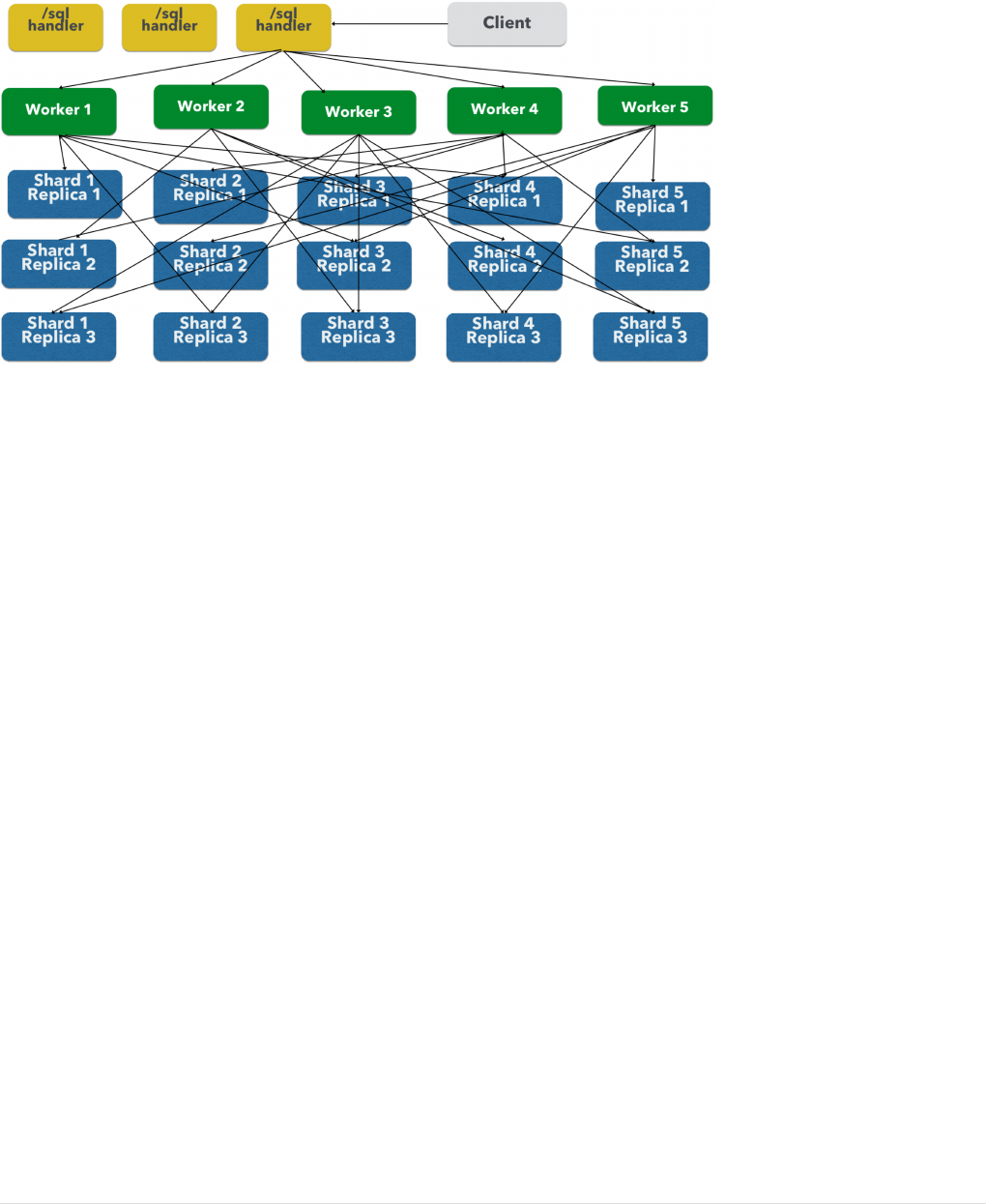
Data Table Tier
The Data Table tier is where the tables reside. Each table is its own SolrCloud collection. The Data Table layer
receives queries from the worker nodes and emits tuples (search results). The Data Table tier also handles
the initial sorting and partitioning of tuples sent to the workers. This means the tuples are always sorted and
partitioned before they hit the network. The partitioned tuples are sent directly to the correct worker nodes
in the proper sort order, ready to be reduced.
How Parallel SQL Queries are Distributed
The image above shows the three tiers broken out into different SolrCloud collections for clarity. In practice
the /sql handler and worker collection by default share the same collection.
Note: The image shows the network flow for a single Parallel SQL Query (SQL over MapReduce). This
network flow is used when map_reduce aggregation mode is used for GROUP BY aggregations or the SELECT
DISTINCT query. The traditional SolrCloud network flow (without workers) is used when the facet
aggregation mode is used.
Below is a description of the flow:
1. The client sends a SQL query to the /sql handler. The request is handled by a single /sql handler
instance.
2. The /sql handler parses the SQL query and creates the parallel query plan.
3. The query plan is sent to worker nodes (in green).
4. The worker nodes execute the plan in parallel. The diagram shows each worker node contacting a
collection in the Data Table tier (in blue).
5. The collection in the Data Table tier is the table from the SQL query. Notice that the collection has five
shards each with 3 replicas.
6. Notice that each worker contacts one replica from each shard. Because there are 5 workers, each worker
is returned 1/5 of the search results from each shard. The partitioning is done inside of the Data Table
tier so there is no duplication of data across the network.
7. Also notice with this design ALL replicas in the data layer are shuffling (sorting & partitioning) data
simultaneously. As the number of shards, replicas and workers grows this design allows for a massive
amount of computing power to be applied to a single query.
Page 700 of 1426 Apache Solr Reference Guide 7.7
Guide Version 7.7 - Published: 2019-03-04 © 2019, Apache Software Foundation

8. The worker nodes process the tuples returned from the Data Table tier in parallel. The worker nodes
perform the relational algebra needed to satisfy the query plan.
9. The worker nodes stream tuples back to the /sql handler where the final merge is done, and finally the
tuples are streamed back to the client.
SQL Clients and Database Visualization Tools
The SQL interface supports queries sent from SQL clients and database visualization tools such as
DbVisualizer and Apache Zeppelin.
Generic Clients
For most Java based clients, the following jars will need to be placed on the client classpath:
•all .jars found in $SOLR_HOME/dist/solrj-libs
•the SolrJ .jar found at $SOLR_HOME/dist/solr-solrj-<version>.jar
If you are using Maven, the org.apache.solr.solr-solrj artifact contains the required jars.
Once the jars are available on the classpath, the Solr JDBC driver name is
org.apache.solr.client.solrj.io.sql.DriverImpl and a connection can be made with the following
connection string format:
jdbc:solr://SOLR_ZK_CONNECTION_STRING?collection=COLLECTION_NAME
There are other parameters that can be optionally added to the connection string like aggregationMode and
numWorkers.
DbVisualizer
A step-by-step guide for setting up DbVisualizer is in the section Solr JDBC - DbVisualizer.
SQuirreL SQL
A step-by-step guide for setting up SQuirreL SQL is in the section Solr JDBC - SQuirreL SQL.
Apache Zeppelin (incubating)
A step-by-step guide for setting up Apache Zeppelin is in the section Solr JDBC - Apache Zeppelin.
Python/Jython
Examples of using Python and Jython for connecting to Solr with the Solr JDBC driver are available in the
section Solr JDBC - Python/Jython.
R
Examples of using R for connecting to Solr with the Solr JDBC driver are available in the section Solr JDBC - R.
Apache Solr Reference Guide 7.7 Page 701 of 1426
© 2019, Apache Software Foundation Guide Version 7.7 - Published: 2019-03-04

Solr JDBC - DbVisualizer
Solr’s JDBC driver supports DBVisualizer for querying Solr.
For DbVisualizer, you will need to create a new driver for Solr using the DbVisualizer Driver Manager. This
will add several SolrJ client .jars to the DbVisualizer classpath. The files required are:
•all .jars found in $SOLR_HOME/dist/solrj-lib
•the SolrJ .jar found at $SOLR_HOME/dist/solr-solrj-<version>.jar
Once the driver has been created, you can create a connection to Solr with the connection string format
outlined in the generic section and use the SQL Commander to issue queries.
Setup Driver
Open Driver Manager
From the Tools menu, choose Driver Manager to add a driver.
Create a New Driver
Page 702 of 1426 Apache Solr Reference Guide 7.7
Guide Version 7.7 - Published: 2019-03-04 © 2019, Apache Software Foundation
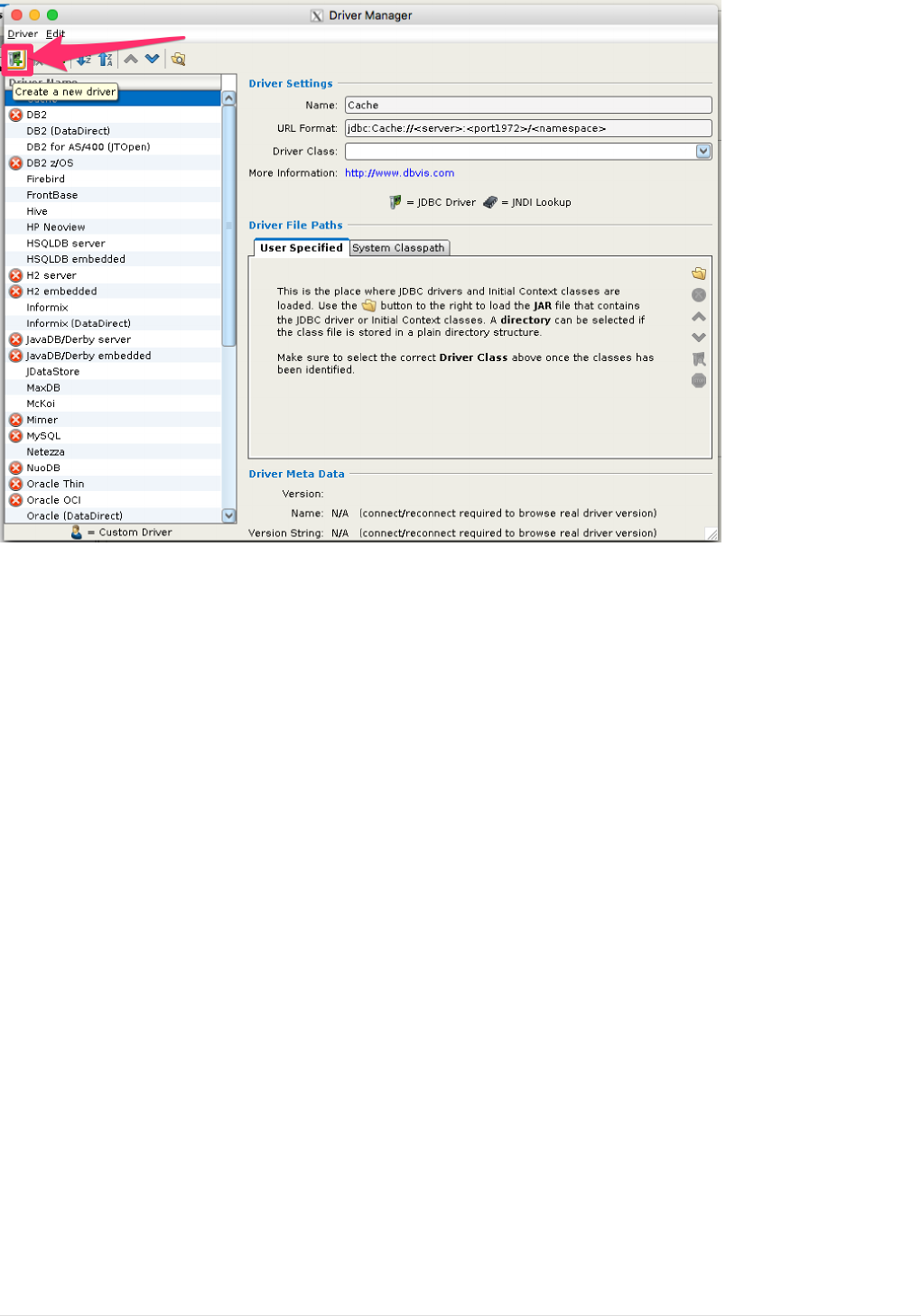
Name the Driver in Driver Manager
Provide a name for the driver, and provide the URL format:
jdbc:solr://<zk_connection_string>/?collection=<collection>. Do not fill in values for the variables
“zk_connection_string” and “collection”, those will be provided later when the connection to Solr is
configured. The Driver Class will also be automatically added when the driver .jars are added.
Apache Solr Reference Guide 7.7 Page 703 of 1426
© 2019, Apache Software Foundation Guide Version 7.7 - Published: 2019-03-04

Add Driver Files to Classpath
The driver files to be added are:
•all .jars in $SOLR_HOME/dist/solrj-lib
•the SolrJ .jar found in $SOLR_HOME/dist/solr-solrj-<version>.jar
Page 704 of 1426 Apache Solr Reference Guide 7.7
Guide Version 7.7 - Published: 2019-03-04 © 2019, Apache Software Foundation

Apache Solr Reference Guide 7.7 Page 705 of 1426
© 2019, Apache Software Foundation Guide Version 7.7 - Published: 2019-03-04

Page 706 of 1426 Apache Solr Reference Guide 7.7
Guide Version 7.7 - Published: 2019-03-04 © 2019, Apache Software Foundation
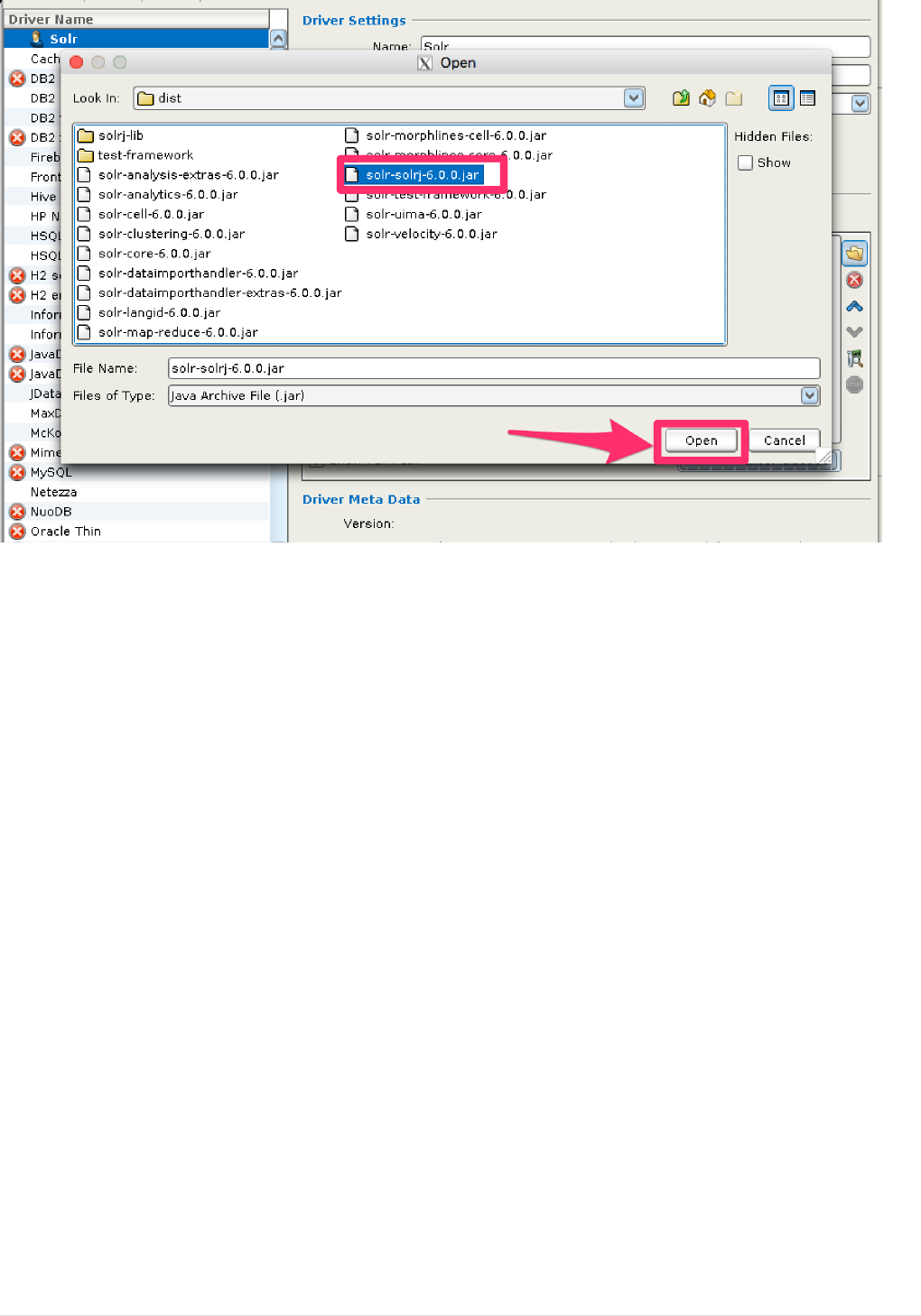
Review and Close Driver Manager
Once the driver files have been added, you can close the Driver Manager.
Create a Connection
Next, create a connection to Solr using the driver just created.
Use the Connection Wizard
Apache Solr Reference Guide 7.7 Page 707 of 1426
© 2019, Apache Software Foundation Guide Version 7.7 - Published: 2019-03-04

Name the Connection
Page 708 of 1426 Apache Solr Reference Guide 7.7
Guide Version 7.7 - Published: 2019-03-04 © 2019, Apache Software Foundation
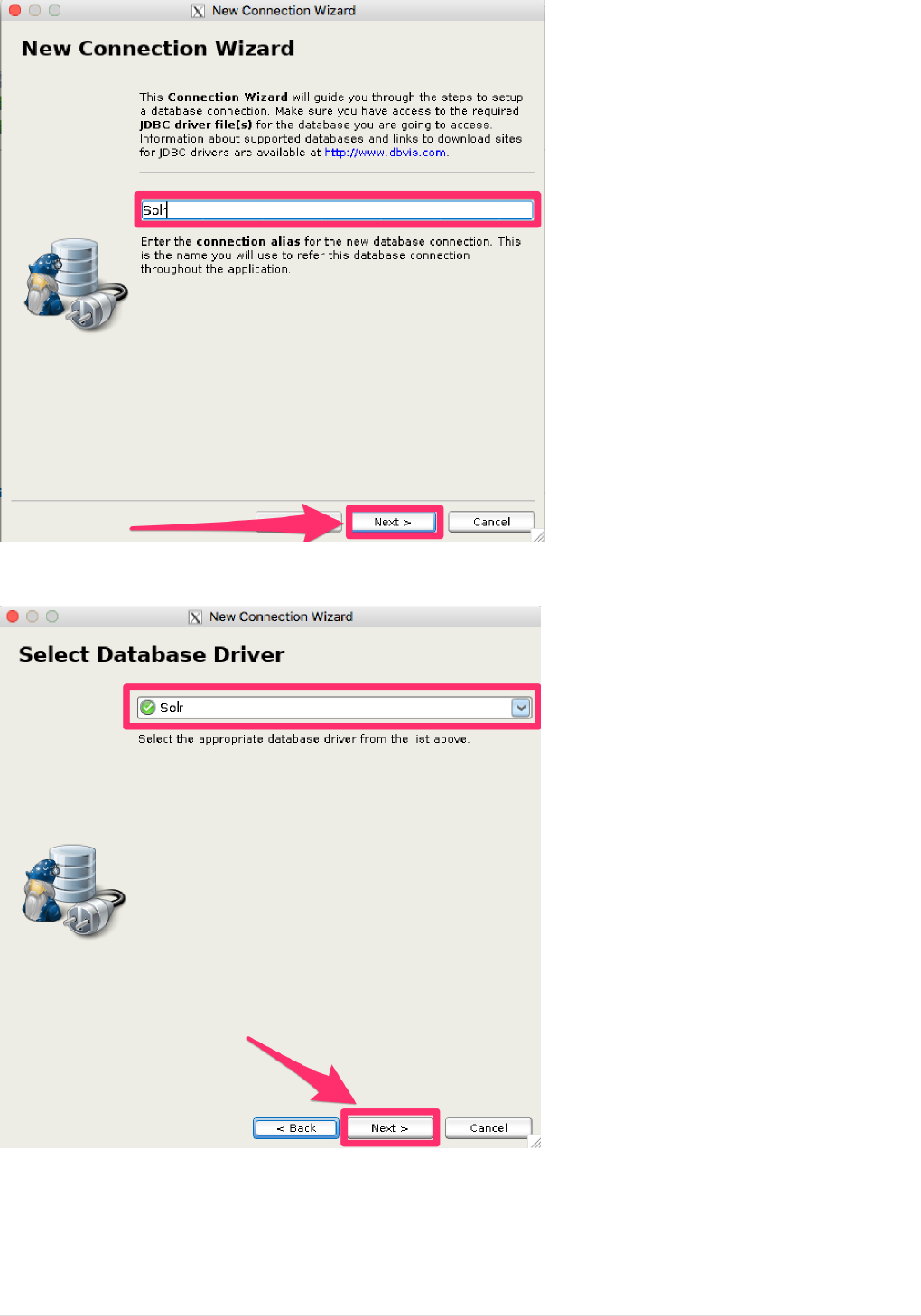
Select the Solr driver
Specify the Solr URL
Provide the Solr URL, using the ZooKeeper host and port and the collection. For example,
jdbc:solr://localhost:9983?collection=test
Apache Solr Reference Guide 7.7 Page 709 of 1426
© 2019, Apache Software Foundation Guide Version 7.7 - Published: 2019-03-04

Open and Connect to Solr
Once the connection has been created, double-click on it to open the connection details screen and connect
to Solr.
Page 710 of 1426 Apache Solr Reference Guide 7.7
Guide Version 7.7 - Published: 2019-03-04 © 2019, Apache Software Foundation
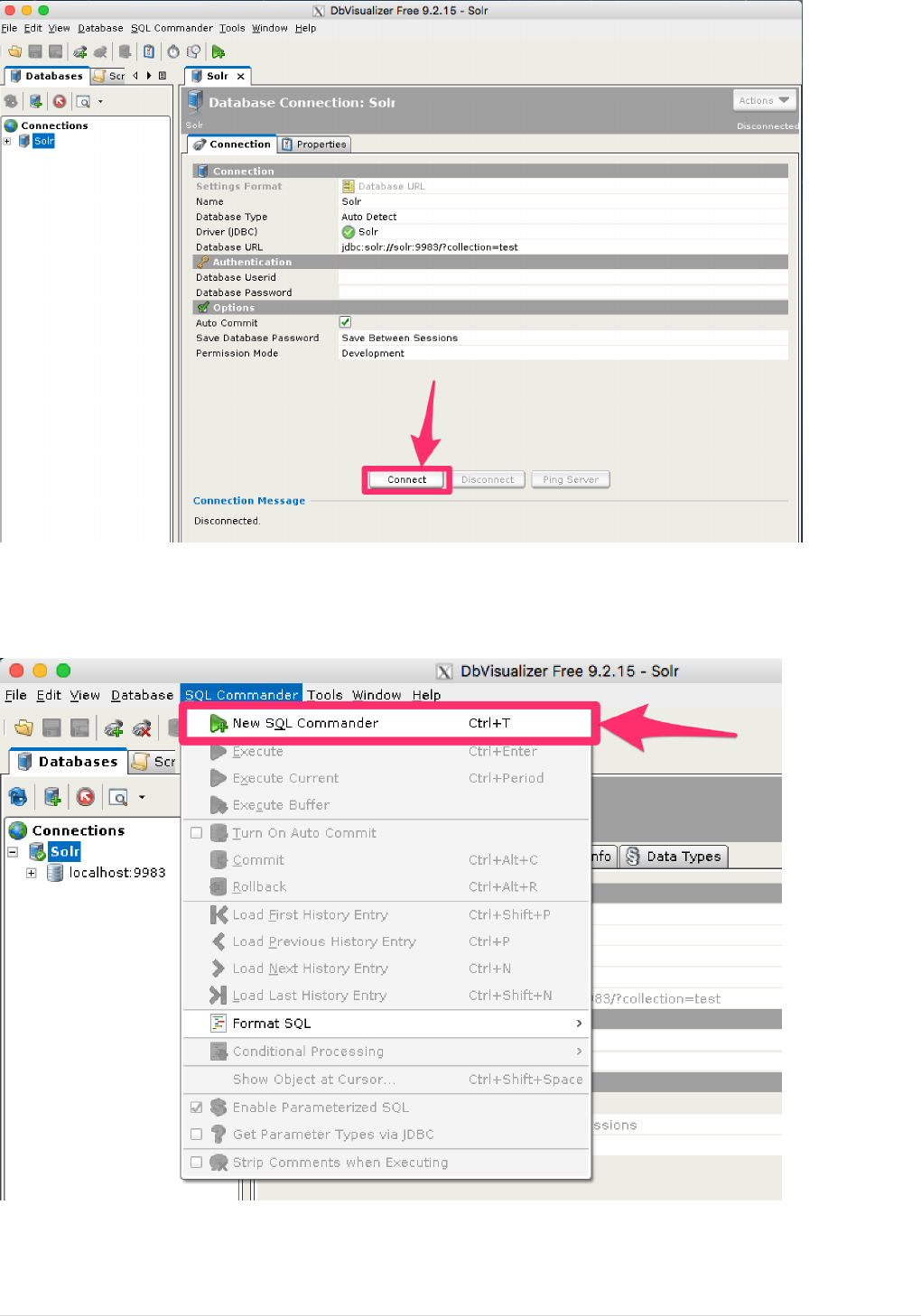
Open SQL Commander to Enter Queries
When the connection is established, you can use the SQL Commander to issue queries and view data.
Apache Solr Reference Guide 7.7 Page 711 of 1426
© 2019, Apache Software Foundation Guide Version 7.7 - Published: 2019-03-04

Solr JDBC - SQuirreL SQL
For SQuirreL SQL, you will need to create a new driver for Solr. This will add several SolrJ client .jars to the
SQuirreL SQL classpath. The files required are:
•all .jars found in $SOLR_HOME/dist/solrj-libs
•the SolrJ .jar found at $SOLR_HOME/dist/solr-solrj-<version>.jar
Once the driver has been created, you can create a connection to Solr with the connection string format
outlined in the generic section and use the editor to issue queries.
Add Solr JDBC Driver
Open Drivers
Page 712 of 1426 Apache Solr Reference Guide 7.7
Guide Version 7.7 - Published: 2019-03-04 © 2019, Apache Software Foundation
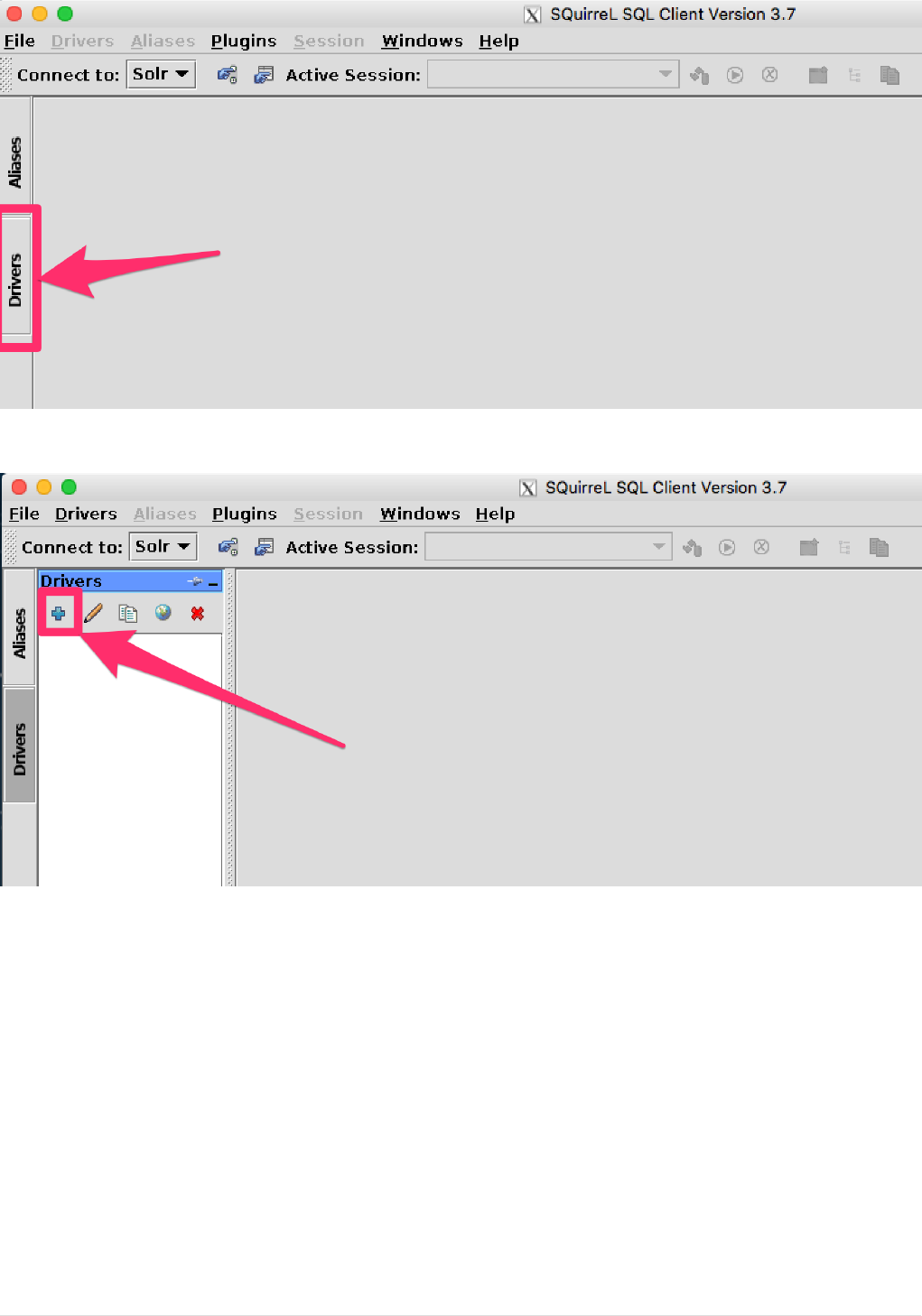
Add Driver
Name the Driver
Provide a name for the driver, and provide the URL format:
jdbc:solr://<zk_connection_string>/?collection=<collection>. Do not fill in values for the variables
“zk_connection_string” and “collection”, those will be defined later when the connection to Solr is
configured.
Apache Solr Reference Guide 7.7 Page 713 of 1426
© 2019, Apache Software Foundation Guide Version 7.7 - Published: 2019-03-04
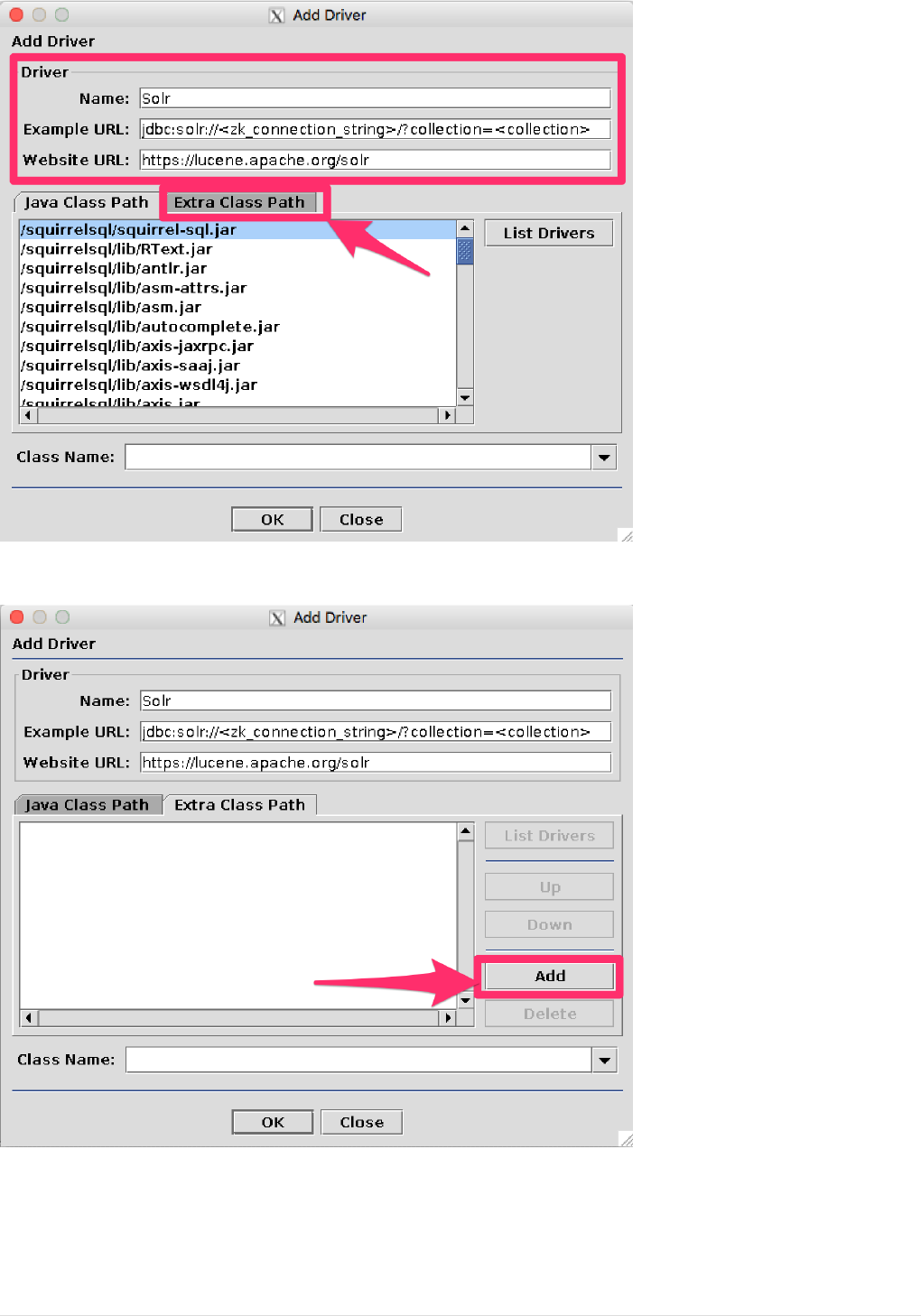
Add Solr JDBC jars to Classpath
Page 714 of 1426 Apache Solr Reference Guide 7.7
Guide Version 7.7 - Published: 2019-03-04 © 2019, Apache Software Foundation
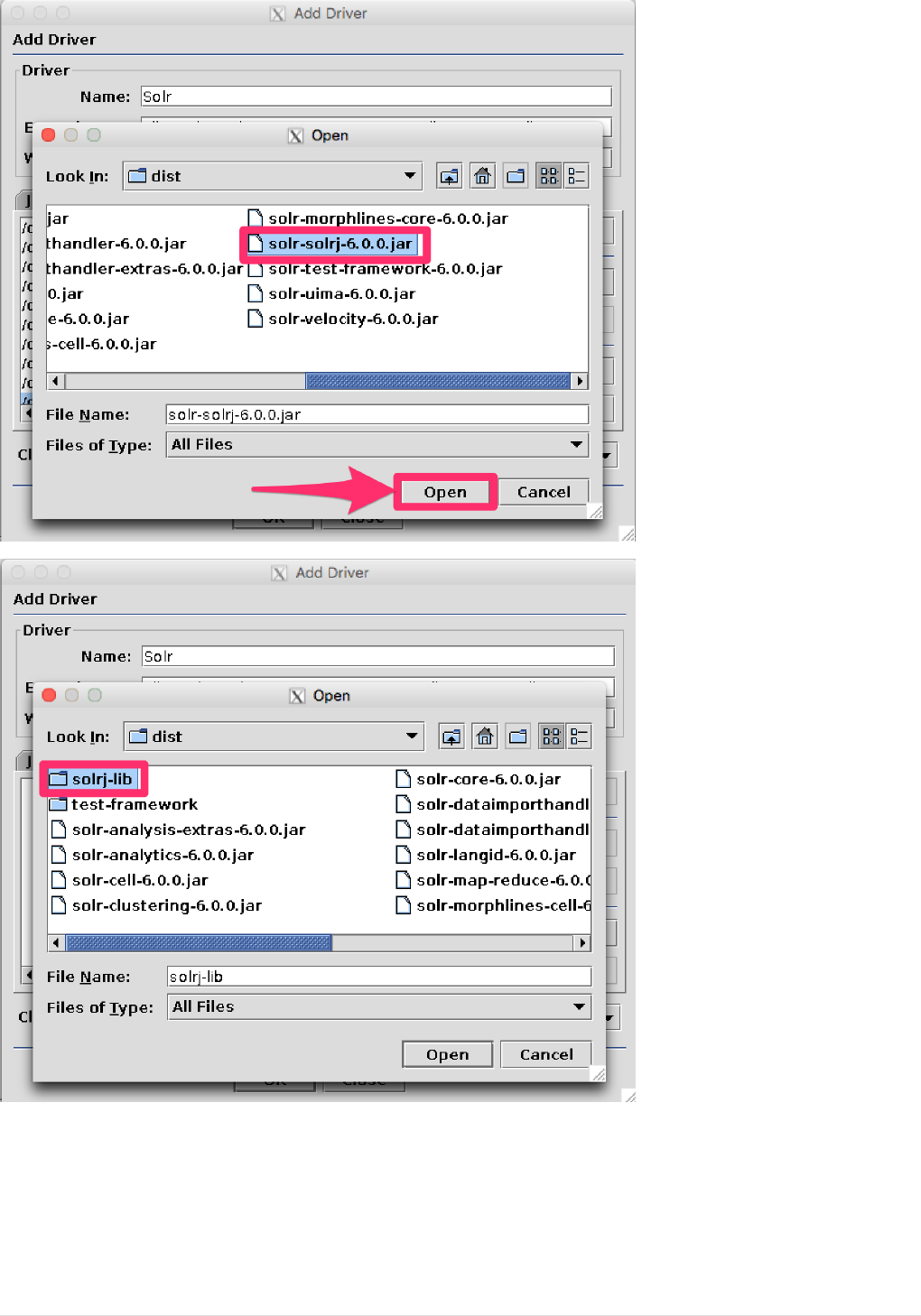
Apache Solr Reference Guide 7.7 Page 715 of 1426
© 2019, Apache Software Foundation Guide Version 7.7 - Published: 2019-03-04

Add the Solr JDBC driver class name
After adding the .jars, you will need to additionally define the Class Name
org.apache.solr.client.solrj.io.sql.DriverImpl.
Page 716 of 1426 Apache Solr Reference Guide 7.7
Guide Version 7.7 - Published: 2019-03-04 © 2019, Apache Software Foundation
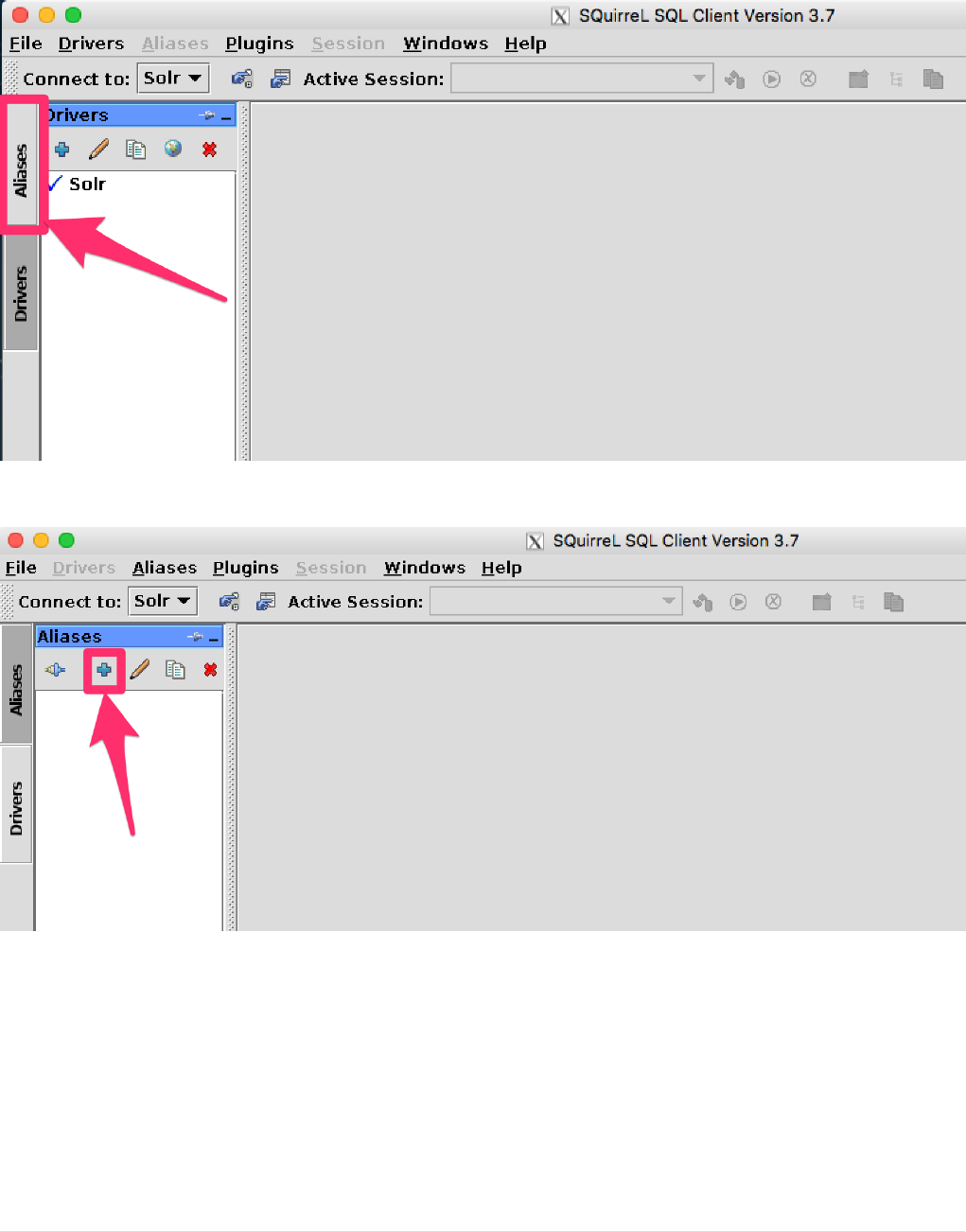
Create an Alias
To define a JDBC connection, you must define an alias.
Open Aliases
Add an Alias
Configure the Alias
Apache Solr Reference Guide 7.7 Page 717 of 1426
© 2019, Apache Software Foundation Guide Version 7.7 - Published: 2019-03-04
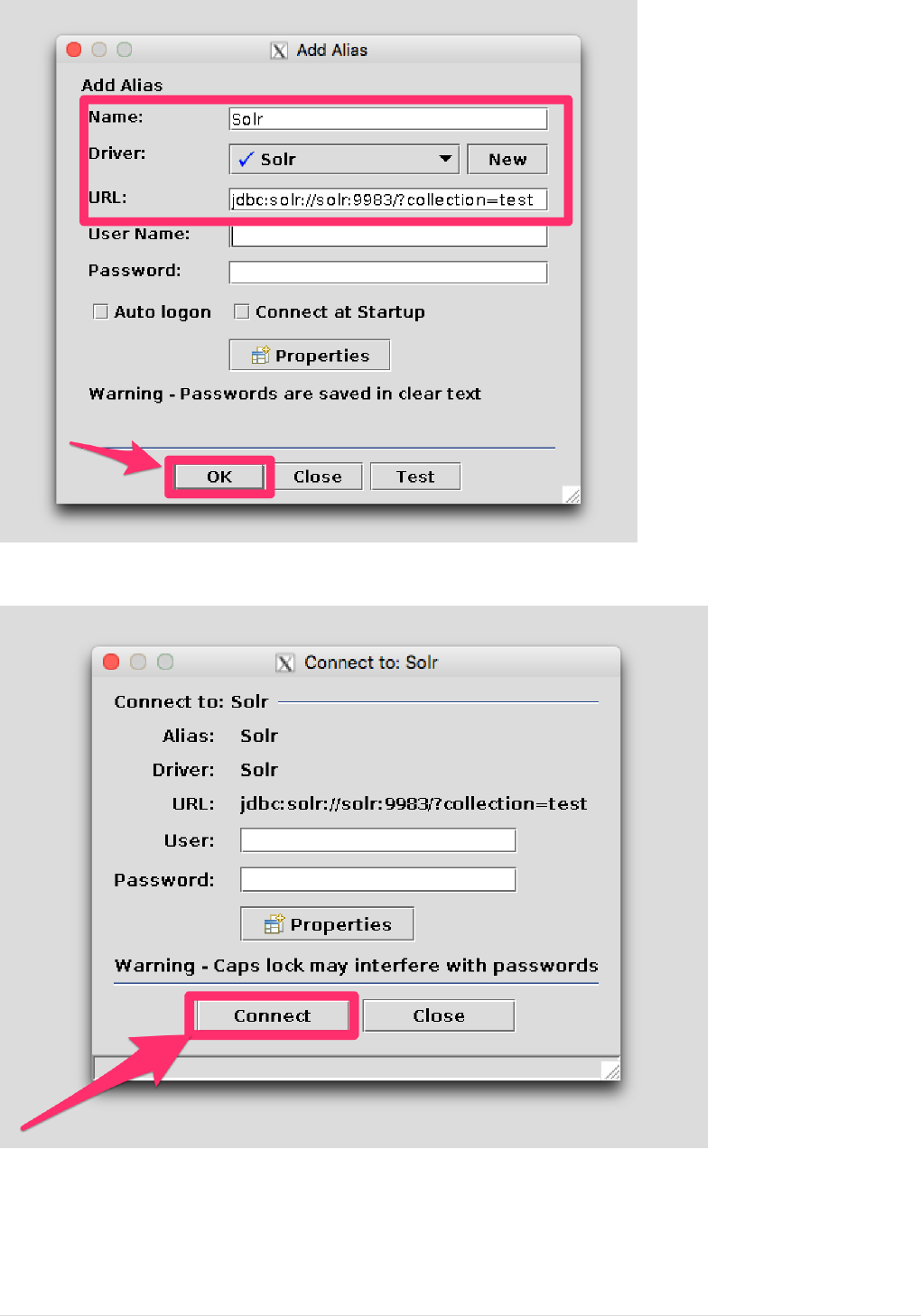
Connect to the Alias
Querying
Once you’ve successfully connected to Solr, you can use the SQL interface to enter queries and work with
Page 718 of 1426 Apache Solr Reference Guide 7.7
Guide Version 7.7 - Published: 2019-03-04 © 2019, Apache Software Foundation

data.
Solr JDBC - Apache Zeppelin
The Solr JDBC driver can support Apache Zeppelin.
This requires Apache Zeppelin 0.6.0 or greater which contains the JDBC interpreter.
To use Apache Zeppelin with Solr, you will need to create a JDBC interpreter for Solr. This will add SolrJ to the
interpreter classpath. Once the interpreter has been created, you can create a notebook to issue queries.
The Apache Zeppelin JDBC interpreter documentation provides additional information about JDBC prefixes
and other features.
Create the Apache Solr JDBC Interpreter
Apache Solr Reference Guide 7.7 Page 719 of 1426
© 2019, Apache Software Foundation Guide Version 7.7 - Published: 2019-03-04
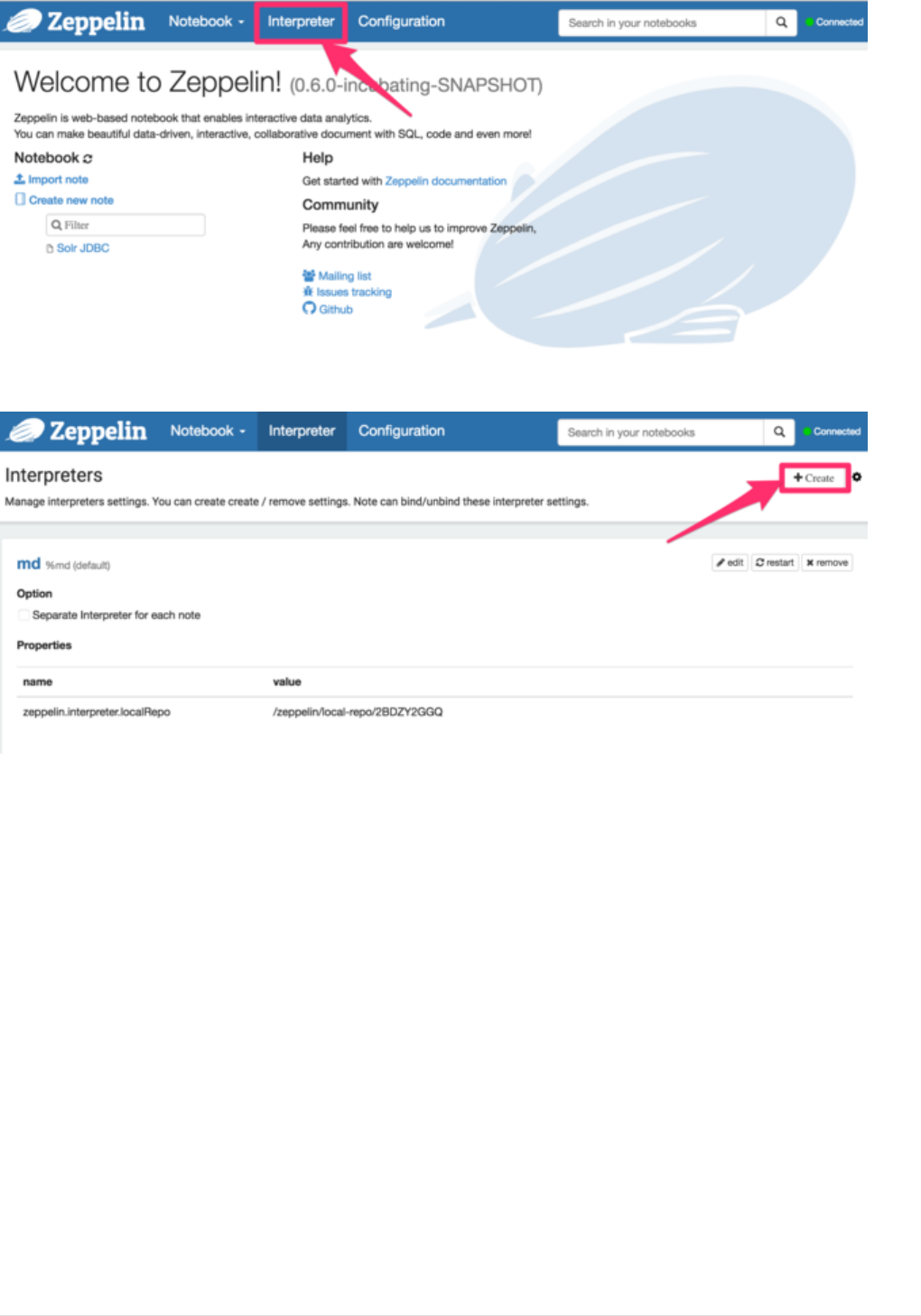
Click "Interpreter" in the top navigation
Click "Create"
Page 720 of 1426 Apache Solr Reference Guide 7.7
Guide Version 7.7 - Published: 2019-03-04 © 2019, Apache Software Foundation
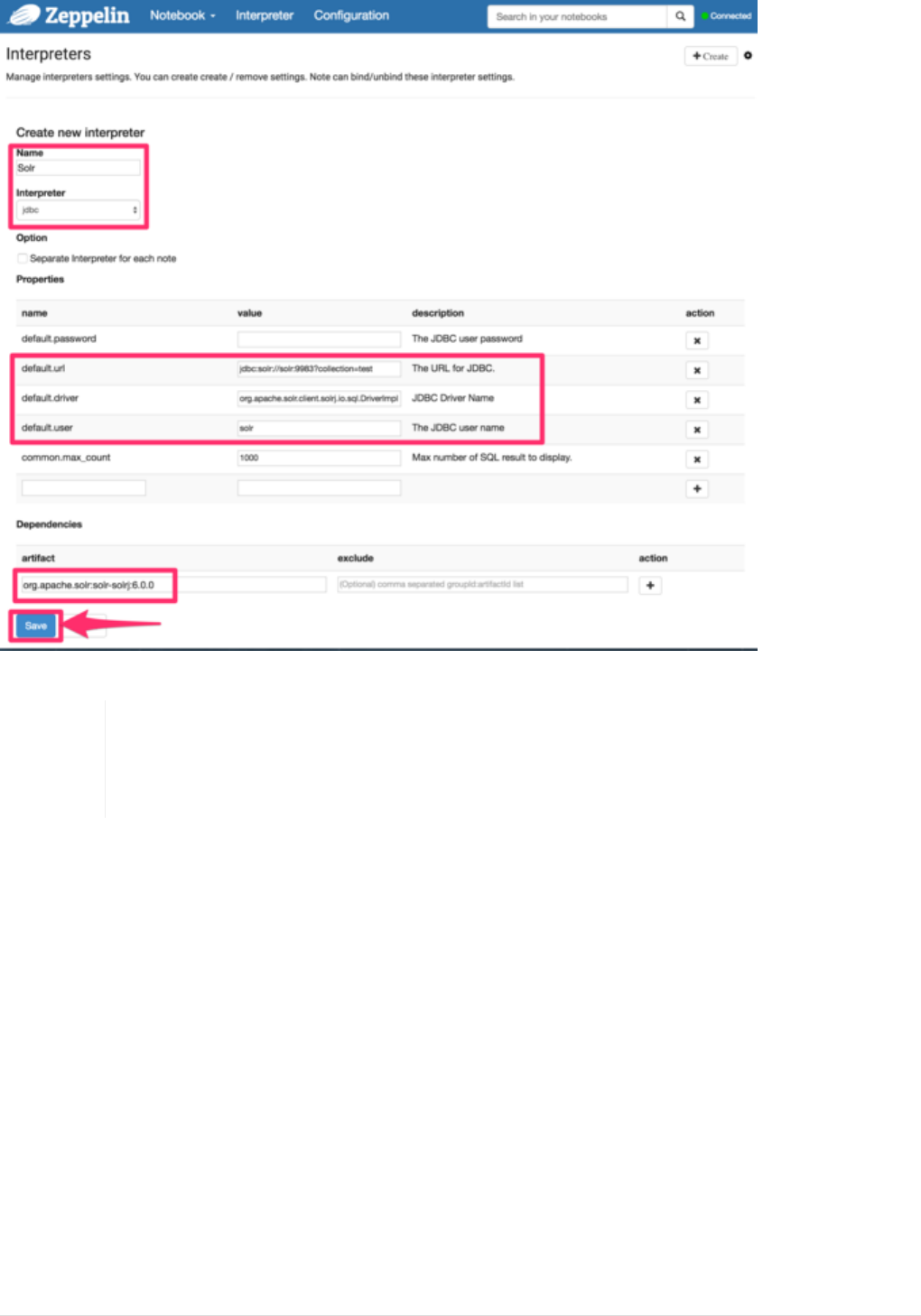
Enter information about your Solr installation
For most installations, Apache Zeppelin configures PostgreSQL as the JDBC interpreter
default driver. The default driver can either be replaced by the Solr driver as outlined above
or you can add a separate JDBC interpreter prefix as outlined in the Apache Zeppelin JDBC
interpreter documentation.
Create a Notebook
Apache Solr Reference Guide 7.7 Page 721 of 1426
© 2019, Apache Software Foundation Guide Version 7.7 - Published: 2019-03-04
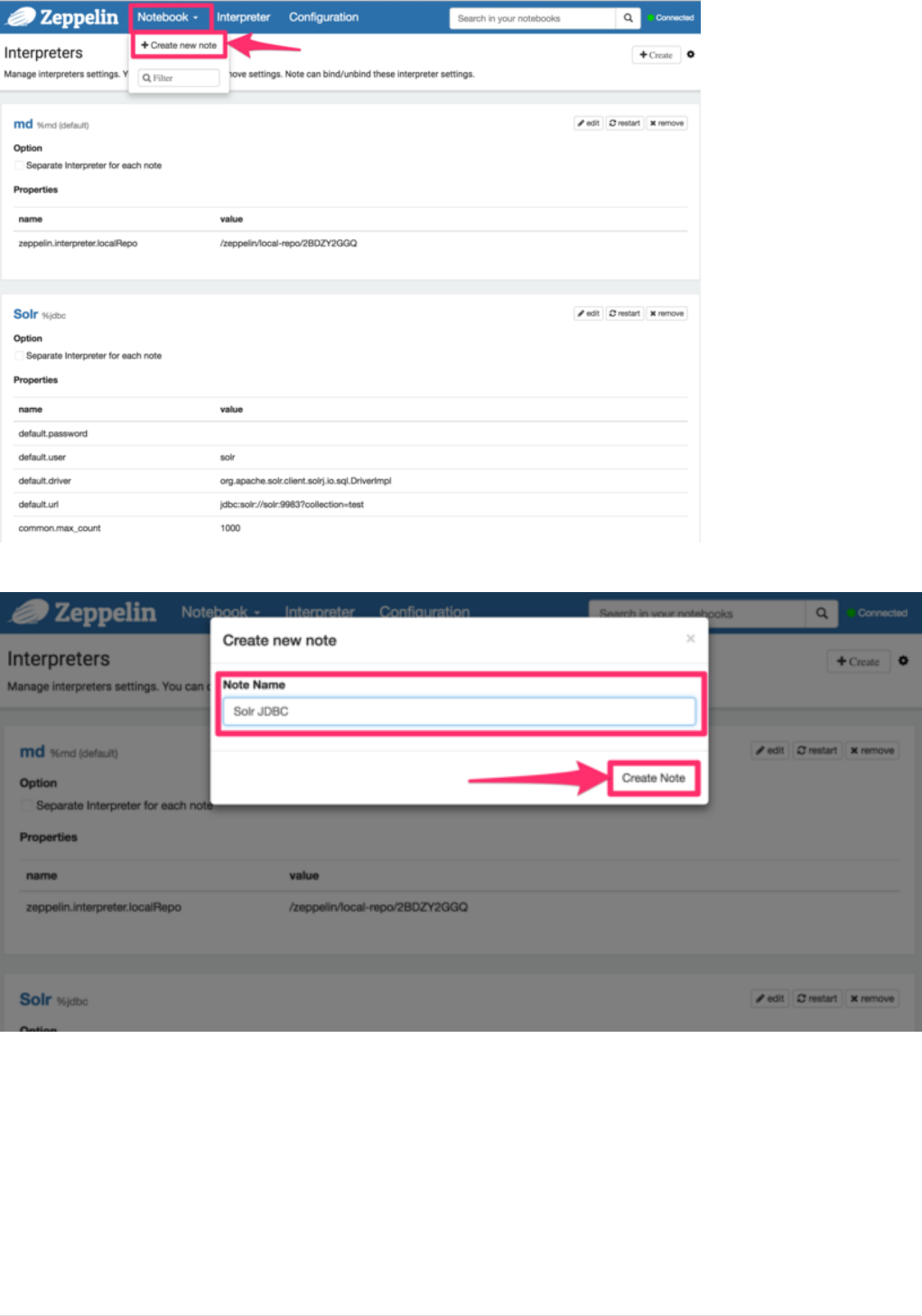
Click Notebook -> Create new note
Provide a name and click "Create Note"
JDBC Interpreter Copy Sheet
To facilitate easy copying the parameters mentioned in the screenshots, here is a consolidated list of the
parameters:
Page 722 of 1426 Apache Solr Reference Guide 7.7
Guide Version 7.7 - Published: 2019-03-04 © 2019, Apache Software Foundation
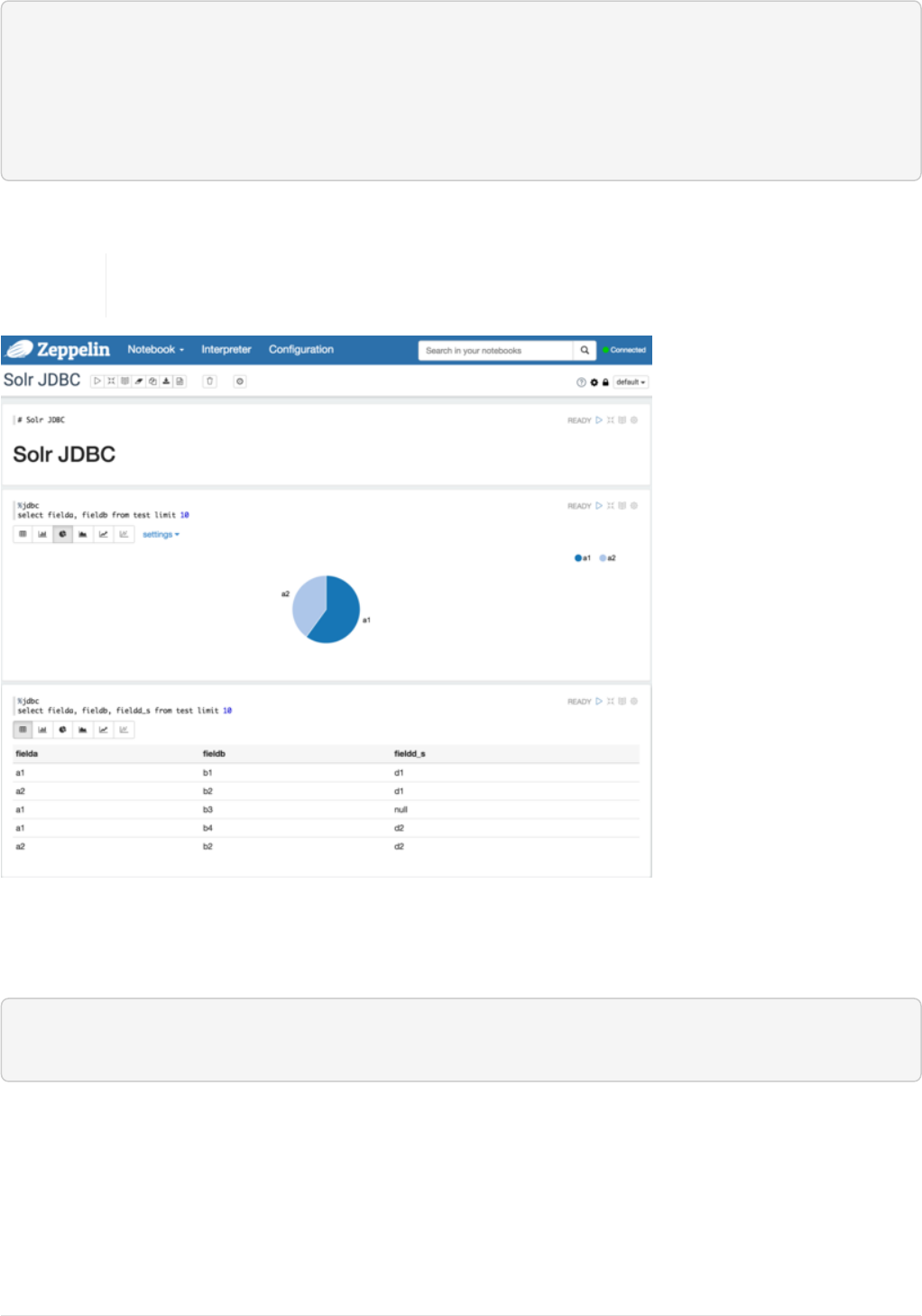
Name : Solr
Interpreter : jdbc
default.url : jdbc:solr://SOLR_ZK_CONNECTION_STRING?collection=<collection_name>
default.driver : org.apache.solr.client.solrj.io.sql.DriverImpl
default.user : solr
dependency : org.apache.solr:solr-solrj:7.7.0
Query with the Notebook
For some notebooks, the JDBC interpreter will not be bound to the notebook by default.
Instructions on how to bind the JDBC interpreter to a notebook are available here.
Results of Solr query
The below code block assumes that the Apache Solr driver is setup as the default JDBC interpreter driver. If
that is not the case, instructions for using a different prefix is available here.
%jdbc
select fielda, fieldb, from test limit 10
Solr JDBC - Python/Jython
Solr’s JDBC driver supports Python and Jython.
Apache Solr Reference Guide 7.7 Page 723 of 1426
© 2019, Apache Software Foundation Guide Version 7.7 - Published: 2019-03-04

Python
Python supports accessing JDBC using the JayDeBeApi library. The CLASSPATH variable must be configured
to contain the solr-solrj jar and the supporting solrj-lib jars.
JayDeBeApi
run.sh
#!/usr/bin/env bash
# Java must already be installed
pip install JayDeBeApi
export CLASSPATH="$(echo $(ls /opt/solr/dist/solr-solrj* /opt/solr/dist/solrj-lib/*) | tr ' '
':')"
python solr_jaydebeapi.py
solr_jaydebeapi.py
#!/usr/bin/env python
# https://pypi.python.org/pypi/JayDeBeApi/
import jaydebeapi
import sys
if __name__ == '__main__':
Ê jdbc_url = "jdbc:solr://localhost:9983?collection=test"
Ê driverName = "org.apache.solr.client.solrj.io.sql.DriverImpl"
Ê statement = "select fielda, fieldb, fieldc, fieldd_s, fielde_i from test limit 10"
Ê conn = jaydebeapi.connect(driverName, jdbc_url)
Ê curs = conn.cursor()
Ê curs.execute(statement)
Ê print(curs.fetchall())
Ê conn.close()
Ê sys.exit(0)
Jython
Jython supports accessing JDBC natively with Java interfaces or with the zxJDBC library. The CLASSPATH
variable must be configured to contain the solr-solrj jar and the supporting solrj-lib jars.
Page 724 of 1426 Apache Solr Reference Guide 7.7
Guide Version 7.7 - Published: 2019-03-04 © 2019, Apache Software Foundation

run.sh
#!/usr/bin/env bash
# Java and Jython must already be installed
export CLASSPATH="$(echo $(ls /opt/solr/dist/solr-solrj* /opt/solr/dist/solrj-lib/*) | tr ' '
':')"
jython [solr_java_native.py | solr_zxjdbc.py]
Java Native
solr_java_native.py
#!/usr/bin/env jython
# http://www.jython.org/jythonbook/en/1.0/DatabasesAndJython.html
# https://wiki.python.org/jython/DatabaseExamples#SQLite_using_JDBC
import sys
from java.lang import Class
from java.sql import DriverManager, SQLException
if __name__ == '__main__':
Ê jdbc_url = "jdbc:solr://localhost:9983?collection=test"
Ê driverName = "org.apache.solr.client.solrj.io.sql.DriverImpl"
Ê statement = "select fielda, fieldb, fieldc, fieldd_s, fielde_i from test limit 10"
Ê dbConn = DriverManager.getConnection(jdbc_url)
Ê stmt = dbConn.createStatement()
Ê resultSet = stmt.executeQuery(statement)
Ê while resultSet.next():
Ê print(resultSet.getString("fielda"))
Ê resultSet.close()
Ê stmt.close()
Ê dbConn.close()
Ê sys.exit(0)
zxJDBC
Apache Solr Reference Guide 7.7 Page 725 of 1426
© 2019, Apache Software Foundation Guide Version 7.7 - Published: 2019-03-04

solr_zxjdbc.py
#!/usr/bin/env jython
# http://www.jython.org/jythonbook/en/1.0/DatabasesAndJython.html
# https://wiki.python.org/jython/DatabaseExamples#SQLite_using_ziclix
import sys
from com.ziclix.python.sql import zxJDBC
if __name__ == '__main__':
Ê jdbc_url = "jdbc:solr://localhost:9983?collection=test"
Ê driverName = "org.apache.solr.client.solrj.io.sql.DriverImpl"
Ê statement = "select fielda, fieldb, fieldc, fieldd_s, fielde_i from test limit 10"
Ê with zxJDBC.connect(jdbc_url, None, None, driverName) as conn:
Ê with conn:
Ê with conn.cursor() as c:
Ê c.execute(statement)
Ê print(c.fetchall())
Ê sys.exit(0)
Solr JDBC - R
R supports accessing JDBC using the RJDBC library.
RJDBC
run.sh
#!/usr/bin/env bash
# Java must already be installed and R configured with `R CMD javareconf`
Rscript -e 'install.packages("RJDBC", dep=TRUE)'
Rscript solr_rjdbc.R
Page 726 of 1426 Apache Solr Reference Guide 7.7
Guide Version 7.7 - Published: 2019-03-04 © 2019, Apache Software Foundation

solr_rjdbc.R
# https://www.rforge.net/RJDBC/
library("RJDBC")
solrCP <- c(list.files('/opt/solr/dist/solrj-lib', full.names=TRUE), list.files('/opt/solr/dist',
pattern='solrj', full.names=TRUE, recursive = TRUE))
drv <- JDBC("org.apache.solr.client.solrj.io.sql.DriverImpl",
Ê solrCP,
Ê identifier.quote="`")
conn <- dbConnect(drv, "jdbc:solr://localhost:9983?collection=test", "user", "pwd")
dbGetQuery(conn, "select fielda, fieldb, fieldc, fieldd_s, fielde_i from test limit 10")
dbDisconnect(conn)
Apache Solr Reference Guide 7.7 Page 727 of 1426
© 2019, Apache Software Foundation Guide Version 7.7 - Published: 2019-03-04

Analytics Component
The Analytics Component allows users to calculate complex statistical aggregations over result sets.
The component enables interacting with data in a variety of ways, both through a diverse set of analytics
functions as well as powerful faceting functionality. The standard facets are supported within the analytics
component with additions that leverage its analytical capabilities.
Analytics Configuration
The Analytics component is in a contrib module, therefore it will need to be enabled in the solrconfig.xml
for each collection where you would like to use it.
Since the Analytics framework is a search component, it must be declared as such and added to the search
handler.
For distributed analytics requests over cloud collections, the component uses the AnalyticsHandler strictly
for inter-shard communication. The Analytics Handler should not be used by users to submit analytics
requests.
To configure Solr to use the Analytics Component, the first step is to add a <lib/> directive so Solr loads the
Analytic Component classes (for more about the <lib/> directive, see Lib Directives in SolrConfig). In the
section of solrconfig.xml where the default <lib/> directives are, add a line:
<lib dir="${solr.install.dir:../../../..}/dist/" regex="solr-analytics-\d.*\.jar" />
Next you need to enable the request handler and search component. Add the following lines to
solrconfig.xml, near the defintions for other request handlers:
solrconfig.xml
<!-- To handle user requests -->
<searchComponent name="analytics" class="org.apache.solr.handler.component.AnalyticsComponent" />
<requestHandler name="/select" class="solr.SearchHandler">
Ê <arr name="last_components">
Ê <str>analytics</str>
Ê </arr>
</requestHandler>
<!-- For inter-shard communication during distributed requests -->
<requestHandler name="/analytics" class="org.apache.solr.handler.AnalyticsHandler" />
For these changes to take effect, restart Solr or reload the core or collection.
Request Syntax
An Analytics request is passed to Solr with the parameter analytics in a request sent to the Search Handler.
Since the analytics request is sent inside of a search handler request, it will compute results based on the
Page 728 of 1426 Apache Solr Reference Guide 7.7
Guide Version 7.7 - Published: 2019-03-04 © 2019, Apache Software Foundation

result set determined by the search handler.
For example, this curl command encodes and POSTs a simple analytics request to the the search handler:
curl --data-urlencode 'analytics={
Ê "expressions" : {
Ê "revenue" : "sum(mult(price,quantity))"
Ê }
Ê }'
Ê http://localhost:8983/solr/sales/select?q=*:*&wt=json&rows=0
There are 3 main parts of any analytics request:
Expressions
A list of calculations to perform over the entire result set. Expressions aggregate the search results into a
single value to return. This list is entirely independent of the expressions defined in each of the
groupings. Find out more about them in the section Expressions.
Functions
One or more Variable Functions to be used throughout the rest of the request. These are essentially
lambda functions and can be combined in a number of ways. These functions for the expressions defined
in expressions as well as groupings.
Groupings
The list of Groupings to calculate in addition to the expressions. Groupings hold a set of facets and a list
of expressions to compute over those facets. The expressions defined in a grouping are only calculated
over the facets defined in that grouping.
Optional Parameters
Either the expressions or the groupings parameter must be present in the request, or else
there will be no analytics to compute. The functions parameter is always optional.
Apache Solr Reference Guide 7.7 Page 729 of 1426
© 2019, Apache Software Foundation Guide Version 7.7 - Published: 2019-03-04

Example Analytics Request
{
Ê "functions": {
Ê "sale()": "mult(price,quantity)"
Ê },
Ê "expressions" : {
Ê "max_sale" : "max(sale())",
Ê "med_sale" : "median(sale())"
Ê },
Ê "groupings" : {
Ê "sales" : {
Ê "expressions" : {
Ê "stddev_sale" : "stddev(sale())",
Ê "min_price" : "min(price)",
Ê "max_quantity" : "max(quantity)"
Ê },
Ê "facets" : {
Ê "category" : {
Ê "type" : "value",
Ê "expression" : "fill_missing(category, 'No Category')",
Ê "sort" : {
Ê "criteria" : [
Ê {
Ê "type" : "expression",
Ê "expression" : "min_price",
Ê "direction" : "ascending"
Ê },
Ê {
Ê "type" : "facetvalue",
Ê "direction" : "descending"
Ê }
Ê ],
Ê "limit" : 10
Ê }
Ê },
Ê "temps" : {
Ê "type" : "query",
Ê "queries" : {
Ê "hot" : "temp:[90 TO *]",
Ê "cold" : "temp:[* TO 50]"
Ê }
Ê }
Ê }
Ê }
Ê }
}
Expressions
Expressions are the way to request pieces of information from the analytics component. These are the
Page 730 of 1426 Apache Solr Reference Guide 7.7
Guide Version 7.7 - Published: 2019-03-04 © 2019, Apache Software Foundation

statistical expressions that you want computed and returned in your response.
Constructing an Expression
Expression Components
An expression is built using fields, constants, mapping functions and reduction functions. The ways that
these can be defined are described below.
Sources
•Constants: The values defined in the expression. The supported constant types are described in the
Analytics Expression Source Reference.
•Fields: Solr fields that are read from the index. The supported fields are listed in the Analytics
Expression Source Reference.
Mapping Functions
Mapping functions map values for each Solr Document or Reduction. The provided mapping functions
are detailed in the Analytics Mapping Function Reference.
•Unreduced Mapping: Mapping a Field with another Field or Constant returns a value for every Solr
Document. Unreduced mapping functions can take fields, constants as well as other unreduced
mapping functions as input.
•Reduced Mapping: Mapping a Reduction Function with another Reduction Function or Constant
returns a single value.
Reduction Functions
Functions that reduce the values of sources and/or unreduced mapping functions for every Solr
Document to a single value. The provided reduction functions are detailed in the Analytics Reduction
Function Reference.
Component Ordering
The expression components must be used in the following order to create valid expressions.
1. Reduced Mapping Function
a. Constants
b. Reduction Function
i. Sources
ii. Unreduced Mapping Function
A. Sources
B. Unreduced Mapping Function
c. Reduced Mapping Function
2. Reduction Function
This ordering is based on the following rules:
•No reduction function can be an argument of another reduction function. Since all reduction is done
Apache Solr Reference Guide 7.7 Page 731 of 1426
© 2019, Apache Software Foundation Guide Version 7.7 - Published: 2019-03-04

together in one step, one reduction function cannot rely on the result of another.
•No fields can be left unreduced, since the analytics component cannot return a list of values for an
expression (one for every document). Every expression must be reduced to a single value.
•Mapping functions are not necessary when creating functions, however as many nested mappings as
needed can be used.
•Nested mapping functions must be the same type, so either both must be unreduced or both must be
reduced. A reduced mapping function cannot take an unreduced mapping function as a parameter and
vice versa.
Example Construction
With the above definitions and ordering, an example expression can be broken up into its components:
div(sum(a,fill_missing(b,0)),add(10.5,count(mult(a,c)))))
As a whole, this is a reduced mapping function. The div function is a reduced mapping function since it is a
provided mapping function and has reduced arguments.
If we break down the expression further:
•sum(a,fill_missing(b,0)): Reduction Function
sum is a provided reduction function.
◦a: Field
◦fill_missing(b,0): Unreduced Mapping Function
fill_missing is an unreduced mapping function since it is a provided mapping function and has a
field argument.
▪b: Field
▪0: Constant
•add(10.5,count(mult(a,c))): Reduced Mapping Function
add is a reduced mapping function since it is a provided mapping function and has a reduction function
argument.
◦10.5: Constant
◦count(mult(a,c)): Reduction Function
count is a provided reduction function
▪mult(a,c): Unreduced Mapping Function
mult is an unreduced mapping function since it is a provided mapping function and has two field
arguments.
▪a: Field
▪c: Field
Expression Cardinality (Multi-Valued and Single-Valued)
The root of all multi-valued expressions are multi-valued fields. Single-valued expressions can be started
with constants or single-valued fields. All single-valued expressions can be treated as multi-valued
Page 732 of 1426 Apache Solr Reference Guide 7.7
Guide Version 7.7 - Published: 2019-03-04 © 2019, Apache Software Foundation

expressions that contain one value.
Single-valued expressions and multi-valued expressions can be used together in many mapping functions,
as well as multi-valued expressions being used alone, and many single-valued expressions being used
together. For example:
add(<single-valued double>, <single-valued double>, …)
Returns a single-valued double expression where the value of the values of each expression are added.
add(<single-valued double>, <multi-valued double>)
Returns a multi-valued double expression where each value of the second expression is added to the
single value of the first expression.
add(<multi-valued double>, <single-valued double>)
Acts the same as the above function.
add(<multi-valued double>)
Returns a single-valued double expression which is the sum of the multiple values of the parameter
expression.
Types and Implicit Casting
The new analytics component currently supports the types listed in the below table. These types have one-
way implicit casting enabled for the following relationships:
Type Implicitly Casts To
Boolean String
Date Long, String
Integer Long, Float, Double, String
Long Double, String
Float Double, String
Double String
String none
An implicit cast means that if a function requires a certain type of value as a parameter, arguments will be
automatically converted to that type if it is possible.
For example, concat() only accepts string parameters and since all types can be implicitly cast to strings,
any type is accepted as an argument.
This also goes for dynamically typed functions. fill_missing() requires two arguments of the same type.
However, two types that implicitly cast to the same type can also be used.
For example, fill_missing(<long>,<float>) will be cast to fill_missing(<double>,<double>) since long
cannot be cast to float and float cannot be cast to long implicitly.
There is an ordering to implicit casts, where the more specialized type is ordered ahead of the more general
Apache Solr Reference Guide 7.7 Page 733 of 1426
© 2019, Apache Software Foundation Guide Version 7.7 - Published: 2019-03-04

type. Therefore even though both long and float can be implicitly cast to double and string, they will be cast
to double. This is because double is a more specialized type than string, which every type can be cast to.
The ordering is the same as their order in the above table.
Cardinality can also be implicitly cast. Single-valued expressions can always be implicitly cast to multi-valued
expressions, since all single-valued expressions are multi-valued expressions with one value.
Implicit casting will only occur when an expression will not "compile" without it. If an expression follows all
typing rules initially, no implicit casting will occur. Certain functions such as string(), date(), round(),
floor(), and ceil() act as explicit casts, declaring the type that is desired. However round(), floor() and
cell() can return either int or long, depending on the argument type.
Variable Functions
Variable functions are a way to shorten your expressions and make writing analytics queries easier. They are
essentially lambda functions defined in a request.
Example Basic Function
{
Ê "functions" : {
Ê "sale()" : "mult(price,quantity)"
Ê },
Ê "expressions" : {
Ê "max_sale" : "max(sale())",
Ê "med_sale" : "median(sale())"
Ê }
}
In the above request, instead of writing mult(price,quantity) twice, a function sale() was defined to
abstract this idea. Then that function was used in the multiple expressions.
Suppose that we want to look at the sales of specific categories:
{
Ê "functions" : {
Ê "clothing_sale()" : "filter(mult(price,quantity),equal(category,'Clothing'))",
Ê "kitchen_sale()" : "filter(mult(price,quantity),equal(category,\"Kitchen\"))"
Ê },
Ê "expressions" : {
Ê "max_clothing_sale" : "max(clothing_sale())"
Ê , "med_clothing_sale" : "median(clothing_sale())"
Ê , "max_kitchen_sale" : "max(kitchen_sale())"
Ê , "med_kitchen_sale" : "median(kitchen_sale())"
Ê }
}
Page 734 of 1426 Apache Solr Reference Guide 7.7
Guide Version 7.7 - Published: 2019-03-04 © 2019, Apache Software Foundation

Arguments
Instead of making a function for each category, it would be much easier to use category as an input to the
sale() function. An example of this functionality is shown below:
Example Function with Arguments
{
Ê "functions" : {
Ê "sale(cat)" : "filter(mult(price,quantity),equal(category,cat))"
Ê },
Ê "expressions" : {
Ê "max_clothing_sale" : "max(sale(\"Clothing\"))"
Ê , "med_clothing_sale" : "median(sale('Clothing'))"
Ê , "max_kitchen_sale" : "max(sale(\"Kitchen\"))"
Ê , "med_kitchen_sale" : "median(sale('Kitchen'))"
Ê }
}
Variable Functions can take any number of arguments and use them in the function expression as if they
were a field or constant.
Variable Length Arguments
There are analytics functions that take a variable amount of parameters. Therefore there are use cases
where variable functions would need to take a variable amount of parameters.
For example, maybe there are multiple, yet undetermined, number of components to the price of a product.
Functions can take a variable length of parameters if the last parameter is followed by ..
Example Function with a Variable Length Argument
{
Ê "functions" : {
Ê "sale(cat, costs..)" : "filter(mult(add(costs),quantity),equal(category,cat))"
Ê },
Ê "expressions" : {
Ê "max_clothing_sale" : "max(sale('Clothing', material, tariff, tax))"
Ê , "med_clothing_sale" : "median(sale('Clothing', material, tariff, tax))"
Ê , "max_kitchen_sale" : "max(sale('Kitchen', material, construction))"
Ê , "med_kitchen_sale" : "median(sale('Kitchen', material, construction))"
Ê }
}
In the above example a variable length argument is used to encapsulate all of the costs to use for a product.
There is no definite number of arguments requested for the variable length parameter, therefore the
clothing expressions can use 3 and the kitchen expressions can use 2. When the sale() function is called,
costs is expanded to the arguments given.
Therefore in the above request, inside of the sale function:
Apache Solr Reference Guide 7.7 Page 735 of 1426
© 2019, Apache Software Foundation Guide Version 7.7 - Published: 2019-03-04

•add(costs)
is expanded to both of the following:
•add(material, tariff, tax)
•add(material, construction)
For-Each Functions
Advanced Functionality
The following function details are for advanced requests.
Although the above functionality allows for an undefined number of arguments to be passed to a function, it
does not allow for interacting with those arguments.
Many times we might want to wrap each argument in additional functions. For example maybe we want to
be able to look at multiple categories at the same time. So we want to see if category EQUALS x OR
category EQUALS y and so on.
In order to do this we need to use for-each lambda functions, which transform each value of the variable
length parameter. The for-each is started with the : character after the variable length parameter.
Example Function with a For-Each
{
Ê "functions" : {
Ê "sale(cats..)" : "filter(mult(price,quantity),or(cats:equal(category,_)))"
Ê },
Ê "expressions" : {
Ê "max_sale_1" : "max(sale('Clothing', 'Kitchen'))"
Ê , "med_sale_1" : "median(sale('Clothing', 'Kitchen'))"
Ê , "max_sale_2" : "max(sale('Electronics', 'Entertainment', 'Travel'))"
Ê , "med_sale_2" : "median(sale('Electronics', 'Entertainment', 'Travel'))"
Ê }
}
In this example, cats: is the syntax that starts a for-each lambda function over every parameter cats, and
the _ character is used to refer to the value of cats in each iteration in the for-each. When
sale("Clothing", "Kitchen") is called, the lambda function equal(category,_) is applied to both
Clothing and Kitchen inside of the or() function.
Using all of these rules, the expression:
`sale("Clothing","Kitchen")`
is expanded to:
`filter(mult(price,quantity),or(equal(category,"Kitchen"),equal(category,"Clothing")))`
Page 736 of 1426 Apache Solr Reference Guide 7.7
Guide Version 7.7 - Published: 2019-03-04 © 2019, Apache Software Foundation

by the expression parser.
Groupings And Facets
Facets, much like in other parts of Solr, allow analytics results to be broken up and grouped by attributes of
the data that the expressions are being calculated over.
The currently available facets for use in the analytics component are Value Facets, Pivot Facets, Range Facets
and Query Facets. Each facet is required to have a unique name within the grouping it is defined in, and no
facet can be defined outside of a grouping.
Groupings allow users to calculate the same grouping of expressions over a set of facets. Groupings must
have both expressions and facets given.
Example Base Facet Request
{
Ê "functions" : {
Ê "sale()" : "mult(price,quantity)"
Ê },
Ê "groupings" : {
Ê "sales_numbers" : {
Ê "expressions" : {
Ê "max_sale" : "max(sale())",
Ê "med_sale" : "median(sale())"
Ê },
Ê "facets" : {
Ê "<name>" : "< facet request >"
Ê }
Ê }
Ê }
}
Example Base Facet Response
{
Ê "analytics_response" : {
Ê "groupings" : {
Ê "sales_numbers" : {
Ê "<name>" : "< facet response >"
Ê }
Ê }
Ê }
}
Facet Sorting
Some Analytics facets allow for complex sorting of their results. The two current sortable facets are Analytic
Value Facets and Analytic Pivot Facets.
Apache Solr Reference Guide 7.7 Page 737 of 1426
© 2019, Apache Software Foundation Guide Version 7.7 - Published: 2019-03-04

Parameters
criteria
The list of criteria to sort the facet by.
It takes the following parameters:
type
The type of sort. There are two possible values:
•expression: Sort by the value of an expression defined in the same grouping.
•facetvalue: Sort by the string-representation of the facet value.
Direction
(Optional) The direction to sort.
•ascending (Default)
•descending
expression
When type = expression, the name of an expression defined in the same grouping.
limit
Limit the number of returned facet values to the top N. (Optional)
offset
When a limit is set, skip the top N facet values. (Optional)
Example Sort Request
{
Ê "criteria" : [
Ê {
Ê "type" : "expression",
Ê "expression" : "max_sale",
Ê "direction" : "ascending"
Ê },
Ê {
Ê "type" : "facetvalue",
Ê "direction" : "descending"
Ê }
Ê ],
Ê "limit" : 10,
Ê "offset" : 5
}
Value Facets
Value Facets are used to group documents by the value of a mapping expression applied to each document.
Mapping expressions are expressions that do not include a reduction function.
Page 738 of 1426 Apache Solr Reference Guide 7.7
Guide Version 7.7 - Published: 2019-03-04 © 2019, Apache Software Foundation

For more information, refer to the Expressions section.
•mult(quantity, sum(price, tax)): breakup documents by the revenue generated
•fillmissing(state, "N/A"): breakup documents by state, where N/A is used when the document
doesn’t contain a state
Value Facets can be sorted.
Parameters
expression
The expression to choose a facet bucket for each document.
sort
A sort for the results of the pivot.
Optional Parameters
The sort parameter is optional.
Example Value Facet Request
{
Ê "type" : "value",
Ê "expression" : "fillmissing(category,'No Category')",
Ê "sort" : {}
}
Example Value Facet Response
[
Ê { "..." : "..." },
Ê {
Ê "value" : "Electronics",
Ê "results" : {
Ê "max_sale" : 103.75,
Ê "med_sale" : 15.5
Ê }
Ê },
Ê {
Ê "value" : "Kitchen",
Ê "results" : {
Ê "max_sale" : 88.25,
Ê "med_sale" : 11.37
Ê }
Ê },
Ê { "..." : "..." }
]
Apache Solr Reference Guide 7.7 Page 739 of 1426
© 2019, Apache Software Foundation Guide Version 7.7 - Published: 2019-03-04

Field Facets
This is a replacement for Field Facets in the original Analytics Component. Field Facet
functionality is maintained in Value Facets by using the name of a field as the expression.
Analytic Pivot Facets
Pivot Facets are used to group documents by the value of multiple mapping expressions applied to each
document.
Pivot Facets work much like layers of Analytic Value Facets. A list of pivots is required, and the order of the
list directly impacts the results returned. The first pivot given will be treated like a normal value facet. The
second pivot given will be treated like one value facet for each value of the first pivot. Each of these second-
level value facets will be limited to the documents in their first-level facet bucket. This continues for however
many pivots are provided.
Sorting is enabled on a per-pivot basis. This means that if your top pivot has a sort with limit:1, then only
that first value of the facet will be drilled down into. Sorting in each pivot is independent of the other pivots.
Parameters
pivots
The list of pivots to calculate a drill-down facet for. The list is ordered by top-most to bottom-most level.
name
The name of the pivot.
expression
The expression to choose a facet bucket for each document.
sort
A sort for the results of the pivot.
Optional Parameters
The sort parameter within the pivot object is optional, and can be given in any, none or all
of the provided pivots.
Page 740 of 1426 Apache Solr Reference Guide 7.7
Guide Version 7.7 - Published: 2019-03-04 © 2019, Apache Software Foundation

Example Pivot Facet Request
{
Ê "type" : "pivot",
Ê "pivots" : [
Ê {
Ê "name" : "country",
Ê "expression" : "country",
Ê "sort" : {}
Ê },
Ê {
Ê "name" : "state",
Ê "expression" : "fillmissing(state, fillmissing(providence, territory))"
Ê },
Ê {
Ê "name" : "city",
Ê "expression" : "fillmissing(city, 'N/A')",
Ê "sort" : {}
Ê }
Ê ]
}
Apache Solr Reference Guide 7.7 Page 741 of 1426
© 2019, Apache Software Foundation Guide Version 7.7 - Published: 2019-03-04

Example Pivot Facet Response
[
Ê { "..." : "..." },
Ê {
Ê "pivot" : "Country",
Ê "value" : "USA",
Ê "results" : {
Ê "max_sale" : 103.75,
Ê "med_sale" : 15.5
Ê },
Ê "children" : [
Ê { "..." : "..." },
Ê {
Ê "pivot" : "State",
Ê "value" : "Texas",
Ê "results" : {
Ê "max_sale" : 99.2,
Ê "med_sale" : 20.35
Ê },
Ê "children" : [
Ê { "..." : "..." },
Ê {
Ê "pivot" : "City",
Ê "value" : "Austin",
Ê "results" : {
Ê "max_sale" : 94.34,
Ê "med_sale" : 17.60
Ê }
Ê },
Ê { "..." : "..." }
Ê ]
Ê },
Ê { "..." : "..." }
Ê ]
Ê },
Ê { "..." : "..." }
]
Analytics Range Facets
Range Facets are used to group documents by the value of a field into a given set of ranges. The inputs for
analytics range facets are identical to those used for Solr range facets. Refer to the Range Facet
documentation for additional questions regarding use.
Parameters
field
Field to be faceted over
start
Page 742 of 1426 Apache Solr Reference Guide 7.7
Guide Version 7.7 - Published: 2019-03-04 © 2019, Apache Software Foundation

The bottom end of the range
end
The top end of the range
gap
A list of range gaps to generate facet buckets. If the buckets do not add up to fit the start to end range,
then the last gap value will repeated as many times as needed to fill any unused range.
hardend
Whether to cutoff the last facet bucket range at the end value if it spills over. Defaults to false.
include
The boundaries to include in the facet buckets. Defaults to lower.
•lower - All gap-based ranges include their lower bound.
•upper - All gap-based ranges include their upper bound.
•edge - The first and last gap ranges include their edge bounds (lower for the first one, upper for the
last one) even if the corresponding upper/lower option is not specified.
•outer - The before and after ranges will be inclusive of their bounds, even if the first or last ranges
already include those boundaries.
•all - Includes all options: lower, upper, edge, and outer
others
Additional ranges to include in the facet. Defaults to none.
•before - All records with field values lower then lower bound of the first range.
•after - All records with field values greater then the upper bound of the last range.
•between - All records with field values between the lower bound of the first range and the upper
bound of the last range.
•none - Include facet buckets for none of the above.
•all - Include facet buckets for before, after and between.
Optional Parameters
The hardend, include and others parameters are all optional.
Apache Solr Reference Guide 7.7 Page 743 of 1426
© 2019, Apache Software Foundation Guide Version 7.7 - Published: 2019-03-04

Example Range Facet Request
{
Ê "type" : "range",
Ê "field" : "price",
Ê "start" : "0",
Ê "end" : "100",
Ê "gap" : [
Ê "5",
Ê "10",
Ê "10",
Ê "25"
Ê ],
Ê "hardend" : true,
Ê "include" : [
Ê "lower",
Ê "upper"
Ê ],
Ê "others" : [
Ê "after",
Ê "between"
Ê ]
}
Page 744 of 1426 Apache Solr Reference Guide 7.7
Guide Version 7.7 - Published: 2019-03-04 © 2019, Apache Software Foundation

Example Range Facet Response
[
Ê {
Ê "value" : "[0 TO 5]",
Ê "results" : {
Ê "max_sale" : 4.75,
Ê "med_sale" : 3.45
Ê }
Ê },
Ê {
Ê "value" : "[5 TO 15]",
Ê "results" : {
Ê "max_sale" : 13.25,
Ê "med_sale" : 10.20
Ê }
Ê },
Ê {
Ê "value" : "[15 TO 25]",
Ê "results" : {
Ê "max_sale" : 22.75,
Ê "med_sale" : 18.50
Ê }
Ê },
Ê {
Ê "value" : "[25 TO 50]",
Ê "results" : {
Ê "max_sale" : 47.55,
Ê "med_sale" : 30.33
Ê }
Ê },
Ê {
Ê "value" : "[50 TO 75]",
Ê "results" : {
Ê "max_sale" : 70.25,
Ê "med_sale" : 64.54
Ê }
Ê },
Ê { "..." : "..." }
]
Query Facets
Query Facets are used to group documents by given set of queries.
Parameters
queries
The list of queries to facet by.
Apache Solr Reference Guide 7.7 Page 745 of 1426
© 2019, Apache Software Foundation Guide Version 7.7 - Published: 2019-03-04

Example Query Facet Request
{
Ê "type" : "query",
Ê "queries" : {
Ê "high_quantity" : "quantity:[ 5 TO 14 ] AND price:[ 100 TO * ]",
Ê "low_quantity" : "quantity:[ 1 TO 4 ] AND price:[ 100 TO * ]"
Ê }
}
Example Query Facet Response
[
Ê {
Ê "value" : "high_quantity",
Ê "results" : {
Ê "max_sale" : 4.75,
Ê "med_sale" : 3.45
Ê }
Ê },
Ê {
Ê "value" : "low_quantity",
Ê "results" : {
Ê "max_sale" : 13.25,
Ê "med_sale" : 10.20
Ê }
Ê }
]
Analytics Expression Sources
Expression sources are the source of the data being aggregated in analytics expressions.
These sources can be either Solr fields indexed with docValues, or constants.
Supported Field Types
The following Solr field types are supported. Fields of these types can be either multi-valued and single-
valued.
All fields used in analytics expressions must have docValues enabled.
String
StrField
Boolean
BoolField
Integer
TrieIntField
Page 746 of 1426 Apache Solr Reference Guide 7.7
Guide Version 7.7 - Published: 2019-03-04 © 2019, Apache Software Foundation

IntPointField
Long
TrieLongField
LongPointField
Float
TrieFloatField
FloatPointField
Double
TrieDoubleField
DoublePointField
Date
TrieDateField
DatePointField
Multi-valued Field De-duplication
All multi-valued field types, except for PointFields, are de-duplicated, meaning duplicate
values for the same field are removed during indexing. In order to save duplicates, you
must use PointField types.
Constants
Constants can be included in expressions to use along side fields and functions. The available constants are
shown below. Constants do not need to be surrounded by any function to define them, they can be used
exactly like fields in an expression.
Strings
There are two possible ways of specifying constant strings, as shown below.
•Surrounded by double quotes, inside the quotes both " and \ must be escaped with a \ character.
"Inside of 'double' \\ \"quotes\"" => Inside of 'double' \ "quotes"
•Surrounded by single quotes, inside the quotes both ' and \ must be escaped with a \ character.
'Inside of "single" \\ \'quotes\'' => Inside of "double" \ 'quotes'
Dates
Dates can be specified in the same way as they are in Solr queries. Just use ISO-8601 format. For more
information, refer to the Working with Dates section.
•2017-07-17T19:35:08Z
Numeric
Any non-decimal number will be read as an integer, or as a long if it is too large for an integer. All decimal
Apache Solr Reference Guide 7.7 Page 747 of 1426
© 2019, Apache Software Foundation Guide Version 7.7 - Published: 2019-03-04

numbers will be read as doubles.
•-123421: Integer
•800000000000: Long
•230.34: Double
Analytics Mapping Functions
Mapping functions map values for each Solr Document or Reduction.
Below is a list of all mapping functions provided by the Analytics Component. These mappings can be
chained together to implement more complex functionality.
Numeric Functions
Negation
Negates the result of a numeric expression.
neg(<_Numeric_ T>) => <T>
•neg(10.53) => -10.53
•neg([1, -4]) => [-1, 4]
Absolute Value
Returns the absolute value of the numeric expression.
abs(< Numeric T >) => < T >
•abs(-10.53) => 10.53
•abs([1, -4]) => [1, 4]
Round
Rounds the numeric expression to the nearest Integer or Long value.
round(< Float >) => < Int >
round(< Double >) => < Long >
•round(-1.5) => -1
•round([1.75, 100.34]) => [2, 100]
Ceiling
Rounds the numeric expression to the nearest Integer or Long value that is greater than or equal to the
original value.
ceil(< Float >) => < Int >
ceil(< Double >) => < Long >
•ceil(5.01) => 5
•ceil([-4.999, 6.99]) => [-4, 7]
Page 748 of 1426 Apache Solr Reference Guide 7.7
Guide Version 7.7 - Published: 2019-03-04 © 2019, Apache Software Foundation

Floor
Rounds the numeric expression to the nearest Integer or Long value that is less than or equal to the original
value.
floor(< Float >) => < Int >
floor(< Double >) => < Long >
•floor(5.75) => 5
•floor([-4.001, 6.01]) => [-5, 6]
Addition
Adds the values of the numeric expressions.
add(< Multi Double >) => < Single Double >
•add([1, -4]) => -3.0
add(< Single Double >, < Multi Double >) => < Multi Double >
•add(3.5, [1, -4]) => [4.5, -0.5]
add(< Multi Double >, < Single Double >) => < Multi Double >
•add([1, -4], 3.5) => [4.5, -0.5]
add(< Single Double >, …) => < Single Double >
•add(3.5, 100, -27.6) => 75.9
Subtraction
Subtracts the values of the numeric expressions.
sub(< Single Double >, < Single Double >) => < Single Double >
•sub(3.5, 100) => -76.5
sub(< Single Double >, < Multi Double >) => < Multi Double >
•sub(3.5, [1, -4]) => [2.5, 7.5]
sub(< Multi Double >, < Single Double >) => < Multi Double >
•sub([1, -4], 3.5) => [-2.5, -7.5]
Multiplication
Multiplies the values of the numeric expressions.
mult(< Multi Double >) => < Single Double >
•mult([1, -4]) => -4.0
mult(< Single Double >, < Multi Double >) => < Multi Double >
•mult(3.5, [1, -4]) => [3.5, -16.0]
mult(< Multi Double >, < Single Double >) => < Multi Double >
•mult([1, -4], 3.5) => [3.5, 16.0]
Apache Solr Reference Guide 7.7 Page 749 of 1426
© 2019, Apache Software Foundation Guide Version 7.7 - Published: 2019-03-04

mult(< Single Double >, …) => < Single Double >
•mult(3.5, 100, -27.6) => -9660
Division
Divides the values of the numeric expressions.
div(< Single Double >, < Single Double >) => < Single Double >
•div(3.5, 100) => .035
div(< Single Double >, < Multi Double >) => < Multi Double >
•div(3.5, [1, -4]) => [3.5, -0.875]
div(< Multi Double >, < Single Double >) => < Multi Double >
•div([1, -4], 25) => [0.04, -0.16]
Power
Takes one numeric expression to the power of another.
NOTE: The square root function sqrt(< Double >) can be used as shorthand for pow(< Double >, .5)
pow(< Single Double >, < Single Double >) => < Single Double >
•pow(2, 4) => 16.0
pow(< Single Double >, < Multi Double >) => < Multi Double >
•pow(16, [-1, 0]) => [0.0625, 1]
pow(< Multi Double >, < Single Double >) => < Multi Double >
•pow([1, 16], .25) => [1.0, 2.0]
Logarithm
Takes one logarithm of numeric expressions, with an optional second numeric expression as the base. If
only one expression is given, the natural log is used.
log(< Double >) => < Double >
•log(5) => 1.6094…
•log([1.0, 100.34]) => [0.0, 4.6085…]
log(< Single Double >, < Single Double >) => < Single Double >
•log(2, 4) => 0.5
log(< Single Double >, < Multi Double >) => < Multi Double >
•log(16, [2, 4]) => [4, 2]
log(< Multi Double >, < Single Double >) => < Multi Double >
•log([81, 3], 9) => [2.0, 0.5]
Page 750 of 1426 Apache Solr Reference Guide 7.7
Guide Version 7.7 - Published: 2019-03-04 © 2019, Apache Software Foundation

Logic
Negation
Negates the result of a boolean expression.
neg(< Bool >) => < Bool>
•neg(F) => T
•neg([F, T]) => [T, F]
And
ANDs the values of the boolean expressions.
and(< Multi Bool >) => < Single Bool >
•and([T, F, T]) => F
and(< Single Bool >, < Multi Bool >) => < Multi Bool >
•and(F, [T, T]) => [F, F]
and(< Multi Bool >, < Single Bool >) => < Multi Bool >
•and([F, T], T) => [F, T]
and(< Single Bool >, …) => < Single Bool >
•and(T, T, T) => T
Or
ORs the values of the boolean expressions.
or(< Multi Bool >) => < Single Bool >
•or([T, F, T]) => T
or(< Single Bool >, < Multi Bool >) => < Multi Bool >
•or(F, [F, T]) => [F, T]
or(< Multi Bool >, < Single Bool >) => < Multi Bool >
•or([F, T], T) => [T, T]
or(< Single Bool >, …) => < Single Bool >
•or(F, F, F) => F
Exists
Checks whether any value(s) exist for the expression.
exists( T ) => < Single Bool >
•exists([1, 2, 3]) => T
•exists([]) => F
•exists(empty) => F
Apache Solr Reference Guide 7.7 Page 751 of 1426
© 2019, Apache Software Foundation Guide Version 7.7 - Published: 2019-03-04

•exists('abc') => T
Comparison
Equality
Checks whether two expressions' values are equal. The parameters must be the same type, after implicit
casting.
equal(< Single T >, < Single T >) => < Single Bool >
•equal(F, F) => T
equal(< Single T >, < Multi T >) => < Multi Bool >
•equal("a", ["a", "ab"]) => [T, F]
equal(< Multi T >, < Single T >) => < Multi Bool >
•equal([1.5, -3.0], -3) => [F, T]
Greater Than
Checks whether a numeric or Date expression’s values are greater than another expression’s values. The
parameters must be the same type, after implicit casting.
gt(< Single Numeric/Date T >, < Single T >) => < Single Bool >
•gt(1800-01-02, 1799-12-20) => F
gt(< Single Numeric/Date T >, < Multi T >) => < Multi Bool >
•gt(30.756, [30, 100]) => [F, T]
gt(< Multi Numeric/Date T >, < Single T >) => < Multi Bool >
•gt([30, 75.6], 30) => [F, T]
Greater Than or Equals
Checks whether a numeric or Date expression’s values are greater than or equal to another expression’s
values. The parameters must be the same type, after implicit casting.
gte(< Single Numeric/Date T >, < Single T >) => < Single Bool >
•gte(1800-01-02, 1799-12-20) => F
gte(< Single Numeric/Date T >, < Multi T >) => < Multi Bool >
•gte(30.756, [30, 100]) => [F, T]
gte(< Multi Numeric/Date T >, < Single T >) => < Multi Bool >
•gte([30, 75.6], 30) => [T, T]
Less Than
Checks whether a numeric or Date expression’s values are less than another expression’s values. The
parameters must be the same type, after implicit casting.
Page 752 of 1426 Apache Solr Reference Guide 7.7
Guide Version 7.7 - Published: 2019-03-04 © 2019, Apache Software Foundation

lt(< Single Numeric/Date T >, < Single T >) => < Single Bool >
•lt(1800-01-02, 1799-12-20) => T
lt(< Single Numeric/Date T >, < Multi T >) => < Multi Bool >
•lt(30.756, [30, 100]) => [T, F]
lt(< Multi Numeric/Date T >, < Single T >) => < Multi Bool >
•lt([30, 75.6], 30) => [F, F]
Less Than or Equals
Checks whether a numeric or Date expression’s values are less than or equal to another expression’s values.
The parameters must be the same type, after implicit casting.
lte(< Single Numeric/Date T >, < Single T >) => < Single Bool >
•lte(1800-01-02, 1799-12-20) => T
lte(< Single Numeric/Date T >, < Multi T >) => < Multi Bool >
•lte(30.756, [30, 100]) => [T, F]
lte(< Multi Numeric/Date T >, < Single T >) => < Multi Bool >
•lte([30, 75.6], 30) => [T, F]
Top
Returns the maximum of the numeric, Date or String expression(s)' values. The parameters must be the
same type, after implicit casting. (Currently the only type not compatible is Boolean, which will be converted
to a String implicitly in order to compile the expression)
top(< Multi T >) => < Single T >
•top([30, 400, -10, 0]) => 400
top(< Single T >, …) => < Single T >
•top("a", 1, "d") => "d"
Bottom
Returns the minimum of the numeric, Date or String expression(s)' values. The parameters must be the
same type, after implicit casting. (Currently the only type not compatible is Boolean, which will be converted
to a String implicitly in order to compile the expression)
bottom(< Multi T >) => < Single T >
•bottom([30, 400, -10, 0]) => -10
bottom(< Single T >, …) => < Single T >
•bottom("a", 1, "d") => "1"
Conditional
Apache Solr Reference Guide 7.7 Page 753 of 1426
© 2019, Apache Software Foundation Guide Version 7.7 - Published: 2019-03-04

If
Returns the value(s) of the THEN or ELSE expressions depending on whether the boolean conditional
expression’s value is true or false. The THEN and ELSE expressions must be of the same type and cardinality
after implicit casting is done.
if(< Single Bool>, < T >, < T >) => < T >
•if(true, "abc", [1,2]) => ["abc"]
•if(false, "abc", 123) => "123"
Replace
Replace all values from the 1st expression that are equal to the value of the 2nd expression with the value of
the 3rd expression. All parameters must be the same type after implicit casting is done.
replace(< T >, < Single T >, < Single T >) => < T >
•replace([1,3], 3, "4") => ["1", "4"]
•replace("abc", "abc", 18) => "18"
•replace("abc", 1, "def") => "abc"
Fill Missing
If the 1st expression does not have values, fill it with the values for the 2nd expression. Both expressions must
be of the same type and cardinality after implicit casting is done.
fill_missing(< T >, < T >) => < T >
•fill_missing([], 3) => [3]
•fill_missing(empty, "abc") => "abc"
•fill_missing("abc", [1]) => ["abc"]
Remove
Remove all occurrences of the 2nd expression’s value from the values of the 1st expression. Both expressions
must be of the same type after implicit casting is done.
remove(< T >, < Single T >) => < T >
•remove([1,2,3,2], 2) => [1, 3]
•remove("1", 1) => empty
•remove(1, "abc") => "1"
Filter
Return the values of the 1st expression if the value of the 2nd expression is true, otherwise return no values.
filter(< T >, < Single Boolean >) => < T >
•filter([1,2,3], true) => [1,2,3]
•filter([1,2,3], false) => []
•filter("abc", false) => empty
Page 754 of 1426 Apache Solr Reference Guide 7.7
Guide Version 7.7 - Published: 2019-03-04 © 2019, Apache Software Foundation

•filter("abc", true) => 1
Date
Date Parse
Explicitly converts the values of a String or Long expression into Dates.
date(< String >) => < Date >
•date('1800-01-02') => 1800-01-02T00:00:00Z
•date(['1800-01-02', '2016-05-23']) => [1800-01-02T…, 2016-05-23T…]
date(< Long >) => < Date >
•date(1232343246648) => 2009-01-19T05:34:06Z
•date([1232343246648, 223234324664]) => [2009-01-19T…, 1977-01-27T…]
Date Math
Compute the given date math strings for the values of a Date expression. The date math strings must be
constant.
date_math(< Date >, < Constant String >…) => < Date >
•date_math(1800-04-15, '+1DAY', '-1MONTH') => 1800-03-16
•date_math([1800-04-15,2016-05-24], '+1DAY', '-1MONTH') => [1800-03-16, 2016-04-25]
String
Explicit Casting
Explicitly casts the expression to a String expression.
string(< String >) => < String >
•string(1) => '1'
•string([1.5, -2.0]) => ['1.5', '-2.0']
Concatenation
Concatenations the values of the String expression(s) together.
concat(< Multi String >) => < Single String >
•concat(['a','b','c']) => 'abc'
concat(< Single String >, < Multi String >) => < Multi String >
•concat(1, ['a','b','c']) => ['1a','1b','1c']
concat(< Multi String >, < Single String >) => < Multi String >
•concat(['a','b','c'], 1) => ['a1','b1','c1']
concat(< Single String >…) => < Single String >
Apache Solr Reference Guide 7.7 Page 755 of 1426
© 2019, Apache Software Foundation Guide Version 7.7 - Published: 2019-03-04

•concat('a','b','c') => 'abc'
•concat('a',empty,'c') => 'ac'
Empty values are ignored
Separated Concatenation
Concatenations the values of the String expression(s) together using the given constant string value as a
separator.
concat_sep(< Constant String >, < Multi String >) => < Single String >
•concat_sep('-', ['a','b']) => 'a-b'
concat_sep(< Constant String >, < Single String >, < Multi String >) => < Multi String >
•concat_sep(2,1,['a','b']) => ['12a','12b']
concat_sep(< Constant String >, < Multi String >, < Single String >) => < Multi String >
•concat_sep(2,['a','b'],1) => ['a21','b21']
•concat_sep('-','a',2,3) => 'a-2-3'
•concat_sep(';','a',empty,'c') => 'a;c'
Empty values are ignored
Analytics Reduction Functions
Reduction functions reduce the values of sources and/or unreduced mapping functions for every Solr
Document to a single value.
Below is a list of all reduction functions provided by the Analytics Component. These can be combined using
mapping functions to implement more complex functionality.
Counting Reductions
Count
The number of existing values for an expression. For single-valued expressions, this is equivalent to
docCount. If no expression is given, the number of matching documents is returned.
count() => < Single Long > count(< T >) => < Single Long >
Doc Count
The number of documents for which an expression has existing values. For single-valued expressions, this is
equivalent to count. If no expression is given, the number of matching documents is returned.
doc_count() => < Single Long >
doc_count(< T >) => < Single Long >
Missing
The number of documents for which an expression has no existing value.
Page 756 of 1426 Apache Solr Reference Guide 7.7
Guide Version 7.7 - Published: 2019-03-04 © 2019, Apache Software Foundation

missing(< T >) => < Single Long >
Unique
The number of unique values for an expression. This function accepts Numeric, Date and String
expressions.
unique(< T >) => < Single Long >
Math Reductions
Sum
Returns the sum of all values for the expression.
sum(< Double >) => < Single Double >
Variance
Returns the variance of all values for the expression.
variance(< Double >) => < Single Double >
Standard Deviation
Returns the standard deviation of all values for the expression.
stddev(< Double >) => < Single Double >
Mean
Returns the arithmetic mean of all values for the expression.
mean(< Double >) => < Single Double >
Weighted Mean
Returns the arithmetic mean of all values for the second expression weighted by the values of the first
expression.
wmean(< Double >, < Double >) => < Single Double >
The expressions must satisfy the rules for mult function parameters.
Ordering Reductions
Minimum
Returns the minimum value for the expression. This function accepts Numeric, Date and String expressions.
min(< T >) => < Single T >
Apache Solr Reference Guide 7.7 Page 757 of 1426
© 2019, Apache Software Foundation Guide Version 7.7 - Published: 2019-03-04

Maximum
Returns the maximum value for the expression. This function accepts Numeric, Date and String
expressions.
max(< T >) => < Single T >
Median
Returns the median of all values for the expression. This function accepts Numeric and Date expressions.
median(< T >) => < Single T >
Percentile
Calculates the given percentile of all values for the expression. This function accepts Numeric, Date and
String expressions for the 2nd parameter.
The percentile, given as the 1st parameter, must be a constant double between [0, 100).
percentile(<Constant Double>, < T >) => < Single T >
Ordinal
Calculates the given ordinal of all values for the expression. This function accepts Numeric, Date and String
expressions for the 2nd parameter. The ordinal, given as the 1st parameter, must be a constant integer. 0 is
not accepted as an ordinal value.
If the ordinal is positive, the returned value will be the nth smallest value.
If the ordinal is negative, the returned value will be the nth largest value.
ordinal(<Constant Int>, < T >) => < Single T >
Page 758 of 1426 Apache Solr Reference Guide 7.7
Guide Version 7.7 - Published: 2019-03-04 © 2019, Apache Software Foundation

Streaming Expressions
Streaming Expressions provide a simple yet powerful stream processing language for Solr Cloud.
Streaming expressions are a suite of functions that can be combined to perform many different parallel
computing tasks. These functions are the basis for the Parallel SQL Interface.
There is a growing library of functions that can be combined to implement:
•Request/response stream processing
•Batch stream processing
•Fast interactive MapReduce
•Aggregations (Both pushed down faceted and shuffling MapReduce)
•Parallel relational algebra (distributed joins, intersections, unions, complements)
•Publish/subscribe messaging
•Distributed graph traversal
•Machine learning and parallel iterative model training
•Anomaly detection
•Recommendation systems
•Retrieve and rank services
•Text classification and feature extraction
•Streaming NLP
•Statistical Programming
Streams from outside systems can be joined with streams originating from Solr and users can add their own
stream functions by following Solr’s Java streaming API.
Both streaming expressions and the streaming API are considered experimental, and the
APIs are subject to change.
Apache Solr Reference Guide 7.7 Page 759 of 1426
© 2019, Apache Software Foundation Guide Version 7.7 - Published: 2019-03-04

Stream Language Basics
Streaming Expressions are comprised of streaming functions which work with a Solr collection. They emit a
stream of tuples (key/value Maps).
Many of the provided streaming functions are designed to work with entire result sets rather than the top N
results like normal search. This is supported by the /export handler.
Some streaming functions act as stream sources to originate the stream flow. Other streaming functions act
as stream decorators to wrap other stream functions and perform operations on the stream of tuples. Many
streams functions can be parallelized across a worker collection. This can be particularly powerful for
relational algebra functions.
Streaming Requests and Responses
Solr has a /stream request handler that takes streaming expression requests and returns the tuples as a
JSON stream. This request handler is implicitly defined, meaning there is nothing that has to be defined in
solrconfig.xml - see Implicit RequestHandlers.
The /stream request handler takes one parameter, expr, which is used to specify the streaming expression.
For example, this curl command encodes and POSTs a simple search() expression to the /stream handler:
curl --data-urlencode 'expr=search(enron_emails,
Ê q="from:1800flowers*",
Ê fl="from, to",
Ê sort="from asc",
Ê qt="/export")' http://localhost:8983/solr/enron_emails/stream
Details of the parameters for each function are included below.
For the above example the /stream handler responded with the following JSON response:
Page 760 of 1426 Apache Solr Reference Guide 7.7
Guide Version 7.7 - Published: 2019-03-04 © 2019, Apache Software Foundation

{"result-set":{"docs":[
Ê {"from":"1800flowers.133139412@s2u2.com","to":"lcampbel@enron.com"},
Ê {"from":"1800flowers.93690065@s2u2.com","to":"jtholt@ect.enron.com"},
Ê {"from":"1800flowers.96749439@s2u2.com","to":"alewis@enron.com"},
Ê {"from":"1800flowers@1800flowers.flonetwork.com","to":"lcampbel@enron.com"},
Ê {"from":"1800flowers@1800flowers.flonetwork.com","to":"lcampbel@enron.com"},
Ê {"from":"1800flowers@1800flowers.flonetwork.com","to":"lcampbel@enron.com"},
Ê {"from":"1800flowers@1800flowers.flonetwork.com","to":"lcampbel@enron.com"},
Ê {"from":"1800flowers@1800flowers.flonetwork.com","to":"lcampbel@enron.com"},
Ê {"from":"1800flowers@shop2u.com","to":"ebass@enron.com"},
Ê {"from":"1800flowers@shop2u.com","to":"lcampbel@enron.com"},
Ê {"from":"1800flowers@shop2u.com","to":"lcampbel@enron.com"},
Ê {"from":"1800flowers@shop2u.com","to":"lcampbel@enron.com"},
Ê {"from":"1800flowers@shop2u.com","to":"ebass@enron.com"},
Ê {"from":"1800flowers@shop2u.com","to":"ebass@enron.com"},
Ê {"EOF":true,"RESPONSE_TIME":33}]}
}
Note the last tuple in the above example stream is {"EOF":true,"RESPONSE_TIME":33}. The EOF indicates
the end of the stream. To process the JSON response, you’ll need to use a streaming JSON implementation
because streaming expressions are designed to return the entire result set which may have millions of
records. In your JSON client you’ll need to iterate each doc (tuple) and check for the EOF tuple to determine
the end of stream.
The org.apache.solr.client.solrj.io package provides Java classes that compile streaming expressions
into streaming API objects. These classes can be used to execute streaming expressions from inside a Java
application. For example:
StreamFactory streamFactory = new DefaultStreamFactory().withCollectionZkHost("collection1",
zkServer.getZkAddress());
ParallelStream pstream = (ParallelStream)streamFactory.constructStream("parallel(collection1,
group(search(collection1, q=\"*:*\", fl=\"id,a_s,a_i,a_f\", sort=\"a_s asc,a_f asc\",
partitionKeys=\"a_s\"), by=\"a_s asc\"), workers=\"2\", zkHost=\""+zkHost+"\", sort=\"a_s asc\")
");
Data Requirements
Because streaming expressions relies on the /export handler, many of the field and field type requirements
to use /export are also requirements for /stream, particularly for sort and fl parameters. Please see the
section Exporting Result Sets for details.
Apache Solr Reference Guide 7.7 Page 761 of 1426
© 2019, Apache Software Foundation Guide Version 7.7 - Published: 2019-03-04

Types of Streaming Expressions
About Stream Sources
Stream sources originate streams. The most commonly used one of these is search, which does a query.
A full reference to all available source expressions is available in Stream Source Reference.
About Stream Decorators
Stream decorators wrap other stream functions or perform operations on a stream.
A full reference to all available decorator expressions is available in Stream Decorator Reference.
About Stream Evaluators
Stream Evaluators can be used to evaluate (calculate) new values based on other values in a tuple. That
newly evaluated value can be put into the tuple (as part of a select(…) clause), used to filter streams (as
part of a having(…) clause), and for other things. Evaluators can contain field names, raw values, or other
evaluators, giving you the ability to create complex evaluation logic, including conditional if/then choices.
In cases where you want to use raw values as part of an evaluation you will need to consider the order of
how evaluators are parsed.
1. If the parameter can be parsed into a valid number, then it is considered a number. For example,
add(3,4.5)
2. If the parameter can be parsed into a valid boolean, then it is considered a boolean. For example,
eq(true,false)
3. If the parameter can be parsed into a valid evaluator, then it is considered an evaluator. For example,
eq(add(10,4),add(7,7))
4. The parameter is considered a field name, even if it quoted. For example, eq(fieldA,"fieldB")
If you wish to use a raw string as part of an evaluation, you will want to consider using the raw(string)
evaluator. This will always return the raw value, no matter what is entered.
A full reference to all available evaluator expressions is available in Stream Evaluator Reference.
Page 762 of 1426 Apache Solr Reference Guide 7.7
Guide Version 7.7 - Published: 2019-03-04 © 2019, Apache Software Foundation

Stream Source Reference
search
The search function searches a SolrCloud collection and emits a stream of tuples that match the query. This
is very similar to a standard Solr query, and uses many of the same parameters.
This expression allows you to specify a request hander using the qt parameter. By default, the /select
handler is used. The /select handler can be used for simple rapid prototyping of expressions. For
production, however, you will most likely want to use the /export handler which is designed to sort and
export entire result sets. The /export handler is not used by default because it has stricter requirements
then the /select handler so it’s not as easy to get started working with. To read more about the /export
handler requirements review the section Exporting Result Sets.
search Parameters
•collection: (Mandatory) the collection being searched.
•q: (Mandatory) The query to perform on the Solr index.
•fl: (Mandatory) The list of fields to return.
•sort: (Mandatory) The sort criteria.
•zkHost: Only needs to be defined if the collection being searched is found in a different zkHost than the
local stream handler.
•qt: Specifies the query type, or request handler, to use. Set this to /export to work with large result sets.
The default is /select.
•rows: (Mandatory with the /select handler) The rows parameter specifies how many rows to return.
This parameter is only needed with the /select handler (which is the default) since the /export handler
always returns all rows.
•partitionKeys: Comma delimited list of keys to partition the search results by. To be used with the
parallel function for parallelizing operations across worker nodes. See the parallel function for details.
search Syntax
expr=search(collection1,
Ê zkHost="localhost:9983",
Ê qt="/export",
Ê q="*:*",
Ê fl="id,a_s,a_i,a_f",
Ê sort="a_f asc, a_i asc")
jdbc
The jdbc function searches a JDBC datasource and emits a stream of tuples representing the JDBC result set.
Each row in the result set is translated into a tuple and each tuple contains all the cell values for that row.
Apache Solr Reference Guide 7.7 Page 763 of 1426
© 2019, Apache Software Foundation Guide Version 7.7 - Published: 2019-03-04

jdbc Parameters
•connection: (Mandatory) JDBC formatted connection string to whatever driver you are using.
•sql: (Mandatory) query to pass off to the JDBC endpoint
•sort: (Mandatory) The sort criteria indicating how the data coming out of the JDBC stream is sorted
•driver: The name of the JDBC driver used for the connection. If provided then the driver class will
attempt to be loaded into the JVM. If not provided then it is assumed that the driver is already loaded
into the JVM. Some drivers require explicit loading so this option is provided.
•[driverProperty]: One or more properties to pass to the JDBC driver during connection. The format is
propertyName="propertyValue". You can provide as many of these properties as you’d like and they will
all be passed to the connection.
Connections and Drivers
Because some JDBC drivers require explicit loading the driver parameter can be used to provide the driver
class name. If provided, then during stream construction the driver will be loaded. If the driver cannot be
loaded because the class is not found on the classpath, then stream construction will fail.
When the JDBC stream is opened it will validate that a driver can be found for the provided connection
string. If a driver cannot be found (because it hasn’t been loaded) then the open will fail.
Datatypes
Due to the inherent differences in datatypes across JDBC sources the following datatypes are supported. The
table indicates what Java type will be used for a given JDBC type. Types marked as requiring conversion will
go through a conversion for each value of that type. For performance reasons the cell data types are only
considered when the stream is opened as this is when the converters are created.
JDBC Type Java Type Requires Conversion
String String No
Short Long Yes
Integer Long Yes
Long Long No
Float Double Yes
Double Double No
Boolean Boolean No
jdbc Syntax
A basic jdbc expression:
Page 764 of 1426 Apache Solr Reference Guide 7.7
Guide Version 7.7 - Published: 2019-03-04 © 2019, Apache Software Foundation

jdbc(
Ê connection="jdbc:hsqldb:mem:.",
Ê sql="select NAME, ADDRESS, EMAIL, AGE from PEOPLE where AGE > 25 order by AGE, NAME DESC",
Ê sort="AGE asc, NAME desc",
Ê driver="org.hsqldb.jdbcDriver"
)
A jdbc expression that passes a property to the driver:
// get_column_name is a property to pass to the hsqldb driver
jdbc(
Ê connection="jdbc:hsqldb:mem:.",
Ê sql="select NAME as FIRST_NAME, ADDRESS, EMAIL, AGE from PEOPLE where AGE > 25 order by AGE,
NAME DESC",
Ê sort="AGE asc, NAME desc",
Ê driver="org.hsqldb.jdbcDriver",
Ê get_column_name="false"
)
echo
The echo function returns a single Tuple echoing its text parameter. Echo is the simplest stream source
designed to provide text to a text analyzing stream decorator.
echo Syntax
echo("Hello world")
facet
The facet function provides aggregations that are rolled up over buckets. Under the covers the facet
function pushes down the aggregation into the search engine using Solr’s JSON Facet API. This provides
sub-second performance for many use cases. The facet function is appropriate for use with a low to
moderate number of distinct values in the bucket fields. To support high cardinality aggregations see the
rollup function.
facet Parameters
•collection: (Mandatory) Collection the facets will be aggregated from.
•q: (Mandatory) The query to build the aggregations from.
•buckets: (Mandatory) Comma separated list of fields to rollup over. The comma separated list represents
the dimensions in a multi-dimensional rollup.
•bucketSorts: (Mandatory) Comma separated list of sorts to apply to each dimension in the buckets
parameters. Sorts can be on the computed metrics or on the bucket values.
•rows: (Default 10) The number of rows to return. '-1' will return all rows.
Apache Solr Reference Guide 7.7 Page 765 of 1426
© 2019, Apache Software Foundation Guide Version 7.7 - Published: 2019-03-04

•offset:(Default 0) The offset in the result set to start from.
•overfetch: (Default 150) Over-fetching is used to provide accurate aggregations over high cardinality
fields.
•method: The JSON facet API aggregation method.
•bucketSizeLimit: Sets the absolute number of rows to fetch. This is incompatible with rows, offset and
overfetch. This value is applied to each dimension. '-1' will fetch all the buckets.
•metrics: List of metrics to compute for the buckets. Currently supported metrics are sum(col),
avg(col), min(col), max(col), count(*).
facet Syntax
Example 1:
facet(collection1,
Ê q="*:*",
Ê buckets="a_s",
Ê bucketSorts="sum(a_i) desc",
Ê rows=100,
Ê sum(a_i),
Ê sum(a_f),
Ê min(a_i),
Ê min(a_f),
Ê max(a_i),
Ê max(a_f),
Ê avg(a_i),
Ê avg(a_f),
Ê count(*))
The example above shows a facet function with rollups over a single bucket, where the buckets are returned
in descending order by the calculated value of the sum(a_i) metric.
Example 2:
Page 766 of 1426 Apache Solr Reference Guide 7.7
Guide Version 7.7 - Published: 2019-03-04 © 2019, Apache Software Foundation

facet(collection1,
Ê q="*:*",
Ê buckets="year_i, month_i, day_i",
Ê bucketSorts="year_i desc, month_i desc, day_i desc",
Ê rows=10,
Ê offset=20,
Ê sum(a_i),
Ê sum(a_f),
Ê min(a_i),
Ê min(a_f),
Ê max(a_i),
Ê max(a_f),
Ê avg(a_i),
Ê avg(a_f),
Ê count(*))
The example above shows a facet function with rollups over three buckets, where the buckets are returned
in descending order by bucket value. The rows parameter returns 10 rows and the offset parameter starts
returning rows from the 20th row.
features
The features function extracts the key terms from a text field in a classification training set stored in a
SolrCloud collection. It uses an algorithm known as Information Gain, to select the important terms from
the training set. The features function was designed to work specifically with the train function, which uses
the extracted features to train a text classifier.
The features function is designed to work with a training set that provides both positive and negative
examples of a class. It emits a tuple for each feature term that is extracted along with the inverse document
frequency (IDF) for the term in the training set.
The features function uses a query to select the training set from a collection. The IDF for each selected
feature is calculated relative to the training set matching the query. This allows multiple training sets to be
stored in the same SolrCloud collection without polluting the IDF across training sets.
features Parameters
•collection: (Mandatory) The collection that holds the training set
•q: (Mandatory) The query that defines the training set. The IDF for the features will be generated specific
to the result set matching the query.
•featureSet: (Mandatory) The name of the feature set. This can be used to retrieve the features if they
are stored in a SolrCloud collection.
•field: (Mandatory) The text field to extract the features from.
•outcome: (Mandatory) The field that defines the class, positive or negative
•numTerms: (Mandatory) How many feature terms to extract.
•positiveLabel: (defaults to 1) The value in the outcome field that defines a postive outcome.
Apache Solr Reference Guide 7.7 Page 767 of 1426
© 2019, Apache Software Foundation Guide Version 7.7 - Published: 2019-03-04

features Syntax
features(collection1,
Ê q="*:*",
Ê featureSet="features1",
Ê field="body",
Ê outcome="out_i",
Ê numTerms=250)
nodes
The nodes function provides breadth-first graph traversal. For details, see the section Graph Traversal.
knnSearch
The knnSearch function returns the k-nearest neighbors for a document based on text similarity. Under the
covers the knnSearch function uses the More Like This query parser plugin.
knnSearch Parameters
•collection: (Mandatory) The collection to perform the search in.
•id: (Mandatory) The id of the source document to begin the knn search from.
•qf: (Mandatory) The query field used to compare documents.
•k: (Mandatory) The number of nearest neighbors to return.
•fl: (Mandatory) The field list to return.
•mindf: (Optional) The minimum number of occurrences in the corpus to be included in the search.
•maxdf: (Optional) The maximum number of occurrences in the corpus to be included in the search.
•minwl: (Optional) The minimum world length of to be included in the search.
•maxwl: (Optional) The maximum world length of to be included in the search.
knnSearch Syntax
knnSearch(collection1,
Ê id="doc1",
Ê qf="text_field",
Ê k="10",
Ê fl="id, title",
Ê mintf="3",
Ê maxdf="10000000")
model
The model function retrieves and caches logistic regression text classification models that are stored in a
SolrCloud collection. The model function is designed to work with models that are created by the train
Page 768 of 1426 Apache Solr Reference Guide 7.7
Guide Version 7.7 - Published: 2019-03-04 © 2019, Apache Software Foundation

function, but can also be used to retrieve text classification models trained outside of Solr, as long as they
conform to the specified format. After the model is retrieved it can be used by the classify function to classify
documents.
A single model tuple is fetched and returned based on the id parameter. The model is retrieved by matching
the id parameter with a model name in the index. If more then one iteration of the named model is stored in
the index, the highest iteration is selected.
Caching with model
The model function has an internal LRU (least-recently-used) cache so models do not have to be retrieved
with each invocation of the model function. The time to cache for each model ID can be passed as a
parameter to the function call. Retrieving a cached model does not reset the time for expiring the model ID
in the cache.
Model Storage
The storage format of the models in Solr is below. The train function outputs the format below so you only
need to know schema details if you plan to use the model function with logistic regression models trained
outside of Solr.
•name_s (Single value, String, Stored): The name of the model.
•iteration_i (Single value, Integer, Stored): The iteration number of the model. Solr can store all
iterations of the models generated by the train function.
•terms_ss (Multi value, String, Stored: The array of terms/features of the model.
•weights_ds (Multi value, double, Stored): The array of term weights. Each weight corresponds by array
index to a term.
•idfs_ds (Multi value, double, Stored): The array of term IDFs (Inverse document frequency). Each IDF
corresponds by array index to a term.
model Parameters
•collection: (Mandatory) The collection where the model is stored.
•id: (Mandatory) The id/name of the model. The model function always returns one model. If there are
multiple iterations of the name, the highest iteration is returned.
•cacheMillis: (Optional) The amount of time to cache the model in the LRU cache.
model Syntax
model(modelCollection,
Ê id="myModel"
Ê cacheMillis="200000")
random
The random function searches a SolrCloud collection and emits a pseudo-random set of results that match
Apache Solr Reference Guide 7.7 Page 769 of 1426
© 2019, Apache Software Foundation Guide Version 7.7 - Published: 2019-03-04

the query. Each invocation of random will return a different pseudo-random result set.
random Parameters
•collection: (Mandatory) The collection the stats will be aggregated from.
•q: (Mandatory) The query to build the aggregations from.
•rows: (Mandatory) The number of pseudo-random results to return.
•fl: (Mandatory) The field list to return.
•fq: (Optional) Filter query
random Syntax
random(baskets,
Ê q="productID:productX",
Ê rows="100",
Ê fl="basketID")
In the example above the random function is searching the baskets collections for all rows where
"productID:productX". It will return 100 pseudo-random results. The field list returned is the basketID.
significantTerms
The significantTerms function queries a SolrCloud collection, but instead of returning documents, it
returns significant terms found in documents in the result set. The significantTerms function scores terms
based on how frequently they appear in the result set and how rarely they appear in the entire corpus. The
significantTerms function emits a tuple for each term which contains the term, the score, the foreground
count and the background count. The foreground count is how many documents the term appears in in the
result set. The background count is how many documents the term appears in in the entire corpus. The
foreground and background counts are global for the collection.
significantTerms Parameters
•collection: (Mandatory) The collection that the function is run on.
•q: (Mandatory) The query that describes the foreground document set.
•field: (Mandatory) The field to extract the terms from.
•limit: (Optional, Default 20) The max number of terms to return.
•minDocFreq: (Optional, Defaults to 5 documents) The minimum number of documents the term must
appear in on a shard. This is a float value. If greater then 1.0 then it’s considered the absolute number of
documents. If less then 1.0 it’s treated as a percentage of documents.
•maxDocFreq: (Optional, Defaults to 30% of documents) The maximum number of documents the term
can appear in on a shard. This is a float value. If greater then 1.0 then it’s considered the absolute
number of documents. If less then 1.0 it’s treated as a percentage of documents.
•minTermLength: (Optional, Default 4) The minimum length of the term to be considered significant.
Page 770 of 1426 Apache Solr Reference Guide 7.7
Guide Version 7.7 - Published: 2019-03-04 © 2019, Apache Software Foundation

significantTerms Syntax
significantTerms(collection1,
Ê q="body:Solr",
Ê field="author",
Ê limit="50",
Ê minDocFreq="10",
Ê maxDocFreq=".20",
Ê minTermLength="5")
In the example above the significantTerms function is querying collection1 and returning at most 50
significant terms from the authors field that appear in 10 or more documents but not more then 20% of the
corpus.
shortestPath
The shortestPath function is an implementation of a shortest path graph traversal. The shortestPath
function performs an iterative breadth-first search through an unweighted graph to find the shortest paths
between two nodes in a graph. The shortestPath function emits a tuple for each path found. Each tuple
emitted will contain a path key which points to a List of nodeIDs comprising the path.
shortestPath Parameters
•collection: (Mandatory) The collection that the topic query will be run on.
•from: (Mandatory) The nodeID to start the search from
•to: (Mandatory) The nodeID to end the search at
•edge: (Mandatory) Syntax: from_field=to_field. The from_field defines which field to search from.
The to_field defines which field to search to. See example below for a detailed explanation.
•threads: (Optional: Default 6) The number of threads used to perform the partitioned join in the
traversal.
•partitionSize: (Optional: Default 250) The number of nodes in each partition of the join.
•fq: (Optional) Filter query
•maxDepth: (Mandatory) Limits to the search to a maximum depth in the graph.
shortestPath Syntax
shortestPath(collection,
Ê from="john@company.com",
Ê to="jane@company.com",
Ê edge="from_address=to_address",
Ê threads="6",
Ê partitionSize="300",
Ê fq="limiting query",
Ê maxDepth="4")
Apache Solr Reference Guide 7.7 Page 771 of 1426
© 2019, Apache Software Foundation Guide Version 7.7 - Published: 2019-03-04

The expression above performs a breadth-first search to find the shortest paths in an unweighted, directed
graph.
The search starts from the nodeID "john@company.com" in the from_address field and searches for the
nodeID "jane@company.com" in the to_address field. This search is performed iteratively until the
maxDepth has been reached. Each level in the traversal is implemented as a parallel partitioned nested loop
join across the entire collection. The threads parameter controls the number of threads performing the join
at each level, while the partitionSize parameter controls the of number of nodes in each join partition. The
maxDepth parameter controls the number of levels to traverse. fq is a limiting query applied to each level in
the traversal.
shuffle
The shuffle expression sorts and exports entire result sets. The shuffle expression is similar to the search
expression except that under the covers shuffle always uses the /export handler. The shuffle expression is
designed to be combined with the relational algebra decorators that require complete, sorted result sets.
Shuffled result sets can be partitioned across worker nodes with the parallel stream decorator to perform
parallel relational algebra. When used in parallel mode the partitionKeys parameter must be provided.
shuffle Parameters
•collection: (Mandatory) the collection being searched.
•q: (Mandatory) The query to perform on the Solr index.
•fl: (Mandatory) The list of fields to return.
•sort: (Mandatory) The sort criteria.
•zkHost: Only needs to be defined if the collection being searched is found in a different zkHost than the
local stream handler.
•partitionKeys: Comma delimited list of keys to partition the search results by. To be used with the
parallel function for parallelizing operations across worker nodes. See the parallel function for details.
shuffle Syntax
shuffle(collection1,
Ê q="*:*",
Ê fl="id,a_s,a_i,a_f",
Ê sort="a_f asc, a_i asc")
stats
The stats function gathers simple aggregations for a search result set. The stats function does not support
rollups over buckets, so the stats stream always returns a single tuple with the rolled up stats. Under the
covers the stats function pushes down the generation of the stats into the search engine using the
StatsComponent. The stats function currently supports the following metrics: count(*), sum(), avg(), min(),
and max().
Page 772 of 1426 Apache Solr Reference Guide 7.7
Guide Version 7.7 - Published: 2019-03-04 © 2019, Apache Software Foundation

stats Parameters
•collection: (Mandatory) Collection the stats will be aggregated from.
•q: (Mandatory) The query to build the aggregations from.
•metrics: (Mandatory) The metrics to include in the result tuple. Current supported metrics are sum(col),
avg(col), min(col), max(col) and count(*)
stats Syntax
stats(collection1,
Ê q=*:*,
Ê sum(a_i),
Ê sum(a_f),
Ê min(a_i),
Ê min(a_f),
Ê max(a_i),
Ê max(a_f),
Ê avg(a_i),
Ê avg(a_f),
Ê count(*))
timeseries
The timeseries function builds a time series aggregation. Under the covers the timeseries function uses
the JSON Facet API as its high performance aggregation engine.
timeseries Parameters
•collection: (Mandatory) Collection the stats will be aggregated from.
•q: (Mandatory) The query to build the aggregations from.
•field: (Mandatory) The date field for the time series.
•start: (Mandatory) The start of the time series expressed in Solr date or date math syntax.
•end: (Mandatory) The end of the time series expressed in Solr date or date math syntax.
•gap: (Mandatory) The time gap between time series aggregation points expressed in Solr date math
syntax.
•format: (Optional) Date template to format the date field in the output tuples. Formatting is performed
by Java’s SimpleDateFormat class.
•metrics: (Mandatory) The metrics to include in the result tuple. Current supported metrics are sum(col),
avg(col), min(col), max(col) and count(*)
timeseries Syntax
Apache Solr Reference Guide 7.7 Page 773 of 1426
© 2019, Apache Software Foundation Guide Version 7.7 - Published: 2019-03-04

timeseries(collection1,
Ê q=*:*,
Ê field="rec_dt"
Ê start="NOW-30DAYS",
Ê end="NOW",
Ê gap="+1DAY",
Ê format="YYYY-MM-dd",
Ê sum(a_i),
Ê max(a_i),
Ê max(a_f),
Ê avg(a_i),
Ê avg(a_f),
Ê count(*))
train
The train function trains a Logistic Regression text classifier on a training set stored in a SolrCloud
collection. It uses a parallel iterative, batch Gradient Descent approach to train the model. The training
algorithm is embedded inside Solr so with each iteration only the model is streamed across the network.
The train function wraps a features function which provides the terms and inverse document frequency
(IDF) used to train the model. The train function operates over the same training set as the features
function, which includes both positive and negative examples of the class.
With each iteration the train function emits a tuple with the model. The model contains the feature terms,
weights, and the confusion matrix for the model. The optimized model can then be used to classify
documents based on their feature terms.
train Parameters
•collection: (Mandatory) Collection that holds the training set
•q: (Mandatory) The query that defines the training set. The IDF for the features will be generated on the
•name: (Mandatory) The name of model. This can be used to retrieve the model if they stored in a Solr
Cloud collection.
•field: (Mandatory) The text field to extract the features from.
•outcome: (Mandatory) The field that defines the class, positive or negative
•maxIterations: (Mandatory) How many training iterations to perform.
•positiveLabel: (defaults to 1) The value in the outcome field that defines a positive outcome.
train Syntax
Page 774 of 1426 Apache Solr Reference Guide 7.7
Guide Version 7.7 - Published: 2019-03-04 © 2019, Apache Software Foundation

train(collection1,
Ê features(collection1, q="*:*", featureSet="first", field="body", outcome="out_i",
numTerms=250),
Ê q="*:*",
Ê name="model1",
Ê field="body",
Ê outcome="out_i",
Ê maxIterations=100)
topic
The topic function provides publish/subscribe messaging capabilities built on top of SolrCloud. The topic
function allows users to subscribe to a query. The function then provides one-time delivery of new or
updated documents that match the topic query. The initial call to the topic function establishes the
checkpoints for the specific topic ID. Subsequent calls to the same topic ID will return documents added or
updated after the initial checkpoint. Each run of the topic query updates the checkpoints for the topic ID.
Setting the initialCheckpoint parameter to 0 will cause the topic to process all documents in the index that
match the topic query.
The topic function should be considered in beta until SOLR-8709 is committed and released.
topic Parameters
•checkpointCollection: (Mandatory) The collection where the topic checkpoints are stored.
•collection: (Mandatory) The collection that the topic query will be run on.
•id: (Mandatory) The unique ID for the topic. The checkpoints will be saved under this id.
•q: (Mandatory) The topic query.
•fl: (Mandatory) The field list returned by the topic function.
•initialCheckpoint: (Optional) Sets the initial Solr _version_ number to start reading from the queue. If
not set, it defaults to the highest version in the index. Setting to 0 will process all records that match
query in the index.
topic Syntax
topic(checkpointCollection,
Ê collection,
Ê id="uniqueId",
Ê q="topic query",
Ê fl="id, name, country")
tuple
The tuple function emits a single Tuple with name/value pairs. The values can be set to variables assigned
in a let expression, literals, Stream Evaluators or Stream Expressions. In the case of Stream Evaluators the
tuple will output the return value from the evaluator. This could be a numeric, list or map. If a value is set to
Apache Solr Reference Guide 7.7 Page 775 of 1426
© 2019, Apache Software Foundation Guide Version 7.7 - Published: 2019-03-04

a Stream Expression, the tuple function will flatten the tuple stream from the Stream Expression into a list
of Tuples.
tuple Parameters
•name=value pairs
tuple Syntax
tuple(a=add(1,1),
Ê b=search(collection1, q="cat:a", fl="a, b, c", sort="a desc"))
Page 776 of 1426 Apache Solr Reference Guide 7.7
Guide Version 7.7 - Published: 2019-03-04 © 2019, Apache Software Foundation

Stream Decorator Reference
cartesianProduct
The cartesianProduct function turns a single tuple with a multi-valued field (i.e., an array) into multiple
tuples, one for each value in the array field. That is, given a single tuple containing an array of N values for
fieldA, the cartesianProduct function will output N tuples, each with one value from the original tuple’s
array. In essence, you can flatten arrays for further processing.
For example, using cartesianProduct you can turn this tuple:
{
Ê "fieldA": "foo",
Ê "fieldB": ["bar","baz","bat"]
}
into the following 3 tuples:
{
Ê "fieldA": "foo",
Ê "fieldB": "bar"
}
{
Ê "fieldA": "foo",
Ê "fieldB": "baz"
}
{
Ê "fieldA": "foo",
Ê "fieldB": "bat"
}
cartesianProduct Parameters
•incoming stream: (Mandatory) A single incoming stream.
•fieldName or evaluator: (Mandatory) Name of field to flatten values for, or evaluator whose result
should be flattened.
•productSort='fieldName ASC|DESC': (Optional) Sort order of the newly generated tuples.
cartesianProduct Syntax
cartesianProduct(
Ê <stream>,
Ê <fieldName | evaluator> [as newFieldName],
Ê productSort='fieldName ASC|DESC'
)
Apache Solr Reference Guide 7.7 Page 777 of 1426
© 2019, Apache Software Foundation Guide Version 7.7 - Published: 2019-03-04

cartesianProduct Examples
The following examples show different outputs for this source tuple:
{
Ê "fieldA": "valueA",
Ê "fieldB": ["valueB1","valueB2"],
Ê "fieldC": [1,2,3]
}
Single Field, No Sorting
cartesianProduct(
Ê search(collection1, q="*:*", qt="/export", fl="fieldA, fieldB, fieldC", sort="fieldA asc"),
Ê fieldB
)
{
Ê "fieldA": "valueA",
Ê "fieldB": "valueB1",
Ê "fieldC": [1,2,3]
}
{
Ê "fieldA": "valueA",
Ê "fieldB": "valueB2",
Ê "fieldC": [1,2,3]
}
Single Evaluator, No Sorting
Page 778 of 1426 Apache Solr Reference Guide 7.7
Guide Version 7.7 - Published: 2019-03-04 © 2019, Apache Software Foundation

cartesianProduct(
Ê search(collection1, q="*:*", qt="/export", fl="fieldA, fieldB, fieldC", sort="fieldA asc"),
Ê sequence(3,4,5) as fieldE
)
{
Ê "fieldA": "valueA",
Ê "fieldB": ["valueB1","valueB2"],
Ê "fieldC": [1,2,3],
Ê "fieldE": 4
}
{
Ê "fieldA": "valueA",
Ê "fieldB": ["valueB1","valueB2"],
Ê "fieldC": [1,2,3],
Ê "fieldE": 9
}
{
Ê "fieldA": "valueA",
Ê "fieldB": ["valueB1","valueB2"],
Ê "fieldC": [1,2,3],
Ê "fieldE": 14
}
Single Field, Sorted by Value
cartesianProduct(
Ê search(collection1, q="*:*", qt="/export", fl="fieldA, fieldB, fieldC", sort="fieldA asc"),
Ê fieldB,
Ê productSort="fieldB desc"
)
{
Ê "fieldA": "valueA",
Ê "fieldB": "valueB2",
Ê "fieldC": [1,2,3]
}
{
Ê "fieldA": "valueA",
Ê "fieldB": "valueB1",
Ê "fieldC": [1,2,3]
}
Single Evaluator, Sorted by Evaluator Values
Apache Solr Reference Guide 7.7 Page 779 of 1426
© 2019, Apache Software Foundation Guide Version 7.7 - Published: 2019-03-04

cartesianProduct(
Ê search(collection1, q="*:*", qt="/export", fl="fieldA, fieldB, fieldC", sort="fieldA asc"),
Ê sequence(3,4,5) as fieldE,
Ê productSort="newFieldE desc"
)
{
Ê "fieldA": "valueA",
Ê "fieldB": ["valueB1","valueB2"],
Ê "fieldC": [1,2,3],
Ê "fieldE": 14
}
{
Ê "fieldA": "valueA",
Ê "fieldB": ["valueB1","valueB2"],
Ê "fieldC": [1,2,3],
Ê "fieldE": 9
}
{
Ê "fieldA": "valueA",
Ê "fieldB": ["valueB1","valueB2"],
Ê "fieldC": [1,2,3],
Ê "fieldE": 4
}
Renamed Single Field, Sorted by Value
cartesianProduct(
Ê search(collection1, q="*:*", qt="/export", fl="fieldA, fieldB, fieldC", sort="fieldA asc"),
Ê fieldB as newFieldB,
Ê productSort="fieldB desc"
)
{
Ê "fieldA": "valueA",
Ê "fieldB": ["valueB1","valueB2"],
Ê "fieldC": [1,2,3]
Ê "newFieldB": "valueB2",
}
{
Ê "fieldA": "valueA",
Ê "fieldB": ["valueB1","valueB2"],
Ê "fieldC": [1,2,3]
Ê "newFieldB": "valueB1",
}
Multiple Fields, No Sorting
Page 780 of 1426 Apache Solr Reference Guide 7.7
Guide Version 7.7 - Published: 2019-03-04 © 2019, Apache Software Foundation

cartesianProduct(
Ê search(collection1, q="*:*", qt="/export", fl="fieldA, fieldB, fieldC", sort="fieldA asc"),
Ê fieldB,
Ê fieldC
)
{
Ê "fieldA": "valueA",
Ê "fieldB": "valueB1",
Ê "fieldC": 1
}
{
Ê "fieldA": "valueA",
Ê "fieldB": "valueB1",
Ê "fieldC": 2
}
{
Ê "fieldA": "valueA",
Ê "fieldB": "valueB1",
Ê "fieldC": 3
}
{
Ê "fieldA": "valueA",
Ê "fieldB": "valueB2",
Ê "fieldC": 1
}
{
Ê "fieldA": "valueA",
Ê "fieldB": "valueB2",
Ê "fieldC": 2
}
{
Ê "fieldA": "valueA",
Ê "fieldB": "valueB2",
Ê "fieldC": 3
}
Multiple Fields, Sorted by Single Field
Apache Solr Reference Guide 7.7 Page 781 of 1426
© 2019, Apache Software Foundation Guide Version 7.7 - Published: 2019-03-04

cartesianProduct(
Ê search(collection1, qt="/export", q="*:*", fl="fieldA, fieldB, fieldC", sort="fieldA asc"),
Ê fieldB,
Ê fieldC,
Ê productSort="fieldC asc"
)
{
Ê "fieldA": "valueA",
Ê "fieldB": "valueB1",
Ê "fieldC": 1
}
{
Ê "fieldA": "valueA",
Ê "fieldB": "valueB2",
Ê "fieldC": 1
}
{
Ê "fieldA": "valueA",
Ê "fieldB": "valueB1",
Ê "fieldC": 2
}
{
Ê "fieldA": "valueA",
Ê "fieldB": "valueB2",
Ê "fieldC": 2
}
{
Ê "fieldA": "valueA",
Ê "fieldB": "valueB1",
Ê "fieldC": 3
}
{
Ê "fieldA": "valueA",
Ê "fieldB": "valueB2",
Ê "fieldC": 3
}
Multiple Fields, Sorted by Multiple Fields
Page 782 of 1426 Apache Solr Reference Guide 7.7
Guide Version 7.7 - Published: 2019-03-04 © 2019, Apache Software Foundation

cartesianProduct(
Ê search(collection1, q="*:*", qt="/export", fl="fieldA, fieldB, fieldC", sort="fieldA asc"),
Ê fieldB,
Ê fieldC,
Ê productSort="fieldC asc, fieldB desc"
)
{
Ê "fieldA": "valueA",
Ê "fieldB": "valueB2",
Ê "fieldC": 1
}
{
Ê "fieldA": "valueA",
Ê "fieldB": "valueB1",
Ê "fieldC": 1
}
{
Ê "fieldA": "valueA",
Ê "fieldB": "valueB2",
Ê "fieldC": 2
}
{
Ê "fieldA": "valueA",
Ê "fieldB": "valueB1",
Ê "fieldC": 2
}
{
Ê "fieldA": "valueA",
Ê "fieldB": "valueB2",
Ê "fieldC": 3
}
{
Ê "fieldA": "valueA",
Ê "fieldB": "valueB1",
Ê "fieldC": 3
}
Field and Evaluator, No Sorting
Apache Solr Reference Guide 7.7 Page 783 of 1426
© 2019, Apache Software Foundation Guide Version 7.7 - Published: 2019-03-04

cartesianProduct(
Ê search(collection1, q="*:*", qt="/export", fl="fieldA, fieldB, fieldC", sort="fieldA asc"),
Ê sequence(3,4,5) as fieldE,
Ê fieldB
)
{
Ê "fieldA": "valueA",
Ê "fieldB": valueB1,
Ê "fieldC": [1,2,3],
Ê "fieldE": 4
}
{
Ê "fieldA": "valueA",
Ê "fieldB": valueB2,
Ê "fieldC": [1,2,3],
Ê "fieldE": 4
}
{
Ê "fieldA": "valueA",
Ê "fieldB": valueB1,
Ê "fieldC": [1,2,3],
Ê "fieldE": 9
}
{
Ê "fieldA": "valueA",
Ê "fieldB": valueB2,
Ê "fieldC": [1,2,3],
Ê "fieldE": 9
}
{
Ê "fieldA": "valueA",
Ê "fieldB": valueB1,
Ê "fieldC": [1,2,3],
Ê "fieldE": 14
}
{
Ê "fieldA": "valueA",
Ê "fieldB": valueB2,
Ê "fieldC": [1,2,3],
Ê "fieldE": 14
}
As you can see in the examples above, the cartesianProduct function does support flattening tuples across
multiple fields and/or evaluators.
classify
The classify function classifies tuples using a logistic regression text classification model. It was designed
specifically to work with models trained using the train function. The classify function uses the model
Page 784 of 1426 Apache Solr Reference Guide 7.7
Guide Version 7.7 - Published: 2019-03-04 © 2019, Apache Software Foundation

function to retrieve a stored model and then scores a stream of tuples using the model. The tuples read by
the classifier must contain a text field that can be used for classification. The classify function uses a Lucene
analyzer to extract the features from the text so the model can be applied. By default the classify function
looks for the analyzer using the name of text field in the tuple. If the Solr schema on the worker node does
not contain this field, the analyzer can be looked up in another field by specifying the analyzerField
parameter.
Each tuple that is classified is assigned two scores:
•probability_d*: A float between 0 and 1 which describes the probability that the tuple belongs to the
class. This is useful in the classification use case.
•score_d*: The score of the document that has not be squashed between 0 and 1. The score may be
positive or negative. The higher the score the better the document fits the class. This un-squashed score
will be useful in query re-ranking and recommendation use cases. This score is particularly useful when
multiple high ranking documents have a probability_d score of 1, which won’t provide a meaningful
ranking between documents.
classify Parameters
•model expression: (Mandatory) Retrieves the stored logistic regression model.
•field: (Mandatory) The field in the tuples to apply the classifier to. By default the analyzer for this field in
the schema will be used extract the features.
•analyzerField: (Optional) Specifies a different field to find the analyzer from in the schema.
classify Syntax
classify(model(modelCollection,
Ê id="model1",
Ê cacheMillis=5000),
Ê search(contentCollection,
Ê q="id:(a b c)",
Ê qt="/export",
Ê fl="text_t, id",
Ê sort="id asc"),
Ê field="text_t")
In the example above the classify expression is retrieving the model using the model function. It is then
classifying tuples returned by the search function. The text_t field is used for the text classification and the
analyzer for the text_t field in the Solr schema is used to analyze the text and extract the features.
commit
The commit function wraps a single stream (A) and given a collection and batch size will send commit
messages to the collection when the batch size is fulfilled or the end of stream is reached. A commit stream
is used most frequently with an update stream and as such the commit will take into account possible
summary tuples coming from the update stream. All tuples coming into the commit stream will be returned
out of the commit stream - no tuples will be dropped and no tuples will be added.
Apache Solr Reference Guide 7.7 Page 785 of 1426
© 2019, Apache Software Foundation Guide Version 7.7 - Published: 2019-03-04

commit Parameters
•collection: The collection to send commit messages to (required)
•batchSize: The commit batch size, sends commit message when batch size is hit. If not provided (or
provided as value 0) then a commit is only sent at the end of the incoming stream.
•waitFlush: The value passed directly to the commit handler (true/false, default: false)
•waitSearcher: The value passed directly to the commit handler (true/false, default: false)
•softCommit: The value passed directly to the commit handler (true/false, default: false)
•StreamExpression for StreamA (required)
commit Syntax
commit(
Ê destinationCollection,
Ê batchSize=2,
Ê update(
Ê destinationCollection,
Ê batchSize=5,
Ê search(collection1, q="*:*", qt="/export", fl="id,a_s,a_i,a_f,s_multi,i_multi", sort="a_f
asc, a_i asc")
Ê )
)
complement
The complement function wraps two streams (A and B) and emits tuples from A which do not exist in B. The
tuples are emitted in the order in which they appear in stream A. Both streams must be sorted by the fields
being used to determine equality (using the on parameter).
complement Parameters
•StreamExpression for StreamA
•StreamExpression for StreamB
•on: Fields to be used for checking equality of tuples between A and B. Can be of the format
on="fieldName", on="fieldNameInLeft=fieldNameInRight", or on="fieldName,
otherFieldName=rightOtherFieldName".
complement Syntax
Page 786 of 1426 Apache Solr Reference Guide 7.7
Guide Version 7.7 - Published: 2019-03-04 © 2019, Apache Software Foundation

complement(
Ê search(collection1, q="a_s:(setA || setAB)", qt="/export", fl="id,a_s,a_i", sort="a_i asc, a_s
asc"),
Ê search(collection1, q="a_s:(setB || setAB)", qt="/export", fl="id,a_s,a_i", sort="a_i asc"),
Ê on="a_i"
)
complement(
Ê search(collection1, q="a_s:(setA || setAB)", qt="/export", fl="id,a_s,a_i", sort="a_i asc, a_s
asc"),
Ê search(collection1, q="a_s:(setB || setAB)", qt="/export", fl="id,a_s,a_i", sort="a_i asc, a_s
asc"),
Ê on="a_i,a_s"
)
daemon
The daemon function wraps another function and runs it at intervals using an internal thread. The daemon
function can be used to provide both continuous push and pull streaming.
Continuous Push Streaming
With continuous push streaming the daemon function wraps another function and is then sent to the
/stream handler for execution. The /stream handler recognizes the daemon function and keeps it resident in
memory, so it can run its internal function at intervals.
In order to facilitate the pushing of tuples, the daemon function must wrap another stream decorator that
pushes the tuples somewhere. One example of this is the update function, which wraps a stream and sends
the tuples to another SolrCloud collection for indexing.
daemon Syntax
daemon(id="uniqueId",
Ê runInterval="1000",
Ê terminate="true",
Ê update(destinationCollection,
Ê batchSize=100,
Ê topic(checkpointCollection,
Ê topicCollection,
Ê q="topic query",
Ê fl="id, title, abstract, text",
Ê id="topicId",
Ê initialCheckpoint=0)
Ê )
Ê )
The sample code above shows a daemon function wrapping an update function, which is wrapping a topic
function. When this expression is sent to the /stream handler, the /stream hander sees the daemon function
Apache Solr Reference Guide 7.7 Page 787 of 1426
© 2019, Apache Software Foundation Guide Version 7.7 - Published: 2019-03-04
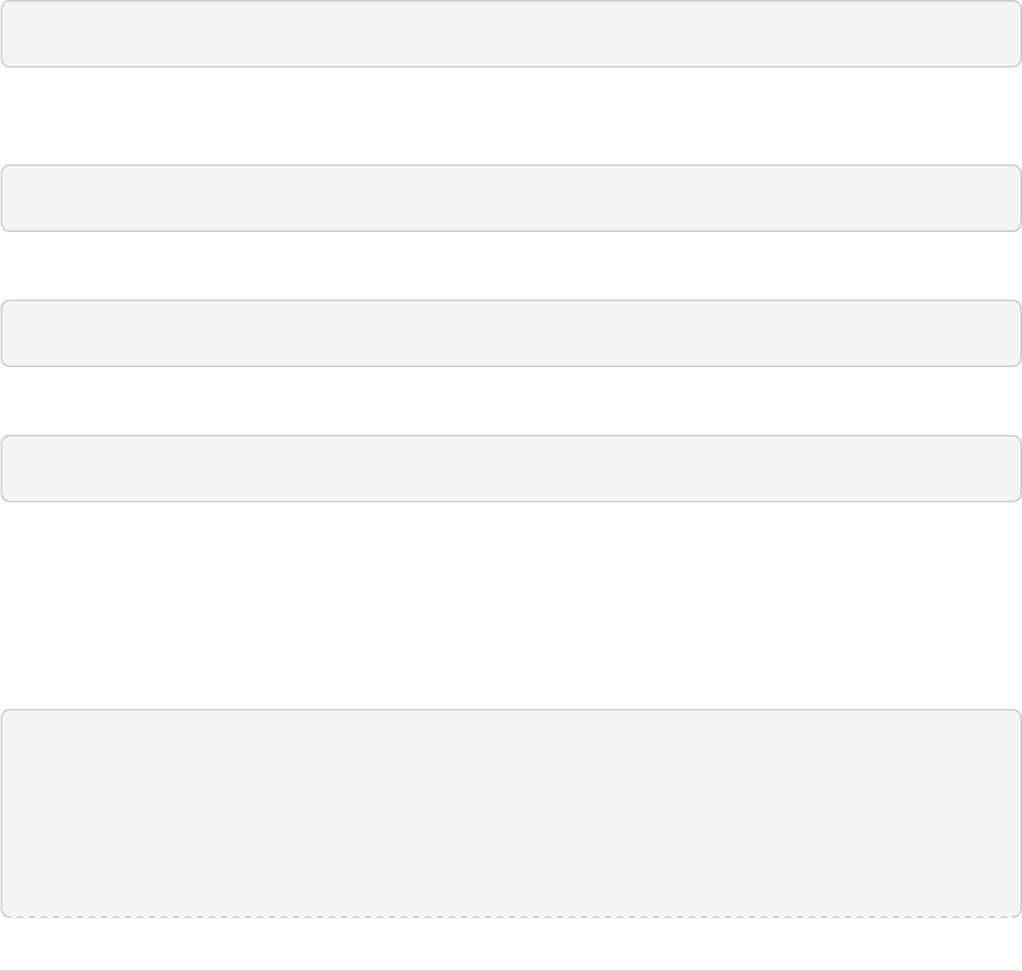
and keeps it in memory where it will run at intervals. In this particular example, the daemon function will run
the update function every second. The update function is wrapping a topic function, which will stream
tuples that match the topic function query in batches. Each subsequent call to the topic will return the next
batch of tuples for the topic. The update function will send all the tuples matching the topic to another
collection to be indexed. The terminate parameter tells the daemon to terminate when the topic function
stops sending tuples.
The effect of this is to push documents that match a specific query into another collection. Custom push
functions can be plugged in that push documents out of Solr and into other systems, such as Kafka or an
email system.
Push streaming can also be used for continuous background aggregation scenarios where aggregates are
rolled up in the background at intervals and pushed to other Solr collections. Another use case is continuous
background machine learning model optimization, where the optimized model is pushed to another Solr
collection where it can be integrated into queries.
The /stream handler supports a small set commands for listing and controlling daemon functions:
http://localhost:8983/collection/stream?action=list
This command will provide a listing of the current daemon’s running on the specific node along with there
current state.
http://localhost:8983/collection/stream?action=stop&id=daemonId
This command will stop a specific daemon function but leave it resident in memory.
http://localhost:8983/collection/stream?action=start&id=daemonId
This command will start a specific daemon function that has been stopped.
http://localhost:8983/collection/stream?action=kill&id=daemonId
This command will stop a specific daemon function and remove it from memory.
Continuous Pull Streaming
The DaemonStream java class (part of the SolrJ libraries) can also be embedded in a java application to
provide continuous pull streaming. Sample code:
StreamContext context = new StreamContext()
SolrClientCache cache = new SolrClientCache();
context.setSolrClientCache(cache);
Map topicQueryParams = new HashMap();
topicQueryParams.put("q","hello"); // The query for the topic
topicQueryparams.put("rows", "500"); // How many rows to fetch during each run
Page 788 of 1426 Apache Solr Reference Guide 7.7
Guide Version 7.7 - Published: 2019-03-04 © 2019, Apache Software Foundation

topicQueryparams.put("fl", "id", "title"); // The field list to return with the documents
TopicStream topicStream = new TopicStream(zkHost, // Host address for the ZooKeeper
service housing the collections
Ê "checkpoints", // The collection to store the topic
checkpoints
Ê "topicData", // The collection to query for the topic
records
Ê "topicId", // The id of the topic
Ê -1, // checkpoint every X tuples, if set -1
it will checkpoint after each run.
Ê topicQueryParams); // The query parameters for the
TopicStream
DaemonStream daemonStream = new DaemonStream(topicStream, // The underlying stream to
run.
Ê "daemonId", // The id of the daemon
Ê 1000, // The interval at which to
run the internal stream
Ê 500); // The internal queue size
for the daemon stream. Tuples will be placed in the queue
Ê // as they are read by the
internal internal thread.
Ê // Calling read() on the
daemon stream reads records from the internal queue.
daemonStream.setStreamContext(context);
daemonStream.open();
//Read until it's time to shutdown the DaemonStream. You can define the shutdown criteria.
while(!shutdown()) {
Ê Tuple tuple = daemonStream.read() // This will block until tuples become available from the
underlying stream (TopicStream)
Ê // The EOF tuple (signaling the end of the stream) will
never occur until the DaemonStream has been shutdown.
Ê //Do something with the tuples
}
// Shutdown the DaemonStream.
daemonStream.shutdown();
//Read the DaemonStream until the EOF Tuple is found.
//This allows the underlying stream to perform an orderly shutdown.
while(true) {
Ê Tuple tuple = daemonStream.read();
Ê if(tuple.EOF) {
Ê break;
Ê } else {
Ê //Do something with the tuples.
Ê }
Apache Solr Reference Guide 7.7 Page 789 of 1426
© 2019, Apache Software Foundation Guide Version 7.7 - Published: 2019-03-04

}
//Finally close the stream
daemonStream.close();
eval
The eval function allows for use cases where new streaming expressions are generated on the fly and then
evaluated. The eval function wraps a streaming expression and reads a single tuple from the underlying
stream. The eval function then retrieves a string Streaming Expressions from the expr_s field of the tuple.
The eval function then compiles the string Streaming Expression and emits the tuples.
eval Parameters
•StreamExpression: (Mandatory) The stream which provides the streaming expression to be evaluated.
eval Syntax
eval(expr)
In the example above the eval expression reads the first tuple from the underlying expression. It then
compiles and executes the string Streaming Expression in the expr_s field.
executor
The executor function wraps a stream source that contains streaming expressions, and executes the
expressions in parallel. The executor function looks for the expression in the expr_s field in each tuple. The
executor function has an internal thread pool that runs tasks that compile and run expressions in parallel
on the same worker node. This function can also be parallelized across worker nodes by wrapping it in the
parallel function to provide parallel execution of expressions across a cluster.
The executor function does not do anything specific with the output of the expressions that it runs.
Therefore the expressions that are executed must contain the logic for pushing tuples to their destination.
The update function can be included in the expression being executed to send the tuples to a SolrCloud
collection for storage.
This model allows for asynchronous execution of jobs where the output is stored in a SolrCloud collection
where it can be accessed as the job progresses.
executor Parameters
•threads: (Optional) The number of threads in the executors thread pool for executing expressions.
•StreamExpression: (Mandatory) The stream source which contains the Streaming Expressions to
execute.
executor Syntax
Page 790 of 1426 Apache Solr Reference Guide 7.7
Guide Version 7.7 - Published: 2019-03-04 © 2019, Apache Software Foundation

daemon(id="myDaemon",
Ê terminate="true",
Ê executor(threads=10,
Ê topic(checkpointCollection
Ê storedExpressions,
Ê q="*:*",
Ê fl="id, expr_s",
Ê initialCheckPoint=0,
Ê id="myTopic")))
In the example above a daemon wraps an executor, which wraps a topic that is returning tuples with
expressions to execute. When sent to the stream handler, the daemon will call the executor at intervals
which will cause the executor to read from the topic and execute the expressions found in the expr_s field.
The daemon will repeatedly call the executor until all the tuples that match the topic have been iterated,
then it will terminate. This is the approach for executing batches of streaming expressions from a topic
queue.
fetch
The fetch function iterates a stream and fetches additional fields and adds them to the tuples. The fetch
function fetches in batches to limit the number of calls back to Solr. Tuples streamed from the fetch
function will contain the original fields and the additional fields that were fetched. The fetch function
supports one-to-one fetches. Many-to-one fetches, where the stream source contains duplicate keys, will
also work, but one-to-many fetches are currently not supported by this function.
fetch Parameters
•Collection: (Mandatory) The collection to fetch the fields from.
•StreamExpression: (Mandatory) The stream source for the fetch function.
•fl: (Mandatory) The fields to be fetched.
•on: Fields to be used for checking equality of tuples between stream source and fetched records.
Formatted as on="fieldNameInTuple=fieldNameInCollection".
•batchSize: (Optional) The batch fetch size.
fetch Syntax
fetch(addresses,
Ê search(people, q="*:*", qt="/export", fl="username, firstName, lastName", sort="username
asc"),
Ê fl="streetAddress, city, state, country, zip",
Ê on="username=userId")
The example above fetches addresses for users by matching the username in the tuple with the userId field
in the addresses collection.
Apache Solr Reference Guide 7.7 Page 791 of 1426
© 2019, Apache Software Foundation Guide Version 7.7 - Published: 2019-03-04

having
The having expression wraps a stream and applies a boolean operation to each tuple. It emits only tuples
for which the boolean operation returns true.
having Parameters
•StreamExpression: (Mandatory) The stream source for the having function.
•booleanEvaluator: (Mandatory) The following boolean operations are supported: eq (equals), gt
(greater than), lt (less than), gteq (greater than or equal to), lteq (less than or equal to), and, or, eor
(exclusive or), and not. Boolean evaluators can be nested with other evaluators to form complex boolean
logic.
The comparison evaluators compare the value in a specific field with a value, whether a string, number, or
boolean. For example: eq(field1, 10), returns true if field1 is equal to 10.
having Syntax
having(rollup(over=a_s,
Ê sum(a_i),
Ê search(collection1,
Ê q="*:*",
Ê qt="/export",
Ê fl="id,a_s,a_i,a_f",
Ê sort="a_s asc")),
Ê and(gt(sum(a_i), 100), lt(sum(a_i), 110)))
In this example, the having expression iterates the aggregated tuples from the rollup expression and emits
all tuples where the field sum(a_i) is greater then 100 and less then 110.
leftOuterJoin
The leftOuterJoin function wraps two streams, Left and Right, and emits tuples from Left. If there is a tuple
in Right equal (as defined by on) then the values in that tuple will be included in the emitted tuple. An equal
tuple in Right need not exist for the Left tuple to be emitted. This supports one-to-one, one-to-many, many-
to-one, and many-to-many left outer join scenarios. The tuples are emitted in the order in which they appear
in the Left stream. Both streams must be sorted by the fields being used to determine equality (using the on
parameter). If both tuples contain a field of the same name then the value from the Right stream will be
used in the emitted tuple.
You can wrap the incoming streams with a select function to be specific about which field values are
included in the emitted tuple.
leftOuterJoin Parameters
•StreamExpression for StreamLeft
•StreamExpression for StreamRight
•on: Fields to be used for checking equality of tuples between Left and Right. Can be of the format
Page 792 of 1426 Apache Solr Reference Guide 7.7
Guide Version 7.7 - Published: 2019-03-04 © 2019, Apache Software Foundation

on="fieldName", on="fieldNameInLeft=fieldNameInRight", or on="fieldName,
otherFieldName=rightOtherFieldName".
leftOuterJoin Syntax
leftOuterJoin(
Ê search(people, q="*:*", qt="/export", fl="personId,name", sort="personId asc"),
Ê search(pets, q="type:cat", qt="/export", fl="personId,petName", sort="personId asc"),
Ê on="personId"
)
leftOuterJoin(
Ê search(people, q="*:*", qt="/export", fl="personId,name", sort="personId asc"),
Ê search(pets, q="type:cat", qt="/export", fl="ownerId,petName", sort="ownerId asc"),
Ê on="personId=ownerId"
)
leftOuterJoin(
Ê search(people, q="*:*", qt="/export", fl="personId,name", sort="personId asc"),
Ê select(
Ê search(pets, q="type:cat", qt="/export", fl="ownerId,name", sort="ownerId asc"),
Ê ownerId,
Ê name as petName
Ê ),
Ê on="personId=ownerId"
)
hashJoin
The hashJoin function wraps two streams, Left and Right, and for every tuple in Left which exists in Right
will emit a tuple containing the fields of both tuples. This supports one-to-one, one-to-many, many-to-one,
and many-to-many inner join scenarios. The tuples are emitted in the order in which they appear in the Left
stream. The order of the streams does not matter. If both tuples contain a field of the same name then the
value from the Right stream will be used in the emitted tuple.
You can wrap the incoming streams with a select function to be specific about which field values are
included in the emitted tuple.
The hashJoin function can be used when the tuples of Left and Right cannot be put in the same order.
Because the tuples are out of order this stream functions by reading all values from the Right stream during
the open operation and will store all tuples in memory. The result of this is a memory footprint equal to the
size of the Right stream.
hashJoin Parameters
•StreamExpression for StreamLeft
•hashed=StreamExpression for StreamRight
•on: Fields to be used for checking equality of tuples between Left and Right. Can be of the format
on="fieldName", on="fieldNameInLeft=fieldNameInRight", or on="fieldName,
Apache Solr Reference Guide 7.7 Page 793 of 1426
© 2019, Apache Software Foundation Guide Version 7.7 - Published: 2019-03-04

otherFieldName=rightOtherFieldName".
hashJoin Syntax
hashJoin(
Ê search(people, q="*:*", qt="/export", fl="personId,name", sort="personId asc"),
Ê hashed=search(pets, q="type:cat", qt="/export", fl="personId,petName", sort="personId asc"),
Ê on="personId"
)
hashJoin(
Ê search(people, q="*:*", fl="personId,name", sort="personId asc"),
Ê hashed=search(pets, q="type:cat", qt="/export", fl="ownerId,petName", sort="ownerId asc"),
Ê on="personId=ownerId"
)
hashJoin(
Ê search(people, q="*:*", qt="/export", fl="personId,name", sort="personId asc"),
Ê hashed=select(
Ê search(pets, q="type:cat", qt="/export", fl="ownerId,name", sort="ownerId asc"),
Ê ownerId,
Ê name as petName
Ê ),
Ê on="personId=ownerId"
)
innerJoin
Wraps two streams, Left and Right. For every tuple in Left which exists in Right a tuple containing the fields
of both tuples will be emitted. This supports one-to-one, one-to-many, many-to-one, and many-to-many
inner join scenarios. The tuples are emitted in the order in which they appear in the Left stream. Both
streams must be sorted by the fields being used to determine equality (the 'on' parameter). If both tuples
contain a field of the same name then the value from the Right stream will be used in the emitted tuple. You
can wrap the incoming streams with a select(…) expression to be specific about which field values are
included in the emitted tuple.
innerJoin Parameters
•StreamExpression for StreamLeft
•StreamExpression for StreamRight
•on: Fields to be used for checking equality of tuples between Left and Right. Can be of the format
on="fieldName", on="fieldNameInLeft=fieldNameInRight", or on="fieldName,
otherFieldName=rightOtherFieldName".
innerJoin Syntax
Page 794 of 1426 Apache Solr Reference Guide 7.7
Guide Version 7.7 - Published: 2019-03-04 © 2019, Apache Software Foundation

innerJoin(
Ê search(people, q="*:*", qt="/export", fl="personId,name", sort="personId asc"),
Ê search(pets, q="type:cat", qt="/export", fl="personId,petName", sort="personId asc"),
Ê on="personId"
)
innerJoin(
Ê search(people, q="*:*", qt="/export", fl="personId,name", sort="personId asc"),
Ê search(pets, q="type:cat", qt="/export", fl="ownerId,petName", sort="ownerId asc"),
Ê on="personId=ownerId"
)
innerJoin(
Ê search(people, q="*:*", qt="/export", fl="personId,name", sort="personId asc"),
Ê select(
Ê search(pets, q="type:cat", qt="/export", fl="ownerId,name", sort="ownerId asc"),
Ê ownerId,
Ê name as petName
Ê ),
Ê on="personId=ownerId"
)
intersect
The intersect function wraps two streams, A and B, and emits tuples from A which DO exist in B. The tuples
are emitted in the order in which they appear in stream A. Both streams must be sorted by the fields being
used to determine equality (the on parameter). Only tuples from A are emitted.
intersect Parameters
•StreamExpression for StreamA
•StreamExpression for StreamB
•on: Fields to be used for checking equality of tuples between A and B. Can be of the format
on="fieldName", on="fieldNameInLeft=fieldNameInRight", or on="fieldName,
otherFieldName=rightOtherFieldName".
intersect Syntax
Apache Solr Reference Guide 7.7 Page 795 of 1426
© 2019, Apache Software Foundation Guide Version 7.7 - Published: 2019-03-04

intersect(
Ê search(collection1, q="a_s:(setA || setAB)", qt="/export", fl="id,a_s,a_i", sort="a_i asc, a_s
asc"),
Ê search(collection1, q="a_s:(setB || setAB)", qt="/export", fl="id,a_s,a_i", sort="a_i asc"),
Ê on="a_i"
)
intersect(
Ê search(collection1, q="a_s:(setA || setAB)", qt="/export", fl="id,a_s,a_i", sort="a_i asc, a_s
asc"),
Ê search(collection1, q="a_s:(setB || setAB)", qt="/export", fl="id,a_s,a_i", sort="a_i asc, a_s
asc"),
Ê on="a_i,a_s"
)
list
The list function wraps N Stream Expressions and opens and iterates each stream sequentially. This has
the effect of concatenating the results of multiple Streaming Expressions.
list Parameters
•StreamExpressions …: N Streaming Expressions
list Syntax
list(tuple(a="hello world"), tuple(a="HELLO WORLD"))
list(search(collection1, q="*:*", fl="id, prod_ss", sort="id asc"),
Ê search(collection2, q="*:*", fl="id, prod_ss", sort="id asc"))
list(tuple(a=search(collection1, q="*:*", fl="id, prod_ss", sort="id asc")),
Ê tuple(a=search(collection2, q="*:*", fl="id, prod_ss", sort="id asc")))
merge
The merge function merges two or more streaming expressions and maintains the ordering of the
underlying streams. Because the order is maintained, the sorts of the underlying streams must line up with
the on parameter provided to the merge function.
merge Parameters
•StreamExpression A
•StreamExpression B
•Optional StreamExpression C,D,….Z
•on: Sort criteria for performing the merge. Of the form fieldName order where order is asc or desc.
Multiple fields can be provided in the form fieldA order, fieldB order.
Page 796 of 1426 Apache Solr Reference Guide 7.7
Guide Version 7.7 - Published: 2019-03-04 © 2019, Apache Software Foundation

merge Syntax
# Merging two stream expressions together
merge(
Ê search(collection1,
Ê q="id:(0 3 4)",
Ê qt="/export",
Ê fl="id,a_s,a_i,a_f",
Ê sort="a_f asc"),
Ê search(collection1,
Ê q="id:(1)",
Ê qt="/export",
Ê fl="id,a_s,a_i,a_f",
Ê sort="a_f asc"),
Ê on="a_f asc")
# Merging four stream expressions together. Notice that while the sorts of each stream are not
identical they are
# comparable. That is to say the first N fields in each stream's sort matches the N fields in the
merge's on clause.
merge(
Ê search(collection1,
Ê q="id:(0 3 4)",
Ê qt="/export",
Ê fl="id,fieldA,fieldB,fieldC",
Ê sort="fieldA asc, fieldB desc"),
Ê search(collection1,
Ê q="id:(1)",
Ê qt="/export",
Ê fl="id,fieldA",
Ê sort="fieldA asc"),
Ê search(collection2,
Ê q="id:(10 11 13)",
Ê qt="/export",
Ê fl="id,fieldA,fieldC",
Ê sort="fieldA asc"),
Ê search(collection3,
Ê q="id:(987)",
Ê qt="/export",
Ê fl="id,fieldA,fieldC",
Ê sort="fieldA asc"),
Ê on="fieldA asc")
null
The null expression is a useful utility function for understanding bottlenecks when performing parallel
relational algebra (joins, intersections, rollups etc.). The null function reads all the tuples from an underlying
stream and returns a single tuple with the count and processing time. Because the null stream adds minimal
overhead of it’s own, it can be used to isolate the performance of Solr’s /export handler. If the /export
Apache Solr Reference Guide 7.7 Page 797 of 1426
© 2019, Apache Software Foundation Guide Version 7.7 - Published: 2019-03-04

handlers performance is not the bottleneck, then the bottleneck is likely occurring in the workers where the
stream decorators are running.
The null expression can be wrapped by the parallel function and sent to worker nodes. In this scenario each
worker will return one tuple with the count of tuples processed on the worker and the timing information
for that worker. This gives valuable information such as:
1. As more workers are added does the performance of the /export handler improve or not.
2. Are tuples being evenly distributed across the workers, or is the hash partitioning sending more
documents to a single worker.
3. Are all workers processing data at the same speed, or is one of the workers the source of the bottleneck.
null Parameters
•StreamExpression: (Mandatory) The expression read by the null function.
null Syntax
Êparallel(workerCollection,
Ê null(search(collection1, q="*:*", fl="id,a_s,a_i,a_f", sort="a_s desc", qt="/export",
partitionKeys="a_s")),
Ê workers="20",
Ê zkHost="localhost:9983",
Ê sort="a_s desc")
The expression above shows a parallel function wrapping a null function. This will cause the null function to
be run in parallel across 20 worker nodes. Each worker will return a single tuple with number of tuples
processed and time it took to iterate the tuples.
outerHashJoin
The outerHashJoin function wraps two streams, Left and Right, and emits tuples from Left. If there is a tuple
in Right equal (as defined by the on parameter) then the values in that tuple will be included in the emitted
tuple. An equal tuple in Right need not exist for the Left tuple to be emitted. This supports one-to-one, one-
to-many, many-to-one, and many-to-many left outer join scenarios. The tuples are emitted in the order in
which they appear in the Left stream. The order of the streams does not matter. If both tuples contain a field
of the same name then the value from the Right stream will be used in the emitted tuple.
You can wrap the incoming streams with a select function to be specific about which field values are
included in the emitted tuple.
The outerHashJoin stream can be used when the tuples of Left and Right cannot be put in the same order.
Because the tuples are out of order, this stream functions by reading all values from the Right stream during
the open operation and will store all tuples in memory. The result of this is a memory footprint equal to the
size of the Right stream.
Page 798 of 1426 Apache Solr Reference Guide 7.7
Guide Version 7.7 - Published: 2019-03-04 © 2019, Apache Software Foundation

outerHashJoin Parameters
•StreamExpression for StreamLeft
•hashed=StreamExpression for StreamRight
•on: Fields to be used for checking equality of tuples between Left and Right. Can be of the format
on="fieldName", on="fieldNameInLeft=fieldNameInRight", or on="fieldName,
otherFieldName=rightOtherFieldName".
outerHashJoin Syntax
outerHashJoin(
Ê search(people, q="*:*", qt="/export", fl="personId,name", sort="personId asc"),
Ê hashed=search(pets, q="type:cat", qt="/export", fl="personId,petName", sort="personId asc"),
Ê on="personId"
)
outerHashJoin(
Ê search(people, q="*:*", qt="/export", fl="personId,name", sort="personId asc"),
Ê hashed=search(pets, q="type:cat", qt="/export", fl="ownerId,petName", sort="ownerId asc"),
Ê on="personId=ownerId"
)
outerHashJoin(
Ê search(people, q="*:*", qt="/export", fl="personId,name", sort="personId asc"),
Ê hashed=select(
Ê search(pets, q="type:cat", qt="/export", fl="ownerId,name", sort="ownerId asc"),
Ê ownerId,
Ê name as petName
Ê ),
Ê on="personId=ownerId"
)
parallel
The parallel function wraps a streaming expression and sends it to N worker nodes to be processed in
parallel.
The parallel function requires that the partitionKeys parameter be provided to the underlying searches.
The partitionKeys parameter will partition the search results (tuples) across the worker nodes. Tuples with
the same values in for partitionKeys will be shuffled to the same worker nodes.
The parallel function maintains the sort order of the tuples returned by the worker nodes, so the sort
criteria must incorporate the sort order of the tuples returned by the workers.
For example if you sort on year, month and day you could partition on year only as long as there are enough
different years to spread the tuples around the worker nodes.
Solr allows sorting on more than 4 fields, but you cannot specify more than 4 partitionKeys for speed
considerations. Also it’s overkill to specify many partitionKeys when we one or two keys could be enough
Apache Solr Reference Guide 7.7 Page 799 of 1426
© 2019, Apache Software Foundation Guide Version 7.7 - Published: 2019-03-04

to spread the tuples.
Parallel stream was designed when the underlying search stream will emit a lot of tuples from the collection.
If the search stream only emits a small subset of the data from the collection using parallel could
potentially be slower.
Worker Collections
The worker nodes can be from the same collection as the data, or they can be a different
collection entirely, even one that only exists for parallel streaming expressions. A worker
collection can be any SolrCloud collection that has the /stream handler configured. Unlike
normal SolrCloud collections, worker collections don’t have to hold any data. Worker
collections can be empty collections that exist only to execute streaming expressions.
parallel Parameters
•collection: Name of the worker collection to send the StreamExpression to.
•StreamExpression: Expression to send to the worker collection.
•workers: Number of workers in the worker collection to send the expression to.
•zkHost: (Optional) The ZooKeeper connect string where the worker collection resides.
•sort: The sort criteria for ordering tuples returned by the worker nodes.
parallel Syntax
Êparallel(workerCollection,
Ê rollup(search(collection1, q="*:*", fl="id,year_i,month_i,day_i", qt="/export",
sort="year_i desc,month_i desc,day_i asc", partitionKeys="year_i"),
Ê over="year_i", count(*)),
Ê workers="20",
Ê zkHost="localhost:9983",
Ê sort="year_i desc")
The expression above shows a parallel function wrapping a reduce function. This will cause the reduce
function to be run in parallel across 20 worker nodes.
Page 800 of 1426 Apache Solr Reference Guide 7.7
Guide Version 7.7 - Published: 2019-03-04 © 2019, Apache Software Foundation

Warmup
The parallel function uses the hash query parser to split the data amongst the workers. It
executes on all the documents and the result bitset is cached in the filterCache.
+ For a parallel stream with the same number of workers and partitonKeys the first
query would be slower than subsequent queries. A trick to not pay the penalty for the first
slow query would be to use a warmup query for every new searcher. The following is a
solrconfig.xml snippet for 2 workers and "year_i" as the partionKeys.
<listener event="newSearcher" class="solr.QuerySenderListener">
<arr name="queries">
Ê <lst><str name="q">:</str><str name="fq">{!hash workers=2 worker=0}</str><str
name="partitionKeys">year_i</str></lst>
Ê <lst><str name="q">:</str><str name="fq">{!hash workers=2 worker=1}</str><str
name="partitionKeys">year_i</str></lst>
</arr>
</listener>
plist
The plist function wraps N Stream Expressions and opens the streams in parallel and iterates each stream
sequentially. The difference between the list and plist is that the streams are opened in parallel. Since
many streams such as facet, stats and significantTerms push down heavy operations to Solr when they
are opened, the plist function can dramatically improve performance by doing these operations in parallel.
plist Parameters
•StreamExpressions …: N Streaming Expressions
plist Syntax
plist(tuple(a="hello world"), tuple(a="HELLO WORLD"))
plist(search(collection1, q="*:*", fl="id, prod_ss", sort="id asc"),
Ê search(collection2, q="*:*", fl="id, prod_ss", sort="id asc"))
plist(tuple(a=search(collection1, q="*:*", fl="id, prod_ss", sort="id asc")),
Ê tuple(a=search(collection2, q="*:*", fl="id, prod_ss", sort="id asc")))
priority
The priority function is a simple priority scheduler for the executor function. The executor function
doesn’t directly have a concept of task prioritization; instead it simply executes tasks in the order that they
are read from it’s underlying stream. The priority function provides the ability to schedule a higher priority
task ahead of lower priority tasks that were submitted earlier.
The priority function wraps two topics that are both emitting tuples that contain streaming expressions to
Apache Solr Reference Guide 7.7 Page 801 of 1426
© 2019, Apache Software Foundation Guide Version 7.7 - Published: 2019-03-04

execute. The first topic is considered the higher priority task queue.
Each time the priority function is called, it checks the higher priority task queue to see if there are any
tasks to execute. If tasks are waiting in the higher priority queue then the priority function will emit the
higher priority tasks. If there are no high priority tasks to run, the lower priority queue tasks are emitted.
The priority function will only emit a batch of tasks from one of the queues each time it is called. This
ensures that no lower priority tasks are executed until the higher priority queue has no tasks to run.
priority Parameters
•topic expression: (Mandatory) the high priority task queue
•topic expression: (Mandatory) the lower priority task queue
priority Syntax
daemon(id="myDaemon",
Ê executor(threads=10,
Ê priority(topic(checkpointCollection, storedExpressions, q="priority:high",
fl="id, expr_s", initialCheckPoint=0,id="highPriorityTasks"),
Ê topic(checkpointCollection, storedExpressions, q="priority:low", fl="id,
expr_s", initialCheckPoint=0,id="lowPriorityTasks"))))
In the example above the daemon function is calling the executor iteratively. Each time it’s called, the
executor function will execute the tasks emitted by the priority function. The priority function wraps two
topics. The first topic is the higher priority task queue, the second topics is the lower priority topic.
reduce
The reduce function wraps an internal stream and groups tuples by common fields.
Each tuple group is operated on as a single block by a pluggable reduce operation. The group operation
provided with Solr implements distributed grouping functionality. The group operation also serves as an
example reduce operation that can be referred to when building custom reduce operations.
The reduce function relies on the sort order of the underlying stream. Accordingly the sort
order of the underlying stream must be aligned with the group by field.
reduce Parameters
•StreamExpression: (Mandatory)
•by: (Mandatory) A comma separated list of fields to group by.
•Reduce Operation: (Mandatory)
reduce Syntax
Page 802 of 1426 Apache Solr Reference Guide 7.7
Guide Version 7.7 - Published: 2019-03-04 © 2019, Apache Software Foundation

reduce(search(collection1, q="*:*", qt="/export", fl="id,a_s,a_i,a_f", sort="a_s asc, a_f asc"),
Ê by="a_s",
Ê group(sort="a_f desc", n="4")
)
rollup
The rollup function wraps another stream function and rolls up aggregates over bucket fields. The rollup
function relies on the sort order of the underlying stream to rollup aggregates one grouping at a time.
Accordingly, the sort order of the underlying stream must match the fields in the over parameter of the
rollup function.
The rollup function also needs to process entire result sets in order to perform its aggregations. When the
underlying stream is the search function, the /export handler can be used to provide full sorted result sets
to the rollup function. This sorted approach allows the rollup function to perform aggregations over very
high cardinality fields. The disadvantage of this approach is that the tuples must be sorted and streamed
across the network to a worker node to be aggregated. For faster aggregation over low to moderate
cardinality fields, the facet function can be used.
rollup Parameters
•StreamExpression (Mandatory)
•over: (Mandatory) A list of fields to group by.
•metrics: (Mandatory) The list of metrics to compute. Currently supported metrics are sum(col),
avg(col), min(col), max(col), count(*).
rollup Syntax
rollup(
Ê search(collection1, q="*:*", qt="/export", fl="a_s,a_i,a_f", qt="/export", sort="a_s asc"),
Ê over="a_s",
Ê sum(a_i),
Ê sum(a_f),
Ê min(a_i),
Ê min(a_f),
Ê max(a_i),
Ê max(a_f),
Ê avg(a_i),
Ê avg(a_f),
Ê count(*)
)
The example about shows the rollup function wrapping the search function. Notice that search function is
using the /export handler to provide the entire result set to the rollup stream. Also notice that the search
function’s sort parameter matches up with the rollup’s over parameter. This allows the rollup function to
rollup the over the a_s field, one group at a time.
Apache Solr Reference Guide 7.7 Page 803 of 1426
© 2019, Apache Software Foundation Guide Version 7.7 - Published: 2019-03-04

scoreNodes
See section in graph traversal.
select
The select function wraps a streaming expression and outputs tuples containing a subset or modified set of
fields from the incoming tuples. The list of fields included in the output tuple can contain aliases to
effectively rename fields. The select stream supports both operations and evaluators. One can provide a list
of operations and evaluators to perform on any fields, such as replace, add, if, etc.
select Parameters
•StreamExpression
•fieldName: name of field to include in the output tuple (can include multiple of these), such as
outputTuple[fieldName] = inputTuple[fieldName]
•fieldName as aliasFieldName: aliased field name to include in the output tuple (can include multiple of
these), such as outputTuple[aliasFieldName] = incomingTuple[fieldName]
•replace(fieldName, value, withValue=replacementValue): if incomingTuple[fieldName] == value
then outgoingTuple[fieldName] will be set to replacementValue. value can be the string "null" to
replace a null value with some other value.
•replace(fieldName, value, withField=otherFieldName): if incomingTuple[fieldName] == value
then outgoingTuple[fieldName] will be set to the value of incomingTuple[otherFieldName]. value can
be the string "null" to replace a null value with some other value.
select Syntax
// output tuples with fields teamName, wins, losses, and winPercentages where a null value for
wins or losses is translated to the value of 0
select(
Ê search(collection1, fl="id,teamName_s,wins,losses", q="*:*", qt="/export", sort="id asc"),
Ê teamName_s as teamName,
Ê wins,
Ê losses,
Ê replace(wins,null,withValue=0),
Ê replace(losses,null,withValue=0),
Ê if(eq(0,wins), 0, div(add(wins,losses), wins)) as winPercentage
)
sort
The sort function wraps a streaming expression and re-orders the tuples. The sort function emits all
incoming tuples in the new sort order. The sort function reads all tuples from the incoming stream, re-
orders them using an algorithm with O(nlog(n)) performance characteristics, where n is the total number
of tuples in the incoming stream, and then outputs the tuples in the new sort order. Because all tuples are
read into memory, the memory consumption of this function grows linearly with the number of tuples in the
Page 804 of 1426 Apache Solr Reference Guide 7.7
Guide Version 7.7 - Published: 2019-03-04 © 2019, Apache Software Foundation

incoming stream.
sort Parameters
•StreamExpression
•by: Sort criteria for re-ordering the tuples
sort Syntax
The expression below finds dog owners and orders the results by owner and pet name. Notice that it uses
an efficient innerJoin by first ordering by the person/owner id and then re-orders the final output by the
owner and pet names.
sort(
Ê innerJoin(
Ê search(people, q="*:*", qt="/export", fl="id,name", sort="id asc"),
Ê search(pets, q="type:dog", qt="/export", fl="owner,petName", sort="owner asc"),
Ê on="id=owner"
Ê ),
Ê by="name asc, petName asc"
)
top
The top function wraps a streaming expression and re-orders the tuples. The top function emits only the top
N tuples in the new sort order. The top function re-orders the underlying stream so the sort criteria does
not have to match up with the underlying stream.
top Parameters
•n: Number of top tuples to return.
•StreamExpression
•sort: Sort criteria for selecting the top N tuples.
top Syntax
The expression below finds the top 3 results of the underlying search. Notice that it reverses the sort order.
The top function re-orders the results of the underlying stream.
top(n=3,
Ê search(collection1,
Ê q="*:*",
Ê qt="/export",
Ê fl="id,a_s,a_i,a_f",
Ê sort="a_f desc, a_i desc"),
Ê sort="a_f asc, a_i asc")
Apache Solr Reference Guide 7.7 Page 805 of 1426
© 2019, Apache Software Foundation Guide Version 7.7 - Published: 2019-03-04

unique
The unique function wraps a streaming expression and emits a unique stream of tuples based on the over
parameter. The unique function relies on the sort order of the underlying stream. The over parameter must
match up with the sort order of the underlying stream.
The unique function implements a non-co-located unique algorithm. This means that records with the same
unique over field do not need to be co-located on the same shard. When executed in the parallel, the
partitionKeys parameter must be the same as the unique over field so that records with the same keys will
be shuffled to the same worker.
unique Parameters
•StreamExpression
•over: The unique criteria.
unique Syntax
unique(
Ê search(collection1,
Ê q="*:*",
Ê qt="/export",
Ê fl="id,a_s,a_i,a_f",
Ê sort="a_f asc, a_i asc"),
Ê over="a_f")
update
The update function wraps another functions and sends the tuples to a SolrCloud collection for indexing.
update Parameters
•destinationCollection: (Mandatory) The collection where the tuples will indexed.
•batchSize: (Mandatory) The indexing batch size.
•StreamExpression: (Mandatory)
update Syntax
Êupdate(destinationCollection,
Ê batchSize=500,
Ê search(collection1,
Ê q=*:*,
Ê qt="/export",
Ê fl="id,a_s,a_i,a_f,s_multi,i_multi",
Ê sort="a_f asc, a_i asc"))
The example above sends the tuples returned by the search function to the destinationCollection to be
Page 806 of 1426 Apache Solr Reference Guide 7.7
Guide Version 7.7 - Published: 2019-03-04 © 2019, Apache Software Foundation

indexed.
Apache Solr Reference Guide 7.7 Page 807 of 1426
© 2019, Apache Software Foundation Guide Version 7.7 - Published: 2019-03-04

Stream Evaluator Reference
Stream evaluators are different then stream sources or stream decorators. Both stream sources and stream
decorators return streams of tuples. Stream evaluators are more like a traditional function that evaluates its
parameters and returns an result. That result can be a single value, array, map or other structure.
Stream evaluators can be nested so that the output of an evaluator becomes the input for another
evaluator.
Stream evaluators can be called in different contexts. For example a stream evaluator can be called on its
own or it can be called within the context of a streaming expression.
abs
The abs function will return the absolute value of the provided single parameter. The abs function will fail to
execute if the value is non-numeric. If a null value is found then null will be returned as the result.
abs Parameters
•Field Name | Raw Number | Number Evaluator
abs Syntax
The expressions below show the various ways in which you can use the abs evaluator. Only one parameter is
accepted. Returns a numeric value.
abs(1) // 1, not really a good use case for it
abs(-1) // 1, not really a good use case for it
abs(add(fieldA,fieldB)) // absolute value of fieldA + fieldB
abs(fieldA) // absolute value of fieldA
acos
The acos function returns the trigonometric arccosine of a number.
acos Parameters
•Field Name | Raw Number | Number Evaluator: The value to return the arccosine of.
acos Syntax
acos(100.4) // returns the arccosine of 100.4
acos(fieldA) // returns the arccosine for fieldA.
if(gt(fieldA,fieldB),sin(fieldA),sin(fieldB)) // if fieldA > fieldB then return the arccosine of
fieldA, else return the arccosine of fieldB
Page 808 of 1426 Apache Solr Reference Guide 7.7
Guide Version 7.7 - Published: 2019-03-04 © 2019, Apache Software Foundation

add
The add function will take 2 or more numeric values and add them together. The add function will fail to
execute if any of the values are non-numeric. If a null value is found then null will be returned as the result.
add Parameters
•Field Name | Raw Number | Number Evaluator
•Field Name | Raw Number | Number Evaluator
•……
•Field Name | Raw Number | Number Evaluator
add Syntax
The expressions below show the various ways in which you can use the add evaluator. The number and
order of these parameters do not matter and is not limited except that at least two parameters are required.
Returns a numeric value.
add(1,2,3,4) // 1 + 2 + 3 + 4 == 10
add(1,fieldA) // 1 + value of fieldA
add(fieldA,1.4) // value of fieldA + 1.4
add(fieldA,fieldB,fieldC) // value of fieldA + value of fieldB + value of fieldC
add(fieldA,div(fieldA,fieldB)) // value of fieldA + (value of fieldA / value of fieldB)
add(fieldA,if(gt(fieldA,fieldB),fieldA,fieldB)) // if fieldA > fieldB then fieldA + fieldA, else
fieldA + fieldB
analyze
The analyze function analyzes text using a Lucene/Solr analyzer and returns a list of tokens emitted by the
analyzer. The analyze function can be called on its own or within the select and cartesianProduct
streaming expressions.
analyze Parameters
•Field Name | Raw Text: Either the field in a tuple or the raw text to be analyzed.
•Analyzer Field Name: The field name of the analyzer to use to analyze the text.
analyze Syntax
The expressions below show the various ways in which you can use the analyze evaluator.
•Analyze the raw text: analyze("hello world", analyzerField)
•Analyze a text field within a select expression. This will annotate tuples with the output of the analyzer:
select(expr, analyze(textField, analyzerField) as outField)
•Analyze a text field with a cartesianProduct expression. This will stream each token emitted by the
analyzer in its own tuple: cartesianProduct(expr, analyze(textField, analyzer) as outField)
Apache Solr Reference Guide 7.7 Page 809 of 1426
© 2019, Apache Software Foundation Guide Version 7.7 - Published: 2019-03-04

and
The and function will return the logical AND of at least 2 boolean parameters. The function will fail to execute
if any parameters are non-boolean or null. Returns a boolean value.
and Parameters
•Field Name | Raw Boolean | Boolean Evaluator
•Field Name | Raw Boolean | Boolean Evaluator
•……
•Field Name | Raw Boolean | Boolean Evaluator
and Syntax
The expressions below show the various ways in which you can use the and evaluator. At least two
parameters are required, but there is no limit to how many you can use.
and(true,fieldA) // true && fieldA
and(fieldA,fieldB) // fieldA && fieldB
and(or(fieldA,fieldB),fieldC) // (fieldA || fieldB) && fieldC
and(fieldA,fieldB,fieldC,or(fieldD,fieldE),fieldF)
anova
The anova function calculates the analysis of variance for two or more numeric arrays.
anova Parameters
•numeric array … (two or more)
anova Syntax
anova(numericArray1, numericArray2) // calculates ANOVA for two numeric arrays
anova(numericArray1, numericArray2, numericArray2) // calculates ANOVA for three numeric arrays
array
The array function returns an array of numerics or other objects including other arrays.
array Parameters
•numeric | array …
array Syntax
Page 810 of 1426 Apache Solr Reference Guide 7.7
Guide Version 7.7 - Published: 2019-03-04 © 2019, Apache Software Foundation

array(1, 2, 3) // Array of numerics
array(array(1,2,3), array(4,5,6)) // Array of arrays
asin
The asin function returns the trigonometric arcsine of a number.
asin Parameters
•Field Name | Raw Number | Number Evaluator: The value to return the arcsine of.
asin Syntax
asin(100.4) // returns the sine of 100.4
asine(fieldA) // returns the sine for fieldA.
if(gt(fieldA,fieldB),asin(fieldA),asin(fieldB)) // if fieldA > fieldB then return the asine of
fieldA, else return the asine of fieldB
atan
The atan function returns the trigonometric arctangent of a number.
atan Parameters
•Field Name | Raw Number | Number Evaluator: The value to return the arctangent of.
atan Syntax
atan(100.4) // returns the arctangent of 100.4
atan(fieldA) // returns the arctangent for fieldA.
if(gt(fieldA,fieldB),atan(fieldA),atan(fieldB)) // if fieldA > fieldB then return the arctanget
of fieldA, else return the arctangent of fieldB
betaDistribution
The betaDistribution function returns a beta probability distribution based on its parameters. This
function is part of the probability distribution framework and is designed to work with the sample,
kolmogorovSmirnov and cumulativeProbability functions.
betaDistribution Parameters
•double: shape1
•double: shape2
Apache Solr Reference Guide 7.7 Page 811 of 1426
© 2019, Apache Software Foundation Guide Version 7.7 - Published: 2019-03-04

betaDistribution Returns
A probability distribution function.
betaDistribution Syntax
betaDistribution(1, 5)
binomialCoefficient
The binomialCoefficient function returns a Binomial Coefficient, the number of k-element subsets that
can be selected from an n-element set.
binomialCoefficient Parameters
•integer: [n] set
•integer: [k] subset
binomialCoefficient Returns
A long value: The number of k-element subsets that can be selected from an n-element set.
binomialCoefficient Syntax
binomialCoefficient(8, 3) // Returns the number of 3 element subsets from an 8 element set.
binomialDistribution
The binomialDistribution function returns a binomial probability distribution based on its parameters.
This function is part of the probability distribution framework and is designed to work with the sample,
probability and cumulativeProbability functions.
binomialDistribution Parameters
•integer: number of trials
•double: probability of success
binomialDistribution Returns
A probability distribution function.
binomialDistribution Syntax
binomialDistribution(1000, .5)
Page 812 of 1426 Apache Solr Reference Guide 7.7
Guide Version 7.7 - Published: 2019-03-04 © 2019, Apache Software Foundation

cbrt
The cbrt function returns the trigonometric cube root of a number.
cbrt Parameters
•Field Name | Raw Number | Number Evaluator: The value to return the cube root of.
cbrt Syntax
cbrt(100.4) // returns the square root of 100.4
cbrt(fieldA) // returns the square root for fieldA.
if(gt(fieldA,fieldB),cbrt(fieldA),cbrt(fieldB)) // if fieldA > fieldB then return the cbrt of
fieldA, else return the cbrt of fieldB
ceil
The ceil function rounds a decimal value to the next highest whole number.
ceil Parameters
•Field Name | Raw Number | Number Evaluator: The decimal to round up.
ceil Syntax
The expressions below show the various ways in which you can use the ceil evaluator.
ceil(100.4) // returns 101.
ceil(fieldA) // returns the next highest whole number for fieldA.
if(gt(fieldA,fieldB),ceil(fieldA),ceil(fieldB)) // if fieldA > fieldB then return the ceil of
fieldA, else return the ceil of fieldB.
col
The col function returns a numeric array from a list of Tuples. The col function is used to create numeric
arrays from stream sources.
col Parameters
•list of Tuples
•field name: The field to create the array from.
col Syntax
col(tupleList, fieldName)
Apache Solr Reference Guide 7.7 Page 813 of 1426
© 2019, Apache Software Foundation Guide Version 7.7 - Published: 2019-03-04

colAt
The colAt function returns the column of a matrix at a specific index as a numeric array.
colAt Parameters
•matrix: the matrix to operate on
•integer: the index of the column to return
colAt Syntax
colAt(matrix, 10)
colAt Returns
numeric array : the column of the matrix
columnCount
The columnCount function returns the number of columns in a matrix.
columnCount Parameters
•matrix: the matrix to operate on
columnCount Syntax
columnCount(matrix)
columnCount Returns
integer : number columns in the matrix.
constantDistribution
The constantDistribution function returns a constant probability distribution based on its parameter. This
function is part of the probability distribution framework and is designed to work with the sample and
cumulativeProbability functions.
When sampled the constant distribution always returns its constant value.
constantDistribution Parameters
•double: constant value
Page 814 of 1426 Apache Solr Reference Guide 7.7
Guide Version 7.7 - Published: 2019-03-04 © 2019, Apache Software Foundation

constantDistribution Returns
A probability distribution function.
constantDistribution Syntax
constantDistribution(constantValue)
conv
The conv function returns the convolution of two numeric arrays.
conv Parameters
•numeric array
•numeric array
conv Syntax
conv(numericArray1, numericArray2)
copyOf
The copyOf function creates a copy of a numeric array.
copyOf Parameters
•numeric array
•length: The length of the copied array. The returned array will be right padded with zeros if the length
parameter exceeds the size of the original array.
copyOf Syntax
copyOf(numericArray, length)
copyOfRange
The copyOfRange function creates a copy of a range of a numeric array.
copyOfRange Parameters
•numeric array
•start index
•end index
Apache Solr Reference Guide 7.7 Page 815 of 1426
© 2019, Apache Software Foundation Guide Version 7.7 - Published: 2019-03-04

copyOfRange Syntax
copyOfRange(numericArray, startIndex, endIndex)
corr
The corr function returns the correlation of two numeric arrays or the correlation matrix for a matrix.
The corr function support Pearson’s, Kendall’s and Spearman’s correlations.
corr Positional Parameters
•numeric array: The first numeric array
•numeric array: The second numeric array
OR
•matrix: The matrix to compute the correlation matrix for. Note that correlation is computed between the
columns in the matrix.
corr Named Parameters
•type: (Optional) The type of correlation. Possible values are pearsons, kendalls, or spearmans. The
default is pearsons.
corr Syntax
corr(numericArray1, numericArray2) // Compute the Pearsons correlation for two numeric arrays
corr(numericArray1, numericArray2, type=kendalls) // Compute the Kendalls correlation for two
numeric arrays
corr(matrix) // Compute the Pearsons correlation matrix for a matrix
corr(matrix, type=spearmans) // Compute the Spearmans correlation matrix for a matrix
corr Returns
number | matrix: Either the correlation or correlation matrix.
cos
The cos function returns the trigonometric cosine of a number.
cos Parameters
•Field Name | Raw Number | Number Evaluator: The value to return the hyperbolic cosine of.
Page 816 of 1426 Apache Solr Reference Guide 7.7
Guide Version 7.7 - Published: 2019-03-04 © 2019, Apache Software Foundation

cos Syntax
cos(100.4) // returns the arccosine of 100.4
cos(fieldA) // returns the arccosine for fieldA.
if(gt(fieldA,fieldB),cos(fieldA),cos(fieldB)) // if fieldA > fieldB then return the arccosine of
fieldA, else return the cosine of fieldB
cosineSimilarity
The cosineSimilarity function returns the cosine similarity of two numeric arrays.
cosineSimilarity Parameters
•numeric array
•numeric array
cosineSimilarity Returns
A numeric.
cosineSimilarity Syntax
cosineSimilarity(numericArray, numericArray)
cov
The cov function returns the covariance of two numeric array or the covariance matrix for matrix.
cov Parameters
•numeric array: The first numeric array
•numeric array: The second numeric array
OR
•matrix: The matrix to compute the covariance matrix from. Note that covariance is computed between
the columns in the matrix.
cov Syntax
cov(numericArray, numericArray) // Computes the covariance of a two numeric arrays
cov(matrix) // Computes the covariance matrix for the matrix.
cov Returns
number | matrix: Either the covariance or covariance matrix.
Apache Solr Reference Guide 7.7 Page 817 of 1426
© 2019, Apache Software Foundation Guide Version 7.7 - Published: 2019-03-04

cumulativeProbability
The cumulativeProbability function returns the cumulative probability of a random variable within a
probability distribution. The cumulative probability is the total probability of all random variables less then
or equal to a random variable.
cumulativeProbability Parameters
•probability distribution
•number: Value to compute the probability for.
cumulativeProbability Returns
A double: the cumulative probability.
cumulativeProbability Syntax
cumulativeProbability(normalDistribution(500, 25), 502) // Returns the cumulative probability of
the random sample 502 in a normal distribution with a mean of 500 and standard deviation of 25.
derivative
The derivative function returns the derivative of a function. The derivative function can compute the
derivative of the spline function and the loess function. The derivative can also take the derivative of a
derivative.
derivative Parameters
•spline | loess | akima | lerp | derivative: The functions to compute the derivative for.
derivative Syntax
derivative(spline(...))
derivative(loess(...))
derivative(derivative(...))
derivative Returns
function: The function can be treated as both a numeric array and function.
describe
The describe function returns a tuple containing the descriptive statistics for an array.
Page 818 of 1426 Apache Solr Reference Guide 7.7
Guide Version 7.7 - Published: 2019-03-04 © 2019, Apache Software Foundation

describe Parameters
•numeric array
describe Syntax
describe(numericArray)
diff
The diff functions performs time series differencing.
Time series differencing is often used to make a time series stationary before further analysis.
diff Parameters
•numeric array: The time series data.
•integer: (Optional) The lag. Defaults to 1.
diff Syntax
diff(numericArray1) // Perform time series differencing with a default lag of 1.
diff(numericArray1, 30) // Perform time series differencing with a lag of 30.
diff Returns
numeric array: The differenced time series data. The size of the array will be equal to (original array size -
lag).
distance
The distance function computes the distance of two numeric arrays or the distance matrix for a matrix.
distance Positional Parameters
•numeric array: The first numeric array
•numeric array: The second numeric array
OR
•matrix: The matrix to compute the distance matrix for. Note that distance is computed between the
columns in the matrix.
distance Named Parameters
•type: (Optional) The distance type. Possible values are euclidean, manhattan, canberra, or earthMovers.
The default is euclidean.
Apache Solr Reference Guide 7.7 Page 819 of 1426
© 2019, Apache Software Foundation Guide Version 7.7 - Published: 2019-03-04

distance Syntax
distance(numericArray1, numericArray2) // Computes the euclidean distance for two numeric arrays.
distance(numericArray1, numericArray2, type=manhattan) // Computes the manhattan distance for two
numeric arrays.
distance(matrix) // Computes the euclidean distance matrix for a matrix.
distance(matrix, type=canberra) // Computes the canberra distance matrix for a matrix.
distance Returns
number | matrix: Either the distance or distance matrix.
div
The div function will take two numeric values and divide them. The function will fail to execute if any of the
values are non-numeric or null, or the 2nd value is 0. Returns a numeric value.
div Parameters
•Field Name | Raw Number | Number Evaluator
•Field Name | Raw Number | Number Evaluator
div Syntax
The expressions below show the various ways in which you can use the div evaluator. The first value will be
divided by the second and as such the second cannot be 0.
div(1,2) // 1 / 2
div(1,fieldA) // 1 / fieldA
div(fieldA,1.4) // fieldA / 1.4
div(fieldA,add(fieldA,fieldB)) // fieldA / (fieldA + fieldB)
dotProduct
The dotProduct function returns the dotproduct of two numeric arrays.
dotProduct Parameters
•numeric array
•numeric array
dotProduct Returns
A number.
Page 820 of 1426 Apache Solr Reference Guide 7.7
Guide Version 7.7 - Published: 2019-03-04 © 2019, Apache Software Foundation

dotProduct Syntax
dotProduct(numericArray, numericArray)
ebeAdd
The ebeAdd function performs an element-by-element addition of two numeric arrays.
ebeAdd Parameters
•numeric array
•numeric array
ebeAdd Returns
A numeric array.
ebeAdd Syntax
ebeAdd(numericArray, numericArray)
ebeDivide
The ebeDivide function performs an element-by-element division of two numeric arrays.
ebeDivide Parameters
•numeric array
•numeric array
ebeDivide Returns
A numeric array.
ebeDivide Syntax
ebeDivide(numericArray, numericArray)
ebeMultiple
The ebeMultiply function performs an element-by-element multiplication of two numeric arrays.
ebeMultiply Parameters
•numeric array
Apache Solr Reference Guide 7.7 Page 821 of 1426
© 2019, Apache Software Foundation Guide Version 7.7 - Published: 2019-03-04

•numeric array
ebeMultiply Returns
A numeric array.
ebeMultiply Syntax
ebeMultiply(numericArray, numericArray)
ebeSubtract
The ebeSubtract function performs an element-by-element subtraction of two numeric arrays.
ebeSubtract Parameters
•numeric array
•numeric array
ebeSubtract Returns
A numeric array.
ebeSubtract Syntax
ebeSubtract(numericArray, numericArray)
empiricalDistribution
The empiricalDistribution function returns empirical distribution function, a continuous probability
distribution function based on an actual data set. This function is part of the probability distribution
framework and is designed to work with the sample, kolmogorovSmirnov and cumulativeProbability
functions.
This function is designed to work with continuous data. To build a distribution from a discrete data set use
the enumeratedDistribution.
empiricalDistribution Parameters
•numeric array: empirical observations
empiricalDistribution Returns
A probability distribution function.
Page 822 of 1426 Apache Solr Reference Guide 7.7
Guide Version 7.7 - Published: 2019-03-04 © 2019, Apache Software Foundation

empiricalDistribution Syntax
empiricalDistribution(numericArray)
enumeratedDistribution
The enumeratedDistribution function returns a discrete probability distribution function based on an
actual data set or a pre-defined set of data and probabilities. This function is part of the probability
distribution framework and is designed to work with the sample, probability and cumulativeProbability
functions.
The enumeratedDistribution can be called in two different scenarios:
1) Single array of discrete values. This works like an empirical distribution for discrete data.
2) An array of singleton discrete values and an array of double values representing the probabilities of the
discrete values.
This function is designed to work with discrete data. To build a distribution from a continuous data set use
the empiricalDistribution.
enumeratedDistribution Parameters
•integer array: discrete observations or singleton discrete values.
•double array: (Optional) values representing the probabilities of the singleton discrete values.
enumeratedDistribution Returns
A probability distribution function.
enumeratedDistribution Syntax
enumeratedDistribution(integerArray) // This creates an enumerated distribution from the
observations in the numeric array.
enumeratedDistribution(array(1,2,3,4), array(.25,.25,.25,.25)) // This creates an enumerated
distribution with four discrete values (1,2,3,4) each with a probability of .25.
eor
The eor function will return the logical exclusive or of at least two boolean parameters. The function will fail
to execute if any parameters are non-boolean or null. Returns a boolean value.
eor Parameters
•Field Name | Raw Boolean | Boolean Evaluator
•Field Name | Raw Boolean | Boolean Evaluator
•……
Apache Solr Reference Guide 7.7 Page 823 of 1426
© 2019, Apache Software Foundation Guide Version 7.7 - Published: 2019-03-04

•Field Name | Raw Boolean | Boolean Evaluator
eor Syntax
The expressions below show the various ways in which you can use the eor evaluator. At least two
parameters are required, but there is no limit to how many you can use.
eor(true,fieldA) // true iff fieldA is false
eor(fieldA,fieldB) // true iff either fieldA or fieldB is true but not both
eor(eq(fieldA,fieldB),eq(fieldC,fieldD)) // true iff either fieldA == fieldB or fieldC == fieldD
but not both
eq
The eq function will return whether all the parameters are equal, as per Java’s standard equals(…) function.
The function accepts parameters of any type, but will fail to execute if all the parameters are not of the same
type. That is, all are Boolean, all are String, or all are Numeric. If any any parameters are null and there is at
least one parameter that is not null then false will be returned. Returns a boolean value.
eq Parameters
•Field Name | Raw Value | Evaluator
•Field Name | Raw Value | Evaluator
•……
•Field Name | Raw Value | Evaluator
eq Syntax
The expressions below show the various ways in which you can use the eq evaluator.
eq(1,2) // 1 == 2
eq(1,fieldA) // 1 == fieldA
eq(fieldA,val(foo)) fieldA == "foo"
eq(add(fieldA,fieldB),6) // fieldA + fieldB == 6
expMovingAge
The expMovingAverage function computes an exponential moving average for a numeric array.
expMovingAge Parameters
•numeric array: The array to compute the exponential moving average from.
•integer: window size
expMovingAvg Returns
A numeric array. The first element of the returned array will start from the windowSize-1 index of the
Page 824 of 1426 Apache Solr Reference Guide 7.7
Guide Version 7.7 - Published: 2019-03-04 © 2019, Apache Software Foundation

original array.
expMovingAvg Syntax
expMovingAvg(numericArray, 5) //Computes an exponential moving average with a window size of 5.
factorial
The factorial function returns the factorial of its parameter.
factorial Parameters
•integer: The value to compute the factorial for. The largest supported value of this parameter is 170.
factorial Returns
A double.
factorial Syntax
factorial(100) //Computes the factorial of 100
finddelay
The finddelay function performs a cross-correlation between two numeric arrays and returns the delay.
finddelay Parameters
•numeric array
•numeric array
finddelay Syntax
finddelay(numericArray1, numericArray2)
floor
The floor function rounds a decimal value to the next lowest whole number.
floor Parameters
•Field Name | Raw Number | Number Evaluator: The decimal to round down.
floor Syntax
The expressions below show the various ways in which you can use the floor evaluator.
Apache Solr Reference Guide 7.7 Page 825 of 1426
© 2019, Apache Software Foundation Guide Version 7.7 - Published: 2019-03-04

floor(100.4) // returns 100.
ceil(fieldA) // returns the next lowestt whole number for fieldA.
if(gt(fieldA,fieldB),floor(fieldA),floor(fieldB)) // if fieldA > fieldB then return the floor of
fieldA, else return the floor of fieldB.
freqTable
The freqTable function returns a frequency distribution from an array of discrete values.
This function is designed to work with discrete values. To work with continuous data use the hist function.
freqTable Parameters
•integer array: The values to build the frequency distribution from.
freqTable Returns
A list of tuples containing the frequency information for each discrete value.
freqTable Syntax
freqTable(integerArray)
gammaDistribution
The gammaDistribution function returns a gamma probability distribution based on its parameters. This
function is part of the probability distribution framework and is designed to work with the sample,
kolmogorovSmirnov and cumulativeProbability functions.
gammaDistribution Parameters
•double: shape
•double: scale
gammaDistribution Returns
A probability distribution function,
gammaDistribution Syntax
gammaDistribution(1, 10)
geometricDistribution
The geometricDistribution function returns a geometric probability distribution based on its parameters.
Page 826 of 1426 Apache Solr Reference Guide 7.7
Guide Version 7.7 - Published: 2019-03-04 © 2019, Apache Software Foundation

This function is part of the probability distribution framework and is designed to work with the sample,
probability and cumulativeProbability functions.
geometricDistribution Parameters
•double: probability
geometricDistribution Syntax
geometricDistribution(.5) // Creates a geometric distribution with probability of .5
geometricDistribution Returns
A probability distribution function
getAttribute
The getAttribute function returns an attribute from a matrix by its key. Any function that returns a matrix
can also set attributes on the matrix with additional information. The setAttribute function can also be
used to set attributes on a matrix. The key to an attribute is always a string. The value of attribute can be
any object including numerics, arrays, maps, matrixes etc…
getAttribute Parameters
•matrix : The matrix to set the attribute on
•string : The key for the attribute
getAttribute Syntax
getAttribute(matrix, key)
getAttribute Returns
object : any object
getAttributes
The getAttributes function returns the attribute map from matrix. See the getAttribute function for more
details on attributes.
getAttributes Parameters
•matrix : The matrix to retrieve the attribute map from.
getAttributes Syntax:
Apache Solr Reference Guide 7.7 Page 827 of 1426
© 2019, Apache Software Foundation Guide Version 7.7 - Published: 2019-03-04

getAttributes(matrix)
getAttributes Returns
map : The map of attributes.
getColumnLabels
The getColumnLabels function returns the columns labels of a matrix. The column labels can be optionally
set by any function that returns a matrix. The column labels can also be set via the setColumnLabels
function.
getColumnLabels Parameters
•matrix: The matrix to return the column labels of.
getColumnLabels Syntax
getColumnLabels(matrix)
getColumnLabels Returns
string array : The labels for each column in the matrix
getRowLabels
The getRowLabels function returns the row labels of a matrix. The row labels can be optionally set by any
function that returns a matrix. The row labels can also be set via the setRowLabels function.
getRowLabels Parameters
•matrix: The matrix to return the row labels from.
getRowLabels Syntax
getRowLabels(matrix)
getRowLabels Returns
string array : The labels for each row in the matrix
getValue
The getValue function returns the value of a single Tuple entry by key.
getValue Parameters
•tuple: The Tuple to return the entry from.
Page 828 of 1426 Apache Solr Reference Guide 7.7
Guide Version 7.7 - Published: 2019-03-04 © 2019, Apache Software Foundation

•key: The key of the entry to return the value for.
getValue Syntax
getValue(tuple, key)
getValue Returns
object: Returns an object of the same type as the Tuple entry.
grandSum
The grandSum function sums all the values in a matrix.
grandSum Parameters
•matrix: The matrix to operate on.
grandSum Syntax
grandSum(matrix)
grandSum Returns
number: the sum of all the values in the matrix.
gt
The gt function will return whether the first parameter is greater than the second parameter. The function
accepts numeric or string parameters, but will fail to execute if all the parameters are not of the same type.
That is, all are String or all are Numeric. If any any parameters are null then an error will be raised. Returns a
boolean value.
gt Parameters
•Field Name | Raw Value | Evaluator
•Field Name | Raw Value | Evaluator
gt Syntax
The expressions below show the various ways in which you can use the gt evaluator.
gt(1,2) // 1 > 2
gt(1,fieldA) // 1 > fieldA
gt(fieldA,val(foo)) // fieldA > "foo"
gt(add(fieldA,fieldB),6) // fieldA + fieldB > 6
Apache Solr Reference Guide 7.7 Page 829 of 1426
© 2019, Apache Software Foundation Guide Version 7.7 - Published: 2019-03-04

gteq
The gteq function will return whether the first parameter is greater than or equal to the second parameter.
The function accepts numeric and string parameters, but will fail to execute if all the parameters are not of
the same type. That is, all are String or all are Numeric. If any any parameters are null then an error will be
raised. Returns a boolean value.
gteq Parameters
•Field Name | Raw Value | Evaluator
•Field Name | Raw Value | Evaluator
gteq Syntax
The expressions below show the various ways in which you can use the gteq evaluator.
gteq(1,2) // 1 >= 2
gteq(1,fieldA) // 1 >= fieldA
gteq(fieldA,val(foo)) fieldA >= "foo"
gteq(add(fieldA,fieldB),6) // fieldA + fieldB >= 6
hist
The hist function creates a histogram from a numeric array. The hist function is designed to work with
continuous variables.
hist Parameters
•numeric array
•bins: The number of bins in the histogram. Each returned tuple contains summary statistics for the
observations that were within the bin.
hist Syntax
hist(numericArray, bins)
hsin
The hsin function returns the trigonometric hyperbolic sine of a number.
hsin Parameters
•Field Name | Raw Number | Number Evaluator: The value to return the hyperbolic sine of.
Page 830 of 1426 Apache Solr Reference Guide 7.7
Guide Version 7.7 - Published: 2019-03-04 © 2019, Apache Software Foundation

hsin Syntax
hsin(100.4) // returns the hsine of 100.4
hsin(fieldA) // returns the hsine for fieldA.
if(gt(fieldA,fieldB),sin(fieldA),sin(fieldB)) // if fieldA > fieldB then return the hsine of
fieldA, else return the hsine of fieldB
if
The if function works like a standard conditional if/then statement. If the first parameter is true, then the
second parameter will be returned, else the third parameter will be returned. The function accepts a
boolean as the first parameter and anything as the second and third parameters. An error will occur if the
first parameter is not a boolean or is null.
if Parameters
•Field Name | Raw Value | Boolean Evaluator
•Field Name | Raw Value | Evaluator
•Field Name | Raw Value | Evaluator
if Syntax
The expressions below show the various ways in which you can use the if evaluator.
if(fieldA,fieldB,fieldC) // if fieldA is true then fieldB else fieldC
if(gt(fieldA,5), fieldA, 5) // if fieldA > 5 then fieldA else 5
if(eq(fieldB,null), null, div(fieldA,fieldB)) // if fieldB is null then null else fieldA / fieldB
indexOf
The indexOf function returns the index of a string in an array of strings.
indexOf Parameters
•string array : The array to operate on.
•string : The string to search for in the array.
indexOf Syntax
indexOf(stringArray, string)
indexOf Returns
integer : The index of the string in the array or -1 if the string is not found.
Apache Solr Reference Guide 7.7 Page 831 of 1426
© 2019, Apache Software Foundation Guide Version 7.7 - Published: 2019-03-04

integrate
The integrate function computes the integral of an interpolation function for a specific range of the curve.
integrate Parameters
•spline | akima | lerp | loess : The interpolation function to compute the integral for.
•numeric : start of integral range
•numeric : end of integral range
integrate Syntax
integrate(function, start, end)
integrate Returns
numeric : The integral
length
The length function returns the length of a numeric array.
length Parameters
•numeric array
length Syntax
length(numericArray)
loess
The leoss function is a smoothing curve fitter which uses a local regression algorithm. Unlike the spline
function which touches each control point, the loess function puts a smooth curve through the control
points without having to touch the control points. The loess result can be used by the derivative function to
produce smooth derivatives from data that is not smooth.
loess Positional Parameters
•numeric array: (Optional) x values. If omitted a sequence will be created for the x values.
•numeric array: y values
loess Named Parameters
•bandwidth: (Optional) The percent of the data points to use when drawing the local regression line,
Page 832 of 1426 Apache Solr Reference Guide 7.7
Guide Version 7.7 - Published: 2019-03-04 © 2019, Apache Software Foundation

defaults to .25. Decreasing the bandwidth increases the number of curves that loess can fit.
•robustIterations: (Optional) The number of iterations used to smooth outliers, defaults to 2.
loess Syntax
loess(yValues) // This creates the xValues automatically and fits a smooth curve through the data
points.
loess(xValues, yValues) // This will fit a smooth curve through the data points.
loess(xValues, yValues, bandwidth=.15) // This will fit a smooth curve through the data points
using 15 percent of the data points for each local regression line.
loess Returns
function: The function can be treated as both a numeric array of the smoothed data points and function.
log
The log function will return the natural log of the provided single parameter. The log function will fail to
execute if the value is non-numeric. If a null value is found, then null will be returned as the result.
log Parameters
•Field Name | Raw Number | Number Evaluator
log Syntax
The expressions below show the various ways in which you can use the log evaluator. Only one parameter is
accepted. Returns a numeric value.
log(100)
log(add(fieldA,fieldB))
log(fieldA)
logNormalDistribution
The logNormalDistribution function returns a log normal probability distribution based on its parameters.
This function is part of the probability distribution framework and is designed to work with the sample,
kolmogorovSmirnov and cumulativeProbability functions.
logNormalDistribution Parameters
•double: shape
•double: scale
logNormalDistribution Returns
A probability distribution function.
Apache Solr Reference Guide 7.7 Page 833 of 1426
© 2019, Apache Software Foundation Guide Version 7.7 - Published: 2019-03-04

logNormalDistribution Syntax
logNormalDistribution(.3, .0)
kolmogorovSmirnov
The kolmogorovSmirnov function performs a Kolmogorov Smirnov test, between a reference continuous
probability distribution and a sample set.
The supported distribution functions are: empiricalDistribution, normalDistribution,
logNormalDistribution, weibullDistribution, gammaDistribution, and betaDistribution.
kolmogorovSmirnov Parameters
•continuous probability distribution: Reference distribution
•numeric array: sample set
kolmogorovSmirnov Returns
result tuple : A tuple containing the p-value and d-statistic for the test result.
kolmogorovSmirnov Syntax
kolmogorovSmirnov(normalDistribution(10, 2), sampleSet)
lt
The lt function will return whether the first parameter is less than the second parameter. The function
accepts numeric or string parameters, but will fail to execute if all the parameters are not of the same type.
That is, all are String or all are Numeric. If any any parameters are null then an error will be raised. Returns a
boolean value.
lt Parameters
•Field Name | Raw Value | Evaluator
•Field Name | Raw Value | Evaluator
lt Syntax
The expressions below show the various ways in which you can use the lt evaluator.
lt(1,2) // 1 < 2
lt(1,fieldA) // 1 < fieldA
lt(fieldA,val(foo)) fieldA < "foo"
lt(add(fieldA,fieldB),6) // fieldA + fieldB < 6
Page 834 of 1426 Apache Solr Reference Guide 7.7
Guide Version 7.7 - Published: 2019-03-04 © 2019, Apache Software Foundation

lteq
The lteq function will return whether the first parameter is less than or equal to the second parameter. The
function accepts numeric and string parameters, but will fail to execute if all the parameters are not of the
same type. That is, all are String or all are Numeric. If any any parameters are null then an error will be
raised. Returns a boolean value.
lteq Parameters
•Field Name | Raw Value | Evaluator
•Field Name | Raw Value | Evaluator
lteq Syntax
The expressions below show the various ways in which you can use the lteq evaluator.
lteq(1,2) // 1 <= 2
lteq(1,fieldA) // 1 <= fieldA
lteq(fieldA,val(foo)) fieldA <= "foo"
lteq(add(fieldA,fieldB),6) // fieldA + fieldB <= 6
markovChain
The markovChain function can be used to perform Markov Chain simulations. The markovChain function
takes as its parameter a transition matrix and returns a mathematical model that can be sampled using the
sample function. Each sample taken from the Markov Chain represents the current state of system.
markovChain Parameters
•matrix: Transition matrix
markovChain Syntax
sample(markovChain(transitionMatrix), 5) // This creates a Markov Chain given a specific
transition matrix. The sample function takes 5 samples from the Markov Chain, representing the
next five states of the system.
markovChain Returns
Markov Chain model: The Markoff Chain model can be used with sample function.
matrix
The matrix function returns a matrix which can be operated on by functions that support matrix operations.
Apache Solr Reference Guide 7.7 Page 835 of 1426
© 2019, Apache Software Foundation Guide Version 7.7 - Published: 2019-03-04

matrix Parameters
•numeric array …: One or more numeric arrays that will be the rows of the matrix.
matrix Syntax
matrix(numericArray1, numericArray2, numericArray3) // Returns a matrix with three rows of data:
numericaArray1, numericArray2, numericArray3
matrix Returns
matrix
meanDifference
The meanDifference function calculates the mean of the differences following the element-by-element
subtraction between two numeric arrays.
meanDifference Parameters
•numeric array
•numeric array
meanDifference Returns
A numeric.
meanDifference Syntax
meanDifference(numericArray, numericArray)
minMaxScale
The minMaxScale function scales numeric arrays within a minimum and maximum value. By default
minMaxScale scales between 0 and 1. The minMaxScale function can operate on both numeric arrays and
matrices.
When operating on a matrix the minMaxScale function operates on each row of the matrix.
minMaxScale Parameters
•numeric array | matrix: The array or matrix to scale
•double: (Optional) The min value. Defaults to 0.
•double: (Optional) The max value. Defaults to 1.
Page 836 of 1426 Apache Solr Reference Guide 7.7
Guide Version 7.7 - Published: 2019-03-04 © 2019, Apache Software Foundation

minMaxScale Syntax
minMaxScale(numericArray) // scale a numeric array between 0 and 1
minMaxScale(numericArray, 0, 100) // scale a numeric array between 1 and 100
minMaxScale(matrix) // Scale each row in a matrix between 0 and 1
minMaxScale(matrix, 0, 100) // Scale each row in a matrix between 0 and 100
minMaxScale Returns
A numeric array or matrix
mod
The mod function returns the remainder (modulo) of the first parameter divided by the second parameter.
mod Parameters
•Field Name | Raw Number | Number Evaluator: Parameter 1
•Field Name | Raw Number | Number Evaluator: Parameter 2
mod Syntax
The expressions below show the various ways in which you can use the mod evaluator.
mod(100,3) // returns the remainder of 100 / 3 .
mod(100,fieldA) // returns the remainder of 100 divided by the value of fieldA.
mod(fieldA,1.4) // returns the remainder of fieldA divided by 1.4.
if(gt(fieldA,fieldB),mod(fieldA,fieldB),mod(fieldB,fieldA)) // if fieldA > fieldB then return the
remainder of fieldA/fieldB, else return the remainder of fieldB/fieldA.
monteCarlo
The monteCarlo function performs a Monte Carlo simulation (https://en.wikipedia.org/wiki/
Monte_Carlo_method) based on its parameters. The monteCarlo function runs another function a specified
number of times and returns the results.
The function being run typically has one or more variables that are drawn from probability distributions on
each run. The sample function is used in the function to draw the samples.
The simulation’s result array can then be treated as an empirical distribution to understand the probabilities
of the simulation results.
monteCarlo Parameters
•numeric function: The function being run by the simulation, which must return a numeric value.
•integer: The number of times to run the function.
Apache Solr Reference Guide 7.7 Page 837 of 1426
© 2019, Apache Software Foundation Guide Version 7.7 - Published: 2019-03-04

monteCarlo Returns
A numeric array: The results of simulation runs.
monteCarlo Syntax
let(a=uniformIntegerDistribution(1, 6),
Ê b=uniformIntegerDistribution(1, 6),
Ê c=monteCarlo(add(sample(a), sample(b)), 1000))
In the expression above the monteCarlo function is running the function add(sample(a), sample(b)) 1000
times and returning the result. Each time the function is run samples are drawn from the probability
distributions stored in variables a and b.
movingAvg
The movingAvg function calculates a moving average over an array of numbers.
movingAvg Parameters
•numeric array
•window size
movingAvg Returns
A numeric array. The first element of the returned array will start from the windowSize-1 index of the
original array.
movingAvg Syntax
movingAverage(numericArray, 30)
movingMedian
The movingMedian function calculates a moving median over an array of numbers.
movingMedian Parameters
•numeric array
•window size
movingMedian Returns
A numeric array. The first element of the returned array will start from the windowSize-1 index of the
original array.
Page 838 of 1426 Apache Solr Reference Guide 7.7
Guide Version 7.7 - Published: 2019-03-04 © 2019, Apache Software Foundation

movingMedian Syntax
movingMedian(numericArray, 30)
mult
The mult function will take two or more numeric values and multiply them together. The mult function will
fail to execute if any of the values are non-numeric. If a null value is found then null will be returned as the
result.
mult Parameters
•Field Name | Raw Number | Number Evaluator
•Field Name | Raw Number | Number Evaluator
•……
•Field Name | Raw Number | Number Evaluator
mult Syntax
The expressions below show the various ways in which you can use the mult evaluator. The number and
order of these parameters do not matter and is not limited except that at least two parameters are required.
Returns a numeric value.
mult(1,2,3,4) // 1 * 2 * 3 * 4
mult(1,fieldA) // 1 * value of fieldA
mult(fieldA,1.4) // value of fieldA * 1.4
mult(fieldA,fieldB,fieldC) // value of fieldA * value of fieldB * value of fieldC
mult(fieldA,div(fieldA,fieldB)) // value of fieldA * (value of fieldA / value of fieldB)
mult(fieldA,if(gt(fieldA,fieldB),fieldA,fieldB)) // if fieldA > fieldB then fieldA * fieldA, else
fieldA * fieldB
normalDistribution
The normalDistribution function returns a normal probability distribution based on its parameters. This
function is part of the probability distribution framework and is designed to work with the sample,
kolmogorovSmirnov and cumulativeProbability functions.
normalDistribution Parameters
•double: mean
•double: standard deviation
normalDistribution Returns
A probability distribution function.
Apache Solr Reference Guide 7.7 Page 839 of 1426
© 2019, Apache Software Foundation Guide Version 7.7 - Published: 2019-03-04

normalDistribution Syntax
normalDistribution(mean, stddev)
normalizeSum
The normalizeSum function scales numeric arrays so that they sum to 1. The normalizeSum function can
operate on both numeric arrays and matrices.
When operating on a matrix the normalizeSum function operates on each row of the matrix.
normalizeSum Parameters
•numeric array | matrix
normalizeSum Syntax
normalizeSum(numericArray)
normalizeSum(matrix)
normalizeSum Returns
numeric array | matrix
not
The not function will return the logical NOT of a single boolean parameter. The function will fail to execute if
the parameter is non-boolean or null. Returns a boolean value.
not Parameters
•Field Name | Raw Boolean | Boolean Evaluator
not Syntax
The expressions below show the various ways in which you can use the not evaluator. Only one parameter is
allowed.
not(true) // false
not(fieldA) // true if fieldA is false else false
not(eq(fieldA,fieldB)) // true if fieldA != fieldB
olsRegress
The olsRegress function performs ordinary least squares, multivariate, linear regression.
Page 840 of 1426 Apache Solr Reference Guide 7.7
Guide Version 7.7 - Published: 2019-03-04 © 2019, Apache Software Foundation

The olsRegress function returns a single Tuple containing the regression model with estimated regression
parameters, RSquared and regression diagnostics.
The output of olsRegress can be used with the predict function to predict values based on the regression
model.
olsRegress Parameters
•matrix: The regressor observation matrix. Each row in the matrix represents a single multi-variate
regressor observation. Note that there is no need to add an initial unitary column (column of 1’s) when
specifying a model including an intercept term, this column will be added automatically.
•numeric array: The outcomes array which matches up with each row in the regressor observation
matrix.
olsRegress Syntax
olsRegress(matrix, numericArray) // This performs the olsRegression analysis on given regressor
matrix and outcome array.
olsRegress Returns
Tuple: The regression model including the estimated regression parameters and diagnostics.
or
The or function will return the logical OR of at least 2 boolean parameters. The function will fail to execute if
any parameters are non-boolean or null. Returns a boolean value.
or Parameters
•Field Name | Raw Boolean | Boolean Evaluator
•Field Name | Raw Boolean | Boolean Evaluator
•……
•Field Name | Raw Boolean | Boolean Evaluator
or Syntax
The expressions below show the various ways in which you can use the or evaluator. At least two
parameters are required, but there is no limit to how many you can use.
or(true,fieldA) // true || fieldA
or(fieldA,fieldB) // fieldA || fieldB
or(and(fieldA,fieldB),fieldC) // (fieldA && fieldB) || fieldC
or(fieldA,fieldB,fieldC,and(fieldD,fieldE),fieldF)
Apache Solr Reference Guide 7.7 Page 841 of 1426
© 2019, Apache Software Foundation Guide Version 7.7 - Published: 2019-03-04

poissonDistribution
The poissonDistribution function returns a poisson probability distribution based on its parameter. This
function is part of the probability distribution framework and is designed to work with the sample,
probability and cumulativeProbability functions.
poissonDistribution Parameters
•double: mean
poissonDistribution Returns
A probability distribution function.
poissonDistribution Syntax
poissonDistribution(mean)
polyFit
The polyFit function performs polynomial curve fitting.
polyFit Parameters
•numeric array: (Optional) x values. If omitted a sequence will be created for the x values.
•numeric array: y values
•integer: (Optional) polynomial degree. Defaults to 3.
polyFit Returns
A numeric array: curve that was fit to the data points.
polyFit Syntax
polyFit(yValues) // This creates the xValues automatically and fits a curve through the data
points using the default 3 degree polynomial.
polyFit(yValues, 5) // This creates the xValues automatically and fits a curve through the data
points using a 5 degree polynomial.
polyFit(xValues, yValues, 5) // This will fit a curve through the data points using a 5 degree
polynomial.
pow
The pow function returns the value of its first parameter raised to the power of its second parameter.
Page 842 of 1426 Apache Solr Reference Guide 7.7
Guide Version 7.7 - Published: 2019-03-04 © 2019, Apache Software Foundation

pow Parameters
•Field Name | Raw Number | Number Evaluator: Parameter 1
•Field Name | Raw Number | Number Evaluator: Parameter 2
pow Syntax
The expressions below show the various ways in which you can use the pow evaluator.
pow(2,3) // returns 2 raised to the 3rd power.
pow(4,fieldA) // returns 4 raised by the value of fieldA.
pow(fieldA,1.4) // returns the value of fieldA raised by 1.4.
if(gt(fieldA,fieldB),pow(fieldA,fieldB),pow(fieldB,fieldA)) // if fieldA > fieldB then raise
fieldA by fieldB, else raise fieldB by fieldA.
predict
The predict function predicts the value of dependent variables based on regression models or functions.
The predict function can predict values based on the output of the following functions: spline, loess,
regress, olsRegress.
predict Parameters
•regression model | function: The model or function used for the prediction
•number | numeric array | matrix: Depending on the regression model or function used, the predictor
variable can be a number, numeric array or matrix.
predict Syntax
Apache Solr Reference Guide 7.7 Page 843 of 1426
© 2019, Apache Software Foundation Guide Version 7.7 - Published: 2019-03-04

predict(regressModel, number) // predict using the output of the <<regress>> function and single
numeric predictor. This will return a single numeric prediction.
predict(regressModel, numericArray) // predict using the output of the <<regress>> function and a
numeric array of predictors. This will return a numeric array of predictions.
predict(splineFunc, number) // predict using the output of the <<spline>> function and single
numeric predictor. This will return a single numeric prediction.
predict(splineFunc, numericArray) // predict using the output of the <<spline>> function and a
numeric array of predictors. This will return a numeric array of predictions.
predict(olsRegressModel, numericArray) // predict using the output of the <<olsRegress>> function
and a numeric array containing one multi-variate predictor. This will return a single numeric
prediction.
predict(olsRegressModel, matrix) // predict using the output of the <<olsRegress>> function and a
matrix containing rows of multi-variate predictor arrays. This will return a numeric array of
predictions.
primes
The primes function returns an array of prime numbers starting from a specified number.
primes Parameters
•integer: The number of primes to return in the list
•integer: The starting point for returning the primes
primes Returns
A numeric array.
primes Syntax
primes(100, 2000) // returns 100 primes starting from 2000
probability
The probability function returns the probability of a random variable within a probability distribution.
The probability function computes the probability between random variable ranges for both continuous
and discrete probability distributions.
The probability function can compute probabilities for a specific random variable for discrete probability
distributions only.
The supported continuous distribution functions are: normalDistribution, logNormalDistribution,
Page 844 of 1426 Apache Solr Reference Guide 7.7
Guide Version 7.7 - Published: 2019-03-04 © 2019, Apache Software Foundation

betaDistribution, gammaDistribution, empiricalDistribution, triangularDistribution, weibullDistribution,
uniformDistribution, constantDistribution
The supported discreet distributions are: poissonDistribution, binomialDistribution, enumeratedDistribution,
zipFDistribution, geometricDistribution, uniformIntegerDistribution
probability Parameters
•probability distribution: the probability distribution to compute the probability from.
•number: low value of the range.
•number: (Optional for discrete probability distributions) high value of the range. If the high range is
omitted then the probability function will compute a probability for the low range value.
probability Syntax
probability(poissonDistribution(10), 7) // Returns the probability of a random sample of 7 in a
poisson distribution with a mean of 10.
probability(normalDistribution(10, 2), 7.5, 8.5) // Returns the probability between the range of
7.5 to 8.5 for a normal distribution with a mean of 10 and standard deviation of 2.
probability Returns
double: probability
rank
The rank performs a rank transformation on a numeric array.
rank Parameters
•numeric array
rank Syntax
rank(numericArray)
raw
The raw function will return whatever raw value is the parameter. This is useful for cases where you want to
use a string as part of another evaluator.
raw Parameters
•Raw Value
Apache Solr Reference Guide 7.7 Page 845 of 1426
© 2019, Apache Software Foundation Guide Version 7.7 - Published: 2019-03-04

raw Syntax
The expressions below show the various ways in which you can use the raw evaluator. Whatever is inside will
be returned as-is. Internal evaluators are considered strings and are not evaluated.
raw(foo) // "foo"
raw(count(*)) // "count(*)"
raw(45) // 45
raw(true) // "true" (note: this returns the string "true" and not the boolean true)
eq(raw(fieldA), fieldA) // true if the value of fieldA equals the string "fieldA"
regress
The regress function performs a simple regression of two numeric arrays.
The result of this expression is also used by the predict function.
regress Parameters
•numeric array
•numeric array
regress Syntax
regress(numericArray1, numericArray2)
rev
The rev function reverses the order of a numeric array.
rev Parameters
•numeric array
rev Syntax
rev(numericArray)
round
The round function returns the closest whole number to the argument.
round Parameters
•Field Name | Raw Number | Number Evaluator: The value to return the square root of.
Page 846 of 1426 Apache Solr Reference Guide 7.7
Guide Version 7.7 - Published: 2019-03-04 © 2019, Apache Software Foundation

round Syntax
round(100.4)
round(fieldA)
if(gt(fieldA,fieldB),sqrt(fieldA),sqrt(fieldB)) // if fieldA > fieldB then return the round of
fieldA, else return the round of fieldB
rowAt
The rowAt function returns the row of a matrix at a specific index as a numeric array.
rowAt Parameters
•matrix: the matrix to operate on
•integer: the index of the row to return
rowAt Syntax
rowAt(matrix, 10)
rowAt Returns
numeric array : the row of the matrix
rowCount
The rowCount function returns the number of rows in a matrix.
rowCount Parameters
•matrix: the matrix to operate on
rowCount Syntax
rowCount(matrix)
rowCount Returns
integer : number rows in the matrix.
sample
The sample function can be used to draw random samples from a probability distribution or Markov Chain.
Apache Solr Reference Guide 7.7 Page 847 of 1426
© 2019, Apache Software Foundation Guide Version 7.7 - Published: 2019-03-04

sample Parameters
•probability distribution | Markov Chain: The distribution or Markov Chain to sample.
•integer: (Optional) Sample size. Defaults to 1.
sample Returns
Either a single numeric random sample, or a numeric array depending on the sample size parameter.
sample Syntax
sample(poissonDistribution(5)) // Returns a single random sample from a poissonDistribution with
mean of 5.
sample(poissonDistribution(5), 1000) // Returns 1000 random samples from poissonDistribution with
a mean of 5.
sample(markovChain(transitionMatrix), 1000) // Returns 1000 random samples from a Markov Chain.
scalarAdd
The scalarAdd function adds a scalar value to every value in a numeric array or matrix. When working with
numeric arrays, scalarAdd returns a new array with the new values. When working with a matrix, scalarAdd
returns a new matrix with new values.
scalarAdd Parameters
number: value to add numeric array | matrix: the numeric array or matrix to add the value to.
scalarAdd Syntax
scalarAdd(number, numericArray) // Adds the number to each element in the number in the array.
scalarAdd(number, matrix) // Adds the number to each value in a matrix
scalarAdd Returns
numericArray | matrix: Depending on what is being operated on.
scalarDivide
The scalarDivide function divides each number in numeric array or matrix by a scalar value. When working
with numeric arrays, scalarDivide returns a new array with the new values. When working with a matrix,
scalarDivide returns a new matrix with new values.
scalarDivide Parameters
number: value to divide by numeric array | matrix: the numeric array or matrix to divide by the value to.
Page 848 of 1426 Apache Solr Reference Guide 7.7
Guide Version 7.7 - Published: 2019-03-04 © 2019, Apache Software Foundation

scalarDivide Syntax
scalarDivide(number, numericArray) // Divides each element in the numeric array by the number.
scalarDivide(number, matrix) // Divides each element in the matrix by the number.
scalarDivide Returns
numericArray | matrix: depending on what is being operated on.
scalarMultiply
The scalarMultiply function multiplies each element in a numeric array or matrix by a scalar value. When
working with numeric arrays, scalarMultiply returns a new array with the new values. When working with
a matrix, scalarMultiply returns a new matrix with new values.
scalarMultiply Parameters
number: value to divide by numeric array | matrix: the numeric array or matrix to divide by the value to.
scalarMultiply Syntax
scalarMultiply(number, numericArray) // Multiplies each element in the numeric array by the
number.
scalarMultiply(number, matrix) // Multiplies each element in the matrix by the number.
scalarMultiply Returns
numericArray | matrix: depending on what is being operated on
scalarSubtract
The scalarSubtract function subtracts a scalar value from every value in a numeric array or matrix. When
working with numeric arrays, scalarSubtract returns a new array with the new values. When working with
a matrix, scalarSubtract returns a new matrix with new values.
scalarSubtract Parameters
number: value to add numeric array | matrix: the numeric array or matrix to subtract the value from.
scalarSubtract Syntax
scalarSubtract(number, numericArray) // Subtracts the number from each element in the number in
the array.
scalarSubtract(number, matrix) // Subtracts the number from each value in a matrix
Apache Solr Reference Guide 7.7 Page 849 of 1426
© 2019, Apache Software Foundation Guide Version 7.7 - Published: 2019-03-04

scalarSubtract Returns
numericArray | matrix: depending on what is being operated on.
scale
The scale function multiplies all the elements of an array by a number.
scale Parameters
•number
•numeric array
scale Syntax
scale(number, numericArray)
sequence
The sequence function returns an array of numbers based on its parameters.
sequence Parameters
•length
•start
•stride
sequence Syntax
sequence(100, 0, 1) // Returns a sequence of length 100, starting from 0 with a stride of 1.
setAttributes
The setAttributes function sets an attributes map of a matrix.
setAttributes Parameters
•matrix : The matrix to set the attributes map to.
•map : The map of attributes to set on the matrix.
setAttributes Syntax
setAttributes(matrix, map)
Page 850 of 1426 Apache Solr Reference Guide 7.7
Guide Version 7.7 - Published: 2019-03-04 © 2019, Apache Software Foundation

setAttributes Returns
matrix : The matrix with the attributes set.
setColumnLabels
The setColumnLabels function sets the columns labels of a matrix.
setColumnLabels Parameters
•matrix: The matrix to set the column labels to.
•string array : The column labels to set the matrix
setColumnLabels Syntax
setColumnLabels(matrix, labels)
setColumnLabels Returns
matrix : The matrix with the labels set.
setRowLabels
The setRowLabels function sets the row labels of a matrix.
setRowLabels Parameters
•matrix: The matrix to set the row labels to.
•string array : The row labels to set to the matrix
setRowLabels Syntax
setRowLabels(matrix, labels)
setRowLabels Returns
matrix : The matrix with the labels set.
setValue
The setValue function sets a new value for a Tuple entry.
setValue Parameters
•tuple: The Tuple to return the entry from.
•key: The key of the entry to set.
•value: The value to set.
Apache Solr Reference Guide 7.7 Page 851 of 1426
© 2019, Apache Software Foundation Guide Version 7.7 - Published: 2019-03-04

setValue Syntax
setValue(tuple, key, value)
setValue Returns
tuple: Returns the new modified tuple
sin
The sin function returns the trigonometric sine of a number.
sin Parameters
•Field Name | Raw Number | Number Evaluator: The value to return the sine of.
sin Syntax
sin(100.4) // returns the sine of 100.4
sine(fieldA) // returns the sine for fieldA.
if(gt(fieldA,fieldB),sin(fieldA),sin(fieldB)) // if fieldA > fieldB then return the sine of
fieldA, else return the sine of fieldB
spline
The spline function performs a cubic spline interpolation (https://en.wikiversity.org/wiki/
Cubic_Spline_Interpolation) of a curve given a set of x,y coordinates. The return value of the spline function
is an interpolation function which can be used to predict values along the curve and generate a derivative of
the curve.
spline Parameters
•numeric array: (Optional) x values. If omitted a sequence will be created for the x values.
•numeric array: y values
spline Syntax
spline(yValues) // This creates the xValues automatically and fits a spline through the data
points.
spline(xValues, yValues) // This will fit a spline through the data points.
spline Returns
function: the function can be treated as both a numeric array and function.
Page 852 of 1426 Apache Solr Reference Guide 7.7
Guide Version 7.7 - Published: 2019-03-04 © 2019, Apache Software Foundation

sqrt
The sqrt function returns the trigonometric square root of a number.
sqrt Parameters
•Field Name | Raw Number | Number Evaluator: The value to return the square root of.
sqrt Syntax
sqrt(100.4) // returns the square root of 100.4
sqrt(fieldA) // returns the square root for fieldA.
if(gt(fieldA,fieldB),sqrt(fieldA),sqrt(fieldB)) // if fieldA > fieldB then return the sqrt of
fieldA, else return the sqrt of fieldB
standardize
The standardize function standardizes a numeric array so that values within the array have a mean of 0 and
standard deviation of 1.
standardize Parameters
•numeric array: the array to standardize
standardize Syntax
standardize(numericArray)
standardize Returns
numeric array: the standardized values
sub
The sub function will take 2 or more numeric values and subtract them, from left to right. The sub function
will fail to execute if any of the values are non-numeric. If a null value is found then null will be returned as
the result.
sub Parameters
•Field Name | Raw Number | Number Evaluator
•Field Name | Raw Number | Number Evaluator
•……
•Field Name | Raw Number | Number Evaluator
Apache Solr Reference Guide 7.7 Page 853 of 1426
© 2019, Apache Software Foundation Guide Version 7.7 - Published: 2019-03-04

sub Syntax
The expressions below show the various ways in which you can use the sub evaluator. The number of these
parameters does not matter and is not limited except that at least two parameters are required. Returns a
numeric value.
sub(1,2,3,4) // 1 - 2 - 3 - 4
sub(1,fieldA) // 1 - value of fieldA
sub(fieldA,1.4) // value of fieldA - 1.4
sub(fieldA,fieldB,fieldC) // value of fieldA - value of fieldB - value of fieldC
sub(fieldA,div(fieldA,fieldB)) // value of fieldA - (value of fieldA / value of fieldB)
if(gt(fieldA,fieldB),sub(fieldA,fieldB),sub(fieldB,fieldA)) // if fieldA > fieldB then fieldA -
fieldB, else fieldB - field
sumDifference
The sumDifference function calculates the sum of the differences following an element-by-element
subtraction between two numeric arrays.
sumDifference Parameters
•numeric array
•numeric array
sumDifference Returns
A numeric.
sumDifference Syntax
sumDifference(numericArray, numericArray)
sumColumns
The sumColumns function sums the columns in a matrix and returns a numeric array with the result.
sumColumns Parameters
•matrix: the matrix to operate on
sumColumns Syntax
sumColumns(matrix)
Page 854 of 1426 Apache Solr Reference Guide 7.7
Guide Version 7.7 - Published: 2019-03-04 © 2019, Apache Software Foundation

sumColumns Returns
numeric array: the sum of the columns
sumRows
The sumRows function sums the rows in a matrix and returns a numeric array with the result.
sumRows Parameters
•matrix: the matrix to operate on
sumRows Syntax
sumRows(matrix)
sumRows Returns
numeric array: sum of the rows.
sumSq
The sumSq function returns the sum-of-squares of the values in a numeric array.
sumSq Parameters
•numeric array : The numeric array to compute the sumSq of.
sumSq Syntax
sumSq(numericArray)
sumSq Returns
numeric : result of the sumSq calculation
transpose
The transpose function transposes a matrix .
transpose Parameters
•matrix: the matrix to transpose
transpose Syntax
Apache Solr Reference Guide 7.7 Page 855 of 1426
© 2019, Apache Software Foundation Guide Version 7.7 - Published: 2019-03-04

transpose(matrix)
transpose Returns
matrix: the transposed matrix
triangularDistribution
The triangularDistribution function returns a triangular probability distribution based on its parameters.
This function is part of the probability distribution framework and is designed to work with the sample,
probability and cumulativeProbability functions.
triangularDistribution Parameters
•double: low value
•double: most likely value
•double: high value
triangularDistribution Syntax
triangularDistribution(10, 15, 20) // A triangular distribution with a low value of 10, most
likely value of 15 and high value of 20.
triangularDistribution Returns
Probability distribution function
uniformDistribution
The uniformDistribution function returns a continuous uniform probability distribution based on its
parameters. See the uniformIntegerDistribution to work with discrete uniform distributions. This function
is part of the probability distribution framework and is designed to work with the sample and
cumulativeProbability functions.
uniforDistribution Parameters
•double: start
•double: end
uniformDistribution Returns
Probability distribution function.
uniformDistribution Syntax
Page 856 of 1426 Apache Solr Reference Guide 7.7
Guide Version 7.7 - Published: 2019-03-04 © 2019, Apache Software Foundation

uniformDistribution(0.0, 100.0)
uniformIntegerDistribution
The uniformIntegerDistribution function returns a discrete uniform probability distribution based on its
parameters. See the uniformDistribution to work with continuous uniform distributions. This function is
part of the probability distribution framework and is designed to work with the sample, probability and
cumulativeProbability functions.
uniformIntegerDistribution Parameters
•integer: start
•integer: end
uniformIntegerDistribution Returns
A probability distribution function.
uniformIntegerDistribution Syntax
uniformDistribution(1, 6)
unitize
The unitize function scales numeric arrays to a magnitude of 1, often called unit vectors. The unitize
function can operate on both numeric arrays and matrices.
When operating on a matrix the unitize function unitizes each row of the matrix.
unitize Parameters
•numeric array | matrix: The array or matrix to unitize
unitize Syntax
unitize(numericArray) // Unitize a numeric array
unitize(matrix) // Unitize each row in a matrix
unitize Returns
numeric array | matrix
weibullDistribution
The weibullDistribution function returns a Weibull probability distribution based on its parameters. This
Apache Solr Reference Guide 7.7 Page 857 of 1426
© 2019, Apache Software Foundation Guide Version 7.7 - Published: 2019-03-04

function is part of the probability distribution framework and is designed to work with the sample,
kolmogorovSmirnov and cumulativeProbability functions.
weibullDistribution Parameters
•double: shape
•double: scale
weibullDistribution Returns
A probability distribution function.
weibullDistribution Syntax
weibullDistribution(.5, 10)
zipFDistribution
The zipFDistribution function returns a ZipF distribution based on its parameters. This function is part of
the probability distribution framework and is designed to work with the sample, probability and
cumulativeProbability functions.
zipFDistribution Parameters
•integer: size
•double: exponent
zipFDistribution Returns
A probability distribution function.
zipFDistribution Syntax
zipFDistribution(5000, 1.0)
Page 858 of 1426 Apache Solr Reference Guide 7.7
Guide Version 7.7 - Published: 2019-03-04 © 2019, Apache Software Foundation

Math Expressions
The Streaming Expression library includes a powerful mathematical programing syntax with many of the
features of a functional programming language. The syntax includes variables, data structures and a
growing set of mathematical functions.
This user guide provides an overview of the different areas of mathematical coverage starting with basic
scalar math and ending with machine learning. Along the way the guide covers variables and data structures
and techniques for combining Solr’s powerful streams with mathematical functions to make every record in
your Solr Cloud cluster computable.
Scalar Math: The functions that apply to scalar numbers.
Vector Math: Vector math expressions and vector manipulation.
Variables and Caching: Assigning and caching variables.
Matrix Math: Matrix creation, manipulation, and matrix math.
Streams and Vectorization: Retrieving streams and vectorizing numeric and lat/lon location fields.
Text Analysis and Term Vectors: Using math expressions for text analysis and TF-IDF term vectors.
Statistics: Statistical functions in math expressions.
Probability: Mathematical models of probability.
Monte Carlo Simulations: Performing uncorrelated and correlated Monte Carlo simulations.
Linear Regression: Simple and multivariate linear regression.
Interpolation, Derivatives and Integrals: Numerical analysis math expressions.
Digital Signal Processing: Functions commonly used with digital signal processing.
Curve Fitting: Polynomial, Harmonic and Gaussian curve fitting.
Time Series: Aggregation, smoothing and differencing of time series.
Machine Learning: Functions used in machine learning.
Computational Geometry: Convex Hulls and Enclosing Disks.
Scalar Math
The most basic math expressions are scalar expressions. Scalar expressions perform mathematical
operations on numbers.
For example the expression below adds two numbers together:
add(1, 1)
Apache Solr Reference Guide 7.7 Page 859 of 1426
© 2019, Apache Software Foundation Guide Version 7.7 - Published: 2019-03-04

When this expression is sent to the /stream handler it responds with:
{
Ê "result-set": {
Ê "docs": [
Ê {
Ê "return-value": 2
Ê },
Ê {
Ê "EOF": true,
Ê "RESPONSE_TIME": 2
Ê }
Ê ]
Ê }
}
Math expressions can be nested. For example in the expression below the output of the add function is the
second parameter of the pow function:
pow(10, add(1,1))
This expression returns the following response:
{
Ê "result-set": {
Ê "docs": [
Ê {
Ê "return-value": 100
Ê },
Ê {
Ê "EOF": true,
Ê "RESPONSE_TIME": 0
Ê }
Ê ]
Ê }
}
Streaming Scalar Math
Scalar math expressions can also be applied to each tuple in a stream through use of the select stream
decorator. The select function wraps a stream of tuples and selects fields to include in each tuple. The
select function can also use math expressions to compute new values and add them to the outgoing
tuples.
In the example below the select expression is wrapping a search expression. The select function is
selecting the price_f field and computing a new field called newPrice using the mult math expression.
The first parameter of the mult expression is the price_f field. The second parameter is the scalar value 10.
Page 860 of 1426 Apache Solr Reference Guide 7.7
Guide Version 7.7 - Published: 2019-03-04 © 2019, Apache Software Foundation

This multiplies the value of the price_f field in each tuple by 10.
select(search(collection2, q="*:*", fl="price_f", sort="price_f desc", rows="3"),
Ê price_f,
Ê mult(price_f, 10) as newPrice)
When this expression is sent to the /stream handler it responds with:
{
Ê "result-set": {
Ê "docs": [
Ê {
Ê "price_f": 0.99999994,
Ê "newPrice": 9.9999994
Ê },
Ê {
Ê "price_f": 0.99999994,
Ê "newPrice": 9.9999994
Ê },
Ê {
Ê "price_f": 0.9999992,
Ê "newPrice": 9.999992
Ê },
Ê {
Ê "EOF": true,
Ê "RESPONSE_TIME": 3
Ê }
Ê ]
Ê }
}
More Scalar Math Functions
The following scalar math functions are available in the math expressions library:
abs, add, div, mult, sub, log, log10, pow, mod, ceil, floor, sin, asin, sinh, cos, acos, cosh, tan, atan, tanh,
round, precision, recip, sqrt, cbrt
Vector Math
This section covers vector math and vector manipulation functions.
Arrays
Arrays can be created with the array function.
For example, the expression below creates a numeric array with three elements:
Apache Solr Reference Guide 7.7 Page 861 of 1426
© 2019, Apache Software Foundation Guide Version 7.7 - Published: 2019-03-04

array(1, 2, 3)
When this expression is sent to the /stream handler it responds with a JSON array:
{
Ê "result-set": {
Ê "docs": [
Ê {
Ê "return-value": [
Ê 1,
Ê 2,
Ê 3
Ê ]
Ê },
Ê {
Ê "EOF": true,
Ê "RESPONSE_TIME": 0
Ê }
Ê ]
Ê }
}
Array Operations
Arrays can be passed as parameters to functions that operate on arrays.
For example, an array can be reversed with the rev function:
rev(array(1, 2, 3))
When this expression is sent to the /stream handler it responds with:
Page 862 of 1426 Apache Solr Reference Guide 7.7
Guide Version 7.7 - Published: 2019-03-04 © 2019, Apache Software Foundation

{
Ê "result-set": {
Ê "docs": [
Ê {
Ê "return-value": [
Ê 3,
Ê 2,
Ê 1
Ê ]
Ê },
Ê {
Ê "EOF": true,
Ê "RESPONSE_TIME": 0
Ê }
Ê ]
Ê }
}
Another example is the length function, which returns the length of an array:
length(array(1, 2, 3))
When this expression is sent to the /stream handler it responds with:
{
Ê "result-set": {
Ê "docs": [
Ê {
Ê "return-value": 3
Ê },
Ê {
Ê "EOF": true,
Ê "RESPONSE_TIME": 0
Ê }
Ê ]
Ê }
}
A slice of an array can be taken with the copyOfRange function, which copies elements of an array from a
start and end range.
copyOfRange(array(1,2,3,4,5,6), 1, 4)
When this expression is sent to the /stream handler it responds with:
Apache Solr Reference Guide 7.7 Page 863 of 1426
© 2019, Apache Software Foundation Guide Version 7.7 - Published: 2019-03-04

{
Ê "result-set": {
Ê "docs": [
Ê {
Ê "return-value": [
Ê 2,
Ê 3,
Ê 4
Ê ]
Ê },
Ê {
Ê "EOF": true,
Ê "RESPONSE_TIME": 0
Ê }
Ê ]
Ê }
}
Elements of an array can be trimmed using the ltrim (left trim) and rtrim (right trim) functions. The ltrim
and rtrim functions remove a specific number of elements from the left or right of an array.
The example below shows the lrtim function trimming the first 2 elements of an array:
ltrim(array(0,1,2,3,4,5,6), 2)
When this expression is sent to the /stream handler it responds with:
{
Ê "result-set": {
Ê "docs": [
Ê {
Ê "return-value": [
Ê 2,
Ê 3,
Ê 4,
Ê 5,
Ê 6,
Ê ]
Ê },
Ê {
Ê "EOF": true,
Ê "RESPONSE_TIME": 1
Ê }
Ê ]
Ê }
}
Page 864 of 1426 Apache Solr Reference Guide 7.7
Guide Version 7.7 - Published: 2019-03-04 © 2019, Apache Software Foundation

Vector Sorting
An array can be sorted in natural ascending order with the asc function.
The example below shows the asc function sorting an array:
asc(array(10,1,2,3,4,5,6))
When this expression is sent to the /stream handler it responds with:
{
Ê "result-set": {
Ê "docs": [
Ê {
Ê "return-value": [
Ê 1,
Ê 2,
Ê 3,
Ê 4,
Ê 5,
Ê 6,
Ê 10
Ê ]
Ê },
Ê {
Ê "EOF": true,
Ê "RESPONSE_TIME": 1
Ê }
Ê ]
Ê }
}
Vector Summarizations and Norms
There are a set of functions that perform summarizations and return norms of arrays. These functions
operate over an array and return a single value. The following vector summarizations and norm functions
are available: mult, add, sumSq, mean, l1norm, l2norm, linfnorm.
The example below shows the mult function, which multiples all the values of an array.
mult(array(2,4,8))
When this expression is sent to the /stream handler it responds with:
Apache Solr Reference Guide 7.7 Page 865 of 1426
© 2019, Apache Software Foundation Guide Version 7.7 - Published: 2019-03-04

{
Ê "result-set": {
Ê "docs": [
Ê {
Ê "return-value": 64
Ê },
Ê {
Ê "EOF": true,
Ê "RESPONSE_TIME": 0
Ê }
Ê ]
Ê }
}
The vector norm functions provide different formulas for calculating vector magnitude.
The example below calculates the l2norm of an array.
l2norm(array(2,4,8))
When this expression is sent to the /stream handler it responds with:
{
Ê "result-set": {
Ê "docs": [
Ê {
Ê "return-value": 9.16515138991168
Ê },
Ê {
Ê "EOF": true,
Ê "RESPONSE_TIME": 0
Ê }
Ê ]
Ê }
}
Scalar Vector Math
Scalar vector math functions add, subtract, multiply or divide a scalar value with every value in a vector. The
following functions perform these operations: scalarAdd, scalarSubtract, scalarMultiply and
scalarDivide.
Below is an example of the scalarMultiply function, which multiplies the scalar value 3 with every value of
an array.
scalarMultiply(3, array(1,2,3))
Page 866 of 1426 Apache Solr Reference Guide 7.7
Guide Version 7.7 - Published: 2019-03-04 © 2019, Apache Software Foundation

When this expression is sent to the /stream handler it responds with:
{
Ê "result-set": {
Ê "docs": [
Ê {
Ê "return-value": [
Ê 3,
Ê 6,
Ê 9
Ê ]
Ê },
Ê {
Ê "EOF": true,
Ê "RESPONSE_TIME": 0
Ê }
Ê ]
Ê }
}
Element-By-Element Vector Math
Two vectors can be added, subtracted, multiplied and divided using element-by-element vector math
functions. The available element-by-element vector math functions are: ebeAdd, ebeSubtract, ebeMultiply,
ebeDivide.
The expression below performs the element-by-element subtraction of two arrays.
ebeSubtract(array(10, 15, 20), array(1,2,3))
When this expression is sent to the /stream handler it responds with:
Apache Solr Reference Guide 7.7 Page 867 of 1426
© 2019, Apache Software Foundation Guide Version 7.7 - Published: 2019-03-04

{
Ê "result-set": {
Ê "docs": [
Ê {
Ê "return-value": [
Ê 9,
Ê 13,
Ê 17
Ê ]
Ê },
Ê {
Ê "EOF": true,
Ê "RESPONSE_TIME": 5
Ê }
Ê ]
Ê }
}
Dot Product and Cosine Similarity
The dotProduct and cosineSimilarity functions are often used as similarity measures between two sparse
vectors. The dotProduct is a measure of both angle and magnitude while cosineSimilarity is a measure
only of angle.
Below is an example of the dotProduct function:
dotProduct(array(2,3,0,0,0,1), array(2,0,1,0,0,3))
When this expression is sent to the /stream handler it responds with:
{
Ê "result-set": {
Ê "docs": [
Ê {
Ê "return-value": 7
Ê },
Ê {
Ê "EOF": true,
Ê "RESPONSE_TIME": 15
Ê }
Ê ]
Ê }
}
Below is an example of the cosineSimilarity function:
cosineSimilarity(array(2,3,0,0,0,1), array(2,0,1,0,0,3))
Page 868 of 1426 Apache Solr Reference Guide 7.7
Guide Version 7.7 - Published: 2019-03-04 © 2019, Apache Software Foundation

When this expression is sent to the /stream handler it responds with:
{
Ê "result-set": {
Ê "docs": [
Ê {
Ê "return-value": 0.5
Ê },
Ê {
Ê "EOF": true,
Ê "RESPONSE_TIME": 7
Ê }
Ê ]
Ê }
}
Variables
The Let Expression
The let expression sets variables and returns the value of the last variable by default. The output of any
streaming expression or math expression can be set to a variable.
Below is a simple example setting three variables a, b and c. Variables a and b are set to arrays. The variable
c is set to the output of the ebeAdd function which performs element-by-element addition of the two arrays.
let(a=array(1, 2, 3),
Ê b=array(10, 20, 30),
Ê c=ebeAdd(a, b))
In the response, notice that the last variable, c, is returned:
Apache Solr Reference Guide 7.7 Page 869 of 1426
© 2019, Apache Software Foundation Guide Version 7.7 - Published: 2019-03-04

{
Ê "result-set": {
Ê "docs": [
Ê {
Ê "c": [
Ê 11,
Ê 22,
Ê 33
Ê ]
Ê },
Ê {
Ê "EOF": true,
Ê "RESPONSE_TIME": 4
Ê }
Ê ]
Ê }
}
Echoing Variables
All variables can be output by setting the echo variable to true.
let(echo=true,
Ê a=array(1, 2, 3),
Ê b=array(10, 20, 30),
Ê c=ebeAdd(a, b))
When this expression is sent to the /stream handler it responds with:
Page 870 of 1426 Apache Solr Reference Guide 7.7
Guide Version 7.7 - Published: 2019-03-04 © 2019, Apache Software Foundation

{
Ê "result-set": {
Ê "docs": [
Ê {
Ê "a": [
Ê 1,
Ê 2,
Ê 3
Ê ],
Ê "b": [
Ê 10,
Ê 20,
Ê 30
Ê ],
Ê "c": [
Ê 11,
Ê 22,
Ê 33
Ê ]
Ê },
Ê {
Ê "EOF": true,
Ê "RESPONSE_TIME": 0
Ê }
Ê ]
Ê }
}
A specific set of variables can be echoed by providing a comma delimited list of variables to the echo
parameter. Because variables have been provided, the true value is assumed.
let(echo="a,b",
Ê a=array(1, 2, 3),
Ê b=array(10, 20, 30),
Ê c=ebeAdd(a, b))
When this expression is sent to the /stream handler it responds with:
Apache Solr Reference Guide 7.7 Page 871 of 1426
© 2019, Apache Software Foundation Guide Version 7.7 - Published: 2019-03-04

{
Ê "result-set": {
Ê "docs": [
Ê {
Ê "a": [
Ê 1,
Ê 2,
Ê 3
Ê ],
Ê "b": [
Ê 10,
Ê 20,
Ê 30
Ê ]
Ê },
Ê {
Ê "EOF": true,
Ê "RESPONSE_TIME": 0
Ê }
Ê ]
Ê }
}
Caching Variables
Variables can be cached in-memory on the Solr node where the math expression was run. A cached variable
can then be used in future expressions. Any object that can be set to a variable, including data structures
and mathematical models, can be cached in-memory for future use.
The putCache function adds a variable to the cache.
In the example below an array is cached in the workspace "workspace1" and bound to the key "key1". The
workspace allows different users to cache objects in their own workspace. The putCache function returns the
variable that was added to the cache.
let(a=array(1, 2, 3),
Ê b=array(10, 20, 30),
Ê c=ebeAdd(a, b),
Ê d=putCache(workspace1, key1, c))
When this expression is sent to the /stream handler it responds with:
Page 872 of 1426 Apache Solr Reference Guide 7.7
Guide Version 7.7 - Published: 2019-03-04 © 2019, Apache Software Foundation

{
Ê "result-set": {
Ê "docs": [
Ê {
Ê "d": [
Ê 11,
Ê 22,
Ê 33
Ê ]
Ê },
Ê {
Ê "EOF": true,
Ê "RESPONSE_TIME": 11
Ê }
Ê ]
Ê }
}
The getCache function retrieves an object from the cache by its workspace and key.
In the example below the getCache function retrieves the array that was cached above and assigns it to
variable a.
let(a=getCache(workspace1, key1))
When this expression is sent to the /stream handler it responds with:
{
Ê "result-set": {
Ê "docs": [
Ê {
Ê "a": [
Ê 11,
Ê 22,
Ê 33
Ê ]
Ê },
Ê {
Ê "EOF": true,
Ê "RESPONSE_TIME": 11
Ê }
Ê ]
Ê }
}
The listCache function can be used to list the workspaces or the keys in a specific workspace.
In the example below listCache returns all the workspaces in the cache as an array of strings.
Apache Solr Reference Guide 7.7 Page 873 of 1426
© 2019, Apache Software Foundation Guide Version 7.7 - Published: 2019-03-04

let(a=listCache())
When this expression is sent to the /stream handler it responds with:
{
Ê "result-set": {
Ê "docs": [
Ê {
Ê "a": [
Ê "workspace1"
Ê ]
Ê },
Ê {
Ê "EOF": true,
Ê "RESPONSE_TIME": 0
Ê }
Ê ]
Ê }
}
In the example below all the keys in a specific workspace are listed:
let(a=listCache(workspace1))
When this expression is sent to the /stream handler it responds with:
{
Ê "result-set": {
Ê "docs": [
Ê {
Ê "a": [
Ê "key1"
Ê ]
Ê },
Ê {
Ê "EOF": true,
Ê "RESPONSE_TIME": 0
Ê }
Ê ]
Ê }
}
The removeCache function can be used to remove a key from a specific workspace. The removeCache function
removes the key from the cache and returns the object that was removed.
In the example below the array that was cached above is removed from the cache.
Page 874 of 1426 Apache Solr Reference Guide 7.7
Guide Version 7.7 - Published: 2019-03-04 © 2019, Apache Software Foundation

let(a=removeCache(workspace1, key1))
When this expression is sent to the /stream handler it responds with:
{
Ê "result-set": {
Ê "docs": [
Ê {
Ê "a": [
Ê 11,
Ê 22,
Ê 33
Ê ]
Ê },
Ê {
Ê "EOF": true,
Ê "RESPONSE_TIME": 0
Ê }
Ê ]
Ê }
}
Matrices and Matrix Math
This section of the user guide covers the basics of matrix creation, manipulation and matrix math. Other
sections of the user guide demonstrate how matrices are used by the statistics, probability and machine
learning functions.
Matrix Creation
A matrix can be created with the matrix function. The matrix function is passed a list of arrays with each
array representing a row in the matrix.
The example below creates a two-by-two matrix.
matrix(array(1, 2),
Ê array(4, 5))
When this expression is sent to the /stream handler it responds with:
Apache Solr Reference Guide 7.7 Page 875 of 1426
© 2019, Apache Software Foundation Guide Version 7.7 - Published: 2019-03-04

{
Ê "result-set": {
Ê "docs": [
Ê {
Ê "return-value": [
Ê [
Ê 1,
Ê 2
Ê ],
Ê [
Ê 4,
Ê 5
Ê ]
Ê ]
Ê },
Ê {
Ê "EOF": true,
Ê "RESPONSE_TIME": 0
Ê }
Ê ]
Ê }
Accessing Rows and Columns
The rows and columns of a matrix can be accessed using the rowAt and colAt functions.
The example below creates a 2 by 2 matrix and returns the second column of the matrix. Notice that the
matrix is passed variables in this example rather than directly passed a list of arrays.
let(a=array(1, 2),
Ê b=array(4, 5),
Ê c=matrix(a, b),
Ê d=colAt(c, 1))
When this expression is sent to the /stream handler it responds with:
Page 876 of 1426 Apache Solr Reference Guide 7.7
Guide Version 7.7 - Published: 2019-03-04 © 2019, Apache Software Foundation

{
Ê "result-set": {
Ê "docs": [
Ê {
Ê "d": [
Ê 2,
Ê 5
Ê ]
Ê },
Ê {
Ê "EOF": true,
Ê "RESPONSE_TIME": 0
Ê }
Ê ]
Ê }
}
Pair Sorting Vectors
The pairSort function can be used to sort two vectors based on the values in the first vector. The sorting
operation maintains the pairing between the two vectors during the sort.
The pairSort function returns a matrix containing the pair sorted vectors. The first row in the matrix is the
first vector, the second row in the matrix is the second vector.
The individual vectors can then be accessed using the rowAt function.
The example below performs a pair sort of two vectors and returns the matrix containing the sorted vectors.
let(a=array(10, 2, 1),
Ê b=array(100, 200, 300),
Ê c=pairSort(a, b))
When this expression is sent to the /stream handler it responds with:
Apache Solr Reference Guide 7.7 Page 877 of 1426
© 2019, Apache Software Foundation Guide Version 7.7 - Published: 2019-03-04

{
Ê "result-set": {
Ê "docs": [
Ê {
Ê "c": [
Ê [
Ê 1,
Ê 2,
Ê 10
Ê ],
Ê [
Ê 300,
Ê 200,
Ê 100
Ê ]
Ê ]
Ê },
Ê {
Ê "EOF": true,
Ê "RESPONSE_TIME": 1
Ê }
Ê ]
Ê }
}
Row and Column Labels
A matrix can have column and rows and labels. The functions setRowLabels, setColumnLabels,
getRowLabels and getColumnLabels can be used to set and get the labels. The label values are set using
string arrays.
The example below sets the row and column labels. In other sections of the user guide examples are shown
where functions return matrices with the labels already set.
Below is a simple example of setting and getting row and column labels on a matrix.
let(echo="d, e",
Ê a=matrix(array(1, 2),
Ê array(4, 5)),
Ê b=setRowLabels(a, array("row0", "row1")),
Ê c=setColumnLabels(b, array("col0", "col1")),
Ê d=getRowLabels(c),
Ê e=getColumnLabels(c))
When this expression is sent to the /stream handler it responds with:
Page 878 of 1426 Apache Solr Reference Guide 7.7
Guide Version 7.7 - Published: 2019-03-04 © 2019, Apache Software Foundation

{
Ê "result-set": {
Ê "docs": [
Ê {
Ê "d": [
Ê "row0",
Ê "row1"
Ê ],
Ê "e": [
Ê "col0",
Ê "col1"
Ê ]
Ê },
Ê {
Ê "EOF": true,
Ê "RESPONSE_TIME": 0
Ê }
Ê ]
Ê }
}
Matrix Attributes
A matrix can also have an arbitrary set of named attributes associated with it. Certain functions, such as the
termVectors function, return matrices that contain attributes that describe data in the matrix.
Attributes can be retrieved by name using the getAttribute function and the entire attribute map can be
returned using the getAttributes function.
Matrix Dimensions
The dimensions of a matrix can be determined using the rowCount and columnCount functions.
The example below retrieves the dimensions of a matrix.
let(echo="b,c",
Ê a=matrix(array(1, 2, 3),
Ê array(4, 5, 6)),
Ê b=rowCount(a),
Ê c=columnCount(a))
When this expression is sent to the /stream handler it responds with:
Apache Solr Reference Guide 7.7 Page 879 of 1426
© 2019, Apache Software Foundation Guide Version 7.7 - Published: 2019-03-04

{
Ê "result-set": {
Ê "docs": [
Ê {
Ê "b": 2,
Ê "c": 3
Ê },
Ê {
Ê "EOF": true,
Ê "RESPONSE_TIME": 0
Ê }
Ê ]
Ê }
}
Matrix Transposition
A matrix can be transposed using the transpose function.
An example of matrix transposition is shown below:
let(a=matrix(array(1, 2),
Ê array(4, 5)),
Ê b=transpose(a))
When this expression is sent to the /stream handler it responds with:
Page 880 of 1426 Apache Solr Reference Guide 7.7
Guide Version 7.7 - Published: 2019-03-04 © 2019, Apache Software Foundation

{
Ê "result-set": {
Ê "docs": [
Ê {
Ê "b": [
Ê [
Ê 1,
Ê 4
Ê ],
Ê [
Ê 2,
Ê 5
Ê ]
Ê ]
Ê },
Ê {
Ê "EOF": true,
Ê "RESPONSE_TIME": 24
Ê }
Ê ]
Ê }
}
Matrix Summations
The rows and columns of a matrix can be summed with the sumRows and sumColumns functions. Below is an
example of the sumRows function which returns an array with the sum of each row.
let(a=matrix(array(1, 2, 3),
Ê array(4, 5, 6)),
Ê b=sumRows(a))
When this expression is sent to the /stream handler it responds with:
Apache Solr Reference Guide 7.7 Page 881 of 1426
© 2019, Apache Software Foundation Guide Version 7.7 - Published: 2019-03-04

{
Ê "result-set": {
Ê "docs": [
Ê {
Ê "b": [
Ê 6,
Ê 15
Ê ]
Ê },
Ê {
Ê "EOF": true,
Ê "RESPONSE_TIME": 2
Ê }
Ê ]
Ê }
}
The grandSum function returns the sum of all values in the matrix. Below is an example of the grandSum
function:
let(a=matrix(array(1, 2, 3),
Ê array(4, 5, 6)),
Ê b=grandSum(a))
When this expression is sent to the /stream handler it responds with:
{
Ê "result-set": {
Ê "docs": [
Ê {
Ê "b": 21
Ê },
Ê {
Ê "EOF": true,
Ê "RESPONSE_TIME": 0
Ê }
Ê ]
Ê }
}
Scalar Matrix Math
The same scalar math functions that apply to vectors can also be applied to matrices: scalarAdd,
scalarSubtract, scalarMultiply, scalarDivide. Below is an example of the scalarAdd function which
adds a scalar value to each element in a matrix.
Page 882 of 1426 Apache Solr Reference Guide 7.7
Guide Version 7.7 - Published: 2019-03-04 © 2019, Apache Software Foundation

let(a=matrix(array(1, 2),
Ê array(4, 5)),
Ê b=scalarAdd(10, a))
When this expression is sent to the /stream handler it responds with:
{
Ê "result-set": {
Ê "docs": [
Ê {
Ê "b": [
Ê [
Ê 11,
Ê 12
Ê ],
Ê [
Ê 14,
Ê 15
Ê ]
Ê ]
Ê },
Ê {
Ê "EOF": true,
Ê "RESPONSE_TIME": 0
Ê }
Ê ]
Ê }
}
Matrix Addition and Subtraction
Two matrices can be added and subtracted using the ebeAdd and ebeSubtract functions, which perform
element-by-element addition and subtraction of matrices.
Below is a simple example of an element-by-element addition of a matrix by itself:
let(a=matrix(array(1, 2),
Ê array(4, 5)),
Ê b=ebeAdd(a, a))
When this expression is sent to the /stream handler it responds with:
Apache Solr Reference Guide 7.7 Page 883 of 1426
© 2019, Apache Software Foundation Guide Version 7.7 - Published: 2019-03-04

{
Ê "result-set": {
Ê "docs": [
Ê {
Ê "b": [
Ê [
Ê 2,
Ê 4
Ê ],
Ê [
Ê 8,
Ê 10
Ê ]
Ê ]
Ê },
Ê {
Ê "EOF": true,
Ê "RESPONSE_TIME": 0
Ê }
Ê ]
Ê }
}
Matrix Multiplication
Matrix multiplication can be accomplished using the matrixMult function. Below is a simple example of
matrix multiplication:
let(a=matrix(array(1, 2),
Ê array(4, 5)),
Ê b=matrix(array(11, 12),
Ê array(14, 15)),
Ê c=matrixMult(a, b))
When this expression is sent to the /stream handler it responds with:
Page 884 of 1426 Apache Solr Reference Guide 7.7
Guide Version 7.7 - Published: 2019-03-04 © 2019, Apache Software Foundation

{
Ê "result-set": {
Ê "docs": [
Ê {
Ê "c": [
Ê [
Ê 39,
Ê 42
Ê ],
Ê [
Ê 114,
Ê 123
Ê ]
Ê ]
Ê },
Ê {
Ê "EOF": true,
Ê "RESPONSE_TIME": 0
Ê }
Ê ]
Ê }
}
Streams and Vectorization
This section of the user guide explores techniques for retrieving streams of data from Solr and vectorizing
the numeric fields.
See the section Text Analysis and Term Vectors which describes how to vectorize text fields.
Streams
Streaming Expressions has a wide range of stream sources that can be used to retrieve data from Solr Cloud
collections. Math expressions can be used to vectorize and analyze the results sets.
Below are some of the key stream sources:
•facet: Multi-dimensional aggregations are a powerful tool for generating co-occurrence counts for
categorical data. The facet function uses the JSON facet API under the covers to provide fast, distributed,
multi-dimension aggregations. With math expressions the aggregated results can be pivoted into a co-
occurance matrix which can be mined for correlations and hidden similarities within the data.
•random: Random sampling is widely used in statistics, probability and machine learning. The random
function returns a random sample of search results that match a query. The random samples can be
vectorized and operated on by math expressions and the results can be used to describe and make
inferences about the entire population.
•timeseries: The timeseries expression provides fast distributed time series aggregations, which can be
vectorized and analyzed with math expressions.
•knnSearch: K-nearest neighbor is a core machine learning algorithm. The knnSearch function is a
Apache Solr Reference Guide 7.7 Page 885 of 1426
© 2019, Apache Software Foundation Guide Version 7.7 - Published: 2019-03-04

specialized knn algorithm optimized to find the k-nearest neighbors of a document in a distributed
index. Once the nearest neighbors are retrieved they can be vectorized and operated on by machine
learning and text mining algorithms.
•sql: SQL is the primary query language used by data scientists. The sql function supports data retrieval
using a subset of SQL which includes both full text search and fast distributed aggregations. The result
sets can then be vectorized and operated on by math expressions.
•jdbc: The jdbc function allows data from any JDBC compliant data source to be combined with streams
originating from Solr. Result sets from outside data sources can be vectorized and operated on by math
expressions in the same manner as result sets originating from Solr.
•topic: Messaging is an important foundational technology for large scale computing. The topic function
provides publish/subscribe messaging capabilities by treating Solr Cloud as a distributed message
queue. Topics are extremely powerful because they allow subscription by query. Topics can be use to
support a broad set of use cases including bulk text mining operations and AI alerting.
•nodes: Graph queries are frequently used by recommendation engines and are an important machine
learning tool. The nodes function provides fast, distributed, breadth first graph traversal over documents
in a Solr Cloud collection. The node sets collected by the nodes function can be operated on by statistical
and machine learning expressions to gain more insight into the graph.
•search: Ranked search results are a powerful tool for finding the most relevant documents from a large
document corpus. The search expression returns the top N ranked search results that match any Solr
query, including geo-spatial queries. The smaller set of relevant documents can then be explored with
statistical, machine learning and text mining expressions to gather insights about the data set.
Assigning Streams to Variables
The output of any streaming expression can be set to a variable. Below is a very simple example using the
random function to fetch three random samples from collection1. The random samples are returned as
tuples which contain name/value pairs.
let(a=random(collection1, q="*:*", rows="3", fl="price_f"))
When this expression is sent to the /stream handler it responds with:
Page 886 of 1426 Apache Solr Reference Guide 7.7
Guide Version 7.7 - Published: 2019-03-04 © 2019, Apache Software Foundation

{
Ê "result-set": {
Ê "docs": [
Ê {
Ê "a": [
Ê {
Ê "price_f": 0.7927976
Ê },
Ê {
Ê "price_f": 0.060795486
Ê },
Ê {
Ê "price_f": 0.55128294
Ê }
Ê ]
Ê },
Ê {
Ê "EOF": true,
Ê "RESPONSE_TIME": 11
Ê }
Ê ]
Ê }
}
Creating a Vector with the col Function
The col function iterates over a list of tuples and copies the values from a specific column into an array.
The output of the col function is an numeric array that can be set to a variable and operated on by math
expressions.
Below is an example of the col function:
let(a=random(collection1, q="*:*", rows="3", fl="price_f"),
Ê b=col(a, price_f))
Apache Solr Reference Guide 7.7 Page 887 of 1426
© 2019, Apache Software Foundation Guide Version 7.7 - Published: 2019-03-04

{
Ê "result-set": {
Ê "docs": [
Ê {
Ê "b": [
Ê 0.42105234,
Ê 0.85237443,
Ê 0.7566981
Ê ]
Ê },
Ê {
Ê "EOF": true,
Ê "RESPONSE_TIME": 9
Ê }
Ê ]
Ê }
}
Applying Math Expressions to the Vector
Once a vector has been created any math expression that operates on vectors can be applied. In the
example below the mean function is applied to the vector assigned to variable b.
let(a=random(collection1, q="*:*", rows="15000", fl="price_f"),
Ê b=col(a, price_f),
Ê c=mean(b))
When this expression is sent to the /stream handler it responds with:
{
Ê "result-set": {
Ê "docs": [
Ê {
Ê "c": 0.5016035594638814
Ê },
Ê {
Ê "EOF": true,
Ê "RESPONSE_TIME": 306
Ê }
Ê ]
Ê }
}
Creating Matrices
Matrices can be created by vectorizing multiple numeric fields and adding them to a matrix. The matrices
can then be operated on by any math expression that operates on matrices.
Page 888 of 1426 Apache Solr Reference Guide 7.7
Guide Version 7.7 - Published: 2019-03-04 © 2019, Apache Software Foundation

Note that this section deals with the creation of matrices from numeric data. The section
Text Analysis and Term Vectors describes how to build TF-IDF term vector matrices from
text fields.
Below is a simple example where four random samples are taken from different sub-populations in the data.
The price_f field of each random sample is vectorized and the vectors are added as rows to a matrix. Then
the sumRows function is applied to the matrix to return a vector containing the sum of each row.
let(a=random(collection1, q="market:A", rows="5000", fl="price_f"),
Ê b=random(collection1, q="market:B", rows="5000", fl="price_f"),
Ê c=random(collection1, q="market:C", rows="5000", fl="price_f"),
Ê d=random(collection1, q="market:D", rows="5000", fl="price_f"),
Ê e=col(a, price_f),
Ê f=col(b, price_f),
Ê g=col(c, price_f),
Ê h=col(d, price_f),
Ê i=matrix(e, f, g, h),
Ê j=sumRows(i))
When this expression is sent to the /stream handler it responds with:
{
Ê "result-set": {
Ê "docs": [
Ê {
Ê "j": [
Ê 154390.1293375,
Ê 167434.89453,
Ê 159293.258493,
Ê 149773.42769,
Ê ]
Ê },
Ê {
Ê "EOF": true,
Ê "RESPONSE_TIME": 9
Ê }
Ê ]
Ê }
}
Facet Co-occurrence Matrices
The facet function can be used to quickly perform multi-dimension aggregations of categorical data from
records stored in a Solr Cloud collection. These multi-dimension aggregations can represent co-occurrence
counts for the values in the dimensions. The pivot function can be used to move two dimensional
aggregations into a co-occurrence matrix. The co-occurrence matrix can then be clustered or analyzed for
correlations to learn about the hidden connections within the data.
In the example below the facet expression is used to generate a two dimensional faceted aggregation. The
Apache Solr Reference Guide 7.7 Page 889 of 1426
© 2019, Apache Software Foundation Guide Version 7.7 - Published: 2019-03-04

first dimension is the US State that a car was purchased in and the second dimension is the car model. This
two dimensional facet generates the co-occurrence counts for the number of times a particular car model
was purchased in a particular state.
facet(collection1, q="*:*", buckets="state, model", bucketSorts="count(*) desc", rows=5,
count(*))
When this expression is sent to the /stream handler it responds with:
{
Ê "result-set": {
Ê "docs": [
Ê {
Ê "state": "NY",
Ê "model": "camry",
Ê "count(*)": 13342
Ê },
Ê {
Ê "state": "NJ",
Ê "model": "accord",
Ê "count(*)": 13002
Ê },
Ê {
Ê "state": "NY",
Ê "model": "civic",
Ê "count(*)": 12901
Ê },
Ê {
Ê "state": "CA",
Ê "model": "focus",
Ê "count(*)": 12892
Ê },
Ê {
Ê "state": "TX",
Ê "model": "f150",
Ê "count(*)": 12871
Ê },
Ê {
Ê "EOF": true,
Ê "RESPONSE_TIME": 171
Ê }
Ê ]
Ê }
}
The pivot function can be used to move the facet results into a co-occurrence matrix. In the example below
The pivot function is used to create a matrix where the rows of the matrix are the US States (state) and the
columns of the matrix are the car models (model). The values in the matrix are the co-occurrence counts
(count(*)) from the facet results. Once the co-occurrence matrix has been created the US States can be
Page 890 of 1426 Apache Solr Reference Guide 7.7
Guide Version 7.7 - Published: 2019-03-04 © 2019, Apache Software Foundation

clustered by car model, or the matrix can be transposed and car models can be clustered by the US States
where they were bought.
let(a=facet(collection1, q="*:*", buckets="state, model", bucketSorts="count(*) desc", rows="-1",
count(*)),
Ê b=pivot(a, state, model, count(*)),
Ê c=kmeans(b, 7))
Latitude / Longitude Vectors
The latlonVectors function wraps a list of tuples and parses a lat/lon location field into a matrix of lat/long
vectors. Each row in the matrix is a vector that contains the lat/long pair for the corresponding tuple in the
list. The row labels for the matrix are automatically set to the id field in the tuples. The lat/lon matrix can
then be operated on by distance-based machine learning functions using the haversineMeters distance
measure.
The latlonVectors function takes two parameters: a list of tuples and a named parameter called field,
which tells the latlonVectors function which field to parse the lat/lon vectors from.
Below is an example of the latlonVectors.
let(a=random(collection1, q="*:*", fl="id, loc_p", rows="5"),
Ê b=latlonVectors(a, field="loc_p"))
When this expression is sent to the /stream handler it responds with:
Apache Solr Reference Guide 7.7 Page 891 of 1426
© 2019, Apache Software Foundation Guide Version 7.7 - Published: 2019-03-04

{
Ê "result-set": {
Ê "docs": [
Ê {
Ê "b": [
Ê [
Ê 42.87183530723629,
Ê 76.74102353397778
Ê ],
Ê [
Ê 42.91372904094898,
Ê 76.72874889228416
Ê ],
Ê [
Ê 42.911528804897564,
Ê 76.70537292977619
Ê ],
Ê [
Ê 42.91143870500213,
Ê 76.74749913047408
Ê ],
Ê [
Ê 42.904666267479705,
Ê 76.73933236046092
Ê ]
Ê ]
Ê },
Ê {
Ê "EOF": true,
Ê "RESPONSE_TIME": 21
Ê }
Ê ]
Ê }
}
Text Analysis and Term Vectors
Term frequency-inverse document frequency (TF-IDF) term vectors are often used to represent text
documents when performing text mining and machine learning operations. The math expressions library
can be used to perform text analysis and create TF-IDF term vectors.
Text Analysis
The analyze function applies a Solr analyzer to a text field and returns the tokens emitted by the analyzer in
an array. Any analyzer chain that is attached to a field in Solr’s schema can be used with the analyze
function.
In the example below, the text "hello world" is analyzed using the analyzer chain attached to the subject
field in the schema. The subject field is defined as the field type text_general and the text is analyzed
using the analysis chain configured for the text_general field type.
Page 892 of 1426 Apache Solr Reference Guide 7.7
Guide Version 7.7 - Published: 2019-03-04 © 2019, Apache Software Foundation

analyze("hello world", subject)
When this expression is sent to the /stream handler it responds with:
{
Ê "result-set": {
Ê "docs": [
Ê {
Ê "return-value": [
Ê "hello",
Ê "world"
Ê ]
Ê },
Ê {
Ê "EOF": true,
Ê "RESPONSE_TIME": 0
Ê }
Ê ]
Ê }
}
Annotating Documents
The analyze function can be used inside of a select function to annotate documents with the tokens
generated by the analysis.
The example below performs a search in "collection1". Each tuple returned by the search function contains
an id and subject. For each tuple, the select function selects the id field and calls the analyze function on
the subject field. The analyzer chain specified by the subject_bigram field is configured to perform a
bigram analysis. The tokens generated by the analyze function are added to each tuple in a field called
terms.
select(search(collection1, q="*:*", fl="id, subject", sort="id asc"),
Ê id,
Ê analyze(subject, subject_bigram) as terms)
Notice in the output that an array of bigram terms have been added to the tuples:
Apache Solr Reference Guide 7.7 Page 893 of 1426
© 2019, Apache Software Foundation Guide Version 7.7 - Published: 2019-03-04

{
Ê "result-set": {
Ê "docs": [
Ê {
Ê "terms": [
Ê "text analysis",
Ê "analysis example"
Ê ],
Ê "id": "1"
Ê },
Ê {
Ê "terms": [
Ê "example number",
Ê "number two"
Ê ],
Ê "id": "2"
Ê },
Ê {
Ê "EOF": true,
Ê "RESPONSE_TIME": 4
Ê }
Ê ]
Ê }
}
TF-IDF Term Vectors
The termVectors function can be used to build TF-IDF term vectors from the terms generated by the
analyze function.
The termVectors function operates over a list of tuples that contain a field called id and a field called terms.
Notice that this is the exact output structure of the document annotation example above.
The termVectors function builds a matrix from the list of tuples. There is row in the matrix for each tuple in
the list. There is a column in the matrix for each term in the terms field.
let(echo="c, d", ①
Ê a=select(search(collection3, q="*:*", fl="id, subject", sort="id asc"), ②
Ê id,
Ê analyze(subject, subject_bigram) as terms),
Ê b=termVectors(a, minTermLength=4, minDocFreq=0, maxDocFreq=1), ③
Ê c=getRowLabels(b), ④
Ê d=getColumnLabels(b))
The example below builds on the document annotation example.
①The echo parameter will echo variables c and d, so the output includes the row and column labels, which
will be defined later in the expression.
②The list of tuples are stored in variable a. The termVectors function operates over variable a and builds a
Page 894 of 1426 Apache Solr Reference Guide 7.7
Guide Version 7.7 - Published: 2019-03-04 © 2019, Apache Software Foundation

matrix with 2 rows and 4 columns.
③The termVectors function sets the row and column labels of the term vectors matrix as variable b. The
row labels are the document ids and the column labels are the terms.
④The getRowLabels and getColumnLabels functions return the row and column labels which are then
stored in variables c and d.
When this expression is sent to the /stream handler it responds with:
{
Ê "result-set": {
Ê "docs": [
Ê {
Ê "c": [
Ê "1",
Ê "2"
Ê ],
Ê "d": [
Ê "analysis example",
Ê "example number",
Ê "number two",
Ê "text analysis"
Ê ]
Ê },
Ê {
Ê "EOF": true,
Ê "RESPONSE_TIME": 5
Ê }
Ê ]
Ê }
}
TF-IDF Values
The values within the term vectors matrix are the TF-IDF values for each term in each document. The
example below shows the values of the matrix.
let(a=select(search(collection3, q="*:*", fl="id, subject", sort="id asc"),
Ê id,
Ê analyze(subject, subject_bigram) as terms),
Ê b=termVectors(a, minTermLength=4, minDocFreq=0, maxDocFreq=1))
When this expression is sent to the /stream handler it responds with:
Apache Solr Reference Guide 7.7 Page 895 of 1426
© 2019, Apache Software Foundation Guide Version 7.7 - Published: 2019-03-04

{
Ê "result-set": {
Ê "docs": [
Ê {
Ê "b": [
Ê [
Ê 1.4054651081081644,
Ê 0,
Ê 0,
Ê 1.4054651081081644
Ê ],
Ê [
Ê 0,
Ê 1.4054651081081644,
Ê 1.4054651081081644,
Ê 0
Ê ]
Ê ]
Ê },
Ê {
Ê "EOF": true,
Ê "RESPONSE_TIME": 5
Ê }
Ê ]
Ê }
}
Limiting the Noise
One of the key challenges when with working term vectors is that text often has a significant amount of
noise which can obscure the important terms in the data. The termVectors function has several parameters
designed to filter out the less meaningful terms. This is also important because eliminating the noisy terms
helps keep the term vector matrix small enough to fit comfortably in memory.
There are four parameters designed to filter noisy terms from the term vector matrix:
minTermLength
The minimum term length required to include the term in the matrix.
minDocFreq
The minimum percentage, expressed as a number between 0 and 1, of documents the term must appear
in to be included in the index.
maxDocFreq
The maximum percentage, expressed as a number between 0 and 1, of documents the term can appear
in to be included in the index.
exclude
A comma delimited list of strings used to exclude terms. If a term contains any of the exclude strings that
term will be excluded from the term vector.
Page 896 of 1426 Apache Solr Reference Guide 7.7
Guide Version 7.7 - Published: 2019-03-04 © 2019, Apache Software Foundation

Statistics
This section of the user guide covers the core statistical functions available in math expressions.
Descriptive Statistics
The describe function can be used to return descriptive statistics about a numeric array. The describe
function returns a single tuple with name/value pairs containing descriptive statistics.
Below is a simple example that selects a random sample of documents, vectorizes the price_f field in the
result set and uses the describe function to return descriptive statistics about the vector:
let(a=random(collection1, q="*:*", rows="1500", fl="price_f"),
Ê b=col(a, price_f),
Ê c=describe(b))
When this expression is sent to the /stream handler it responds with:
{
Ê "result-set": {
Ê "docs": [
Ê {
Ê "c": {
Ê "sumsq": 4999.041975263254,
Ê "max": 0.99995726,
Ê "var": 0.08344429493940454,
Ê "geometricMean": 0.36696588922559575,
Ê "sum": 7497.460565552007,
Ê "kurtosis": -1.2000739963006035,
Ê "N": 15000,
Ê "min": 0.00012338161,
Ê "mean": 0.49983070437013266,
Ê "popVar": 0.08343873198640858,
Ê "skewness": -0.001735537500095477,
Ê "stdev": 0.28886726179926403
Ê }
Ê },
Ê {
Ê "EOF": true,
Ê "RESPONSE_TIME": 305
Ê }
Ê ]
Ê }
}
Histograms and Frequency Tables
Histograms and frequency tables are are tools for understanding the distribution of a random variable.
Apache Solr Reference Guide 7.7 Page 897 of 1426
© 2019, Apache Software Foundation Guide Version 7.7 - Published: 2019-03-04

The hist function creates a histogram designed for usage with continuous data. The freqTable function
creates a frequency table for use with discrete data.
histograms
Below is an example that selects a random sample, creates a vector from the result set and uses the hist
function to return a histogram with 5 bins. The hist function returns a list of tuples with summary statistics
for each bin.
let(a=random(collection1, q="*:*", rows="15000", fl="price_f"),
Ê b=col(a, price_f),
Ê c=hist(b, 5))
When this expression is sent to the /stream handler it responds with:
{
Ê "result-set": {
Ê "docs": [
Ê {
Ê "c": [
Ê {
Ê "prob": 0.2057939717603699,
Ê "min": 0.000010371208,
Ê "max": 0.19996578,
Ê "mean": 0.10010319358402578,
Ê "var": 0.003366805016271609,
Ê "cumProb": 0.10293732468049072,
Ê "sum": 309.0185585938884,
Ê "stdev": 0.058024176136086666,
Ê "N": 3087
Ê },
Ê {
Ê "prob": 0.19381868629885585,
Ê "min": 0.20007741,
Ê "max": 0.3999073,
Ê "mean": 0.2993590803885827,
Ê "var": 0.003401644034068929,
Ê "cumProb": 0.3025295802728267,
Ê "sum": 870.5362057700005,
Ê "stdev": 0.0583236147205309,
Ê "N": 2908
Ê },
Ê {
Ê "prob": 0.20565789836690007,
Ê "min": 0.39995712,
Ê "max": 0.5999038,
Ê "mean": 0.4993620963792545,
Ê "var": 0.0033158364923609046,
Ê "cumProb": 0.5023006239697967,
Ê "sum": 1540.5320673300018,
Page 898 of 1426 Apache Solr Reference Guide 7.7
Guide Version 7.7 - Published: 2019-03-04 © 2019, Apache Software Foundation

Ê "stdev": 0.05758330046429177,
Ê "N": 3085
Ê },
Ê {
Ê "prob": 0.19437108496008693,
Ê "min": 0.6000449,
Ê "max": 0.79973197,
Ê "mean": 0.7001752711861512,
Ê "var": 0.0033895105082360185,
Ê "cumProb": 0.7026537198687285,
Ê "sum": 2042.4112660500066,
Ê "stdev": 0.058219502816805456,
Ê "N": 2917
Ê },
Ê {
Ê "prob": 0.20019582213899467,
Ê "min": 0.7999126,
Ê "max": 0.99987316,
Ê "mean": 0.8985428275824184,
Ê "var": 0.003312360017780078,
Ê "cumProb": 0.899450457219298,
Ê "sum": 2698.3241112299997,
Ê "stdev": 0.05755310606544253,
Ê "N": 3003
Ê }
Ê ]
Ê },
Ê {
Ê "EOF": true,
Ê "RESPONSE_TIME": 322
Ê }
Ê ]
Ê }
}
The col function can be used to vectorize a column of data from the list of tuples returned by the hist
function.
In the example below, the N field, which is the number of observations in the each bin, is returned as a
vector.
let(a=random(collection1, q="*:*", rows="15000", fl="price_f"),
Ê b=col(a, price_f),
Ê c=hist(b, 11),
Ê d=col(c, N))
When this expression is sent to the /stream handler it responds with:
Apache Solr Reference Guide 7.7 Page 899 of 1426
© 2019, Apache Software Foundation Guide Version 7.7 - Published: 2019-03-04

{
Ê "result-set": {
Ê "docs": [
Ê {
Ê "d": [
Ê 1387,
Ê 1396,
Ê 1391,
Ê 1357,
Ê 1384,
Ê 1360,
Ê 1367,
Ê 1375,
Ê 1307,
Ê 1310,
Ê 1366
Ê ]
Ê },
Ê {
Ê "EOF": true,
Ê "RESPONSE_TIME": 307
Ê }
Ê ]
Ê }
}
Frequency Tables
The freqTable function returns a frequency distribution for a discrete data set. The freqTable function
doesn’t create bins like the histogram. Instead it counts the occurrence of each discrete data value and
returns a list of tuples with the frequency statistics for each value. Fields from a frequency table can be
vectorized using using the col function in the same manner as a histogram.
Below is a simple example of a frequency table built from a random sample of a discrete variable.
let(a=random(collection1, q="*:*", rows="15000", fl="day_i"),
Ê b=col(a, day_i),
Ê c=freqTable(b))
When this expression is sent to the /stream handler it responds with:
Ê "result-set": {
Ê "docs": [
Ê {
Ê "c": [
Ê {
Ê "pct": 0.0318,
Ê "count": 477,
Ê "cumFreq": 477,
Page 900 of 1426 Apache Solr Reference Guide 7.7
Guide Version 7.7 - Published: 2019-03-04 © 2019, Apache Software Foundation

Ê "cumPct": 0.0318,
Ê "value": 0
Ê },
Ê {
Ê "pct": 0.033133333333333334,
Ê "count": 497,
Ê "cumFreq": 974,
Ê "cumPct": 0.06493333333333333,
Ê "value": 1
Ê },
Ê {
Ê "pct": 0.03426666666666667,
Ê "count": 514,
Ê "cumFreq": 1488,
Ê "cumPct": 0.0992,
Ê "value": 2
Ê },
Ê {
Ê "pct": 0.0346,
Ê "count": 519,
Ê "cumFreq": 2007,
Ê "cumPct": 0.1338,
Ê "value": 3
Ê },
Ê {
Ê "pct": 0.03133333333333333,
Ê "count": 470,
Ê "cumFreq": 2477,
Ê "cumPct": 0.16513333333333333,
Ê "value": 4
Ê },
Ê {
Ê "pct": 0.03333333333333333,
Ê "count": 500,
Ê "cumFreq": 2977,
Ê "cumPct": 0.19846666666666668,
Ê "value": 5
Ê }
Ê ]
Ê },
Ê {
Ê "EOF": true,
Ê "RESPONSE_TIME": 281
Ê }
Ê ]
Ê }
}
Percentiles
The percentile function returns the estimated value for a specific percentile in a sample set. The example
Apache Solr Reference Guide 7.7 Page 901 of 1426
© 2019, Apache Software Foundation Guide Version 7.7 - Published: 2019-03-04

below returns the estimation for the 95th percentile of the price_f field.
let(a=random(collection1, q="*:*", rows="15000", fl="price_f"),
Ê b=col(a, price_f),
Ê c=percentile(b, 95))
When this expression is sent to the /stream handler it responds with:
Ê{
Ê "result-set": {
Ê "docs": [
Ê {
Ê "c": 312.94
Ê },
Ê {
Ê "EOF": true,
Ê "RESPONSE_TIME": 286
Ê }
Ê ]
Ê }
Ê}
The percentile function also operates on an array of percentile values. The example below is computing
the 20th, 40th, 60th and 80th percentiles for a random sample of the response_d field:
let(a=random(collection2, q="*:*", rows="15000", fl="response_d"),
Ê b=col(a, response_d),
Ê c=percentile(b, array(20,40,60,80)))
When this expression is sent to the /stream handler it responds with:
Page 902 of 1426 Apache Solr Reference Guide 7.7
Guide Version 7.7 - Published: 2019-03-04 © 2019, Apache Software Foundation

{
Ê "result-set": {
Ê "docs": [
Ê {
Ê "c": [
Ê 818.0835543394625,
Ê 843.5590348165282,
Ê 866.1789509894824,
Ê 892.5033386599067
Ê ]
Ê },
Ê {
Ê "EOF": true,
Ê "RESPONSE_TIME": 291
Ê }
Ê ]
Ê }
}
Covariance and Correlation
Covariance and Correlation measure how random variables move together.
Covariance and Covariance Matrices
The cov function calculates the covariance of two sample sets of data.
In the example below covariance is calculated for two numeric arrays.
The example below uses arrays created by the array function. Its important to note that vectorized data
from Solr Cloud collections can be used with any function that operates on arrays.
let(a=array(1, 2, 3, 4, 5),
Ê b=array(100, 200, 300, 400, 500),
Ê c=cov(a, b))
When this expression is sent to the /stream handler it responds with:
Apache Solr Reference Guide 7.7 Page 903 of 1426
© 2019, Apache Software Foundation Guide Version 7.7 - Published: 2019-03-04

Ê{
Ê "result-set": {
Ê "docs": [
Ê {
Ê "c": 0.9484775349999998
Ê },
Ê {
Ê "EOF": true,
Ê "RESPONSE_TIME": 286
Ê }
Ê ]
Ê }
Ê}
If a matrix is passed to the cov function it will automatically compute a covariance matrix for the columns of
the matrix.
Notice in the example three numeric arrays are added as rows in a matrix. The matrix is then transposed to
turn the rows into columns, and the covariance matrix is computed for the columns of the matrix.
let(a=array(1, 2, 3, 4, 5),
Ê b=array(100, 200, 300, 400, 500),
Ê c=array(30, 40, 80, 90, 110),
Ê d=transpose(matrix(a, b, c)),
Ê e=cov(d))
When this expression is sent to the /stream handler it responds with:
Page 904 of 1426 Apache Solr Reference Guide 7.7
Guide Version 7.7 - Published: 2019-03-04 © 2019, Apache Software Foundation

Ê{
Ê "result-set": {
Ê "docs": [
Ê {
Ê "e": [
Ê [
Ê 2.5,
Ê 250,
Ê 52.5
Ê ],
Ê [
Ê 250,
Ê 25000,
Ê 5250
Ê ],
Ê [
Ê 52.5,
Ê 5250,
Ê 1150
Ê ]
Ê ]
Ê },
Ê {
Ê "EOF": true,
Ê "RESPONSE_TIME": 2
Ê }
Ê ]
Ê }
Ê}
Correlation and Correlation Matrices
Correlation is measure of covariance that has been scaled between -1 and 1.
Three correlation types are supported:
•pearsons (default)
•kendalls
•spearmans
The type of correlation is specified by adding the type named parameter in the function call. The example
below demonstrates the use of the type named parameter.
let(a=array(1, 2, 3, 4, 5),
Ê b=array(100, 200, 300, 400, 5000),
Ê c=corr(a, b, type=spearmans))
When this expression is sent to the /stream handler it responds with:
Apache Solr Reference Guide 7.7 Page 905 of 1426
© 2019, Apache Software Foundation Guide Version 7.7 - Published: 2019-03-04

Ê{
Ê "result-set": {
Ê "docs": [
Ê {
Ê "c": 0.7432941462471664
Ê },
Ê {
Ê "EOF": true,
Ê "RESPONSE_TIME": 0
Ê }
Ê ]
Ê }
Ê}
Like the cov function, the corr function automatically builds a correlation matrix if a matrix is passed as a
parameter. The correlation matrix is built by correlating the columns of the matrix passed in.
Statistical Inference Tests
Statistical inference tests test a hypothesis on random samples and return p-values which can be used to
infer the reliability of the test for the entire population.
The following statistical inference tests are available:
•anova: One-Way-Anova tests if there is a statistically significant difference in the means of two or more
random samples.
•ttest: The T-test tests if there is a statistically significant difference in the means of two random
samples.
•pairedTtest: The paired t-test tests if there is a statistically significant difference in the means of two
random samples with paired data.
•gTestDataSet: The G-test tests if two samples of binned discrete data were drawn from the same
population.
•chiSquareDataset: The Chi-Squared test tests if two samples of binned discrete data were drawn from
the same population.
•mannWhitney: The Mann-Whitney test is a non-parametric test that tests if two samples of continuous
were pulled from the same population. The Mann-Whitney test is often used instead of the T-test when
the underlying assumptions of the T-test are not met.
•ks: The Kolmogorov-Smirnov test tests if two samples of continuous data were drawn from the same
distribution.
Below is a simple example of a T-test performed on two random samples. The returned p-value of .93 means
we can accept the null hypothesis that the two samples do not have statistically significantly differences in
the means.
Page 906 of 1426 Apache Solr Reference Guide 7.7
Guide Version 7.7 - Published: 2019-03-04 © 2019, Apache Software Foundation

let(a=random(collection1, q="*:*", rows="1500", fl="price_f"),
Ê b=random(collection1, q="*:*", rows="1500", fl="price_f"),
Ê c=col(a, price_f),
Ê d=col(b, price_f),
Ê e=ttest(c, d))
When this expression is sent to the /stream handler it responds with:
{
Ê "result-set": {
Ê "docs": [
Ê {
Ê "e": {
Ê "p-value": 0.9350135639249795,
Ê "t-statistic": 0.081545541074817
Ê }
Ê },
Ê {
Ê "EOF": true,
Ê "RESPONSE_TIME": 48
Ê }
Ê ]
Ê }
}
Transformations
In statistical analysis its often useful to transform data sets before performing statistical calculations. The
statistical function library includes the following commonly used transformations:
•rank: Returns a numeric array with the rank-transformed value of each element of the original array.
•log: Returns a numeric array with the natural log of each element of the original array.
•log10: Returns a numeric array with the base 10 log of each element of the original array.
•sqrt: Returns a numeric array with the square root of each element of the original array.
•cbrt: Returns a numeric array with the cube root of each element of the original array.
•recip: Returns a numeric array with the reciprocal of each element of the original array.
Below is an example of a ttest performed on log transformed data sets:
let(a=random(collection1, q="*:*", rows="1500", fl="price_f"),
Ê b=random(collection1, q="*:*", rows="1500", fl="price_f"),
Ê c=log(col(a, price_f)),
Ê d=log(col(b, price_f)),
Ê e=ttest(c, d))
When this expression is sent to the /stream handler it responds with:
Apache Solr Reference Guide 7.7 Page 907 of 1426
© 2019, Apache Software Foundation Guide Version 7.7 - Published: 2019-03-04

{
Ê "result-set": {
Ê "docs": [
Ê {
Ê "e": {
Ê "p-value": 0.9655110070265056,
Ê "t-statistic": -0.04324265449471238
Ê }
Ê },
Ê {
Ê "EOF": true,
Ê "RESPONSE_TIME": 58
Ê }
Ê ]
Ê }
}
Back Transformations
Vectors that have been transformed with the log, log10, sqrt and cbrt functions can be back transformed
using the pow function.
The example below shows how to back transform data that has been transformed by the sqrt function.
let(echo="b,c",
Ê a=array(100, 200, 300),
Ê b=sqrt(a),
Ê c=pow(b, 2))
When this expression is sent to the /stream handler it responds with:
Page 908 of 1426 Apache Solr Reference Guide 7.7
Guide Version 7.7 - Published: 2019-03-04 © 2019, Apache Software Foundation

{
Ê "result-set": {
Ê "docs": [
Ê {
Ê "b": [
Ê 10,
Ê 14.142135623730951,
Ê 17.320508075688775
Ê ],
Ê "c": [
Ê 100,
Ê 200.00000000000003,
Ê 300.00000000000006
Ê ]
Ê },
Ê {
Ê "EOF": true,
Ê "RESPONSE_TIME": 0
Ê }
Ê ]
Ê }
}
The example below shows how to back transform data that has been transformed by the log10 function.
let(echo="b,c",
Ê a=array(100, 200, 300),
Ê b=log10(a),
Ê c=pow(10, b))
When this expression is sent to the /stream handler it responds with:
Apache Solr Reference Guide 7.7 Page 909 of 1426
© 2019, Apache Software Foundation Guide Version 7.7 - Published: 2019-03-04

{
Ê "result-set": {
Ê "docs": [
Ê {
Ê "b": [
Ê 2,
Ê 2.3010299956639813,
Ê 2.4771212547196626
Ê ],
Ê "c": [
Ê 100,
Ê 200.00000000000003,
Ê 300.0000000000001
Ê ]
Ê },
Ê {
Ê "EOF": true,
Ê "RESPONSE_TIME": 0
Ê }
Ê ]
Ê }
}
Vectors that have been transformed with the recip function can be back-transformed by taking the
reciprocal of the reciprocal.
The example below shows an example of the back-transformation of the recip function.
let(echo="b,c",
Ê a=array(100, 200, 300),
Ê b=recip(a),
Ê c=recip(b))
When this expression is sent to the /stream handler it responds with:
Page 910 of 1426 Apache Solr Reference Guide 7.7
Guide Version 7.7 - Published: 2019-03-04 © 2019, Apache Software Foundation

{
Ê "result-set": {
Ê "docs": [
Ê {
Ê "b": [
Ê 0.01,
Ê 0.005,
Ê 0.0033333333333333335
Ê ],
Ê "c": [
Ê 100,
Ê 200,
Ê 300
Ê ]
Ê },
Ê {
Ê "EOF": true,
Ê "RESPONSE_TIME": 0
Ê }
Ê ]
Ê }
}
Z-scores
The zscores function converts a numeric array to an array of z-scores. The z-score is the number of
standard deviations a number is from the mean.
The example below computes the z-scores for the values in an array.
let(a=array(1,2,3),
Ê b=zscores(a))
When this expression is sent to the /stream handler it responds with:
Apache Solr Reference Guide 7.7 Page 911 of 1426
© 2019, Apache Software Foundation Guide Version 7.7 - Published: 2019-03-04

{
Ê "result-set": {
Ê "docs": [
Ê {
Ê "b": [
Ê -1,
Ê 0,
Ê 1
Ê ]
Ê },
Ê {
Ê "EOF": true,
Ê "RESPONSE_TIME": 27
Ê }
Ê ]
Ê }
}
Probability Distributions
This section of the user guide covers the probability distribution framework included in the math
expressions library.
Probability Distribution Framework
The probability distribution framework includes many commonly used real and discrete probability
distributions, including support for empirical and enumerated distributions that model real world data.
The probability distribution framework also includes a set of functions that use the probability distributions
to support probability calculations and sampling.
Real Distributions
The probability distribution framework has the following functions which support well known real
probability distributions:
•normalDistribution: Creates a normal distribution function.
•logNormalDistribution: Creates a log normal distribution function.
•gammaDistribution: Creates a gamma distribution function.
•betaDistribution: Creates a beta distribution function.
•uniformDistribution: Creates a uniform real distribution function.
•weibullDistribution: Creates a Weibull distribution function.
•triangularDistribution: Creates a triangular distribution function.
•constantDistribution: Creates constant real distribution function.
Page 912 of 1426 Apache Solr Reference Guide 7.7
Guide Version 7.7 - Published: 2019-03-04 © 2019, Apache Software Foundation

Empirical Distribution
The empiricalDistribution function creates a real probability distribution from actual data. An empirical
distribution can be used interchangeably with any of the theoretical real distributions.
Discrete
The probability distribution framework has the following functions which support well known discrete
probability distributions:
•poissonDistribution: Creates a Poisson distribution function.
•binomialDistribution: Creates a binomial distribution function.
•uniformIntegerDistribution: Creates a uniform integer distribution function.
•geometricDistribution: Creates a geometric distribution function.
•zipFDistribution: Creates a Zipf distribution function.
Enumerated Distributions
The enumeratedDistribution function creates a discrete distribution function from a data set of discrete
values, or from and enumerated list of values and probabilities.
Enumerated distribution functions can be used interchangeably with any of the theoretical discrete
distributions.
Cumulative Probability
The cumulativeProbability function can be used with all probability distributions to calculate the
cumulative probability of encountering a specific random variable within a specific distribution.
Below is example of calculating the cumulative probability of a random variable within a normal distribution.
let(a=normalDistribution(10, 5),
Ê b=cumulativeProbability(a, 12))
In this example a normal distribution function is created with a mean of 10 and a standard deviation of 5.
Then the cumulative probability of the value 12 is calculated for this specific distribution.
When this expression is sent to the /stream handler it responds with:
Apache Solr Reference Guide 7.7 Page 913 of 1426
© 2019, Apache Software Foundation Guide Version 7.7 - Published: 2019-03-04

{
Ê "result-set": {
Ê "docs": [
Ê {
Ê "b": 0.6554217416103242
Ê },
Ê {
Ê "EOF": true,
Ê "RESPONSE_TIME": 0
Ê }
Ê ]
Ê }
}
Below is an example of a cumulative probability calculation using an empirical distribution.
In the example an empirical distribution is created from a random sample taken from the price_f field.
The cumulative probability of the value .75 is then calculated. The price_f field in this example was
generated using a uniform real distribution between 0 and 1, so the output of the cumulativeProbability
function is very close to .75.
let(a=random(collection1, q="*:*", rows="30000", fl="price_f"),
Ê b=col(a, price_f),
Ê c=empiricalDistribution(b),
Ê d=cumulativeProbability(c, .75))
When this expression is sent to the /stream handler it responds with:
{
Ê "result-set": {
Ê "docs": [
Ê {
Ê "b": 0.7554217416103242
Ê },
Ê {
Ê "EOF": true,
Ê "RESPONSE_TIME": 0
Ê }
Ê ]
Ê }
}
Discrete Probability
The probability function can be used with any discrete distribution function to compute the probability of
a discrete value.
Below is an example which calculates the probability of a discrete value within a Poisson distribution.
Page 914 of 1426 Apache Solr Reference Guide 7.7
Guide Version 7.7 - Published: 2019-03-04 © 2019, Apache Software Foundation

In the example a Poisson distribution function is created with a mean of 100. Then the probability of
encountering a sample of the discrete value 101 is calculated for this specific distribution.
let(a=poissonDistribution(100),
Ê b=probability(a, 101))
When this expression is sent to the /stream handler it responds with:
{
Ê "result-set": {
Ê "docs": [
Ê {
Ê "b": 0.039466333474403106
Ê },
Ê {
Ê "EOF": true,
Ê "RESPONSE_TIME": 0
Ê }
Ê ]
Ê }
}
Below is an example of a probability calculation using an enumerated distribution.
In the example an enumerated distribution is created from a random sample taken from the day_i field,
which was created using a uniform integer distribution between 0 and 30.
The probability of the discrete value 10 is then calculated.
let(a=random(collection1, q="*:*", rows="30000", fl="day_i"),
Ê b=col(a, day_i),
Ê c=enumeratedDistribution(b),
Ê d=probability(c, 10))
When this expression is sent to the /stream handler it responds with:
Apache Solr Reference Guide 7.7 Page 915 of 1426
© 2019, Apache Software Foundation Guide Version 7.7 - Published: 2019-03-04

{
Ê "result-set": {
Ê "docs": [
Ê {
Ê "d": 0.03356666666666666
Ê },
Ê {
Ê "EOF": true,
Ê "RESPONSE_TIME": 488
Ê }
Ê ]
Ê }
}
Sampling
All probability distributions support sampling. The sample function returns 1 or more random samples from
a probability distribution.
Below is an example drawing a single sample from a normal distribution.
let(a=normalDistribution(10, 5),
Ê b=sample(a))
When this expression is sent to the /stream handler it responds with:
{
Ê "result-set": {
Ê "docs": [
Ê {
Ê "b": 11.24578055004963
Ê },
Ê {
Ê "EOF": true,
Ê "RESPONSE_TIME": 0
Ê }
Ê ]
Ê }
}
Below is an example drawing 10 samples from a normal distribution.
let(a=normalDistribution(10, 5),
Ê b=sample(a, 10))
When this expression is sent to the /stream handler it responds with:
Page 916 of 1426 Apache Solr Reference Guide 7.7
Guide Version 7.7 - Published: 2019-03-04 © 2019, Apache Software Foundation

{
Ê "result-set": {
Ê "docs": [
Ê {
Ê "b": [
Ê 10.18444709339441,
Ê 9.466947971749377,
Ê 1.2420697166234458,
Ê 11.074501226984806,
Ê 7.659629052136225,
Ê 0.4440887839190708,
Ê 13.710925254778786,
Ê 2.089566359480239,
Ê 0.7907293097654424,
Ê 2.8184587681006734
Ê ]
Ê },
Ê {
Ê "EOF": true,
Ê "RESPONSE_TIME": 3
Ê }
Ê ]
Ê }
}
Multivariate Normal Distribution
The multivariate normal distribution is a generalization of the univariate normal distribution to higher
dimensions.
The multivariate normal distribution models two or more random variables that are normally distributed.
The relationship between the variables is defined by a covariance matrix.
Sampling
The sample function can be used to draw samples from a multivariate normal distribution in much the same
way as a univariate normal distribution.
The difference is that each sample will be an array containing a sample drawn from each of the underlying
normal distributions. If multiple samples are drawn, the sample function returns a matrix with a sample in
each row. Over the long term the columns of the sample matrix will conform to the covariance matrix used
to parametrize the multivariate normal distribution.
The example below demonstrates how to initialize and draw samples from a multivariate normal
distribution.
In this example 5000 random samples are selected from a collection of log records. Each sample contains
the fields filesize_d and response_d. The values of both fields conform to a normal distribution.
Both fields are then vectorized. The filesize_d vector is stored in variable b and the response_d variable is
stored in variable c.
Apache Solr Reference Guide 7.7 Page 917 of 1426
© 2019, Apache Software Foundation Guide Version 7.7 - Published: 2019-03-04

An array is created that contains the means of the two vectorized fields.
Then both vectors are added to a matrix which is transposed. This creates an observation matrix where each
row contains one observation of filesize_d and response_d. A covariance matrix is then created from the
columns of the observation matrix with the cov function. The covariance matrix describes the covariance
between filesize_d and response_d.
The multivariateNormalDistribution function is then called with the array of means for the two fields and
the covariance matrix. The model for the multivariate normal distribution is assigned to variable g.
Finally five samples are drawn from the multivariate normal distribution.
let(a=random(collection2, q="*:*", rows="5000", fl="filesize_d, response_d"),
Ê b=col(a, filesize_d),
Ê c=col(a, response_d),
Ê d=array(mean(b), mean(c)),
Ê e=transpose(matrix(b, c)),
Ê f=cov(e),
Ê g=multiVariateNormalDistribution(d, f),
Ê h=sample(g, 5))
The samples are returned as a matrix, with each row representing one sample. There are two columns in the
matrix. The first column contains samples for filesize_d and the second column contains samples for
response_d. Over the long term the covariance between the columns will conform to the covariance matrix
used to instantiate the multivariate normal distribution.
Page 918 of 1426 Apache Solr Reference Guide 7.7
Guide Version 7.7 - Published: 2019-03-04 © 2019, Apache Software Foundation

{
Ê "result-set": {
Ê "docs": [
Ê {
Ê "h": [
Ê [
Ê 41974.85669321393,
Ê 779.4097049705296
Ê ],
Ê [
Ê 42869.19876441414,
Ê 834.2599296790783
Ê ],
Ê [
Ê 38556.30444839889,
Ê 720.3683470060988
Ê ],
Ê [
Ê 37689.31290928216,
Ê 686.5549428100018
Ê ],
Ê [
Ê 40564.74398214547,
Ê 769.9328090774
Ê ]
Ê ]
Ê },
Ê {
Ê "EOF": true,
Ê "RESPONSE_TIME": 162
Ê }
Ê ]
Ê }
}
Monte Carlo Simulations
Monte Carlo simulations are commonly used to model the behavior of stochastic systems. This section
describes how to perform both uncorrelated and correlated Monte Carlo simulations using the sampling
capabilities of the probability distribution framework.
Uncorrelated Simulations
Uncorrelated Monte Carlo simulations model stochastic systems with the assumption that the underlying
random variables move independently of each other. A simple example of a Monte Carlo simulation using
two independently changing random variables is described below.
In this example a Monte Carlo simulation is used to determine the probability that a simple hinge assembly
will fall within a required length specification.
Apache Solr Reference Guide 7.7 Page 919 of 1426
© 2019, Apache Software Foundation Guide Version 7.7 - Published: 2019-03-04

The hinge has two components A and B. The combined length of the two components must be less then 5
centimeters to fall within specification.
A random sampling of lengths for component A has shown that its length conforms to a normal distribution
with a mean of 2.2 centimeters and a standard deviation of .0195 centimeters.
A random sampling of lengths for component B has shown that its length conforms to a normal distribution
with a mean of 2.71 centimeters and a standard deviation of .0198 centimeters.
let(componentA=normalDistribution(2.2, .0195), ①
Ê componentB=normalDistribution(2.71, .0198), ②
Ê simresults=monteCarlo(sampleA=sample(componentA), ③
Ê sampleB=sample(componentB),
Ê add(sampleA, sampleB), ④
Ê 100000), ⑤
Ê simmodel=empiricalDistribution(simresults), ⑥
Ê prob=cumulativeProbability(simmodel, 5)) ⑦
The Monte Carlo simulation below performs the following steps:
①A normal distribution with a mean of 2.2 and a standard deviation of .0195 is created to model the
length of componentA.
②A normal distribution with a mean of 2.71 and a standard deviation of .0198 is created to model the
length of componentB.
③The monteCarlo function samples from the componentA and componentB distributions and sets the
values to variables sampleA and sampleB.
④It then calls the add(sampleA, sampleB)* function to find the combined lengths of the samples.
⑤The monteCarlo function runs a set number of times, 100000, and collects the results in an array. Each
time the function is called new samples are drawn from the componentA and componentB distributions.
On each run, the add function adds the two samples to calculate the combined length. The result of each
run is collected in an array and assigned to the simresults variable.
⑥An empiricalDistribution function is then created from the simresults array to model the
distribution of the simulation results.
⑦Finally, the cumulativeProbability function is called on the simmodel to determine the cumulative
probability that the combined length of the components is 5 or less.
Based on the simulation there is .9994371944629039 probability that the combined length of a component
pair will be 5 or less:
Page 920 of 1426 Apache Solr Reference Guide 7.7
Guide Version 7.7 - Published: 2019-03-04 © 2019, Apache Software Foundation

{
Ê "result-set": {
Ê "docs": [
Ê {
Ê "prob": 0.9994371944629039
Ê },
Ê {
Ê "EOF": true,
Ê "RESPONSE_TIME": 660
Ê }
Ê ]
Ê }
}
Correlated Simulations
The simulation above assumes that the lengths of componentA and componentB vary independently. What
would happen to the probability model if there was a correlation between the lengths of componentA and
componentB?
In the example below a database containing assembled pairs of components is used to determine if there is
a correlation between the lengths of the components, and how the correlation effects the model.
Before performing a simulation of the effects of correlation on the probability model its useful to
understand what the correlation is between the lengths of componentA and componentB.
let(a=random(collection5, q="*:*", rows="5000", fl="componentA_d, componentB_d"), ①
Ê b=col(a, componentA_d)), ②
Ê c=col(a, componentB_d)),
Ê d=corr(b, c)) ③
①In the example, 5000 random samples are selected from a collection of assembled hinges. Each sample
contains lengths of the components in the fields componentA_d and componentB_d.
②Both fields are then vectorized. The componentA_d vector is stored in variable b and the
componentB_d variable is stored in variable c.
③Then the correlation of the two vectors is calculated using the corr function.
Note from the result that the outcome from corr is 0.9996931313216989. This means that componentA_d and
*componentB_d are almost perfectly correlated.
Apache Solr Reference Guide 7.7 Page 921 of 1426
© 2019, Apache Software Foundation Guide Version 7.7 - Published: 2019-03-04

{
Ê "result-set": {
Ê "docs": [
Ê {
Ê "d": 0.9996931313216989
Ê },
Ê {
Ê "EOF": true,
Ê "RESPONSE_TIME": 309
Ê }
Ê ]
Ê }
}
Correlation Effects on the Probability Model
The example below explores how to use a multivariate normal distribution function to model how
correlation effects the probability of hinge defects.
In this example 5000 random samples are selected from a collection containing length data for assembled
hinges. Each sample contains the fields componentA_d and componentB_d.
Both fields are then vectorized. The componentA_d vector is stored in variable b and the componentB_d
variable is stored in variable c.
An array is created that contains the means of the two vectorized fields.
Then both vectors are added to a matrix which is transposed. This creates an observation matrix where each
row contains one observation of componentA_d and componentB_d. A covariance matrix is then created from
the columns of the observation matrix with the cov function. The covariance matrix describes the covariance
between componentA_d and componentB_d.
The multivariateNormalDistribution function is then called with the array of means for the two fields and
the covariance matrix. The model for the multivariate normal distribution is stored in variable g.
The monteCarlo function then calls the function add(sample(g)) 50000 times and collections the results in a
vector. Each time the function is called a single sample is drawn from the multivariate normal distribution.
Each sample is a vector containing one componentA and componentB pair. The add function adds the values in
the vector to calculate the length of the pair. Over the long term the samples drawn from the multivariate
normal distribution will conform to the covariance matrix used to construct it.
Just as in the non-correlated example an empirical distribution is used to model probabilities of the
simulation vector and the cumulativeProbability function is used to compute the cumulative probability
that the combined component length will be 5 centimeters or less.
Notice that the probability of a hinge meeting specification has dropped to 0.9889517439980468. This is
because the strong correlation between the lengths of components means that their lengths rise together
causing more hinges to fall out of the 5 centimeter specification.
Page 922 of 1426 Apache Solr Reference Guide 7.7
Guide Version 7.7 - Published: 2019-03-04 © 2019, Apache Software Foundation

let(a=random(hinges, q="*:*", rows="5000", fl="componentA_d, componentB_d"),
Ê b=col(a, componentA_d),
Ê c=col(a, componentB_d),
Ê cor=corr(b,c),
Ê d=array(mean(b), mean(c)),
Ê e=transpose(matrix(b, c)),
Ê f=cov(e),
Ê g=multiVariateNormalDistribution(d, f),
Ê h=monteCarlo(add(sample(g)), 50000),
Ê i=empiricalDistribution(h),
Ê j=cumulativeProbability(i, 5))
When this expression is sent to the /stream handler it responds with:
{
Ê "result-set": {
Ê "docs": [
Ê {
Ê "j": 0.9889517439980468
Ê },
Ê {
Ê "EOF": true,
Ê "RESPONSE_TIME": 599
Ê }
Ê ]
Ê }
}
Time Series
This section of the user guide provides an overview of time series aggregation, smoothing and
differencing.
Time Series Aggregation
The timeseries function performs fast, distributed time series aggregation leveraging Solr’s builtin faceting
and date math capabilities.
The example below performs a monthly time series aggregation:
timeseries(collection1,
Ê q=*:*,
Ê field="recdate_dt",
Ê start="2012-01-20T17:33:18Z",
Ê end="2012-12-20T17:33:18Z",
Ê gap="+1MONTH",
Ê format="YYYY-MM",
Ê count(*))
Apache Solr Reference Guide 7.7 Page 923 of 1426
© 2019, Apache Software Foundation Guide Version 7.7 - Published: 2019-03-04

When this expression is sent to the /stream handler it responds with:
{
Ê "result-set": {
Ê "docs": [
Ê {
Ê "recdate_dt": "2012-01",
Ê "count(*)": 8703
Ê },
Ê {
Ê "recdate_dt": "2012-02",
Ê "count(*)": 8648
Ê },
Ê {
Ê "recdate_dt": "2012-03",
Ê "count(*)": 8621
Ê },
Ê {
Ê "recdate_dt": "2012-04",
Ê "count(*)": 8533
Ê },
Ê {
Ê "recdate_dt": "2012-05",
Ê "count(*)": 8792
Ê },
Ê {
Ê "recdate_dt": "2012-06",
Ê "count(*)": 8598
Ê },
Ê {
Ê "recdate_dt": "2012-07",
Ê "count(*)": 8679
Ê },
Ê {
Ê "recdate_dt": "2012-08",
Ê "count(*)": 8469
Ê },
Ê {
Ê "recdate_dt": "2012-09",
Ê "count(*)": 8637
Ê },
Ê {
Ê "recdate_dt": "2012-10",
Ê "count(*)": 8536
Ê },
Ê {
Ê "recdate_dt": "2012-11",
Ê "count(*)": 8785
Ê },
Ê {
Ê "EOF": true,
Page 924 of 1426 Apache Solr Reference Guide 7.7
Guide Version 7.7 - Published: 2019-03-04 © 2019, Apache Software Foundation

Ê "RESPONSE_TIME": 16
Ê }
Ê ]
Ê }
}
Vectorizing the Time Series
Before a time series result can be operated on by math expressions the data will need to be vectorized.
Specifically in the example above, the aggregation field count(*) will need to by moved into an array. As
described in the Streams and Vectorization section of the user guide, the col function can be used to copy a
numeric column from a list of tuples into an array.
The expression below demonstrates the vectorization of the count(*) field.
let(a=timeseries(collection1,
Ê q=*:*,
Ê field="test_dt",
Ê start="2012-01-20T17:33:18Z",
Ê end="2012-12-20T17:33:18Z",
Ê gap="+1MONTH",
Ê format="YYYY-MM",
Ê count(*)),
Ê b=col(a, count(*)))
When this expression is sent to the /stream handler it responds with:
Apache Solr Reference Guide 7.7 Page 925 of 1426
© 2019, Apache Software Foundation Guide Version 7.7 - Published: 2019-03-04

{
Ê "result-set": {
Ê "docs": [
Ê {
Ê "b": [
Ê 8703,
Ê 8648,
Ê 8621,
Ê 8533,
Ê 8792,
Ê 8598,
Ê 8679,
Ê 8469,
Ê 8637,
Ê 8536,
Ê 8785
Ê ]
Ê },
Ê {
Ê "EOF": true,
Ê "RESPONSE_TIME": 5
Ê }
Ê ]
Ê }
}
Smoothing
Time series smoothing is often used to remove the noise from a time series and help spot the underlying
trends. The math expressions library has three sliding window approaches for time series smoothing. The
sliding window approaches use a summary value from a sliding window of the data to calculate a new set
of smoothed data points.
The three sliding window functions are lagging indicators, which means they don’t start to move in the
direction of the trend until the trend effects the summary value of the sliding window. Because of this
lagging quality these smoothing functions are often used to confirm the direction of the trend.
Moving Average
The movingAvg function computes a simple moving average over a sliding window of data. The example
below generates a time series, vectorizes the count(*) field and computes the moving average with a
window size of 3.
The moving average function returns an array that is of shorter length then the original data set. This is
because results are generated only when a full window of data is available for computing the average. With
a window size of three the moving average will begin generating results at the 3rd value. The prior values
are not included in the result.
This is true for all the sliding window functions.
Page 926 of 1426 Apache Solr Reference Guide 7.7
Guide Version 7.7 - Published: 2019-03-04 © 2019, Apache Software Foundation

let(a=timeseries(collection1,
Ê q=*:*,
Ê field="test_dt",
Ê start="2012-01-20T17:33:18Z",
Ê end="2012-12-20T17:33:18Z",
Ê gap="+1MONTH",
Ê format="YYYY-MM",
Ê count(*)),
Ê b=col(a, count(*)),
Ê c=movingAvg(b, 3))
When this expression is sent to the /stream handler it responds with:
{
Ê "result-set": {
Ê "docs": [
Ê {
Ê "c": [
Ê 8657.333333333334,
Ê 8600.666666666666,
Ê 8648.666666666666,
Ê 8641,
Ê 8689.666666666666,
Ê 8582,
Ê 8595,
Ê 8547.333333333334,
Ê 8652.666666666666
Ê ]
Ê },
Ê {
Ê "EOF": true,
Ê "RESPONSE_TIME": 7
Ê }
Ê ]
Ê }
}
Exponential Moving Average
The expMovingAvg function uses a different formula for computing the moving average that responds faster
to changes in the underlying data. This means that it is less of a lagging indicator then the simple moving
average.
Below is an example that computes an exponential moving average:
Apache Solr Reference Guide 7.7 Page 927 of 1426
© 2019, Apache Software Foundation Guide Version 7.7 - Published: 2019-03-04

let(a=timeseries(collection1, q=*:*,
Ê field="test_dt",
Ê start="2012-01-20T17:33:18Z",
Ê end="2012-12-20T17:33:18Z",
Ê gap="+1MONTH",
Ê format="YYYY-MM",
Ê count(*)),
Ê b=col(a, count(*)),
Ê c=expMovingAvg(b, 3))
When this expression is sent to the /stream handler it responds with:
{
Ê "result-set": {
Ê "docs": [
Ê {
Ê "c": [
Ê 8657.333333333334,
Ê 8595.166666666668,
Ê 8693.583333333334,
Ê 8645.791666666668,
Ê 8662.395833333334,
Ê 8565.697916666668,
Ê 8601.348958333334,
Ê 8568.674479166668,
Ê 8676.837239583334
Ê ]
Ê },
Ê {
Ê "EOF": true,
Ê "RESPONSE_TIME": 5
Ê }
Ê ]
Ê }
}
Moving Median
The movingMedian function uses the median of the sliding window rather than the average. In many cases
the moving median will be more robust to outliers then moving averages.
Below is an example computing the moving median:
Page 928 of 1426 Apache Solr Reference Guide 7.7
Guide Version 7.7 - Published: 2019-03-04 © 2019, Apache Software Foundation

let(a=timeseries(collection1,
Ê q=*:*,
Ê field="test_dt",
Ê start="2012-01-20T17:33:18Z",
Ê end="2012-12-20T17:33:18Z",
Ê gap="+1MONTH",
Ê format="YYYY-MM",
Ê count(*)),
Ê b=col(a, count(*)),
Ê c=movingMedian(b, 3))
When this expression is sent to the /stream handler it responds with:
{
Ê "result-set": {
Ê "docs": [
Ê {
Ê "c": [
Ê 8648,
Ê 8621,
Ê 8621,
Ê 8598,
Ê 8679,
Ê 8598,
Ê 8637,
Ê 8536,
Ê 8637
Ê ]
Ê },
Ê {
Ê "EOF": true,
Ê "RESPONSE_TIME": 7
Ê }
Ê ]
Ê }
}
Differencing
Differencing is often used to remove the trend or seasonality from a time series. This is known as making a
time series stationary.
First Difference
The actual technique of differencing is to use the difference between values rather than the original values.
The first difference takes the difference between a value and the value that came directly before it. The first
difference is often used to remove the trend from a time series.
In the example below, the diff function computes the first difference of a time series. The result array
Apache Solr Reference Guide 7.7 Page 929 of 1426
© 2019, Apache Software Foundation Guide Version 7.7 - Published: 2019-03-04

length is one value smaller then the original array. This is because the diff function only returns a result for
values where the prior value has been subtracted.
let(a=timeseries(collection1,
Ê q=*:*,
Ê field="test_dt",
Ê start="2012-01-20T17:33:18Z",
Ê end="2012-12-20T17:33:18Z",
Ê gap="+1MONTH",
Ê format="YYYY-MM",
Ê count(*)),
Ê b=col(a, count(*)),
Ê c=diff(b))
When this expression is sent to the /stream handler it responds with:
{
Ê "result-set": {
Ê "docs": [
Ê {
Ê "c": [
Ê -55,
Ê -27,
Ê -88,
Ê 259,
Ê -194,
Ê 81,
Ê -210,
Ê 168,
Ê -101,
Ê 249
Ê ]
Ê },
Ê {
Ê "EOF": true,
Ê "RESPONSE_TIME": 11
Ê }
Ê ]
Ê }
}
Lagged Differences
The diff function has an optional second parameter to specify a lag in the difference. If a lag is specified the
difference is taken between a value and the value at a specified lag in the past. Lagged differences are often
used to remove seasonality from a time series.
The simple example below demonstrates how lagged differencing works. Notice that the array in the
example follows a simple repeated pattern. This type of pattern is often displayed with seasonality. In this
example we can remove this pattern using the diff function with a lag of 4. This will subtract the value
Page 930 of 1426 Apache Solr Reference Guide 7.7
Guide Version 7.7 - Published: 2019-03-04 © 2019, Apache Software Foundation

lagging four indexes behind the current index. Notice that result set size is the original array size minus the
lag. This is because the diff function only returns results for values where the lag of 4 is possible to
compute.
let(a=array(1,2,5,2,1,2,5,2,1,2,5),
Ê b=diff(a, 4))
Expression is sent to the /stream handler it responds with:
{
Ê "result-set": {
Ê "docs": [
Ê {
Ê "b": [
Ê 0,
Ê 0,
Ê 0,
Ê 0,
Ê 0,
Ê 0,
Ê 0
Ê ]
Ê },
Ê {
Ê "EOF": true,
Ê "RESPONSE_TIME": 0
Ê }
Ê ]
Ê }
}
Linear Regression
The math expressions library supports simple and multivariate linear regression.
Simple Linear Regression
The regress function is used to build a linear regression model between two random variables. Sample
observations are provided with two numeric arrays. The first numeric array is the independent variable and
the second array is the dependent variable.
In the example below the random function selects 5000 random samples each containing the fields
filesize_d and response_d. The two fields are vectorized and stored in variables b and c. Then the regress
function performs a regression analysis on the two numeric arrays.
The regress function returns a single tuple with the results of the regression analysis.
Apache Solr Reference Guide 7.7 Page 931 of 1426
© 2019, Apache Software Foundation Guide Version 7.7 - Published: 2019-03-04

let(a=random(collection2, q="*:*", rows="5000", fl="filesize_d, response_d"),
Ê b=col(a, filesize_d),
Ê c=col(a, response_d),
Ê d=regress(b, c))
Note that in this regression analysis the value of RSquared is .75. This means that changes in filesize_d
explain 75% of the variability of the response_d variable:
{
Ê "result-set": {
Ê "docs": [
Ê {
Ê "d": {
Ê "significance": 0,
Ê "totalSumSquares": 10564812.895147054,
Ê "R": 0.8674822407146515,
Ê "RSquared": 0.7525254379553127,
Ê "meanSquareError": 523.1137343558588,
Ê "intercept": -49.528134913099095,
Ê "slopeConfidenceInterval": 0.0003171801710329995,
Ê "regressionSumSquares": 7950290.450836472,
Ê "slope": 0.019945557923159506,
Ê "interceptStdErr": 6.489732340389941,
Ê "N": 5000
Ê }
Ê },
Ê {
Ê "EOF": true,
Ê "RESPONSE_TIME": 98
Ê }
Ê ]
Ê }
}
Prediction
The predict function uses the regression model to make predictions. Using the example above the
regression model can be used to predict the value of response_d given a value for filesize_d.
In the example below the predict function uses the regression analysis to predict the value of response_d
for the filesize_d value of 40000.
let(a=random(collection2, q="*:*", rows="5000", fl="filesize_d, response_d"),
Ê b=col(a, filesize_d),
Ê c=col(a, response_d),
Ê d=regress(b, c),
Ê e=predict(d, 40000))
When this expression is sent to the /stream handler it responds with:
Page 932 of 1426 Apache Solr Reference Guide 7.7
Guide Version 7.7 - Published: 2019-03-04 © 2019, Apache Software Foundation

{
Ê "result-set": {
Ê "docs": [
Ê {
Ê "e": 748.079241022975
Ê },
Ê {
Ê "EOF": true,
Ê "RESPONSE_TIME": 95
Ê }
Ê ]
Ê }
}
The predict function can also make predictions for an array of values. In this case it returns an array of
predictions.
In the example below the predict function uses the regression analysis to predict values for each of the
5000 samples of filesize_d used to generate the model. In this case 5000 predictions are returned.
let(a=random(collection2, q="*:*", rows="5000", fl="filesize_d, response_d"),
Ê b=col(a, filesize_d),
Ê c=col(a, response_d),
Ê d=regress(b, c),
Ê e=predict(d, b))
When this expression is sent to the /stream handler it responds with:
Apache Solr Reference Guide 7.7 Page 933 of 1426
© 2019, Apache Software Foundation Guide Version 7.7 - Published: 2019-03-04

{
Ê "result-set": {
Ê "docs": [
Ê {
Ê "e": [
Ê 742.2525322514165,
Ê 709.6972488729955,
Ê 687.8382568904871,
Ê 820.2511324266264,
Ê 720.4006432289061,
Ê 761.1578181053039,
Ê 759.1304101159126,
Ê 699.5597256337142,
Ê 742.4738911248204,
Ê 769.0342605881644,
Ê 746.6740473150268,
Ê ...
Ê ]
Ê },
Ê {
Ê "EOF": true,
Ê "RESPONSE_TIME": 113
Ê }
Ê ]
Ê }
}
Residuals
The difference between the observed value and the predicted value is known as the residual. There isn’t a
specific function to calculate the residuals but vector math can used to perform the calculation.
In the example below the predictions are stored in variable e. The ebeSubtract function is then used to
subtract the predictions from the actual response_d values stored in variable c. Variable f contains the array
of residuals.
let(a=random(collection2, q="*:*", rows="5000", fl="filesize_d, response_d"),
Ê b=col(a, filesize_d),
Ê c=col(a, response_d),
Ê d=regress(b, c),
Ê e=predict(d, b),
Ê f=ebeSubtract(c, e))
When this expression is sent to the /stream handler it responds with:
Page 934 of 1426 Apache Solr Reference Guide 7.7
Guide Version 7.7 - Published: 2019-03-04 © 2019, Apache Software Foundation

{
Ê "result-set": {
Ê "docs": [
Ê {
Ê "e": [
Ê 31.30678554491226,
Ê -30.292830927953446,
Ê -30.49508862647258,
Ê -30.499884780783532,
Ê -9.696458959319784,
Ê -30.521563961535094,
Ê -30.28380938033081,
Ê -9.890289849359306,
Ê 30.819723560583157,
Ê -30.213178859683012,
Ê -30.609943619066826,
Ê 10.527700442607625,
Ê 10.68046928406568,
Ê ...
Ê ]
Ê },
Ê {
Ê "EOF": true,
Ê "RESPONSE_TIME": 113
Ê }
Ê ]
Ê }
}
Multivariate Linear Regression
The olsRegress function performs a multivariate linear regression analysis. Multivariate linear regression
models the linear relationship between two or more independent variables and a dependent variable.
The example below extends the simple linear regression example by introducing a new independent
variable called service_d. The service_d variable is the service level of the request and it can range from 1
to 4 in the data-set. The higher the service level, the higher the bandwidth available for the request.
Notice that the two independent variables filesize_d and service_d are vectorized and stored in the
variables b and c. The variables b and c are then added as rows to a matrix. The matrix is then transposed
so that each row in the matrix represents one observation with filesize_d and service_d. The olsRegress
function then performs the multivariate regression analysis using the observation matrix as the
independent variables and the response_d values, stored in variable d, as the dependent variable.
Apache Solr Reference Guide 7.7 Page 935 of 1426
© 2019, Apache Software Foundation Guide Version 7.7 - Published: 2019-03-04

let(a=random(collection2, q="*:*", rows="30000", fl="filesize_d, service_d, response_d"),
Ê b=col(a, filesize_d),
Ê c=col(a, service_d),
Ê d=col(a, response_d),
Ê e=transpose(matrix(b, c)),
Ê f=olsRegress(e, d))
Notice in the response that the RSquared of the regression analysis is 1. This means that linear relationship
between filesize_d and service_d describe 100% of the variability of the response_d variable:
Page 936 of 1426 Apache Solr Reference Guide 7.7
Guide Version 7.7 - Published: 2019-03-04 © 2019, Apache Software Foundation

{
Ê "result-set": {
Ê "docs": [
Ê {
Ê "f": {
Ê "regressionParametersStandardErrors": [
Ê 2.0660690430026933e-13,
Ê 5.1212982077663434e-18,
Ê 9.10920932555875e-15
Ê ],
Ê "RSquared": 1,
Ê "regressionParameters": [
Ê 6.553210695971329e-12,
Ê 0.019999999999999858,
Ê -20.49999999999968
Ê ],
Ê "regressandVariance": 2124.130825172683,
Ê "regressionParametersVariance": [
Ê [
Ê 0.013660174897582315,
Ê -3.361258014840509e-7,
Ê -0.00006893737578369605
Ê ],
Ê [
Ê -3.361258014840509e-7,
Ê 8.393183709503206e-12,
Ê 6.430253229589981e-11
Ê ],
Ê [
Ê -0.00006893737578369605,
Ê 6.430253229589981e-11,
Ê 0.000026553878455570856
Ê ]
Ê ],
Ê "adjustedRSquared": 1,
Ê "residualSumSquares": 9.373703759269822e-20
Ê }
Ê },
Ê {
Ê "EOF": true,
Ê "RESPONSE_TIME": 690
Ê }
Ê ]
Ê }
}
Prediction
The predict function can also be used to make predictions for multivariate linear regression.
Below is an example of a single prediction using the multivariate linear regression model and a single
Apache Solr Reference Guide 7.7 Page 937 of 1426
© 2019, Apache Software Foundation Guide Version 7.7 - Published: 2019-03-04

observation. The observation is an array that matches the structure of the observation matrix used to build
the model. In this case the first value represents a filesize_d of 40000 and the second value represents a
service_d of 4.
let(a=random(collection2, q="*:*", rows="5000", fl="filesize_d, service_d, response_d"),
Ê b=col(a, filesize_d),
Ê c=col(a, service_d),
Ê d=col(a, response_d),
Ê e=transpose(matrix(b, c)),
Ê f=olsRegress(e, d),
Ê g=predict(f, array(40000, 4)))
When this expression is sent to the /stream handler it responds with:
{
Ê "result-set": {
Ê "docs": [
Ê {
Ê "g": 718.0000000000005
Ê },
Ê {
Ê "EOF": true,
Ê "RESPONSE_TIME": 117
Ê }
Ê ]
Ê }
}
The predict function can also make predictions for more than one multivariate observation. In this scenario
an observation matrix used.
In the example below the observation matrix used to build the multivariate regression model is passed to
the predict function and it returns an array of predictions.
let(a=random(collection2, q="*:*", rows="5000", fl="filesize_d, service_d, response_d"),
Ê b=col(a, filesize_d),
Ê c=col(a, service_d),
Ê d=col(a, response_d),
Ê e=transpose(matrix(b, c)),
Ê f=olsRegress(e, d),
Ê g=predict(f, e))
When this expression is sent to the /stream handler it responds with:
Page 938 of 1426 Apache Solr Reference Guide 7.7
Guide Version 7.7 - Published: 2019-03-04 © 2019, Apache Software Foundation

{
Ê "result-set": {
Ê "docs": [
Ê {
Ê "e": [
Ê 685.498283591961,
Ê 801.2175699959365,
Ê 776.7638245911025,
Ê 610.3559852681935,
Ê 751.0925865965207,
Ê 787.2914663381897,
Ê 744.3632053810668,
Ê 688.3729301599697,
Ê 765.367783417171,
Ê 724.9309687628346,
Ê 834.4350712384264,
Ê ...
Ê ]
Ê },
Ê {
Ê "EOF": true,
Ê "RESPONSE_TIME": 113
Ê }
Ê ]
Ê }
}
Residuals
Once the predictions are generated the residuals can be calculated using the same approach used with
simple linear regression.
Below is an example of the residuals calculation following a multivariate linear regression. In the example
the predictions stored variable g are subtracted from observed values stored in variable d.
let(a=random(collection2, q="*:*", rows="5000", fl="filesize_d, service_d, response_d"),
Ê b=col(a, filesize_d),
Ê c=col(a, service_d),
Ê d=col(a, response_d),
Ê e=transpose(matrix(b, c)),
Ê f=olsRegress(e, d),
Ê g=predict(f, e),
Ê h=ebeSubtract(d, g))
When this expression is sent to the /stream handler it responds with:
Apache Solr Reference Guide 7.7 Page 939 of 1426
© 2019, Apache Software Foundation Guide Version 7.7 - Published: 2019-03-04

{
Ê "result-set": {
Ê "docs": [
Ê {
Ê "e": [
Ê 1.1368683772161603e-13,
Ê 1.1368683772161603e-13,
Ê 0,
Ê 1.1368683772161603e-13,
Ê 0,
Ê 1.1368683772161603e-13,
Ê 0,
Ê 2.2737367544323206e-13,
Ê 1.1368683772161603e-13,
Ê 2.2737367544323206e-13,
Ê 1.1368683772161603e-13,
Ê ...
Ê ]
Ê },
Ê {
Ê "EOF": true,
Ê "RESPONSE_TIME": 113
Ê }
Ê ]
Ê }
}
Interpolation, Derivatives and Integrals
Interpolation, derivatives and integrals are three interrelated topics which are part of the field of
mathematics called numerical analysis. This section explores the math expressions available for numerical
anlysis.
Interpolation
Interpolation is used to construct new data points between a set of known control of points. The ability to
predict new data points allows for sampling along the curve defined by the control points.
The interpolation functions described below all return an interpolation model that can be passed to other
functions which make use of the sampling capability.
If returned directly the interpolation model returns an array containing predictions for each of the control
points. This is useful in the case of loess interpolation which first smooths the control points and then
interpolates the smoothed points. All other interpolation functions simply return the original control points
because interpolation predicts a curve that passes through the original control points.
There are different algorithms for interpolation that will result in different predictions along the curve. The
math expressions library currently supports the following interpolation functions:
•lerp: Linear interpolation predicts points that pass through each control point and form straight lines
Page 940 of 1426 Apache Solr Reference Guide 7.7
Guide Version 7.7 - Published: 2019-03-04 © 2019, Apache Software Foundation

between control points.
•spline: Spline interpolation predicts points that pass through each control point and form a smooth
curve between control points.
•akima: Akima spline interpolation is similar to spline interpolation but is stable to outliers.
•loess: Loess interpolation first performs a non-linear local regression to smooth the original control
points. Then a spline is used to interpolate the smoothed control points.
Upsampling
Interpolation can be used to increase the sampling rate along a curve. One example of this would be to take
a time series with samples every minute and create a data set with samples every second. In order to do this
the data points between the minutes must be created.
The predict function can be used to predict values anywhere within the bounds of the interpolation range.
The example below shows a very simple example of upsampling.
let(x=array(0, 2, 4, 6, 8, 10, 12, 14, 16, 18, 20), ①
Ê y=array(5, 10, 60, 190, 100, 130, 100, 20, 30, 10, 5), ②
Ê l=lerp(x, y), ③
Ê u=array(0,1,2,3,4,5,6,7,8,9,10,11,12,13,14,15,16,17,18,19,20), ④
Ê p=predict(l, u)) ⑤
①In the example linear interpolation is performed on the arrays in variables x and y. The x variable, which
is the x-axis, is a sequence from 0 to 20 with a stride of 2.
②The y variable defines the curve along the x-axis.
③The lerp function performs the interpolation and returns the interpolation model.
④The u value is an array from 0 to 20 with a stride of 1. This fills in the gaps of the original x axis. The
predict function then uses the interpolation function in variable l to predict values for every point in
the array assigned to variable u.
⑤The variable p is the array of predictions, which is the upsampled set of y values.
When this expression is sent to the /stream handler it responds with:
Apache Solr Reference Guide 7.7 Page 941 of 1426
© 2019, Apache Software Foundation Guide Version 7.7 - Published: 2019-03-04

{
Ê "result-set": {
Ê "docs": [
Ê {
Ê "g": [
Ê 5,
Ê 7.5,
Ê 10,
Ê 35,
Ê 60,
Ê 125,
Ê 190,
Ê 145,
Ê 100,
Ê 115,
Ê 130,
Ê 115,
Ê 100,
Ê 60,
Ê 20,
Ê 25,
Ê 30,
Ê 20,
Ê 10,
Ê 7.5,
Ê 5
Ê ]
Ê },
Ê {
Ê "EOF": true,
Ê "RESPONSE_TIME": 0
Ê }
Ê ]
Ê }
}
Smoothing Interpolation
The loess function is a smoothing interpolator which means it doesn’t derive a function that passes through
the original control points. Instead the loess function returns a function that smooths the original control
points.
A technique known as local regression is used to compute the smoothed curve. The size of the
neighborhood of the local regression can be adjusted to control how close the new curve conforms to the
original control points.
The loess function is passed x- and y-axes and fits a smooth curve to the data. If only a single array is
provided it is treated as the y-axis and a sequence is generated for the x-axis.
The example below uses the loess function to fit a curve to a set of y values in an array. The bandwidth
parameter defines the percent of data to use for the local regression. The lower the percent the smaller the
Page 942 of 1426 Apache Solr Reference Guide 7.7
Guide Version 7.7 - Published: 2019-03-04 © 2019, Apache Software Foundation

neighborhood used for the local regression and the closer the curve will be to the original data.
let(echo="residuals, sumSqError",
Ê y=array(0, 1, 2, 3, 4, 5.7, 6, 7, 7, 7,6, 7, 7, 7, 6, 5, 5, 3, 2, 1, 0),
Ê curve=loess(y, bandwidth=.3),
Ê residuals=ebeSubtract(y, curve),
Ê sumSqError=sumSq(residuals))
In the example the fitted curve is subtracted from the original curve using the ebeSubtract function. The
output shows the error between the fitted curve and the original curve, known as the residuals. The output
also includes the sum-of-squares of the residuals which provides a measure of how large the error is:
{
Ê "result-set": {
Ê "docs": [
Ê {
Ê "residuals": [
Ê 0,
Ê 0,
Ê 0,
Ê -0.040524802275866634,
Ê -0.10531988096456502,
Ê 0.5906115002526198,
Ê 0.004215074334896762,
Ê 0.4201374330912433,
Ê 0.09618315578013803,
Ê 0.012107948556718817,
Ê -0.9892939034492398,
Ê 0.012014364143757561,
Ê 0.1093830927709325,
Ê 0.523166271893805,
Ê 0.09658362075164639,
Ê -0.011433819306139625,
Ê 0.9899403519886416,
Ê -0.011707983372932773,
Ê -0.004223284004140737,
Ê -0.00021462867928434548,
Ê 0.0018723112875456138
Ê ],
Ê "sumSqError": 2.8016013870800616
Ê },
Ê {
Ê "EOF": true,
Ê "RESPONSE_TIME": 0
Ê }
Ê ]
Ê }
}
In the next example the curve is fit using a bandwidth of .25:
Apache Solr Reference Guide 7.7 Page 943 of 1426
© 2019, Apache Software Foundation Guide Version 7.7 - Published: 2019-03-04

let(echo="residuals, sumSqError",
Ê y=array(0, 1, 2, 3, 4, 5.7, 6, 7, 6, 5, 5, 3, 2, 1, 0),
Ê curve=loess(y, .25),
Ê residuals=ebeSubtract(y, curve),
Ê sumSqError=sumSq(residuals))
Notice that the curve is a closer fit, shown by the smaller residuals and lower value for the sum-of-squares
of the residuals:
{
Ê "result-set": {
Ê "docs": [
Ê {
Ê "residuals": [
Ê 0,
Ê 0,
Ê 0,
Ê 0,
Ê -0.19117650587715396,
Ê 0.442863451538809,
Ê -0.18553845993358564,
Ê 0.29990769020356645,
Ê 0,
Ê 0.23761890236245709,
Ê -0.7344358765888117,
Ê 0.2376189023624491,
Ê 0,
Ê 0.30373119215254984,
Ê -3.552713678800501e-15,
Ê -0.23761890236245264,
Ê 0.7344358765888046,
Ê -0.2376189023625095,
Ê 0,
Ê 2.842170943040401e-14,
Ê -2.4868995751603507e-14
Ê ],
Ê "sumSqError": 1.7539413576337557
Ê },
Ê {
Ê "EOF": true,
Ê "RESPONSE_TIME": 0
Ê }
Ê ]
Ê }
}
Derivatives
The derivative of a function measures the rate of change of the y value in respects to the rate of change of
Page 944 of 1426 Apache Solr Reference Guide 7.7
Guide Version 7.7 - Published: 2019-03-04 © 2019, Apache Software Foundation

the x value.
The derivative function can compute the derivative of any interpolation function. It can also compute the
derivative of a derivative.
The example below computes the derivative for a loess interpolation function.
let(x=array(0, 1, 2, 3, 4, 5, 6, 7, 8, 9,10, 11, 12, 13, 14, 15, 16, 17, 18, 19, 20),
Ê y=array(0, 1, 2, 3, 4, 5.7, 6, 7, 7, 7,6, 7, 7, 7, 6, 5, 5, 3, 2, 1, 0),
Ê curve=loess(x, y, bandwidth=.3),
Ê derivative=derivative(curve))
When this expression is sent to the /stream handler it responds with:
{
Ê "result-set": {
Ê "docs": [
Ê {
Ê "derivative": [
Ê 1.0022002675659012,
Ê 0.9955994648681976,
Ê 1.0154018729613081,
Ê 1.0643674501141696,
Ê 1.0430879694757085,
Ê 0.9698717643975381,
Ê 0.7488201070357539,
Ê 0.44627000894357516,
Ê 0.19019561285422165,
Ê 0.01703599324311178,
Ê -0.001908408138535126,
Ê -0.009121607450087499,
Ê -0.2576361507216319,
Ê -0.49378951291352746,
Ê -0.7288073815664,
Ê -0.9871806872210384,
Ê -1.0025400632604322,
Ê -1.001836567536853,
Ê -1.0076227586138085,
Ê -1.0021524620888589,
Ê -1.0020541789058157
Ê ]
Ê },
Ê {
Ê "EOF": true,
Ê "RESPONSE_TIME": 0
Ê }
Ê ]
Ê }
}
Apache Solr Reference Guide 7.7 Page 945 of 1426
© 2019, Apache Software Foundation Guide Version 7.7 - Published: 2019-03-04

Integrals
An integral is a measure of the volume underneath a curve. The integrate function computes an integral
for a specific range of an interpolated curve.
In the example below the integrate function computes an integral for the entire range of the curve, 0
through 20.
let(x=array(0, 1, 2, 3, 4, 5, 6, 7, 8, 9, 10, 11, 12, 13, 14, 15, 16, 17, 18, 19, 20),
Ê y=array(0, 1, 2, 3, 4, 5.7, 6, 7, 7, 7,6, 7, 7, 7, 6, 5, 5, 3, 2, 1, 0),
Ê curve=loess(x, y, bandwidth=.3),
Ê integral=integrate(curve, 0, 20))
When this expression is sent to the /stream handler it responds with:
{
Ê "result-set": {
Ê "docs": [
Ê {
Ê "integral": 90.17446104846645
Ê },
Ê {
Ê "EOF": true,
Ê "RESPONSE_TIME": 0
Ê }
Ê ]
Ê }
}
In the next example an integral is computed for the range of 0 through 10.
let(x=array(0, 1, 2, 3, 4, 5, 6, 7, 8, 9, 10, 11, 12, 13, 14, 15, 16, 17, 18, 19, 20),
Ê y=array(0, 1, 2, 3, 4, 5.7, 6, 7, 7, 7,6, 7, 7, 7, 6, 5, 5, 3, 2, 1, 0),
Ê curve=loess(x, y, bandwidth=.3),
Ê integral=integrate(curve, 0, 10))
When this expression is sent to the /stream handler it responds with:
Page 946 of 1426 Apache Solr Reference Guide 7.7
Guide Version 7.7 - Published: 2019-03-04 © 2019, Apache Software Foundation

{
Ê "result-set": {
Ê "docs": [
Ê {
Ê "integral": 45.300912584519914
Ê },
Ê {
Ê "EOF": true,
Ê "RESPONSE_TIME": 0
Ê }
Ê ]
Ê }
}
Bicubic Spline
The bicubicSpline function can be used to interpolate and predict values anywhere within a grid of data.
A simple example will make this more clear:
let(years=array(1998, 2000, 2002, 2004, 2006),
Ê floors=array(1, 5, 9, 13, 17, 19),
Ê prices = matrix(array(300000, 320000, 330000, 350000, 360000, 370000),
Ê array(320000, 330000, 340000, 350000, 365000, 380000),
Ê array(400000, 410000, 415000, 425000, 430000, 440000),
Ê array(410000, 420000, 425000, 435000, 445000, 450000),
Ê array(420000, 430000, 435000, 445000, 450000, 470000)),
Ê bspline=bicubicSpline(years, floors, prices),
Ê prediction=predict(bspline, 2003, 8))
In this example a bicubic spline is used to interpolate a matrix of real estate data. Each row of the matrix
represent specific years. Each column of the matrix represents floors of the building. The grid of numbers
is the average selling price of an apartment for each year and floor. For example in 2002 the average selling
price for the 9th floor was 415000 (row 3, column 3).
The bicubicSpline function is then used to interpolate the grid, and the predict function is used to predict
a value for year 2003, floor 8. Notice that the matrix does not include a data point for year 2003, floor 8. The
bicupicSpline function creates that data point based on the surrounding data in the matrix:
Apache Solr Reference Guide 7.7 Page 947 of 1426
© 2019, Apache Software Foundation Guide Version 7.7 - Published: 2019-03-04

{
Ê "result-set": {
Ê "docs": [
Ê {
Ê "prediction": 418279.5009328358
Ê },
Ê {
Ê "EOF": true,
Ê "RESPONSE_TIME": 0
Ê }
Ê ]
Ê }
}
Curve Fitting
These functions support constructing a curve.
Polynomial Curve Fitting
The polyfit function is a general purpose curve fitter used to model the non-linear relationship between
two random variables.
The polyfit function is passed x- and y-axes and fits a smooth curve to the data. If only a single array is
provided it is treated as the y-axis and a sequence is generated for the x-axis.
The polyfit function also has a parameter the specifies the degree of the polynomial. The higher the
degree the more curves that can be modeled.
The example below uses the polyfit function to fit a curve to an array using a 3 degree polynomial. The
fitted curve is then subtracted from the original curve. The output shows the error between the fitted curve
and the original curve, known as the residuals. The output also includes the sum-of-squares of the residuals
which provides a measure of how large the error is.
let(echo="residuals, sumSqError",
Ê y=array(0, 1, 2, 3, 4, 5.7, 6, 7, 6, 5, 5, 3, 2, 1, 0),
Ê curve=polyfit(y, 3),
Ê residuals=ebeSubtract(y, curve),
Ê sumSqError=sumSq(residuals))
When this expression is sent to the /stream handler it responds with:
Page 948 of 1426 Apache Solr Reference Guide 7.7
Guide Version 7.7 - Published: 2019-03-04 © 2019, Apache Software Foundation

{
Ê "result-set": {
Ê "docs": [
Ê {
Ê "residuals": [
Ê 0.5886274509803899,
Ê -0.0746078431372561,
Ê -0.49492135315664765,
Ê -0.6689571213100631,
Ê -0.5933591898297781,
Ê 0.4352283990519288,
Ê 0.32016160310277897,
Ê 1.1647963800904968,
Ê 0.272488687782805,
Ê -0.3534055160525744,
Ê 0.2904697263520779,
Ê -0.7925296272355089,
Ê -0.5990476190476182,
Ê -0.12572829131652274,
Ê 0.6307843137254909
Ê ],
Ê "sumSqError": 4.7294282482223595
Ê },
Ê {
Ê "EOF": true,
Ê "RESPONSE_TIME": 0
Ê }
Ê ]
Ê }
}
In the next example the curve is fit using a 5 degree polynomial. Notice that the curve is fit closer, shown by
the smaller residuals and lower value for the sum-of-squares of the residuals. This is because the higher
polynomial produced a closer fit.
let(echo="residuals, sumSqError",
Ê y=array(0, 1, 2, 3, 4, 5.7, 6, 7, 6, 5, 5, 3, 2, 1, 0),
Ê curve=polyfit(y, 5),
Ê residuals=ebeSubtract(y, curve),
Ê sumSqError=sumSq(residuals))
When this expression is sent to the /stream handler it responds with:
Apache Solr Reference Guide 7.7 Page 949 of 1426
© 2019, Apache Software Foundation Guide Version 7.7 - Published: 2019-03-04

{
Ê "result-set": {
Ê "docs": [
Ê {
Ê "residuals": [
Ê -0.12337461300309674,
Ê 0.22708978328173413,
Ê 0.12266015718028167,
Ê -0.16502738747320755,
Ê -0.41142804563857105,
Ê 0.2603044014808713,
Ê -0.12128970101106162,
Ê 0.6234168308471704,
Ê -0.1754692675745293,
Ê -0.5379689969473249,
Ê 0.4651616185671843,
Ê -0.288175756132409,
Ê 0.027970945463215102,
Ê 0.18699690402476687,
Ê -0.09086687306501587
Ê ],
Ê "sumSqError": 1.413089480179252
Ê },
Ê {
Ê "EOF": true,
Ê "RESPONSE_TIME": 0
Ê }
Ê ]
Ê }
}
Prediction, Derivatives and Integrals
The polyfit function returns a function that can be used with the predict function.
In the example below the x-axis is included for clarity. The polyfit function returns a function for the fitted
curve. The predict function is then used to predict a value along the curve, in this case the prediction is
made for the x value of 5.
let(x=array(0, 1, 2, 3, 4, 5, 6, 7, 8, 9, 10, 11, 12, 13, 14),
Ê y=array(0, 1, 2, 3, 4, 5.7, 6, 7, 6, 5, 5, 3, 2, 1, 0),
Ê curve=polyfit(x, y, 5),
Ê p=predict(curve, 5))
When this expression is sent to the /stream handler it responds with:
Page 950 of 1426 Apache Solr Reference Guide 7.7
Guide Version 7.7 - Published: 2019-03-04 © 2019, Apache Software Foundation

{
Ê "result-set": {
Ê "docs": [
Ê {
Ê "p": 5.439695598519129
Ê },
Ê {
Ê "EOF": true,
Ê "RESPONSE_TIME": 0
Ê }
Ê ]
Ê }
}
The derivative and integrate functions can be used to compute the derivative and integrals for the fitted
curve. The example below demonstrates how to compute a derivative for the fitted curve.
let(x=array(0, 1, 2, 3, 4, 5, 6, 7, 8, 9, 10, 11, 12, 13, 14),
Ê y=array(0, 1, 2, 3, 4, 5.7, 6, 7, 6, 5, 5, 3, 2, 1, 0),
Ê curve=polyfit(x, y, 5),
Ê d=derivative(curve))
When this expression is sent to the /stream handler it responds with:
Apache Solr Reference Guide 7.7 Page 951 of 1426
© 2019, Apache Software Foundation Guide Version 7.7 - Published: 2019-03-04

{
Ê "result-set": {
Ê "docs": [
Ê {
Ê "d": [
Ê 0.3198918573686361,
Ê 0.9261492094077225,
Ê 1.2374272373653175,
Ê 1.30051359631081,
Ê 1.1628032287629813,
Ê 0.8722983646900058,
Ê 0.47760852150945,
Ê 0.02795050408827482,
Ê -0.42685159525716865,
Ê -0.8363663967611356,
Ê -1.1495552332084857,
Ê -1.3147721499346892,
Ê -1.2797639048258267,
Ê -0.9916699683185771,
Ê -0.3970225234002308
Ê ]
Ê },
Ê {
Ê "EOF": true,
Ê "RESPONSE_TIME": 0
Ê }
Ê ]
Ê }
}
Harmonic Curve Fitting
The harmonicFit function (or harmfit, for short) fits a smooth line through control points of a sine wave.
The harmfit function is passed x- and y-axes and fits a smooth curve to the data. If a single array is provided
it is treated as the y-axis and a sequence is generated for the x-axis.
The example below shows harmfit fitting a single oscillation of a sine wave. The harmfit function returns
the smoothed values at each control point. The return value is also a model which can be used by the
predict, derivative and integrate functions.
There are also three helper functions that can be used to retrieve the estimated parameters of the fitted
model:
•getAmplitude: Returns the amplitude of the sine wave.
•getAngularFrequency: Returns the angular frequency of the sine wave.
•getPhase: Returns the phase of the sine wave.
Page 952 of 1426 Apache Solr Reference Guide 7.7
Guide Version 7.7 - Published: 2019-03-04 © 2019, Apache Software Foundation

The harmfit function works best when run on a single oscillation rather than a long
sequence of oscillations. This is particularly true if the sine wave has noise. After the curve
has been fit it can be extrapolated to any point in time in the past or future.
In the example below the harmfit function fits control points, provided as x and y axes, and then the
angular frequency, phase and amplitude are retrieved from the fitted model.
let(echo="freq, phase, amp",
Ê x=array(0,1,2,3,4,5,6,7,8,9,10,11,12,13,14,15,16,17,18,19),
Ê y=array(-0.7441113653915925,-0.8997532112139415, -0.9853140681578838, -0.9941296760805463,
Ê -0.9255133950087844, -0.7848096869247675, -0.5829778403072583, -0.33573836075915076,
Ê -0.06234851460699166, 0.215897602691855, 0.47732764497752245, 0.701579055431586,
Ê 0.8711850882773975, 0.9729352782968976, 0.9989043923858761, 0.9470697190130273,
Ê 0.8214686154479715, 0.631884041542757, 0.39308257356494, 0.12366424851680227),
Ê model=harmfit(x, y),
Ê freq=getAngularFrequency(model),
Ê phase=getPhase(model),
Ê amp=getAmplitude(model))
{
Ê "result-set": {
Ê "docs": [
Ê {
Ê "freq": 0.28,
Ê "phase": 2.4100000000000006,
Ê "amp": 0.9999999999999999
Ê },
Ê {
Ê "EOF": true,
Ê "RESPONSE_TIME": 0
Ê }
Ê ]
Ê }
}
Interpolation and Extrapolation
The harmfit function returns a fitted model of the sine wave that can used by the predict function to
interpolate or extrapolate the sine wave.
The example below uses the fitted model to extrapolate the sine wave beyond the control points to the x-
axis points 20, 21, 22, 23.
Apache Solr Reference Guide 7.7 Page 953 of 1426
© 2019, Apache Software Foundation Guide Version 7.7 - Published: 2019-03-04

let(x=array(0,1,2,3,4,5,6,7,8,9,10,11,12,13,14,15,16,17,18,19),
Ê y=array(-0.7441113653915925,-0.8997532112139415, -0.9853140681578838, -0.9941296760805463,
Ê -0.9255133950087844, -0.7848096869247675, -0.5829778403072583, -0.33573836075915076,
Ê -0.06234851460699166, 0.215897602691855, 0.47732764497752245, 0.701579055431586,
Ê 0.8711850882773975, 0.9729352782968976, 0.9989043923858761, 0.9470697190130273,
Ê 0.8214686154479715, 0.631884041542757, 0.39308257356494, 0.12366424851680227),
Ê model=harmfit(x, y),
Ê extrapolation=predict(model, array(20, 21, 22, 23)))
{
Ê "result-set": {
Ê "docs": [
Ê {
Ê "extrapolation": [
Ê -0.1553861764415666,
Ê -0.42233370833176975,
Ê -0.656386037906838,
Ê -0.8393130343914845
Ê ]
Ê },
Ê {
Ê "EOF": true,
Ê "RESPONSE_TIME": 0
Ê }
Ê ]
Ê }
}
Gaussian Curve Fitting
The gaussfit function fits a smooth curve through a Gaussian peak. This is shown in the example below.
let(x=array(0,1,2,3,4,5,6,7,8,9, 10),
Ê y=array(4,55,1200,3028,12000,18422,13328,6426,1696,239,20),
Ê f=gaussfit(x, y))
When this expression is sent to the /stream handler it responds with:
Page 954 of 1426 Apache Solr Reference Guide 7.7
Guide Version 7.7 - Published: 2019-03-04 © 2019, Apache Software Foundation

{
Ê "result-set": {
Ê "docs": [
Ê {
Ê "f": [
Ê 2.81764431935644,
Ê 61.157417979413424,
Ê 684.2328985468831,
Ê 3945.9411154167447,
Ê 11729.758936952656,
Ê 17972.951897338007,
Ê 14195.201949425435,
Ê 5779.03836032222,
Ê 1212.7224502169634,
Ê 131.17742331530349,
Ê 7.3138931735866946
Ê ]
Ê },
Ê {
Ê "EOF": true,
Ê "RESPONSE_TIME": 0
Ê }
Ê ]
Ê }
}
Like the polyfit function, the gaussfit function returns a function that can be used directly by the predict,
derivative and integrate functions.
The example below demonstrates how to compute an integral for a fitted Gaussian curve.
let(x=array(0,1,2,3,4,5,6,7,8,9, 10),
Ê y=array(4,55,1200,3028,12000,18422,13328,6426,1696,239,20),
Ê f=gaussfit(x, y),
Ê i=integrate(f, 0, 5))
When this expression is sent to the /stream handler it responds with:
Apache Solr Reference Guide 7.7 Page 955 of 1426
© 2019, Apache Software Foundation Guide Version 7.7 - Published: 2019-03-04

{
Ê "result-set": {
Ê "docs": [
Ê {
Ê "i": 25261.666789766092
Ê },
Ê {
Ê "EOF": true,
Ê "RESPONSE_TIME": 3
Ê }
Ê ]
Ê }
}
Digital Signal Processing
This section of the user guide explores functions that are commonly used in the field of Digital Signal
Processing (DSP).
Dot Product
The dotProduct function is used to calculate the dot product of two numeric arrays. The dot product is a
fundamental calculation for the DSP functions discussed in this section. Before diving into the more
advanced DSP functions its useful to develop a deeper intuition of the dot product.
The dot product operation is performed in two steps:
1. Element-by-element multiplication of two vectors which produces a vector of products.
2. Sum the vector of products to produce a scalar result.
This simple bit of math has a number of important applications.
Representing Linear Combinations
The dotProduct performs the math of a linear combination. A linear combination has the following form:
(a1*v1)+(a2*v2)...
In the above example a1 and a2 are random variables that change. v1 and v2 are constant values.
When computing the dot product the elements of two vectors are multiplied together and the results are
added. If the first vector contains random variables and the second vector contains constant values then the
dot product is performing a linear combination.
This scenario comes up again and again in machine learning. For example both linear and logistic regression
solve for a vector of constant weights. In order to perform a prediction, a dot product is calculated between
a random observation vector and the constant weight vector. That dot product is a linear combination
because one of the vectors holds constant weights.
Page 956 of 1426 Apache Solr Reference Guide 7.7
Guide Version 7.7 - Published: 2019-03-04 © 2019, Apache Software Foundation

Lets look at simple example of how a linear combination can be used to find the mean of a vector of
numbers.
In the example below two arrays are set to variables a and b and then operated on by the dotProduct
function. The output of the dotProduct function is set to variable c.
The mean function is then used to compute the mean of the first array which is set to the variable d.
Both the dot product and the mean are included in the output.
When we look at the output of this expression we see that the dot product and the mean of the first array
are both 30.
The dotProduct function calculated the mean of the first array.
let(echo="c, d",
Ê a=array(10, 20, 30, 40, 50),
Ê b=array(.2, .2, .2, .2, .2),
Ê c=dotProduct(a, b),
Ê d=mean(a))
When this expression is sent to the /stream handler it responds with:
{
Ê "result-set": {
Ê "docs": [
Ê {
Ê "c": 30,
Ê "d": 30
Ê },
Ê {
Ê "EOF": true,
Ê "RESPONSE_TIME": 0
Ê }
Ê ]
Ê }
}
To get a better understanding of how the dot product calculated the mean we can perform the steps of the
calculation using vector math and look at the output of each step.
In the example below the ebeMultiply function performs an element-by-element multiplication of two
arrays. This is the first step of the dot product calculation. The result of the element-by-element
multiplication is assigned to variable c.
In the next step the add function adds all the elements of the array in variable c.
Notice that multiplying each element of the first array by .2 and then adding the results is equivalent to the
formula for computing the mean of the first array. The formula for computing the mean of an array is to add
all the elements and divide by the number of elements.
Apache Solr Reference Guide 7.7 Page 957 of 1426
© 2019, Apache Software Foundation Guide Version 7.7 - Published: 2019-03-04

The output includes the output of both the ebeMultiply function and the add function.
let(echo="c, d",
Ê a=array(10, 20, 30, 40, 50),
Ê b=array(.2, .2, .2, .2, .2),
Ê c=ebeMultiply(a, b),
Ê d=add(c))
When this expression is sent to the /stream handler it responds with:
{
Ê "result-set": {
Ê "docs": [
Ê {
Ê "c": [
Ê 2,
Ê 4,
Ê 6,
Ê 8,
Ê 10
Ê ],
Ê "d": 30
Ê },
Ê {
Ê "EOF": true,
Ê "RESPONSE_TIME": 0
Ê }
Ê ]
Ê }
}
In the example above two arrays were combined in a way that produced the mean of the first. In the second
array each value was set to .2. Another way of looking at this is that each value in the second array is
applying the same weight to the values in the first array. By varying the weights in the second array we can
produce a different result. For example if the first array represents a time series, the weights in the second
array can be set to add more weight to a particular element in the first array.
The example below creates a weighted average with the weight decreasing from right to left. Notice that the
weighted mean of 36.666 is larger than the previous mean which was 30. This is because more weight was
given to last element in the array.
let(echo="c, d",
Ê a=array(10, 20, 30, 40, 50),
Ê b=array(.066666666666666,.133333333333333,.2, .266666666666666, .33333333333333),
Ê c=ebeMultiply(a, b),
Ê d=add(c))
When this expression is sent to the /stream handler it responds with:
Page 958 of 1426 Apache Solr Reference Guide 7.7
Guide Version 7.7 - Published: 2019-03-04 © 2019, Apache Software Foundation

{
Ê "result-set": {
Ê "docs": [
Ê {
Ê "c": [
Ê 0.66666666666666,
Ê 2.66666666666666,
Ê 6,
Ê 10.66666666666664,
Ê 16.6666666666665
Ê ],
Ê "d": 36.66666666666646
Ê },
Ê {
Ê "EOF": true,
Ê "RESPONSE_TIME": 0
Ê }
Ê ]
Ê }
}
Representing Correlation
Often when we think of correlation, we are thinking of Pearson correlation in the field of statistics. But the
definition of correlation is actually more general: a mutual relationship or connection between two or more
things. In the field of digital signal processing the dot product is used to represent correlation. The examples
below demonstrates how the dot product can be used to represent correlation.
In the example below the dot product is computed for two vectors. Notice that the vectors have different
values that fluctuate together. The output of the dot product is 190, which is hard to reason about because
it’s not scaled.
let(echo="c, d",
Ê a=array(10, 20, 30, 20, 10),
Ê b=array(1, 2, 3, 2, 1),
Ê c=dotProduct(a, b))
When this expression is sent to the /stream handler it responds with:
Apache Solr Reference Guide 7.7 Page 959 of 1426
© 2019, Apache Software Foundation Guide Version 7.7 - Published: 2019-03-04

{
Ê "result-set": {
Ê "docs": [
Ê {
Ê "c": 190
Ê },
Ê {
Ê "EOF": true,
Ê "RESPONSE_TIME": 0
Ê }
Ê ]
Ê }
}
One approach to scaling the dot product is to first scale the vectors so that both vectors have a magnitude
of 1. Vectors with a magnitude of 1, also called unit vectors, are used when comparing only the angle
between vectors rather than the magnitude. The unitize function can be used to unitize the vectors before
calculating the dot product.
Notice in the example below the dot product result, set to variable e, is effectively 1. When applied to unit
vectors the dot product will be scaled between 1 and -1. Also notice in the example cosineSimilarity is
calculated on the unscaled vectors and the answer is also effectively 1. This is because cosine similarity is a
scaled dot product.
let(echo="e, f",
Ê a=array(10, 20, 30, 20, 10),
Ê b=array(1, 2, 3, 2, 1),
Ê c=unitize(a),
Ê d=unitize(b),
Ê e=dotProduct(c, d),
Ê f=cosineSimilarity(a, b))
When this expression is sent to the /stream handler it responds with:
{
Ê "result-set": {
Ê "docs": [
Ê {
Ê "e": 0.9999999999999998,
Ê "f": 0.9999999999999999
Ê },
Ê {
Ê "EOF": true,
Ê "RESPONSE_TIME": 0
Ê }
Ê ]
Ê }
}
Page 960 of 1426 Apache Solr Reference Guide 7.7
Guide Version 7.7 - Published: 2019-03-04 © 2019, Apache Software Foundation

If we transpose the first two numbers in the first array, so that the vectors are not perfectly correlated, we
see that the cosine similarity drops. This illustrates how the dot product represents correlation.
let(echo="c, d",
Ê a=array(20, 10, 30, 20, 10),
Ê b=array(1, 2, 3, 2, 1),
Ê c=cosineSimilarity(a, b))
When this expression is sent to the /stream handler it responds with:
{
Ê "result-set": {
Ê "docs": [
Ê {
Ê "c": 0.9473684210526314
Ê },
Ê {
Ê "EOF": true,
Ê "RESPONSE_TIME": 0
Ê }
Ê ]
Ê }
}
Convolution
The conv function calculates the convolution of two vectors. The convolution is calculated by reversing the
second vector and sliding it across the first vector. The dot product of the two vectors is calculated at each
point as the second vector is slid across the first vector. The dot products are collected in a third vector
which is the convolution of the two vectors.
Moving Average Function
Before looking at an example of convolution its useful to review the movingAvg function. The moving
average function computes a moving average by sliding a window across a vector and computing the
average of the window at each shift. If that sounds similar to convolution, that’s because the movingAvg
function is syntactic sugar for convolution.
Below is an example of a moving average with a window size of 5. Notice that original vector has 13
elements but the result of the moving average has only 9 elements. This is because the movingAvg function
only begins generating results when it has a full window. In this case because the window size is 5 so the
moving average starts generating results from the 4th index of the original array.
let(a=array(1, 2, 3, 4, 5, 6, 7, 6, 5, 4, 3, 2, 1),
Ê b=movingAvg(a, 5))
When this expression is sent to the /stream handler it responds with:
Apache Solr Reference Guide 7.7 Page 961 of 1426
© 2019, Apache Software Foundation Guide Version 7.7 - Published: 2019-03-04

{
Ê "result-set": {
Ê "docs": [
Ê {
Ê "b": [
Ê 3,
Ê 4,
Ê 5,
Ê 5.6,
Ê 5.8,
Ê 5.6,
Ê 5,
Ê 4,
Ê 3
Ê ]
Ê },
Ê {
Ê "EOF": true,
Ê "RESPONSE_TIME": 0
Ê }
Ê ]
Ê }
}
Convolutional Smoothing
The moving average can also be computed using convolution. In the example below the conv function is
used to compute the moving average of the first array by applying the second array as the filter.
Looking at the result, we see that it is not exactly the same as the result of the movingAvg function. That is
because the conv pads zeros to the front and back of the first vector so that the window size is always full.
let(a=array(1, 2, 3, 4, 5, 6, 7, 6, 5, 4, 3, 2, 1),
Ê b=array(.2, .2, .2, .2, .2),
Ê c=conv(a, b))
When this expression is sent to the /stream handler it responds with:
Page 962 of 1426 Apache Solr Reference Guide 7.7
Guide Version 7.7 - Published: 2019-03-04 © 2019, Apache Software Foundation

{
Ê "result-set": {
Ê "docs": [
Ê {
Ê "c": [
Ê 0.2,
Ê 0.6000000000000001,
Ê 1.2,
Ê 2.0000000000000004,
Ê 3.0000000000000004,
Ê 4,
Ê 5,
Ê 5.6000000000000005,
Ê 5.800000000000001,
Ê 5.6000000000000005,
Ê 5.000000000000001,
Ê 4,
Ê 3,
Ê 2,
Ê 1.2000000000000002,
Ê 0.6000000000000001,
Ê 0.2
Ê ]
Ê },
Ê {
Ê "EOF": true,
Ê "RESPONSE_TIME": 0
Ê }
Ê ]
Ê }
}
We achieve the same result as the movingAvg function by using the copyOfRange function to copy a range of
the result that drops the first and last 4 values of the convolution result. In the example below the precision
function is also also used to remove floating point errors from the convolution result. When this is added the
output is exactly the same as the movingAvg function.
let(a=array(1, 2, 3, 4, 5, 6, 7, 6, 5, 4, 3, 2, 1),
Ê b=array(.2, .2, .2, .2, .2),
Ê c=conv(a, b),
Ê d=copyOfRange(c, 4, 13),
Ê e=precision(d, 2))
When this expression is sent to the /stream handler it responds with:
Apache Solr Reference Guide 7.7 Page 963 of 1426
© 2019, Apache Software Foundation Guide Version 7.7 - Published: 2019-03-04

{
Ê "result-set": {
Ê "docs": [
Ê {
Ê "e": [
Ê 3,
Ê 4,
Ê 5,
Ê 5.6,
Ê 5.8,
Ê 5.6,
Ê 5,
Ê 4,
Ê 3
Ê ]
Ê },
Ê {
Ê "EOF": true,
Ê "RESPONSE_TIME": 0
Ê }
Ê ]
Ê }
}
Cross-Correlation
Cross-correlation is used to determine the delay between two signals. This is accomplished by sliding one
signal across another and calculating the dot product at each shift. The dot products are collected into a
vector which represents the correlation at each shift. The highest dot product in the cross-correlation vector
is the point where the two signals are most closely correlated.
The sliding dot product used in convolution can also be used to represent cross-correlation between two
vectors. The only difference in the formula when representing correlation is that the second vector is not
reversed.
Notice in the example below that the second vector is reversed by the rev function before it is operated on
by the conv function. The conv function reverses the second vector so it will be flipped back to its original
order to perform the correlation calculation rather than the convolution calculation.
Notice in the result the highest value is 217. This is the point where the two vectors have the highest
correlation.
let(a=array(1, 2, 3, 4, 5, 6, 7, 6, 5, 4, 3, 2, 1),
Ê b=array(4, 5, 6, 7, 6, 5, 4, 3, 2, 1),
Ê c=conv(a, rev(b)))
When this expression is sent to the /stream handler it responds with:
Page 964 of 1426 Apache Solr Reference Guide 7.7
Guide Version 7.7 - Published: 2019-03-04 © 2019, Apache Software Foundation

{
Ê "result-set": {
Ê "docs": [
Ê {
Ê "c": [
Ê 1,
Ê 4,
Ê 10,
Ê 20,
Ê 35,
Ê 56,
Ê 84,
Ê 116,
Ê 149,
Ê 180,
Ê 203,
Ê 216,
Ê 217,
Ê 204,
Ê 180,
Ê 148,
Ê 111,
Ê 78,
Ê 50,
Ê 28,
Ê 13,
Ê 4
Ê ]
Ê },
Ê {
Ê "EOF": true,
Ê "RESPONSE_TIME": 0
Ê }
Ê ]
Ê }
}
Find Delay
It is fairly simple to compute the delay from the cross-correlation result, but a convenience function called
finddelay can be used to find the delay directly. Under the covers finddelay uses convolutional math to
compute the cross-correlation vector and then computes the delay between the two signals.
Below is an example of the finddelay function. Notice that the finddelay function reports a 3 period delay
between the first and second signal.
let(a=array(1, 2, 3, 4, 5, 6, 7, 6, 5, 4, 3, 2, 1),
Ê b=array(4, 5, 6, 7, 6, 5, 4, 3, 2, 1),
Ê c=finddelay(a, b))
Apache Solr Reference Guide 7.7 Page 965 of 1426
© 2019, Apache Software Foundation Guide Version 7.7 - Published: 2019-03-04
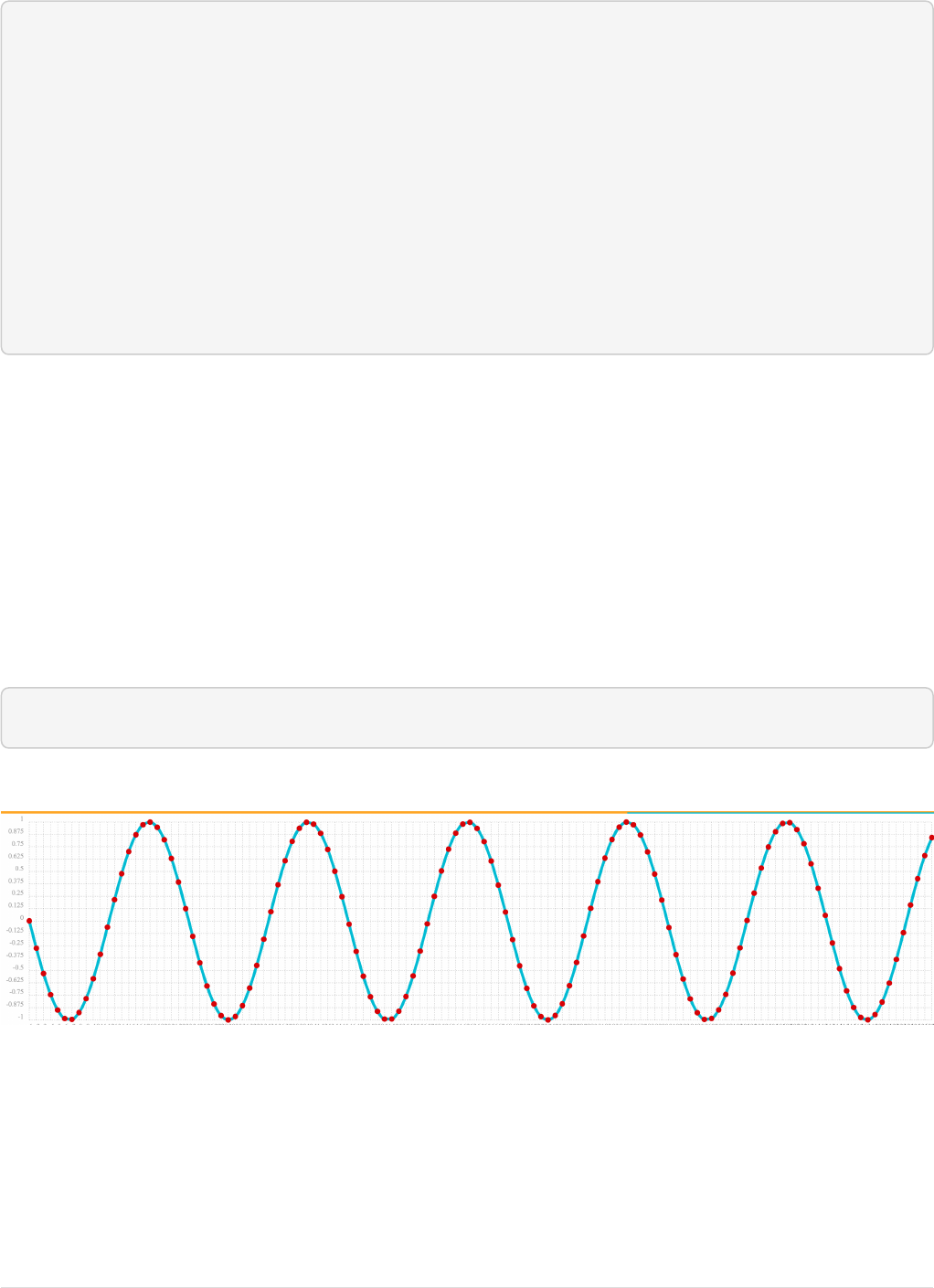
When this expression is sent to the /stream handler it responds with:
{
Ê "result-set": {
Ê "docs": [
Ê {
Ê "c": 3
Ê },
Ê {
Ê "EOF": true,
Ê "RESPONSE_TIME": 0
Ê }
Ê ]
Ê }
}
Oscillate (Sine Wave)
The oscillate function generates a periodic oscillating signal which can be used to model and study sine
waves.
The oscillate function takes three parameters: amplitude, angular frequency and phase and returns a
vector containing the y-axis points of a sine wave.
The y-axis points were generated from an x-axis sequence of 0-127.
Below is an example of the oscillate function called with an amplitude of 1, and angular frequency of .28
and phase of 1.57.
oscillate(1, 0.28, 1.57)
The result of the oscillate function is plotted below:
Sine Wave Interpolation, Extrapolation
The oscillate function returns a function which can be used by the predict function to interpolate or
extrapolate a sine wave. The example below extrapolates the sine wave to an x-axis sequence of 0-256.
Page 966 of 1426 Apache Solr Reference Guide 7.7
Guide Version 7.7 - Published: 2019-03-04 © 2019, Apache Software Foundation
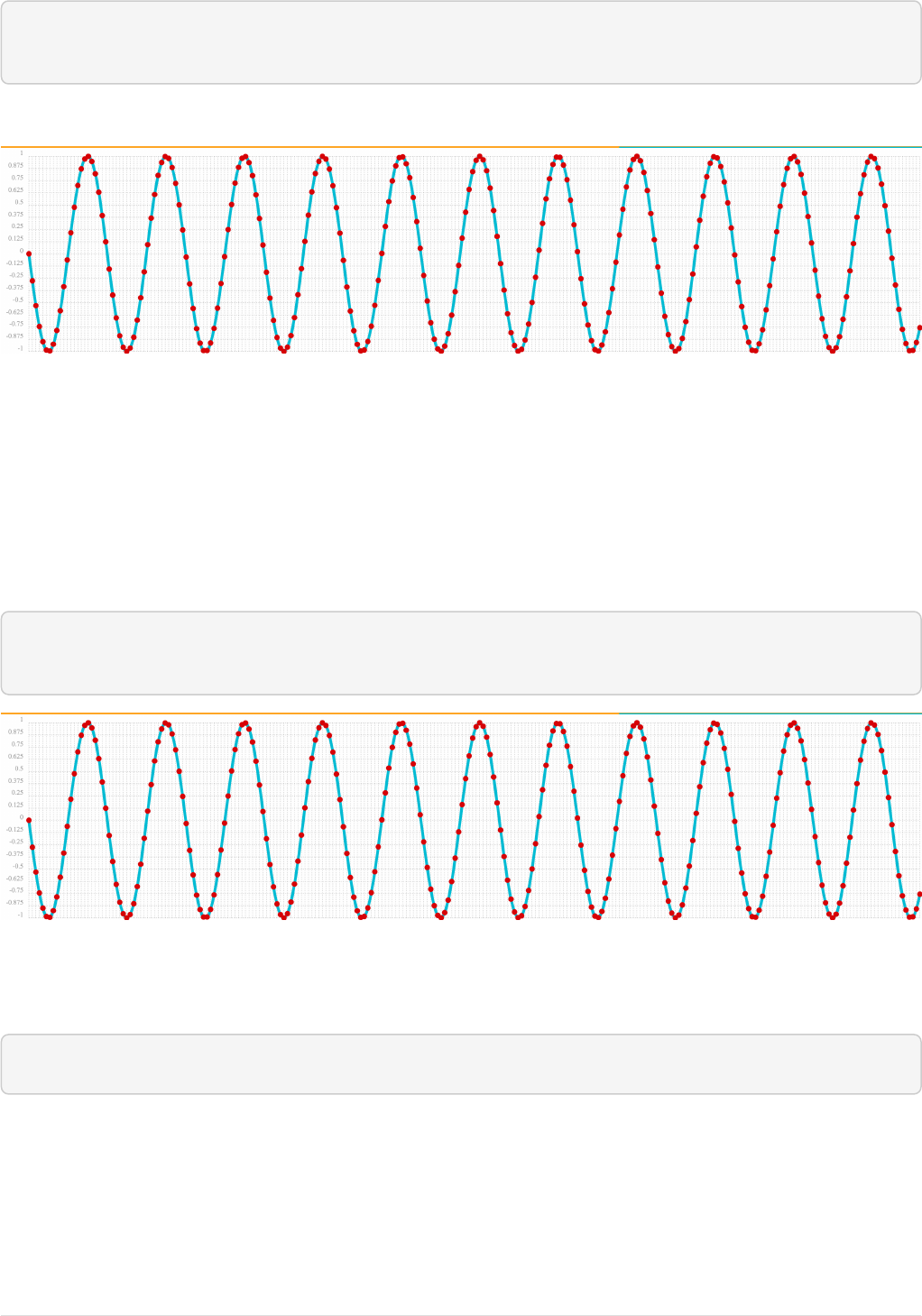
let(a=oscillate(1, 0.28, 1.57),
Ê b=predict(a, sequence(256, 0, 1)))
The extrapolated sine wave is plotted below:
Autocorrelation
Autocorrelation measures the degree to which a signal is correlated with itself. Autocorrelation is used to
determine if a vector contains a signal or is purely random.
A few examples, with plots, will help to understand the concepts.
The first example simply revisits the example above of an extrapolated sine wave. The result of this is
plotted in the image below. Notice that there is a structure to the plot that is clearly not random.
let(a=oscillate(1, 0.28, 1.57),
Ê b=predict(a, sequence(256, 0, 1)))
In the next example the sample function is used to draw 256 samples from a uniformDistribution to create
a vector of random data. The result of this is plotted in the image below. Notice that there is no clear
structure to the data and the data appears to be random.
sample(uniformDistribution(-1.5, 1.5), 256)
Apache Solr Reference Guide 7.7 Page 967 of 1426
© 2019, Apache Software Foundation Guide Version 7.7 - Published: 2019-03-04
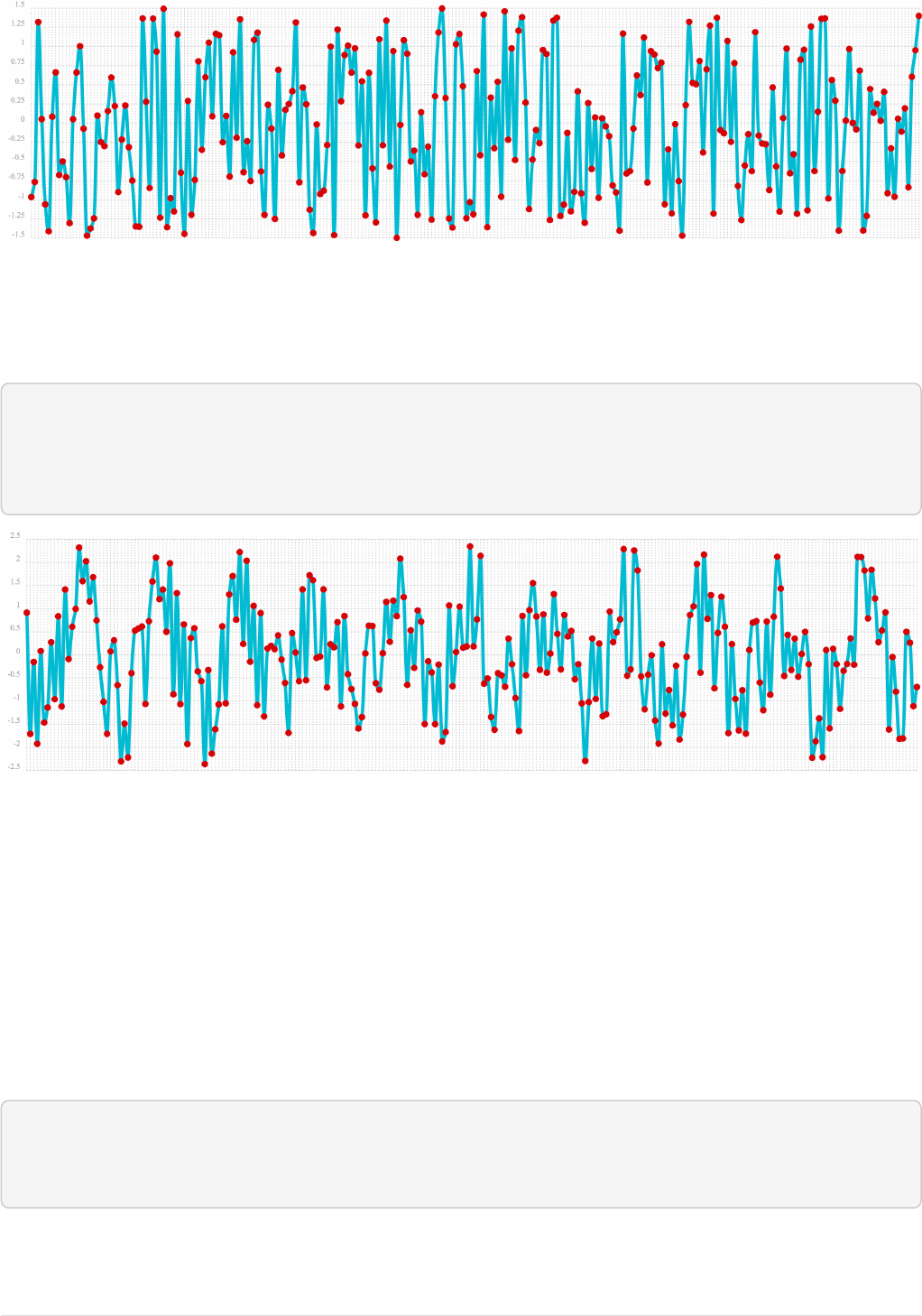
In the next example the random noise is added to the sine wave using the ebeAdd function. The result of this
is plotted in the image below. Notice that the sine wave has been hidden somewhat within the noise. Its
difficult to say for sure if there is structure. As plots becomes more dense it can become harder to see a
pattern hidden within noise.
let(a=oscillate(1, 0.28, 1.57),
Ê b=predict(a, sequence(256, 0, 1)),
Ê c=sample(uniformDistribution(-1.5, 1.5), 256),
Ê d=ebeAdd(b,c))
In the next examples autocorrelation is performed with each of the vectors shown above to see what the
autocorrelation plots look like.
In the example below the conv function is used to autocorrelate the first vector which is the sine wave.
Notice that the conv function is simply correlating the sine wave with itself.
The plot has a very distinct structure to it. As the sine wave is slid across a copy of itself the correlation
moves up and down in increasing intensity until it reaches a peak. This peak is directly in the center and is
the the point where the sine waves are directly lined up. Following the peak the correlation moves up and
down in decreasing intensity as the sine wave slides farther away from being directly lined up.
This is the autocorrelation plot of a pure signal.
let(a=oscillate(1, 0.28, 1.57),
Ê b=predict(a, sequence(256, 0, 1)),
Ê c=conv(b, rev(b)))
Page 968 of 1426 Apache Solr Reference Guide 7.7
Guide Version 7.7 - Published: 2019-03-04 © 2019, Apache Software Foundation
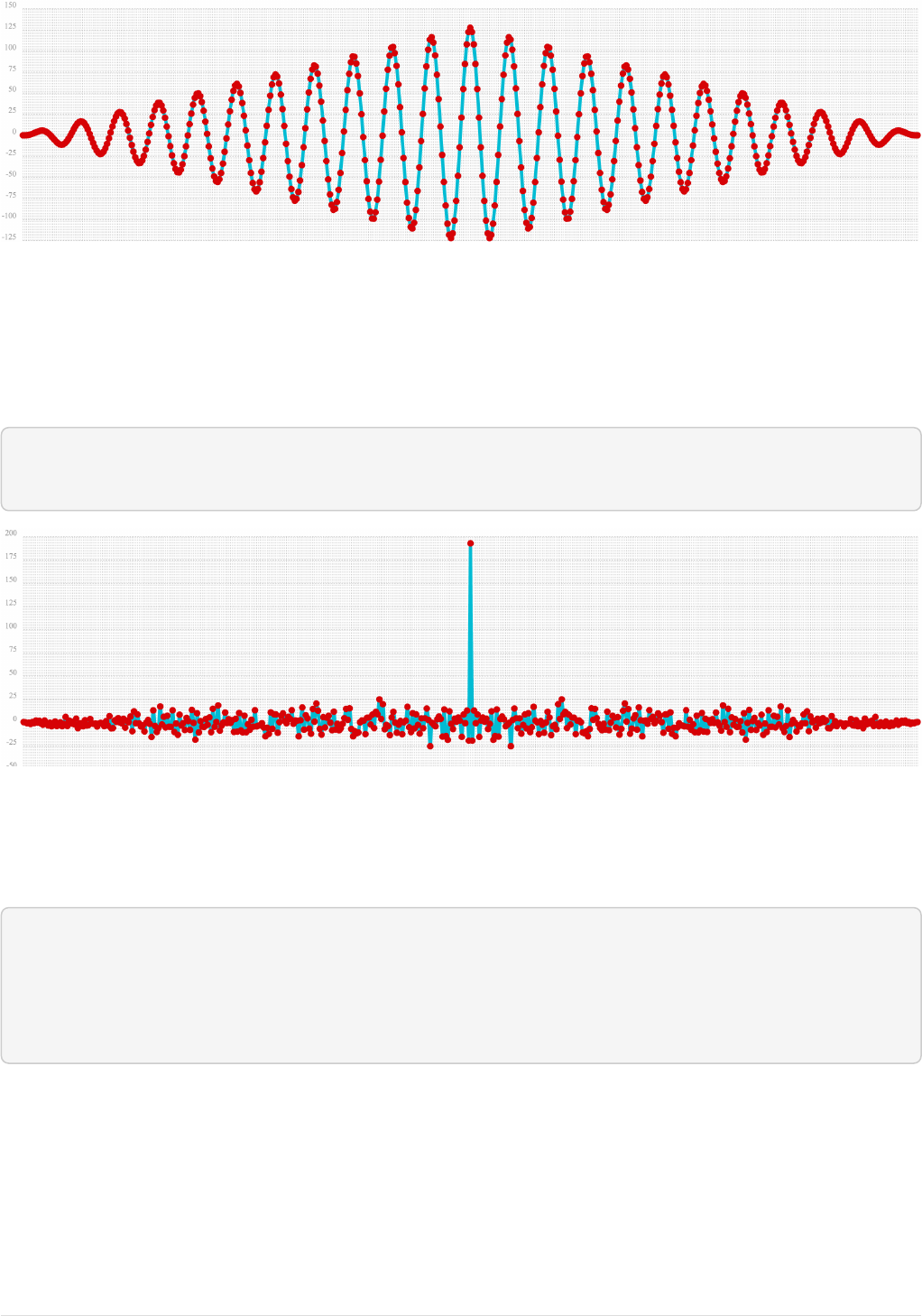
In the example below autocorrelation is performed with the vector of pure noise. Notice that the
autocorrelation plot has a very different plot then the sine wave. In this plot there is long period of low
intensity correlation that appears to be random. Then in the center a peak of high intensity correlation
where the vectors are directly lined up. This is followed by another long period of low intensity correlation.
This is the autocorrelation plot of pure noise.
let(a=sample(uniformDistribution(-1.5, 1.5), 256),
Ê b=conv(a, rev(a)),
In the example below autocorrelation is performed on the vector with the sine wave hidden within the noise.
Notice that this plot shows very clear signs of structure which is similar to autocorrelation plot of the pure
signal. The correlation is less intense due to noise but the shape of the correlation plot suggests strongly
that there is an underlying signal hidden within the noise.
let(a=oscillate(1, 0.28, 1.57),
Ê b=predict(a, sequence(256, 0, 1)),
Ê c=sample(uniformDistribution(-1.5, 1.5), 256),
Ê d=ebeAdd(b, c),
Ê e=conv(d, rev(d)))
Apache Solr Reference Guide 7.7 Page 969 of 1426
© 2019, Apache Software Foundation Guide Version 7.7 - Published: 2019-03-04
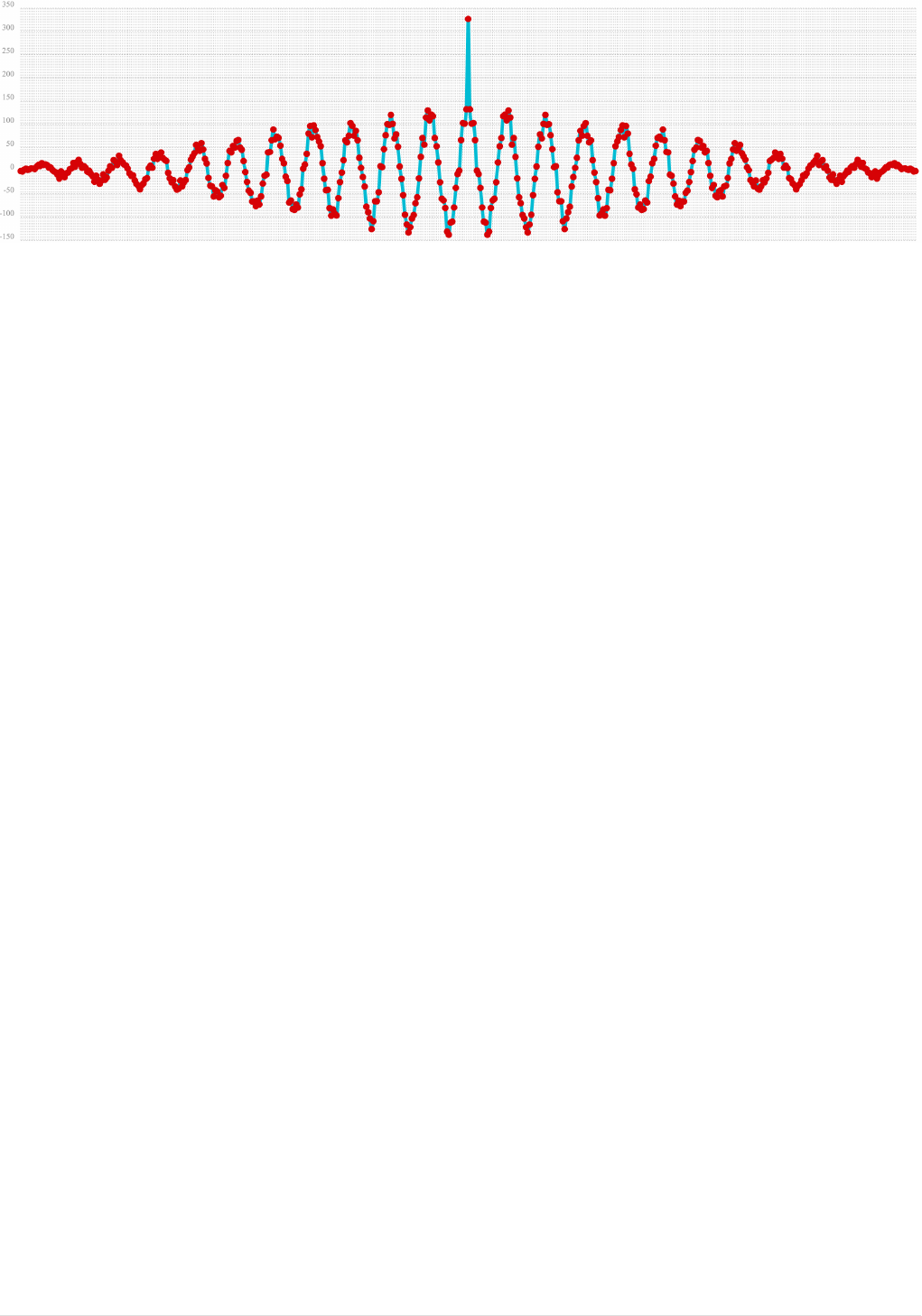
Discrete Fourier Transform
The convolution based functions described above are operating on signals in the time domain. In the time
domain the X axis is time and the Y axis is the quantity of some value at a specific point in time.
The discrete Fourier Transform translates a time domain signal into the frequency domain. In the frequency
domain the X axis is frequency, and Y axis is the accumulated power at a specific frequency.
The basic principle is that every time domain signal is composed of one or more signals (sine waves) at
different frequencies. The discrete Fourier transform decomposes a time domain signal into its component
frequencies and measures the power at each frequency.
The discrete Fourier transform has many important uses. In the example below, the discrete Fourier
transform is used to determine if a signal has structure or if it is purely random.
Complex Result
The fft function performs the discrete Fourier Transform on a vector of real data. The result of the fft
function is returned as complex numbers. A complex number has two parts, real and imaginary. The
imaginary part of the complex number is ignored in the examples below, but there are many tutorials on the
FFT and that include complex numbers available online.
But before diving into the examples it is important to understand how the fft function formats the complex
numbers in the result.
The fft function returns a matrix with two rows. The first row in the matrix is the real part of the complex
result. The second row in the matrix is the imaginary part of the complex result.
The rowAt function can be used to access the rows so they can be processed as vectors. This approach was
taken because all of the vector math functions operate on vectors of real numbers. Rather then introducing
a complex number abstraction into the expression language, the fft result is represented as two vectors of
real numbers.
Fast Fourier Transform Examples
In the first example the fft function is called on the sine wave used in the autocorrelation example.
The results of the fft function is a matrix. The rowAt function is used to return the first row of the matrix
which is a vector containing the real values of the fft response.
The plot of the real values of the fft response is shown below. Notice there are two peaks on opposite sides
Page 970 of 1426 Apache Solr Reference Guide 7.7
Guide Version 7.7 - Published: 2019-03-04 © 2019, Apache Software Foundation
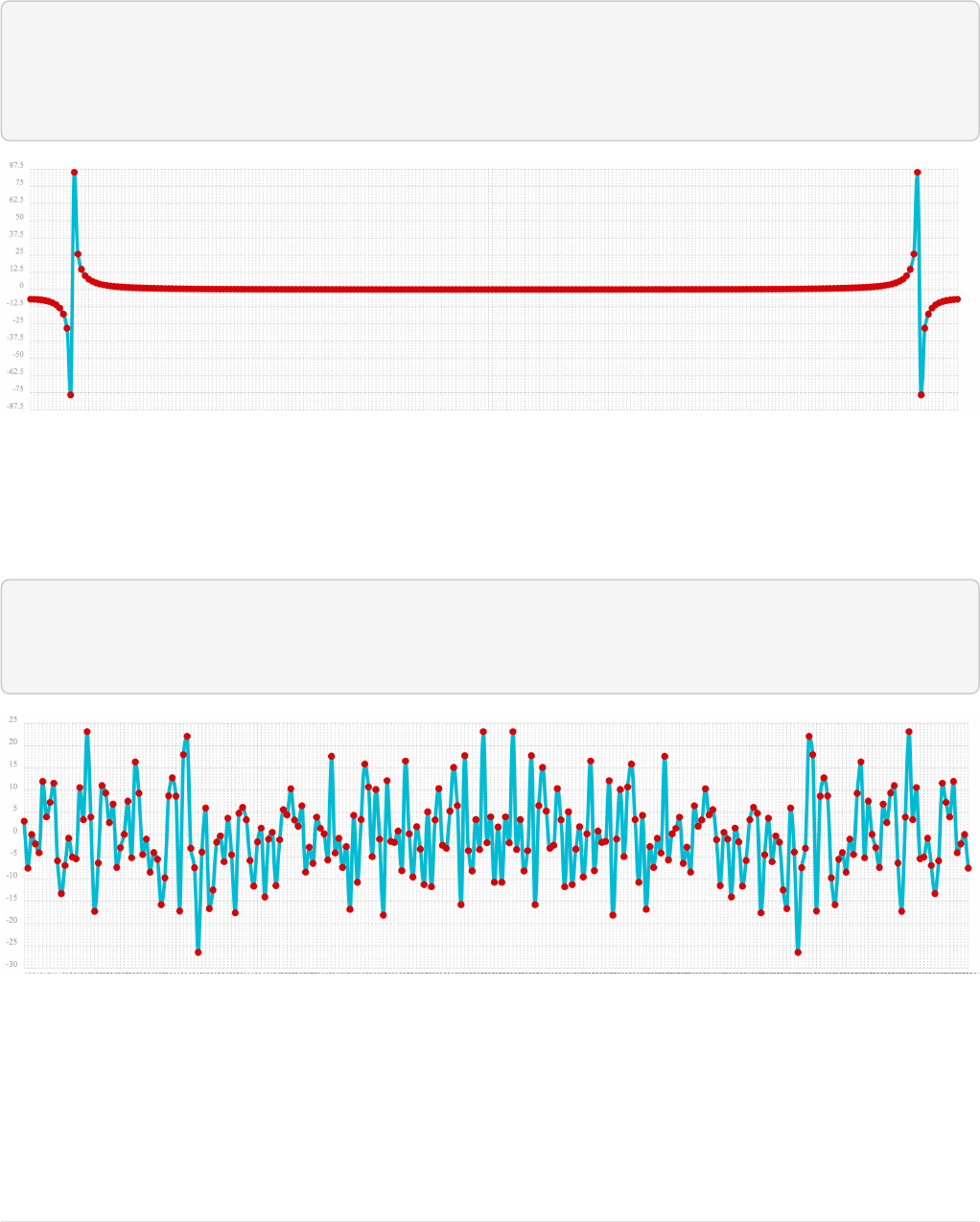
of the plot. The plot is actually showing a mirrored response. The right side of the plot is an exact mirror of
the left side. This is expected when the fft is run on real rather than complex data.
Also notice that the fft has accumulated significant power in a single peak. This is the power associated
with the specific frequency of the sine wave. The vast majority of frequencies in the plot have close to 0
power associated with them. This fft shows a clear signal with very low levels of noise.
let(a=oscillate(1, 0.28, 1.57),
Ê b=predict(a, sequence(256, 0, 1)),
Ê c=fft(b),
Ê d=rowAt(c, 0))
In the second example the fft function is called on a vector of random data similar to one used in the
autocorrelation example. The plot of the real values of the fft response is shown below.
Notice that in is this response there is no clear peak. Instead all frequencies have accumulated a random
level of power. This fft shows no clear sign of signal and appears to be noise.
let(a=sample(uniformDistribution(-1.5, 1.5), 256),
Ê b=fft(a),
Ê c=rowAt(b, 0))
In the third example the fft function is called on the same signal hidden within noise that was used for the
autocorrelation example. The plot of the real values of the fft response is shown below.
Notice that there are two clear mirrored peaks, at the same locations as the fft of the pure signal. But there
is also now considerable noise on the frequencies. The fft has found the signal and but also shows that
there is considerable noise along with the signal.
Apache Solr Reference Guide 7.7 Page 971 of 1426
© 2019, Apache Software Foundation Guide Version 7.7 - Published: 2019-03-04
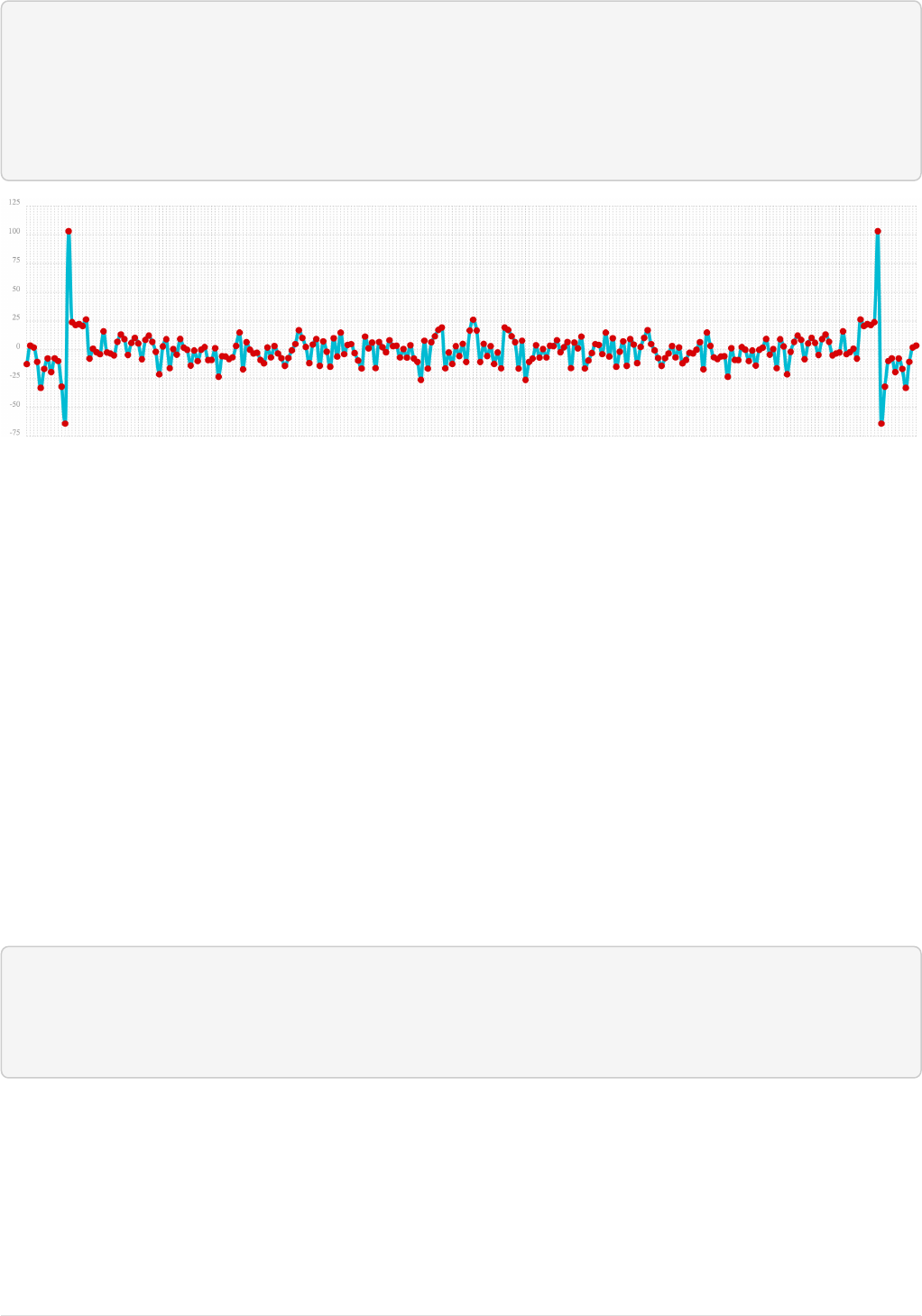
let(a=oscillate(1, 0.28, 1.57),
Ê b=predict(a, sequence(256, 0, 1)),
Ê c=sample(uniformDistribution(-1.5, 1.5), 256),
Ê d=ebeAdd(b, c),
Ê e=fft(d),
Ê f=rowAt(e, 0))
Machine Learning
This section of the math expressions user guide covers machine learning functions.
Feature Scaling
Before performing machine learning operations its often necessary to scale the feature vectors so they can
be compared at the same scale.
All the scaling function operate on vectors and matrices. When operating on a matrix the rows of the matrix
are scaled.
Min/Max Scaling
The minMaxScale function scales a vector or matrix between a minimum and maximum value. By default it
will scale between 0 and 1 if min/max values are not provided.
Below is a simple example of min/max scaling between 0 and 1. Notice that once brought into the same
scale the vectors are the same.
let(a=array(20, 30, 40, 50),
Ê b=array(200, 300, 400, 500),
Ê c=matrix(a, b),
Ê d=minMaxScale(c))
This expression returns the following response:
Page 972 of 1426 Apache Solr Reference Guide 7.7
Guide Version 7.7 - Published: 2019-03-04 © 2019, Apache Software Foundation

{
Ê "result-set": {
Ê "docs": [
Ê {
Ê "d": [
Ê [
Ê 0,
Ê 0.3333333333333333,
Ê 0.6666666666666666,
Ê 1
Ê ],
Ê [
Ê 0,
Ê 0.3333333333333333,
Ê 0.6666666666666666,
Ê 1
Ê ]
Ê ]
Ê },
Ê {
Ê "EOF": true,
Ê "RESPONSE_TIME": 0
Ê }
Ê ]
Ê }
}
Standardization
The standardize function scales a vector so that it has a mean of 0 and a standard deviation of 1.
Standardization can be used with machine learning algorithms, such as Support Vector Machine (SVM), that
perform better when the data has a normal distribution.
let(a=array(20, 30, 40, 50),
Ê b=array(200, 300, 400, 500),
Ê c=matrix(a, b),
Ê d=standardize(c))
This expression returns the following response:
Apache Solr Reference Guide 7.7 Page 973 of 1426
© 2019, Apache Software Foundation Guide Version 7.7 - Published: 2019-03-04

{
Ê "result-set": {
Ê "docs": [
Ê {
Ê "d": [
Ê [
Ê -1.161895003862225,
Ê -0.3872983346207417,
Ê 0.3872983346207417,
Ê 1.161895003862225
Ê ],
Ê [
Ê -1.1618950038622249,
Ê -0.38729833462074165,
Ê 0.38729833462074165,
Ê 1.1618950038622249
Ê ]
Ê ]
Ê },
Ê {
Ê "EOF": true,
Ê "RESPONSE_TIME": 17
Ê }
Ê ]
Ê }
}
Unit Vectors
The unitize function scales vectors to a magnitude of 1. A vector with a magnitude of 1 is known as a unit
vector. Unit vectors are preferred when the vector math deals with vector direction rather than magnitude.
let(a=array(20, 30, 40, 50),
Ê b=array(200, 300, 400, 500),
Ê c=matrix(a, b),
Ê d=unitize(c))
This expression returns the following response:
Page 974 of 1426 Apache Solr Reference Guide 7.7
Guide Version 7.7 - Published: 2019-03-04 © 2019, Apache Software Foundation

{
Ê "result-set": {
Ê "docs": [
Ê {
Ê "d": [
Ê [
Ê 0.2721655269759087,
Ê 0.40824829046386296,
Ê 0.5443310539518174,
Ê 0.6804138174397716
Ê ],
Ê [
Ê 0.2721655269759087,
Ê 0.4082482904638631,
Ê 0.5443310539518174,
Ê 0.6804138174397717
Ê ]
Ê ]
Ê },
Ê {
Ê "EOF": true,
Ê "RESPONSE_TIME": 6
Ê }
Ê ]
Ê }
}
Distance and Distance Measures
The distance function computes the distance for two numeric arrays or a distance matrix for the columns of
a matrix.
There are five distance measure functions that return a function that performs the actual distance
calculation:
•euclidean (default)
•manhattan
•canberra
•earthMovers
•haversineMeters (Geospatial distance measure)
The distance measure functions can be used with all machine learning functions that support distance
measures.
Below is an example for computing Euclidean distance for two numeric arrays:
Apache Solr Reference Guide 7.7 Page 975 of 1426
© 2019, Apache Software Foundation Guide Version 7.7 - Published: 2019-03-04

let(a=array(20, 30, 40, 50),
Ê b=array(21, 29, 41, 49),
Ê c=distance(a, b))
This expression returns the following response:
{
Ê "result-set": {
Ê "docs": [
Ê {
Ê "c": 2
Ê },
Ê {
Ê "EOF": true,
Ê "RESPONSE_TIME": 0
Ê }
Ê ]
Ê }
}
Below the distance is calculated using Manahattan distance.
let(a=array(20, 30, 40, 50),
Ê b=array(21, 29, 41, 49),
Ê c=distance(a, b, manhattan()))
This expression returns the following response:
{
Ê "result-set": {
Ê "docs": [
Ê {
Ê "c": 4
Ê },
Ê {
Ê "EOF": true,
Ê "RESPONSE_TIME": 1
Ê }
Ê ]
Ê }
}
Below is an example for computing a distance matrix for columns of a matrix:
Page 976 of 1426 Apache Solr Reference Guide 7.7
Guide Version 7.7 - Published: 2019-03-04 © 2019, Apache Software Foundation

let(a=array(20, 30, 40),
Ê b=array(21, 29, 41),
Ê c=array(31, 40, 50),
Ê d=matrix(a, b, c),
Ê c=distance(d))
This expression returns the following response:
{
Ê "result-set": {
Ê "docs": [
Ê {
Ê "e": [
Ê [
Ê 0,
Ê 15.652475842498529,
Ê 34.07345007480164
Ê ],
Ê [
Ê 15.652475842498529,
Ê 0,
Ê 18.547236990991408
Ê ],
Ê [
Ê 34.07345007480164,
Ê 18.547236990991408,
Ê 0
Ê ]
Ê ]
Ê },
Ê {
Ê "EOF": true,
Ê "RESPONSE_TIME": 24
Ê }
Ê ]
Ê }
}
K-Means Clustering
The kmeans functions performs k-means clustering of the rows of a matrix. Once the clustering has been
completed there are a number of useful functions available for examining the clusters and centroids.
The examples below cluster term vectors. The section Text Analysis and Term Vectors offers a full explanation
of these features.
Centroid Features
In the example below the kmeans function is used to cluster a result set from the Enron email data-set and
then the top features are extracted from the cluster centroids.
Apache Solr Reference Guide 7.7 Page 977 of 1426
© 2019, Apache Software Foundation Guide Version 7.7 - Published: 2019-03-04

let(a=select(random(enron, q="body:oil", rows="500", fl="id, body"), ①
Ê id,
Ê analyze(body, body_bigram) as terms),
Ê b=termVectors(a, maxDocFreq=.10, minDocFreq=.05, minTermLength=14, exclude="_,copyright"),②
Ê c=kmeans(b, 5), ③
Ê d=getCentroids(c), ④
Ê e=topFeatures(d, 5)) ⑤
Let’s look at what data is assigned to each variable:
①a: The random function returns a sample of 500 documents from the "enron" collection that match the
query "body:oil". The select function selects the id and and annotates each tuple with the analyzed
bigram terms from the body field.
②b: The termVectors function creates a TF-IDF term vector matrix from the tuples stored in variable a.
Each row in the matrix represents a document. The columns of the matrix are the bigram terms that
were attached to each tuple.
③c: The kmeans function clusters the rows of the matrix into 5 clusters. The k-means clustering is
performed using the Euclidean distance measure.
④d: The getCentroids function returns a matrix of cluster centroids. Each row in the matrix is a centroid
from one of the 5 clusters. The columns of the matrix are the same bigrams terms of the term vector
matrix.
⑤e: The topFeatures function returns the column labels for the top 5 features of each centroid in the
matrix. This returns the top 5 bigram terms for each centroid.
This expression returns the following response:
Page 978 of 1426 Apache Solr Reference Guide 7.7
Guide Version 7.7 - Published: 2019-03-04 © 2019, Apache Software Foundation

{
Ê "result-set": {
Ê "docs": [
Ê {
Ê "e": [
Ê [
Ê "enron enronxgate",
Ê "north american",
Ê "energy services",
Ê "conference call",
Ê "power generation"
Ê ],
Ê [
Ê "financial times",
Ê "chief financial",
Ê "financial officer",
Ê "exchange commission",
Ê "houston chronicle"
Ê ],
Ê [
Ê "southern california",
Ê "california edison",
Ê "public utilities",
Ê "utilities commission",
Ê "rate increases"
Ê ],
Ê [
Ê "rolling blackouts",
Ê "public utilities",
Ê "electricity prices",
Ê "federal energy",
Ê "price controls"
Ê ],
Ê [
Ê "california edison",
Ê "regulatory commission",
Ê "southern california",
Ê "federal energy",
Ê "power generators"
Ê ]
Ê ]
Ê },
Ê {
Ê "EOF": true,
Ê "RESPONSE_TIME": 982
Ê }
Ê ]
Ê }
}
Apache Solr Reference Guide 7.7 Page 979 of 1426
© 2019, Apache Software Foundation Guide Version 7.7 - Published: 2019-03-04

Cluster Features
The example below examines the top features of a specific cluster. This example uses the same techniques
as the centroids example but the top features are extracted from a cluster rather than the centroids.
let(a=select(random(collection3, q="body:oil", rows="500", fl="id, body"),
Ê id,
Ê analyze(body, body_bigram) as terms),
Ê b=termVectors(a, maxDocFreq=.09, minDocFreq=.03, minTermLength=14, exclude="_,copyright"),
Ê c=kmeans(b, 25),
Ê d=getCluster(c, 0), ①
Ê e=topFeatures(d, 4)) ②
①The getCluster function returns a cluster by its index. Each cluster is a matrix containing term vectors
that have been clustered together based on their features.
②The topFeatures function is used to extract the top 4 features from each term vector in the cluster.
This expression returns the following response:
{
Ê "result-set": {
Ê "docs": [
Ê {
Ê "e": [
Ê [
Ê "electricity board",
Ê "maharashtra state",
Ê "power purchase",
Ê "state electricity",
Ê "reserved enron"
Ê ],
Ê [
Ê "electricity board",
Ê "maharashtra state",
Ê "state electricity",
Ê "purchase agreement",
Ê "independent power"
Ê ],
Ê [
Ê "maharashtra state",
Ê "reserved enron",
Ê "federal government",
Ê "state government",
Ê "dabhol project"
Ê ],
Ê [
Ê "purchase agreement",
Ê "power purchase",
Ê "electricity board",
Ê "maharashtra state",
Ê "state government"
Page 980 of 1426 Apache Solr Reference Guide 7.7
Guide Version 7.7 - Published: 2019-03-04 © 2019, Apache Software Foundation

Ê ],
Ê [
Ê "investment grade",
Ê "portland general",
Ê "general electric",
Ê "holding company",
Ê "transmission lines"
Ê ],
Ê [
Ê "state government",
Ê "state electricity",
Ê "purchase agreement",
Ê "electricity board",
Ê "maharashtra state"
Ê ],
Ê [
Ê "electricity board",
Ê "state electricity",
Ê "energy management",
Ê "maharashtra state",
Ê "energy markets"
Ê ],
Ê [
Ê "electricity board",
Ê "maharashtra state",
Ê "state electricity",
Ê "state government",
Ê "second quarter"
Ê ]
Ê ]
Ê },
Ê {
Ê "EOF": true,
Ê "RESPONSE_TIME": 978
Ê }
Ê ]
Ê }
}
Multi K-Means Clustering
K-means clustering will produce different results depending on the initial placement of the centroids. K-
means is fast enough that multiple trials can be performed and the best outcome selected.
The multiKmeans function runs the k-means clustering algorithm for a given number of trials and selects the
best result based on which trial produces the lowest intra-cluster variance.
The example below is identical to centroids example except that it uses multiKmeans with 100 trials, rather
than a single trial of the kmeans function.
Apache Solr Reference Guide 7.7 Page 981 of 1426
© 2019, Apache Software Foundation Guide Version 7.7 - Published: 2019-03-04

let(a=select(random(collection3, q="body:oil", rows="500", fl="id, body"),
Ê id,
Ê analyze(body, body_bigram) as terms),
Ê b=termVectors(a, maxDocFreq=.09, minDocFreq=.03, minTermLength=14, exclude="_,copyright"),
Ê c=multiKmeans(b, 5, 100),
Ê d=getCentroids(c),
Ê e=topFeatures(d, 5))
This expression returns the following response:
Page 982 of 1426 Apache Solr Reference Guide 7.7
Guide Version 7.7 - Published: 2019-03-04 © 2019, Apache Software Foundation

{
Ê "result-set": {
Ê "docs": [
Ê {
Ê "e": [
Ê [
Ê "enron enronxgate",
Ê "energy trading",
Ê "energy markets",
Ê "energy services",
Ê "unleaded gasoline"
Ê ],
Ê [
Ê "maharashtra state",
Ê "electricity board",
Ê "state electricity",
Ê "energy trading",
Ê "chief financial"
Ê ],
Ê [
Ê "price controls",
Ê "electricity prices",
Ê "francisco chronicle",
Ê "wholesale electricity",
Ê "power generators"
Ê ],
Ê [
Ê "southern california",
Ê "california edison",
Ê "public utilities",
Ê "francisco chronicle",
Ê "utilities commission"
Ê ],
Ê [
Ê "california edison",
Ê "power purchases",
Ê "system operator",
Ê "term contracts",
Ê "independent system"
Ê ]
Ê ]
Ê },
Ê {
Ê "EOF": true,
Ê "RESPONSE_TIME": 1182
Ê }
Ê ]
Ê }
}
Apache Solr Reference Guide 7.7 Page 983 of 1426
© 2019, Apache Software Foundation Guide Version 7.7 - Published: 2019-03-04

Fuzzy K-Means Clustering
The fuzzyKmeans function is a soft clustering algorithm which allows vectors to be assigned to more then
one cluster. The fuzziness parameter is a value between 1 and 2 that determines how fuzzy to make the
cluster assignment.
After the clustering has been performed the getMembershipMatrix function can be called on the clustering
result to return a matrix describing which clusters each vector belongs to. There is a row in the matrix for
each vector that was clustered. There is a column in the matrix for each cluster. The values in the columns
are the probability that the vector belonged to the specific cluster.
A simple example will make this more clear. In the example below 300 documents are analyzed and then
turned into a term vector matrix. Then the fuzzyKmeans function clusters the term vectors into 12 clusters
with a fuzziness factor of 1.25.
let(a=select(random(collection3, q="body:oil", rows="300", fl="id, body"),
Ê id,
Ê analyze(body, body_bigram) as terms),
Ê b=termVectors(a, maxDocFreq=.09, minDocFreq=.03, minTermLength=14, exclude="_,copyright"),
Ê c=fuzzyKmeans(b, 12, fuzziness=1.25),
Ê d=getMembershipMatrix(c), ①
Ê e=rowAt(d, 0), ②
Ê f=precision(e, 5)) ③
①The getMembershipMatrix function is used to return the membership matrix;
②and the first row of membership matrix is retrieved with the rowAt function.
③The precision function is then applied to the first row of the matrix to make it easier to read.
This expression returns a single vector representing the cluster membership probabilities for the first term
vector. Notice that the term vector has the highest association with the 12th cluster, but also has significant
associations with the 3rd, 5th, 6th and 7th clusters:
Page 984 of 1426 Apache Solr Reference Guide 7.7
Guide Version 7.7 - Published: 2019-03-04 © 2019, Apache Software Foundation

{
Ê "result-set": {
Ê "docs": [
Ê {
Ê "f": [
Ê 0,
Ê 0,
Ê 0.178,
Ê 0,
Ê 0.17707,
Ê 0.17775,
Ê 0.16214,
Ê 0,
Ê 0,
Ê 0,
Ê 0,
Ê 0.30504
Ê ]
Ê },
Ê {
Ê "EOF": true,
Ê "RESPONSE_TIME": 2157
Ê }
Ê ]
Ê }
}
K-Nearest Neighbor (KNN)
The knn function searches the rows of a matrix for the k-nearest neighbors of a search vector. The knn
function returns a matrix of the k-nearest neighbors.
The knn function supports changing of the distance measure by providing one of these distance measure
functions as the fourth parameter:
•euclidean (Default)
•manhattan
•canberra
•earthMovers
The example below builds on the clustering examples to demonstrate the knn function.
Apache Solr Reference Guide 7.7 Page 985 of 1426
© 2019, Apache Software Foundation Guide Version 7.7 - Published: 2019-03-04

let(a=select(random(collection3, q="body:oil", rows="500", fl="id, body"),
Ê id,
Ê analyze(body, body_bigram) as terms),
Ê b=termVectors(a, maxDocFreq=.09, minDocFreq=.03, minTermLength=14, exclude="_,copyright"),
Ê c=multiKmeans(b, 5, 100),
Ê d=getCentroids(c), ①
Ê e=rowAt(d, 0), ②
Ê g=knn(b, e, 3), ③
Ê h=topFeatures(g, 4)) ④
①In the example, the centroids matrix is set to variable d.
②The first centroid vector is selected from the matrix with the rowAt function.
③Then the knn function is used to find the 3 nearest neighbors to the centroid vector in the term vector
matrix (variable b).
④The topFeatures function is used to request the top 4 featurs of the term vectors in the knn matrix.
The knn function returns a matrix with the 3 nearest neighbors based on the default distance measure which
is euclidean. Finally, the top 4 features of the term vectors in the nearest neighbor matrix are returned:
Page 986 of 1426 Apache Solr Reference Guide 7.7
Guide Version 7.7 - Published: 2019-03-04 © 2019, Apache Software Foundation

{
Ê "result-set": {
Ê "docs": [
Ê {
Ê "h": [
Ê [
Ê "california power",
Ê "electricity supply",
Ê "concerned about",
Ê "companies like"
Ê ],
Ê [
Ê "maharashtra state",
Ê "california power",
Ê "electricity board",
Ê "alternative energy"
Ê ],
Ê [
Ê "electricity board",
Ê "maharashtra state",
Ê "state electricity",
Ê "houston chronicle"
Ê ]
Ê ]
Ê },
Ê {
Ê "EOF": true,
Ê "RESPONSE_TIME": 1243
Ê }
Ê ]
Ê }
}
K-Nearest Neighbor Regression
K-nearest neighbor regression is a non-linear, multi-variate regression method. Knn regression is a lazy
learning technique which means it does not fit a model to the training set in advance. Instead the entire
training set of observations and outcomes are held in memory and predictions are made by averaging the
outcomes of the k-nearest neighbors.
The knnRegress function prepares the training set for use with the predict function.
Below is an example of the knnRegress function. In this example 10,000 random samples are taken, each
containing the variables filesize_d, service_d and response_d. The pairs of filesize_d and service_d
will be used to predict the value of response_d.
Apache Solr Reference Guide 7.7 Page 987 of 1426
© 2019, Apache Software Foundation Guide Version 7.7 - Published: 2019-03-04

let(samples=random(collection1, q="*:*", rows="10000", fl="filesize_d, service_d, response_d"),
Ê filesizes=col(samples, filesize_d),
Ê serviceLevels=col(samples, service_d),
Ê outcomes=col(samples, response_d),
Ê observations=transpose(matrix(filesizes, serviceLevels)),
Ê lazyModel=knnRegress(observations, outcomes , 5))
This expression returns the following response. Notice that knnRegress returns a tuple describing the
regression inputs:
{
Ê "result-set": {
Ê "docs": [
Ê {
Ê "lazyModel": {
Ê "features": 2,
Ê "robust": false,
Ê "distance": "EuclideanDistance",
Ê "observations": 10000,
Ê "scale": false,
Ê "k": 5
Ê }
Ê },
Ê {
Ê "EOF": true,
Ê "RESPONSE_TIME": 170
Ê }
Ê ]
Ê }
}
Prediction and Residuals
The output of knnRegress can be used with the predict function like other regression models.
In the example below the predict function is used to predict results for the original training data. The
sumSq of the residuals is then calculated.
let(samples=random(collection1, q="*:*", rows="10000", fl="filesize_d, service_d, response_d"),
Ê filesizes=col(samples, filesize_d),
Ê serviceLevels=col(samples, service_d),
Ê outcomes=col(samples, response_d),
Ê observations=transpose(matrix(filesizes, serviceLevels)),
Ê lazyModel=knnRegress(observations, outcomes , 5),
Ê predictions=predict(lazyModel, observations),
Ê residuals=ebeSubtract(outcomes, predictions),
Ê sumSqErr=sumSq(residuals))
This expression returns the following response:
Page 988 of 1426 Apache Solr Reference Guide 7.7
Guide Version 7.7 - Published: 2019-03-04 © 2019, Apache Software Foundation

{
Ê "result-set": {
Ê "docs": [
Ê {
Ê "sumSqErr": 1920290.1204126712
Ê },
Ê {
Ê "EOF": true,
Ê "RESPONSE_TIME": 3796
Ê }
Ê ]
Ê }
}
Setting Feature Scaling
If the features in the observation matrix are not in the same scale then the larger features will carry more
weight in the distance calculation then the smaller features. This can greatly impact the accuracy of the
prediction. The knnRegress function has a scale parameter which can be set to true to automatically scale
the features in the same range.
The example below shows knnRegress with feature scaling turned on.
Notice that when feature scaling is turned on the sumSqErr in the output is much lower. This shows how
much more accurate the predictions are when feature scaling is turned on in this particular example. This is
because the filesize_d feature is significantly larger then the service_d feature.
let(samples=random(collection1, q="*:*", rows="10000", fl="filesize_d, service_d, response_d"),
Ê filesizes=col(samples, filesize_d),
Ê serviceLevels=col(samples, service_d),
Ê outcomes=col(samples, response_d),
Ê observations=transpose(matrix(filesizes, serviceLevels)),
Ê lazyModel=knnRegress(observations, outcomes , 5, scale=true),
Ê predictions=predict(lazyModel, observations),
Ê residuals=ebeSubtract(outcomes, predictions),
Ê sumSqErr=sumSq(residuals))
This expression returns the following response:
Apache Solr Reference Guide 7.7 Page 989 of 1426
© 2019, Apache Software Foundation Guide Version 7.7 - Published: 2019-03-04

{
Ê "result-set": {
Ê "docs": [
Ê {
Ê "sumSqErr": 4076.794951120683
Ê },
Ê {
Ê "EOF": true,
Ê "RESPONSE_TIME": 3790
Ê }
Ê ]
Ê }
}
Setting Robust Regression
The default prediction approach is to take the mean of the outcomes of the k-nearest neighbors. If the
outcomes contain outliers the mean value can be skewed. Setting the robust parameter to true will take the
median outcome of the k-nearest neighbors. This provides a regression prediction that is robust to outliers.
Setting the Distance Measure
The distance measure can be changed for the k-nearest neighbor search by adding a distance measure
function to the knnRegress parameters. Below is an example using manhattan distance.
let(samples=random(collection1, q="*:*", rows="10000", fl="filesize_d, service_d, response_d"),
Ê filesizes=col(samples, filesize_d),
Ê serviceLevels=col(samples, service_d),
Ê outcomes=col(samples, response_d),
Ê observations=transpose(matrix(filesizes, serviceLevels)),
Ê lazyModel=knnRegress(observations, outcomes, 5, manhattan(), scale=true),
Ê predictions=predict(lazyModel, observations),
Ê residuals=ebeSubtract(outcomes, predictions),
Ê sumSqErr=sumSq(residuals))
This expression returns the following response:
Page 990 of 1426 Apache Solr Reference Guide 7.7
Guide Version 7.7 - Published: 2019-03-04 © 2019, Apache Software Foundation

{
Ê "result-set": {
Ê "docs": [
Ê {
Ê "sumSqErr": 4761.221942288098
Ê },
Ê {
Ê "EOF": true,
Ê "RESPONSE_TIME": 3571
Ê }
Ê ]
Ê }
}
Computational Geometry
This section of the math expressions user guide covers computational geometry functions.
Convex Hull
A convex hull is the smallest convex set of points that encloses a data set. Math expressions has support for
computing the convex hull of a 2D data set. Once a convex hull has been calculated, a set of math
expression functions can be applied to geometrically describe the convex hull.
The convexHull function finds the convex hull of an observation matrix of 2D vectors. Each row of the matrix
is a 2D observation.
In the example below a convex hull is calculated for a randomly generated set of 100 2D observations.
Then the following functions are called on the convex hull:
-getBaryCenter: Returns the 2D point that is the bary center of the convex hull.
-getArea: Returns the area of the convex hull.
-getBoundarySize: Returns the boundary size of the convex hull.
-getVertices: Returns a set of 2D points that are the vertices of the convex hull.
let(echo="baryCenter, area, boundarySize, vertices",
Ê x=sample(normalDistribution(0, 20), 100),
Ê y=sample(normalDistribution(0, 10), 100),
Ê observations=transpose(matrix(x,y)),
Ê chull=convexHull(observations),
Ê baryCenter=getBaryCenter(chull),
Ê area=getArea(chull),
Ê boundarySize=getBoundarySize(chull),
Ê vertices=getVertices(chull))
When this expression is sent to the /stream handler it responds with:
Apache Solr Reference Guide 7.7 Page 991 of 1426
© 2019, Apache Software Foundation Guide Version 7.7 - Published: 2019-03-04

{
Ê "result-set": {
Ê "docs": [
Ê {
Ê "baryCenter": [
Ê -3.0969292101230343,
Ê 1.2160948182691975
Ê ],
Ê "area": 3477.480599967595,
Ê "boundarySize": 267.52419019533664,
Ê "vertices": [
Ê [
Ê -66.17632818958485,
Ê -8.394931552315256
Ê ],
Ê [
Ê -47.556667594765216,
Ê -16.940434013651263
Ê ],
Ê [
Ê -33.13582183446102,
Ê -17.30914425443977
Ê ],
Ê [
Ê -9.97459859015698,
Ê -17.795012801599654
Ê ],
Ê [
Ê 27.7705917246824,
Ê -14.487224686587767
Ê ],
Ê [
Ê 54.689432954170236,
Ê -1.3333371984299605
Ê ],
Ê [
Ê 35.97568654458672,
Ê 23.054169251772556
Ê ],
Ê [
Ê -15.539456215337585,
Ê 19.811330468093704
Ê ],
Ê [
Ê -17.05125031092752,
Ê 19.53581741341663
Ê ],
Ê [
Ê -35.92010024412891,
Ê 15.126430698395572
Ê ]
Page 992 of 1426 Apache Solr Reference Guide 7.7
Guide Version 7.7 - Published: 2019-03-04 © 2019, Apache Software Foundation

Ê ]
Ê },
Ê {
Ê "EOF": true,
Ê "RESPONSE_TIME": 3
Ê }
Ê ]
Ê }
}
Enclosing Disk
The enclosingDisk function finds the smallest enclosing circle the encloses a 2D data set. Once an enclosing
disk has been calculated, a set of math expression functions can be applied to geometrically describe the
enclosing disk.
In the example below an enclosing disk is calculated for a randomly generated set of 1000 2D observations.
Then the following functions are called on the enclosing disk:
-getCenter: Returns the 2D point that is the center of the disk.
-getRadius: Returns the radius of the disk.
-getSupportPoints: Returns the support points of the disk.
let(echo="center, radius, support",
Ê x=sample(normalDistribution(0, 20), 1000),
Ê y=sample(normalDistribution(0, 20), 1000),
Ê observations=transpose(matrix(x,y)),
Ê disk=enclosingDisk(observations),
Ê center=getCenter(disk),
Ê radius=getRadius(disk),
Ê support=getSupportPoints(disk))
When this expression is sent to the /stream handler it responds with:
Apache Solr Reference Guide 7.7 Page 993 of 1426
© 2019, Apache Software Foundation Guide Version 7.7 - Published: 2019-03-04

{
Ê "result-set": {
Ê "docs": [
Ê {
Ê "center": [
Ê -6.668825009733749,
Ê -2.9825450908240025
Ê ],
Ê "radius": 72.66109546907208,
Ê "support": [
Ê [
Ê 20.350992271739464,
Ê 64.46791279377014
Ê ],
Ê [
Ê 33.02079953093981,
Ê 57.880978456420365
Ê ],
Ê [
Ê -44.7273247899923,
Ê -64.87911518353323
Ê ]
Ê ]
Ê },
Ê {
Ê "EOF": true,
Ê "RESPONSE_TIME": 8
Ê }
Ê ]
Ê }
}
Page 994 of 1426 Apache Solr Reference Guide 7.7
Guide Version 7.7 - Published: 2019-03-04 © 2019, Apache Software Foundation

Graph Traversal
Graph traversal with streaming expressions uses the nodes function to perform a breadth-first graph
traversal.
The nodes function can be combined with the scoreNodes function to provide recommendations. nodes can
also be combined with the wider streaming expression library to perform complex operations on gathered
node sets.
nodes traversals are distributed within a SolrCloud collection and can span collections.
nodes is designed for use cases that involve zooming into a neighborhood in the graph and performing
precise traversals to gather node sets and aggregations. In these types of use cases nodes will often provide
sub-second performance. Some sample use cases are provided later in the document.
This document assumes a basic understanding of graph terminology and streaming
expressions. You can begin exploring graph traversal concepts with this Wikipedia article.
More details about streaming expressions are available in this Guide, in the section
Streaming Expressions.
Basic Syntax
We’ll start with the most basic syntax and slowly build up more complexity. The most basic syntax for nodes
is:
nodes(emails,
Ê walk="johndoe@apache.org->from",
Ê gather="to")
Let’s break down this simple expression.
The first parameter, emails, is the collection being traversed. The second parameter, walk, maps a hard-
coded node ID ("johndoe@apache.org") to a field in the index (from). This will return all the edges in the
index that have johndoe@apache.org in the from field.
The gather parameter tells the function to gather the values in the `to `field. The values that are gathered
are the node IDs emitted by the function.
In the example above the nodes emitted will be all of the people that "johndoe@apache.org" has emailed.
The walk parameter also accepts a list of root node IDs:
nodes(emails,
Ê walk="johndoe@apache.org, janesmith@apache.org->from",
Ê gather="to")
The nodes function above finds all the edges with "johndoe@apache.org" or "janesmith@apache.org" in the
from field and gathers the to field.
Apache Solr Reference Guide 7.7 Page 995 of 1426
© 2019, Apache Software Foundation Guide Version 7.7 - Published: 2019-03-04

Like all Streaming Expressions, you can execute a nodes expression by sending it to the /stream handler. For
example:
curl --data-urlencode 'expr=nodes(emails,
Ê walk="johndoe@apache.org, janesmith@apache.org->from",
Ê gather="to")' http://localhost:8983/solr/emails/stream
The output of this expression would look like this:
{
Ê "result-set": {
Ê "docs": [
Ê {
Ê "node": "slist@campbell.com",
Ê "collection": "emails",
Ê "field": "to",
Ê "level": 1
Ê },
Ê {
Ê "node": "catherine.pernot@enron.com",
Ê "collection": "emails",
Ê "field": "to",
Ê "level": 1
Ê },
Ê {
Ê "node": "airam.arteaga@enron.com",
Ê "collection": "emails",
Ê "field": "to",
Ê "level": 1
Ê },
Ê {
Ê "EOF": true,
Ê "RESPONSE_TIME": 44
Ê }
Ê ]
Ê }
}
All of the tuples returned have the node field. The node field contains the node IDs gathered by the function.
The collection, field, and level of the traversal are also included in the output.
Notice that the level is "1" for each tuple in the example. The root nodes are level 0 (in the example above,
the root nodes are "johndoe@apache.org, janesmith@apache.org") By default the nodes function emits only
the *leaf nodes* of the traversal, which is the outer-most node set. To emit the root nodes you can specify
the scatter parameter:
Page 996 of 1426 Apache Solr Reference Guide 7.7
Guide Version 7.7 - Published: 2019-03-04 © 2019, Apache Software Foundation

nodes(emails,
Ê walk="johndoe@apache.org->from",
Ê gather="to",
Ê scatter="branches, leaves")
The scatter parameter controls whether to emit the branches with the leaves. The root nodes are
considered "branches" because they are not the outer-most level of the traversal.
When scattering both branches and leaves the output would like this:
{
Ê "result-set": {
Ê "docs": [
Ê {
Ê "node": "johndoe@apache.org",
Ê "collection": "emails",
Ê "field": "node",
Ê "level": 0
Ê },
Ê {
Ê "node": "slist@campbell.com",
Ê "collection": "emails",
Ê "field": "to",
Ê "level": 1
Ê },
Ê {
Ê "node": "catherine.pernot@enron.com",
Ê "collection": "emails",
Ê "field": "to",
Ê "level": 1
Ê },
Ê {
Ê "node": "airam.arteaga@enron.com",
Ê "collection": "emails",
Ê "field": "to",
Ê "level": 1
Ê },
Ê {
Ê "EOF": true,
Ê "RESPONSE_TIME": 44
Ê }
Ê ]
Ê }
}
Now the level 0 root node is included in the output.
Apache Solr Reference Guide 7.7 Page 997 of 1426
© 2019, Apache Software Foundation Guide Version 7.7 - Published: 2019-03-04

Aggregations
nodes also supports aggregations. For example:
nodes(emails,
Ê walk="johndoe@apache.org, janesmith@apache.org->from",
Ê gather="to",
Ê count(*))
The expression above finds the edges with "johndoe@apache.org" or "janesmith@apache.org" in the from
field and gathers the values from the to field. It also aggregates the count for each node ID gathered.
A gathered node could have a count of 2 if both "johndoe@apache.org" and "janesmith@apache.org" have
emailed the same person. Node sets contain a unique set of nodes, so the same person won’t appear twice
in the node set, but the count will reflect that it appeared twice during the traversal.
Edges are uniqued as part of the traversal so the count will not reflect the number of times
"johndoe@apache.org" emailed the same person. For example, personA might have emailed personB 100
times. These edges would get uniqued and only be counted once. But if person personC also emailed
personB this would increment the count for personB.
The aggregation functions supported are count(*), sum(field), min(field), max(field), and avg(field).
The fields being aggregated should be present in the edges collected during the traversal. Later examples
(below) will show aggregations can be a powerful tool for providing recommendations and limiting the
scope of traversals.
Nesting nodes Functions
The nodes function can be nested to traverse deeper into the graph. For example:
nodes(emails,
Ê nodes(emails,
Ê walk="johndoe@apache.org->from",
Ê gather="to"),
Ê walk="node->from",
Ê gather="to")
In the example above the outer nodes function operates on the node set collected from the inner nodes
function.
Notice that the inner nodes function behaves exactly as the examples already discussed. But the walk
parameter of the outer nodes function behaves differently.
In the outer nodes function the walk parameter works with tuples coming from an internal streaming
expression. In this scenario the walk parameter maps the node field to the from field. Remember that the
node IDs collected from the inner nodes expression are placed in the node field.
Put more simply, the inner expression gathers all the people that "johndoe@apache.org" has emailed. We
can call this group the "friends of johndoe@apache.org". The outer expression gathers all the people that
Page 998 of 1426 Apache Solr Reference Guide 7.7
Guide Version 7.7 - Published: 2019-03-04 © 2019, Apache Software Foundation

the "friends of johndoe@apache.org" have emailed. This is a basic friends-of-friends traversal.
This construct of nesting nodes functions is the basic technique for doing a controlled traversal through the
graph.
Cycle Detection
The nodes function performs cycle detection across the entire traversal. This ensures that nodes that have
already been visited are not traversed again. Cycle detection is important for both limiting the size of
traversals and gathering accurate aggregations. Without cycle detection the size of the traversal could grow
exponentially with each hop in the traversal. With cycle detection only new nodes encountered are
traversed.
Cycle detection does not cross collection boundaries. This is because internally the collection name is part of
the node ID. For example the node ID "johndoe@apache.org", is really emails/johndoe@apache.org. When
traversing to another collection "johndoe@apache.org" will be traversed.
Filtering the Traversal
Each level in the traversal can be filtered with a filter query. For example:
nodes(emails,
Ê walk="johndoe@apache.org->from",
Ê fq="body:(solr rocks)",
Ê gather="to")
In the example above only emails that match the filter query will be included in the traversal. Any Solr query
can be included here. So you can do fun things like geospatial queries, apply any of the available query
parsers, or even write custom query parsers to limit the traversal.
Root Streams
Any streaming expression can be used to provide the root nodes for a traversal. For example:
nodes(emails,
Ê search(emails, q="body:(solr rocks)", fl="to", sort="score desc", rows="20")
Ê walk="to->from",
Ê gather="to")
The example above provides the root nodes through a search expression. You can also provide arbitrarily
complex, nested streaming expressions with joins, etc., to specify the root nodes.
Notice that the walk parameter maps a field from the tuples generated by the inner stream. In this case it
maps the to field from the inner stream to the from field.
Skipping High Frequency Nodes
It’s often desirable to skip traversing high frequency nodes in the graph. This is similar in nature to a search
Apache Solr Reference Guide 7.7 Page 999 of 1426
© 2019, Apache Software Foundation Guide Version 7.7 - Published: 2019-03-04

term stop list. The best way to describe this is through an example use case.
Let’s say that you want to recommend content for a user based on a collaborative filter. Below is one
approach for a simple collaborative filter:
1. Find all content userA has read.
2. Find users whose reading list is closest to userA. These are users with similar tastes as userA.
3. Recommend content based on what the users in step 2 have read, that userA has not yet read.
Look closely at step 2. In large graphs, step 2 can lead to a very large traversal. This is because userA may
have viewed content that has been viewed by millions of other people. We may want to skip these high
frequency nodes for two reasons:
1. A large traversal that visit millions of unique nodes is slow and takes a lot of memory because cycle
detection is tracked in memory.
2. High frequency nodes are also not useful in determining users with similar tastes. The content that fewer
people have viewed provides a more precise recommendation.
The nodes function has the maxDocFreq parameter to allow for filtering out high frequency nodes. The
sample code below shows steps 1 and 2 of the recommendation:
Ênodes(logs,
Ê search(logs, q="userID:user1", fl="articleID", sort="articleID asc", fq="action:view",
qt="/export"),
Ê walk="articleID->articleID",
Ê gather="userID",
Ê fq="action:view",
Ê maxDocFreq="10000",
Ê count(*)))
In the example above, the inner search expression searches the logs collection and returning all the articles
viewed by "user1". The outer nodes expression takes all the articles emitted from the inner search
expression and finds all the records in the logs collection for those articles. It then gathers and aggregates
the users that have read the articles. The maxDocFreq parameter limits the articles returned to those that
appear in no more then 10,000 log records (per shard). This guards against returning articles that have been
viewed by millions of users.
Tracking the Traversal
By default the nodes function only tracks enough information to do cycle detection. This provides enough
information to output the nodes and aggregations in the graph.
For some use cases, such as graph visualization, we also need to output the edges. Setting
trackTraversal="true" tells nodes to track the connections between nodes, so the edges can be
constructed. When trackTraversal is enabled a new ancestors property will appear with each node. The
ancestors property contains a list of node IDs that pointed to the node.
Below is a sample nodes expression with trackTraversal set to true:
Page 1000 of 1426 Apache Solr Reference Guide 7.7
Guide Version 7.7 - Published: 2019-03-04 © 2019, Apache Software Foundation

nodes(emails,
Ê nodes(emails,
Ê walk="johndoe@apache.org->from",
Ê gather="to",
Ê trackTraversal="true"),
Ê walk="node->from",
Ê trackTraversal="true",
Ê gather="to")
Cross-Collection Traversals
Nested nodes functions can operate on different SolrCloud collections. This allow traversals to "walk" from
one collection to another to gather nodes. Cycle detection does not cross collection boundaries, so nodes
collected in one collection will be traversed in a different collection. This was done deliberately to support
cross-collection traversals. Note that the output from a cross-collection traversal will likely contain duplicate
nodes with different collection attributes.
Below is a sample nodes expression that traverses from the "emails" collection to the "logs" collection:
nodes(logs,
Ê nodes(emails,
Ê search(emails, q="body:(solr rocks)", fl="from", sort="score desc", rows="20")
Ê walk="from->from",
Ê gather="to",
Ê scatter="leaves, branches"),
Ê walk="node->user",
Ê fq="action:edit",
Ê gather="contentID")
The example above finds all people who sent emails with a body that contains "solr rocks". It then finds all
the people these people have emailed. Then it traverses to the logs collection and gathers all the content IDs
that these people have edited.
Combining nodes With Other Streaming Expressions
The nodes function can act as both a stream source and a stream decorator. The connection with the wider
stream expression library provides tremendous power and flexibility when performing graph traversals.
Here is an example of using the streaming expression library to intersect two friend networks:
Apache Solr Reference Guide 7.7 Page 1001 of 1426
© 2019, Apache Software Foundation Guide Version 7.7 - Published: 2019-03-04

Ê intersect(on="node",
Ê sort(by="node asc",
Ê nodes(emails,
Ê nodes(emails,
Ê walk="johndoe@apache.org->from",
Ê gather="to"),
Ê walk="node->from",
Ê gather="to",
Ê scatter="branches,leaves")),
Ê sort(by="node asc",
Ê nodes(emails,
Ê nodes(emails,
Ê walk="janedoe@apache.org->from",
Ê gather="to"),
Ê walk="node->from",
Ê gather="to",
Ê scatter="branches,leaves")))
The example above gathers two separate friend networks, one rooted with "johndoe@apache.org" and
another rooted with "janedoe@apache.org". The friend networks are then sorted by the node field, and
intersected. The resulting node set will be the intersection of the two friend networks.
Sample Use Cases for Graph Traversal
Calculate Market Basket Co-occurrence
It is often useful to know which products are most frequently purchased with a particular product. This
example uses a simple market basket table (indexed in Solr) to store past shopping baskets. The schema for
the table is very simple with each row containing a basketID and a productID. This can be seen as a graph
with each row in the table representing an edge. And it can be traversed very quickly to calculate basket co-
occurrence, even when the graph contains billions of edges.
Here is the sample syntax:
top(n="5",
Ê sort="count(*) desc",
Ê nodes(baskets,
Ê random(baskets, q="productID:ABC", fl="basketID", rows="500"),
Ê walk="basketID->basketID",
Ê fq="-productID:ABC",
Ê gather="productID",
Ê count(*)))
Let’s break down exactly what this traversal is doing.
1. The first expression evaluated is the inner random expression, which returns 500 random basketIDs, from
the baskets collection, that have the productID "ABC". The random expression is very useful for
recommendations because it limits the traversal to a fixed set of baskets, and because it adds the
Page 1002 of 1426 Apache Solr Reference Guide 7.7
Guide Version 7.7 - Published: 2019-03-04 © 2019, Apache Software Foundation

element of surprise into the recommendation. Using the random function you can provide fast sample
sets from very large graphs.
2. The outer nodes expression finds all the records in the baskets collection for the basketIDs generated in
step 1. It also filters out productID "ABC" so it doesn’t show up in the results. It then gathers and counts
the productID’s across these baskets.
3. The outer top expression ranks the productIDs emitted in step 2 by the count and selects the top 5.
In a nutshell this expression finds the products that most frequently co-occur with product "ABC" in past
shopping baskets.
Using the scoreNodes Function to Make a Recommendation
This use case builds on the market basket example above that calculates which products co-occur most
frequently with productID:ABC. The ranked co-occurrence counts provide candidates for a recommendation.
The scoreNodes function can be used to score the candidates to find the best recommendation.
Before diving into the syntax of the scoreNodes function it’s useful to understand why the raw co-
occurrence counts may not produce the best recommendation. The reason is that raw co-occurrence counts
favor items that occur frequently across all baskets. A better recommendation would find the product that
has the most significant relationship with productID ABC. The scoreNodes function uses a term frequency-
inverse document frequency (TF-IDF) algorithm to find the most significant relationship.
How scoreNodes Works
The scoreNodes function assigns a score to each node emitted by the nodes expression. By default the
scoreNodes function uses the count(*) aggregation, which is the co-occurrence count, as the TF value. The
IDF value for each node is fetched from the collection where the node was gathered. Each node is then
scored using the TF*IDF formula, which provides a boost to nodes with a lower frequency across all market
baskets.
Combining the co-occurrence count with the IDF provides a score that shows how important the relationship
is between productID ABC and the recommendation candidates.
The scoreNodes function adds the score to each node in the nodeScore field.
Example scoreNodes Syntax
top(n="1",
Ê sort="nodeScore desc",
Ê scoreNodes(top(n="50",
Ê sort="count(*) desc",
Ê nodes(baskets,
Ê random(baskets, q="productID:ABC", fl="basketID", rows="500"),
Ê walk="basketID->basketID",
Ê fq="-productID:ABC",
Ê gather="productID",
Ê count(*)))))
This example builds on the earlier example "Calculate market basket co-occurrence".
Apache Solr Reference Guide 7.7 Page 1003 of 1426
© 2019, Apache Software Foundation Guide Version 7.7 - Published: 2019-03-04

1. Notice that the inner-most top function is taking the top 50 products that co-occur most frequently with
productID ABC. This provides 50 candidate recommendations.
2. The scoreNodes function then assigns a score to the candidates based on the TF*IDF of each node.
3. The outer top expression selects the highest scoring node. This is the recommendation.
Recommend Content Based on Collaborative Filter
In this example we’ll recommend content for a user based on a collaborative filter. This recommendation is
made using log records that contain the userID and articleID and the action performed. In this scenario
each log record can be viewed as an edge in a graph. The userID and articleID are the nodes and the action
is an edge property used to filter the traversal.
Here is the sample syntax:
top(n="5",
Ê sort="count(*) desc",
Ê nodes(logs,
Ê top(n="30",
Ê sort="count(*) desc",
Ê nodes(logs,
Ê search(logs, q="userID:user1", fl="articleID", sort="articleID asc",
fq="action:read", qt="/export"),
Ê walk="articleID->articleID",
Ê gather="userID",
Ê fq="action:read",
Ê maxDocFreq="10000",
Ê count(*))),
Ê walk="node->userID",
Ê gather="articleID",
Ê fq="action:read",
Ê count(*)))
Let’s break down the expression above step-by-step.
1. The first expression evaluated is the inner search expression. This expression searches the logs
collection for all records matching "user1". This is the user we are making the recommendation for.
There is a filter applied to pull back only records where the "action:read". It returns the articleID for
each record found. In other words, this expression returns all the articles "user1" has read.
2. The inner nodes expression operates over the articleIDs returned from step 1. It takes each articleID
found and searches them against the articleID field.
Note that it skips high frequency nodes using the maxDocFreq parameter to filter out articles that appear
over 10,000 times in the logs. It gathers userIDs and aggregates the counts for each user. This step finds
the users that have read the same articles that "user1" has read and counts how many of the same
articles they have read.
3. The inner top expression ranks the users emitted from step 2. It will emit the top 30 users who have the
most overlap with user1’s reading list.
Page 1004 of 1426 Apache Solr Reference Guide 7.7
Guide Version 7.7 - Published: 2019-03-04 © 2019, Apache Software Foundation

4. The outer nodes expression gathers the reading list for the users emitted from step 3. It counts the
articleIDs that are gathered.
Any article selected in step 1 (user1 reading list), will not appear in this step due to cycle detection. So
this step returns the articles read by the users with the most similar readings habits to "user1" that
"user1" has not read yet. It also counts the number of times each article has been read across this user
group.
5. The outer top expression takes the top articles emitted from step 4. This is the recommendation.
Protein Pathway Traversal
In recent years, scientists have become increasingly able to rationally design drugs that target the mutated
proteins, called oncogenes, responsible for some cancers. Proteins typically act through long chains of
chemical interactions between multiple proteins, called pathways, and, while the oncogene in the pathway
may not have a corresponding drug, another protein in the pathway may. Graph traversal on a protein
collection that records protein interactions and drugs may yield possible candidates. (Thanks to Lewis Geer
of the NCBI, for providing this example).
The example below illustrates a protein pathway traversal:
nodes(proteins,
Ê nodes(proteins,
Ê walk="NRAS->name",
Ê gather="interacts"),
Ê walk="node->name",
Ê gather="drug")
Let’s break down exactly what this traversal is doing.
1. The inner nodes expression traverses in the proteins collection. It finds all the edges in the graph where
the name of the protein is "NRAS". Then it gathers the proteins in the interacts field. This gathers all
the proteins that "NRAS" interactions with.
2. The outer nodes expression also works with the proteins collection. It gathers all the drugs that
correspond to proteins emitted from step 1.
3. Using this stepwise approach you can gather the drugs along the pathway of interactions any number of
steps away from the root protein.
Exporting GraphML to Support Graph Visualization
In the examples above, the nodes expression was sent to Solr’s /stream handler like any other streaming
expression. This approach outputs the nodes in the same JSON tuple format as other streaming expressions
so that it can be treated like any other streaming expression. You can use the /stream handler when you
need to operate directly on the tuples, such as in the recommendation use cases above.
There are other graph traversal use cases that involve graph visualization. Solr supports these use cases
with the introduction of the /graph request handler, which takes a nodes expression and outputs the results
in GraphML.
Apache Solr Reference Guide 7.7 Page 1005 of 1426
© 2019, Apache Software Foundation Guide Version 7.7 - Published: 2019-03-04

GraphML is an XML format supported by graph visualization tools such as Gephi, which is a sophisticated
open source tool for statistically analyzing and visualizing graphs. Using a nodes expression, parts of a larger
graph can be exported in GraphML and then imported into tools like Gephi.
There are a few things to keep mind when exporting a graph in GraphML:
1. The /graph handler can export both the nodes and edges in the graph. By default, it only exports the
nodes. To export the edges you must set trackTraversal="true" in the nodes expression.
2. The /graph handler currently accepts an arbitrarily complex streaming expression which includes a
nodes expression. If the streaming expression doesn’t include a nodes expression, the /graph handler
will not properly output GraphML.
3. The /graph handler currently accepts a single arbitrarily complex, nested nodes expression per request.
This means you cannot send in a streaming expression that joins or intersects the node sets from
multiple nodes expressions. The /graph handler does support any level of nesting within a single nodes
expression. The /stream handler does support joining and intersecting node sets, but the /graph
handler currently does not.
Sample GraphML Request
curl --data-urlencode 'expr=nodes(enron_emails,
Ê nodes(enron_emails,
Ê walk="kayne.coulter@enron.com->from",
Ê trackTraversal="true",
Ê gather="to"),
Ê walk="node->from",
Ê scatter="leaves,branches",
Ê trackTraversal="true",
Ê gather="to")' http://localhost:8983/solr/enron_emails/graph
Sample GraphML Output
Page 1006 of 1426 Apache Solr Reference Guide 7.7
Guide Version 7.7 - Published: 2019-03-04 © 2019, Apache Software Foundation

<graphml xmlns="http://graphml.graphdrawing.org/xmlns"
xmlns:xsi="http://www.w3.org/2001/XMLSchema-instance"
xsi:schemaLocation="http://graphml.graphdrawing.org/xmlns
http://graphml.graphdrawing.org/xmlns/1.0/graphml.xsd">
<graph id="G" edgedefault="directed">
Ê <node id="kayne.coulter@enron.com">
Ê <data key="field">node</data>
Ê <data key="level">0</data>
Ê <data key="count(*)">0.0</data>
Ê </node>
Ê <node id="don.baughman@enron.com">
Ê <data key="field">to</data>
Ê <data key="level">1</data>
Ê <data key="count(*)">1.0</data>
Ê </node>
Ê <edge id="1" source="kayne.coulter@enron.com" target="don.baughman@enron.com"/>
Ê <node id="john.kinser@enron.com">
Ê <data key="field">to</data>
Ê <data key="level">1</data>
Ê <data key="count(*)">1.0</data>
Ê </node>
Ê <edge id="2" source="kayne.coulter@enron.com" target="john.kinser@enron.com"/>
Ê <node id="jay.wills@enron.com">
Ê <data key="field">to</data>
Ê <data key="level">1</data>
Ê <data key="count(*)">1.0</data>
Ê </node>
Ê <edge id="3" source="kayne.coulter@enron.com" target="jay.wills@enron.com"/>
</graph></graphml>
Apache Solr Reference Guide 7.7 Page 1007 of 1426
© 2019, Apache Software Foundation Guide Version 7.7 - Published: 2019-03-04

SolrCloud
Apache Solr includes the ability to set up a cluster of Solr servers that combines fault tolerance and high
availability. Called SolrCloud, these capabilities provide distributed indexing and search capabilities,
supporting the following features:
•Central configuration for the entire cluster
•Automatic load balancing and fail-over for queries
•ZooKeeper integration for cluster coordination and configuration.
SolrCloud is flexible distributed search and indexing, without a master node to allocate nodes, shards and
replicas. Instead, Solr uses ZooKeeper to manage these locations, depending on configuration files and
schemas. Queries and updates can be sent to any server. Solr will use the information in the ZooKeeper
database to figure out which servers need to handle the request.
In this section, we’ll cover everything you need to know about using Solr in SolrCloud mode. We’ve split up
the details into the following topics:
•Getting Started with SolrCloud
•How SolrCloud Works
◦Shards and Indexing Data in SolrCloud
◦Distributed Requests
•SolrCloud Resilience
◦SolrCloud Recoveries and Write Tolerance
◦SolrCloud Query Routing And Read Tolerance
•SolrCloud Configuration and Parameters
◦Setting Up an External ZooKeeper Ensemble
◦Using ZooKeeper to Manage Configuration Files
◦ZooKeeper Access Control
◦Collections API
◦Parameter Reference
◦Command Line Utilities
◦SolrCloud with Legacy Configuration Files
◦ConfigSets API
•Rule-based Replica Placement
•Cross Data Center Replication (CDCR)
•SolrCloud Autoscaling
•Colocating collections together
Page 1008 of 1426 Apache Solr Reference Guide 7.7
Guide Version 7.7 - Published: 2019-03-04 © 2019, Apache Software Foundation

Getting Started with SolrCloud
SolrCloud is designed to provide a highly available, fault tolerant environment for distributing your indexed
content and query requests across multiple servers.
It’s a system in which data is organized into multiple pieces, or shards, that can be hosted on multiple
machines, with replicas providing redundancy for both scalability and fault tolerance, and a ZooKeeper
server that helps manage the overall structure so that both indexing and search requests can be routed
properly.
This section explains SolrCloud and its inner workings in detail, but before you dive in, it’s best to have an
idea of what it is you’re trying to accomplish.
This page provides a simple tutorial to start Solr in SolrCloud mode, so you can begin to get a sense for how
shards interact with each other during indexing and when serving queries. To that end, we’ll use simple
examples of configuring SolrCloud on a single machine, which is obviously not a real production
environment, which would include several servers or virtual machines. In a real production environment,
you’ll also use the real machine names instead of "localhost" which we’ve used here.
In this section you will learn how to start a SolrCloud cluster using startup scripts and a specific configset.
This tutorial assumes that you’re already familiar with the basics of using Solr. If you need a
refresher, please see the Getting Started section to get a grounding in Solr concepts. If you
load documents as part of that exercise, you should start over with a fresh Solr installation
for these SolrCloud tutorials.
SolrCloud Example
Interactive Startup
The bin/solr script makes it easy to get started with SolrCloud as it walks you through the process of
launching Solr nodes in SolrCloud mode and adding a collection. To get started, simply do:
bin/solr -e cloud
This starts an interactive session to walk you through the steps of setting up a simple SolrCloud cluster with
embedded ZooKeeper.
The script starts by asking you how many Solr nodes you want to run in your local cluster, with the default
being 2.
Welcome to the SolrCloud example!
This interactive session will help you launch a SolrCloud cluster on your local workstation.
To begin, how many Solr nodes would you like to run in your local cluster? (specify 1-4 nodes)
[2]
Apache Solr Reference Guide 7.7 Page 1009 of 1426
© 2019, Apache Software Foundation Guide Version 7.7 - Published: 2019-03-04

The script supports starting up to 4 nodes, but we recommend using the default of 2 when starting out.
These nodes will each exist on a single machine, but will use different ports to mimic operation on different
servers.
Next, the script will prompt you for the port to bind each of the Solr nodes to, such as:
ÊPlease enter the port for node1 [8983]
Choose any available port for each node; the default for the first node is 8983 and 7574 for the second node.
The script will start each node in order and show you the command it uses to start the server, such as:
solr start -cloud -s example/cloud/node1/solr -p 8983
The first node will also start an embedded ZooKeeper server bound to port 9983. The Solr home for the first
node is in example/cloud/node1/solr as indicated by the -s option.
After starting up all nodes in the cluster, the script prompts you for the name of the collection to create:
ÊPlease provide a name for your new collection: [gettingstarted]
The suggested default is "gettingstarted" but you might want to choose a name more appropriate for your
specific search application.
Next, the script prompts you for the number of shards to distribute the collection across. Sharding is
covered in more detail later on, so if you’re unsure, we suggest using the default of 2 so that you can see
how a collection is distributed across multiple nodes in a SolrCloud cluster.
Next, the script will prompt you for the number of replicas to create for each shard. Replication is covered in
more detail later in the guide, so if you’re unsure, then use the default of 2 so that you can see how
replication is handled in SolrCloud.
Lastly, the script will prompt you for the name of a configuration directory for your collection. You can
choose _default, or sample_techproducts_configs. The configuration directories are pulled from
server/solr/configsets/ so you can review them beforehand if you wish. The _default configuration is
useful when you’re still designing a schema for your documents and need some flexibility as you experiment
with Solr, since it has schemaless functionality. However, after creating your collection, the schemaless
functionality can be disabled in order to lock down the schema (so that documents indexed after doing so
will not alter the schema) or to configure the schema by yourself. This can be done as follows (assuming
your collection name is mycollection):
V1 API
curl http://host:8983/solr/mycollection/config -d '{"set-user-property":
{"update.autoCreateFields":"false"}}'
Page 1010 of 1426 Apache Solr Reference Guide 7.7
Guide Version 7.7 - Published: 2019-03-04 © 2019, Apache Software Foundation

V2 API SolrCloud
curl http://host:8983/api/collections/mycollection/config -d '{"set-user-property":
{"update.autoCreateFields":"false"}}'
At this point, you should have a new collection created in your local SolrCloud cluster. To verify this, you can
run the status command:
bin/solr status
If you encounter any errors during this process, check the Solr log files in example/cloud/node1/logs and
example/cloud/node2/logs.
You can see how your collection is deployed across the cluster by visiting the cloud panel in the Solr Admin
UI: http://localhost:8983/solr/#/~cloud. Solr also provides a way to perform basic diagnostics for a collection
using the healthcheck command:
bin/solr healthcheck -c gettingstarted
The healthcheck command gathers basic information about each replica in a collection, such as number of
docs, current status (active, down, etc.), and address (where the replica lives in the cluster).
Documents can now be added to SolrCloud using the Post Tool.
To stop Solr in SolrCloud mode, you would use the bin/solr script and issue the stop command, as in:
bin/solr stop -all
Starting with -noprompt
You can also get SolrCloud started with all the defaults instead of the interactive session using the following
command:
bin/solr -e cloud -noprompt
Restarting Nodes
You can restart your SolrCloud nodes using the bin/solr script. For instance, to restart node1 running on
port 8983 (with an embedded ZooKeeper server), you would do:
bin/solr restart -c -p 8983 -s example/cloud/node1/solr
To restart node2 running on port 7574, you can do:
Apache Solr Reference Guide 7.7 Page 1011 of 1426
© 2019, Apache Software Foundation Guide Version 7.7 - Published: 2019-03-04

bin/solr restart -c -p 7574 -z localhost:9983 -s example/cloud/node2/solr
Notice that you need to specify the ZooKeeper address (-z localhost:9983) when starting node2 so that it
can join the cluster with node1.
Adding a Node to a Cluster
Adding a node to an existing cluster is a bit advanced and involves a little more understanding of Solr. Once
you startup a SolrCloud cluster using the startup scripts, you can add a new node to it by:
mkdir <solr.home for new Solr node>
cp <existing solr.xml path> <new solr.home>
bin/solr start -cloud -s solr.home/solr -p <port num> -z <zk hosts string>
Notice that the above requires you to create a Solr home directory. You either need to copy solr.xml to the
solr_home directory, or keep in centrally in ZooKeeper /solr.xml.
Example (with directory structure) that adds a node to an example started with "bin/solr -e cloud":
mkdir -p example/cloud/node3/solr
cp server/solr/solr.xml example/cloud/node3/solr
bin/solr start -cloud -s example/cloud/node3/solr -p 8987 -z localhost:9983
The previous command will start another Solr node on port 8987 with Solr home set to
example/cloud/node3/solr. The new node will write its log files to example/cloud/node3/logs.
Once you’re comfortable with how the SolrCloud example works, we recommend using the process
described in Taking Solr to Production for setting up SolrCloud nodes in production.
Page 1012 of 1426 Apache Solr Reference Guide 7.7
Guide Version 7.7 - Published: 2019-03-04 © 2019, Apache Software Foundation

How SolrCloud Works
The following sections cover provide general information about how various SolrCloud features work. To
understand these features, it’s important to first understand a few key concepts that relate to SolrCloud.
•Shards and Indexing Data in SolrCloud
•Distributed Requests
•Time Routed Aliases
If you are already familiar with SolrCloud concepts and basic functionality, you can skip to the section
covering SolrCloud Configuration and Parameters.
Key SolrCloud Concepts
A SolrCloud cluster consists of some "logical" concepts layered on top of some "physical" concepts.
Logical Concepts
•A Cluster can host multiple Collections of Solr Documents.
•A collection can be partitioned into multiple Shards, which contain a subset of the Documents in the
Collection.
•The number of Shards that a Collection has determines:
◦The theoretical limit to the number of Documents that Collection can reasonably contain.
◦The amount of parallelization that is possible for an individual search request.
Physical Concepts
•A Cluster is made up of one or more Solr Nodes, which are running instances of the Solr server process.
•Each Node can host multiple Cores.
•Each Core in a Cluster is a physical Replica for a logical Shard.
•Every Replica uses the same configuration specified for the Collection that it is a part of.
•The number of Replicas that each Shard has determines:
◦The level of redundancy built into the Collection and how fault tolerant the Cluster can be in the event
that some Nodes become unavailable.
◦The theoretical limit in the number concurrent search requests that can be processed under heavy
load.
Shards and Indexing Data in SolrCloud
When your collection is too large for one node, you can break it up and store it in sections by creating
multiple shards.
A Shard is a logical partition of the collection, containing a subset of documents from the collection, such
that every document in a collection is contained in exactly one Shard. Which shard contains each document
Apache Solr Reference Guide 7.7 Page 1013 of 1426
© 2019, Apache Software Foundation Guide Version 7.7 - Published: 2019-03-04

in a collection depends on the overall "Sharding" strategy for that collection.
For example, you might have a collection where the "country" field of each document determines which
shard it is part of, so documents from the same country are co-located. A different collection might simply
use a "hash" on the uniqueKey of each document to determine its Shard.
Before SolrCloud, Solr supported Distributed Search, which allowed one query to be executed across
multiple shards, so the query was executed against the entire Solr index and no documents would be
missed from the search results. So splitting an index across shards is not exclusively a SolrCloud concept.
There were, however, several problems with the distributed approach that necessitated improvement with
SolrCloud:
1. Splitting an index into shards was somewhat manual.
2. There was no support for distributed indexing, which meant that you needed to explicitly send
documents to a specific shard; Solr couldn’t figure out on its own what shards to send documents to.
3. There was no load balancing or failover, so if you got a high number of queries, you needed to figure out
where to send them and if one shard died it was just gone.
SolrCloud addresses those limitations. There is support for distributing both the index process and the
queries automatically, and ZooKeeper provides failover and load balancing. Additionally, every shard can
have multiple replicas for additional robustness.
Leaders and Replicas
In SolrCloud there are no masters or slaves. Instead, every shard consists of at least one physical replica,
exactly one of which is a leader. Leaders are automatically elected, initially on a first-come-first-served basis,
and then based on the ZooKeeper process described at
http://zookeeper.apache.org/doc/trunk/recipes.html#sc_leaderElection..
If a leader goes down, one of the other replicas is automatically elected as the new leader.
When a document is sent to a Solr node for indexing, the system first determines which Shard that
document belongs to, and then which node is currently hosting the leader for that shard. The document is
then forwarded to the current leader for indexing, and the leader forwards the update to all of the other
replicas.
Types of Replicas
By default, all replicas are eligible to become leaders if their leader goes down. However, this comes at a
cost: if all replicas could become a leader at any time, every replica must be in sync with its leader at all
times. New documents added to the leader must be routed to the replicas, and each replica must do a
commit. If a replica goes down, or is temporarily unavailable, and then rejoins the cluster, recovery may be
slow if it has missed a large number of updates.
These issues are not a problem for most users. However, some use cases would perform better if the
replicas behaved a bit more like the former model, either by not syncing in real-time or by not being eligible
to become leaders at all.
Solr accomplishes this by allowing you to set the replica type when creating a new collection or when adding
a replica. The available types are:
Page 1014 of 1426 Apache Solr Reference Guide 7.7
Guide Version 7.7 - Published: 2019-03-04 © 2019, Apache Software Foundation

•NRT: This is the default. A NRT replica (NRT = NearRealTime) maintains a transaction log and writes new
documents to it’s indexes locally. Any replica of this type is eligible to become a leader. Traditionally, this
was the only type supported by Solr.
•TLOG: This type of replica maintains a transaction log but does not index document changes locally. This
type helps speed up indexing since no commits need to occur in the replicas. When this type of replica
needs to update its index, it does so by replicating the index from the leader. This type of replica is also
eligible to become a shard leader; it would do so by first processing its transaction log. If it does become
a leader, it will behave the same as if it was a NRT type of replica.
•PULL: This type of replica does not maintain a transaction log nor index document changes locally. It
only replicates the index from the shard leader. It is not eligible to become a shard leader and doesn’t
participate in shard leader election at all.
If you do not specify the type of replica when it is created, it will be NRT type.
Combining Replica Types in a Cluster
There are three combinations of replica types that are recommended:
•All NRT replicas
•All TLOG replicas
•TLOG replicas with PULL replicas
All NRT Replicas
Use this for small to medium clusters, or even big clusters where the update (index) throughput is not too
high. NRT is the only type of replica that supports soft-commits, so also use this combination when
NearRealTime is needed.
All TLOG Replicas
Use this combination if NearRealTime is not needed and the number of replicas per shard is high, but you
still want all replicas to be able to handle update requests.
TLOG replicas plus PULL replicas
Use this combination if NearRealTime is not needed, the number of replicas per shard is high, and you want
to increase availability of search queries over document updates even if that means temporarily serving
outdated results.
Other Combinations of Replica Types
Other combinations of replica types are not recommended. If more than one replica in the shard is writing
its own index instead of replicating from an NRT replica, a leader election can cause all replicas of the shard
to become out of sync with the leader, and all would have to replicate the full index.
Recovery with PULL Replicas
If a PULL replica goes down or leaves the cluster, there are a few scenarios to consider.
If the PULL replica cannot sync to the leader because the leader is down, replication would not occur.
However, it would continue to serve queries. Once it can connect to the leader again, replication would
Apache Solr Reference Guide 7.7 Page 1015 of 1426
© 2019, Apache Software Foundation Guide Version 7.7 - Published: 2019-03-04

resume.
If the PULL replica cannot connect to ZooKeeper, it would be removed from the cluster and queries would
not be routed to it from the cluster.
If the PULL replica dies or is unreachable for any other reason, it won’t be query-able. When it rejoins the
cluster, it would replicate from the leader and when that is complete, it would be ready to serve queries
again.
Queries with Preferred Replica Types
By default all replicas serve queries. See the section shards.preference Parameter for details on how to
indicate preferred replica types for queries.
Document Routing
Solr offers the ability to specify the router implementation used by a collection by specifying the
router.name parameter when creating your collection.
If you use the compositeId router (the default), you can send documents with a prefix in the document ID
which will be used to calculate the hash Solr uses to determine the shard a document is sent to for indexing.
The prefix can be anything you’d like it to be (it doesn’t have to be the shard name, for example), but it must
be consistent so Solr behaves consistently.
For example, if you want to co-locate documents for a customer, you could use the customer name or ID as
the prefix. If your customer is "IBM", for example, with a document with the ID "12345", you would insert
the prefix into the document id field: "IBM!12345". The exclamation mark ('!') is critical here, as it
distinguishes the prefix used to determine which shard to direct the document to.
Then at query time, you include the prefix(es) into your query with the _route_ parameter (i.e.,
q=solr&_route_=IBM!) to direct queries to specific shards. In some situations, this may improve query
performance because it overcomes network latency when querying all the shards.
The compositeId router supports prefixes containing up to 2 levels of routing. For example: a prefix routing
first by region, then by customer: "USA!IBM!12345"
Another use case could be if the customer "IBM" has a lot of documents and you want to spread it across
multiple shards. The syntax for such a use case would be: shard_key/num!document_id where the /num is
the number of bits from the shard key to use in the composite hash.
So IBM/3!12345 will take 3 bits from the shard key and 29 bits from the unique doc id, spreading the tenant
over 1/8th of the shards in the collection. Likewise if the num value was 2 it would spread the documents
across 1/4th the number of shards. At query time, you include the prefix(es) along with the number of bits
into your query with the _route_ parameter (i.e., q=solr&_route_=IBM/3!) to direct queries to specific
shards.
If you do not want to influence how documents are stored, you don’t need to specify a prefix in your
document ID.
If you created the collection and defined the "implicit" router at the time of creation, you can additionally
define a router.field parameter to use a field from each document to identify a shard where the
document belongs. If the field specified is missing in the document, however, the document will be rejected.
Page 1016 of 1426 Apache Solr Reference Guide 7.7
Guide Version 7.7 - Published: 2019-03-04 © 2019, Apache Software Foundation

You could also use the _route_ parameter to name a specific shard.
Shard Splitting
When you create a collection in SolrCloud, you decide on the initial number shards to be used. But it can be
difficult to know in advance the number of shards that you need, particularly when organizational
requirements can change at a moment’s notice, and the cost of finding out later that you chose wrong can
be high, involving creating new cores and re-indexing all of your data.
The ability to split shards is in the Collections API. It currently allows splitting a shard into two pieces. The
existing shard is left as-is, so the split action effectively makes two copies of the data as new shards. You can
delete the old shard at a later time when you’re ready.
More details on how to use shard splitting is in the section on the Collection API’s SPLITSHARD command.
Ignoring Commits from Client Applications in SolrCloud
In most cases, when running in SolrCloud mode, indexing client applications should not send explicit commit
requests. Rather, you should configure auto commits with openSearcher=false and auto soft-commits to
make recent updates visible in search requests. This ensures that auto commits occur on a regular schedule
in the cluster.
To enforce a policy where client applications should not send explicit commits, you should update all client
applications that index data into SolrCloud. However, that is not always feasible, so Solr provides the
IgnoreCommitOptimizeUpdateProcessorFactory, which allows you to ignore explicit commits and/or
optimize requests from client applications without having refactor your client application code.
To activate this request processor you’ll need to add the following to your solrconfig.xml:
<updateRequestProcessorChain name="ignore-commit-from-client" default="true">
Ê <processor class="solr.IgnoreCommitOptimizeUpdateProcessorFactory">
Ê <int name="statusCode">200</int>
Ê </processor>
Ê <processor class="solr.LogUpdateProcessorFactory" />
Ê <processor class="solr.DistributedUpdateProcessorFactory" />
Ê <processor class="solr.RunUpdateProcessorFactory" />
</updateRequestProcessorChain>
As shown in the example above, the processor will return 200 to the client but will ignore the commit /
optimize request. Notice that you need to wire-in the implicit processors needed by SolrCloud as well, since
this custom chain is taking the place of the default chain.
In the following example, the processor will raise an exception with a 403 code with a customized error
message:
Apache Solr Reference Guide 7.7 Page 1017 of 1426
© 2019, Apache Software Foundation Guide Version 7.7 - Published: 2019-03-04

<updateRequestProcessorChain name="ignore-commit-from-client" default="true">
Ê <processor class="solr.IgnoreCommitOptimizeUpdateProcessorFactory">
Ê <int name="statusCode">403</int>
Ê <str name="responseMessage">Thou shall not issue a commit!</str>
Ê </processor>
Ê <processor class="solr.LogUpdateProcessorFactory" />
Ê <processor class="solr.DistributedUpdateProcessorFactory" />
Ê <processor class="solr.RunUpdateProcessorFactory" />
</updateRequestProcessorChain>
Lastly, you can also configure it to just ignore optimize and let commits pass thru by doing:
<updateRequestProcessorChain name="ignore-optimize-only-from-client-403">
Ê <processor class="solr.IgnoreCommitOptimizeUpdateProcessorFactory">
Ê <str name="responseMessage">Thou shall not issue an optimize, but commits are OK!</str>
Ê <bool name="ignoreOptimizeOnly">true</bool>
Ê </processor>
Ê <processor class="solr.RunUpdateProcessorFactory" />
</updateRequestProcessorChain>
Distributed Requests
When a Solr node receives a search request, the request is routed behind the scenes to a replica of a shard
that is part of the collection being searched.
The chosen replica acts as an aggregator: it creates internal requests to randomly chosen replicas of every
shard in the collection, coordinates the responses, issues any subsequent internal requests as needed (for
example, to refine facets values, or request additional stored fields), and constructs the final response for
the client.
Limiting Which Shards are Queried
While one of the advantages of using SolrCloud is the ability to query very large collections distributed
across various shards, in some cases you may have configured Solr so you know you are only interested in
results from a specific subset of shards. You have the option of searching over all of your data or just parts
of it.
A query across all shards for a collection is simply a query that does not define a shards parameter:
http://localhost:8983/solr/gettingstarted/select?q=*:*
If you want to search just one shard, use the shards parameter to specify the shard by its logical ID, as in:
http://localhost:8983/solr/gettingstarted/select?q=*:*&shards=shard1
If you want to search a group of shards, you can specify each shard separated by a comma in one request:
Page 1018 of 1426 Apache Solr Reference Guide 7.7
Guide Version 7.7 - Published: 2019-03-04 © 2019, Apache Software Foundation

http://localhost:8983/solr/gettingstarted/select?q=*:*&shards=shard1,shard2
In both of the above examples, while only the specific shards are queried, any random replica of the shard
will get the request.
Alternatively, you can specify a list of replicas you wish to use in place of a shard IDs by separating the
replica IDs with commas:
http://localhost:8983/solr/gettingstarted/select?q=*:*&shards=localhost:7574/solr/gettingstarted,
localhost:8983/solr/gettingstarted
Or you can specify a list of replicas to choose from for a single shard (for load balancing purposes) by using
the pipe symbol (|) between different replica IDs:
http://localhost:8983/solr/gettingstarted/select?q=*:*&shards=localhost:7574/solr/gettingstarted|
localhost:7500/solr/gettingstarted
Finally, you can specify a list of shards (separated by commas) each defined by a list of replicas (seperated
by pipes).
In the following example, 2 shards are queried, the first being a random replica from shard1, the second
being a random replica from the explicit pipe delimited list:
http://localhost:8983/solr/gettingstarted/select?q=*:*&shards=shard1,localhost:7574/solr/gettings
tarted|localhost:7500/solr/gettingstarted
Configuring the ShardHandlerFactory
For finer-grained control, you can directly configure and tune aspects of the concurrency and thread-pooling
used within distributed search in Solr. The default configuration favors throughput over latency.
This is done by defining a shardHandler in the configuration for your search handler.
To add a shardHandler to the standard search handler, provide a configuration in solrconfig.xml, as in this
example:
<requestHandler name="/select" class="solr.SearchHandler">
Ê <!-- other params go here -->
Ê <shardHandler class="HttpShardHandlerFactory">
Ê <int name="socketTimeOut">1000</int>
Ê <int name="connTimeOut">5000</int>
Ê </shardHandler>
</requestHandler>
HttpShardHandlerFactory is the only ShardHandlerFactory implementation included out of the box with
Solr, It accepts the following parameters:
Apache Solr Reference Guide 7.7 Page 1019 of 1426
© 2019, Apache Software Foundation Guide Version 7.7 - Published: 2019-03-04

socketTimeout
The amount of time in ms that a socket is allowed to wait. The default is 0, where the operating system’s
default will be used.
connTimeout
The amount of time in ms that is accepted for binding / connecting a socket. The default is 0, where the
operating system’s default will be used.
maxConnectionsPerHost
The maximum number of concurrent connections that is made to each individual shard in a distributed
search. The default is 100000.
maxConnections
The total maximum number of concurrent connections in distributed searches. The default is 100000
corePoolSize
The retained lowest limit on the number of threads used in coordinating distributed search. The default is
0.
maximumPoolSize
The maximum number of threads used for coordinating distributed search. The default is
Integer.MAX_VALUE.
maxThreadIdleTime
The amount of time in seconds to wait for before threads are scaled back in response to a reduction in
load. The default is 5.
sizeOfQueue
If specified, the thread pool will use a backing queue instead of a direct handoff buffer. High throughput
systems will want to configure this to be a direct hand off (with -1). Systems that desire better latency will
want to configure a reasonable size of queue to handle variations in requests. The default is -1.
fairnessPolicy
Chooses the JVM specifics dealing with fair policy queuing, if enabled distributed searches will be handled
in a First in First out fashion at a cost to throughput. If disabled throughput will be favored over latency.
The default is false.
shardsWhitelist
If specified, this lists limits what nodes can be requested in the shards request parameter.
In SolrCloud mode this whitelist is automatically configured to include all live nodes in the cluster.
In standalone mode the whitelist defaults to empty (sharding not allowed).
If you need to disable this feature for backwards compatibility, you can set the system property
solr.disable.shardsWhitelist=true. The value of this parameter is a comma separated list of the
nodes that will be whitelisted, i.e.: 10.0.0.1:8983/solr,10.0.0.1:8984/solr.
Page 1020 of 1426 Apache Solr Reference Guide 7.7
Guide Version 7.7 - Published: 2019-03-04 © 2019, Apache Software Foundation

In SolrCloud mode, if at least one node is included in the whitelist, then the live_nodes
will no longer be used as source for the list. This means that if you need to do a cross-
cluster request using the shards parameter in SolrCloud mode (in addition to regular
within-cluster requests), you’ll need to add all nodes (local cluster + remote nodes) to
the whitelist.
Configuring statsCache (Distributed IDF)
Document and term statistics are needed in order to calculate relevancy. Solr provides four implementations
out of the box when it comes to document stats calculation:
•LocalStatsCache: This only uses local term and document statistics to compute relevance. In cases with
uniform term distribution across shards, this works reasonably well. This option is the default if no
<statsCache> is configured.
•ExactStatsCache: This implementation uses global values (across the collection) for document
frequency.
•ExactSharedStatsCache: This is exactly like the exact stats cache in its functionality but the global stats
are reused for subsequent requests with the same terms.
•LRUStatsCache: This implementation uses an LRU cache to hold global stats, which are shared between
requests.
The implementation can be selected by setting <statsCache> in solrconfig.xml. For example, the following
line makes Solr use the ExactStatsCache implementation:
<statsCache class="org.apache.solr.search.stats.ExactStatsCache"/>
Avoiding Distributed Deadlock
Each shard serves top-level query requests and then makes sub-requests to all of the other shards. Care
should be taken to ensure that the max number of threads serving HTTP requests is greater than the
possible number of requests from both top-level clients and other shards. If this is not the case, the
configuration may result in a distributed deadlock.
For example, a deadlock might occur in the case of two shards, each with just a single thread to service HTTP
requests. Both threads could receive a top-level request concurrently, and make sub-requests to each other.
Because there are no more remaining threads to service requests, the incoming requests will be blocked
until the other pending requests are finished, but they will not finish since they are waiting for the sub-
requests. By ensuring that Solr is configured to handle a sufficient number of threads, you can avoid
deadlock situations like this.
preferLocalShards Parameter
Deprecated, use shards.preference=replica.location:local instead (see below).
shards.preference Parameter
Solr allows you to pass an optional string parameter named shards.preference to indicate that a
Apache Solr Reference Guide 7.7 Page 1021 of 1426
© 2019, Apache Software Foundation Guide Version 7.7 - Published: 2019-03-04

distributed query should sort the available replicas in the given order of precedence within each shard.
The syntax is: shards.preference=property:value. The order of the properties and the values are
significant: the first one is the primary sort, the second is secondary, etc.
shards.preference only works for distributed queries, i.e., queries targeting multiple
shards. Single shard scenarios are not supported.
The properties that can be specified are as follows:
replica.type
One or more replica types that are preferred. Any combination of PULL, TLOG and NRT is allowed.
replica.location
One or more replica locations that are preferred.
A location starts with http://hostname:port. Matching is done for the given string as a prefix, so it’s
possible to e.g., leave out the port.
A special value local may be used to denote any local replica running on the same Solr instance as the
one handling the query. This is useful when a query requests many fields or large fields to be returned
per document because it avoids moving large amounts of data over the network when it is available
locally. In addition, this feature can be useful for minimizing the impact of a problematic replica with
degraded performance, as it reduces the likelihood that the degraded replica will be hit by other healthy
replicas.
The value of replica.location:local diminishes as the number of shards (that have no locally-available
replicas) in a collection increases because the query controller will have to direct the query to non-local
replicas for most of the shards.
In other words, this feature is mostly useful for optimizing queries directed towards collections with a
small number of shards and many replicas.
Also, this option should only be used if you are load balancing requests across all nodes that host replicas
for the collection you are querying, as Solr’s CloudSolrClient will do. If not load-balancing, this feature
can introduce a hotspot in the cluster since queries won’t be evenly distributed across the cluster.
Examples:
•Prefer PULL replicas: shards.preference=replica.type:PULL
•Prefer PULL replicas, or TLOG replicas if PULL replicas not available:
shards.preference=replica.type:PULL,replica.type:TLOG
•Prefer any local replicas: shards.preference=replica.location:local
•Prefer any replicas on a host called "server1" with "server2" as the secondary option:
shards.preference=replica.location:http://server1,replica.location:http://server2
•Prefer PULL replicas if available, otherwise TLOG replicas, and local ones among those:
shards.preference=replica.type:PULL,replica.type:TLOG,replica.location:local
•Prefer local replicas, and among them PULL replicas when available TLOG otherwise:
shards.preference=replica.location:local,replica.type:PULL,replica.type:TLOG
Page 1022 of 1426 Apache Solr Reference Guide 7.7
Guide Version 7.7 - Published: 2019-03-04 © 2019, Apache Software Foundation

Note that if you provide the settings in a query string, they need to be properly URL-encoded.
Time Routed Aliases
Time Routed Aliases (TRAs) is a SolrCloud feature that manages an alias and a time sequential series of
collections.
It automatically creates new collections and (optionally) deletes old ones as it routes documents to the
correct collection based on its timestamp. This approach allows for indefinite indexing of data without
degradation of performance otherwise experienced due to the continuous growth of a single index.
If you need to store a lot of timestamped data in Solr, such as logs or IoT sensor data, then this feature
probably makes more sense than creating one sharded hash-routed collection.
How It Works
First you create a time routed aliases using the CREATEALIAS command with some router settings. Most of
the settings are editable at a later time using the ALIASPROP command.
The first collection will be created automatically, along with an alias pointing to it. Each underlying Solr
"core" in a collection that is a member of a TRA has a special core property referencing the alias. The name
of each collection is comprised of the TRA name and the start timestamp (UTC), with trailing zeros and
symbols truncated. Ideally, as a user of this feature, you needn’t concern yourself with the particulars of the
collection naming pattern since both queries and updates may be done via the alias.
When adding data, you should usually direct documents to the alias (e.g., reference the alias name instead
of any collection). The Solr server and CloudSolrClient will direct an update request to the first collection that
an alias points to.
The collections list for a TRA is always reverse sorted, and thus the connection path of the request will route
to the lead collection. Using CloudSolrClient is preferable as it can reduce the number of underlying physical
HTTP requests by one. If you know that a particular set of documents to be delivered is going to a particular
older collection then you could direct it there from the client side as an optimization but it’s not necessary.
CloudSolrClient does not (yet) do this.
When processing an update for a TRA, Solr initializes its UpdateRequestProcessor chain as usual, but when
DistributedUpdateProcessor (DUP) initializes, it detects that the update targets a TRA and injects
TimeRoutedUpdateProcessor (TRUP) in front of itself. TRUP, in coordination with the Overseer, is the main
part of a TRA, and must immediately precede DUP. It is not possible to configure custom chains with other
types of UpdateRequestProcessors between TRUP and DUP.
TRUP first reads TRA configuration from the alias properties when it is initialized. As it sees each document,
it checks for changes to TRA properties, updates its cached configuration if needed and then determines
which collection the document belongs to:
•If TRUP needs to send it to a time segment represented by a collection other than the one that the client
chose to communicate with, then it will do so using mechanisms shared with DUP. Once the document is
forwarded to the correct collection (i.e., the correct TRA time segment), it skips directly to DUP on the
target collection and continues normally, potentially being routed again to the correct shard & replica
within the target collection.
Apache Solr Reference Guide 7.7 Page 1023 of 1426
© 2019, Apache Software Foundation Guide Version 7.7 - Published: 2019-03-04

•If it belongs in the current collection (which is usually the case if processing events as they occur), the
document passes through to DUP. DUP does it’s normal collection-level processing that may involve
routing the document to another shard & replica.
•If the time stamp on the document is more recent than the most recent TRA segment, then a new
collection needs to be added at the front of the TRA. TRUP will create this collection, add it to the alias
and then forward the document to the collection it just created. This can happen recursively if more than
one collection needs to be created.
Each time a new collection is added, the oldest collections in the TRA are examined for possible deletion,
if that has been configured. All this happens synchronously, potentially adding seconds to the update
request and indexing latency. If router.preemptiveCreateMath is configured and if the document
arrives within this window then it will occur asynchronously.
Any other type of update like a commit or delete is routed by TRUP to all collections. Generally speaking, this
is not a performance concern. When Solr receives a delete or commit wherein nothing is deleted or nothing
needs to be committed, then it’s pretty cheap.
Improvement Possibilities
This is a new feature of SolrCloud that can be expected to be improved. Some potential areas for
improvement that are not implemented yet are:
•Searches with time filters should only go to applicable collections.
•Collections ought to be constrained by their size instead of or in addition to time. Based on the
underlying design, this would only apply to the lead collection.
•Ways to automatically optimize (or reduce the resources of) older collections that aren’t expected to
receive more updates, and might have less search demand.
•CloudSolrClient could route documents to the correct collection based on a timestamp instead always
picking the latest.
•Compatibility with CDCR.
Limitations & Assumptions
•Only time routed aliases are supported. If you instead have some other sequential number, you could
fake it as a time (e.g., convert to a timestamp assuming some epoch and increment).
The smallest possible interval is one second. No other routing scheme is supported, although this
feature was developed with considerations that it could be extended/improved to other schemes.
•The underlying collections form a contiguous sequence without gaps. This will not be suitable when
there are large gaps in the underlying data, as Solr will insist that there be a collection for each
increment. This is due in part on Solr calculating the end time of each interval collection based on the
timestamp of the next collection, since it is otherwise not stored in any way.
•Avoid sending updates to the oldest collection if you have also configured that old collections should be
automatically deleted. It could lead to exceptions bubbling back to the indexing client.
Page 1024 of 1426 Apache Solr Reference Guide 7.7
Guide Version 7.7 - Published: 2019-03-04 © 2019, Apache Software Foundation

SolrCloud Resilience
In this section, we’ll cover how does Solr handle reads and writes when all the nodes in the cluster are not
healthy
The following sections cover these topics:
•SolrCloud Recoveries and Write Tolerance
•SolrCloud Query Routing And Read Tolerance
SolrCloud Recoveries and Write Tolerance
SolrCloud is highly available and fault tolerant in reads and writes.
Write Side Fault Tolerance
SolrCloud is designed to replicate documents to ensure redundancy for your data, and enable you to send
update requests to any node in the cluster. That node will determine if it hosts the leader for the appropriate
shard, and if not it will forward the request to the the leader, which will then forward it to all existing
replicas, using versioning to make sure every replica has the most up-to-date version. If the leader goes
down, another replica can take its place. This architecture enables you to be certain that your data can be
recovered in the event of a disaster, even if you are using Near Real Time Searching.
Recovery
A Transaction Log is created for each node so that every change to content or organization is noted. The log
is used to determine which content in the node should be included in a replica. When a new replica is
created, it refers to the Leader and the Transaction Log to know which content to include. If it fails, it retries.
Since the Transaction Log consists of a record of updates, it allows for more robust indexing because it
includes redoing the uncommitted updates if indexing is interrupted.
If a leader goes down, it may have sent requests to some replicas and not others. So when a new potential
leader is identified, it runs a synch process against the other replicas. If this is successful, everything should
be consistent, the leader registers as active, and normal actions proceed. If a replica is too far out of sync,
the system asks for a full replication/replay-based recovery.
If an update fails because cores are reloading schemas and some have finished but others have not, the
leader tells the nodes that the update failed and starts the recovery procedure.
Achieved Replication Factor
When using a replication factor greater than one, an update request may succeed on the shard leader but
fail on one or more of the replicas. For instance, consider a collection with one shard and a replication factor
of three. In this case, you have a shard leader and two additional replicas. If an update request succeeds on
the leader but fails on both replicas, for whatever reason, the update request is still considered successful
from the perspective of the client. The replicas that missed the update will sync with the leader when they
recover.
Behind the scenes, this means that Solr has accepted updates that are only on one of the nodes (the current
Apache Solr Reference Guide 7.7 Page 1025 of 1426
© 2019, Apache Software Foundation Guide Version 7.7 - Published: 2019-03-04

leader). To make the client aware of this, Solr includes in the response header the "Achieved Replication
Factor" (rf). The achieved replication factor is the number of replicas of the shard that actually received the
update request (including the leader), in the above example, 1. In the case of multi-shard update requests,
the achieved replication factor is the minimum achieved replication factor across all shards.
On the client side, if the achieved replication factor is less than the acceptable level, then the client
application can take additional measures to handle the degraded state. For instance, a client application may
want to keep a log of which update requests were sent while the state of the collection was degraded and
then resend the updates once the problem has been resolved.
In previous version of Solr, the min_rf parameter had to be specified to ask Solr for the
achieved replication factor. Now it is always included in the response.
SolrCloud Query Routing And Read Tolerance
SolrCloud is highly available and fault tolerant in reads and writes.
Read Side Fault Tolerance
In a SolrCloud cluster each individual node load balances read requests across all the replicas in a collection.
You still need a load balancer on the 'outside' that talks to the cluster, or you need a smart client which
understands how to read and interact with Solr’s metadata in ZooKeeper and only requests the ZooKeeper
ensemble’s address to start discovering to which nodes it should send requests. (Solr provides a smart Java
SolrJ client called CloudSolrClient.)
Even if some nodes in the cluster are offline or unreachable, a Solr node will be able to correctly respond to a
search request as long as it can communicate with at least one replica of every shard, or one replica of every
relevant shard if the user limited the search via the shards or _route_ parameters. The more replicas there
are of every shard, the more likely that the Solr cluster will be able to handle search results in the event of
node failures.
Query Parameters for Query Routing
zkConnected Parameter
A Solr node will return the results of a search request as long as it can communicate with at least one replica
of every shard that it knows about, even if it can not communicate with ZooKeeper at the time it receives the
request. This is normally the preferred behavior from a fault tolerance standpoint, but may result in stale or
incorrect results if there have been major changes to the collection structure that the node has not been
informed of via ZooKeeper (i.e., shards may have been added or removed, or split into sub-shards).
A zkConnected header is included in every search response indicating if the node that processed the request
was connected with ZooKeeper at the time:
Page 1026 of 1426 Apache Solr Reference Guide 7.7
Guide Version 7.7 - Published: 2019-03-04 © 2019, Apache Software Foundation

Solr Response with zkConnected
{
Ê "responseHeader": {
Ê "status": 0,
Ê "zkConnected": true,
Ê "QTime": 20,
Ê "params": {
Ê "q": "*:*"
Ê }
Ê },
Ê "response": {
Ê "numFound": 107,
Ê "start": 0,
Ê "docs": [ "..." ]
Ê }
}
To prevent stale or incorrect results in the event that the request-serving node can’t communicate with
ZooKeeper, set the shards.tolerant parameter to requireZkConnected. This will cause requests to fail
rather than setting a zkConnected header to false.
shards Parameter
By default, SolrCloud will run searches on all shards and combine the results if the shards parameter is not
specified. You can specify one or more shard names as the value of the shards parameter to limit the shards
that you want to search against.
http://localhost:8983/solr/collection1/select?q=*:*&shards=shard1
http://localhost:8983/solr/collection1/select?q=*:*&shards=shard2,shard3
shards.tolerant Parameter
In the event that one or more shards queried are unavailable, then Solr’s default behavior is to fail the
request. However, there are many use-cases where partial results are acceptable and so Solr provides a
boolean shards.tolerant parameter (default false). In addition to true and false, shards.tolerant may
also be set to requireZkConnected - see below.
If shards.tolerant=true then partial results may be returned. If the returned response does not contain
results from all the appropriate shards then the response header contains a special flag called
partialResults.
If shards.tolerant=requireZkConnected and the node serving the search request cannot communicate
with ZooKeeper, the request will fail, rather than returning potentially stale or incorrect results. This will also
cause requests to fail when one or more queried shards are completely unavailable, just like when
shards.tolerant=false.
The client can specify 'shards.info' along with the shards.tolerant parameter to retrieve more fine-
grained details.
Apache Solr Reference Guide 7.7 Page 1027 of 1426
© 2019, Apache Software Foundation Guide Version 7.7 - Published: 2019-03-04

Example response with partialResults flag set to true:
Solr Response with partialResults
{
Ê "responseHeader": {
Ê "status": 0,
Ê "zkConnected": true,
Ê "partialResults": true,
Ê "QTime": 20,
Ê "params": {
Ê "q": "*:*"
Ê }
Ê },
Ê "response": {
Ê "numFound": 77,
Ê "start": 0,
Ê "docs": [ "..." ]
Ê }
}
collection Parameter
The collection parameter allows you to specify a collection or a number of collections on which the query
should be executed. This allows you to query multiple collections at once and all the feature of Solr which
work in a distributed manner can work across collections.
http://localhost:8983/solr/collection1/select?collection=collection1,collection2,collection3
_route_ Parameter
The _route_ parameter can be used to specify a route key which is used to figure out the corresponding
shards. For example, if you have a document with a unique key "user1!123", then specifying the route key as
"route=user1!" (notice the trailing '!' character) will route the request to the shard which hosts that user.
You can specify multiple route keys separated by comma. This parameter can be leveraged when we have
shard data by users. See 'Document Routing' for more information
http://localhost:8983/solr/collection1/select?q=*:*&_route_=user1!
http://localhost:8983/solr/collection1/select?q=*:*&_route_=user1!,user2!
Distributed Tracing and Debugging
The debug parameter with a value of track can be used to trace the request as well as find timing
information for each phase of a distributed request.
Optimization
Page 1028 of 1426 Apache Solr Reference Guide 7.7
Guide Version 7.7 - Published: 2019-03-04 © 2019, Apache Software Foundation

distrib.singlePass Parameter
If set to true, the distrib.singlePass parameter changes the distributed search algorithm to fetch all
requested stored fields from each shard in the first phase itself. This eliminates the need for making a
second request to fetch the stored fields.
This can be faster when requesting a very small number of fields containing small values. However, if large
fields are requested or if a lot of fields are requested then the overhead of fetching them over the network
from all shards can make the request slower as compared to the normal distributed search path.
Note that this optimization only applies to distributed search. Certain features such as faceting may make
additional network requests for refinements, etc.
Apache Solr Reference Guide 7.7 Page 1029 of 1426
© 2019, Apache Software Foundation Guide Version 7.7 - Published: 2019-03-04

SolrCloud Configuration and Parameters
In this section, we’ll cover the various configuration options for SolrCloud.
The following sections cover these topics:
•Setting Up an External ZooKeeper Ensemble
•Using ZooKeeper to Manage Configuration Files
•ZooKeeper Access Control
•Collections API
•Parameter Reference
•Command Line Utilities
•SolrCloud with Legacy Configuration Files
•ConfigSets API
Setting Up an External ZooKeeper Ensemble
Although Solr comes bundled with Apache ZooKeeper, you are strongly encouraged to use an external
ZooKeeper setup in production.
While using Solr’s embedded ZooKeeper instance is fine for getting started, you shouldn’t use this in
production because it does not provide any failover: if the Solr instance that hosts ZooKeeper shuts down,
ZooKeeper is also shut down. Any shards or Solr instances that rely on it will not be able to communicate
with it or each other.
The solution to this problem is to set up an external ZooKeeper ensemble, which is a number of servers
running ZooKeeper that communicate with each other to coordinate the activities of the cluster.
How Many ZooKeeper Nodes?
The first question to answer is the number of ZooKeeper nodes you will run in your ensemble.
When planning how many ZooKeeper nodes to configure, keep in mind that the main principle for a
ZooKeeper ensemble is maintaining a majority of servers to serve requests. This majority is called a quorum.
"For a ZooKeeper service to be active, there must be a majority of non-failing machines that can
communicate with each other. To create a deployment that can tolerate the failure of F machines,
you should count on deploying 2xF+1 machines.
— ZooKeeper Administrator's Guide, http://zookeeper.apache.org/doc/r3.4.13/zookeeperAdmin.html
To properly maintain a quorum, it’s highly recommended to have an odd number of ZooKeeper servers in
your ensemble, so a majority is maintained.
To explain why, think about this scenario: If you have two ZooKeeper nodes and one goes down, this means
only 50% of available servers are available. Since this is not a majority, ZooKeeper will no longer serve
requests.
Page 1030 of 1426 Apache Solr Reference Guide 7.7
Guide Version 7.7 - Published: 2019-03-04 © 2019, Apache Software Foundation

However, if you have three ZooKeeper nodes and one goes down, you have 66% of your servers available
and ZooKeeper will continue normally while you repair the one down node. If you have 5 nodes, you could
continue operating with two down nodes if necessary.
It’s not generally recommended to go above 5 nodes. While it may seem that more nodes provide greater
fault-tolerance and availability, in practice it becomes less efficient because of the amount of inter-node
coordination that occurs. Unless you have a truly massive Solr cluster (on the scale of 1,000s of nodes), try to
stay to 3 as a general rule, or maybe 5 if you have a larger cluster.
More information on ZooKeeper clusters is available from the ZooKeeper documentation at
http://zookeeper.apache.org/doc/r3.4.13/zookeeperAdmin.html#sc_zkMulitServerSetup.
Download Apache ZooKeeper
The first step in setting up Apache ZooKeeper is, of course, to download the software. It’s available from
http://zookeeper.apache.org/releases.html.
Solr currently uses Apache ZooKeeper v3.4.13.
When using an external ZooKeeper ensemble, you will need need to keep your local
installation up-to-date with the latest version distributed with Solr. Since it is a stand-alone
application in this scenario, it does not get upgraded as part of a standard Solr upgrade.
ZooKeeper Installation
Installation consists of extracting the files into a specific target directory where you’d like to have ZooKeeper
store its internal data. The actual directory itself doesn’t matter, as long as you know where it is.
The command to unpack the ZooKeeper package is:
tar xvf zookeeper-3.4.13.tar.gz
This location is the <ZOOKEEPER_HOME> for ZooKeeper on this server.
Installing and unpacking ZooKeeper must be repeated on each server where ZooKeeper will be run.
Configuration for a ZooKeeper Ensemble
After installation, we’ll first take a look at the basic configuration for ZooKeeper, then specific parameters for
configuring each node to be part of an ensemble.
Initial Configuration
To configure your ZooKeeper instance, create a file named <ZOOKEEPER_HOME>/conf/zoo.cfg. A sample
configuration file is included in your ZooKeeper installation, as conf/zoo_sample.cfg. You can edit and
rename that file instead of creating it new if you prefer.
The file should have the following information to start:
Apache Solr Reference Guide 7.7 Page 1031 of 1426
© 2019, Apache Software Foundation Guide Version 7.7 - Published: 2019-03-04

tickTime=2000
dataDir=/var/lib/zookeeper
clientPort=2181
The parameters are as follows:
tickTime
Part of what ZooKeeper does is determine which servers are up and running at any given time, and the
minimum session time out is defined as two "ticks". The tickTime parameter specifies in milliseconds
how long each tick should be.
dataDir
This is the directory in which ZooKeeper will store data about the cluster. This directory must be empty
before starting ZooKeeper for the first time.
clientPort
This is the port on which Solr will access ZooKeeper.
These are the basic parameters that need to be in use on each ZooKeeper node, so this file must be copied
to or created on each node.
Next we’ll customize this configuration to work within an ensemble.
Ensemble Configuration
To complete configuration for an ensemble, we need to set additional parameters so each node knows who
it is in the ensemble and where every other node is.
Each of the examples below assume you are installing ZooKeeper on different servers with different
hostnames.
Once complete, your zoo.cfg file might look like this:
tickTime=2000
dataDir=/var/lib/zookeeper
clientPort=2181
initLimit=5
syncLimit=2
server.1=zoo1:2888:3888
server.2=zoo2:2888:3888
server.3=zoo3:2888:3888
autopurge.snapRetainCount=3
autopurge.purgeInterval=1
We’ve added these parameters to the three we had already:
initLimit
Amount of time, in ticks, to allow followers to connect and sync to a leader. In this case, you have 5 ticks,
Page 1032 of 1426 Apache Solr Reference Guide 7.7
Guide Version 7.7 - Published: 2019-03-04 © 2019, Apache Software Foundation

each of which is 2000 milliseconds long, so the server will wait as long as 10 seconds to connect and sync
with the leader.
syncLimit
Amount of time, in ticks, to allow followers to sync with ZooKeeper. If followers fall too far behind a
leader, they will be dropped.
server.X
These are the server IDs (the X part), hostnames (or IP addresses) and ports for all servers in the
ensemble. The IDs differentiate each node of the ensemble, and allow each node to know where each of
the other node is located. The ports can be any ports you choose; ZooKeeper’s default ports are
2888:3888.
Since we’ve assigned server IDs to specific hosts/ports, we must also define which server in the list this
node is. We do this with a myid file stored in the data directory (defined by the dataDir parameter). The
contents of the myid file is only the server ID.
In the case of the configuration example above, you would create the file /var/lib/zookeeper/1/myid
with the content "1" (without quotes), as in this example:
1
autopurge.snapRetainCount
The number of snapshots and corresponding transaction logs to retain when purging old snapshots and
transaction logs.
ZooKeeper automatically keeps a transaction log and writes to it as changes are made. A snapshot of the
current state is taken periodically, and this snapshot supersedes transaction logs older than the
snapshot. However, ZooKeeper never cleans up either the old snapshots or the old transaction logs; over
time they will silently fill available disk space on each server.
To avoid this, set the autopurge.snapRetainCount and autopurge.purgeInterval parameters to enable
an automatic clean up (purge) to occur at regular intervals. The autopurge.snapRetainCount parameter
will keep the set number of snapshots and transaction logs when a clean up occurs. This parameter can
be configured higher than 3, but cannot be set lower than 3.
autopurge.purgeInterval
The time in hours between purge tasks. The default for this parameter is 0, so must be set to 1 or higher
to enable automatic clean up of snapshots and transaction logs. Setting it as high as 24, for once a day, is
acceptable if preferred.
We’ll repeat this configuration on each node.
On the second node, update <ZOOKEEPER_HOME>/conf/zoo.cfg file so it matches the content on node 1
(particularly the server hosts and ports):
Apache Solr Reference Guide 7.7 Page 1033 of 1426
© 2019, Apache Software Foundation Guide Version 7.7 - Published: 2019-03-04

tickTime=2000
dataDir=/var/lib/zookeeper
clientPort=2181
initLimit=5
syncLimit=2
server.1=zoo1:2888:3888
server.2=zoo2:2888:3888
server.3=zoo3:2888:3888
autopurge.snapRetainCount=3
autopurge.purgeInterval=1
On the second node, create a myid file with the contents "2", and put it in the /var/lib/zookeeper directory.
2
On the third node, update <ZOOKEEPER_HOME>/conf/zoo.cfg file so it matches the content on nodes 1 and 2
(particularly the server hosts and ports):
tickTime=2000
dataDir=/var/lib/zookeeper
clientPort=2181
initLimit=5
syncLimit=2
server.1=zoo1:2888:3888
server.2=zoo2:2888:3888
server.3=zoo3:2888:3888
autopurge.snapRetainCount=3
autopurge.purgeInterval=1
And create the myid file in the /var/lib/zookeeper directory:
3
Repeat this for servers 4 and 5 if you are creating a 5-node ensemble (a rare case).
ZooKeeper Environment Configuration
To ease troubleshooting in case of problems with the ensemble later, it’s recommended to run ZooKeeper
with logging enabled and with proper JVM garbage collection (GC) settings.
1. Create a file named zookeeper-env.sh and put it in the <ZOOKEEPER_HOME>/conf directory (the same
place you put zoo.cfg). This file will need to exist on each server of the ensemble.
2. Add the following settings to the file:
Page 1034 of 1426 Apache Solr Reference Guide 7.7
Guide Version 7.7 - Published: 2019-03-04 © 2019, Apache Software Foundation

ZOO_LOG_DIR="/path/for/log/files"
ZOO_LOG4J_PROP="INFO,ROLLINGFILE"
SERVER_JVMFLAGS="-Xms2048m -Xmx2048m -verbose:gc -XX:+PrintHeapAtGC -XX:+PrintGCDetails
-XX:+PrintGCDateStamps -XX:+PrintGCTimeStamps -XX:+PrintTenuringDistribution
-XX:+PrintGCApplicationStoppedTime -Xloggc:$ZOO_LOG_DIR/zookeeper_gc.log
-XX:+UseGCLogFileRotation -XX:NumberOfGCLogFiles=9 -XX:GCLogFileSize=20M"
The property ZOO_LOG_DIR defines the location on the server where ZooKeeper will print its logs.
ZOO_LOG4J_PROP sets the logging level and log appenders.
With SERVER_JVMFLAGS, we’ve defined several parameters for garbage collection and logging GC-related
events. One of the system parameters is -Xloggc:$ZOO_LOG_DIR/zookeeper_gc.log, which will put the
garbage collection logs in the same directory we’ve defined for ZooKeeper logs, in a file named
zookeeper_gc.log.
3. Review the default settings in <ZOOKEEPER_HOME>/conf/log4j.properties, especially the
log4j.appender.ROLLINGFILE.MaxFileSize parameter. This sets the size at which log files will be rolled
over, and by default it is 10MB.
4. Copy zookeeper-env.sh and any changes to log4j.properties to each server in the ensemble.
The above instructions are for Linux servers only. The default zkServer.sh script includes
support for a zookeeper-env.sh file but the Windows version of the script, zkServer.cmd,
does not. To make the same configuration on a Windows server, the changes would need
to be made directly in the zkServer.cmd.
At this point, you are ready to start your ZooKeeper ensemble.
More Information about ZooKeeper
ZooKeeper provides a great deal of power through additional configurations, but delving into them is
beyond the scope of Solr’s documentation. For more information, see the ZooKeeper documentation.
Starting and Stopping ZooKeeper
Start ZooKeeper
To start the ensemble, use the <ZOOKEEPER_HOME>/bin/zkServer.sh or zkServer.cmd script, as with this
command:
Linux OS
zkServer.sh start
Windows OS
zkServer.cmd start
This command needs to be run on each server that will run ZooKeeper.
Apache Solr Reference Guide 7.7 Page 1035 of 1426
© 2019, Apache Software Foundation Guide Version 7.7 - Published: 2019-03-04

You should see the ZooKeeper logs in the directory where you defined to store them.
However, immediately after startup, you may not see the zookeeper_gc.log yet, as it likely
will not appear until garbage collection has happened the first time.
Shut Down ZooKeeper
To shut down ZooKeeper, use the same zkServer.sh or zkServer.cmd script on each server with the "stop"
command:
Linux OS
zkServer.sh stop
Windows OS
zkServer.cmd stop
Solr Configuration
When starting Solr, you must provide an address for ZooKeeper or Solr won’t know how to use it. This can
be done in two ways: by defining the connect string, a list of servers where ZooKeeper is running, at every
startup on every node of the Solr cluster, or by editing Solr’s include file as a permanent system parameter.
Both approaches are described below.
When referring to the location of ZooKeeper within Solr, it’s best to use the addresses of all the servers in
the ensemble. If one happens to be down, Solr will automatically be able to send its request to another
server in the list.
Using a chroot
If your ensemble is or will be shared among other systems besides Solr, you should consider defining
application-specific znodes, or a hierarchical namespace that will only include Solr’s files.
Once you create a znode for each application, you add it’s name, also called a chroot, to the end of your
connect string whenever you tell Solr where to access ZooKeeper.
Creating a chroot is done with a bin/solr command:
bin/solr zk mkroot /solr -z zk1:2181,zk2:2181,zk3:2181
See the section Create a znode for more examples of this command.
Once the znode is created, it behaves in a similar way to a directory on a filesystem: the data stored by Solr
in ZooKeeper is nested beneath the main data directory and won’t be mixed with data from another system
or process that uses the same ZooKeeper ensemble.
Using the -z Parameter with bin/solr
Pointing Solr at the ZooKeeper ensemble you’ve created is a simple matter of using the -z parameter when
Page 1036 of 1426 Apache Solr Reference Guide 7.7
Guide Version 7.7 - Published: 2019-03-04 © 2019, Apache Software Foundation

using the bin/solr script.
For example, to point the Solr instance to the ZooKeeper you’ve started on port 2181 on three servers with
chroot /solr (see Using a chroot above), this is what you’d need to do:
bin/solr start -e cloud -z zk1:2181,zk2:2181,zk3:2181/solr
Updating Solr’s Include Files
If you update Solr’s include file (solr.in.sh or solr.in.cmd), which overrides defaults used with bin/solr,
you will not have to use the -z parameter with bin/solr commands.
Linux: solr.in.sh
The section to look for will be commented out:
# Set the ZooKeeper connection string if using an external ZooKeeper ensemble
# e.g. host1:2181,host2:2181/chroot
# Leave empty if not using SolrCloud
#ZK_HOST=""
Remove the comment marks at the start of the line and enter the ZooKeeper connect string:
# Set the ZooKeeper connection string if using an external ZooKeeper ensemble
# e.g. host1:2181,host2:2181/chroot
# Leave empty if not using SolrCloud
ZK_HOST="zk1:2181,zk2:2181,zk3:2181/solr"
Windows: solr.in.cmd
The section to look for will be commented out:
REM Set the ZooKeeper connection string if using an external ZooKeeper ensemble
REM e.g. host1:2181,host2:2181/chroot
REM Leave empty if not using SolrCloud
REM set ZK_HOST=
Remove the comment marks at the start of the line and enter the ZooKeeper connect string:
REM Set the ZooKeeper connection string if using an external ZooKeeper ensemble
REM e.g. host1:2181,host2:2181/chroot
REM Leave empty if not using SolrCloud
set ZK_HOST=zk1:2181,zk2:2181,zk3:2181/solr
Apache Solr Reference Guide 7.7 Page 1037 of 1426
© 2019, Apache Software Foundation Guide Version 7.7 - Published: 2019-03-04

Now you will not have to enter the connection string when starting Solr.
Increasing the File Size Limit
ZooKeeper is designed to hold small files, on the order of kilobytes. By default, ZooKeeper’s file size limit is
1MB. Attempting to write or read files larger than this will cause errors.
Some Solr features, e.g., text analysis synonyms, LTR, and OpenNLP named entity recognition, require
configuration resources that can be larger than the default limit. ZooKeeper can be configured, via Java
system property jute.maxbuffer, to increase this limit. Note that this configuration, which is required both
for ZooKeeper server(s) and for all clients that connect to the server(s), must be the same everywhere it is
specified.
Configuring jute.maxbuffer on ZooKeeper Nodes
jute.maxbuffer must be configured on each external ZooKeeper node. This can be achieved in any of the
following ways; note though that only the first option works on Windows:
1. In <ZOOKEEPER_HOME>/conf/zoo.cfg, e.g., to increase the file size limit to one byte less than 10MB, add
this line:
jute.maxbuffer=0x9fffff
2. In <ZOOKEEPER_HOME>/conf/zookeeper-env.sh, e.g., to increase the file size limit to 50MiB, add this line:
JVMFLAGS="$JVMFLAGS -Djute.maxbuffer=50000000"
3. In <ZOOKEEPER_HOME>/bin/zkServer.sh, add a JVMFLAGS environment variable assignment near the top
of the script, e.g., to increase the file size limit to 5MiB:
JVMFLAGS="$JVMFLAGS -Djute.maxbuffer=5000000"
Configuring jute.maxbuffer for ZooKeeper Clients
The bin/solr script invokes Java programs that act as ZooKeeper clients. When you use Solr’s bundled
ZooKeeper server instead of setting up an external ZooKeeper ensemble, the configuration described below
will also configure the ZooKeeper server.
Add the setting to the SOLR_OPTS environment variable in Solr’s include file (bin/solr.in.sh or
solr.in.cmd):
Page 1038 of 1426 Apache Solr Reference Guide 7.7
Guide Version 7.7 - Published: 2019-03-04 © 2019, Apache Software Foundation

Linux: solr.in.sh
The section to look for will start:
# Anything you add to the SOLR_OPTS variable will be included in the java
# start command line as-is, in ADDITION to other options. If you specify the
# -a option on start script, those options will be appended as well. Examples:
Add the following line to increase the file size limit to 2MB:
SOLR_OPTS="$SOLR_OPTS -Djute.maxbuffer=0x200000"
Windows: solr.in.cmd
The section to look for will start:
REM Anything you add to the SOLR_OPTS variable will be included in the java
REM start command line as-is, in ADDITION to other options. If you specify the
REM -a option on start script, those options will be appended as well. Examples:
Add the following line to increase the file size limit to 2MB:
set SOLR_OPTS=%SOLR_OPTS% -Djute.maxbuffer=0x200000
Securing the ZooKeeper Connection
You may also want to secure the communication between ZooKeeper and Solr.
To setup ACL protection of znodes, see the section ZooKeeper Access Control.
Using ZooKeeper to Manage Configuration Files
With SolrCloud your configuration files are kept in ZooKeeper.
These files are uploaded in either of the following cases:
•When you start a SolrCloud example using the bin/solr script.
•When you create a collection using the bin/solr script.
•Explicitly upload a configuration set to ZooKeeper.
Startup Bootstrap
When you try SolrCloud for the first time using the bin/solr -e cloud, the related configset gets uploaded
to ZooKeeper automatically and is linked with the newly created collection.
Apache Solr Reference Guide 7.7 Page 1039 of 1426
© 2019, Apache Software Foundation Guide Version 7.7 - Published: 2019-03-04

The below command would start SolrCloud with the default collection name (gettingstarted) and default
configset (_default) uploaded and linked to it.
bin/solr -e cloud -noprompt
You can also explicitly upload a configuration directory when creating a collection using the bin/solr script
with the -d option, such as:
bin/solr create -c mycollection -d _default
The create command will upload a copy of the _default configuration directory to ZooKeeper under
/configs/mycollection. Refer to the Solr Control Script Reference page for more details about the create
command for creating collections.
Once a configuration directory has been uploaded to ZooKeeper, you can update them using the Solr
Control Script
It’s a good idea to keep these files under version control.
Uploading Configuration Files using bin/solr or SolrJ
In production situations, Config Sets can also be uploaded to ZooKeeper independent of collection creation
using either Solr’s Solr Control Script or SolrJ.
The below command can be used to upload a new configset using the bin/solr script.
bin/solr zk upconfig -n <name for configset> -d <path to directory with configset>
The following code shows how this can also be achieved using SolrJ:
try (SolrZkClient zkClient = new SolrZkClient(zkConnectionString, ZK_TIMEOUT_MILLIS)) {
Ê ZkConfigManager manager = new ZkConfigManager(zkClient);
Ê manager.uploadConfigDir(Paths.get(localConfigSetDirectory), "nameForConfigset");
}
It is strongly recommended that the configurations be kept in a version control system, Git, SVN or similar.
Managing Your SolrCloud Configuration Files
To update or change your SolrCloud configuration files:
1. Download the latest configuration files from ZooKeeper, using the source control checkout process.
2. Make your changes.
3. Commit your changed file to source control.
4. Push the changes back to ZooKeeper.
Page 1040 of 1426 Apache Solr Reference Guide 7.7
Guide Version 7.7 - Published: 2019-03-04 © 2019, Apache Software Foundation

5. Reload the collection so that the changes will be in effect.
Preparing ZooKeeper before First Cluster Start
If you will share the same ZooKeeper instance with other applications you should use a chroot in ZooKeeper.
Please see ZooKeeper chroot for instructions.
There are certain configuration files containing cluster wide configuration. Since some of these are crucial
for the cluster to function properly, you may need to upload such files to ZooKeeper before starting your
Solr cluster for the first time. Examples of such configuration files (not exhaustive) are solr.xml,
security.json and clusterprops.json.
If you for example would like to keep your solr.xml in ZooKeeper to avoid having to copy it to every node’s
solr_home directory, you can push it to ZooKeeper with the bin/solr utility (Unix example):
bin/solr zk cp file:local/file/path/to/solr.xml zk:/solr.xml -z localhost:2181
If you have defined ZK_HOST in solr.in.sh/solr.in.cmd (see instructions) you can omit -z
<zk host string> from the above command.
ZooKeeper Access Control
This section describes using ZooKeeper access control lists (ACLs) with Solr. For information about
ZooKeeper ACLs, see the ZooKeeper documentation at http://zookeeper.apache.org/doc/r3.4.13/
zookeeperProgrammers.html#sc_ZooKeeperAccessControl.
About ZooKeeper ACLs
SolrCloud uses ZooKeeper for shared information and for coordination.
This section describes how to configure Solr to add more restrictive ACLs to the ZooKeeper content it
creates, and how to tell Solr about the credentials required to access the content in ZooKeeper. If you want
to use ACLs in your ZooKeeper nodes, you will have to activate this functionality; by default, Solr behavior is
open-unsafe ACL everywhere and uses no credentials.
Content stored in ZooKeeper is critical to the operation of a SolrCloud cluster. Open access to SolrCloud
content on ZooKeeper could lead to a variety of problems. For example:
•Changing configuration might cause Solr to fail or behave in an unintended way.
•Changing cluster state information into something wrong or inconsistent might very well make a
SolrCloud cluster behave strangely.
•Adding a delete-collection job to be carried out by the Overseer will cause data to be deleted from the
cluster.
You may want to enable ZooKeeper ACLs with Solr if you grant access to your ZooKeeper ensemble to
entities you do not trust, or if you want to reduce risk of bad actions resulting from, for example:
•Malware that found its way into your system.
Apache Solr Reference Guide 7.7 Page 1041 of 1426
© 2019, Apache Software Foundation Guide Version 7.7 - Published: 2019-03-04

•Other systems using the same ZooKeeper ensemble (a "bad thing" might be done by accident).
You might even want to limit read-access, if you think there is stuff in ZooKeeper that not everyone should
know about. Or you might just in general work on a need-to-know basis.
Protecting ZooKeeper itself could mean many different things. This section is about protecting Solr
content in ZooKeeper. ZooKeeper content basically lives persisted on disk and (partly) in memory of the
ZooKeeper processes. This section is not about protecting ZooKeeper data at storage or ZooKeeper
process levels - that’s for ZooKeeper to deal with.
But this content is also available to "the outside" via the ZooKeeper API. Outside processes can connect to
ZooKeeper and create/update/delete/read content; for example, a Solr node in a SolrCloud cluster wants to
create/update/delete/read, and a SolrJ client wants to read from the cluster. It is the responsibility of the
outside processes that create/update content to setup ACLs on the content. ACLs describe who is allowed to
read, update, delete, create, etc. Each piece of information (znode/content) in ZooKeeper has its own set of
ACLs, and inheritance or sharing is not possible. The default behavior in Solr is to add one ACL on all the
content it creates - one ACL that gives anyone the permission to do anything (in ZooKeeper terms this is
called "the open-unsafe ACL").
How to Enable ACLs
We want to be able to:
1. Control the credentials Solr uses for its ZooKeeper connections. The credentials are used to get
permission to perform operations in ZooKeeper.
2. Control which ACLs Solr will add to znodes (ZooKeeper files/folders) it creates in ZooKeeper.
3. Control it "from the outside", so that you do not have to modify and/or recompile Solr code to turn this
on.
Solr nodes, clients and tools (e.g., ZkCLI) always use a java class called SolrZkClient to deal with their
ZooKeeper stuff. The implementation of the solution described here is all about changing SolrZkClient. If
you use SolrZkClient in your application, the descriptions below will be true for your application too.
Controlling Credentials
You control which credentials provider will be used by configuring the zkCredentialsProvider property in
solr.xml 's <solrcloud> section to the name of a class (on the classpath) implementing the
ZkCredentialsProvider interface. server/solr/solr.xml in the Solr distribution defines the
zkCredentialsProvider such that it will take on the value of the same-named zkCredentialsProvider
system property if it is defined (e.g., by uncommenting the SOLR_ZK_CREDS_AND_ACLS environment variable
definition in solr.in.sh/.cmd - see below), or if not, default to the DefaultZkCredentialsProvider
implementation.
Out of the Box Credential Implementations
You can always make you own implementation, but Solr comes with two implementations:
•org.apache.solr.common.cloud.DefaultZkCredentialsProvider: Its getCredentials() returns a list
of length zero, or "no credentials used". This is the default.
•org.apache.solr.common.cloud.VMParamsSingleSetCredentialsDigestZkCredentialsProvider: This
Page 1042 of 1426 Apache Solr Reference Guide 7.7
Guide Version 7.7 - Published: 2019-03-04 © 2019, Apache Software Foundation

lets you define your credentials using system properties. It supports at most one set of credentials.
◦The schema is "digest". The username and password are defined by system properties
zkDigestUsername and zkDigestPassword. This set of credentials will be added to the list of
credentials returned by getCredentials() if both username and password are provided.
◦If the one set of credentials above is not added to the list, this implementation will fall back to default
behavior and use the (empty) credentials list from DefaultZkCredentialsProvider.
Controlling ACLs
You control which ACLs will be added by configuring zkACLProvider property in solr.xml 's <solrcloud>
section to the name of a class (on the classpath) implementing the ZkACLProvider interface.
server/solr/solr.xml in the Solr distribution defines the zkACLProvider such that it will take on the value
of the same-named zkACLProvider system property if it is defined (e.g., by uncommenting the
SOLR_ZK_CREDS_AND_ACLS environment variable definition in solr.in.sh/.cmd - see below), or if not, default
to the DefaultZkACLProvider implementation.
Out of the Box ACL Implementations
You can always make you own implementation, but Solr comes with:
•org.apache.solr.common.cloud.DefaultZkACLProvider: It returns a list of length one for all zNodePath
-s. The single ACL entry in the list is "open-unsafe". This is the default.
•org.apache.solr.common.cloud.VMParamsAllAndReadonlyDigestZkACLProvider: This lets you define
your ACLs using system properties. Its getACLsToAdd() implementation does not use zNodePath for
anything, so all znodes will get the same set of ACLs. It supports adding one or both of these options:
◦A user that is allowed to do everything.
▪The permission is ALL (corresponding to all of CREATE, READ, WRITE, DELETE, and ADMIN), and the
schema is "digest".
▪The username and password are defined by system properties zkDigestUsername and
zkDigestPassword, respectively.
▪This ACL will not be added to the list of ACLs unless both username and password are provided.
◦A user that is only allowed to perform read operations.
▪The permission is READ and the schema is digest.
▪The username and password are defined by system properties zkDigestReadonlyUsername and
zkDigestReadonlyPassword, respectively.
▪This ACL will not be added to the list of ACLs unless both username and password are provided.
•org.apache.solr.common.cloud.SaslZkACLProvider: Requires SASL authentication. Gives all
permissions for the user specified in system property solr.authorization.superuser (default: solr)
when using SASL, and gives read permissions for anyone else. Designed for a setup where
configurations have already been set up and will not be modified, or where configuration changes are
controlled via Solr APIs. This provider will be useful for administration in a kerberos environment. In such
an environment, the administrator wants Solr to authenticate to ZooKeeper using SASL, since this is only
way to authenticate with ZooKeeper via Kerberos.
If none of the above ACLs is added to the list, the (empty) ACL list of DefaultZkACLProvider will be used by
Apache Solr Reference Guide 7.7 Page 1043 of 1426
© 2019, Apache Software Foundation Guide Version 7.7 - Published: 2019-03-04

default.
Notice the overlap in system property names with credentials provider
VMParamsSingleSetCredentialsDigestZkCredentialsProvider (described above). This is to let the two
providers collaborate in a nice and perhaps common way: we always protect access to content by limiting to
two users - an admin-user and a readonly-user - AND we always connect with credentials corresponding to
this same admin-user, basically so that we can do anything to the content/znodes we create ourselves.
You can give the readonly credentials to "clients" of your SolrCloud cluster - e.g., to be used by SolrJ clients.
They will be able to read whatever is necessary to run a functioning SolrJ client, but they will not be able to
modify any content in ZooKeeper.
ZooKeeper ACLs in Solr Scripts
There are two scripts that impact ZooKeeper ACLs:
•For *nix systems: bin/solr & server/scripts/cloud-scripts/zkcli.sh
•For Windows systems: bin/solr.cmd & server/scripts/cloud-scripts/zkcli.bat
These Solr scripts can enable use of ZooKeeper ACLs by setting the appropriate system properties:
uncomment the following and replace the passwords with ones you choose to enable the above-described
VM parameters ACL and credentials providers in the following files:
solr.in.sh
# Settings for ZK ACL
#SOLR_ZK_CREDS_AND_ACLS="-
DzkACLProvider=org.apache.solr.common.cloud.VMParamsAllAndReadonlyDigestZkACLProvider \
#
-DzkCredentialsProvider=org.apache.solr.common.cloud.VMParamsSingleSetCredentialsDigestZkCredenti
alsProvider \
# -DzkDigestUsername=admin-user -DzkDigestPassword=CHANGEME-ADMIN-PASSWORD \
# -DzkDigestReadonlyUsername=readonly-user -DzkDigestReadonlyPassword=CHANGEME-READONLY
-PASSWORD"
#SOLR_OPTS="$SOLR_OPTS $SOLR_ZK_CREDS_AND_ACLS"
solr.in.cmd
REM Settings for ZK ACL
REM set SOLR_ZK_CREDS_AND_ACLS=-
DzkACLProvider=org.apache.solr.common.cloud.VMParamsAllAndReadonlyDigestZkACLProvider ^
REM
-DzkCredentialsProvider=org.apache.solr.common.cloud.VMParamsSingleSetCredentialsDigestZkCredenti
alsProvider ^
REM -DzkDigestUsername=admin-user -DzkDigestPassword=CHANGEME-ADMIN-PASSWORD ^
REM -DzkDigestReadonlyUsername=readonly-user -DzkDigestReadonlyPassword=CHANGEME-READONLY
-PASSWORD
REM set SOLR_OPTS=%SOLR_OPTS% %SOLR_ZK_CREDS_AND_ACLS%
Page 1044 of 1426 Apache Solr Reference Guide 7.7
Guide Version 7.7 - Published: 2019-03-04 © 2019, Apache Software Foundation

zkcli.sh
# Settings for ZK ACL
#SOLR_ZK_CREDS_AND_ACLS="-
DzkACLProvider=org.apache.solr.common.cloud.VMParamsAllAndReadonlyDigestZkACLProvider \
#
-DzkCredentialsProvider=org.apache.solr.common.cloud.VMParamsSingleSetCredentialsDigestZkCredenti
alsProvider \
# -DzkDigestUsername=admin-user -DzkDigestPassword=CHANGEME-ADMIN-PASSWORD \
# -DzkDigestReadonlyUsername=readonly-user -DzkDigestReadonlyPassword=CHANGEME-READONLY
-PASSWORD"
zkcli.bat
REM Settings for ZK ACL
REM set SOLR_ZK_CREDS_AND_ACLS=-
DzkACLProvider=org.apache.solr.common.cloud.VMParamsAllAndReadonlyDigestZkACLProvider ^
REM
-DzkCredentialsProvider=org.apache.solr.common.cloud.VMParamsSingleSetCredentialsDigestZkCredenti
alsProvider ^
REM -DzkDigestUsername=admin-user -DzkDigestPassword=CHANGEME-ADMIN-PASSWORD ^
REM -DzkDigestReadonlyUsername=readonly-user -DzkDigestReadonlyPassword=CHANGEME-READONLY
-PASSWORD
Changing ACL Schemes
Over the lifetime of operating your Solr cluster, you may decide to move from an unsecured ZooKeeper to a
secured instance. Changing the configured zkACLProvider in solr.xml will ensure that newly created nodes
are secure, but will not protect the already existing data. To modify all existing ACLs, you can use the
updateacls command with Solr’s ZkCLI. First uncomment the SOLR_ZK_CREDS_AND_ACLS environment
variable definition in server/scripts/cloud-scripts/zkcli.sh (or zkcli.bat on Windows) and fill in the
passwords for the admin-user and the readonly-user - see above - then run server/scripts/cloud-
scripts/zkcli.sh -cmd updateacls /zk-path, or on Windows run server\scripts\cloud-
scripts\zkcli.bat cmd updateacls /zk-path.
Changing ACLs in ZK should only be done while your SolrCloud cluster is stopped. Attempting to do so while
Solr is running may result in inconsistent state and some nodes becoming inaccessible.
The VM properties zkACLProvider and zkCredentialsProvider, included in the SOLR_ZK_CREDS_AND_ACLS
environment variable in zkcli.sh/.bat, control the conversion:
•The Credentials Provider must be one that has current admin privileges on the nodes. When omitted, the
process will use no credentials (suitable for an unsecure configuration).
•The ACL Provider will be used to compute the new ACLs. When omitted, the process will set all
permissions to all users, removing any security present.
The uncommented SOLR_ZK_CREDS_AND_ACLS environment variable in zkcli.sh/.bat sets the credentials
and ACL providers to the VMParamsSingleSetCredentialsDigestZkCredentialsProvider and
VMParamsAllAndReadonlyDigestZkACLProvider implementations, described earlier in the page.
Apache Solr Reference Guide 7.7 Page 1045 of 1426
© 2019, Apache Software Foundation Guide Version 7.7 - Published: 2019-03-04

Collections API
The Collections API is used to create, remove, or reload collections.
In the context of SolrCloud you can use it to create collections with a specific number of shards and replicas,
move replicas or shards, and create or delete collection aliases.
CREATE: Create a Collection
/admin/collections?action=CREATE&name=name
CREATE Parameters
The CREATE action allows the following parameters:
name
The name of the collection to be created. This parameter is required.
router.name
The router name that will be used. The router defines how documents will be distributed among the
shards. Possible values are implicit or compositeId, which is the default.
The implicit router does not automatically route documents to different shards. Whichever shard you
indicate on the indexing request (or within each document) will be used as the destination for those
documents.
The compositeId router hashes the value in the uniqueKey field and looks up that hash in the collection’s
clusterstate to determine which shard will receive the document, with the additional ability to manually
direct the routing.
When using the implicit router, the shards parameter is required. When using the compositeId router,
the numShards parameter is required.
For more information, see also the section Document Routing.
numShards
The number of shards to be created as part of the collection. This is a required parameter when the
router.name is compositeId.
shards
A comma separated list of shard names, e.g., shard-x,shard-y,shard-z. This is a required parameter
when the router.name is implicit.
replicationFactor
The number of replicas to be created for each shard. The default is 1.
This will create a NRT type of replica. If you want another type of replica, see the tlogReplicas and
pullReplica parameters below. See the section Types of Replicas for more information about replica
types.
nrtReplicas
The number of NRT (Near-Real-Time) replicas to create for this collection. This type of replica maintains a
Page 1046 of 1426 Apache Solr Reference Guide 7.7
Guide Version 7.7 - Published: 2019-03-04 © 2019, Apache Software Foundation

transaction log and updates its index locally. If you want all of your replicas to be of this type, you can
simply use replicationFactor instead.
tlogReplicas
The number of TLOG replicas to create for this collection. This type of replica maintains a transaction log
but only updates its index via replication from a leader. See the section Types of Replicas for more
information about replica types.
pullReplicas
The number of PULL replicas to create for this collection. This type of replica does not maintain a
transaction log and only updates its index via replication from a leader. This type is not eligible to become
a leader and should not be the only type of replicas in the collection. See the section Types of Replicas for
more information about replica types.
maxShardsPerNode
When creating collections, the shards and/or replicas are spread across all available (i.e., live) nodes, and
two replicas of the same shard will never be on the same node.
If a node is not live when the CREATE action is called, it will not get any parts of the new collection, which
could lead to too many replicas being created on a single live node. Defining maxShardsPerNode sets a
limit on the number of replicas the CREATE action will spread to each node.
If the entire collection can not be fit into the live nodes, no collection will be created at all. The default
maxShardsPerNode value is 1. A value of -1 means unlimited. If a policy is also specified then the stricter
of maxShardsPerNode and policy rules apply.
createNodeSet
Allows defining the nodes to spread the new collection across. The format is a comma-separated list of
node_names, such as localhost:8983_solr,localhost:8984_solr,localhost:8985_solr.
If not provided, the CREATE operation will create shard-replicas spread across all live Solr nodes.
Alternatively, use the special value of EMPTY to initially create no shard-replica within the new collection
and then later use the ADDREPLICA operation to add shard-replicas when and where required.
createNodeSet.shuffle
Controls whether or not the shard-replicas created for this collection will be assigned to the nodes
specified by the createNodeSet in a sequential manner, or if the list of nodes should be shuffled prior to
creating individual replicas.
A false value makes the results of a collection creation predictable and gives more exact control over the
location of the individual shard-replicas, but true can be a better choice for ensuring replicas are
distributed evenly across nodes. The default is true.
This parameter is ignored if createNodeSet is not also specified.
collection.configName
Defines the name of the configuration (which must already be stored in ZooKeeper) to use for this
collection. If not provided, Solr will use the configuration of _default configSet to create a new (and
mutable) configSet named <collectionName>.AUTOCREATED and will use it for the new collection. When
such a collection (that uses a copy of the _default configset) is deleted, the autocreated configset is not
Apache Solr Reference Guide 7.7 Page 1047 of 1426
© 2019, Apache Software Foundation Guide Version 7.7 - Published: 2019-03-04

deleted by default.
router.field
If this parameter is specified, the router will look at the value of the field in an input document to
compute the hash and identify a shard instead of looking at the uniqueKey field. If the field specified is
null in the document, the document will be rejected.
Please note that RealTime Get or retrieval by document ID would also require the parameter _route_ (or
shard.keys) to avoid a distributed search.
property.name=value
Set core property name to value. See the section Defining core.properties for details on supported
properties and values.
autoAddReplicas
When set to true, enables automatic addition of replicas when the number of active replicas falls below
the value set for replicationFactor. This may occur if a replica goes down, for example. The default is
false, which means new replicas will not be added.
While this parameter is provided as part of Solr’s set of features to provide autoscaling of clusters, it is
available even when you have not implemented any other part of autoscaling (such as a policy). See the
section SolrCloud Autoscaling Automatically Adding Replicas for more details about this option and how it
can be used.
async
Request ID to track this action which will be processed asynchronously.
rule
Replica placement rules. See the section Rule-based Replica Placement for details.
snitch
Details of the snitch provider. See the section Rule-based Replica Placement for details.
policy
Name of the collection-level policy. See Defining Collection-Specific Policies for details.
waitForFinalState
If true, the request will complete only when all affected replicas become active. The default is false,
which means that the API will return the status of the single action, which may be before the new replica
is online and active.
withCollection
The name of the collection with which all replicas of this collection must be co-located. The collection
must already exist and must have a single shard named shard1. See Colocating collections for more
details.
CREATE Response
The response will include the status of the request and the new core names. If the status is anything other
than "success", an error message will explain why the request failed.
Page 1048 of 1426 Apache Solr Reference Guide 7.7
Guide Version 7.7 - Published: 2019-03-04 © 2019, Apache Software Foundation

Examples using CREATE
Input
http://localhost:8983/solr/admin/collections?action=CREATE&name=newCollection&numShards=2&replica
tionFactor=1&wt=xml
Output
<response>
Ê <lst name="responseHeader">
Ê <int name="status">0</int>
Ê <int name="QTime">3764</int>
Ê </lst>
Ê <lst name="success">
Ê <lst>
Ê <lst name="responseHeader">
Ê <int name="status">0</int>
Ê <int name="QTime">3450</int>
Ê </lst>
Ê <str name="core">newCollection_shard1_replica1</str>
Ê </lst>
Ê <lst>
Ê <lst name="responseHeader">
Ê <int name="status">0</int>
Ê <int name="QTime">3597</int>
Ê </lst>
Ê <str name="core">newCollection_shard2_replica1</str>
Ê </lst>
Ê </lst>
</response>
MODIFYCOLLECTION: Modify Attributes of a Collection
/admin/collections?action=MODIFYCOLLECTION&collection=<collection-name>&<attribute-name>
=<attribute-value>&<another-attribute-name>=<another-value>&<yet_another_attribute_name>=
It’s possible to edit multiple attributes at a time. Changing these values only updates the z-node on
ZooKeeper, they do not change the topology of the collection. For instance, increasing replicationFactor
will not automatically add more replicas to the collection but will allow more ADDREPLICA commands to
succeed.
An attribute can be deleted by passing an empty value. For example, yet_another_attribute_name= (with
no value) will delete the yet_another_attribute_name parameter from the collection.
MODIFYCOLLECTION Parameters
collection
The name of the collection to be modified. This parameter is required.
Apache Solr Reference Guide 7.7 Page 1049 of 1426
© 2019, Apache Software Foundation Guide Version 7.7 - Published: 2019-03-04

attribute=value
Key-value pairs of attribute names and attribute values.
At least one attribute parameter is required.
The attributes that can be modified are:
•maxShardsPerNode
•replicationFactor
•autoAddReplicas
•collection.configName
•rule
•snitch
•policy
•withCollection
See the CREATE action section above for details on these attributes.
RELOAD: Reload a Collection
/admin/collections?action=RELOAD&name=name
The RELOAD action is used when you have changed a configuration in ZooKeeper.
RELOAD Parameters
name
The name of the collection to reload. This parameter is required.
async
Request ID to track this action which will be processed asynchronously.
RELOAD Response
The response will include the status of the request and the cores that were reloaded. If the status is
anything other than "success", an error message will explain why the request failed.
Examples using RELOAD
Input
http://localhost:8983/solr/admin/collections?action=RELOAD&name=newCollection&wt=xml
Output
Page 1050 of 1426 Apache Solr Reference Guide 7.7
Guide Version 7.7 - Published: 2019-03-04 © 2019, Apache Software Foundation

<response>
Ê <lst name="responseHeader">
Ê <int name="status">0</int>
Ê <int name="QTime">1551</int>
Ê </lst>
Ê <lst name="success">
Ê <lst name="10.0.1.6:8983_solr">
Ê <lst name="responseHeader">
Ê <int name="status">0</int>
Ê <int name="QTime">761</int>
Ê </lst>
Ê </lst>
Ê <lst name="10.0.1.4:8983_solr">
Ê <lst name="responseHeader">
Ê <int name="status">0</int>
Ê <int name="QTime">1527</int>
Ê </lst>
Ê </lst>
Ê </lst>
</response>
SPLITSHARD: Split a Shard
/admin/collections?action=SPLITSHARD&collection=name&shard=shardID
Splitting a shard will take an existing shard and break it into two pieces which are written to disk as two
(new) shards. The original shard will continue to contain the same data as-is but it will start re-routing
requests to the new shards. The new shards will have as many replicas as the original shard. A soft commit
is automatically issued after splitting a shard so that documents are made visible on sub-shards. An explicit
commit (hard or soft) is not necessary after a split operation because the index is automatically persisted to
disk during the split operation.
This command allows for seamless splitting and requires no downtime. A shard being split will continue to
accept query and indexing requests and will automatically start routing requests to the new shards once this
operation is complete. This command can only be used for SolrCloud collections created with numShards
parameter, meaning collections which rely on Solr’s hash-based routing mechanism.
The split is performed by dividing the original shard’s hash range into two equal partitions and dividing up
the documents in the original shard according to the new sub-ranges. Two parameters discussed below,
ranges and split.key provide further control over how the split occurs.
The newly created shards will have as many replicas as the parent shard, of the same replica types.
When using splitMethod=rewrite (default) you must ensure that the node running the leader of the parent
shard has enough free disk space i.e., more than twice the index size, for the split to succeed. The API uses
the Autoscaling framework to find nodes that can satisfy the disk requirements for the new replicas but only
when an Autoscaling policy is configured. Refer to Autoscaling Policy and Preferences section for more
details.
Also, the first replicas of resulting sub-shards will always be placed on the shard leader node, which may
Apache Solr Reference Guide 7.7 Page 1051 of 1426
© 2019, Apache Software Foundation Guide Version 7.7 - Published: 2019-03-04

cause Autoscaling policy violations that need to be resolved either automatically (when appropriate triggers
are in use) or manually.
Shard splitting can be a long running process. In order to avoid timeouts, you should run this as an
asynchronous call.
SPLITSHARD Parameters
collection
The name of the collection that includes the shard to be split. This parameter is required.
shard
The name of the shard to be split. This parameter is required when split.key is not specified.
ranges
A comma-separated list of hash ranges in hexadecimal, such as ranges=0-1f4,1f5-3e8,3e9-5dc.
This parameter can be used to divide the original shard’s hash range into arbitrary hash range intervals
specified in hexadecimal. For example, if the original hash range is 0-1500 then adding the parameter:
ranges=0-1f4,1f5-3e8,3e9-5dc will divide the original shard into three shards with hash range 0-500,
501-1000, and 1001-1500 respectively.
split.key
The key to use for splitting the index.
This parameter can be used to split a shard using a route key such that all documents of the specified
route key end up in a single dedicated sub-shard. Providing the shard parameter is not required in this
case because the route key is enough to figure out the right shard. A route key which spans more than
one shard is not supported.
For example, suppose split.key=A! hashes to the range 12-15 and belongs to shard 'shard1' with range
0-20. Splitting by this route key would yield three sub-shards with ranges 0-11, 12-15 and 16-20. Note
that the sub-shard with the hash range of the route key may also contain documents for other route keys
whose hash ranges overlap.
numSubShards
The number of sub-shards to split the parent shard into. Allowed values for this are in the range of 2-8
and defaults to 2.
This parameter can only be used when ranges or split.key are not specified.
splitMethod
Currently two methods of shard splitting are supported:
•splitMethod=rewrite (default) after selecting documents to retain in each partition this method
creates sub-indexes from scratch, which is a lengthy CPU- and I/O-intensive process but results in
optimally-sized sub-indexes that don’t contain any data from documents not belonging to each
partition.
•splitMethod=link uses file system-level hard links for creating copies of the original index files and
then only modifies the file that contains the list of deleted documents in each partition. This method is
many times quicker and lighter on resources than the rewrite method but the resulting sub-indexes
Page 1052 of 1426 Apache Solr Reference Guide 7.7
Guide Version 7.7 - Published: 2019-03-04 © 2019, Apache Software Foundation

are still as large as the original index because they still contain data from documents not belonging to
the partition. This slows down the replication process and consumes more disk space on replica nodes
(the multiple hard-linked copies don’t occupy additional disk space on the leader node, unless hard-
linking is not supported).
property.name=value
Set core property name to value. See the section Defining core.properties for details on supported
properties and values.
waitForFinalState
If true, the request will complete only when all affected replicas become active. The default is false,
which means that the API will return the status of the single action, which may be before the new replica
is online and active.
timing
If true then each stage of processing will be timed and a timing section will be included in response.
async
Request ID to track this action which will be processed asynchronously
SPLITSHARD Response
The output will include the status of the request and the new shard names, which will use the original shard
as their basis, adding an underscore and a number. For example, "shard1" will become "shard1_0" and
"shard1_1". If the status is anything other than "success", an error message will explain why the request
failed.
Examples using SPLITSHARD
Input
Split shard1 of the "anotherCollection" collection.
http://localhost:8983/solr/admin/collections?action=SPLITSHARD&collection=anotherCollection&shard
=shard1&wt=xml
Output
<response>
Ê <lst name="responseHeader">
Ê <int name="status">0</int>
Ê <int name="QTime">6120</int>
Ê </lst>
Ê <lst name="success">
Ê <lst>
Ê <lst name="responseHeader">
Ê <int name="status">0</int>
Ê <int name="QTime">3673</int>
Ê </lst>
Ê <str name="core">anotherCollection_shard1_1_replica1</str>
Apache Solr Reference Guide 7.7 Page 1053 of 1426
© 2019, Apache Software Foundation Guide Version 7.7 - Published: 2019-03-04

Ê </lst>
Ê <lst>
Ê <lst name="responseHeader">
Ê <int name="status">0</int>
Ê <int name="QTime">3681</int>
Ê </lst>
Ê <str name="core">anotherCollection_shard1_0_replica1</str>
Ê </lst>
Ê <lst>
Ê <lst name="responseHeader">
Ê <int name="status">0</int>
Ê <int name="QTime">6008</int>
Ê </lst>
Ê </lst>
Ê <lst>
Ê <lst name="responseHeader">
Ê <int name="status">0</int>
Ê <int name="QTime">6007</int>
Ê </lst>
Ê </lst>
Ê <lst>
Ê <lst name="responseHeader">
Ê <int name="status">0</int>
Ê <int name="QTime">71</int>
Ê </lst>
Ê </lst>
Ê <lst>
Ê <lst name="responseHeader">
Ê <int name="status">0</int>
Ê <int name="QTime">0</int>
Ê </lst>
Ê <str name="core">anotherCollection_shard1_1_replica1</str>
Ê <str name="status">EMPTY_BUFFER</str>
Ê </lst>
Ê <lst>
Ê <lst name="responseHeader">
Ê <int name="status">0</int>
Ê <int name="QTime">0</int>
Ê </lst>
Ê <str name="core">anotherCollection_shard1_0_replica1</str>
Ê <str name="status">EMPTY_BUFFER</str>
Ê </lst>
Ê </lst>
</response>
CREATESHARD: Create a Shard
Shards can only created with this API for collections that use the 'implicit' router (i.e., when the collection
was created, router.name=implicit). A new shard with a name can be created for an existing 'implicit'
collection.
Page 1054 of 1426 Apache Solr Reference Guide 7.7
Guide Version 7.7 - Published: 2019-03-04 © 2019, Apache Software Foundation

Use SPLITSHARD for collections created with the 'compositeId' router (router.key=compositeId).
/admin/collections?action=CREATESHARD&shard=shardName&collection=name
The default values for replicationFactor or nrtReplicas, tlogReplicas, pullReplicas from the collection
is used to determine the number of replicas to be created for the new shard. This can be customized by
explicitly passing the corresponding parameters to the request.
The API uses the Autoscaling framework to find the best possible nodes in the cluster when an Autoscaling
preferences or policy is configured. Refer to Autoscaling Policy and Preferences section for more details.
CREATESHARD Parameters
collection
The name of the collection that includes the shard to be split. This parameter is required.
shard
The name of the shard to be created. This parameter is required.
createNodeSet
Allows defining the nodes to spread the new collection across. If not provided, the CREATESHARD
operation will create shard-replica spread across all live Solr nodes.
The format is a comma-separated list of node_names, such as
localhost:8983_solr,localhost:8984_solr,localhost:8985_solr.
nrtReplicas
The number of nrt replicas that should be created for the new shard (optional, the defaults for the
collection is used if omitted)
tlogReplicas
The number of tlog replicas that should be created for the new shard (optional, the defaults for the
collection is used if omitted)
pullReplicas
The number of pull replicas that should be created for the new shard (optional, the defaults for the
collection is used if omitted)
property.name=value
Set core property name to value. See the section Defining core.properties for details on supported
properties and values.
waitForFinalState
If true, the request will complete only when all affected replicas become active. The default is false,
which means that the API will return the status of the single action, which may be before the new replica
is online and active.
async
Request ID to track this action which will be processed asynchronously.
Apache Solr Reference Guide 7.7 Page 1055 of 1426
© 2019, Apache Software Foundation Guide Version 7.7 - Published: 2019-03-04

CREATESHARD Response
The output will include the status of the request. If the status is anything other than "success", an error
message will explain why the request failed.
Examples using CREATESHARD
Input
Create 'shard-z' for the "anImplicitCollection" collection.
http://localhost:8983/solr/admin/collections?action=CREATESHARD&collection=anImplicitCollection&s
hard=shard-z&wt=xml
Output
<response>
Ê <lst name="responseHeader">
Ê <int name="status">0</int>
Ê <int name="QTime">558</int>
Ê </lst>
</response>
DELETESHARD: Delete a Shard
Deleting a shard will unload all replicas of the shard, remove them from clusterstate.json, and (by
default) delete the instanceDir and dataDir for each replica. It will only remove shards that are inactive, or
which have no range given for custom sharding.
/admin/collections?action=DELETESHARD&shard=shardID&collection=name
DELETESHARD Parameters
collection
The name of the collection that includes the shard to be deleted. This parameter is required.
shard
The name of the shard to be deleted. This parameter is required.
deleteInstanceDir
By default Solr will delete the entire instanceDir of each replica that is deleted. Set this to false to prevent
the instance directory from being deleted.
deleteDataDir
By default Solr will delete the dataDir of each replica that is deleted. Set this to false to prevent the data
directory from being deleted.
deleteIndex
By default Solr will delete the index of each replica that is deleted. Set this to false to prevent the index
directory from being deleted.
Page 1056 of 1426 Apache Solr Reference Guide 7.7
Guide Version 7.7 - Published: 2019-03-04 © 2019, Apache Software Foundation

async
Request ID to track this action which will be processed asynchronously.
DELETESHARD Response
The output will include the status of the request. If the status is anything other than "success", an error
message will explain why the request failed.
Examples using DELETESHARD
Input
Delete 'shard1' of the "anotherCollection" collection.
http://localhost:8983/solr/admin/collections?action=DELETESHARD&collection=anotherCollection&shar
d=shard1&wt=xml
Output
<response>
Ê <lst name="responseHeader">
Ê <int name="status">0</int>
Ê <int name="QTime">558</int>
Ê </lst>
Ê <lst name="success">
Ê <lst name="10.0.1.4:8983_solr">
Ê <lst name="responseHeader">
Ê <int name="status">0</int>
Ê <int name="QTime">27</int>
Ê </lst>
Ê </lst>
Ê </lst>
</response>
CREATEALIAS: Create or Modify an Alias for a Collection
The CREATEALIAS action will create a new alias pointing to one or more collections. Aliases come in 2 flavors:
standard and routed.
Standard aliases are simple: CREATEALIAS registers the alias name with the names of one or more
collections provided by the command. If an existing alias exists, it is replaced/updated. A standard alias can
serve to have the appearance of renaming a collection, and can be used to atomically swap which
backing/underlying collection is "live" for various purposes. When Solr searches an alias pointing to multiple
collections, Solr will search all shards of all the collections as an aggregated whole. While it is possible to
send updates to an alias spanning multiple collections, standard aliases have no logic for distributing
documents among the referenced collections so all updates will go to the first collection in the list.
/admin/collections?action=CREATEALIAS&name=name&collections=collectionlist
Routed aliases are aliases with additional capabilities to act as a kind of super-collection — routing updates
Apache Solr Reference Guide 7.7 Page 1057 of 1426
© 2019, Apache Software Foundation Guide Version 7.7 - Published: 2019-03-04

to the correct collection. Since the only routing strategy at present is time oriented, these are also called
Time Routed Aliases (TRAs). A TRA manages an alias and a time sequential series of collections that it will
both create and optionally delete on-demand. See Time Routed Aliases for some important high-level
information before getting started.
Presently this is only supported for temporal fields stored as a DatePointField or
TrieDateField type. Other well ordered field types may be added in future versions.
localhost:8983/solr/admin/collections?action=CREATEALIAS&name=timedata&router.start=NOW/DAY&route
r.field=evt_dt&router.name=time&router.interval=%2B1DAY&router.maxFutureMs=3600000&create-
collection.collection.configName=myConfig&create-collection.numShards=2
If run on Jan 15, 2018, the above will create an alias named timedata, that contains collections with names
prefixed with timedata and an initial collection named timedata_2018_01_15 will be created immediately.
Updates sent to this alias with a (required) value in evt_dt that is before or after 2018-01-15 will be rejected,
until the last 60 minutes of 2018-01-15. After 2018-01-15T23:00:00 documents for either 2018-01-15 or 2018-
01-16 will be accepted. As soon as the system receives a document for an allowable time window for which
there is no collection it will automatically create the next required collection (and potentially any intervening
collections if router.interval is smaller than router.maxFutureMs). Both the initial collection and any
subsequent collections will be created using the specified configset. All collection creation parameters other
than name are allowed, prefixed by create-collection.
This means that one could, for example, partition their collections by day, and within each daily collection
route the data to shards based on customer id. Such shards can be of any type (NRT, PULL or TLOG), and
rule-based replica placement strategies may also be used.
The values supplied in this command for collection creation will be retained in alias properties, and can be
verified by inspecting aliases.json in ZooKeeper.
Presently only updates are routed and queries are distributed to all collections in the alias,
but future features may enable routing of the query to the single appropriate collection
based on a special parameter or perhaps a filter on the routed field.
CREATEALIAS Parameters
name
The alias name to be created. This parameter is required. If the alias is to be routed it also functions as a
prefix for the names of the dependent collections that will be created. It must therefore adhere to normal
requirements for collection naming.
async
Request ID to track this action which will be processed asynchronously.
Standard Alias Parameters
collections
A comma-separated list of collections to be aliased. The collections must already exist in the cluster. This
parameter signals the creation of a standard alias. If it is present all routing parameters are prohibited. If
routing parameters are present this parameter is prohibited.
Page 1058 of 1426 Apache Solr Reference Guide 7.7
Guide Version 7.7 - Published: 2019-03-04 © 2019, Apache Software Foundation

Routed Alias Parameters
Most routed alias parameters become alias properties that can subsequently be inspected and modified.
router.start
The start date/time of data for this time routed alias in Solr’s standard date/time format (i.e., ISO-8601 or
"NOW" optionally with date math).
The first collection created for the alias will be internally named after this value. If a document is
submitted with an earlier value for router.field then the earliest collection the alias points to then it will
yield an error since it can’t be routed. This date/time MUST NOT have a milliseconds component other
than 0. Particularly, this means NOW will fail 999 times out of 1000, though NOW/SECOND, NOW/MINUTE, etc.
will work just fine. This parameter is required.
TZ
The timezone to be used when evaluating any date math in router.start or router.interval. This is
equivalent to the same parameter supplied to search queries, but understand in this case it’s persisted
with most of the other parameters as an alias property.
If GMT-4 is supplied for this value then a document dated 2018-01-14T21:00:00:01.2345Z would be stored
in the myAlias_2018-01-15_01 collection (assuming an interval of +1HOUR).
The default timezone is UTC.
router.field
The date field to inspect to determine which underlying collection an incoming document should be
routed to. This field is required on all incoming documents.
router.name
The type of routing to use. Presently only time is valid. This parameter is required.
router.interval
A date math expression that will be appended to a timestamp to determine the next collection in the
series. Any date math expression that can be evaluated if appended to a timestamp of the form 2018-01-
15T16:17:18 will work here.
This parameter is required.
router.maxFutureMs
The maximum milliseconds into the future that a document is allowed to have in router.field for it to
be accepted without error. If there was no limit, than an erroneous value could trigger many collections
to be created.
The default is 10 minutes.
router.preemptiveCreateMath
A date math expression that results in early creation of new collections.
If a document arrives with a timestamp that is after the end time of the most recent collection minus this
interval, then the next (and only the next) collection will be created asynchronously. Without this setting,
collections are created synchronously when required by the document time stamp and thus block the
flow of documents until the collection is created (possibly several seconds). Preemptive creation reduces
Apache Solr Reference Guide 7.7 Page 1059 of 1426
© 2019, Apache Software Foundation Guide Version 7.7 - Published: 2019-03-04

these hiccups. If set to enough time (perhaps an hour or more) then if there are problems creating a
collection, this window of time might be enough to take corrective action. However after a successful
preemptive creation, the collection is consuming resources without being used, and new documents will
tend to be routed through it only to be routed elsewhere. Also, note that router.autoDeleteAge is
currently evaluated relative to the date of a newly created collection, and so you may want to increase the
delete age by the preemptive window amount so that the oldest collection isn’t deleted too soon. Note
that it has to be possible to subtract the interval specified from a date, so if prepending a minus sign
creates invalid date math, this will cause an error. Also note that a document that is itself destined for a
collection that does not exist will still trigger synchronous creation up to that destination collection but
will not trigger additional async preemptive creation. Only one type of collection creation can happen per
document. Example: 90MINUTES.
This property is blank by default indicating just-in-time, synchronous creation of new collections.
router.autoDeleteAge
A date math expression that results in the oldest collections getting deleted automatically.
The date math is relative to the timestamp of a newly created collection (typically close to the current
time), and thus this must produce an earlier time via rounding and/or subtracting. Collections to be
deleted must have a time range that is entirely before the computed age. Collections are considered for
deletion immediately prior to new collections getting created. Example: /DAY-90DAYS.
The default is not to delete.
create-collection.*
The * wildcard can be replaced with any parameter from the CREATE command except name. All other
fields are identical in requirements and naming except that we insist that the configset be explicitly
specified. The configset must be created beforehand, either uploaded or copied and modified. It’s
probably a bad idea to use "data driven" mode as schema mutations might happen concurrently leading
to errors.
CREATEALIAS Response
The output will simply be a responseHeader with details of the time it took to process the request. To
confirm the creation of the alias, you can look in the Solr Admin UI, under the Cloud section and find the
aliases.json file. The initial collection for routed aliases should also be visible in various parts of the admin
UI.
Examples using CREATEALIAS
Input
Create an alias named "testalias" and link it to the collections named "anotherCollection" and
"testCollection".
http://localhost:8983/solr/admin/collections?action=CREATEALIAS&name=testalias&collections=anothe
rCollection,testCollection&wt=xml
Output
Page 1060 of 1426 Apache Solr Reference Guide 7.7
Guide Version 7.7 - Published: 2019-03-04 © 2019, Apache Software Foundation

<response>
Ê <lst name="responseHeader">
Ê <int name="status">0</int>
Ê <int name="QTime">122</int>
Ê </lst>
</response>
Input
Create an alias named "myTimeData" for data beginning on 2018-01-15 in the UTC time zone and
partitioning daily based on the evt_dt field in the incoming documents. Data more than one hour beyond
the latest (most recent) partition is to be rejected and collections are created using a configset named
"myConfig".
http://localhost:8983/solr/admin/collections?action=CREATEALIAS&name=myTimeData&router.start=NOW/
DAY&router.field=evt_dt&router.name=time&router.interval=%2B1DAY&router.maxFutureMs=3600000&creat
e-collection.collection.configName=myConfig&create-collection.numShards=2
Output
<response>
Ê <lst name="responseHeader">
Ê <int name="status">0</int>
Ê <int name="QTime">1234</int>
Ê </lst>
</response>
Input
A somewhat contrived example demonstrating the V2 API usage and additional collection creation options.
Notice that the collection creation parameters follow the v2 API naming convention, not the v1 naming
conventions.
Apache Solr Reference Guide 7.7 Page 1061 of 1426
© 2019, Apache Software Foundation Guide Version 7.7 - Published: 2019-03-04

POST /api/c
{
Ê "create-routed-alias" : {
Ê "name": "somethingTemporalThisWayComes",
Ê "router" : {
Ê "name": "time",
Ê "field": "evt_dt",
Ê "start":"NOW/MINUTE",
Ê "interval":"+2HOUR",
Ê "maxFutureMs":"14400000"
Ê },
Ê "create-collection" : {
Ê "config":"_default",
Ê "router": {
Ê "name":"implicit",
Ê "field":"foo_s"
Ê },
Ê "shards":"foo,bar,baz",
Ê "numShards": 3,
Ê "tlogReplicas":1,
Ê "pullReplicas":1,
Ê "maxShardsPerNode":2,
Ê "properties" : {
Ê "foobar":"bazbam"
Ê }
Ê }
Ê }
}
Output
{
Ê "responseHeader": {
Ê "status": 0,
Ê "QTime": 1234
Ê }
}
LISTALIASES: List of all aliases in the cluster
/admin/collections?action=LISTALIASES
The LISTALIASES action does not take any parameters.
LISTALIASES Response
The output will contain a list of aliases with the corresponding collection names.
Page 1062 of 1426 Apache Solr Reference Guide 7.7
Guide Version 7.7 - Published: 2019-03-04 © 2019, Apache Software Foundation

Examples using LISTALIASES
Input
List the existing aliases, requesting information as XML from Solr:
http://localhost:8983/solr/admin/collections?action=LISTALIASES&wt=xml
Output
<response>
Ê <lst name="responseHeader">
Ê <int name="status">0</int>
Ê <int name="QTime">0</int>
Ê </lst>
Ê <lst name="aliases">
Ê <str name="testalias1">collection1</str>
Ê <str name="testalias2">collection1,collection2</str>
Ê </lst>
Ê <lst name="properties">
Ê <lst name="testalias1"/>
Ê <lst name="testalias2">
Ê <str name="someKey">someValue</str>
Ê </lst>
Ê </lst>
</response>
ALIASPROP: Modify Alias Properties for a Collection
The ALIASPROP action modifies the properties (metadata) on an alias. If a key is set with a value that is empty
it will be removed.
/admin/collections?action=ALIASPROP&name=name&property.someKey=somevalue
ALIASPROP Parameters
name
The alias name on which to set properties. This parameter is required.
property.*
The name of the property to be modified replaces '*', the value for the parameter is passed as the value
for the property.
async
Request ID to track this action which will be processed asynchronously.
ALIASPROP Response
The output will simply be a responseHeader with details of the time it took to process the request. To
confirm the creation of the property or properties, you can look in the Solr Admin UI, under the Cloud
Apache Solr Reference Guide 7.7 Page 1063 of 1426
© 2019, Apache Software Foundation Guide Version 7.7 - Published: 2019-03-04

section and find the aliases.json file or use the LISTALIASES api command.
Examples using ALIASPROP
Input
For an alias named "testalias2" and set the value "someValue" for a property of "someKey" and
"otherValue" for "otherKey".
http://localhost:8983/solr/admin/collections?action=ALIASPROP&name=testalias2&property.someKey=so
meValue&property.otherKey=otherValue&wt=xml
Output
<response>
Ê <lst name="responseHeader">
Ê <int name="status">0</int>
Ê <int name="QTime">122</int>
Ê </lst>
</response>
DELETEALIAS: Delete a Collection Alias
/admin/collections?action=DELETEALIAS&name=name
DELETEALIAS Parameters
name
The name of the alias to delete. This parameter is required.
async
Request ID to track this action which will be processed asynchronously.
DELETEALIAS Response
The output will simply be a responseHeader with details of the time it took to process the request. To
confirm the removal of the alias, you can look in the Solr Admin UI, under the Cloud section, and find the
aliases.json file.
Examples using DELETEALIAS
Input
Remove the alias named "testalias".
http://localhost:8983/solr/admin/collections?action=DELETEALIAS&name=testalias&wt=xml
Output
Page 1064 of 1426 Apache Solr Reference Guide 7.7
Guide Version 7.7 - Published: 2019-03-04 © 2019, Apache Software Foundation

<response>
Ê <lst name="responseHeader">
Ê <int name="status">0</int>
Ê <int name="QTime">117</int>
Ê </lst>
</response>
DELETE: Delete a Collection
/admin/collections?action=DELETE&name=collection
DELETE Parameters
name
The name of the collection to delete. This parameter is required.
async
Request ID to track this action which will be processed asynchronously.
DELETE Response
The response will include the status of the request and the cores that were deleted. If the status is anything
other than "success", an error message will explain why the request failed.
Examples using DELETE
Input
Delete the collection named "newCollection".
http://localhost:8983/solr/admin/collections?action=DELETE&name=newCollection&wt=xml
Output
Apache Solr Reference Guide 7.7 Page 1065 of 1426
© 2019, Apache Software Foundation Guide Version 7.7 - Published: 2019-03-04

<response>
Ê <lst name="responseHeader">
Ê <int name="status">0</int>
Ê <int name="QTime">603</int>
Ê </lst>
Ê <lst name="success">
Ê <lst name="10.0.1.6:8983_solr">
Ê <lst name="responseHeader">
Ê <int name="status">0</int>
Ê <int name="QTime">19</int>
Ê </lst>
Ê </lst>
Ê <lst name="10.0.1.4:8983_solr">
Ê <lst name="responseHeader">
Ê <int name="status">0</int>
Ê <int name="QTime">67</int>
Ê </lst>
Ê </lst>
Ê </lst>
</response>
DELETEREPLICA: Delete a Replica
Deletes a named replica from the specified collection and shard.
If the corresponding core is up and running the core is unloaded, the entry is removed from the clusterstate,
and (by default) delete the instanceDir and dataDir. If the node/core is down, the entry is taken off the
clusterstate and if the core comes up later it is automatically unregistered.
/admin/collections?action=DELETEREPLICA&collection=collection&shard=shard&replica=replica
DELETEREPLICA Parameters
collection
The name of the collection. This parameter is required.
shard
The name of the shard that includes the replica to be removed. This parameter is required.
replica
The name of the replica to remove.
If count is used instead, this parameter is not required. Otherwise, this parameter must be supplied.
count
The number of replicas to remove. If the requested number exceeds the number of replicas, no replicas
will be deleted. If there is only one replica, it will not be removed.
If replica is used instead, this parameter is not required. Otherwise, this parameter must be supplied.
deleteInstanceDir
Page 1066 of 1426 Apache Solr Reference Guide 7.7
Guide Version 7.7 - Published: 2019-03-04 © 2019, Apache Software Foundation

By default Solr will delete the entire instanceDir of the replica that is deleted. Set this to false to prevent
the instance directory from being deleted.
deleteDataDir
By default Solr will delete the dataDir of the replica that is deleted. Set this to false to prevent the data
directory from being deleted.
deleteIndex
By default Solr will delete the index of the replica that is deleted. Set this to false to prevent the index
directory from being deleted.
onlyIfDown
When set to true, no action will be taken if the replica is active. Default false.
async
Request ID to track this action which will be processed asynchronously.
Examples using DELETEREPLICA
Input
http://localhost:8983/solr/admin/collections?action=DELETEREPLICA&collection=test2&shard=shard2&r
eplica=core_node3&wt=xml
Output
<response>
Ê <lst name="responseHeader">
Ê <int name="status">0</int>
Ê <int name="QTime">110</int>
Ê </lst>
</response>
ADDREPLICA: Add Replica
Add one or more replicas to a shard in a collection. The node name can be specified if the replica is to be
created in a specific node. Otherwise, a set of nodes can be specified and the most suitable ones among
them will be chosen to create the replica(s).
The API uses the Autoscaling framework to find nodes that can satisfy the disk requirements for the new
replica(s) but only when an Autoscaling preferences or policy is configured. Refer to Autoscaling Policy and
Preferences section for more details.
/admin/collections?action=ADDREPLICA&collection=collection&shard=shard&node=nodeName
ADDREPLICA Parameters
collection
The name of the collection where the replica should be created. This parameter is required.
Apache Solr Reference Guide 7.7 Page 1067 of 1426
© 2019, Apache Software Foundation Guide Version 7.7 - Published: 2019-03-04

shard
The name of the shard to which replica is to be added.
If shard is not specified, then _route_ must be.
_route_
If the exact shard name is not known, users may pass the _route_ value and the system would identify
the name of the shard.
Ignored if the shard parameter is also specified.
node
The name of the node where the replica should be created (optional).
createNodeSet
A comma-separated list of nodes among which the best ones will be chosen to place the replicas
(optional)
The format is a comma-separated list of node_names, such as
localhost:8983_solr,localhost:8984_solr,localhost:8985_solr.
If neither node nor createNodeSet are specified then the best node(s) from among all the
live nodes in the cluster are chosen.
instanceDir
The instanceDir for the core that will be created.
dataDir
The directory in which the core should be created.
type
The type of replica to create. These possible values are allowed:
•nrt: The NRT type maintains a transaction log and updates its index locally. This is the default and the
most commonly used.
•tlog: The TLOG type maintains a transaction log but only updates its index via replication.
•pull: The PULL type does not maintain a transaction log and only updates its index via replication.
This type is not eligible to become a leader.
See the section Types of Replicas for more information about replica type options.
nrtReplicas
The number of nrt replicas that should be created (optional, defaults to 1 if type is nrt otherwise 0).
tlogReplicas
The number of tlog replicas that should be created (optional, defaults to 1 if type is tlog otherwise 0).
pullReplicas
The number of pull replicas that should be created (optional, defaults to 1 if type is pull otherwise 0).
Page 1068 of 1426 Apache Solr Reference Guide 7.7
Guide Version 7.7 - Published: 2019-03-04 © 2019, Apache Software Foundation

property.name=value
Set core property name to value. See Defining core.properties for details about supported properties and
values.
waitForFinalState
If true, the request will complete only when all affected replicas become active. The default is false,
which means that the API will return the status of the single action, which may be before the new replica
is online and active.
async
Request ID to track this action which will be processed asynchronously
Examples using ADDREPLICA
Input
Create a replica for the "test" collection on the node "192.167.1.2:8983_solr".
http://localhost:8983/solr/admin/collections?action=ADDREPLICA&collection=test2&shard=shard2&node
=192.167.1.2:8983_solr&wt=xml
Output
<response>
Ê <lst name="responseHeader">
Ê <int name="status">0</int>
Ê <int name="QTime">3764</int>
Ê </lst>
Ê <lst name="success">
Ê <lst>
Ê <lst name="responseHeader">
Ê <int name="status">0</int>
Ê <int name="QTime">3450</int>
Ê </lst>
Ê <str name="core">test2_shard2_replica4</str>
Ê </lst>
Ê </lst>
</response>
Input
Create a replica for the "gettingstarted" collection with one PULL replica and one TLOG replica.
http://localhost:8983/solr/admin/collections?action=addreplica&collection=gettingstarted&shard=sh
ard1&tlogReplicas=1&pullReplicas=1
Output
Apache Solr Reference Guide 7.7 Page 1069 of 1426
© 2019, Apache Software Foundation Guide Version 7.7 - Published: 2019-03-04

{
Ê "responseHeader": {
Ê "status": 0,
Ê "QTime": 784
Ê },
Ê "success": {
Ê "127.0.1.1:7574_solr": {
Ê "responseHeader": {
Ê "status": 0,
Ê "QTime": 257
Ê },
Ê "core": "gettingstarted_shard1_replica_p11"
Ê },
Ê "127.0.1.1:8983_solr": {
Ê "responseHeader": {
Ê "status": 0,
Ê "QTime": 295
Ê },
Ê "core": "gettingstarted_shard1_replica_t10"
Ê }
Ê }
}
CLUSTERPROP: Cluster Properties
Add, edit or delete a cluster-wide property.
/admin/collections?action=CLUSTERPROP&name=propertyName&val=propertyValue
CLUSTERPROP Parameters
name
The name of the property. Supported properties names are autoAddReplicas, legacyCloud , location,
maxCoresPerNode and urlScheme. Other properties can be set (for example, if you need them for custom
plugins) but they must begin with the prefix ext.. Unknown properties that don’t begin with ext. will be
rejected.
val
The value of the property. If the value is empty or null, the property is unset.
CLUSTERPROP Response
The response will include the status of the request and the properties that were updated or removed. If the
status is anything other than "0", an error message will explain why the request failed.
Examples using CLUSTERPROP
Input
http://localhost:8983/solr/admin/collections?action=CLUSTERPROP&name=urlScheme&val=https&wt=xml
Page 1070 of 1426 Apache Solr Reference Guide 7.7
Guide Version 7.7 - Published: 2019-03-04 © 2019, Apache Software Foundation

Output
<response>
Ê <lst name="responseHeader">
Ê <int name="status">0</int>
Ê <int name="QTime">0</int>
Ê </lst>
</response>
Setting Cluster-Wide Defaults
It is possible to set cluster-wide default values for certain attributes of a collection, using the defaults
parameter.
Set/update default values
curl -X POST -H 'Content-type:application/json' --data-binary '
{
Ê "set-obj-property": {
Ê "defaults" : {
Ê "collection": {
Ê "numShards": 2,
Ê "nrtReplicas": 1,
Ê "tlogReplicas": 1,
Ê "pullReplicas": 1
Ê }
Ê }
Ê }
}' http://localhost:8983/api/cluster
Unset the only value of nrtReplicas
curl -X POST -H 'Content-type:application/json' --data-binary '
{
Ê "set-obj-property": {
Ê "defaults" : {
Ê "collection": {
Ê "nrtReplicas": null
Ê }
Ê }
Ê }
}' http://localhost:8983/api/cluster
Unset all values in defaults
Apache Solr Reference Guide 7.7 Page 1071 of 1426
© 2019, Apache Software Foundation Guide Version 7.7 - Published: 2019-03-04

curl -X POST -H 'Content-type:application/json' --data-binary '
{ "set-obj-property" : {
Ê "defaults" : null
}' http://localhost:8983/api/cluster
Until Solr 7.5, cluster properties supported a collectionDefaults key which is now
deprecated and replaced with defaults. Using the collectionDefaults parameter in Solr
7.4 or 7.5 will continue to work but the format of the properties will automatically be
converted to the new nested structure. Support for the "collectionDefaults" key will be
removed in Solr 9.
COLLECTIONPROP: Collection Properties
Add, edit or delete a collection property.
/admin/collections?action=COLLECTIONPROP&name=collectionName&propertyName=propertyName&prope
rtyValue=propertyValue
COLLECTIONPROP Parameters
name
The name of the collection for which the property would be set.
propertyName
The name of the property.
propertyValue
The value of the property. When not provided, the property is deleted.
COLLECTIONPROP Response
The response will include the status of the request and the properties that were updated or removed. If the
status is anything other than "0", an error message will explain why the request failed.
Examples using COLLECTIONPROP
Input
http://localhost:8983/solr/admin/collections?action=COLLECTIONPROP&name=coll&propertyName=foo&pro
pertyValue=bar&wt=xml
Output
Page 1072 of 1426 Apache Solr Reference Guide 7.7
Guide Version 7.7 - Published: 2019-03-04 © 2019, Apache Software Foundation

<response>
Ê <lst name="responseHeader">
Ê <int name="status">0</int>
Ê <int name="QTime">0</int>
Ê </lst>
</response>
MIGRATE: Migrate Documents to Another Collection
/admin/collections?action=MIGRATE&collection=name&split.key=key1!&target.collection=target_c
ollection&forward.timeout=60
The MIGRATE command is used to migrate all documents having a given routing key to another collection.
The source collection will continue to have the same data as-is but it will start re-routing write requests to
the target collection for the number of seconds specified by the forward.timeout parameter. It is the
responsibility of the user to switch to the target collection for reads and writes after the MIGRATE action
completes.
The routing key specified by the split.key parameter may span multiple shards on both the source and the
target collections. The migration is performed shard-by-shard in a single thread. One or more temporary
collections may be created by this command during the ‘migrate’ process but they are cleaned up at the end
automatically.
This is a long running operation and therefore using the async parameter is highly recommended. If the
async parameter is not specified then the operation is synchronous by default and keeping a large read
timeout on the invocation is advised. Even with a large read timeout, the request may still timeout but that
doesn’t necessarily mean that the operation has failed. Users should check logs, cluster state, source and
target collections before invoking the operation again.
This command works only with collections using the compositeId router. The target collection must not
receive any writes during the time the MIGRATE command is running otherwise some writes may be lost.
Please note that the MIGRATE API does not perform any de-duplication on the documents so if the target
collection contains documents with the same uniqueKey as the documents being migrated then the target
collection will end up with duplicate documents.
MIGRATE Parameters
collection
The name of the source collection from which documents will be split. This parameter is required.
target.collection
The name of the target collection to which documents will be migrated. This parameter is required.
split.key
The routing key prefix. For example, if the uniqueKey of a document is "a!123", then you would use
split.key=a!. This parameter is required.
forward.timeout
The timeout, in seconds, until which write requests made to the source collection for the given split.key
Apache Solr Reference Guide 7.7 Page 1073 of 1426
© 2019, Apache Software Foundation Guide Version 7.7 - Published: 2019-03-04

will be forwarded to the target shard. The default is 60 seconds.
property.name=value
Set core property name to value. See the section Defining core.properties for details on supported
properties and values.
async
Request ID to track this action which will be processed asynchronously.
MIGRATE Response
The response will include the status of the request.
Examples using MIGRATE
Input
http://localhost:8983/solr/admin/collections?action=MIGRATE&collection=test1&split.key=a!&target.
collection=test2&wt=xml
Output
<response>
Ê <lst name="responseHeader">
Ê <int name="status">0</int>
Ê <int name="QTime">19014</int>
Ê </lst>
Ê <lst name="success">
Ê <lst>
Ê <lst name="responseHeader">
Ê <int name="status">0</int>
Ê <int name="QTime">1</int>
Ê </lst>
Ê <str name="core">test2_shard1_0_replica1</str>
Ê <str name="status">BUFFERING</str>
Ê </lst>
Ê <lst>
Ê <lst name="responseHeader">
Ê <int name="status">0</int>
Ê <int name="QTime">2479</int>
Ê </lst>
Ê <str name="core">split_shard1_0_temp_shard1_0_shard1_replica1</str>
Ê </lst>
Ê <lst>
Ê <lst name="responseHeader">
Ê <int name="status">0</int>
Ê <int name="QTime">1002</int>
Ê </lst>
Ê </lst>
Ê <lst>
Ê <lst name="responseHeader">
Page 1074 of 1426 Apache Solr Reference Guide 7.7
Guide Version 7.7 - Published: 2019-03-04 © 2019, Apache Software Foundation

Ê <int name="status">0</int>
Ê <int name="QTime">21</int>
Ê </lst>
Ê </lst>
Ê <lst>
Ê <lst name="responseHeader">
Ê <int name="status">0</int>
Ê <int name="QTime">1655</int>
Ê </lst>
Ê <str name="core">split_shard1_0_temp_shard1_0_shard1_replica2</str>
Ê </lst>
Ê <lst>
Ê <lst name="responseHeader">
Ê <int name="status">0</int>
Ê <int name="QTime">4006</int>
Ê </lst>
Ê </lst>
Ê <lst>
Ê <lst name="responseHeader">
Ê <int name="status">0</int>
Ê <int name="QTime">17</int>
Ê </lst>
Ê </lst>
Ê <lst>
Ê <lst name="responseHeader">
Ê <int name="status">0</int>
Ê <int name="QTime">1</int>
Ê </lst>
Ê <str name="core">test2_shard1_0_replica1</str>
Ê <str name="status">EMPTY_BUFFER</str>
Ê </lst>
Ê <lst name="192.168.43.52:8983_solr">
Ê <lst name="responseHeader">
Ê <int name="status">0</int>
Ê <int name="QTime">31</int>
Ê </lst>
Ê </lst>
Ê <lst name="192.168.43.52:8983_solr">
Ê <lst name="responseHeader">
Ê <int name="status">0</int>
Ê <int name="QTime">31</int>
Ê </lst>
Ê </lst>
Ê <lst>
Ê <lst name="responseHeader">
Ê <int name="status">0</int>
Ê <int name="QTime">1</int>
Ê </lst>
Ê <str name="core">test2_shard1_1_replica1</str>
Ê <str name="status">BUFFERING</str>
Ê </lst>
Ê <lst>
Apache Solr Reference Guide 7.7 Page 1075 of 1426
© 2019, Apache Software Foundation Guide Version 7.7 - Published: 2019-03-04

Ê <lst name="responseHeader">
Ê <int name="status">0</int>
Ê <int name="QTime">1742</int>
Ê </lst>
Ê <str name="core">split_shard1_1_temp_shard1_1_shard1_replica1</str>
Ê </lst>
Ê <lst>
Ê <lst name="responseHeader">
Ê <int name="status">0</int>
Ê <int name="QTime">1002</int>
Ê </lst>
Ê </lst>
Ê <lst>
Ê <lst name="responseHeader">
Ê <int name="status">0</int>
Ê <int name="QTime">15</int>
Ê </lst>
Ê </lst>
Ê <lst>
Ê <lst name="responseHeader">
Ê <int name="status">0</int>
Ê <int name="QTime">1917</int>
Ê </lst>
Ê <str name="core">split_shard1_1_temp_shard1_1_shard1_replica2</str>
Ê </lst>
Ê <lst>
Ê <lst name="responseHeader">
Ê <int name="status">0</int>
Ê <int name="QTime">5007</int>
Ê </lst>
Ê </lst>
Ê <lst>
Ê <lst name="responseHeader">
Ê <int name="status">0</int>
Ê <int name="QTime">8</int>
Ê </lst>
Ê </lst>
Ê <lst>
Ê <lst name="responseHeader">
Ê <int name="status">0</int>
Ê <int name="QTime">1</int>
Ê </lst>
Ê <str name="core">test2_shard1_1_replica1</str>
Ê <str name="status">EMPTY_BUFFER</str>
Ê </lst>
Ê <lst name="192.168.43.52:8983_solr">
Ê <lst name="responseHeader">
Ê <int name="status">0</int>
Ê <int name="QTime">30</int>
Ê </lst>
Ê </lst>
Ê <lst name="192.168.43.52:8983_solr">
Page 1076 of 1426 Apache Solr Reference Guide 7.7
Guide Version 7.7 - Published: 2019-03-04 © 2019, Apache Software Foundation

Ê <lst name="responseHeader">
Ê <int name="status">0</int>
Ê <int name="QTime">30</int>
Ê </lst>
Ê </lst>
Ê </lst>
</response>
ADDROLE: Add a Role
/admin/collections?action=ADDROLE&role=roleName&node=nodeName
Assigns a role to a given node in the cluster. The only supported role is overseer.
Use this command to dedicate a particular node as Overseer. Invoke it multiple times to add more nodes.
This is useful in large clusters where an Overseer is likely to get overloaded. If available, one among the list
of nodes which are assigned the 'overseer' role would become the overseer. The system would assign the
role to any other node if none of the designated nodes are up and running.
ADDROLE Parameters
role
The name of the role. The only supported role as of now is overseer. This parameter is required.
node
The name of the node that will be assigned the role. It is possible to assign a role even before that node is
started. This parameter is started.
ADDROLE Response
The response will include the status of the request and the properties that were updated or removed. If the
status is anything other than "0", an error message will explain why the request failed.
Examples using ADDROLE
Input
http://localhost:8983/solr/admin/collections?action=ADDROLE&role=overseer&node=192.167.1.2:8983_s
olr&wt=xml
Output
<response>
Ê <lst name="responseHeader">
Ê <int name="status">0</int>
Ê <int name="QTime">0</int>
Ê </lst>
</response>
Apache Solr Reference Guide 7.7 Page 1077 of 1426
© 2019, Apache Software Foundation Guide Version 7.7 - Published: 2019-03-04

REMOVEROLE: Remove Role
Remove an assigned role. This API is used to undo the roles assigned using ADDROLE operation
/admin/collections?action=REMOVEROLE&role=roleName&node=nodeName
REMOVEROLE Parameters
role
The name of the role. The only supported role as of now is overseer. This parameter is required.
node
The name of the node where the role should be removed.
REMOVEROLE Response
The response will include the status of the request and the properties that were updated or removed. If the
status is anything other than "0", an error message will explain why the request failed.
Examples using REMOVEROLE
Input
http://localhost:8983/solr/admin/collections?action=REMOVEROLE&role=overseer&node=192.167.1.2:898
3_solr&wt=xml
Output
<response>
Ê <lst name="responseHeader">
Ê <int name="status">0</int>
Ê <int name="QTime">0</int>
Ê </lst>
</response>
OVERSEERSTATUS: Overseer Status and Statistics
Returns the current status of the overseer, performance statistics of various overseer APIs, and the last 10
failures per operation type.
/admin/collections?action=OVERSEERSTATUS
Examples using OVERSEERSTATUS
Input:
http://localhost:8983/solr/admin/collections?action=OVERSEERSTATUS
{
Page 1078 of 1426 Apache Solr Reference Guide 7.7
Guide Version 7.7 - Published: 2019-03-04 © 2019, Apache Software Foundation

Ê "responseHeader":{
Ê "status":0,
Ê "QTime":33},
Ê "leader":"127.0.1.1:8983_solr",
Ê "overseer_queue_size":0,
Ê "overseer_work_queue_size":0,
Ê "overseer_collection_queue_size":2,
Ê "overseer_operations":[
Ê "createcollection",{
Ê "requests":2,
Ê "errors":0,
Ê "avgRequestsPerSecond":0.7467088842794136,
Ê "5minRateRequestsPerSecond":7.525069023276674,
Ê "15minRateRequestsPerSecond":10.271274280947182,
Ê "avgTimePerRequest":0.5050685,
Ê "medianRequestTime":0.5050685,
Ê "75thPcRequestTime":0.519016,
Ê "95thPcRequestTime":0.519016,
Ê "99thPcRequestTime":0.519016,
Ê "999thPcRequestTime":0.519016},
Ê "removeshard",{
Ê "..."
Ê }],
Ê "collection_operations":[
Ê "splitshard",{
Ê "requests":1,
Ê "errors":1,
Ê "recent_failures":[{
Ê "request":{
Ê "operation":"splitshard",
Ê "shard":"shard2",
Ê "collection":"example1"},
Ê "response":[
Ê "Operation splitshard caused exception:",
"org.apache.solr.common.SolrException:org.apache.solr.common.SolrException: No shard with the
specified name exists: shard2",
Ê "exception",{
Ê "msg":"No shard with the specified name exists: shard2",
Ê "rspCode":400}]}],
Ê "avgRequestsPerSecond":0.8198143044809885,
Ê "5minRateRequestsPerSecond":8.043840552427673,
Ê "15minRateRequestsPerSecond":10.502079828515368,
Ê "avgTimePerRequest":2952.7164175,
Ê "medianRequestTime":2952.7164175000003,
Ê "75thPcRequestTime":5904.384052,
Ê "95thPcRequestTime":5904.384052,
Ê "99thPcRequestTime":5904.384052,
Ê "999thPcRequestTime":5904.384052},
Ê "..."
Ê ],
Ê "overseer_queue":[
Ê "..."
Apache Solr Reference Guide 7.7 Page 1079 of 1426
© 2019, Apache Software Foundation Guide Version 7.7 - Published: 2019-03-04

Ê ],
Ê "..."
Ê}
CLUSTERSTATUS: Cluster Status
Fetch the cluster status including collections, shards, replicas, configuration name as well as collection
aliases and cluster properties.
/admin/collections?action=CLUSTERSTATUS
CLUSTERSTATUS Parameters
collection
The collection or alias name for which information is requested. If omitted, information on all collections
in the cluster will be returned. If an alias is supplied, information on the collections in the alias will be
returned.
shard
The shard(s) for which information is requested. Multiple shard names can be specified as a comma-
separated list.
_route_
This can be used if you need the details of the shard where a particular document belongs to and you
don’t know which shard it falls under.
CLUSTERSTATUS Response
The response will include the status of the request and the status of the cluster.
Examples using CLUSTERSTATUS
Input
http://localhost:8983/solr/admin/collections?action=CLUSTERSTATUS
Output
{
Ê "responseHeader":{
Ê "status":0,
Ê "QTime":333},
Ê "cluster":{
Ê "collections":{
Ê "collection1":{
Ê "shards":{
Ê "shard1":{
Ê "range":"80000000-ffffffff",
Ê "state":"active",
Ê "replicas":{
Page 1080 of 1426 Apache Solr Reference Guide 7.7
Guide Version 7.7 - Published: 2019-03-04 © 2019, Apache Software Foundation

Ê "core_node1":{
Ê "state":"active",
Ê "core":"collection1",
Ê "node_name":"127.0.1.1:8983_solr",
Ê "base_url":"http://127.0.1.1:8983/solr",
Ê "leader":"true"},
Ê "core_node3":{
Ê "state":"active",
Ê "core":"collection1",
Ê "node_name":"127.0.1.1:8900_solr",
Ê "base_url":"http://127.0.1.1:8900/solr"}}},
Ê "shard2":{
Ê "range":"0-7fffffff",
Ê "state":"active",
Ê "replicas":{
Ê "core_node2":{
Ê "state":"active",
Ê "core":"collection1",
Ê "node_name":"127.0.1.1:7574_solr",
Ê "base_url":"http://127.0.1.1:7574/solr",
Ê "leader":"true"},
Ê "core_node4":{
Ê "state":"active",
Ê "core":"collection1",
Ê "node_name":"127.0.1.1:7500_solr",
Ê "base_url":"http://127.0.1.1:7500/solr"}}}},
Ê "maxShardsPerNode":"1",
Ê "router":{"name":"compositeId"},
Ê "replicationFactor":"1",
Ê "znodeVersion": 11,
Ê "autoCreated":"true",
Ê "configName" : "my_config",
Ê "aliases":["both_collections"]
Ê },
Ê "collection2":{
Ê "..."
Ê }
Ê },
Ê "aliases":{ "both_collections":"collection1,collection2" },
Ê "roles":{
Ê "overseer":[
Ê "127.0.1.1:8983_solr",
Ê "127.0.1.1:7574_solr"]
Ê },
Ê "live_nodes":[
Ê "127.0.1.1:7574_solr",
Ê "127.0.1.1:7500_solr",
Ê "127.0.1.1:8983_solr",
Ê "127.0.1.1:8900_solr"]
Ê }
}
Apache Solr Reference Guide 7.7 Page 1081 of 1426
© 2019, Apache Software Foundation Guide Version 7.7 - Published: 2019-03-04

REQUESTSTATUS: Request Status of an Async Call
Request the status and response of an already submitted Asynchronous Collection API (below) call. This call
is also used to clear up the stored statuses.
/admin/collections?action=REQUESTSTATUS&requestid=request-id
REQUESTSTATUS Parameters
requestid
The user defined request ID for the request. This can be used to track the status of the submitted
asynchronous task. This parameter is required.
Examples using REQUESTSTATUS
Input: Valid Request ID
http://localhost:8983/solr/admin/collections?action=REQUESTSTATUS&requestid=1000&wt=xml
Output
<response>
Ê <lst name="responseHeader">
Ê <int name="status">0</int>
Ê <int name="QTime">1</int>
Ê </lst>
Ê <lst name="status">
Ê <str name="state">completed</str>
Ê <str name="msg">found 1000 in completed tasks</str>
Ê </lst>
</response>
Input: Invalid Request ID
http://localhost:8983/solr/admin/collections?action=REQUESTSTATUS&requestid=1004&wt=xml
Output
<response>
Ê <lst name="responseHeader">
Ê <int name="status">0</int>
Ê <int name="QTime">1</int>
Ê </lst>
Ê <lst name="status">
Ê <str name="state">notfound</str>
Ê <str name="msg">Did not find taskid [1004] in any tasks queue</str>
Ê </lst>
</response>
Page 1082 of 1426 Apache Solr Reference Guide 7.7
Guide Version 7.7 - Published: 2019-03-04 © 2019, Apache Software Foundation

DELETESTATUS: Delete Status
Deletes the stored response of an already failed or completed Asynchronous Collection API call.
/admin/collections?action=DELETESTATUS&requestid=request-id
DELETESTATUS Parameters
requestid
The request ID of the asynchronous call whose stored response should be cleared.
flush
Set to true to clear all stored completed and failed async request responses.
Examples using DELETESTATUS
Input: Valid Request ID
http://localhost:8983/solr/admin/collections?action=DELETESTATUS&requestid=foo&wt=xml
Output
<response>
Ê <lst name="responseHeader">
Ê <int name="status">0</int>
Ê <int name="QTime">1</int>
Ê </lst>
Ê <str name="status">successfully removed stored response for [foo]</str>
</response>
Input: Invalid Request ID
http://localhost:8983/solr/admin/collections?action=DELETESTATUS&requestid=bar&wt=xml
Output
<response>
Ê <lst name="responseHeader">
Ê <int name="status">0</int>
Ê <int name="QTime">1</int>
Ê </lst>
Ê <str name="status">[bar] not found in stored responses</str>
</response>
Input: Clear All Stored Statuses
http://localhost:8983/solr/admin/collections?action=DELETESTATUS&flush=true&wt=xml
Apache Solr Reference Guide 7.7 Page 1083 of 1426
© 2019, Apache Software Foundation Guide Version 7.7 - Published: 2019-03-04

Output
<response>
Ê <lst name="responseHeader">
Ê <int name="status">0</int>
Ê <int name="QTime">1</int>
Ê </lst>
Ê <str name="status"> successfully cleared stored collection api responses </str>
</response>
LIST: List Collections
Fetch the names of the collections in the cluster.
/admin/collections?action=LIST
Examples using LIST
Input
http://localhost:8983/solr/admin/collections?action=LIST
Output
{
Ê "responseHeader":{
Ê "status":0,
Ê "QTime":2011},
Ê "collections":["collection1",
Ê "example1",
Ê "example2"]}
ADDREPLICAPROP: Add Replica Property
Assign an arbitrary property to a particular replica and give it the value specified. If the property already
exists, it will be overwritten with the new value.
/admin/collections?action=ADDREPLICAPROP&collection=collectionName&shard=shardName&replica=r
eplicaName&property=propertyName&property.value=value
ADDREPLICAPROP Parameters
collection
The name of the collection the replica belongs to. This parameter is required.
shard
The name of the shard the replica belongs to. This parameter is required.
replica
Page 1084 of 1426 Apache Solr Reference Guide 7.7
Guide Version 7.7 - Published: 2019-03-04 © 2019, Apache Software Foundation

The replica, e.g., core_node1. This parameter is required.
property
The name of the property to add. This property is required.
This will have the literal property. prepended to distinguish it from system-maintained properties. So
these two forms are equivalent:
property=special
and
property=property.special
property.value
The value to assign to the property. This parameter is required.
shardUnique
If true, then setting this property in one replica will remove the property from all other replicas in that
shard. The default is false.
There is one pre-defined property preferredLeader for which shardUnique is forced to true and an error
returned if shardUnique is explicitly set to false.
PreferredLeader is a boolean property. Any value assigned that is not equal (case insensitive) to true
will be interpreted as false for preferredLeader.
ADDREPLICAPROP Response
The response will include the status of the request. If the status is anything other than "0", an error
message will explain why the request failed.
Examples using ADDREPLICAPROP
Input
This command would set the "preferredLeader" property (property.preferredLeader) to "true" on
"core_node1", and remove that property from any other replica in the shard.
http://localhost:8983/solr/admin/collections?action=ADDREPLICAPROP&shard=shard1&collection=collec
tion1&replica=core_node1&property=preferredLeader&property.value=true&wt=xml
Output
<response>
Ê <lst name="responseHeader">
Ê <int name="status">0</int>
Ê <int name="QTime">46</int>
Ê </lst>
</response>
Apache Solr Reference Guide 7.7 Page 1085 of 1426
© 2019, Apache Software Foundation Guide Version 7.7 - Published: 2019-03-04

Input
This pair of commands will set the "testprop" property (property.testprop) to 'value1' and 'value2'
respectively for two nodes in the same shard.
http://localhost:8983/solr/admin/collections?action=ADDREPLICAPROP&shard=shard1&collection=collec
tion1&replica=core_node1&property=testprop&property.value=value1
http://localhost:8983/solr/admin/collections?action=ADDREPLICAPROP&shard=shard1&collection=collec
tion1&replica=core_node3&property=property.testprop&property.value=value2
Input
This pair of commands would result in "core_node_3" having the "testprop" property (property.testprop)
value set because the second command specifies shardUnique=true, which would cause the property to be
removed from "core_node_1".
http://localhost:8983/solr/admin/collections?action=ADDREPLICAPROP&shard=shard1&collection=collec
tion1&replica=core_node1&property=testprop&property.value=value1
http://localhost:8983/solr/admin/collections?action=ADDREPLICAPROP&shard=shard1&collection=collec
tion1&replica=core_node3&property=testprop&property.value=value2&shardUnique=true
DELETEREPLICAPROP: Delete Replica Property
Deletes an arbitrary property from a particular replica.
/admin/collections?action=DELETEREPLICAPROP&collection=collectionName&shard=shardName&replic
a=replicaName&property=propertyName
DELETEREPLICAPROP Parameters
collection
The name of the collection the replica belongs to. This parameter is required.
shard
The name of the shard the replica belongs to. This parameter is required.
replica
The replica, e.g., core_node1. This parameter is required.
property
The property to add. This will have the literal property. prepended to distinguish it from system-
maintained properties. So these two forms are equivalent:
property=special
and
property=property.special
Page 1086 of 1426 Apache Solr Reference Guide 7.7
Guide Version 7.7 - Published: 2019-03-04 © 2019, Apache Software Foundation

DELETEREPLICAPROP Response
The response will include the status of the request. If the status is anything other than "0", an error
message will explain why the request failed.
Examples using DELETEREPLICAPROP
Input
This command would delete the preferredLeader (property.preferredLeader) from core_node1.
http://localhost:8983/solr/admin/collections?action=DELETEREPLICAPROP&shard=shard1&collection=col
lection1&replica=core_node1&property=preferredLeader&wt=xml
Output
<response>
Ê <lst name="responseHeader">
Ê <int name="status">0</int>
Ê <int name="QTime">9</int>
Ê </lst>
</response>
BALANCESHARDUNIQUE: Balance a Property Across Nodes
/admin/collections?action=BALANCESHARDUNIQUE&collection=collectionName&property=propertyName
Insures that a particular property is distributed evenly amongst the physical nodes that make up a
collection. If the property already exists on a replica, every effort is made to leave it there. If the property is
not on any replica on a shard, one is chosen and the property is added.
BALANCESHARDUNIQUE Parameters
collection
The name of the collection to balance the property in. This parameter is required.
property
The property to balance. The literal property. is prepended to this property if not specified explicitly. This
parameter is required.
onlyactivenodes
Defaults to true. Normally, the property is instantiated on active nodes only. If this parameter is specified
as false, then inactive nodes are also included for distribution.
shardUnique
Something of a safety valve. There is one pre-defined property (preferredLeader) that defaults this value
to true. For all other properties that are balanced, this must be set to true or an error message will be
returned.
Apache Solr Reference Guide 7.7 Page 1087 of 1426
© 2019, Apache Software Foundation Guide Version 7.7 - Published: 2019-03-04

BALANCESHARDUNIQUE Response
The response will include the status of the request. If the status is anything other than "0", an error
message will explain why the request failed.
Examples using BALANCESHARDUNIQUE
Input
Either of these commands would put the "preferredLeader" property on one replica in every shard in the
"collection1" collection.
http://localhost:8983/solr/admin/collections?action=BALANCESHARDUNIQUE&collection=collection1&pro
perty=preferredLeader&wt=xml
http://localhost:8983/solr/admin/collections?action=BALANCESHARDUNIQUE&collection=collection1&pro
perty=property.preferredLeader&wt=xml
Output
<response>
Ê <lst name="responseHeader">
Ê <int name="status">0</int>
Ê <int name="QTime">9</int>
Ê </lst>
</response>
Examining the clusterstate after issuing this call should show exactly one replica in each shard that has this
property.
REBALANCELEADERS: Rebalance Leaders
Reassigns leaders in a collection according to the preferredLeader property across active nodes.
/admin/collections?action=REBALANCELEADERS&collection=collectionName
Leaders are assigned in a collection according to the preferredLeader property on active nodes. This
command should be run after the preferredLeader property has been assigned via the
BALANCESHARDUNIQUE or ADDREPLICAPROP commands.
It is not required that all shards in a collection have a preferredLeader property.
Rebalancing will only attempt to reassign leadership to those replicas that have the
preferredLeader property set to true and are not currently the shard leader and are
currently active.
REBALANCELEADERS Parameters
collection
The name of the collection to rebalance preferredLeaders on. This parameter is required.
Page 1088 of 1426 Apache Solr Reference Guide 7.7
Guide Version 7.7 - Published: 2019-03-04 © 2019, Apache Software Foundation

maxAtOnce
The maximum number of reassignments to have queue up at once. Values <=0 are use the default value
Integer.MAX_VALUE.
When this number is reached, the process waits for one or more leaders to be successfully assigned
before adding more to the queue.
maxWaitSeconds
Defaults to 60. This is the timeout value when waiting for leaders to be reassigned. If maxAtOnce is less
than the number of reassignments that will take place, this is the maximum interval that any single wait
for at least one reassignment.
For example, if 10 reassignments are to take place and maxAtOnce is 1 and maxWaitSeconds is 60, the
upper bound on the time that the command may wait is 10 minutes.
REBALANCELEADERS Response
The response will include the status of the request. A status of "0" indicates the request was processed, not
that all assignments were successful. Examine the "Summary" section for that information.
Examples using REBALANCELEADERS
Input
Either of these commands would cause all the active replicas that had the preferredLeader property set
and were not already the preferred leader to become leaders.
http://localhost:8983/solr/admin/collections?action=REBALANCELEADERS&collection=collection1&wt=js
on
http://localhost:8983/solr/admin/collections?action=REBALANCELEADERS&collection=collection1&maxAt
Once=5&maxWaitSeconds=30&wt=json
Output
In this example:
•In the "alreadyLeaders" section, core_node5 was already the leader, so there were no changes in
leadership for shard1.
•In the "inactivePreferreds" section, core_node57 had the preferredLeader property set, but the node was
not active, the leader for shard7 was not changed. This is considered successful.
•In the "successes" section, core_node23 was not the leader for shard3, so leadership was assigned to
that replica.
The "Summary" section with the "Success" tag indicates that the command rebalanced all active replicas
with the preferredLeader property set as requried. If a replica cannot be made leader due to not being
healthy (for example, it is on a Solr instance that is not running), it’s also considered success.
Apache Solr Reference Guide 7.7 Page 1089 of 1426
© 2019, Apache Software Foundation Guide Version 7.7 - Published: 2019-03-04

{
Ê "responseHeader":{
Ê "status":0,
Ê "QTime":3054},
Ê "Summary":{
Ê "Success":"All active replicas with the preferredLeader property set are leaders"},
Ê "alreadyLeaders":{
Ê "core_node5":{
Ê "status":"skipped",
Ê "msg":"Replica core_node5 is already the leader for shard shard1. No change necessary"}},
Ê "inactivePreferreds":{
Ê "core_node57":{
Ê "status":"skipped",
Ê "msg":"Replica core_node57 is a referredLeader for shard shard7, but is inactive. No change
necessary"}},
Ê "successes":{
Ê "shard3":{
Ê "status":"success",
Ê "msg":"Successfully changed leader of slice shard3 to core_node23"}}}
Examining the clusterstate after issuing this call should show that every active replica that has the
preferredLeader property should also have the "leader" property set to true.
The added work done by an NRT leader is quite small and only present when indexing. The
primary use-case is to redistribute the leader role if there are a large number of leaders
concentrated on a small number of nodes. Rebalancing will likely not improve performance
unless the imbalance of leadership roles is measured in multiples of 10.
The BALANCESHARDUNIQUE command that distributes the preferredLeader property does
not guarantee perfect distribution and in some collection topologies it is impossible to
make that guarantee.
FORCELEADER: Force Shard Leader
In the unlikely event of a shard losing its leader, this command can be invoked to force the election of a new
leader.
/admin/collections?action=FORCELEADER&collection=<collectionName>&shard=<shardName>
FORCELEADER Parameters
collection
The name of the collection. This parameter is required.
shard
The name of the shard where leader election should occur. This parameter is required.
Page 1090 of 1426 Apache Solr Reference Guide 7.7
Guide Version 7.7 - Published: 2019-03-04 © 2019, Apache Software Foundation

This is an expert level command, and should be invoked only when regular leader election
is not working. This may potentially lead to loss of data in the event that the new leader
doesn’t have certain updates, possibly recent ones, which were acknowledged by the old
leader before going down.
MIGRATESTATEFORMAT: Migrate Cluster State
A expert level utility API to move a collection from shared clusterstate.json ZooKeeper node (created with
stateFormat=1, the default in all Solr releases prior to 5.0) to the per-collection state.json stored in
ZooKeeper (created with stateFormat=2, the current default) seamlessly without any application down-time.
/admin/collections?action=MIGRATESTATEFORMAT&collection=<collection_name>
MIGRATESTATEFORMAT Parameters
collection
The name of the collection to be migrated from clusterstate.json to its own state.json ZooKeeper
node. This parameter is required.
async
Request ID to track this action which will be processed asynchronously.
This API is useful in migrating any collections created prior to Solr 5.0 to the more scalable cluster state
format now used by default. If a collection was created in any Solr 5.x version or higher, then executing this
command is not necessary.
BACKUP: Backup Collection
Backs up Solr collections and associated configurations to a shared filesystem - for example a Network File
System.
/admin/collections?action=BACKUP&name=myBackupName&collection=myCollectionName&location=/pat
h/to/my/shared/drive
The BACKUP command will backup Solr indexes and configurations for a specified collection. The BACKUP
command takes one copy from each shard for the indexes. For configurations, it backs up the configSet that
was associated with the collection and metadata.
BACKUP Parameters
collection
The name of the collection to be backed up. This parameter is required.
location
The location on a shared drive for the backup command to write to. Alternately it can be set as a cluster
property.
async
Request ID to track this action which will be processed asynchronously.
repository
The name of a repository to be used for the backup. If no repository is specified then the local filesystem
Apache Solr Reference Guide 7.7 Page 1091 of 1426
© 2019, Apache Software Foundation Guide Version 7.7 - Published: 2019-03-04

repository will be used automatically.
RESTORE: Restore Collection
Restores Solr indexes and associated configurations.
/admin/collections?action=RESTORE&name=myBackupName&location=/path/to/my/shared/drive&collec
tion=myRestoredCollectionName
The RESTORE operation will create a collection with the specified name in the collection parameter. You
cannot restore into the same collection the backup was taken from. Also the target collection should not be
present at the time the API is called as Solr will create it for you.
The collection created will be have the same number of shards and replicas as the original collection,
preserving routing information, etc. Optionally, you can override some parameters documented below.
While restoring, if a configSet with the same name exists in ZooKeeper then Solr will reuse that, or else it will
upload the backed up configSet in ZooKeeper and use that.
You can use the collection CREATEALIAS command to make sure clients don’t need to change the endpoint
to query or index against the newly restored collection.
RESTORE Parameters
collection
The collection where the indexes will be restored into. This parameter is required.
location
The location on a shared drive for the RESTORE command to read from. Alternately it can be set as a
cluster property.
async
Request ID to track this action which will be processed asynchronously.
repository
The name of a repository to be used for the backup. If no repository is specified then the local filesystem
repository will be used automatically.
Override Parameters
Additionally, there are several parameters that may have been set on the original collection that can be
overridden when restoring the backup:
collection.configName
Defines the name of the configurations to use for this collection. These must already be stored in
ZooKeeper. If not provided, Solr will default to the collection name as the configuration name.
replicationFactor
The number of replicas to be created for each shard.
nrtReplicas
The number of NRT (Near-Real-Time) replicas to create for this collection. This type of replica maintains a
transaction log and updates its index locally. This parameter behaves the same way as setting
Page 1092 of 1426 Apache Solr Reference Guide 7.7
Guide Version 7.7 - Published: 2019-03-04 © 2019, Apache Software Foundation

replicationFactor parameter.
tlogReplicas
The number of TLOG replicas to create for this collection. This type of replica maintains a transaction log
but only updates its index via replication from a leader. See the section Types of Replicas for more
information about replica types.
pullReplicas
The number of PULL replicas to create for this collection. This type of replica does not maintain a
transaction log and only updates its index via replication from a leader. This type is not eligible to become
a leader and should not be the only type of replicas in the collection. See the section Types of Replicas for
more information about replica types.
maxShardsPerNode
When creating collections, the shards and/or replicas are spread across all available (i.e., live) nodes, and
two replicas of the same shard will never be on the same node.
If a node is not live when the CREATE operation is called, it will not get any parts of the new collection,
which could lead to too many replicas being created on a single live node. Defining maxShardsPerNode
sets a limit on the number of replicas CREATE will spread to each node. If the entire collection can not be
fit into the live nodes, no collection will be created at all.
autoAddReplicas
When set to true, enables auto addition of replicas on shared file systems. See the section Automatically
Add Replicas in SolrCloud for more details on settings and overrides.
property.name=value
Set core property name to value. See the section Defining core.properties for details on supported
properties and values.
DELETENODE: Delete Replicas in a Node
Deletes all replicas of all collections in that node. Please note that the node itself will remain as a live node
after this operation.
/admin/collections?action=DELETENODE&node=nodeName
DELETENODE Parameters
node
The node to be removed. This parameter is required.
async
Request ID to track this action which will be processed asynchronously.
REPLACENODE: Move All Replicas in a Node to Another
This command recreates replicas in one node (the source) to another node(s) (the target). After each replica
is copied, the replicas in the source node are deleted.
For source replicas that are also shard leaders the operation will wait for the number of seconds set with the
Apache Solr Reference Guide 7.7 Page 1093 of 1426
© 2019, Apache Software Foundation Guide Version 7.7 - Published: 2019-03-04

timeout parameter to make sure there’s an active replica that can become a leader (either an existing
replica becoming a leader or the new replica completing recovery and becoming a leader).
The API uses the Autoscaling framework to find nodes that can satisfy the disk requirements for the new
replicas but only when an Autoscaling policy is configured. Refer to Autoscaling Policy and Preferences
section for more details.
/admin/collections?action=REPLACENODE&sourceNode=source-node&targetNode=target-node
REPLACENODE Parameters
sourceNode
The source node from which the replicas need to be copied from. This parameter is required.
targetNode
The target node where replicas will be copied. If this parameter is not provided, Solr will identify nodes
automatically based on policies or number of cores in each node.
parallel
If this flag is set to true, all replicas are created in separate threads. Keep in mind that this can lead to
very high network and disk I/O if the replicas have very large indices. The default is false.
async
Request ID to track this action which will be processed asynchronously.
timeout
Time in seconds to wait until new replicas are created, and until leader replicas are fully recovered. The
default is 300, or 5 minutes.
This operation does not hold necessary locks on the replicas that belong to on the source
node. So don’t perform other collection operations in this period.
MOVEREPLICA: Move a Replica to a New Node
This command moves a replica from one node to a new node. In case of shared filesystems the dataDir will
be reused.
The API uses the Autoscaling framework to find nodes that can satisfy the disk requirements for the replica
to be moved but only when an Autoscaling policy is configured. Refer to Autoscaling Policy and Preferences
section for more details.
/admin/collections?action=MOVEREPLICA&collection=collection&shard=shard&replica=replica&sour
ceNode=nodeName&targetNode=nodeName
MOVEREPLICA Parameters
collection
The name of the collection. This parameter is required.
shard
The name of the shard that the replica belongs to. This parameter is required.
Page 1094 of 1426 Apache Solr Reference Guide 7.7
Guide Version 7.7 - Published: 2019-03-04 © 2019, Apache Software Foundation

replica
The name of the replica. This parameter is required.
sourceNode
The name of the node that contains the replica. This parameter is required.
targetNode
The name of the destination node. This parameter is required.
async
Request ID to track this action which will be processed asynchronously.
UTILIZENODE: Utilize a New Node
This command can be used to move some replicas from the existing nodes to either a new node or a less
loaded node to reduce the load on the existing node.
This uses your autoscaling policies and preferences to identify which replica needs to be moved. It tries to fix
any policy violations first and then it tries to move some load off of the most loaded nodes according to the
preferences.
/admin/collections?action=UTILIZENODE&node=nodeName
UTILIZENODE Parameters
node
The name of the node that needs to be utilized. This parameter is required.
Asynchronous Calls
Since some collection API calls can be long running tasks (such as SPLITSHARD), you can optionally have the
calls run asynchronously. Specifying async=<request-id> enables you to make an asynchronous call, the
status of which can be requested using the REQUESTSTATUS call at any time.
As of now, REQUESTSTATUS does not automatically clean up the tracking data structures, meaning the
status of completed or failed tasks stays stored in ZooKeeper unless cleared manually. DELETESTATUS can
be used to clear the stored statuses. However, there is a limit of 10,000 on the number of async call
responses stored in a cluster.
Examples of Async Requests
Input
http://localhost:8983/solr/admin/collections?action=SPLITSHARD&collection=collection1&shard=shard
1&async=1000&wt=xml
Output
Apache Solr Reference Guide 7.7 Page 1095 of 1426
© 2019, Apache Software Foundation Guide Version 7.7 - Published: 2019-03-04

<response>
Ê <lst name="responseHeader">
Ê <int name="status">0</int>
Ê <int name="QTime">99</int>
Ê </lst>
Ê <str name="requestid">1000</str>
</response>
Parameter Reference
Cluster Parameters
numShards
Defaults to 1. The number of shards to hash documents to. There must be one leader per shard and each
leader can have N replicas.
SolrCloud Instance Parameters
These are set in solr.xml, but by default the host and hostContext parameters are set up to also work with
system properties.
host
Defaults to the first local host address found. If the wrong host address is found automatically, you can
override the host address with this parameter.
hostPort
Defaults to the port specified via bin/solr -p <port>, or 8983 if not specified. The port that Solr is
running on. This value is only used when -DzkRun is specified without a value (see below), to calculate the
default port on which embedded ZooKeeper will run. In the solr.xml shipped with Solr, the hostPort
system property is not referenced, and so is ignored. If you want to run Solr on a non-default port, use
bin/solr -p <port> rather than specifying -DhostPort.
hostContext
Defaults to solr. The context path for the Solr web application.
SolrCloud Instance ZooKeeper Parameters
zkRun
Defaults to localhost:<hostPort+1000>. Causes Solr to run an embedded version of ZooKeeper. Set to
the address of ZooKeeper on this node; this allows us to know who you are in the list of addresses in the
zkHost connect string. Use -DzkRun (with no value) to get the default value.
zkHost
The host address for ZooKeeper. Usually this is a comma-separated list of addresses to each node in your
ZooKeeper ensemble.
zkClientTimeout
Defaults to 15000. The time a client is allowed to not talk to ZooKeeper before its session expires.
Page 1096 of 1426 Apache Solr Reference Guide 7.7
Guide Version 7.7 - Published: 2019-03-04 © 2019, Apache Software Foundation

zkRun and zkHost are set up using system properties. zkClientTimeout is set up in solr.xml by default, but
can also be set using a system property.
SolrCloud Core Parameters
shard
Defaults to being automatically assigned based on numShards. Specifies which shard this core acts as a
replica of. shard can be specified in the core.properties for each core.
Additional cloud related parameters are discussed in Format of solr.xml
Command Line Utilities
A ZooKeeper Command Line Interface (CLI) script is available to allow you to interact directly with Solr
configuration files stored in ZooKeeper.
While Solr’s Administration UI includes pages dedicated to the state of your SolrCloud cluster, it does not
allow you to download or modify related configuration files.
See the section Cloud Screens for more information about using the Admin UI screens.
The ZooKeeper CLI scripts found in server/scripts/cloud-scripts let you upload configuration
information to ZooKeeper, in the same ways shown in the examples in Parameter Reference. It also provides
a few other commands that let you link collection sets to collections, make ZooKeeper paths or clear them,
and download configurations from ZooKeeper to the local filesystem.
Many of the functions provided by the zkCli.sh script are also provided by the Solr Control Script, which may
be more familiar as the start script ZooKeeper maintenance commands are very similar to Unix commands.
Solr’s zkcli.sh vs ZooKeeper’s zkCli.sh
The zkcli.sh provided by Solr is not the same as the zkCli.sh included in ZooKeeper
distributions.
ZooKeeper’s zkCli.sh provides a completely general, application-agnostic shell for
manipulating data in ZooKeeper. Solr’s zkcli.sh – discussed in this section – is specific to
Solr, and has command line arguments specific to dealing with Solr data in ZooKeeper.
Using Solr’s ZooKeeper CLI
Use the help option to get a list of available commands from the script itself, as in
./server/scripts/cloud-scrips/zkcli.sh help.
Both zkcli.sh (for Unix environments) and zkcli.bat (for Windows environments) support the following
command line options:
-cmd <arg>
The CLI Command to be executed. This parameter is mandatory. The following commands are
supported:
•bootstrap
Apache Solr Reference Guide 7.7 Page 1097 of 1426
© 2019, Apache Software Foundation Guide Version 7.7 - Published: 2019-03-04

•upconfig
•downconfig
•linkconfig
•makepath
•get and getfile
•put and putfile
•clear
•list
•ls
•clusterprop
-z or -zkhost <locations>
ZooKeeper host address. This parameter is mandatory for all CLI commands.
-c or -collection <name>
For linkconfig: name of the collection.
-d or -confdir <path>
For upconfig: a directory of configuration files. For downconfig: the destination of files pulled from
ZooKeeper
-h or -help
Display help text.
-n or -confname <arg>
For upconfig, linkconfig, downconfig: name of the configuration set.
-r or -runzk <port>
Run ZooKeeper internally by passing the Solr run port; only for clusters on one machine.
-s or -solrhome <path>
For bootstrap or when using -runzk: the mandatory solrhome location.
-name <name>
For clusterprop: the mandatory cluster property name.
-val <value>
For clusterprop: the cluster property value. If not specified, null will be used as value.
The short form parameter options may be specified with a single dash (e.g., -c
mycollection).
The long form parameter options may be specified using either a single dash (e.g.,
-collection mycollection) or a double dash (e.g., --collection mycollection)
ZooKeeper CLI Examples
Below are some examples of using the zkcli.sh CLI which assume you have already started the SolrCloud
Page 1098 of 1426 Apache Solr Reference Guide 7.7
Guide Version 7.7 - Published: 2019-03-04 © 2019, Apache Software Foundation

example (bin/solr -e cloud -noprompt)
If you are on Windows machine, simply replace zkcli.sh with zkcli.bat in these examples.
Upload a Configuration Directory
./server/scripts/cloud-scripts/zkcli.sh -zkhost 127.0.0.1:9983 -cmd upconfig -confname
my_new_config -confdir server/solr/configsets/_default/conf
Bootstrap ZooKeeper from an Existing solr.home
./server/scripts/cloud-scripts/zkcli.sh -zkhost 127.0.0.1:2181 -cmd bootstrap -solrhome
/var/solr/data
Bootstrap with chroot
Using the boostrap command with a ZooKeeper chroot in the -zkhost parameter, e.g.,
-zkhost 127.0.0.1:2181/solr, will automatically create the chroot path before uploading
the configs.
Put Arbitrary Data into a New ZooKeeper file
./server/scripts/cloud-scripts/zkcli.sh -zkhost 127.0.0.1:9983 -cmd put /my_zk_file.txt 'some
data'
Put a Local File into a New ZooKeeper File
./server/scripts/cloud-scripts/zkcli.sh -zkhost 127.0.0.1:9983 -cmd putfile /my_zk_file.txt
/tmp/my_local_file.txt
Link a Collection to a ConfigSet
./server/scripts/cloud-scripts/zkcli.sh -zkhost 127.0.0.1:9983 -cmd linkconfig -collection
gettingstarted -confname my_new_config
Create a New ZooKeeper Path
This can be useful to create a chroot path in ZooKeeper before first cluster start.
./server/scripts/cloud-scripts/zkcli.sh -zkhost 127.0.0.1:2181 -cmd makepath /solr
Set a Cluster Property
This command will add or modify a single cluster property in clusterprops.json. Use this command instead
of the usual getfile -> edit -> putfile cycle.
Apache Solr Reference Guide 7.7 Page 1099 of 1426
© 2019, Apache Software Foundation Guide Version 7.7 - Published: 2019-03-04

Unlike the CLUSTERPROP command on the Collections API, this command does not require a running Solr
cluster.
./server/scripts/cloud-scripts/zkcli.sh -zkhost 127.0.0.1:2181 -cmd clusterprop -name urlScheme
-val https
SolrCloud with Legacy Configuration Files
If you are migrating from a non-SolrCloud environment to SolrCloud, this information may be helpful.
All of the required configuration is already set up in the sample configurations shipped with Solr. You only
need to add the following if you are migrating old configuration files. Do not remove these files and
parameters from a new Solr instance if you intend to use Solr in SolrCloud mode.
These properties exist in 3 files: schema.xml, solrconfig.xml, and solr.xml.
1. In schema.xml, you must have a _version_ field defined:
<field name="_version_" type="long" indexed="true" stored="true" multiValued="false"/>
2. In solrconfig.xml, you must have an UpdateLog defined. This should be defined in the updateHandler
section.
<updateHandler>
Ê ...
Ê <updateLog>
Ê <str name="dir">${solr.data.dir:}</str>
Ê </updateLog>
Ê ...
</updateHandler>
3. The DistributedUpdateProcessor is part of the default update chain and is automatically injected into any
of your custom update chains, so you don’t actually need to make any changes for this capability.
However, should you wish to add it explicitly, you can still add it to the solrconfig.xml file as part of an
updateRequestProcessorChain. For example:
<updateRequestProcessorChain name="sample">
Ê <processor class="solr.LogUpdateProcessorFactory" />
Ê <processor class="solr.DistributedUpdateProcessorFactory"/>
Ê <processor class="my.package.UpdateFactory"/>
Ê <processor class="solr.RunUpdateProcessorFactory" />
</updateRequestProcessorChain>
If you do not want the DistributedUpdateProcessFactory auto-injected into your chain (for example, if
you want to use SolrCloud functionality, but you want to distribute updates yourself) then specify the
NoOpDistributingUpdateProcessorFactory update processor factory in your chain:
Page 1100 of 1426 Apache Solr Reference Guide 7.7
Guide Version 7.7 - Published: 2019-03-04 © 2019, Apache Software Foundation

<updateRequestProcessorChain name="sample">
Ê <processor class="solr.LogUpdateProcessorFactory" />
Ê <processor class="solr.NoOpDistributingUpdateProcessorFactory"/>
Ê <processor class="my.package.MyDistributedUpdateFactory"/>
Ê <processor class="solr.RunUpdateProcessorFactory" />
</updateRequestProcessorChain>
In the update process, Solr skips updating processors that have already been run on other nodes.
Configsets API
The Configsets API enables you to upload new configsets to ZooKeeper, create, and delete configsets when
Solr is running SolrCloud mode.
Configsets are a collection of configuration files such as solrconfig.xml, synonyms.txt, the schema,
language-specific files, DIH-related configuration, and other collection-level configuration files (everything
that normally lives in the conf directory). Solr ships with two example configsets (_default and
sample_techproducts_configs) which can be used when creating collections. Using the same concept, you
can create your own configsets and make them available when creating collections.
This API provides a way to upload configuration files to ZooKeeper and share the same set of configuration
files between two or more collections.
Once a configset has been uploaded to ZooKeeper, use the configset name when creating the collection with
the Collections API and the collection will use your configuration files.
Configsets do not have to be shared between collections if they are uploaded with this API, but this API
makes it easier to do so if you wish. An alternative to uploading your configsets in advance would be to put
the configuration files into a directory under server/solr/configsets and using the directory name as the
-d parameter when using bin/solr create to create a collection.
This API can only be used with Solr running in SolrCloud mode. If you are not running Solr
in SolrCloud mode but would still like to use shared configurations, please see the section
Config Sets.
The API works by passing commands to the configs endpoint. The path to the endpoint varies depending
on the API being used: the v1 API uses solr/admin/configs, while the v2 API uses api/cluster/configs.
Examples of both types are provided below.
List Configsets
The list command fetches the names of the configsets that are available for use during collection creation.
Apache Solr Reference Guide 7.7 Page 1101 of 1426
© 2019, Apache Software Foundation Guide Version 7.7 - Published: 2019-03-04

V1 API
With the v1 API, the list command must be capitalized as LIST:
http://localhost:8983/solr/admin/configs?action=LIST&omitHeader=true
V2 API
With the v2 API, the list command is implied when there is no data sent with the request.
http://localhost:8983/api/cluster/configs?omitHeader=true
The output will look like:
{
Ê "configSets": [
Ê "_default",
Ê "techproducts",
Ê "gettingstarted"
Ê ]
}
Upload a Configset
Upload a configset, which is sent as a zipped file.
This functionality is enabled by default, but can be disabled via a runtime parameter
-Dconfigset.upload.enabled=false. Disabling this feature is advisable if you want to expose Solr
installation to untrusted users (even though you should never do that!).
A configset is uploaded in a "trusted" mode if authentication is enabled and the upload operation is
performed as an authenticated request. Without authentication, a configset is uploaded in an "untrusted"
mode. Upon creation of a collection using an "untrusted" configset, the following functionality will not work:
•If specified in the configset, the DataImportHandler’s ScriptTransformer will not initialize.
•The XSLT transformer (tr parameter) cannot be used at request processing time.
•If specified in the configset, the StatelessScriptUpdateProcessor will not initialize.
If you use any of these parameters or features, you must have enabled security features in your Solr
installation and you must upload the configset as an authenticated user.
The upload command takes one parameter:
name
The configset to be created when the upload is complete. This parameter is required.
Page 1102 of 1426 Apache Solr Reference Guide 7.7
Guide Version 7.7 - Published: 2019-03-04 © 2019, Apache Software Foundation

The body of the request should be a zip file that contains the configset. The zip file must be created from
within the conf directory (i.e., solrconfig.xml must be the top level entry in the zip file).
Here is an example on how to create the zip file named "myconfig.zip" and upload it as a configset named
"myConfigSet":
$ (cd solr/server/solr/configsets/sample_techproducts_configs/conf && zip -r - *) >
myconfigset.zip
$ curl -X POST --header "Content-Type:application/octet-stream" --data-binary @myconfigset.zip
"http://localhost:8983/solr/admin/configs?action=UPLOAD&name=myConfigSet"
The same can be achieved using a Unix pipe with a single request as follows:
$ (cd server/solr/configsets/sample_techproducts_configs/conf && zip -r - *) | curl -X POST
--header "Content-Type:application/octet-stream" --data-binary @-
"http://localhost:8983/solr/admin/configs?action=UPLOAD&name=myConfigSet"
The UPLOAD command does not yet have a v2 equivalent API.
Create a Configset
The create command creates a new configset based on a configset that has been previously uploaded.
If you have not yet uploaded any configsets, see the Upload a Configset command above.
The following parameters are supported when creating a configset.
name
The configset to be created. This parameter is required.
baseConfigSet
The name of the configset to copy as a base. This defaults to _default
configSetProp.property=value
A configset property from the base configset to override in the copied configset.
For example, to create a configset named "myConfigset" based on a previously defined
"predefinedTemplate" configset, overriding the immutable property to false.
V1 API
With the v1 API, the create command must be capitalized as CREATE:
http://localhost:8983/solr/admin/configs?action=CREATE&name=myConfigSet&baseConfigSet=predefi
nedTemplate&configSetProp.immutable=false&wt=xml&omitHeader=true
Apache Solr Reference Guide 7.7 Page 1103 of 1426
© 2019, Apache Software Foundation Guide Version 7.7 - Published: 2019-03-04

V2 API
With the v2 API, the create command is provided as part of the JSON data that contains the required
parameters:
curl -X POST -H 'Content-type: application/json' -d '{
Ê "create":{
Ê "name": "myConfigSet",
Ê "baseConfigSet": "predefinedTemplate",
Ê "configSetProp.immutable": "false"}}'
Ê http://localhost:8983/api/cluster/configs?omitHeader=true
Output
<response>
Ê <lst name="responseHeader">
Ê <int name="status">0</int>
Ê <int name="QTime">323</int>
Ê </lst>
</response>
Delete a Configset
The delete command removes a configset. It does not remove any collections that were created with the
configset.
name
The configset to be deleted. This parameter is required.
To delete a configset named "myConfigSet":
V1 API
With the v1 API, the delete command must be capitalized as DELETE. The name of the configset to
delete is provided with the name parameter:
http://localhost:8983/solr/admin/configs?action=DELETE&name=myConfigSet&omitHeader=true
Page 1104 of 1426 Apache Solr Reference Guide 7.7
Guide Version 7.7 - Published: 2019-03-04 © 2019, Apache Software Foundation

V2 API
With the v2 API, the delete command is provided as the request method, as in -X DELETE. The name of
the configset to delete is provided as a path parameter:
curl -X DELETE http://localhost:8983/api/cluster/configs/myConfigSet?omitHeader=true
Output
<response>
Ê <lst name="responseHeader">
Ê <int name="status">0</int>
Ê <int name="QTime">170</int>
Ê </lst>
</response>
Apache Solr Reference Guide 7.7 Page 1105 of 1426
© 2019, Apache Software Foundation Guide Version 7.7 - Published: 2019-03-04

Rule-based Replica Placement
When Solr needs to assign nodes to collections, it can either automatically assign them randomly or the user
can specify a set of nodes where it should create the replicas.
With very large clusters, it is hard to specify exact node names and it still does not give you fine grained
control over how nodes are chosen for a shard. The user should be in complete control of where the nodes
are allocated for each collection, shard and replica. This helps to optimally allocate hardware resources
across the cluster.
Rule-based replica assignment allows the creation of rules to determine the placement of replicas in the
cluster. In the future, this feature will help to automatically add or remove replicas when systems go down,
or when higher throughput is required. This enables a more hands-off approach to administration of the
cluster.
This feature is used in the following instances:
•Collection creation
•Shard creation
•Replica creation
•Shard splitting
Common Use Cases
There are several situations where this functionality may be used. A few of the rules that could be
implemented are listed below:
•Don’t assign more than 1 replica of this collection to a host.
•Assign all replicas to nodes with more than 100GB of free disk space or, assign replicas where there is
more disk space.
•Do not assign any replica on a given host because I want to run an overseer there.
•Assign only one replica of a shard in a rack.
•Assign replica in nodes hosting less than 5 cores.
•Assign replicas in nodes hosting the least number of cores.
Rule Conditions
A rule is a set of conditions that a node must satisfy before a replica core can be created there.
There are three possible conditions.
•shard: this is the name of a shard or a wild card (* means for all shards). If shard is not specified, then
the rule applies to the entire collection.
•replica: this can be a number or a wild-card (* means any number zero to infinity).
•tag: this is an attribute of a node in the cluster that can be used in a rule, e.g., “freedisk”, “cores”, “rack”,
“dc”, etc. The tag name can be a custom string. If creating a custom tag, a snitch is responsible for
Page 1106 of 1426 Apache Solr Reference Guide 7.7
Guide Version 7.7 - Published: 2019-03-04 © 2019, Apache Software Foundation

providing tags and values. The section Snitches below describes how to add a custom tag, and defines
six pre-defined tags (cores, freedisk, host, port, node, and sysprop).
Rule Operators
A condition can have one of the following operators to set the parameters for the rule.
•equals (no operator required): tag:x means tag value must be equal to ‘x’
•greater than (>): tag:>x means tag value greater than ‘x’. x must be a number
•less than (<): tag:<x means tag value less than ‘x’. x must be a number
•not equal (!): tag:!x means tag value MUST NOT be equal to ‘x’. The equals check is performed on
String value
Fuzzy Operator (~)
This can be used as a suffix to any condition. This would first try to satisfy the rule strictly. If Solr can’t find
enough nodes to match the criterion, it tries to find the next best match which may not satisfy the criterion.
For example, if we have a rule such as, freedisk:>200~, Solr will try to assign replicas of this collection on
nodes with more than 200GB of free disk space. If that is not possible, the node which has the most free disk
space will be chosen instead.
Choosing Among Equals
The nodes are sorted first and the rules are used to sort them. This ensures that even if many nodes match
the rules, the best nodes are picked up for node assignment. For example, if there is a rule such as
freedisk:>20, nodes are sorted first on disk space descending and the node with the most disk space is
picked up first. Or, if the rule is cores:<5, nodes are sorted with number of cores ascending and the node
with the least number of cores is picked up first.
Rules for New Shards
The rules are persisted along with collection state. So, when a new replica is created, the system will assign
replicas satisfying the rules. When a new shard is created as a result of using the Collection API’s
CREATESHARD command, ensure that you have created rules specific for that shard name. Rules can be
altered using the MODIFYCOLLECTION command. However, it is not required to do so if the rules do not
specify explicit shard names. For example, a rule such as shard:shard1,replica:*,ip_3:168:, will not
apply to any new shard created. But, if your rule is replica:*,ip_3:168, then it will apply to any new shard
created.
The same is applicable to shard splitting. Shard splitting is treated exactly the same way as shard creation.
Even though shard1_1 and shard1_2 may be created from shard1, the rules treat them as distinct, unrelated
shards.
Snitches
Tag values come from a plugin called Snitch. If there is a tag named ‘rack’ in a rule, there must be Snitch
which provides the value for ‘rack’ for each node in the cluster. A snitch implements the Snitch interface.
Solr, by default, provides a default snitch which provides the following tags:
Apache Solr Reference Guide 7.7 Page 1107 of 1426
© 2019, Apache Software Foundation Guide Version 7.7 - Published: 2019-03-04

•cores: Number of cores in the node
•freedisk: Disk space available in the node
•host: host name of the node
•port: port of the node
•node: node name
•role: The role of the node. The only supported role is 'overseer'
•ip_1, ip_2, ip_3, ip_4: These are ip fragments for each node. For example, in a host with ip 192.168.1.2,
ip_1 = 2, ip_2 =1, ip_3 = 168 and` ip_4 = 192`
•sysprop.{PROPERTY_NAME}: These are values available from system properties. sysprop.key means a
value that is passed to the node as -Dkey=keyValue during the node startup. It is possible to use rules
like sysprop.key:expectedVal,shard:*
How Snitches are Configured
It is possible to use one or more snitches for a set of rules. If the rules only need tags from default snitch it
need not be explicitly configured. For example:
snitch=class:fqn.ClassName,key1:val1,key2:val2,key3:val3
How Tag Values are Collected
1. Identify the set of tags in the rules
2. Create instances of Snitches specified. The default snitch is always created.
3. Ask each Snitch if it can provide values for the any of the tags. If even one tag does not have a snitch, the
assignment fails.
4. After identifying the Snitches, they provide the tag values for each node in the cluster.
5. If the value for a tag is not obtained for a given node, it cannot participate in the assignment.
Replica Placement Examples
Keep less than 2 replicas (at most 1 replica) of this collection on any node
For this rule, we define the replica condition with operators for "less than 2", and use a pre-defined tag
named node to define nodes with any name.
replica:<2,node:*
// this is equivalent to replica:<2,node:*,shard:**. We can omit shard:** because ** is the
default value of shard
For a given shard, keep less than 2 replicas on any node
For this rule, we use the shard condition to define any shard, the replica condition with operators for "less
than 2", and finally a pre-defined tag named node to define nodes with any name.
Page 1108 of 1426 Apache Solr Reference Guide 7.7
Guide Version 7.7 - Published: 2019-03-04 © 2019, Apache Software Foundation

shard:*,replica:<2,node:*
Assign all replicas in shard1 to rack 730
This rule limits the shard condition to 'shard1', but any number of replicas. We’re also referencing a custom
tag named rack. Before defining this rule, we will need to configure a custom Snitch which provides values
for the tag rack.
shard:shard1,replica:*,rack:730
In this case, the default value of replica is *, or all replicas. It can be omitted and the rule will be reduced to:
shard:shard1,rack:730
Create replicas in nodes with less than 5 cores only
This rule uses the replica condition to define any number of replicas, but adds a pre-defined tag named
core and uses operators for "less than 5".
replica:*,cores:<5
Again, we can simplify this to use the default value for replica, like so:
cores:<5
Do not create any replicas in host 192.45.67.3
This rule uses only the pre-defined tag host to define an IP address where replicas should not be placed.
host:!192.45.67.3
Defining Rules
Rules are specified per collection during collection creation as request parameters. It is possible to specify
multiple ‘rule’ and ‘snitch’ parameters as in this example:
snitch=class:EC2Snitch&rule=shard:*,replica:1,dc:dc1&rule=shard:*,replica:<2,dc:dc3
These rules are persisted in clusterstate.json in ZooKeeper and are available throughout the lifetime of
the collection. This enables the system to perform any future node allocation without direct user interaction.
The rules added during collection creation can be modified later using the MODIFYCOLLECTION API.
Apache Solr Reference Guide 7.7 Page 1109 of 1426
© 2019, Apache Software Foundation Guide Version 7.7 - Published: 2019-03-04

Cross Data Center Replication (CDCR)
Cross Data Center Replication (CDCR) allows you to create multiple SolrCloud data centers and keep them in
sync.
What is CDCR?
The SolrCloud architecture is designed to support Near Real Time (NRT) searches on a Solr collection that
usual consists of multiple nodes in a single data center. CDCR augments this model by forwarding updates
from a Solr collection in one data center to a parallel Solr collection in another data center where the
network latencies are greater than the SolrCloud model was designed to accommodate.
For more information about CDCR, see the following sections:
•CDCR Architecture: A detailed overview of how CDCR works.
•CDCR Configuration: How to set up and initialize CDCR for your cluster.
•CDCR Operations: Information on monitoring CDCR and upgrading your cluster when using CDCR.
•CDCR API: Reference for the CDCR API.
CDCR Glossary
For the purposes of discussing CDCR, the following terminology is used. If you are already familiar with
SolrCloud, many of these terms will already be familiar to you.
Node
A JVM instance running Solr; a server.
Cluster
A set of Solr nodes managed as a single unit by a ZooKeeper ensemble hosting one or more Collections.
Data Center
A group of networked servers hosting a Solr cluster. For CDCR, the terms Cluster and Data Center are
interchangeable as we assume that each Solr cluster is hosted in a different group of networked servers.
Shard
A sub-index of a single logical collection. This may be spread across multiple nodes of the cluster. Each
shard can have 1-N replicas.
Leader
Each shard has replica identified as its leader. All the writes for documents belonging to a shard are
routed through the leader.
Replica
A copy of a shard for use in failover or load balancing. Replicas comprising a shard can either be leaders
or non-leaders.
Follower
Page 1110 of 1426 Apache Solr Reference Guide 7.7
Guide Version 7.7 - Published: 2019-03-04 © 2019, Apache Software Foundation

A convenience term for a replica that is not the leader of a shard.
Collection
A logical index, consisting of one or more shards. A cluster can have multiple collections.
Update
An operation that changes the collection’s index in any way. This could be adding a new document,
deleting documents or changing a document.
Update Log(s)
An append-only log of write operations maintained by each node.
CDCR Architecture
CDCR Architecture Overview
With CDCR, Source and Target data centers can each serve search queries when CDCR is operating. The
Target data center will lag somewhat behind the Source cluster due to propagation delays.
Data changes on the Source data center are replicated to the Target data center only after they are persisted
to disk. The data changes can be replicated in near real-time (with a small delay) or could be scheduled to be
sent at longer intervals to the Target data center. CDCR can "bootstrap" the collection to the Target data
center. Since this is a full copy of the entire index, network bandwidth should be considered. Of course both
Source and Target collections may be empty to start.
Each shard leader in the Source data center will be responsible for replicating its updates to the
corresponding leader in the Target data center. When receiving updates from the Source data center, shard
leaders in the Target data center will replicate the changes to their own replicas as normal SolrCloud
updates.
This replication model is designed to tolerate some degradation in connectivity, accommodate limited
bandwidth, and support batch updates to optimize communication.
Replication supports both a new empty index and pre-built indexes. In the scenario where the replication is
set up on a pre-built index in the Source cluster and nothing on the Target cluster, CDCR will replicate the
entire index from the Source to Target.
The directional nature of the implementation implies a "push" model from the Source collection to the
Target collection. Therefore, the Source configuration must be able to "see" the ZooKeeper ensemble in the
Target cluster. The ZooKeeper ensemble is provided configured in the Source’s solrconfig.xml file.
CDCR is configured to replicate from collections in the Source cluster to collections in the Target cluster on a
collection-by-collection basis. Since CDCR is configured in solrconfig.xml (on both Source and Target
clusters), the settings can be tailored for the needs of each collection.
CDCR can be configured to replicate from one collection to a second collection within the same cluster. That is
a specialized scenario not covered in this Guide.
Uni-Directional Architecture
When uni-directional updates are configured, updates and deletes are first written to the Source cluster,
Apache Solr Reference Guide 7.7 Page 1111 of 1426
© 2019, Apache Software Foundation Guide Version 7.7 - Published: 2019-03-04
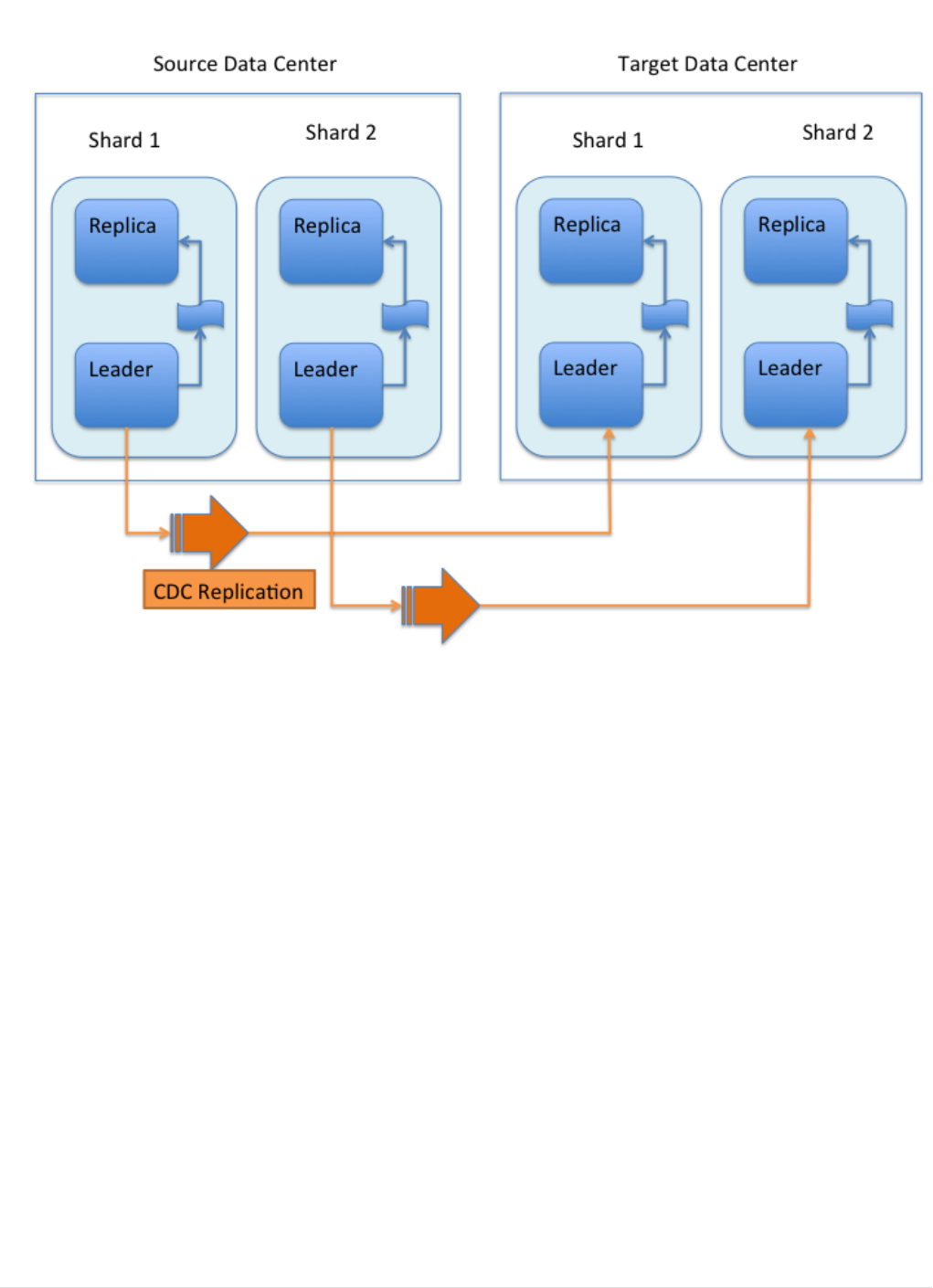
then forwarded to one or more Target data centers, as illustrated in this graphic:
Uni-Directional Data Flow
With uni-directional updates, the Target data center(s) will not propagate updates such as adds, updates, or
deletes to the Source data center and updates should not be sent to any of the Target data center(s).
The data flow sequence is:
1. A shard leader receives a new update that is processed by its update processor chain.
2. The data update is first applied to the local index.
3. Upon successful application of the data update on the local index, the data update is added to CDCR’s
Update Logs queue.
4. After the data update is persisted to disk, the data update is sent to the replicas within the data center.
5. After Step 4 is successful, CDCR reads the data update from the Update Logs and pushes it to the
corresponding collection in the Target data center. This is necessary in order to ensure consistency
between the Source and Target data centers.
6. The leader on the Target data center writes the data locally and forwards it to all its followers.
Steps 1, 2, 3 and 4 are performed synchronously by SolrCloud; Step 5 is performed asynchronously by a
background thread. Given that CDCR replication is performed asynchronously, it becomes possible to push
Page 1112 of 1426 Apache Solr Reference Guide 7.7
Guide Version 7.7 - Published: 2019-03-04 © 2019, Apache Software Foundation

batch updates in order to minimize network communication overhead. Also, if CDCR is unable to push the
update at a given time, for example, due to a degradation in connectivity, it can retry later without any
impact on the Source data center.
One implication of the architecture is that the leaders in the Source cluster must be able to "see" the leaders
in the Target cluster. Since leaders may change in both Source and Target collections, all nodes in the Source
cluster must be able to "see" all Solr nodes in the Target cluster. Firewalls, ACL rules, etc., must be
configured to allow this.
This design works most robustly if both the Source and Target clusters have the same number of shards.
There is no requirement that the shards in the Source and Target collection have the same number of
replicas.
Having different numbers of shards on the Source and Target cluster is possible, but is also an "expert"
configuration as that option imposes certain constraints and is not generally recommended. Most of the
scenarios where having differing numbers of shards are contemplated are better accomplished by hosting
multiple shards on each Solr instance.
Bi-Directional Architecture
When bi-directional updates are configured, either cluster can act as a Source or a Target, and that role can
shift between the clusters, as illustrated in this graphic:
Apache Solr Reference Guide 7.7 Page 1113 of 1426
© 2019, Apache Software Foundation Guide Version 7.7 - Published: 2019-03-04
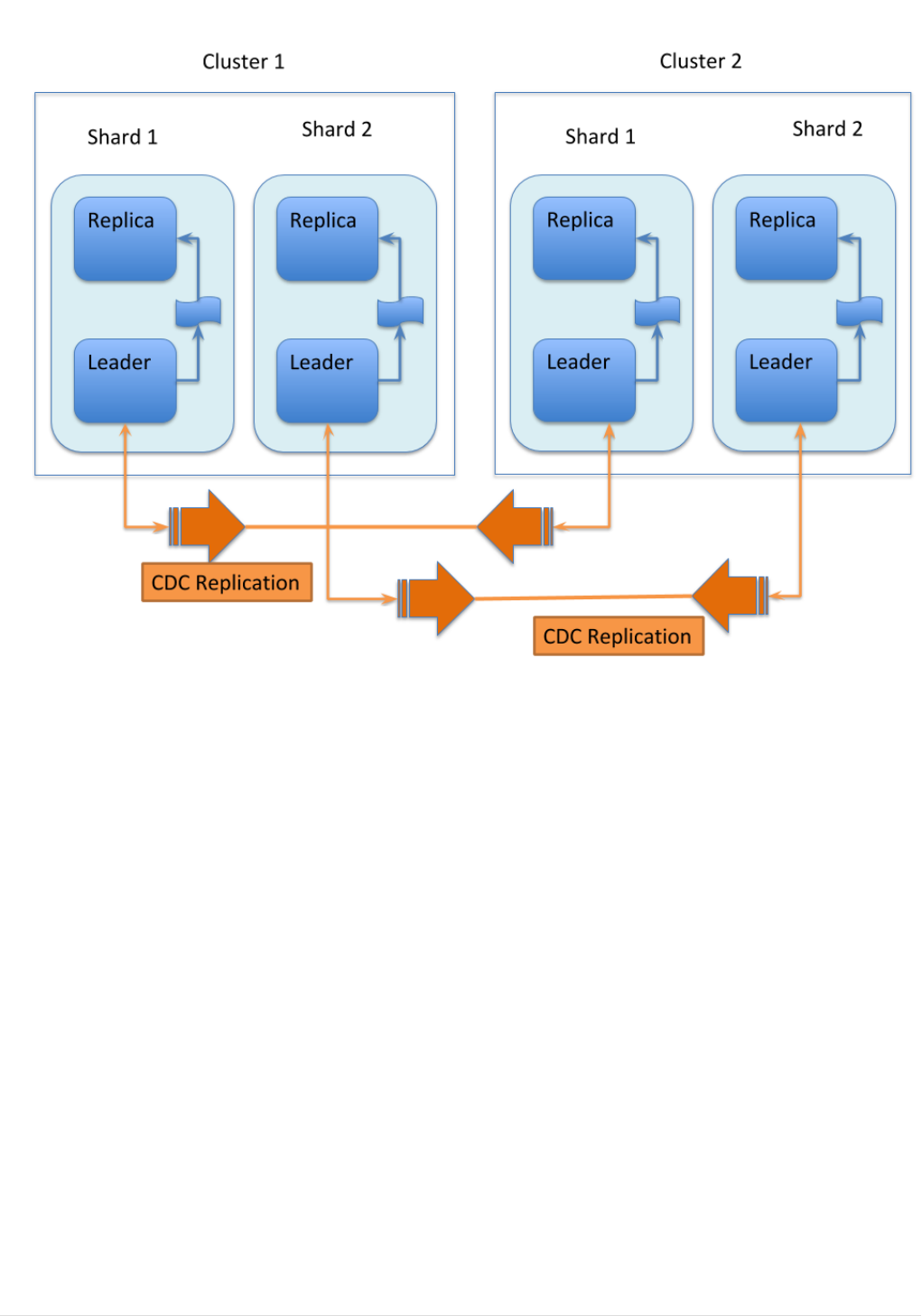
Bi-Directional Data Flow
With bi-directional updates, indexing and querying must be done on a single cluster at a time to maintain
consistency. The second cluster is used when the first cluster is down. Simplifying, one cluster can act as
Source and other as Target but both roles, Source and Target, cannot be assigned to any single cluster at the
same time. Failover is handled smoothly without any configuration changes. Updates sent from Source data
center to Target is not propagated back to Source when bi-directional updates are configured.
The data flow sequence is similar from Step 1 to 6 above, with an additional step:
7. When bi-directional updates are configured, the updates received from Source are flagged on Target and
not forwarded further.
All the behavior(s) and constraint(s) explained in uni-directional data flow are applicable to the respective
Source and Target clusters in this scenario.
Major Components of CDCR
What follows is a discussion of the key features and components in CDCR’s architecture:
CDCR Configuration
In order to configure CDCR, the Source data center requires the host address of the ZooKeeper cluster
Page 1114 of 1426 Apache Solr Reference Guide 7.7
Guide Version 7.7 - Published: 2019-03-04 © 2019, Apache Software Foundation

associated with the Target data center. The ZooKeeper host address is the only information needed by CDCR
to instantiate the communication with the Target Solr cluster. The CDCR configuration section of
solrconfig.xml file on the Source cluster will therefore contain a list of ZooKeeper hosts. The CDCR
configuration section of solrconfig.xml might also contain secondary/optional configuration, such as the
number of CDC Replicator threads, batch updates related settings, etc.
CDCR Initialization
CDCR supports incremental updates to either new or existing collections. CDCR may not be able to keep up
with very high volume updates, especially if there are significant communications latencies due to a slow
"pipe" between the data centers. Some scenarios:
•There is an initial bulk load of a corpus followed by lower volume incremental updates. In this case, one
can do the initial bulk load and then enable CDCR. See the section Initial Startup for more information.
•The index is being built up from scratch, without a significant initial bulk load. CDCR can be set up on
empty collections and keep them synchronized from the start.
•The index is always being updated at a volume too high for CDCR to keep up. This is especially possible in
situations where the connection between the Source and Target data centers is poor. This scenario is
unsuitable for CDCR in its current form.
Inter-Data Center Communication
The CDCR REST API is the primary form of end-user communication for admin commands.
A SolrJ client is used internally for CDCR operations. The SolrJ client gets its configuration information from
the solrconfig.xml file. Users of CDCR will not interact directly with the internal SolrJ implementation and
will interact with CDCR exclusively through the REST API.
Updates Tracking & Pushing
CDCR replicates data updates from the Source to the Target data center by leveraging Update Logs. These
logs will replace SolrCloud’s transaction log.
A background thread regularly checks the Update Logs for new entries, and then forwards them to the
Target data center. The thread therefore needs to keep a checkpoint in the form of a pointer to the last
update successfully processed in the Update Logs. Upon acknowledgement from the Target data center that
updates have been successfully processed, the Update Logs pointer is updated to reflect the current
checkpoint.
This pointer must be synchronized across all the replicas. In the case where the leader goes down and a new
leader is elected, the new leader will be able to resume replication from the last update by using this
synchronized pointer. The strategy to synchronize such a pointer across replicas will be explained next.
If for some reason, the Target data center is offline or fails to process the updates, the thread will
periodically try to contact the Target data center and push the updates while buffering updates on the
Source cluster. One implication of this is that the Source Update Logs directory should be periodically
monitored as the updates will continue to accumulate and will not be purged until the connection to the
Target data center is restored.
Apache Solr Reference Guide 7.7 Page 1115 of 1426
© 2019, Apache Software Foundation Guide Version 7.7 - Published: 2019-03-04

Synchronization of Update Checkpoints
A reliable synchronization of the update checkpoints between the shard leader and shard replicas is critical
to avoid introducing inconsistency between the Source and Target data centers. Another important
requirement is that the synchronization must be performed with minimal network traffic to maximize
scalability.
In order to achieve this, the strategy is to:
•Uniquely identify each update operation. This unique identifier will serve as pointer.
•Rely on two storages: an ephemeral storage on the Source shard leader, and a persistent storage on the
Target cluster.
The shard leader in the Source cluster will be in charge of generating a unique identifier for each update
operation, and will keep a copy of the identifier of the last processed updates in memory. The identifier will
be sent to the Target cluster as part of the update request. On the Target data center side, the shard leader
will receive the update request, store it along with the unique identifier in the Update Logs, and replicate it
to the other shards.
SolrCloud already provides a unique identifier for each update operation, i.e., a “version” number. This
version number is generated using a time-based lmport clock which is incremented for each update
operation sent. This provides a “happened-before” ordering of the update operations that will be leveraged
in (1) the initialization of the update checkpoint on the Source cluster, and in (2) the maintenance strategy of
the Update Logs.
The persistent storage on the Target cluster is used only during the election of a new shard leader on the
Source cluster. If a shard leader goes down on the Source cluster and a new leader is elected, the new leader
will contact the Target cluster to retrieve the last update checkpoint and instantiate its ephemeral pointer.
On such a request, the Target cluster will retrieve the latest identifier received across all the shards, and
send it back to the Source cluster. To retrieve the latest identifier, every shard leader will look up the
identifier of the first entry in its Update Logs and send it back to a coordinator. The coordinator will have to
select the highest among them.
This strategy does not require any additional network traffic and ensures reliable pointer synchronization.
Consistency is principally achieved by leveraging SolrCloud. The update workflow of SolrCloud ensures that
every update is applied to the leader and also to any of the replicas. If the leader goes down, a new leader is
elected. During the leader election, a synchronization is performed between the new leader and the other
replicas. This ensures that the new leader has a consistent Update Logs with the previous leader. Having a
consistent Update Logs means that:
•On the Source cluster, the update checkpoint can be reused by the new leader.
•On the Target cluster, the update checkpoint will be consistent between the previous and new leader.
This ensures the correctness of the update checkpoint sent by a newly elected leader from the Target
cluster.
Maintenance of Update Logs
The CDCR replication logic requires modification to the maintenance logic of Update Logs on the Source
data center. Initially, the Update Logs acts as a fixed size queue, limited to 100 update entries by default. In
CDCR, the Update Logs must act as a queue of variable size as they need to keep track of all the updates up
Page 1116 of 1426 Apache Solr Reference Guide 7.7
Guide Version 7.7 - Published: 2019-03-04 © 2019, Apache Software Foundation

through the last processed update by the Target data center. Entries in the Update Logs are removed only
when all pointers (one pointer per Target data center) are after them.
If the communication with one of the Target data center is slow, the Update Logs on the Source data center
can grow to a substantial size. In such a scenario, it is necessary for the Update Logs to be able to efficiently
find a given update operation given its identifier. Given that its identifier is an incremental number, it is
possible to implement an efficient search strategy. Each transaction log file contains as part of its filename
the version number of the first element. This is used to quickly traverse all the transaction log files and find
the transaction log file containing one specific version number.
Monitoring Operations
CDCR provides the following monitoring capabilities over the replication operations:
•Monitoring of the outgoing and incoming replications, with information such as the Source and Target
nodes, their status, etc.
•Statistics about the replication, with information such as operations (add/delete) per second, number of
documents in the queue, etc.
Information about the lifecycle and statistics will be provided on a per-shard basis by the CDC Replicator
thread. The CDCR API can then aggregate this information an a collection level.
CDC Replicator
The CDC Replicator is a background thread that is responsible for replicating updates from a Source data
center to one or more Target data centers. It is responsible for providing monitoring information on a per-
shard basis. As there can be a large number of collections and shards in a cluster, we will use a fixed-size
pool of CDC Replicator threads that will be shared across shards.
CDCR Limitations
The current design of CDCR has some limitations. CDCR will continue to evolve over time and many of these
limitations will be addressed. Among them are:
•CDCR is unlikely to be satisfactory for bulk-load situations where the update rate is high, especially if the
bandwidth between the Source and Target clusters is restricted. In this scenario, the initial bulk load
should be performed, the Source and Target data centers synchronized and CDCR be utilized for
incremental updates.
•CDCR works most robustly with the same number of shards in the Source and Target collection. The
shards in the two collections may have different numbers of replicas.
•Running CDCR with the indexes on HDFS is not currently supported, see the Solr CDCR over HDFS JIRA
issue.
•Configuration files (solrconfig.xml, managed-schema, etc.) are not automatically synchronized between
the Source and Target clusters. This means that when the Source schema or solrconfig.xml files are
changed, those changes must be replicated manually to the Target cluster. This includes adding fields by
the Schema API or Managed Resources as well as hand editing those files.
Apache Solr Reference Guide 7.7 Page 1117 of 1426
© 2019, Apache Software Foundation Guide Version 7.7 - Published: 2019-03-04

CDCR Configuration
The Source and Target configurations differ in the case of the data centers being in separate clusters.
"Cluster" here means separate ZooKeeper ensembles controlling disjoint Solr instances. Whether these data
centers are physically separated or not is immaterial for this discussion.
As described in the section CDCR Architecture, two approaches are supported: uni-directional updates and
bi-directional updates.
All CDCR configuration is done in the solrconfig.xml file. Because this is a per-collection configuration file,
all CDCR configuration is done for each collection.
Uni-Directional Updates
Source Configuration
Here is a sample of a Source configuration file, a section in solrconfig.xml. The presence of the <replica>
section causes CDCR to use this cluster as the Source and it should not be present in the Target collections.
Details about each setting are after the two examples. The source example has buffering disabled, the
default is enabled:
Page 1118 of 1426 Apache Solr Reference Guide 7.7
Guide Version 7.7 - Published: 2019-03-04 © 2019, Apache Software Foundation

<requestHandler name="/cdcr" class="solr.CdcrRequestHandler">
Ê <lst name="replica">
Ê <str name="zkHost">10.240.18.211:2181,10.240.18.212:2181</str>
Ê <!--
Ê If you have chrooted your Solr information at the target you must include the chroot, for
example:
Ê <str name="zkHost">10.240.18.211:2181,10.240.18.212:2181/solr</str>
Ê -->
Ê <str name="source">collection1</str>
Ê <str name="target">collection1</str>
Ê </lst>
Ê <lst name="replicator">
Ê <str name="threadPoolSize">8</str>
Ê <str name="schedule">1000</str>
Ê <str name="batchSize">128</str>
Ê </lst>
Ê <lst name="updateLogSynchronizer">
Ê <str name="schedule">1000</str>
Ê </lst>
</requestHandler>
<!-- Modify the <updateLog> section of your existing <updateHandler>
Ê in your config as below -->
<updateHandler class="solr.DirectUpdateHandler2">
Ê <updateLog class="solr.CdcrUpdateLog">
Ê <str name="dir">${solr.ulog.dir:}</str>
Ê <!--Any parameters from the original <updateLog> section -->
Ê </updateLog>
Ê <!-- Other configuration options such as autoCommit should still be present -->
</updateHandler>
Target Configuration
Here is a typical Target configuration.
Target instance must configure an update processor chain that is specific to CDCR. The update processor
chain must include the CdcrUpdateProcessorFactory. The task of this processor is to ensure that the
version numbers attached to update requests coming from a CDCR Source SolrCloud are reused and not
overwritten by the Target. A properly configured Target configuration looks similar to this:
Apache Solr Reference Guide 7.7 Page 1119 of 1426
© 2019, Apache Software Foundation Guide Version 7.7 - Published: 2019-03-04

<requestHandler name="/cdcr" class="solr.CdcrRequestHandler">
Ê <!-- recommended for Target clusters -->
Ê <lst name="buffer">
Ê <str name="defaultState">disabled</str>
Ê </lst>
</requestHandler>
<requestHandler name="/update" class="solr.UpdateRequestHandler">
Ê <lst name="defaults">
Ê <str name="update.chain">cdcr-processor-chain</str>
Ê </lst>
</requestHandler>
<updateRequestProcessorChain name="cdcr-processor-chain">
Ê <processor class="solr.CdcrUpdateProcessorFactory"/>
Ê <processor class="solr.RunUpdateProcessorFactory"/>
</updateRequestProcessorChain>
<!-- Modify the <updateLog> section of your existing <updateHandler> in your
Ê config as below -->
<updateHandler class="solr.DirectUpdateHandler2">
Ê <updateLog class="solr.CdcrUpdateLog">
Ê <str name="dir">${solr.ulog.dir:}</str>
Ê <!--Any parameters from the original <updateLog> section -->
Ê </updateLog>
Ê <!-- Other configuration options such as autoCommit should still be present -->
</updateHandler>
Bi-Directional Updates
The configurations in both Cluster 1 and 2 are identical with respective zkHost string specified in each
cluster’s solrconfig.xml.
Both Cluster 1 and Cluster 2 can act as Source and Target at any given point of time but a
cluster cannot be both Source and Target at the same time.
Cluster 1 Configuration
Here is a sample of a Cluster 1 configuration file, a section in solrconfig.xml. Cluster 2 zkhost string is
specified in a CdcrRequestHandler declaration:
Page 1120 of 1426 Apache Solr Reference Guide 7.7
Guide Version 7.7 - Published: 2019-03-04 © 2019, Apache Software Foundation

<requestHandler name="/update" class="solr.UpdateRequestHandler">
Ê <lst name="defaults">
Ê <str name="update.chain">cdcr-processor-chain</str>
Ê </lst>
</requestHandler>
<updateRequestProcessorChain name="cdcr-processor-chain">
Ê <processor class="solr.CdcrUpdateProcessorFactory"/>
Ê <processor class="solr.RunUpdateProcessorFactory"/>
</updateRequestProcessorChain>
<requestHandler name="/cdcr" class="solr.CdcrRequestHandler">
Ê <lst name="replica">
Ê <str name="zkHost">10.240.19.241:2181,10.240.19.242:2181</str>
Ê <!--
Ê If you have chrooted your Solr information at the target you must include the chroot, for
example:
Ê <str name="zkHost">10.240.19.241:2181,10.240.19.242:2181/solr</str>
Ê -->
Ê <str name="source">collection1</str>
Ê <str name="target">collection1</str>
Ê </lst>
Ê <lst name="replicator">
Ê <str name="threadPoolSize">8</str>
Ê <str name="schedule">1000</str>
Ê <str name="batchSize">128</str>
Ê </lst>
Ê <lst name="updateLogSynchronizer">
Ê <str name="schedule">1000</str>
</requestHandler>
<!-- Modify the <updateLog> section of your existing <updateHandler>
Ê in your config as below -->
<updateHandler class="solr.DirectUpdateHandler2">
Ê <updateLog class="solr.CdcrUpdateLog">
Ê <str name="dir">${solr.ulog.dir:}</str>
Ê <!--Any parameters from the original <updateLog> section -->
Ê </updateLog>
</updateHandler>
Cluster 2 Configuration
The configuration of the 2nd cluster is identical to the configuration of Cluster 1, with the Cluster 1 zkHost
string specified in CdcrRequestHandler definition:
Apache Solr Reference Guide 7.7 Page 1121 of 1426
© 2019, Apache Software Foundation Guide Version 7.7 - Published: 2019-03-04

<requestHandler name="/update" class="solr.UpdateRequestHandler">
Ê <lst name="defaults">
Ê <str name="update.chain">cdcr-processor-chain</str>
Ê </lst>
</requestHandler>
<updateRequestProcessorChain name="cdcr-processor-chain">
Ê <processor class="solr.CdcrUpdateProcessorFactory"/>
Ê <processor class="solr.RunUpdateProcessorFactory"/>
</updateRequestProcessorChain>
<requestHandler name="/cdcr" class="solr.CdcrRequestHandler">
Ê <lst name="replica">
Ê <str name="zkHost">10.250.18.211:2181,10.250.18.212:2181</str>
Ê <!--
Ê If you have chrooted your Solr information at the target you must include the chroot, for
example:
Ê <str name="zkHost">10.250.18.211:2181,10.250.18.212:2181/solr</str>
Ê -->
Ê <str name="source">collection1</str>
Ê <str name="target">collection1</str>
Ê </lst>
Ê <lst name="replicator">
Ê <str name="threadPoolSize">8</str>
Ê <str name="schedule">1000</str>
Ê <str name="batchSize">128</str>
Ê </lst>
Ê <lst name="updateLogSynchronizer">
Ê <str name="schedule">1000</str>
Ê </lst>
</requestHandler>
<!-- Modify the <updateLog> section of your existing <updateHandler>
Ê in your config as below -->
<updateHandler class="solr.DirectUpdateHandler2">
Ê <updateLog class="solr.CdcrUpdateLog">
Ê <str name="dir">${solr.ulog.dir:}</str>
Ê <!--Any parameters from the original <updateLog> section -->
Ê </updateLog>
</updateHandler>
CDCR Configuration Parameters
The configuration details, defaults and options are as follows:
The Replica Element
CDCR can be configured to forward update requests to one or more Target collections. A Target collection is
Page 1122 of 1426 Apache Solr Reference Guide 7.7
Guide Version 7.7 - Published: 2019-03-04 © 2019, Apache Software Foundation

defined with a “replica” list as follows:
zkHost
The host address for ZooKeeper of the Target SolrCloud. Usually this is a comma-separated list of
addresses to each node in the Target ZooKeeper ensemble. This parameter is required.
Source
The name of the collection on the Source SolrCloud to be replicated. This parameter is required.
Target
The name of the collection on the Target SolrCloud to which updates will be forwarded. This parameter is
required.
The Replicator Element
The CDC Replicator is the component in charge of forwarding updates to the replicas. The replicator will
monitor the update logs of the Source collection and will forward any new updates to the Target collection.
The replicator uses a fixed thread pool to forward updates to multiple replicas in parallel. If more than one
replica is configured, one thread will forward a batch of updates from one replica at a time in a round-robin
fashion. The replicator can be configured with a “replicator” list as follows:
threadPoolSize
The number of threads to use for forwarding updates. One thread per replica is recommended. The
default is 2.
schedule
The delay in milliseconds for the monitoring the update log(s). The default is 10.
batchSize
The number of updates to send in one batch. The optimal size depends on the size of the documents.
Large batches of large documents can increase your memory usage significantly. The default is 128.
The updateLogSynchronizer Element
Expert: Non-leader nodes need to synchronize their update logs with their leader node from time to time in
order to clean deprecated transaction log files. By default, such a synchronization process is performed
every minute. The schedule of the synchronization can be modified with a “updateLogSynchronizer” list as
follows:
If the updateLogSynchronizer element is omitted from the Source cluster, transaction logs
may accumulate on non-leaders.
schedule
The delay in milliseconds for synchronizing the update logs. The default is 60000.
The Buffer Element
When buffering updates, the update logs will store all the updates indefinitely. It is best to disable buffering
on both the Source and Target clusters during normal operation as when buffering is enabled the Update
Logs will grow without limit. Enbling buffering is intended for special maintenance periods. Buffering can be
disabled at startup with a “buffer” list and the parameter “defaultState” as follows:
Apache Solr Reference Guide 7.7 Page 1123 of 1426
© 2019, Apache Software Foundation Guide Version 7.7 - Published: 2019-03-04

defaultState
The state of the buffer at startup. The default is enabled.
Buffering should be enabled only for maintenance windows
Buffering is designed to augment maintenance windows. The following points should be
kept in mind:
•When buffering is enabled, the Update Logs will grow without limit; they will never be
purged.
•During normal operation, the Update Logs will automatically accrue on the Source data
center if the Target data center is unavailable; It is not necessary to enable buffering for
CDCR to handle routine network disruptions.
◦For this reason, monitoring disk usage on the Source data center is recommended
as an additional check that the Target data center is receiving updates.
•For uni-directional updates, buffering should not be enabled on the Target data center
as Update Logs would accrue without limit.
•If buffering is enabled and then disabled, the Update Logs will be removed when their
contents have been sent to the Target data center. This process may take some time
and is triggered by additional updates the Source cluster.
◦Update Log cleanup is not triggered until a new update is sent to the Source data
center.
Initial Startup
Uni-Directional Approach
This is a general approach for initializing CDCR in a production environment. It’s based upon an approach
taken by the initial working installation of CDCR and generously contributed to illustrate a "real world"
scenario.
•CDCR is used to keep a remote disaster-recovery instance available for production backup.
•This example as 26 clouds with 200 million assets per cloud (15GB indexes). Total document count is over
4.8 billion.
◦Source and Target clouds were synched in 2-3 hour maintenance windows to establish the base index
for the Targets.
As usual, it is good to start small. Sync a single cloud and monitor for a period of time before doing the
others. You may need to adjust your settings several times before finding the right balance.
•Before starting, stop or pause the indexers. This is best done during a small maintenance window.
•Stop the SolrCloud instances at the Source.
•Upload the modified solrconfig.xml to ZooKeeper on both Source and Target as appropriate, see the
examples above.
•Sync the index directories from the Source collection to Target collection across to the corresponding
shard nodes. rsync works well for this.
Page 1124 of 1426 Apache Solr Reference Guide 7.7
Guide Version 7.7 - Published: 2019-03-04 © 2019, Apache Software Foundation

For example, if there are two shards on collection1 with 2 replicas for each shard, copy the
corresponding index directories from:
shard1replica1Source to shard1replica1Target
shard1replica2Source to shard1replica2Target
shard2replica1Source to shard2replica1Target
shard2replica2Source to shard2replica2Target
•Start ZooKeeper on the Target (DR).
•Start SolrCloud on the Target (DR).
•Start ZooKeeper on the Source.
•Start SolrCloud on the Source. As a general rule, the Target (DR) should be started before the Source.
•Activate CDCR on Source instance using the CDCR API:
http://host:port/solr/<collection_name>/cdcr?action=START
There is no need to run the /cdcr?action=START command on the Target.
•Disable the buffer on the Target and Source:
http://host:port/solr/collection_name/cdcr?action=DISABLEBUFFER
•Re-enable indexing.
Bi-Directional Approach
When using the bi-directional approach, it is highly recommended to enable CDCR on both
cluster-collections before any indexing has taken place.
Based on the same example from uni-directional solution, let’s walk through the necessary steps:
•Before you begin, stop or pause any indexing processes. This is best done during a small maintenance
window.
•Stop the SolrCloud instances in both Cluster 1 and Cluster 2.
•Upload the modified solrconfig.xml to ZooKeeper on both Cluster 1 and Cluster 2 as appropriate, see
the examples above in the section Bi-Directional Updates.
•If documents were indexed prior to this exercise, sync the index directories from the Cluster 1 collection
to the Cluster 2 collection to the corresponding shard nodes or vice versa. The rsync utility works well for
this if it’s available on your server. Check to be sure the the updated index is copied across.
For example, if there are 2 shards on collection 'cluster1' (the updated collection) with 2 replicas for each
shard, copy the corresponding index directories from:
shard1replica1cluster1 to shard1replica1cluster2
Apache Solr Reference Guide 7.7 Page 1125 of 1426
© 2019, Apache Software Foundation Guide Version 7.7 - Published: 2019-03-04

shard1replica2cluster1 to shard1replica2cluster2
shard2replica1cluster1 to shard2replica1cluster2
shard2replica2cluster1 to shard2replica2cluster2
•Start ZooKeeper on Cluster 1.
•Start ZooKeeper on Cluster 2.
•Start SolrCloud on Cluster 1.
•Start SolrCloud on Cluster 2.
•If not present, create respective collections in both Cluster 1 and Cluster 2.
•Activate the CDCR on Cluster 1 and Cluster 2 instance using the CDCR API:
http://host:port/solr/<collection_name>/cdcr?action=START
•Disable the buffer on Cluster 1 and Cluster 2:
http://host:port/solr/collection_name/cdcr?action=DISABLEBUFFER
•Re-enable indexing.
ZooKeeper Settings
With CDCR, the Target ZooKeepers will have connections from the Target clouds and the Source clouds. You
may need to increase the maxClientCnxns setting in zoo.cfg.
## set numbers of connection to 800 from client
## is maxClientCnxns=0 that means no limit
maxClientCnxns=800
Cross Data Center Replication Operations
Monitoring
1. Network and disk space monitoring are essential. Ensure that the system has plenty of available storage
to queue up changes if there is a disconnect between the Source and Target. A network outage between
the two data centers can cause your disk usage to grow. Some tips:
a. Set a monitor for your disks to send alerts when the disk gets over a certain percentage (e.g., 70%).
b. Run a test. With moderate indexing, how long can the system queue changes before you run out of
disk space?
2. Create a simple way to check the counts between the Source and the Target.
a. Keep in mind that if indexing is running, the Source and Target may not match document for
document. Set an alert to fire if the difference is greater than some percentage of the overall cloud
Page 1126 of 1426 Apache Solr Reference Guide 7.7
Guide Version 7.7 - Published: 2019-03-04 © 2019, Apache Software Foundation

size.
Upgrading and Patching Production
When rolling in upgrades to your indexer or application, you should shutdown the Source and the Target.
Depending on your setup, you may want to pause/stop indexing, deploy the release or patch, then re-enable
indexing. Then start the Target last.
•There is no need to reissue the DISABLEBUFFERS or START commands. These are persisted.
•After starting the Target, run a simple test. Add a test document to each of the Source clouds. Then
check for it on the Target.
#send to the Source
curl http://<Source>/solr/cloud1/update -H 'Content-type:application/json' -d '[{"SKU":"ABC"}]'
#check the Target
curl "http://<Target>:8983/solr/<collection_name>/select?q=SKU:ABC&indent=true"
CDCR API
The CDCR API is used to control and monitor the replication process. Control actions are performed at a
collection level, i.e., by using the following base URL for API calls:
http://localhost:8983/solr/<collection>/cdcr.
Monitor actions are performed at a core level, i.e., by using the following base URL for API calls:
http://localhost:8983/solr/<core>/cdcr.
Currently, none of the CDCR API calls have parameters.
API Entry Points
Control
•<collection>/cdcr?action=STATUS: Returns the current state of CDCR.
•<collection>/cdcr?action=START: Starts CDCR replication
•<collection>/cdcr?action=STOP: Stops CDCR replication.
•<collection>/cdcr?action=ENABLEBUFFER: Enables the buffering of updates.
•<collection>/cdcr?action=DISABLEBUFFER: Disables the buffering of updates.
Monitoring
•core/cdcr?action=QUEUES: Fetches statistics about the queue for each replica and about the update
logs.
•core/cdcr?action=OPS: Fetches statistics about the replication performance (operations per second) for
each replica.
•core/cdcr?action=ERRORS: Fetches statistics and other information about replication errors for each
replica.
Apache Solr Reference Guide 7.7 Page 1127 of 1426
© 2019, Apache Software Foundation Guide Version 7.7 - Published: 2019-03-04

Control Commands
CDCR STATUS
solr/<collection>/cdcr?action=STATUS
CDCR Status Example
Input
http://localhost:8983/solr/techproducts/cdcr?action=STATUS
Output
{
Ê "responseHeader": {
Ê "status": 0,
Ê "QTime": 0
Ê },
Ê "status": {
Ê "process": "stopped",
Ê "buffer": "enabled"
Ê }
}
ENABLEBUFFER
solr/<collection>/cdcr?action=ENABLEBUFFER
Enable Buffer Example
Input
http://localhost:8983/solr/techproducts/cdcr?action=ENABLEBUFFER
Output
{
Ê "responseHeader": {
Ê "status": 0,
Ê "QTime": 0
Ê },
Ê "status": {
Ê "process": "started",
Ê "buffer": "enabled"
Ê }
}
Page 1128 of 1426 Apache Solr Reference Guide 7.7
Guide Version 7.7 - Published: 2019-03-04 © 2019, Apache Software Foundation

DISABLEBUFFER
solr/<collection>/cdcr?action=DISABLEBUFFER
Disable Buffer Example
Input
http://localhost:8983/solr/techproducts/cdcr?action=DISABLEBUFFER
Output
{
Ê "responseHeader": {
Ê "status": 0,
Ê "QTime": 0
Ê },
Ê "status": {
Ê "process": "started",
Ê "buffer": "disabled"
Ê }
}
CDCR START
solr/<collection>/cdcr?action=START
CDCR Start Examples
Input
http://localhost:8983/solr/techproducts/cdcr?action=START
Output
{
Ê "responseHeader": {
Ê "status": 0,
Ê "QTime": 0
Ê },
Ê "status": {
Ê "process": "started",
Ê "buffer": "enabled"
Ê }
}
CDCR STOP
solr/<collection>/cdcr?action=STOP
Apache Solr Reference Guide 7.7 Page 1129 of 1426
© 2019, Apache Software Foundation Guide Version 7.7 - Published: 2019-03-04

CDCR Stop Examples
Input
http://localhost:8983/solr/techproducts/cdcr?action=STOP
Output
{
Ê "responseHeader": {
Ê "status": 0,
Ê "QTime": 0
Ê },
Ê "status": {
Ê "process": "stopped",
Ê "buffer": "enabled"
Ê }
}
CDCR Monitoring Commands
QUEUES
solr/<core>/cdcr?action=QUEUES
QUEUES Response
The output is composed of a list “queues” which contains a list of (ZooKeeper) Target hosts, themselves
containing a list of Target collections. For each collection, the current size of the queue and the timestamp of
the last update operation successfully processed is provided. The timestamp of the update operation is the
original timestamp, i.e., the time this operation was processed on the Source SolrCloud. This allows an
estimate the latency of the replication process.
The “queues” object also contains information about the update logs, such as the size (in bytes) of the
update logs on disk (tlogTotalSize), the number of transaction log files (tlogTotalCount) and the status of
the update logs synchronizer (updateLogSynchronizer).
QUEUES Examples
Input
http://localhost:8983/solr/<replica_name>/cdcr?action=QUEUES
Output
Page 1130 of 1426 Apache Solr Reference Guide 7.7
Guide Version 7.7 - Published: 2019-03-04 © 2019, Apache Software Foundation

{
Ê "responseHeader":{
Ê "status": 0,
Ê "QTime": 1
Ê },
Ê "queues":{
Ê "127.0.0.1: 40342/solr":{
Ê "Target_collection":{
Ê "queueSize": 104,
Ê "lastTimestamp": "2014-12-02T10:32:15.879Z"
Ê }
Ê }
Ê },
Ê "tlogTotalSize":3817,
Ê "tlogTotalCount":1,
Ê "updateLogSynchronizer": "stopped"
}
OPS
solr/<core>/cdcr?action=OPS
OPS Response
Provides the average number of operations as a sum and broken down by adds/deletes.
OPS Examples
Input
http://localhost:8983/solr/<replica_name>/cdcr?action=OPS
Output
{
Ê "responseHeader":{
Ê "status":0,
Ê "QTime":1
Ê },
Ê "operationsPerSecond":{
Ê "127.0.0.1: 59661/solr":{
Ê "Target_collection":{
Ê "all": 297.102944952749052,
Ê "adds": 297.102944952749052,
Ê "deletes": 0.0
Ê }
Ê }
Ê }
}
Apache Solr Reference Guide 7.7 Page 1131 of 1426
© 2019, Apache Software Foundation Guide Version 7.7 - Published: 2019-03-04

ERRORS
solr/<core>/cdcr?action=ERRORS
ERRORS Response
Provides the number of consecutive errors encountered by the replicator thread, the number of bad
requests or internal errors since the start of the replication process, and a list of the last errors encountered
ordered by timestamp.
ERRORS Examples
Input
http://localhost:8983/solr/<replica_name>/cdcr?action=ERRORS
Output
{
Ê "responseHeader":{
Ê "status":0,
Ê "QTime":2
Ê },
Ê "errors": {
Ê "127.0.0.1: 36872/solr":{
Ê "Target_collection":{
Ê "consecutiveErrors":3,
Ê "bad_request":0,
Ê "internal":3,
Ê "last":{
Ê "2014-12-02T11:04:42.523Z":"internal",
Ê "2014-12-02T11:04:39.223Z":"internal",
Ê "2014-12-02T11:04:38.22Z":"internal"
Ê }
Ê }
Ê }
Ê }
}
Page 1132 of 1426 Apache Solr Reference Guide 7.7
Guide Version 7.7 - Published: 2019-03-04 © 2019, Apache Software Foundation

SolrCloud Autoscaling
The goal of autoscaling is to make SolrCloud cluster management easier by
providing a way for changes to the cluster to be more automatic and more
intelligent.
Autoscaling includes an API to manage cluster-wide and collection-specific policies and preferences and a
rules syntax to define the guidelines for your cluster. Also included are features to utilize the policies and
preferences so they perform actions automatically when certain conditions are met.
The following sections describe the autoscaling features of SolrCloud:
•Overview of Autoscaling in SolrCloud
•Autoscaling Policy and Preferences
•Autoscaling Triggers
•Autoscaling Trigger Actions
•Autoscaling Listeners
•Automatically Adding Replicas
•Autoscaling Fault Tolerance
•Autoscaling API
•Migrating Rule-Based Replica Rules to Autoscaling Policies
Overview of SolrCloud Autoscaling
Autoscaling in Solr aims to provide good defaults so a SolrCloud cluster remains balanced and stable in the
face of various cluster change events. This balance is achieved by satisfying a set of rules and sorting
preferences to select the target of cluster management operations automatically on cluster events.
A simple example is automatically adding a replica for a SolrCloud collection when a node containing an
existing replica goes down.
The goal of autoscaling in SolrCloud is to make cluster management easier, more automatic, and more
intelligent. It aims to provide good defaults such that the cluster remains balanced and stable in the face of
various events such as a node joining the cluster or leaving the cluster. This is achieved by satisfying a set of
rules and sorting preferences that help Solr select the target of cluster management operations.
There are three distinct problems that this feature solves:
•When to run cluster management tasks? For example, we might want to add a replica when an existing
replica is no longer alive.
•Which cluster management task to run? For example, do we add a new replica or should we move an
existing one to a new node?
•How do we run the cluster management tasks so the cluster remains balanced and stable?
Before we get into the details of how each of these problems are solved, let’s take a quick look at the easiest
Apache Solr Reference Guide 7.7 Page 1133 of 1426
© 2019, Apache Software Foundation Guide Version 7.7 - Published: 2019-03-04

way to setup autoscaling for your cluster.
Quick Start: Automatically Adding Replicas
Say that we want to create a collection which always requires us to have three replicas available for each
shard all the time. We can set the replicationFactor=3 while creating the collection, but what happens if a
node containing one or more of the replicas either crashed or was shutdown for maintenance? In such a
case, we’d like to create additional replicas to replace the ones that are no longer available to preserve the
original number of replicas.
We have an easy way to enable this behavior without needing to understand the autoscaling features in
depth. We can create a collection with such behavior by adding an additional parameter
autoAddReplicas=true with the CREATE command of the Collection API. For example:
/admin/collections?action=CREATE&name=_name_of_collection_&numShards=1&replicationFactor=3&autoAd
dReplicas=true
A collection created with autoAddReplicas=true will be monitored by Solr such that if a node containing a
replica of this collection goes down, Solr will add new replicas on other nodes after waiting for up to thirty
seconds for the node to come back.
You can see the section Autoscaling Automatically Adding Replicas to learn more about how to enable or
disable this feature as well as other details.
The selection of the node that will host the new replica is made according to the default cluster preferences
that we will learn more about in the next sections.
Cluster Preferences
Cluster preferences allow you to tell Solr how to assess system load on each node. This information is used
to guide selection of the node(s) on which cluster management operations will be performed.
In general, when an operation increases replica counts, the least loaded qualified node will be chosen, and
when the operation reduces replica counts, the most loaded qualified node will be chosen.
The default cluster preferences are [{minimize:cores},{maximize:freedisk}], which tells Solr to minimize
the number of cores on all nodes and if number of cores are equal, maximize the free disk space available.
In this case, the least loaded node is the one with the fewest cores or if two nodes have an equal number of
cores, the node with the most free disk space.
You can learn more about preferences in the section on Cluster Preferences Specification.
Cluster Policy
A cluster policy is a set of rules that a node, shard, or collection must satisfy before it can be chosen as the
target of a cluster management operation. These rules are applied across the cluster regardless of the
collection being managed. For example, the rule {"cores":"<10", "node":"#ANY"} means that any node
must have less than 10 Solr cores in total, regardless of which collection they belong to.
There are many metrics on which the rule can be based, e.g., system load average, heap usage, free disk
Page 1134 of 1426 Apache Solr Reference Guide 7.7
Guide Version 7.7 - Published: 2019-03-04 © 2019, Apache Software Foundation

space, etc. The full list of supported metrics can be found in the section describing Autoscaling Policy Rule
Attributes.
When a node, shard, or collection does not satisfy a policy rule, we call it a violation. By default, cluster
management operations will fail if there is even one violation. You can allow operations to succeed in the
face of a violation by marking the corresponding rule with "strict":false. When you do this, Solr ensures
that cluster management operations minimize the number of violations.
Solr also supports collection-specific policies, which operate in tandem with the cluster policy.
Triggers
Now that we have an idea about how cluster management operations use policies and preferences help Solr
keep the cluster balanced and stable, we can talk about when to invoke such operations.
Triggers are used to watch for events such as a node joining or leaving the cluster. When the event happens,
the trigger executes a set of actions that compute and execute a plan, i.e., a set of operations to change the
cluster so that the policy and preferences are respected.
The autoAddReplicas parameter passed with the CREATE Collection API command in the Quick Start section
above automatically creates a trigger that watches for a node going away. When the trigger fires, it executes
a set of actions that compute and execute a plan to move all replicas hosted by the lost node to new nodes
in the cluster. The target nodes are chosen based on the policy and preferences.
You can learn more about Triggers in the section Autoscaling Triggers.
Trigger Actions
A trigger executes actions that tell Solr what to do in response to the trigger. Solr ships with two actions
that are added to every trigger by default. The first is called the ComputePlanAction and the other is
ExecutePlanAction. The former computes the cluster management operations necessary to stabilize the
cluster and the latter executes them on the cluster.
You can learn more about Trigger Actions in the section Autoscaling Trigger Actions.
Listeners
An Autoscaling listener can be attached to a trigger. Solr calls the listener each time the trigger fires as well
as before and after the actions performed by the trigger. Listeners are useful as a call back mechanism to
perform tasks such as logging or informing external systems about events. For example, a listener is
automatically added by Solr to each trigger to log details of the trigger fire and actions to the .system
collection.
You can learn more about Listeners in the section Autoscaling Listeners.
Autoscaling APIs
The autoscaling APIs available at /admin/autoscaling can be used to read and modify each of the
components discussed above.
You can learn more about these APIs in the section Autoscaling API.
Apache Solr Reference Guide 7.7 Page 1135 of 1426
© 2019, Apache Software Foundation Guide Version 7.7 - Published: 2019-03-04

Autoscaling Policy and Preferences
The autoscaling policy and preferences are a set of rules and sorting preferences that help Solr select the
target of cluster management operations so the overall load on the cluster remains balanced.
The configured autoscaling policy and preferences are used by Collections API commands in all contexts:
manual, for example using bin/solr to create a collection; semi-automatic, via the Suggestions API or the
Admin UI’s Suggestions Screen; or fully automatic, via configured Triggers.
See the section Example: Manual Collection Creation with a Policy for an example of how policy and
preferences affect replica placement.
Cluster Preferences Specification
A preference is a hint to Solr on how to sort nodes based on their utilization.
The default cluster preference is to sort by the total number of Solr cores (or replicas) hosted by a node, with
a precision of 1. Therefore, by default, when selecting a node to which to add a replica, Solr can apply the
preferences and choose the node with the fewest cores. In the case of a tie in the number of cores, available
freedisk will be used to further sort nodes.
More than one preference can be added to break ties. For example, we may choose to use free disk space to
break ties if the number of cores on two nodes is the same. The node with the higher free disk space can be
chosen as the target of the cluster operation.
Each preference takes the following form:
{"<sort_order>":"<sort_param>", "precision":"<precision_val>"}
sort_order
The value can be either maximize or minimize. Choose minimize to sort the nodes with least value as the
least loaded. For example, {"minimize":"cores"} sorts the nodes with the least number of cores as the
least loaded node. A sort order such as {"maximize":"freedisk"} sorts the nodes with maximum free
disk space as the least loaded node.
The objective of the system is to make every node the least loaded. So, in case of a MOVEREPLICA
operation, it usually targets the most loaded node and takes load off of it. In a sort of more loaded to less
loaded, minimize is akin to sorting in descending order and maximize is akin to sorting in ascending
order.
This is a required parameter.
sort_param
One and only one of the following supported parameters must be specified:
1. cores: The number of total Solr cores on a node.
2. freedisk: The amount of free disk space for Solr’s data home directory. This is always in gigabytes.
3. sysLoadAvg: The system load average on a node as reported by the Metrics API under the key
solr.jvm/os.systemLoadAverage. This is always a double value between 0 and 1 and the higher the
Page 1136 of 1426 Apache Solr Reference Guide 7.7
Guide Version 7.7 - Published: 2019-03-04 © 2019, Apache Software Foundation

value, the more loaded the node is.
4. heapUsage: The heap usage of a node as reported by the Metrics API under the key
solr.jvm/memory.heap.usage. This is always a double value between 0 and 1 and the higher the
value, the more loaded the node is.
precision
Precision tells the system the minimum (absolute) difference between 2 values to treat them as distinct
values.
For example, a precision of 10 for freedisk means that two nodes whose free disk space is within 10GB
of each other should be treated as equal for the purpose of sorting. This helps create ties without which
specifying multiple preferences is not useful. This is an optional parameter whose value must be a
positive integer. The maximum value of precision must be less than the maximum value of the
sort_value, if any.
See the section Create and Modify Cluster Preferences for details on how to manage cluster preferences
with the API.
Examples of Cluster Preferences
Default Preferences
The following shows the default cluster preferences. This is applied automatically by Solr when no explicit
cluster preferences have been set using the Autoscaling API.
[
Ê {"minimize":"cores"}
]
Minimize Cores; Maximize Free Disk
In this example, we want to minimize the number of Solr cores and in case of a tie, maximize the amount of
free disk space on each node.
[
Ê {"minimize" : "cores"},
Ê {"maximize" : "freedisk"}
]
Add Precision to Free Disk; Minimize System Load
In this example, we add a precision to the freedisk parameter so that nodes with free disk space within
10GB of each other are considered equal. In such a case, the tie is broken by minimizing sysLoadAvg.
Apache Solr Reference Guide 7.7 Page 1137 of 1426
© 2019, Apache Software Foundation Guide Version 7.7 - Published: 2019-03-04

[
Ê {"minimize" : "cores"},
Ê {"maximize" : "freedisk", "precision" : 10},
Ê {"minimize" : "sysLoadAvg"}
]
Policy Specification
A policy is a hard rule to be satisfied by each node. If a node does not satisfy the rule then it is called a
violation. Solr ensures that the number of violations are minimized while invoking any cluster management
operations.
Policy Rule Structure
Rule Types
Policy rules can be either global or per-collection:
•Global rules constrain the number of cores per node or node group. This type of rule applies to cores
from all collections hosted on the specified node(s). As a result, collection-specific policies, which are
associated with individual collections, may not contain global rules.
•Per-collection rules constrain the number of replicas per node or node group.
Global rules have three parts:
•Node Selector
•Core Count Constraint ("cores": "…")
•Rule Strictness (optional)
Per-collection rules have four parts:
•Node Selector
•Replica Selector and Rule Evaluation Context
•Replica Count Constraint ("replica": "…")
•Rule Strictness (optional)
Node Selector
Rule evaluation is restricted to node(s) matching the value of one of the following attributes: node, port,
ip_*, sysprop.*, or diskType. For replica/core count constraints other than #EQUAL, a condition specified in
one of the following attributes may instead be used to select nodes: freedisk, host, sysLoadAvg, heapUsage,
nodeRole, or metrics.*.
Except for node, the attributes above cause selected nodes to be partitioned into node groups. A node group
is referred to as a "bucket". Those attributes usable with the #EQUAL directive may define buckets either via
the special function #EACH or an array ["value1", …] (a subset of all possible values); in both cases, each
node is placed in the bucket corresponding to the matching attribute value.
The node attribute always places each selected node into its own bucket, regardless of the attribute value’s
Page 1138 of 1426 Apache Solr Reference Guide 7.7
Guide Version 7.7 - Published: 2019-03-04 © 2019, Apache Software Foundation

form (#ANY, node-name, or ["node1-name", …]).
Replica and core count constraints, described below, are evaluated against the total number in each bucket.
Core Count Constraint
The cores attribute value can be specified in one of the following forms:
•#EQUAL: distribute all cores equally across all the selected nodes.
•a constraint on the core count on each selected node; see Specifying Replica and Core Count Constraints.
Replica Selector and Rule Evaluation Context
Rule evaluation can be restricted to replicas that meet any combination of conditions specified with the
following attributes:
•collection: The replica is of a shard belonging to the collection specified in the attribute value. (Not
usable with collection-specific policies.)
•shard: The replica is of the shard named in the attribute value.
•type: The replica has the specified replica type (NRT, TLOG, or PULL).
If none of the above attributes is specified, then the rule is evaluated separately for each collection against
all types of replicas of all shards.
Specifying #EACH as the shard attribute value causes the rule to be evaluated separately for each shard of
each collection.
Replica Count Constraint
The replica attribute value can be specified in one of the following forms:
•#ALL: All selected replicas will be placed on the selected nodes.
•#EQUAL: Distribute selected replicas equally across all the selected nodes.
•a constraint on the replica count on each selected node; see Specifying Replica and Core Count
Constraints.
Specifying Replica and Core Count Constraints
Replica count constraints ("replica":"…") and core count constraints ("cores":"…") allow specification of
acceptable counts for replicas (cores tied to a collection) and cores (regardless of the collection to which
they belong), respectively.
You can specify one of the following as the value of a replica and cores policy rule attribute:
•an exact integer (e.g., 2)
•an exclusive lower integer bound (e.g., >0)
•an exclusive upper integer bound (e.g., <3)
•a decimal value, interpreted as an acceptable range of core counts, from the floor of the value to the
ceiling of the value, with the system preferring the rounded value (e.g., 1.6: 1 or 2 is acceptable, and 2 is
preferred)
Apache Solr Reference Guide 7.7 Page 1139 of 1426
© 2019, Apache Software Foundation Guide Version 7.7 - Published: 2019-03-04

•a range of acceptable replica/core counts, as inclusive lower and upper integer bounds separated by a
hyphen (e.g., 3-5)
•a percentage (e.g., 33%), which is multiplied at runtime either by the number of selected replicas (for a
replica constraint) or the number of cores in the cluster (for a cores constraint). This value is then
interpreted as described above for a literal decimal value.
Using an exact integer value for count constraints is of limited utility, since collection or
cluster changes could quickly invalidate them. For example, attempting to add a third
replica to each shard of a collection on a two-node cluster with policy rule {"replica":1,
"shard":"#EACH", "node":"#ANY"} would cause a violation, since at least one node would
have to host more than one replica. Percentage rules are less brittle. Rewriting the rule as
{"replica":"50%", "shard":"#EACH", "node":"#ANY"} eliminates the violation: 50% of
3 replicas = 1.5 replicas per node, meaning that it’s acceptable for a node to host
either one or two replicas of each shard.
Policy Rule Attributes
Rule Strictness
This attribute is usable in all rules:
strict
An optional boolean value. The default is true. If true, the rule must be satisfied; if the rule is not
satisfied, the resulting violation will cause the cluster management operation to fail. If false, Solr tries to
satisfy the rule on a best effort basis, but if no node can satisfy the rule, the cluster management
operation will not fail, and any node may be chosen. If multiple rules declared to be strict:false can
not be satisfied by some nodes, then a node will be chosen such that the number of such violations is
minimized.
Global Rule Attributes
cores
The number of cores that must exist to satisfy the rule. This is a required attribute for global policy rules.
The node attribute must also be specified, and the only other allowed attribute is the optional strict
attribute. See Core Count Constraint for possible attribute values.
Per-collection Rule Attributes
The following attributes are usable with per-collection policy rules, in addition to the attributes in the Node
Selection Attributes section below:
collection
The name of the collection to which the policy rule should apply. If omitted, the rule applies to all
collections. This attribute is optional.
shard
The name of the shard to which the policy rule should apply. If omitted, the rule is applied for all shards in
the collection. It supports the special function #EACH which means that the rule is applied for each shard
in the collection.
Page 1140 of 1426 Apache Solr Reference Guide 7.7
Guide Version 7.7 - Published: 2019-03-04 © 2019, Apache Software Foundation

type
The type of the replica to which the policy rule should apply. If omitted, the rule is applied for all replica
types of this collection/shard. The allowed values are NRT, TLOG and PULL
replica
The number of replicas that must exist to satisfy the rule. This is a required attribute for per-collection
rules. See Replica Count Constraint for possible attribute values.
Node Selection Attributes
One and only one of the following attributes can be specified in addition to the above attributes. See the
Node Selector section for more information:
node
The name of the node to which the rule should apply. The ! (not) operator or the array operator or the
#ANY function may be used in this attribute’s value.
port
The port of the node to which the rule should apply. The ! (not) operator or the array operator may be
used in this attribute’s value.
freedisk
The free disk space in gigabytes of the node. This must be a positive 64-bit integer value, or a percentage.
If a percentage is specified, either an upper or lower bound may also be specified using the < or >
operators, respectively, e.g., >50%, <25%.
host
The host name of the node.
sysLoadAvg
The system load average of the node as reported by the Metrics API under the key
solr.jvm/os.systemLoadAverage. This is floating point value between 0 and 1.
heapUsage
The heap usage of the node as reported by the Metrics API under the key solr.jvm/memory.heap.usage.
This is floating point value between 0 and 1.
nodeRole
The role of the node. The only supported value currently is overseer.
ip_1, ip_2, ip_3, ip_4
The least significant to most significant segments of IP address. For example, for an IP address
192.168.1.2, "ip_1":"2", "ip_2":"1", "ip_3":"168", "ip_4":"192". The array operator may be
used in any of these attributes' values.
sysprop.<system_property_name>
Any arbitrary system property set on the node on startup. The ! (not) operator or the array operator may
be used in this attribute’s value.
metrics:<full-path-to-the metric>
Any arbitrary metric. For example, metrics:solr.node:CONTAINER.fs.totalSpace. Refer to the key
Apache Solr Reference Guide 7.7 Page 1141 of 1426
© 2019, Apache Software Foundation Guide Version 7.7 - Published: 2019-03-04

parameter in the Metrics API section.
diskType
The type of disk drive being used for Solr’s coreRootDirectory. The only two supported values are
rotational and ssd. Refer to coreRootDirectory parameter in the Solr.xml Parameters section. The !
(not) operator or the array operator may be used in this attribute’s value.
Its value is fetched from the Metrics API with the key named solr.node:CONTAINER.fs.coreRoot.spins.
The disk type is auto-detected by Lucene using various heuristics and it is not guaranteed to be correct
across all platforms or operating systems. Refer to the Dynamic defaults for ConcurrentMergeScheduler
section for more details.
Policy Operators
Each attribute in the policy may specify one of the following operators along with the value.
•No operator means equality
•<: Less than
•>: Greater than
•!: Not
•Range operator (-): a value such as "3-5" means a value between 3 to 5 (inclusive). This is only
supported in the replica and cores attributes.
•Array operator []: e.g., sysprop.zone= ["east","west","apac"]. This is equivalent to having multiple
rules with each of these values. This can be used in the following attributes:
◦node
◦sysprop.*
◦port
◦ip_*
◦diskType
Special Functions
This supports values calculated at the time of execution.
•% : A certain percentage of the value. This is supported by the following attributes:
◦replica
◦cores
◦freedisk
•#ANY: Applies to the node attribute only. This means the rule applies to any node.
•#ALL: Applies to the replica attribute only. This means all replicas that meet the rule condition.
•#EACH: Applies to the shard attribute (meaning the rule should be evaluated separately for each shard),
and to the attributes used to define the buckets for the #EQUAL function (meaning all possible values for
the bucket-defining attribute).
•#EQUAL: Applies to the replica and cores attributes only. This means an equal number of replicas/cores
in each bucket. The buckets can be defined using the below attributes with a value that can either be
Page 1142 of 1426 Apache Solr Reference Guide 7.7
Guide Version 7.7 - Published: 2019-03-04 © 2019, Apache Software Foundation

#EACH or a list specified with the array operator ([]):
◦node <- global rules, i.e., those with the cores attribute, may only specify this attribute
◦sysprop.*
◦port
◦diskType
◦ip_*
Examples of Policy Rules
Limit Replica Placement
Do not place more than one replica of the same shard on the same node. The rule is evaluated separately
for each shard in each collection. The rule is applied to any node.
{"replica": "<2", "shard": "#EACH", "node": "#ANY"}
Limit Cores per Node
Do not place more than 10 cores in any node. This rule can only be added to the cluster policy because it is a
global rule.
{"cores": "<10", "node": "#ANY"}
Place Replicas Based on Port
Place exactly 1 replica of each shard of collection xyz on a node running on port 8983.
{"replica": 1, "shard": "#EACH", "collection": "xyz", "port": "8983"}
Place Replicas Based on a System Property
Place all replicas on nodes with system property availability_zone=us-east-1a.
{"replica": "#ALL", "sysprop.availability_zone": "us-east-1a"}
Use Percentage
Place a maximum of (roughly) a third of the replicas of each shard in any node. In the following example, the
value of replica is computed in real time as a percentage of the replicas of each shard of each collection:
{"replica": "33%", "shard": "#EACH", "node": "#ANY"}
If the number of replicas in a shard is 2, 33% of 2 = 0.66. This means a node may have a maximum of 1
and a minimum of 0 replicas of each shard.
It is possible to get the same effect by hard coding the value of replica as a decimal value:
Apache Solr Reference Guide 7.7 Page 1143 of 1426
© 2019, Apache Software Foundation Guide Version 7.7 - Published: 2019-03-04

{"replica": 0.66, "shard": "#EACH", "node": "#ANY"}
or using the range operator:
{"replica": "0-1", "shard": "#EACH", "node": "#ANY"}
Multiple Percentage Rules
Distribute replicas of each shard of each collection across datacenters east and west at a 1:2 ratio:
{"replica": "33%", "shard": "#EACH", "sysprop.zone": "east"}
{"replica": "66%", "shard": "#EACH", "sysprop.zone": "west"}
For the above rules to work, all nodes must the started with a system property called "zone"
Distribute Replicas Equally in Each Zone
For each shard of each collection, distribute replicas equally across the east and west zones.
{"replica": "#EQUAL", "shard": "#EACH", "sysprop.zone": ["east", "west"]}
Distribute replicas equally across each zone.
{"replica": "#EQUAL", "shard": "#EACH", "sysprop.zone": "#EACH"}
Place Replicas Based on Node Role
Do not place any replica on any node that has the overseer role. Note that the role is added by the addRole
collection API. It is not automatically the node which is currently the overseer.
{"replica": 0, "nodeRole": "overseer"}
Place Replicas Based on Free Disk
Place all replicas in nodes where freedisk is greater than 500GB.
{"replica": "#ALL", "freedisk": ">500"}
Keep all replicas in nodes where freedisk percentage is greater than 50%.
{"replica": "#ALL", "freedisk": ">50%"}
Page 1144 of 1426 Apache Solr Reference Guide 7.7
Guide Version 7.7 - Published: 2019-03-04 © 2019, Apache Software Foundation

Try to Place Replicas Based on Free Disk
When possible, place all replicas in nodes where freedisk is greater than 500GB. Here we use the strict
attribute to signal that this rule is to be honored on a best effort basis.
{"replica": "#ALL", "freedisk": ">500", "strict": false}
Place All Replicas of Type TLOG on Nodes with SSD Drives
{"replica": "#ALL", "type": "TLOG", "diskType": "ssd"}
Place All Replicas of Type PULL on Nodes with Rotational Disk Drives
{"replica": "#ALL", "type": "PULL", "diskType": "rotational"}
Defining Collection-Specific Policies
By default, the cluster policy, if it exists, is used automatically for all collections in the cluster. However, we
can create named policies that can be attached to a collection at the time of its creation by specifying the
policy name along with a policy parameter.
When a collection-specific policy is used, the rules in that policy are appended to the rules in the cluster
policy and the combination of both are used. Therefore, it is recommended that you do not add rules to
collection-specific policy that conflict with the ones in the cluster policy. Doing so will disqualify all nodes in
the cluster from matching all criteria and make the policy useless.
It is possible to override rules specified in the cluster policy using collection-specific policy. For example, if a
rule {replica:'<3', node:'#ANY'} is present in the cluster policy and the collection-specific policy has a
rule {replica:'<4', node:'#ANY'}, the cluster policy is ignored in favor of the collection policy.
Also, if maxShardsPerNode is specified during the time of collection creation, then both maxShardsPerNode
and the policy rules must be satisfied.
Some attributes such as cores can only be used in the cluster policy. See the section Policy Rule Attributes
for details.
To create a new named policy, use the set-policy API. Once you have a named policy, you can specify the
policy=<policy_name> parameter to the CREATE command of the Collection API:
/admin/collections?action=CREATE&name=coll1&numShards=1&replicationFactor=2&policy=policy1
The above CREATE collection command will associate a policy named policy1 with the collection named
coll1. Only a single policy may be associated with a collection.
Example: Manual Collection Creation with a Policy
The starting state for this example is a Solr cluster with 3 nodes: "nodeA", "nodeB", and "nodeC". An
Apache Solr Reference Guide 7.7 Page 1145 of 1426
© 2019, Apache Software Foundation Guide Version 7.7 - Published: 2019-03-04

existing 2-shard FirstCollection with a replicationFactor of 1 has one replica on "nodeB" and one on
"nodeC". The default Autoscaling preferences are in effect:
[ {"minimize": "cores"} ]
The configured policy rule allows at most 1 core per node:
[ {"cores": "<2", "node": "#ANY"} ]
We now issue a CREATE command for a SecondCollection with two shards and a replicationFactor of 1:
http://localhost:8983/solr/admin/collections?action=CREATE&name=SecondCollection&numShards=2&repl
icationFactor=1
For each of the two replicas to be created, each Solr node is tested, in order from least to most loaded:
would all policy rules be satisfied if a replica were placed there using an ADDREPLICA sub-command?
•ADDREPLICA for shard1: According to the Autoscaling preferences, the least loaded node is the one with
the fewest cores: "nodeA", because it hosts no cores, while the other two nodes each host one core. The
test to place a replica here succeeds, because doing so causes no policy violations, since the core count
after adding the replica would not exceed the configured maximum of 1. Because "nodeA" can host the
first shard’s replica, Solr skips testing of the other two nodes.
•ADDREPLICA for shard2: After placing the shard1 replica, all nodes would be equally loaded, since each
would have one core. The test to place the shard2 replica fails on each node, because placement would
push the node over its maximum core count. This causes a policy violation.
Since there is no node that can host a replica for shard2 without causing a violation, the overall CREATE
command fails. Let’s try again after increasing the maximum core count on all nodes to 2:
[ {"cores": "<3", "node": "#ANY"} ]
After re-issuing the SecondCollection CREATE command, the replica for shard1 will be placed on "nodeA":
it’s least loaded, so is tested first, and no policy violation will result from placement there. The shard2 replica
could be placed on any of the 3 nodes, since they’re all equally loaded, and the chosen node will remain
below its maximum core count after placement. The CREATE command succeeds.
SolrCloud Autoscaling Triggers
Triggers are used in autoscaling to watch for cluster events such as nodes joining or leaving, search rate,
index rate, on a schedule, or any other metric breaching a threshold.
Trigger implementations verify the state of resources that they monitor. When they detect a change that
merits attention they generate events, which are then queued and processed by configured TriggerAction
implementations. This usually involves computing and executing a plan to do something (e.g., move
replicas). Solr provides predefined implementations of triggers for specific event types.
Page 1146 of 1426 Apache Solr Reference Guide 7.7
Guide Version 7.7 - Published: 2019-03-04 © 2019, Apache Software Foundation

Triggers execute on the node that runs Overseer. They are scheduled to run periodically, at a default
interval of 1 second between each execution (although it’s important to note that not every execution of a
trigger produces events).
Event Types
Currently the following event types (and corresponding trigger implementations) are defined:
•nodeAdded: generated when a node joins the cluster. See Node Added Trigger.
•nodeLost: generated when a node leaves the cluster. See Node Lost Trigger and Auto Add Replicas
Trigger.
•metric: generated when the configured metric crosses a configured lower or upper threshold value. See
Metric Trigger.
•indexSize: generated when a shard size (defined as index size in bytes or number of documents)
exceeds upper or lower threshold values. See Index Size Trigger.
•searchRate: generated when the search rate exceeds configured upper or lower thresholds. See Search
Rate Trigger.
•scheduled: generated according to a scheduled time period such as every 24 hours, etc. See Scheduled
Trigger.
Events are not necessarily generated immediately after the corresponding state change occurred; the
maximum rate of events is controlled by the waitFor configuration parameter (see Trigger Configuration
below for more explanation).
The following properties are common to all event types:
id
(string) A unique time-based event id.
eventType
(string) The type of event.
source
(string) The name of the trigger that produced this event.
eventTime
(long) Unix time when the condition that caused this event occurred. For example, for a nodeAdded event
this will be the time when the node was added and not when the event was actually generated, which
may significantly differ due to the rate limits set by waitFor.
properties
(map, optional) Any additional properties. Currently includes e.g., nodeNames property that indicates the
nodes that were lost or added.
Trigger Configuration
Trigger configurations are managed using the Autoscaling Write API with the commands set-trigger,
remove-trigger, suspend-trigger, and resume-trigger.
Apache Solr Reference Guide 7.7 Page 1147 of 1426
© 2019, Apache Software Foundation Guide Version 7.7 - Published: 2019-03-04

Trigger Properties
Trigger configuration consists of the following properties:
name
(string, required) A unique trigger configuration name.
event
(string, required) One of the predefined event types (nodeAdded or nodeLost).
actions
(list of action configs, optional) An ordered list of actions to execute when event is fired.
waitFor
(string, optional) The time to wait between generating new events, as an integer number immediately
followed by unit symbol, one of s (seconds), m (minutes), or h (hours). Default is 0s. A condition must
persist at least for the waitFor period to generate an event.
enabled
(boolean, optional) When true the trigger is enabled. Default is true.
Additional implementation-specific properties may be provided, as described in the sections for individual
triggers below.
Action Properties
Action configuration consists of the following properties:
name
(string, required) A unique name of the action configuration.
class
(string, required) The action implementation class.
Additional implementation-specific properties may be provided, as described in the sections for individual
triggers below.
If the actions configuration is omitted, then by default, the ComputePlanAction and the ExecutePlanAction
are automatically added to the trigger configuration.
Example Trigger Configuration
This simple example shows the configuration for adding (or updating) a trigger for nodeAdded events.
Page 1148 of 1426 Apache Solr Reference Guide 7.7
Guide Version 7.7 - Published: 2019-03-04 © 2019, Apache Software Foundation

{
Ê"set-trigger": {
Ê "name" : "node_added_trigger",
Ê "event" : "nodeAdded",
Ê "waitFor" : "1s",
Ê "enabled" : true,
Ê "actions" : [
Ê {
Ê "name" : "compute_plan",
Ê "class": "solr.ComputePlanAction"
Ê },
Ê {
Ê "name" : "custom_action",
Ê "class": "com.example.CustomAction"
Ê },
Ê {
Ê "name" : "execute_plan",
Ê "class": "solr.ExecutePlanAction"
Ê }
Ê ]
Ê}
}
This trigger configuration will compute and execute a plan to allocate the resources available on the new
node. A custom action could also be used to possibly modify the plan.
Available Triggers
As described earlier, there are several triggers available to watch for events.
Node Added Trigger
The NodeAddedTrigger generates nodeAdded events when a node joins the cluster. It can be used to either
move replicas from other nodes to the new node or to add new replicas.
In addition to the parameters described at Trigger Configuration, this trigger supports one more parameter:
preferredOperation
(string, optional, defaults to movereplica) The operation to be performed in response to an event
generated by this trigger. By default, replicas will be moved from other nodes to the added node. The
only other supported value is addreplica which adds more replicas of the existing collections on the new
node.
Apache Solr Reference Guide 7.7 Page 1149 of 1426
© 2019, Apache Software Foundation Guide Version 7.7 - Published: 2019-03-04

Example: Node Added Trigger to move replicas to new node
{
Ê "set-trigger": {
Ê "name": "node_added_trigger",
Ê "event": "nodeAdded",
Ê "waitFor": "5s"
Ê }
}
Example: Node Added Trigger to add replicas on new node
{
Ê "set-trigger": {
Ê "name": "node_added_trigger",
Ê "event": "nodeAdded",
Ê "waitFor": "5s",
Ê "preferredOperation": "ADDREPLICA"
Ê }
}
Node Lost Trigger
The NodeLostTrigger generates nodeLost events when a node leaves the cluster. It can be used to either
move replicas that were hosted by the lost node to other nodes or to delete them from the cluster.
In addition to the parameters described at Trigger Configuration, this trigger supports the one more
parameter:
preferredOperation
(string, optional, defaults to MOVEREPLICA) The operation to be performed in response to an event
generated by this trigger. By default, replicas will be moved from the lost nodes to the other nodes in the
cluster. The only other supported value is DELETENODE which deletes all information about replicas that
were hosted by the lost node.
Example: Node Lost Trigger to move replicas to new node
{
Ê "set-trigger": {
Ê "name": "node_lost_trigger",
Ê "event": "nodeLost",
Ê "waitFor": "120s"
Ê }
}
Page 1150 of 1426 Apache Solr Reference Guide 7.7
Guide Version 7.7 - Published: 2019-03-04 © 2019, Apache Software Foundation

Example: Node Lost Trigger to delete replicas
{
Ê "set-trigger": {
Ê "name": "node_lost_trigger",
Ê "event": "nodeLost",
Ê "waitFor": "120s",
Ê "preferredOperation": "DELETENODE"
Ê }
}
It is recommended that the value of waitFor configuration for the node lost trigger be
larger than 1 minute so that large full garbage collection pauses do not cause this trigger
to generate events and needlessly move or delete replicas in the cluster.
Auto Add Replicas Trigger
When a collection has the parameter autoAddReplicas set to true then a trigger configuration named
.auto_add_replicas is automatically created to watch for nodes going away. This trigger produces
nodeLost events, which are then processed by configured actions (usually resulting in computing and
executing a plan to add replicas on the live nodes to maintain the expected replication factor).
Refer to the section Autoscaling Automatically Adding Replicas to learn more about how the
.autoAddReplicas trigger works.
In addition to the parameters described at Trigger Configuration, this trigger supports one parameter,
which is defined in the <solrcloud> section of solr.xml:
autoReplicaFailoverWaitAfterExpiration
The minimum time in milliseconds to wait for initiating replacement of a replica after first noticing it not
being live. This is important to prevent false positives while stopping or starting the cluster. The default is
120000 (2 minutes). The value provided for this parameter is used as the value for the waitFor parameter
in the .auto_add_replicas trigger.
See The <solrcloud> Element for more details about how to work with solr.xml.
Metric Trigger
The metric trigger can be used to monitor any metric exposed by the Metrics API. It supports lower and
upper threshold configurations as well as optional filters to limit operation to specific collection, shards, and
nodes.
In addition to the parameters described at Trigger Configuration, this trigger supports the following
parameters:
metric
(string, required) The metric property name to be watched in the format metric:group:prefix, e.g.,
metric:solr.node:CONTAINER.fs.coreRoot.usableSpace.
below
Apache Solr Reference Guide 7.7 Page 1151 of 1426
© 2019, Apache Software Foundation Guide Version 7.7 - Published: 2019-03-04

(double, optional) The lower threshold for the metric value. The trigger produces a metric breached event
if the metric’s value falls below this value.
above
(double, optional) The upper threshold for the metric value. The trigger produces a metric breached
event if the metric’s value crosses above this value.
collection
(string, optional) The collection used to limit the nodes on which the given metric is watched. When the
metric is breached, trigger actions will limit operations to this collection only.
shard
(string, optional) The shard used to limit the nodes on which the given metric is watched. When the
metric is breached, trigger actions will limit operations to this shard only.
node
(string, optional) The node on which the given metric is watched. Trigger actions will operate on this node
only.
preferredOperation
(string, optional, defaults to MOVEREPLICA) The operation to be performed in response to an event
generated by this trigger. By default, replicas will be moved from the hot node to others. The only other
supported value is ADDREPLICA which adds more replicas if the metric is breached.
Example: a metric trigger that fires when total usable space on a node having replicas of "mycollection" falls below
100GB
{
Ê "set-trigger": {
Ê "name": "metric_trigger",
Ê "event": "metric",
Ê "waitFor": "5s",
Ê "metric": "metric:solr.node:CONTAINER.fs.coreRoot.usableSpace",
Ê "below": 107374182400,
Ê "collection": "mycollection"
Ê }
}
Index Size Trigger
This trigger can be used for monitoring the size of collection shards, measured either by the number of
documents in a shard or the physical size of the shard’s index in bytes.
When either of the upper thresholds is exceeded the trigger will generate an event with a (configurable)
requested operation to perform on the offending shards - by default this is a SPLITSHARD operation.
Similarly, when either of the lower thresholds is exceeded the trigger will generate an event with a
(configurable) requested operation to perform on two of the smallest shards. By default this is a
MERGESHARDS operation, and is currently ignored because that operation is not yet implemented (see
SOLR-9407).
Page 1152 of 1426 Apache Solr Reference Guide 7.7
Guide Version 7.7 - Published: 2019-03-04 © 2019, Apache Software Foundation

Additionally, monitoring can be restricted to a list of collections; by default all collections are monitored.
In addition to the parameters described at Trigger Configuration, this trigger supports the following
configuration parameters (all thresholds are exclusive):
aboveBytes
A upper threshold in bytes. This value is compared to the INDEX.sizeInBytes metric.
belowBytes
A lower threshold in bytes. Note that this value should be at least 2x smaller than aboveBytes
aboveDocs
An upper threshold expressed as the number of documents. This value is compared with
SEARCHER.searcher.numDocs metric.
Due to the way Lucene indexes work, a shard may exceed the aboveBytes threshold
even if the number of documents is relatively small, because replaced and deleted
documents keep occupying disk space until they are actually removed during Lucene
index merging.
belowDocs
A lower threshold expressed as the number of documents.
aboveOp
The operation to request when an upper threshold is exceeded. If not specified the default value is
SPLITSHARD.
belowOp
The operation to request when a lower threshold is exceeded. If not specified the default value is
MERGESHARDS (but see the note above).
collections
A comma-separated list of collection names that this trigger should monitor. If not specified or empty all
collections are monitored.
maxOps
Maximum number of operations requested in a single event. This property limits the speed of changes in
a highly dynamic situation, which may lead to more serious threshold violations, but it also limits the
maximum load on the cluster that the large number of requested operations may cause. The default
value is 10.
splitMethod
One of the supported methods for index splitting to use. Default value is rewrite, which is slow and puts
a high CPU load on the shard leader but results in optimized sub-shard indexes. The link method is
much faster and puts very little load on the shard leader but results in indexes that are initially as large as
the parent shard’s index, which slows down replication and may lead to excessive initial disk space
consumption on replicas.
Events generated by this trigger contain additional details about the shards that exceeded thresholds and
the types of violations (upper / lower bounds, bytes / docs metrics).
Apache Solr Reference Guide 7.7 Page 1153 of 1426
© 2019, Apache Software Foundation Guide Version 7.7 - Published: 2019-03-04

Example: Index Size Trigger
This configuration specifies an index size trigger that monitors collections "test1" and "test2", with both
bytes (1GB) and number of docs (1 million) upper limits, and a custom belowOp operation NONE (which still
can be monitored and acted upon by an appropriate trigger listener):
{
Ê"set-trigger": {
Ê "name" : "index_size_trigger",
Ê "event" : "indexSize",
Ê "collections" : "test1,test2",
Ê "aboveBytes" : 1000000000,
Ê "aboveDocs" : 1000000000,
Ê "belowBytes" : 200000,
Ê "belowDocs" : 200000,
Ê "belowOp" : "NONE",
Ê "waitFor" : "1m",
Ê "enabled" : true,
Ê "actions" : [
Ê {
Ê "name" : "compute_plan",
Ê "class": "solr.ComputePlanAction"
Ê },
Ê {
Ê "name" : "execute_plan",
Ê "class": "solr.ExecutePlanAction"
Ê }
Ê ]
Ê}
}
Search Rate Trigger
The search rate trigger can be used for monitoring search rates in a selected collection (1-min average rate
by default), and request that either replicas be moved from "hot nodes" to different nodes, or new replicas
be added to "hot shards" to reduce the per-replica search rate for a collection or shard with hot spots.
Similarly, if the search rate falls below a threshold then the trigger may request that some replicas are
deleted from "cold" shards. It can also optionally issue node-level action requests when a cumulative node-
level rate falls below a threshold.
Per-shard rates are calculated as arithmetic average of rates of all searchable replicas in a given shard. This
method was chosen to avoid generating false events when a simple client keeps sending requests to a
single specific replica (because adding or removing other replicas can’t solve this situation, only proper load
balancing can - either by using CloudSolrClient or another load-balancing client).
This trigger calculates node-level cumulative rates using per-replica rates reported by replicas that are part
of monitored collections / shards on each node. This means that it may report some nodes as "cold"
(underutilized) because it ignores other, perhaps more active, replicas belonging to other collections. Also,
nodes that don’t host any of the monitored replicas or those that are explicitly excluded by node
configuration property won’t be reported at all.
Page 1154 of 1426 Apache Solr Reference Guide 7.7
Guide Version 7.7 - Published: 2019-03-04 © 2019, Apache Software Foundation

Calculating waitFor
Special care should be taken when configuring the waitFor property. By default the trigger
monitors a 1-minute average search rate of a replica. Changes to the number of replicas
that should in turn change per-replica search rates may be requested and executed
relatively quickly if the waitFor is set to comparable values of 1 min or shorter.
However, the metric value, being a moving average, will always lag behind the new
"momentary" rate after the changes. This in turn means that the monitored metric may not
change sufficiently enough to prevent the trigger from firing again, because it will continue
to measure the average rate as still violating the threshold for some time after the change
was executed. As a result the trigger may keep requesting that even more replicas be
added (or removed) and thus it may "overshoot" the optimal number of replicas.
For this reason it’s recommended to always set waitFor to values several times longer than
the time constant of the used metric. For example, with the default 1-minute average the
waitFor should be set to at least 2m (2 minutes) or more.
In addition to the parameters described at Trigger Configuration, this trigger supports the following
configuration properties:
collections
(string, optional) A comma-separated list of collection names to monitor, or any collection if empty or not
set.
shard
(string, optional) A shard name within the collection (requires collections to be set to exactly one
name), or any shard if empty.
node
(string, optional) A node name to monitor, or any if empty.
metric
(string, optional) A metric name that represents the search rate. The default is
QUERY./select.requestTimes:1minRate. This name has to identify a single numeric metric value, and it
may use the colon syntax for selecting one property of a complex metric. This value is collected from all
replicas for a shard, and then an arithmetic average is calculated per shard to determine shard-level
violations.
maxOps
(integer, optional) The maximum number of ADDREPLICA or DELETEREPLICA operations requested in a
single autoscaling event. The default value is 3 and it helps to smooth out the changes to the number of
replicas during periods of large search rate fluctuations.
minReplicas
(integer, optional) The minimum acceptable number of searchable replicas (i.e., replicas other than PULL
type). The trigger will not generate any DELETEREPLICA requests when the number of searchable replicas
in a shard reaches this threshold.
When this value is not set (the default) the replicationFactor property of the collection is used, and if
that property is not set then the value is set to 1. Note also that shard leaders are never deleted.
Apache Solr Reference Guide 7.7 Page 1155 of 1426
© 2019, Apache Software Foundation Guide Version 7.7 - Published: 2019-03-04

aboveRate
(float) The upper bound for the request rate metric value. At least one of aboveRate or belowRate must
be set.
belowRate
(float) The lower bound for the request rate metric value. At least one of aboveRate or belowRate must be
set.
aboveNodeRate
(float) The upper bound for the total request rate metric value per node. If not set then cumulative per-
node rates will be ignored.
belowNodeRate
(float) The lower bound for the total request rate metric value per node. If not set then cumulative per-
node rates will be ignored.
aboveOp
(string, optional) A collection action to request when the upper threshold for a shard is exceeded. Default
action is ADDREPLICA and the trigger will request from 1 up to maxOps operations per shard per event,
proportionally to how much the rate is exceeded. This property can be set to 'NONE' to effectively disable
the action but still report it to the listeners.
aboveNodeOp
(string, optional) The collection action to request when the upper threshold for a node (aboveNodeRate) is
exceeded. Default action is MOVEREPLICA, and the trigger will request 1 replica operation per hot node per
event. If both aboveOp and aboveNodeOp operations are to be requested then aboveNodeOp operations are
always requested first, and only if no aboveOp (shard level) operations are to be requested (because
aboveOp operations will change node-level rates anyway). This property can be set to 'NONE' to
effectively disable the action but still report it to the listeners.
belowOp
(string, optional) The collection action to request when the lower threshold for a shard is exceeded.
Default action is DELETEREPLICA, and the trigger will request at most maxOps replicas to be deleted from
eligible cold shards. This property can be set to 'NONE' to effectively disable the action but still report it
to the listeners.
belowNodeOp
(string, optional) The action to request when the lower threshold for a node (belowNodeRate) is exceeded.
Default action is null (not set) and the condition is ignored, because in many cases the trigger will
monitor only some selected resources (replicas from selected collections or shards) so setting this by
default to e.g., DELETENODE could interfere with these non-monitored resources. The trigger will request 1
operation per cold node per event. If both belowOp and belowNodeOp operations are requested then
belowOp operations are always requested first.
Example:
A search rate trigger that monitors collection "test" and adds new replicas if 5-minute average request rate
of "/select" handler exceeds 100 requests/sec, and the condition persists for over 20 minutes. If the rate falls
below 0.01 and persists for 20 min the trigger will request not only replica deletions (leaving at most 1
replica per shard) but also it may request node deletion.
Page 1156 of 1426 Apache Solr Reference Guide 7.7
Guide Version 7.7 - Published: 2019-03-04 © 2019, Apache Software Foundation

{
Ê"set-trigger": {
Ê "name" : "search_rate_trigger",
Ê "event" : "searchRate",
Ê "collections" : "test",
Ê "metric" : "QUERY./select.requestTimes:5minRate",
Ê "aboveRate" : 100.0,
Ê "belowRate" : 0.01,
Ê "belowNodeRate" : 0.01,
Ê "belowNodeOp" : "DELETENODE",
Ê "minReplicas" : 1,
Ê "waitFor" : "20m",
Ê "enabled" : true,
Ê "actions" : [
Ê {
Ê "name" : "compute_plan",
Ê "class": "solr.ComputePlanAction"
Ê },
Ê {
Ê "name" : "execute_plan",
Ê "class": "solr.ExecutePlanAction"
Ê }
Ê ]
Ê}
}
Scheduled Trigger
The Scheduled trigger generates events according to a fixed rate schedule.
In addition to the parameters described at Trigger Configuration, this trigger supports the following
configuration:
startTime
(string, required) The start date/time of the schedule. This should either be a DateMath string e.g.,
'NOW', or be an ISO-8601 date time string (the same standard used during search and indexing in Solr,
which defaults to UTC), or be specified without the trailing 'Z' accompanied with the timeZone parameter.
For example, each of the following values are acceptable:
•2018-01-31T15:30:00Z: ISO-8601 date time string. The trailing Z signals that the time is in UTC
•NOW+5MINUTES: Solr’s date math string
•2018-01-31T15:30:00: No trailing 'Z' signals that the timeZone parameter must be specified to avoid
ambiguity
every
(string, required) A positive Solr date math string which is added to the startTime or the last run time to
arrive at the next scheduled time.
graceTime
(string, optional) A positive Solr date math string. This is the additional grace time over the scheduled
Apache Solr Reference Guide 7.7 Page 1157 of 1426
© 2019, Apache Software Foundation Guide Version 7.7 - Published: 2019-03-04

time within which the trigger is allowed to generate an event.
timeZone
(string, optional) A time zone string which is used for calculating the scheduled times.
preferredOperation
(string, optional, defaults to MOVEREPLICA) The preferred operation to perform in response to an event
generated by this trigger. The only supported values are MOVEREPLICA or ADDREPLICA.
This trigger applies the every date math expression on the startTime or the last event time to derive the
next scheduled time and if current time is greater than next scheduled time but within graceTime then an
event is generated.
Apart from the common event properties described in the Event Types section, the trigger adds an
additional actualEventTime event property which has the actual event time as opposed to the scheduled
time.
For example, if the scheduled time was 2018-01-31T15:30:00Z and grace time was +15MINUTES then an
event may be fired at 2018-01-31T15:45:00Z. Such an event will have eventTime as 2018-01-31T15:30:00Z,
the scheduled time, but the actualEventTime property will have a value of 2018-01-31T15:45:00Z, the
actual time.
Frequently scheduled events and trigger starvation
Be cautious with scheduled triggers that are set to run as or more frequently than the
trigger cooldown period (defaults to 5 seconds).
Solr pauses all triggers for a cooldown period after a trigger fires so that the system has
some time to stabilize. An aggressive scheduled trigger can starve all other triggers from
ever executing if a new scheduled event is ready as soon as the cooldown period is over.
The same starvation scenario can happen to the scheduled trigger as well.
Solr randomizes the order in which the triggers are resumed after the cooldown period to
mitigate this problem. However, it is recommended that scheduled triggers are not used
with low every values and an external scheduling process such as cron be used for such
cases instead.
SolrCloud Autoscaling Trigger Actions
TriggerAction implementations process events generated by triggers in order to ensure the cluster’s
health and good use of resources.
Currently two implementations are provided: ComputePlanAction and ExecutePlanAction.
Compute Plan Action
The ComputePlanAction uses the policy and preferences to calculate the optimal set of Collection API
commands which can re-balance the cluster in response to trigger events.
The following parameters are configurable:
Page 1158 of 1426 Apache Solr Reference Guide 7.7
Guide Version 7.7 - Published: 2019-03-04 © 2019, Apache Software Foundation

collections
A comma-separated list of collection names. If this list is not empty then the computed operations will
only calculate collection operations that affect listed collections and ignore any other collection
operations for collections not listed here. Note that non-collection operations are not affected by this.
Example configuration:
{
Ê"set-trigger" : {
Ê "name" : "node_added_trigger",
Ê "event" : "nodeAdded",
Ê "waitFor" : "1s",
Ê "enabled" : true,
Ê "actions" : [
Ê {
Ê "name" : "compute_plan",
Ê "class" : "solr.ComputePlanAction",
Ê "collections" : "test1,test2",
Ê },
Ê {
Ê "name" : "execute_plan",
Ê "class" : "solr.ExecutePlanAction",
Ê }
Ê ]
Ê}
}
In this example only collections test1 and test2 will be potentially replicated / moved to an added node,
other collections will be ignored even if they cause policy violations.
Execute Plan Action
The ExecutePlanAction executes the Collection API commands emitted by the ComputePlanAction against
the cluster using SolrJ. It executes the commands serially, waiting for each of them to succeed before
continuing with the next one.
Currently, it has no configurable parameters.
If any one of the commands fail, then the complete chain of actions are executed again at the next run of
the trigger. If the Overseer node fails while ExecutePlanAction is running, then the new Overseer node will
run the chain of actions for the same event again after waiting for any running Collection API operations
belonging to the event to complete.
Please see SolrCloud Autoscaling Fault Tolerance for more details on fault tolerance within the autoscaling
framework.
SolrCloud Autoscaling Listeners
Trigger Listeners allow users to configure additional behavior related to trigger events as they are being
processed.
Apache Solr Reference Guide 7.7 Page 1159 of 1426
© 2019, Apache Software Foundation Guide Version 7.7 - Published: 2019-03-04

For example, users may want to record autoscaling events to an external system, or notify an administrator
when a particular type of event occurs or when its processing reaches certain stage (e.g., failed).
Listener configuration always refers to a specific trigger configuration because a listener is notified of events
generated by that specific trigger. Several (or none) named listeners can be registered for a trigger, and
they will be notified in the order in which they were defined.
Listener configuration can specify what processing stages are of interest, and when an event enters this
processing stage the listener will be notified. Currently the following stages are recognized:
•STARTED - when an event has been generated by a trigger and its processing is starting.
•ABORTED - when event was being processed while the source trigger closed.
•BEFORE_ACTION - when a TriggerAction is about to be invoked. Action name and the current
ActionContext are passed to the listener.
•AFTER_ACTION - after a TriggerAction has been successfully invoked. Action name, ActionContext and
the list of action names invoked so far are passed to the listener.
•FAILED - when event processing failed (or when a TriggerAction failed)
•SUCCEEDED - when event processing completes successfully
Listener configuration can also specify what particular actions are of interest, both before and/or after they
are invoked.
Listener Configuration
Currently the following listener configuration properties are supported:
name
(string, required) A unique listener configuration name.
trigger
(string, required) The name of an existing trigger configuration.
class
(string, required) A listener implementation class name.
stage
(list of strings, optional, ignored case) A list of processing stages that this listener should be notified.
Default is empty list.
beforeAction
(list of strings, optional) A list of action names (as defined in trigger configuration) before which the
listener will be notified. Default is empty list.
afterAction
(list of strings, optional) A list of action names after which the listener will be notified. Default is empty
list.
Additional implementation-specific properties may be provided, depending on the listener
implementation.
Page 1160 of 1426 Apache Solr Reference Guide 7.7
Guide Version 7.7 - Published: 2019-03-04 © 2019, Apache Software Foundation

Note: when both stage and beforeAction / afterAction lists are non-empty then the listener will be
notified both when a specified stage is entered and before / after specified actions.
Managing Listener Configurations
Listener configurations are managed using the Autoscaling Write API, and using set-listener and remove-
listener commands.
For example:
{
Ê"set-listener": {
Ê "name": "foo",
Ê "trigger": "node_lost_trigger",
Ê "stage": ["STARTED", "ABORTED", "SUCCEEDED", "FAILED"],
Ê "class": "solr.SystemLogListener"
Ê}
}
{
Ê"remove-listener": {
Ê "name": "foo"
Ê}
}
Listener Implementations
Trigger listeners must implement the TriggerListener interface. Solr provides some implementations of
trigger listeners, which cover common use cases. These implementations are described below, together with
their configuration parameters.
SystemLogListener
This trigger listener sends trigger events and processing context as documents for indexing in SolrCloud
.system collection.
When a trigger configuration is first created, a corresponding trigger listener configuration that uses
SystemLogListener is also automatically created, to make sure that all events and actions related to the
autoscaling framework are logged to the .system collection.
Supported configuration properties:
collection
(string, optional) Specifies the target collection where documents are sent. Default value is .system. If the
target collection is missing the listener will silently discard events.
Apache Solr Reference Guide 7.7 Page 1161 of 1426
© 2019, Apache Software Foundation Guide Version 7.7 - Published: 2019-03-04

In rare situations when the target collection is in an unstable state (e.g., when some
leader replicas were just lost and the leader election hasn’t finished running yet), the
listener may not be able to index some events. In such cases a WARN message with the
details of the event(s) will be added to the regular logs.
enabled
(boolean, optional) Enables the listener when true. Default value is true.
Documents created by this listener have several predefined fields:
•id - time-based random id
•type - always set to autoscaling_event
•source_s - always set to SystemLogListener
•timestamp - current time when document was created
•stage_s - current stage of event processing
•action_s - current action name, if available
•message_t - optional additional message
•error.message_t - message from Throwable, if available
•error.details_t - stacktrace from Throwable, if available
•before.actions_ss - list of action names to be invoked so far
•after.actions_ss - list of action names that have been successfully invoked so far
•event_str - JSON representation of all event properties
•context_str - JSON representation of all ActionContext properties, if available
The following fields are created using the information from trigger event:
•event.id_s - event id
•event.type_s - event type
•event.source_s - event source (trigger name)
•event.time_l - Unix time when the event was created (may significantly differ from the time when it was
actually processed)
•event.property.* - additional fields that represent other arbitrary event properties. These fields use
either _s or _ss suffix depending on whether the property value is a collection (values inside collection
are treated as strings, there’s no recursive flattening)
The following configuration is used for the automatically created listener (in this case for a trigger named
foo):
Page 1162 of 1426 Apache Solr Reference Guide 7.7
Guide Version 7.7 - Published: 2019-03-04 © 2019, Apache Software Foundation

{
Ê"name" : "foo.system",
Ê"trigger" : "solr.SystemLogListener",
Ê"stage" : ["WAITING", "STARTED", "ABORTED", "SUCCEEDED", "FAILED", "BEFORE_ACTION",
"AFTER_ACTION"]
}
HttpTriggerListener
This listener uses HTTP POST to send a representation of the event and context to a specified URL. The URL,
payload, and headers may contain property substitution patterns, which are then replaced with values taken
from the current event or context properties.
Templates use the same syntax as property substitution in Solr configuration files, e.g., ${foo.bar:baz}
means that the value of foo.bar property should be taken, and baz should be used if the value is absent.
Supported configuration properties:
url
(string, required) A URL template.
payload
(string, optional) A payload template. If absent, a JSON map of all properties listed above will be used.
contentType
(string, optional) A payload content type. If absent then application/json will be used.
header.*
(string, optional) A header template(s). The name of the property without "header." prefix defines the
literal header name.
timeout
(int, optional) Connection and socket timeout in milliseconds. Default is 60000 milliseconds (60 seconds).
followRedirects
(boolean, optional) Allows following redirects. Default is false.
The following properties are available in context and can be referenced from templates:
•config.* - listener configuration properties
•event.* - current event properties
•stage - current stage of event processing
•actionName - optional current action name
•context.* - optional ActionContext properties
•error - optional error string (from Throwable.toString())
•message - optional message
Apache Solr Reference Guide 7.7 Page 1163 of 1426
© 2019, Apache Software Foundation Guide Version 7.7 - Published: 2019-03-04

Example HttpTriggerListener
{
Ê"name": "foo",
Ê"trigger": "node_added_trigger",
Ê"class": "solr.HttpTriggerListener",
Ê"url":
"http://foo.com/${config.name:invalidName}/${config.properties.xyz:invalidXyz}/${event.eventType}
",
Ê"xyz": "foobar",
Ê"header.X-Trigger": "${config.trigger}",
Ê"payload": "actionName=${actionName}, source=${event.source}, type=${event.eventType}",
Ê"contentType": "text/plain",
Ê"stage": ["STARTED", "ABORTED", "SUCCEEDED", "FAILED"],
Ê"beforeAction": ["compute_plan", "execute_plan"],
Ê"afterAction": ["compute_plan", "execute_plan"]
}
This configuration specifies that each time one of the listed stages is reached, or before and after each of the
listed actions is executed, the listener will send the templated payload to a URL that also depends on the
configuration and the current event, and with a custom header that indicates the trigger name.
SolrCloud Autoscaling Automatically Adding Replicas
Solr provides a way to automatically add replicas for a collection when the number of active replicas drops
below the replication factor specified at the time of the creation of the collection.
The autoAddReplicas Parameter
The boolean autoAddReplicas parameter can be passed to the CREATE command of the Collection API to
enable this feature for a given collection.
Create a collection with autoAddReplicas enabled
http://localhost:8983/solr/admin/collections?action=CREATE&name=my_collection&numShards=1&replica
tionFactor=5&autoAddReplicas=true
The MODIFYCOLLECTION command can be used to enable or disable this feature for any collection.
Modify collection to disable autoAddReplicas
http://localhost:8983/solr/admin/collections?action=MODIFYCOLLECTION&collection=my_collection&aut
oAddReplicas=false
Implementation Using .autoAddReplicas Trigger
A Trigger named .autoAddReplicas is automatically created whenever any collection has the
autoAddReplicas feature enabled.
Only one trigger is sufficient to serve all collections having this feature enabled. The .autoAddReplicas
Page 1164 of 1426 Apache Solr Reference Guide 7.7
Guide Version 7.7 - Published: 2019-03-04 © 2019, Apache Software Foundation

trigger watches for nodes that are lost from the cluster and uses the default TriggerActions to create new
replicas to replace the ones which were hosted by the lost node. If the old node comes back online, it
unloads the moved replicas and the node is free to host other replicas as and when required.
Since the trigger provides the autoAddReplicas feature for all collections, the suspend-trigger and resume-
trigger Autoscaling API commands can be used to disable and enable this feature for all collections in one
API call.
Suspending autoAddReplicas for all collections
{
Ê "suspend-trigger": {
Ê "name" : ".autoAddReplicas"
Ê }
}
Resuming autoAddReplicas for all collections
{
Ê "resume-trigger": {
Ê "name" : ".autoAddReplicas"
Ê }
}
Using Cluster Property to Enable autoAddReplicas
A cluster property, also named autoAddReplicas, can be set to false to disable this feature for all
collections. If this cluster property is missing or set to true, the autoAddReplicas is enabled for all
collections.
Deprecation Warning
Using a cluster property to enable or disable autoAddReplicas is deprecated and only
supported for back compatibility. Please use the suspend-trigger and resume-trigger API
commands instead.
SolrCloud Autoscaling Fault Tolerance
The autoscaling framework uses a few strategies to ensure it’s able to still trigger actions in the event of
unexpected changes to the system.
Node Added or Lost Markers
Since triggers execute on the node that runs the Overseer, should the Overseer node go down the nodeLost
event would be lost because there would be no mechanism to generate it. Similarly, if a node has been
added before the Overseer leader change was completed, the nodeAdded event would not be generated.
For this reason Solr implements additional mechanisms to ensure that these events are generated reliably.
With standard SolrCloud behavior, when a node joins a cluster its presence is marked as an ephemeral
Apache Solr Reference Guide 7.7 Page 1165 of 1426
© 2019, Apache Software Foundation Guide Version 7.7 - Published: 2019-03-04

ZooKeeper path in the /live_nodes/<nodeName> ZooKeeper directory. Now an ephemeral path is also
created under /autoscaling/nodeAdded/<nodeName>. When a new instance of Overseer leader is started it
will run the nodeAdded trigger (if it’s configured) and discover the presence of this ZooKeeper path, at which
point it will remove it and generate a nodeAdded event.
When a node leaves the cluster, up to three remaining nodes will try to create a persistent ZooKeeper path
/autoscaling/nodeLost/<nodeName> and eventually one of them succeeds. When a new instance of
Overseer leader is started it will run the nodeLost trigger (if it’s configured) and discover the presence of
this ZooKeeper path, at which point it will remove it and generate a nodeLost event.
Trigger State Checkpointing
Triggers generate events based on their internal state. If the Overseer leader goes down while the trigger is
about to generate a new event, it’s likely that the event would be lost because a new trigger instance
running on the new Overseer leader would start from a clean slate.
For this reason, after each time a trigger is executed its internal state is persisted to ZooKeeper, and on
Overseer start its internal state is restored.
Trigger Event Queues
Autoscaling framework limits the rate at which events are processed using several different mechanisms.
One is the locking mechanism that prevents concurrent processing of events, and another is a single-
threaded executor that runs trigger actions.
This means that the processing of an event may take significant time, and during this time it’s possible that
the Overseer may go down. In order to avoid losing events that were already generated but not yet fully
processed, events are queued before processing is started.
Separate ZooKeeper queues are created for each trigger, and events produced by triggers are put on these
per-trigger queues. When a new Overseer leader is started it will first check these queues and process
events accumulated there, and only then it will continue to run triggers normally. Queued events that fail
processing during this "replay" stage are discarded.
Autoscaling API
The Autoscaling API is used to manage autoscaling policies, preferences, triggers, listeners and to get
diagnostics on the state of the cluster.
Read API
The autoscaling Read API is available at /solr/admin/autoscaling or /api/cluster/autoscaling (v2 API
style). It returns information about the configured cluster preferences, cluster policy, collection-specific
policies triggers and listeners.
This API does not take any parameters.
Read API Response
The output will contain cluster preferences, cluster policy and collection specific policies.
Page 1166 of 1426 Apache Solr Reference Guide 7.7
Guide Version 7.7 - Published: 2019-03-04 © 2019, Apache Software Foundation

Examples using Read API
Output
{
Ê "responseHeader": {
Ê "status": 0,
Ê "QTime": 2
Ê },
Ê "cluster-policy": [
Ê {
Ê "replica": "<2",
Ê "shard": "#EACH",
Ê "node": "#ANY"
Ê }
Ê ],
Ê "WARNING": "This response format is experimental. It is likely to change in the future."
}
Diagnostics API
The diagnostics API shows the violations, if any, of all conditions in the cluster and, if applicable, the
collection-specific policy. It is available at the /admin/autoscaling/diagnostics path.
This API does not take any parameters.
Diagnostics API Response
The output will contain sortedNodes which is a list of nodes in the cluster sorted according to overall load in
descending order (as determined by the preferences) and violations which is a list of nodes along with the
conditions that they violate.
Examples Using Diagnostics API
Here is an example with no violations but in the sortedNodes section, we can see that the first node is most
loaded (according to number of cores):
Apache Solr Reference Guide 7.7 Page 1167 of 1426
© 2019, Apache Software Foundation Guide Version 7.7 - Published: 2019-03-04

{
Ê "responseHeader": {
Ê "status": 0,
Ê "QTime": 65
Ê },
Ê "diagnostics": {
Ê "sortedNodes": [
Ê {
Ê "node": "127.0.0.1:8983_solr",
Ê "cores": 3
Ê },
Ê {
Ê "node": "127.0.0.1:7574_solr",
Ê "cores": 2
Ê }
Ê ],
Ê "violations": []
Ê },
Ê "WARNING": "This response format is experimental. It is likely to change in the future."
}
Suppose we added a condition to the cluster policy as follows:
{"replica": "<2", "shard": "#EACH", "node": "#ANY"}
However, since the first node in the first example had more than 1 replica for a shard already, then the
diagnostics API will return:
Page 1168 of 1426 Apache Solr Reference Guide 7.7
Guide Version 7.7 - Published: 2019-03-04 © 2019, Apache Software Foundation

{
Ê "responseHeader": {
Ê "status": 0,
Ê "QTime": 45
Ê },
Ê "diagnostics": {
Ê "sortedNodes": [
Ê {
Ê "node": "127.0.0.1:8983_solr",
Ê "cores": 3
Ê },
Ê {
Ê "node": "127.0.0.1:7574_solr",
Ê "cores": 2
Ê }
Ê ],
Ê "violations": [
Ê {
Ê "collection": "gettingstarted",
Ê "shard": "shard1",
Ê "node": "127.0.0.1:8983_solr",
Ê "tagKey": "127.0.0.1:8983_solr",
Ê "violation": {
Ê "replica": "2",
Ê "delta": 0
Ê },
Ê "clause": {
Ê "replica": "<2",
Ê "shard": "#EACH",
Ê "node": "#ANY",
Ê "collection": "gettingstarted"
Ê }
Ê }
Ê ]
Ê },
Ê "WARNING": "This response format is experimental. It is likely to change in the future."
}
In the above example the node with port 8983 has two replicas for shard1 in violation of our policy.
Suggestions API
Suggestions are operations recommended by the system according to the policies and preferences the user
has set.
Suggestions are made only if there are violations to active policies. The operation section of the response
uses the defined preferences to identify the target node.
The API is available at /admin/autoscaling/suggestions. Here is an example output from a suggestion
request:
Apache Solr Reference Guide 7.7 Page 1169 of 1426
© 2019, Apache Software Foundation Guide Version 7.7 - Published: 2019-03-04

{
Ê "responseHeader":{
Ê "status":0,
Ê "QTime":101},
Ê "suggestions":[{
Ê "type":"violation",
Ê "violation":{
Ê "collection":"mycoll",
Ê "shard":"shard2",
Ê "tagKey":"7574",
Ê "violation":{ "delta":-1},
Ê "clause":{
Ê "replica":"0",
Ê "shard":"#EACH",
Ê "port":7574,
Ê "collection":"mycoll"}},
Ê "operation":{
Ê "method":"POST",
Ê "path":"/c/mycoll",
Ê "command":{"move-replica":{
Ê "targetNode":"192.168.43.37:8983_solr",
Ê "replica":"core_node7"}}}},
Ê {
Ê "type":"violation",
Ê "violation":{
Ê "collection":"mycoll",
Ê "shard":"shard2",
Ê "tagKey":"7574",
Ê "violation":{ "delta":-1},
Ê "clause":{
Ê "replica":"0",
Ê "shard":"#EACH",
Ê "port":7574,
Ê "collection":"mycoll"}},
Ê "operation":{
Ê "method":"POST",
Ê "path":"/c/mycoll",
Ê "command":{"move-replica":{
Ê "targetNode":"192.168.43.37:7575_solr",
Ê "replica":"core_node15"}}}}],
Ê "WARNING":"This response format is experimental. It is likely to change in the future."}
The suggested operation is an API call that can be invoked to remedy the current violation.
History API
The history of autoscaling events is available at /admin/autoscaling/history. It returns information about
past autoscaling events and details about their processing. This history is kept in the .system collection, and
is populated by a trigger listener SystemLogListener. By default this listener is added to all new triggers.
History events are regular Solr documents so they can be also accessed directly by searching on the .system
Page 1170 of 1426 Apache Solr Reference Guide 7.7
Guide Version 7.7 - Published: 2019-03-04 © 2019, Apache Software Foundation

collection. The history handler acts as a regular search handler, so all query parameters supported by
/select handler for that collection are supported here too. However, the history handler makes this process
easier by offering a simpler syntax and knowledge of field names used by SystemLogListener for
serialization of event data.
History documents contain the action context, if it was available, which gives further insight into e.g., exact
operations that were computed and/or executed.
Specifically, the following query parameters can be used (they are turned into filter queries, so an implicit
AND is applied):
trigger
The name of the trigger.
eventType
The event type or trigger type (e.g., nodeAdded).
collection
The name of the collection involved in event processing.
stage
An event processing stage.
action
A trigger action.
node
A node name that the event refers to.
beforeAction
A beforeAction stage.
afterAction
An afterAction stage.
Example output
{
Ê "responseHeader": {
Ê "status": 0,
Ê "QTime": 64
Ê },
Ê "response": {
Ê "numFound": 2,
Ê "start": 0,
Ê "docs": [
Ê {
Ê "type": "autoscaling_event",
Ê "source_s": "SystemLogListener",
Ê "id": "15f53efdf4bT2qlmj80580yuu997vktddfob3",
Ê "event.id_s": "14f0d67fe7b97d80T2qlmj80580yuu997vktddfob2",
Ê "event.type_s": "NODELOST",
Apache Solr Reference Guide 7.7 Page 1171 of 1426
© 2019, Apache Software Foundation Guide Version 7.7 - Published: 2019-03-04

Ê "event.source_s": ".auto_add_replicas",
Ê "event.time_l": 1508941720006000000,
Ê "timestamp": "2017-10-25T14:29:10.091Z",
Ê "event.property.eventTimes_ss": [
Ê "1508941720006000000"
Ê ],
Ê "event.property._enqueue_time__ss": [
Ê "1508941750088000000"
Ê ],
Ê "event.property.nodeNames_ss": [
Ê "192.168.1.104:7574_solr"
Ê ],
Ê "stage_s": "STARTED",
Ê "event_str": "{\n \"id\":\"14f0d67fe7b97d80T2qlmj80580yuu997vktddfob2\",\n
\"source\":\".auto_add_replicas\",\n \"eventTime\":1508941720006000000,\n \"eventType\":
\"NODELOST\",\n \"properties\":{\n \"eventTimes\":[1508941720006000000],\n
\"_enqueue_time_\":1508941750088000000,\n \"nodeNames\":[\"192.168.1.104:7574_solr\"]}}",
Ê "_version_": 1582240104552857600
Ê },
Ê {
Ê "type": "autoscaling_event",
Ê "source_s": "SystemLogListener",
Ê "id": "15f53eff316T2qlmj80580yuu997vktddfob6",
Ê "event.id_s": "14f0d67fe7b97d80T2qlmj80580yuu997vktddfob2",
Ê "event.type_s": "NODELOST",
Ê "event.source_s": ".auto_add_replicas",
Ê "event.time_l": 1508941720006000000,
Ê "timestamp": "2017-10-25T14:29:15.158Z",
Ê "event.property.eventTimes_ss": [
Ê "1508941720006000000"
Ê ],
Ê "event.property._enqueue_time__ss": [
Ê "1508941750088000000"
Ê ],
Ê "event.property.nodeNames_ss": [
Ê "192.168.1.104:7574_solr"
Ê ],
Ê "stage_s": "SUCCEEDED",
Ê "event_str": "{\n \"id\":\"14f0d67fe7b97d80T2qlmj80580yuu997vktddfob2\",\n
\"source\":\".auto_add_replicas\",\n \"eventTime\":1508941720006000000,\n \"eventType\":
\"NODELOST\",\n \"properties\":{\n \"eventTimes\":[1508941720006000000],\n
\"_enqueue_time_\":1508941750088000000,\n \"nodeNames\":[\"192.168.1.104:7574_solr\"]}}",
Ê "_version_": 1582240109859700736
Ê }
Ê ]
Ê }
}
Write API
The Write API is available at the same /admin/autoscaling and /api/cluster/autoscaling endpoints as
Page 1172 of 1426 Apache Solr Reference Guide 7.7
Guide Version 7.7 - Published: 2019-03-04 © 2019, Apache Software Foundation

the Read API but can only be used with the POST HTTP verb.
The payload of the POST request is a JSON message with commands to set and remove components.
Multiple commands can be specified together in the payload. The commands are executed in the order
specified and the changes are atomic, i.e., either all succeed or none.
Create and Modify Cluster Preferences
Cluster preferences are specified as a list of sort preferences. Multiple sorting preferences can be specified
and they are applied in the order they are set.
They are defined using the set-cluster-preferences command.
Each preference is a JSON map having the following syntax:
{'<sort_order>':'<sort_param>', 'precision':'<precision_val>'}
See the section Cluster Preferences Specification for details about the allowed values for the sort_order,
sort_param and precision parameters.
Changing the cluster preferences after the cluster is already built doesn’t automatically reconfigure the
cluster. However, all future cluster management operations will use the changed preferences.
Input
{
"set-cluster-preferences" : [
Ê {"minimize": "cores"}
Ê ]
}
Output
The output has a key named result which will return either success or failure depending on whether the
command succeeded or failed.
{
Ê "responseHeader": {
Ê "status": 0,
Ê "QTime": 138
Ê },
Ê "result": "success",
Ê "WARNING": "This response format is experimental. It is likely to change in the future."
}
Example Setting Cluster Preferences
In this example we add cluster preferences that sort on three different parameters:
Apache Solr Reference Guide 7.7 Page 1173 of 1426
© 2019, Apache Software Foundation Guide Version 7.7 - Published: 2019-03-04

{
Ê "set-cluster-preferences": [
Ê {
Ê "minimize": "cores",
Ê "precision": 2
Ê },
Ê {
Ê "maximize": "freedisk",
Ê "precision": 100
Ê },
Ê {
Ê "minimize": "sysLoadAvg",
Ê "precision": 10
Ê }
Ê ]
}
We can remove all cluster preferences by setting preferences to an empty list.
{
Ê "set-cluster-preferences": []
}
Create and Modify Cluster Policies
Cluster policies are set using the set-cluster-policy command.
Like set-cluster-preferences, the policy definition is a JSON map defining the desired attributes and
values.
Refer to the Policy Specification section for details of the allowed values for each condition in the policy.
Input:
{
"set-cluster-policy": [
Ê {"replica": "<2", "shard": "#EACH", "node": "#ANY"}
Ê ]
}
Output:
Page 1174 of 1426 Apache Solr Reference Guide 7.7
Guide Version 7.7 - Published: 2019-03-04 © 2019, Apache Software Foundation

{
Ê "responseHeader": {
Ê "status": 0,
Ê "QTime": 47
Ê },
Ê "result": "success",
Ê "WARNING": "This response format is experimental. It is likely to change in the future."
}
We can remove all cluster policy conditions by setting policy to an empty list.
{
Ê "set-cluster-policy": []
}
Changing the cluster policy after the cluster is already built doesn’t automatically reconfigure the cluster.
However, all future cluster management operations will use the changed cluster policy.
Create and Modify Collection-Specific Policy
The set-policy command accepts a map of policy names to the list of conditions for that policy. Multiple
named policies can be specified together. A named policy that does not exist already is created and if the
named policy accepts already then it is replaced.
Refer to the Policy Specification section for details of the allowed values for each condition in the policy.
Input
{
"set-policy": {
Ê "policy1": [
Ê {"replica": "1", "shard": "#EACH", "port": "8983"}
Ê ]
Ê }
}
Output
{
Ê "responseHeader": {
Ê "status": 0,
Ê "QTime": 246
Ê },
Ê "result": "success",
Ê "WARNING": "This response format is experimental. It is likely to change in the future."
}
Changing the policy after the collection is already built doesn’t automatically reconfigure the collection.
Apache Solr Reference Guide 7.7 Page 1175 of 1426
© 2019, Apache Software Foundation Guide Version 7.7 - Published: 2019-03-04

However, all future cluster management operations will use the changed policy.
Remove a Collection-Specific Policy
The remove-policy command accepts a policy name to be removed from Solr. The policy being removed
must not be attached to any collection otherwise the command will fail.
Input
{"remove-policy": "policy1"}
Output
{
Ê "responseHeader": {
Ê "status": 0,
Ê "QTime": 42
Ê },
Ê "result": "success",
Ê "WARNING": "This response format is experimental. It is likely to change in the future."
}
If you attempt to remove a policy that is being used by a collection, this command will fail to delete the
policy until the collection itself is deleted.
Create/Update Trigger
The set-trigger command can be used to create a new trigger or overwrite an existing one.
You can see the section Trigger Configuration for a full list of configuration options.
Creating a nodeAdded Trigger
{
Ê"set-trigger": {
Ê "name" : "node_added_trigger",
Ê "event" : "nodeAdded",
Ê "waitFor" : "1s"
Ê}
}
Page 1176 of 1426 Apache Solr Reference Guide 7.7
Guide Version 7.7 - Published: 2019-03-04 © 2019, Apache Software Foundation

Updating Trigger with waitFor set to 5 seconds
{
Ê"set-trigger": {
Ê "name" : "node_added_trigger",
Ê "event" : "nodeAdded",
Ê "waitFor" : "5s",
Ê}
}
Creating a nodeLost Trigger
{
Ê"set-trigger": {
Ê "name" : "node_lost_trigger1",
Ê "event" : "nodeLost",
Ê "waitFor" : "60s",
Ê}
}
Remove Trigger
The remove-trigger command can be used to remove a trigger. It accepts a single parameter: the name of
the trigger.
Removing the nodeLost Trigger
{
Ê"remove-trigger": {
Ê "name" : "node_lost_trigger1"
Ê}
}
Create/Update Trigger Listener
The set-listener command can be used to create or modify a listener for a trigger.
You can see the section Trigger Listener Configuration for a full list of configuration options.
Creating a listener for the nodeAdded Trigger
{
Ê"set-listener": {
Ê "name": "foo",
Ê "trigger": "node_added_trigger",
Ê "stage": ["STARTED", "ABORTED", "SUCCEEDED", "FAILED"],
Ê "class": "com.example.Listener"
Ê}
}
Apache Solr Reference Guide 7.7 Page 1177 of 1426
© 2019, Apache Software Foundation Guide Version 7.7 - Published: 2019-03-04

Remove Trigger Listener
The remove-listener command can be used to remove an existing listener. It accepts a single parameter:
the name of the listener.
Removing the foo listener
{
Ê"remove-listener": {
Ê "name": "foo"
Ê}
}
Change Autoscaling Properties
The set-properties command can be used to change the default properties used by the Autoscaling
framework.
The following properties can be specified in the payload:
triggerScheduleDelaySeconds
This is the delay in seconds between two executions of a trigger. Every trigger is scheduled using Java’s
ScheduledThreadPoolExecutor with this delay. The default is 1 second.
triggerCooldownPeriodSeconds
Solr pauses all other triggers for this cool down period after a trigger fires so that the system can stabilize
before running triggers again. The default is 5 seconds.
triggerCorePoolSize
The core pool size of the ScheduledThreadPoolExecutor used to schedule triggers. The default is 4
threads.
The command allows setting arbitrary properties in addition to the above properties. Such arbitrary
properties can be useful in custom TriggerAction instances.
Change default triggerScheduleDelaySeconds
{
Ê "set-properties": {
Ê "triggerScheduleDelaySeconds": 8
Ê }
}
The set-properties command replaces older values if present. So using set-properties to set the same
value twice will overwrite the old value. If a property is not specified then it retains the last set value or the
default, if no change was made. A changed value can be unset by using a null value.
Page 1178 of 1426 Apache Solr Reference Guide 7.7
Guide Version 7.7 - Published: 2019-03-04 © 2019, Apache Software Foundation

Revert changed value of triggerScheduleDelaySeconds to default
{
Ê "set-properties": {
Ê "triggerScheduleDelaySeconds": null
Ê }
}
The changed values of these properties, if any, can be read using the Autoscaling Read API in the
properties section.
Migrating Rule-Based Replica Rules to Autoscaling Policies
Creating rules for replica placement in a Solr cluster is now done with the autoscaling framework.
This document outlines how to migrate from the legacy rule-based replica placement to an autoscaling
policy.
The autoscaling framework is designed to fully automate your cluster management. However, if you do not
want actions taken on your cluster in an automatic way, you can still use the framework to set rules and
preferences. With a set of rules and preferences in place, instead of taking action directly the system will
suggest actions you can take manually.
The section Cluster Preferences Specification describes the capabilities of an autoscaling policy in detail.
Below we’ll walk through a few examples to show how you would express the your legacy rules in the
autoscaling syntax. Every rule in the legacy rule-based replica framework can be expressed in the new
syntax.
How Rules are Defined
One key difference between the frameworks is the way rules are defined.
With the rule-based replica placement framework, rules are defined with the Collections API at the time of
collection creation.
The autoscaling framework, however, has its own API. Policies can be configured for the entire cluster or for
individual collections depending on your needs.
The following is the legacy syntax for a rule that limits the cluster to one replica for each shard in any Solr
node:
replica:<2,node:*,shard:**
The equivalent rule in the autoscaling policy is:
{"replica":"<2", "node":"#ANY", "shard":"#EACH"}
Apache Solr Reference Guide 7.7 Page 1179 of 1426
© 2019, Apache Software Foundation Guide Version 7.7 - Published: 2019-03-04

Differences in Rule Syntaxes
Many elements of defining rules are similar in both frameworks, but some elements are different.
Rule Operators
All of the following operators can be directly used in the new policy syntax and they mean the same in both
frameworks.
•equals (no operator required): tag:x means the value for a tag must be equal to 'x'.
•greater than (>): tag:>x means the tag value must be greater than 'x'. In this case, 'x' must be a
number.
•less than (<): tag:<x means the tag value must be less than ‘x’. In this case also, 'x' must be a
number.
•not equal (!): tag:!x means tag value MUST NOT be equal to ‘x’. The equals check is performed on a
String value.
Fuzzy Operator (~)
There is no ~ operator in the autoscaling policy syntax. Instead, it uses the strict parameter, which can be
true or false. To replace the ~ operator, use the attribute "strict":false instead.
For example:
Rule-based replica placement framework:
replica:<2~,node:*,shard:**
Autoscaling framework:
{"replica":"<2", "node":"#ANY", "shard":"#EACH", "strict": false}
Attributes
Attributes were known as "tags" in the rule-based replica placement framework. In the autoscaling
framework, they are attributes that are used for node selection or to set global cluster-wide rules.
The available attributes in the autoscaling framework are similar to the tags that were available with rule-
based replica placement. Attributes with the same name mean the same in both frameworks.
•cores: Number of cores in the node
•freedisk: Disk space available in the node
•host: host name of the node
•port: port of the node
•node: node name
•role: The role of the node. The only supported role is 'overseer'
•ip_1, ip_2, ip_3, ip_4: These are ip fragments for each node. For example, in a host with ip 192.168.1.2,
Page 1180 of 1426 Apache Solr Reference Guide 7.7
Guide Version 7.7 - Published: 2019-03-04 © 2019, Apache Software Foundation

ip_1 = 2, ip_2 =1, ip_3 = 168 and` ip_4 = 192`
•sysprop.{PROPERTY_NAME}: These are values available from system properties. sysprop.key means a
value that is passed to the node as -Dkey=keyValue during the node startup. It is possible to use rules
like sysprop.key:expectedVal,shard:*
Snitches
There is no equivalent for a snitch in the autoscaling policy framework.
Porting Existing Replica Placement Rules
There is no automatic way to move from using rule-based replica placement rules to an autoscaling policy.
Instead you will need to remove your replica rules from each collection and institute a policy using the
autoscaling API.
The following examples are intended to help you translate your existing rules into new rules that fit the
autoscaling framework.
Keep less than 2 replicas (at most 1 replica) of this collection on any node
For this rule, we define the replica condition with operators for "less than 2", and use a pre-defined tag
named node to define nodes with any name.
Rule-based replica placement framework:
replica:<2,node:*
Autoscaling framework:
{"replica":"<2","node":"#ANY"}
For a given shard, keep less than 2 replicas on any node
For this rule, we use the shard condition to define any shard, the replica condition with operators for "less
than 2", and finally a pre-defined tag named node to define nodes with any name.
Rule-based replica placement framework:
shard:*,replica:<2,node:*
Autoscaling framework:
{"replica":"<2","shard":"#EACH", "node":"#ANY"}
Assign all replicas in shard1 to rack 730
This rule limits the shard condition to 'shard1', but any number of replicas. We’re also referencing a custom
tag named rack.
Apache Solr Reference Guide 7.7 Page 1181 of 1426
© 2019, Apache Software Foundation Guide Version 7.7 - Published: 2019-03-04

Rule-based replica placement framework:
shard:shard1,replica:*,rack:730
Autoscaling framework:
{"replica":"#ALL", "shard":"shard1", "sysprop.rack":"730"}
In the rule-based replica placement framework, we needed to configure a custom Snitch which provides
values for the tag rack.
With the autoscaling framework, however, we need to start all nodes with a system property to define the
rack values. For example, bin/solr start -c -Drack=<rack-number>.
Create replicas in nodes with less than 5 cores only
This rule uses the replica condition to define any number of replicas, but adds a pre-defined tag named
core and uses operators for "less than 5".
Rule-based replica placement framework:
cores:<5
Autoscaling framework:
{"cores":"<5", "node":"#ANY"}
Do not create any replicas in host 192.45.67.3
legacy syntax:
host:!192.45.67.3
autoscaling framework:
{"replica": 0, "host":"192.45.67.3"}
Page 1182 of 1426 Apache Solr Reference Guide 7.7
Guide Version 7.7 - Published: 2019-03-04 © 2019, Apache Software Foundation

Colocating Collections
Solr provides a way to colocate a collection with another so that cross-collection joins are always possible.
The colocation guarantee applies to all future Collection operations made either via Collections API or by
Autoscaling actions.
A collection may only be colocated with exactly one withCollection. However, arbitrarily many collections
may be linked to the same withCollection.
Create a Colocated Collection
The Create Collection API supports a parameter named withCollection which can be used to specify a
collection with which the replicas of the newly created collection should be colocated. See Create Collection
API.
/admin/collections?action=CREATE&name=techproducts&numShards=1&replicationFactor=2&withColle
ction=tech_categories
In the above example, all replicas of the techproducts collection will be colocated on a node with at least
one replica of the tech_categories collection.
Colocating Existing Collections
When collections already exist beforehand, the Modify Collection API can be used to set the withCollection
parameter so that the two collections can be linked. This will not trigger changes to the cluster automatically
because moving a large number of replicas immediately might de-stabilize the system. Instead, it is
recommended that the Suggestions UI page should be consulted on the operations that can be performed
to change the cluster manually.
Example:
/admin/collections?action=MODIFYCOLLECTION&collection=techproducts&withCollection=tech_categ
ories
Deleting Colocated Collections
Deleting a collection which has been linked to another will fail unless the link itself is deleted first by using
the Modify Collection API to un-set the withCollection attribute.
Example: /admin/collections?action=MODIFYCOLLECTION&collection=techproducts&withCollection=
Limitations and Caveats
The collection being used as the withCollection must have one shard only and that shard should be
named shard1. Note that when using the default router, the shard name is always set to shard1 but special
care must be taken to name the shard as shard1 when using the implicit router.
In case new replicas of the withCollection have to be added to maintain the colocation guarantees then
the new replicas will be of type NRT only. Automatically creating replicas of TLOG or PULL types is not
supported.
Apache Solr Reference Guide 7.7 Page 1183 of 1426
© 2019, Apache Software Foundation Guide Version 7.7 - Published: 2019-03-04

In case, replicas have to be moved from one node to another, perhaps in response to a node lost trigger,
then the target nodes will be chosen by preferring nodes that already have a replica of the withCollection
so that the number of moves is minimized. However, this also means that unless there are Autoscaling
policy violations, Solr will continue to move such replicas to already loaded nodes instead of preferring
empty nodes. Therefore, it is advised to have policy rules which can prevent such overloading by e.g., setting
the maximum number of cores per node to a fixed value.
Example: {'cores' : '<8', 'node' : '#ANY'}
The colocation guarantee is one-way only i.e., a collection 'X' colocated with 'Y' will always have one or more
replicas of 'Y' on any node that has a replica of 'X' but the reverse is not true. There may be nodes which
have one or more replicas of 'Y' but no replicas of 'X'. Such replicas of 'Y' will not be considered a violation
of colocation rules and will not be cleaned up automatically.
Page 1184 of 1426 Apache Solr Reference Guide 7.7
Guide Version 7.7 - Published: 2019-03-04 © 2019, Apache Software Foundation

Legacy Scaling and Distribution
This section describes how to set up distribution and replication in Solr. It is considered "legacy" behavior,
since while it is still supported in Solr, the SolrCloud functionality described in the previous chapter is where
the current development is headed. However, if you don’t need all that SolrCloud delivers, search
distribution and index replication may be sufficient.
This section covers the following topics:
Introduction to Scaling and Distribution: Conceptual information about distribution and replication in Solr.
Distributed Search with Index Sharding: Detailed information about implementing distributed searching in
Solr.
Index Replication: Detailed information about replicating your Solr indexes.
Combining Distribution and Replication: Detailed information about replicating shards in a distributed index.
Merging Indexes: Information about combining separate indexes in Solr.
Apache Solr Reference Guide 7.7 Page 1185 of 1426
© 2019, Apache Software Foundation Guide Version 7.7 - Published: 2019-03-04

Introduction to Scaling and Distribution
Both Lucene and Solr were designed to scale to support large implementations with minimal custom coding.
This section covers:
•distributing an index across multiple servers
•replicating an index on multiple servers
•merging indexes
If you need full scale distribution of indexes and queries, as well as replication, load balancing and failover,
you may want to use SolrCloud. Full details on configuring and using SolrCloud is available in the section
SolrCloud.
What Problem Does Distribution Solve?
If searches are taking too long or the index is approaching the physical limitations of its machine, you
should consider distributing the index across two or more Solr servers.
To distribute an index, you divide the index into partitions called shards, each of which runs on a separate
machine. Solr then partitions searches into sub-searches, which run on the individual shards, reporting
results collectively.
The architectural details underlying index sharding are invisible to end users, who simply experience faster
performance on queries against very large indexes.
What Problem Does Replication Solve?
Replicating an index is useful when:
•You have a large search volume which one machine cannot handle, so you need to distribute searches
across multiple read-only copies of the index.
•There is a high volume/high rate of indexing which consumes machine resources and reduces search
performance on the indexing machine, so you need to separate indexing and searching.
•You want to make a backup of the index (see Making and Restoring Backups).
Page 1186 of 1426 Apache Solr Reference Guide 7.7
Guide Version 7.7 - Published: 2019-03-04 © 2019, Apache Software Foundation

Distributed Search with Index Sharding
When using traditional index sharding, you will need to consider how to query your documents.
It is highly recommended that you use SolrCloud when needing to scale up or scale out. The setup described
below is legacy and was used prior to the existence of SolrCloud. SolrCloud provides for a truly distributed
set of features with support for things like automatic routing, leader election, optimistic concurrency and
other sanity checks that are expected out of a distributed system.
Everything on this page is specific to legacy setup of distributed search. Users trying out SolrCloud should
not follow any of the steps or information below.
Update reorders (i.e., replica A may see update X then Y, and replica B may see update Y then X).
deleteByQuery also handles reorders the same way, to ensure replicas are consistent. All replicas of a shard
are consistent, even if the updates arrive in a different order on different replicas.
Distributing Documents across Shards
When not using SolrCloud, it is up to you to get all your documents indexed on each shard of your server
farm. Solr supports distributed indexing (routing) in its true form only in the SolrCloud mode.
In the legacy distributed mode, Solr does not calculate universal term/doc frequencies. For most large-scale
implementations, it is not likely to matter that Solr calculates TF/IDF at the shard level. However, if your
collection is heavily skewed in its distribution across servers, you may find misleading relevancy results in
your searches. In general, it is probably best to randomly distribute documents to your shards.
Executing Distributed Searches with the shards Parameter
If a query request includes the shards parameter, the Solr server distributes the request across all the
shards listed as arguments to the parameter. The shards parameter uses this syntax:
host:port/base_url,host:port/base_url*
For example, the shards parameter below causes the search to be distributed across two Solr servers: solr1
and solr2, both of which are running on port 8983:
http://localhost:8983/solr/core1/select?shards=solr1:8983/solr/core1,solr2:8983/solr/core1&i
ndent=true&q=ipod+solr
Rather than require users to include the shards parameter explicitly, it is usually preferred to configure this
parameter as a default in the RequestHandler section of solrconfig.xml.
Do not add the shards parameter to the standard request handler; doing so may cause
search queries may enter an infinite loop. Instead, define a new request handler that uses
the shards parameter, and pass distributed search requests to that handler.
With Legacy mode, only query requests are distributed. This includes requests to the SearchHandler (or any
handler extending from org.apache.solr.handler.component.SearchHandler) using standard
components that support distributed search.
Apache Solr Reference Guide 7.7 Page 1187 of 1426
© 2019, Apache Software Foundation Guide Version 7.7 - Published: 2019-03-04

As in SolrCloud mode, when shards.info=true, distributed responses will include information about the
shard (where each shard represents a logically different index or physical location)
The following components support distributed search:
•The Query component, which returns documents matching a query
•The Facet component, which processes facet.query and facet.field requests where facets are sorted by
count (the default).
•The Highlighting component, which enables Solr to include "highlighted" matches in field values.
•The Stats component, which returns simple statistics for numeric fields within the DocSet.
•The Debug component, which helps with debugging.
Shards Whitelist
The nodes allowed in the shards parameter is configurable through the shardsWhitelist property in
solr.xml. This whitelist is automatically configured for SolrCloud but needs explicit configuration for
master/slave mode. Read more details in the section Configuring the ShardHandlerFactory.
Limitations to Distributed Search
Distributed searching in Solr has the following limitations:
•Each document indexed must have a unique key.
•If Solr discovers duplicate document IDs, Solr selects the first document and discards subsequent
documents.
•The index for distributed searching may become momentarily out of sync if a commit happens between
the first and second phase of the distributed search. This might cause a situation where a document that
once matched a query and was subsequently changed may no longer match the query but will still be
retrieved. This situation is expected to be quite rare, however, and is only possible for a single query
request.
•The number of shards is limited by number of characters allowed for GET method’s URI; most Web
servers generally support at least 4000 characters, but many servers limit URI length to reduce their
vulnerability to Denial of Service (DoS) attacks.
•Shard information can be returned with each document in a distributed search by including fl=id,
[shard] in the search request. This returns the shard URL.
•In a distributed search, the data directory from the core descriptor overrides any data directory in
solrconfig.xml.
•Update commands may be sent to any server with distributed indexing configured correctly. Document
adds and deletes are forwarded to the appropriate server/shard based on a hash of the unique
document id. commit commands and deleteByQuery commands are sent to every server in shards.
Formerly a limitation was that TF/IDF relevancy computations only used shard-local statistics. This is still the
case by default. If your data isn’t randomly distributed, or if you want more exact statistics, then remember
to configure the ExactStatsCache.
Page 1188 of 1426 Apache Solr Reference Guide 7.7
Guide Version 7.7 - Published: 2019-03-04 © 2019, Apache Software Foundation

Avoiding Distributed Deadlock with Distributed Search
Like in SolrCloud mode, inter-shard requests could lead to a distributed deadlock. It can be avoided by
following the instructions in the section Distributed Requests.
Testing Index Sharding on Two Local Servers
For simple functional testing, it’s easiest to just set up two local Solr servers on different ports. (In a
production environment, of course, these servers would be deployed on separate machines.)
1. Make two Solr home directories and copy solr.xml into the new directories:
mkdir example/nodes
mkdir example/nodes/node1
# Copy solr.xml into this solr.home
cp server/solr/solr.xml example/nodes/node1/.
# Repeat the above steps for the second node
mkdir example/nodes/node2
cp server/solr/solr.xml example/nodes/node2/.
2. Start the two Solr instances
# Start first node on port 8983
bin/solr start -s example/nodes/node1 -p 8983
# Start second node on port 8984
bin/solr start -s example/nodes/node2 -p 8984
3. Create a core on both the nodes with the sample_techproducts_configs.
bin/solr create_core -c core1 -p 8983 -d sample_techproducts_configs
# Create a core on the Solr node running on port 8984
bin/solr create_core -c core1 -p 8984 -d sample_techproducts_configs
4. In a third window, index an example document to each of the server:
bin/post -c core1 example/exampledocs/monitor.xml -port 8983
bin/post -c core1 example/exampledocs/monitor2.xml -port 8984
5. Search on the node on port 8983:
curl http://localhost:8983/solr/core1/select?q=*:*&wt=xml&indent=true
This should bring back one document.
Apache Solr Reference Guide 7.7 Page 1189 of 1426
© 2019, Apache Software Foundation Guide Version 7.7 - Published: 2019-03-04

Search on the node on port 8984:
curl http://localhost:8984/solr/core1/select?q=*:*&wt=xml&indent=true
This should also bring back a single document.
Now do a distributed search across both servers with your browser or curl. In the example below, an
extra parameter 'fl' is passed to restrict the returned fields to id and name.
curl
http://localhost:8983/solr/core1/select?q=*:*&indent=true&shards=localhost:8983/solr/core1,loc
alhost:8984/solr/core1&fl=id,name&wt=xml
This should contain both the documents as shown below:
<response>
Ê <lst name="responseHeader">
Ê <int name="status">0</int>
Ê <int name="QTime">8</int>
Ê <lst name="params">
Ê <str name="q">*:*</str>
Ê <str name="shards">localhost:8983/solr/core1,localhost:8984/solr/core1</str>
Ê <str name="indent">true</str>
Ê <str name="fl">id,name</str>
Ê <str name="wt">xml</str>
Ê </lst>
Ê </lst>
Ê <result name="response" numFound="2" start="0" maxScore="1.0">
Ê <doc>
Ê <str name="id">3007WFP</str>
Ê <str name="name">Dell Widescreen UltraSharp 3007WFP</str>
Ê </doc>
Ê <doc>
Ê <str name="id">VA902B</str>
Ê <str name="name">ViewSonic VA902B - flat panel display - TFT - 19"</str>
Ê </doc>
Ê </result>
</response>
Page 1190 of 1426 Apache Solr Reference Guide 7.7
Guide Version 7.7 - Published: 2019-03-04 © 2019, Apache Software Foundation
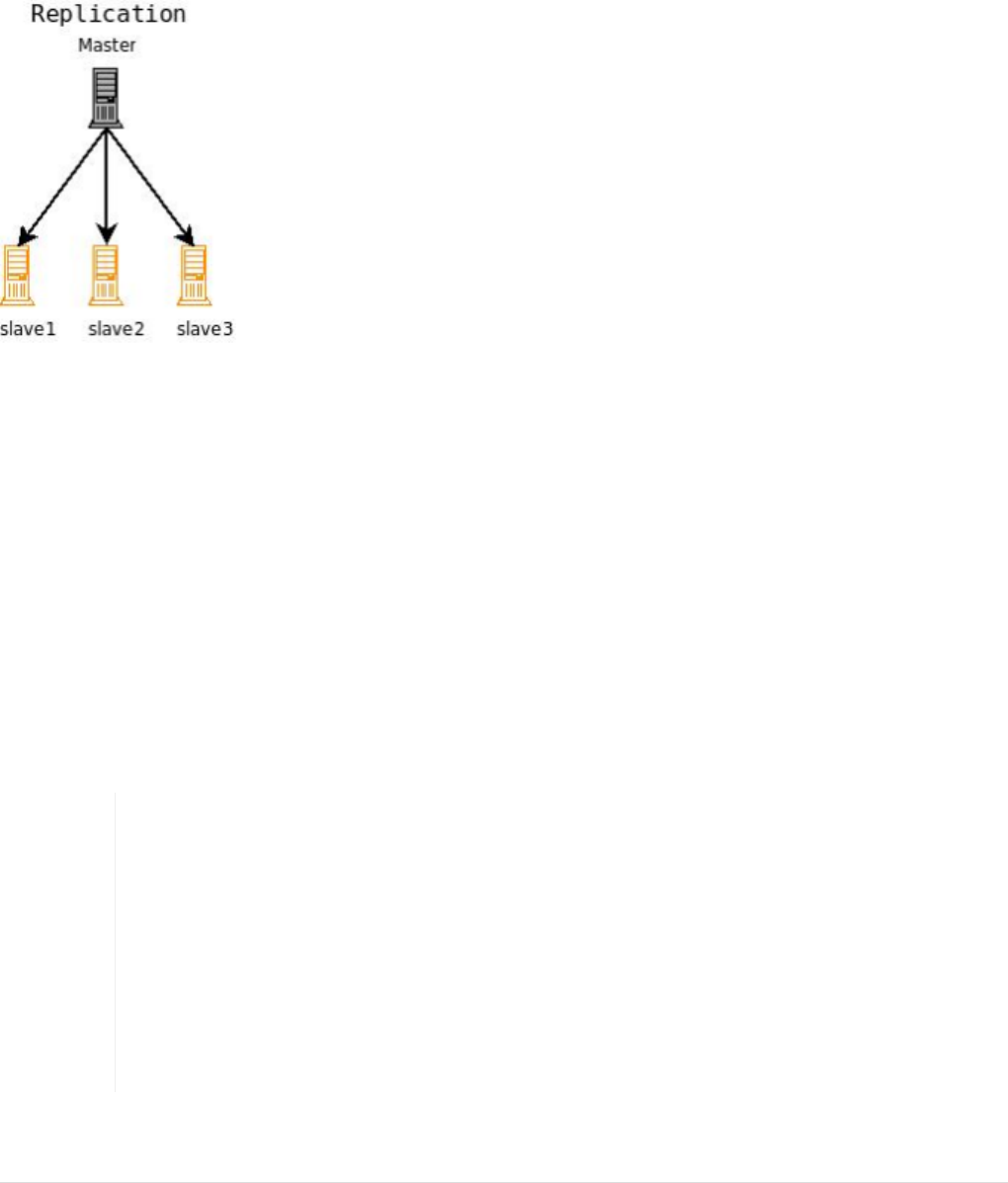
Index Replication
Index Replication distributes complete copies of a master index to one or more slave servers. The master
server continues to manage updates to the index. All querying is handled by the slaves. This division of labor
enables Solr to scale to provide adequate responsiveness to queries against large search volumes.
The figure below shows a Solr configuration using index replication. The master server’s index is replicated
on the slaves.
A Solr index can be replicated across multiple slave servers, which then process requests.
Index Replication in Solr
Solr includes a Java implementation of index replication that works over HTTP:
•The configuration affecting replication is controlled by a single file, solrconfig.xml
•Supports the replication of configuration files as well as index files
•Works across platforms with same configuration
•No reliance on OS-dependent file system features (e.g., hard links)
•Tightly integrated with Solr; an admin page offers fine-grained control of each aspect of replication
•The Java-based replication feature is implemented as a request handler. Configuring replication is
therefore similar to any normal request handler.
Replication In SolrCloud
Although there is no explicit concept of "master/slave" nodes in a SolrCloud cluster, the
ReplicationHandler discussed on this page is still used by SolrCloud as needed to support
"shard recovery" – but this is done in a peer to peer manner.
When using SolrCloud, the ReplicationHandler must be available via the /replication
path. Solr does this implicitly unless overridden explicitly in your solrconfig.xml, but if you
wish to override the default behavior, make certain that you do not explicitly set any of the
"master" or "slave" configuration options mentioned below, or they will interfere with
normal SolrCloud operation.
Apache Solr Reference Guide 7.7 Page 1191 of 1426
© 2019, Apache Software Foundation Guide Version 7.7 - Published: 2019-03-04

Replication Terminology
The table below defines the key terms associated with Solr replication.
Index
A Lucene index is a directory of files. These files make up the searchable and returnable data of a Solr
Core.
Distribution
The copying of an index from the master server to all slaves. The distribution process takes advantage of
Lucene’s index file structure.
Inserts and Deletes
As inserts and deletes occur in the index, the directory remains unchanged. Documents are always
inserted into newly created segment files. Documents that are deleted are not removed from the
segment files. They are flagged in the file, deletable, and are not removed from the segments until the
segment is merged as part of normal index updates.
Master and Slave
A Solr replication master is a single node which receives all updates initially and keeps everything
organized. Solr replication slave nodes receive no updates directly, instead all changes (such as inserts,
updates, deletes, etc.) are made against the single master node. Changes made on the master are
distributed to all the slave nodes which service all query requests from the clients.
Update
An update is a single change request against a single Solr instance. It may be a request to delete a
document, add a new document, change a document, delete all documents matching a query, etc.
Updates are handled synchronously within an individual Solr instance.
Optimization
A process that compacts the index and merges segments in order to improve query performance.
Optimization should only be run on the master nodes. An optimized index may give query performance
gains compared to an index that has become fragmented over a period of time with many updates.
Distributing an optimized index requires a much longer time than the distribution of new segments to an
un-optimized index.
optimizing is not recommended unless it can be performed regularly as it may lead to a
significantly larger portion of the index consisting of deleted documents than would
normally be the case.
Segments
A self contained subset of an index consisting of some documents and data structures related to the
inverted index of terms in those documents.
mergeFactor
A parameter that controls the number of segments in an index. For example, when mergeFactor is set to
3, Solr will fill one segment with documents until the limit maxBufferedDocs is met, then it will start a new
segment. When the number of segments specified by mergeFactor is reached (in this example, 3) then
Page 1192 of 1426 Apache Solr Reference Guide 7.7
Guide Version 7.7 - Published: 2019-03-04 © 2019, Apache Software Foundation

Solr will merge all the segments into a single index file, then begin writing new documents to a new
segment.
Snapshot
A directory containing hard links to the data files of an index. Snapshots are distributed from the master
nodes when the slaves pull them, "smart copying" any segments the slave node does not have in
snapshot directory that contains the hard links to the most recent index data files.
Configuring the ReplicationHandler
In addition to ReplicationHandler configuration options specific to the master/slave roles, there are a few
special configuration options that are generally supported (even when using SolrCloud).
•maxNumberOfBackups an integer value dictating the maximum number of backups this node will keep on
disk as it receives backup commands.
•Similar to most other request handlers in Solr you may configure a set of defaults, invariants, and/or
appends parameters corresponding with any request parameters supported by the ReplicationHandler
when processing commands.
Configuring the Replication RequestHandler on a Master Server
Before running a replication, you should set the following parameters on initialization of the handler:
replicateAfter
String specifying action after which replication should occur. Valid values are commit, optimize, or
startup. There can be multiple values for this parameter. If you use "startup", you need to have a
"commit" and/or "optimize" entry also if you want to trigger replication on future commits or optimizes.
backupAfter
String specifying action after which a backup should occur. Valid values are commit, optimize, or startup.
There can be multiple values for this parameter. It is not required for replication, it just makes a backup.
maxNumberOfBackups
Integer specifying how many backups to keep. This can be used to delete all but the most recent N
backups.
confFiles
The configuration files to replicate, separated by a comma.
commitReserveDuration
If your commits are very frequent and your network is slow, you can tweak this parameter to increase the
amount of time expected to be required to transfer data. The default is 00:00:10 i.e., 10 seconds.
The example below shows a possible 'master' configuration for the ReplicationHandler, including a fixed
number of backups and an invariant setting for the maxWriteMBPerSec request parameter to prevent slaves
from saturating its network interface
Apache Solr Reference Guide 7.7 Page 1193 of 1426
© 2019, Apache Software Foundation Guide Version 7.7 - Published: 2019-03-04

<requestHandler name="/replication" class="solr.ReplicationHandler">
Ê <lst name="master">
Ê <str name="replicateAfter">optimize</str>
Ê <str name="backupAfter">optimize</str>
Ê <str name="confFiles">schema.xml,stopwords.txt,elevate.xml</str>
Ê </lst>
Ê <int name="maxNumberOfBackups">2</int>
Ê <str name="commitReserveDuration">00:00:10</str>
Ê <lst name="invariants">
Ê <str name="maxWriteMBPerSec">16</str>
Ê </lst>
</requestHandler>
Replicating solrconfig.xml
In the configuration file on the master server, include a line like the following:
<str name="confFiles">solrconfig_slave.xml:solrconfig.xml,x.xml,y.xml</str>
This ensures that the local configuration solrconfig_slave.xml will be saved as solrconfig.xml on the
slave. All other files will be saved with their original names.
On the master server, the file name of the slave configuration file can be anything, as long as the name is
correctly identified in the confFiles string; then it will be saved as whatever file name appears after the
colon ':'.
Configuring the Replication RequestHandler on a Slave Server
The code below shows how to configure a ReplicationHandler on a slave.
Page 1194 of 1426 Apache Solr Reference Guide 7.7
Guide Version 7.7 - Published: 2019-03-04 © 2019, Apache Software Foundation

<requestHandler name="/replication" class="solr.ReplicationHandler">
Ê <lst name="slave">
Ê <!-- fully qualified url for the replication handler of master. It is
Ê possible to pass on this as a request param for the fetchindex command -->
Ê <str name="masterUrl">http://remote_host:port/solr/core_name/replication</str>
Ê <!-- Interval in which the slave should poll master. Format is HH:mm:ss .
Ê If this is absent slave does not poll automatically.
Ê But a fetchindex can be triggered from the admin or the http API -->
Ê <str name="pollInterval">00:00:20</str>
Ê <!-- THE FOLLOWING PARAMETERS ARE USUALLY NOT REQUIRED-->
Ê <!-- To use compression while transferring the index files. The possible
Ê values are internal|external. If the value is 'external' make sure
Ê that your master Solr has the settings to honor the accept-encoding header.
Ê See here for details: http://wiki.apache.org/solr/SolrHttpCompression
Ê If it is 'internal' everything will be taken care of automatically.
Ê USE THIS ONLY IF YOUR BANDWIDTH IS LOW.
Ê THIS CAN ACTUALLY SLOWDOWN REPLICATION IN A LAN -->
Ê <str name="compression">internal</str>
Ê <!-- The following values are used when the slave connects to the master to
Ê download the index files. Default values implicitly set as 5000ms and
Ê 10000ms respectively. The user DOES NOT need to specify these unless the
Ê bandwidth is extremely low or if there is an extremely high latency -->
Ê <str name="httpConnTimeout">5000</str>
Ê <str name="httpReadTimeout">10000</str>
Ê <!-- If HTTP Basic authentication is enabled on the master, then the slave
Ê can be configured with the following -->
Ê <str name="httpBasicAuthUser">username</str>
Ê <str name="httpBasicAuthPassword">password</str>
Ê </lst>
</requestHandler>
Setting Up a Repeater with the ReplicationHandler
A master may be able to serve only so many slaves without affecting performance. Some organizations have
deployed slave servers across multiple data centers. If each slave downloads the index from a remote data
center, the resulting download may consume too much network bandwidth. To avoid performance
degradation in cases like this, you can configure one or more slaves as repeaters. A repeater is simply a
node that acts as both a master and a slave.
•To configure a server as a repeater, the definition of the Replication requestHandler in the
Apache Solr Reference Guide 7.7 Page 1195 of 1426
© 2019, Apache Software Foundation Guide Version 7.7 - Published: 2019-03-04

solrconfig.xml file must include file lists of use for both masters and slaves.
•Be sure to set the replicateAfter parameter to commit, even if replicateAfter is set to optimize on
the main master. This is because on a repeater (or any slave), a commit is called only after the index is
downloaded. The optimize command is never called on slaves.
•Optionally, one can configure the repeater to fetch compressed files from the master through the
compression parameter to reduce the index download time.
Here is an example of a ReplicationHandler configuration for a repeater:
<requestHandler name="/replication" class="solr.ReplicationHandler">
Ê <lst name="master">
Ê <str name="replicateAfter">commit</str>
Ê <str name="confFiles">schema.xml,stopwords.txt,synonyms.txt</str>
Ê </lst>
Ê <lst name="slave">
Ê <str name="masterUrl">http://master.solr.company.com:8983/solr/core_name/replication</str>
Ê <str name="pollInterval">00:00:60</str>
Ê </lst>
</requestHandler>
Commit and Optimize Operations
When a commit or optimize operation is performed on the master, the RequestHandler reads the list of file
names which are associated with each commit point. This relies on the replicateAfter parameter in the
configuration to decide which types of events should trigger replication.
These operations are supported:
•commit: Triggers replication whenever a commit is performed on the master index.
•optimize: Triggers replication whenever the master index is optimized.
•startup: Triggers replication whenever the master index starts up.
The replicateAfter parameter can accept multiple arguments. For example:
<str name="replicateAfter">startup</str>
<str name="replicateAfter">commit</str>
<str name="replicateAfter">optimize</str>
Slave Replication
The master is totally unaware of the slaves.
The slave continuously keeps polling the master (depending on the pollInterval parameter) to check the
current index version of the master. If the slave finds out that the master has a newer version of the index it
initiates a replication process. The steps are as follows:
•The slave issues a filelist command to get the list of the files. This command returns the names of the
Page 1196 of 1426 Apache Solr Reference Guide 7.7
Guide Version 7.7 - Published: 2019-03-04 © 2019, Apache Software Foundation

files as well as some metadata (for example, size, a lastmodified timestamp, an alias if any).
•The slave checks with its own index if it has any of those files in the local index. It then runs the
filecontent command to download the missing files. This uses a custom format (akin to the HTTP
chunked encoding) to download the full content or a part of each file. If the connection breaks in
between, the download resumes from the point it failed. At any point, the slave tries 5 times before
giving up a replication altogether.
•The files are downloaded into a temp directory, so that if either the slave or the master crashes during
the download process, no files will be corrupted. Instead, the current replication will simply abort.
•After the download completes, all the new files are moved to the live index directory and the file’s
timestamp is same as its counterpart on the master.
•A commit command is issued on the slave by the Slave’s ReplicationHandler and the new index is loaded.
Replicating Configuration Files
To replicate configuration files, list them using using the confFiles parameter. Only files found in the conf
directory of the master’s Solr instance will be replicated.
Solr replicates configuration files only when the index itself is replicated. That means even if a configuration
file is changed on the master, that file will be replicated only after there is a new commit/optimize on
master’s index.
Unlike the index files, where the timestamp is good enough to figure out if they are identical, configuration
files are compared against their checksum. The schema.xml files (on master and slave) are judged to be
identical if their checksums are identical.
As a precaution when replicating configuration files, Solr copies configuration files to a temporary directory
before moving them into their ultimate location in the conf directory. The old configuration files are then
renamed and kept in the same conf/ directory. The ReplicationHandler does not automatically clean up
these old files.
If a replication involved downloading of at least one configuration file, the ReplicationHandler issues a core-
reload command instead of a commit command.
Resolving Corruption Issues on Slave Servers
If documents are added to the slave, then the slave is no longer in sync with its master. However, the slave
will not undertake any action to put itself in sync, until the master has new index data.
When a commit operation takes place on the master, the index version of the master becomes different
from that of the slave. The slave then fetches the list of files and finds that some of the files present on the
master are also present in the local index but with different sizes and timestamps. This means that the
master and slave have incompatible indexes.
To correct this problem, the slave then copies all the index files from master to a new index directory and
asks the core to load the fresh index from the new directory.
HTTP API Commands for the ReplicationHandler
You can use the HTTP commands below to control the ReplicationHandler’s operations.
Apache Solr Reference Guide 7.7 Page 1197 of 1426
© 2019, Apache Software Foundation Guide Version 7.7 - Published: 2019-03-04

enablereplication
Enable replication on the "master" for all its slaves.
http://_master_host:port_/solr/_core_name_/replication?command=enablereplication
disablereplication
Disable replication on the master for all its slaves.
http://_master_host:port_/solr/_core_name_/replication?command=disablereplication
indexversion
Return the version of the latest replicatable index on the specified master or slave.
http://_host:port_/solr/_core_name_/replication?command=indexversion
fetchindex
Force the specified slave to fetch a copy of the index from its master.
http://_slave_host:port_/solr/_core_name_/replication?command=fetchindex
If you like, you can pass an extra attribute such as masterUrl or compression (or any other parameter
which is specified in the <lst name="slave"> tag) to do a one time replication from a master. This
obviates the need for hard-coding the master in the slave.
abortfetch
Abort copying an index from a master to the specified slave.
http://_slave_host:port_/solr/_core_name_/replication?command=abortfetch
enablepoll
Enable the specified slave to poll for changes on the master.
http://_slave_host:port_/solr/_core_name_/replication?command=enablepoll
disablepoll
Disable the specified slave from polling for changes on the master.
http://_slave_host:port_/solr/_core_name_/replication?command=disablepoll
details
Retrieve configuration details and current status.
Page 1198 of 1426 Apache Solr Reference Guide 7.7
Guide Version 7.7 - Published: 2019-03-04 © 2019, Apache Software Foundation

http://_slave_host:port_/solr/_core_name_/replication?command=details
filelist
Retrieve a list of Lucene files present in the specified host’s index.
http://_host:port_/solr/_core_name_/replication?command=filelist&generation=<_generation-
number_>
You can discover the generation number of the index by running the indexversion command.
backup
Create a backup on master if there are committed index data in the server; otherwise, does nothing.
http://_master_host:port_/solr/_core_name_/replication?command=backup
This command is useful for making periodic backups. There are several supported request parameters:
•numberToKeep:: This can be used with the backup command unless the maxNumberOfBackups
initialization parameter has been specified on the handler – in which case maxNumberOfBackups is
always used and attempts to use the numberToKeep request parameter will cause an error.
•name: (optional) Backup name. The snapshot will be created in a directory called snapshot.<name>
within the data directory of the core. By default the name is generated using date in
yyyyMMddHHmmssSSS format. If location parameter is passed, that would be used instead of the data
directory
•location: Backup location.
deletebackup
Delete any backup created using the backup command.
http://_master_host:port_ /solr/_core_name_/replication?command=deletebackup
There are two supported parameters:
•name: The name of the snapshot. A snapshot with the name snapshot.name must exist. If not, an error
is thrown.
•location: Location where the snapshot is created.
Distribution and Optimization
Optimizing an index is not something most users should generally worry about - but in particular users
should be aware of the impacts of optimizing an index when using the ReplicationHandler.
The time required to optimize a master index can vary dramatically. A small index may be optimized in
minutes. A very large index may take hours. The variables include the size of the index and the speed of the
hardware.
Apache Solr Reference Guide 7.7 Page 1199 of 1426
© 2019, Apache Software Foundation Guide Version 7.7 - Published: 2019-03-04

Distributing a newly optimized index may take only a few minutes or up to an hour or more, again
depending on the size of the index and the performance capabilities of network connections and disks.
During optimization the machine is under load and does not process queries very well. Given a schedule of
updates being driven a few times an hour to the slaves, we cannot run an optimize with every committed
snapshot.
Copying an optimized index means that the entire index will need to be transferred during the next
snappull. This is a large expense, but not nearly as huge as running the optimize everywhere.
Consider this example: on a three-slave one-master configuration, distributing a newly-optimized index
takes approximately 80 seconds total. Rolling the change across a tier would require approximately ten
minutes per machine (or machine group). If this optimize were rolled across the query tier, and if each slave
node being optimized were disabled and not receiving queries, a rollout would take at least twenty minutes
and potentially as long as an hour and a half. Additionally, the files would need to be synchronized so that
the following the optimize, snappull would not think that the independently optimized files were different in
any way. This would also leave the door open to independent corruption of indexes instead of each being a
perfect copy of the master.
Optimizing on the master allows for a straight-forward optimization operation. No query slaves need to be
taken out of service. The optimized index can be distributed in the background as queries are being
normally serviced. The optimization can occur at any time convenient to the application providing index
updates.
While optimizing may have some benefits in some situations, a rapidly changing index will not retain those
benefits for long, and since optimization is an intensive process, it may be better to consider other options,
such as lowering the merge factor (discussed in the section on Index Configuration).
Do not elect to optimize your index unless you have tangible evidence that it will
significantly improve your search performance. Recent changes in Solr/Lucene have
dramatically lessened the need to optimize as discussed at the above link.
Page 1200 of 1426 Apache Solr Reference Guide 7.7
Guide Version 7.7 - Published: 2019-03-04 © 2019, Apache Software Foundation
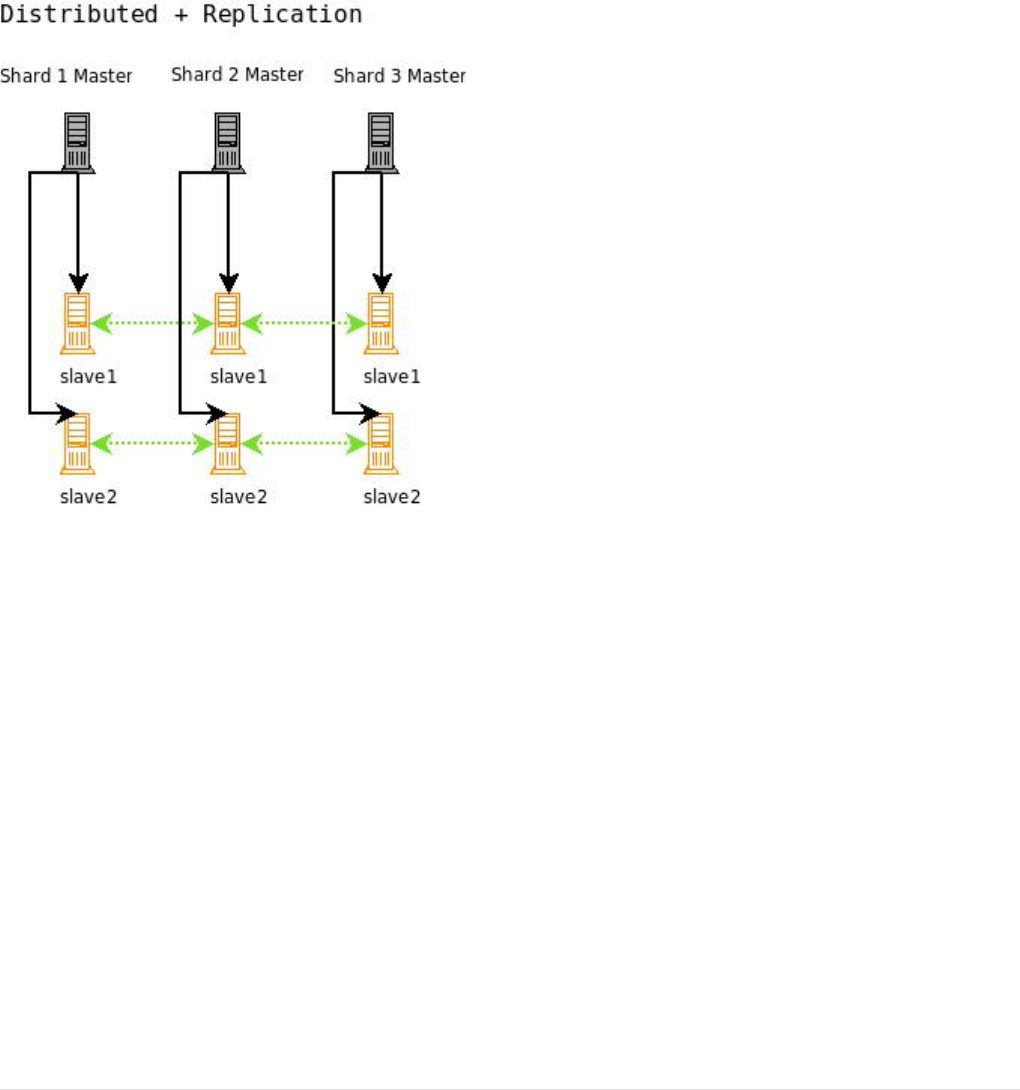
Combining Distribution and Replication
When your index is too large for a single machine and you have a query volume that single shards cannot
keep up with, it’s time to replicate each shard in your distributed search setup.
The idea is to combine distributed search with replication. As shown in the figure below, a combined
distributed-replication configuration features a master server for each shard and then 1-n slaves that are
replicated from the master. As in a standard replicated configuration, the master server handles updates
and optimizations without adversely affecting query handling performance.
Query requests should be load balanced across each of the shard slaves. This gives you both increased
query handling capacity and fail-over backup if a server goes down.
A Solr configuration combining both replication and master-slave distribution.
None of the master shards in this configuration know about each other. You index to each master, the index
is replicated to each slave, and then searches are distributed across the slaves, using one slave from each
master/slave shard.
For high availability you can use a load balancer to set up a virtual IP for each shard’s set of slaves. If you are
new to load balancing, HAProxy (http://haproxy.1wt.eu/) is a good open source software load-balancer. If a
slave server goes down, a good load-balancer will detect the failure using some technique (generally a
heartbeat system), and forward all requests to the remaining live slaves that served with the failed slave. A
single virtual IP should then be set up so that requests can hit a single IP, and get load balanced to each of
the virtual IPs for the search slaves.
With this configuration you will have a fully load balanced, search-side fault-tolerant system (Solr does not
yet support fault-tolerant indexing). Incoming searches will be handed off to one of the functioning slaves,
then the slave will distribute the search request across a slave for each of the shards in your configuration.
The slave will issue a request to each of the virtual IPs for each shard, and the load balancer will choose one
of the available slaves. Finally, the results will be combined into a single results set and returned. If any of
Apache Solr Reference Guide 7.7 Page 1201 of 1426
© 2019, Apache Software Foundation Guide Version 7.7 - Published: 2019-03-04

the slaves go down, they will be taken out of rotation and the remaining slaves will be used. If a shard
master goes down, searches can still be served from the slaves until you have corrected the problem and
put the master back into production.
Page 1202 of 1426 Apache Solr Reference Guide 7.7
Guide Version 7.7 - Published: 2019-03-04 © 2019, Apache Software Foundation

Merging Indexes
If you need to combine indexes from two different projects or from multiple servers previously used in a
distributed configuration, you can use either the IndexMergeTool included in lucene-misc or the
CoreAdminHandler.
To merge indexes, they must meet these requirements:
•The two indexes must be compatible: their schemas should include the same fields and they should
analyze fields the same way.
•The indexes must not include duplicate data.
Optimally, the two indexes should be built using the same schema.
Using IndexMergeTool
To merge the indexes, do the following:
1. Make sure that both indexes you want to merge are closed.
2. Issue this command:
java -cp $SOLR/server/solr-webapp/webapp/WEB-INF/lib/lucene-core-
VERSION.jar:$SOLR/server/solr-webapp/webapp/WEB-INF/lib/lucene-misc-VERSION.jar
org/apache/lucene/misc/IndexMergeTool /path/to/newindex /path/to/old/index1
/path/to/old/index2
This will create a new index at /path/to/newindex that contains both index1 and index2.
3. Copy this new directory to the location of your application’s Solr index (move the old one aside first, of
course) and start Solr.
Using CoreAdmin
The MERGEINDEXES command of the CoreAdminHandler can be used to merge indexes into a new core –
either from one or more arbitrary indexDir directories or by merging from one or more existing srcCore
core names.
See the CoreAdminHandler section for details.
Apache Solr Reference Guide 7.7 Page 1203 of 1426
© 2019, Apache Software Foundation Guide Version 7.7 - Published: 2019-03-04

The Well-Configured Solr Instance
This section tells you how to fine-tune your Solr instance for optimum performance.
This section covers the following topics:
Configuring solrconfig.xml: Describes how to work with the main configuration file for Solr, solrconfig.xml,
covering the major sections of the file.
Solr Cores and solr.xml: Describes how to work with solr.xml and core.properties to configure your Solr
core, or multiple Solr cores within a single instance.
Configuration APIs: Describes several APIs used to configure Solr: Blob Store, Config, Request Parameters
and Managed Resources.
Implicit RequestHandlers: Describes various end-points automatically provided by Solr and how to configure
them.
Solr Plugins: Introduces Solr plugins with pointers to more information.
JVM Settings: Gives some guidance on best practices for working with Java Virtual Machines.
V2 API: Describes how to use the new V2 APIs, a redesigned API framework covering most Solr APIs.
The focus of this section is generally on configuring a single Solr instance, but for those
interested in scaling a Solr implementation in a cluster environment, see also the section
SolrCloud. There are also options to scale through sharding or replication, described in the
section Legacy Scaling and Distribution.
Page 1204 of 1426 Apache Solr Reference Guide 7.7
Guide Version 7.7 - Published: 2019-03-04 © 2019, Apache Software Foundation

Configuring solrconfig.xml
The solrconfig.xml file is the configuration file with the most parameters affecting Solr itself.
While configuring Solr, you’ll work with solrconfig.xml often, either directly or via the Config API to create
"configuration overlays" (configoverlay.json) to override the values in solrconfig.xml.
In solrconfig.xml, you configure important features such as:
•request handlers, which process the requests to Solr, such as requests to add documents to the index or
requests to return results for a query
•listeners, processes that "listen" for particular query-related events; listeners can be used to trigger the
execution of special code, such as invoking some common queries to warm-up caches
•the Request Dispatcher for managing HTTP communications
•the Admin Web interface
•parameters related to replication and duplication (these parameters are covered in detail in Legacy
Scaling and Distribution)
The solrconfig.xml file is located in the conf/ directory for each collection. Several well-commented
example files can be found in the server/solr/configsets/ directories demonstrating best practices for
many different types of installations.
We’ve covered the options in the following sections:
•DataDir and DirectoryFactory in SolrConfig
•Lib Directives in SolrConfig
•Schema Factory Definition in SolrConfig
•IndexConfig in SolrConfig
•RequestHandlers and SearchComponents in SolrConfig
•InitParams in SolrConfig
•UpdateHandlers in SolrConfig
•Query Settings in SolrConfig
•RequestDispatcher in SolrConfig
•Update Request Processors
•Codec Factory
Substituting Properties in Solr Config Files
Solr supports variable substitution of property values in configuration files, which allows runtime
specification of various configuration options in solrconfig.xml. The syntax is ${propertyname[:option
default value]}. This allows defining a default that can be overridden when Solr is launched. If a default
value is not specified, then the property must be specified at runtime or the configuration file will generate
an error when parsed.
Apache Solr Reference Guide 7.7 Page 1205 of 1426
© 2019, Apache Software Foundation Guide Version 7.7 - Published: 2019-03-04

There are multiple methods for specifying properties that can be used in configuration files. Of those below,
strongly consider "config overlay" as the preferred approach, as it stays local to the configset and is easy to
modify.
JVM System Properties
Any JVM System properties, usually specified using the -D flag when starting the JVM, can be used as
variables in any XML configuration file in Solr.
For example, in the sample solrconfig.xml files, you will see this value which defines the locking type to
use:
<lockType>${solr.lock.type:native}</lockType>
Which means the lock type defaults to "native" but when starting Solr, you could override this using a JVM
system property by launching the Solr it with:
bin/solr start -Dsolr.lock.type=none
In general, any Java system property that you want to set can be passed through the bin/solr script using
the standard -Dproperty=value syntax. Alternatively, you can add common system properties to the
SOLR_OPTS environment variable defined in the Solr include file (bin/solr.in.sh or bin/solr.in.cmd). For
more information about how the Solr include file works, refer to: Taking Solr to Production.
Config API to Override solrconfig.xml
The Config API allows you to use an API to modify Solr’s configuration, specifically user defined properties.
Changes made with this API are stored in a file named configoverlay.json. This file should only be edited
with the API, but will look like this example:
{"userProps": {
Ê "dih.db.url": "jdbc:oracle:thin:@localhost:1521",
Ê "dih.db.user": "username",
Ê "dih.db.pass": "password"}}
For more details, see the section Config API.
solrcore.properties
If the configuration directory for a Solr core contains a file named solrcore.properties that file can contain
any arbitrary user-defined property names and values using the Java properties file format. Those properties
can then be used as variables in other configuration files for that Solr core.
For example, the following solrcore.properties file could be created in the conf/ directory of a collection
using one of the example configurations, to override the lockType used.
Page 1206 of 1426 Apache Solr Reference Guide 7.7
Guide Version 7.7 - Published: 2019-03-04 © 2019, Apache Software Foundation

#conf/solrcore.properties
solr.lock.type=none
Deprecation
solrcore.properties won’t work in SolrCloud mode (it is not read from ZooKeeper). This
feature is likely to be removed in the future. Instead, use another mechanism like a config
overlay.
The path and name of the solrcore.properties file can be overridden using the
properties property in core.properties.
User-Defined Properties in core.properties
Every Solr core has a core.properties file, automatically created when using the APIs. When you create a
SolrCloud collection, you can pass through custom parameters by prefixing the parameter name with
property.name as a parameter.
For example, to add a property named "my.custom.prop":
V1 API
http://localhost:8983/solr/admin/collections?action=CREATE&name=gettingstarted&numShards=1&pr
operty.my.custom.prop=edismax
V2 API
curl -X POST -H 'Content-type: application/json' -d '{"create": {"name": "gettingstarted",
"numShards": "1", "property.my.custom.prop": "edismax"}}'
http://localhost:8983/api/collections
This will create a core.properties file that has at least the following properties (others omitted for brevity):
#core.properties
name=gettingstarted
my.custom.prop=edismax
The my.custom.prop property can then be used as a variable, such as in solrconfig.xml:
Apache Solr Reference Guide 7.7 Page 1207 of 1426
© 2019, Apache Software Foundation Guide Version 7.7 - Published: 2019-03-04

<requestHandler name="/select">
Ê <lst name="defaults">
Ê <str name="defType">${my.custom.prop}</str>
Ê </lst>
</requestHandler>
Implicit Core Properties
Several attributes of a Solr core are available as "implicit" properties that can be used in variable
substitution, independent of where or how the underlying value is initialized.
For example, regardless of whether the name for a particular Solr core is explicitly configured in
core.properties or inferred from the name of the instance directory, the implicit property solr.core.name
is available for use as a variable in that core’s configuration file:
<requestHandler name="/select">
Ê <lst name="defaults">
Ê <str name="collection_name">${solr.core.name}</str>
Ê </lst>
</requestHandler>
All implicit properties use the solr.core. name prefix, and reflect the runtime value of the equivalent
core.properties property:
•solr.core.name
•solr.core.config
•solr.core.schema
•solr.core.dataDir
•solr.core.transient
•solr.core.loadOnStartup
DataDir and DirectoryFactory in SolrConfig
Where and how Solr stores its indexes are configurable options.
Specifying a Location for Index Data with the dataDir Parameter
By default, Solr stores its index data in a directory called /data under the core’s instance directory
(instanceDir). If you would like to specify a different directory for storing index data, you can configure the
dataDir in the core.properties file for the core, or use the <dataDir> parameter in the solrconfig.xml
file. You can specify another directory either with an absolute path or a pathname relative to the instanceDir
of the SolrCore. For example:
<dataDir>/solr/data/${solr.core.name}</dataDir>
The ${solr.core.name} substitution will cause the name of the current core to be substituted, which results
Page 1208 of 1426 Apache Solr Reference Guide 7.7
Guide Version 7.7 - Published: 2019-03-04 © 2019, Apache Software Foundation

in each core’s data being kept in a separate subdirectory.
If you are using replication to replicate the Solr index (as described in Legacy Scaling and Distribution), then
the <dataDir> directory should correspond to the index directory used in the replication configuration.
If the environment variable SOLR_DATA_HOME is defined, or if solr.data.home is configured
for your DirectoryFactory, or if solr.xml contains an element <solrDataHome> then the
location of data directory will be <SOLR_DATA_HOME>/<instance_name>/data.
Specifying the DirectoryFactory For Your Index
The default solr.NRTCachingDirectoryFactory is filesystem based, and tries to pick the best
implementation for the current JVM and platform. You can force a particular implementation and/or
configuration options by specifying solr.MMapDirectoryFactory, solr.NIOFSDirectoryFactory, or
solr.SimpleFSDirectoryFactory.
<directoryFactory name="DirectoryFactory"
Ê class="solr.MMapDirectoryFactory">
Ê <bool name="preload">true</bool>
</directoryFactory>
The solr.RAMDirectoryFactory is memory based, not persistent, and does not work with replication. Use
this DirectoryFactory to store your index in RAM.
<directoryFactory class="org.apache.solr.core.RAMDirectoryFactory"/>
If you are using Hadoop and would like to store your indexes in HDFS, you should use the
solr.HdfsDirectoryFactory instead of either of the above implementations. For more
details, see the section Running Solr on HDFS.
Resource and Plugin Loading
Solr components can be configured using resources: data stored in external files that may be referred to in
a location-independent fashion. Examples include: files needed by schema components, e.g., a stopword list
for Stop Filter; and machine-learned models for Learning to Rank.
Solr plugins, which can be configured in solrconfig.xml, are Java classes that are normally packaged in
.jar files along with supporting classes and data. Solr ships with a number of built-in plugins, and can also
be configured to use custom plugins. Example plugins are the Data Import Handler and custom search
components.
Resources and plugins may be stored:
•in ZooKeeper under a collection’s configset node (SolrCloud only);
•on a filesystem accessible to Solr nodes; or
•in Solr’s Blob Store (SolrCloud only).
Apache Solr Reference Guide 7.7 Page 1209 of 1426
© 2019, Apache Software Foundation Guide Version 7.7 - Published: 2019-03-04

Schema components may not be stored as plugins in the Blob Store, and cannot access
resources stored in the Blob Store.
Resource and Plugin Loading Sequence
Under SolrCloud, resources and plugins to be loaded are first looked up in ZooKeeper under the collection’s
configset znode. If the resource or plugin is not found there, Solr will fall back to loading from the filesystem.
Note that by default, Solr will not attempt to load resources and plugins from the Blob Store. To enable this,
see the section Use a Blob in a Handler or Component. When loading from the Blob Store is enabled for a
component, lookups occur only in the Blob Store, and never in ZooKeeper or on the filesystem.
Resources and Plugins in ConfigSets on ZooKeeper
Resources and plugins may be uploaded to ZooKeeper as part of a configset, either via the Configsets API or
bin/solr zk upload.
To upload a plugin or resource to a configset already stored on ZooKeeper, you can use bin/solr zk cp.
By default, ZooKeeper’s file size limit is 1MB. If your files are larger than this, you’ll need to
either increase the ZooKeeper file size limit or store them instead on the filesystem.
Resources and Plugins on the Filesystem
Under standalone Solr, when looking up a plugin or resource to be loaded, Solr’s resource loader will first
look under the <instanceDir>/conf/ directory. If the plugin or resource is not found, the configured plugin
and resource file paths are searched - see the section Lib Directives in SolrConfig below.
On core load, Solr’s resource loader constructs a list of paths (subdirectories and jars), first under
solr_home/lib, and then under directories pointed to by <lib/> directives in SolrConfig.
When looking up a resource or plugin to be loaded, the paths on the list are searched in the order they were
added.
Under SolrCloud, each node hosting a collection replica will need its own copy of plugins
and resources to be loaded.
To get Solr’s resource loader to find resources either under subdirectories or in jar files that were created
after Solr’s resource path list was constructed, reload the collection (SolrCloud) or the core (standalone Solr).
Restarting all affected Solr nodes also works.
Resource files will not be loaded if they are located directly under either solr_home/lib or
a directory given by the dir attribute on a <lib/> directive in SolrConfig. Resources are
only searched for under subdirectories or in jar files found in those locations.
solr_home/lib
Each Solr node can have a directory named lib/ under the Solr home directory. In order to use this
directory to host resources or plugins, it must first be manually created.
Page 1210 of 1426 Apache Solr Reference Guide 7.7
Guide Version 7.7 - Published: 2019-03-04 © 2019, Apache Software Foundation

Lib Directives in SolrConfig
Plugin and resource file paths are configurable via <lib/> directives in solrconfig.xml.
Loading occurs in the order <lib/> directives appear in solrconfig.xml. If there are dependencies, list the
lowest level dependency jar first.
A regular expression supplied in the <lib/> element’s regex attribute value can be used to restrict which
subdirectories and/or jar files are added to the Solr resource loader’s list of search locations. If no regular
expression is given, all direct subdirectory and jar children are included in the resource path list. All
directories are resolved as relative to the Solr core’s instanceDir.
From an example SolrConfig:
<lib dir="../../../contrib/extraction/lib" regex=".*\.jar" />
<lib dir="../../../dist/" regex="solr-cell-\d.*\.jar" />
<lib dir="../../../contrib/clustering/lib/" regex=".*\.jar" />
<lib dir="../../../dist/" regex="solr-clustering-\d.*\.jar" />
<lib dir="../../../contrib/langid/lib/" regex=".*\.jar" />
<lib dir="../../../dist/" regex="solr-langid-\d.*\.jar" />
<lib dir="../../../contrib/velocity/lib" regex=".*\.jar" />
<lib dir="../../../dist/" regex="solr-velocity-\d.*\.jar" />
Schema Factory Definition in SolrConfig
Solr’s Schema API enables remote clients to access schema information, and make schema modifications,
through a REST interface.
Other features such as Solr’s Schemaless Mode also work via schema modifications made programatically at
run time.
Using the Managed Schema is required to be able to use the Schema API to modify your
schema. However, using Managed Schema does not by itself mean you are also using Solr
in Schemaless Mode (or "schema guessing" mode).
Schemaless mode requires enabling the Managed Schema if it is not already, but full
schema guessing requires additional configuration as described in the section Schemaless
Mode.
While the "read" features of the Schema API are supported for all schema types, support for making schema
modifications programatically depends on the <schemaFactory/> in use.
Solr Uses Managed Schema by Default
When a <schemaFactory/> is not explicitly declared in a solrconfig.xml file, Solr implicitly uses a
ManagedIndexSchemaFactory, which is by default "mutable" and keeps schema information in a managed-
schema file.
Apache Solr Reference Guide 7.7 Page 1211 of 1426
© 2019, Apache Software Foundation Guide Version 7.7 - Published: 2019-03-04

Ê<!-- An example of Solr's implicit default behavior if no
Ê no schemaFactory is explicitly defined.
Ê-->
Ê <schemaFactory class="ManagedIndexSchemaFactory">
Ê <bool name="mutable">true</bool>
Ê <str name="managedSchemaResourceName">managed-schema</str>
Ê </schemaFactory>
If you wish to explicitly configure ManagedIndexSchemaFactory the following options are available:
•mutable - controls whether changes may be made to the Schema data. This must be set to true to allow
edits to be made with the Schema API.
•managedSchemaResourceName is an optional parameter that defaults to "managed-schema", and defines
a new name for the schema file that can be anything other than “schema.xml”.
With the default configuration shown above, you can use the Schema API to modify the schema as much as
you want, and then later change the value of mutable to false if you wish to "lock" the schema in place and
prevent future changes.
Classic schema.xml
An alternative to using a managed schema is to explicitly configure a ClassicIndexSchemaFactory.
ClassicIndexSchemaFactory requires the use of a schema.xml configuration file, and disallows any
programatic changes to the Schema at run time. The schema.xml file must be edited manually and is only
loaded only when the collection is loaded.
Ê <schemaFactory class="ClassicIndexSchemaFactory"/>
Switching from schema.xml to Managed Schema
If you have an existing Solr collection that uses ClassicIndexSchemaFactory, and you wish to convert to use
a managed schema, you can simply modify the solrconfig.xml to specify the use of the
ManagedIndexSchemaFactory.
Once Solr is restarted and it detects that a schema.xml file exists, but the managedSchemaResourceName file
(i.e., “managed-schema”) does not exist, the existing schema.xml file will be renamed to schema.xml.bak
and the contents are re-written to the managed schema file. If you look at the resulting file, you’ll see this at
the top of the page:
<!-- Solr managed schema - automatically generated - DO NOT EDIT -->
You are now free to use the Schema API as much as you want to make changes, and remove the
schema.xml.bak.
Switching from Managed Schema to Manually Edited schema.xml
If you have started Solr with managed schema enabled and you would like to switch to manually editing a
schema.xml file, you should take the following steps:
Page 1212 of 1426 Apache Solr Reference Guide 7.7
Guide Version 7.7 - Published: 2019-03-04 © 2019, Apache Software Foundation

1. Rename the managed-schema file to schema.xml.
2. Modify solrconfig.xml to replace the schemaFactory class.
a. Remove any ManagedIndexSchemaFactory definition if it exists.
b. Add a ClassicIndexSchemaFactory definition as shown above
3. Reload the core(s).
If you are using SolrCloud, you may need to modify the files via ZooKeeper. The bin/solr script provides an
easy way to download the files from ZooKeeper and upload them back after edits. See the section
ZooKeeper Operations for more information.
To have full control over your schema.xml file, you may also want to disable schema
guessing, which allows unknown fields to be added to the schema during indexing. The
properties that enable this feature are discussed in the section Schemaless Mode.
IndexConfig in SolrConfig
The <indexConfig> section of solrconfig.xml defines low-level behavior of the Lucene index writers.
By default, the settings are commented out in the sample solrconfig.xml included with Solr, which means
the defaults are used. In most cases, the defaults are fine.
<indexConfig>
Ê ...
</indexConfig>
Writing New Segments
ramBufferSizeMB
Once accumulated document updates exceed this much memory space (defined in megabytes), then the
pending updates are flushed. This can also create new segments or trigger a merge. Using this setting is
generally preferable to maxBufferedDocs. If both maxBufferedDocs and ramBufferSizeMB are set in
solrconfig.xml, then a flush will occur when either limit is reached. The default is 100Mb.
<ramBufferSizeMB>100</ramBufferSizeMB>
maxBufferedDocs
Sets the number of document updates to buffer in memory before they are flushed as a new segment. This
may also trigger a merge. The default Solr configuration sets to flush by RAM usage (ramBufferSizeMB).
<maxBufferedDocs>1000</maxBufferedDocs>
useCompoundFile
Controls whether newly written (and not yet merged) index segments should use the Compound File
Apache Solr Reference Guide 7.7 Page 1213 of 1426
© 2019, Apache Software Foundation Guide Version 7.7 - Published: 2019-03-04

Segments format. The default is false.
<useCompoundFile>false</useCompoundFile>
Merging Index Segments
mergePolicyFactory
Defines how merging segments is done.
The default in Solr is to use a TieredMergePolicy, which merges segments of approximately equal size,
subject to an allowed number of segments per tier.
Other policies available are the LogByteSizeMergePolicy, LogDocMergePolicy, and
UninvertDocValuesMergePolicy. For more information on these policies, please see the MergePolicy
javadocs.
<mergePolicyFactory class="org.apache.solr.index.TieredMergePolicyFactory">
Ê <int name="maxMergeAtOnce">10</int>
Ê <int name="segmentsPerTier">10</int>
</mergePolicyFactory>
Controlling Segment Sizes
The most common adjustment users make to the configuration of TieredMergePolicy (or
LogByteSizeMergePolicy) are the "merge factors" to change how many segments should be merged at one
time and, in the TieredMergePolicy case, the maximum size of an merged segment.
For TieredMergePolicy, this is controlled by setting the maxMergeAtOnce (default 10), segmentsPerTier
(default 10) and maxMergedSegmentMB (default 5000) options.
LogByteSizeMergePolicy has a single mergeFactor option (default 10).
To understand why these options are important, consider what happens when an update is made to an
index using LogByteSizeMergePolicy: Documents are always added to the most recently opened segment.
When a segment fills up, a new segment is created and subsequent updates are placed there.
If creating a new segment would cause the number of lowest-level segments to exceed the mergeFactor
value, then all those segments are merged together to form a single large segment. Thus, if the merge
factor is 10, each merge results in the creation of a single segment that is roughly ten times larger than each
of its ten constituents. When there are 10 of these larger segments, then they in turn are merged into an
even larger single segment. This process can continue indefinitely.
When using TieredMergePolicy, the process is the same, but instead of a single mergeFactor value, the
segmentsPerTier setting is used as the threshold to decide if a merge should happen, and the
maxMergeAtOnce setting determines how many segments should be included in the merge.
Choosing the best merge factors is generally a trade-off of indexing speed vs. searching speed. Having
fewer segments in the index generally accelerates searches, because there are fewer places to look. It also
can also result in fewer physical files on disk. But to keep the number of segments low, merges will occur
Page 1214 of 1426 Apache Solr Reference Guide 7.7
Guide Version 7.7 - Published: 2019-03-04 © 2019, Apache Software Foundation

more often, which can add load to the system and slow down updates to the index.
Conversely, keeping more segments can accelerate indexing, because merges happen less often, making an
update is less likely to trigger a merge. But searches become more computationally expensive and will likely
be slower, because search terms must be looked up in more index segments. Faster index updates also
means shorter commit turnaround times, which means more timely search results.
Customizing Merge Policies
If the configuration options for the built-in merge policies do not fully suit your use case, you can customize
them: either by creating a custom merge policy factory that you specify in your configuration, or by
configuring a merge policy wrapper which uses a wrapped.prefix configuration option to control how the
factory it wraps will be configured:
<mergePolicyFactory class="org.apache.solr.index.SortingMergePolicyFactory">
Ê <str name="sort">timestamp desc</str>
Ê <str name="wrapped.prefix">inner</str>
Ê <str name="inner.class">org.apache.solr.index.TieredMergePolicyFactory</str>
Ê <int name="inner.maxMergeAtOnce">10</int>
Ê <int name="inner.segmentsPerTier">10</int>
</mergePolicyFactory>
The example above shows Solr’s SortingMergePolicyFactory being configured to sort documents in
merged segments by "timestamp desc", and wrapped around a TieredMergePolicyFactory configured to
use the values maxMergeAtOnce=10 and segmentsPerTier=10 via the inner prefix defined by
SortingMergePolicyFactory 's wrapped.prefix option. For more information on using
SortingMergePolicyFactory, see the segmentTerminateEarly parameter.
mergeScheduler
The merge scheduler controls how merges are performed. The default ConcurrentMergeScheduler
performs merges in the background using separate threads. The alternative, SerialMergeScheduler, does
not perform merges with separate threads.
The ConcurrentMergeScheduler has the following configurable attributes:
maxMergeCount
The maximum number of simultaneous merges that are allowed. If a merge is necessary yet we already
have this many threads running, the indexing thread will block until a merge thread has completed. Note
that Solr will only run the smallest maxThreadCount merges at a time.
maxThreadCount
The maximum number of simultaneous merge threads that should be running at once. This must be less
than maxMergeCount.
ioThrottle
A Boolean value (true/ false) to explicitly control I/O throttling. By default throttling is enabled and the
CMS will limit I/O throughput when merging to leave other (search, indexing) some room.
The defaults for the above attributes are dynamically set based on whether the underlying disk drive is
Apache Solr Reference Guide 7.7 Page 1215 of 1426
© 2019, Apache Software Foundation Guide Version 7.7 - Published: 2019-03-04

rotational disk or not. Refer to the Dynamic defaults for ConcurrentMergeScheduler section for more details.
Example: Dynamic defaults
<mergeScheduler class="org.apache.lucene.index.ConcurrentMergeScheduler"/>
Example: Explicit defaults
<mergeScheduler class="org.apache.lucene.index.ConcurrentMergeScheduler">
Ê <int name="maxMergeCount">9</int>
Ê <int name="maxThreadCount">4</int>
</mergeScheduler>
mergedSegmentWarmer
When using Solr in for Near Real Time Searching a merged segment warmer can be configured to warm the
reader on the newly merged segment, before the merge commits. This is not required for near real-time
search, but will reduce search latency on opening a new near real-time reader after a merge completes.
<mergedSegmentWarmer class="org.apache.lucene.index.SimpleMergedSegmentWarmer"/>
Compound File Segments
Each Lucene segment is typically comprised of a dozen or so files. Lucene can be configured to bundle all of
the files for a segment into a single compound file using a file extension of .cfs; it’s an abbreviation for
Compound File Segment.
CFS segments may incur a minor performance hit for various reasons, depending on the runtime
environment. For example, filesystem buffers are typically associated with open file descriptors, which may
limit the total cache space available to each index.
On systems where the number of open files allowed per process is limited, CFS may avoid hitting that limit.
The open files limit might also be tunable for your OS with the Linux/Unix ulimit command, or something
similar for other operating systems.
CFS: New Segments vs Merged Segments
To configure whether newly written segments should use CFS, see the useCompoundFile
setting described above. To configure whether merged segments use CFS, review the
Javadocs for your mergePolicyFactory.
Many Merge Policy implementations support noCFSRatio and maxCFSSegmentSizeMB
settings with default values that prevent compound files from being used for large
segments, but do use compound files for small segments.
Index Locks
Page 1216 of 1426 Apache Solr Reference Guide 7.7
Guide Version 7.7 - Published: 2019-03-04 © 2019, Apache Software Foundation

lockType
The LockFactory options specify the locking implementation to use.
The set of valid lock type options depends on the DirectoryFactory you have configured. The values listed
below are are supported by StandardDirectoryFactory (the default):
•native (default) uses NativeFSLockFactory to specify native OS file locking. If a second Solr process
attempts to access the directory, it will fail. Do not use when multiple Solr web applications are
attempting to share a single index.
•simple uses SimpleFSLockFactory to specify a plain file for locking.
•single (expert) uses SingleInstanceLockFactory. Use for special situations of a read-only index directory,
or when there is no possibility of more than one process trying to modify the index (even sequentially).
This type will protect against multiple cores within the same JVM attempting to access the same index.
WARNING! If multiple Solr instances in different JVMs modify an index, this type will not protect against
index corruption.
•hdfs uses HdfsLockFactory to support reading and writing index and transaction log files to a HDFS
filesystem. See the section Running Solr on HDFS for more details on using this feature.
For more information on the nuances of each LockFactory, see http://wiki.apache.org/lucene-java/
AvailableLockFactories.
<lockType>native</lockType>
writeLockTimeout
The maximum time to wait for a write lock on an IndexWriter. The default is 1000, expressed in milliseconds.
<writeLockTimeout>1000</writeLockTimeout>
Other Indexing Settings
There are a few other parameters that may be important to configure for your implementation. These
settings affect how or when updates are made to an index.
deletionPolicy
Controls how commits are retained in case of rollback. The default is SolrDeletionPolicy, which has
sub-parameters for the maximum number of commits to keep (maxCommitsToKeep), the maximum
number of optimized commits to keep (maxOptimizedCommitsToKeep), and the maximum age of any
commit to keep (maxCommitAge), which supports DateMathParser syntax.
infoStream
The InfoStream setting instructs the underlying Lucene classes to write detailed debug information from
the indexing process as Solr log messages.
Apache Solr Reference Guide 7.7 Page 1217 of 1426
© 2019, Apache Software Foundation Guide Version 7.7 - Published: 2019-03-04

<deletionPolicy class="solr.SolrDeletionPolicy">
Ê <str name="maxCommitsToKeep">1</str>
Ê <str name="maxOptimizedCommitsToKeep">0</str>
Ê <str name="maxCommitAge">1DAY</str>
</deletionPolicy>
<infoStream>false</infoStream>
RequestHandlers and SearchComponents in SolrConfig
After the <query> section of solrconfig.xml, request handlers and search components are configured.
A request handler processes requests coming to Solr. These might be query requests or index update
requests. You will likely need several of these defined, depending on how you want Solr to handle the
various requests you will make.
A search component is a feature of search, such as highlighting or faceting. The search component is defined
in solrconfig.xml separate from the request handlers, and then registered with a request handler as
needed.
These are often referred to as "requestHandler" and "searchComponent", which is how they are defined in
solrconfig.xml.
Request Handlers
Every request handler is defined with a name and a class. The name of the request handler is referenced
with the request to Solr, typically as a path. For example, if Solr is installed at http://localhost:8983/solr/
and you have a collection named "gettingstarted", you can make a request that looks like this:
http://localhost:8983/solr/gettingstarted/select?q=solr
This query will be processed by the request handler with the name /select. We’ve only used the "q"
parameter here, which includes our query term, a simple keyword of "solr". If the request handler has more
parameters defined, those will be used with any query we send to this request handler unless they are over-
ridden by the client (or user) in the query itself.
If you have another request handler defined, you would send your request with that name. For example,
/update is a request handler that handles index updates (i.e., sending new documents to the index). By
default, /select is a request handler that handles query requests.
Request handlers can also process requests for nested paths of their names, for example, a request using
/myhandler/extrapath may be processed by a request handler registered with the name /myhandler. If a
request handler is explicitly defined by the name /myhandler/extrapath, that would take precedence over
the nested path. This assumes you are using the request handler classes included with Solr; if you create
your own request handler, you should make sure it includes the ability to handle nested paths if you want to
use them with your custom request handler.
It is also possible to configure defaults for request handlers with a section called initParams. These defaults
can be used when you want to have common properties that will be used by each separate handler. For
Page 1218 of 1426 Apache Solr Reference Guide 7.7
Guide Version 7.7 - Published: 2019-03-04 © 2019, Apache Software Foundation

example, if you intend to create several request handlers that will all request the same list of fields in the
response, you can configure an initParams section with your list of fields. For more information about
initParams, see the section InitParams in SolrConfig.
SearchHandlers
The primary request handler defined with Solr by default is the "SearchHandler", which handles search
queries. The request handler is defined, and then a list of defaults for the handler are defined with a
defaults list.
For example, in the default solrconfig.xml, the first request handler defined looks like this:
<requestHandler name="/select" class="solr.SearchHandler">
Ê <lst name="defaults">
Ê <str name="echoParams">explicit</str>
Ê <int name="rows">10</int>
Ê </lst>
</requestHandler>
This example defines the rows parameter, which defines how many search results to return, to "10". The
echoParams parameter defines that the parameters defined in the query should be returned when debug
information is returned. Note also that the way the defaults are defined in the list varies if the parameter is a
string, an integer, or another type.
All of the parameters described in the section Searching can be defined as defaults for any of the
SearchHandlers.
Besides defaults, there are other options for the SearchHandler, which are:
•appends: This allows definition of parameters that are added to the user query. These might be filter
queries, or other query rules that should be added to each query. There is no mechanism in Solr to allow
a client to override these additions, so you should be absolutely sure you always want these parameters
applied to queries.
<lst name="appends">
Ê <str name="fq">inStock:true</str>
</lst>
In this example, the filter query "inStock:true" will always be added to every query.
•invariants: This allows definition of parameters that cannot be overridden by a client. The values
defined in an invariants section will always be used regardless of the values specified by the user, by
the client, in defaults or in appends.
Apache Solr Reference Guide 7.7 Page 1219 of 1426
© 2019, Apache Software Foundation Guide Version 7.7 - Published: 2019-03-04

<lst name="invariants">
Ê <str name="facet.field">cat</str>
Ê <str name="facet.field">manu_exact</str>
Ê <str name="facet.query">price:[* TO 500]</str>
Ê <str name="facet.query">price:[500 TO *]</str>
</lst>
In this example, facet fields have been defined which limits the facets that will be returned by Solr. If the
client requests facets, the facets defined with a configuration like this are the only facets they will see.
The final section of a request handler definition is components, which defines a list of search components
that can be used with a request handler. They are only registered with the request handler. How to define a
search component is discussed further on in the section on Search Components below. The components
element can only be used with a request handler that is a SearchHandler.
The solrconfig.xml file includes many other examples of SearchHandlers that can be used or modified as
needed.
UpdateRequestHandlers
The UpdateRequestHandlers are request handlers which process updates to the index.
In this guide, we’ve covered these handlers in detail in the section Uploading Data with Index Handlers.
ShardHandlers
It is possible to configure a request handler to search across shards of a cluster, used with distributed
search. More information about distributed search and how to configure the shardHandler is in the section
Distributed Search with Index Sharding.
Implicit Request Handlers
Solr includes many out-of-the-box request handlers that are not configured in solrconfig.xml, and so are
referred to as "implicit" - see Implicit RequestHandlers.
Search Components
Search components define the logic that is used by the SearchHandler to perform queries for users.
Default Components
There are several default search components that work with all SearchHandlers without any additional
configuration. If no components are defined (with the exception of first-components and last-components
- see below), these are executed by default, in the following order:
Component Name Class Name More Information
query solr.QueryComponent Described in the section Query Syntax and
Parsing.
facet solr.FacetComponent Described in the section Faceting.
Page 1220 of 1426 Apache Solr Reference Guide 7.7
Guide Version 7.7 - Published: 2019-03-04 © 2019, Apache Software Foundation

Component Name Class Name More Information
mlt solr.MoreLikeThisComponent Described in the section MoreLikeThis.
highlight solr.HighlightComponent Described in the section Highlighting.
stats solr.StatsComponent Described in the section The Stats
Component.
debug solr.DebugComponent Described in the section on Common
Query Parameters.
expand solr.ExpandComponent Described in the section Collapse and
Expand Results.
If you register a new search component with one of these default names, the newly defined component will
be used instead of the default.
First-Components and Last-Components
It’s possible to define some components as being used before (with first-components) or after (with last-
components) the default components listed above.
first-components and/or last-components may only be used in conjunction with the
default components. If you define your own components, the default components will not
be executed, and first-components and last-components are disallowed.
<arr name="first-components">
Ê <str>mycomponent</str>
</arr>
<arr name="last-components">
Ê <str>spellcheck</str>
</arr>
Components
If you define components, the default components (see above) will not be executed, and first-components
and last-components are disallowed:
<arr name="components">
Ê <str>mycomponent</str>
Ê <str>query</str>
Ê <str>debug</str>
</arr>
Other Useful Components
Many of the other useful components are described in sections of this Guide for the features they support.
These are:
•SpellCheckComponent, described in the section Spell Checking.
Apache Solr Reference Guide 7.7 Page 1221 of 1426
© 2019, Apache Software Foundation Guide Version 7.7 - Published: 2019-03-04

•TermVectorComponent, described in the section The Term Vector Component.
•QueryElevationComponent, described in the section The Query Elevation Component.
•TermsComponent, described in the section The Terms Component.
InitParams in SolrConfig
The <initParams> section of solrconfig.xml allows you to define request handler parameters outside of
the handler configuration.
There are a couple of use cases where this might be desired:
•Some handlers are implicitly defined in code - see Implicit RequestHandlers - and there should be a way
to add/append/override some of the implicitly defined properties.
•There are a few properties that are used across handlers. This helps you keep only a single definition of
those properties and apply them over multiple handlers.
For example, if you want several of your search handlers to return the same list of fields, you can create an
<initParams> section without having to define the same set of parameters in each request handler
definition. If you have a single request handler that should return different fields, you can define the
overriding parameters in individual <requestHandler> sections as usual.
The properties and configuration of an <initParams> section mirror the properties and configuration of a
request handler. It can include sections for defaults, appends, and invariants, the same as any request
handler.
For example, here is one of the <initParams> sections defined by default in the _default example:
<initParams path="/update/**,/query,/select,/tvrh,/elevate,/spell,/browse">
Ê <lst name="defaults">
Ê <str name="df">_text_</str>
Ê </lst>
</initParams>
This sets the default search field ("df") to be "text" for all of the request handlers named in the path section.
If we later want to change the /query request handler to search a different field by default, we could
override the <initParams> by defining the parameter in the <requestHandler> section for /query.
The syntax and semantics are similar to that of a <requestHandler>. The following are the attributes:
path
A comma-separated list of paths which will use the parameters. Wildcards can be used in paths to define
nested paths, as described below.
name
The name of this set of parameters. The name can be used directly in a requestHandler definition if a
path is not explicitly named. If you give your <initParams> a name, you can refer to the parameters in a
<requestHandler> that is not defined as a path.
For example, if an <initParams> section has the name "myParams", you can call the name when defining
Page 1222 of 1426 Apache Solr Reference Guide 7.7
Guide Version 7.7 - Published: 2019-03-04 © 2019, Apache Software Foundation

your request handler:
<requestHandler name="/dump1" class="DumpRequestHandler" initParams="myParams"/>
Wildcards in initParams
An <initParams> section can support wildcards to define nested paths that should use the parameters
defined. A single asterisk (*) denotes that a nested path one level deeper should use the parameters.
Double asterisks (**) denote all nested paths no matter how deep should use the parameters.
For example, if we have an <initParams> that looks like this:
<initParams name="myParams" path="/myhandler,/root/*,/root1/**">
Ê <lst name="defaults">
Ê <str name="fl">_text_</str>
Ê </lst>
Ê <lst name="invariants">
Ê <str name="rows">10</str>
Ê </lst>
Ê <lst name="appends">
Ê <str name="df">title</str>
Ê </lst>
</initParams>
We’ve defined three paths with this section:
•/myhandler declared as a direct path.
•/root/* with a single asterisk to indicate the parameters should apply to paths that are one level deep.
•/root1/** with double asterisks to indicate the parameters should apply to all nested paths, no matter
how deep.
When we define the request handlers, the wildcards will work in the following ways:
<requestHandler name="/myhandler" class="SearchHandler"/>
The /myhandler class was named as a path in the <initParams> so this will use those parameters.
Next we have a request handler named /root/search5:
<requestHandler name="/root/search5" class="SearchHandler"/>
We defined a wildcard for nested paths that are one level deeper than /root, so this request handler will use
the parameters. This one, however, will not, because /root/search5/test is more than one level deep from
/root:
<requestHandler name="/root/search5/test" class="SearchHandler"/>
Apache Solr Reference Guide 7.7 Page 1223 of 1426
© 2019, Apache Software Foundation Guide Version 7.7 - Published: 2019-03-04

If we want to define all levels of nested paths, we should use double asterisks, as in the example path
/root1/**:
<requestHandler name="/root1/search/tests" class="SearchHandler"/>
Any path under /root1, whether explicitly defined in a request handler or not, will use the parameters
defined in the matching initParams section.
UpdateHandlers in SolrConfig
The settings in this section are configured in the <updateHandler> element in solrconfig.xml and may
affect the performance of index updates. These settings affect how updates are done internally.
<updateHandler> configurations do not affect the higher level configuration of RequestHandlers that
process client update requests.
<updateHandler class="solr.DirectUpdateHandler2">
Ê ...
</updateHandler>
Commits
Data sent to Solr is not searchable until it has been committed to the index. The reason for this is that in
some cases commits can be slow and they should be done in isolation from other possible commit requests
to avoid overwriting data. So, it’s preferable to provide control over when data is committed. Several options
are available to control the timing of commits.
commit and softCommit
In Solr, a commit is an action which asks Solr to "commit" those changes to the Lucene index files. By default
commit actions result in a "hard commit" of all the Lucene index files to stable storage (disk). When a client
includes a commit=true parameter with an update request, this ensures that all index segments affected by
the adds & deletes on an update are written to disk as soon as index updates are completed.
If an additional flag softCommit=true is specified, then Solr performs a 'soft commit', meaning that Solr will
commit your changes to the Lucene data structures quickly but not guarantee that the Lucene index files are
written to stable storage. This is an implementation of Near Real Time storage, a feature that boosts
document visibility, since you don’t have to wait for background merges and storage (to ZooKeeper, if using
SolrCloud) to finish before moving on to something else. A full commit means that, if a server crashes, Solr
will know exactly where your data was stored; a soft commit means that the data is stored, but the location
information isn’t yet stored. The tradeoff is that a soft commit gives you faster visibility because it’s not
waiting for background merges to finish.
For more information about Near Real Time operations, see Near Real Time Searching.
autoCommit
These settings control how often pending updates will be automatically pushed to the index. An alternative
to autoCommit is to use commitWithin, which can be defined when making the update request to Solr (i.e.,
Page 1224 of 1426 Apache Solr Reference Guide 7.7
Guide Version 7.7 - Published: 2019-03-04 © 2019, Apache Software Foundation

when pushing documents), or in an update RequestHandler.
maxDocs
The number of updates that have occurred since the last commit.
maxTime
The number of milliseconds since the oldest uncommitted update.
maxSize
The maximum size of the transaction log (tlog) on disk, after which a hard commit is triggered. This is
useful when the size of documents is unknown and the intention is to restrict the size of the transaction
log to reasonable size. Valid values can be bytes (default with no suffix), kilobytes (if defined with a k
suffix, as in 25k), megabytes (m) or gigabytes (g).
openSearcher
Whether to open a new searcher when performing a commit. If this is false, the commit will flush recent
index changes to stable storage, but does not cause a new searcher to be opened to make those changes
visible. The default is true.
If any of the maxDocs, maxTime, or maxSize limits are reached, Solr automatically performs a commit
operation. If the autoCommit tag is missing, then only explicit commits will update the index. The decision
whether to use auto-commit or not depends on the needs of your application.
Determining the best auto-commit settings is a tradeoff between performance and accuracy. Settings that
cause frequent updates will improve the accuracy of searches because new content will be searchable more
quickly, but performance may suffer because of the frequent updates. Less frequent updates may improve
performance but it will take longer for updates to show up in queries.
<autoCommit>
Ê <maxDocs>10000</maxDocs>
Ê <maxTime>30000</maxTime>
Ê <maxSize>512m</maxSize>
Ê <openSearcher>false</openSearcher>
</autoCommit>
You can also specify 'soft' autoCommits in the same way that you can specify 'soft' commits, except that
instead of using autoCommit you set the autoSoftCommit tag.
<autoSoftCommit>
Ê <maxTime>60000</maxTime>
</autoSoftCommit>
commitWithin
The commitWithin settings allow forcing document commits to happen in a defined time period. This is used
most frequently with Near Real Time Searching, and for that reason the default is to perform a soft commit.
This does not, however, replicate new documents to slave servers in a master/slave environment. If that’s a
requirement for your implementation, you can force a hard commit by adding a parameter, as in this
example:
Apache Solr Reference Guide 7.7 Page 1225 of 1426
© 2019, Apache Software Foundation Guide Version 7.7 - Published: 2019-03-04

<commitWithin>
Ê <softCommit>false</softCommit>
</commitWithin>
With this configuration, when you call commitWithin as part of your update message, it will automatically
perform a hard commit every time.
Event Listeners
The UpdateHandler section is also where update-related event listeners can be configured. These can be
triggered to occur after any commit (event="postCommit") or only after optimize commands
(event="postOptimize").
Users can write custom update event listener classes in Solr plugins. As of Solr 7.1, RunExecutableListener
was removed for security reasons.
Transaction Log
As described in the section RealTime Get, a transaction log is required for that feature. It is configured in the
updateHandler section of solrconfig.xml.
Realtime Get currently relies on the update log feature, which is enabled by default. It relies on an update
log, which is configured in solrconfig.xml, in a section like:
<updateLog>
Ê <str name="dir">${solr.ulog.dir:}</str>
</updateLog>
Three additional expert-level configuration settings affect indexing performance and how far a replica can
fall behind on updates before it must enter into full recovery - see the section on write side fault tolerance
for more information:
numRecordsToKeep
The number of update records to keep per log. The default is 100.
maxNumLogsToKeep
The maximum number of logs keep. The default is 10.
numVersionBuckets
The number of buckets used to keep track of max version values when checking for re-ordered updates;
increase this value to reduce the cost of synchronizing access to version buckets during high-volume
indexing, this requires (8 bytes (long) * numVersionBuckets) of heap space per Solr core. The default
is 65536.
An example, to be included under <config><updateHandler> in solrconfig.xml, employing the above
advanced settings:
Page 1226 of 1426 Apache Solr Reference Guide 7.7
Guide Version 7.7 - Published: 2019-03-04 © 2019, Apache Software Foundation

<updateLog>
Ê <str name="dir">${solr.ulog.dir:}</str>
Ê <int name="numRecordsToKeep">500</int>
Ê <int name="maxNumLogsToKeep">20</int>
Ê <int name="numVersionBuckets">65536</int>
</updateLog>
Query Settings in SolrConfig
The settings in this section affect the way that Solr will process and respond to queries.
These settings are all configured in child elements of the <query> element in solrconfig.xml.
<query>
Ê ...
</query>
Caches
Solr caches are associated with a specific instance of an Index Searcher, a specific view of an index that
doesn’t change during the lifetime of that searcher. As long as that Index Searcher is being used, any items
in its cache will be valid and available for reuse. Caching in Solr differs from caching in many other
applications in that cached Solr objects do not expire after a time interval; instead, they remain valid for the
lifetime of the Index Searcher.
When a new searcher is opened, the current searcher continues servicing requests while the new one auto-
warms its cache. The new searcher uses the current searcher’s cache to pre-populate its own. When the new
searcher is ready, it is registered as the current searcher and begins handling all new search requests. The
old searcher will be closed once it has finished servicing all its requests.
In Solr, there are three cache implementations: solr.search.LRUCache, solr.search.FastLRUCache, and
solr.search.LFUCache.
The acronym LRU stands for Least Recently Used. When an LRU cache fills up, the entry with the oldest last-
accessed timestamp is evicted to make room for the new entry. The net effect is that entries that are
accessed frequently tend to stay in the cache, while those that are not accessed frequently tend to drop out
and will be re-fetched from the index if needed again.
The FastLRUCache, which was introduced in Solr 1.4, is designed to be lock-free, so it is well suited for caches
which are hit several times in a request.
Both LRUCache and FastLRUCache use an auto-warm count that supports both integers and percentages
which get evaluated relative to the current size of the cache when warming happens.
The LFUCache refers to the Least Frequently Used cache. This works in a way similar to the LRU cache, except
that when the cache fills up, the entry that has been used the least is evicted.
The Statistics page in the Solr Admin UI will display information about the performance of all the active
caches. This information can help you fine-tune the sizes of the various caches appropriately for your
Apache Solr Reference Guide 7.7 Page 1227 of 1426
© 2019, Apache Software Foundation Guide Version 7.7 - Published: 2019-03-04

particular application. When a Searcher terminates, a summary of its cache usage is also written to the log.
Each cache has settings to define its initial size (initialSize), maximum size (size) and number of items to
use for during warming (autowarmCount). The LRU and FastLRU cache implementations can take a
percentage instead of an absolute value for autowarmCount.
FastLRUCache and LFUCache support showItems attribute. This is the number of cache items to display in
the stats page for the cache. It is for debugging.
Details of each cache are described below.
filterCache
This cache is used by SolrIndexSearcher for filters (DocSets) for unordered sets of all documents that
match a query. The numeric attributes control the number of entries in the cache.
The most typical way Solr uses the filterCache is to cache results of each fq search parameter, though
there are some other cases as well. Subsequent queries using the same parameter filter query result in
cache hits and rapid returns of results. See Searching for a detailed discussion of the fq parameter. Another
Solr feature using this cache is the filter(…) syntax in the default Lucene query parser.
Solr also uses this cache for faceting when the configuration parameter facet.method is set to fc. For a
discussion of faceting, see Searching.
The filter cache uses a specialized cache named as FastLRUCache which is optimized for fast concurrent
access with the trade-off that writes and evictions are costlier than the LRUCache used for query result cache
and document cache.
<filterCache class="solr.FastLRUCache"
Ê size="512"
Ê initialSize="512"
Ê autowarmCount="128"/>
The FastLRUCache used for filter cache also supports a maxRamMB parameter which restricts the maximum
amount of heap used by this cache. The FastLRUCache only supports evictions by either heap usage or size
but not both. Therefore, the size parameter is ignored if maxRamMB is specified.
<filterCache class="solr.FastLRUCache"
Ê maxRamMB="1000"
Ê autowarmCount="128"/>
queryResultCache
This cache holds the results of previous searches: ordered lists of document IDs (DocList) based on a query,
a sort, and the range of documents requested.
The queryResultCache has an additional (optional) setting to limit the maximum amount of RAM used
(maxRamMB). This lets you specify the maximum heap size, in megabytes, used by the contents of this cache.
When the cache grows beyond this size, oldest accessed queries will be evicted until the heap usage of the
cache decreases below the specified limit. If a size is specified in addition to maxRamMB then both heap usage
Page 1228 of 1426 Apache Solr Reference Guide 7.7
Guide Version 7.7 - Published: 2019-03-04 © 2019, Apache Software Foundation

and maximum size limits are respected.
<queryResultCache class="solr.LRUCache"
Ê size="512"
Ê initialSize="512"
Ê autowarmCount="128"
Ê maxRamMB="1000"/>
documentCache
This cache holds Lucene Document objects (the stored fields for each document). Since Lucene internal
document IDs are transient, this cache is not auto-warmed. The size for the documentCache should always be
greater than max_results times the max_concurrent_queries, to ensure that Solr does not need to refetch
a document during a request. The more fields you store in your documents, the higher the memory usage of
this cache will be.
<documentCache class="solr.LRUCache"
Ê size="512"
Ê initialSize="512"
Ê autowarmCount="0"/>
User Defined Caches
You can also define named caches for your own application code to use. You can locate and use your cache
object by name by calling the SolrIndexSearcher methods getCache(), cacheLookup() and cacheInsert().
<cache name="myUserCache" class="solr.LRUCache"
Ê size="4096"
Ê initialSize="1024"
Ê autowarmCount="1024"
Ê regenerator="org.mycompany.mypackage.MyRegenerator" />
If you want auto-warming of your cache, include a regenerator attribute with the fully qualified name of a
class that implements solr.search.CacheRegenerator. You can also use the NoOpRegenerator, which
simply repopulates the cache with old items. Define it with the regenerator parameter as`:
regenerator="solr.NoOpRegenerator"`.
Query Sizing and Warming
maxBooleanClauses
This sets the maximum number of clauses allowed in a boolean query. This can affect range or prefix
queries that expand to a query with a large number of boolean terms. If this limit is exceeded, an exception
is thrown.
In default configurations this property uses the value of the solr.max.booleanClauses system property
where present. This provides an easy way for users to change this value in all collections without needing to
search through and update all of their configs.
Apache Solr Reference Guide 7.7 Page 1229 of 1426
© 2019, Apache Software Foundation Guide Version 7.7 - Published: 2019-03-04

<maxBooleanClauses>${solr.max.booleanClauses:1024}</maxBooleanClauses>
This option modifies a global property that effects all Solr cores. If multiple solrconfig.xml
files disagree on this property, the value at any point in time will be based on the last Solr
core that was initialized.
enableLazyFieldLoading
If this parameter is set to true, then fields that are not directly requested will be loaded lazily as needed. This
can boost performance if the most common queries only need a small subset of fields, especially if
infrequently accessed fields are large in size.
<enableLazyFieldLoading>true</enableLazyFieldLoading>
useFilterForSortedQuery
This parameter configures Solr to use a filter to satisfy a search. If the requested sort does not include
"score", the filterCache will be checked for a filter matching the query. For most situations, this is only
useful if the same search is requested often with different sort options and none of them ever use "score".
<useFilterForSortedQuery>true</useFilterForSortedQuery>
queryResultWindowSize
Used with the queryResultCache, this will cache a superset of the requested number of document IDs. For
example, if the a search in response to a particular query requests documents 10 through 19, and
queryWindowSize is 50, documents 0 through 49 will be cached.
<queryResultWindowSize>20</queryResultWindowSize>
queryResultMaxDocsCached
This parameter sets the maximum number of documents to cache for any entry in the queryResultCache.
<queryResultMaxDocsCached>200</queryResultMaxDocsCached>
useColdSearcher
This setting controls whether search requests for which there is not a currently registered searcher should
wait for a new searcher to warm up (false) or proceed immediately (true). When set to "false", requests will
block until the searcher has warmed its caches.
<useColdSearcher>false</useColdSearcher>
Page 1230 of 1426 Apache Solr Reference Guide 7.7
Guide Version 7.7 - Published: 2019-03-04 © 2019, Apache Software Foundation

maxWarmingSearchers
This parameter sets the maximum number of searchers that may be warming up in the background at any
given time. Exceeding this limit will raise an error. For read-only slaves, a value of two is reasonable. Masters
should probably be set a little higher.
<maxWarmingSearchers>2</maxWarmingSearchers>
Query-Related Listeners
As described in the section on Caches, new Index Searchers are cached. It’s possible to use the triggers for
listeners to perform query-related tasks. The most common use of this is to define queries to further
"warm" the Index Searchers while they are starting. One benefit of this approach is that field caches are pre-
populated for faster sorting.
Good query selection is key with this type of listener. It’s best to choose your most common and/or heaviest
queries and include not just the keywords used, but any other parameters such as sorting or filtering
requests.
There are two types of events that can trigger a listener. A firstSearcher event occurs when a new
searcher is being prepared but there is no current registered searcher to handle requests or to gain auto-
warming data from (i.e., on Solr startup). A newSearcher event is fired whenever a new searcher is being
prepared and there is a current searcher handling requests.
The (commented out) examples below can be found in the solrconfig.xml file of the
sample_techproducts_configs configset included with Solr, and demonstrate using the
solr.QuerySenderListener class to warm a set of explicit queries:
<listener event="newSearcher" class="solr.QuerySenderListener">
Ê <arr name="queries">
Ê <!--
Ê <lst><str name="q">solr</str><str name="sort">price asc</str></lst>
Ê <lst><str name="q">rocks</str><str name="sort">weight asc</str></lst>
Ê -->
Ê </arr>
</listener>
<listener event="firstSearcher" class="solr.QuerySenderListener">
Ê <arr name="queries">
Ê <lst><str name="q">static firstSearcher warming in solrconfig.xml</str></lst>
Ê </arr>
</listener>
Apache Solr Reference Guide 7.7 Page 1231 of 1426
© 2019, Apache Software Foundation Guide Version 7.7 - Published: 2019-03-04

The above code comes from a sample solrconfig.xml.
A key best practice is to modify these defaults before taking your application to production,
but please note: while the sample queries are commented out in the section for the
"newSearcher", the sample query is not commented out for the "firstSearcher" event.
There is no point in auto-warming your Index Searcher with the query string "static
firstSearcher warming in solrconfig.xml" if that is not relevant to your search application.
RequestDispatcher in SolrConfig
The requestDispatcher element of solrconfig.xml controls the way the Solr HTTP RequestDispatcher
implementation responds to requests.
Included are parameters for defining if it should handle /select urls (for Solr 1.1 compatibility), if it will
support remote streaming, the maximum size of file uploads and how it will respond to HTTP cache headers
in requests.
handleSelect Element
handleSelect is for legacy back-compatibility; those new to Solr do not need to change
anything about the way this is configured by default.
The first configurable item is the handleSelect attribute on the <requestDispatcher> element itself. This
attribute can be set to one of two values, either "true" or "false". It governs how Solr responds to requests
such as /select?qt=XXX. The default value "false" will ignore requests to /select if a requestHandler is not
explicitly registered with the name /select. A value of "true" will route query requests to the parser defined
with the qt value.
In recent versions of Solr, a /select requestHandler is defined by default, so a value of "false" will work fine.
See the section RequestHandlers and SearchComponents in SolrConfig for more information.
<requestDispatcher handleSelect="true" >
Ê ...
</requestDispatcher>
requestParsers Element
The <requestParsers> sub-element controls values related to parsing requests. This is an empty XML
element that doesn’t have any content, only attributes.
enableRemoteStreaming
This attribute controls whether remote streaming of content is allowed. If omitted or set to false (the
default), streaming will not be allowed. Setting it to true lets you specify the location of content to be
streamed using stream.file or stream.url parameters.
enableStreamBody
This attribute controls whether streaming content from the HTTP parameter stream.body is allowed. If
Page 1232 of 1426 Apache Solr Reference Guide 7.7
Guide Version 7.7 - Published: 2019-03-04 © 2019, Apache Software Foundation

omitted or set to false (the default), streaming will not be allowed. Setting it to true lets you pass data in
the stream.body parameter.
If you enable remote streaming, be sure that you have authentication enabled. Otherwise, someone
could potentially gain access to your content by accessing arbitrary URLs. It’s also a good idea to place
Solr behind a firewall to prevent it from being accessed from untrusted clients.
multipartUploadLimitInKB
This attribute sets an upper limit in kilobytes on the size of a document that may be submitted in a multi-
part HTTP POST request. The value specified is multiplied by 1024 to determine the size in bytes. A value
of -1 means MAX_INT, which is also the system default if omitted.
formdataUploadLimitInKB
This attribute sets a limit in kilobytes on the size of form data (application/x-www-form-urlencoded)
submitted in a HTTP POST request, which can be used to pass request parameters that will not fit in a
URL. A value of -1 means MAX_INT, which is also the system default if omitted.
addHttpRequestToContext
This attribute can be used to indicate that the original HttpServletRequest object should be included in
the context map of the SolrQueryRequest using the key httpRequest. This HttpServletRequest is not
used by any Solr component, but may be useful when developing custom plugins.
<requestParsers enableRemoteStreaming="false"
Ê enableStreamBody="false"
Ê multipartUploadLimitInKB="2048"
Ê formdataUploadLimitInKB="2048"
Ê addHttpRequestToContext="false" />
The below command is an example of how to enable RemoteStreaming and BodyStreaming through the
Config API:
V1 API
curl -H 'Content-type:application/json' -d '{"set-property":
{"requestDispatcher.requestParsers.enableRemoteStreaming": true}, "set-property":
{"requestDispatcher.requestParsers.enableStreamBody": true}}'
http://localhost:8983/solr/gettingstarted/config
V2 API Standalone Solr
curl -H 'Content-type:application/json' -d '{"set-property":
{"requestDispatcher.requestParsers.enableRemoteStreaming": true}, "set-
property":{"requestDispatcher.requestParsers.enableStreamBody": true}}'
http://localhost:8983/api/cores/gettingstarted/config
Apache Solr Reference Guide 7.7 Page 1233 of 1426
© 2019, Apache Software Foundation Guide Version 7.7 - Published: 2019-03-04

V2 API SolrCloud
curl -H 'Content-type:application/json' -d '{"set-property":
{"requestDispatcher.requestParsers.enableRemoteStreaming": true}, "set-
property":{"requestDispatcher.requestParsers.enableStreamBody": true}}'
http://localhost:8983/api/collections/gettingstarted/config
httpCaching Element
The <httpCaching> element controls HTTP cache control headers. Do not confuse these settings with Solr’s
internal cache configuration. This element controls caching of HTTP responses as defined by the W3C HTTP
specifications.
This element allows for three attributes and one sub-element. The attributes of the <httpCaching> element
control whether a 304 response to a GET request is allowed, and if so, what sort of response it should be.
When an HTTP client application issues a GET, it may optionally specify that a 304 response is acceptable if
the resource has not been modified since the last time it was fetched.
never304
If present with the value true, then a GET request will never respond with a 304 code, even if the
requested resource has not been modified. When this attribute is set to true, the next two attributes are
ignored. Setting this to true is handy for development, as the 304 response can be confusing when
tinkering with Solr responses through a web browser or other client that supports cache headers.
lastModFrom
This attribute may be set to either openTime (the default) or dirLastMod. The value openTime indicates
that last modification times, as compared to the If-Modified-Since header sent by the client, should be
calculated relative to the time the Searcher started. Use dirLastMod if you want times to exactly
correspond to when the index was last updated on disk.
etagSeed
This value of this attribute is sent as the value of the ETag header. Changing this value can be helpful to
force clients to re-fetch content even when the indexes have not changed---for example, when you’ve
made some changes to the configuration.
<httpCaching never304="false"
Ê lastModFrom="openTime"
Ê etagSeed="Solr">
Ê <cacheControl>max-age=30, public</cacheControl>
</httpCaching>
cacheControl Element
In addition to these attributes, <httpCaching> accepts one child element: <cacheControl>. The content of
this element will be sent as the value of the Cache-Control header on HTTP responses. This header is used to
modify the default caching behavior of the requesting client. The possible values for the Cache-Control
header are defined by the HTTP 1.1 specification in Section 14.9.
Page 1234 of 1426 Apache Solr Reference Guide 7.7
Guide Version 7.7 - Published: 2019-03-04 © 2019, Apache Software Foundation

Setting the max-age field controls how long a client may re-use a cached response before requesting it
again from the server. This time interval should be set according to how often you update your index and
whether or not it is acceptable for your application to use content that is somewhat out of date. Setting
must-revalidate will tell the client to validate with the server that its cached copy is still good before re-
using it. This will ensure that the most timely result is used, while avoiding a second fetch of the content if it
isn’t needed, at the cost of a request to the server to do the check.
Update Request Processors
Every update request received by Solr is run through a chain of plugins known as Update Request
Processors, or URPs.
This can be useful, for example, to add a field to the document being indexed; to change the value of a
particular field; or to drop an update if the incoming document doesn’t fulfill certain criteria. In fact, a
surprisingly large number of features in Solr are implemented as Update Processors and therefore it is
necessary to understand how such plugins work and where are they configured.
URP Anatomy and Lifecycle
An Update Request Processor is created as part of a chain of one or more update processors. Solr creates a
default update request processor chain comprising of a few update request processors which enable
essential Solr features. This default chain is used to process every update request unless a user chooses to
configure and specify a different custom update request processor chain.
The easiest way to describe an Update Request Processor is to look at the Javadocs of the abstract class
UpdateRequestProcessor. Every UpdateRequestProcessor must have a corresponding factory class which
extends UpdateRequestProcessorFactory. This factory class is used by Solr to create a new instance of this
plugin. Such a design provides two benefits:
1. An update request processor need not be thread safe because it is used by one and only one request
thread and destroyed once the request is complete.
2. The factory class can accept configuration parameters and maintain any state that may be required
between requests. The factory class must be thread-safe.
Every update request processor chain is constructed during loading of a Solr core and cached until the core
is unloaded. Each UpdateRequestProcessorFactory specified in the chain is also instantiated and initialized
with configuration that may have been specified in solrconfig.xml.
When an update request is received by Solr, it looks up the update chain to be used for this request. A new
instance of each UpdateRequestProcessor specified in the chain is created using the corresponding factory.
The update request is parsed into corresponding UpdateCommand objects which are run through the chain.
Each UpdateRequestProcessor instance is responsible for invoking the next plugin in the chain. It can
choose to short circuit the chain by not invoking the next processor and even abort further processing by
throwing an exception.
A single update request may contain a batch of multiple new documents or deletes and
therefore the corresponding processXXX methods of an UpdateRequestProcessor will be
invoked multiple times for every individual update. However, it is guaranteed that a single
thread will serially invoke these methods.
Apache Solr Reference Guide 7.7 Page 1235 of 1426
© 2019, Apache Software Foundation Guide Version 7.7 - Published: 2019-03-04

Update Request Processor Configuration
Update request processors chains can be created by either creating the whole chain directly in
solrconfig.xml or by creating individual update processors in solrconfig.xml and then dynamically
creating the chain at run-time by specifying all processors via request parameters.
However, before we understand how to configure update processor chains, we must learn about the default
update processor chain because it provides essential features which are needed in most custom request
processor chains as well.
Default Update Request Processor Chain
In case no update processor chains are configured in solrconfig.xml, Solr will automatically create a
default update processor chain which will be used for all update requests. This default update processor
chain consists of the following processors (in order):
1. LogUpdateProcessorFactory - Tracks the commands processed during this request and logs them
2. DistributedUpdateProcessorFactory - Responsible for distributing update requests to the right node
e.g., routing requests to the leader of the right shard and distributing updates from the leader to each
replica. This processor is activated only in SolrCloud mode.
3. RunUpdateProcessorFactory - Executes the update using internal Solr APIs.
Each of these perform an essential function and as such any custom chain usually contain all of these
processors. The RunUpdateProcessorFactory is usually the last update processor in any custom chain.
Custom Update Request Processor Chain
The following example demonstrates how a custom chain can be configured inside solrconfig.xml.
Example dedupe updateRequestProcessorChain
<updateRequestProcessorChain name="dedupe">
Ê <processor class="solr.processor.SignatureUpdateProcessorFactory">
Ê <bool name="enabled">true</bool>
Ê <str name="signatureField">id</str>
Ê <bool name="overwriteDupes">false</bool>
Ê <str name="fields">name,features,cat</str>
Ê <str name="signatureClass">solr.processor.Lookup3Signature</str>
Ê </processor>
Ê <processor class="solr.LogUpdateProcessorFactory" />
Ê <processor class="solr.RunUpdateProcessorFactory" />
</updateRequestProcessorChain>
In the above example, a new update processor chain named "dedupe" is created with
SignatureUpdateProcessorFactory, LogUpdateProcessorFactory and RunUpdateProcessorFactory in the
chain. The SignatureUpdateProcessorFactory is further configured with different parameters such as
"signatureField", "overwriteDupes", etc. This chain is an example of how Solr can be configured to perform
de-duplication of documents by calculating a signature using the value of name, features, cat fields which is
then used as the "id" field. As you may have noticed, this chain does not specify the
DistributedUpdateProcessorFactory. Because this processor is critical for Solr to operate properly, Solr
Page 1236 of 1426 Apache Solr Reference Guide 7.7
Guide Version 7.7 - Published: 2019-03-04 © 2019, Apache Software Foundation

will automatically insert DistributedUpdateProcessorFactory in any chain that does not include it just prior
to the RunUpdateProcessorFactory.
RunUpdateProcessorFactory
Do not forget to add RunUpdateProcessorFactory at the end of any chains you define in
solrconfig.xml. Otherwise update requests processed by that chain will not actually affect
the indexed data.
Configuring Individual Processors as Top-Level Plugins
Update request processors can also be configured independent of a chain in solrconfig.xml.
updateProcessor Configuration
<updateProcessor class="solr.processor.SignatureUpdateProcessorFactory" name="signature">
Ê <bool name="enabled">true</bool>
Ê <str name="signatureField">id</str>
Ê <bool name="overwriteDupes">false</bool>
Ê <str name="fields">name,features,cat</str>
Ê <str name="signatureClass">solr.processor.Lookup3Signature</str>
</updateProcessor>
<updateProcessor class="solr.RemoveBlankFieldUpdateProcessorFactory" name="remove_blanks"/>
In this case, an instance of SignatureUpdateProcessorFactory is configured with the name "signature" and
a RemoveBlankFieldUpdateProcessorFactory is defined with the name "remove_blanks". Once the above
has been specified in solrconfig.xml, we can be refer to them in update request processor chains in
solrconfig.xml as follows:
updateRequestProcessorChain Configuration
<updateProcessorChain name="custom" processor="remove_blanks,signature">
Ê <processor class="solr.RunUpdateProcessorFactory" />
</updateProcessorChain>
Update Processors in SolrCloud
In a single node, stand-alone Solr, each update is run through all the update processors in a chain exactly
once. But the behavior of update request processors in SolrCloud deserves special consideration.
A critical SolrCloud functionality is the routing and distributing of requests. For update requests this routing
is implemented by the DistributedUpdateRequestProcessor, and this processor is given a special status by
Solr due to its important function.
In SolrCloud mode, all processors in the chain before the DistributedUpdateProcessor are run on the first
node that receives an update from the client, regardless of this node’s status as a leader or replica. The
DistributedUpdateProcessor then forwards the update to the appropriate shard leader for the update (or
to multiple leaders in the event of an update that affects multiple documents, such as a delete by query or
commit). The shard leader uses a transaction log to apply Atomic Updates & Optimistic Concurrency and
then forwards the update to all of the shard replicas. The leader and each replica run all of the processors in
Apache Solr Reference Guide 7.7 Page 1237 of 1426
© 2019, Apache Software Foundation Guide Version 7.7 - Published: 2019-03-04

the chain that are listed after the DistributedUpdateProcessor.
For example, consider the "dedupe" chain which we saw in a section above. Assume that a 3-node SolrCloud
cluster exists where node A hosts the leader of shard1, node B hosts the leader of shard2 and node C hosts
the replica of shard2. Assume that an update request is sent to node A which forwards the update to node B
(because the update belongs to shard2) which then distributes the update to its replica node C. Let’s see
what happens at each node:
•Node A: Runs the update through the SignatureUpdateProcessor (which computes the signature and
puts it in the "id" field), then LogUpdateProcessor and then DistributedUpdateProcessor. This
processor determines that the update actually belongs to node B and is forwarded to node B. The
update is not processed further. This is required because the next processor, RunUpdateProcessor, will
execute the update against the local shard1 index which would lead to duplicate data on shard1 and
shard2.
•Node B: Receives the update and sees that it was forwarded by another node. The update is directly sent
to DistributedUpdateProcessor because it has already been through the SignatureUpdateProcessor
on node A and doing the same signature computation again would be redundant. The
DistributedUpdateProcessor determines that the update indeed belongs to this node, distributes it to
its replica on Node C and then forwards the update further in the chain to RunUpdateProcessor.
•Node C: Receives the update and sees that it was distributed by its leader. The update is directly sent to
DistributedUpdateProcessor which performs some consistency checks and forwards the update
further in the chain to RunUpdateProcessor.
In summary:
1. All processors before DistributedUpdateProcessor are only run on the first node that receives an
update request whether it be a forwarding node (e.g., node A in the above example) or a leader (e.g.,
node B). We call these "pre-processors" or just "processors".
2. All processors after DistributedUpdateProcessor run only on the leader and the replica nodes. They are
not executed on forwarding nodes. Such processors are called "post-processors".
In the previous section, we saw that the updateRequestProcessorChain was configured with
processor="remove_blanks, signature". This means that such processors are of the #1 kind and are run
only on the forwarding nodes. Similarly, we can configure them as the #2 kind by specifying with the
attribute "post-processor" as follows:
post-processor Configuration
<updateProcessorChain name="custom" processor="signature" post-processor="remove_blanks">
Ê <processor class="solr.RunUpdateProcessorFactory" />
</updateProcessorChain>
However executing a processor only on the forwarding nodes is a great way of distributing an expensive
computation such as de-duplication across a SolrCloud cluster by sending requests randomly via a load
balancer. Otherwise the expensive computation is repeated on both the leader and replica nodes.
Page 1238 of 1426 Apache Solr Reference Guide 7.7
Guide Version 7.7 - Published: 2019-03-04 © 2019, Apache Software Foundation

Custom update chain post-processors may never be invoked on a recovering replica
While a replica is in recovery, inbound update requests are buffered to the transaction log.
After recovery has completed successfully, those buffered update requests are replayed. As
of this writing, however, custom update chain post-processors are never invoked for
buffered update requests. See SOLR-8030. To work around this problem until SOLR-8030
has been fixed, avoid specifying post-processors in custom update chains.
Atomic Update Processor Factory
If the AtomicUpdateProcessorFactory is in the update chain before the DistributedUpdateProcessor, the
incoming document to the chain will be a partial document.
Because DistributedUpdateProcessor is responsible for processing Atomic Updates into full documents on
the leader node, this means that pre-processors which are executed only on the forwarding nodes can only
operate on the partial document. If you have a processor which must process a full document then the only
choice is to specify it as a post-processor.
Using Custom Chains
update.chain Request Parameter
The update.chain parameter can be used in any update request to choose a custom chain which has been
configured in solrconfig.xml. For example, in order to choose the "dedupe" chain described in a previous
section, one can issue the following request:
Using update.chain
curl "http://localhost:8983/solr/gettingstarted/update/json?update.chain=dedupe&commit=true" -H
'Content-type: application/json' -d '
[
Ê {
Ê "name" : "The Lightning Thief",
Ê "features" : "This is just a test",
Ê "cat" : ["book","hardcover"]
Ê },
Ê {
Ê "name" : "The Lightning Thief",
Ê "features" : "This is just a test",
Ê "cat" : ["book","hardcover"]
Ê }
]'
The above should dedupe the two identical documents and index only one of them.
Processor & Post-Processor Request Parameters
We can dynamically construct a custom update request processor chain using the processor and post-
processor request parameters. Multiple processors can be specified as a comma-separated value for these
two parameters. For example:
Apache Solr Reference Guide 7.7 Page 1239 of 1426
© 2019, Apache Software Foundation Guide Version 7.7 - Published: 2019-03-04

Executing processors configured in solrconfig.xml as (pre)-processors
curl
"http://localhost:8983/solr/gettingstarted/update/json?processor=remove_blanks,signature&commit=t
rue" -H 'Content-type: application/json' -d '
[
Ê {
Ê "name" : "The Lightning Thief",
Ê "features" : "This is just a test",
Ê "cat" : ["book","hardcover"]
Ê },
Ê {
Ê "name" : "The Lightning Thief",
Ê "features" : "This is just a test",
Ê "cat" : ["book","hardcover"]
Ê }
]'
Executing processors configured in solrconfig.xml as pre- and post-processors
curl "http://localhost:8983/solr/gettingstarted/update/json?processor=remove_blanks&post-
processor=signature&commit=true" -H 'Content-type: application/json' -d '
[
Ê {
Ê "name" : "The Lightning Thief",
Ê "features" : "This is just a test",
Ê "cat" : ["book","hardcover"]
Ê },
Ê {
Ê "name" : "The Lightning Thief",
Ê "features" : "This is just a test",
Ê "cat" : ["book","hardcover"]
Ê }
]'
In the first example, Solr will dynamically create a chain which has "signature" and "remove_blanks" as pre-
processors to be executed only on the forwarding node where as in the second example, "remove_blanks"
will be executed as a pre-processor and "signature" will be executed on the leader and replicas as a post-
processor.
Configuring a Custom Chain as a Default
We can also specify a custom chain to be used by default for all requests sent to specific update handlers
instead of specifying the names in request parameters for each request.
This can be done by adding either "update.chain" or "processor" and "post-processor" as default parameter
for a given path which can be done either via initParams or by adding them in a "defaults" section which is
supported by all request handlers.
The following is an initParam defined in the schemaless configuration which applies a custom update chain
Page 1240 of 1426 Apache Solr Reference Guide 7.7
Guide Version 7.7 - Published: 2019-03-04 © 2019, Apache Software Foundation

to all request handlers starting with "/update/".
Example initParams
<initParams path="/update/**">
Ê <lst name="defaults">
Ê <str name="update.chain">add-unknown-fields-to-the-schema</str>
Ê </lst>
</initParams>
Alternately, one can achieve a similar effect using the "defaults" as shown in the example below:
Example defaults
<requestHandler name="/update/extract" startup="lazy" class=
"solr.extraction.ExtractingRequestHandler" >
Ê <lst name="defaults">
Ê <str name="update.chain">add-unknown-fields-to-the-schema</str>
Ê </lst>
</requestHandler>
Update Request Processor Factories
What follows are brief descriptions of the currently available update request processors. An
UpdateRequestProcessorFactory can be integrated into an update chain in solrconfig.xml as necessary.
You are strongly urged to examine the Javadocs for these classes; these descriptions are abridged snippets
taken for the most part from the Javadocs.
General Use UpdateProcessorFactories
AddSchemaFieldsUpdateProcessorFactory
This processor will dynamically add fields to the schema if an input document contains one or more fields
that don’t match any field or dynamic field in the schema.
AtomicUpdateProcessorFactory
This processor will convert conventional field-value documents to atomic update documents. This
processor can be used at runtime (without defining it in solrconfig.xml), see the section
AtomicUpdateProcessorFactory below.
ClassificationUpdateProcessorFactory
This processor uses Lucene’s classification module to provide simple document classification. See
https://wiki.apache.org/solr/SolrClassification for more details on how to use this processor.
CloneFieldUpdateProcessorFactory
Clones the values found in any matching source field into the configured dest field.
DefaultValueUpdateProcessorFactory
A simple processor that adds a default value to any document which does not already have a value in
fieldName.
Apache Solr Reference Guide 7.7 Page 1241 of 1426
© 2019, Apache Software Foundation Guide Version 7.7 - Published: 2019-03-04

DocBasedVersionConstraintsProcessorFactory
This Factory generates an UpdateProcessor that helps to enforce version constraints on documents
based on per-document version numbers using a configured name of a versionField.
DocExpirationUpdateProcessorFactory
Update Processor Factory for managing automatic "expiration" of documents.
FieldNameMutatingUpdateProcessorFactory
Modifies field names by replacing all matches to the configured pattern with the configured
replacement.
IgnoreCommitOptimizeUpdateProcessorFactory
Allows you to ignore commit and/or optimize requests from client applications when running in
SolrCloud mode, for more information, see: Shards and Indexing Data in SolrCloud
IgnoreLargeDocumentProcessorFactory
Allows you to prevent large documents with size more than limit (in KB) from getting indexed. It can
help to prevent unexpected problems on indexing as well as on recovering because of very large
documents.
CloneFieldUpdateProcessorFactory
Clones the values found in any matching source field into the configured dest field.
RegexpBoostProcessorFactory
A processor which will match content of "inputField" against regular expressions found in
"boostFilename", and if it matches will return the corresponding boost value from the file and output this
to "boostField" as a double value.
SignatureUpdateProcessorFactory
Uses a defined set of fields to generate a hash "signature" for the document. Useful for only indexing
one copy of "similar" documents.
StatelessScriptUpdateProcessorFactory
An update request processor factory that enables the use of update processors implemented as scripts.
TemplateUpdateProcessorFactory
Allows adding new fields to documents based on a template pattern. This update processor can also be
used at runtime (without defining it in solrconfig.xml), see the section
TemplateUpdateProcessorFactory below.
TimestampUpdateProcessorFactory
An update processor that adds a newly generated date value of "NOW" to any document being added
that does not already have a value in the specified field.
URLClassifyProcessorFactory
Update processor which examines a URL and outputs to various other fields with characteristics of that
URL, including length, number of path levels, whether it is a top level URL (levels==0), whether it looks like
a landing/index page, a canonical representation of the URL (e.g., stripping index.html), the domain and
path parts of the URL, etc.
Page 1242 of 1426 Apache Solr Reference Guide 7.7
Guide Version 7.7 - Published: 2019-03-04 © 2019, Apache Software Foundation

UUIDUpdateProcessorFactory
An update processor that adds a newly generated UUID value to any document being added that does
not already have a value in the specified field. This processor can also be used at runtime (without
defining it in solrconfig.xml), see the section UUIDUpdateProcessorFactory below.
FieldMutatingUpdateProcessorFactory Derived Factories
These factories all provide functionality to modify fields in a document as they’re being indexed. When using
any of these factories, please consult the FieldMutatingUpdateProcessorFactory javadocs for details on the
common options they all support for configuring which fields are modified.
ConcatFieldUpdateProcessorFactory
Concatenates multiple values for fields matching the specified conditions using a configurable delimiter.
CountFieldValuesUpdateProcessorFactory
Replaces any list of values for a field matching the specified conditions with the the count of the number
of values for that field.
FieldLengthUpdateProcessorFactory
Replaces any CharSequence values found in fields matching the specified conditions with the lengths of
those CharSequences (as an Integer).
FirstFieldValueUpdateProcessorFactory
Keeps only the first value of fields matching the specified conditions.
HTMLStripFieldUpdateProcessorFactory
Strips all HTML Markup in any CharSequence values found in fields matching the specified conditions.
IgnoreFieldUpdateProcessorFactory
Ignores and removes fields matching the specified conditions from any document being added to the
index.
LastFieldValueUpdateProcessorFactory
Keeps only the last value of fields matching the specified conditions.
MaxFieldValueUpdateProcessorFactory
An update processor that keeps only the the maximum value from any selected fields where multiple
values are found.
MinFieldValueUpdateProcessorFactory
An update processor that keeps only the the minimum value from any selected fields where multiple
values are found.
ParseBooleanFieldUpdateProcessorFactory
Attempts to mutate selected fields that have only CharSequence-typed values into Boolean values.
ParseDateFieldUpdateProcessorFactory
Attempts to mutate selected fields that have only CharSequence-typed values into Solr date values.
Apache Solr Reference Guide 7.7 Page 1243 of 1426
© 2019, Apache Software Foundation Guide Version 7.7 - Published: 2019-03-04

ParseNumericFieldUpdateProcessorFactory derived classes
ParseDoubleFieldUpdateProcessorFactory
Attempts to mutate selected fields that have only CharSequence-typed values into Double values.
ParseFloatFieldUpdateProcessorFactory
Attempts to mutate selected fields that have only CharSequence-typed values into Float values.
ParseIntFieldUpdateProcessorFactory
Attempts to mutate selected fields that have only CharSequence-typed values into Integer values.
ParseLongFieldUpdateProcessorFactory
Attempts to mutate selected fields that have only CharSequence-typed values into Long values.
PreAnalyzedUpdateProcessorFactory
An update processor that parses configured fields of any document being added using PreAnalyzedField
with the configured format parser.
RegexReplaceProcessorFactory
An updated processor that applies a configured regex to any CharSequence values found in the selected
fields, and replaces any matches with the configured replacement string.
RemoveBlankFieldUpdateProcessorFactory
Removes any values found which are CharSequence with a length of 0 (i.e., empty strings).
TrimFieldUpdateProcessorFactory
Trims leading and trailing whitespace from any CharSequence values found in fields matching the
specified conditions.
TruncateFieldUpdateProcessorFactory
Truncates any CharSequence values found in fields matching the specified conditions to a maximum
character length.
UniqFieldsUpdateProcessorFactory
Removes duplicate values found in fields matching the specified conditions.
Update Processor Factories That Can Be Loaded as Plugins
These processors are included in Solr releases as "contribs", and require additional jars loaded at runtime.
See the README files associated with each contrib for details:
The langid contrib provides
LangDetectLanguageIdentifierUpdateProcessorFactory
Identifies the language of a set of input fields using http://code.google.com/p/language-detection.
TikaLanguageIdentifierUpdateProcessorFactory
Identifies the language of a set of input fields using Tika’s LanguageIdentifier.
The analysis-extras contrib provides
OpenNLPExtractNamedEntitiesUpdateProcessorFactory
Page 1244 of 1426 Apache Solr Reference Guide 7.7
Guide Version 7.7 - Published: 2019-03-04 © 2019, Apache Software Foundation

Update document(s) to be indexed with named entities extracted using an OpenNLP NER model. Note
that in order to use model files larger than 1MB on SolrCloud, you must either configure both
ZooKeeper server and clients or store the model files on the filesystem on each node hosting a
collection replica.
Update Processor Factories You Should Not Modify or Remove
These are listed for completeness, but are part of the Solr infrastructure, particularly SolrCloud. Other than
insuring you do not remove them when modifying the update request handlers (or any copies you make),
you will rarely, if ever, need to change these.
DistributedUpdateProcessorFactory
Used to distribute updates to all necessary nodes.
NoOpDistributingUpdateProcessorFactory
An alternative No-Op implementation of DistributingUpdateProcessorFactory that always returns
null. Designed for experts who want to bypass distributed updates and use their own custom update
logic.
LogUpdateProcessorFactory
A logging processor. This keeps track of all commands that have passed through the chain and prints
them on finish().
RunUpdateProcessorFactory
Executes the update commands using the underlying UpdateHandler. Almost all processor chains should
end with an instance of RunUpdateProcessorFactory unless the user is explicitly executing the update
commands in an alternative custom UpdateRequestProcessorFactory.
Update Processors That Can Be Used at Runtime
These Update processors do not need any configuration in solrconfig.xml. They are automatically
initialized when their name is added to the processor parameter sent with an update request. Multiple
processors can be used by appending multiple processor names separated by commas.
AtomicUpdateProcessorFactory
The AtomicUpdateProcessorFactory is used to atomically update documents.
Use the parameter processor=atomic to invoke it. Use it to convert your normal update operations to
atomic update operations. This is particularly useful when you use endpoints such as /update/csv or
/update/json/docs which does not otherwise have a syntax for atomic operations.
For example:
processor=atomic&atomic.field1=add&atomic.field2=set&atomic.field3=inc&atomic.field4=remove&atomi
c.field4=remove
The above parameters convert a normal update operation in the following ways:
•field1 to an atomic add operation
Apache Solr Reference Guide 7.7 Page 1245 of 1426
© 2019, Apache Software Foundation Guide Version 7.7 - Published: 2019-03-04

•field2 to an atomic set operation
•field3 to an atomic inc operation
•field4 to an atomic remove operation
TemplateUpdateProcessorFactory
The TemplateUpdateProcessorFactory can be used to add new fields to documents based on a template
pattern.
Use the parameter processor=template to use it. The template parameter template.field (multivalued)
defines the field to add and the pattern. Templates may contain placeholders which refer to other fields in
the document. You can have multiple Template.field parameters in a single request.
For example:
processor=template&template.field=fullName:Mr. {firstName} {lastName}
The above example would add a new field to the document called fullName. The fields firstName and
lastName are supplied from the document fields. If either of them is missing, that part is replaced with an
empty string. If those fields are multi-valued, only the first value is used.
UUIDUpdateProcessorFactory
The UUIDUpdateProcessorFactory is used to add generated UUIDs to documents.
Use the parameter processor=uuid to invoke it. You will also need to specify the field where the UUID will
be added with the uuid.fieldName parameter.
For example:
processor=uuid&uuid.fieldName=somefield_name
Codec Factory
A codecFactory can be specified in solrconfig.xml to determine which Lucene Codec is used when writing
the index to disk.
If not specified, Lucene’s default codec is implicitly used.
Alternatives to the Default Codec
There are two alternatives to Lucene’s default codec.
solr.SchemaCodecFactory
The solr.SchemaCodecFactory supports 2 key features:
•Schema based per-fieldtype configuration for docValuesFormat and postingsFormat - see the Field Type
Properties section for more details.
Page 1246 of 1426 Apache Solr Reference Guide 7.7
Guide Version 7.7 - Published: 2019-03-04 © 2019, Apache Software Foundation

•A compressionMode option:
◦BEST_SPEED (default) is optimized for search speed performance
◦BEST_COMPRESSION is optimized for disk space usage
Example:
<codecFactory class="solr.SchemaCodecFactory">
Ê <str name="compressionMode">BEST_COMPRESSION</str>
</codecFactory>
solr.SimpleTextCodecFactory
This factory for Lucene’s SimpleTextCodecFactory produces a plain text human-readable index format.
FOR RECREATIONAL USE ONLY. This codec should never be used in production.
SimpleTextCodec is relatively slow and takes up a large amount of disk space. Its use
should be limited to educational and debugging purposes.
Example:
<codecFactory class="solr.SimpleTextCodecFactory"/>
Apache Solr Reference Guide 7.7 Page 1247 of 1426
© 2019, Apache Software Foundation Guide Version 7.7 - Published: 2019-03-04

Solr Cores and solr.xml
In Solr, the term core is used to refer to a single index and associated transaction log and configuration files
(including the solrconfig.xml and Schema files, among others). Your Solr installation can have multiple
cores if needed, which allows you to index data with different structures in the same server, and maintain
more control over how your data is presented to different audiences. In SolrCloud mode you will be more
familiar with the term collection. Behind the scenes a collection consists of one or more cores.
Cores can be created using bin/solr script or as part of SolrCloud collection creation using the APIs. Core-
specific properties (such as the directories to use for the indexes or configuration files, the core name, and
other options) are defined in a core.properties file. Any core.properties file in any directory of your Solr
installation (or in a directory under where solr_home is defined) will be found by Solr and the defined
properties will be used for the core named in the file.
In standalone mode, solr.xml must reside in solr_home. In SolrCloud mode, solr.xml will be loaded from
ZooKeeper if it exists, with fallback to solr_home.
In older versions of Solr, cores had to be predefined as <core> tags in solr.xml in order for
Solr to know about them. Now, however, Solr supports automatic discovery of cores and
they no longer need to be explicitly defined. The recommended way is to dynamically
create cores/collections using the APIs.
The following sections describe these options in more detail.
•Format of solr.xml: Details on how to define solr.xml, including the acceptable parameters for the
solr.xml file
•Defining core.properties: Details on placement of core.properties and available property options.
•CoreAdmin API: Tools and commands for core administration using a REST API.
•Config Sets: How to use configsets to avoid duplicating effort when defining a new core.
Format of solr.xml
The solr.xml file defines some global configuration options that apply to all or many cores.
This section will describe the default solr.xml file included with Solr and how to modify it for your needs.
For details on how to configure core.properties, see the section Defining core.properties.
Defining solr.xml
You can find solr.xml in your $SOLR_HOME directory (usually server/solr) in standalone mode or in
ZooKeeper when using SolrCloud. The default solr.xml file looks like this:
Page 1248 of 1426 Apache Solr Reference Guide 7.7
Guide Version 7.7 - Published: 2019-03-04 © 2019, Apache Software Foundation

<solr>
Ê <solrcloud>
Ê <str name="host">${host:}</str>
Ê <int name="hostPort">${jetty.port:8983}</int>
Ê <str name="hostContext">${hostContext:solr}</str>
Ê <int name="zkClientTimeout">${zkClientTimeout:15000}</int>
Ê <bool name="genericCoreNodeNames">${genericCoreNodeNames:true}</bool>
Ê </solrcloud>
Ê <shardHandlerFactory name="shardHandlerFactory"
Ê class="HttpShardHandlerFactory">
Ê <int name="socketTimeout">${socketTimeout:0}</int>
Ê <int name="connTimeout">${connTimeout:0}</int>
Ê </shardHandlerFactory>
</solr>
As you can see, the discovery Solr configuration is "SolrCloud friendly". However, the presence of the
<solrcloud> element does not mean that the Solr instance is running in SolrCloud mode. Unless the
-DzkHost or -DzkRun are specified at startup time, this section is ignored.
Solr.xml Parameters
The <solr> Element
There are no attributes that you can specify in the <solr> tag, which is the root element of solr.xml. The
tables below list the child nodes of each XML element in solr.xml.
adminHandler
This attribute does not need to be set.
If used, this attribute should be set to the FQN (Fully qualified name) of a class that inherits from
CoreAdminHandler. For example, <str name="adminHandler">com.myorg.MyAdminHandler</str> would
configure the custom admin handler (MyAdminHandler) to handle admin requests.
If this attribute isn’t set, Solr uses the default admin handler,
org.apache.solr.handler.admin.CoreAdminHandler.
collectionsHandler
As above, for custom CollectionsHandler implementations.
infoHandler
As above, for custom InfoHandler implementations.
coreLoadThreads
Specifies the number of threads that will be assigned to load cores in parallel.
replayUpdatesThreads
Specifies the number of threads that will be assigned to replay updates in parallel. This pool is shared for
all cores of the node. The default value is equal to the number of processors.
Apache Solr Reference Guide 7.7 Page 1249 of 1426
© 2019, Apache Software Foundation Guide Version 7.7 - Published: 2019-03-04

coreRootDirectory
The root of the core discovery tree, defaults to $SOLR_HOME (by default, server/solr).
managementPath
Currently non-operational.
sharedLib
Specifies the path to a common library directory that will be shared across all cores. Any JAR files in this
directory will be added to the search path for Solr plugins. This path is relative to $SOLR_HOME. Custom
handlers may be placed in this directory.
shareSchema
This attribute, when set to true, ensures that the multiple cores pointing to the same Schema resource
file will be referring to the same IndexSchema Object. Sharing the IndexSchema Object makes loading
the core faster. If you use this feature, make sure that no core-specific property is used in your Schema
file.
transientCacheSize
Defines how many cores with transient=true that can be loaded before swapping the least recently
used core for a new core.
configSetBaseDir
The directory under which configSets for Solr cores can be found. Defaults to $SOLR_HOME/configsets.
The <solrcloud> Element
This element defines several parameters that relate so SolrCloud. This section is ignored unless theSolr
instance is started with either -DzkRun or -DzkHost
distribUpdateConnTimeout
Used to set the underlying connTimeout for intra-cluster updates.
distribUpdateSoTimeout
Used to set the underlying socketTimeout for intra-cluster updates.
host
The hostname Solr uses to access cores.
hostContext
The url context path.
hostPort
The port Solr uses to access cores.
In the default solr.xml file, this is set to ${jetty.port:8983}, which will use the Solr port defined in
Jetty, and otherwise fall back to 8983.
leaderVoteWait
When SolrCloud is starting up, how long each Solr node will wait for all known replicas for that shard to
be found before assuming that any nodes that haven’t reported are down.
Page 1250 of 1426 Apache Solr Reference Guide 7.7
Guide Version 7.7 - Published: 2019-03-04 © 2019, Apache Software Foundation

leaderConflictResolveWait
When trying to elect a leader for a shard, this property sets the maximum time a replica will wait to see
conflicting state information to be resolved; temporary conflicts in state information can occur when
doing rolling restarts, especially when the node hosting the Overseer is restarted.
Typically, the default value of 180000 (ms) is sufficient for conflicts to be resolved; you may need to
increase this value if you have hundreds or thousands of small collections in SolrCloud.
zkClientTimeout
A timeout for connection to a ZooKeeper server. It is used with SolrCloud.
zkHost
In SolrCloud mode, the URL of the ZooKeeper host that Solr should use for cluster state information.
genericCoreNodeNames
If TRUE, node names are not based on the address of the node, but on a generic name that identifies the
core. When a different machine takes over serving that core things will be much easier to understand.
zkCredentialsProvider & zkACLProvider
Optional parameters that can be specified if you are using ZooKeeper Access Control.
The <logging> Element
class
The class to use for logging. The corresponding JAR file must be available to Solr, perhaps through a
<lib> directive in solrconfig.xml.
enabled
true/false - whether to enable logging or not.
The <logging><watcher> Element
size
The number of log events that are buffered.
threshold
The logging level above which your particular logging implementation will record. For example when
using log4j one might specify DEBUG, WARN, INFO, etc.
The <shardHandlerFactory> Element
Custom shard handlers can be defined in solr.xml if you wish to create a custom shard handler.
<shardHandlerFactory name="ShardHandlerFactory" class="qualified.class.name">
Since this is a custom shard handler, sub-elements are specific to the implementation. The default and only
shard handler provided by Solr is the HttpShardHandlerFactory in which case, the following sub-elements
can be specified:
socketTimeout
The read timeout for intra-cluster query and administrative requests. The default is the same as the
Apache Solr Reference Guide 7.7 Page 1251 of 1426
© 2019, Apache Software Foundation Guide Version 7.7 - Published: 2019-03-04

distribUpdateSoTimeout specified in the <solrcloud> section.
connTimeout
The connection timeout for intra-cluster query and administrative requests. Defaults to the
distribUpdateConnTimeout specified in the <solrcloud> section.
urlScheme
The URL scheme to be used in distributed search.
maxConnectionsPerHost
Maximum connections allowed per host. Defaults to 100000.
maxConnections
Maximum total connections allowed. Defaults to 100000.
corePoolSize
The initial core size of the threadpool servicing requests. Default is 0.
maximumPoolSize
The maximum size of the threadpool servicing requests. Default is unlimited.
maxThreadIdleTime
The amount of time in seconds that idle threads persist for in the queue, before being killed. Default is 5
seconds.
sizeOfQueue
If the threadpool uses a backing queue, what is its maximum size to use direct handoff. Default is to use a
SynchronousQueue.
fairnessPolicy
A boolean to configure if the threadpool favors fairness over throughput. Default is false to favor
throughput.
The <metrics> Element
The <metrics> element in solr.xml allows you to customize the metrics reported by Solr. You can define
system properties that should not be returned, or define custom suppliers and reporters.
In a default solr.xml you will not see any <metrics> configuration. If you would like to customize the
metrics for your installation, see the section Metrics Configuration.
Substituting JVM System Properties in solr.xml
Solr supports variable substitution of JVM system property values in solr.xml, which allows runtime
specification of various configuration options. The syntax is ${propertyname[:option default value]}.
This allows defining a default that can be overridden when Solr is launched. If a default value is not
specified, then the property must be specified at runtime or the solr.xml file will generate an error when
parsed.
Any JVM system properties usually specified using the -D flag when starting the JVM, can be used as
variables in the solr.xml file.
Page 1252 of 1426 Apache Solr Reference Guide 7.7
Guide Version 7.7 - Published: 2019-03-04 © 2019, Apache Software Foundation

For example, in the solr.xml file shown below, the socketTimeout and connTimeout values are each set to
"0". However, if you start Solr using bin/solr -DsocketTimeout=1000, the socketTimeout option of the
HttpShardHandlerFactory to be overridden using a value of 1000ms, while the connTimeout option will
continue to use the default property value of "0".
<solr>
Ê <shardHandlerFactory name="shardHandlerFactory"
Ê class="HttpShardHandlerFactory">
Ê <int name="socketTimeout">${socketTimeout:0}</int>
Ê <int name="connTimeout">${connTimeout:0}</int>
Ê </shardHandlerFactory>
</solr>
Defining core.properties
Core discovery means that creating a core is as simple as a core.properties file located on disk.
The core.properties file is a simple Java Properties file where each line is just a key=value pair, e.g.,
name=core1. Notice that no quotes are required.
A minimal core.properties file looks like the example below. However, it can also be empty, see
information on placement of core.properties below.
name=my_core_name
Placement of core.properties
Solr cores are configured by placing a file named core.properties in a sub-directory under solr.home.
There are no a-priori limits to the depth of the tree, nor are there limits to the number of cores that can be
defined. Cores may be anywhere in the tree with the exception that cores may not be defined under an
existing core. That is, the following is not allowed:
./cores/core1/core.properties
./cores/core1/coremore/core5/core.properties
In this example, the enumeration will stop at "core1".
The following is legal:
./cores/somecores/core1/core.properties
./cores/somecores/core2/core.properties
./cores/othercores/core3/core.properties
./cores/extracores/deepertree/core4/core.properties
It is possible to segment Solr into multiple cores, each with its own configuration and indices. Cores may be
dedicated to a single application or to very different ones, but all are administered through a common
administration interface. You can create new Solr cores on the fly, shutdown cores, even replace one
Apache Solr Reference Guide 7.7 Page 1253 of 1426
© 2019, Apache Software Foundation Guide Version 7.7 - Published: 2019-03-04

running core with another, all without ever stopping or restarting Solr.
Your core.properties file can be empty if necessary. Suppose core.properties is located in
./cores/core1 (relative to solr_home) but is empty. In this case, the core name is assumed to be "core1".
The instanceDir will be the folder containing core.properties (i.e., ./cores/core1). The dataDir will be
../cores/core1/data, etc.
You can run Solr without configuring any cores.
Defining core.properties Files
The minimal core.properties file is an empty file, in which case all of the properties are defaulted
appropriately.
Java properties files allow the hash (#) or bang (!) characters to specify comment-to-end-of-line.
The following properties are available:
name
The name of the SolrCore. You’ll use this name to reference the SolrCore when running commands with
the CoreAdminHandler.
config
The configuration file name for a given core. The default is solrconfig.xml.
schema
The schema file name for a given core. The default is schema.xml but please note that if you are using a
"managed schema" (the default behavior) then any value for this property which does not match the
effective managedSchemaResourceName will be read once, backed up, and converted for managed schema
use. See Schema Factory Definition in SolrConfig for more details.
dataDir
The core’s data directory (where indexes are stored) as either an absolute pathname, or a path relative to
the value of instanceDir. This is data by default.
configSet
The name of a defined configset, if desired, to use to configure the core (see the section Config Sets for
more details).
properties
The name of the properties file for this core. The value can be an absolute pathname or a path relative to
the value of instanceDir.
transient
If true, the core can be unloaded if Solr reaches the transientCacheSize. The default if not specified is
false. Cores are unloaded in order of least recently used first. Setting this to true is not recommended in
SolrCloud mode.
loadOnStartup
If true, the default if it is not specified, the core will loaded when Solr starts. Setting this to false is not
recommended in SolrCloud mode.
Page 1254 of 1426 Apache Solr Reference Guide 7.7
Guide Version 7.7 - Published: 2019-03-04 © 2019, Apache Software Foundation

coreNodeName
Used only in SolrCloud, this is a unique identifier for the node hosting this replica. By default a
coreNodeName is generated automatically, but setting this attribute explicitly allows you to manually
assign a new core to replace an existing replica. For example, this can be useful when replacing a
machine that has had a hardware failure by restoring from backups on a new machine with a new
hostname or port.
ulogDir
The absolute or relative directory for the update log for this core (SolrCloud).
shard
The shard to assign this core to (SolrCloud).
collection
The name of the collection this core is part of (SolrCloud).
roles
Future parameter for SolrCloud or a way for users to mark nodes for their own use.
Additional user-defined properties may be specified for use as variables. For more information on how to
define local properties, see the section Substituting Properties in Solr Config Files.
CoreAdmin API
The Core Admin API is primarily used under the covers by the Collections API when running a SolrCloud
cluster.
SolrCloud users should not typically use the CoreAdmin API directly, but the API may be useful for users of
single-node or master/slave Solr installations for core maintenance operations.
The CoreAdmin API is implemented by the CoreAdminHandler, which is a special purpose request handler
that is used to manage Solr cores. Unlike other request handlers, the CoreAdminHandler is not attached to a
single core. Instead, there is a single instance of the CoreAdminHandler in each Solr node that manages all
the cores running in that node and is accessible at the /solr/admin/cores path.
CoreAdmin actions can be executed by via HTTP requests that specify an action request parameter, with
additional action specific arguments provided as additional parameters.
All action names are uppercase, and are defined in depth in the sections below.
STATUS
The STATUS action returns the status of all running Solr cores, or status for only the named core.
admin/cores?action=STATUS&core=core-name
STATUS Parameters
core
The name of a core, as listed in the "name" attribute of a <core> element in solr.xml.
Apache Solr Reference Guide 7.7 Page 1255 of 1426
© 2019, Apache Software Foundation Guide Version 7.7 - Published: 2019-03-04

indexInfo
If false, information about the index will not be returned with a core STATUS request. In Solr
implementations with a large number of cores (i.e., more than hundreds), retrieving the index
information for each core can take a lot of time and isn’t always required. The default is true.
CREATE
The CREATE action creates a new core and registers it.
If a Solr core with the given name already exists, it will continue to handle requests while the new core is
initializing. When the new core is ready, it will take new requests and the old core will be unloaded.
admin/cores?action=CREATE&name=core-name&instanceDir=
path/to/dir&config=solrconfig.xml&dataDir=data
Note that this command is the only one of the Core Admin API commands that does not support the core
parameter. Instead, the name parameter is required, as shown below.
CREATE must be able to find a configuration!
Your CREATE call must be able to find a configuration, or it will not succeed.
When you are running SolrCloud and create a new core for a collection, the configuration
will be inherited from the collection. Each collection is linked to a configName, which is
stored in ZooKeeper. This satisfies the config requirement. There is something to note,
though – if you’re running SolrCloud, you should NOT be using the CoreAdmin API at all.
Use the Collections API.
When you are not running SolrCloud, if you have Config Sets defined, you can use the
configSet parameter as documented below. If there are no configsets, then the
instanceDir specified in the CREATE call must already exist, and it must contain a conf
directory which in turn must contain solrconfig.xml, your schema (usually named either
managed-schema or schema.xml), and any files referenced by those configs.
The config and schema filenames can be specified with the config and schema parameters,
but these are expert options. One thing you could do to avoid creating the conf directory is
use config and schema parameters that point at absolute paths, but this can lead to
confusing configurations unless you fully understand what you are doing.
CREATE and the core.properties file
The core.properties file is built as part of the CREATE command. If you create a
core.properties file yourself in a core directory and then try to use CREATE to add that
core to Solr, you will get an error telling you that another core is already defined there. The
core.properties file must NOT exist before calling the CoreAdmin API with the CREATE
command.
CREATE Core Parameters
name
The name of the new core. Same as name on the <core> element. This parameter is required.
Page 1256 of 1426 Apache Solr Reference Guide 7.7
Guide Version 7.7 - Published: 2019-03-04 © 2019, Apache Software Foundation

instanceDir
The directory where files for this core should be stored. Same as instanceDir on the <core> element.
The default is the value specified for the name parameter if not supplied.
config
Name of the config file (i.e., solrconfig.xml) relative to instanceDir.
schema
Name of the schema file to use for the core. Please note that if you are using a "managed schema" (the
default behavior) then any value for this property which does not match the effective
managedSchemaResourceName will be read once, backed up, and converted for managed schema use. See
Schema Factory Definition in SolrConfig for details.
dataDir
Name of the data directory relative to instanceDir.
configSet
Name of the configset to use for this core. For more information, see the section Config Sets.
collection
The name of the collection to which this core belongs. The default is the name of the core.
collection.param=value causes a property of param=value to be set if a new collection is being created.
Use collection.configName=config-name to point to the configuration for a new collection.
While it’s possible to create a core for a non-existent collection, this approach is not
supported and not recommended. Always create a collection using the Collections API
before creating a core directly for it.
shard
The shard id this core represents. Normally you want to be auto-assigned a shard id.
property.name=value
Sets the core property name to value. See the section on defining core.properties file contents.
async
Request ID to track this action which will be processed asynchronously.
Use collection.configName=configname to point to the config for a new collection.
CREATE Example
http://localhost:8983/solr/admin/cores?action=CREATE&name=my_core&collection=my_collection&shard=
shard2
RELOAD
The RELOAD action loads a new core from the configuration of an existing, registered Solr core. While the
new core is initializing, the existing one will continue to handle requests. When the new Solr core is ready, it
takes over and the old core is unloaded.
Apache Solr Reference Guide 7.7 Page 1257 of 1426
© 2019, Apache Software Foundation Guide Version 7.7 - Published: 2019-03-04

admin/cores?action=RELOAD&core=core-name
This is useful when you’ve made changes to a Solr core’s configuration on disk, such as adding new field
definitions. Calling the RELOAD action lets you apply the new configuration without having to restart Solr.
RELOAD performs "live" reloads of SolrCore, reusing some existing objects. Some
configuration options, such as the dataDir location and IndexWriter-related settings in
solrconfig.xml can not be changed and made active with a simple RELOAD action.
RELOAD Core Parameters
core
The name of the core, as listed in the "name" attribute of a <core> element in solr.xml. This parameter
is required.
RENAME
The RENAME action changes the name of a Solr core.
admin/cores?action=RENAME&core=core-name&other=other-core-name
RENAME Parameters
core
The name of the Solr core to be renamed. This parameter is required.
other
The new name for the Solr core. If the persistent attribute of <solr> is true, the new name will be written
to solr.xml as the name attribute of the <core> attribute. This parameter is required.
async
Request ID to track this action which will be processed asynchronously.
SWAP
SWAP atomically swaps the names used to access two existing Solr cores. This can be used to swap new
content into production. The prior core remains available and can be swapped back, if necessary. Each core
will be known by the name of the other, after the swap.
admin/cores?action=SWAP&core=core-name&other=other-core-name
Do not use SWAP with a SolrCloud node. It is not supported and can result in the core being
unusable.
SWAP Parameters
core
The name of one of the cores to be swapped. This parameter is required.
other
The name of one of the cores to be swapped. This parameter is required.
Page 1258 of 1426 Apache Solr Reference Guide 7.7
Guide Version 7.7 - Published: 2019-03-04 © 2019, Apache Software Foundation

async
Request ID to track this action which will be processed asynchronously.
UNLOAD
The UNLOAD action removes a core from Solr. Active requests will continue to be processed, but no new
requests will be sent to the named core. If a core is registered under more than one name, only the given
name is removed.
admin/cores?action=UNLOAD&core=core-name
The UNLOAD action requires a parameter (core) identifying the core to be removed. If the persistent attribute
of <solr> is set to true, the <core> element with this name attribute will be removed from solr.xml.
Unloading all cores in a SolrCloud collection causes the removal of that collection’s
metadata from ZooKeeper.
UNLOAD Parameters
core
The name of a core to be removed. This parameter is required.
deleteIndex
If true, will remove the index when unloading the core. The default is false.
deleteDataDir
If true, removes the data directory and all sub-directories. The default is false.
deleteInstanceDir
If true, removes everything related to the core, including the index directory, configuration files and
other related files. The default is false.
async
Request ID to track this action which will be processed asynchronously.
MERGEINDEXES
The MERGEINDEXES action merges one or more indexes to another index. The indexes must have completed
commits, and should be locked against writes until the merge is complete or the resulting merged index
may become corrupted. The target core index must already exist and have a compatible schema with the
one or more indexes that will be merged to it. Another commit on the target core should also be performed
after the merge is complete.
admin/cores?action=MERGEINDEXES&core=new-core-name&indexDir=
path/to/core1/data/index&indexDir=path/to/core2/data/index
In this example, we use the indexDir parameter to define the index locations of the source cores. The core
parameter defines the target index. A benefit of this approach is that we can merge any Lucene-based index
that may not be associated with a Solr core.
Alternatively, we can instead use a srcCore parameter, as in this example:
Apache Solr Reference Guide 7.7 Page 1259 of 1426
© 2019, Apache Software Foundation Guide Version 7.7 - Published: 2019-03-04

admin/cores?action=mergeindexes&core=new-core-name&srcCore=core1-name&srcCore=core2-name
This approach allows us to define cores that may not have an index path that is on the same physical server
as the target core. However, we can only use Solr cores as the source indexes. Another benefit of this
approach is that we don’t have as high a risk for corruption if writes occur in parallel with the source index.
We can make this call run asynchronously by specifying the async parameter and passing a request-id. This
id can then be used to check the status of the already submitted task using the REQUESTSTATUS API.
MERGEINDEXES Parameters
core
The name of the target core/index. This parameter is required.
indexDir
Multi-valued, directories that would be merged.
srcCore
Multi-valued, source cores that would be merged.
async
Request ID to track this action which will be processed asynchronously.
SPLIT
The SPLIT action splits an index into two or more indexes. The index being split can continue to handle
requests. The split pieces can be placed into a specified directory on the server’s filesystem or it can be
merged into running Solr cores.
The SPLIT action supports five parameters, which are described in the table below.
SPLIT Parameters
core
The name of the core to be split. This parameter is required.
path
Multi-valued, the directory path in which a piece of the index will be written. Either this parameter or
targetCore must be specified. If this is specified, the targetCore parameter may not be used.
targetCore
Multi-valued, the target Solr core to which a piece of the index will be merged. Either this parameter or
path must be specified. If this is specified, the path parameter may not be used.
ranges
A comma-separated list of hash ranges in hexadecimal format. If this parameter is used, split.key
should not be. See the SPLIT Examples below for an example of how this parameter can be used.
split.key
The key to be used for splitting the index. If this parameter is used, ranges should not be. See the SPLIT
Examples below for an example of how this parameter can be used.
Page 1260 of 1426 Apache Solr Reference Guide 7.7
Guide Version 7.7 - Published: 2019-03-04 © 2019, Apache Software Foundation

async
Request ID to track this action which will be processed asynchronously.
SPLIT Examples
The core index will be split into as many pieces as the number of path or targetCore parameters.
Usage with two targetCore parameters:
http://localhost:8983/solr/admin/cores?action=SPLIT&core=core0&targetCore=core1&targetCore=core2
Here the core index will be split into two pieces and merged into the two targetCore indexes.
Usage with two path parameters:
http://localhost:8983/solr/admin/cores?action=SPLIT&core=core0&path=/path/to/index/1&path=/path/t
o/index/2
The core index will be split into two pieces and written into the two directory paths specified.
Usage with the split.key parameter:
http://localhost:8983/solr/admin/cores?action=SPLIT&core=core0&targetCore=core1&split.key=A!
Here all documents having the same route key as the split.key i.e., 'A!' will be split from the core index
and written to the targetCore.
Usage with ranges parameter:
http://localhost:8983/solr/admin/cores?action=SPLIT&core=core0&targetCore=core1&targetCore=core2&
targetCore=core3&ranges=0-1f4,1f5-3e8,3e9-5dc
This example uses the ranges parameter with hash ranges 0-500, 501-1000 and 1001-1500 specified in
hexadecimal. Here the index will be split into three pieces with each targetCore receiving documents
matching the hash ranges specified i.e., core1 will get documents with hash range 0-500, core2 will receive
documents with hash range 501-1000 and finally, core3 will receive documents with hash range 1001-1500.
At least one hash range must be specified. Please note that using a single hash range equal to a route key’s
hash range is NOT equivalent to using the split.key parameter because multiple route keys can hash to
the same range.
The targetCore must already exist and must have a compatible schema with the core index. A commit is
automatically called on the core index before it is split.
This command is used as part of the SPLITSHARD command but it can be used for non-cloud Solr cores as
well. When used against a non-cloud core without split.key parameter, this action will split the source
index and distribute its documents alternately so that each split piece contains an equal number of
documents. If the split.key parameter is specified then only documents having the same route key will be
split from the source index.
Apache Solr Reference Guide 7.7 Page 1261 of 1426
© 2019, Apache Software Foundation Guide Version 7.7 - Published: 2019-03-04

REQUESTSTATUS
Request the status of an already submitted asynchronous CoreAdmin API call.
admin/cores?action=REQUESTSTATUS&requestid=id
Core REQUESTSTATUS Parameters
The REQUESTSTATUS command has only one parameter.
requestid
The user defined request-id for the asynchronous request. This parameter is required.
The call below will return the status of an already submitted asynchronous CoreAdmin call.
http://localhost:8983/solr/admin/cores?action=REQUESTSTATUS&requestid=1
REQUESTRECOVERY
The REQUESTRECOVERY action manually asks a core to recover by synching with the leader. This should be
considered an "expert" level command and should be used in situations where the node (SorlCloud replica)
is unable to become active automatically.
admin/cores?action=REQUESTRECOVERY&core=core-name
REQUESTRECOVERY Parameters
core
The name of the core to re-sync. This parameter is required.
REQUESTRECOVERY Examples
http://localhost:8981/solr/admin/cores?action=REQUESTRECOVERY&core=gettingstarted_shard1_replica1
The core to specify can be found by expanding the appropriate ZooKeeper node via the admin UI.
Config Sets
On a multicore Solr instance, you may find that you want to share configuration between a number of
different cores. You can achieve this using named configsets, which are essentially shared configuration
directories stored under a configurable configset base directory.
Configsets are made up of the configuration files used in a Solr installation: inclduding solrconfig.xml, the
schema, language-files, synonyms.txt, DIH-related configuration, and others as needed for your
implementation.
Solr ships with two example configsets located in server/solr/configsets, which can be used as a base for
your own. These example configsets are named _default and sample_techproducts_configs.
Page 1262 of 1426 Apache Solr Reference Guide 7.7
Guide Version 7.7 - Published: 2019-03-04 © 2019, Apache Software Foundation

Configsets in Standalone Mode
If you are using Solr in standalone mode, configsets are created on the filesystem.
To create a configset, add a new directory under the configset base directory. The configset will be identified
by the name of this directory. Then into this copy the configuration directory you want to share. The
structure should look something like this:
/<configSetBaseDir>
Ê /configset1
Ê /conf
Ê /managed-schema
Ê /solrconfig.xml
Ê /configset2
Ê /conf
Ê /managed-schema
Ê /solrconfig.xml
The default base directory is $SOLR_HOME/configsets. This path can be configured in solr.xml (see Format
of solr.xml for details).
To create a new core using a configset, pass configSet as one of the core properties. For example, if you do
this via the CoreAdmin API:
V1 API
curl
http://localhost:8983/admin/cores?action=CREATE&name=mycore&instanceDir=path/to/instance&conf
igSet=configset2
V2 API
curl -v -X POST -H 'Content-type: application/json' -d '{
Ê "create":[{
Ê "name": "mycore",
Ê "instanceDir": "path/to/instance",
Ê "configSet": "configSet2"}]}'
Ê http://localhost:8983/api/cores
Configsets in SolrCloud Mode
In SolrCloud mode, you can use the Configsets API to manage your configsets.
Apache Solr Reference Guide 7.7 Page 1263 of 1426
© 2019, Apache Software Foundation Guide Version 7.7 - Published: 2019-03-04

Configuration APIs
Solr includes several APIs that can be used to modify settings in solrconfig.xml.
•Blob Store API
•Config API
•Request Parameters API
•Managed Resources
Blob Store API
The Blob Store REST API provides REST methods to store, retrieve or list files in a Lucene index.
It can be used to upload a jar file which contains standard Solr components such as RequestHandlers,
SearchComponents, or other custom code you have written for Solr. Schema components do not yet support
the Blob Store.
When using the blob store, note that the API does not delete or overwrite a previous object if a new one is
uploaded with the same name. It always adds a new version of the blob to the index. Because the .system
collection is a standard Solr collection, deleting blobs is the same as deleting documents.
The blob store is only available when running in SolrCloud mode. Solr in standalone mode does not
support use of a blob store.
The blob store API is implemented as a requestHandler. A special collection named ".system" is used to
store the blobs. This collection can be created in advance, but if it does not exist it will be created
automatically.
About the .system Collection
Before uploading blobs to the blob store, a special collection must be created and it must be named
.system. Solr will automatically create this collection if it does not already exist, but you can also create it
manually if you choose.
The BlobHandler is automatically registered in the .system collection. The solrconfig.xml, Schema, and
other configuration files for the collection are automatically provided by the system and don’t need to be
defined specifically.
If you do not use the -shards or -replicationFactor options, then defaults of numShards=1 and
replicationFactor=3 (or maximum nodes in the cluster) will be used.
You can create the .system collection with the CREATE command of the Collections API, as in this example:
Page 1264 of 1426 Apache Solr Reference Guide 7.7
Guide Version 7.7 - Published: 2019-03-04 © 2019, Apache Software Foundation

V1 API
curl
http://localhost:8983/solr/admin/collections?action=CREATE&name=.system&replicationFactor=2&n
umShards=2
Note that this example will create the .system collection across 2 shards with a replication factor of 2;
you may need to customize this for your Solr implementation.
V2 API
curl -X POST -H 'Content-type: application/json' -d '{"create": {"name": ".system",
"numShards": "2", "replicationFactor": "2"}}' http://localhost:8983/api/collections
Note that this example will create the .system collection across 2 shards with a replication factor of 2;
you may need to customize this for your Solr implementation.
The bin/solr script cannot be used to create the .system collection.
Upload Files to Blob Store
After the .system collection has been created, files can be uploaded to the blob store with a request similar
to the following:
V1 API
curl -X POST -H 'Content-Type: application/octet-stream' --data-binary @{filename}
http://localhost:8983/solr/.system/blob/{blobname}
For example, to upload a file named "test1.jar" as a blob named "test", you would make a POST request
like:
curl -X POST -H 'Content-Type: application/octet-stream' --data-binary @test1.jar
http://localhost:8983/solr/.system/blob/test
Apache Solr Reference Guide 7.7 Page 1265 of 1426
© 2019, Apache Software Foundation Guide Version 7.7 - Published: 2019-03-04

V2 API
curl -X POST -H 'Content-Type: application/octet-stream' --data-binary @{filename}
http://localhost:8983/api/collections/.system/blob/{blobname}
For example, to upload a file named "test1.jar" as a blob named "test", you would make a POST request
like:
curl -X POST -H 'Content-Type: application/octet-stream' --data-binary @test1.jar
http://localhost:8983/api/collections/.system/blob/test
Note that by default, the blob store has a limit of 5Mb for any blob. This can be increased if necessary by
changing the value for the maxSize setting in solrconfig.xml for the .system collection. See the section
Configuring solrconfig.xml for information about how to modify solrconfig.xml for any collection.
A GET request will return the list of blobs and other details:
V1 API
For all blobs:
curl http://localhost:8983/solr/.system/blob?omitHeader=true
For a single blob:
curl http://localhost:8983/solr/.system/blob/test?omitHeader=true
Output:
{
Ê "response":{"numFound":1,"start":0,"docs":[
Ê {
Ê "id":"test/1",
Ê "md5":"20ff915fa3f5a5d66216081ae705c41b",
Ê "blobName":"test",
Ê "version":1,
Ê "timestamp":"2015-02-04T16:45:48.374Z",
Ê "size":13108}]
Ê }
}
Page 1266 of 1426 Apache Solr Reference Guide 7.7
Guide Version 7.7 - Published: 2019-03-04 © 2019, Apache Software Foundation

V2 API
For all blobs:
curl http://localhost:8983/api/collections/.system/blob?omitHeader=true
For a single blob:
curl http://localhost:8983/api/collections/.system/blob/test?omitHeader=true
Output:
{
Ê "response":{"numFound":1,"start":0,"docs":[
Ê {
Ê "id":"test/1",
Ê "md5":"20ff915fa3f5a5d66216081ae705c41b",
Ê "blobName":"test",
Ê "version":1,
Ê "timestamp":"2015-02-04T16:45:48.374Z",
Ê "size":13108}]
Ê }
}
The filestream response writer can retrieve a blob for download, as in:
V1 API
For a specific version of a blob, include the version to the request:
curl http://localhost:8983/solr/.system/blob/{blobname}/{version}?wt=filestream >
{outputfilename}
For the latest version of a blob, the {version} can be omitted:
curl http://localhost:8983/solr/.system/blob/{blobname}?wt=filestream > {outputfilename}
Apache Solr Reference Guide 7.7 Page 1267 of 1426
© 2019, Apache Software Foundation Guide Version 7.7 - Published: 2019-03-04

V2 API For a specific version of a blob, include the version to the request:
curl http://localhost:8983/api/collections/.system/blob/{blobname}/{version}?wt=filestream >
{outputfilename}
For the latest version of a blob, the {version} can be omitted:
curl http://localhost:8983/api/collections/.system/blob/{blobname}?wt=filestream >
{outputfilename}
Use a Blob in a Handler or Component
To use the blob as the class for a request handler or search component, you create a request handler in
solrconfig.xml as usual. You will need to define the following parameters:
class
the fully qualified class name. For example, if you created a new request handler class called
CRUDHandler, you would enter org.apache.solr.core.CRUDHandler.
runtimeLib
Set to true to require that this component should be loaded from the classloader that loads the runtime
jars.
For example, to use a blob named test, you would configure solrconfig.xml like this:
<requestHandler name="/myhandler" class="org.apache.solr.core.myHandler" runtimeLib="true"
version="1">
</requestHandler>
If there are parameters available in the custom handler, you can define them in the same way as any other
request handler definition.
Blob store can only be used to dynamically load components configured in
solrconfig.xml. Components specified in schema.xml cannot be loaded from blob store.
Deleting Blobs
Once loaded to the blob store, blobs are handled very similarly to usual indexed documents in Solr. To
delete blobs, you can use the same approaches used to delete individual documents from the index, namely
Delete By ID and Delete By Query.
For example, to delete a blob with the id test/1, you would issue a command like this:
curl -H 'Content-Type: application/json' -d '{"delete": {"id": "test/1"}}'
http://localhost:8983/solr/.system/update?commit=true
Page 1268 of 1426 Apache Solr Reference Guide 7.7
Guide Version 7.7 - Published: 2019-03-04 © 2019, Apache Software Foundation

Be sure to tell Solr to perform a commit as part of the request (commit=true in the above example) to see
the change immediately. If you do not instruct Solr to perform a commit, Solr will use the .system collection
autoCommit settings, which may not be the expected behavior.
You can also use the delete by query syntax, as so:
curl -H 'Content-Type: application/json' -d '{"delete": {"query": "id:test/1"}}'
http://localhost:8983/solr/.system/update?commit=true
For more on deleting documents generally, see the section Sending JSON Update Commands.
Config API
The Config API enables manipulating various aspects of your solrconfig.xml using REST-like API calls.
This feature is enabled by default and works similarly in both SolrCloud and standalone mode. Many
commonly edited properties (such as cache sizes and commit settings) and request handler definitions can
be changed with this API.
When using this API, solrconfig.xml is not changed. Instead, all edited configuration is stored in a file
called configoverlay.json. The values in configoverlay.json override the values in solrconfig.xml.
Config API Endpoints
All Config API endpoints are collection-specific, meaning this API can inspect or modify the configuration for
a single collection at a time.
•collection/config: retrieve the full effective config, or modify the config. Use GET to retrieve and POST
for executing commands.
•collection/config/overlay: retrieve the details in the configoverlay.json only, removing any options
defined in solrconfig.xml directly or implicitly through defaults.
•collection/config/params: create parameter sets that can override or take the place of parameters
defined in solrconfig.xml. See Request Parameters API for more information about this endpoint.
Retrieving the Config
All configuration items can be retrieved by sending a GET request to the /config endpoint:
V1 API
http://localhost:8983/solr/techproducts/config
Apache Solr Reference Guide 7.7 Page 1269 of 1426
© 2019, Apache Software Foundation Guide Version 7.7 - Published: 2019-03-04

V2 API
http://localhost:8983/api/collections/techproducts/config
The response will be the Solr configuration resulting from merging settings in configoverlay.json with
those in solrconfig.xml.
It’s possible to restrict the returned config to a top-level section, such as, query, requestHandler or
updateHandler. To do this, append the name of the section to the config endpoint. For example, to retrieve
configuration for all request handlers:
V1 API
http://localhost:8983/solr/techproducts/config/requestHandler
V2 API
http://localhost:8983/api/collections/techproducts/config/requestHandler
The output will be details of each request handler defined in solrconfig.xml, all defined implicitly by Solr,
and all defined with this Config API stored in configoverlay.json. To see the configuration for implicit
request handlers, add expandParams=true to the request. See the documentation for the implicit request
handlers for examples using this command.
The available top-level sections that can be added as path parameters are: query, requestHandler,
searchComponent, updateHandler, queryResponseWriter, initParams, znodeVersion, listener,
directoryFactory, indexConfig, and codecFactory.
To further restrict the request to a single component within a top-level section, use the componentName
request parameter.
For example, to return configuration for the /select request handler:
V1 API
http://localhost:8983/solr/techproducts/config/requestHandler?componentName=/select
Page 1270 of 1426 Apache Solr Reference Guide 7.7
Guide Version 7.7 - Published: 2019-03-04 © 2019, Apache Software Foundation

V2 API
http://localhost:8983/api/collections/techproducts/config/requestHandler?componentName=/selec
t
The output of this command will look similar to:
{
Ê "config":{"requestHandler":{"/select":{
Ê "name": "/select",
Ê "class": "solr.SearchHandler",
Ê "defaults":{
Ê "echoParams": "explicit",
Ê "rows":10,
Ê "preferLocalShards":false
Ê }}}}
}
The ability to restrict to objects within a top-level section is limited to request handlers (requestHandler),
search components (searchComponent), and response writers (queryResponseWriter).
Commands to Modify the Config
This API uses specific commands with POST requests to tell Solr what property or type of property to add to
or modify in configoverlay.json. The commands are passed with the data to add or modify the property or
component.
The Config API commands for modifications are categorized into 3 types, each of which manipulate specific
data structures in solrconfig.xml. These types are:
•set-property and unset-property for Common Properties
•Component-specific add-, update-, and delete- commands for Custom Handlers and Local Components
•set-user-property and unset-user-property for User-defined properties
Commands for Common Properties
The common properties are those that are frequently customized in a Solr instance. They are manipulated
with two commands:
•set-property: Set a well known property. The names of the properties are predefined and fixed. If the
property has already been set, this command will overwrite the previous setting.
•unset-property: Remove a property set using the set-property command.
The properties that can be configured with set-property and unset-property are predefined and listed
below. The names of these properties are derived from their XML paths as found in solrconfig.xml.
Update Handler Settings
Apache Solr Reference Guide 7.7 Page 1271 of 1426
© 2019, Apache Software Foundation Guide Version 7.7 - Published: 2019-03-04

See UpdateHandlers in SolrConfig for defaults and acceptable values for these settings.
•updateHandler.autoCommit.maxDocs
•updateHandler.autoCommit.maxTime
•updateHandler.autoCommit.openSearcher
•updateHandler.autoSoftCommit.maxDocs
•updateHandler.autoSoftCommit.maxTime
•updateHandler.commitWithin.softCommit
•updateHandler.indexWriter.closeWaitsForMerges
Query Settings
See Query Settings in SolrConfig for defaults and acceptable values for these settings.
Caches and Cache Sizes
•query.filterCache.class
•query.filterCache.size
•query.filterCache.initialSize
•query.filterCache.autowarmCount
•query.filterCache.maxRamMB
•query.filterCache.regenerator
•query.queryResultCache.class
•query.queryResultCache.size
•query.queryResultCache.initialSize
•query.queryResultCache.autowarmCount
•query.queryResultCache.maxRamMB
•query.queryResultCache.regenerator
•query.documentCache.class
•query.documentCache.size
•query.documentCache.initialSize
•query.documentCache.autowarmCount
•query.documentCache.regenerator
•query.fieldValueCache.class
•query.fieldValueCache.size
•query.fieldValueCache.initialSize
•query.fieldValueCache.autowarmCount
•query.fieldValueCache.regenerator
Query Sizing and Warming
•query.maxBooleanClauses
•query.enableLazyFieldLoading
•query.useFilterForSortedQuery
Page 1272 of 1426 Apache Solr Reference Guide 7.7
Guide Version 7.7 - Published: 2019-03-04 © 2019, Apache Software Foundation

•query.queryResultWindowSize
•query.queryResultMaxDocCached
RequestDispatcher Settings
See RequestDispatcher in SolrConfig for defaults and acceptable values for these settings.
•requestDispatcher.handleSelect
•requestDispatcher.requestParsers.enableRemoteStreaming
•requestDispatcher.requestParsers.enableStreamBody
•requestDispatcher.requestParsers.multipartUploadLimitInKB
•requestDispatcher.requestParsers.formdataUploadLimitInKB
•requestDispatcher.requestParsers.addHttpRequestToContext
Examples of Common Properties
Constructing a command to modify or add one of these properties follows this pattern:
{"set-property":{"<<em>property</em>>": "<<em>value</em>>"}}
A request to increase the updateHandler.autoCommit.maxTime would look like:
V1 API
curl -X POST -H 'Content-type: application/json' -d '{"set-
property":{"updateHandler.autoCommit.maxTime":15000}}'
http://localhost:8983/solr/techproducts/config
V2 API
curl -X POST -H 'Content-type: application/json' -d '{"set-
property":{"updateHandler.autoCommit.maxTime":15000}}'
http://localhost:8983/api/collections/techproducts/config
You can use the config/overlay endpoint to verify the property has been added to configoverlay.json:
V1 API
curl http://localhost:8983/solr/techproducts/config/overlay?omitHeader=true
Apache Solr Reference Guide 7.7 Page 1273 of 1426
© 2019, Apache Software Foundation Guide Version 7.7 - Published: 2019-03-04

V2 API
curl http://localhost:8983/api/collections/techproducts/config/overlay?omitHeader=true
Output:
{
Ê "overlay": {
Ê "znodeVersion": 1,
Ê "props": {
Ê "updateHandler": {
Ê "autoCommit": {"maxTime": 15000}
Ê }
}}}
To unset the property:
V1 API
curl -X POST -H 'Content-type: application/json' -d '{"unset-property":
"updateHandler.autoCommit.maxTime"}' http://localhost:8983/solr/techproducts/config
V2 API
curl -X POST -H 'Content-type: application/json' -d '{"unset-property":
"updateHandler.autoCommit.maxTime"}'
http://localhost:8983/api/collections/techproducts/config
Commands for Handlers and Components
Request handlers, search components, and other types of localized Solr components (such as query parsers,
update processors, etc.) can be added, updated and deleted with specific commands for the type of
component being modified.
The syntax is similar in each case: add-<component-name>, update-<component-name>, and delete-
<component-name>. The command name is not case sensitive, so Add-RequestHandler, ADD-REQUESTHANDLER
and add-requesthandler are equivalent.
In each case, add- commands add a new configuration to configoverlay.json, which will override any
other settings for the component in solrconfig.xml.
update- commands overwrite an existing setting in configoverlay.json.
delete- commands remove the setting from configoverlay.json.
Page 1274 of 1426 Apache Solr Reference Guide 7.7
Guide Version 7.7 - Published: 2019-03-04 © 2019, Apache Software Foundation

Settings removed from configoverlay.json are not removed from solrconfig.xml if they happen to be
duplicated there.
The full list of available commands follows below:
Basic Commands for Components
These commands are the most commonly used:
•add-requesthandler
•update-requesthandler
•delete-requesthandler
•add-searchcomponent
•update-searchcomponent
•delete-searchcomponent
•add-initparams
•update-initparams
•delete-initparams
•add-queryresponsewriter
•update-queryresponsewriter
•delete-queryresponsewriter
Advanced Commands for Components
These commands allow registering more advanced customizations to Solr:
•add-queryparser
•update-queryparser
•delete-queryparser
•add-valuesourceparser
•update-valuesourceparser
•delete-valuesourceparser
•add-transformer
•update-transformer
•delete-transformer
•add-updateprocessor
•update-updateprocessor
•delete-updateprocessor
•add-queryconverter
•update-queryconverter
•delete-queryconverter
•add-listener
•update-listener
•delete-listener
Apache Solr Reference Guide 7.7 Page 1275 of 1426
© 2019, Apache Software Foundation Guide Version 7.7 - Published: 2019-03-04

•add-runtimelib
•update-runtimelib
•delete-runtimelib
Examples of Handler and Component Commands
To create a request handler, we can use the add-requesthandler command:
curl -X POST -H 'Content-type:application/json' -d '{
Ê "add-requesthandler": {
Ê "name": "/mypath",
Ê "class": "solr.DumpRequestHandler",
Ê "defaults":{ "x": "y" ,"a": "b", "rows":10 },
Ê "useParams": "x"
Ê }
}' http://localhost:8983/solr/techproducts/config
V1 API
curl -X POST -H 'Content-type:application/json' -d '{
Ê "add-requesthandler": {
Ê "name": "/mypath",
Ê "class": "solr.DumpRequestHandler",
Ê "defaults": { "x": "y" ,"a": "b", "rows":10 },
Ê "useParams": "x"
Ê }
}' http://localhost:8983/solr/techproducts/config
V2 API
curl -X POST -H 'Content-type:application/json' -d '{
Ê "add-requesthandler": {
Ê "name": "/mypath",
Ê "class": "solr.DumpRequestHandler",
Ê "defaults": { "x": "y" ,"a": "b", "rows":10 },
Ê "useParams": "x"
Ê }
}' http://localhost:8983/api/collections/techproducts/config
Make a call to the new request handler to check if it is registered:
curl http://localhost:8983/solr/techproducts/mypath?omitHeader=true
And you should see the following as output:
Page 1276 of 1426 Apache Solr Reference Guide 7.7
Guide Version 7.7 - Published: 2019-03-04 © 2019, Apache Software Foundation

{
Ê "params":{
Ê "indent": "true",
Ê "a": "b",
Ê "x": "y",
Ê "rows": "10"},
Ê "context":{
Ê "webapp": "/solr",
Ê "path": "/mypath",
Ê "httpMethod": "GET"}}
To update a request handler, you should use the update-requesthandler command:
V1 API
curl -X POST -H 'Content-type:application/json' -d '{
Ê "update-requesthandler": {
Ê "name": "/mypath",
Ê "class": "solr.DumpRequestHandler",
Ê "defaults": {"x": "new value for X", "rows": "20"},
Ê "useParams": "x"
Ê }
}' http://localhost:8983/solr/techproducts/config
V2 API
curl -X POST -H 'Content-type:application/json' -d '{
Ê "update-requesthandler": {
Ê "name": "/mypath",
Ê "class": "solr.DumpRequestHandler",
Ê "defaults": {"x": "new value for X", "rows": "20"},
Ê "useParams": "x"
Ê }
}' http://localhost:8983/api/collections/techproducts/config
As a second example, we’ll create another request handler, this time adding the 'terms' component as part
of the definition:
Apache Solr Reference Guide 7.7 Page 1277 of 1426
© 2019, Apache Software Foundation Guide Version 7.7 - Published: 2019-03-04

V1 API
curl -X POST -H 'Content-type:application/json' -d '{
Ê "add-requesthandler": {
Ê "name": "/myterms",
Ê "class": "solr.SearchHandler",
Ê "defaults": {"terms": true, "distrib":false},
Ê "components": ["terms"]
Ê }
}' http://localhost:8983/solr/techproducts/config
V2 API
curl -X POST -H 'Content-type:application/json' -d '{
Ê "add-requesthandler": {
Ê "name": "/myterms",
Ê "class": "solr.SearchHandler",
Ê "defaults": {"terms": true, "distrib":false},
Ê "components": ["terms"]
Ê }
}' http://localhost:8983/api/collections/techproducts/config
Commands for User-Defined Properties
Solr lets users templatize the solrconfig.xml using the place holder format
${variable_name:default_val}. You could set the values using system properties, for example,
-Dvariable_name= my_customvalue. The same can be achieved during runtime using these commands:
•set-user-property: Set a user-defined property. If the property has already been set, this command will
overwrite the previous setting.
•unset-user-property: Remove a user-defined property.
The structure of the request is similar to the structure of requests using other commands, in the format of
"command":{"variable_name": "property_value"}. You can add more than one variable at a time if
necessary.
For more information about user-defined properties, see the section User defined properties in
core.properties.
See also the section Creating and Updating User-Defined Properties below for examples of how to use this
type of command.
Creating and Updating User-Defined Properties
This command sets a user property.
Page 1278 of 1426 Apache Solr Reference Guide 7.7
Guide Version 7.7 - Published: 2019-03-04 © 2019, Apache Software Foundation

V1 API
curl -X POST -H 'Content-type:application/json' -d '{"set-user-property": {"variable_name":
"some_value"}}' http://localhost:8983/solr/techproducts/config
V2 API
curl -X POST -H 'Content-type:application/json' -d '{"set-user-property": {"variable_name":
"some_value"}}' http://localhost:8983/api/collections/techproducts/config
Again, we can use the /config/overlay endpoint to verify the changes have been made:
V1 API
curl http://localhost:8983/solr/techproducts/config/overlay?omitHeader=true
V2 API
curl http://localhost:8983/api/collections/techproducts/config/overlay?omitHeader=true
And we would expect to see output like this:
{"overlay":{
Ê "znodeVersion":5,
Ê "userProps":{
Ê "variable_name": "some_value"}}
}
To unset the variable, issue a command like this:
V1 API
curl -X POST -H 'Content-type:application/json' -d '{"unset-user-property": "variable_name"}'
http://localhost:8983/solr/techproducts/config
Apache Solr Reference Guide 7.7 Page 1279 of 1426
© 2019, Apache Software Foundation Guide Version 7.7 - Published: 2019-03-04

V2 API
curl -X POST -H 'Content-type:application/json' -d '{"unset-user-property": "variable_name"}'
http://localhost:8983/api/collections/techproducts/config
What about updateRequestProcessorChain?
The Config API does not let you create or edit updateRequestProcessorChain elements. However, it is
possible to create updateProcessor entries and use them by name to create a chain.
For example:
V1 API
curl -X POST -H 'Content-type:application/json' -d '{"add-updateprocessor":
Ê {"name": "firstFld",
Ê "class": "solr.FirstFieldValueUpdateProcessorFactory",
Ê "fieldName": "test_s"}
}' http://localhost:8983/solr/techproducts/config
V2 API
curl -X POST -H 'Content-type:application/json' -d '{"add-updateprocessor":
Ê {"name": "firstFld",
Ê "class": "solr.FirstFieldValueUpdateProcessorFactory",
Ê "fieldName": "test_s"}
}' http://localhost:8983/api/collections/techproducts/config
You can use this directly in your request by adding a parameter in the updateRequestProcessorChain for
the specific update processor called processor=firstFld.
How to Map solrconfig.xml Properties to JSON
By using this API, you will be generating JSON representations of properties defined in solrconfig.xml. To
understand how properties should be represented with the API, let’s take a look at a few examples.
Here is what a request handler looks like in solrconfig.xml:
Page 1280 of 1426 Apache Solr Reference Guide 7.7
Guide Version 7.7 - Published: 2019-03-04 © 2019, Apache Software Foundation

<requestHandler name="/query" class="solr.SearchHandler">
Ê <lst name="defaults">
Ê <str name="echoParams">explicit</str>
Ê <int name="rows">10</str>
Ê </lst>
</requestHandler>
The same request handler defined with the Config API would look like this:
{
Ê "add-requesthandler":{
Ê "name": "/query",
Ê "class": "solr.SearchHandler",
Ê "defaults":{
Ê "echoParams": "explicit",
Ê "rows": 10
Ê }
Ê }
}
The QueryElevationComponent searchComponent in solrconfig.xml looks like this:
<searchComponent name="elevator" class="solr.QueryElevationComponent" >
Ê <str name="queryFieldType">string</str>
Ê <str name="config-file">elevate.xml</str>
</searchComponent>
And the same searchComponent with the Config API:
{
Ê "add-searchcomponent":{
Ê "name": "elevator",
Ê "class": "solr.QueryElevationComponent",
Ê "queryFieldType": "string",
Ê "config-file": "elevate.xml"
Ê }
}
Removing the searchComponent with the Config API:
{
Ê "delete-searchcomponent": "elevator"
}
A simple highlighter looks like this in solrconfig.xml (example has been truncated for space):
Apache Solr Reference Guide 7.7 Page 1281 of 1426
© 2019, Apache Software Foundation Guide Version 7.7 - Published: 2019-03-04

<searchComponent class="solr.HighlightComponent" name="highlight">
Ê <highlighting>
Ê <fragmenter name="gap"
Ê default="true"
Ê class="solr.highlight.GapFragmenter">
Ê <lst name="defaults">
Ê <int name="hl.fragsize">100</int>
Ê </lst>
Ê </fragmenter>
Ê <formatter name="html"
Ê default="true"
Ê class="solr.highlight.HtmlFormatter">
Ê <lst name="defaults">
Ê <str name="hl.simple.pre"><![CDATA[<em>]]></str>
Ê <str name="hl.simple.post"><![CDATA[</em>]]></str>
Ê </lst>
Ê </formatter>
Ê <encoder name="html" class="solr.highlight.HtmlEncoder" />
...
Ê </highlighting>
The same highlighter with the Config API:
Page 1282 of 1426 Apache Solr Reference Guide 7.7
Guide Version 7.7 - Published: 2019-03-04 © 2019, Apache Software Foundation

{
Ê "add-searchcomponent": {
Ê "name": "highlight",
Ê "class": "solr.HighlightComponent",
Ê "": {
Ê "gap": {
Ê "default": "true",
Ê "name": "gap",
Ê "class": "solr.highlight.GapFragmenter",
Ê "defaults": {
Ê "hl.fragsize": 100
Ê }
Ê }
Ê },
Ê "html": [{
Ê "default": "true",
Ê "name": "html",
Ê "class": "solr.highlight.HtmlFormatter",
Ê "defaults": {
Ê "hl.simple.pre": "before-",
Ê "hl.simple.post": "-after"
Ê }
Ê }, {
Ê "name": "html",
Ê "class": "solr.highlight.HtmlEncoder"
Ê }]
Ê }
}
Set autoCommit properties in solrconfig.xml:
<autoCommit>
Ê <maxTime>15000</maxTime>
Ê <openSearcher>false</openSearcher>
</autoCommit>
Define the same properties with the Config API:
{
Ê "set-property": {
Ê "updateHandler.autoCommit.maxTime":15000,
Ê "updateHandler.autoCommit.openSearcher":false
Ê }
}
Name Components for the Config API
The Config API always allows changing the configuration of any component by name. However, some
configurations such as listener or initParams do not require a name in solrconfig.xml. In order to be
Apache Solr Reference Guide 7.7 Page 1283 of 1426
© 2019, Apache Software Foundation Guide Version 7.7 - Published: 2019-03-04

able to update and delete of the same item in configoverlay.json, the name attribute becomes
mandatory.
How the Config API Works
Every core watches the ZooKeeper directory for the configset being used with that core. In standalone
mode, however, there is no watch (because ZooKeeper is not running). If there are multiple cores in the
same node using the same configset, only one ZooKeeper watch is used.
For instance, if the configset 'myconf' is used by a core, the node would watch /configs/myconf. Every write
operation performed through the API would 'touch' the directory and all watchers are notified. Every core
would check if the schema file, solrconfig.xml, or configoverlay.json has been modified by comparing
the znode versions. If any have been modified, the core is reloaded.
If params.json is modified, the params object is just updated without a core reload (see Request Parameters
API for more information about params.json).
Empty Command
If an empty command is sent to the /config endpoint, the watch is triggered on all cores using this
configset. For example:
V1 API
curl -X POST -H 'Content-type:application/json' -d '{}'
http://localhost:8983/solr/techproducts/config
V2 API
curl -X POST -H 'Content-type:application/json' -d '{}'
http://localhost:8983/api/collections/techproducts/config
Directly editing any files without 'touching' the directory will not make it visible to all nodes.
It is possible for components to watch for the configset 'touch' events by registering a listener using
SolrCore#registerConfListener().
Listening to Config Changes
Any component can register a listener using:
SolrCore#addConfListener(Runnable listener)
to get notified for config changes. This is not very useful if the files modified result in core reloads (i.e.,
configoverlay.xml or the schema). Components can use this to reload the files they are interested in.
Page 1284 of 1426 Apache Solr Reference Guide 7.7
Guide Version 7.7 - Published: 2019-03-04 © 2019, Apache Software Foundation

Request Parameters API
The Request Parameters API allows creating parameter sets, a.k.a. paramsets, that can override or take the
place of parameters defined in solrconfig.xml.
The parameter sets defined with this API can be used in requests to Solr, or referenced directly in
solrconfig.xml request handler definitions.
It is really another endpoint of the Config API instead of a separate API, and has distinct commands. It does
not replace or modify any sections of solrconfig.xml, but instead provides another approach to handling
parameters used in requests. It behaves in the same way as the Config API, by storing parameters in
another file that will be used at runtime. In this case, the parameters are stored in a file named
params.json. This file is kept in ZooKeeper or in the conf directory of a standalone Solr instance.
The settings stored in params.json are used at query time to override settings defined in solrconfig.xml in
some cases as described below.
When might you want to use this feature?
•To avoid frequently editing your solrconfig.xml to update request parameters that change often.
•To reuse parameters across various request handlers.
•To mix and match parameter sets at request time.
•To avoid a reload of your collection for small parameter changes.
The Request Parameters Endpoint
All requests are sent to the /config/params endpoint of the Config API.
Setting Request Parameters
The request to set, unset, or update request parameters is sent as a set of Maps with names. These objects
can be directly used in a request or a request handler definition.
The available commands are:
•set: Create or overwrite a parameter set map.
•unset: delete a parameter set map.
•update: update a parameter set map. This is equivalent to a map.putAll(newMap). Both the maps are
merged and if the new map has same keys as old they are overwritten.
You can mix these commands into a single request if necessary.
Each map must include a name so it can be referenced later, either in a direct request to Solr or in a request
handler definition.
In the following example, we are setting 2 sets of parameters named 'myFacets' and 'myQueries'.
Apache Solr Reference Guide 7.7 Page 1285 of 1426
© 2019, Apache Software Foundation Guide Version 7.7 - Published: 2019-03-04

curl http://localhost:8983/solr/techproducts/config/params -H 'Content-type:application/json' -d
'{
Ê "set":{
Ê "myFacets":{
Ê "facet":"true",
Ê "facet.limit":5}},
Ê "set":{
Ê "myQueries":{
Ê "defType":"edismax",
Ê "rows":"5",
Ê "df":"text_all"}}
}'
In the above example all the parameters are equivalent to the "defaults" in solrconfig.xml. It is possible to
add invariants and appends as follows:
curl http://localhost:8983/solr/techproducts/config/params -H 'Content-type:application/json' -d
'{
Ê "set":{
Ê "my_handler_params":{
Ê "facet.limit":5,
Ê "_invariants_": {
Ê "facet":true,
Ê },
Ê "_appends_":{"facet.field":["field1","field2"]
Ê }
Ê }}
}'
Using Request Parameters with RequestHandlers
After creating the my_handler_params paramset in the above section, it is possible to define a request
handler as follows:
<requestHandler name="/my_handler" class="solr.SearchHandler" useParams="my_handler_params"/>
It will be equivalent to a standard request handler definition such as this one:
Page 1286 of 1426 Apache Solr Reference Guide 7.7
Guide Version 7.7 - Published: 2019-03-04 © 2019, Apache Software Foundation

<requestHandler name="/my_handler" class="solr.SearchHandler">
Ê <lst name="defaults">
Ê <int name="facet.limit">5</int>
Ê </lst>
Ê <lst name="invariants">
Ê <bool name="facet">true</bool>
Ê </lst>
Ê <lst name="appends">
Ê <arr name="facet.field">
Ê <str>field1</str>
Ê <str>field2</str>
Ê </arr>
Ê </lst>
</requestHandler>
Implicit RequestHandlers with the Request Parameters API
Solr ships with many out-of-the-box request handlers that may only be configured via the Request
Parameters API, because their configuration is not present in solrconfig.xml. See Implicit RequestHandlers
for the paramset to use when configuring an implicit request handler.
Viewing Expanded Paramsets and Effective Parameters with RequestHandlers
To see the expanded paramset and the resulting effective parameters for a RequestHandler defined with
useParams, use the expandParams request parameter. As an example, for the /export request handler:
curl
http://localhost:8983/solr/techproducts/config/requestHandler?componentName=/export&expandParams=
true
Viewing Request Parameters
To see the paramsets that have been created, you can use the /config/params endpoint to read the
contents of params.json, or use the name in the request:
curl http://localhost:8983/solr/techproducts/config/params
#Or use the paramset name
curl http://localhost:8983/solr/techproducts/config/params/myQueries
The useParams Parameter
When making a request, the useParams parameter applies the request parameters sent to the request. This
is translated at request time to the actual parameters.
For example (using the names we set up in the earlier examples, please replace with your own name):
Apache Solr Reference Guide 7.7 Page 1287 of 1426
© 2019, Apache Software Foundation Guide Version 7.7 - Published: 2019-03-04

http://localhost/solr/techproducts/select?useParams=myQueries
It is possible to pass more than one parameter set in the same request. For example:
http://localhost/solr/techproducts/select?useParams=myFacets,myQueries
In the above example the parameter set 'myQueries' is applied on top of 'myFacets'. So, values in
'myQueries' take precedence over values in 'myFacets'. Additionally, any values passed in the request take
precedence over useParams parameters. This acts like the "defaults" specified in the <requestHandler>
definition in solrconfig.xml.
The parameter sets can be used directly in a request handler definition as follows. Please note that the
useParams specified is always applied even if the request contains useParams.
<requestHandler name="/terms" class="solr.SearchHandler" useParams="myQueries">
Ê <lst name="defaults">
Ê <bool name="terms">true</bool>
Ê <bool name="distrib">false</bool>
Ê </lst>
Ê <arr name="components">
Ê <str>terms</str>
Ê </arr>
</requestHandler>
To summarize, parameters are applied in this order:
•parameters defined in <invariants> in solrconfig.xml.
•parameters applied in invariants in params.json and that is specified in the requesthandler definition
or even in request
•parameters defined in the request directly.
•parameter sets defined in the request, in the order they have been listed with useParams.
•parameter sets defined in params.json that have been defined in the request handler.
•parameters defined in <defaults> in solrconfig.xml.
Public APIs
The RequestParams Object can be accessed using the method SolrConfig#getRequestParams(). Each
paramset can be accessed by their name using the method RequestParams#getRequestParams(String
name).
Examples Using the Request Parameters API
The Solr "films" example demonstrates the use of the parameters API. You can use this example in your Solr
installation (in the example/films directory) or view the files in the Apache GitHub mirror at
https://github.com/apache/lucene-solr/tree/master/solr/example/films.
Page 1288 of 1426 Apache Solr Reference Guide 7.7
Guide Version 7.7 - Published: 2019-03-04 © 2019, Apache Software Foundation

Managed Resources
Managed resources expose a REST API endpoint for performing Create-Read-Update-Delete (CRUD)
operations on a Solr object.
Any long-lived Solr object that has configuration settings and/or data is a good candidate to be a managed
resource. Managed resources complement other programmatically manageable components in Solr, such
as the RESTful schema API to add fields to a managed schema.
Consider a Web-based UI that offers Solr-as-a-Service where users need to configure a set of stop words and
synonym mappings as part of an initial setup process for their search application. This type of use case can
easily be supported using the Managed Stop Filter & Managed Synonym Graph Filter Factories provided by
Solr, via the Managed resources REST API.
Users can also write their own custom plugins, that leverage the same internal hooks to make additional
resources REST managed.
All of the examples in this section assume you are running the "techproducts" Solr example:
bin/solr -e techproducts
Managed Resources Overview
Let’s begin learning about managed resources by looking at a couple of examples provided by Solr for
managing stop words and synonyms using a REST API. After reading this section, you’ll be ready to dig into
the details of how managed resources are implemented in Solr so you can start building your own
implementation.
Managing Stop Words
To begin, you need to define a field type that uses the ManagedStopFilterFactory, such as:
<fieldType name="managed_en" positionIncrementGap="100">
Ê <analyzer>
Ê <tokenizer class="solr.StandardTokenizerFactory"/>
Ê <filter class="solr.ManagedStopFilterFactory" ①
Ê managed="english" /> ②
Ê </analyzer>
</fieldType>
There are two important things to notice about this field type definition:
①The filter implementation class is solr.ManagedStopFilterFactory. This is a special implementation of
the StopFilterFactory that uses a set of stop words that are managed from a REST API.
②The managed=”english” attribute gives a name to the set of managed stop words, in this case indicating
the stop words are for English text.
The REST endpoint for managing the English stop words in the techproducts collection is:
/solr/techproducts/schema/analysis/stopwords/english.
Apache Solr Reference Guide 7.7 Page 1289 of 1426
© 2019, Apache Software Foundation Guide Version 7.7 - Published: 2019-03-04

The example resource path should be mostly self-explanatory. It should be noted that the
ManagedStopFilterFactory implementation determines the /schema/analysis/stopwords part of the path,
which makes sense because this is an analysis component defined by the schema.
It follows that a field type that uses the following filter:
<filter class="solr.ManagedStopFilterFactory"
Ê managed="french" />
would resolve to path: /solr/techproducts/schema/analysis/stopwords/french.
So now let’s see this API in action, starting with a simple GET request:
curl "http://localhost:8983/solr/techproducts/schema/analysis/stopwords/english"
Assuming you sent this request to Solr, the response body is a JSON document:
{
Ê "responseHeader":{
Ê "status":0,
Ê "QTime":1
Ê },
Ê "wordSet":{
Ê "initArgs":{"ignoreCase":true},
Ê "initializedOn":"2014-03-28T20:53:53.058Z",
Ê "managedList":[
Ê "a",
Ê "an",
Ê "and",
Ê "are",
Ê ]
Ê }
}
The sample_techproducts_configs configset ships with a pre-built set of managed stop words, however
you should only interact with this file using the API and not edit it directly.
One thing that should stand out to you in this response is that it contains a managedList of words as well as
initArgs. This is an important concept in this framework — managed resources typically have configuration
and data. For stop words, the only configuration parameter is a boolean that determines whether to ignore
the case of tokens during stop word filtering (ignoreCase=true|false). The data is a list of words, which is
represented as a JSON array named managedList in the response.
Now, let’s add a new word to the English stop word list using an HTTP PUT:
curl -X PUT -H 'Content-type:application/json' --data-binary '["foo"]'
"http://localhost:8983/solr/techproducts/schema/analysis/stopwords/english"
Page 1290 of 1426 Apache Solr Reference Guide 7.7
Guide Version 7.7 - Published: 2019-03-04 © 2019, Apache Software Foundation

Here we’re using curl to PUT a JSON list containing a single word “foo” to the managed English stop words
set. Solr will return 200 if the request was successful. You can also put multiple words in a single PUT
request.
You can test to see if a specific word exists by sending a GET request for that word as a child resource of the
set, such as:
curl "http://localhost:8983/solr/techproducts/schema/analysis/stopwords/english/foo"
This request will return a status code of 200 if the child resource (foo) exists or 404 if it does not exist the
managed list.
To delete a stop word, you would do:
curl -X DELETE "http://localhost:8983/solr/techproducts/schema/analysis/stopwords/english/foo"
PUT/POST is used to add terms to an existing list instead of replacing the list entirely. This
is because it is more common to add a term to an existing list than it is to replace a list
altogether, so the API favors the more common approach of incrementally adding terms
especially since deleting individual terms is also supported.
Managing Synonyms
For the most part, the API for managing synonyms behaves similar to the API for stop words, except instead
of working with a list of words, it uses a map, where the value for each entry in the map is a set of synonyms
for a term. As with stop words, the sample_techproducts_configs configset includes a pre-built set of
synonym mappings suitable for the sample data that is activated by the following field type definition in
schema.xml:
<fieldType name="managed_en" positionIncrementGap="100">
Ê <analyzer type="index">
Ê <tokenizer class="solr.StandardTokenizerFactory"/>
Ê <filter class="solr.ManagedStopFilterFactory" managed="english" />
Ê <filter class="solr.ManagedSynonymGraphFilterFactory" managed="english" />
Ê <filter class="solr.FlattenGraphFilterFactory"/> <!-- required on index analyzers after graph
filters -->
Ê </analyzer>
Ê <analyzer type="query">
Ê <tokenizer class="solr.StandardTokenizerFactory"/>
Ê <filter class="solr.ManagedStopFilterFactory" managed="english" />
Ê <filter class="solr.ManagedSynonymGraphFilterFactory" managed="english" />
Ê </analyzer>
</fieldType>
To get the map of managed synonyms, send a GET request to:
curl "http://localhost:8983/solr/techproducts/schema/analysis/synonyms/english"
Apache Solr Reference Guide 7.7 Page 1291 of 1426
© 2019, Apache Software Foundation Guide Version 7.7 - Published: 2019-03-04

This request will return a response that looks like:
{
Ê "responseHeader":{
Ê "status":0,
Ê "QTime":3},
Ê "synonymMappings":{
Ê "initArgs":{
Ê "ignoreCase":true,
Ê "format":"solr"},
Ê "initializedOn":"2014-12-16T22:44:05.33Z",
Ê "managedMap":{
Ê "GB":
Ê ["GiB",
Ê "Gigabyte"],
Ê "TV":
Ê ["Television"],
Ê "happy":
Ê ["glad",
Ê "joyful"]}}}
Managed synonyms are returned under the managedMap property which contains a JSON Map where the
value of each entry is a set of synonyms for a term, such as "happy" has synonyms "glad" and "joyful" in the
example above.
To add a new synonym mapping, you can PUT/POST a single mapping such as:
curl -X PUT -H 'Content-type:application/json' --data-binary '{"mad":["angry","upset"]}'
"http://localhost:8983/solr/techproducts/schema/analysis/synonyms/english"
The API will return status code 200 if the PUT request was successful. To determine the synonyms for a
specific term, you send a GET request for the child resource, such as
/schema/analysis/synonyms/english/mad would return ["angry","upset"].
You can also PUT a list of symmetric synonyms, which will be expanded into a mapping for each term in the
list. For example, you could PUT the following list of symmetric synonyms using the JSON list syntax instead
of a map:
curl -X PUT -H 'Content-type:application/json' --data-binary '["funny", "entertaining",
"whimiscal", "jocular"]'
"http://localhost:8983/solr/techproducts/schema/analysis/synonyms/english"
Note that the expansion is performed when processing the PUT request so the underlying persistent state is
still a managed map. Consequently, if after sending the previous PUT request, you did a GET for
/schema/analysis/synonyms/english/jocular, then you would receive a list containing ["funny",
"entertaining", "whimiscal"]. Once you’ve created synonym mappings using a list, each term must be
managed separately.
Page 1292 of 1426 Apache Solr Reference Guide 7.7
Guide Version 7.7 - Published: 2019-03-04 © 2019, Apache Software Foundation

Lastly, you can delete a mapping by sending a DELETE request to the managed endpoint.
Applying Managed Resource Changes
Changes made to managed resources via this REST API are not applied to the active Solr components until
the Solr collection (or Solr core in single server mode) is reloaded.
For example: after adding or deleting a stop word, you must reload the core/collection before changes
become active; related APIs: CoreAdmin API and Collections API.
This approach is required when running in distributed mode so that we are assured changes are applied to
all cores in a collection at the same time so that behavior is consistent and predictable. It goes without
saying that you don’t want one of your replicas working with a different set of stop words or synonyms than
the others.
One subtle outcome of this apply-changes-at-reload approach is that the once you make changes with the
API, there is no way to read the active data. In other words, the API returns the most up-to-date data from
an API perspective, which could be different than what is currently being used by Solr components.
However, the intent of this API implementation is that changes will be applied using a reload within a short
time frame after making them so the time in which the data returned by the API differs from what is active
in the server is intended to be negligible.
Changing things like stop words and synonym mappings typically require re-indexing
existing documents if being used by index-time analyzers. The RestManager framework
does not guard you from this, it simply makes it possible to programmatically build up a set
of stop words, synonyms, etc.
RestManager Endpoint
Metadata about registered ManagedResources is available using the /schema/managed endpoint for each
collection.
Assuming you have the managed_en field type shown above defined in your schema.xml, sending a GET
request to the following resource will return metadata about which schema-related resources are being
managed by the RestManager:
curl "http://localhost:8983/solr/techproducts/schema/managed"
The response body is a JSON document containing metadata about managed resources under the /schema
root:
Apache Solr Reference Guide 7.7 Page 1293 of 1426
© 2019, Apache Software Foundation Guide Version 7.7 - Published: 2019-03-04

{
Ê "responseHeader":{
Ê "status":0,
Ê "QTime":3
Ê },
Ê "managedResources":[
Ê {
Ê "resourceId":"/schema/analysis/stopwords/english",
Ê "class":"org.apache.solr.rest.schema.analysis.ManagedWordSetResource",
Ê "numObservers":"1"
Ê },
Ê {
Ê "resourceId":"/schema/analysis/synonyms/english",
Ê "class":
"org.apache.solr.rest.schema.analysis.ManagedSynonymGraphFilterFactory$SynonymManager",
Ê "numObservers":"1"
Ê }
Ê ]
}
You can also create new managed resource using PUT/POST to the appropriate URL – before ever
configuring anything that uses these resources.
For example, imagine we want to build up a set of German stop words. Before we can start adding stop
words, we need to create the endpoint:
/solr/techproducts/schema/analysis/stopwords/german
To create this endpoint, send the following PUT/POST request to the endpoint we wish to create:
curl -X PUT -H 'Content-type:application/json' --data-binary \
'{"class":"org.apache.solr.rest.schema.analysis.ManagedWordSetResource"}' \
"http://localhost:8983/solr/techproducts/schema/analysis/stopwords/german"
Solr will respond with status code 200 if the request is successful. Effectively, this action registers a new
endpoint for a managed resource in the RestManager. From here you can start adding German stop words
as we saw above:
curl -X PUT -H 'Content-type:application/json' --data-binary '["die"]' \
"http://localhost:8983/solr/techproducts/schema/analysis/stopwords/german"
For most users, creating resources in this way should never be necessary, since managed resources are
created automatically when configured.
However, You may want to explicitly delete managed resources if they are no longer being used by a Solr
component.
For instance, the managed resource for German that we created above can be deleted because there are no
Solr components that are using it, whereas the managed resource for English stop words cannot be deleted
Page 1294 of 1426 Apache Solr Reference Guide 7.7
Guide Version 7.7 - Published: 2019-03-04 © 2019, Apache Software Foundation

because there is a token filter declared in schema.xml that is using it.
curl -X DELETE "http://localhost:8983/solr/techproducts/schema/analysis/stopwords/german"
Apache Solr Reference Guide 7.7 Page 1295 of 1426
© 2019, Apache Software Foundation Guide Version 7.7 - Published: 2019-03-04

Implicit RequestHandlers
Solr ships with many out-of-the-box RequestHandlers, which are called implicit because they do not need to
be configured in solrconfig.xml before you are able to use them.
These handlers have pre-defined default parameters, known as paramsets, which can be modified if
necessary.
Available Implicit Endpoints
All endpoint paths listed below should be placed after Solr’s host and port (if a port is used)
to construct a URL.
Admin Handlers
Many of these handlers are used throughout the Admin UI to show information about Solr.
File
Returns content of files in ${solr.home}/conf/. This handler must have a collection name in the path to
the endpoint.
API Endpoint Class & Javadocs Paramset
solr/<collection>/admin/file ShowFileRequestHandler _ADMIN_FILE
Logging
Retrieve and modify registered loggers.
API Endpoints Class & Javadocs Paramset
v1: solr/admin/info/logging
v2: api/node/logging
LoggingHandler _ADMIN_LOGGING
Luke
Expose the internal lucene index. This handler must have a collection name in the path to the endpoint.
Documentation: http://wiki.apache.org/solr/LukeRequestHandler
API Endpoint Class & Javadocs Paramset
solr/<collection>/admin/luke LukeRequestHandler _ADMIN_LUKE
MBeans
Provide info about all registered SolrInfoMBeans. This handler must have a collection name in the path to
the endpoint.
Documentation: MBean Request Handler
Page 1296 of 1426 Apache Solr Reference Guide 7.7
Guide Version 7.7 - Published: 2019-03-04 © 2019, Apache Software Foundation

API Endpoint Class & Javadocs Paramset
solr/<collection>/admin/mbean
sSolrInfoMBeanHandler _ADMIN_MBEANS
Ping
Health check. This handler must have a collection name in the path to the endpoint.
Documentation: Ping
API Endpoint Class & Javadocs Paramset
solr/<collection>/admin/ping PingRequestHandler _ADMIN_PING
Plugins
Return info about all registered plugins. This handler must have a collection name in the path to the
endpoint.
API Endpoint Class & Javadocs Paramset
solr/<collection>/admin/plugi
ns PluginInfoHandler None.
System Properties
Return JRE system properties.
API Endpoints Class & Javadocs Paramset
v1: solr/admin/info/properties
v2: api/node/properties
PropertiesRequestHandler _ADMIN_PROPERTIES
Segments
Return info on last commit generation Lucene index segments.
API Endpoint Class & Javadocs Paramset
solr/<collection>/admin/segme
nts SegmentsInfoRequestHandler _ADMIN_SEGMENTS
System Settings
Return server statistics and settings.
Documentation: https://wiki.apache.org/solr/SystemInformationRequestHandlers#SystemInfoHandler
API Endpoints Class & Javadocs Paramset
v1: solr/admin/info/system
v2: api/node/system
SystemInfoHandler _ADMIN_SYSTEM
This endpoint can also take the collection or core name in the path (solr/<collection>/admin/system or
Apache Solr Reference Guide 7.7 Page 1297 of 1426
© 2019, Apache Software Foundation Guide Version 7.7 - Published: 2019-03-04

solr/<core>/admin/system) which will include all of the system-level information and additional
information about the specific core that served the request.
Threads
Return info on all JVM threads.
API Endpoints Class & Javadocs Paramset
v1: solr/admin/info/threads
v2: api/node/threads
ThreadDumpHandler _ADMIN_THREADS
Analysis Handlers
Document Analysis
Return a breakdown of the analysis process of the given document.
Documentation: https://wiki.apache.org/solr/AnalysisRequestHandler
API Endpoint Class & Javadocs Paramset
solr/<collection>/analysis/do
cument DocumentAnalysisRequestHandle
r
_ANALYSIS_DOCUMENT
Field Analysis
Return index- and query-time analysis over the given field(s)/field type(s). This handler drives the Analysis
screen in Solr’s Admin UI.
API Endpoint Class & Javadocs Paramset
solr/<collection>/analysis/fi
eld FieldAnalysisRequestHandler _ANALYSIS_FIELD
Handlers for Configuration
Config API
Retrieve and modify Solr configuration.
Documentation: Config API
API Endpoint Class & Javadocs Paramset
v1: solr/<collection>/config
v2:
api/collections/<collection>/
config
SolrConfigHandler _CONFIG
Dump
Echo the request contents back to the client.
Page 1298 of 1426 Apache Solr Reference Guide 7.7
Guide Version 7.7 - Published: 2019-03-04 © 2019, Apache Software Foundation

API Endpoint Class & Javadocs Paramset
solr/debug/dump DumpRequestHandler _DEBUG_DUMP
Replication
Replicate indexes for SolrCloud recovery and Master/Slave index distribution. This handler must have a
core name in the path to the endpoint.
API Endpoint Class & Javadocs Paramset
solr/<core>/replication ReplicationHandler _REPLICATION
Schema API
Retrieve and modify the Solr schema.
Documentation: Schema API
API Endpoint Class & Javadocs Paramset
v1: solr/<collection>/schema,
solr/<core>/schema
v2:
api/collections/<collection>/
schema,
api/cores/<core>/schema
SchemaHandler _SCHEMA
Query Handlers
Export
Export full sorted result sets.
Documentation: Exporting Result Sets
API Endpoint Class & Javadocs Paramset
solr/<collection>/export ExportHandler _EXPORT
RealTimeGet
Low-latency retrieval of the latest version of a document.
Documentation: RealTime Get
API Endpoint Class & Javadocs Paramset
solr/<collection>/get RealTimeGetHandler _GET
Graph Traversal
Return GraphML formatted output from a gatherNodes streaming expression.
Documentation: Graph Traversal
Apache Solr Reference Guide 7.7 Page 1299 of 1426
© 2019, Apache Software Foundation Guide Version 7.7 - Published: 2019-03-04

API Endpoint Class & Javadocs Paramset
solr/<collection>/graph GraphHandler _ADMIN_GRAPH
SQL
Front end of the Parallel SQL interface.
Documentation: SQL Request Handler
API Endpoint Class & Javadocs Paramset
solr/<collection>/sql SQLHandler _SQL
Streaming Expressions
Distributed stream processing.
Documentation: Streaming Requests and Responses
API Endpoint Class & Javadocs Paramset
solr/<collection>/stream StreamHandler _STREAM
Terms
Return a field’s indexed terms and the number of documents containing each term.
Documentation: Using the Terms Component in a Request Handler
API Endpoint Class & Javadocs Paramset
solr/<collection>/terms SearchHandler _TERMS
Update Handlers
Update
Add, delete and update indexed documents formatted as SolrXML, CSV, SolrJSON or javabin.
Documentation: Uploading Data with Index Handlers
API Endpoint Class & Javadocs Paramset
solr/<collection>/update UpdateRequestHandler _UPDATE
CSV Updates
Add and update CSV-formatted documents.
Documentation: CSV Update Convenience Paths
API Endpoint Class & Javadocs Paramset
solr/<collection>/update/csv UpdateRequestHandler _UPDATE_CSV
Page 1300 of 1426 Apache Solr Reference Guide 7.7
Guide Version 7.7 - Published: 2019-03-04 © 2019, Apache Software Foundation

JSON Updates
Add, delete and update SolrJSON-formatted documents.
Documentation: JSON Update Convenience Paths
API Endpoint Class & Javadocs Paramset
solr/<collection>/update/json UpdateRequestHandler _UPDATE_JSON
Custom JSON Updates
Add and update custom JSON-formatted documents.
Documentation: Transforming and Indexing Custom JSON
API Endpoint Class & Javadocs Paramset
solr/<collection>/update/json
/docs UpdateRequestHandler _UPDATE_JSON_DOCS
How to View Implicit Handler Paramsets
You can see configuration for all request handlers, including the implicit request handlers, via the Config
API.
To include the expanded paramset in the response, as well as the effective parameters from merging the
paramset parameters with the built-in parameters, use the expandParams request parameter. For the
/export request handler, you can make a request like this:
V1 API
http://localhost:8983/solr/gettingstarted/config/requestHandler?componentName=/export&expandP
arams=true
V2 API
http://localhost:8983/api/collections/gettingstarted/config/requestHandler?componentName=/exp
ort&expandParams=true
The response will look similar to:
Apache Solr Reference Guide 7.7 Page 1301 of 1426
© 2019, Apache Software Foundation Guide Version 7.7 - Published: 2019-03-04

{
Ê "config": {
Ê "requestHandler": {
Ê "/export": {
Ê "class": "solr.ExportHandler",
Ê "useParams": "_EXPORT",
Ê "components": ["query"],
Ê "defaults": {
Ê "wt": "json"
Ê },
Ê "invariants": {
Ê "rq": "{!xport}",
Ê "distrib": false
Ê },
Ê "name": "/export",
Ê "_useParamsExpanded_": {
Ê "_EXPORT": "[NOT AVAILABLE]"
Ê },
Ê "_effectiveParams_": {
Ê "distrib": "false",
Ê "omitHeader": "true",
Ê "wt": "json",
Ê "rq": "{!xport}"
Ê }
Ê }
Ê }
Ê }
}
How to Edit Implicit Handler Paramsets
Because implicit request handlers are not present in solrconfig.xml, configuration of their associated
default, invariant and appends parameters may be edited via the ÊRequest Parameters API using the
paramset listed in the above table. However, other parameters, including SearchHandler components, may
not be modified. The invariants and appends specified in the implicit configuration cannot be overridden.
Page 1302 of 1426 Apache Solr Reference Guide 7.7
Guide Version 7.7 - Published: 2019-03-04 © 2019, Apache Software Foundation

Solr Plugins
Solr allows you to load custom code to perform a variety of tasks within Solr, from custom Request Handlers
to process your searches, to custom Analyzers and Token Filters for your text field. You can even load
custom Field Types. These pieces of custom code are called plugins.
Not everyone will need to create plugins for their Solr instances - what’s provided is usually enough for most
applications. However, if there’s something that you need, you may want to review the Solr Wiki
documentation on plugins at SolrPlugins.
If you have a plugin you would like to use, and you are running in SolrCloud mode, you can use the Blob
Store API and the Config API to load the jars to Solr. The commands to use are described in the section
Adding Custom Plugins in SolrCloud Mode.
Adding Custom Plugins in SolrCloud Mode
In SolrCloud mode, custom plugins need to be shared across all nodes of the cluster.
When running Solr in SolrCloud mode and you want to use custom code (such as custom analyzers,
tokenizers, query parsers, and other plugins), it can be cumbersome to add jars to the classpath on all nodes
in your cluster. Using the Blob Store API and special commands with the Config API, you can upload jars to a
special system-level collection and dynamically load plugins from them at runtime without needing to
restart any nodes.
This Feature is Disabled By Default
In addition to requiring that Solr is running in SolrCloud mode, this feature is also disabled
by default unless all Solr nodes are run with the -Denable.runtime.lib=true option on
startup.
Before enabling this feature, users should carefully consider the issues discussed in the
Securing Runtime Libraries section below.
Uploading Jar Files
The first step is to use the Blob Store API to upload your jar files. This will to put your jars in the .system
collection and distribute them across your SolrCloud nodes. These jars are added to a separate classloader
and only accessible to components that are configured with the property runtimeLib=true. These
components are loaded lazily because the .system collection may not be loaded when a particular core is
loaded.
Config API Commands to use Jars as Runtime Libraries
The runtime library feature uses a special set of commands for the Config API to add, update, or remove jar
files currently available in the blob store to the list of runtime libraries.
The following commands are used to manage runtime libs:
•add-runtimelib
•update-runtimelib
Apache Solr Reference Guide 7.7 Page 1303 of 1426
© 2019, Apache Software Foundation Guide Version 7.7 - Published: 2019-03-04

•delete-runtimelib
V1 API
curl http://localhost:8983/solr/techproducts/config -H 'Content-type:application/json' -d '{
Ê "add-runtimelib": { "name":"jarblobname", "version":2 },
Ê "update-runtimelib": { "name":"jarblobname", "version":3 },
Ê "delete-runtimelib": "jarblobname"
}'
V2 API
curl http://localhost:8983/api/collections/techproducts/config -H 'Content-
type:application/json' -d '{
Ê "add-runtimelib": { "name":"jarblobname", "version":2 },
Ê "update-runtimelib": { "name":"jarblobname", "version":3 },
Ê "delete-runtimelib": "jarblobname"
}'
The name to use is the name of the blob that you specified when you uploaded your jar to the blob store.
You should also include the version of the jar found in the blob store that you want to use. These details are
added to configoverlay.json.
The default SolrResourceLoader does not have visibility to the jars that have been defined as runtime
libraries. There is a classloader that can access these jars which is made available only to those components
which are specially annotated.
Every pluggable component can have an optional extra attribute called runtimeLib=true, which means that
the components are not loaded at core load time. Instead, they will be loaded on demand. If all the
dependent jars are not available when the component is loaded, an error is thrown.
This example shows creating a ValueSourceParser using a jar that has been loaded to the Blob store.
V1 API
curl http://localhost:8983/solr/techproducts/config -H 'Content-type:application/json' -d '{
Ê "create-valuesourceparser": {
Ê "name": "nvl",
Ê "runtimeLib": true,
Ê "class": "solr.org.apache.solr.search.function.NvlValueSourceParser,
Ê "nvlFloatValue": 0.0 }
}'
Page 1304 of 1426 Apache Solr Reference Guide 7.7
Guide Version 7.7 - Published: 2019-03-04 © 2019, Apache Software Foundation

V2 API
curl http://localhost:8983/api/collections/techproducts/config -H 'Content-
type:application/json' -d '{
Ê "create-valuesourceparser": {
Ê "name": "nvl",
Ê "runtimeLib": true,
Ê "class": "solr.org.apache.solr.search.function.NvlValueSourceParser,
Ê "nvlFloatValue": 0.0 }
}'
Securing Runtime Libraries
A drawback of this feature is that it could be used to load malicious executable code into the system.
However, it is possible to restrict the system to load only trusted jars using PKI to verify that the executables
loaded into the system are trustworthy.
The following steps will allow you enable security for this feature. The instructions assume you have started
all your Solr nodes with the -Denable.runtime.lib=true.
Step 1: Generate an RSA Private Key
The first step is to generate an RSA private key. The example below uses a 512-bit key, but you should use
the strength appropriate to your needs.
$ openssl genrsa -out priv_key.pem 512
Step 2: Output the Public Key
The public portion of the key should be output in DER format so Java can read it.
$ openssl rsa -in priv_key.pem -pubout -outform DER -out pub_key.der
Step 3: Load the Key to ZooKeeper
The .der files that are output from Step 2 should then be loaded to ZooKeeper under a node /keys/exe so
they are available throughout every node. You can load any number of public keys to that node and all are
valid. If a key is removed from the directory, the signatures of that key will cease to be valid. So, before
removing the a key, make sure to update your runtime library configurations with valid signatures with the
update-runtimelib command.
At the current time, you can only use the ZooKeeper zkCli.sh (or zkCli.cmd on Windows) script to issue
these commands (the Solr version has the same name, but is not the same). If you have your own
ZooKeeper ensemble running already, you can find the script in $ZK_INSTALL/bin/zkCli.sh (or zkCli.cmd if
you are using Windows).
Apache Solr Reference Guide 7.7 Page 1305 of 1426
© 2019, Apache Software Foundation Guide Version 7.7 - Published: 2019-03-04

If you are running the embedded ZooKeeper that is included with Solr, you do not have
this script already; in order to use it, you will need to download a copy of ZooKeeper v3.4.13
from http://zookeeper.apache.org/. Don’t worry about configuring the download, you’re
just trying to get the command line utility script. When you start the script, you will connect
to the embedded ZooKeeper.
To load the keys, you will need to connect to ZooKeeper with zkCli.sh, create the directories, and then
create the key file, as in the following example.
# Connect to ZooKeeper
# Replace the server location below with the correct ZooKeeper connect string for your
installation.
$ .bin/zkCli.sh -server localhost:9983
# After connection, you will interact with the ZK prompt.
# Create the directories
[zk: localhost:9983(CONNECTED) 5] create /keys
[zk: localhost:9983(CONNECTED) 5] create /keys/exe
# Now create the public key file in ZooKeeper
# The second path is the path to the .der file on your local machine
[zk: localhost:9983(CONNECTED) 5] create /keys/exe/pub_key.der /myLocal/pathTo/pub_key.der
After this, any attempt to load a jar will fail. All your jars must be signed with one of your private keys for Solr
to trust it. The process to sign your jars and use the signature is outlined in Steps 4-6.
Step 4: Sign the jar File
Next you need to sign the sha1 digest of your jar file and get the base64 string.
$ openssl dgst -sha1 -sign priv_key.pem myjar.jar | openssl enc -base64
The output of this step will be a string that you will need to add the jar to your classpath in Step 6 below.
Step 5: Load the jar to the Blob Store
Load your jar to the Blob store, using the Blob Store API. This step does not require a signature; you will
need the signature in Step 6 to add it to your classpath.
curl -X POST -H 'Content-Type: application/octet-stream' --data-binary @{filename}
http://localhost:8983/solr/.system/blob/{blobname}
The blob name that you give the jar file in this step will be used as the name in the next step.
Step 6: Add the jar to the Classpath
Finally, add the jar to the classpath using the Config API as detailed above. In this step, you will need to
provide the signature of the jar that you got in Step 4.
Page 1306 of 1426 Apache Solr Reference Guide 7.7
Guide Version 7.7 - Published: 2019-03-04 © 2019, Apache Software Foundation

V1 API
curl http://localhost:8983/solr/techproducts/config -H 'Content-type:application/json' -d '{
Ê "add-runtimelib": {
Ê "name":"blobname",
Ê "version":2,
Ê
"sig":"mW1Gwtz2QazjfVdrLFHfbGwcr8xzFYgUOLu68LHqWRDvLG0uLcy1McQ+AzVmeZFBf1yLPDEHBWJb5KXr8bdbHN
/
Ê
PYgUB1nsr9pk4EFyD9KfJ8TqeH/ijQ9waa/vjqyiKEI9U550EtSzruLVZ32wJ7smvV0fj2YYhrUaaPzOn9g0=" }
}'
V2 API
curl http://localhost:8983/api/collections/techproducts/config -H 'Content-
type:application/json' -d '{
Ê "add-runtimelib": {
Ê "name":"blobname",
Ê "version":2,
Ê
"sig":"mW1Gwtz2QazjfVdrLFHfbGwcr8xzFYgUOLu68LHqWRDvLG0uLcy1McQ+AzVmeZFBf1yLPDEHBWJb5KXr8bdbHN
/
Ê
PYgUB1nsr9pk4EFyD9KfJ8TqeH/ijQ9waa/vjqyiKEI9U550EtSzruLVZ32wJ7smvV0fj2YYhrUaaPzOn9g0=" }
}'
Apache Solr Reference Guide 7.7 Page 1307 of 1426
© 2019, Apache Software Foundation Guide Version 7.7 - Published: 2019-03-04

JVM Settings
Optimizing the JVM can be a key factor in getting the most from your Solr installation.
Configuring your JVM can be a complex topic and a full discussion is beyond the scope of this document.
Luckily, most modern JVMs are quite good at making the best use of available resources with default
settings. The following sections contain a few tips that may be helpful when the defaults are not optimal for
your situation.
For more general information about improving Solr performance, see https://wiki.apache.org/solr/
SolrPerformanceFactors.
Choosing Memory Heap Settings
The most important JVM configuration settings are those that determine the amount of memory it is allowed
to allocate. There are two primary command-line options that set memory limits for the JVM. These are -Xms,
which sets the initial size of the JVM’s memory heap, and -Xmx, which sets the maximum size to which the
heap is allowed to grow.
If your Solr application requires more heap space than you specify with the -Xms option, the heap will grow
automatically. It’s quite reasonable to not specify an initial size and let the heap grow as needed. The only
downside is a somewhat slower startup time since the application will take longer to initialize. Setting the
initial heap size higher than the default may avoid a series of heap expansions, which often results in objects
being shuffled around within the heap, as the application spins up.
The maximum heap size, set with -Xmx, is more critical. If the memory heap grows to this size, object
creation may begin to fail and throw OutOfMemoryException. Setting this limit too low can cause spurious
errors in your application, but setting it too high can be detrimental as well.
It doesn’t always cause an error when the heap reaches the maximum size. Before an error is raised, the
JVM will first try to reclaim any available space that already exists in the heap. Only if all garbage collection
attempts fail will your application see an exception. As long as the maximum is big enough, your app will run
without error, but it may run more slowly if forced garbage collection kicks in frequently.
The larger the heap the longer it takes to do garbage collection. This can mean minor, random pauses or, in
extreme cases, "freeze the world" pauses of a minute or more. As a practical matter, this can become a
serious problem for heap sizes that exceed about two gigabytes, even if far more physical memory is
available. On robust hardware, you may get better results running multiple JVMs, rather than just one with a
large memory heap. Some specialized JVM implementations may have customized garbage collection
algorithms that do better with large heaps. Consult your JVM vendor’s documentation.
When setting the maximum heap size, be careful not to let the JVM consume all available physical memory.
If the JVM process space grows too large, the operating system will start swapping it, which will severely
impact performance. In addition, the operating system uses memory space not allocated to processes for
file system cache and other purposes. This is especially important for I/O-intensive applications, like
Lucene/Solr. The larger your indexes, the more you will benefit from filesystem caching by the OS. It may
require some experimentation to determine the optimal tradeoff between heap space for the JVM and
memory space for the OS to use.
Page 1308 of 1426 Apache Solr Reference Guide 7.7
Guide Version 7.7 - Published: 2019-03-04 © 2019, Apache Software Foundation

On systems with many CPUs/cores, it can also be beneficial to tune the layout of the heap and/or the
behavior of the garbage collector. Adjusting the relative sizes of the generational pools in the heap can
affect how often GC sweeps occur and whether they run concurrently. Configuring the various settings of
how the garbage collector should behave can greatly reduce the overall performance impact when it does
run. There is a lot of good information on this topic available on Sun’s website. A good place to start is here:
Oracle’s Java HotSpot Garbage Collection.
Use the Server HotSpot VM
If you are using Sun’s JVM, add the -server command-line option when you start Solr. This tells the JVM that
it should optimize for a long running, server process. If the Java runtime on your system is a JRE, rather than
a full JDK distribution (including javac and other development tools), then it is possible that it may not
support the -server JVM option. Test this by running java -help and look for -server as an available
option in the displayed usage message.
Checking JVM Settings
A great way to see what JVM settings your server is using, along with other useful information, is to use the
admin RequestHandler, solr/admin/system. This request handler will display a wealth of server statistics
and settings.
You can also use any of the tools that are compatible with the Java Management Extensions (JMX). See the
section Using JMX with Solr for more information.
Apache Solr Reference Guide 7.7 Page 1309 of 1426
© 2019, Apache Software Foundation Guide Version 7.7 - Published: 2019-03-04

v2 API
The v2 API is a modernized self-documenting API interface covering most current Solr APIs. It is anticipated
that once the v2 API reaches full coverage, and Solr-internal API usages like SolrJ and the Admin UI have
been converted from the old API to the v2 API, the old API will eventually be retired.
For now the two API styles will coexist, and all the old APIs will continue to work without any change. You can
disable all v2 API endpoints by starting your servers with this system property: -Ddisable.v2.api=true.
The old API and the v2 API differ in three principle ways:
1. Command format: The old API commands and associated parameters are provided through URL request
parameters on HTTP GET requests, while in the v2 API most API commands are provided via a JSON body
POST’ed to v2 API endpoints. The v2 API also supports HTTP methods GET and DELETE where
appropriate.
2. Endpoint structure: The v2 API endpoint structure has been rationalized and regularized.
3. Documentation: The v2 APIs are self-documenting: append /_introspect to any valid v2 API path and
the API specification will be returned in JSON format.
v2 API Path Prefixes
Following are some v2 API URL paths and path prefixes, along with some of the operations that are
supported at these paths and their sub-paths.
Path prefix Some Supported Operations
/api/collections or equivalently: /api/c Create, alias, backup, and restore a collection.
/api/c/collection-name/update Update requests.
/api/c/collection-name/config Configuration requests.
/api/c/collection-name/schema Schema requests.
/api/c/collection-name/handler-name Handler-specific requests.
/api/c/collection-name/shards Split a shard, create a shard, add a replica.
/api/c/collection-name/shards/shard-name Delete a shard, force leader election
/api/c/collection-name/shards/shard-name
/replica-name Delete a replica.
/api/cores Create a core.
/api/cores/core-name Reload, rename, delete, and unload a core.
/api/node Perform overseer operation, rejoin leader election.
/api/cluster Add role, remove role, set cluster property.
/api/c/.system/blob Upload and download blobs and metadata.
Page 1310 of 1426 Apache Solr Reference Guide 7.7
Guide Version 7.7 - Published: 2019-03-04 © 2019, Apache Software Foundation

Introspect
Append /_introspect to any valid v2 API path and the API specification will be returned in JSON format.
http://localhost:8983/api/c/_introspect
To limit the introspect output to include just one particular HTTP method, add the request parameter method
with value GET, POST, or DELETE.
http://localhost:8983/api/c/_introspect?method=POST
Most endpoints support commands provided in a body sent via POST. To limit the introspect output to only
one command, add the request parameter command=command-name.
http://localhost:8983/api/c/gettingstarted/_introspect?method=POST&command=modify
Interpreting the Introspect Output
Example: http://localhost:8983/api/c/gettingstarted/get/_introspect
{
Ê "spec":[{
Ê "documentation":"https://lucene.apache.org/solr/guide/real-time-get.html",
Ê "description":"RealTime Get allows retrieving documents by ID before the documents have
been committed to the index. It is useful when you need access to documents as soon as they are
indexed but your commit times are high for other reasons.",
Ê "methods":["GET"],
Ê "url":{
Ê "paths":["/c/gettingstarted/get"],
Ê "params":{
Ê "id":{
Ê "type":"string",
Ê "description":"A single document ID to retrieve."},
Ê "ids":{
Ê "type":"string",
Ê "description":"One or more document IDs to retrieve. Separate by commas if more than
one ID is specified."},
Ê "fq":{
Ê "type":"string",
Ê "description":"An optional filter query to add to the query. One use case for this is
security filtering, in case users or groups should not be able to retrieve the document ID
requested."}}}}],
Ê "WARNING":"This response format is experimental. It is likely to change in the future.",
Ê "availableSubPaths":{}
}
Description of some of the keys in the above example:
•documentation: URL to the online Solr reference guide section for this API
•description: A text description of the feature/variable/command, etc.
•spec/methods: HTTP methods supported by this API
Apache Solr Reference Guide 7.7 Page 1311 of 1426
© 2019, Apache Software Foundation Guide Version 7.7 - Published: 2019-03-04

•spec/url/paths: URL paths supported by this API
•spec/url/params: List of supported URL request params
•availableSubPaths: List of valid URL subpaths and the HTTP method(s) each supports
Example of introspect for a POST API:
http://localhost:8983/api/c/gettingstarted/_introspect?method=POST&command=modify
{
Ê "spec":[{
Ê "documentation":"https://lucene.apache.org/solr/guide/collections-api.html",
Ê "description":"Several collection-level operations are supported with this endpoint: modify
collection attributes; reload a collection; migrate documents to a different collection;
rebalance collection leaders; balance properties across shards; and add or delete a replica
property.",
Ê "methods":["POST"],
Ê "url":{"paths":["/collections/{collection}",
Ê "/c/{collection}"]},
Ê "commands":{"modify":{
Ê "documentation":"https://lucene.apache.org/solr/guide/collections-
api.html#modifycollection",
Ê "description":"Modifies specific attributes of a collection. Multiple attributes can be
changed at one time.",
Ê "type":"object",
Ê "properties":{
Ê "rule":{
Ê "type":"array",
Ê "documentation":"https://lucene.apache.org/solr/guide/rule-based-replica-
placement.html",
Ê "description":"Modifies the rules for where replicas should be located in a
cluster.",
Ê "items":{"type":"string"}},
Ê "snitch":{
Ê "type":"array",
Ê "documentation":"https://lucene.apache.org/solr/guide/rule-based-replica-
placement.html",
Ê "description":"Details of the snitch provider",
Ê "items":{"type":"string"}},
Ê "autoAddReplicas":{
Ê "type":"boolean",
Ê "description":"When set to true, enables auto addition of replicas on shared file
systems (such as HDFS). See https://lucene.apache.org/solr/guide/running-solr-on-hdfs.html for
more details on settings and overrides."},
Ê "replicationFactor":{
Ê "type":"string",
Ê "description":"The number of replicas to be created for each shard. Replicas are
physical copies of each shard, acting as failover for the shard. Note that changing this value on
an existing collection does not automatically add more replicas to the collection. However, it
will allow add-replica commands to succeed."},
Ê "maxShardsPerNode":{
Ê "type":"integer",
Ê "description":"When creating collections, the shards and/or replicas are spread
Page 1312 of 1426 Apache Solr Reference Guide 7.7
Guide Version 7.7 - Published: 2019-03-04 © 2019, Apache Software Foundation

across all available, live, nodes, and two replicas of the same shard will never be on the same
node. If a node is not live when the collection is created, it will not get any parts of the new
collection, which could lead to too many replicas being created on a single live node. Defining
maxShardsPerNode sets a limit on the number of replicas can be spread to each node. If the entire
collection can not be fit into the live nodes, no collection will be created at all."}}}}}],
Ê "WARNING":"This response format is experimental. It is likely to change in the future.",
Ê "availableSubPaths":{
Ê "/c/gettingstarted/select":["POST", "GET"],
Ê "/c/gettingstarted/config":["POST", "GET"],
Ê "/c/gettingstarted/schema":["POST", "GET"],
Ê "/c/gettingstarted/export":["POST", "GET"],
Ê "/c/gettingstarted/admin/ping":["POST", "GET"],
Ê "/c/gettingstarted/update":["POST"]}
}
The "commands" section in the above example has one entry for each command supported at this endpoint.
The key is the command name and the value is a JSON object describing the command structure using JSON
schema (see http://json-schema.org/ for a description).
Invocation Examples
For the "gettingstarted" collection, set the replication factor and whether to automatically add replicas (see
above for the introspect output for the "modify" command used here):
$ curl http://localhost:8983/api/c/gettingstarted -H 'Content-type:application/json' -d '
{ modify: { replicationFactor: "3", autoAddReplicas: false } }'
{"responseHeader":{"status":0,"QTime":842}}
See the state of the cluster:
$ curl http://localhost:8983/api/cluster
{"responseHeader":{"status":0,"QTime":0},"collections":["gettingstarted",".system"]}
Set a cluster property:
$ curl http://localhost:8983/api/cluster -H 'Content-type: application/json' -d '
{ set-property: { name: autoAddReplicas, val: "false" } }'
{"responseHeader":{"status":0,"QTime":4}}
Apache Solr Reference Guide 7.7 Page 1313 of 1426
© 2019, Apache Software Foundation Guide Version 7.7 - Published: 2019-03-04

Monitoring Solr
Administration and monitoring can be performed using the web-based administration console, through the
command line interface, or using REST APIs.
Common administrative tasks include:
Metrics Reporting: Details of Solr’s metrics registries and Metrics API.
Metrics History: Metrics history collection, configuration and API.
MBean Request Handler: How to use Solr’s MBeans for programmatic access to the system plugins and
stats.
Configuring Logging: Describes how to configure logging for Solr.
Using JMX with Solr: Describes how to use Java Management Extensions with Solr.
Monitoring Solr with Prometheus and Grafana: Describes how to monitor Solr with Prometheus and
Grafana.
Performance Statistics Reference: Additional information on statistics returned from JMX.
Page 1314 of 1426 Apache Solr Reference Guide 7.7
Guide Version 7.7 - Published: 2019-03-04 © 2019, Apache Software Foundation

Metrics Reporting
Solr includes a developer API and instrumentation for the collection of detailed performance-oriented
metrics throughout the life-cycle of Solr service and its various components.
Internally this feature uses the Dropwizard Metrics API, which uses the following classes of meters to
measure events:
•counters - simply count events. They provide a single long value, e.g., the number of requests.
•meters - additionally compute rates of events. Provide a count (as above) and 1-, 5-, and 15-minute
exponentially decaying rates, similar to the Unix system load average.
•histograms - calculate approximate distribution of events according to their values. Provide the
following approximate statistics, with a similar exponential decay as above: mean (arithmetic average),
median, maximum, minimum, standard deviation, and 75th, 95th, 98th, 99th and 999th percentiles.
•timers - measure the number and duration of events. They provide a count and histogram of timings.
•gauges - offer instantaneous reading of a current value, e.g., current queue depth, current number of
active connections, free heap size.
Each group of related metrics with unique names is managed in a metric registry. Solr maintains several
such registries, each corresponding to a high-level group such as: jvm, jetty, node, and core (see Metric
Registries below).
For each group (and/or for each registry) there can be several reporters, which are components responsible
for communication of metrics from selected registries to external systems. Currently implemented reporters
support emitting metrics via JMX, Ganglia, Graphite and SLF4J.
There is also a dedicated /admin/metrics handler that can be queried to report all or a subset of the current
metrics from multiple registries.
Metric Registries
Solr includes multiple metric registries, which group related metrics.
Metrics are maintained and accumulated through all lifecycles of components from the start of the process
until its shutdown - e.g., metrics for a particular SolrCore are tracked through possibly several load, unload
and/or rename operations, and are deleted only when a core is explicitly deleted. However, metrics are not
persisted across process restarts; restarting Solr will discard all collected metrics.
These are the major groups of metrics that are collected:
JVM Registry
This registry is returned at solr.jvm and includes the following information. When making requests with the
Metrics API, you can specify &group=jvm to limit to only these metrics.
•direct and mapped buffer pools
•class loading / unloading
•OS memory, CPU time, file descriptors, swap, system load
Apache Solr Reference Guide 7.7 Page 1315 of 1426
© 2019, Apache Software Foundation Guide Version 7.7 - Published: 2019-03-04

•GC count and time
•heap, non-heap memory and GC pools
•number of threads, their states and deadlocks
•System properties such as Java information, various installation directory paths, ports, and similar
information. You can control what appears here by modifying solr.xml.
Node / CoreContainer Registry
This registry is returned at solr.node and includes the following information. When making requests with
the Metrics API, you can specify &group=node to limit to only these metrics.
•handler requests (count, timing): collections, info, admin, configSets, etc.
•number of cores (loaded, lazy, unloaded)
Core (SolrCore) Registry
The Core (SolrCore) Registry includes solr.core.<collection>, one for each core. When making requests
with the Metrics API, you can specify &group=core to limit to only these metrics.
•all common RequestHandlers report: request timers / counters, timeouts, errors. Handlers that support
process distributed shard requests also report shardRequests sub-counters for each type of distributed
request.
•index-level events: meters for minor / major merges, number of merged docs, number of deleted docs,
gauges for currently running merges and their size.
•shard replication and transaction log replay on replicas,
•open / available / pending connections for shard handler and update handler.
Jetty Registry
This registry is returned at solr.jetty and includes the following information. When making requests with
the Metrics API, you can specify &group=jetty to limit to only these metrics.
•threads and pools,
•connection and request timers,
•meters for responses by HTTP class (1xx, 2xx, etc.)
In the future, metrics will be added for shard leaders and cluster nodes, including aggregations from per-
core metrics.
Metrics Configuration
The metrics available in your system can be customized by modifying the <metrics> element in solr.xml.
See also the section Format of Solr.xml for more information about the solr.xml file,
where to find it, and how to edit it.
Page 1316 of 1426 Apache Solr Reference Guide 7.7
Guide Version 7.7 - Published: 2019-03-04 © 2019, Apache Software Foundation

The <metrics><hiddenSysProps> Element
This section of solr.xml allows you to define the system properties which are considered system-sensitive
and should not be exposed via the Metrics API.
If this section is not defined, the following default configuration is used which hides password and
authentication information:
<metrics>
Ê <hiddenSysProps>
Ê <str>javax.net.ssl.keyStorePassword</str>
Ê <str>javax.net.ssl.trustStorePassword</str>
Ê <str>basicauth</str>
Ê <str>zkDigestPassword</str>
Ê <str>zkDigestReadonlyPassword</str>
Ê </hiddenSysProps>
</metrics>
The <metrics><reporters> Element
Reporters consume the metrics data generated by Solr. See the section Reporters below for more details on
how to configure custom reporters.
The <metrics><suppliers> Element
Suppliers help Solr generate metrics data. The <metrics><suppliers> section of solr.xml allows you to
define your own implementations of metrics and configure parameters for them.
Implementation of a custom metrics supplier is beyond the scope of this guide, but there are other
customizations possible with the default implementation, via the elements described below.
<counter>
This element defines the implementation and configuration of a Counter supplier. The default
implementation does not support any configuration.
<meter>
This element defines the implementation of a Meter supplier. The default implementation supports an
additional parameter:
<str name="clock">
The type of clock to use for calculating EWMA rates. The supported values are:
•user, the default, which uses System.nanoTime()
•cpu, which uses the current thread’s CPU time
<histogram>
This element defines the implementation of a Histogram supplier. This element also supports the clock
parameter shown above with the meter element, and also:
Apache Solr Reference Guide 7.7 Page 1317 of 1426
© 2019, Apache Software Foundation Guide Version 7.7 - Published: 2019-03-04

<str name="reservoir">
The fully-qualified class name of the Reservoir implementation to use. The default is
com.codahale.metrics.ExponentiallyDecayingReservoir but there are other options available with
the Codahale Metrics library that Solr uses. The following parameters are supported, within the
mentioned limitations:
•size, the reservoir size. The default is 1028.
•alpha, the decay parameter. The default is 0.015. This is only valid for the
ExponentiallyDecayingReservoir.
•window, the window size, in seconds, and only valid for the SlidingTimeWindowReservoir. The
default is 300 (5 minutes).
<timer>
This element defines an implementation of a Timer supplier. The default implementation supports the
clock and reservoir parameters described above.
As an example of a section of solr.xml that defines some of these custom parameters, the following defines
the default Meter supplier with a non-default clock and the default Timer is used with a non-default
reservoir:
<metrics>
Ê <suppliers>
Ê <meter>
Ê <str name="clock">cpu</str>
Ê </meter>
Ê <timer>
Ê <str name="reservoir">com.codahale.metrics.SlidingTimeWindowReservoir</str>
Ê <long name="window">600</long>
Ê </timer>
Ê </suppliers>
</metrics>
Reporters
Reporter configurations are specified in solr.xml file in <metrics><reporter> sections, for example:
Page 1318 of 1426 Apache Solr Reference Guide 7.7
Guide Version 7.7 - Published: 2019-03-04 © 2019, Apache Software Foundation

<solr>
Ê<metrics>
Ê <reporter name="graphite" group="node, jvm" class=
"org.apache.solr.metrics.reporters.SolrGraphiteReporter">
Ê <str name="host">graphite-server</str>
Ê <int name="port">9999</int>
Ê <int name="period">60</int>
Ê </reporter>
Ê <reporter name="log_metrics" group="core" class=
"org.apache.solr.metrics.reporters.SolrSlf4jReporter">
Ê <int name="period">60</int>
Ê <str name="filter">QUERY./select.requestTimes</str>
Ê <str name="filter">QUERY./get.requestTimes</str>
Ê <str name="filter">UPDATE./update.requestTimes</str>
Ê <str name="filter">UPDATE./update.clientErrors</str>
Ê <str name="filter">UPDATE./update.errors</str>
Ê <str name="filter">SEARCHER.new.time</str>
Ê <str name="filter">SEARCHER.new.warmup</str>
Ê <str name="logger">org.apache.solr.metrics.reporters.SolrSlf4jReporter</str>
Ê </reporter>
Ê </metrics>
...
</solr>
This example configures two reporters: Graphite and SLF4J. See below for more details on how to configure
reporters.
Reporter Arguments
Reporter plugins use the following arguments:
name
The unique name of the reporter plugin (required).
class
The fully-qualified implementation class of the plugin, which must extend SolrMetricReporter
(required).
group
One or more of the predefined groups (see above).
registry
One or more of valid fully-qualified registry names.
If both group and registry attributes are specified only the group attribute is considered. If neither
attribute is specified then the plugin will be used for all groups and registries. Multiple group or registry
names can be specified, separated by comma and/or space.
Additionally, several implementation-specific initialization arguments can be specified in nested elements.
There are some arguments that are common to SLF4J, Ganglia and Graphite reporters:
Apache Solr Reference Guide 7.7 Page 1319 of 1426
© 2019, Apache Software Foundation Guide Version 7.7 - Published: 2019-03-04

period
The period in seconds between reports. Default value is 60.
prefix
A prefix to be added to metric names, which may be helpful in logical grouping of related Solr instances,
e.g., machine name or cluster name. Default is empty string, i.e., just the registry name and metric name
will be used to form a fully-qualified metric name.
filter
If not empty then only metric names that start with this value will be reported. Default is no filtering, i.e.,
all metrics from the selected registry will be reported.
Reporters are instantiated for every group and registry that they were configured for, at the time when the
respective components are initialized (e.g., on JVM startup or SolrCore load).
When reporters are created their configuration is validated (and e.g., necessary connections are
established). Uncaught errors at this initialization stage cause the reporter to be discarded from the running
configuration.
Reporters are closed when the corresponding component is being closed (e.g., on SolrCore close, or JVM
shutdown) but metrics that they reported are still maintained in respective registries, as explained in the
previous section.
The following sections provide information on implementation-specific arguments. All implementation
classes provided with Solr can be found under org.apache.solr.metrics.reporters.
JMX Reporter
The JMX Reporter uses the org.apache.solr.metrics.reporters.SolrJmxReporter class.
It takes the following arguments:
domain
The JMX domain name. If not specified then the registry name will be used.
serviceUrl
The service URL for a JMX server. If not specified, Solr will attempt to discover if the JVM has an MBean
server and will use that address. See below for additional information on this.
agentId
The agent ID for a JMX server. Note either serviceUrl or agentId can be specified but not both - if both
are specified then the default MBean server will be used.
Object names created by this reporter are hierarchical, dot-separated but also properly structured to form
corresponding hierarchies in e.g., JConsole. This hierarchy consists of the following elements in the top-
down order:
•registry name (e.g., solr.core.collection1.shard1.replica1). Dot-separated registry names are also
split into ObjectName hierarchy levels, so that metrics for this registry will be shown under
/solr/core/collection1/shard1/replica1 in JConsole, with each domain part being assigned to dom1,
dom2, … domN property.
Page 1320 of 1426 Apache Solr Reference Guide 7.7
Guide Version 7.7 - Published: 2019-03-04 © 2019, Apache Software Foundation

•reporter name (the value of reporter’s name attribute)
•category, scope and name for request handlers
•or additional name1, name2, … nameN elements for metrics from other components.
The JMX Reporter replaces the JMX functionality available in Solr versions before 7.0. If you have upgraded
from an earlier version and have an MBean Server running when Solr starts, Solr will automatically discover
the location of the local MBean server and use a default configuration for the SolrJmxReporter.
You can start a local MBean server with a system property at startup by adding
-Dcom.sun.management.jmxremote to your start command. This will not add the reporter configuration to
solr.xml, so if you enable it with a system property, you must always start Solr with the system property or
JMX will not be enabled in subsequent starts.
SLF4J Reporter
The SLF4J Reporter uses the org.apache.solr.metrics.reporters.SolrSlf4jReporter class.
It takes the following arguments, in addition to common arguments described above.
logger
The name of the logger to use. Default is empty, in which case the group (or the initial part of the registry
name that identifies a metrics group) will be used if specified in the plugin configuration.
Users can specify logger name (and the corresponding logger configuration in e.g., Log4j configuration) to
output metrics-related logging to separate file(s), which can then be processed by external applications.
Here is an example for configuring the default log4j2.xml which ships in Solr. This can be used in
conjunction with the solr.xml example provided earlier in this page to configure the SolrSlf4jReporter:
Apache Solr Reference Guide 7.7 Page 1321 of 1426
© 2019, Apache Software Foundation Guide Version 7.7 - Published: 2019-03-04

<Configuration>
Ê <Appenders>
Ê ...
Ê <RollingFile
Ê name="MetricsFile"
Ê fileName="${sys:solr.log.dir}/solr_metrics.log"
Ê filePattern="${sys:solr.log.dir}/solr_metrics.log.%i" >
Ê <PatternLayout>
Ê <Pattern>
Ê %d{yyyy-MM-dd HH:mm:ss.SSS} %-5p (%t) [%X{node_name} %X{collection} %X{shard}
%X{replica} %X{core}] %m%n
Ê </Pattern>
Ê </PatternLayout>
Ê <Policies>
Ê <OnStartupTriggeringPolicy />
Ê <SizeBasedTriggeringPolicy size="32 MB"/>
Ê </Policies>
Ê <DefaultRolloverStrategy max="10"/>
Ê </RollingFile>
Ê ...
Ê </Appenders>
Ê <Loggers>
Ê ...
Ê <Logger name="org.apache.solr.metrics.reporters.SolrSlf4jReporter" level="info" additivity=
"false">
Ê <AppenderRef ref="MetricsFile"/>
Ê </Logger>
Ê ...
Ê </Loggers>
</Configuration>
Each log line produced by this reporter consists of configuration-specific fields, and a message that follows
this format:
type=COUNTER, name={}, count={}
type=GAUGE, name={}, value={}
type=TIMER, name={}, count={}, min={}, max={}, mean={}, stddev={}, median={}, p75={}, p95={},
p98={}, p99={}, p999={}, mean_rate={}, m1={}, m5={}, m15={}, rate_unit={}, duration_unit={}
type=METER, name={}, count={}, mean_rate={}, m1={}, m5={}, m15={}, rate_unit={}
type=HISTOGRAM, name={}, count={}, min={}, max={}, mean={}, stddev={}, median={}, p75={}, p95={},
p98={}, p99={}, p999={}
(curly braces added here only as placeholders for actual values).
Additionally, the following MDC context properties are passed to the logger and can be used in log formats:
Page 1322 of 1426 Apache Solr Reference Guide 7.7
Guide Version 7.7 - Published: 2019-03-04 © 2019, Apache Software Foundation

node_name
Solr node name (for SolrCloud deployments, otherwise null), prefixed with n:.
registry
Metric registry name, prefixed with m:.
For reporters that are specific to a SolrCore also the following properties are available:
collection
Collection name, prefixed with c:.
shard
Shard name, prefixed with s:.
replica
Replica name (core node name), prefixed with r:.
core
SolrCore name, prefixed with x:.
tag
Reporter instance tag, prefixed with t:.
Graphite Reporter
The Graphite Reporter uses the org.apache.solr.metrics.reporters.SolrGraphiteReporter) class.
It takes the following attributes, in addition to the common attributes above.
host
The host name where Graphite server is running (required).
port
The port number for the server (required).
pickled
If true, use "pickled" Graphite protocol which may be more efficient. Default is false (use plain-text
protocol).
When plain-text protocol is used (pickled==false) it’s possible to use this reporter to integrate with
systems other than Graphite, if they can accept space-separated and line-oriented input over network in the
following format:
dot.separated.metric.name[.and.attribute] value epochTimestamp
For example:
Apache Solr Reference Guide 7.7 Page 1323 of 1426
© 2019, Apache Software Foundation Guide Version 7.7 - Published: 2019-03-04

example.solr.node.cores.lazy 0 1482932097
example.solr.node.cores.loaded 1 1482932097
example.solr.jetty.org.eclipse.jetty.server.handler.DefaultHandler.2xx-responses.count 21
1482932097
example.solr.jetty.org.eclipse.jetty.server.handler.DefaultHandler.2xx-responses.m1_rate
2.5474287707930614 1482932097
example.solr.jetty.org.eclipse.jetty.server.handler.DefaultHandler.2xx-responses.m5_rate
3.8003171557510305 1482932097
example.solr.jetty.org.eclipse.jetty.server.handler.DefaultHandler.2xx-responses.m15_rate
4.0623076220244245 1482932097
example.solr.jetty.org.eclipse.jetty.server.handler.DefaultHandler.2xx-responses.mean_rate
0.5698031798408144 1482932097
Ganglia Reporter
The Ganglia reporter uses the org.apache.solr.metrics.reporters.SolrGangliaReporter class.
It take the following arguments, in addition to the common arguments above.
host
The host name where Ganglia server is running (required).
port
The port number for the server.
multicast
When true use multicast UDP communication, otherwise use UDP unicast. Default is false.
Shard and Cluster Reporters
These two reporters can be used for aggregation of metrics reported from replicas to shard leader (the
"shard" reporter), and from any local registry to the Overseer node.
Metric reports from these reporters are periodically sent as batches of regular SolrInputDocuments, so they
can be processed by any Solr handler. By default they are sent to /admin/metrics/collector handler (an
instance of MetricsCollectorHandler) on a target node, which aggregates these reports and keeps them in
additional local metric registries so that they can be accessed using /admin/metrics handler, and re-
reported elsewhere as necessary.
In case of shard reporter the target node is the shard leader, in case of cluster reporter the target node is
the Overseer leader.
Shard Reporter
This reporter uses predefined shard group, and the implementing class must be (a subclass of)
solr.SolrShardReporter. It publishes selected metrics from replicas to the node where shard leader is
located. Reports use a target registry name that is the replica’s registry name with a .leader suffix, e.g., for
a SolrCore name collection1_shard1_replica_n3 the target registry name is
solr.core.collection1.shard1.replica_n3.leader.
The following configuration properties are supported:
Page 1324 of 1426 Apache Solr Reference Guide 7.7
Guide Version 7.7 - Published: 2019-03-04 © 2019, Apache Software Foundation

handler
The handler path where reports are sent. Default is /admin/metrics/collector.
period
How often reports are sent, in seconds. Default is 60. Setting this to 0 disables the reporter.
filter
An optional regular expression(s) matching selected metrics to be reported.
The following filter expressions are used by default:
TLOG.*
CORE\.fs.*
REPLICATION.*
INDEX\.flush.*
INDEX\.merge\.major.*
UPDATE\./update/.*requests
QUERY\./select.*requests
Example configuration:
Ê <reporter name="test" group="shard" class="solr.SolrShardReporter">
Ê <int name="period">11</int>
Ê <str name="filter">UPDATE\./update/.*requests</str>
Ê <str name="filter">QUERY\./select.*requests</str>
Ê </reporter>
Cluster Reporter
This reporter uses predefined cluster group and the implementing class must be (a subclass of)
solr.SolrClusterReporter. It publishes selected metrics from any local registry to the Overseer leader
node.
The following configuration properties are supported:
handler
The handler path where reports are sent. Default is /admin/metrics/collector.
period
How often reports are sent, in seconds. Default is 60. Setting this to 0 disables the reporter.
report
report configuration(s), see below.
Each report configuration consists of the following properties:
registry
A regular expression pattern matching local source registries (see
SolrMetricManager.registryNames(String…)), may contain regex capture groups (required).
Apache Solr Reference Guide 7.7 Page 1325 of 1426
© 2019, Apache Software Foundation Guide Version 7.7 - Published: 2019-03-04

group
The target registry name where metrics will be grouped. This can be a regular expression pattern that
contains back-references to capture groups collected by registry pattern (required).
label
An optional prefix to prepend to metric names, may contain back-references to capture groups collected
by registry pattern.
filter
An optional regular expression(s) matching selected metrics to be reported.
The following report specifications are used by default (their result is a single additional metric registry in
Overseer, called solr.cluster):
Ê <lst name="report">
Ê <str name="group">cluster</str>
Ê <str name="registry">solr\.jetty</str>
Ê <str name="label">jetty</str>
Ê </lst>
Ê <lst name="report">
Ê <str name="group">cluster</str>
Ê <str name="registry">solr\.node</str>
Ê <str name="label">node</str>
Ê <str name="filter">CONTAINER\.cores\..*</str>
Ê <str name="filter">CONTAINER\.fs\..*</str>
Ê </lst>
Ê <lst name="report">
Ê <str name="group">cluster</str>
Ê <str name="label">jvm</str>
Ê <str name="registry">solr\.jvm</str>
Ê <str name="filter">memory\.total\..*</str>
Ê <str name="filter">memory\.heap\..*</str>
Ê <str name="filter">os\.SystemLoadAverage</str>
Ê <str name="filter">os\.FreePhysicalMemorySize</str>
Ê <str name="filter">os\.FreeSwapSpaceSize</str>
Ê <str name="filter">os\.OpenFileDescriptorCount</str>
Ê <str name="filter">threads\.count</str>
Ê </lst>
Ê <lst name="report">
Ê <str name="group">cluster</str>
Ê <str name="registry">solr\.core\.(.*)\.leader</str>
Ê <str name="label">leader.$1</str>
Ê <str name="filter">QUERY\./select/.*</str>
Ê <str name="filter">UPDATE\./update/.*</str>
Ê <str name="filter">INDEX\..*</str>
Ê <str name="filter">TLOG\..*</str>
Ê </lst>
Example configuration:
Page 1326 of 1426 Apache Solr Reference Guide 7.7
Guide Version 7.7 - Published: 2019-03-04 © 2019, Apache Software Foundation

Ê <reporter name="test" group="cluster" class="solr.SolrClusterReporter">
Ê <str name="handler">/admin/metrics/collector</str>
Ê <int name="period">11</int>
Ê <lst name="report">
Ê <str name="group">aggregated_jvms</str>
Ê <str name="label">jvm</str>
Ê <str name="registry">solr\.jvm</str>
Ê <str name="filter">memory\.total\..*</str>
Ê <str name="filter">memory\.heap\..*</str>
Ê <str name="filter">os\.SystemLoadAverage</str>
Ê <str name="filter">threads\.count</str>
Ê </lst>
Ê <lst name="report">
Ê <str name="group">aggregated_shard_leaders</str>
Ê <str name="registry">solr\.core\.(.*)\.leader</str>
Ê <str name="label">leader.$1</str>
Ê <str name="filter">UPDATE\./update/.*</str>
Ê </lst>
Ê </reporter>
Core Level Metrics
These metrics are available only on a per-core basis. Metrics can be aggregated across cores using Shard
and Cluster reporters.
Index Merge Metrics
These metrics are collected in respective registries for each core (e.g., solr.core.collection1….), under
the INDEX category.
Basic metrics are always collected - collection of additional metrics can be turned on using boolean
parameters in the /config/indexConfig/metrics section of solrconfig.xml:
<config>
Ê ...
Ê <indexConfig>
Ê <metrics>
Ê <majorMergeDocs>524288</majorMergeDocs>
Ê <bool name="mergeDetails">true</bool>
Ê </metrics>
Ê ...
Ê </indexConfig>
...
</config>
The following metrics are collected:
•INDEX.merge.major - timer for merge operations that include at least "majorMergeDocs" (default value
for this parameter is 512k documents).
Apache Solr Reference Guide 7.7 Page 1327 of 1426
© 2019, Apache Software Foundation Guide Version 7.7 - Published: 2019-03-04

•INDEX.merge.minor - timer for merge operations that include less than "majorMergeDocs".
•INDEX.merge.errors - counter for merge errors.
•INDEX.flush - meter for index flush operations.
Additionally, the following gauges are reported, which help to monitor the momentary state of index merge
operations:
•INDEX.merge.major.running - number of running major merge operations (depending on the
implementation of MergeScheduler that is used there can be several concurrently running merge
operations).
•INDEX.merge.minor.running - as above, for minor merge operations.
•INDEX.merge.major.running.docs - total number of documents in the segments being currently
merged in major merge operations.
•INDEX.merge.minor.running.docs - as above, for minor merge operations.
•INDEX.merge.major.running.segments - number of segments being currently merged in major merge
operations.
•INDEX.merge.minor.running.segments - as above, for minor merge operations.
If the boolean flag mergeDetails is true then the following additional metrics are collected:
•INDEX.merge.major.docs - meter for the number of documents merged in major merge operations
•INDEX.merge.major.deletedDocs - meter for the number of deleted documents expunged in major
merge operations
Metrics API
The admin/metrics endpoint provides access to all the metrics for all metric groups.
A few query parameters are available to limit your request to only certain metrics:
group
The metric group to retrieve. The default is all to retrieve all metrics for all groups. Other possible values
are: jvm, jetty, node, and core. More than one group can be specified in a request; multiple group
names should be separated by a comma.
type
The type of metric to retrieve. The default is all to retrieve all metric types. Other possible values are
counter, gauge, histogram, meter, and timer. More than one type can be specified in a request; multiple
types should be separated by a comma.
prefix
The first characters of metric name that will filter the metrics returned to those starting with the provided
string. It can be combined with group and/or type parameters. More than one prefix can be specified in a
request; multiple prefixes should be separated by a comma. Prefix matching is also case-sensitive.
regex
A regular expression matching metric names. Note: dot separators in metric names must be escaped,
e.g., QUERY\./select\..* is a valid regex that matches all metrics with the QUERY./select. prefix.
Page 1328 of 1426 Apache Solr Reference Guide 7.7
Guide Version 7.7 - Published: 2019-03-04 © 2019, Apache Software Foundation

property
Allows requesting only this metric from any compound metric. Multiple property parameters can be
combined to act as an OR request. For example, to only get the 99th and 999th percentile values from all
metric types and groups, you can add &property=p99_ms&property=p999_ms to your request. This can be
combined with group, type, and prefix as necessary.
key
fully-qualified metric name, which specifies one concrete metric instance (parameter can be specified
multiple times to retrieve multiple concrete metrics). NOTE: when this parameter is used, other
selection methods listed above are ignored. Fully-qualified name consists of registry name, colon and
metric name, with optional colon and metric property. Colons in names can be escaped using back-slash
\ character. Examples:
•key=solr.node:CONTAINER.fs.totalSpace
•key=solr.core.collection1:QUERY./select.requestTimes:max_ms
•key=solr.jvm:system.properties:user.name
compact
When false, a more verbose format of the response will be returned. Instead of a response like this:
{"metrics": [
Ê "solr.core.gettingstarted",
Ê {
Ê "CORE.aliases": {
Ê "value": ["gettingstarted"]
Ê },
Ê "CORE.coreName": {
Ê "value": "gettingstarted"
Ê },
Ê "CORE.indexDir": {
Ê "value": "/solr/example/schemaless/solr/gettingstarted/data/index/"
Ê },
Ê "CORE.instanceDir": {
Ê "value": "/solr/example/schemaless/solr/gettingstarted"
Ê },
Ê "CORE.refCount": {
Ê "value": 1
Ê },
Ê "CORE.startTime": {
Ê "value": "2017-03-14T11:43:23.822Z"
Ê }
Ê }
Ê ]}
The response will look like this:
Apache Solr Reference Guide 7.7 Page 1329 of 1426
© 2019, Apache Software Foundation Guide Version 7.7 - Published: 2019-03-04

{"metrics": [
Ê "solr.core.gettingstarted",
Ê {
Ê "CORE.aliases": [
Ê "gettingstarted"
Ê ],
Ê "CORE.coreName": "gettingstarted",
Ê "CORE.indexDir": "/solr/example/schemaless/solr/gettingstarted/data/index/",
Ê "CORE.instanceDir": "/solr/example/schemaless/solr/gettingstarted",
Ê "CORE.refCount": 1,
Ê "CORE.startTime": "2017-03-14T11:43:23.822Z"
Ê }
Ê ]}
Like other request handlers, the Metrics API can also take the wt parameter to define the output format.
Examples
Request only "counter" type metrics in the "core" group, returned in JSON:
http://localhost:8983/solr/admin/metrics?type=counter&group=core
Request only "core" group metrics that start with "INDEX", returned in XML:
http://localhost:8983/solr/admin/metrics?wt=xml&prefix=INDEX&group=core
Request only "core" group metrics that end with ".requests":
http://localhost:8983/solr/admin/metrics?regex=.*\.requests&group=core
Request only "user.name" property of "system.properties" metric from registry "solr.jvm":
http://localhost:8983/solr/admin/metrics?wt=xml?key=solr.jvm:system.properties:user.name
Page 1330 of 1426 Apache Solr Reference Guide 7.7
Guide Version 7.7 - Published: 2019-03-04 © 2019, Apache Software Foundation

Metrics History
Solr collects long-term history of certain key metrics both in SolrCloud and in standalone mode.
This information can be used for very simple monitoring and troubleshooting, but also some SolrCloud
components (e.g., autoscaling) can use this data for making informed decisions based on long-term trends
of selected metrics.
The .system collection must exist if metrics history should be persisted. If this collection is
absent then metrics history will still be collected and kept in memory but it will be lost on
node restart.
Design
Before discussing how to configure metrics storage, a bit of explanation about how it works may be helpful.
Round-Robin Databases
The metrics history data is maintained as multi-resolution time series, with a fixed total number of data
points per metric history (a fixed size window). Multi-resolution refers to the fact that data from the most
detailed time series is periodically resampled to create coarser-grained time series, which in turn are
periodically resampled again to build even coarser-grained series.
In the default configuration selected metrics are sampled every 60 seconds, and the following time series
are built:
•240 samples, every 60 sec (4 hours)
•288 samples, every 600 sec (48 hours)
•336 samples, every 1h (2 weeks)
•180 samples, every 4h (2 months)
•365 samples, every 1 day (1 year)
This means that the total number of samples in all data series is constant, and consequently the size of this
data structure is also constant (because the size of the moving window is fixed, and older samples are
replaced by newer ones). This arrangement is referred to as a round-robin database, and Solr uses
implementation of this concept provided by the RRD4j library.
Storage
Databases created with RRD4j are compact - for the time series specified above the total size of data is
around 11kB for each of the primary time series, including its resampled data. Each database may contain
several primary time series ("datasources" in RRD4j parlance) and their re-sampled versions (called
"archives").
This data is updated in memory and then periodically stored in the .system collection in the form of Solr
documents with a binary data_bin field, each document containing data of one full database. This method
of storage is much more compact and generates less update operations than storing each data point in a
separate Solr document. The Metrics History API allows retrieving detailed data from each database,
Apache Solr Reference Guide 7.7 Page 1331 of 1426
© 2019, Apache Software Foundation Guide Version 7.7 - Published: 2019-03-04

including retrieval of all individual datapoints.
Databases are identified primarily by their corresponding metric registry name, so for databases that keep
track of aggregated metrics this will be e.g., solr.jvm, solr.node, solr.collection.gettingstarted. For
databases with non-aggregated metrics the name consists of the registry name, optionally with a node
name to identify databases with the same name coming from different nodes. For example, per-node
databases are named like this: solr.jvm.localhost:8983_solr, solr.node.localhost:7574_solr, but per-
replica names are already unique across the cluster so they are named like this:
solr.core.gettingstarted.shard1.replica_n1.
Collected Metrics
Currently the following selected metrics are tracked:
•Non-aggregated solr.core and aggregated solr.collection metrics:
◦QUERY./select.requests
◦UPDATE./update.requests
◦INDEX.sizeInBytes
◦numShards (aggregated, active shards)
◦numReplicas (aggregated, active replicas)
•solr.node metrics:
◦CONTAINER.fs.coreRoot.usableSpace
◦numNodes (aggregated, number of live nodes)
•solr.jvm metrics:
◦memory.heap.used
◦os.processCpuLoad
◦os.systemLoadAverage
Separate databases are created for each of these groups, and each database keeps data for all metrics listed
in that group.
Currently this list is not configurable. Also, if you change this list in the code then all
existing databases must be first removed from the .system collection because RRD4j
doesn’t allow adding new datasources once the database is created.
SolrRrdBackendFactory
This component is responsible for managing in-memory databases and periodically saving them to the
.system collection. If the .system collection is not available the updates to the databases will be kept in
memory, until the time when .system collection becomes available.
If the .system collection is permanently unavailable then data will not be saved and it will be lost when the
Solr node is shut down.
Page 1332 of 1426 Apache Solr Reference Guide 7.7
Guide Version 7.7 - Published: 2019-03-04 © 2019, Apache Software Foundation

MetricsHistoryHandler
This component provides a REST API for accessing the metrics history. It is also responsible for collecting
and periodically updating the in-memory databases.
This handler also performs aggregation of metrics on per-collection level, and on a cluster level. By default
only these aggregated metrics are tracked - historic data from each node and each replica in each collection
is not collected separately. Aggregated databases are managed on the Overseer leader node but they are
still accessible from other nodes even if they are not persisted - the handler redirects the call from
originating node to the current Overseer leader.
The handler assumes that a simple aggregation (sum of partial metric values from each resource) is
sufficient. This happens to make sense for the default built-in sets of metrics. Future extensions will provide
other aggregation strategies (such as, average, max, min, etc.).
Metrics History Configuration
There are two ways to configure this subsystem:
•/clusterprops.json - this is the primary mechanism. It uses the cluster properties JSON file in
ZooKeeper. Configuration is stored in the /metrics/history element in a JSON map.
•solr.xml - this is the secondary mechanism, which is not recommended but provided for consistency
with the existing metrics configuration section in this file. Configuration is stored in the
/solr/metrics/history element of this file.
Currently the following configuration options are supported:
enable
boolean, default is true. If this is false then metrics history is not collected but can still be retrieved from
existing databases. When this is true then metrics are periodically collected, aggregated and saved.
enableReplicas
boolean, default is false. When this is true non-aggregated history will be collected for each replica in
each collection. When this is false then only aggregated history is collected for each collection.
enableNodes
boolean, default is false. When this is true then non-aggregated history will be collected separately for
each node (for node and JVM metrics), with database names consisting of base registry name with
appended node name, e.g., solr.jvm.localhost:8983_solr. When this is false then only aggregated
history will be collected in a single solr.jvm and solr.node cluster-wide databases.
collectPeriod
integer, in seconds, default is 60. Metrics values will be collected and respective databases updated every
collectPeriod seconds.
Value of collectPeriod must be at least 1, and if it’s changed then all previously
existing databases with their historic data must be manually removed (new databases
will be created automatically).
Apache Solr Reference Guide 7.7 Page 1333 of 1426
© 2019, Apache Software Foundation Guide Version 7.7 - Published: 2019-03-04

syncPeriod
integer, in seconds, default is 60. Data from modified databases will be saved to Solr every syncPeriod
seconds. When accessing the databases via REST API in index mode the visibility of most recent data
depends on this period, because requests accessing the data from other nodes see only the version of
the data that is stored in the .system collection.
Example Configuration
Example /clusterprops.json file with metrics history configuration that turns on the collection of per-node
metrics history for node and JVM metrics. Typically this file will also contain other properties unrelated to
Metrics History API.
{
Ê "metrics" : {
Ê "history" : {
Ê "enable" : true,
Ê "enableNodes" : true,
Ê "syncPeriod" : 300
Ê }
Ê }
}
Metrics History API
Main entry point for accessing metrics history is /admin/metrics/history (or
/api/cluster/metrics/history for v2 API).
The following sections describe actions available in this API. All calls have at least one required parameter
action.
All responses contain a section named state, which reports the current internal state of the API:
enableReplicas
boolean, corresponds to the enableReplicas configuration setting.
enableNodes
boolean, corresponds to the enableNodes configuration setting.
mode
one of the following values:
•inactive - when metrics collection is disabled (but access to existing metrics history is still available).
•memory - when metrics history is kept only in memory because .system collection doesn’t exist. In this
mode clients can access metrics history available on the node that received the request and on the
Overseer leader.
•index - when metrics history is periodically stored in the .system collection. Data available in memory
on the node that accepted the request is retrieved from memory, any other data is retrieved from the
.system collection (so it’s at least syncPeriod old).
Page 1334 of 1426 Apache Solr Reference Guide 7.7
Guide Version 7.7 - Published: 2019-03-04 © 2019, Apache Software Foundation

Also, the response header section (responseHeader) contains zkConnected boolean property that indicates
whether the current node is a part of SolrCloud cluster.
List Databases
The query parameter action=list produces a list of available databases. It supports the following
parameters:
rows
optional integer, default is 500. Maximum number of results to return.
Example: In this SolrCloud example the API is in memory mode, and the request was made to a node that is
not Overseer leader. The API transparently forwarded the request to Overseer leader.
curl http://localhost:7574/solr/admin/metrics/history?action=list&rows=10
{
Ê "responseHeader": {
Ê "zkConnected": true,
Ê "status": 0,
Ê "QTime": 9
Ê },
Ê "metrics": {
Ê "solr.collection..system": {
Ê "lastModified": 1528360138,
Ê "node": "127.0.0.1:8983_solr"
Ê },
Ê "solr.collection.gettingstarted": {
Ê "lastModified": 1528360138,
Ê "node": "127.0.0.1:8983_solr"
Ê },
Ê "solr.jvm": {
Ê "lastModified": 1528360138,
Ê "node": "127.0.0.1:8983_solr"
Ê },
Ê "solr.node": {
Ê "lastModified": 1528360138,
Ê "node": "127.0.0.1:8983_solr"
Ê }
Ê },
Ê "state": {
Ê "enableReplicas": false,
Ê "enableNodes": false,
Ê "mode": "memory"
Ê }
}
Note the presence of the node element in each section, which shows where the information is coming from -
when API is in memory mode this indicates which results are local and which ones are retrieved from the
Apache Solr Reference Guide 7.7 Page 1335 of 1426
© 2019, Apache Software Foundation Guide Version 7.7 - Published: 2019-03-04

Overseer leader node. When the API is in index mode this element always shows the node name that
received the request (because the data is retrieved from the .system collection anyway).
Each section also contains a lastModified element, which contains the last modification time when the
database was update. All timestamps returned from this API correspond to Unix epoch time in seconds.
Database Status
The query parameter action=status provides detailed status of the selected database.
The following parameters are supported:
name
string, required: database name.
Example:
curl
http://localhost:7574/solr/admin/metrics/history?action=status&name=solr.collection.gettingstarte
d
{
Ê "responseHeader": {
Ê "zkConnected": true,
Ê "status": 0,
Ê "QTime": 46
Ê },
Ê "metrics": {
Ê "solr.collection.gettingstarted": {
Ê "status": {
Ê "lastModified": 1528318361,
Ê "step": 60,
Ê "datasourceCount": 5,
Ê "archiveCount": 5,
Ê "datasourceNames": [
Ê "numShards",
Ê "numReplicas",
Ê "QUERY./select.requests",
Ê "UPDATE./update.requests",
Ê "INDEX.sizeInBytes"
Ê ],
Ê "datasources": [
Ê {
Ê "datasource": "DS:numShards:GAUGE:120:U:U",
Ê "lastValue": 2
Ê },
Ê {
Ê "datasource": "DS:numReplicas:GAUGE:120:U:U",
Ê "lastValue": 4
Ê },
Ê "..."
Page 1336 of 1426 Apache Solr Reference Guide 7.7
Guide Version 7.7 - Published: 2019-03-04 © 2019, Apache Software Foundation

Ê ],
Ê "archives": [
Ê {
Ê "archive": "RRA:AVERAGE:0.5:1:240",
Ê "steps": 1,
Ê "consolFun": "AVERAGE",
Ê "xff": 0.5,
Ê "startTime": 1528303980,
Ê "endTime": 1528318320,
Ê "rows": 240
Ê },
Ê {
Ê "archive": "RRA:AVERAGE:0.5:10:288",
Ê "steps": 10,
Ê "consolFun": "AVERAGE",
Ê "xff": 0.5,
Ê "startTime": 1528146000,
Ê "endTime": 1528318200,
Ê "rows": 288
Ê },
Ê "..."
Ê ]
Ê },
Ê "node": "127.0.0.1:7574_solr"
Ê }
Ê },
Ê "state": {
Ê "enableReplicas": false,
Ê "enableNodes": false,
Ê "mode": "index"
Ê }
}
Get Database Data
The query parameter action=get retrieves all data collected in the specified database.
The following parameters are supported:
name
string, required: database name.
format
string, optional, default is list. Format of the data. Currently the following formats are supported:
•list - each datapoint is returned as separate JSON element. For efficiency, for each datasource in a
database for each time series the timestamps are provided separately from values (because points
from all datasources in a given time series share the same timestamps).
•string - all datapoint values and timestamps are returned as strings, with values separated by new
line character.
Apache Solr Reference Guide 7.7 Page 1337 of 1426
© 2019, Apache Software Foundation Guide Version 7.7 - Published: 2019-03-04

•graph - data is returned as PNG images, Base64-encoded, containing graphs of each time series
values over time.
In each case the response is structured in a similar way: archive identifiers are keys in a JSON map, all data is
placed in a data element, with timestamps / datapoints / graphs as values in lists or maps.
Examples
This is the output using the default list format:
curl
http://localhost:8983/solr/admin/metrics/history?action=get&name=solr.collection.gettingstarted
Page 1338 of 1426 Apache Solr Reference Guide 7.7
Guide Version 7.7 - Published: 2019-03-04 © 2019, Apache Software Foundation

{
Ê "responseHeader": {
Ê "zkConnected": true,
Ê "status": 0,
Ê "QTime": 4
Ê },
Ê "metrics": {
Ê "solr.collection.gettingstarted": {
Ê "data": {
Ê "RRA:AVERAGE:0.5:1:240": {
Ê "timestamps": [
Ê 1528304160,
Ê 1528304220,
Ê "..."
Ê ],
Ê "values": {
Ê "numShards": [
Ê "NaN",
Ê 2.0,
Ê "..."
Ê ],
Ê "numReplicas": [
Ê "NaN",
Ê 4.0,
Ê "..."
Ê ],
Ê }
Ê },
Ê "RRA:AVERAGE:0.5:10:288": {
Ê "timestamps": [
Ê 1528145400,
Ê 1528146000,
Ê ],
Ê "lastModified": 1528318606,
Ê "node": "127.0.0.1:8983_solr"
Ê }
Ê },
Ê "state": {
Ê "enableReplicas": false,
Ê "enableNodes": false,
Ê "mode": "index"
Ê }}}}
This is the output when using the string format:
curl
http://localhost:8983/solr/admin/metrics/history?action=get&name=solr.collection.gettingstarted&f
ormat=string
Apache Solr Reference Guide 7.7 Page 1339 of 1426
© 2019, Apache Software Foundation Guide Version 7.7 - Published: 2019-03-04

{
Ê "responseHeader": {
Ê "zkConnected": true,
Ê "status": 0,
Ê "QTime": 2
Ê },
Ê "metrics": {
Ê "solr.collection.gettingstarted": {
Ê "data": {
Ê "RRA:AVERAGE:0.5:1:240": {
Ê "timestamps": "1527254820\n1527254880\n1527254940\n...",
Ê "values": {
Ê "numShards": "NaN\n2.0\n2.0\n2.0\n2.0\n2.0\n2.0\n...",
Ê "numReplicas": "NaN\n4.0\n4.0\n4.0\n4.0\n4.0\n4.0\n...",
Ê "QUERY./select.requests": "NaN\n123\n456\n789\n...",
Ê "..."
Ê }
Ê },
Ê "RRA:AVERAGE:0.5:10:288": {
Ê "..."
Ê }}}}}
This is the output when using the graph format:
curl
http://localhost:8983/solr/admin/metrics/history?action=get&name=solr.collection.gettingstarted&f
ormat=graph
Page 1340 of 1426 Apache Solr Reference Guide 7.7
Guide Version 7.7 - Published: 2019-03-04 © 2019, Apache Software Foundation
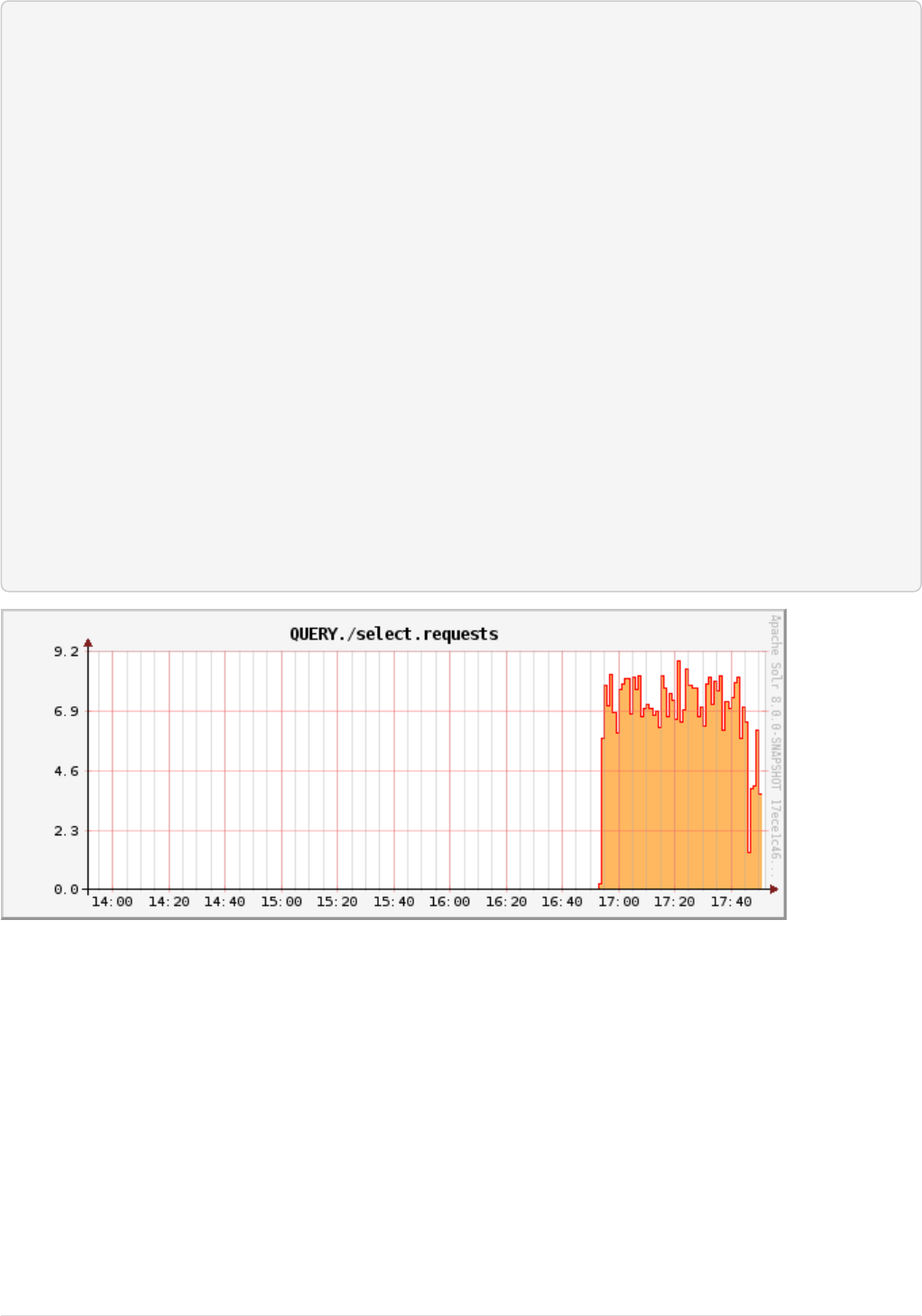
{
Ê "responseHeader": {
Ê "zkConnected": true,
Ê "status": 0,
Ê "QTime": 2
Ê },
Ê "metrics": {
Ê "solr.collection.gettingstarted": {
Ê "data": {
Ê "RRA:AVERAGE:0.5:1:240": {
Ê "values": {
Ê "numShards": "iVBORw0KGgoAAAANSUhEUgAAAkQAAA...",
Ê "numReplicas": "iVBORw0KGgoAAAANSUhEUgAAAkQA...",
Ê "QUERY./select.requests": "iVBORw0KGgoAAAANS...",
Ê "..."
Ê }
Ê },
Ê "RRA:AVERAGE:0.5:10:288": {
Ê "values": {
Ê "numShards": "iVBORw0KGgoAAAANSUhEUgAAAkQAAA...",
Ê "..."
Ê }
Ê }}}}}
Example 60 sec resolution history graph for QUERY./select.requests metric
Apache Solr Reference Guide 7.7 Page 1341 of 1426
© 2019, Apache Software Foundation Guide Version 7.7 - Published: 2019-03-04
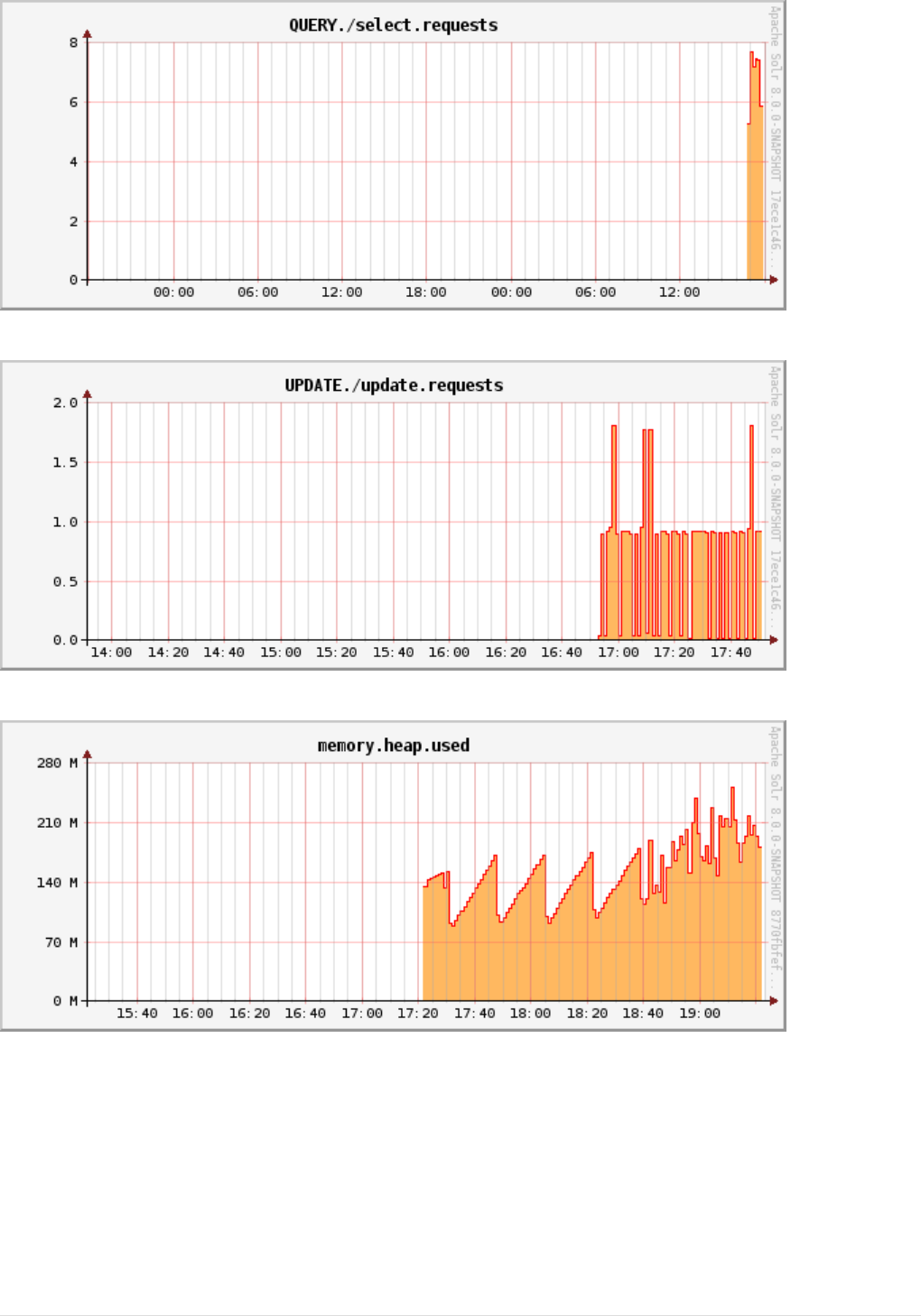
Example 10 min resolution history graph for QUERY./select.requests metric
Example 60 sec resolution history graph for UPDATE./update.requests metric
Example 60 sec resolution history graph for memory.heap.used metric
Page 1342 of 1426 Apache Solr Reference Guide 7.7
Guide Version 7.7 - Published: 2019-03-04 © 2019, Apache Software Foundation
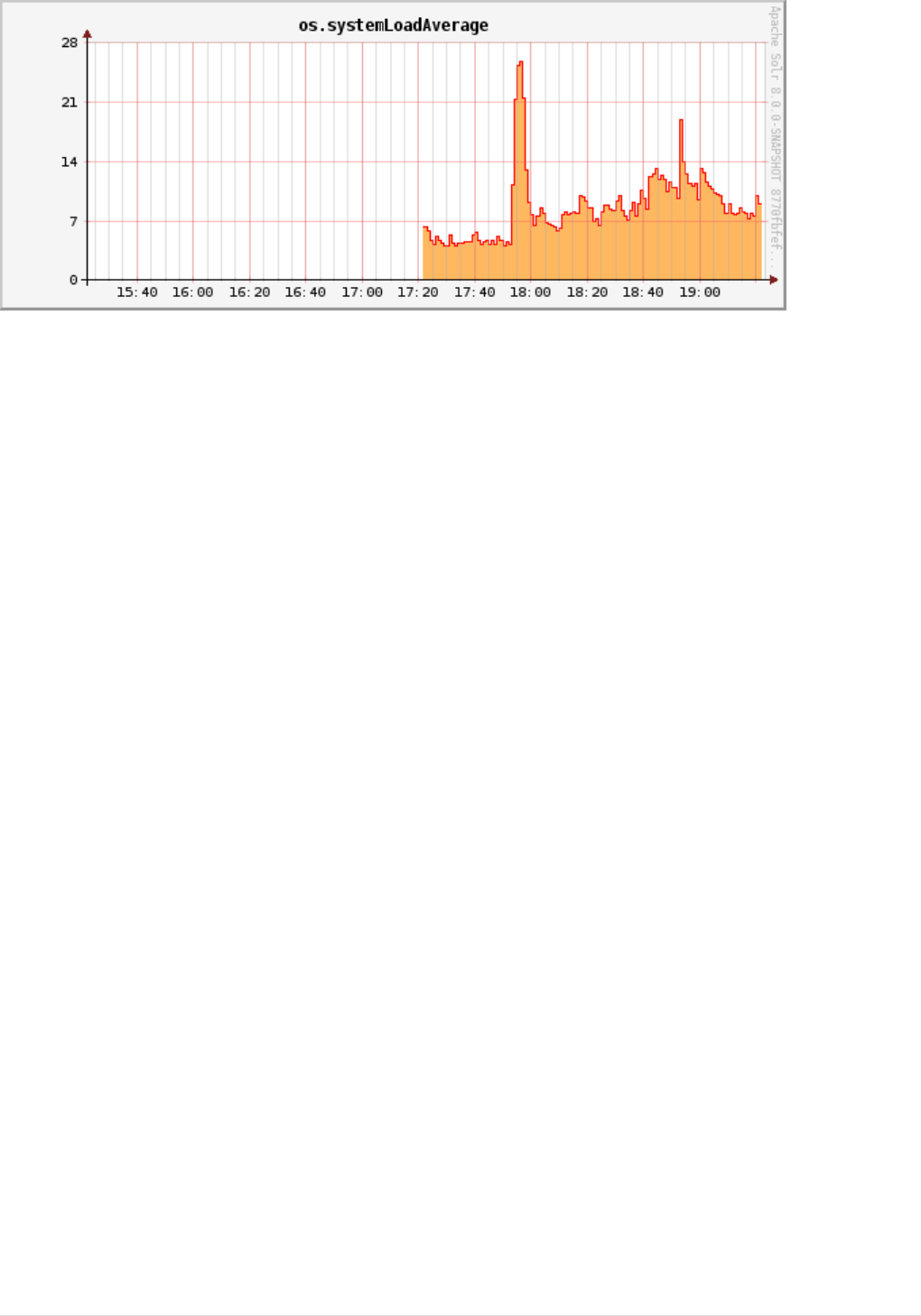
Example 60 sec resolution history graph for os.systemLoadAverage metric
Apache Solr Reference Guide 7.7 Page 1343 of 1426
© 2019, Apache Software Foundation Guide Version 7.7 - Published: 2019-03-04

MBean Request Handler
The MBean Request Handler offers programmatic access to the information provided on the Plugin/Stats
page of the Admin UI.
The MBean Request Handler accepts the following parameters:
key
Restricts results by object key.
cat
Restricts results by category name.
stats
Specifies whether statistics are returned with results. You can override the stats parameter on a per-field
basis. The default is false.
wt
The output format. This operates the same as the wt parameter in a query. The default is json.
MBeanRequestHandler Examples
The following examples assume you are running Solr’s techproducts example configuration:
bin/solr start -e techproducts
To return information about the CACHE category only:
http://localhost:8983/solr/techproducts/admin/mbeans?cat=CACHE
To return information and statistics about the CACHE category only, formatted in XML:
http://localhost:8983/solr/techproducts/admin/mbeans?stats=true&cat=CACHE&wt=xml
To return information for everything, and statistics for everything except the fieldCache:
http://localhost:8983/solr/techproducts/admin/mbeans?stats=true&f.fieldCache.stats=false
To return information and statistics for the fieldCache only:
http://localhost:8983/solr/techproducts/admin/mbeans?key=fieldCache&stats=true
Page 1344 of 1426 Apache Solr Reference Guide 7.7
Guide Version 7.7 - Published: 2019-03-04 © 2019, Apache Software Foundation
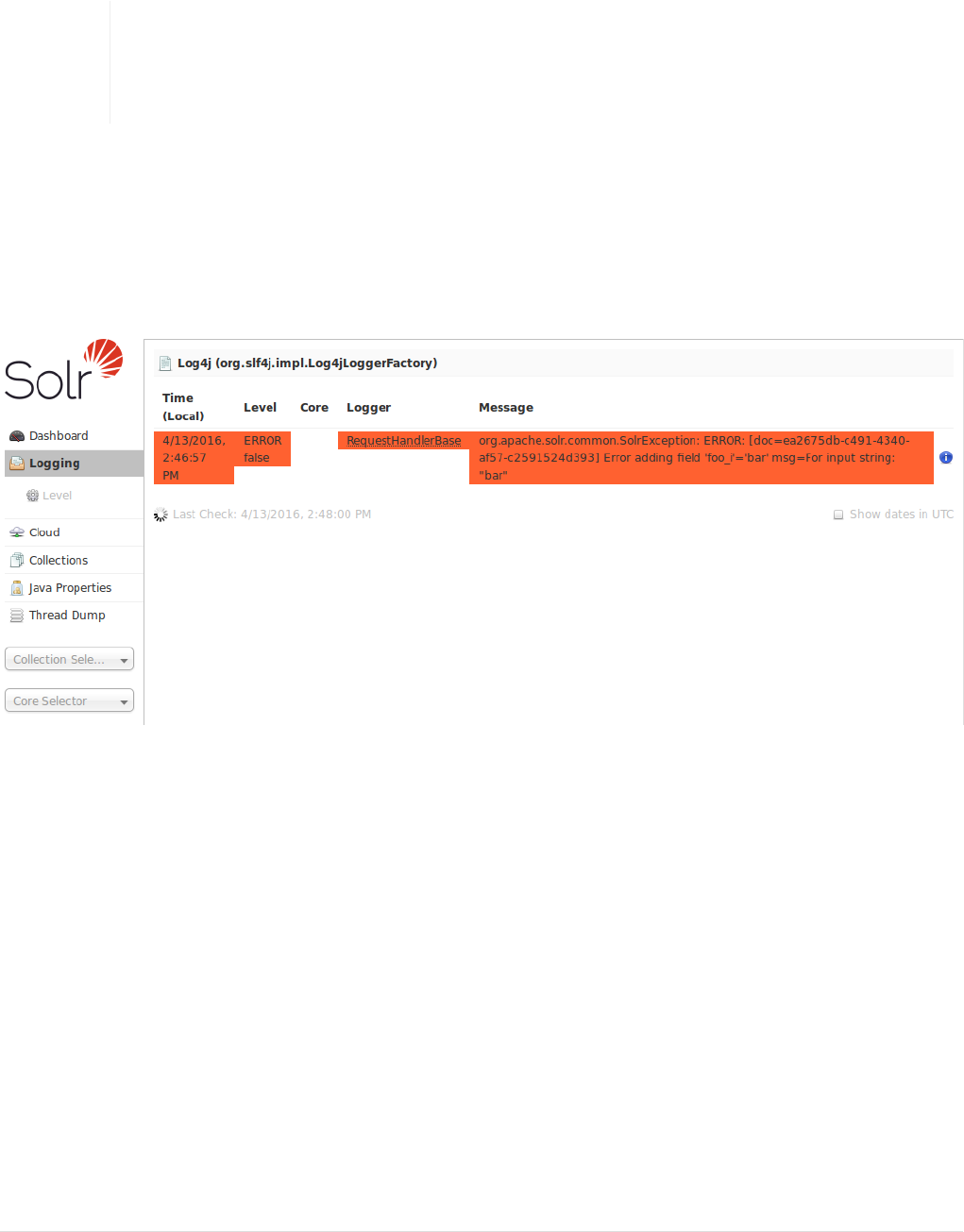
Configuring Logging
Solr logs are a key way to know what’s happening in the system. There are several ways to adjust the default
logging configuration.
In addition to the logging options described below, there is a way to configure which
request parameters (such as parameters sent as part of queries) are logged with an
additional request parameter called logParamsList. See the section on Common Query
Parameters for more information.
Temporary Logging Settings
You can control the amount of logging output in Solr by using the Admin Web interface. Select the LOGGING
link. Note that this page only lets you change settings in the running system and is not saved for the next
run. (For more information about the Admin Web interface, see Using the Solr Administration User
Interface.)
The Logging Screen
This part of the Admin Web interface allows you to set the logging level for many different log categories.
Fortunately, any categories that are unset will have the logging level of its parent. This makes it possible to
change many categories at once by adjusting the logging level of their parent.
When you select Level, you see the following menu:
Apache Solr Reference Guide 7.7 Page 1345 of 1426
© 2019, Apache Software Foundation Guide Version 7.7 - Published: 2019-03-04
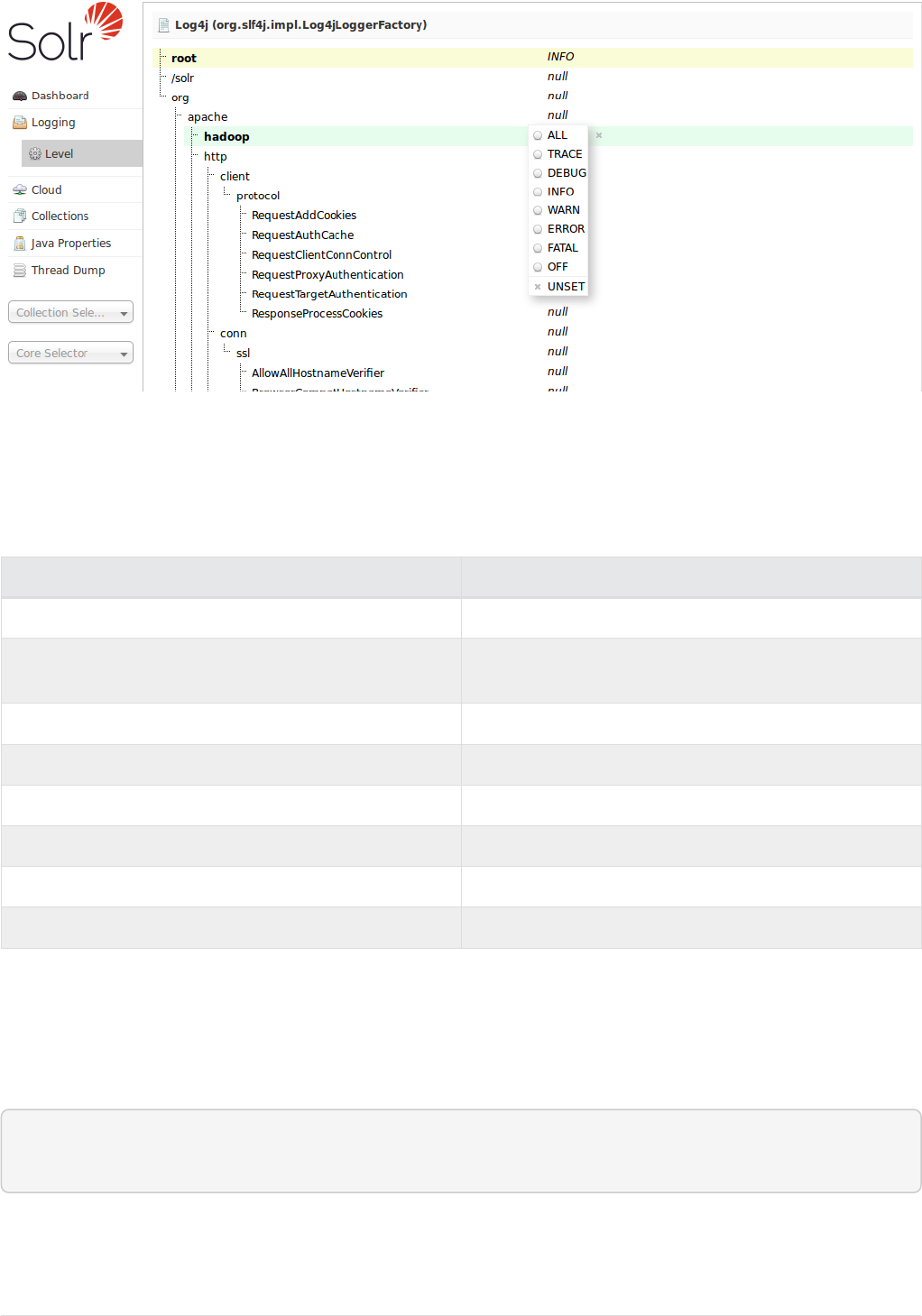
The Log Level Menu
Directories are shown with their current logging levels. The Log Level Menu floats over these. To set a log
level for a particular directory, select it and click the appropriate log level button.
Log levels settings are as follows:
Level Result
FINEST Reports everything.
FINE Reports everything but the least important
messages.
CONFIG Reports configuration errors.
INFO Reports everything but normal status.
WARN Reports all warnings.
SEVERE Reports only the most severe warnings.
OFF Turns off logging.
UNSET Removes the previous log setting.
Multiple settings at one time are allowed.
Loglevel API
There is also a way of sending REST commands to the logging endpoint to do the same. Example:
# Set the root logger to level WARN
curl -s http://localhost:8983/solr/admin/info/logging --data-binary "set=root:WARN"
Page 1346 of 1426 Apache Solr Reference Guide 7.7
Guide Version 7.7 - Published: 2019-03-04 © 2019, Apache Software Foundation

Choosing Log Level at Startup
You can temporarily choose a different logging level as you start Solr. There are two ways:
The first way is to set the SOLR_LOG_LEVEL environment variable before you start Solr, or place the same
variable in bin/solr.in.sh or bin/solr.in.cmd. The variable must contain an uppercase string with a
supported log level (see above).
The second way is to start Solr with the -v or -q options, see Solr Control Script Reference for details.
Examples:
# Start with verbose (DEBUG) looging
bin/solr start -f -v
# Start with quiet (WARN) logging
bin/solr start -f -q
Permanent Logging Settings
Solr uses Log4J version ${ivyversions.org.log4j.major.version} for logging which is configured using
server/resources/log4j2.xml. Take a moment to inspect the contents of the log4j2.xml file so that you
are familiar with its structure. By default, Solr log messages will be written to SOLR_LOGS_DIR/solr.log.
When you’re ready to deploy Solr in production, set the variable SOLR_LOGS_DIR to the location where you
want Solr to write log files, such as /var/solr/logs. You may also want to tweak log4j2.xml. Note that if
you installed Solr as a service using the instructions provided in Taking Solr to Production, then see
/var/solr/log4j2.xml instead of the default server/resources version.
When starting Solr in the foreground (-f option), all logs will be sent to the console, in addition to solr.log.
When starting Solr in the background, it will write all stdout and stderr output to a log file in solr-<port>-
console.log, and automatically disable the CONSOLE logger configured in log4j2.xml, having the same
effect as if you removed the CONSOLE appender from the rootLogger manually.
Also, in log4j2.xml if the default log rotation size threshold of 32MB is too small for production servers then
you should increase it to a larger value (such as 100MB or more).
<SizeBasedTriggeringPolicy size="100 MB"/>
Java Garbage Collection logs are rotated by the JVM when size hits 20M, for a max of 9 generations.
On every startup or restart of Solr, log4j2 performs log rotation. If you choose to use another log framework
that does not support rotation on startup, you may enable SOLR_LOG_PRESTART_ROTATION in
bin/solr.in.sh or bin/solr.in.cmd to let the start script rotate the logs on startup.
Logging Slow Queries
For high-volume search applications, logging every query can generate a large amount of logs and,
depending on the volume, potentially impact performance. If you mine these logs for additional insights into
your application, then logging every query request may be useful.
Apache Solr Reference Guide 7.7 Page 1347 of 1426
© 2019, Apache Software Foundation Guide Version 7.7 - Published: 2019-03-04

On the other hand, if you’re only concerned about warnings and error messages related to requests, then
you can set the log verbosity to WARN. However, this poses a potential problem in that you won’t know if
any queries are slow, as slow queries are still logged at the INFO level.
Solr provides a way to set your log verbosity threshold to WARN and be able to set a latency threshold above
which a request is considered "slow" and log that request at the WARN level to help you identify slow
queries in your application. To enable this behavior, configure the <slowQueryThresholdMillis> element in
the query section of solrconfig.xml:
<slowQueryThresholdMillis>1000</slowQueryThresholdMillis>
Any queries that take longer than the specified threshold will be logged as "slow" queries at the WARN level.
The log file under which you can find all these queries is called solr_slow_requests.log and will be found
in your SOLR_LOGS_DIR (see Permanent Logging Settings for more about defining log locations).
Page 1348 of 1426 Apache Solr Reference Guide 7.7
Guide Version 7.7 - Published: 2019-03-04 © 2019, Apache Software Foundation

Using JMX with Solr
Java Management Extensions (JMX) is a technology that makes it possible for complex systems to be
controlled by tools without the systems and tools having any previous knowledge of each other. In essence,
it is a standard interface by which complex systems can be viewed and manipulated.
Solr, like any other good citizen of the Java universe, can be controlled via a JMX interface. Once enabled, you
can use a JMX client, like jconsole, to connect with Solr.
If you are unfamiliar with JMX, you may find the following overview useful: http://docs.oracle.com/javase/8/
docs/technotes/guides/management/agent.html.
Configuring JMX
JMX support is configured by defining a metrics reporter, as described in the section the section JMX
Reporter.
If you have an existing MBean server running in Solr’s JVM, or if you start Solr with the system property
-Dcom.sun.management.jmxremote, Solr will automatically identify it’s location on startup even if you have
not defined a reporter explicitly in solr.xml. You can also define the location of the MBean server with
parameters defined in the reporter definition.
Configuring MBean Servers
Versions of Solr prior to 7.0 defined JMX support in solrconfig.xml. This has been changed to the metrics
reporter configuration defined above. Parameters for the reporter configuration allow defining the location
or address of an existing MBean server.
An MBean server can be started at the time of Solr’s startup by passing the system parameter
-Dcom.sun.management.jmxremote. See Oracle’s documentation for additional settings available to start and
control an MBean server at http://docs.oracle.com/javase/8/docs/technotes/guides/management/
agent.html.
Configuring a Remote Connection to Solr JMX
If you need to attach a JMX-enabled Java profiling tool, such as JConsole or VisualVM, to a remote Solr server,
then you need to enable remote JMX access when starting the Solr server. Simply change the
ENABLE_REMOTE_JMX_OPTS property in the solr.in.sh or solr.in.cmd (for Windows) file to true. You’ll also
need to choose a port for the JMX RMI connector to bind to, such as 18983. For example, if your Solr include
script sets:
ENABLE_REMOTE_JMX_OPTS=true
RMI_PORT=18983
The JMX RMI connector will allow Java profiling tools to attach to port 18983. When enabled, the following
properties are passed to the JVM when starting Solr:
Apache Solr Reference Guide 7.7 Page 1349 of 1426
© 2019, Apache Software Foundation Guide Version 7.7 - Published: 2019-03-04

-Dcom.sun.management.jmxremote \
-Dcom.sun.management.jmxremote.local.only=false \
-Dcom.sun.management.jmxremote.ssl=false \
-Dcom.sun.management.jmxremote.authenticate=false \
-Dcom.sun.management.jmxremote.port=18983 \
-Dcom.sun.management.jmxremote.rmi.port=18983
We don’t recommend enabling remote JMX access in production, but it can sometimes be useful when doing
performance and user-acceptance testing prior to going into production.
For more information about these settings, see: http://docs.oracle.com/javase/8/docs/technotes/guides/
management/agent.html.
Making JMX connections into machines running behind NATs (e.g., Amazon’s EC2 service) is
not a simple task. The java.rmi.server.hostname system property may help, but running
jconsole on the server itself and using a remote desktop is often the simplest solution. See
http://web.archive.org/web/20130525022506/http://jmsbrdy.com/monitoring-java-
applications-running-on-ec2-i.
Page 1350 of 1426 Apache Solr Reference Guide 7.7
Guide Version 7.7 - Published: 2019-03-04 © 2019, Apache Software Foundation
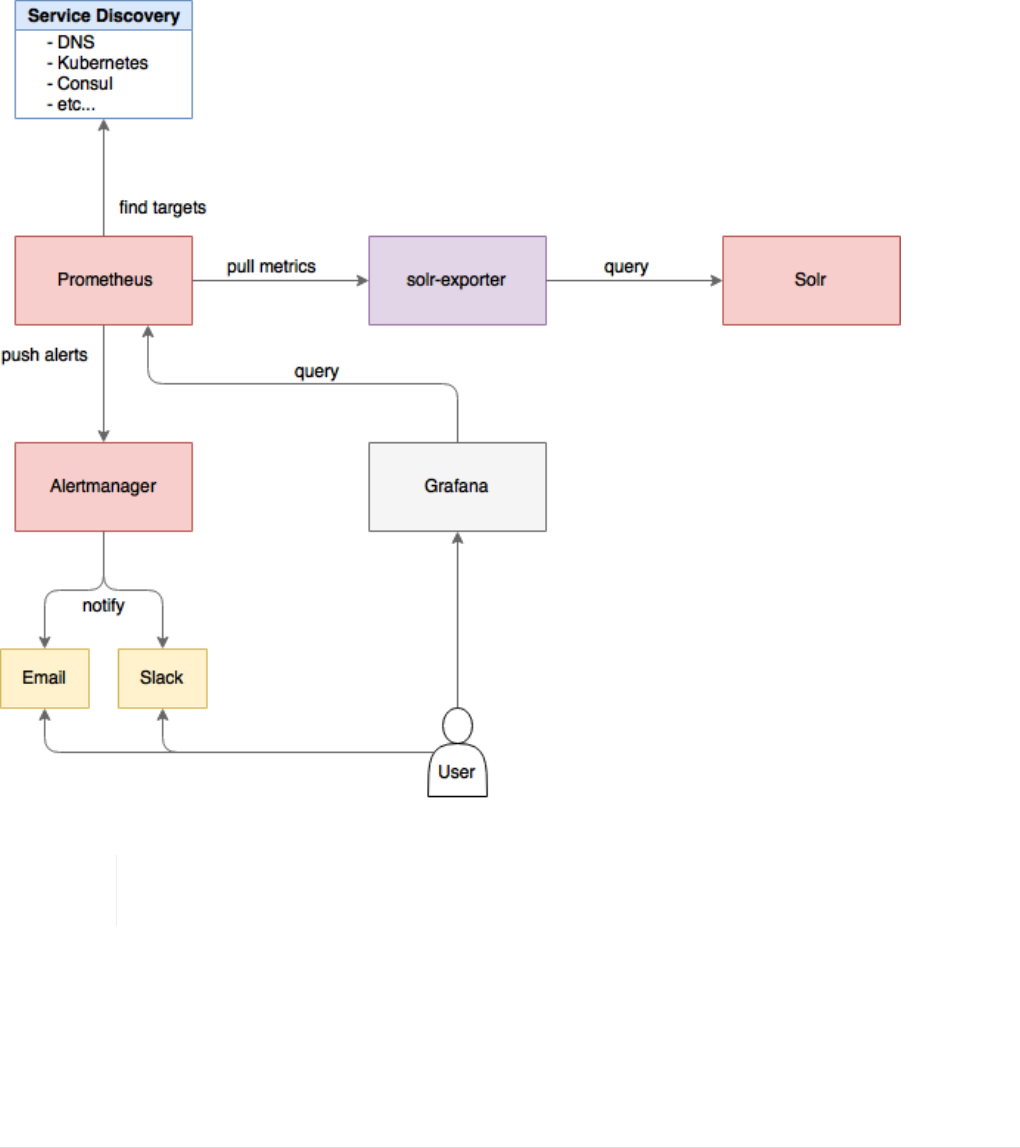
Monitoring Solr with Prometheus and Grafana
If you use Prometheus and Grafana for metrics storage and data visualization, Solr includes a Prometheus
exporter to collect metrics and other data.
A Prometheus exporter (solr-exporter) allows users to monitor not only Solr metrics which come from
Metrics API, but also facet counts which come from Searching and responses to Collections API commands
and PingRequestHandler requests.
This graphic provides a more detailed view:
solr-exporter Diagram
This feature is considered experimental, meaning future improvements may break
compatibility.
The Prometheus exporter is included in Solr as a contrib, and is located in contrib/prometheus-exporter in
your Solr instance.
There are three aspects to running solr-exporter:
Apache Solr Reference Guide 7.7 Page 1351 of 1426
© 2019, Apache Software Foundation Guide Version 7.7 - Published: 2019-03-04

•Modify the solr-exporter-config.xml to define the data to collect. Solr has a default configuration you
can use, but if you would like to modify it before running the exporter the first time, see the section
below Exporter Configuration.
•Start the exporter from within Solr. See the section below Starting the Exporter.
•Modify your Prometheus configuration to listen on the correct port. See the section below Prometheus
Configuration
Starting the Exporter
You can start solr-exporter by running ./bin/solr-exporter (Linux) or .\bin\solr-exporter.cmd
(Windows) from the contrib/prometheus-exporter directory.
See the commands below depending on your operating system and Solr operating mode:
Linux
Standalone mode
$ cd contrib/prometheus-exporter
$ ./bin/solr-exporter -p 9854 -b http://localhost:8983/solr -f ./conf/solr-exporter-
config.xml -n 8
SolrCloud mode
$ cd contrib/prometheus-exporter
$ ./bin/solr-exporter -p 9854 -z localhost:2181/solr -f ./conf/solr-exporter-config.xml -n 16
Windows
Standalone mode
> cd contrib\prometheus-exporter
> .\bin\solr-exporter.cmd -p 9854 -b http://localhost:8983/solr -f .\conf\solr-exporter-
config.xml -n 8
SolrCloud mode
> cd contrib\prometheus-exporter
> .\bin\solr-exporter -p 9854 -z localhost:2181/solr -f .\conf\solr-exporter-config.xml -n 16
Command Line Parameters
The parameters in the example start commands shown above:
h, --help
Page 1352 of 1426 Apache Solr Reference Guide 7.7
Guide Version 7.7 - Published: 2019-03-04 © 2019, Apache Software Foundation

Displays command line help and usage.
-p, --port
The port where Prometheus will listen for new data. This port will be used to configure Prometheus. It
can be any port not already in use on your server. The default is 9983.
-b, --baseurl
The Solr base URL (such as http://localhost:8983/solr) when Solr is running in Standalone mode. If
you are running Solr in SolrCloud mode, do not specify this parameter. If neither the -b parameter nor
the -z parameter are defined, the default is -b http://localhost:8983/solr.
-z, --zkhost
The ZooKeeper connect string (such as localhost:8983, or localhost:2181/solr) when Solr is running
in SolrCloud mode. If you are running Solr in Standalone mode, do not specify this parameter. If neither
the -b parameter nor the -z parameter are defined, the -b parameter default is used.
-f, --config-file
The path to the configuration file that defines the Solr metrics to read. The default is
contrib/prometheus-exporter/conf/solr-exporter-config.xml.
-n, --num-threads
The number of threads. The solr-exporter creates thread pools for requests to Solr. Request latency can
be improved by increasing the number of threads. The default is 1.
The Solr’s metrics exposed by solr-exporter can be seen at:
http://localhost:9983/solr/admin/metrics.
Exporter Configuration
The configuration for the solr-exporter defines the data to get from Solr. This includes the metrics, but can
also include queries to the PingRequestHandler, the Collections API, and a query to any query request
handler.
A default example configuration is in contrib/prometheus-exporter/config/solr-exporter-config.xml.
Below is a slightly shortened version of it:
<config>
Ê <rules>
Ê <ping>
Ê <lst name="request">
Ê <lst name="query">
Ê <str name="path">/admin/ping</str>
Ê </lst>
Ê <arr name="jsonQueries">
Ê <str>
Ê . as $object | $object |
Ê (if $object.status == "OK" then 1.0 else 0.0 end) as $value |
Ê {
Apache Solr Reference Guide 7.7 Page 1353 of 1426
© 2019, Apache Software Foundation Guide Version 7.7 - Published: 2019-03-04

Ê name : "solr_ping",
Ê type : "GAUGE",
Ê help : "See following URL: https://lucene.apache.org/solr/guide/ping.html",
Ê label_names : [],
Ê label_values : [],
Ê value : $value
Ê }
Ê </str>
Ê </arr>
Ê </lst>
Ê </ping>
Ê <metrics>
Ê <lst name="request">
Ê <lst name="query">
Ê <str name="path">/admin/metrics</str>
Ê <lst name="params">
Ê <str name="group">all</str>
Ê <str name="type">all</str>
Ê <str name="prefix"></str>
Ê <str name="property"></str>
Ê </lst>
Ê </lst>
Ê <arr name="jsonQueries">
Ê <!--
Ê jetty metrics
Ê -->
Ê <str>
Ê .metrics["solr.jetty"] | to_entries | .[] | select(.key |
startswith("org.eclipse.jetty.server.handler.DefaultHandler")) | select(.key | endswith("xx-
responses")) as $object |
Ê $object.key | split(".") | last | split("-") | first as $status |
Ê $object.value.count as $value |
Ê {
Ê name : "solr_metrics_jetty_response_total",
Ê type : "COUNTER",
Ê help : "See following URL: https://lucene.apache.org/solr/guide/metrics-
reporting.html",
Ê label_names : ["status"],
Ê label_values : [$status],
Ê value : $value
Ê }
Ê </str>
...
Ê </arr>
Ê </lst>
Ê </metrics>
Ê <collections>
Ê <lst name="request">
Ê <lst name="query">
Ê <str name="path">/admin/collections</str>
Page 1354 of 1426 Apache Solr Reference Guide 7.7
Guide Version 7.7 - Published: 2019-03-04 © 2019, Apache Software Foundation

Ê <lst name="params">
Ê <str name="action">CLUSTERSTATUS</str>
Ê </lst>
Ê </lst>
Ê <arr name="jsonQueries">
Ê <str>
Ê .cluster.live_nodes | length as $value|
Ê {
Ê name : "solr_collections_live_nodes",
Ê type : "GAUGE",
Ê help : "See following URL:
https://lucene.apache.org/solr/guide/collections-api.html#clusterstatus",
Ê label_names : [],
Ê label_values : [],
Ê value : $value
Ê }
Ê </str>
...
Ê </arr>
Ê </lst>
Ê </collections>
Ê <search>
Ê <lst name="request">
Ê <lst name="query">
Ê <str name="collection">collection1</str>
Ê <str name="path">/select</str>
Ê <lst name="params">
Ê <str name="q">*:*</str>
Ê <str name="start">0</str>
Ê <str name="rows">0</str>
Ê <str name="json.facet">
Ê {
Ê category: {
Ê type: terms,
Ê field: cat
Ê }
Ê }
Ê </str>
Ê </lst>
Ê </lst>
Ê <arr name="jsonQueries">
Ê <str>
Ê .facets.category.buckets[] as $object |
Ê $object.val as $term |
Ê $object.count as $value |
Ê {
Ê name : "solr_facets_category",
Ê type : "GAUGE",
Ê help : "Category facets",
Ê label_names : ["term"],
Ê label_values : [$term],
Apache Solr Reference Guide 7.7 Page 1355 of 1426
© 2019, Apache Software Foundation Guide Version 7.7 - Published: 2019-03-04

Ê value : $value
Ê }
Ê </str>
Ê </arr>
Ê </lst>
Ê </search>
Ê </rules>
</config>
Configuration Tags and Elements
The solr-exporter works by making a request to Solr according to the definitions in the configuration file,
scraping the response, and converting it to a JSON structure Prometheus can understand. The configuration
file defines the elements to request, how to scrape them, and where to place the extracted data in the JSON
template.
The solr-exporter configuration file always starts and closes with two simple elements:
<config>
Ê <rules>
Ê </rules>
</config>
Between these elements, the data the solr-exporter should request is defined. There are several possible
types of requests to make:
<ping>
Scrape the response to a PingRequestHandler request.
<metrics>
Scrape the response to a Metrics API request.
<collections>
Scrape the response to a Collections API request.
<search>
Scrape the response to a search request.
Within each of these types, we need to define the query and how to work with the response. To do this, we
define two additional elements:
<query>
Defines the query parameter(s) used for the request. This section uses several additional properties to
define your query:
collection
The collection to issue the query against. Only used in SolrCloud mode.
Page 1356 of 1426 Apache Solr Reference Guide 7.7
Guide Version 7.7 - Published: 2019-03-04 © 2019, Apache Software Foundation

core
The core to issue the query against. Only used in Standalone mode.
path
The path to the query endpoint where the request will be sent. Examples include admin/metrics or
/select or admin/collections.
params
Additional query parameters. These will vary depending on the request type and the endpoint. For
example, if using the Metrics endpoint, you can add parameters to limit the query to a certain group
and/or prefix. If you’re using the Collections API, the command you want to use would be a
parameter.
<jsonQueries>
This is an array that defines one or more JSON Queries in jq syntax. For more details about how to
structure these queries, see the jq user manual.
A jq query has to output JSON in the following format:
{
Ê "name": "solr_ping",
Ê "type": "GAUGE",
Ê "help": "See following URL: https://lucene.apache.org/solr/guide/ping.html",
Ê "label_names": ["base_url","core"],
Ê "label_values": ["http://localhost:8983/solr","collection1"],
Ê "value": 1.0
}
See the section Exposition Format below for information about what information should go into each
property, and an example of how the above example is translated for Prometheus.
Exposition Format
The solr-exporter converts the JSON to the following exposition format:
# TYPE <name> <type>
# HELP <name> <help>
<name>{<label_names[0]>=<label_values[0]>,<label_names[1]>=<labelvalues[1]>,...} <value>
The following parameters should be set:
name
The metric name to set. For more details, see Prometheus naming best practices.
type
The type of the metric, can be COUNTER, GAUGE, SUMMARY, HISTOGRAM or UNTYPED. For more details, see
Prometheus metric types.
help
Apache Solr Reference Guide 7.7 Page 1357 of 1426
© 2019, Apache Software Foundation Guide Version 7.7 - Published: 2019-03-04

Help text for the metric.
label_names
Label names for the metric. For more details, see Prometheus naming best practices.
label_values
Label values for the metric. For more details, see Prometheus naming best practices.
value
Value for the metric. Value must be set to Double type.
For example, solr-exporter converts the JSON in the previous section to the following:
# TYPE solr_ping gauge
# HELP solr_ping See following URL: https://lucene.apache.org/solr/guide/ping.html
solr_ping{base_url="http://localhost:8983/solr",core="collection1"} 1.0
Prometheus Configuration
In order for Prometheus to know about the solr-exporter, the listen address must be added to
prometheus.yml, as in this example:
scrape_configs:
Ê - job_name: 'solr'
Ê static_configs:
Ê - targets: ['localhost:9854']
If you already have a section for scrape_configs, you can add the job_name and other values in the same
section.
When you apply the settings to Prometheus, it will start to pull Solr’s metrics from solr-exporter.
Sample Grafana Dashboard
A Grafana sample dashboard is provided in the following JSON file: contrib/prometheus-
exporter/conf/grafana-solr-dashboard.json. You can place this with your other Grafana dashboard
configurations and modify it as necessary depending on any customization you’ve done for the solr-
exporter configuration.
This screenshot shows what it might look like:
Page 1358 of 1426 Apache Solr Reference Guide 7.7
Guide Version 7.7 - Published: 2019-03-04 © 2019, Apache Software Foundation
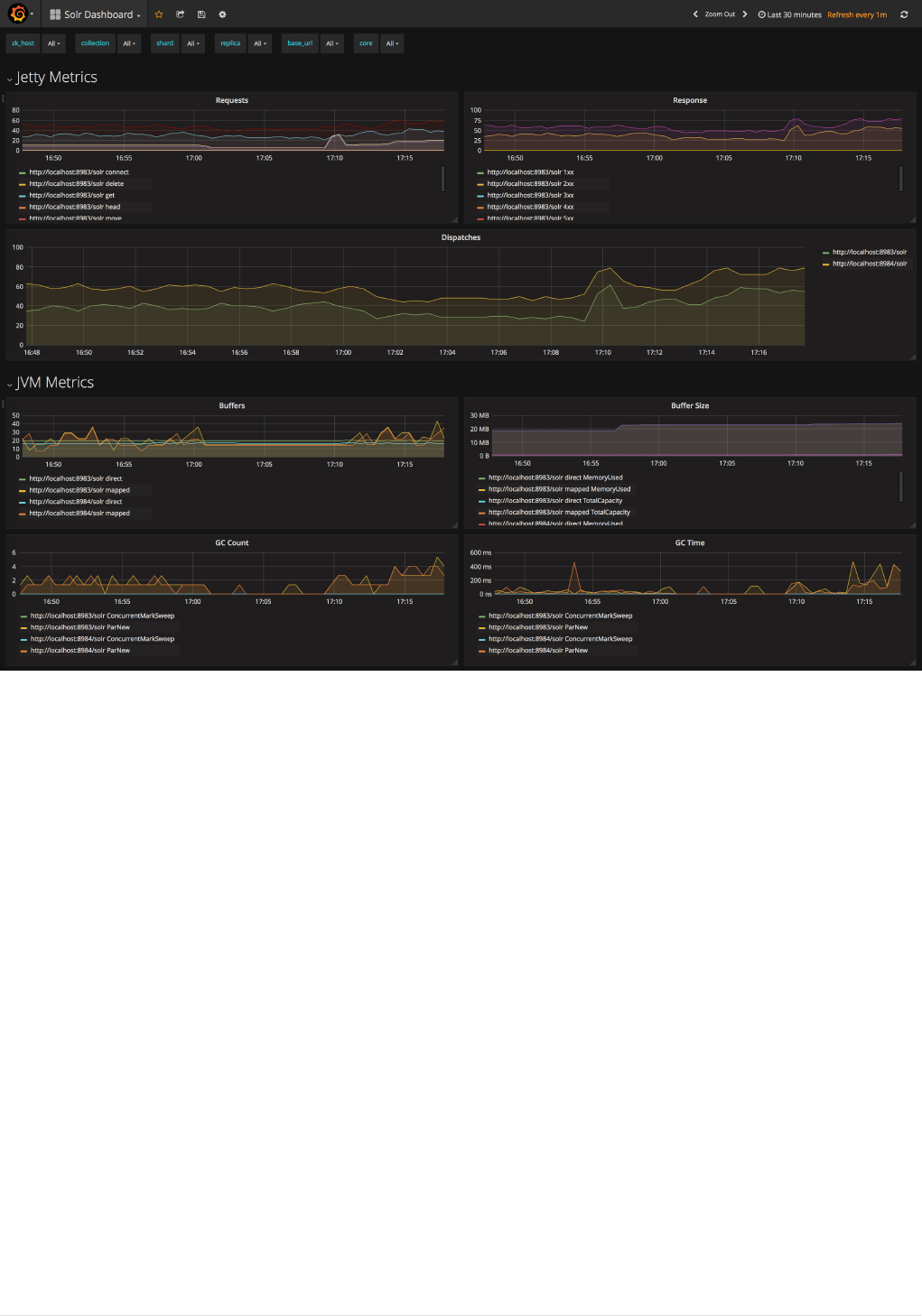
Grafana Dashboard
Apache Solr Reference Guide 7.7 Page 1359 of 1426
© 2019, Apache Software Foundation Guide Version 7.7 - Published: 2019-03-04

Performance Statistics Reference
This page explains some of the statistics that Solr exposes.
There are two approaches to retrieving metrics. First, you can use the Metrics API, or you can enable JMX
and get metrics from the MBean Request Handler or via an external tool such as JConsole. The below
descriptions focus on retrieving the metrics using the Metrics API, but the metric names are the same if
using the MBean Request Handler or an external tool.
These statistics are per core. When you are running in SolrCloud mode these statistics would co-relate to the
performance of an individual replica.
Request Handler Statistics
Update Request Handler
The update request handler is an endpoint to send data to Solr. We can see how many update requests are
being fired, how fast is it performing, and other valuable information regarding requests.
Registry & Path: solr.<core>:UPDATE./update
You can request update request handler statistics with an API request such as
http://localhost:8983/solr/admin/metrics?group=core&prefix=UPDATE.
Search Request Handler
Can be useful to measure and track number of search queries, response times, etc. If you are not using the
“select” handler then the path needs to be changed appropriately. Similarly if you are using the “sql”
handler or “export” handler, the realtime handler “get”, or any other handler similar statistics can be found
for that as well.
Registry & Path: solr.<core>:QUERY./select
You can request statistics for the /select request handler with an API request such as
http://localhost:8983/solr/admin/metrics?group=core&prefix=QUERY./select.
Commonly Used Stats for Request Handlers
All of the update and search request handlers will provide the following statistics.
Request Times
To get request times, specifically, you can send an API request such as:
•http://localhost:8983/solr/admin/metrics?group=core&prefix=UPDATE./update.requestTimes
•http://localhost:8983/solr/admin/metrics?group=core&prefix=QUERY./select.requestTimes
Attribute Description
15minRate Requests per second received over the past 15 minutes.
Page 1360 of 1426 Apache Solr Reference Guide 7.7
Guide Version 7.7 - Published: 2019-03-04 © 2019, Apache Software Foundation

Attribute Description
5minRate Requests per second received over the past 5 minutes.
p75_ms Request processing time for the request which belongs to the 75th Percentile.
E.g., if 100 requests are received, then the 75th fastest request time will be
reported by this statistic.
p95_ms Request processing time in milliseconds for the request which belongs to the
95th Percentile. E.g., if 100 requests are received, then the 95th fastest request
time will be reported in this statistic.
p999_ms Request processing time in milliseconds for the request which belongs to the
99.9th Percentile. E.g., if 1000 requests are received, then the 999th fastest
request time will be reported in this statistic.
p99_ms Request processing time in milliseconds for the request which belongs to the
99th Percentile. E.g., if 100 requests are received, then the 99th fastest request
time will be reported in this statistic.
count Total number of requests made since the Solr process was started.
median_ms Median of all the request processing time.
avgRequestsPerSecond Average number of requests received per second.
avgTimePerRequest Average time taken for processing the requests. This parameter will decay over
time, with a bias toward activity in the last 5 minutes.
Errors and Other Times
Other types of data such as errors and timeouts are also provided. These are available under different
metric names. For example:
•http://localhost:8983/solr/admin/metrics?group=core&prefix=UPDATE./update.errors
•http://localhost:8983/solr/admin/metrics?group=core&prefix=QUERY./select.errors
The table below shows the metric names and attributes to request:
Metric name Description
QUERY./select.errors
UPDATE./update.errors
Number of errors encountered by handler. In addition to a count of errors,
mean, 1 minute, 5 minute, and 15 minute rates are also available.
QUERY./select.clientErrors
UPDATE./update.clientError
s
Number of syntax or parse errors made by a client while making requests.
In addition to a count of errors, mean, 1 minute, 5 minute, and 15 minute
rates are also available.
QUERY./select.serverErrors
UPDATE./update.serverError
s
Number of errors thrown by the server while executing the request. In
addition to a count of errors, mean, 1 minute, 5 minute, and 15 minute
rates are also available.
QUERY./select.timeouts
UPDATE./update.timeouts
Number of responses received with partial results. In addition to a count
of timeout events, mean, 1 minute, 5 minute, and 15 minute rates are also
available.
Apache Solr Reference Guide 7.7 Page 1361 of 1426
© 2019, Apache Software Foundation Guide Version 7.7 - Published: 2019-03-04

Metric name Description
QUERY./select.totalTime
UPDATE./update.totalTime
The sum of all request processing times since the Solr process was started.
QUERY./select.handlerStart
UPDATE./update.handlerStar
t
Epoch time when the handler was registered.
Update Handler
This section has information on the total number of adds and how many commits have been fired against a
Solr core.
Registry & Path: solr.<core>:UPDATE.updateHandler
You can get all update handler statistics shown in the table below with an API request such as
http://localhost:8983/solr/admin/metrics?group=core&prefix=UPDATE.updateHandler.
The following describes the specific statistics you can get:
Attribute Description
UPDATE.updateHandler.adds Total number of “add” requests since last commit.
UPDATE.updateHandler.autoCommitMaxTi
me Maximum time between two auto-commits execution.
UPDATE.updateHandler.autoCommits Total number of auto-commits executed.
UPDATE.updateHandler.commits Number of total commits executed.
In addition to a count of commits, mean, 1 minute, 5 minute,
and 15 minute rates are also available.
UPDATE.updateHandler.cumulativeAdds Number of “effective” additions executed over the lifetime. The
counter is incremented when “add‘ command is executed while
decremented when “rollback” is executed.
In addition to a count of adds, mean, 1 minute, 5 minute, and 15
minute rates are also available.
UPDATE.updateHandler.cumulativeDelet
esById Number of document deletions executed by ID over the
lifetime. The counter is incremented when “delete” command is
executed and decremented when “rollback” is executed.
In addition to a count of deletes, mean, 1 minute, 5 minute, and
15 minute rates are also available.
UPDATE.updateHandler.cumulativeDelet
esByQuery Number of document deletions executed by query over the
lifetime. The counter is incremented when “delete” command is
executed and decremented when “rollback” is executed.
In addition to a count of deletes, mean, 1 minute, 5 minute, and
15 minute rates are also available.
Page 1362 of 1426 Apache Solr Reference Guide 7.7
Guide Version 7.7 - Published: 2019-03-04 © 2019, Apache Software Foundation

Attribute Description
UPDATE.updateHandler.cumulativeError
sNumber of error messages received while performing
addition/deletion actions on documents over the lifetime.
In addition to a count of errors, mean, 1 minute, 5 minute, and
15 minute rates are also available.
UPDATE.updateHandler.deletesById Currently uncommitted deletions by ID.
UPDATE.updateHandler.deletesByQuery Currently uncommitted deletions by query.
UPDATE.updateHandler.docsPending Number of documents which are pending commit.
UPDATE.updateHandler.errors Number of error messages received while performing
addition/deletion/commit/rollback actions on documents over
the lifetime of the core.
UPDATE.updateHandler.expungeDeletes Number of commit commands issued with expunge deletes.
In addition to a count of expunge deletes, mean, 1 minute, 5
minute, and 15 minute rates are also available.
UPDATE.updateHandler.merges Number of index merges that have occurred.
In addition to a count of merges, mean, 1 minute, 5 minute, and
15 minute rates are also available.
UPDATE.updateHandler.optimizes Number of explicit optimize commands issued.
In addition to a count of optimizations, mean, 1 minute, 5
minute, and 15 minute rates are also available.
UPDATE.updateHandler.rollbacks Number of rollbacks executed.
In addition to a count of rollbacks, mean, 1 minute, 5 minute,
and 15 minute rates are also available.
UPDATE.updateHandler.softAutoCommitM
axTime Maximum document ‘adds’ between two soft auto-commits.
UPDATE.updateHandler.softAutoCommits Number of soft commits executed.
Cache Statistics
Document Cache
This cache holds Lucene Document objects (the stored fields for each document). Since Lucene internal
document IDs are transient, this cache cannot be auto-warmed.
Registry and Path: solr.<core>:CACHE.searcher.documentCache
You can get the statistics shown in the table below with an API request such as
http://localhost:8983/solr/admin/metrics?group=core&prefix=CACHE.searcher.documentCache.
Apache Solr Reference Guide 7.7 Page 1363 of 1426
© 2019, Apache Software Foundation Guide Version 7.7 - Published: 2019-03-04

Query Result Cache
This cache holds the results of previous searches: ordered lists of document IDs based on a query, a sort,
and the range of documents requested
Registry and Path: solr.<core>:CACHE.searcher.queryResultCache
You can get the statistics shown in the table below with an API request such as
http://localhost:8983/solr/admin/metrics?group=core&prefix=CACHE.searcher.queryResultCache.
Filter Cache
This cache is used for filters for unordered sets of all documents that match a query.
Registry and Path: solr.<core>:CACHE.searcher.filterCache
You can get the statistics shown in the table below with an API request such as
http://localhost:8983/solr/admin/metrics?group=core&prefix=CACHE.searcher.filterCache.
Statistics for Caches
The following statistics are available for each of the caches mentioned above:
Attribute Description
cumulative_evictions Number of cache evictions across all caches since this node has been running.
cumulative_hitratio Ratio of cache hits to lookups across all the caches since this node has been
running.
cumulative_hits Number of cache hits across all the caches since this node has been running.
cumulative_inserts Number of cache insertions across all the caches since this node has been
running.
cumulative_lookups Number of cache lookups across all the caches since this node has been
running.
evictions Number of cache evictions for the current index searcher.
hitratio Ratio of cache hits to lookups for the current index searcher.
hits Number of hits for the current index searcher.
inserts Number of inserts into the cache.
lookups Number of lookups against the cache.
size Number of entries in the cache at that particular instance.
warmupTime Warm-up time for the registered index searcher. This time is taken in account
for the “auto-warming” of caches.
When eviction by heap usage is enabled, the following additional statistics are available for the Query Result
Cache:
Page 1364 of 1426 Apache Solr Reference Guide 7.7
Guide Version 7.7 - Published: 2019-03-04 © 2019, Apache Software Foundation

Attribute Description
maxRamMB Maximum heap that should be used by the cache beyond which keys will be
evicted.
ramBytesUsed Actual heap usage of the cache at that particular instance.
evictionsRamUsage Number of cache evictions for the current index searcher because heap usage
exceeded maxRamMB.
More information on Solr caches is available in the section Query Settings in SolrConfig.
Apache Solr Reference Guide 7.7 Page 1365 of 1426
© 2019, Apache Software Foundation Guide Version 7.7 - Published: 2019-03-04

Securing Solr
When planning how to secure Solr, you should consider which of the available features or approaches are
right for you.
•Authentication or authorization of users using:
◦Kerberos Authentication Plugin
◦Basic Authentication Plugin
◦Rule-Based Authorization Plugin
◦Custom authentication or authorization plugin
•Enabling SSL
•If using SolrCloud, ZooKeeper Access Control
No Solr API, including the Admin UI, is designed to be exposed to non-trusted parties. Tune
your firewall so that only trusted computers and people are allowed access. Because of this,
the project will not regard e.g., Admin UI XSS issues as security vulnerabilities. However, we
still ask you to report such issues in JIRA.
Page 1366 of 1426 Apache Solr Reference Guide 7.7
Guide Version 7.7 - Published: 2019-03-04 © 2019, Apache Software Foundation

Authentication and Authorization Plugins
Solr has security frameworks for supporting authentication and authorization of users. This allows for
verifying a user’s identity and for restricting access to resources in a Solr cluster.
Solr includes some plugins out of the box, and additional plugins can be developed using the authentication
and authorization frameworks described below.
All authentication and authorization plugins can work with Solr whether they are running in SolrCloud mode
or standalone mode. All authentication and authorization configuration, including users and permission
rules, are stored in a file named security.json. When using Solr in standalone mode, this file must be in the
$SOLR_HOME directory (usually server/solr). When using SolrCloud, this file must be located in ZooKeeper.
The following section describes how to enable plugins with security.json and place them in the proper
locations for your mode of operation.
Enable Plugins with security.json
All of the information required to initialize either type of security plugin is stored in a security.json file.
This file contains 2 sections, one each for authentication and authorization.
Sample security.json
{
Ê "authentication" : {
Ê "class": "class.that.implements.authentication"
Ê },
Ê "authorization": {
Ê "class": "class.that.implements.authorization"
Ê }
}
The /security.json file needs to be in the proper location before a Solr instance comes up so Solr starts
with the security plugin enabled. See the section Using security.json with Solr below for information on how
to do this.
Depending on the plugin(s) in use, other information will be stored in security.json such as user
information or rules to create roles and permissions. This information is added through the APIs for each
plugin provided by Solr, or, in the case of a custom plugin, the approach designed by you.
Here is a more detailed security.json example. In this, the Basic authentication and rule-based
authorization plugins are enabled, and some data has been added:
Apache Solr Reference Guide 7.7 Page 1367 of 1426
© 2019, Apache Software Foundation Guide Version 7.7 - Published: 2019-03-04

{
"authentication":{
Ê "class":"solr.BasicAuthPlugin",
Ê "credentials":{"solr":"IV0EHq1OnNrj6gvRCwvFwTrZ1+z1oBbnQdiVC3otuq0=
Ndd7LKvVBAaZIF0QAVi1ekCfAJXr1GGfLtRUXhgrF8c="}
},
"authorization":{
Ê "class":"solr.RuleBasedAuthorizationPlugin",
Ê "permissions":[{"name":"security-edit",
Ê "role":"admin"}],
Ê "user-role":{"solr":"admin"}
}}
Using security.json with Solr
In SolrCloud Mode
While configuring Solr to use an authentication or authorization plugin, you will need to upload a
security.json file to ZooKeeper. The following command writes the file as it uploads it - you could also
upload a file that you have already created locally.
>server/scripts/cloud-scripts/zkcli.sh -zkhost localhost:2181 -cmd put /security.json
Ê '{"authentication": {"class": "org.apache.solr.security.KerberosPlugin"}}'
Note that this example defines the KerberosPlugin for authentication. You will want to modify this section
as appropriate for the plugin you are using.
This example also defines security.json on the command line, but you can also define a file locally and
upload it to ZooKeeper.
Depending on the authentication and authorization plugin that you use, you may have user
information stored in security.json. If so, we highly recommend that you implement
access control in your ZooKeeper nodes. Information about how to enable this is available
in the section ZooKeeper Access Control.
Once security.json has been uploaded to ZooKeeper, you should use the appropriate APIs for the plugins
you’re using to update it. You can edit it manually, but you must take care to remove any version data so it
will be properly updated across all ZooKeeper nodes. The version data is found at the end of the
security.json file, and will appear as the letter "v" followed by a number, such as {"v":138}.
In Standalone Mode
When running Solr in standalone mode, you need to create the security.json file and put it in the
$SOLR_HOME directory for your installation (this is the same place you have located solr.xml and is usually
server/solr).
If you are using Legacy Scaling and Distribution, you will need to place security.json on each node of the
cluster.
Page 1368 of 1426 Apache Solr Reference Guide 7.7
Guide Version 7.7 - Published: 2019-03-04 © 2019, Apache Software Foundation

You can use the authentication and authorization APIs, but if you are using the legacy scaling model, you will
need to make the same API requests on each node separately. You can also edit security.json by hand if
you prefer.
Authentication Plugins
Authentication plugins help in securing the endpoints of Solr by authenticating incoming requests. A custom
plugin can be implemented by extending the AuthenticationPlugin class.
An authentication plugin consists of two parts:
1. Server-side component, which intercepts and authenticates incoming requests to Solr using a
mechanism defined in the plugin, such as Kerberos, Basic Auth or others.
2. Client-side component, i.e., an extension of HttpClientConfigurer, which enables a SolrJ client to make
requests to a secure Solr instance using the authentication mechanism which the server understands.
Enabling a Plugin
•Specify the authentication plugin in /security.json as in this example:
{
Ê "authentication": {
Ê "class": "class.that.implements.authentication",
Ê "other_data" : "..."}
}
•All of the content in the authentication block of security.json would be passed on as a map to the
plugin during initialization.
•An authentication plugin can also be used with a standalone Solr instance by passing in
-DauthenticationPlugin=<plugin class name> during startup.
Available Authentication Plugins
Solr has the following implementations of authentication plugins:
•Kerberos Authentication Plugin
•Basic Authentication Plugin
•Hadoop Authentication Plugin
Authorization
An authorization plugin can be written for Solr by extending the AuthorizationPlugin interface.
Loading a Custom Plugin
•Make sure that the plugin implementation is in the classpath.
•The plugin can then be initialized by specifying the same in security.json in the following manner:
Apache Solr Reference Guide 7.7 Page 1369 of 1426
© 2019, Apache Software Foundation Guide Version 7.7 - Published: 2019-03-04

{
Ê "authorization": {
Ê "class": "org.apache.solr.security.MockAuthorizationPlugin",
Ê "other_data" : "..."}
}
All of the content in the authorization block of security.json would be passed on as a map to the plugin
during initialization.
The authorization plugin is only supported in SolrCloud mode. Also, reloading the plugin
isn’t yet supported and requires a restart of the Solr installation (meaning, the JVM should
be restarted, not simply a core reload).
Available Authorization Plugins
Solr has one implementation of an authorization plugin:
•Rule-Based Authorization Plugin
Authenticating in the Admin UI
Whenever an authentication plugin is enabled, authentication is also required for all or some operations in
the Admin UI. The Admin UI is an AngularJS application running inside your browser, and is treated as any
other external client by Solr.
When authentication is required the Admin UI will presented you with a login dialogue. The authentication
plugins currently supported by the Admin UI are:
•BasicAuthPlugin
If your plugin of choice is not supported, the Admin UI will still let you perform unrestricted operations,
while for restricted operations you will need to interact with Solr by sending HTTP requests instead of
through the graphical user interface of the Admin UI. All operations supported by Admin UI can be
performed through Solr’s RESTful APIs.
Securing Inter-Node Requests
There are a lot of requests that originate from the Solr nodes itself. For example, requests from overseer to
nodes, recovery threads, etc. Each Authentication plugin declares whether it is capable of securing inter-
node requests or not. If not, Solr will fall back to using a special internode authentication mechanism where
each Solr node is a super user and is fully trusted by other Solr nodes, described below.
PKIAuthenticationPlugin
The PKIAuthenticationPlugin is used when there is any request going on between two Solr nodes, and the
configured Authentication plugin does not wish to handle inter-node security.
For each outgoing request PKIAuthenticationPlugin adds a special header 'SolrAuth' which carries the
timestamp and principal encrypted using the private key of that node. The public key is exposed through an
Page 1370 of 1426 Apache Solr Reference Guide 7.7
Guide Version 7.7 - Published: 2019-03-04 © 2019, Apache Software Foundation

API so that any node can read it whenever it needs it. Any node who gets the request with that header,
would get the public key from the sender and decrypt the information. If it is able to decrypt the data, the
request trusted. It is invalid if the timestamp is more than 5 secs old. This assumes that the clocks of
different nodes in the cluster are synchronized.
The timeout is configurable through a system property called pkiauth.ttl. For example, if you wish to
bump up the time-to-live to 10 seconds (10000 milliseconds), start each node with a property '-
Dpkiauth.ttl=10000'.
Basic Authentication Plugin
Solr can support Basic authentication for users with the use of the BasicAuthPlugin.
An authorization plugin is also available to configure Solr with permissions to perform various activities in
the system. The authorization plugin is described in the section Rule-Based Authorization Plugin.
Enable Basic Authentication
To use Basic authentication, you must first create a security.json file. This file and where to put it is
described in detail in the section Enable Plugins with security.json.
For Basic authentication, the security.json file must have an authentication part which defines the class
being used for authentication. Usernames and passwords (as a sha256(password+salt) hash) could be
added when the file is created, or can be added later with the Basic authentication API, described below.
The authorization part is not related to Basic authentication, but is a separate authorization plugin
designed to support fine-grained user access control. For more information, see the section Rule-Based
Authorization Plugin.
An example security.json showing both sections is shown below to show how these plugins can work
together:
{
"authentication":{ ①
Ê "blockUnknown": true, ②
Ê "class":"solr.BasicAuthPlugin",
Ê "credentials":{"solr":"IV0EHq1OnNrj6gvRCwvFwTrZ1+z1oBbnQdiVC3otuq0=
Ndd7LKvVBAaZIF0QAVi1ekCfAJXr1GGfLtRUXhgrF8c="}, ③
Ê "realm":"My Solr users" ④
},
"authorization":{
Ê "class":"solr.RuleBasedAuthorizationPlugin",
Ê "permissions":[{"name":"security-edit",
Ê "role":"admin"}], ⑤
Ê "user-role":{"solr":"admin"} ⑥
}}
There are several things defined in this file:
①Basic authentication and rule-based authorization plugins are enabled.
Apache Solr Reference Guide 7.7 Page 1371 of 1426
© 2019, Apache Software Foundation Guide Version 7.7 - Published: 2019-03-04

②The parameter "blockUnknown":true means that unauthenticated requests are not allowed to pass
through.
③A user called 'solr', with a password 'SolrRocks' has been defined.
④We override the realm property to display another text on the login prompt.
⑤The 'admin' role has been defined, and it has permission to edit security settings.
⑥The 'solr' user has been defined to the 'admin' role.
Save your settings to a file called security.json locally. If you are using Solr in standalone mode, you
should put this file in $SOLR_HOME.
If blockUnknown does not appear in the security.json file, it will default to false. This has the effect of not
requiring authentication at all. In some cases, you may want this; for example, if you want to have
security.json in place but aren’t ready to enable authentication. However, you will want to ensure that this
parameter is set to true in order for authentication to be truly enabled in your system.
If realm is not defined, it will default to solr.
If you are using SolrCloud, you must upload security.json to ZooKeeper. You can use this example
command, ensuring that the ZooKeeper port is correct:
bin/solr zk cp file:path_to_local_security.json zk:/security.json -z localhost:9983
If you have defined ZK_HOST in solr.in.sh/solr.in.cmd (see instructions) you can omit -z
<zk host string> from the above command.
Caveats
There are a few things to keep in mind when using the Basic authentication plugin.
•Credentials are sent in plain text by default. It’s recommended to use SSL for communication when Basic
authentication is enabled, as described in the section Enabling SSL.
•A user who has access to write permissions to security.json will be able to modify all the permissions
and how users have been assigned permissions. Special care should be taken to only grant access to
editing security to appropriate users.
•Your network should, of course, be secure. Even with Basic authentication enabled, you should not
unnecessarily expose Solr to the outside world.
Editing Authentication Plugin Configuration
An Authentication API allows modifying user IDs and passwords. The API provides an endpoint with specific
commands to set user details or delete a user.
API Entry Point
•v1: http://localhost:8983/solr/admin/authentication
•v2: http://localhost:8983/api/cluster/security/authentication
Page 1372 of 1426 Apache Solr Reference Guide 7.7
Guide Version 7.7 - Published: 2019-03-04 © 2019, Apache Software Foundation

This endpoint is not collection-specific, so users are created for the entire Solr cluster. If users need to be
restricted to a specific collection, that can be done with the authorization rules.
Add a User or Edit a Password
The set-user command allows you to add users and change their passwords. For example, the following
defines two users and their passwords:
V1 API
curl --user solr:SolrRocks http://localhost:8983/solr/admin/authentication -H 'Content-
type:application/json' -d '{"set-user": {"tom":"TomIsCool", "harry":"HarrysSecret"}}'
V2 API
curl --user solr:SolrRocks http://localhost:8983/api/cluster/security/authentication -H
'Content-type:application/json' -d '{"set-user": {"tom":"TomIsCool",
"harry":"HarrysSecret"}}'
Delete a User
The delete-user command allows you to remove a user. The user password does not need to be sent to
remove a user. In the following example, we’ve asked that user IDs 'tom' and 'harry' be removed from the
system.
V1 API
curl --user solr:SolrRocks http://localhost:8983/solr/admin/authentication -H 'Content-
type:application/json' -d '{"delete-user": ["tom", "harry"]}'
V2 API
curl --user solr:SolrRocks http://localhost:8983/api/cluster/security/authentication -H
'Content-type:application/json' -d '{"delete-user": ["tom", "harry"]}'
Set a Property
Set properties for the authentication plugin. The currently supported properties for the Basic Authentication
plugin are blockUnknown and realm.
Apache Solr Reference Guide 7.7 Page 1373 of 1426
© 2019, Apache Software Foundation Guide Version 7.7 - Published: 2019-03-04

V1 API
curl --user solr:SolrRocks http://localhost:8983/solr/admin/authentication -H 'Content-
type:application/json' -d '{"set-property": {"blockUnknown":false}}'
V2 API
curl --user solr:SolrRocks http://localhost:8983/api/cluster/security/authentication -H
'Content-type:application/json' -d '{"set-property": {"blockUnknown":false}}'
The authentication realm defaults to solr and is displayed in the WWW-Authenticate HTTP header and in the
Admin UI login page. To change the realm, set the realm property:
V1 API
curl --user solr:SolrRocks http://localhost:8983/solr/admin/authentication -H 'Content-
type:application/json' -d '{"set-property": {"realm":"My Solr users"}}'
V2 API
curl --user solr:SolrRocks http://localhost:8983/api/cluster/security/authentication -H
'Content-type:application/json' -d '{"set-property": {"realm":"My Solr users"}}'
Using Basic Auth with SolrJ
In SolrJ, the basic authentication credentials need to be set for each request as in this example:
SolrRequest req ;//create a new request object
req.setBasicAuthCredentials(userName, password);
solrClient.request(req);
Query example:
QueryRequest req = new QueryRequest(new SolrQuery("*:*"));
req.setBasicAuthCredentials(userName, password);
QueryResponse rsp = req.process(solrClient);
Page 1374 of 1426 Apache Solr Reference Guide 7.7
Guide Version 7.7 - Published: 2019-03-04 © 2019, Apache Software Foundation

Using the Solr Control Script with Basic Auth
Add the following line to the solr.in.sh or solr.in.cmd file. This example tells the bin/solr command line
to to use "basic" as the type of authentication, and to pass credentials with the user-name "solr" and
password "SolrRocks":
SOLR_AUTH_TYPE="basic"
SOLR_AUTHENTICATION_OPTS="-Dbasicauth=solr:SolrRocks"
Hadoop Authentication Plugin
The Hadoop authentication plugin enables Solr to use the Hadoop authentication library for securing Solr
nodes.
This authentication plugin is a thin wrapper that delegates all functionality to the Hadoop authentication
library. All configuration parameters for the library are passed through the plugin.
This plugin can be particularly useful in leveraging an extended set of features or newly available features in
the Hadoop authentication library.
Please note that the version of Hadoop library used by Solr is upgraded periodically. While Solr will ensure
the stability and backwards compatibility of the structure of the plugin configuration (viz., the parameter
names of this plugin), the values of these parameters may change based on the version of Hadoop library.
Please review the Hadoop documentation for the version used by your Solr installation for more details.
For some of the authentication schemes (e.g., Kerberos), Solr provides a native implementation of
authentication plugin. If you require a more stable setup, in terms of configuration, ability to perform rolling
upgrades, backward compatibility, etc., you should consider using such plugin. Please review the section
Authentication and Authorization Plugins for an overview of authentication plugin options in Solr.
There are two plugin classes:
•HadoopAuthPlugin: This can be used with standalone Solr as well as Solrcloud with PKI authentication for
internode communication.
•ConfigurableInternodeAuthHadoopPlugin: This is an extension of HadoopAuthPlugin that allows you to
configure the authentication scheme for internode communication.
For most SolrCloud or standalone Solr setups, the HadoopAuthPlugin should suffice.
Plugin Configuration
class
Should be either solr.HadoopAuthPlugin or solr.ConfigurableInternodeAuthHadoopPlugin. This
parameter is required.
type
The type of authentication scheme to be configured. See configuration options. This parameter is
required.
Apache Solr Reference Guide 7.7 Page 1375 of 1426
© 2019, Apache Software Foundation Guide Version 7.7 - Published: 2019-03-04

sysPropPrefix
The prefix to be used to define the Java system property for configuring the authentication mechanism.
This property is required.
The name of the Java system property is defined by appending the configuration parameter name to this
prefix value. For example, if the prefix is solr then the Java system property solr.kerberos.principal
defines the value of configuration parameter kerberos.principal.
authConfigs
Configuration parameters required by the authentication scheme defined by the type property. This
property is required. For more details, see Hadoop configuration options.
defaultConfigs
Default values for the configuration parameters specified by the authConfigs property. The default
values are specified as a collection of key-value pairs (i.e., "property-name": "default_value").
enableDelegationToken
If true, the delegation tokens functionality will be enabled.
initKerberosZk
For enabling initialization of kerberos before connecting to ZooKeeper (if applicable).
proxyUserConfigs
Configures proxy users for the underlying Hadoop authentication mechanism. This configuration is
expressed as a collection of key-value pairs (i.e., "property-name": "default_value").
clientBuilderFactory
No | The HttpClientBuilderFactory implementation used for the Solr internal communication. Only
applicable for ConfigurableInternodeAuthHadoopPlugin.
Example Configurations
Kerberos Authentication using Hadoop Authentication Plugin
This example lets you configure Solr to use Kerberos Authentication, similar to how you would use the
Kerberos Authentication Plugin.
After consulting the Hadoop authentication library’s documentation, you can supply per host configuration
parameters using the solr.* prefix. As an example, the Hadoop authentication library expects a parameter
kerberos.principal, which can be supplied as a system property named solr.kerberos.principal when
starting a Solr node. Refer to the section Kerberos Authentication Plugin for other typical configuration
parameters.
Please note that this example uses ConfigurableInternodeAuthHadoopPlugin, and hence you must provide
the clientBuilderFactory implementation. As a result, all internode communication will use the Kerberos
mechanism, instead of PKI authentication.
To setup this plugin, use the following in your security.json file.
Page 1376 of 1426 Apache Solr Reference Guide 7.7
Guide Version 7.7 - Published: 2019-03-04 © 2019, Apache Software Foundation

{
Ê "authentication": {
Ê "class": "solr.ConfigurableInternodeAuthHadoopPlugin",
Ê "sysPropPrefix": "solr.",
Ê "type": "kerberos",
Ê "clientBuilderFactory": "org.apache.solr.client.solrj.impl.Krb5HttpClientBuilder",
Ê "initKerberosZk": "true",
Ê "authConfigs": [
Ê "kerberos.principal",
Ê "kerberos.keytab",
Ê "kerberos.name.rules"
Ê ],
Ê "defaultConfigs": {
Ê }
Ê }
}
Simple Authentication with Delegation Tokens
Similar to the previous example, this is an example of setting up a Solr cluster that uses delegation tokens.
Refer to the parameters in the Hadoop authentication library’s documentation or refer to the section
Kerberos Authentication Plugin for further details. Please note that this example does not use Kerberos and
the requests made to Solr must contain valid delegation tokens.
To setup this plugin, use the following in your security.json file.
Apache Solr Reference Guide 7.7 Page 1377 of 1426
© 2019, Apache Software Foundation Guide Version 7.7 - Published: 2019-03-04

{
Ê "authentication": {
Ê "class": "solr.HadoopAuthPlugin",
Ê "sysPropPrefix": "solr.",
Ê "type": "simple",
Ê "enableDelegationToken":"true",
Ê "authConfigs": [
Ê "delegation-token.token-kind",
Ê "delegation-token.update-interval.sec",
Ê "delegation-token.max-lifetime.sec",
Ê "delegation-token.renewal-interval.sec",
Ê "delegation-token.removal-scan-interval.sec",
Ê "cookie.domain",
Ê "signer.secret.provider",
Ê "zk-dt-secret-manager.enable",
Ê "zk-dt-secret-manager.znodeWorkingPath",
Ê "signer.secret.provider.zookeeper.path"
Ê ],
Ê "defaultConfigs": {
Ê "delegation-token.token-kind": "solr-dt",
Ê "signer.secret.provider": "zookeeper",
Ê "zk-dt-secret-manager.enable": "true",
Ê "token.validity": "36000",
Ê "zk-dt-secret-manager.znodeWorkingPath": "solr/security/zkdtsm",
Ê "signer.secret.provider.zookeeper.path": "/token",
Ê "cookie.domain": "127.0.0.1"
Ê }
Ê }
}
Kerberos Authentication Plugin
If you are using Kerberos to secure your network environment, the Kerberos authentication plugin can be
used to secure a Solr cluster.
This allows Solr to use a Kerberos service principal and keytab file to authenticate with ZooKeeper and
between nodes of the Solr cluster (if applicable). Users of the Admin UI and all clients (such as SolrJ) would
also need to have a valid ticket before being able to use the UI or send requests to Solr.
Support for the Kerberos authentication plugin is available in SolrCloud mode or standalone mode.
If you are using Solr with a Hadoop cluster secured with Kerberos and intend to store your
Solr indexes in HDFS, also see the section Running Solr on HDFS for additional steps to
configure Solr for that purpose. The instructions on this page apply only to scenarios where
Solr will be secured with Kerberos. If you only need to store your indexes in a Kerberized
HDFS system, please see the other section referenced above.
Page 1378 of 1426 Apache Solr Reference Guide 7.7
Guide Version 7.7 - Published: 2019-03-04 © 2019, Apache Software Foundation

How Solr Works With Kerberos
When setting up Solr to use Kerberos, configurations are put in place for Solr to use a service principal, or a
Kerberos username, which is registered with the Key Distribution Center (KDC) to authenticate requests. The
configurations define the service principal name and the location of the keytab file that contains the
credentials.
security.json
The Solr authentication model uses a file called security.json. A description of this file and how it is
created and maintained is covered in the section Authentication and Authorization Plugins. If this file is
created after an initial startup of Solr, a restart of each node of the system is required.
Service Principals and Keytab Files
Each Solr node must have a service principal registered with the Key Distribution Center (KDC). The Kerberos
plugin uses SPNego to negotiate authentication.
Using HTTP/host1@YOUR-DOMAIN.ORG, as an example of a service principal:
•HTTP indicates the type of requests which this service principal will be used to authenticate. The HTTP/ in
the service principal is a must for SPNego to work with requests to Solr over HTTP.
•host1 is the host name of the machine hosting the Solr node.
•YOUR-DOMAIN.ORG is the organization wide Kerberos realm.
Multiple Solr nodes on the same host may have the same service principal, since the host name is common
to them all.
Along with the service principal, each Solr node needs a keytab file which should contain the credentials of
the service principal used. A keytab file contains encrypted credentials to support passwordless logins while
obtaining Kerberos tickets from the KDC. For each Solr node, the keytab file should be kept in a secure
location and not shared with users of the cluster.
Since a Solr cluster requires internode communication, each node must also be able to make Kerberos
enabled requests to other nodes. By default, Solr uses the same service principal and keytab as a 'client
principal' for internode communication. You may configure a distinct client principal explicitly, but doing so
is not recommended and is not covered in the examples below.
Kerberized ZooKeeper
When setting up a kerberized SolrCloud cluster, it is recommended to enable Kerberos security for
ZooKeeper as well.
In such a setup, the client principal used to authenticate requests with ZooKeeper can be shared for
internode communication as well. This has the benefit of not needing to renew the ticket granting tickets
(TGTs) separately, since the ZooKeeper client used by Solr takes care of this. To achieve this, a single JAAS
configuration (with the app name as Client) can be used for the Kerberos plugin as well as for the ZooKeeper
client.
See the ZooKeeper Configuration section below for an example of starting ZooKeeper in Kerberos mode.
Apache Solr Reference Guide 7.7 Page 1379 of 1426
© 2019, Apache Software Foundation Guide Version 7.7 - Published: 2019-03-04

Browser Configuration
In order for your browser to access the Solr Admin UI after enabling Kerberos authentication, it must be
able to negotiate with the Kerberos authenticator service to allow you access. Each browser supports this
differently, and some (like Chrome) do not support it at all. If you see 401 errors when trying to access the
Solr Admin UI after enabling Kerberos authentication, it’s likely your browser has not been configured
properly to know how or where to negotiate the authentication request.
Detailed information on how to set up your browser is beyond the scope of this documentation; please see
your system administrators for Kerberos for details on how to configure your browser.
Kerberos Authentication Configuration
Consult Your Kerberos Admins!
Before attempting to configure Solr to use Kerberos authentication, please review each
step outlined below and consult with your local Kerberos administrators on each detail to
be sure you know the correct values for each parameter. Small errors can cause Solr to not
start or not function properly, and are notoriously difficult to diagnose.
Configuration of the Kerberos plugin has several parts:
•Create service principals and keytab files
•ZooKeeper configuration
•Create or update /security.json
•Define jaas-client.conf
•Solr startup parameters
We’ll walk through each of these steps below.
Using Hostnames
To use host names instead of IP addresses, use the SOLR_HOST configuration in
bin/solr.in.sh or pass a -Dhost=<hostname> system parameter during Solr startup. This
guide uses IP addresses. If you specify a hostname, replace all the IP addresses in the
guide with the Solr hostname as appropriate.
Get Service Principals and Keytabs
Before configuring Solr, make sure you have a Kerberos service principal for each Solr host and ZooKeeper
(if ZooKeeper has not already been configured) available in the KDC server, and generate a keytab file as
shown below.
This example assumes the hostname is 192.168.0.107 and your home directory is /home/foo/. This
example should be modified for your own environment.
Page 1380 of 1426 Apache Solr Reference Guide 7.7
Guide Version 7.7 - Published: 2019-03-04 © 2019, Apache Software Foundation

root@kdc:/# kadmin.local
Authenticating as principal foo/admin@EXAMPLE.COM with password.
kadmin.local: addprinc HTTP/192.168.0.107
WARNING: no policy specified for HTTP/192.168.0.107@EXAMPLE.COM; defaulting to no policy
Enter password for principal "HTTP/192.168.0.107@EXAMPLE.COM":
Re-enter password for principal "HTTP/192.168.0.107@EXAMPLE.COM":
Principal "HTTP/192.168.0.107@EXAMPLE.COM" created.
kadmin.local: ktadd -k /tmp/107.keytab HTTP/192.168.0.107
Entry for principal HTTP/192.168.0.107 with kvno 2, encryption type aes256-cts-hmac-sha1-96 added
to keytab WRFILE:/tmp/107.keytab.
Entry for principal HTTP/192.168.0.107 with kvno 2, encryption type arcfour-hmac added to keytab
WRFILE:/tmp/107.keytab.
Entry for principal HTTP/192.168.0.107 with kvno 2, encryption type des3-cbc-sha1 added to keytab
WRFILE:/tmp/108.keytab.
Entry for principal HTTP/192.168.0.107 with kvno 2, encryption type des-cbc-crc added to keytab
WRFILE:/tmp/107.keytab.
kadmin.local: quit
Copy the keytab file from the KDC server’s /tmp/107.keytab location to the Solr host at
/keytabs/107.keytab. Repeat this step for each Solr node.
You might need to take similar steps to create a ZooKeeper service principal and keytab if it has not already
been set up. In that case, the example below shows a different service principal for ZooKeeper, so the above
might be repeated with zookeeper/host1 as the service principal for one of the nodes
ZooKeeper Configuration
If you are using a ZooKeeper that has already been configured to use Kerberos, you can skip the ZooKeeper-
related steps shown here.
Since ZooKeeper manages the communication between nodes in a SolrCloud cluster, it must also be able to
authenticate with each node of the cluster. Configuration requires setting up a service principal for
ZooKeeper, defining a JAAS configuration file and instructing ZooKeeper to use both of those items.
The first step is to create a file java.env in ZooKeeper’s conf directory and add the following to it, as in this
example:
export JVMFLAGS="-Djava.security.auth.login.config=/etc/zookeeper/conf/jaas-client.conf"
The JAAS configuration file should contain the following parameters. Be sure to change the principal and
keyTab path as appropriate. The file must be located in the path defined in the step above, with the filename
specified.
Apache Solr Reference Guide 7.7 Page 1381 of 1426
© 2019, Apache Software Foundation Guide Version 7.7 - Published: 2019-03-04

Server {
Êcom.sun.security.auth.module.Krb5LoginModule required
Ê useKeyTab=true
Ê keyTab="/keytabs/zkhost1.keytab"
Ê storeKey=true
Ê doNotPrompt=true
Ê useTicketCache=false
Ê debug=true
Ê principal="zookeeper/host1@EXAMPLE.COM";
};
Finally, add the following lines to the ZooKeeper configuration file zoo.cfg:
authProvider.1=org.apache.zookeeper.server.auth.SASLAuthenticationProvider
jaasLoginRenew=3600000
Once all of the pieces are in place, start ZooKeeper with the following parameter pointing to the JAAS
configuration file:
bin/zkServer.sh start -Djava.security.auth.login.config=/etc/zookeeper/conf/jaas-client.conf
Create security.json
Create the security.json file.
In SolrCloud mode, you can set up Solr to use the Kerberos plugin by uploading the security.json to
ZooKeeper while you create it, as follows:
server/scripts/cloud-scripts/zkcli.sh -zkhost localhost:2181 -cmd put /security.json
'{"authentication":{"class": "org.apache.solr.security.KerberosPlugin"}}'
If you are using Solr in standalone mode, you need to create the security.json file and put it in your
$SOLR_HOME directory.
More details on how to use a /security.json file in Solr are available in the section Authentication and
Authorization Plugins.
If you already have a /security.json file in ZooKeeper, download the file, add or modify
the authentication section and upload it back to ZooKeeper using the Command Line
Utilities available in Solr.
Define a JAAS Configuration File
The JAAS configuration file defines the properties to use for authentication, such as the service principal and
the location of the keytab file. Other properties can also be set to ensure ticket caching and other features.
The following example can be copied and modified slightly for your environment. The location of the file can
Page 1382 of 1426 Apache Solr Reference Guide 7.7
Guide Version 7.7 - Published: 2019-03-04 © 2019, Apache Software Foundation

be anywhere on the server, but it will be referenced when starting Solr so it must be readable on the
filesystem. The JAAS file may contain multiple sections for different users, but each section must have a
unique name so it can be uniquely referenced in each application.
In the below example, we have created a JAAS configuration file with the name and path of /home/foo/jaas-
client.conf. We will use this name and path when we define the Solr start parameters in the next section.
Note that the client principal here is the same as the service principal. This will be used to authenticate
internode requests and requests to ZooKeeper. Make sure to use the correct principal hostname and the
keyTab file path.
Client {
Ê com.sun.security.auth.module.Krb5LoginModule required
Ê useKeyTab=true
Ê keyTab="/keytabs/107.keytab"
Ê storeKey=true
Ê useTicketCache=true
Ê debug=true
Ê principal="HTTP/192.168.0.107@EXAMPLE.COM";
};
The first line of this file defines the section name, which will be used with the solr.kerberos.jaas.appname
parameter, defined below.
The main properties we are concerned with are the keyTab and principal properties, but there are others
which may be required for your environment. The javadocs for the Krb5LoginModule (the class that’s being
used and is called in the second line above) provide a good outline of the available properties, but for
reference the ones in use in the above example are explained here:
•useKeyTab: this boolean property defines if we should use a keytab file (true, in this case).
•keyTab: the location and name of the keytab file for the principal this section of the JAAS configuration
file is for. The path should be enclosed in double-quotes.
•storeKey: this boolean property allows the key to be stored in the private credentials of the user.
•useTicketCache: this boolean property allows the ticket to be obtained from the ticket cache.
•debug: this boolean property will output debug messages for help in troubleshooting.
•principal: the name of the service principal to be used.
Solr Startup Parameters
While starting up Solr, the following host-specific parameters need to be passed. These parameters can be
passed at the command line with the bin/solr start command (see Solr Control Script Reference for details
on how to pass system parameters) or defined in bin/solr.in.sh or bin/solr.in.cmd as appropriate for
your operating system.
solr.kerberos.name.rules
Used to map Kerberos principals to short names. Default value is DEFAULT. Example of a name rule:
RULE:[1:$1@$0](.*EXAMPLE.COM)s/@.*//.
solr.kerberos.cookie.domain
Apache Solr Reference Guide 7.7 Page 1383 of 1426
© 2019, Apache Software Foundation Guide Version 7.7 - Published: 2019-03-04

Used to issue cookies and should have the hostname of the Solr node. This parameter is required.
solr.kerberos.cookie.portaware
When set to true, cookies are differentiated based on host and port, as opposed to standard cookies
which are not port aware. This should be set if more than one Solr node is hosted on the same host. The
default is false.
solr.kerberos.principal
The service principal. This parameter is required.
solr.kerberos.keytab
Keytab file path containing service principal credentials. This parameter is required.
solr.kerberos.jaas.appname
The app name (section name) within the JAAS configuration file which is required for internode
communication. Default is Client, which is used for ZooKeeper authentication as well. If different users
are used for ZooKeeper and Solr, they will need to have separate sections in the JAAS configuration file.
java.security.auth.login.config
Path to the JAAS configuration file for configuring a Solr client for internode communication. This
parameter is required.
Here is an example that could be added to bin/solr.in.sh. Make sure to change this example to use the
right hostname and the keytab file path.
SOLR_AUTH_TYPE="kerberos"
SOLR_AUTHENTICATION_OPTS="-Djava.security.auth.login.config=/home/foo/jaas-client.conf
-Dsolr.kerberos.cookie.domain=192.168.0.107 -Dsolr.kerberos.cookie.portaware=true
-Dsolr.kerberos.principal=HTTP/192.168.0.107@EXAMPLE.COM
-Dsolr.kerberos.keytab=/keytabs/107.keytab"
KDC with AES-256 encryption
If your KDC uses AES-256 encryption, you need to add the Java Cryptography Extension
(JCE) Unlimited Strength Jurisdiction Policy Files to your JRE before a Kerberized Solr can
interact with the KDC.
You will know this when you see an error like this in your Solr logs: "KrbException:
Encryption type AES256 CTS mode with HMAC SHA1-96 is not supported/enabled".
For Java 1.8, this is available here: http://www.oracle.com/technetwork/java/javase/
downloads/jce8-download-2133166.html.
Replace the local_policy.jar present in JAVA_HOME/jre/lib/security/ with the new
local_policy.jar from the downloaded package and restart the Solr node.
Using Delegation Tokens
The Kerberos plugin can be configured to use delegation tokens, which allow an application to reuse the
authentication of an end-user or another application.
Page 1384 of 1426 Apache Solr Reference Guide 7.7
Guide Version 7.7 - Published: 2019-03-04 © 2019, Apache Software Foundation

There are a few use cases for Solr where this might be helpful:
•Using distributed clients (such as MapReduce) where each client may not have access to the user’s
credentials.
•When load on the Kerberos server is high. Delegation tokens can reduce the load because they do not
access the server after the first request.
•If requests or permissions need to be delegated to another user.
To enable delegation tokens, several parameters must be defined. These parameters can be passed at the
command line with the bin/solr start command (see Solr Control Script Reference for details on how to
pass system parameters) or defined in bin/solr.in.sh or bin/solr.in.cmd as appropriate for your
operating system.
solr.kerberos.delegation.token.enabled
This is false by default, set to true to enable delegation tokens. This parameter is required if you want to
enable tokens.
solr.kerberos.delegation.token.kind
The type of delegation tokens. By default this is solr-dt. Likely this does not need to change. No other
option is available at this time.
solr.kerberos.delegation.token.validity
Time, in seconds, for which delegation tokens are valid. The default is 36000 seconds.
solr.kerberos.delegation.token.signer.secret.provider
Where delegation token information is stored internally. The default is zookeeper which must be the
location for delegation tokens to work across Solr servers (when running in SolrCloud mode). No other
option is available at this time.
solr.kerberos.delegation.token.signer.secret.provider.zookeper.path
The ZooKeeper path where the secret provider information is stored. This is in the form of the path +
/security/token. The path can include the chroot or the chroot can be omitted if you are not using it. This
example includes the chroot: server1:9983,server2:9983,server3:9983/solr/security/token.
solr.kerberos.delegation.token.secret.manager.znode.working.path
The ZooKeeper path where token information is stored. This is in the form of the path + /security/zkdtsm.
The path can include the chroot or the chroot can be omitted if you are not using it. This example
includes the chroot: server1:9983,server2:9983,server3:9983/solr/security/zkdtsm.
Start Solr
Once the configuration is complete, you can start Solr with the bin/solr script, as in the example below,
which is for users in SolrCloud mode only. This example assumes you modified bin/solr.in.sh or
bin/solr.in.cmd, with the proper values, but if you did not, you would pass the system parameters along
with the start command. Note you also need to customize the -z property as appropriate for the location of
your ZooKeeper nodes.
bin/solr -c -z server1:2181,server2:2181,server3:2181/solr
Apache Solr Reference Guide 7.7 Page 1385 of 1426
© 2019, Apache Software Foundation Guide Version 7.7 - Published: 2019-03-04

If you have defined ZK_HOST in solr.in.sh/solr.in.cmd (see instructions) you can omit -z
<zk host string> from the above command.
Test the Configuration
1. Do a kinit with your username. For example, kinit user@EXAMPLE.COM.
2. Try to access Solr using curl. You should get a successful response.
curl --negotiate -u : "http://192.168.0.107:8983/solr/"
Using SolrJ with a Kerberized Solr
To use Kerberos authentication in a SolrJ application, you need the following two lines before you create a
SolrClient:
System.setProperty("java.security.auth.login.config", "/home/foo/jaas-client.conf");
HttpClientUtil.setConfigurer(new Krb5HttpClientConfigurer());
You need to specify a Kerberos service principal for the client and a corresponding keytab in the JAAS client
configuration file above. This principal should be different from the service principal we created for Solr.
Here’s an example:
SolrJClient {
Ê com.sun.security.auth.module.Krb5LoginModule required
Ê useKeyTab=true
Ê keyTab="/keytabs/foo.keytab"
Ê storeKey=true
Ê useTicketCache=true
Ê debug=true
Ê principal="solrclient@EXAMPLE.COM";
};
Delegation Tokens with SolrJ
Delegation tokens are also supported with SolrJ, in the following ways:
•DelegationTokenRequest and DelegationTokenResponse can be used to get, cancel, and renew
delegation tokens.
•HttpSolrClient.Builder includes a withDelegationToken function for creating an HttpSolrClient that
uses a delegation token to authenticate.
Sample code to get a delegation token:
Page 1386 of 1426 Apache Solr Reference Guide 7.7
Guide Version 7.7 - Published: 2019-03-04 © 2019, Apache Software Foundation

private String getDelegationToken(final String renewer, final String user, HttpSolrClient
solrClient) throws Exception {
Ê DelegationTokenRequest.Get get = new DelegationTokenRequest.Get(renewer) {
Ê @Override
Ê public SolrParams getParams() {
Ê ModifiableSolrParams params = new ModifiableSolrParams(super.getParams());
Ê params.set("user", user);
Ê return params;
Ê }
Ê };
Ê DelegationTokenResponse.Get getResponse = get.process(solrClient);
Ê return getResponse.getDelegationToken();
Ê }
To create a HttpSolrClient that uses delegation tokens:
HttpSolrClient client = new HttpSolrClient.Builder("http://localhost:8983/solr")
.withDelegationToken(token).build();
To create a CloudSolrClient that uses delegation tokens:
CloudSolrClient client = new CloudSolrClient.Builder()
Ê .withZkHost("localhost:2181")
Ê .withLBHttpSolrClientBuilder(new LBHttpSolrClient.Builder()
Ê .withResponseParser(client.getParser())
Ê .withHttpSolrClientBuilder(
Ê new HttpSolrClient.Builder()
Ê .withKerberosDelegationToken(token)
Ê ))
Ê .build();
Hadoop’s delegation token responses are in JSON map format. A response parser for that
is available in DelegationTokenResponse. Other response parsers may not work well with
Hadoop responses.
Rule-Based Authorization Plugin
Solr allows configuring roles to control user access to the system.
This is accomplished through rule-based permission definitions which are assigned to users. The roles are
fully customizable, and provide the ability to limit access to specific collections, request handlers, request
parameters, and request methods.
The roles can be used with any of the authentication plugins or with a custom authentication plugin if you
have created one. You will only need to ensure that you configure the role-to-user mappings with the proper
user IDs that your authentication system provides.
Once defined through the API, roles are stored in security.json.
Apache Solr Reference Guide 7.7 Page 1387 of 1426
© 2019, Apache Software Foundation Guide Version 7.7 - Published: 2019-03-04

Enable the Authorization Plugin
The plugin must be enabled in security.json. This file and where to put it in your system is described in
detail in the section Enable Plugins with security.json.
This file has two parts, the authentication part and the authorization part. The authentication part
stores information about the class being used for authentication.
The authorization part is not related to Basic authentication, but is a separate authorization plugin
designed to support fine-grained user access control. When creating security.json you can add the
permissions to the file, or you can use the Authorization API described below to add them as needed.
This example security.json shows how the Basic authentication plugin can work with this authorization
plugin:
{
"authentication":{
Ê "class":"solr.BasicAuthPlugin", ①
Ê "blockUnknown": true, ②
Ê "credentials":{"solr":"IV0EHq1OnNrj6gvRCwvFwTrZ1+z1oBbnQdiVC3otuq0=
Ndd7LKvVBAaZIF0QAVi1ekCfAJXr1GGfLtRUXhgrF8c="} ③
},
"authorization":{
Ê "class":"solr.RuleBasedAuthorizationPlugin", ④
Ê "permissions":[{"name":"security-edit",
Ê "role":"admin"}], ⑤
Ê "user-role":{"solr":"admin"} ⑥
}}
There are several things defined in this example:
①Basic authentication plugin is enabled.
②All requests w/o credentials will be rejected with a 401 error. Set 'blockUnknown' to false (or remove it
altogether) if you wish to let unauthenticated requests to go through. However, if a particular resource
is protected by a rule, they are rejected anyway with a 401 error.
③A user named 'solr', with a password has been defined.
④Rule-based authorization plugin is enabled.
⑤The 'admin' role has been defined, and it has permission to edit security settings.
⑥The 'solr' user has been defined to the 'admin' role.
Permission Attributes
Each role is comprised of one or more permissions which define what the user is allowed to do. Each
permission is made up of several attributes that define the allowed activity. There are some pre-defined
permissions which cannot be modified.
The permissions are consulted in order they appear in security.json. The first permission that matches is
applied for each user, so the strictest permissions should be at the top of the list. Permissions order can be
Page 1388 of 1426 Apache Solr Reference Guide 7.7
Guide Version 7.7 - Published: 2019-03-04 © 2019, Apache Software Foundation

controlled with a parameter of the Authorization API, as described below.
Predefined Permissions
There are several permissions that are pre-defined. These have fixed default values, which cannot be
modified, and new attributes cannot be added. To use these attributes, simply define a role that includes
this permission, and then assign a user to that role.
The pre-defined permissions are:
•security-edit: this permission is allowed to edit the security configuration, meaning any update action
that modifies security.json through the APIs will be allowed.
•security-read: this permission is allowed to read the security configuration, meaning any action that
reads security.json settings through the APIs will be allowed.
•schema-edit: this permission is allowed to edit a collection’s schema using the Schema API. Note that
this allows schema edit permissions for all collections. If edit permissions should only be applied to
specific collections, a custom permission would need to be created.
•schema-read: this permission is allowed to read a collection’s schema using the Schema API. Note that
this allows schema read permissions for all collections. If read permissions should only be applied to
specific collections, a custom permission would need to be created.
•config-edit: this permission is allowed to edit a collection’s configuration using the Config API, the
Request Parameters API, and other APIs which modify configoverlay.json. Note that this allows
configuration edit permissions for all collections. If edit permissions should only be applied to specific
collections, a custom permission would need to be created.
•core-admin-read: Read operations on the core admin API
•core-admin-edit: Core admin commands that can mutate the system state.
•config-read: this permission is allowed to read a collection’s configuration using the Config API, the
Request Parameters API, and other APIs which modify configoverlay.json. Note that this allows
configuration read permissions for all collections. If read permissions should only be applied to specific
collections, a custom permission would need to be created.
•collection-admin-edit: this permission is allowed to edit a collection’s configuration using the
Collections API. Note that this allows configuration edit permissions for all collections. If edit permissions
should only be applied to specific collections, a custom permission would need to be created. Specifically,
the following actions of the Collections API would be allowed:
◦CREATE
◦RELOAD
◦SPLITSHARD
◦CREATESHARD
◦DELETESHARD
◦CREATEALIAS
◦DELETEALIAS
◦DELETE
◦DELETEREPLICA
Apache Solr Reference Guide 7.7 Page 1389 of 1426
© 2019, Apache Software Foundation Guide Version 7.7 - Published: 2019-03-04

◦ADDREPLICA
◦CLUSTERPROP
◦MIGRATE
◦ADDROLE
◦REMOVEROLE
◦ADDREPLICAPROP
◦DELETEREPLICAPROP
◦BALANCESHARDUNIQUE
◦REBALANCELEADERS
•collection-admin-read: this permission is allowed to read a collection’s configuration using the
Collections API. Note that this allows configuration read permissions for all collections. If read
permissions should only be applied to specific collections, a custom permission would need to be
created. Specifically, the following actions of the Collections API would be allowed:
◦LIST
◦OVERSEERSTATUS
◦CLUSTERSTATUS
◦REQUESTSTATUS
•update: this permission is allowed to perform any update action on any collection. This includes sending
documents for indexing (using an update request handler). This applies to all collections by default
(collection:"*").
•read: this permission is allowed to perform any read action on any collection. This includes querying
using search handlers (using request handlers) such as /select, /get, /browse, /tvrh, /terms,
/clustering, /elevate, /export, /spell, /clustering, and /sql. This applies to all collections by default
( collection:"*" ).
•all: Any requests coming to Solr.
Authorization API
Authorization API Endpoint
/admin/authorization: takes a set of commands to create permissions, map permissions to roles, and map
roles to users.
Manage Permissions
Three commands control managing permissions:
•set-permission: create a new permission, overwrite an existing permission definition, or assign a pre-
defined permission to a role.
•update-permission: update some attributes of an existing permission definition.
•delete-permission: remove a permission definition.
Permissions need to be created if they are not on the list of pre-defined permissions above.
Page 1390 of 1426 Apache Solr Reference Guide 7.7
Guide Version 7.7 - Published: 2019-03-04 © 2019, Apache Software Foundation

Several properties can be used to define your custom permission.
name
The name of the permission. This is required only if it is a predefined permission.
collection
The collection or collections the permission will apply to.
When the path that will be allowed is collection-specific, such as when setting permissions to allow use of
the Schema API, omitting the collection property will allow the defined path and/or method for all
collections. However, when the path is one that is non-collection-specific, such as the Collections API, the
collection value must be null. The default value is *, or all collections.
path
A request handler name, such as /update or /select. A wild card is supported, to allow for all paths as
appropriate (such as, /update/*).
method
HTTP methods that are allowed for this permission. You could allow only GET requests, or have a role that
allows PUT and POST requests. The method values that are allowed for this property are GET, POST,
PUT,DELETE and HEAD.
params
The names and values of request parameters. This property can be omitted if all request parameters are
to be matched, but will restrict access only to the values provided if defined.
For example, this property could be used to limit the actions a role is allowed to perform with the
Collections API. If the role should only be allowed to perform the LIST or CLUSTERSTATUS requests, you
would define this as follows:
{"params": {
Ê "action": ["LIST", "CLUSTERSTATUS"]
Ê }
}
The value of the parameter can be a simple string or it could be a regular expression. Use the prefix
REGEX: to use a regular expression match instead of a string identity match
If the commands LIST and CLUSTERSTATUS are case insensitive, the above example should be as follows
{"params": {
Ê "action": ["REGEX:(?i)LIST", "REGEX:(?i)CLUSTERSTATUS"]
Ê }
}
before
This property allows ordering of permissions. The value of this property is the index of the permission
that this new permission should be placed before in security.json. The index is automatically assigned
in the order they are created.
Apache Solr Reference Guide 7.7 Page 1391 of 1426
© 2019, Apache Software Foundation Guide Version 7.7 - Published: 2019-03-04

role
The name of the role(s) to give this permission. This name will be used to map user IDs to the role to
grant these permissions. The value can be wildcard such as (*), which means that any user is OK, but no
user is NOT OK.
The following creates a new permission named "collection-mgr" that is allowed to create and list collections.
The permission will be placed before the "read" permission. Note also that we have defined "collection as
null, this is because requests to the Collections API are never collection-specific.
curl --user solr:SolrRocks -H 'Content-type:application/json' -d '{
Ê "set-permission": {"collection": null,
Ê "path":"/admin/collections",
Ê "params":{"action":["LIST", "CREATE"]},
Ê "before": 3,
Ê "role": "admin"}
}' http://localhost:8983/solr/admin/authorization
Apply an update permission on all collections to a role called dev and read permissions to a role called
guest:
curl --user solr:SolrRocks -H 'Content-type:application/json' -d '{
Ê "set-permission": {"name": "update", "role":"dev"},
Ê "set-permission": {"name": "read", "role":"guest"}
}' http://localhost:8983/solr/admin/authorization
Update or Delete Permissions
Permissions can be accessed using their index in the list. Use the /admin/authorization API to see the
existing permissions and their indices.
The following example updates the 'role' attribute of permission at index 3:
curl --user solr:SolrRocks -H 'Content-type:application/json' -d '{
Ê "update-permission": {"index": 3,
Ê "role": ["admin", "dev"]}
}' http://localhost:8983/solr/admin/authorization
The following example deletes permission at index 3:
curl --user solr:SolrRocks -H 'Content-type:application/json' -d '{
Ê "delete-permission": 3
}' http://localhost:8983/solr/admin/authorization
Map Roles to Users
A single command allows roles to be mapped to users:
•set-user-role: map a user to a permission.
Page 1392 of 1426 Apache Solr Reference Guide 7.7
Guide Version 7.7 - Published: 2019-03-04 © 2019, Apache Software Foundation

To remove a user’s permission, you should set the role to null. There is no command to delete a user role.
The values supplied to the command are simply a user ID and one or more roles the user should have.
For example, the following would grant a user "solr" the "admin" and "dev" roles, and remove all roles from
the user ID "harry":
curl -u solr:SolrRocks -H 'Content-type:application/json' -d '{
Ê "set-user-role" : {"solr": ["admin","dev"],
Ê "harry": null}
}' http://localhost:8983/solr/admin/authorization
Apache Solr Reference Guide 7.7 Page 1393 of 1426
© 2019, Apache Software Foundation Guide Version 7.7 - Published: 2019-03-04

Enabling SSL
Solr can encrypt communications to and from clients, and between nodes in SolrCloud mode, with SSL.
This section describes enabling SSL using a self-signed certificate.
For background on SSL certificates and keys, see http://www.tldp.org/HOWTO/SSL-Certificates-HOWTO/.
Basic SSL Setup
Generate a Self-Signed Certificate and a Key
To generate a self-signed certificate and a single key that will be used to authenticate both the server and
the client, we’ll use the JDK keytool command and create a separate keystore. This keystore will also be
used as a truststore below. It’s possible to use the keystore that comes with the JDK for these purposes, and
to use a separate truststore, but those options aren’t covered here.
Run the commands below in the server/etc/ directory in the binary Solr distribution. It’s assumed that you
have the JDK keytool utility on your PATH, and that openssl is also on your PATH. See
https://www.openssl.org/related/binaries.html for OpenSSL binaries for Windows and Solaris.
The -ext SAN=… keytool option allows you to specify all the DNS names and/or IP addresses that will be
allowed during hostname verification (but see below for how to skip hostname verification between Solr
nodes so that you don’t have to specify all hosts here).
In addition to localhost and 127.0.0.1, this example includes a LAN IP address 192.168.1.3 for the
machine the Solr nodes will be running on:
keytool -genkeypair -alias solr-ssl -keyalg RSA -keysize 2048 -keypass secret -storepass secret
-validity 9999 -keystore solr-ssl.keystore.jks -ext SAN=DNS:localhost,IP:192.168.1.3,IP:127.0.0.1
-dname "CN=localhost, OU=Organizational Unit, O=Organization, L=Location, ST=State, C=Country"
The above command will create a keystore file named solr-ssl.keystore.jks in the current directory.
Convert the Certificate and Key to PEM Format for Use with curl
curl isn’t capable of using JKS formatted keystores, so the JKS keystore needs to be converted to PEM format,
which curl understands.
First convert the JKS keystore into PKCS12 format using keytool:
keytool -importkeystore -srckeystore solr-ssl.keystore.jks -destkeystore solr-ssl.keystore.p12
-srcstoretype jks -deststoretype pkcs12
The keytool application will prompt you to create a destination keystore password and for the source
keystore password, which was set when creating the keystore ("secret" in the example shown above).
Next convert the PKCS12 format keystore, including both the certificate and the key, into PEM format using
Page 1394 of 1426 Apache Solr Reference Guide 7.7
Guide Version 7.7 - Published: 2019-03-04 © 2019, Apache Software Foundation

the openssl command:
openssl pkcs12 -in solr-ssl.keystore.p12 -out solr-ssl.pem
If you want to use curl on OS X Yosemite (10.10), you’ll need to create a certificate-only version of the PEM
format, as follows:
openssl pkcs12 -nokeys -in solr-ssl.keystore.p12 -out solr-ssl.cacert.pem
Set Common SSL-Related System Properties
The Solr Control Script is already setup to pass SSL-related Java system properties to the JVM. To activate the
SSL settings, uncomment and update the set of properties beginning with SOLR_SSL_* in bin/solr.in.sh.
(or bin\solr.in.cmd on Windows).
If you setup Solr as a service on Linux using the steps outlined in Taking Solr to Production,
then make these changes in /var/solr/solr.in.sh instead.
bin/solr.in.sh example SOLR_SSL_* configuration
# Enables HTTPS. It is implictly true if you set SOLR_SSL_KEY_STORE. Use this config
# to enable https module with custom jetty configuration.
SOLR_SSL_ENABLED=true
# Uncomment to set SSL-related system properties
# Be sure to update the paths to the correct keystore for your environment
SOLR_SSL_KEY_STORE=etc/solr-ssl.keystore.jks
SOLR_SSL_KEY_STORE_PASSWORD=secret
SOLR_SSL_TRUST_STORE=etc/solr-ssl.keystore.jks
SOLR_SSL_TRUST_STORE_PASSWORD=secret
# Require clients to authenticate
SOLR_SSL_NEED_CLIENT_AUTH=false
# Enable clients to authenticate (but not require)
SOLR_SSL_WANT_CLIENT_AUTH=false
# SSL Certificates contain host/ip "peer name" information that is validated by default. Setting
# this to false can be useful to disable these checks when re-using a certificate on many hosts
SOLR_SSL_CHECK_PEER_NAME=true
# Override Key/Trust Store types if necessary
SOLR_SSL_KEY_STORE_TYPE=JKS
SOLR_SSL_TRUST_STORE_TYPE=JKS
When you start Solr, the bin/solr script includes the settings in bin/solr.in.sh and will pass these SSL-
related system properties to the JVM.
Client Authentication Settings
Enable either SOLR_SSL_NEED_CLIENT_AUTH or SOLR_SSL_WANT_CLIENT_AUTH but not
both at the same time. They are mutually exclusive and Jetty will select one of them which
may not be what you expect.
Apache Solr Reference Guide 7.7 Page 1395 of 1426
© 2019, Apache Software Foundation Guide Version 7.7 - Published: 2019-03-04

Similarly, when you start Solr on Windows, the bin\solr.cmd script includes the settings in bin\solr.in.cmd
- uncomment and update the set of properties beginning with SOLR_SSL_* to pass these SSL-related system
properties to the JVM:
bin\solr.in.cmd example SOLR_SSL_* configuration
REM Enables HTTPS. It is implictly true if you set SOLR_SSL_KEY_STORE. Use this config
REM to enable https module with custom jetty configuration.
set SOLR_SSL_ENABLED=true
REM Uncomment to set SSL-related system properties
REM Be sure to update the paths to the correct keystore for your environment
set SOLR_SSL_KEY_STORE=etc/solr-ssl.keystore.jks
set SOLR_SSL_KEY_STORE_PASSWORD=secret
set SOLR_SSL_TRUST_STORE=etc/solr-ssl.keystore.jks
set SOLR_SSL_TRUST_STORE_PASSWORD=secret
REM Require clients to authenticate
set SOLR_SSL_NEED_CLIENT_AUTH=false
REM Enable clients to authenticate (but not require)
set SOLR_SSL_WANT_CLIENT_AUTH=false
REM SSL Certificates contain host/ip "peer name" information that is validated by default.
Setting
REM this to false can be useful to disable these checks when re-using a certificate on many hosts
set SOLR_SSL_CHECK_PEER_NAME=true
REM Override Key/Trust Store types if necessary
set SOLR_SSL_KEY_STORE_TYPE=JKS
set SOLR_SSL_TRUST_STORE_TYPE=JKS
Run Single Node Solr using SSL
Start Solr using the command shown below; by default clients will not be required to authenticate:
*nix Command
bin/solr -p 8984
Windows Command
bin\solr.cmd -p 8984
Password Distribution via Hadoop Credential Store
Solr supports reading keystore and truststore passwords from Hadoop credential store. This approach can
be beneficial if password rotation and distribution is already handled by credential stores.
Hadoop credential store can be used with Solr using the following two steps.
Page 1396 of 1426 Apache Solr Reference Guide 7.7
Guide Version 7.7 - Published: 2019-03-04 © 2019, Apache Software Foundation

Provide a Hadoop Credential Store
Create a Hadoop credstore file and define the entries below with the actual keystore passwords.
solr.jetty.keystore.password
solr.jetty.truststore.password
javax.net.ssl.keyStorePassword
javax.net.ssl.trustStorePassword
Note that if the javax.net.ssl.* configurations are not set, they will fallback to the corresponding
solr.jetty.* configurations.
Configure Solr to use Hadoop Credential Store
Solr requires three parameters to be configured in order to use the credential store file for keystore
passwords.
solr.ssl.credential.provider.chain
The credential provider chain. This should be set to hadoop.
SOLR_HADOOP_CREDENTIAL_PROVIDER_PATH
The path to the credential store file.
HADOOP_CREDSTORE_PASSWORD
The password to the credential store.
*nix Example
SOLR_OPTS=" -Dsolr.ssl.credential.provider.chain=hadoop"
SOLR_HADOOP_CREDENTIAL_PROVIDER_PATH=localjceks://file/home/solr/hadoop-credential-
provider.jceks
HADOOP_CREDSTORE_PASSWORD="credStorePass123"
Windows Example
set SOLR_OPTS=" -Dsolr.ssl.credential.provider.chain=hadoop"
set SOLR_HADOOP_CREDENTIAL_PROVIDER_PATH=localjceks://file/home/solr/hadoop-credential-
provider.jceks
set HADOOP_CREDSTORE_PASSWORD="credStorePass123"
SSL with SolrCloud
This section describes how to run a two-node SolrCloud cluster with no initial collections and a single-node
external ZooKeeper. The commands below assume you have already created the keystore described above.
Apache Solr Reference Guide 7.7 Page 1397 of 1426
© 2019, Apache Software Foundation Guide Version 7.7 - Published: 2019-03-04

Configure ZooKeeper
ZooKeeper does not support encrypted communication with clients like Solr. There are
several related JIRA tickets where SSL support is being planned/worked on: ZOOKEEPER-
235; ZOOKEEPER-236; ZOOKEEPER-1000; and ZOOKEEPER-2120.
Before you start any SolrCloud nodes, you must configure your Solr cluster properties in ZooKeeper, so that
Solr nodes know to communicate via SSL.
This section assumes you have created and started a single-node external ZooKeeper on port 2181 on
localhost - see Setting Up an External ZooKeeper Ensemble.
The urlScheme cluster-wide property needs to be set to https before any Solr node starts up. The example
below uses the zkcli tool that comes with the binary Solr distribution to do this:
*nix command
server/scripts/cloud-scripts/zkcli.sh -zkhost localhost:2181 -cmd clusterprop -name urlScheme
-val https
Windows command
server\scripts\cloud-scripts\zkcli.bat -zkhost localhost:2181 -cmd clusterprop -name urlScheme
-val https
If you have set up your ZooKeeper cluster to use a chrootÊfor Solr, make sure you use the correct zkhost
string with zkcli, e.g., -zkhost localhost:2181/solr.
Run SolrCloud with SSL
If you have defined ZK_HOST in solr.in.sh/solr.in.cmd (see instructions) you can omit -z
<zk host string> from all of the bin/solr/bin\solr.cmd commands below.
Create Solr Home Directories for Two Nodes
Create two copies of the server/solr/ directory which will serve as the Solr home directories for each of
your two SolrCloud nodes:
*nix commands
mkdir cloud
cp -r server/solr cloud/node1
cp -r server/solr cloud/node2
Windows commands
mkdir cloud
xcopy /E server\solr cloud\node1\
xcopy /E server\solr cloud\node2\
Page 1398 of 1426 Apache Solr Reference Guide 7.7
Guide Version 7.7 - Published: 2019-03-04 © 2019, Apache Software Foundation

Start the First Solr Node
Next, start the first Solr node on port 8984. Be sure to stop the standalone server first if you started it when
working through the previous section on this page.
*nix command
bin/solr -cloud -s cloud/node1 -z localhost:2181 -p 8984
Windows command
bin\solr.cmd -cloud -s cloud\node1 -z localhost:2181 -p 8984
Notice the use of the -s option to set the location of the Solr home directory for node1.
If you created your SSL key without all DNS names/IP addresses on which Solr nodes will run, you can tell
Solr to skip hostname verification for inter-Solr-node communications by setting the
solr.ssl.checkPeerName system property to false:
*nix command
bin/solr -cloud -s cloud/node1 -z localhost:2181 -p 8984 -Dsolr.ssl.checkPeerName=false
Windows command
bin\solr.cmd -cloud -s cloud\node1 -z localhost:2181 -p 8984 -Dsolr.ssl.checkPeerName=false
Start the Second Solr Node
Finally, start the second Solr node on port 7574 - again, to skip hostname verification, add
-Dsolr.ssl.checkPeerName=false;
*nix command
bin/solr -cloud -s cloud/node2 -z localhost:2181 -p 7574
Windows command
bin\solr.cmd -cloud -s cloud\node2 -z localhost:2181 -p 7574
Example Client Actions
Apache Solr Reference Guide 7.7 Page 1399 of 1426
© 2019, Apache Software Foundation Guide Version 7.7 - Published: 2019-03-04

curl on OS X Mavericks (10.9) has degraded SSL support. For more information and
workarounds to allow one-way SSL, see http://curl.haxx.se/mail/archive-2013-10/0036.html.
curl on OS X Yosemite (10.10) is improved - 2-way SSL is possible - see http://curl.haxx.se/
mail/archive-2014-10/0053.html.
The curl commands in the following sections will not work with the system curl on OS X
Yosemite (10.10). Instead, the certificate supplied with the -E parameter must be in PKCS12
format, and the file supplied with the --cacert parameter must contain only the CA
certificate, and no key (see above for instructions on creating this file):
curl -E solr-ssl.keystore.p12:secret --cacert solr-ssl.cacert.pem ...
If your operating system does not include curl, you can download binaries here:
http://curl.haxx.se/download.html
Create a SolrCloud Collection using bin/solr
Create a 2-shard, replicationFactor=1 collection named mycollection using the default configset (_default):
*nix command
bin/solr create -c mycollection -shards 2
Windows command
bin\solr.cmd create -c mycollection -shards 2
The create action will pass the SOLR_SSL_* properties set in your include file to the SolrJ code used to create
the collection.
Retrieve SolrCloud Cluster Status using curl
To get the resulting cluster status (again, if you have not enabled client authentication, remove the -E solr-
ssl.pem:secret option):
curl -E solr-ssl.pem:secret --cacert solr-ssl.pem
"https://localhost:8984/solr/admin/collections?action=CLUSTERSTATUS&indent=on"
You should get a response that looks like this:
Page 1400 of 1426 Apache Solr Reference Guide 7.7
Guide Version 7.7 - Published: 2019-03-04 © 2019, Apache Software Foundation

{
Ê "responseHeader":{
Ê "status":0,
Ê "QTime":2041},
Ê "cluster":{
Ê "collections":{
Ê "mycollection":{
Ê "shards":{
Ê "shard1":{
Ê "range":"80000000-ffffffff",
Ê "state":"active",
Ê "replicas":{"core_node1":{
Ê "state":"active",
Ê "base_url":"https://127.0.0.1:8984/solr",
Ê "core":"mycollection_shard1_replica1",
Ê "node_name":"127.0.0.1:8984_solr",
Ê "leader":"true"}}},
Ê "shard2":{
Ê "range":"0-7fffffff",
Ê "state":"active",
Ê "replicas":{"core_node2":{
Ê "state":"active",
Ê "base_url":"https://127.0.0.1:7574/solr",
Ê "core":"mycollection_shard2_replica1",
Ê "node_name":"127.0.0.1:7574_solr",
Ê "leader":"true"}}}},
Ê "maxShardsPerNode":"1",
Ê "router":{"name":"compositeId"},
Ê "replicationFactor":"1"}},
Ê "properties":{"urlScheme":"https"}}}
Index Documents using post.jar
Use post.jar to index some example documents to the SolrCloud collection created above:
cd example/exampledocs
java -Djavax.net.ssl.keyStorePassword=secret -Djavax.net.ssl.keyStore=../../server/etc/solr
-ssl.keystore.jks -Djavax.net.ssl.trustStore=../../server/etc/solr-ssl.keystore.jks
-Djavax.net.ssl.trustStorePassword=secret -Durl=https://localhost:8984/solr/mycollection/update
-jar post.jar *.xml
Query Using curl
Use curl to query the SolrCloud collection created above, from a directory containing the PEM formatted
certificate and key created above (e.g., example/etc/) - if you have not enabled client authentication (system
property -Djetty.ssl.clientAuth=true), then you can remove the -E solr-ssl.pem:secret option:
Apache Solr Reference Guide 7.7 Page 1401 of 1426
© 2019, Apache Software Foundation Guide Version 7.7 - Published: 2019-03-04

curl -E solr-ssl.pem:secret --cacert solr-ssl.pem
"https://localhost:8984/solr/mycollection/select?q=*:*"
Index a Document using CloudSolrClient
From a java client using SolrJ, index a document. In the code below, the javax.net.ssl.* system properties
are set programmatically, but you could instead specify them on the java command line, as in the post.jar
example above:
System.setProperty("javax.net.ssl.keyStore", "/path/to/solr-ssl.keystore.jks");
System.setProperty("javax.net.ssl.keyStorePassword", "secret");
System.setProperty("javax.net.ssl.trustStore", "/path/to/solr-ssl.keystore.jks");
System.setProperty("javax.net.ssl.trustStorePassword", "secret");
String zkHost = "127.0.0.1:2181";
CloudSolrClient client = new CloudSolrClient.Builder().withZkHost(zkHost).build();
client.setDefaultCollection("mycollection");
SolrInputDocument doc = new SolrInputDocument();
doc.addField("id", "1234");
doc.addField("name", "A lovely summer holiday");
client.add(doc);
client.commit();
Page 1402 of 1426 Apache Solr Reference Guide 7.7
Guide Version 7.7 - Published: 2019-03-04 © 2019, Apache Software Foundation

Client APIs
This section discusses the available client APIs for Solr. It covers the following topics:
Introduction to Client APIs: A conceptual overview of Solr client APIs.
Choosing an Output Format: Information about choosing a response format in Solr.
Using JavaScript: Explains why a client API is not needed for JavaScript responses.
Using Python: Information about Python and JSON responses.
Client API Lineup: A list of all Solr Client APIs, with links.
Using SolrJ: Detailed information about SolrJ, an API for working with Java applications.
Using Solr From Ruby: Detailed information about using Solr with Ruby applications.
MBean Request Handler: Describes the MBean request handler for programmatic access to Solr server
statistics and information.
Apache Solr Reference Guide 7.7 Page 1403 of 1426
© 2019, Apache Software Foundation Guide Version 7.7 - Published: 2019-03-04

Introduction to Client APIs
At its heart, Solr is a Web application, but because it is built on open protocols, any type of client application
can use Solr.
HTTP is the fundamental protocol used between client applications and Solr. The client makes a request and
Solr does some work and provides a response. Clients use requests to ask Solr to do things like perform
queries or index documents.
Client applications can reach Solr by creating HTTP requests and parsing the HTTP responses. Client APIs
encapsulate much of the work of sending requests and parsing responses, which makes it much easier to
write client applications.
Clients use Solr’s five fundamental operations to work with Solr. The operations are query, index, delete,
commit, and optimize.
Queries are executed by creating a URL that contains all the query parameters. Solr examines the request
URL, performs the query, and returns the results. The other operations are similar, although in certain cases
the HTTP request is a POST operation and contains information beyond whatever is included in the request
URL. An index operation, for example, may contain a document in the body of the request.
Solr also features an EmbeddedSolrServer that offers a Java API without requiring an HTTP connection. For
details, see Using SolrJ.
Page 1404 of 1426 Apache Solr Reference Guide 7.7
Guide Version 7.7 - Published: 2019-03-04 © 2019, Apache Software Foundation

Choosing an Output Format
Many programming environments are able to send HTTP requests and retrieve responses. Parsing the
responses is a slightly more thorny problem. Fortunately, Solr makes it easy to choose an output format that
will be easy to handle on the client side.
Specify a response format using the wt parameter in a query. The available response formats are
documented in Response Writers.
Most client APIs hide this detail for you, so for many types of client applications, you won’t ever have to
specify a wt parameter. In JavaScript, however, the interface to Solr is a little closer to the metal, so you will
need to add this parameter yourself.
Apache Solr Reference Guide 7.7 Page 1405 of 1426
© 2019, Apache Software Foundation Guide Version 7.7 - Published: 2019-03-04

Client API Lineup
The Solr Wiki contains a list of client APIs at http://wiki.apache.org/solr/IntegratingSolr.
Here is the list of client APIs, current at this writing (November 2011):
Name Environment URL
SolRuby Ruby https://github.com/rsolr/rsolr
DelSolr Ruby https://github.com/avvo/delsolr
acts_as_solr Rails http://acts-as-solr.rubyforge.org/, http://rubyforge.org/
projects/background-solr/
Flare Rails http://wiki.apache.org/solr/Flare
SolPHP PHP http://wiki.apache.org/solr/SolPHP
SolrJ Java http://wiki.apache.org/solr/SolJava
Python API Python http://wiki.apache.org/solr/SolPython
PySolr Python http://code.google.com/p/pysolr/
SolPerl Perl http://wiki.apache.org/solr/SolPerl
Solr.pm Perl http://search.cpan.org/~garafola/Solr-0.03/lib/Solr.pm
SolrForrest Forrest/Cocoon http://wiki.apache.org/solr/SolrForrest
SolrSharp C# http://www.codeplex.com/solrsharp
SolColdfusion ColdFusion http://solcoldfusion.riaforge.org/
SolrNet .NET https://github.com/mausch/SolrNet
AJAX Solr AJAX http://github.com/evolvingweb/ajax-solr/wiki
Page 1406 of 1426 Apache Solr Reference Guide 7.7
Guide Version 7.7 - Published: 2019-03-04 © 2019, Apache Software Foundation

Using JavaScript
Using Solr from JavaScript clients is so straightforward that it deserves a special mention. In fact, it is so
straightforward that there is no client API. You don’t need to install any packages or configure anything.
HTTP requests can be sent to Solr using the standard XMLHttpRequest mechanism.
By default, Solr sends JavaScript Object Notation (JSON) responses, which are easily interpreted in JavaScript.
You don’t need to add anything to the request URL to have responses sent as JSON.
For more information and an excellent example, read the SolJSON page on the Solr Wiki:
http://wiki.apache.org/solr/SolJSON
Apache Solr Reference Guide 7.7 Page 1407 of 1426
© 2019, Apache Software Foundation Guide Version 7.7 - Published: 2019-03-04

Using Python
Solr includes an output format specifically for Python, but JSON output is a little more robust.
Simple Python
Making a query is a simple matter. First, tell Python you will need to make HTTP connections.
from urllib2 import *
Now open a connection to the server and get a response. The wt query parameter tells Solr to return results
in a format that Python can understand.
connection = urlopen('http://localhost:8983/solr/collection_name/select?q=cheese&wt=python')
response = eval(connection.read())
Now interpreting the response is just a matter of pulling out the information that you need.
print response['response']['numFound'], "documents found."
# Print the name of each document.
for document in response['response']['docs']:
Ê print " Name =", document['name']
Python with JSON
JSON is a more robust response format, and Python has support for it in its standard library since version
2.6.
Making a query is nearly the same as before. However, notice that the wt query parameter is now json
(which is also the default if no wt parameter is specified), and the response is now digested by json.load().
from urllib2 import *
import json
connection = urlopen('http://localhost:8983/solr/collection_name/select?q=cheese&wt=json')
response = json.load(connection)
print response['response']['numFound'], "documents found."
# Print the name of each document.
for document in response['response']['docs']:
Ê print " Name =", document['name']
Page 1408 of 1426 Apache Solr Reference Guide 7.7
Guide Version 7.7 - Published: 2019-03-04 © 2019, Apache Software Foundation

Using SolrJ
SolrJ is an API that makes it easy for applications written in Java (or any language based on the JVM) to talk
to Solr. SolrJ hides a lot of the details of connecting to Solr and allows your application to interact with Solr
with simple high-level methods. SolrJ supports most Solr APIs, and is highly configurable.
Building and Running SolrJ Applications
The SolrJ API ships with Solr, so you do not have to download or install anything else. But you will need to
configure your build to include SolrJ and its dependencies.
Common Build Systems
Most mainstream build systems greatly simplify dependency management, making it easy to add SolrJ to
your project.
For projects built with Ant (using Ivy), place the following in your ivy.xml:
<dependency org="org.apache.solr" name="solr-solrj" rev="7.7.0"/>
For projects built with Maven, place the following in your pom.xml:
<dependency>
Ê <groupId>org.apache.solr</groupId>
Ê <artifactId>solr-solrj</artifactId>
Ê <version>7.7.0</version>
</dependency>
For projects built with Gradle, place the following in your build.gradle:
compile group: 'org.apache.solr', name: 'solr-solrj', version: '7.7.0'
Adding SolrJ to the Classpath Manually
If you are not using one of the above build system, it’s still easy to add SolrJ to your build.
At build time, all that is required is the SolrJ jar itself: solr-solrj-7.7.0.jar. To compile code manually that
uses SolrJ, use a javac command similar to:
javac -cp .:$SOLR_HOME/dist/solr-solrj-7.7.0.jar ...
At runtime, you need a few of SolrJ’s dependencies, in addition to SolrJ itself. For convenience, these
dependencies are made available in the dist/solrj-lib directory. Run your project with a classpath like:
java -cp .:$SOLR_HOME/dist/solrj-lib/*:$SOLR_HOME/dist/solr-solrj-7.7.0.jar ...
Apache Solr Reference Guide 7.7 Page 1409 of 1426
© 2019, Apache Software Foundation Guide Version 7.7 - Published: 2019-03-04

If you are worried about the SolrJ libraries expanding the size of your client application, you can use a code
obfuscator like ProGuard to remove APIs that you are not using.
SolrJ Overview
For all its flexibility, SolrJ is built around a few simple interfaces.
All requests to Solr are sent by a SolrClient. SolrClient’s are the main workhorses at the core of SolrJ. They
handle the work of connecting to and communicating with Solr, and are where most of the user
configuration happens.
Requests are sent in the form of SolrRequests, and are returned as SolrResponses.
Types of SolrClients
SolrClient has a few concrete implementations, each geared towards a different usage-pattern or
resiliency model:
•HttpSolrClient - geared towards query-centric workloads, though also a good general-purpose client.
Communicates directly with a single Solr node.
•LBHttpSolrClient - balances request load across a list of Solr nodes. Adjusts the list of "in-service"
nodes based on node health.
•CloudSolrClient - geared towards communicating with SolrCloud deployments. Uses already-recorded
ZooKeeper state to discover and route requests to healthy Solr nodes.
•ConcurrentUpdateSolrClient - geared towards indexing-centric workloads. Buffers documents
internally before sending larger batches to Solr.
Common Configuration Options
Most SolrJ configuration happens at the SolrClient level. The most common/important of these are
discussed below. For comprehensive information on how to tweak your SolrClient, see the Javadocs for the
involved client, and its corresponding builder object.
Base URLs
Most SolrClient implementations (with the notable exception of CloudSolrClient) require users to specify
one or more Solr base URLs, which the client then uses to send HTTP requests to Solr. The path users include
on the base URL they provide has an effect on the behavior of the created client from that point on.
1. A URL with a path pointing to a specific core or collection (e.g., http://hostname:8983/solr/core1).
When a core or collection is specified in the base URL, subsequent requests made with that client are not
required to re-specify the affected collection. However, the client is limited to sending requests to that
core/collection, and can not send requests to any others.
2. A URL pointing to the root Solr path (e.g., http://hostname:8983/solr). When no core or collection is
specified in the base URL, requests can be made to any core/collection, but the affected core/collection
must be specified on all requests.
Generally speaking, if your SolrClient will only be used on a single core/collection, including that entity in
the path is the most convenient. Where more flexibility is required, the collection/core should be excluded.
Page 1410 of 1426 Apache Solr Reference Guide 7.7
Guide Version 7.7 - Published: 2019-03-04 © 2019, Apache Software Foundation

Timeouts
All SolrClient implementations allow users to specify the connection and read timeouts for communicating
with Solr. These are provided at client creation time, as in the example below:
final String solrUrl = "http://localhost:8983/solr";
return new HttpSolrClient.Builder(solrUrl)
Ê .withConnectionTimeout(10000)
Ê .withSocketTimeout(60000)
Ê .build();
When these values are not explicitly provided, SolrJ falls back to using the defaults for the OS/environment is
running on.
Querying in SolrJ
SolrClient has a number of query() methods for fetching results from Solr. Each of these methods takes in
a SolrParams,an object encapsulating arbitrary query-parameters. And each method outputs a
QueryResponse, a wrapper which can be used to access the result documents and other related metadata.
The following snippet uses a SolrClient to query Solr’s "techproducts" example collection, and iterate over
the results.
final SolrClient client = getSolrClient();
final Map<String, String> queryParamMap = new HashMap<String, String>();
queryParamMap.put("q", "*:*");
queryParamMap.put("fl", "id, name");
queryParamMap.put("sort", "id asc");
MapSolrParams queryParams = new MapSolrParams(queryParamMap);
final QueryResponse response = client.query("techproducts", queryParams);
final SolrDocumentList documents = response.getResults();
print("Found " + documents.getNumFound() + " documents");
for(SolrDocument document : documents) {
Ê final String id = (String) document.getFirstValue("id");
Ê final String name = (String) document.getFirstValue("name");
Ê print("id: " + id + "; name: " + name);
}
SolrParams has a SolrQuery subclass, which provides some convenience methods that greatly simplifies
query creation. The following snippet shows how the query from the previous example can be built using
some of the convenience methods in SolrQuery:
Apache Solr Reference Guide 7.7 Page 1411 of 1426
© 2019, Apache Software Foundation Guide Version 7.7 - Published: 2019-03-04

final SolrQuery query = new SolrQuery("*:*");
query.addField("id");
query.addField("name");
query.setSort("id", ORDER.asc);
query.setRows(numResultsToReturn);
Indexing in SolrJ
Indexing is also simple using SolrJ. Users build the documents they want to index as instances of
SolrInputDocument, and provide them as arguments to one of the add() methods on SolrClient.
The following example shows how to use SolrJ to add a document to Solr’s "techproducts" example
collection:
final SolrClient client = getSolrClient();
final SolrInputDocument doc = new SolrInputDocument();
doc.addField("id", UUID.randomUUID().toString());
doc.addField("name", "Amazon Kindle Paperwhite");
final UpdateResponse updateResponse = client.add("techproducts", doc);
// Indexed documents must be committed
client.commit("techproducts");
The indexing examples above are intended to show syntax. For brevity, they break several
Solr indexing best-practices. Under normal circumstances, documents should be indexed in
larger batches, instead of one at a time. It is also suggested that Solr administrators
commit documents using Solr’s autocommit settings, and not using explicit commit()
invocations.
Java Object Binding
While the UpdateResponse and QueryResponse interfaces that SolrJ provides are useful, it is often more
convenient to work with domain-specific objects that can more easily be understood by your application.
Thankfully, SolrJ supports this by implicitly converting documents to and from any class that has been
specially marked with Field annotations.
Each instance variable in a Java object can be mapped to a corresponding Solr field, using the Field
annotation. The Solr field shares the name of the annotated variable by default, however, this can be
overridden by providing the annotation with an explicit field name.
The example snippet below shows an annotated TechProduct class that can be used to represent results
from Solr’s "techproducts" example collection.
Page 1412 of 1426 Apache Solr Reference Guide 7.7
Guide Version 7.7 - Published: 2019-03-04 © 2019, Apache Software Foundation

public static class TechProduct {
Ê @Field public String id;
Ê @Field public String name;
Ê public TechProduct(String id, String name) {
Ê this.id = id; this.name = name;
Ê }
Ê public TechProduct() {}
}
Application code with access to the annotated TechProduct class above can index TechProduct objects
directly without any conversion, as in the example snippet below:
final SolrClient client = getSolrClient();
final TechProduct kindle = new TechProduct("kindle-id-4", "Amazon Kindle Paperwhite");
final UpdateResponse response = client.addBean("techproducts", kindle);
client.commit("techproducts");
Similarly, search results can be converted directly into bean objects using the getBeans() method on
QueryResponse:
final SolrClient client = getSolrClient();
final SolrQuery query = new SolrQuery("*:*");
query.addField("id");
query.addField("name");
query.setSort("id", ORDER.asc);
final QueryResponse response = client.query("techproducts", query);
final List<TechProduct> products = response.getBeans(TechProduct.class);
Other APIs
SolrJ allows more than just querying and indexing. It supports all of Solr’s APIs. Accessing Solr’s other APIs is
as easy as finding the appropriate request object, providing any necessary parameters, and passing it to the
request() method of your SolrClient. request() will return a NamedList: a generic object which mirrors
the hierarchical structure of the JSON or XML returned by their request.
The example below shows how SolrJ users can call the CLUSTERSTATUS API of SolrCloud deployments, and
manipulate the returned NamedList:
Apache Solr Reference Guide 7.7 Page 1413 of 1426
© 2019, Apache Software Foundation Guide Version 7.7 - Published: 2019-03-04

final SolrClient client = getSolrClient();
final SolrRequest request = new CollectionAdminRequest.ClusterStatus();
final NamedList<Object> response = client.request(request);
final NamedList<Object> cluster = (NamedList<Object>) response.get("cluster");
final List<String> liveNodes = (List<String>) cluster.get("live_nodes");
print("Found " + liveNodes.size() + " live nodes");
Page 1414 of 1426 Apache Solr Reference Guide 7.7
Guide Version 7.7 - Published: 2019-03-04 © 2019, Apache Software Foundation

Using Solr From Ruby
Solr has an optional Ruby response format that extends the JSON output to allow the response to be safely
eval’d by Ruby’s interpreter
This Ruby response format differs from JSON in the following ways:
•Ruby’s single quoted strings are used to prevent possible string exploits
◦\ and ' are the only two characters escaped…
◦unicode escapes not used… data is written as raw UTF-8
•nil used for null
•=> used as the key/value separator in maps
Here’s an example Ruby response from Solr, for a request like
http://localhost:8983/solr/techproducts/select?q=iPod&wt=ruby&indent=on (with Solr launching
using bin/solr start -e techproducts):
{
Ê 'responseHeader'=>{
Ê 'status'=>0,
Ê 'QTime'=>0,
Ê 'params'=>{
Ê 'q'=>'iPod',
Ê 'indent'=>'on',
Ê 'wt'=>'ruby'}},
Ê 'response'=>{'numFound'=>3,'start'=>0,'docs'=>[
Ê {
Ê 'id'=>'IW-02',
Ê 'name'=>'iPod & iPod Mini USB 2.0 Cable',
Ê 'manu'=>'Belkin',
Ê 'manu_id_s'=>'belkin',
Ê 'cat'=>['electronics',
Ê 'connector'],
Ê 'features'=>['car power adapter for iPod, white'],
Ê 'weight'=>2.0,
Ê 'price'=>11.5,
Ê 'price_c'=>'11.50,USD',
Ê 'popularity'=>1,
Ê 'inStock'=>false,
Ê 'store'=>'37.7752,-122.4232',
Ê 'manufacturedate_dt'=>'2006-02-14T23:55:59Z',
Ê '_version_'=>1491038048794705920},
Ê {
Ê 'id'=>'F8V7067-APL-KIT',
Ê 'name'=>'Belkin Mobile Power Cord for iPod w/ Dock',
Ê 'manu'=>'Belkin',
Ê 'manu_id_s'=>'belkin',
Ê 'cat'=>['electronics',
Ê 'connector'],
Apache Solr Reference Guide 7.7 Page 1415 of 1426
© 2019, Apache Software Foundation Guide Version 7.7 - Published: 2019-03-04

Ê 'features'=>['car power adapter, white'],
Ê 'weight'=>4.0,
Ê 'price'=>19.95,
Ê 'price_c'=>'19.95,USD',
Ê 'popularity'=>1,
Ê 'inStock'=>false,
Ê 'store'=>'45.18014,-93.87741',
Ê 'manufacturedate_dt'=>'2005-08-01T16:30:25Z',
Ê '_version_'=>1491038048792608768},
Ê {
Ê 'id'=>'MA147LL/A',
Ê 'name'=>'Apple 60 GB iPod with Video Playback Black',
Ê 'manu'=>'Apple Computer Inc.',
Ê 'manu_id_s'=>'apple',
Ê 'cat'=>['electronics',
Ê 'music'],
Ê 'features'=>['iTunes, Podcasts, Audiobooks',
Ê 'Stores up to 15,000 songs, 25,000 photos, or 150 hours of video',
Ê '2.5-inch, 320x240 color TFT LCD display with LED backlight',
Ê 'Up to 20 hours of battery life',
Ê 'Plays AAC, MP3, WAV, AIFF, Audible, Apple Lossless, H.264 video',
Ê 'Notes, Calendar, Phone book, Hold button, Date display, Photo wallet, Built-in games,
JPEG photo playback, Upgradeable firmware, USB 2.0 compatibility, Playback speed control,
Rechargeable capability, Battery level indication'],
Ê 'includes'=>'earbud headphones, USB cable',
Ê 'weight'=>5.5,
Ê 'price'=>399.0,
Ê 'price_c'=>'399.00,USD',
Ê 'popularity'=>10,
Ê 'inStock'=>true,
Ê 'store'=>'37.7752,-100.0232',
Ê 'manufacturedate_dt'=>'2005-10-12T08:00:00Z',
Ê '_version_'=>1491038048799948800}]
Ê }}
Here is a simple example of how one may query Solr using the Ruby response format:
require 'net/http'
h = Net::HTTP.new('localhost', 8983)
http_response = h.get('/solr/techproducts/select?q=iPod&wt=ruby')
rsp = eval(http_response.body)
puts 'number of matches = ' + rsp['response']['numFound'].to_s
#print out the name field for each returned document
rsp['response']['docs'].each { |doc| puts 'name field = ' + doc['name'] }
For simple interactions with Solr, this may be all you need! If you are building complex interactions with Solr,
then consider the libraries mentioned at https://wiki.apache.org/solr/Ruby%20Response%20Format
Page 1416 of 1426 Apache Solr Reference Guide 7.7
Guide Version 7.7 - Published: 2019-03-04 © 2019, Apache Software Foundation

Further Assistance
There is a very active user community around Solr and Lucene. The solr-user mailing list, and #solr IRC
channel are both great resources for asking questions.
To view the mailing list archives, subscribe to the list, or join the IRC channel, please see
https://lucene.apache.org/solr/community.html.
Apache Solr Reference Guide 7.7 Page 1417 of 1426
© 2019, Apache Software Foundation Guide Version 7.7 - Published: 2019-03-04

Solr Glossary
These are common terms used with Solr.
Page 1418 of 1426 Apache Solr Reference Guide 7.7
Guide Version 7.7 - Published: 2019-03-04 © 2019, Apache Software Foundation

Solr Terms
Where possible, terms are linked to relevant parts of the Solr Reference Guide for more information.
Jump to a letter:
A B C D E F G H I J K L M N O P Q R S T U V W X Y Z
A
Atomic updates
An approach to updating only one or more fields of a document, instead of reindexing the entire
document.
B
Boolean operators
These control the inclusion or exclusion of keywords in a query by using operators such as AND, OR, and
NOT.
C
Cluster
In Solr, a cluster is a set of Solr nodes operating in coordination with each other via ZooKeeper, and
managed as a unit. A cluster may contain many collections. See also SolrCloud.
Collection
In Solr, one or more Documents grouped together in a single logical index using a single configuration
and Schema.
In SolrCloud a collection may be divided up into multiple logical shards, which may in turn be distributed
across many nodes, or in a Single node Solr installation, a collection may be a single Core.
Commit
To make document changes permanent in the index. In the case of added documents, they would be
searchable after a commit.
Core
An individual Solr instance (represents a logical index). Multiple cores can run on a single node. See also
SolrCloud.
Core reload
To re-initialize a Solr core after changes to schema.xml, solrconfig.xml or other configuration files.
D
Distributed search
Distributed search is one where queries are processed across more than one Shard.
Apache Solr Reference Guide 7.7 Page 1419 of 1426
© 2019, Apache Software Foundation Guide Version 7.7 - Published: 2019-03-04

Document
A group of fields and their values. Documents are the basic unit of data in a collection. Documents are
assigned to shards using standard hashing, or by specifically assigning a shard within the document ID.
Documents are versioned after each write operation.
E
Ensemble
A ZooKeeper term to indicate multiple ZooKeeper instances running simultaneously and in coordination
with each other for fault tolerance.
F
Facet
The arrangement of search results into categories based on indexed terms.
Field
The content to be indexed/searched along with metadata defining how the content should be processed
by Solr.
I
Inverse document frequency (IDF)
A measure of the general importance of a term. It is calculated as the number of total Documents divided
by the number of Documents that a particular word occurs in the collection. See http://en.wikipedia.org/
wiki/Tf-idf and theÊLucene TFIDFSimilarity javadocs for more info on TF-IDF based scoring and Lucene
scoring in particular. See also Term frequency.
Inverted index
A way of creating a searchable index that lists every word and the documents that contain those words,
similar to an index in the back of a book which lists words and the pages on which they can be found.
When performing keyword searches, this method is considered more efficient than the alternative, which
would be to create a list of documents paired with every word used in each document. Since users search
using terms they expect to be in documents, finding the term before the document saves processing
resources and time.
L
Leader
A single Replica for each Shard that takes charge of coordinating index updates (document additions or
deletions) to other replicas in the same shard. This is a transient responsibility assigned to a node via an
election, if the current Shard Leader goes down, a new node will automatically be elected to take its place.
See also SolrCloud.
M
Page 1420 of 1426 Apache Solr Reference Guide 7.7
Guide Version 7.7 - Published: 2019-03-04 © 2019, Apache Software Foundation

Metadata
Literally, data about data. Metadata is information about a document, such as its title, author, or location.
N
Natural language query
A search that is entered as a user would normally speak or write, as in, "What is aspirin?"
Node
A JVM instance running Solr. Also known as a Solr server.
O
Optimistic concurrency
Also known as "optimistic locking", this is an approach that allows for updates to documents currently in
the index while retaining locking or version control.
Overseer
A single node in SolrCloud that is responsible for processing and coordinating actions involving the entire
cluster. It keeps track of the state of existing nodes, collections, shards, and replicas, and assigns new
replicas to nodes. This is a transient responsibility assigned to a node via an election, if the current
Overseer goes down, a new node will be automatically elected to take its place. See also SolrCloud.
Q
Query parser
A query parser processes the terms entered by a user.
R
Recall
The ability of a search engine to retrieve all of the possible matches to a user’s query.
Relevance
The appropriateness of a document to the search conducted by the user.
Replica
A Core that acts as a physical copy of a Shard in a SolrCloud Collection.
Replication
A method of copying a master index from one server to one or more "slave" or "child" servers.
RequestHandler
Logic and configuration parameters that tell Solr how to handle incoming "requests", whether the
requests are to return search results, to index documents, or to handle other custom situations.
Apache Solr Reference Guide 7.7 Page 1421 of 1426
© 2019, Apache Software Foundation Guide Version 7.7 - Published: 2019-03-04

S
SearchComponent
Logic and configuration parameters used by request handlers to process query requests. Examples of
search components include faceting, highlighting, and "more like this" functionality.
Shard
In SolrCloud, a logical partition of a single Collection. Every shard consists of at least one physical Replica,
but there may be multiple Replicas distributed across multiple Nodes for fault tolerance. See also
SolrCloud.
SolrCloud
Umbrella term for a suite of functionality in Solr which allows managing a Cluster of Solr Nodes for
scalability, fault tolerance, and high availability.
Solr Schema (managed-schema or schema.xml)
The Solr index Schema defines the fields to be indexed and the type for the field (text, integers, etc.) By
default schema data can be "managed" at run time using the Schema API and is typically kept in a file
named managed-schema which Solr modifies as needed, but a collection may be configured to use a static
Schema, which is only loaded on startup from a human edited configuration file - typically named
schema.xml. See Schema Factory Definition in SolrConfig for details.
SolrConfig (solrconfig.xml)
The Apache Solr configuration file. Defines indexing options, RequestHandlers, highlighting,
spellchecking and various other configurations. The file, solrconfig.xml, is located in the Solr home conf
directory.
Spell Check
The ability to suggest alternative spellings of search terms to a user, as a check against spelling errors
causing few or zero results.
Stopwords
Generally, words that have little meaning to a user’s search but which may have been entered as part of a
natural language query. Stopwords are generally very small pronouns, conjunctions and prepositions
(such as, "the", "with", or "and")
Suggester
Functionality in Solr that provides the ability to suggest possible query terms to users as they type.
Synonyms
Synonyms generally are terms which are near to each other in meaning and may substitute for one
another. In a search engine implementation, synonyms may be abbreviations as well as words, or terms
that are not consistently hyphenated. Examples of synonyms in this context would be "Inc." and
"Incorporated" or "iPod" and "i-pod".
T
Term frequency
Page 1422 of 1426 Apache Solr Reference Guide 7.7
Guide Version 7.7 - Published: 2019-03-04 © 2019, Apache Software Foundation

The number of times a word occurs in a given document. See http://en.wikipedia.org/wiki/Tf-idf and the
Lucene TFIDFSimilarity javadocs for more info on TF-IDF based scoring and Lucene scoring in particular.
See also Inverse document frequency (IDF).
Transaction log
An append-only log of write operations maintained by each Replica. This log is required with SolrCloud
implementations and is created and managed automatically by Solr.
W
Wildcard
A wildcard allows a substitution of one or more letters of a word to account for possible variations in
spelling or tenses.
Z
ZooKeeper
Also known as Apache ZooKeeper. The system used by SolrCloud to keep track of configuration files and
node names for a cluster. A ZooKeeper cluster is used as the central configuration store for the cluster, a
coordinator for operations requiring distributed synchronization, and the system of record for cluster
topology. See also SolrCloud.
Apache Solr Reference Guide 7.7 Page 1423 of 1426
© 2019, Apache Software Foundation Guide Version 7.7 - Published: 2019-03-04

Errata
Page 1424 of 1426 Apache Solr Reference Guide 7.7
Guide Version 7.7 - Published: 2019-03-04 © 2019, Apache Software Foundation

Errata For This Documentation
Any mistakes found in this documentation after its release will be listed on the on-line version of this page:
https://lucene.apache.org/solr/guide/7.7/errata.html
Errata For Past Versions of This Documentation
Any known mistakes in past releases of this documentation will be noted below.
Apache Solr Reference Guide 7.7 Page 1425 of 1426
© 2019, Apache Software Foundation Guide Version 7.7 - Published: 2019-03-04

How to Contribute to Solr Documentation
The Lucene/Solr project has made it easy for anyone to contribute to the Solr Reference Guide with a patch.
The Guide is written in simple AsciiDoc-formatted files, and the source lives in the main Lucene/Solr source
repository, right alongside the code.
Find information on how to contribute to documentation online at https://lucene.apache.org/solr/guide/
how-to-contribute.html.
Page 1426 of 1426 Apache Solr Reference Guide 7.7
Guide Version 7.7 - Published: 2019-03-04 © 2019, Apache Software Foundation
